
Producing liquid fuels for transportation with reduced carbon footprint has been the focus of many laboratories around the world. To succeed, this effort must utilize low cost aggregated feedstocks that can be converted efficiently to liquid fuels. Lignocellulosic biomass, has attracted much attention during the past 50 years, however, its conversion still presents many challenges stemming from its relatively high cost, broad distribution and recalcitrance to biological or chemical methods of conversion. These difficulties have prevented the widespread use of this abundant resource. On the other hand, with the cost of renewable electricity in continuous decline, an era of inexpensive electrons, (or hydrogen), is envisioned, when focus is shifted away from the supply of cheap electrons (energy) to the cost effective utilization of carbon. In such Carbon-, instead of energy-constrained world, processes that most efficiently utilize carbon will take priority over processes that emphasize optimal energy use. This vision alters dramatically the parameters of the landscape of energy research. In this talk, I will provide evidence of low cost electrons and discuss processes that have the potential to compete with fossil fuels. These processes are based on CO2 fixation by acetogenic bacteria and provide a promising scheme for the production of liquid fuels in combination with biological methods for producing lipids and hydrocarbons from volatile fatty acids.
Chemical engineering has been of immense value to mankind in the last 100 years but it needs to keep changing if it is to be of equal value to future generations. We need to recognise where its value really lies – not just as a collection of facts and a set of skills but in ways of thinking about problems. The discipline grew largely on the back of the oil and gas industry, but global concerns about sustainability have caused us to think about energy in completely different ways, in which chemical engineering needs to compete with other disciplines to maintain its relevance. Current concerns about our discipline’s over-concentration on supplying the needs of the fossil fuel industries are not new; a crisis of confidence in Europe from 2000 onwards has led to growth in activity in teaching and research which is aimed at sustainability and at “formulation engineering”. The latter is concerned with the manufacture of chemical and biochemical products that are sold by function or effect and are usually both chemically complex and physically ‘structured’. If chemical engineering is to maintain its relevance it needs strong institutions and professional organisations to grow and promote the discipline, and - crucially – to ensure that society has confidence in our professionalism, particularly in the area of safety. International collaboration between these organisations will ensure that global development priorities are met with rational and responsible solutions.
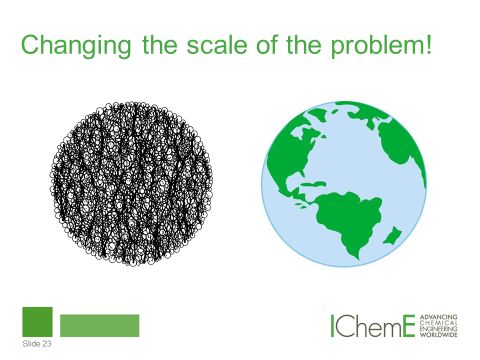
Over the next two decades the potential exists to transform the process industries through the use of large data sets, machine learning and artificial intelligence. Adoption of these emerging technologies should lead to increases in efficiencies, productivity and safety. Integrating process plant data with market data will allow improved agility, allowing companies to respond to changing market demands more rapidly, and profitably.
In the coming decades new processing facilities will be more highly instrumented than they are today. Artificial intelligence and machine learning coupled with data analytics tools will allow the development of semi-autonomous systems which will aid in plant operation. These systems will be able to provide management and operators with advice on a range of issues including system inspections, maintenance scheduling and troubleshooting. The most appropriate data will be provided to operators in the field allowing more informed decision to be made.
Presently, advances are occurring in a range of areas including improved sensors for process control, connectivity, simulation and training. At the same time that all these advances are taking place, the risk of cyber attacks through the unauthorised access into data centres and control systems will increase. The vulnerabilities of processing facilities will not only be through internet-based resources, but also through the interception of plant-based communications systems such as wifi.
This digital revolution is currently not reflected in our chemical engineering programs at either the undergraduate or graduate level. The majority of workers in the process industries are simply unprepared for taking advantage of the current advances in digital technologies. This therefore opens up significant opportunities for education and training in both the short term and the long term.
This presentation will look at the challenges and opportunities in preparing chemical engineers to work in Industry 4.0.
Today, the Asia-Pacific region is at the center of the world economy, but having this responsibility means that there will be many challenges and responsibilities for all of us. Production volume is growing in response to the continuous increase of global demand that is driving new innovations and businesses at unprecedented rates of growth that are thriving and being created almost simultaneously as new areas are discovered. Along with this remarkable economic growth and prosperity, our responsibility to the environment is also increasing; material intensity, which is the use of resources to produce products, is driving development of society with such large projections of consumption and production, that they can be considered to be unsustainable. We have to rethink some aspects of our growth and motivation.
As the result of a United Nations Conference on Sustainable Development in Rio de Janeiro in 2012, a new set of 17 sustainable development goals (SDGs) were formulated for 2030, which gives 17 Sustainable Development Goals (SDGs) in areas of People, Planet, Prosperity, Peace, and Partnership. While the Asia-Pacific region has the greatest growth in the World, its material intensity is also the greatest, which means that Earth's resources are increasingly being used inefficiently without regard to their environmental or social impact. One of the most important goals of the 18th Asian Pacific Confederation of Chemical Engineering Congress is to introduce innovative methods and techniques for reducing material intensity without degrading environmental and social conditions. The critical step in achieving the SDGs is philosophy for decoupling economic growth and environmental issues. So far, chemical engineering has contributed to the society through development and implementation of innovative chemical technologies and maximizing efficiency in process systems. However, to achieve sustainability, we have to embrace a completely new philosophy to include, as paramount, the well-being of society, Earth's environment and respect for nature. We propose to call this new philosophy “Sufficiency,” which has the goal of not only lowering material intensity and increasing process efficiency, but also, at the same time and with paramount importance, improving the well-being of people, their living and working conditions and the Earth's environment.
The theme of APCChE 2019 Congress is “Chemical Engineering for Sustainable Development Goals.” APCChE is an opportunity for all of us in the Asia-Pacific region to promote ideas to achieve the SDG 17 “Strengthen the means of implementation and revitalize the Global Partnership for Sustainable Development.” The Congress will provide many opportunities to discuss how chemical engineering will contribute to the SDGs in the world and will be a landmark event for promoting cooperation in the region.
UNIDO is the specialized agency of the United Nations that promotes inclusive and sustainable industrial development (ISID) for poverty reduction, inclusive globalization and environmental sustainability. Technology transfer and business management capacity building are one of the UNIDO's mainstream activities in promoting ISID involving various industrial activities related to chemical engineering. The refrigeration sector, which includes air conditioning, is currently responsible for around 17% of global electricity consumption. For some developing countries this percentage even exceeds 40% of total national electricity demand. Environmentally friendly manufacturing of refrigeration equipment and energy efficient cold supply chain are crucial for achieving the Sustainable Development Goals by 2030 and beyond. This presentation will share UNIDO's technology transfer examples in contributing to the achievement of the SDGs. In addition, it touches on the scope and share the expected output of this symposium.
Chemical engineering is uniquely placed to drive positive impact across the full spectrum of the SDG agenda. The UN pointed out ‘education is critical for promoting sustainable development and improving the capacity of the people to address sustainable development issues’. We, as the educators in chemical engineering, should enlighten the next generation on a diverse Chemical Engineering for sustainable development.
Diverse dimensions of sustainable development are embodied in the subjects of chemical engineering, yet the profound relations and representations are to be dug out and elucidated. The academia is obliged to explore the potential and boundary of how chemical engineering can make a more sustainable world. As the UN set up the roadmap of SDGs to 2030, people in the chemical engineering community shall contemplate and act proactively on how the instruction activities can be consistent with this process.
Among all the efforts, enhancing the next generation's recognitions of chemical engineering and guiding them to face the challenges matters most. Take my introductory course at Tsinghua University as a case. A group of professors, alumni and experts in the chemical industry are invited to share their understanding of chemical engineering to first-year undergraduates. Extracurricular activities such as practices, voices-from-young-professionals and demonstration videos also help them to draw a big picture. The integration of diverse information from the introductory class presents a wide range of SDG concepts and highlights some of them (e.g. SDG 5-gender; 6-water; 7-energy; 8-work; 9-innovation, 12-consumption and production, 13-climate change etc.), which allows us to think how to integrate SDG into teaching, starting from the freshmen. Inspired by APCChE-UNIDO Symposium, we will further upgrade the course with a systematic outlook of SDG. Hopefully, the discipline of chemical engineering could be enriched with more sustainability by our efforts at least starting from education.
The academic year 2018-2019 marks the introduction of a new 4-year B.S. Chemical Engineering curriculum to the first batch of K-12 graduates in the Philippines. The Commission on Higher Education (CHED), through its Technical Panel for Engineering and Technology (TPET) is tasked with monitoring the implementation of the 2018 Policies, Standards and Guidelines (PSG) on all higher Educational Institutions (HEIs) offering B.S. Engineering Programs to ensure that the attributes of our future graduates are comparable with global standards.
Apart from complying with the CHED-TPET guidelines, the Chemical Engineering Department at the University of Santo Tomas is re-engineering its 4-year undergraduate curriculum based on a localized Conceive, Design, Implement, Operate (CDIO) approach that integrates the Sustainable Development Goals (SDGs). The objective is to not only to integrate sustainability principles but also provide an action-oriented, transformative pedagogy, which supports self-directed learning, participative and interdisciplinary collaboration, creative problem-solving, and the linking of formal and informal learning.
An SDG map in the shape of a periodic table addresses specific targets for each SDG across the curriculum and identifies courses or modules where such target can be imparted to students. Similarly, a syllabus map is created for specific courses in order to allow faculty and students to merge awareness of the SDGs with a CDIO approach that will apply innovative solutions to sustainable development issues.
This presentation shall discuss the SDG-based CDIO approach in the preparation of the curriculum and syllabus map as well as issues and lessons learned from the endeavor.
Sapporo City is the central city in Hokkaido with a population of about 1.96 million people. Roughly 13 million tourists a year from Japan and other countries visit us for our abundant nature and attractive cuisine. This city is promoting environmental policies on its “second basic environment plan” as a mean to achieve the SDGs and making connections with various bodies. Sustainable consumption activity by residents in an urban city as Sapporo, that consumes a large amount of resources and energy, is vital to achieving SDGs. We introduce the efforts for sustainable consumption of citizens in Sapporo city and trends for achieving SDGs in Japan.
The Asia-Pacific region is the cradle of production and the center stage of the world economy today. At the same time, the region is a flourishing arena of new socio-economic development driven by digital innovation. In light of these trends, it is necessary to examine and practice emerging opportunities for ensuring sustainable society, in which socioeconomic development and increases in environmental loads are decoupled from the real sense of securing people's well-being and happiness. Sustainability is not one-dimensional issue such as the prevention of global warming but is a multifaceted challenge, as the 2030 Agenda for Sustainable development indicates 17 goals and 169 targets in areas of People, Planet, Prosperity, Peace, and Partnership,
Chemical engineers have been responding to social demands by developing and implementing innovative technologies since chemical engineering inherently pursues a problem-oriented approach. However, we have to expand our focus from increasing the efficiency of existing products and systems to aiming at the well-being of society by improving people's sufficiency in the SDGs era. For this purpose, the Society of Chemical Engineers, Japan launched many activities to extend chemical engineer's scope from efficiency to sufficiency: a study group on diversifying technology implementation, the Committee on Future Energy and Social Systems, the Gender Equality Committee and the SDGs Committee, and so forth. Likewise, APCChE can be a good place in the Asia-Pacific region to achieve Goal 17 “Strengthen the means of implementation and revitalize the Global Partnership for Sustainable Development.”
By integrating these activities, we will be able to live up to paragraph 67 of the 2030 Agenda that states “We call upon all businesses to apply their creativity and innovation to solving sustainable development challenges.”
In this work, we performed a life cycle assessment of poly(3-hydroxybutyrate-co-3-hydroxyhexanoate) (PHBH), which is made from biomass resources and has a characteristic of biodegradability in both soil and seawater. To reduce the dependency on petroleum resources and decrease marine plastics, increasing attention has been paid to bio-based and biodegradable polymers. Until now, many papers about the environmental impacts of these biopolymers have been reported. However, the environmental impact of a biodegradable polymer that dissolves in an aquatic environment has not been clearly investigated yet. To discuss the effect of bio-plastics introduction to the society, it is necessary to elucidate its impacts through its entire life cycle.
We applied a life cycle assessment to PHBH products from the cultivation of biomass resource to the end-of-life, and we considered their environmental benefit to the society. The selected target is PHBH products and comparable conventional plastic products with the same function. Their resource extraction, production processes and end-of-life are different from each other. Unlike the fossil-derived plastics, PHBH is biologically synthesized from plant oil and refined for pellets. We set a system boundary including biomass cultivation, microorganism fermentation, polymer extraction, product manufacture, use and end-of-life. The end-of-life was generated as several scenarios such as incineration, landfilling, recycling and dumping depending on local waste systems and consumer behaviors. To construct the inventory data, we investigated the actual production processes in Japan. Finally, we targeted global warming for the impact category to discuss whether PHBH can become a possible measure for climate change.
Through the assessments, we will discuss which process within life cycle has a significant environmental impact and which end-of-life scenario can contribute to reducing greenhouse gas emission. Our results will help design and construct a better social system for biopolymers and provide deep insights for utilizing PHBH.
Promotion of cooling of building by snow is important in regions with heavy snowfall in terms of not only energy saving for cooling in summer, but also workload reduction of snow removal in winter because most of these regions in Japan now fases decrease of labor population. In the present study, life cycle cost (LCC) of cooling of apartment building by snow was calculated for three types of snow strage: open-air snow mound, half-underground storage, aboveground strage. Initial amount of snow storage, cooling area per household and annual cooling time were 100 t, 80 m2, 502 h, respectively. Number of households which shared the cooling energy from snow was modified from 1 to 20. Each household had 4 rooms with equivalent area. In case the amount of snow was not sufficient for cooling during the season, some of the rooms were cooled by electric air-conditioner.
Annually averaged value of the LCC (ALCC) per household showed convex dependence on number of households sharing the snow strage and there were optimum number of the households which minimized the ALCC. Snow strage of half-underground type and aboveground type had disadvantage especially smaller number of households because of high cost of construction.
Cost reduction potential in snow removal by the snow strage was also calculated. It was estimated as 160,000 Yen for 10 households for 40 years of operation period as shown in Fig. 1. It was mainly attributed to reduction of transportation of snow to dumping site.
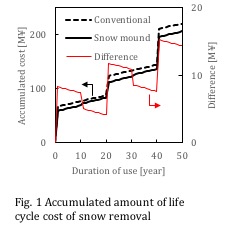
Developing international human resources that possess a high level of expertise in many fields including chemical engineering and that show leadership at the global stage is important for establishing a sustainable society and achieving the Sustainable Development Goals (SDGs). The University of Tokyo Ocean Alliance conducts educational initiatives for fostering individuals who can succeed worldwide in ocean related areas. We started an overseas internship project from the 2014 academic year (AY 2014) and built collaborative relationships among nine international organizations and research institutions, such as the United Nations Industrial Development Organization (UNIDO), the Food and Agriculture Organization of the United Nations (FAO) and the International Atomic Energy Agency (IAEA). In particular, we have a strong relationship with UNIDO. Forty five graduate students have been sent to these international organizations from AY 2014 to AY 2018 (Table 1), and have undergone internships for two to six months. They could engage in actual projects related to their own research fields including environmental and energy issues. The objective of this study is to investigate the effectiveness of the internship at the international organizations mainly by analyzing students' internship reports. Their impressions for internship were classified into three categories. The first one is the description related to students' future and their career paths, the second one is the influence of internship on their master and doctor researches, and the third one is related to the construction of human networks and all the rest of it. The analyses of the reports for five years show that the internship was considered to be effective in establishing students' career paths through work experiences and formation of interpersonal relationships in the international organizations. It is expected that this internship system can contribute to achieving the SDGs in the long term.
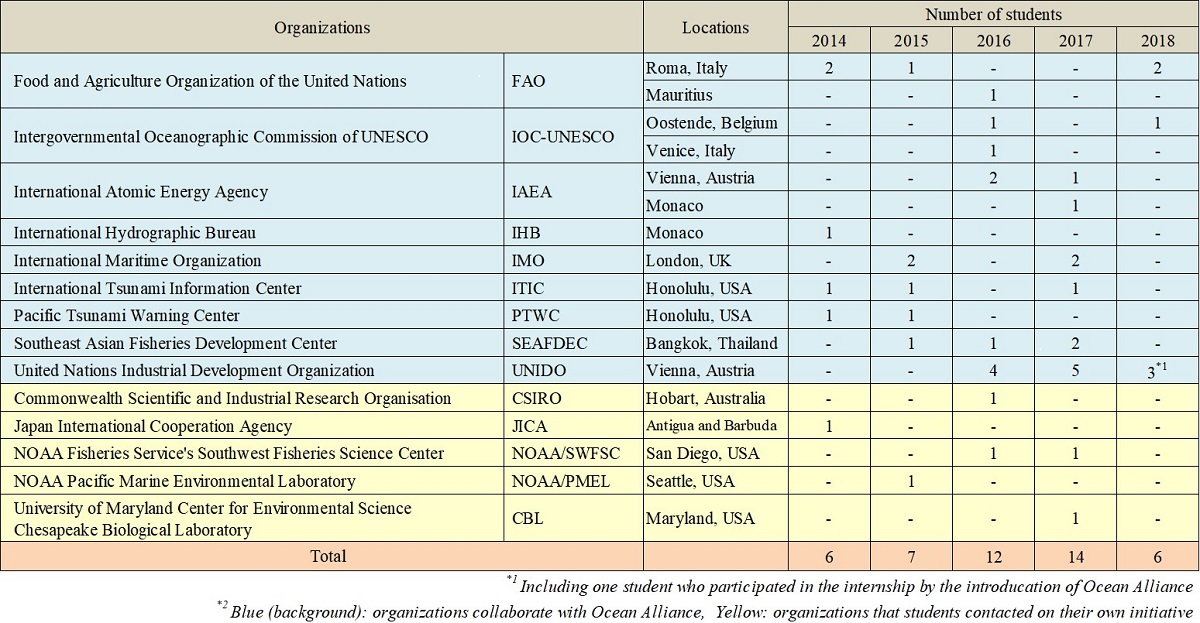
The last few years have been quite challenging for the chemical industry in Asia. Vibration of oil prices, regulatory pressures, global climate plans and competition, and changing demographics have a huge impact on chemical industry. In the last years chemical industry companies are working on two major production concepts to further improve their production of chemicals, materials or bio-technology products: cyclic economy and modularized production. The general goal of these activities is to produce faster, with a higher quality and in a less wasteful manner. The chemical industry is facing an increasing demand from fast growing and vibrant markets in Asia and a trend to customized specialty and fine chemicals. Asian chemical companies face different challenge from those in US, Europe and Middle East, such as energy-deficiency, high cost of energy and raw materials, strengthening environmental regulations, increasing labor-cost, etc.
The circular economy in developing countries can increase productivity and economic growth, improving the quality and quantity of employment, and save lives, by reducing environmental impacts such as water and air pollution. For most Asian countries there is huge potential to improve productivity by using resources more efficiently. However, many chemical plants in East Asia are old and need renovate to achieve new standard. With efficient technologies, there are huge business opportunities for companies.
The demand for lithium-ion batteries (LIBs) is expected to increase dramatically in the next decades because of the growing EV market. As a result, a large volume of batteries will reach their end-of-primary-life in the near future. However, the spent battery may still retain their capacity, which could be serviceable in its second-life, e.g. for the stationary energy system, or remanufactured to be used again in EVs. The LIB supply chain might benefit from reducing raw material consumption, if LIBs are reused through refurbishing, remanufacturing, or recycled. The reuse and recycle of LIB will also facilitate waste management by the recovery of all valued battery components to contribute to a circular economy. To devise a circular economy strategy for the LIB system, the material flows and the environmental impacts associated with their life cycle including manufacturing, use, and end-of-life phases should be assessed. Although numerous studies on the environmental impact of LIB production are available, the existing primary life cycle inventory data is often difficult to trace back, which is inflexible to discuss the different properties of LIB and energy demand related to the manufacturing process. The different LIB chemistries that have different combinations of metals, will make the material and energy consumption in production process vary. In this study, a bottom-up inventory model of LIB production, which enables to estimate the material requirements, energy demands and the associated environmental impacts such as greenhouse gas (GHG) emission, is developed. Here, we demonstrate that with this modeling approach, it becomes possible to assist devising a circular economy strategy from environmental impact perspective, reflecting envisioned future circumstances e.g. decarbonization of electricity generation, by coupling with a material flow analysis model.
MgO@ZIF-8 catalysts with various MgO loadings (10-50 wt%) were prepared through a wet-impregnation and calcination process. The physicochemical properties of MgO@ZIF-8 catalysts were characterized using atomic absorption spectroscopy, X-ray diffraction, , nitrogen sorption isotherms, field-emission transmission electron microscopy, and thermogravimetric analysis. It is found that MgO nanoparticles could deposit onto the ZIF-8 surface with high atom efficiency and little influence on the ZIF-8 structure. It is suggested that the surface sites and microporosity of ZIF-8 support facilitate the deposition of Mg precursor and subsequent formation of MgO nanoparticles. MgO@ZIF-8 catalysts were tested for catalytic transesterification of glycerol and dimethyl carbonate. It is found that the 50 wt% MgO@ZIF-8 catalyst display an improved catalytic activity on glycerol carbonate production than those of MgO and ZIF-8. Furthermore, the MgO@ZIF-8 catalysts showed higher catalytic activities than their physically-mixed counterparts. These results suggest a synergistic effect between MgO and ZIF-8, which is explained by an acid-base bifunctional catalysis mechanism.
Inclusivity is a vital aspect of sustainable development which has been emerging as a challenge in economically developed, matured societies. In Japan, the rural areas are suffering from lagged economic development, the aging society, and declining population. Tackling sustainability challenges without leaving out problems in these areas are essential, but requires a new approach in industrial development. Creating sufficiently productive and profitable systems that utilize locally-available resources are seen as a potential key to vitalize the rural areas while tackling the SGDs.
Attempts to collect and study all the relevant information can lead to an excessive requirement on time and effort in the early stages of a design project. Because some of the unknowns are more important than others, prioritization of the unknown factors that requires a closer investigation can potentially reduce the time and cost for the initial design. In this study, a system synthesis method that generates combinations of resources, technology, and products, ranked in order, formulated as a MILP is applied to indirectly prioritize the unknowns, while comprehensively exploring the combinations of the known options.
The higher ranked systems will include some designs that are impractical due to missing practical constraints. The ranked list of the systems will help to identify overlooked constraints, starting from more important ones. The unknowns that are related to the identified constraints are then studied and added in the systems synthesis model. After several iterations, all the critical unknowns are studied to describe the key constraints and the most promising systems can be proposed.
Features added to existing studies, i.e., 1) consideration of the combinations at its suboptimal capacity of processing, 2) incorporation of material storage equipment and efficiency in order to overcome the seasonal variations in availability of resources and the demand of products, will be introduced with simple examples.
Methyltetrahydrofuran (MTHF) have received great attention for combustion system applications, because it can be readily used in blends with gasoline and diesel without major engine modifications. In this study, as a sustainable platform chemical for the biofuels and biochemicals, conversion of MTHF from lignocellulosic biomass was studied. For the conversion of MTHF, domestic grown woody biomass such as pine and oak in Korea were firstly treated by chemical and thermal treatment for the production of C6 substrate and further production of levulinic acid (LA) via 5-hydroxymethylfurfural (HMF) intermediate, which was then subjected to the catalytic conversion for the conversion of MTHF.
At the beginning of the conversion process, alkaline reagents (ex. sodium hydroxide and ammonium hydroxide) were applied to produce C6-rich substrate (>70%), which was then converted by de-hydration and re-hydration reactions into LA using sulfuric acid (1~5 wt%) at high temperature (121~190 °C). For the conversion of MTHF via gamma-valero lactone (GVL) intermediate using de-hydration and hydrogenation reactions under high temperature and pressure conditions, high-efficiency heterogeneous bimetal catalyst was synthesized and attempted for precious metal replacement in the presence of the effective CTH (catalytic transfer hydrogenation) solutions.
In this paper, conversion yields of C6, LA, and MTHF were evaluated and reported under various reaction conditions. For the increased MTHF production, various catalytic reaction conditions pertinent to effective and viable process were explored and discussed.
A continuous twin screw-driven reactor (CTSR) can provide a unique and efficient reaction environment for the pretreatment of lignocellulosic biomass. CTSR has the ability to provide high shear, rapid heat transfer, effective mixing. The thermo-mechanical energy provided by the continuously stirred screws in CTSR, which causes the shear forces, can be applied to the continuous pulverization of biomass, thus improving the overall rate of biomass conversion. Considering the high labor intensity and energy requirement of batch pretreatment, a CTSR process has great potential for increasing the efficiency of biomass pretreatment.
CTSR for the pretreatment of biomass would be practicable and useful for large scale production because it affords high-efficiency pulverization by a high shearing force, and adaptability to many different process modifications, such as application of simultaneous physical and chemical treatments using other catalysts. The performance of biomass pretreatment through CTSR is a complex function of screw rotational speed, throughput, and screw configuration etc. The interaction between different processing parameters leads to complex functions of shear conditions and reaction severities, both of which affect pretreatment performance.
With the aim to provide a further insight into CTSR pretreatment, enlarged CTSR to 100 kg/day scaled was developed and demonstrated. Mathematical modelling for fluid dynamics and heat transfer were developed by a set of ordinary differential equations (ODE) based on first-principle models. The resulting ODE set was experimentally validated using model biomass (sawdust) as feedstock. The kinetic parameters of biomass pretreatment performance were estimated from experimental results.
These results will contribute to improved reactor design and scale-up tasks, and in turn, to the successful deployment of novel industrial-scale technologies for biomass pretreatment.
Industrial symbiosis with unused local biomass can be one of a key approach from the viewpoint of sustainability of agriculture, forestry and the regions. Planning biomass-based industrial symbiosis necessitates hard decisions including long-term visioning of the regions and consensus building among various stakeholders such as agriculture, forestry, energy supplier, local government, and technology researchers. Chemical engineering approach with modeling and simulation can strongly support such planning process. The planning process of the symbiosis to be supported has not been well established nor systematized in previous studies. In this study, systematic planning process for biomass-based industrial symbiosis was proposed and the requirements of its supporting mechanisms were defined. The planning process was structured as the series of sub-activities based on the re-analysis of the case studies for planning industrial symbiosis integrating cane sugar industry and local forestry on a specific region. Modeling and simulation of regional energy systems with multiple co-generation plants fueled by local biomass from the industries were performed in the case studies. The planning process was defined that consists of the activities of planning tasks, i.e., <Examine present system>, <Generate alternatives>, <Simulate flows> and <Evaluate>. Additionally, these tasks are controlled by <Manage>, and the proposal of the symbiosis plan as the product by the tasks are checked by <Review>. These activities of planning tasks can be supported by the mechanisms, such as IoT monitoring system, technology matching tool, flow simulator and evaluation tool. The applicability of the planning process and the supporting mechanisms is to be discussed through new case studies in other regions. Human networks among region, academia and industries have significant roles to implement the symbiosis plans toward the regional sustainable visions even if the supporting tools highly developed in future.
To effectively mobilize the limited time and resources for the accomplishment of a transition towards sustainability, efforts on a technology development must be made in a manner coherent with other efforts under a vision on the sustainable society. Technology Roadmapping (TR) is amongst the several approaches that may cross-link a technology development with a future vision. Here, I provide an example of assisting TR by exploring the balances between technology performances with other exogenous variables in the future society with a dynamic Material Flow Analysis (dMFA).
In Japan, a future target of the power supply configuration (energy mix) based on the massive introduction of renewable energy has been advocated, in which Photovoltaics (PV) accounts for ~7% of the total power generation capacity, i.e., approximately 30% of the renewable power sources. On the other hand, a substantial amount of Si type PV (Si-PV) would reach their End of Life (EoL) soon. Therefore, the development of a technology recovering Si from EoL Si-PV may effectively respond to the demand to achieve the target without spending a massive amount of energy for Si purification from Silica sand. To consider such technology, a long-term evaluation of benefits and impacts on both economy and environment is required to invite stakeholders to jointly materialize the reasonable and comprehensive roadmap. Here, our team conducted a time series quantification of flows and stocks in an envisioned Si-circulation system. Then, we deduce the development directions as a roadmap with respect to various design variables (ex. an average lifetime of product) on the basis of multiple criteria (e.g., the net-energy acquisition and net-CO2 avoidance). With this example, I aim to highlight the potentials and challenges of vision-oriented technology development for the achievement of SDGs 9: Industry, Innovations and Infrastructure and SDGs 7: Affordable and Clean Energy.
A hydrogen supply chain consists of the production, transportation, storage, and distribution of hydrogen as an energy source. A variety of decision variables should be determined along the supply chain including technological options of producing hydrogen, phase of hydrogen, location and capacity of treating facility, and the amount of transportation between the regions. The optimization problem can be effectively formulated and solved for this complex systems. In this presentation, we have investigated for the optimal strategy for hydrogen supply chain and present the optimal solution to the case of South Korea.
CuInS2 (CIS) is a solar absorber with the energy band gap of 1.5 eV, suitable for hydrogen production from water splitting. The types of conductivity (n- or p-type) of CIS photoelectrode can be tuned as a function of Cu/In concentration ratio. In this report, CIS films were deposited using spray deposition onto ITO-coated glass substrates from aqueous solutions consisted of copper (II) chloride, indium chloride and thiourea. First, the ratios of the precursor solutions were varied and the transition from n- to p-type conductivity was observed. Next, Zn-doped CuInS2 (Zn-CIS) thin films exhibited p-type conductivity from electrochemical measurements. XRD results reveal the cubic-structured Zn-CIS films. The successive shift of XRD patterns toward higher angles with zinc molar fraction is evident of the formation of Cu-In-Zn-S solid solution. LSV results shows that the photocurrent density of Zn-CIS film reached 2.5 mA/cm2, higher than the bare CIS (0.3 mA/cm2). Finally, n-type ITO thin film was deposited onto the p-type CIS. Here, we want to demonstrate that suitable match of the p-n junction can create a high efficient photoelectrode for hydrogen production from water.
The electrochemical reduction of CO2 recently draws great attention because of its sustainable capability of producing fuels and chemicals. However, the high over potential of CO2 reduction reaction-oxygen evolution reaction (CO2RR-OER) have been pointed out as an obstacle of commercialization. Herein, we propose electrochemical co-production of CO2RR and oxidative reforming of organic materials. The oxidative reforming of organic materials not only potentially reduces operating cell voltages but also improves system economic feasibility by producing more valuable chemicals than oxygen. We introduces an automated and generalized platform for the techno- economic alanysis (TEA) of electrochemical coproduction system and investigate the 16 candidates of CO2RR for cathode and 18 candidates of organic oxidation reaction for anode. The TES platform generates a product oriented process systems design including reaction, separation, and recycle. Global sensitivity analysis of Faraday efficiency, current density, and overpotential for the levelized cost of each product to understand which index should be improved first. Hydrogen, carbon monoxide, formic acid, glycoladehyde, ally alcohol, ethylene glycol, acetic acid, and propanol can be the promising candidate for the CO2RR and 2,5-Furandicarboxylic acid (FDCA), oxalic acid, acrylic acid, glycolic acid, lactic acid, 2-furoic acid, and ethyl acetate can be the promising candidate for the anodic oxidation.
Virus surface chemistry plays a key role in virus sorption and partitioning processes, however there is very limited information on viral surface chemical properties. To enhance the toolbox of available characterization tools, chemical force microscopy (CFM) is being pioneered for viral particle characterization. CFM measures the adhesion force between a particle, in this case a virus particle, and a functionalized atomic force microscopy (AFM) tip. CFM reduces many of the difficulties of bulk characterization techniques by measuring adhesion of individual virus particles, likely reducing purification affects that can change surface properties. Two important surface characteristic that can dominate separation processes are isoelectric point (pI) and hydrophobicity. The surface charge of virus particles is pH dependent, which dictates the mobility and controls the colloidal behavior in virus sorption processes. While traditional characterization methods, including zeta potential and viral adsorption to a charged surface chemistry, have been used to study viral surface charges and determine the pI of virus, they are bulk measurements that can change when the studied particle has a different purification method. Hydrophobic interactions are known to be strong for virus particles and are implicated to be important in virus entry into cells. The single particle method of CFM allows not only the quantitation of the virus surface chemistry, but could be used to understand and better design purification processes. The adhesion of a viral particle to any chemical moiety in any solution condition can be tested with this method. The model non-enveloped porcine parvovirus (PPV) and enveloped bovine viral diarrhea virus (BVDV) were used to demonstrate the use of CFM to determine the hydrophobicity and pI for viral particles. This information is being used to determine the binding and elution conditions of a virus to a chromatographic column. With a thorough understanding of virus surface characteristics, virus sorption and desorption processes could be significantly improved and designed to specifically target viral particles using minimal viral material during development.
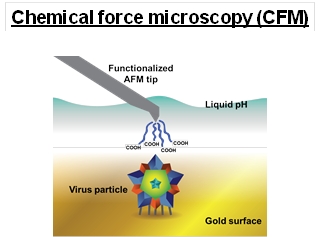
Designing integrated non-affinity downstream processes for biologics poses a significant challenge due to the broad range of design space available for resin selection and buffer conditions. To address this challenge, we developed an in silico-based approach to quickly design and rank a fully inclusive list of integrated downstream processes for their ability to remove impurities using only orthogonally selective multimodal and ion exchange resins. This approach involves the one-time characterization of an impurity database and considers both impurity profiles patterns and product retention behavior to generate and score all possible integrated purification trains. This database was then employed in concert with an in silico process development tool which generates and ranks all possible integrated chromatographic sequences for their ability to remove orthogonal impurities. Top-ranking outputs are then used to guide the experimental development and refinement of purification processes, significantly expediting the development of downstream processes. For Pichia pastoris, this approach was used for two non-mAb products, hGH and G-CSF, which were successfully purified from cell culture fluid process impurities in a process that resulted in high purity and product recovery. We also performed modifications to our process design approach in order to account for both process-related impurities and product-related impurities. This modified strategy was first shown to be successful for purifying IFN produced in Pichia pastoris, and was then applied to the non-affinity-based purification of a mAb-aggregate challenge in CHO, an expression system with a much higher HCP burden. Finally, results are presented on a mathematical framework to characterize and quantify orthogonality in multimodal systems. Using this, we observed several interesting and unexpected results including the existence of a highly orthogonal pair of resins belonging to the same class/family.
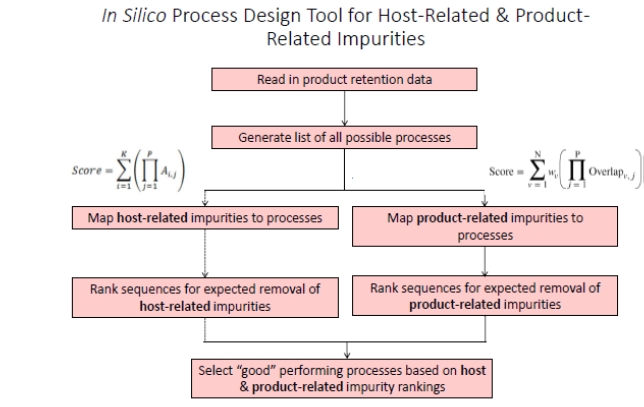
Bivalent bispecific antibodies (BiS) are produced by recombinantly expressing a whole monoclonal antibody (mAb) with two single chain variable fragments (scFv) using flexible polypeptide linkers. Three homologous BiS samples varying only by scFv attachment location show reversible, three-peak elution profiles on ProPac WCX-10 and Source 15S cation exchange columns. Collection and reinjection of any of the three peaks results in the same three-peak elution profile. This behavior is seen at pH values in the range 5–8.5. In-line DLS showed that all peaks have a monomer-sized hydrodynamic radius of 6.2 nm. Unlike the normal chromatographic behavior, decreasing flow rate decreased resolution. At the lowest flow rate tested, only a single symmetric peak was observed eluting between the first and second peak of the higher flow rate elution profiles. A hold step at strong binding conditions followed by gradient elution with high flow rate enriched the third, most retained, peak. Biophysical measurements including in-line fluorescence, chemical cross-linking, enzyme digestion to determine domain contributions, and a mechanistic model reveals that the three-peak elution is caused by conformational interconversion occurring on time sales comparable with chromatographic separation. From the peptide sequence, the scFvs carry a net positive charge. When the scFv is folded onto the base mAb weaker bind to the resin occurs whereas if the scFv is outstretched more favorable interaction and stronger binding occurs on the resin surface. The three peaks from weakest to strongest retention are: both scFvs interacting with base mAb, one scFv interacting with base mAb and one outstretched, and both scFvs outstretched. Equilibrium favors the tight conformation in solution and outstretched while adsorbed. The highly flexible linkers allow slow changes in tertiary structure responsible for reversible, three-peak elution behavior. Analogous results are observed on HIC columns suggesting that similar molecular interactions are responsible for the multi-peak elution behavior.
Recently, exosomal vesicles are known as a next generation of biomarkers for molecular diagnosis, and their separation methods has been studied last decades. T-cell Immunoglobulin and Mucin domain (TIM) which is Ca-dependent membrane protein has an ability to interact phosphatidyl serine (PS) clusters on inner cell membrane, and thus it is considered that TIM fragment is one of ligand candidates to separate exosomal vesicles from serum as well as culture supernatant. Also, Exosome can be released from the resin.
Here, we designed and characterized TIM fragments genetically-fused with Avi-tag and PMMA-tag for site-direct immobilization to solid supports.
Avi-tag-fused TIM fragments were successfully produced by HEK293T cells with co-expression with Biotin ligase BirA. Consequently, site-specific biotinylation at the C-terminal region of TIM fragments could be achieved. Mono-biotinylated TIM fragment (ABT-TIM-VM) could be immobilized on the surface of streptavidin-coated plate, and could recover 10-times lower concentration of exosomes, compared with the plate with randomly-biotinylated TIM (RBT-TIM-VM). These results indicated that orientation control of TIM on the surface of solid support is more important to improve recovery of exosomes. Furthermore, biotinylation yields of ABT-TIM-VM could be controllable by changing the ratio of expression vectors for TIM and BirA.
Another candidate, PMMA-tag was introduced at the C-terminal region of TIM fragments. TIM-VM-PM could also be produced by 293T cells, and purified by Ni-NTA chromatography. The optimal buffer condition for TIM-VM-PM was screened from 96 conditions with different pH and NaCl concentrations. Consequently, 25-times higher signal intensity of sandwich ELISA for detection of exosome was detected, compared with the plate with tagless TIM-VM. These results indicated that PMMA-tag introduced was functional and preferentially adsorbed the surface of PMMA plate.
Thus, both TIM fragments developed in this study, namely, ABT-TIM-VM and TIM-VM-PM are useful ligand proteins to separate exosomal vesicles from biological samples.
The synthetic DNA containing modified nucleotides comprise a powerful toolbox of manipulating the formation of nucleic acid duplexes for diagnosis and therapeutic purposes. We are interested in the DNA oligonucleotides containing site-specific neutral internucleoside methyl phosphotriester (MPTE) linkages, nDNA in short (n for neutral). nDNA is interesting because the electrostatic repulsion between nDNA and its complementary strand would decrease and the duplex formation could be enhanced. However, the methyl group of MPTEs may sterically hinder duplex formation and destabilize the duplexes. Therefore, the uses of nDNA may offer additional elements of maneuvering the stability of nucleic acid duplexes formation. The structural information and hybridization thermodynamics were reported in this study. Based on the structural and thermodynamics information of nDNA with natural DNA, successful results in the molecular detection method such as PCR and qPCR will be reported. The applications of nDNA on the in-situ hybridization will be discussed as well. Most importantly, using nDNA on the semi-conductor based biochip and biosensor, such as field effect transistor, has generated wide avenue for the precision medicine, which also will be highlighted in this report.
Keywords: methyl-phosphotriester linkage of DNA (nDNA); molecular detections; PCR and qPCR; In-situ hybridization; field effect transistor
The challenge for applications of viruses, virus-like particles, or other extra cellular bionanoparticles in gene-therapy or in cancer therapy is the high dose with up to 1014 particles per dose. Downstream processing is one bottleneck in the production of these bionanoparticles. It has been often overlooked that a heterogenous population of bionanoparticles is present and they must be separated from the product. The heterogeneous populations of bionanoparticles are released from the cells, carrying different host cell proteins, DNA and RNA fragments. Additionally, cells produce extracellular vesicles (microvesicles and exosomes) with similar size and surface properties. The biological activity of these different particle populations is not fully understood. Particle characterization and biological activity assays require the separation of these populations with high purity. Here we compare the results obtained for the purification, as well as particle populations' separation, of HIV-1 gag VLPs produced in CHO cell culture using different downstream processing approaches. These approaches include polymer grafted anion exchangers, monoliths (anion exchange and hydrophobic interaction), a combination of flow-through and heparin affinity chromatography, and membrane adsorbers. Several analytical tools including Nanoparticle Tracking Analysis and Mass Spectrometry were used for VLP characterization. An outlook will be given how continuous ultracentrifuges will complement these purification approaches.
PEGylation is a well-known technique to develop biopharmaceuticals, such as proteins and DNAs. It can increase the hydrodynamic radius to reduce their kidney excretion and prolong their in vivo half-life. On the other hand, the control of PEGylation reaction is difficult because of the formation of heterogeneous mixtures of target PEGylated product, its isomers, unreacted proteins and PEG reagents. As the differences in the sizes and the surface properties such as charge and hydrophobicity of the isomers are sometimes small, several purification steps are always combined to obtain the target product from the reaction mixture. Among the purification method, ion exchange chromatography has an advantage for the separation of isomers on the basis of their difference in size and charge with a single operation. However the separation mechanism is not fully understood. In this study, synthetic PEGylated DNAs were used as a model of well-defined structure isomers to investigate the charge shielding effect of PEG on the charged biomolecules. Poly T possessing 9 to 95 thymine bases, an amine group for conjugation and middle base was reacted with NHS-activated PEG reagents. The retention factors on anionic exchange chromatography, Q sepharose HP and QA monolith, were determined by liner salt gradient experiment. Elution salt concentration of PEGylated DNA was decreased depending on the molecular weight of PEG. However, the decrease was not pronounced when the number of bases increased. On the other hand, the number of binding site was practically unaffected by the PEGylation which means that the conjugated PEG chain did not disturb the interaction of DNA with cationic ligand while the interaction was weakened by the conjugated chain.
Protein A affinity chromatography is still the preferred option for antibody capture. In the past years, significant improvements have been made with respect to alkaline stability of the recombinant Protein A ligands, with resistance to 1 M NaOH over extended time periods as the latest milestone. We have investigated how exposure to alkaline conditions can alter antibody binding kinetics of Protein A resins. Break-through curves of fresh resins and resins after different time periods of alkaline exposure were compared using mAb and polyclonal IgG. As expected, equilibrium binding capacity dropped to some degree at long incubation times. In contrast, mass transfer of IgG was enhanced which was reflected by steeper break-through curves. Fitting of the break-through profiles with a pore diffusion model revealed effective pore diffusion coefficients which were increased by a factor of 2-3. Adsorption isotherm measurements showed that even after alkaline exposure, typical highly favorable isotherms were obtained, albeit with association constants that were reduced to some extent. Based on these altered binding properties we could identify a narrow window of specific operating conditions, where the alkaline treatment eventually led to an increase of the dynamic binding capacity. These conditions varied for different resins and strongly depended on the NaOH concentration and incubation time. Confocal laser scanning microscopy measurement showed that the accelerated mass transfer involved a transition from a shrinking core behavior with sharp fronts to a situation with more diffuse profiles typical for solid diffusion or pore diffusion with lower binding strength. Linear pH gradient elution studies showed that the desorption behavior was not changed significantly, as pH values at the peak maximum were almost the same as for fresh resin. The results of this study will contribute to a deeper understanding of phenomena associated with performance change of affinity media upon alkaline regeneration.
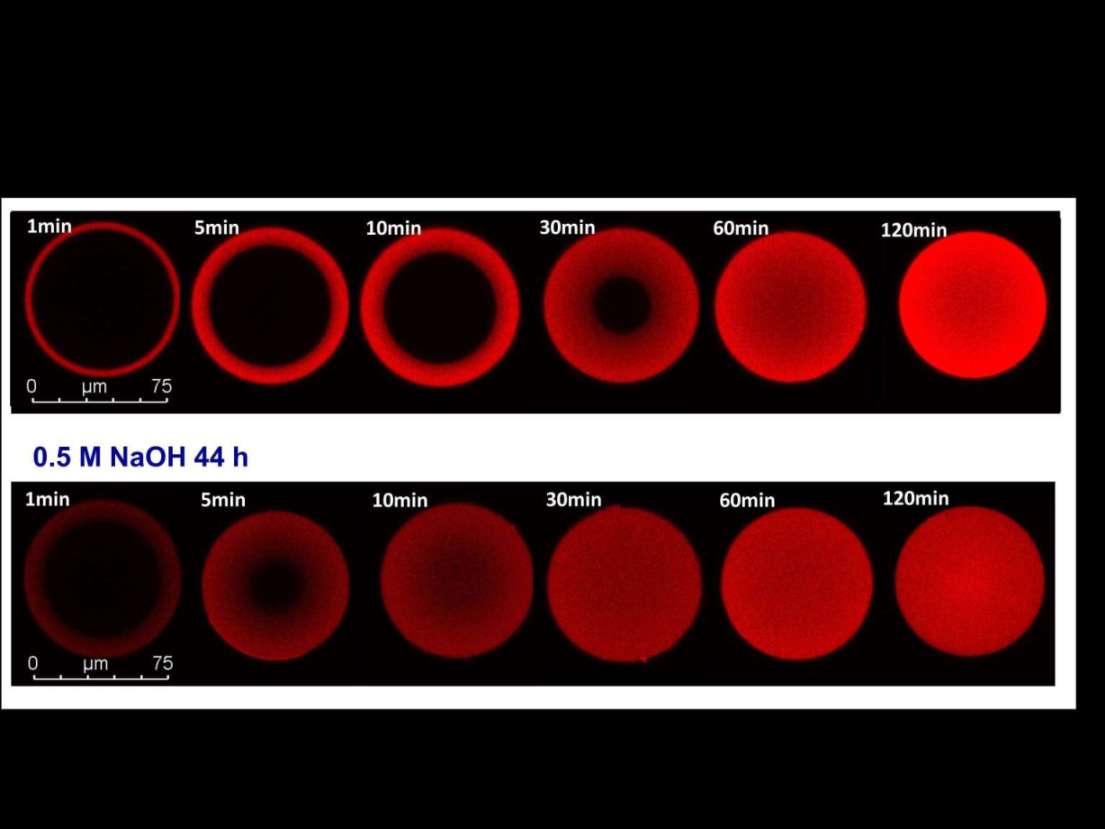
Polyacrylonitrile (PAN) nanofibrous membrane was prepared by electro-spinning technique. After heat treatment, alkaline hydrolysis and neutralization reaction, the ion exchange membrane (namely P-COOH) was further chemically grafted with chitosan molecule. The obtained P-Chitosan membrane (namely P-CS) was then covalently immobilized with Procion orange MX-2R dye from simulated textile wastewater to be used as a dye-ligand membrane. Fiber diameter, porosity, pore size, immobilized dye-ligand concentration, and protein binding capacity were characterized. Furthermore, the membrane was applied to evaluate the binding capacity of lysozyme under various operating parameters (e.g., pH, chitosan mass per volume ratio, immobilized dye concentration, ionic strength, and temperature) in batch mode. The experimental results were directly applied to purify lysozyme from chicken egg white by newly designed membrane chromatography module. The results showed that the recovery yield and purification factor were 98.9 % and 56.9-fold, respectively, in a single step. The binding capacity remained consistent after five repeated cycles of adsorption-desorption operations. This work demonstrates that the dye-ligand nanofibrous membrane holds great potential for purification of lysozyme from real feedstock.
Protein precipitation by polyethylenglycol is a simple, robust and cost effective first capture step for purification. The resulting structure of the precipitate particles has a significant impact on process design and process performance like recovery and dissolution kinetics. Current technologies for visualizing and reconstructing 3D precipitate structures are either very time consuming and expensive (Cryo-TEM) or generate a single average value (a fractal dimension) for a population of precipitate particles (light scattering). We developed a new method using light microscopy to reconstruct the complete three dimensional structure of individual precipitate particles with a resolution of 0.1-0.2 μm. This methods was then used to reconstruct and characterize the three-dimensional structure of particles generated by batch precipitation by PEG as well as continuous precipitation in different shear stress environments. Both methods, batch and continuous precipitation, generate particle structures of very diverse nature, while the average fractal dimension is significantly different between the two (2.40 for batch in low shear environment and 2.52 for continuous in high shear environment). Besides the overall average, when investigating both populations in detail, the distributions of fractal dimensions of individual particles overlap significantly. We could also confirm that the generation of PEG-precipitated particles is diffusion limited, as simulations predict a fractal dimension of 2.4 for diffusion limited precipitation and 1.7 for reaction limited precipitation. A close inspection of the 3D structure of the precipitate also shows monofractality of the particles from micro to nano scale visualized by light microscopy. We showed that the fractal dimension and 3D reconstruction is a valuable tool for characterization of different shear stress conditions and mode of operation. The current switch from batch manufacturing to continuous manufacturing has to take the 3D structure and population of different protein precipitates into account in their design, engineering and scale up.
A preparative high-performance liquid chromatography is an extensively used technique for a purification of commercially important bio macromolecules, such as proteins and polynucleotides. Since process time is becoming more and more critical, fast and effective chromatographic methods are widely required. In this context, target molecule breakthrough point determination is of a great interest for optimization of downstream processing. Ideally, continuous analysis is preferred, such as UV absorbance or fluorescence monitoring, which in some cases however lack sufficient selectivity. An alternative is to perform fast analysis of column outlet fraction via chromatography providing equal or greater selectivity than purification step. This can be done using UPLC that however requires specialized equipment. On the other hand, fast analysis of macromolecules can also be achieved using convective chromatographic media at much lower pressure drop. This opens possibility to combine purification step and chromatographic analytics on a single chromatographic system.
In our case we implemented äKTA Explorer system to test feasibility of proposed approach. On-line analysis of preparative column outflow was performed by sequentially injecting outlet on convection based analytical column operating on the same chromatographic system where target molecules were analyzed. Cationic and/or anionic exchangers were used as chromatographic supports (along with selective protein A membrane), depending on feed sample and its characteristics. Three different case studies were tested: monoclonal antibodies purification, aggregate content and plasmid DNA (pDNA). To adjust limit of detection an algorithm varying number of injections was used. This enabled accurate monitoring of an early breakthrough for concentration below 1%. Due to its simplicity and flexibility such methodology can easily be adopted also in pharmaceutical environments.
To enhance product quality and process robustness in biomanuacturing regulatory agencies have encouraged the implementation of process analytical technology (PAT). This combination of process understanding and control with real-time monitoring of quality and performance attributes also increases process efficiency and productivity. Currently, process performance is monitored by laborious and time-delayed offline analysis after each process step. This conventional approach increases hold times and overall process duration as well as the risk for batch failure. We have equipped a commercial chromatographic workstation with additional online sensors based on multi-angle light scattering, refractive index, attenuated total reflection Fourier-transform infrared, and fluorescence spectroscopy. The combination of these derived online data enables the prediction of product quantity and various purity attributes such as high molecular weight impurities, HCP and dsDNA content simultaneously during the elution phase of a chromatographic purification step. Such predictive models based solely on online data have been established for capture, intermediate and polishing steps of a monoclonal antibody produced in CHO and for fibroblast growth factor 2 overexpressed in E. coli. Online signals and corresponding offline data for product quantity and co-eluting impurities were analyzed by the statistical tools partial least square regression and boosted structured additive regression. Also chromatographic runs with varied process parameters were conducted to determine the predictive power of the models. The established methodology using complimentary online sensors enables the prediction of product quality and process performance attributes simultaneously in biopharmaceutical purification processes within a feedback time below 5 sec. The application of such models allows online pooling decisions and decreases the number of off-line analysis and hold times significantly. The costs for in-process analytics are lowered and the risk for batch failure is reduced. These findings are fundamental for the successful implementation of continuous manufacturing and real-time release in biomanufacturing.
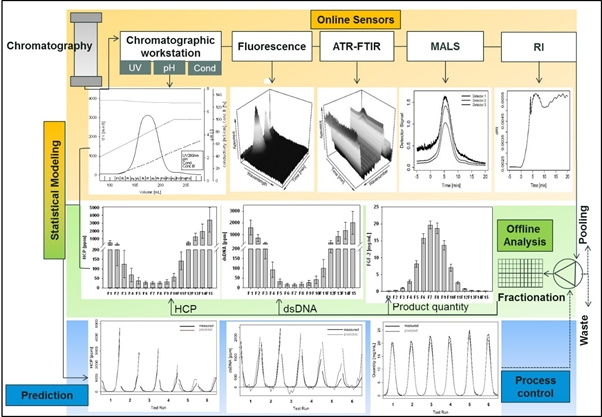
Ion exchange chromatography is a widely used method for purification in all types of biomolecules in current biotechnological downstream processes. Knowledge on the binding behavior of proteins provides valuable insight for understanding the molecular mechanisms of protein interactions in a biological context. However, thermodynamic parameters such as enthalpy and entropy changes accompanied by protein adsorption and desorption are still unknown in ion exchange chromatography. This work relates the change in molar adsorption enthalpy, Δh0, with the salt concentration needed to elute a model protein with a gradient elution, IR. Bovine serum albumin (BSA) was adsorbed on four anion exchanger solid phases possessing grafted ligands (Toyopearl GigaCap Q-650M, Toyopearl SuperQ-650M, Toyopearl Q-600C AR, Q Sepharose XL). A linear relation was observed between the Δh0 and IR. From the highest Δh0 to the most negative: Toyopearl SuperQ > Q Sepharose XL > Toyopearl Gigacap Q-650M > Toyopearl Q-600C AR. The same experiments were also done with a non-grafted conventional solid phase, Q Sepharose FF. However, it did not fit in the same trend due to the ligand disposition. Δh0 was found to be endothermic for Q Sepharose FF and Toyopearl SuperQ-650M and exothermic for the other solid phases. Endothermic Δh0 indicate that entropic effects play a major role on the adsorption of BSA on these two solid phases.
Flexible adaptation to constantly changing market demand is getting increasingly important in the manufacturing workflow of biopharmaceuticals. Moreover, fast development times and reliable scale-up are required and are key to success.
Pre-packed chromatography columns have been commonly adapted in industry during the recent years and allow to reach these requirements, however data showing scalability throughout various column sizes applied in early stage process development up to commercial manufacturing has been not available so far. This presentation confirms the scalability of column performance throughout Repligen's OPUS® pre-packed column line including MiniChrom, ValiChrom and OPUS® Process Scale columns covering a range of 0.5 to 60 cm inner diameter.
Scalability has been demonstrated for various resin types and functionalities and has been proven for both column packing performance and protein separation under isocratic conditions.
Experimental data on OPUS® packing performance has been compared to traditional self-packed columns and found at least equal if not better.
Furthermore a statistical data analysis using advanced software tools has been performed for more than 30.000 pre-packed columns supplied into global industry over a time span of 10 years.
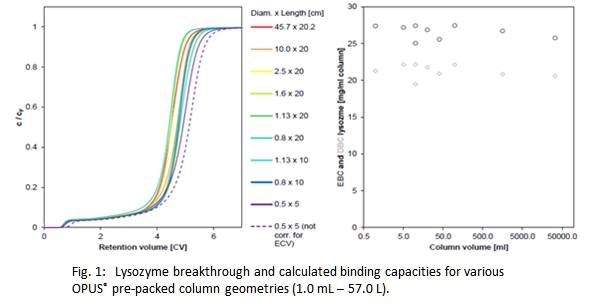
Extra-column effects can have significant influence on separation performance. These effects are caused by dead-volumes, valves, column hardware and tubings. For small scale chromatography systems, and especially with very small columns, the extra-column band broadening can be dominant over the actual broadening of the column that is used for separation. This issue has long been recognized and has been investigated extensively by many researchers. However, though it is often overlooked, also for preparative and pilot scale chromatography extra-column effects can be an important factor. This is particularly valid, if the column size is relatively small. We have investigated the Aekta Pilot system volume contribution to band-broadening by non-binding tracer experiments on columns of various sizes using columns packed by axial compression to ensure consistent packing performance. Additionally, the influence of non-standard mixing behavior occurring in the bubble trap during step elution was investigated using a simplified model of interconnected reactors. Other flow parts of the chromatography system were modelled by dispersed plug flow reactors and CSTRs for dead zones, e.g. column in- and outlet and mixers. Essentially, the effective mixing volume of the bubble trap is affected by the flow rate and the density difference of the two buffers. As a consequence, the influence on the separation in the column varies with these parameters. Experimentally, the band broadening effect of the bubble trap on the chromatographic separation was investigated by performing linear gradient elution and step elution experiments using bovine serum albumin at analytical loads. There was no observable band broadening effect in linear gradient elution. However, during step elution the salt transition profile was affected leading to significant peak broadening of the BSA elution profile.
There is growing interest in mAb processing to improve individual unit operation performance and overall process train efficiency through linked processing. In the downstream process, several types of chromatography are typically performed to achieve the target of purity of therapeutic mAb. AEX chromatography is commonly operated under product flow-through conditions to bind negatively charged impurities such as HCP and virus. CEX chromatography focuses to separate the mAb related impurity. Ichihara et al., (mAbs J. 10-2, 325-334, 2018) reported the operating CEX chromatography in the flow-through mode for mAb aggregate removal. To intensified flow-through chromatography, controlling the feed concentration through single pass TFF (SPTFF) is one of the ideas to get the higher loadings from the isotherm binding condition, especially for AEX column. The use of SPTFF technology can help facilitate these process intensification efforts by modifying process intermediate volumes and concentrations without the need for recirculation. However, the impact of concentration change on other chromatography is not evaluated well on the fully combined in-series operation.
In this work, SPTFF by Pellicon® 3 30kD is used prior to a flow-through chromatography polishing step to boost chromatography resin loading. Then, Eshmuno® CP-FT resin was challenged with various concentrations of mAb feed and evaluated the difference of impurity removal. And results compared the performance of previously reported SPTFF-AEX results (Merck Application Note, AN5364EN00 2017), and evaluate the impact of connected flow-through polishing on feed concentration.
The biopharmaceutical downstream process is designed to achieve high product yield with efficient impurity removal. “Process derived impurities” such as host cell proteins (HCPs), lipid, DNA and fermentation ingredients and “Product related impurities” like aggregates and fragments should be reduced to meet each specification of drugs for quality and safely.
Economical pressure on biopharmaceuticals, especially monoclonal antibodies (mAb), has motivated to develop high capacity chromatography resins and new purification technologies including periodic counter-current chromatography and multi cycle batch chromatography using smaller particle size resins with high flow rate. Thus, load amount onto chromatography resins are tend to increase.
Higher amount loading of not only target proteins but also impurities on chromatography resins affect selectivity and life time of chromatography resins. Increased risk of fouling on chromatography resins by accumulation of impurities should be mitigated as much as possible to minimize burdens on each step to develop stable process with lower COGs.
We developed new impurity reduction method using co-precipitation of impurities without loss of target proteins. The method reduced HCPs and DNA in harvested cell culture fluid expressing mAb one third and one thousandth respectively. We also evaluated the effect on the quality of eluate from protein A chromatography and other benefits on the process.
1. Introduction
There is increased interest in continuous processing for monoclonal antibody (mAb) purification in bind and elute mode. This is because such continuous chromatography offers higher productivity and cost effectiveness than conventional batch mode. JSR developed and conducted a DoE for continuous chromatography process of mAb in bind and elute mode using a high-capacity Protein A resin, Amsphere™ A3.
2. Experimental
The mAb breakthrough was monitored by HPLC. The concentration of Protein A purified mAb was determined from the measured absorbance at 280 nm. Host cell protein (HCP) was quantified by CHO HCP ELISA kit, 3G (Cygnus Technologies). A harvested cell culture fluid (HCCF) contains IgG1 subclass mAb.
A three factor and three level DoE was designed using Minitab (Minitab, Inc.) to determine the impact of purification conditions on productivity (g/L/hr) and HCP concentration. The tested factors were IgG-loading, residence time for washing step and washing volume.
3. Results and discussion
Productivity of the continuous process with Amsphere A3 was calculated on various purification conditions. The results showed that the process time for sample loading and washing steps have significant effect on the productivity. The total amount of HCP in the eluates showed a positive correlation with the sample loading amount, especially when the flow rate for the loading step was relatively faster. That is, washing conditions have smaller effect on the HCP clearance performance with shorter residence time of sample loading step.
4. Conclusions
Amsphere A3 showed high productivity with continuous process because of its high DBC even for high linear flow velocity. Also, we found that the HCP clearance performance is independent from the residence time for washing step. This indicates that higher productivity and good HCP clearance can be achieved together by increasing flow rate and decreasing process time of washing step.
The development of efficient downstream processing plays an importance in therapeutic antibodies (mAb) purification. As an example, a continuous multicolumn chromatography technology in ProteinA capturing step has been attracted attention from biopharmaceutical companies. Recently an integrated flow-through (FT) process is considered to be one of effective approaches for mAb purification. FT mode has an advantage to increase loading amount of mAb per column volume. Further an integrated FT-FT process technology is expected to achieve much less installed chromatography resins, buffer and tanks to use in comparison with a conventional polishing step consisting of bind/elute (B/E) mode and FT mode. This technology will promise pool-less manufacturing for economical mAb process in near future.
Cellulose based chromatography resins are well-known to be stable to caustic condition for cleaning and less nonspecific adsorption properties. These unique properties are suitable to apply an integrated FT-FT process technology for mAb purification. In the past few years we succeeded in developing a unique cellulose based mixed mode resin, Cellufine MAX IB, which can remove impurities effectively in FT mode for mAb purification under high salt condition. The resin is further tested to use integrated FT-FT mode for mAb purification by examining mAb recovery and impurities removal. In this poster, we report development of efficient mAb polishing process by integrated FT-FT mode which consists of a combination of Cellufine MAX IB resin with other cellulose based cation exchange or hydrophobic chromatography resins.
To accelerate process development and optimization of chromatography, it is essential to use mechanistic models to simulate and predict the implementation of such operation for certain products. The universal prerequisites for chromatography modeling involve adsorption isotherm and mass transfer mechanism, where users can choose the models based on the balance of predictability and calculation ability. Unfortunately, most software packages are still not user-friendly because of complexity of models and input parameters.
In the study, different mechanistic models for various simulation platforms that depend on the same isotherm and mass transfer coefficients were tested for linear gradient elution (LGE) of proteins. The model system was separation of basic proteins such as lysozyme and IgG by ion exchange chromatography (IEC). Our model (Yamamoto model) was used for determining the two parameters (A, B) needed for steric mass action (SMA) isotherm model from LGE experiments. As for mass transfer, lumped kinetic model and linear driving force model (LDF) were used as only one lumped mass transfer coefficient (km) is included, which reduces the computational burden in determining individual effect from axial dispersion and pore diffusion, and such. The km value was determined also from LGE experiments based on Yamamoto LGE-HETP model, which includes the compression factor for the peak sharpening effect in LGE.
By a set of LGE experiment, the major parameters (A, B, HETP) can be obtained, and thus the adsorption and mass transfer models for mechanistic modeling can be constructed. Different simulation platforms have given similar outputs in comparison, which demonstrates that modeling for protein chromatography can be achieved from limited LGE data in different computational tools, albeit the coefficients definition varies in the software.
Reference Yoshimoto, Yamamoto, Simplified methods based on mechanistic models for understanding and designing chromatography processes-Yamamoto Models and Approach-, in Preparative chromatography for separation of proteins, 2017
The changes from stainless steel equipment to single-use solutions as well as switching from batch to continuous operations are currently strong discussed topics in the field of downstream processing. Besides the product yields and the purity grades, the footprint reduction and higher productivities result in decreased cost of goods (CoGs). With these developments, not only economic but also ecological goals will be achieved through buffer and materials savings. In the course of the present evaluation, we compared continuous and single use solutions to conventional platform processes and quantified their economic and ecological impact. In detail, we have compared a cell culture antibody process consisting of conventional broth clarification by centrifugation and batch capture by protein A affinity chromatography with a continuous process consisting of continuous clarification by depth flocculation and continuous precipitation and/or periodic counter current chromatography (PCC). Our results show potential cost saving strategies and how ecological goals and improved costs of goods can be combined. Possible savings of 30 % can be achieved by combining novel technologies and buffer savings of 60 % can be realized by the use of precipitation or PCC. The scenarios were evaluated for an existing facility with a bioreactor scale of 1,000 L as well as for two theoretical facilities scaled for either an orphan drug production of 50 kg/year or a blockbuster production of 1,000 kg/year.
The antibody manufacturing process is consisted of a cell culture process using animal cells and a purification process including several chromatography steps and filtration steps. The purification process is important to obtain high quality bio-pharmaceutical products by removing impurities, and measurement of antibody concentration is a fundamental and essential factor to control the manufacturing process and to confirm the yield of each purification step.
The concentration range in the purification process is wide, and over 100 mg/mL concentration can be observed for example in a final polishing step. In this study, optical rotation was applied for the first time to measure various concentrations of antibody and their accuracy was evaluated. Furthermore, the possibility of application to the process analytical technology was also discussed in the poster presentation.
Virus filter is essential step to eliminate viruses in the Bio-pharmaceutical products. Continuous bioprocessing is of great interest for bioprocess manufacturers because of the possibilities of reducing production time, cost and footprint. One important element of continuous bioprocess is tankless connection between the adjacent steps, however virus filtration is mostly batch process, in which the target protein solution is pooled in a tank and then loaded to the virus filter with constant pressure. One reason of the preference of batch process is the concern of possible flux decay during the loading process Especially if chromatography process is connected directly to virus filter, flux decay by the sudden pressure rising is fatal for the manufacturing process. In this concern, virus filters with multi-layer structure as shown in the figure having high robustness in the continuous loading are necessary for the manufacturing process
Chromatography process is located just in front of the virus filter step and it affects the permeability of virus filter significantly. Especially ion exchange chromatography (IEX, AEX or CEX) step is usually just before the virus filter in the IgG purification process and impurity removability of IEX step is essential for the virus filter permeability.
In this study, the effect on the virus filter permeability of different types of IEX chromatography resins, i.e., normal IEX and mixed-mode IEX, are compared by using IgG solution with spiking aggregates. Mixed-mode AEX shows much higher aggregate removal than normal AEX. The virus filter permeability is tested both for constant pressure and constant flow rate loading. The dependencies of IgG concentration and flow rate are also tested. These results indicate that appropriate combination of IEX resin, column volume, virus filter membrane area and flow rate is very important for high protein recovery and the cost effectiveness process in the continuous bioprocessing.

Chromatography separation, which is essential in biopharmaceutical industry, is not widely used in food industry as food products are much less expensive than pharma products. However, as functional foods are highly anticipated, there is an increasing need for development of efficient and economically-feasible chromatography process for food separation.
In addition to the cost issues, food separations have many constraints and requirements, which make it difficult to use chromatography. As for the stationary phase (resins) and the mobile phase (liquid), they must be chosen based on the accepted materials by the regulatory agency. In addition, the resins must be cleaned and sanitized easily. Considering these requirements, polystyrene divinylbenzene (PS-DVB) resins-based chromatography with ethanol-water mobile phase is most attractive. The resins can be washed with sodium hydroxide. Ethanol is a very safe solvent, and can be recycled easily if needed.
In this study, a simple method for determining the optimum temperature for the above mentioned chromatography system was proposed based on the iso-resolution curve concept. The model samples were polyphenols (catechin and epigallocatechin gallate). PS-DVB resins were employed for the column stationary phase. The mobile phase was ethanol-water mixture. The distribution coefficient K was determined as a function of ethanol concentration,I , and temperature, T. A method for calculating the iso-resolution curve was developed with K, T, and mobile phase velocity, u. From the iso-resolution curve, the productivity was calculated as a function of I, T and u. It was found that there is an optimum T, where the highest productivity considering minimum mobile phase consumption.
From the industrial point of view, precise temperature control is costly. However, choosing the right temperature will result in more efficient separation processes.
Various different sizes of pre-packed chromatography columns are needed for process design, pre-clinical trials and production. It is therefore needed to evaluate the quality of pre-packed columns properly. HETP and asymmetrical factor As measured at non-binding conditions are commonly employed to check the packed bed quality. In this study, for capture chromatography (protein A) columns E = DBC/SBC vs. F0 plots [1] were used for the evaluation. DBC is the dynamic binding capacity and SBC is the static binding capacity. F0 is the dimensionless group, which is given by the square of particle diameter divided by the molecular diffusion coefficient and the residence time. For polishing chromatography columns (ion-exchange chromatography), another dimensionless group, Ym was used for the evaluation. Ym is composed of column length, velocity, particle diameter and gradient slope [2].
Reference
[1] N. Yoshimoto, T. Yada, S. Yamamoto; A simple method for predicting the adsorption performance of capture chromatography of proteins. Jpn. J. Food Eng., 17, 95–98 (2016).
[2] N. Yoshimoto, S.Yamamoto; Simplified methods based on mechanistic models for understanding and designing chromatography processes for proteins and other biological products-Yamamoto models and Yamamoto approach-, in Preparative chromatography for separation of proteins, Chap 4, Wiley, New York, 2017, pp. 111–157.
<Introduction>
In antibody drug manufacturing, Protein A affinity chromatography is performed as separation and purification steps using its specific binding ability to antibodies. In the manufacturing process, two different packing systems, Axial compression (AX) and Pack in Place (PIP), are mainly used to pack Protein A chromatography resins into large-scale columns.
KANEKA KanCapATM (KanCapA), which is one of our commercially available Protein A resins, can be appropriately packed into both AX and PIP system columns. With PIP system column, however, it is important to select conditions because PIP packing is susceptible to various parameters.
<Experiment and Result>
Some parameters for PIP packing were investigated with 80cm I.D. Chromaflow column (PIP system column of GE HealthCare) in this study. Higher slurry concentration and higher slurry flow rate led to better column performance. In addition, pump pulsation at the feeding slurry had an influence on the performance and installation of pulsation dampener reduced the influence. Consequently, good column performance was realized by setting slurry concentration and its flow rate appropriately with pulsation dampener.
<Conclusion>
It is feasible to realize good column performance by packing KanCapA into PIP system column with proper slurry concentration and its flow rate. Even with pumps generating large pulsations, good column performance is also realizable using pulsation dampener.
Continuous manufacturing is expected to be more efficient for production of biologic such as monoclonal antibodies (mAbs) compared with batch productions. Various unit operations are included in downstream processing (DSP) of mAbs such as chromatography and membrane separation. Virus inactivation is also required in DSP.
Tubular reactors are possible formats for continuous virus inactivation. It is important to know dispersion behavior in tubular reactors. For open tubular reactors, the dispersion is described by Taylor dispersion due to molecular diffusion. We carried out pulse response experiments to measure response curves (residence distribution curves). Various factors affecting the dispersion such as molecular diffusivity, tube diameter, tube diameter to coli diameter ratio, temperature and viscosity were examined.
Continuous countercurrent chromatography is a valuable tool for the purification of peptides produced by chemical synthesis. Using a process comprising two reverse-phase columns and internal recycling (MCSGP), peptides are purified on a preparative scale with high yield and purity simultaneously while the generation of side-fractions and re-chromatography is avoided. The poster introduces the process concept, lab- and production scale equipment, and recent results of an economic evaluation of MCSGP in comparison with batch chromatography, showing the large upside of employing the two-column process.
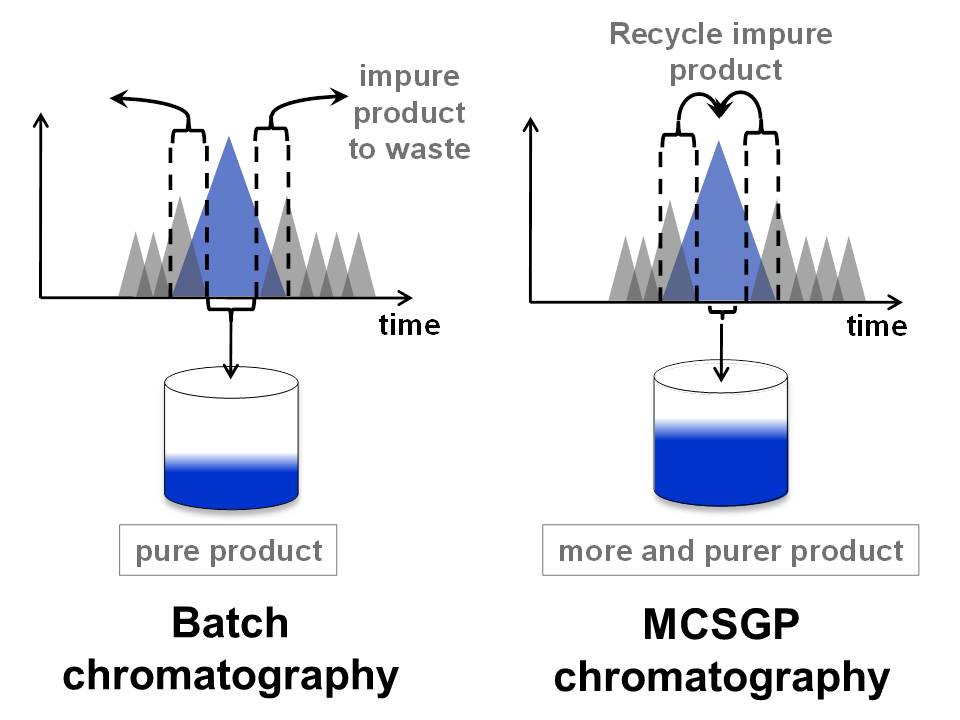
Chromatography is considered as a critical part in antibody manufacturing process. To improve the productivity of the process, different strategies have been investigated. Flow-through chromatography (FTC) is being considered as one operation which can increase the efficiency in downstream process by adjusting the mobile phase environment that makes contaminants bind tighter to the column while the product elutes out as flow-through fraction.
A mechanistic model containing distribution coefficient and plate number to describe the start and the end of the protein elution fraction and contaminants is developed for FTC. From a set of linear gradient elution experiments in different gradients, the correlation between distribution coefficient and salt concentration can be determined. Combined with the particle diameter and diffusion coefficient, plate number under certain elution condition (e.g. pH, retention time, etc.) can be calculated. By setting the end of the product to be equal to the start of the contaminant, the optimal amount of sample loading and its productivity can be obtained.
In the study, samples containing bovine serum albumin monomer and dimer were selected for separation by ion exchange chromatography. Based on the mechanistic model, productivities under different mobile phase condition including pH, particle size, and retention time were determined for 100L of material with 100 minutes of operation time. A small scale of FTC experiment was conducted to verify the model predictability. Based on the result, separation process for proteins can be developed and simulated by adjusting the parameters involved in the model to achieve higher productivity.
Diafiltration is a critical unit operation which is part of practically every downstream purification train of monoclonal antibody or bio therapeutic modality production. It is typically employed to provide an efficient and robust method for exchanging buffer matrix for the therapeutic modality and offers simultaneous clearance of small molecule and elemental impurities.
Continuous manufacturing and process intensification approaches has been an area of keen interest and various technologies are being investigated to make biotherapeutic manufacturing process more efficient in terms of facility utilization and capital cost reduction by reducing reliance on large scale facilities. Technologies like multi-column cycling, inline viral inactivation and single pass tangential flow filtration (SPTFF) for protein concentration have been developed in past few years, offering significant improvement over their existing batch equivalents. Ability to develop a similar technology for diafiltration suitable for GMP manufacturing has remain rather elusive.
Our approach here is based on a shift in perspective wherein the process design is based on membrane utilization and system footprint as opposed to flux and process time in a typical batch diafiltration process. This rather flexible technology offers 6-8-fold increased membrane utilization, up to 3-fold reduction in pump passes and system footprint can be substantially decreased. Buffer usage, extent of buffer exchange, and product yield are consistent with a constant volume diafiltration process.
In this presentation, we will present a system design for this concept and a 24-hour experimental data demonstrating operational robustness. Implementation into a fully continuous, or intensified process train and flexibility of the system to accommodate complex diafiltation schemes for challenging molecules will also be discussed.
Monoclonal antibodies conjugated with drugs (ADC) have received much attention as pharmaceutical agents for treating serious diseases such as cancer. However, it is difficult to separate them on the basis of the number of conjugated drugs. Hydrophobic chromatography (HIC) is commonly used for the analysis of the drug to antibody ratio, DAR. The retention of ADCs on HIC can be controlled by the hydrophobic nature of ADCs, depending on the mobile phase conditions. They are sometimes performed at the restricted conditions where the solubility is too low and thus one cannot archive high capacity. Ion exchange chromatography (IEC) using electrostatic interaction is an orthogonal method to HIC. IEC is widely used because of its higher capacity than HIC. We investigated the retention behavior of the protein conjugated surrogate drugs on IEC. The surrogate drugs employed are 7-diethylamino-3-(4'-maleimidylhenyl) 4-methylcoumarin (CPM), N-(1-pyrenyl)maleimide (NPM) and Cyanine5 mono NHS Ester (Cy5-NHS). Bovine serum albumin (BSA) and human immunoglobulin G (h-IgG) were used as a model protein. The molar ratio (CPM or NPM or Cy5-NHS to protein) was set to 3. The maleimide group of CPM and NPM reacts with the thiol group of the proteins, and the NHS ester group of Cy5-NHS reacts with the amino group of the protein. On the linear gradient elution experiments, the elution salt concentrations of the conjugated and non-conjugated proteins were measured to obtain chromatographic parameter of the number of binding site, B.
The graft-type ion exchange chromatography is expected to have a high binding capacity. However, in some cases, the steric hindrance needs to be considered in the pore fulfilled by the grafted ligand. It is difficult to visualize the structure in the pore, and it is not known how the adsorption reaction is progressing. In this study, the heat of adsorption reaction was measured by using isothermal titration calorimeter (ITC), the enthalpy and entropy changes associated with protein adsorption to the graft-type ligand were analyzed, and the relationship with the capacity and structure of pore was discussed. SuperQ 650M, GigaCapQ 650M and Q-600C AR were used as the resins with graft-type ligands, and bovine serum albumin (BSA) monomer was used as the model protein. The binding isotherm was obtained by varying the concentration of BSA from 0mg/mL to 20mg/mL incubated with 50% resin slurry. The equilibrated binding capacity of Super Q was only about 1/4 of that of Q-AR. For the measured enthalpies by ITC, GigaCapQ and Q-AR were negative and SuperQ was positive. From these, it can be seen that adsorption is exothermic and endothermic, respectively. Also, ΔS was calculated by ΔG from the adsoprtion isotherm and ΔH from ITC. As the result, it turned out that enthalpy contribution was large in GigaCapQ and Q-AR, entropy contribution was large in SuperQ. This indicates SuperQ needs the release of water and counter ions when electrostatic interaction occurs. There is less steric hindrance in GigaCapQ and Q-AR (=there is little entropy contribution), the adsorption mechanism is driven by electrostatic interactions.
In the present work, we studied the adsorption behavior of immunoglobulin G (IgG) in commercially available protein A resins by use of confocal laser scanning microscopy (CLSM) together with the fluorescein isothiocyanate (FITC) conjugate, combining a newly proposed calibration method. CLSM provides the capability to collect serial optical sections from thick specimens, and thus applying to protein A resins taking up FITC-IgG it enables us to pursue the progress of adsorption front within a particle and furthermore to determine apparent diffusion coefficients through a model-based analysis. Although CLSM could count as powerful method to understand intraparticle mass transfer, there seems no availability of appropriate data without taking account of the optical hindrance inside a porous resin particle. The laser light penetrating a resin particle is likely to be attenuated with the scattering by particle matrix, absorption by fluorescent label, or both, and furthermore the fluorescent light emitted from the fluorescent label of adsorbed proteins could undergo these interactions, too. Therefore, the light attenuation of exciting and emitted light is necessary to be calibrated in determination of the distribution of protein amount adsorbed. For this purpose, we propose to adopt the attenuation ratio, determined from a negative image of the particle taken by use of the fluorescein solution with a concentration at which the solution itself can emit fluorescence with the laser light used. Though found a large difference in the light attenuation depending on resin, we concluded from the dependence of the attenuation ratio on the dye concentration that the scattering by particle matrix mainly contributed to the light attenuation but the absorption by fluorescent label did less. By combining this calibration method with CLSM it makes possible to compare the profile of protein amount adsorbed within a particle among different types of resins.
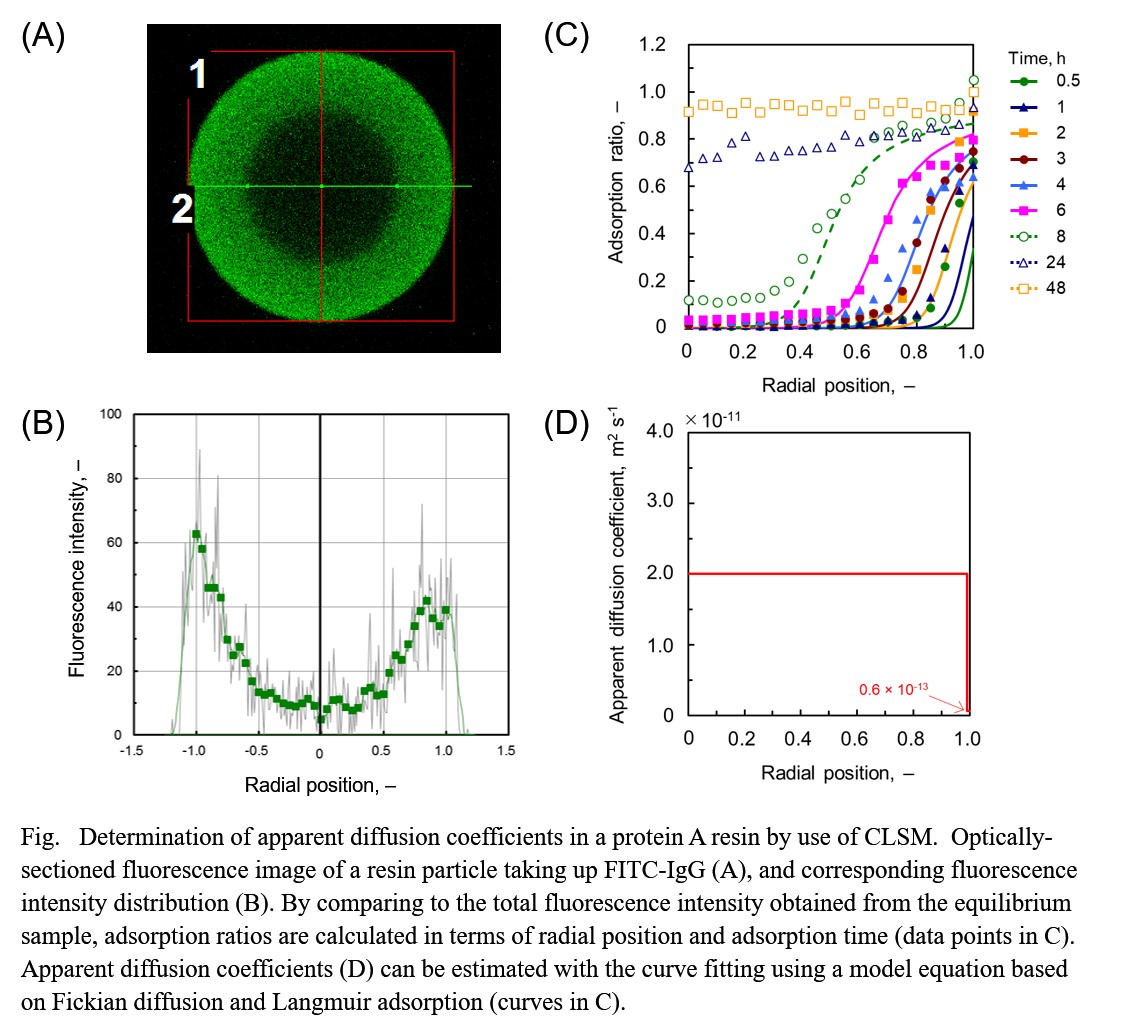
Antibody drugs have specificity and act only on the target site, so they have few side effects and are expected as therapeutic agents for cancer etc. In chromatography used for separation, purification, etc. of antibodies, there is graft type ligand chromatography where ligand is increased by introducing a graft chain for the purpose of increasing adsorption amount.
However, it is also feared that pore blockage may cause diffusion inhibition. Therefore, we used some grafted chromatography to investigate the actual adsorption mechanism.
In this study, two columns, graft type Super Q and Q Giga Cap, were used. The pore size was calculated using DNA. Q Giga Cap was 3.0 nm and Super Q was 4.6 nm. It was found that when the diffusion coefficient at that time was determined, the diffusion resistance increased as the pore size decreased. In particular, in the case of small pore size Q Giga Cap, the amount of decrease was large.
In addition, as a result of measuring the adsorption amount of BSA, Q Giga Cap showed higher DBC than Super Q. This is because the space volume of the graft chain layer is large.
From the above results, it was found that the introduction of the graft chain increases the diffusion resistance but increases the adsorption amount.
Antibody-Drug Conjugation (ADC) is studied actively as future Drug. ADC has parameter called Drug-to-Antibody Ratio (DAR). DAR is number of drugs on antibody. Now, DAR is controlled by genetically modified cell, bad this is not simply. To control the DAR of ADC from normal antibodies is difficult by reaction of antibody and drug. DAR should be controlled without complicated procedure. Therefore, it is necessary to separate precisely. In this work, for the development of separation technology of ADC by Ion Exchange Chromatography (IEC), we analyze the ADC's adsorption system. There are many studies of separation by Hydrophobicity Interaction Chromatography (HIC). However, HIC is complicated by column selection. IEC is more simply procedure and higher recovery rate than HIC.
Result of analysis of the number of adsorption site B, model ADC A from Lysozyme is lower number than native Lysozyme. However, model ADC B from Bovine Serum Albumin (BSA) is higher number than native BSA. Therefore, ADC B is considered to be aggregated with the conjugated BSA as a core. Also, ADC conjugated charged drug is higher amount of change than ADC conjugated hydrophobicity drug. Therefore, ADC conjugated charged drug is higher effect than ADC conjugated hydrophobicity drug.
Abstract
Chemical diffusion and reaction are generally involved in the formation of materials. These two processes are coupled together and play a role in the structure evolution of materials. Although the individual role of diffusion and reaction has been investigated, it is still unclear how these two factors work together to determine the materials structure and what is the mechanism behind. Firstly we used different approaches to regulate the diffusion and reaction rates in the synthesis of silver particles [1-3]. The role of diffusion and reaction in shaping particles was generalized. At a diffusion limitation, small silver particles were obtained and big polyhedral particles were formed at a reaction limitation. In the middle range of diffusion and reaction, dendritic structures were largely produced, which is independent on the preparation methods. In the following, the control on diffusion and reaction has been extended to synthesize other materials and the similar results were obtained [4-6], which further confirms the general role of diffusion and reaction in shaping materials. The Damkoehler number was employed to quantify the relative change of diffusion and reaction[7]. It was found that the morphology of materials is dependent on the relative strength of diffusion and reaction. Since the diffusion and reaction determine the chemical distribution around the growth front of materials, the local chemical gradient was proposed to be the mechanism of diffusion and reaction controlling materials structures, which was verified by measuring the local chemical distribution by laser interference as well as by conducting phase field simulation.
References
[1] Chemical Engineering Science 2018, 192, 254-263.
[2] Chemical Engineering Science 2015, 138, 457-464.
[3] Ind. Eng. Chem. Res. 2016, 55, 8319-8326.
[4] CrystEngComm 2017, 19, 72-79.
[5] Crystal Growth & Design 2013, 13, 1820-1825.
[6] Advanced Energy Materials, 2019, doi.org/10.1002/aenm.201900019.
[7] Crystal Growth & Design 2016, 16, 2850-2859.
Numerical modeling plays a leading part for virtual manufacturing in industries. When numerical technologies are utilized in the general industrial systems, high-accuracy, simple operation and calculation efficiency are always required. The requirements are the same even in powder industries. In the author's group, innovative models such as coupled discrete element method (DEM) with volume-of-fluid (VOF), signed distance functions (SDF) and coarse graining DEM have been developed for the simulations of granular flows in industrial powder systems. The SDF makes it possible to create an arbitrary shape domain by simple operation. The SDF has been applied to various powder systems such as mixers, die filling and conveyers so far. Besides, calculation domain for simulations of industrial multi-phase flows including solid particles can be created easily by combining the SDF with immersed boundary method (IBM). The coarse graining DEM is a scaling law model and can simulate large-scale systems by smaller number of computational particles than actual ones. Efficiency of the coarse graining DEM has been examined through several industrial systems such as a spouted bed and a fluidized bed. The DEM-VOF method can simulate gas-solid-liquid flows in an arbitrary shape domain because the SDF and the IBM has been introduced as wall boundary model. The DEM-VOF has been applied to a complex gas-solid-liquid flow system such as a twin screw kneader. Adequacy of these models has been proven through verification and validation tests. Hence, in the future, usage and/or combination of these models will be useful for virtual manufacturing.
This study is financially supported by JSPS KAKENHI grants (17KK0110, 17H02825 and 17H03451).
The inhaled drugs are generated as aerosol in dry powder inhalers (DPIs) and then delivered into respiratory tract. The deposition in the target sites mainly depends on a number of factors related to anatomical structure variation, particle characteristics and inhalation conditions (inhaled angle and breathing pattern e.g.). This project aims to numerically and experimentally investigate the effects of inhalation parameters on fine particle deposition in the US pharmacopeia throat (USP), idealized mouth-throat (IMT) and realistic mouth-throat (RMT) models with a commercial inhaler (Handihaler®). In the numerical model, the flow-field equations are solved by computational fluid dynamics (CFD). The monodispersed and Rosin-Rammler distributed particles in the size range of 1-20 μm are tracked with discrete phase method (DPM). Corresponding physical experiments under the same inhalation conditions are designed to quantitatively and qualitatively characterize particle deposition in realistic mouth-throat as well as validate the numerical results. The results indicate that particle deposition fraction and spatial distribution are highly sensitive to the geometrical variation and respiratory conditions such as the inhalation airflow rate, particle size and inhalation angle. Moreover, the effect of geometrical variation on the particle deposition pattern is more dominant. In the RMT model, inhalation angle creates quite obvious effect on the aerosol delivery, especially for particles depositing in oral cavity. This study could be used to develop an in vitro method which aims to better predict in vivo lung deposition mechanisms of pharmaceutical aerosol.
Keywords: computational fluid dynamics, particle deposition, dry powder inhalers, mouth-throat geometry.
Ironmaking blast furnace industry involves many complex thermochemical processes including, for example, multiphase flows, heat and mass transfers and chemical reactions. It is essential to understand, visualize and optimize the in-furnace phenomena for competitiveness and sustainability under increasing economic and environmental demanding conditions. Mathematical modelling, facilitated by physical modelling, provides a cost-effective way of achieving this goal. In particular, multiscale modelling is widely used in academia and industry for their proven effectiveness. This paper will review our recent CFD- and DEM-based process models and discuss their roles in the development of new technology for sustainable ironmaking. Some recent examples are used: 3D modelling of blast furnace with raceway, 3D modelling of pulverised coal injection, and 3D modelling of cokemaking. It is demonstrated that mathematical modelling indeed plays a significant role in process understanding and optimisation, vital to sustainable modern ironmaking.
Hydrogen production by coal gasification in supercritical water is a promising way of coal utilization due to its clean, efficient and low-carbon characteristics. How to further lower the temperature for complete conversion of carbon in supercritical water is a hot topic. Extensive theoretical and experimental investigations were conducted in State Key Laboratory of Multiphase Flow in Power Engineering since 1997.
(1) The rate-determining steps for the supercritical water gasification of coal particles were obtained at different spatial scales. Experimental device such as supercritical water visual platform that combining Raman spectrometer was established to reveal the microscopic kinetic mechanisms. Density functional theory (DFT) and reactive empirical force fields (ReaxFF) were combined to investigate the rate-determining steps and its reaction enhancement strategy. The directional gasification characteristics can be obtained by coordination regulation and control method of temperature and pressure for chemical/transport properties of supercritical water.
(2) A fluidized reactor operating in supercritical water condition was invented. A series of theories of multiphase flow, heat/mass transfer, and chemical reaction gasification in supercritical water fluidized bed reactor were established. By the approach of the coordinated matching of mass flow and energy flow, the primary reactions were enhanced while the side reactions were suppressed.
(3) A demonstration plant was constructed to verify the above-mentioned theories. The carbon content in coal is completely gasified below 670 °C. The C, H, O content in typical coals can be converted to H2 and CO2, while other impurities are flushed off in clean, non-toxic and inert ashes. The demonstration plant operation has lasted continuously and stably for more than ten thousand hours, which lays a foundation for large scale industrialization and widespread application, so as to provide a new way for the solution of energy shortage problems, haze controlling and the realization of a clean and efficient utilization of coal.
Non-oxidative dehydroaromatization can convert methane into important aromatic products, such as benzene toluene and naphthalene, and produce large amounts of hydrogen simultaneously. A pilot-scale methane dehydroaromatization—H2 regeneration fluidized bed system (MDARS) has been developed. The catalyst circulates between two fluidized beds which are methane dehydroaromatization reactor and catalyst H2 regeneration reactor. The fluidization and energy transportation including mechanism of catalytic reactions are modelled in the Eulerian-Lagrangian Multi-Phase Particle-in-Cell (MP-PIC) methodology, also called Computational Particle Fluid Dynamics (CPFD). MP-PIC model uses a stochastic particle method and an Eulerian method for the fluid phase to solve equations for dense particle flow.
The mechanisms of methane dehydroaromatization reaction and catalyst deactivation reaction were investigated by fixed bed reactor and agreed with the experiment data. The whole system with two reactors and one cyclone was simulated in one model so that the interaction between two fluidized beds and catalyst deactivation can be investigated. The simulation results indicated that the catalytic activity remain stable, and the optimal regeneration-reaction ratio is 8 which consistent with the experiment results. The influence of catalyst particle size and catalyst loading were also investigated. The results showed that the small catalyst particle size can increase the methane conversion and products formation rate. The suitable catalyst loading is between 20~30 gram in consideration of the conversion and formation rate per catalyst mass. More operating conditions can be varied over a wide range to optimize and scale-up the methane dehydroaromatization—H2 regeneration fluidized bed system.
The downer reactor, in which gas and solids move downward in a co-current way, has attracted many attentions in the past two decades due to its unique features such as shorter residence time, narrower residence time distribution, less solids back-mixing and lower pressure drop since gravity acts in the same direction with the flow direction of gas and solids when compared to the flow behaviors in riser. How to increase the solids holds-up in a downer is still an important issue. In this talk, solids volumetric flux (Vs), which is expected to replace the solids mass flux (Gs) as the key factor influencing solids holdup in circulating fluidized beds, was proposed to investigate the solids holdup variation and predict the extreme operation conditions in the downers. It is considered that using Vs to replace Gs to define high-density operation in the downer could be more suitable in this study To increase the solids-up in the downer, the flow behaviors in a series of novel gas-solids co-current downflow conical fluidized bed which is expected to realize a high-density solids holdup along a downer-type pyrolyzer to strengthen the heat transfer efficiency, were systematically investigated by means of a numerical approach. In addition, A Eulerian–Eulerian model incorporating the kinetic theory of granular flow was adopted to simulate the gas-solids flow behaviors in a dense downer below a conventional downer, which could be used for the further pyrolysis of coal and/or decomposition of tar on the generated char before the char and tar are completely separated in a triple-bed combined circulating fluidized bed (TBCFB) system.
(Acknowledgments:This work is supported by the JSPS KAKENHI Grant-in-Aid for Scientific Research B (Kiban B, 17H03451), Japan and the National Natural Science Foundation of China (U1710101)
Biomass is a carbon-neutral fuel and has the potential to replace coal in ironmaking blast furnaces (BFs) under the carbon-constrained environmental policy conditions. However, the flow and thermochemical in-furnace phenomena related to biomass combustion are not clear at industrial scale BF conditions yet. In this study, a three-dimensional (3D) industrial scale computational fluid dynamics (CFD) model is developed for describing the flow and thermo-chemical behaviours related to charcoal injection into the lower part of a BF under the real BF conditions. The computational domain includes lance, blowpipe, tuyere, raceway and the surrounding coke bed regions. The model features characteristics of the industrial scale BF and charcoal materials, including the real dimensions, operating conditions, bird's nest within the raceway, coke bed around the raceway, non-spherical particle shape of charcoal particles, modified sub-models of charcoal chemical reactions. The simulation results show that the charcoal combustion process can be classified into 5 stages based on the evolutions of the gas species, burnout, fuel gas and gas temperature along the particle plume. The behaviour of different charcoal particle size groups varies considerably within the raceway. The combustion profiles of the charcoal and two typical PCI coals are then compared. It is indicated the burnout profiles comparable qualitatively, confirming the potential of charcoal utilization in PCI technology, whereas the temperature and gas species profiles are different from typical PCI operation quantitatively, indicating the charcoal injection and its control strategy should be redesigned in BF practice, for example, the use of finer mean particle size. This industrial scale model is useful for understanding the combustion behaviour of pulverized charcoal and optimising biomass injection operations.
There are continuum and discrete approaches to describe granular flows. A continuum approach relies on local average quantities which can be derived through an averaging method based on a discrete approach. But the selection of averaging domain and the validity of local quantities for constitutive relations are not well established, particularly for transient particle-fluid flows. This presentation is about our recent study in this direction for non-cohesive and cohesive particles. Here, it is demonstrated that converged local quantities can be achieved on an averaging domain with proper spatial and temporal sizes. Furthermore, the relation between solid pressure and solid volume fraction is established, agreeing qualitatively to all the existing monotonic ones in the literature. But it is quantitatively different, showing a bifurcation at a high solid volume fraction, which is essentially linked to the variation of short and enduring contacts among particles with flow state and solid volume fraction. This bifurcation must be properly recognized in developing constitutive relations for granular materials. It is also demonstrated that there are different temporal scales in the fluidized bed and different averaged quantities can be obtained, showing the transient heterogeneous structures.
Coupled method the discrete elements method (DEM) with the computational fluid dynamics (CFD) is widely used for numerical simulation of gas-solid two phase flows, such as fluidized beds. In the DEM-CFD method, the modeling of the arbitrary shaped boundaries and stable algorithm are essential for simulating engineering processes, as industrial systems often have complex shaped wall boundaries. To model arbitrary shaped boundaries, the SDF-IBM wall boundary modelling, where the signed distance function (SDF) are coupled with immersed boundary method (IBM), has been developed. The efficiency and accuracy of the SDF-IBM boundary modeling have been proved through verification and validation tests. On the other hand, when drag forces acting on solid particles becomes extremely high, numerical simulation cannot be performed stably. In order to solve the instability problem, the aim of this study is development of an implicit algorithm for stable calculation for the drag force term. In verification test in the fixed bed, it is revealed that the implicit algorithm solves the numerical instability problem in the drag force. Subsequently, a new robust implicit algorithm which combined the implicit algorithm to SDF-IBM wall boundary modeling is developed and the validation tests are performed in a fluidized bed with inserted tubes. Consequently, a robust implicit algorithm for DEM-CFD method is developed and adequacy of this algorithm is proved through validation tests.
From our previous research, it was found that the sediment of well-dispersed slurry could act as a continuous osmotic pump and kept sucking water for long time. This means that the sediment of well dispersed slurry is expected to be a pump for irrigation and greening desert. In order to achieve this, it is important to increase the amount of sucking water flux, thus, the effects of slurry conditions on the water sucking behavior for the sediment of well dispersed slurry must be clarified. Therefore, in this study, we investigated the effects of slurry conditions such as particle size, particle concentration, slurry height, type of additives, on the water sucking flux of the sediment. In addition, the osmotic pressure generated by the sediment for various slurries were measured. It was shown that the sediment of the smaller particles could generate the larger osmotic pressure and show the higher water sucking flux, since the overlap of the electric double layer became remarkable for the slurry of smaller particles.
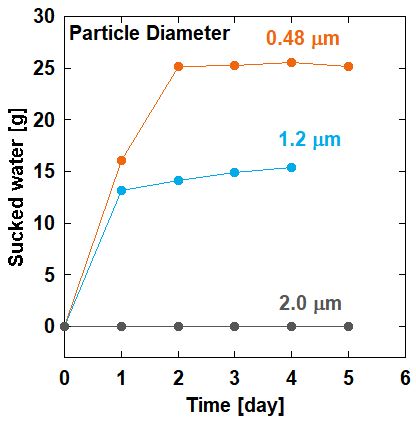
Ash adhesion and deposition phenomena on the surface of super heater and furnace wall has hindered the stable operation of coal, biomass and waste combustion and power generation plants. These phenomena also reduced the efficiency of power generation and heat transfer. Based on the measurement of tensile strength and shrinking behavior of various ash powder bed collected from the coal-fired power plant and waste incinerator at high temperature ranging from 773 to 1173 K, we estimated that a very few amount of liquid or slag phase formation of main component SiO2 with alkali metal, such as Na and K, contributed to the increase of adhesion force between ash particles. However, since many other chemical compounds were included in real combustion ash, it is difficult to discuss the quantitative influence of alkali component in ash on the adhesion behavior at high temperature. In this study, in order to clarify the influence of alkaline components on adhesion behavior, some kinds of synthesized model combustion ash particles with different alkali metal content were synthesized from pure silica particles. The tensile strength and shrinking behavior of each synthesized ash particle bed at high temperature was carried out and analyzed by thermodynamic calculation. Fig.1 shows tensile strength at 900°C of synthesized ashes with different contain of Na and K. By the few amounts of Na and K content (lower than several few %) in synthesized model ash, the adhesion force increased more than several 10 times compared with pure silica particles. Furthermore, alumina nanoparticles, which was useful to reduce adhesion force by the addition with real ash particles in our previous paper, were similarly added to synthesized model ash, and then the effect of adhesion behavior at high temperature were investigated.
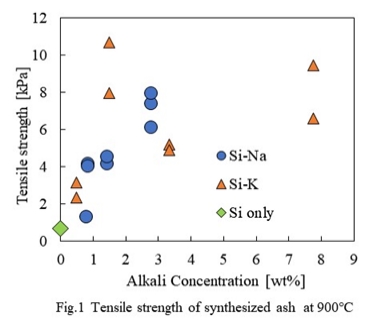
As mediators for cell communication, exosomes are an emerging carrier for drug delivery. Cell communication is a dynamic process, will affected dramatically by the cell conditions, however, the present studies only focus on the normal condition. Inspired by this, we compared the cancer cell uptake of five different stressed and normal cancer cell originated exosomes, found that low-pH stressed cell secret exosomes have the highest uptake efficiency (2.9 times of normal exosomes). Lipidomics data and molecular-dynamics simulations indicated that the unique lipid composition played the key role for cancer cell membrane affinity which further affected cancer cell uptake efficiency. The homologous targeting was evidenced by the gastric cancer cell (MGC803) originated exosomes were only uptaken by cancer cells (MGC803, HGC27 and MKN45), the gastric epithelial cell (GES1) exosomes were only uptaken by GES1, the tumor targeting was further verified by the in vivo imaging of biodistribution. Using the low-pH stressed cancer cell exosomes, we loaded the hydrophobic doxorubicin (Dox) in the lipid membrane and a hydrophilic photosensitizer, Al (III) phthalocyanine chloride tetrasulfonic acid (AlPcS4) in the lumen to construct a combined anticancer therapy platform. The reactive oxygen species generated by AlPcS4 after irradiation destructed the exosomes for rapid released of Dox, at the same time, induced apoptosis with released Dox in a synergistic manner. The superior anticancer therapeutic effects were achieved both in vitro and in vivo. The successful utilizing of low-pH stressed cell exosomes for gastric cancer therapy in this study indicated that the efficient exosomes may have great potential for various anticancer drug delivery.
Epoxy-based resin filled with SiO2 nanoparticles is one of useful composites applied as adhesives for electronic devices, as it provides reliable insulation resistance and improved mechanical properties. On processing SiO2/epoxy composites, a compound with lower viscosity which is favorable for shaping and those curable to a material with improved elastic modulus is required. However, since the disaggregation of SiO2 nanoparticles is essential for the former and network formation is necessary for the latter, the realization of both properties was a kind of contradiction and difficult to achieve. To overcome this issue, herein we report a processing route to fabricate epoxy-based composites co-filled with SiO2 nanoparticles and cellulose nanofibers (CNFs). First, the surface of SiO2 nanoparticles were modified to improve the compatibility with epoxy-based resin. Briefly, the adsorption of functional dispersant, polyethyleneimine partially complexed with oleic acid (PEI-OA), on SiO2 nanoparticles and further epoxy grafting from the free amine groups of PEI-OA was conducted simultaneously in toluene with bead milling. The disaggregated and surface modified SiO2 nanoparticles were collected by centrifugation and redispersed in ethyl acetate. Then, CNFs and epoxy based resins (a mixture of bisphenol-F type phenoxy resin and bisphenol-A type epoxy resin) was mixed with the epoxy-grafted SiO2 dispersion. While CNFs strongly aggregated in the solution of ethyl acetate/epoxy-based resin, CNFs found to disperse and flowable suspension was obtained when the epoxy grafted SiO2 nanoparticles were co-dispersed (>1 mg-CNF/g-SiO2). Furthermore, the cured epoxy-based resin filled with SiO2 nanoparticles (15 phr) and CNFs (1.0 mg-CNF/g-SiO2) showed improved storage elastic modulus above Tg compared to those without CNFs. We suspect that SiO2 nanoparticles having a surface compatible with epoxy resin adsorbed on CNFs and stabilized them in the resin/solvent solution. The existence of small amount of dispersed CNFs were effective to improve the mechanical properties of epoxy-based composites.
Hollow multi-shelled structures (HoMSs) with hollow interior and multiple shells have been recognized as one type of promising material for applications in in energy conversion and storage, sensors, catalysis, electromagnetic absorption and drug delivery, etc. However, compared to their single- shelled counterparts, the synthesis of HoMSs is much more challenging due to the increased complexity of the structure.
Our group proposed a general and widely usable sequential templating approach (STA) to prepare HoMSs by utilizing carbonaceous spheres as templates to adsorb metal ions and heating them to remove the template and generate multiple shells. Numerous HoMSs of single metal oxides (such as α-Fe2O3, ZnO, Co3O4, SnO2, TiO2, Mn2O3 and V2O5), metal sulfides (Ni3S2, NiS, NiS2), binary metal oxides ((CO2/3Mn1/3)(Co5/6Mn1/6)2O4) and also heterogeneous mixed metal oxides (ZnO@ZnO/ZnFe2O4@ ZnO/ZnFe2O4) have been successfully prepared using STA. The concentration and radial distribution of metal ions can be adjusted by changing the corresponding experimental conditions, such as the metal salt concentration, the solvent, the adsorption temperature and duration, the heating temperature and rate, and so forth, thus controlling the geometric parameters of HoMSs.
The breakthrough of synthetic methodologies for HoMSs also provides opportunities to acquire unique physical or chemical properties and performance in specific applications by manipulating their geometric structures, such as shell numbers, shell thickness, inter-shell space as well as shell composition and morphology. Many successful examples have been well demonstrated in the specific fields, including dye-sensitized solar cells, lithium ion batteries, sodium-ion battery, alkaline rechargeable battery,[14,16, 19] photo detector, gas sensors, etc.
Pickering emulsion is a special emulsion stabilized by nanoparticles instead of surfactant, it has been studied since 1903. Pickering emulsion has many advantages, for example: it is more stable than normal emulsion; its properties can be modulated by nanoparticles. However, conventionally SiO2 or polystyrene (PST) nanoparticle was used for preparing Pickering emulsion because uniform SiO2 and PST nanoparticles are easily prepared. The bio-application study of Pickering emulsion was limited due to the preparation difficulty of uniform biodegradable nanoparticles.
In this study, we prepared uniform alginate/chitosan and poly(lactide-glycolide) (PLGA) biodegradable nanoparticles by membrane emulsification technique and other technique, and used them to prepare Pickering emulsion for Insulin oral delivery and advanced engineered vaccine.
Firstly, we prepared alginate nanoparticle by rapid membrane emulsification technique, then we obtained alginate/chitosan nanoparticle by layer-by-layer process. Then, we prepared Pickering double emulsion (W/O/W) with insulin solution as inner water phase, PLGA/ethyl acetate (EA)/Arlacel 83 as oil phase, and nanoparticle aqueous phase as outer water phase. Then, after removing EA, we can obtain microcapsule with nanoparticle on its surface, it is called colloidosome. This colloidosome showed pH-sensitivity, it was stable at pH 1.2 (stomach), but released insulin quickly at pH 6.8 (Intestine), due to the pH-sensitivity of alginate/chitosan nanoparticle. Finally, the blood glucose level can be decreased apparently after oral administration.
Secondly, we prepared Pickering emulsion (O/W) by using squalene as oil phase, and PLGA nanoparticle aqueous phase as outer phase. Then we assembled antigen in the gap among nanoparticles to form engineered vaccine. We found that this vaccine mimic pathogen behavior, it showed force-dependent deformation, and antigen can move at oil/water interface. As a result, compared with conventional emulsion, it exerted potent immune protections against influenza virus challenge, and enhanced therapeutic anti-tumor efficiency, when we loaded H1N1 or MUC1 antigen on this Pickering emulsion, respectively.
Polyacrylic acid–modified titanium peroxide nanoparticles (PAA-TiOx NPs) locally injected into tumors exhibit radiosensitizing activity in vivo, enhancing the therapeutic effect of X-ray irradiation. However, the underlying mechanism remains unclear except for the involvement of hydrogen peroxide (H2O2), which is continuously from the PAA-TiOx NPs. Thus, this study investigated the details of H2O2 release from PAA-TiOx NPs and the effect on radiosensitivity of cultured tumor cells in vitro using a clonogenic assay in comparison with H2O2 solution as a control. PAA-TiOx NPs were internalized by treated cells within 10 min and released H2O2 for at least 7 h. Interestingly, further experiments revealed a significant increase in the intracellular H2O2 concentration corresponding with PAA-TiOx NP internalization. Additional X-ray irradiation killed tumor cells that had internalized PAA-TiOx NPs more effectively than tumor cells treated only with H2O2. PAA-TiOx NPs represent a novel radiosensitizing system for generating H2O2 in tumor cells.
Owing to the extreme complexity in vivo, the performance of elaborately designed anticancer formulation in the final clinical trials is often compromised from the previous experimental results. Such a inconsistency apparently reduces the druggability of the research objects and increases the risk of new drug development. Therefore, it is urgent to change traditional ideas of research and development for anticancer formulation.
In order to solve this problem, we have integrated the structure, function and program of biological systems into the design, and developed new preparation processes to construct a series of biomimetic anticancer formulations. For example, we developed in situ drug loading technology based on the unique hollow-porous structure of cage proteins. The high expression of corresponding receptors on the surface of tumor cells further enabled us to achieve targeted drug delivery. Meanwhile, a new hydrothermal process was developed to precisely regulate the bacterial structure for the accommodation of tumor antigen. Through natural infection, a large amount of antigen could be delivered to the dendritic cells, leading to a potent immune response. In addition, we also developed a new membrane emulsification process to coat the nanoparticles with cell membranes, thereby endowing them with excellent in vivo fate, such as long circulation and tumor penetration. Such a camouflage approach could significantly improve the performance for cancer imaging, diagnosis and chemotherapy.
As aforementioned, biomimetic formulation followed the intrinsic transport route in vivo, and precisely delivered drug, antigen or probe to the target site as expected. We believe these candidates will lead to the slightest adverse reaction, obtain the optimal application effects, reduce the risk of research and development, and promote the clinical conversion.
Controlling dispersion stability and assembled structures of nanoparticles in solvents during processing nanoparticle-based composite materials is one of the most important key factors toward designing the material properties. Although various surface designs have been reported up to date to achieve the improvement of nanoparticle dispersion stability, most system suffers from limited conditions to have enhanced dispersion stability (i.e. limitation in dispersible solvents and nanoparticle species). Herein, we report a new class of polymer dispersants which can be applied to various combinations of particles and solvent species. The proposed dispersant design involves the partial complex formation of polyethyleneimine (PEI) with functional anionic surfactant, which branches into polyethylene glycol based hydrophilic chain and alkyl based hydrophobic chain near the head group. The designed PEI-complex found to effectively adsorb on various species of particles including metal oxides, metal nitrides, metals, and carbon related materials. The particles fully covered with the designed dispersant were able to be dispersed into various series of solvents such as methanol, methyl ethyl ketone, ethyl acetate and toluene. Due to the high versatility of the designed dispersants, nanoparticles were able to be stabilized though relatively complicated process, such as ligand exchanging process of oleylamine stabilized Ag nanoparticles and simultaneous surface modifications of gas phase synthesized SiO2 nanoparticles during bead milling treatments. As well as the dispersion properties of PEI-complex-stabilized nanoparticles, some of our achievements toward aligning the surface modified nanoparticles on template particles/nanofibers and micro-structural control of composite materials will be introduced.
As peripheral lymphocytes are typically excluded from the gastrointestinal lymph tissues, current parenteral vaccinations failed to simultaneously induce systemic and mucosal responses. To break the natural barrier, we developed and heralded “immunoticket” capsules. Via internal phase separation, the capsules were formed with positive charged shells and oily core (oil-in-polymer particles) to spatiotemporally deliver antigens and all-trans retinoic acid (RA). After intramuscular vaccinations, these capsules functioned as immunoticket to cultivate the peripheral DCs with chemokine receptor 9 (CCR9). By hitchhiking on the concentration gradient of chemokine (C-C motif) ligand 25 (CCL25), the primed DCs would home to the gut associated lymphoid tissues (GALTs) and induced antigen-specific IgA secretion and T cell engagements. Compared with the currently employed RA-involved formulations, the immunoticket capsules stimulated enhanced RA-mediated gut-tropism by mounting the inflammatory innate immunity. Through controlling RA payloads, the potential regulatory T cell engagement was circumvented. In OVA and EV71 vaccinations, the immunoticket capsules induced potent serum IgG titer, antigen-specific cytotoxic T cells in the peripheral lymph tissues, as well as robust IgA secretion and T cell engagements on gastrointestinal sites. Our data suggested the potential of the immunotickets to serve as facile, effective and safe strategy to provide comprehensive immune responses against gastrointestinal infections and diseases.
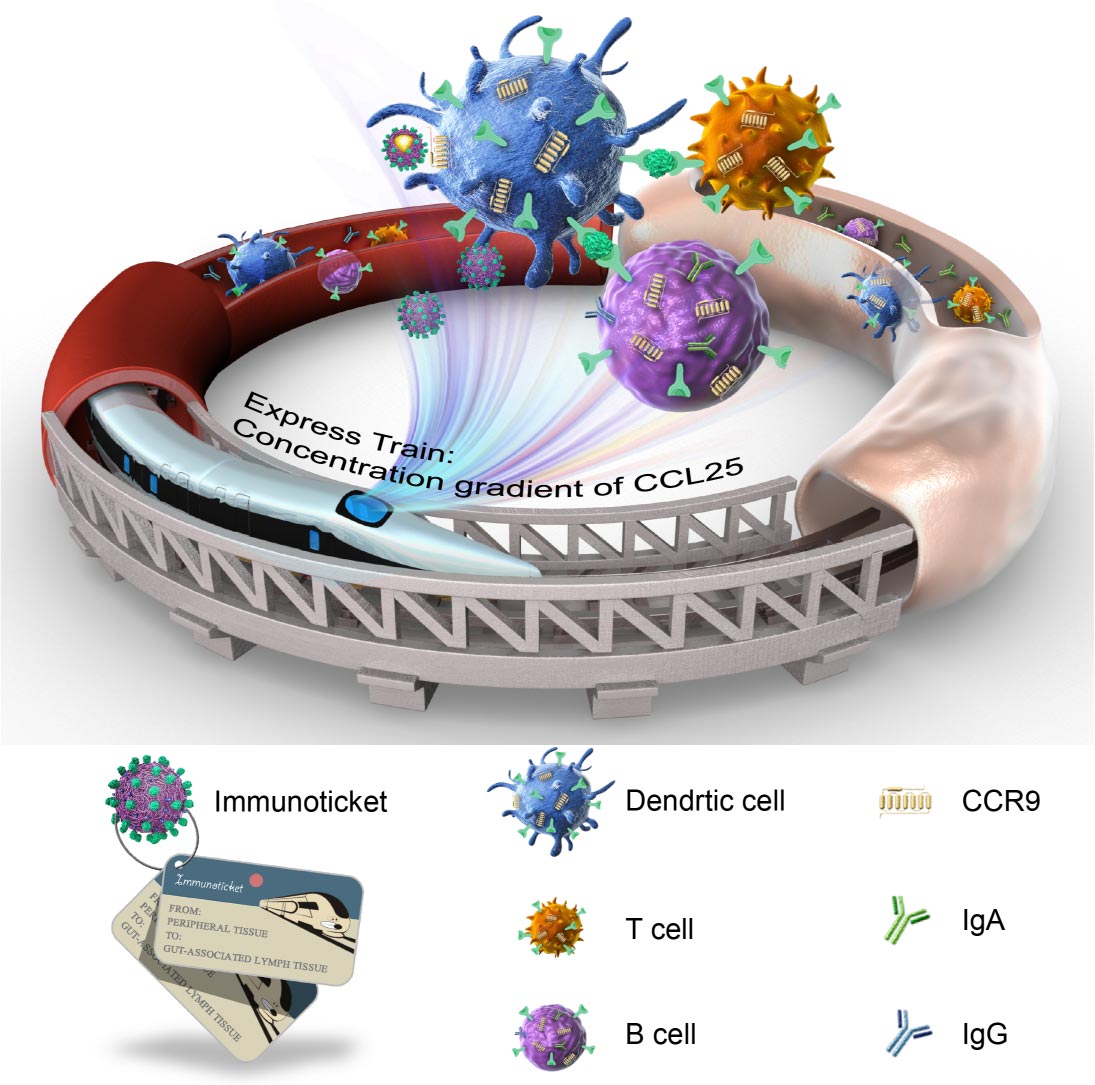
Using delivery system shows promising signs on biobased therapy. However, there's a huge challenge for incorporating all the bioactive factors into one single carrier, leading to unsatisfied efficiency for present antigen/drug delivery system (A/DDS). To break this bottleneck, we uncover the cellular response that induced by graphene oxide (GO) and establish specific A/DDS based on this two dimensional material. On one hand, the flat micro GO exhibit unique properties, including extraordinarily high level of antigen adsorption, intracellular folding effect, and autophagy induction. Such a “One but All” vaccine delivery system induces high level of anti-tumor responses in a programmable way and finally results in the in vivo tumor regression. On the other hand, we evidence sandwiched graphene-cell membrane superstructures in different cells and reveal the transport of GO varies from Brownian to Lévy and even directional dynamics. In terms of above unique advantages, the applicability of sandwiched GOs in enhanced efficiency of membrane-specific drug delivery is thus demonstrated. Our findings inform approaches to program two-dimensional nanomaterials towards advantageous tumor vaccine delivery and intramembrane drug transport.
References:
[1] Pengyu Chen#, Hua Yue#, Xiaobo Zhai, Zihan Huang, Guanghui Ma, Wei Wei, and Li-Tang Yan. Transport of graphene nanosheet sandwiched inside cell membranes. Sci Adv, 2019. Accepted (# Authors contributed equally)
[2] Hua Yue, Wei Wei, Zonglin Gu, Dezhi Ni, Nana Luo, Zaixing Yang, Lin Zhao, Jose-Antonio Garate, Ruhong Zhou, Zhiguo Su, Guanghui Ma. Exploration of graphene oxide as an intelligent platform for cancer vaccines. Nanoscale, 2015, 7, 19949-19957 (Back cover story)
[3] Hua Yue, Wei Wei, Zhanguo Yue, Bin Wang, Nana Luo, Yongjun Gao, Ding Ma, Guanghui Ma, Zhiguo Su. The role of the lateral dimension of graphene oxide in the regulation of cellular responses. Biomaterials, 2012, 33(16): 4013–4020
Natural gas reserves available worldwide includes varying amounts of CO2 ranging from CO2-free in Siberia to as high as 90% CO2 content in the Platong and Erawan fields in Thailand. The Natuna field in the Greater Sarawak Basin in Indonesia is the largest gas field in south east Asia, with estimated 46 trillion cubic feet of recoverable reserved. Unfortunately, it remains unexplored due to high CO2 content up to 71%. In Malaysia, CO2 content from natural gas fields varies up to 87%. Over 13 trillion cubic feet of natural gas reserves are undeveloped due to the presence of high CO2 content. The high CO2 content in natural gas is a major issue to monetizing the gas reserves. Without the removal of its CO2 content, natural gas cannot be further processed, liquefied, transported or commercially sold. However, the release of bulk CO2 into environment aggravates global warming and violates the requirement of Kyoto Protocol. Hence, there is a need for the development of technologies for the effective capture and subsequent utilization of CO2 for its conversion into value added products. In this paper, the recent advances on the potential technologies to manage the CO2 rich natural gas fields is deliberated. Challenges for gas treatment including capturing systems (from common technologies such as absorption, adsorption, cryogenic and membrane to novel technologies such as CUAS) and their applications towards a wide range of CO2 concentrations are presented. Additionally, the opportunities of separating huge amount of CO2 from such environments to produce added values products (bio fuel, synthetic-fuel, CO2-EOR, power production, etc.) are discussed.
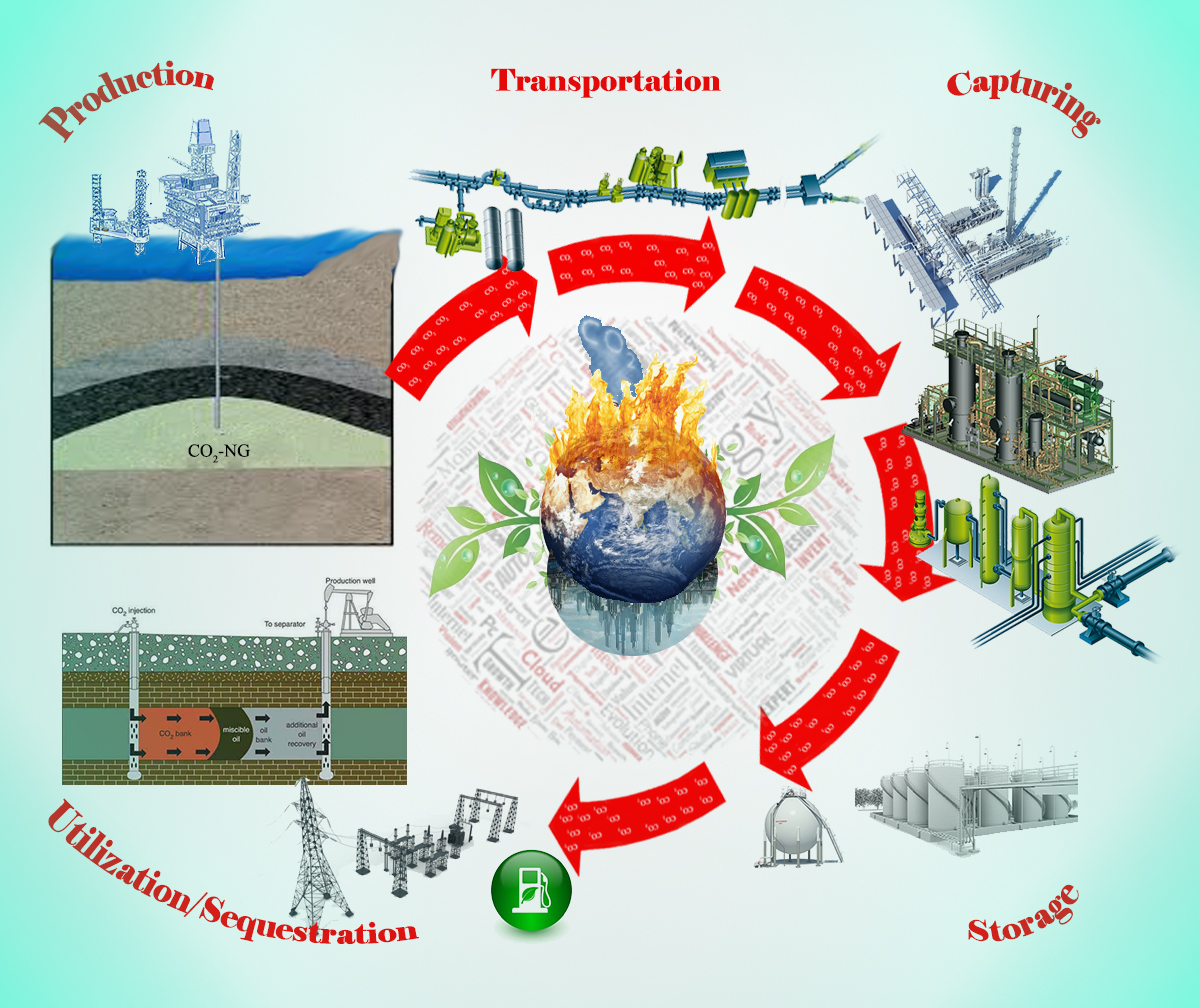
In a well-known efficient CO2 absorption process, Rectisol, chilled and pressured methanol is used as the absorbent to capture of CO2 physically. Unfortunately, because of higher solubility of CO2 in methanol under lower temperature and higher pressure, this process requires strict conditions (-40 ~ -60 oC and 3~8 MPa) and this leads in high demand of both operating and equipment costs. Therefore, a rotating packed bed (RPB) was evaluated to capture CO2 with NaOH in aqueous methanol as well as pure methanol solution under ambient conditions to relax low-temperature and high-pressure constraints. The experimental results suggest that with the NaOH-methanol solution, the absorption could be almost completed (~100%) within one gas/liquid pass in an RPB at room temperature and atmospheric pressure. Furthermore, the apparent overall mass transfer coefficient could be elevated to almost 5 s-1, which is one of the highest values among the RPB-related chemical absorption processes. Under this intensified centrifugal field, it is clear that CO2 capture can be highly enhanced with this good combination of physical-chemical absorbent, NaOH-methanol solution.
High purity CO2 recovery with lower energy consumption is required for effective CO2 Capture and Utilization/Storage (CCUS), and membrane separation would be suitable for the CO2 separation. Our research group has investigated and developed amine-containing polymeric membranes for effective CO2 capture. For example, amine-immobilized poly(vinyl alcohol) (PVA) membranes show excellent CO2 separation properties even over smaller H2. It was found recently that alkanolamines, such as 2-(2-aminoethylamino)ethanol (AEAE), elevated the CO2 separation properties, and mechanism of the preferential CO2 transportation was elucidated. Under humidified conditions, carbamate formed by an interaction between CO2 and the secondary amino group of AEAE was hydrolyzed to give bicarbonate ion, which was the major migrating species through the membrane. The hydroxyl group of alkanolamines facilitate the interaction to enhance bicarbonate production upon hydrolysis of the carbamate.
For pilot-scale demonstration, a hollow membrane module was prepared by in-situ modification (IM) method (Duan S., J. Membr. Sci., 2006). An aqueous solution of amines and PVA was circulated in a commercial hollow-fiber membrane module, and a CO2-selective layer was formed on the inner surface of hollow fiber membrane (Fig. 1). The thickness of the active layer was determined by circulation period, concentration of the solutes, and flow rate of the solution. The optimization of the IM method explained that 5 min circulation was enough to obtain higher CO2 permeability and CO2 selectivity. While the amines were physically immobilized in a polymer matrix, decrease in the CO2 separation performance was not found at all under 90 % relative humidity at 50 °C for about 300 h, which was triggered by the leakage of the amines. The IM method is preferable for mass production, and the scale-up is also feasible. The membrane modules developed would be suitable for biogas upgrading and air capture to obtain high purity CO2 in the permeate.
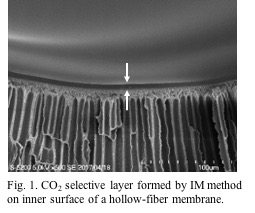
CO2 capture from dilute sources (e.g., flue gases, air) and subsequent storage or conversion will play a key role in the carbon-constrained future. The low driving force for CO2 capture from these dilute streams has positioned adsorbent materials and adsorption technology as a leading approach for addressing this global challenge. The creation of robust materials-enabled advanced adsorption separators and their manufacturing into low-cost, energy-efficient devices will be the focus of the talk. Engineering novel materials—such as solid-supported amines, metal-organic frameworks, and polymers of intrinsic microporosity—into structured contactor adsorption devices shows promise for these CO2 capture applications. Structured sorbent contactors can help manage kinetic and engineering factors associated with the separation, including pressure drop, sorption enthalpy effects, and external heat integration (for temperature swing adsorption). Monoliths, fiber sorbents, and 3D printed materials will be discussed as the three main classes of existing or emerging structured sorbent contactors. Recent developments in their manufacture; advantages and disadvantages of each structure relative to each other and to pellet packed beds; recent developments in system modeling; and finally, critical needs in this area of research will all be discussed.
CCUS (Carbon Capture, Utilization and Storage) is an important choice for a sustainable low-carbon development in China. The Chinese government attaches great importance to guiding the development of CCUS technology and has taken a series of measures to reduce CO2 emission in the past decade. This speech provides an overview of CCUS technology development which contained specific details about supported program from National Key R&D Program of China. The speech will also introduce several leading large-scale CCUS industrial demonstrations in China, by summarizing the technical characteristics, reactivity, and procedural scheme of each demonstration. An outlook on future development will be provided according to the 13th Five-Year Plan of China (2016-2020), which is focused on promoting large-scale industrial demonstration in the coal-based industry and oil and gas exploration industry.
One of the promising CO2 utilization demonstration projects is carbonation curing of concrete. CO2 curing technology has two major benefits: (i) rapid strength gain of cementitious materials, and (ii) large-scale CO2 sequestration in concrete. The gas-solid reaction kinetics between CO2 and cement-based materials were studied. According to the fitting results of different kinetic models, the carbonation curing of concrete showed a progressive product-layer-diffusion limited kinetics despite different factors. Our group also evaluated the feasibility of blending calcium silicate (CS) as intensified addition, which was found to significantly enhance the reaction rate and CO2 uptake capacity. In terms of practical feasibility, carbonation curing also improved the compressive performance of cement paste with CS. In addition, three typical industrial solid wastes - fly ash, blast furnace slag, and red mud - were studied to replace part of the cement materials to reduce CO2 emissions. The effects of carbonation curing time, pressure, and water-to-solids ratio on the CO2 uptake and compressive strength were comprehensively studied.
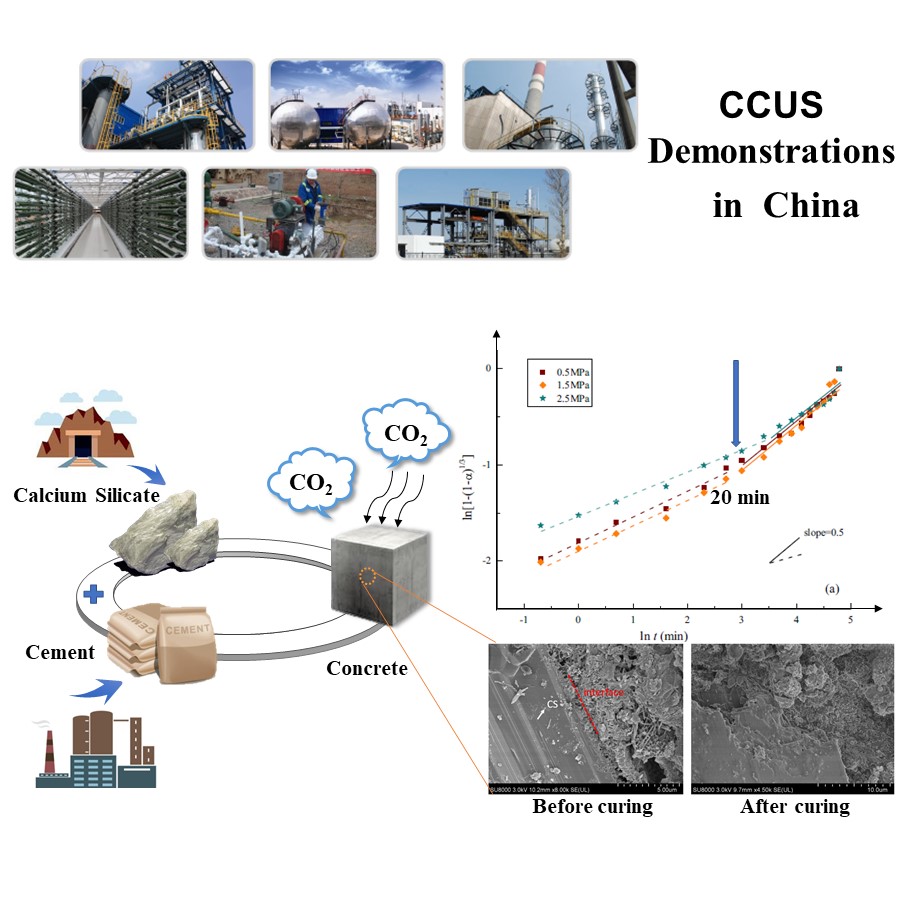
As one of the most important technologies for Carbon dioxide (CO2) Capture, Utilization and Storage (CCUS), the practical application of CO2 enhanced oil recovery (CO2-EOR) has been growing rapidly. Since the profitability of CO2-EOR project can be improved by the re-use of CO2 contained in the associated gas, superior CO2 separation technology is essential. JGC Corporation (JGC) and NGK Insulators, Ltd. (NGK) have developed CO2 separation system with DDR-type zeolite membrane. In many cases, the associated gas also contains hydrocarbons in which predominant constituent is methane (CH4). Since DDR-type zeolite has subnano-size pores which are desirable for CO2/CH4 separation, this membrane achieves excellent CO2 permselectivity. In addition, this system can be operated under high CO2 partial pressure conditions (~ 8 MPa) which is suitable for CO2 recovery process from associated gas with high pressure and high concentration of CO2. Recently, JGC has launched the first field test with laboratory scale DDR-type zeolite membrane at a CO2-EOR oil field. The membrane was prepared onto the inner surface of 30 channels in a cylindrical monolithic alumina substrate (diameter: 30 mm, length: 160 mm). In this field test, it has been confirmed that this membrane performed well for CO2 separation from the associated gas. It's of note that the performance observed using the associated gas was substantially equivalent to that of obtained using a simulated gas consisting of CO2 and light hydrocarbons in laboratory tests. In this presentation, the features of the DDR-type zeolite membrane as well as the summary of the first field test at a CO2-EOR oil field are addressed. In addition, the outline of the ongoing demonstration project with commercial scale DDR-type zeolite membrane (diameter: 180 mm, length: 1,000 mm) is introduced.
Along with the growth of CO2 enhanced oil recovery (CO2-EOR) industries, demand of CO2 separation technologies has been increasing to recover CO2 from associated gas which contains not only CO2 but also hydrocarbons mainly CH4. DDR-type zeolite membrane has the subnano-size pores which are preferable for CO2/CH4 separation, resulting in the excellent CO2 permselectivity. In this study, CO2 permeance and selectivity of the DDR-type zeolite membrane were examined under high pressure conditions using CO2/CH4 binary gas mixture to evaluate the potential applicability for CO2 recovery process in CO2-EOR industries. The membrane was prepared onto the inner surface of multi channels in a cylindrical monolithic alumina substrate (diameter: 30 mm, length: 160 mm). The membrane properties are investigated using one channel of the substrate. The test pressure was increased up to 8 MPaG with the temperature range of 90 - 150 deg. C. The CO2 concentration in the gas mixtures were varied from 50 to 100 %. From these experiments, CO2 permeance decreased with increasing pressure and temperature. In addition, CO2 permeance and selectivity decreased with decreasing CO2 partial pressure in the experiments with CO2/CH4 binary gas mixture. CO2 permeance obtained in experiments was correlated by the surface diffusion model coupled with adsorption isotherm equations (Langmuir equation and Dubinin-Astakhov equation). The surface diffusion model could correlate CO2 permeances well against the wide range of CO2 partial pressure. The comparison of CO2 adsorption curves estimated by the correlation was implied that the competitive adsorption between CO2 and CH4 was occurred in this system and it affected to CO2 permeability of the DDR-type zeolite membrane. As mentioned above, the amount of adsorbed CO2 decreased as CH4 concentration in binary gas increased because of competitive adsorption. In contrast, gas diffusion constant and equilibrium constant were not changed.
High surface area magnesium oxide (MgO) has garnered interest as an in-situ CO2 sorbent for the water-gas shift reaction (WGSR) for its low regeneration temperature and uptake of CO2 gas at intermediate temperatures of 300 °C upon modification with alkali nitrate salts. Semi-industrial scale production of these high surface area MgO sorbents (>200 m2·g-1) can be achieved via Calix's flash calcination process. Upon modification with NaNO3, the CO2 uptake of MgO in a pure CO2 environment after 1 h improved by a factor of 27 to 11.1 mmol CO2·g-1. The sorbent retained 60% of its CO2 capacity after 40 adsorption-desorption cycles, outperforming a commercial MgO control. The higher uptake of the NaNO3 modified high surface area MgO is attributed to a higher ratio of NaNO3 to MgO, resulting in larger and more similarly sized crystallites of MgO and NaNO3. This improves the extent of interphase boundaries between the molten salt and gaseous CO2, improving the rate of adsorption of CO2 into the sorbent. The molten salt also influences the sintering of MgO and NaNO3, which further increased the crystallite size and surface area in the first few cycles. When applied as a sorbent in the Cu catalysed WGSR, the NaNO3 modified MgO sorbent exhibited a CO conversion of 27% at 300 °C, while CO2 output remained relatively high. The high CO2 output is attributed to the loss of basic sites when the NaNO3-MgO sorbents are mixed with the Cu catalyst, which lowers the retention of CO2 at 300 °C, and impedes the effect of NaNO3 in capturing CO2 in the WGSR.
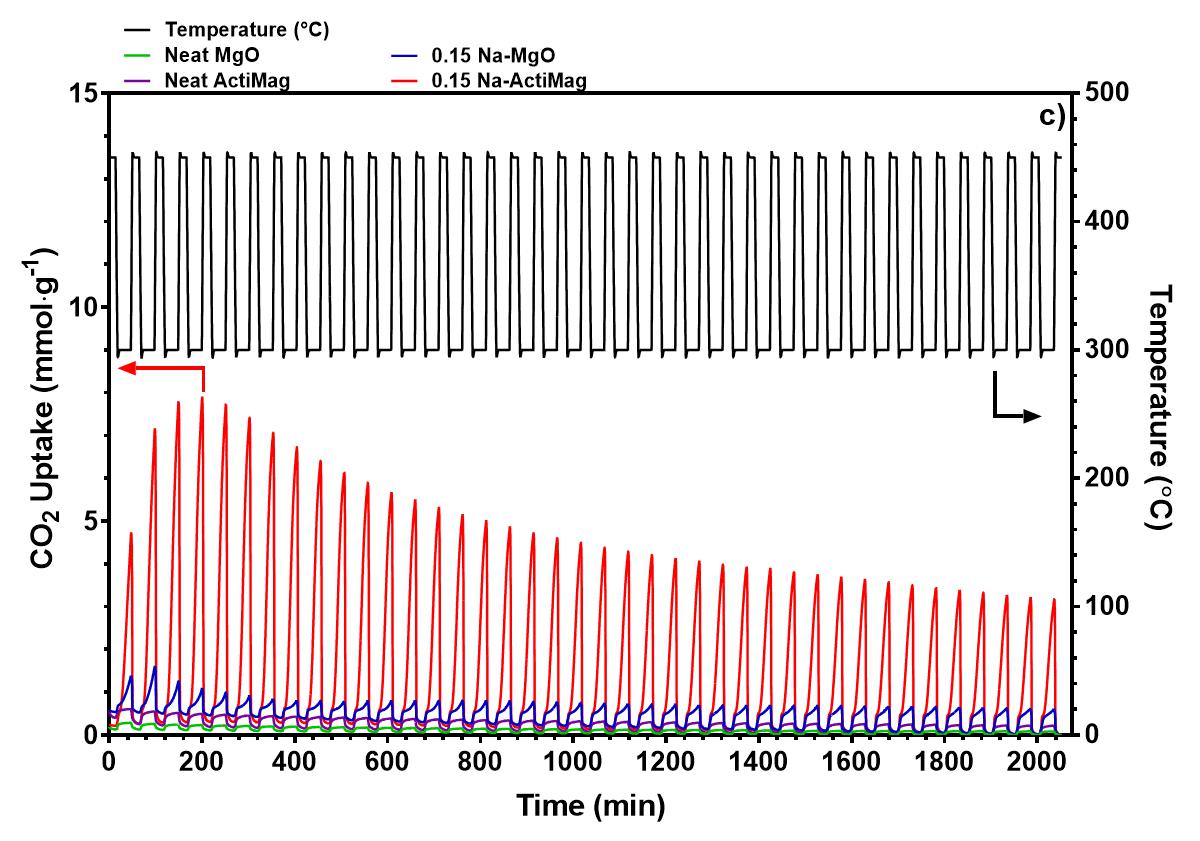
The CO2 methanation has received attention as a reaction converting CO2 into a useful resource such as methane (PtG technology). When assuming that methanation is used as a reaction to process CO2 emitted from an industrial process, the presence of oxygen may have a negative influence, such as an oxidation of the active site. In this study, to examine the influence of O2 on the catalytic function, the methanation performance of a Ni/CeO2 catalyst was evaluated using a raw material gas containing oxygen of 1–10 vol%. As a result, the methanation activity at a lower temperature was greatly improved, and the ability to produce a high methanation performance was realized even in a region at room temperature. We found a novel route of CO2 methanation that can be driven with no heating, even in ambient, which we named as auto-methanation. No one in the World has reported such transformation route yet.
A granular Ni/CeO2 catalyst was prepared using evaporation to dryness of Ni(NO3)2·6H2O on CeO2 support. The CO2 methanation was investigated using conventional flow-type reactor by introducing feed-gas at setting temperature of 350 °C down to room-temperature. The raw gas contained CO2, H2, O2, N2. The CO2 concentration was fixed at 10 vol% with 400 ml/min.
Figures 1(a) and 1(b) show CO2 conversion and product-selectivity. When supplying oxygen of 1 vol% and 3 vol%, the drastic change in conversion shifted to the lower side, which was near room temperature. At oxygen of 5 vol% and 7 vol%, about 65 and 70% conversions were obtained even at room temperature without external heating. Methane selectivity was almost 100% at lower temperature. Figure 1(c) is snapshot of the auto-methanation state. A combination of methanation and combustion might offer a novel CO2 transformation technique, which will open a new process.
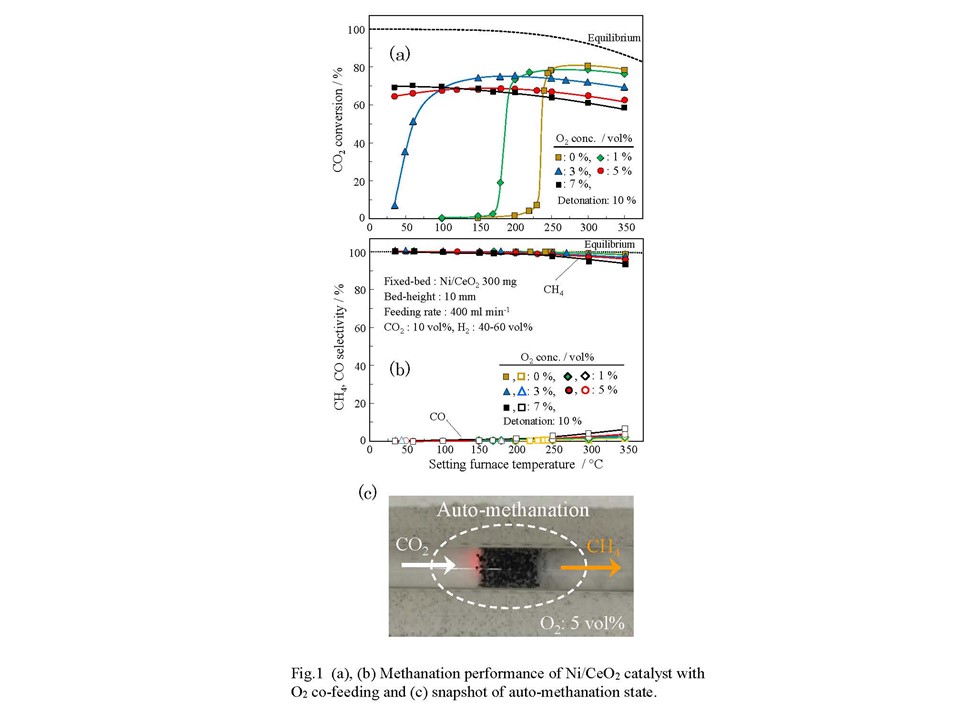
The CO2 separation technology is considered to play a key role to reduce or control the CO2 emission from the fossil fuel, especially from coal in the world. Australia, rich in coal resources, is also facing “De-carbonization trend” and thus technical solutions are needed.
In Australia, we launched an internationally collaborative PCC (Post Combustion Capture) demonstration project in 2014. The name of the project is the abbreviation of PCC, and IHI (Japanese engineering company), CSIRO (Australian research institute), AGL (Australian power company), the partners of the project.
Prior to the project, we had developed IHI advanced CO2 captured system with 20 ton CO2/day scale pilot plant in Japan, which mainly consists of the IHI Solution No.162 (ISOL-162), the advanced packing material and the advanced process enabling to significantly reduce the solvent regeneration energy.
Through the long term operation at this demonstration project under the practical conditions, i.e., using the flue gas of an operating brown coal-fired power plant, we have evaluated our integrated PCC technologies. During the operation, 90 % CO2 capture ratio was achieved stably and other measured values were also kept stable. The results indicate that the PICA plant and the ISOL-162 solvent have sufficient stability and robustness to enable long term operation.
IHI has improved the design and refined operation to provide a robust and environmentally friendly PCC system based on the knowledge and technologies obtained through the ISOL-162 long-term operation using the PICA pilot plant and parallel research activities.
Over the long term operation, practical studies of the emission evaluation were carried out. The emissions of amine and its derivatives from the outlet of the washing tower were measured on various wash-type conditions. The result clearly demonstrated that the amine emission from the system was considerably reduced and minimized by the application of the washing technologies. The demonstration results are explained in detail in the presentation.
Indirect carbon sequestration via mineralization has been perceived as an alternative solution to address increasing anthropogenic emissions. Ex situ mineralization, in contrast with the in situ counterpart, has been the focus of recent studies as it provides a faster and more efficient carbon capture process due to the addition of a leaching step that releases the ions available for intimate contact with carbon dioxide. Mixed dump serpentenite samples from a Nickel mine site in Mindanao, Philippines were characterized through leaching tests to determine their viability in carbon sequestration. Ground samples of 75-150 microns particle size were leached with hydrochloric acid concentrations of 1 M, 2.5 M, and 4 M, at temperatures of 50C, 75C and 100C. The reaction time was also set at 1 hr, 2.5 hrs, and 4 hrs, respectively. The optimum set of conditions were then determined by analyzing the extraction efficiencies of Mg, Fe, Si, Ca, and Al ions from the aforementioned set of parameters, using the Face-Centered Cube model for Response Surface Methodology. Prior to leaching, XRD, XRF, and ICP-MS analyses were performed to determine the dominant minerals and elemental composition of the sample. The morphology and crystal structure of the optimum and non-optimum samples were also confirmed by BET and SEM analyses to establish the relationship of the crystal structure of the media to the ion extraction efficiencies.
Efficient and economical CO2 capture from coal-fired power plants is a major challenge for the application of CCS concept as this step incurs primary cost and energy penalty. Oxy-fuel combustion and post-combustion CO2 capture using Amine process are few approaches but are energy intensive. Chemical Looping Combustion (CLC) technology where oxygen for combustion is supplied by metal oxygen carriers instead of air is finding application in coal fired power plants for its economical CO2 capture. The oxygen carrier is circulated between the two reactors, Fuel reactor and Air reactor which usually operate under fluidized bed conditions. The flue gases from Fuel reactor contain CO2 and H2O which can be easily separated leading to nearly pure CO2 and thus reducing the energy requirement for CO2 separation. Therefore, development of a robust, effective and economical metal oxygen carrier is of primary research interest. This study reports and compares the reduction-oxidation characteristics of several oxygen carriers. Basic reduction-oxidation experiments were carried out in a small fluidized bed reactor by switching gases. Effect of reduction temperature, gas residence time, and type of oxygen carrier on conversion efficiency was investigated. Results were discussed in terms of their physical characteristics, oxygen capacity, oxygen release rate and stability after repeated redox cycles. A first order reaction was applied to analyse the reduction kinetics. The study also reports long run performance results of a 100kW scale circulating fluidized bed bench scale CLC unit developed at AIST under NEDO project.
A novel process named a membrane flash process was studied to realize an energy-saving technology and to substitute it for a conventional process using steam for regeneration of the CO2 absorbent liquids in CCS. In this study, four different amine-based absorbents (MEA, DEA, MDEA, MDEA and piperazine (PZ)) were tested to find an absorbent favorable for the membrane flash process using an alumina microporous hollow fiber membrane.
CO2 rich solution of each absorbent was supplied into the tube side of the hollow fiber and the pressure on the shell side was reduced so that the pressure difference between the tube and shell sides was 45, 65, 85 and 95 kPa. The absorbent liquid was forced to permeate through the pores of the membrane and CO2 was released during and after permeation. MEA showed the highest liquid permeation rate while MDEA+PZ showed the lowest permeation rate. DEA and MDEA had the similar permeation rates. On the other hand, the highest CO2 desorption rate was obtained with MDEA+PZ and the second was obtained with MEA. As a result, the CO2 release ratio, which was defined as the ratio of actually desorbed CO2 amount to the potentially releasable CO2 amount, was highest with MDEA+PZ while MEA showed the lowest CO2 release ratio. The energy requirement for CO2 desorption consisting of the energy items required for liquid permeation, gas discharge and reaction heat was estimated based on the experimental results for each absorbent. The results indicated that the energy requirement was smallest in the case of MDEA+PZ. From these results, it has been found out that MDEA+PZ was most suitable for the membrane flash process.
In this research work, carbon nanofibers (CNFs) were initially synthesized and then post-coated on honeycomb monolith substrates using injection chemical vapor deposition (ICVD) technique. The synthesized CNF monolith was intended for CO2 adsorption study. The effect of various wash-coated materials and catalyst promoter on the growth rate of CNFs on monolith substrates were examined. The characteristics of the synthesized CNFs-coated monolith composites were examined using Raman spectroscopy, Brunauer–Emmett–Teller (BET), thermogravimetric analysis (TGA), field emission scanning electron microscopy (FE-SEM), and Transmission electron microscopy (TEM) techniques. According to the textural characterization study, the specific surface area and pore volume of CNFs-coated monolith composites were significantly improved as compared to bare monolith which might be attributed to the growth of highly pure and aligned CNFs over monolith substrate. Besides that, the synthesized CNFs-coated monolith possessed extremely well thermal stability up to the temperature of 550 °C which was corresponded to the strong attachment of highly graphitized CNFs over monolith substrates.
Mineral carbonation (MC) is the only recognized form of permanent CO2 storage options with no concerns regarding its long term stability. Industrial waste alkaline residues are utilized in mineral carbonation transforming them into useful products. The waste usually requires at least one pre-treatment step to make it more reactive. Pre-treatment is usually an energy-intensive process and involves the use of extraction agents which are not environmentally friendly. This translates into numerous environmental and economic concerns that hider the applicability of MC using industrial wastes. In this study, steel-making waste has been mineralized by CO2 to produce valuable calcium and magnesium carbonates and capture CO2 as illustrated in Figure 1. The study investigates an environmentally friendly and economical approach for MC by reacting electric arc furnace (EAF) baghouse dust (BHD) in a reject brine medium with CO2 in a novel reactor system, specially designed for contacting gases and liquids. This approach eliminates the need for pre-treatment chemicals and its associated cost which is estimated to be 0.4 €/kg of steel waste. Response surface methodology was used to optimize the MC process. At optimum operating parameters, the optimum CO2 uptake was 0.22 g CO2 /g BHD. A higher CO2 uptake performance of 0.98 g CO2/g BHD was achieved at ambient temperature and pressure of 5 bar. In addition, the concentration of the dissolved solids in the reject brine was reduced hence reducing its salinity. Thermal gravimetric analysis (TGA) of the solid products revealed that a variety of carbonate products being produced, particularly, calcium and magnesium carbonates.
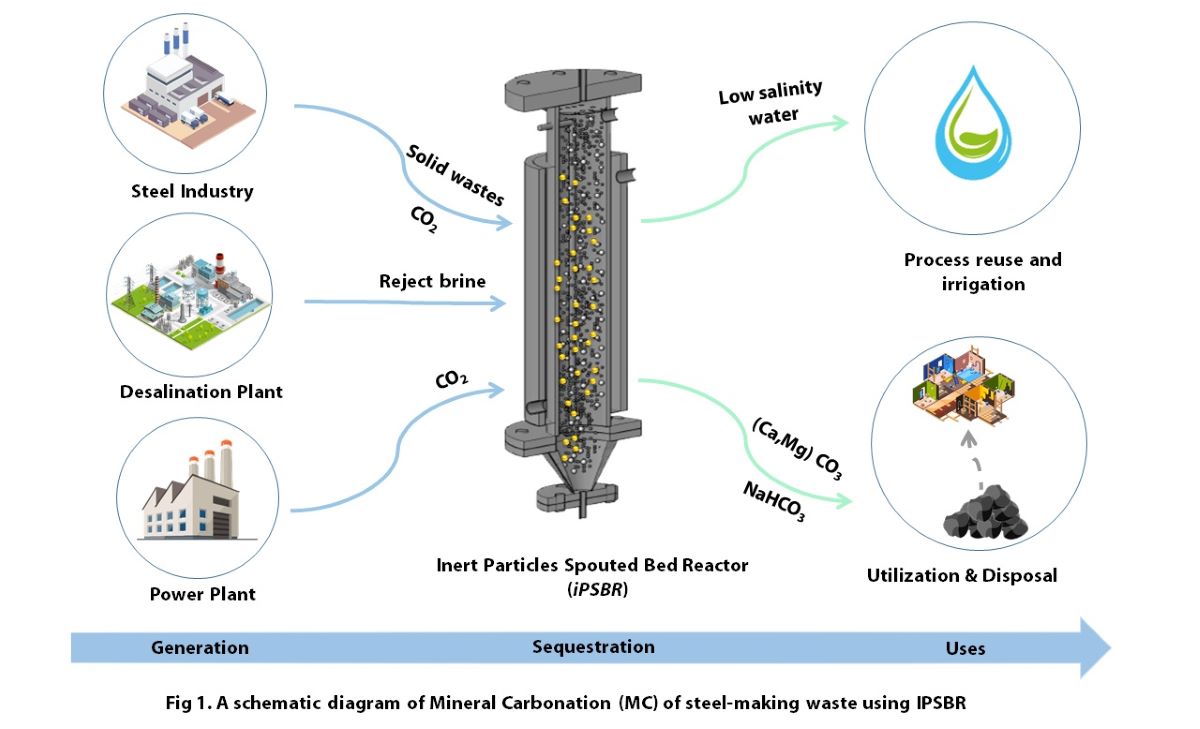
A technology for converting CO2 recovered from a power plant into fuels or chemicals like methane or methanol is attracting attention as a CO2 effective utilization technology. We have been developing phase separation solvent for the purpose of energy saving of CO2 recovery. The absorbent consists of amine / ether / water and is characterized by low temperature regeneration. In this presentation, we will report on the prospect of significant energy savings by integrating CO2 recovery in the first stage and conversion in the second stage.
The following carbon capture, storage and investigation of potential CO2 storage sites projects are being conducted in Japan.
1. Tomakomai CCS Demonstration Project
Full-chain CCS demonstration Project
2. Investigation of Potential CO2 Storage Sites
Identify potential CO2 storage sites in waters surrounding Japan by 2021.
3. Sustainable CCS Project
Demonstration of capture facilities and comprehensive studies to introduce CCS
4. Osaki Coolgen Demonstration Project
Step 1: Oxygen-blown IGCC, Step 2: IGCC+CO2 Capture, Step 3: IGFC+CO2 Capture
The description of Tomakomai CCS Demonstration Project is as follows.
CO2 Capture Facility: The CO2 source is a hydrogen production unit (HPU) of an adjacent oil refinery, which supplies off gas containing approximately 50% CO2 from a Pressure Swing Adsorption (PSA) hydrogen purification unit. In the capture facility, gaseous CO2 of 99% purity is recovered by a commercially proven amine scrubbing process. A two-stage absorption system reduces the amine reboiler duty in the capture system.
CO2 Injection Wells: The CO2 is compressed and injected into shallow and deep offshore reservoirs by two separate deviated wells. The cumulative injected CO2 volume is 230,000 tonnes as of March 20, 2019.
Monitoring Facilities: An important objective of the project is to confirm the safety and stability of CO2 injection. As Japan is highly susceptible to earthquakes, natural earthquakes and micro-seismicity are also monitored to verify that natural earthquakes do not affect the stored CO2, and that CO2 injection does not cause any noticeable tremors. An extensive monitoring system comprising 3 observation wells with bottomhole temperature & pressure sensors and seismometers, 4 ocean bottom seismometers (OBSs), 1 ocean bottom cable (OBC) and 1 onshore seismometer was established. Monitoring was commenced one year prior to the start of CO2 injection and has been conducted continuously. In addition, seismic surveys are conducted to delineate the subsurface CO2 distribution.
In a standard post-combustion carbon capture (PCC) process, the regeneration energy of the CO2 lean solvent dominates the overall energy consumption. The energy reduction in the CO2 stripper can be achieved by either formulating new solvents or optimizing the process configurations. The energy reduction achieved by stripper modifications, which include the rich-split process, the interheating process, and the integration of both configurations, have been reported in the literature. In the rich-split process, the cold rich stream is split to recover the energy contained in the overhead vapor, which was directly fed into the condenser in the traditional stripper configuration; therefore the regeneration energy can be reduced. The interheating process draws the liquid flow from the middle of the stripper and exchanges heat with the high-temperature lean solvent from the reboiler; thereby, the overall column temperature can be raised that favors CO2 desorption along the column. Therefore, the combined process, which is the rich-split process integrated with inter-heaters (IHs), takes both advantages of above modifications that can further reduce the energy requirement. However, the present work shows that energy-saving effect of the combined process is not as promising as the literature claimed. Once the design parameters of the rich-split process are selected properly, the rich-split process without IHs can achieve the same energy-saving effect as that achieved by the process of integration with IHs.
Aqueous solutions of alkanolamines are used for absorbents of the post-combustion capture of CO2. Energy requirements for the currently available systems are very high. Thus, it is important to lower the regeneration energy (ΔHreg, kJ/mol-CO2), which consists of three parts: the heat of chemical reactions for CO2 release (ΔHrxn, kJ/mol-CO2); sensible heat (ΔHsen, kJ/mol-CO2); heat of vaporization (ΔHvap, kJ/mol-CO2). In most previous works, it is assumed that the heat of CO2 release is equal to the absorption heat of CO2. However, it is a rough assumption. Thus, we present a thermodynamic model for predicting energy performance of amine absorbents (TMPEA) in order to evaluate the regeneration energy based on the enthalpies of chemical composition changes in a chemical equilibrium analysis. Firstly, we obtained the concentrations of chemical species at a low temperature Ta with a partial pressure of CO2, Pa(CO2), and at a high temperature Tr with Pr(CO2). Thus, we obtained the changes of the concentrations of chemical species from the low temperature state to the high temperature state. Secondly, the changes were expressed with reacted quantities of elementary chemical reactions. We calculated the ΔHrxn value from the enthalpies of the elementary reactions using the Hess's law. Finally, we calculated the ΔHsen and ΔHvap values according to the previous methods. We obtained the ΔHreg value as the sum of the ΔHrxn, ΔHsen, and ΔHvap values. We calculated the ΔHreg values for representative amines such as MEA, AMP, DEA, and IPAE. We found that calculated regeneration energies for MEA depends on working conditions. We demonstrated that TMPEA is useful for evaluating the regeneration energy of CO2.
Carbon dioxide capture, utilization, and storage (CCUS) is a key technology to decrease the emission of greenhouse gas, CO2. The benchmark process using a 30% monoethanolamine aqueous solvent for CO2 capture requires a large amount of energy, in particular, for the regeneration of absorbent at high temperature up to 120 °C. In a recent decade, a variety of absorbents have been investigated to reduce such high energy consumption. Phase separation solvents, which separate into immiscible CO2-rich and CO2-lean phases after CO2 absorption, have been proposed to improve the process efficiency for CO2 capture at atmospheric pressure [1]. In the present study, we attempt to extend the phase separation solvents for high-pressure CO2 capture processes. The p-V-T-x behaviors are studied for the systems of CO2 and phase separation solvents, composed of some amines and ethers at different compositions, over a wider range of temperature and pressure. The could point, inducing the phase separation, can be controlled by the basicity and concentration of amine, which are the predominant factors in the formation of ionic species. The phase separation and p-V-T-x behaviors are discussed in detail for the development of efficient CO2 capture processes at high pressure.
References.
[1] H. Machida, K. Oba, T. Tomikawa, T. Esaki, T. Yamaguchi, H. Horizoe, J. Chem. Thermodyn., 113 (2017) 64-70.
Carbone dioxide Capture, Utilization and Storage has attracted significant attention in the past two decades to reduce greenhouse gas (GHG) emissions and mitigate global warming. However, its capture cost should be further decreased to facilitate its commercial implementation. In fact, CO2 capture is considered as the most energy-intensive part.
In this research, an innovative process using chemical absorption by solid with a circulating fluidized bed has been proposed to reduce energy consumption of CO2 capture. In this process, reaction heat accompanying absorption is successfully supplied to thermal decomposition in regenerator through a heat pump, leading to circulation of whole process heat. To see the influence of the separation performance of the proposed process, some experiments have been conducted. An energy balance of the proposed process using experimental data is simulated and examined using a commercial process simulator (PRO/II, Ver. 9.1). The simulation results indicate that the proposed CO2 separation process has the large energy saving potential as compared with the conventional counterparts.
CCU (Carbon dioxide Capture and Utilization) technology, in which CO2 is captured from large-scale emission sources and the CO2 is converted into high-value added chemicals and fuels, is expected to improve the economical efficiency of CO2 separation and recovery and to enable its commercialization. Among the proposed CCU technologies, organic matter synthesis from water and CO2 under hydrothermal conditions has advantages such as no use of hydrogen and no use of precious metals as catalyst and reductant. Then, in CO2 chemical absorption method using potassium carbonate, we propose that the rich absorbent solution containing CO2 be directly subjected to hydrothermal treatment so as to convert CO2 into organic compounds simultaneously with the regeneration of the absorbent solution for the following absorption process. In this study, we aim to clarify the possibility of converting CO2 into organic compounds by hydrothermal treatment of KHCO3 as a CO2 source. Furthermore, another purpose of this study is to elucidate whether it is possible to regenerate CO2 absorbent solution during the hydrothermal treatment.
A stainless batch reactor was charged with specified amounts of KHCO3 or NaHCO3 as a CO2 source, Fe powders as a reductant, Ni powders as a catalyst and distilled water. The reactor was heated in a sand bath at 300 °C for 120 minutes. After cooling the reactor, the concentration of formic acid and inorganic carbon (IC) contained in the liquid sample were measured with HPLC and a TOC meter, respectively. The results confirmed the formation of formic acid from both KHCO3 and NaHCO3. The yield of formic acid was higher when KHCO3 was used. From the results of IC in the solution after the treatment, it was indicated that most of the introduced bicarbonate was converted to carbonate after the reaction and the absorbent solution could be regenerated.
A key factor for commercialization of CCUS (carbon dioxide capture, utilization, and sequestration) is to establish an efficient and effective CO2 capture process because the capture process possesses the 50 to 80 % of total CCUS operating expense. In this study, we suggests an energy efficient CO2 absorbent comprising the aqueous blend of potassium serinate (K-Ser) and piperazine (Pz). Especially, this CO2 absorbents have high surface tension which make them proper for use in polypropylene (PP) hollow fiber membrane contactor to reduce the membrane pore wetting. By fast solvent screening test, it is revealed that the cyclic capacity of the aqueous blend of K-Ser and Pz is 25 % higher than that of 30 wt% MEA (monoethanoleamine). Vapor-liquid equilibrium was measured to estimate the heat of reaction by calculation using Gibbs-Helmholtz equation. Heat capacity was measured to calculate the sensible heat. Finally, the solvent regeneration energy of the aqueous blend of K-Ser and Pz are estimated and compared with 30 wt% MEA by summation of heat of reaction, sensible heat and heat of vaporization. The long term CO2 removal experiment using Lab-scale membrane contactor will be our future work.
For the CO2 capture from high-volume and CO2-dilute gas such as combustion gas from power plants, chemical absorption with amine is expected to be one of the most feasible technologies. However, its application to the commercial plants for the explicit purpose of CO2 emission abatement still has been limited to a small number. Although there might be several reasons, one of the most critical reasons is its low profitability. Amine solvents require a lot of energy for regeneration, which results in high running cost for CO2 separation.
Our unique phase separation type amine/ether absorbent is expected to realize the CO2 separation process with low-energy consumption (target: less than 2.0 GJ/ton-CO2). This liquid shows a single uniform phase just by mixing the raw materials; amine, ether and water. And it is splitted into two phases consisting of an amine-rich phase and an ether-rich phase by absorbing CO2. Further, it returns to its original uniform phase after CO2 desorbing. During liquid regeneration the ether phase assists the CO2 desorption from the amine phase rich in CO2 by the extraction of CO2, which results in a reduction of energy input for liquid regeneration.
In this study, 500 hours degradation test on this absorbent under cyclic thermal load was conducted in order to clarify 1) the behavior of its performance declination for CO2 capture and 2) the behavior of amine loss. Its test condition was chosen based on two assumptions that a) high-oxidation atmosphere containing O2 and SOX which is destructive condition for the absorbent, and b) adopting practical operating temperature when absorbing or desorbing.
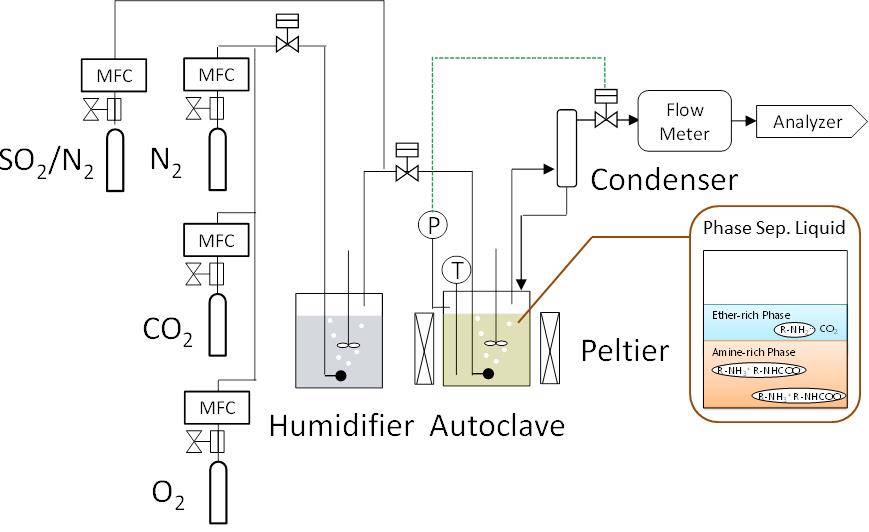
As measures against global warming, CO2 capture and storage technology (CCS) and capture and utilization technology (CCU) has drawn attention of researchers all over the world. So far, our laboratory has developed a new phase separation type CO2 absorbent to improve energy problem in CO2 separation and recovery technology. The CO2·H2 mixed gas recovered from the top of the column can be supplied as it is to the conversion process to methane, methanol and the like. In this process, H2 a component of the source gas, was applied to the bottom of the regeneration tower and reacted with CO2 freed from regeneration process to create methane, methanol and others, which makes it a CCU process. Moreover, without purifying CO2 concentration, this process reduces the energy requirement as compared to the conventional method. In this study, experimental data on stripping regeneration characteristics of phase separated absorbents were acquired. From that, CO2 separation / recovery energy was calculated.
Carbon capture and storage plays an important role in greenhouse gas reduction. Monoethanolamine(MEA) is now widely applied in industry. To overcome the energy penalty of this methods, phase separation solvent was suggested by Machida et al. Since the phase-separation solvent under developing composes of multiple components and separates into two liquid phases after CO2 absorption, it takes time to determine the composition.
Fourier transform infrared spectrometer (FTIR) can simultaneously collect spectra of chemicals within a short time. In order to establish an in-situ method to analyze the components of solution, process FTIR (reactIR) was applied during CO2 absorption. Calibration samples of amines, ethers and CO2 absorbed samples were used to build the model. TOC was used to verify the accuracy of method and model. From FTIR spectra, not only concentrations of components can be determined, phase separation was also observed. Therefore, this method has a prospective application in liquid composition monitoring in plant step.
As a countermeasure against the global warming, early introduction of CCS to large scale CO2 emission facilities, such as thermal power stations, is expected. In general, since CO2 capture process using amine-based solution requires a large quantity of heat for stripping CO2 and regeneration of rich loading solution, process improvement as well as exploring novel solutions is a key to reduction of energy penalty. High concentration 2-Amino-2-methyl-1-propanol (AMP) solution precipitates carbonate with absorption of CO2 and can be expected to reduce sensible heat of regeneration energy by sending the separated carbonate to the stripper. The solution of AMP50wt% promoted by adding Piperazine (PZ), has been tested and successfully operated with solid-liquid separation by a centrifuge. However, the CO2 recovery rate was up to 65% since PZ regeneration reaction did not occurred and PZ was circulated without regeneration. In this study, as a result of searching for new promoter, N-Methyl-1,3-diaminopropane (MAPA) was selected. MAPA primary-carbamate can form an eight-member ring which is easily regenerated, so it is expected to improve CO2 absorption rate in the low CO2 loading range without decrease in the CO2 loading capacity. The operating condition of the small-scale CO2 recovery test was updated by testing AMP/MAPA solution at various temperatures and CO2 loadings. No compounds derived from MAPA were detected in the precipitation solid by results of Raman spectroscopy and GC-MS. Precipitation characteristics of AMP carbonate was empirically obtained by batch tests to determine a stable condition of precipitation process, and cooling temperature was determined 53.4 °C. The injection of semi-lean liquid, which is separated from AMP carbonate by the centrifuge, to the middle inlet seems to be effective to keep the absorption rate even at the top of absorber where the CO2 concentration decreases. The rate-based 10 stages model of absorber using AMP/MAPA solution was built on Aspen Plus and CO2 recovery rate associated with precipitation rate was simulated to determine the position of middle inlet. Injecting the semi-lean liquid to the fifth stage showed the highest CO2 recovery rate. Aqueous solution of AMP 40 wt% + MAPA 5 wt% was evaluated by small-scale apparatus of CO2 capture and recovery with the middle injection process. As a result, the regeneration energy decreased, and CO2 recovery rate reached 90 %.
Global warming and its harmful implications are a major concern for the government and scientific communities worldwide. CO2 being a greenhouse gas is considered to be a major contributor of the global warming. To reduce the anthropogenic emissions of CO2, capturing CO2 from the industrial processes is a must. The solvent based CO2 capture processes is considered to be the most mature and promising technology to capture CO2 from the exhaust streams. Alkanol amines are widely used as a solvent in these processes. However, they are energy intensive and there are still need for development of novel solvents that can make the CO2 capture technology more energy efficient. Potassium salts of amino acids have recently emerged as potential candidate to be used both as a single solvent or as a promoter in the CO2 capture technology. In this work, the potentials of Potassium Salts of Glycine (KGly) as promoter is explored via a kinetics study of reactions of CO2 with different blends of N-Methyldiethanolamine (MDEA) and KGly. Stopped-flow technique was used to carry out the investigations. The experiments were performed over a temperature range of 298 to 313 K and solution concentration of 0.2 and 0.8 mole/l in different MDEA/KGly proportions. Obtained kinetics data were interpreted using zwitterion and termolecular mechanisms for the potassium salts of glycine. The individual rate constants of the participating reactions were regressed and their corresponding activation energies were estimated
The bottleneck of realizing a hydrogen energy society is energy loss during hydrogen transport and storage. Ammonia is a promising raw material for hydrogen production because it may solve several problems related to hydrogen transport and storage. Ammonia has four advantages as an energy carrier: (1) Liquefaction is easy. (2) The transport and storage mechanisms have been established. (3) Carbon dioxide is not removed when ammonia is converted to hydrogen. (4) Ammonia has high weight-based and volume-based energy densities as fossil fuel. Hydrogen can be effectively produced from ammonia via catalytic thermal decomposition; however, the resulting residual ammonia negatively influences the fuel cells. Therefore, a high-purity hydrogen production system comprising a catalytic decomposition reactor and a plasma membrane reactor (PMR) has been developed. In this hydrogen production system, ammonia is quickly decomposed into hydrogen and nitrogen in a catalytic reactor, and hydrogen is separated from ammonia decomposition gas by PMR. However, the hydrogen yield of this hydrogen production system was low (16 %). The cause of the low yield was the low hydrogen separation capacity of the PMR with ununiformed plasma firing.
In this study, the state of plasma firing was improved by filling dielectric in the PMR. A columnar zeolite (Tosoh Corporation) was used as a dielectric. In the PMR filled with zeolite, plasma was uniformly fired. By packing the zeolite in the PMR, the hydrogen generation performance of the PMR was also improved. It was also found that the improvement of the production performance is affected by the properties of the zeolite to be filled. The hydrogen refining flow rate obtained 199 L-H2/h from 150L-NH3/h. The hydrogen yield of this hydrogen production system improved from 16 % to 88 %.
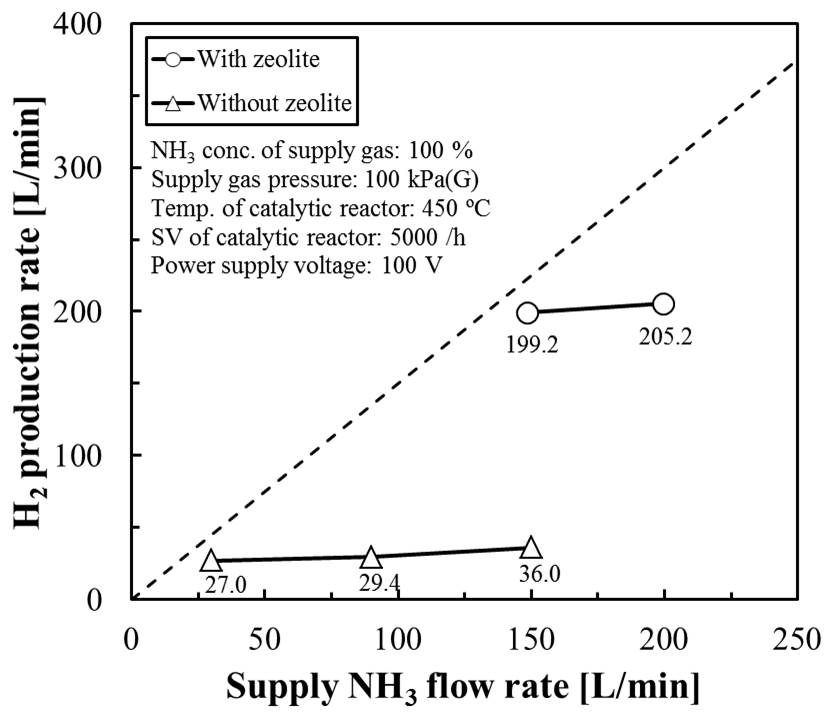
We investigated the reaction pathways for reversible formate (HCOO–) dehydrogenation and bicarbonate (HCO3–) hydrogenation on N-doped graphene-supported Pd nanoparticles such as Pd12NC-G, Pd12NC-N1G, Pd12NC-N2G, and Pd12NC-N3G using density functional theory (DFT) calculations, and proposed key factors for the enhancement of the reversible reaction efficiency. In order to achieve this, an anion environment caused by HCOO– and HCO3– was simulated by designing two-sided Pd12NC-G systems with extra electrons. The difficulty of conventional DFT calculations related to simulating the anion environment were overcome by using the two-sided systems. Using the systems, we analyzed reaction pathways for the HCOO– dehydrogenation and HCO3–hydrogenation, and demonstrated that the desorption strength of hydrogen was the potential limiting step for the HCOO– dehydrogenation with the energy barriers as 1.24 (1.49), 1.12 (1.27), 0.76 (0.96), and 1.35 (1.90) eV on Pd12NC-G, -N1G, -N2G, and -N3G, respectively (values for the HCO3– hydrogenation were indicated in parentheses). These results indicate that the adsorption energy of hydrogen can be utilized as a descriptor for the reversible reactions on other surface systems. In addition, we confirmed that the Pd12NC-N2G with the proper amount of N dopants showed optimal hydrogen adsorption strength depending on the smallest d-band center and spin density values, resulting in the lowest energy barriers for HCOO– dehydrogenation (0.76 eV) and HCO3– hydrogenation (0.96 eV). This showed that the appropriate number of nitrogen dopants can provide the optimal balance for the reversible reactions.
Ammonia is a hydrogen storage material that may solve several problems related to hydrogen transportation and storage in the hydrogen society. Catalytic thermal decomposition is a promising technique for producing hydrogen from ammonia. However, Catalytic thermal decomposition of ammonia needs long start-up time for heating reaction field. So, it is not suitable for power generation on site. Cylindrical plasma membrane reactors have been developed to produce pure hydrogen from ammonia. However, the gas flow is not uniform; therefore, the plasma state is unstable, resulting in a low ammonia decomposition rate in the cylindrical plasma reactor. A plasma membrane reactor with a flow channel was considered in order to address this issue, assuming that this configuration would simulate a fuel cell separator to create a uniform gas flow. A 1-mm-wide and 1-mm-deep flow channel was fabricated on the metal plate. 0.1% ammonia gas was supplied to the flow channel plasma reactor at a 0.1-L/min flow rate in an object to test the configuration. Stable plasma was observed; the ammonia decomposition rate reached 20.3 %, which represents a higher conversion efficiency than that measured in a cylindrical plasma membrane reactor with the same gas residence time. Because the plate plasma reactor can be laminated, it can be easily scaled up for large-scale hydrogen production. The effects of the applied voltage, gas flow rates, and ammonia concentration on the ammonia decomposition rate were investigated. The results showed that an increase in the applied voltage leads to a higher ammonia decomposition rate because the high plasma density causes greater dissociation of molecular ammonia by electron impacts. Further, increases in the ammonia gas flow rate or the ammonia concentration reduces the ammonia decomposition rate.
An efficient method for using pulsed plasma to produce hydrogen from ammonia was developed.
To keep the plasma steady under pressurized conditions, internals such as zeolite particles was available. Actually, hydrogen production rate from ammonia was increased by the packed bed plasma membrane reactor. This report discusses the cause of the increase of hydrogen. The V-Q lissajous and fundamental characterization of the particles was investigated for some kinds of zeolite particles. It seems that the dominant factor is H radical generation by the zeolite.
The technical issue of hydrogen, which is used for fuel cell electronic vehicle, is the storage and the transportation. Some chemicals, i.e., 2-propanol and methyl-cyclohexane, have potential as a carrier of hydrogen due to their advantages such as liquid phase at room temperature, lower toxicity, etc. The conventional hydrogen production process from these “hydrogen carrier” was complex and energy-wasting because the process consists of (1) dehydrogenation reactor (endothermic step), (2) condenser of an organic compound (exothermic step), and (3) mechanical compressor.
We propose a new electrochemical device which able to produce a proton, separate hydrogen, and compress hydrogen in one step. The setup of the device is similar to the polymer electrolyte fuel cell (PEFC). The proton forms at anode, hydrogen gas at the cathode is separated from the organic compounds by the polymer electrolyte membrane, and hydrogen is compressed by the conversion from electronic potential to chemical potential (Nernst equation).
In this work, we developed the electrochemical device to obtain pressurized hydrogen from 2-propanol. The one-pass conversion and obtained pressure were measured during constant voltage operation.
We prepared a PEFC-like device with Pt/C catalyst (for anode and cathode) and Nafion 117 membrane. A hydrogen carrier, 2 M 2-propanol, was supplied to the anode. The –1 V of voltage was applied to the device, the one-pass conversion was evaluated from the composition of anode effluent, and cathode gas pressure was measured by a pressure transducer.
The obtained one-pass conversion was ca. 8% at –1 V, and cathode gas pressure increased 0.9 bar during 1 h. The major component in cathode gas was hydrogen, in the meanwhile, some impurities, i.e., 2-propanol, acetone, and methane, were found. Methane is considered to be formed from acetone and hydrogen with Pt catalyst.
Plasma membrane reactor has been developed to produce hydrogen from ammonia. A cylindrical type reactor is available for hydrogen production; however, a plate-type reactor is desired for a mobility use. A plate type plasma membrane reactor has made by a flow channel plate and original electrode, which shows stable plasma firing by dielectric barrier discharge. Effect of membrane thickness on hydrogen permeation characteristics was examined, and its characteristics were compared with the cylindrical plasma membrane reactor.
The equilibrium diagrams for the decomposition of magnesium alanate (Mg(AlH4)2) nanoparticles were constructed as a function of particle size and temperature to better understand nanostructuring of the complex hydrides for hydrogen storage. Relatively smaller nanoparticles of Mg(AlH4)2, MgH2, and Al ranging from 1 to 2 nm were directly calculated by using density functional theory (DFT) calculations, and cluster expansion and Monte Carlo simulation methods were developed to predict the free energy contours of 1 ~ 50 nm nanoparticles. Our prediction demonstrates that bulk Mg(AlH4)2 can release hydrogen but its uptake reaction is unfavorable, and bulk Mg(AlH4)2 is metastable with respect to bulk MgH2. However, in the cases of nanoparticle systems, hydrogen release and its recharging may be possible by controlling the particle size and temperature, which may facilitate experimental studies to determine the thermodynamically favored reaction pathways for the dehydrogenation and hydrogenation processes of Mg(AlH4)2 nanoparticles. We also provide the equilibrium diagrams for Mg(AlH4)2 nanoparticle decomposition depending on a hydrogen partial pressure.
Solid alkaline fuel cells (SAFCs) have attracted much attention as next-generation energy conversion electrochemical devices. However, practical applications of these devices are limited because of the drastic decrease in the cell performance during the high temperature operation, under alkaline condition. This low performance of the device is mainly attributed to the severe degradation of membrane–electrode-assembly (MEA). Therefore, the development of a durable and stable MEA is critical to improve the cell performances and stabilities in this system.
Here we report the development of a highly durable MEA, as shown in Fig. 1A, using a carbon-free cathode catalyst [1,2] and an aromatic polyelectrolyte without ether linkage [3]. The carbon-free catalyst consists of a nanosized beaded network formed by the connection of Pt–Fe nanoparticles. The beaded metal network is electrically conductive, enabling the removal of carbon support from catalyst layers. Hence, carbon corrosion problems can be avoided, leading to high durability against the cyclic start-stop operation of the system.
The fabricated MEA, operating at a high temperature of 80 °C, exhibited high power density of 220 mW cm–2 and high open-circuit voltage of about 1.0 V (Fig. 1B), wherein, a mixture of aqueous solutions of 4 M HCOOK and 2 M KOH was used as the fuel. Further, more importantly, the high performance of the MEA was retained even after the operation at 80 °C and 0.2 A cm–2 for 150 h. Thus, for the first time, we demonstrated a highly durable and stable MEA in alkaline medium for the direct formate SAFCs.
[1] T. Tamaki, H. Kuroki, T. Yamaguchi et al., Energy Environ. Sci., 8, 3545–3549 (2015).
[2] H. Kuroki, T. Tamaki, T. Yamaguchi et al., ACS Appl. Energy Mater., 1(2), 324–330 (2018).
[3] S. Miyanishi and T. Yamaguchi, J. Mater. Chem. A, 7, 2219–2224 (2019).
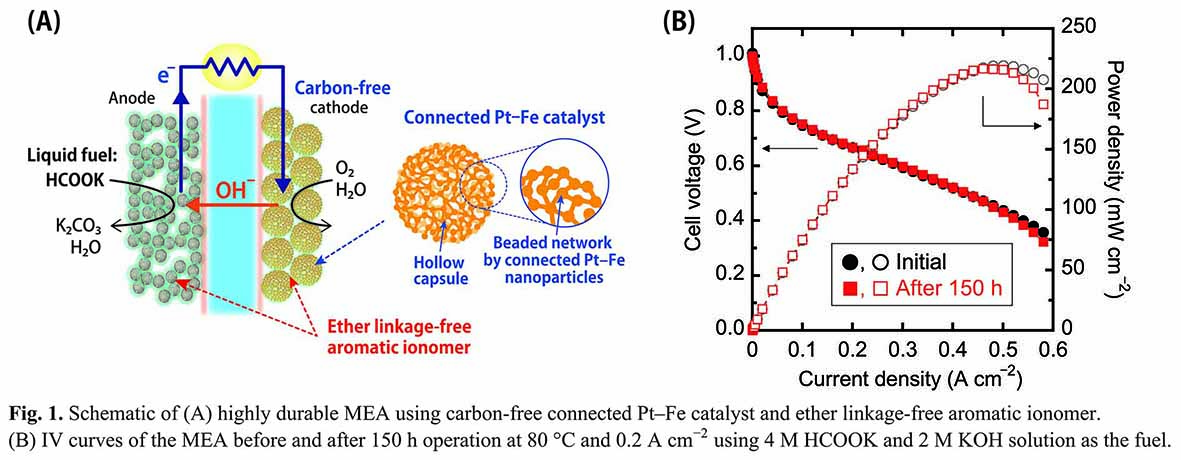
Methanol synthesis from CO2 hydrogenation has been recently an object of study because CO2 is a potential feedstock based on the concept of a methanol-based economy. However, the commercial catalyst Cu/ZnO/Al2O3 does not show enough activity and selectivity of the CO2 hydrogenation. Hence, it is important to develop suitable catalysts for the CO2 hydrogenation. So far, we reported that Cu/ZrO2 catalysts hydrogenate CO2 selectively to methanol. In this study, we focused on flame spray pyrolysis (FSP) which are widely used for producing nanosized metals/metal oxides on an industrial scale. One of the advantages of FSP is the formation of small metal nanoparticles at extremely high metal loading on metal oxide particles. This time, we tried to prepare highly loaded Cu nanoparticles on ZrO2 (20-80 wt%_Cu) by the FSP technique and investigated the effect of Cu loading on activity and selectivity of CO2-to-methanol hydrogenation. When Cu loading was 60 wt%, the catalysts showed higher methanol yield and methanol selectivity than did a commercial catalyst Cu/ZnO/Al2O3. Its catalytic performance was derived from the unique structure: Cu nanoparticles (10-20 nm) were deposited on ZrO2 nanoparticles (5-10 nm). In addition, the Cu nanoparticles were strongly interacted with the ZrO2 nanoparticles, leading to electron transfer from Cu to ZrO2. The interaction might create specific active sites for the CO2 hydrogenation.
Direct Formate Fuel Cells (DFFCs) hold a key stake in the energy systems looked into for answers to the increasing futuristic energy demand, largely due to the offered potential practical energy generation capability along with the safety, low cost and environment friendliness compared to the counterpart alcohol fuels (DEFCs & DMFCs). Palladium has shown the most promising results in recent years for enhanced liquid-fuel oxidation kinetics that could effectively replace platinum in terms of performance and extensive application span, particularly in alkaline medium. In our study, we engineer alloys based on Pd and transition metal (Pd-Ni) /post-transition metal (Pd-Sn) over carbon support using an exclusive wet chemical technique. The formed alloy compositions showed overall enhanced formate oxidation half-cell performance and longer stability compared to Pd/C in alkaline medium. The performance analysis based on the structural and surface characteristics of these nanoalloys obtained over carbon support is elucidated and presented. The successfully developed catalyst compositions and technique employed paves way for a scalable strategy for realizing highly efficient anode catalysts for DFFCs.
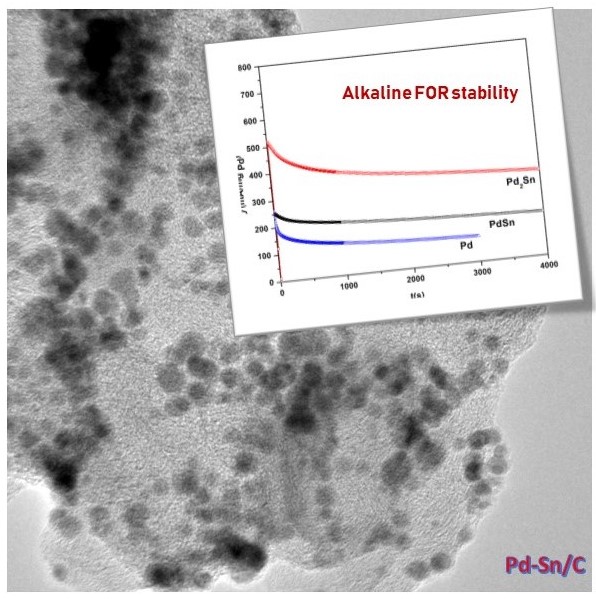
The depletion of fossil fuels and increasing energy demand has driven the research and exploration of new energy alternatives. Hydrogen is considered to be a clean source of energy and steam reforming of dimethyl ether (DME) is regarded as a promising hydrogen production process for fuel cell applications. A plate-type anodic alumina supported Cu composition catalyst was developed to investigate its catalytic performance in steam reforming of DME. It is found that the fresh Cu/γ-Al2O3/Al catalyst without H2 pre-reduction treatment exhibited the similar catalytic activity as the pre-reduced one. The XPS results show that Cu+ species exist in the surface of the fresh catalyst, which results in the self-activation reaction. However, the Cu/γ-Al2O3/Al catalyst showed a quick deactivation at 350 °C due to the sintering of copper. As an approach, a second component Ni was doped to the Cu-based catalyst. Furthermore, the effect of nickel loading and chemical state on the activity of catalyst was extensively investigated. The proper amount of nickel doping is helpful in improving the dispersion of copper species, and thus enhancing the catalytic activity. Finally, a 180 h stability evaluation was carried out and the results show that the optimized Cu/Ni/γ-Al2O3/Al catalyst has an excellent stability under critical conditions with 400 °C, and gives a 100% DME conversion. However, a high CO concentration (ca. 26%) was detected. As such, a multifunctional catalyst combined DME SR and high temperature water gas shift reaction (HT-WGSR) was developed. The CO reduction mechanism was proposed over the Fe-doped Cu-based multifunctional catalyst. Furthermore, the effects of iron loading on the physicochemical properties and performance of catalysts were extensively investigated. The results show that the proper amount of iron doping was helpful in improving the dispersion of Cu, and thus enhancing the catalytic performance and decreasing CO concentration. Finally, it is found that the optimized Cu/Ni/Fe/γ-Al2O3/Al multifunctional catalyst has excellent stability during a 200 h test, and gives a 100% DME conversion at 400 °C in both the microreactor and fixed-bed reactor. Furthermore, crossflow channels and parallel-flow channels were built respectively by mesh-type catalyst and plate-type catalyst in the microreactor. The gas/solid mass transfer limitations in both flow channels were investigated by Damköhler number (Da). The results showed that the Da values of cross flow were always < 0.01, while the values of parallel flow were > 0.01. It indicated that the diffusion over mesh-type catalyst was less influenced by temperature and reactor height, making it a more appropriate choice for the microreactor.
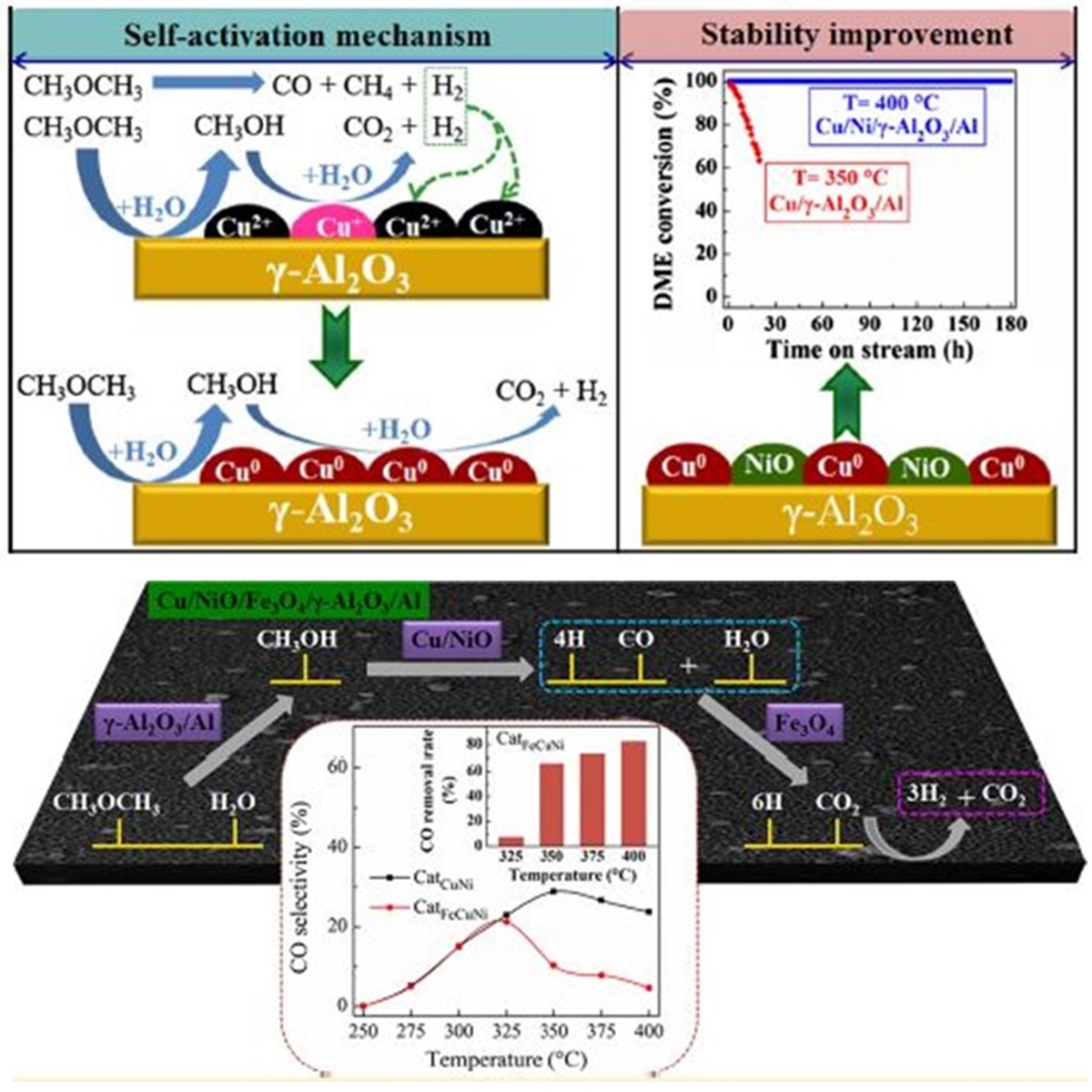
One of the issues for commercialization of direct methanol fuel cell (DMFC) is the slow kinetics of the anode reaction, and an alternative catalyst with high activity has been desired. PtRu nanoparticles supported on CeO2 nanoparticles embedded carbon nanofibers (CECNF), PtRu/CECNF, showed two to three times higher methanol oxidation reaction (MOR) activities due to the support effect of CECNF which efficiently develops the positive interaction between Pt and CeO2 by the CeO2 embedding fiber structure. The interaction can be explained by the reaction mechanism with an oxygen vacancy of the CeO2. In this study, the ion-beam irradiation was employed to introduce oxygen vacancies to the support material in order to increase the MOR activity of the catalyst.
A sheet of CECNF was prepared by using the electrospinning technique. To the CECNF sheet, irradiation of high-energy ion-beam, Ar9+ 127 MeV, was conducted at the different fluence (ion-beam density based on subjected area). After that, PtRu nanoparticles were deposited on the CECNF by a microwave polyol method. The catalytic activity for methanol oxidation reaction was evaluated by using a three -electrode cell with a glassy carbon electrode as a working electrode.
It was found that the MOR mass activity of the PtRu/CECNF increased, up to about 25%, with the increase of the fluence up to a certain value, then decreased with further increase of the fluence as shown in Table 1. The crystalline size of CeO2 in PtRu/CECNF, obtained from XRD profile using Scherrer's equation, decreased with the increase of fluence. EDX results elucidated a decrease of oxygen content in the catalyst due to the irradiation. These results suggested that the ion-beam irradiation destroyed a part of the crystal structure of CeO2, and it enhanced the MOR activity at the proper fluence.
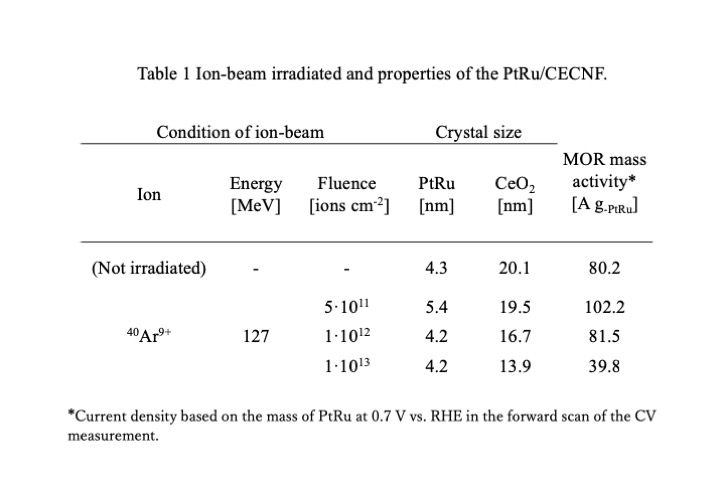
Recent rapid decline in the price of renewable energy increases the importance of energy carriers. Formate solution is one of the envisaged candidate for liquid energy carriers, since formate can be electrochemically regenerated in high energy efficiency from carbon dioxide. For the use of formate solution as an energy carrier, formate needs to be converted to electricity with high energy efficiency.
Our aim in this study is to clarify design strategy of electrocatalysts for formate oxidation reaction (FOR) in alkaline conditions. Palladium (Pd) is known to show better activity for FOR in alkaline solution than platinum. The reaction mechanism of FOR on Pd in alkaline condition remains controversial; although many groups suggested a reaction mechanism without any poisoning species (strongly bound species) such as carbon monoxide (CO), a few studies showed the presence of bound CO. If CO exists, the FOR activity of Pd can be improved by reducing CO adsorption on its surface, which is possible by incorporating oxophilic materials such as ceria (CeO2) and ruthenium (Ru).
Herein, we sequentially deposited CeO2 and Pd over carbon support (Pd/CeO2-C). This Pd/CeO2-C showed better activity for FOR in alkaline medium than Pd/C. The result of an in-situ x-ray absorption spectroscopy (XAS) measurement at Pd K-edge showed the formation of CO on Pd in the presence of formate. Also, the comparison of the spectra between Pd/CeO2-C and Pd/C showed a decrease in CO adsorption with the concomitant increase in OH adsorption on Pd/CeO2-C. We then synthesized Pd-Ru alloy to more effectively incorporate oxophilic materials with Pd. PdRu/C showed better activity than Pd-CeO2/C and Pd/C. These results suggest that the incorporation of oxophilic materials improves the FOR activity on Pd-based catalysts in alkaline medium by reducing the CO adsorption.
At present, polymer electrolyte fuel cell (PEFC) technology is supposed to be commercialized in a wide range. However, water management is an essential problem to achieve maximum performance. The relative humidity (RH) of gases should be controlled to prevent membrane dehydration and liquid water flooding to maintain a high performance level. Hydrogen recycling is one of methods to humidify the cell with water produced in redox reaction, while the overall hydrogen utilization can be 100%. In this study, water transport in a PEFC system with hydrogen recycling was analyzed by combining plug flow reactor model and dimensionless modulus model in the through-plane direction in steady state, when the dry hydrogen and humidified air are fed to an 80 °C isothermal cell. The gas channel was regarded as a straight line in the model. Although the water flux through proton exchange membrane (PEM) has different distribution at different current density, total water permeation rate is 0, as far as the outlet gas of anode recycles to the inlet entirely (Fig. 1). In the case of co-current which the gas flows have the same direction on the anode and cathode sides, current density as well as electroosmosis increases from inlet to outlet of gas channel in low current region, because of humidification by produced water, which enhances the proton conduction in PEM and cathode layer. Besides, the difference in RH of gas flow on two sides of PEM creates water diffusion. When the gas flowrate increases, decreasing proportion of produced water makes PEM dehydrated, and the performance deteriorated (Fig. 2). The RH in the cell increases with decrease in flowrate. At 1 A/cm2 and H2/O2=2, RH becomes 68% at the exit of the cathode in case of 300 mL/min oxygen and RH reaches 100% at 21 mL/min.
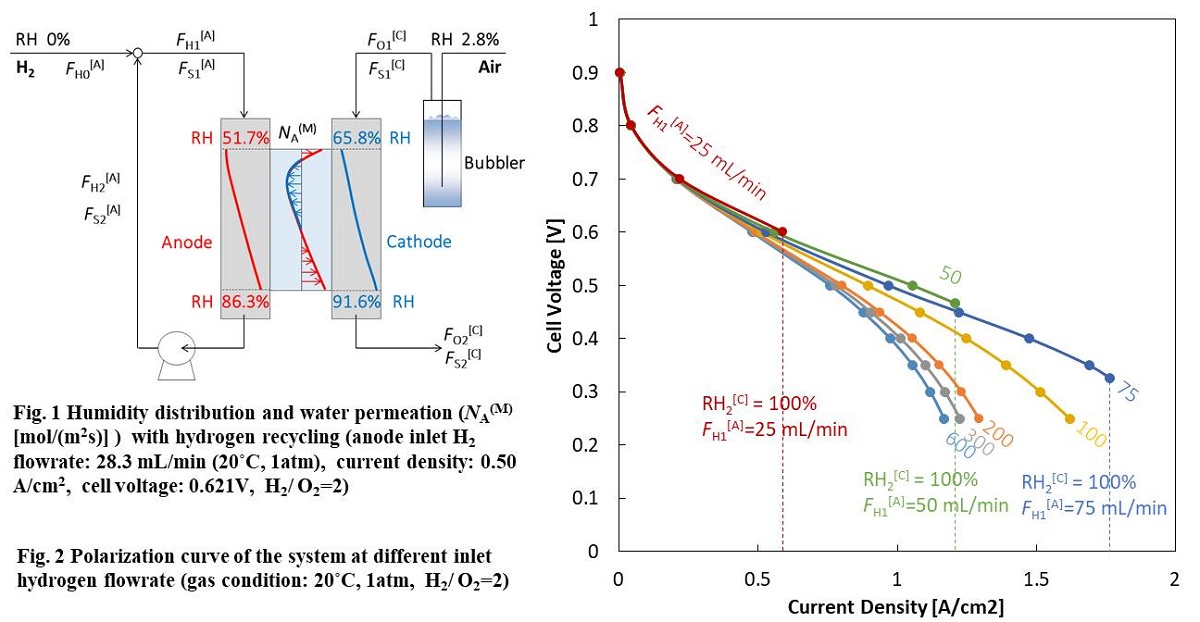
The use of bimetallic nanoparticles (NPs) reduces the noble metal usage without sacrificing the electrocatalytic activity. To theoretically investigate the influence of the NPs' properties, such as strain, stability, or electronic structures on the catalytic activity requires the use of a “close to real size” cluster models. In this study, the phase stability, its origin and electronic structure of Pt3M (M = Co, Ni, and Cu) are investigated using density functional theory (DFT) method. Bimetallic Pt3M-NPs containing 201 (Pt150M51), 405 (Pt303M102), and 711 (Pt533M178) atoms in total were modeled considering three different configurations; 1-skin layer (S1), 2-skin layers (S2), and solid solution (SS). The stability of the Pt3M-NPs was approximated by the excess energy, which contains the mixing enthalpy and configurational entropy. In all cases, the bimetallic NPs were more stable than the monometallic Pt-NPs. For the S1 systems, the mixing enthalpy is the dominant term, and the configurational entropy value is the smallest compared to SS, and S2 systems, as shown in Figure 1. Electronic equilibration in line with the work function difference between Pt and M led to charge transfer from the M to Pt, reducing the surface Pt atoms in the S1 configuration. Additionally, the presence of M of smaller atomic radius than Pt in the core of the nanoparticle made the surface atoms more relaxed compared to the monometallic system, thus decreasing the stress in the structure and helping to accommodate the extra electrons from the M in the subsurface. These changes in the electronic structure and geometrical features were used as descriptors of the Pt3M stability. For Pt3Co and Pt3Ni the stability is largely determined by the surface charge, while for Pt3Cu the dominant factor is the surface strain.
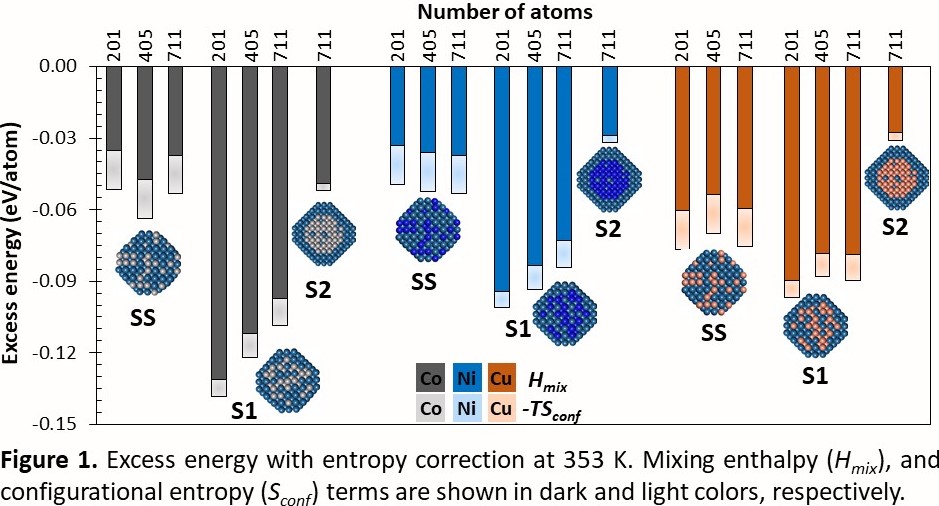
Polymer Electrolyte Fuel Cell (PEFC) is desired to be operated at high temperature such as 90 °C for stationary applications during the period from 2020 to 2025 in Japan. It can be expected thinner polymer electrolyte membrane (PEM) and gas diffusion layer (GDL) would promote the power generation performance of PEFC at this temperature. However, the current PEFC has Nafion membrane and is usually operated within the temperature range between 60 °C and 80 °C. The aim of this study is to clarify the impact of thicknesses of PEM and GDL on temperature distribution in single PEFC generated at high temperature such as 90 °C and to propose the optimum components combination.
As a result, from the investigation of impact of thickness of GDL on the power generation characteristics using the thickest PEM, Nafion 115, the impact of relative humidity of supply gas on the power generation characteristics was small for thin GDL. In addition, in-plane temperature distribution from the inlet to the outlet was flat by promotion of water transfer when using thin GDL. On the other hand, from the investigation of impact of thickness of PEM on the power generation characteristics using thin GDL, i.e., TGP-H-030, the impact of relative humidity of supply gas on the power generation characteristics was not acknowledged. However, the power generation performances using Nafion 212 and Nafion 211 were higher than that using Nafion 115. As to in-plane temperature distribution, it was flat when using Nafion 115 and Nafion 211, while it was increased from the inlet to the outlet using Nafion 212.
It was revealed that the thinnest combination of Nafion 211 and TGP-H-030 was the optimum for high temperature operation such as 90 °C from the viewpoint of the power generation performance as well as controlling in-plane temperature distribution.
Polymer electrolyte fuel cell (PEFC) has been attracting attention as a highly efficient power generation system. Since Pt used in a catalyst is scarce and expensive, it is important to develop a low-Pt catalyst. A core-shell catalyst, which consists of thin Pt shell on non-Pt metal core, has been developed to reduce the amount of Pt. Typically, Cu-UPD (underpotential deposition) followed by surface limited redox replacement (SLRR) is used to fabricate the core-shell catalysts. We have been developing a novel method suitable for mass production of membrane-electrode assembly (MEA) by initially fabricating a catalyst layer (CL) from the core material, and then perform Cu-UPD and SLRR on the CL to obtain a new CL of core-shell catalyst. Moreover, we focused on nanosheet (ns) catalysts. A general Pt-supported carbon catalyst has a problem in durability, since small Pt particles are easily aggregated and dissolved due to its large surface energy. It was reported that Ru@Pt-ns/C catalyst using Ru-ns as the core and Pt as the shell, exhibits high specific activity and high durability due to the low surface energy. In this study, a novel method to produce an electrode with low-Pt core-shell nanosheet catalyst was developed by using Cu-UPD/SLRR in the CL.
The effect of the ionomer ratio on the formation of core shell was investigated. Metallic luster was observed on the surface of the CL for I/C = 0.5 and I/C = 1, indicating abnormal deposition of Pt. However, it was not observed for I/C = 0.25, suggesting uniform core-shell formation. The influence of the number of times of Cu-UPD/SLRR was investigated. The Pt mass activity was low when 2 cycles of Cu-UPD/SLRR were applied but it improved when 4 cycles were applied. The Pt mass activity of Ru@Pt-ns/C prepared by the novel method was higher than Pt/C.
It is well known that laminating a microporous layer (MPL) to substrate such as carbon paper prevents from flooding in catalyst layer (CL) for polymer electrolyte fuel cell (PEFC). It is therefore important to visualize 3D water distribution in both the MPL and substrate to design the material. Visualization of 3D water distribution in the substrate was conventionally achieved by operando X-ray Computed Tomography (CT). However, 3D water distribution in the MPL has not been visualized due to the strong X-ray adsorption of the Pt in the CL. Here we present new method for visualizing 3D water distribution for the MPL. In the experiment, water vaper was diffused in the MPL, and its condensation process was measured by X-ray CT. This method does not need the CL. Conventional problem strong X-ray adsorption of the CL for Operando-CT can be avoided. Obtained sliced image of MPL is shown in Figure 1. Water in the MPL is observed as polka-dot patterns. This suggests that pore to water drain and pore to gas diffusion is separately exists in the MPL. In addition, water movement from wet domain from the MPL to substrate was visualized. These results show potential of the method to understand water condense and drain phenomena in the MPLs.
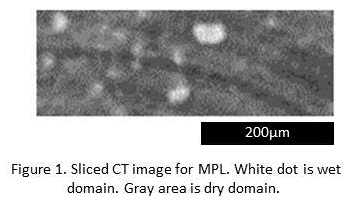
Optimization of the PEFC design is a crucial subject for its deployment and production expenses. However, a comprehensive understanding of its behaviour is needed, including its own structure, electrochemical reaction, reactants and products mass transfer limitations concerning proton and oxygen in principal. The mass transfer takes place through electrostatic drag for proton, and convection and diffusion of oxygen in the cathode catalyst layer (CCL). The authors introduced four dimensionless moduli which govern behavior of CCL.
Effectiveness factor is one under the reaction rate controlled regime, yet, is inversely proportional to Thiele modulus, as far as the convective flow effects are negligible and under oxygen transport control conditions. Under proton transport control conditions, the effectiveness factor is inversely proportional to the modulus that represents the ratio of the reaction rate constant to the effective proton conductivity.
To determine the effectiveness factor and dimensionless moduli, experiments were done on NR-212 (50 μm) with Pt/C weight ratio of 0.3, 0.4, and 0.5. For each Pt/C weight ratio, cathode catalyst layer thickness was 10, 30, 50 μm, using electrochemical measurement system. The impedance spectra were measured in a range of frequency from 10 mHz to 100 kHz.
Figure 1 shows the relation between IR-corrected cell voltage and current density for 10 μm cathode catalyst layer having a Pt/C ratio of 0.3, 0.4 and 0.5. The overall mass transfer limitation between Pt/C = 0.3 and 0.4 was comparable. Oxygen and proton transfer resistances were estimated.
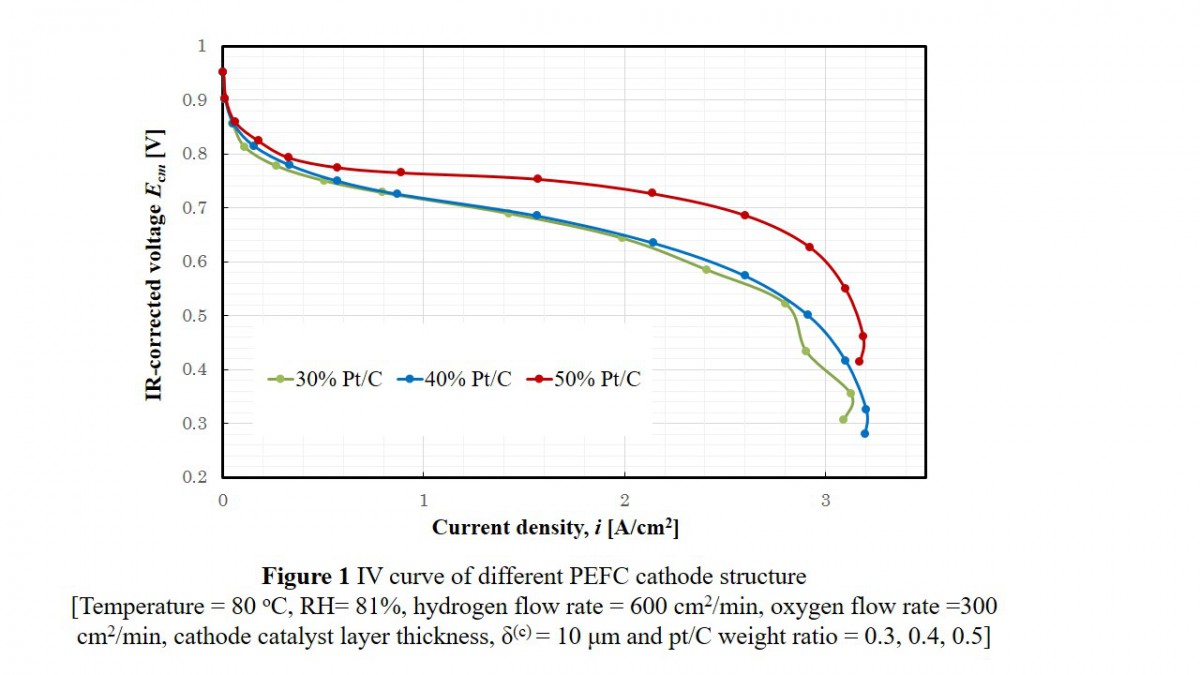
Solid Oxide Fuel Cells and Solid Oxide Electrolysis Cells (SOFCs / SOECs) have much attention because SOFCs have the advantage of being able to convert fossil fuels to electricity with the highest efficiency and SOECs have the advantage of requiring less power for electrolysis compared to PEMs due to high temperature operation. From these backgrounds, both have been considered for practical use.
In recent years, studies on reversible Solid Oxide Cells (R-SOCs) which means a combination of SOFCs and SOECs are in progress. R-SOCs can be regarded as an energy storage system similar to a battery, but have the drawback of a smaller conversion efficiency than that of a battery. In this work, we performed theoretical efficiency calculations of R-SOCs system using an oxide-ion conductor and a proton conductor to show the merit in comparison with a battery.
Ni-based cermets are typically used for anodes of solid oxide fuel cells. However, the Ni phase in such anodes can cause durability problems. One possible approach for mitigating the problems is to reduce the Ni content in the anode, although decreased Ni amount in turn reduces conductivity and electrochemical activity of the anode. In this study, Ni-SDC (samarium-doped ceria) cermet anodes were prepared with different SDC particle sizes and Ni contents, and it was investigated how particle size ratio of the SDC and Ni affected the performance at low Ni contents. Ni-SDC|YSZ|LSM cells were fabricated, then current-voltage characteristics and AC impedance spectra were measured. Impedance analyses with equivalent circuits revealed that ohmic resistance was the primary factor affecting the anode performance in the tested system, and it was found that large SDC particles were effective in reducing the ohmic resistance even at low Ni contents. To further investigate the effects of the particle size ratio, conductances of the Ni-SDC anodes with different SDC particle sizes were calculated from the measured ohmic resistances. The conductances decreased sharply at certain volume fractions of Ni, and the threshold volume fractions shifted toward lower Ni contents when large SDC particles were used. Independently, threshold Ni volume fractions were calculated according to percolation theory, using particle sizes of Ni and SDC estimated from SEM observations. The thresholds thus calculated were in good agreement with those obtained from the ohmic resistance, indicating that the electrical conductivity of the Ni-SDC anodes was governed by the formation of segregated and conductive Ni clusters.
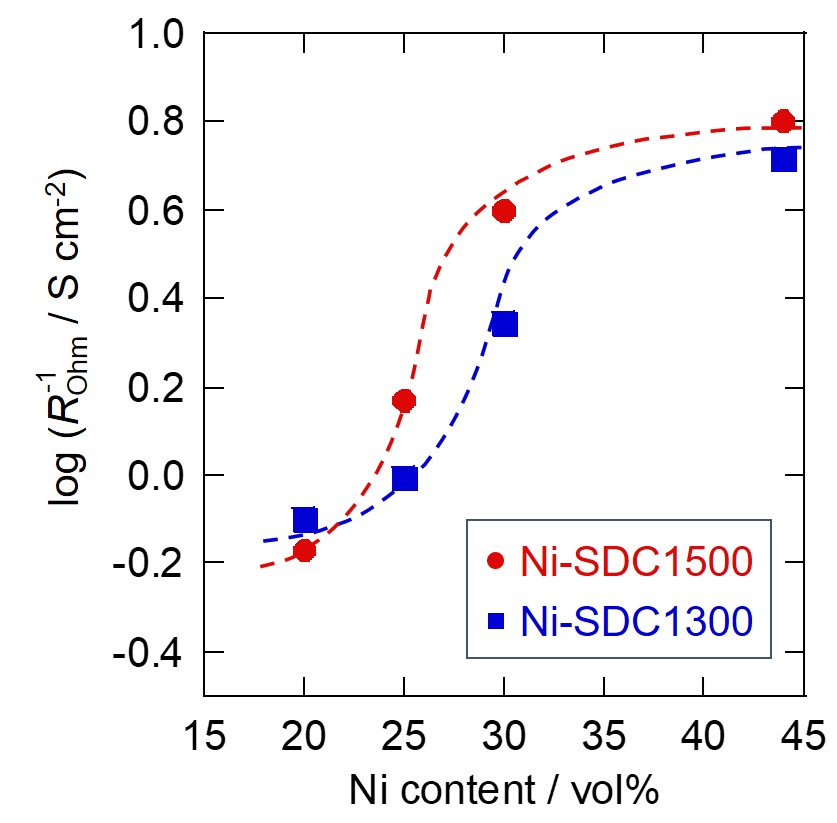
Due to the expanding installation of renewable energy, to solve the gap between the unsteady power supply and the demand becomes a key issue, and the reversible solid oxide fuel cell/ electrolyzer (rSOFC/EC) are increased their attention as a large-scale energy storage. To control their unsteady operations, the quantitative understanding of the reversible reaction kinetics is required. A number of reaction kinetics models of SOFC on Ni/ yttria stabilized zirconia (YSZ) have been proposed [1-3]. The rate determining was described as a surface chemistry on triple phase boundary (TPB) under the local equilibrium between oxygen, O2- and electron [1, 2], or the charge transfer reaction of neutral absorbent, surface ion and electron between Ni and YSZ [3]. In both case, the reaction of SOFC/EC have not been successfully described as a unified kinetics.
We applied the existing reaction model of SOFC anode, which we previously developed [2], to the reversible SOFC/EC with the series of H2/H2O gas components to discuss the SOEC anode reaction. The model is described the kinetics by competitive adsorption reaction at TPB with oxygen activity (aO) calculated from anode potential. As a result, the current density of SOEC was much larger than the extrapolated value by SOFC data at any H2/H2O gas condition. By reinvestigating the local equilibrium of adsorbents, oxide ion and electron on Ni, we proposed a modified kinetics model by defining the electron activity ratio as another independent variable. The kinetics is discussed with the shift of local oxygen equilibrium by changing the charge balance.
Acknowledgement: a part of this work is supported by the New Energy and Industrial Technology Development Organization (NEDO)
[1] Mizusaki et al., Solid State Ionics, 70/71. 52 (1994).
[2] Ihara et al., J. Electrochem. Soc., 148(3), A209 (2001).
[3] Bieberle et al., J. Electrochem. Soc., 148(6), A646 (2001).
The triple phase boundary (TPB) of metal, oxide, and gas phases in the anode of solid oxide
fuel cells plays an important role in determining their performance. In this study, we explored the TPB structures and reaction at TPB combining two approaches: atomic-resolution microscopy observation based on HAADF-STEM (High-angle annular dark field scanning transmission electron microscopy) and reaction dynamics simulation based on reactive force field. From HAADF-STEM observations, two distinct structures are found with different contact angles of metal/oxide interfaces, metal surfaces, and pore opening sizes, which have never been adopted in theoretical simulations in literature. Chemical reaction dynamics simulations for the hydrogen oxidation reaction (HOR) at the TPB are performed using realistic models reconstructed from HAADF-STEM observations. In addition, extensive development of accurate reactive force field parameters was conducted to accurately trace the reaction pathways at TPB. As a result, the activity of different structures towards HOR is clarified, and a higher activity is obtained on the TPB with smaller pore opening size. Three HOR pathways are identified: two types of hydrogen diffusion processes, and one type of oxygen migration process which is a new pathway.
After the Great East Japan Earthquake, there is demand for transformation to a bidirectional system introducing distributed power sources, and a fuel cell cogeneration system with advanced energy utilization has been attracting attention. Even among them, solid oxide fuel cell (SOFC) are high efficiency power generation systems and expected as a promising power source. It is necessary to reduce the raw material cost by improving the power density for further penetration of SOFC. Electrochemical reactions occur only on an effective triple phase boundary (TPB) where each network path of the electron, the oxide ion and the fuel gas connects uninterruptedly. The power generation performance was affected by the effectiveness of TPB. This work aims to realize a microstructure expanded effective TPB between the anode and electrolyte by using a commercial ink-jet 3D printer. Anode and electrolyte inks suitable for material jetting were prepared by changing the viscosity and the particle size. The anode ink formed a porous structure by adding acrylic particles, which ensured the path of the fuel gas. The electrolyte ink formed a dense structure to avoid cross leakage. The microstructure was formed by laminating linear structures in which the porous anode and the dense electrolyte lines were alternately arranged in parallel and orthogonally stacked. The microstructure was inserted between the anode and electrolyte as the anode functional layer of which width and thickness of linear structure were approximately 100 and 1 microns, respectively. The single cell with the microstructure was tested at 600 °C being fueled by dry methane and showed a high performance.
Fuel cells are one of the electrochemical energy conversion devices which can directly convert the chemical energy into electric energy with a high efficiency. Conventional solid oxide fuel cells (SOFC) using oxide ion conducting electrolyte have various difficulties arising from high operating temperatures (700–1000 oC) such as degradation of materials and slow start up and cooldown. Development of electrolytes which can operate at intermediate temperature (500–700 oC) has been desired to overcome these problems.
In this situation, researchers have investigated proton conducting solid oxide fuel cells (PCFC) with thin-film proton-conducting electrolyte to realize intermediate temperature operation. Rare earth-doped BaZrO3 and BaCeO3 have been intensively studied as thin-film electrolytes for PCFC because of their high proton conductivity at intermediate temperatures. However, current leakage through the electrolyte layer occurs as the electrolyte thickness becomes thinner owning to a high hole conductivity in oxidative atmosphere at air side of the cell. Therefore, development of an approach to reduce the current leakage of proton-conducting electrolytes at oxidative atmosphere is required to realize intermediate temperature operation with a high power density.
In the SOFC with ceria-based oxide-ion-conducting electrolyte, formation of bilayer electrolyte consisting of a rare earth-doped ceria layer and a thin Y-doped zirconate layer at fuel side was reported to be effective in suppression of current leakage arising from reduction of ceria. In this research, we extended the concept of the bilayer electrolyte to PCFC in which oxidation of electrolytes at air side is an origin of the current leakage. Anode-supported PCFCs with bilayer electrolyte consisting of Y-doped SrZrO3 layer and Y-doped BaZrO3 layer were prepared by a pulsed-laser deposition (PLD) method and current-voltage measurements and electrochemical impedance spectroscopy measurements were carried out. We will discuss the effect of the bilayer electrolyte on the cell performance of anode-supported PCFC.
To introduce renewable energy or electric vehicles, hydrogen power to gas to power (PtoGtoP) or lithium air battery have been developed for increasing energy density of batteries. However, there remains issues that hydrogen needs to be compressed to several tens of MPa or to be below -250 °C for increasing the energy density, and reduction of Li2O2 needs large overvoltage. Therefore, we made an idea to apply the redox reaction of CO2 and carbon to secondary battery because of easy storage of CO2 and high energy density of carbon. Here we proposed carbon-air secondary battery (CASB) system.
The CASB system can be composed of solid oxide fuel cell (SOFC), stored liquid CO2 and solid carbon. The CASB system works as secondary battery by electrolysis of CO2 and power generation using carbon directly. Storage of CO2 can be easier and safer than storage of hydrogen because CO2 liquefies under 6 MPa. In addition, the theoretical conversion efficiency of the redox reaction C+O2⇄CO2 equals to 1, so that the CASB system is expected to work efficiently.
In this research, we demonstrated the redox reaction and evaluated potential of the CASB system as large-capacity energy storage by comparing the theoretical volumetric power density and energy density with existing and developing secondary batteries and hydrogen PtoGtoP.
We prepared a coin type SOFC supported by the electrolyte, and repeated electrolysis of CO2 and power generation using generated fuel at 800 °C, 100 mA/cm2. During charge operation, analysis of Nernst potential revealed that carbon deposited by Boudouard reaction 2CO→C+CO2 with increasing partial pressure of CO due to electrochemical reaction CO2+2e-→CO+O2-. During discharge operation, carbon or CO was used for power generation. A discussion about potential of the CASB system showed that it can have larger gravimetric and volumetric energy density than secondary batteries and hydrogen PtoGtoP.
Sustainability has emerged as a keyword in all aspects of life whether it is resources or technologies and products or processes. Besides, nearly a billion new consumers join the society in 13-15 years; and the growing demand for higher standards of living make the worldwide materials consumption continuously growing. Strategic solutions are therefore required not only for addressing the gaps but also for eliminating the undesirable environmental effects of supply chain to ensure quality and sustainable living. Energy storage is currently a multibillion dollar industry and is expected to be continuously growing because (i) electrification of products and services has been emerged as an efficient strategy to mitigate carbon footprints from major emitting sectors such as automobiles and (ii) internet of things, advanced communication devices and other modern electrical appliances such as drones and robots demand efficient electrical energy storage devices. Source of primary materials supply for this large industrial sector is therefore crucial; extensive use of earthborn materials as energy storage medium would not only lead to disasters but also would result in expensive devices. Functionalization of renewable materials such as biomass carbon, cellulose, oils etc. as components of energy storage devices would ensure a sustainable living. This lecture will focus on the current state of renewable materials as an energy storage medium, both in the lecturer's laboratory and elsewhere, and foreseeable initiatives required to build efficient energy storage devices using renewable materials.
Due to population and economic growth, further increases in energy demand are predicted globally. Therefore, the construction of a sustainable carbon cycle system is essential to address fossil fuel depletion. The conversion of carbon dioxide (CO2) to hydrocarbons is currently a major challenge.
Among available technologies, the electrochemical conversion of CO2 on copper (Cu) electrodes has gained popularity as a novel technique to realize a sustainable carbon cycle because of improvements in power generation using renewable energy sources, such as solar and wind energy. However, the electrochemical conversion of CO2 on Cu electrodes not only produces valuable hydrocarbon products but also emits byproducts such as carbon monoxide (CO) and hydrogen (H2) because the product selectivity of this conversion is sensitive to the Cu electrode's surface properties, such as atomic arrangement and morphology. Therefore, electrodes for a more selective electrochemical conversion of CO2, which promote hydrocarbon formation and suppress byproduct formation, are required for practical technology.
In this work, we report the selective electrochemical conversion of CO2 on nickel (Ni) / Cu binary electrodes. The formation of hydrocarbons on these electrodes was strongly dependent on both the crystal structure of the supporting Cu electrode and the amount of Ni deposition. This suggested that the adsorption of a carbonate intermediate on the surface of Ni/Cu binary electrodes, formed by the electrochemical conversion of CO2, improves to the selective electrochemical CO2 conversion for hydrocarbon formation compared with pristine Cu electrodes. Based on these results, we discuss the mechanism of the selective electrochemical CO2 conversion and the inhibition of H2 byproduct formation on Ni/Cu binary electrodes.
Formic acid or formate is considered as a perfect fuel for clean energy generation through fuel cells. Formate can be electrochemically generated from CO2/HCO3–. According to techno economic analysis, formic acid/formte is one of the most profitable products of electrochemical CO2 reduction reaction. Sn based electrocatalysts are known for the selective production of formate from CO2 with a faradaic efficiency >80%. But main drawback of these catalysts is high overpotential for the reaction. Various methods have been tried to reduce the overpotential and to improve the catalytic activity of Sn. In this work, we investigated the effect of Pd doping on the surface of Sn for the electrochemical generation formate from CO2 and HCO3–.
We prepared Sn and Pd nanoparticles decorated N doped carbon fibers (SnPd-NCF) from SnCl2, PdCl2 and polyacrylonitrile using electrospinning method. SEM and TEM analysis confirm the uniform distribution of Sn and Pd nanoparticles over N doped carbon fibers. XPS spectra confirmed nitrogen-doping on carbon fibers. We found that an addition nearly 1.5 wt % of Pd on Sn surface greatly enhance the faradaic efficiency of formate formation and reduce the overpotential nearly by 0.3 V compared to that of Sn nanoparticles decorated N doped carbon fibers (Sn-NCF).
Figure. (a) Voltammetric response of CO2 reduction on Sn-NCF and SnPd-NCF in 0.5 M KHCO3 solution saturated with CO2. (b) Faradic efficiency of formate produced on Sn-NCF and SnPd-NCF during CO2 reduction reaction at -0.85 V vs RHE.
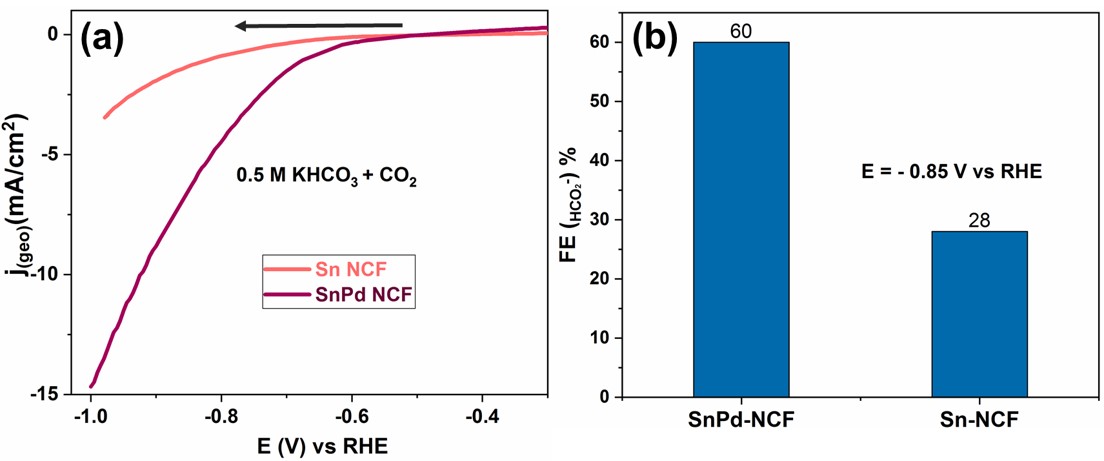
Non-Faradaic electrochemical modification of catalytic activity (NEMCA) by impression of electric field (EF) is one of the methods to improve catalyst performance. It has been discussed that oxygen anions forced electrochemically to adsorb on catalyst surface alter the catalyst electric property. However, given EF also changes the catalyst electric property directly. Because it is difficult to divide down these effects with an experimental approach, we have tried to theoretically investigate the mechanism of NEMCA in CO2 methanation (CO2 + 4H2 → CH4 + 2H2O (1)) in solid oxide electrolysis cell (SOEC) using the density functional theory (DFT). In concreate, we have focused on the rate-determining steps (RDSs) of CO2 methanation proposed by our detailed reaction mechanism analysis. We have calculated the adsorption energies of hydrocarbon species related to RDSs on Ni(111) (CO2 → CO + O (2), CHO → CH + O (3), CH4 → CH3 + H (4)) with EF or co-adsorbed oxygen atoms. In our calculative setup, used is the model sandwiched between thin film condenser boards connected to the outlet electrode for direct EF impression calculations, While used is the Ni(111) surface with different number of oxygen atoms for co-adsorption calculations. Due to space limitation, just an example of our calculations is shown in this abstract. With external EF, the equilibriums in reactions (2), (3) and (4) are all leaned to products side in the EF from the gas phase to the Ni surface (negative values in Table 1), which means CO2 methanation is promoted in this EF direction. This tendency is caused by the destabilization of reactants (CH3 in reaction (3)) or the stabilization of products (O, CO in reactions (1), (2)) with an EF as shown in Table 1 (right side). Other results and detailed discussion will be reported at our presentation in this conference.

Electric double layer capacitor (EDLC) can store energy by an electric double layer at the interface between the electrode and the electrolyte, which is one of the emerging energy storing devices. High capacity, high durability and rapid charge-discharge capability are attractive, however, low energy density poses drawback to practical use. Specific surface area, surface functional group, and pore size distribution are important controlling factors to improve energy density. In this study, the relationship between the surface functional group and the pore size distribution, and the EDLC capacity was investigated while the specific surface area was nearly equal value as 1200±100 m2/g. In addition, the effect of particle was investigated.
We prepared activated carburized furfural resin particles (1 μm in diameter) with KOH activation for 0 to 0.5 h at 700 to 800 °C in N2 flow, then investigated the electrostatic characteristics of the capacitors in 6M KOH by using a two coin-shaped electrodes. Activated carbon (1 μm in diameter) treated by 750 °C-0 h or 800 °C-0 h had 2.5 times larger mesopore volume and 1.9 times larger mesopore ratio than the one by 700 °C-0.5 h. The fractional order of lactone increased from 700 °C-0.5 h (9.7%), 800 °C-0 h (10.6%) to 750 °C-0 h (24.5%). The fractional order of carboxyl groups increased from 750 °C-0 h (18.1%), 800 °C-0 h (23.0%) to 700 °C-0.5 h (31.4%). Activated carbon treated by 750 °C-0 h (227 F/g) and 800 °C-0 h (225 F/g) were higher than 700 °C-0.5 h (198 F/g). From these relationship, there would be no clear trend for specific capacity per weight under the situation having the nearly equal SBET. We assumed that mesopore ratio should be a main factor to obtain high specific capacity per weight at this moment.
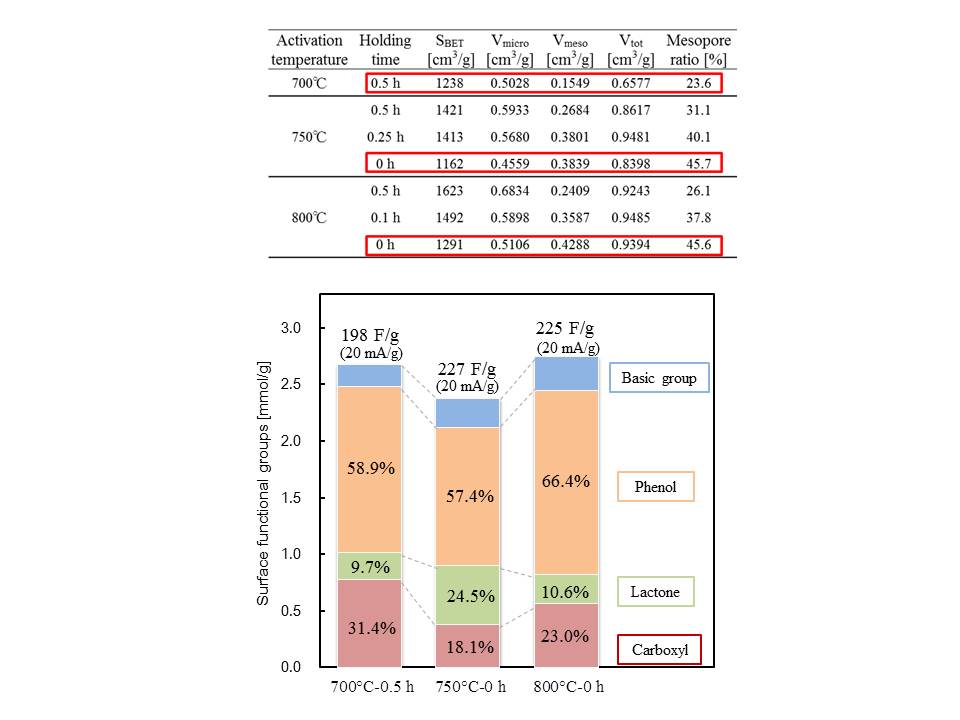
TiO2 is a promising material for the development of lithium-ion capacitors, because side reactions hardly occur at the charge/discharge potential of TiO2, compared to graphite. When using TiO2 as an electrode material, it is necessary to combine it with carbon at the nanometer level to improve its low electrical conductivity and low rate of reaction with Li+. However, preparation methods of reported TiO2/carbon nanocomposites are generally not cost effective, and their productivities are low. In this study, the vacuum liquid pulse chemical vapor deposition (VLP-CVD) technique was developed to easily prepare nanocomposites of TiO2 nanoparticles and commercially-available porous carbons. Using this technique, TiO2 nanoparticles with a diameter of ~4 nm could be homogeneously deposited inside pores of meso- or macroporous carbon. Because the deposited TiO2 nanoparticles connect to electrical conductive paths of the porous-carbon substrates, they showed a high discharge capacity of ~200 mAh/g-TiO2 (based on the TiO2 weight). In particular, the composite prepared from macroporous carbon showed extremely high rate performance, where 50% of the discharge capacity was retained at a current density of 15000 mA/g when compared to that measured at 50 mA/g. In addition, the composite also showed very high cyclability, where 80% of the discharge capacity was retained at the 10000th cycle. Because the VLP-CVD technique can be performed using simple apparatus and commercially available starting materials, it can be expected to apply this technique to industrial production of TiO2/porous-carbon nanocomposites for lithium-ion capacitors.
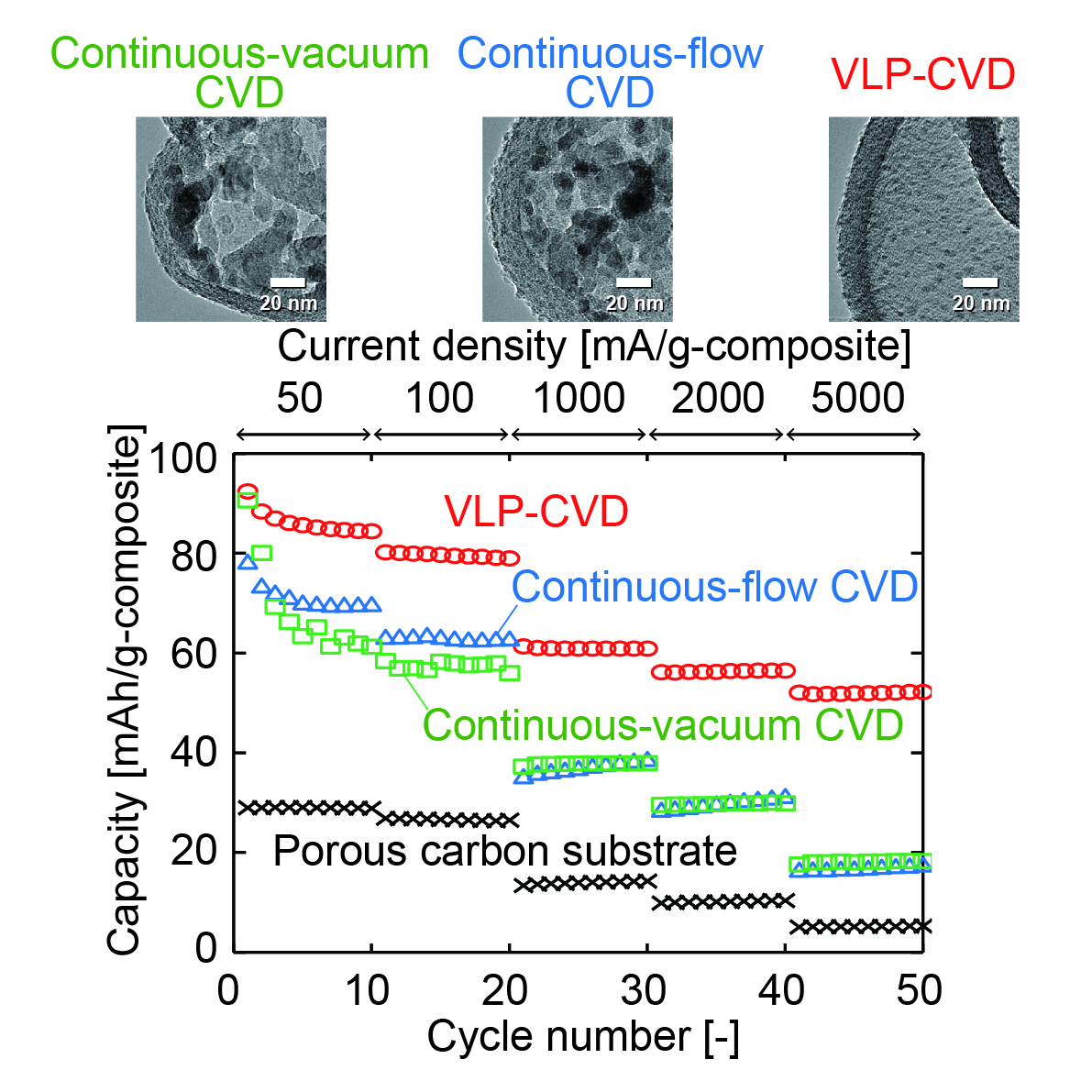
The utilization of crystalline silicon solar cell and organometal halide perovskite solar cell in tandem application has attracted a lot of attention for its high theoretical energy conversion efficiency (>35%). However, the approach of superposing these two solar cells raised issues that have to be clarified and rectified in order for this technology to reach its potential.
In a 2-terminal perovskite/Si solar cell configuration, the bottom silicon solar cell is superposed by perovskite based top cell using highly doped silicon layers as a tunnel junction. This approach comes with three main issues: 1. interface between silicon and TiO2, 2. quality of the perovskite thin layer, 3. transparency and conductivity of front electrode.
The main challenge in the Si/TiO2 interface is to reduce carrier recombination. In addition, constraints on fabrication techniques such as high temperature treatment in TiO2 deposition requires careful consideration to make sure a good surface passivating layer is fabricated properly. Secondly, as topological structure of substrate affects the structure of the thin film, the quality of perovskite layer when fabricated on silicon substrate and ITO covered glass has to be compared and analyzed. Thirdly, as light has to pass through the front electrode in order to reach perovskite absorbing layer, the transparency and conductivity of front electrode has to be optimized in order to achieve the maximum performance of the tandem solar cell.
In this study, we designed an experimental approach to understand these challenges by fabricating perovskite solar cell using highly doped n-type silicon wafer as substrate (Figure). We found that when typical TiO2 is used to passivate silicon wafer, the carrier lifetime decreased dramatically. To mitigate this phenomenon, we are currently modifying the structure of TiO2 with various annealing methods and analyzing the relationship between TiO2 structure and its properties as passivating layer.
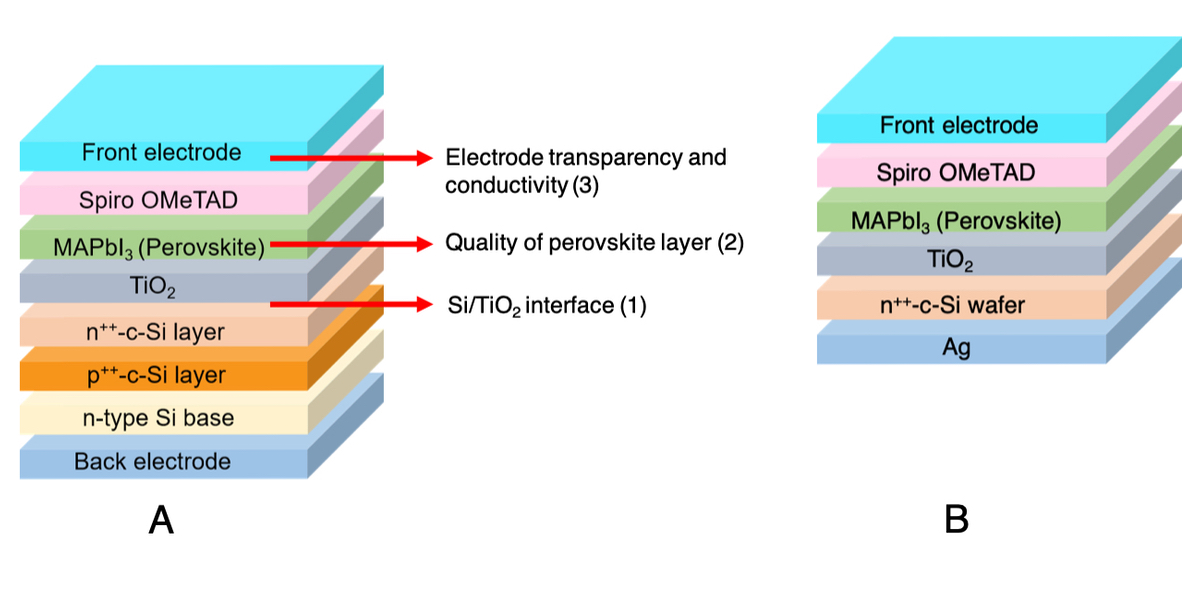
Exploring earth-abundant, active and stable electrocatalysts to replace noble metal materials for hydrogen evolution reaction through alkaline water electrolysis system is key to the development of sustainable energy conversion technologies. Here, we report a novel hybrid electrocatalyst comprised of atomically dispersed Ni-Nx species anchored porous carbon matrix with embedded Ni nanoparticles. Benefiting from the high surface area and strong coupling interaction of the Ni NP and Ni-N-C, the achieved Ni NP Ni-N-C EG hybrid electrode displays excellent electrocatalytic activity for HER in basic condition with a low overpotential of 147 mV to reach current density of 10 mA cm-2. The overpotential for the Ni NP Ni-N-C EG is well comparable to the best reported value in literature for all existing heteroatom doped nanocarbon catalysts and even lower than those reported for other transition metal based compounds in basic media. Furthermore, the Ni NP Ni-N-C EG hybrid electrode exhibits outstanding catalytic activity for overall water splitting under alkaline condition, as reflected by delivering a current density of 10 mA cm 2 at 1.58 V, which surpasses that of the benchmark combination catalyst for sufficiently high overpotentials. Electrochemical results, coupled with the thiocyanate poisoning experiments, HAADF-STEM analyses, XPS analysis, as well as the EXAFS and XANES results, reveal that the hybridization of atomically dispersed Ni-Nx active centers with that of embedding Ni NP modulates the electronic structure and facilitates electron transfer at the constructed interface, which synergistically boost the HER performance of Ni NP Ni-N-C. Theoretical calculations manifest that the incorporation of Ni NP into atomically dispersed Ni-N-C frameworks can effectively promote initial water dissociation process and simultaneously optimize the OH adsorption free energy on the Ni NP Ni-N-C, resulting in the improved kinetics of the HER in alkaline solutions.
Hydrogen is a promising energy carrier to utilize renewable energy sources. It can be generated by using water electrolysis technology. Alkaline water electrolysis using anion exchange membranes (AEMs) draws a lot of attention. Besides being able to use non-noble metal catalysts, its performance is better than conventional alkaline water electrolysis thanks to lower internal cell resistance. However, the development of this technology is hindered by the lack of high performance and durable AEMs. Ether-free aromatic AEMs can be promising candidates to overcome the performance and durability issues. In this research, we proposed a unique AEMs molecular design using thermally convertible polymer system (Fig.1). Highly soluble precursor polymer is used to prepare a thin membrane. This precursor membrane then heated to obtain ether free backbone membrane.
We prepared the precursor polymer by Suzuki-Miyaura coupling of the monomers followed by bromination then quaternized to afford TPP-V2. Number average molecular weight (Mn), polydispersity (PDI) and ion exchange capacity (IEC) of TPP-V2 are Mn= 24,600 g/mol,, PDI=2.9 and IEC= 2.90 meq/g, respectively. Ultra-thin flexible membrane as thin as 8 μm can be cast from TPP-V2 solution in dimethylsulfoxide. TP-V2 membrane was obtained by heating TPP-V2 membrane at 180 oC for 1 h under vacuum. After conversion to TP-V2, IEC value increases to 3.78 meq/g. Despite higher IEC, water uptake of the TP-V2 is lower than it's precursor as π-π stacking appears. TP-V2 shows high alkaline and oxidative durability after exposed to 8M NaOH for 120 h at 80 oC (alkaline stability test) and 3% H2O2 & 3 ppm FeSO4 60 oC for 8 h (oxidative stability test). The ionic conductivity was almost the same even after exposure to such very harsh conditions. These results suggest our approach is promising for making high-performance AEM for alkaline water electrolysis application.
Acknowledgement: Part of this paper is based on results obtained from a project commissioned by the New Energy and Industrial Technology Development Organization (NEDO).
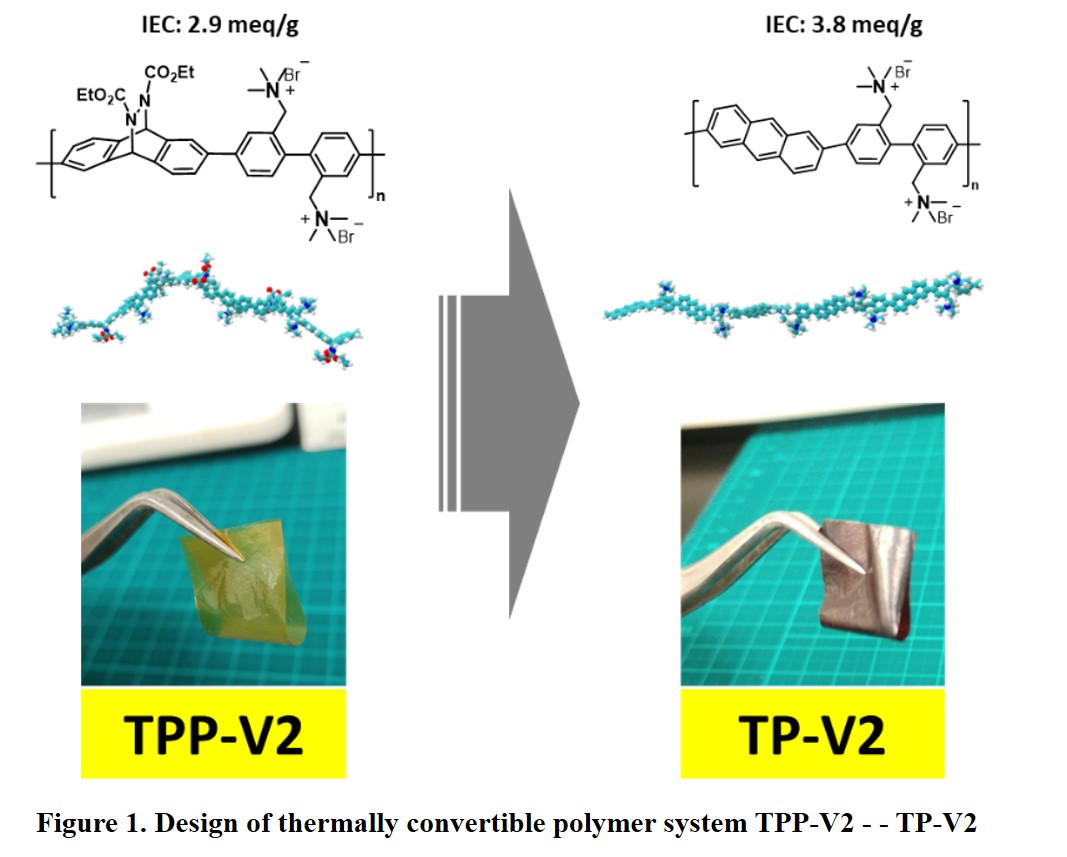
Oxygen evolution reaction (OER) catalysts for polymer electrolyte water electrolysis (PEWE) suffered from their low surface area because carbon support cannot be used for OER operating at high potential. Connecting metal nanoparticles enable catalysts to conduct electrons through nanoparticle networks without any support materials while keeping their high surface area. Thus, connected nanoparticle catalysts (Fig. 1 (A)) are promising for OER. Previously, we have developed connected Pt-Fe nanoparticle catalysts with hollow capsule structure for oxygen reduction reaction (ORR) in polymer electrolyte fuel cells (PEFCs).[1]
In this study, we proposed Ir nanoparticle catalysts for OER in water electrolysis because Ir has high OER activity. Ir nanoparticle catalysts were synthesized as follows. First, Ir nanoparticles were synthesized on silica template via polyol method using tetraethylene glycol as reducing agent and Ir(III) acetylacetonate as the metallic precursors (Ir/PDDA/SiO2). Then, these nanoparticles were coated with SiO2 using tetraethoxysilane in a mixed solvent of ethanol and NH3 solution. After coating, they treated in supercritical ethanol at 330 °C for 90 min. Dissolution of SiO2 in 3 M NaOH solution at 85 °C for 3 h made porous hollow structure (Ir capsule). OER performance were evaluated by cyclic voltammetry in 0.1 M HClO4 solution. A membrane electrode assembly (MEA) was fabricated by Ir/PDDA/SiO2 as an anode catalyst, and its water electrolysis performance was measured.
Fig. 1 (B) shows TEM image of Ir capsule. Capsule and networks structure of the catalyst were observed by TEM images. Fig. 1 (C) and (D) show OER curves and mass activities of Ir catalysts. Mass activity of Ir/PDDA/SiO2 was 2–3 times higher than Ir capsule and commercial Ir black. MEA using Ir/PDDA/SiO2 showed good performance.
[1] T. Tamaki, H. Kuroki, T. Yamaguchi et al., Energy Environ. Sci., 8, 3545-3549 (2015).
Acknowledgement: This paper is based on results obtained from a project commissioned by the New Energy and Industrial Technology Development Organization (NEDO).

Water electrolysis by using renewable energy such as wind and solar energy for hydrogen production is considered a promising way to storage the unstable electricity and realize low-carbon society. However, for large-scale application of water electrolysis, the key is to design low-cost electrocatalysts with high performance for the replacing of the noble metal based catalysts. Meanwhile, in the water electrolysis, the electrolyte includes acidic, alkaline, industrial waste water, and seawater with different pH values. It is expected to have the electrocatalysts which can work in a wide pH range, especially in the neutral solution so that it can be applied anywhere. Moreover, the solutions with the neutral pH value is harmless and environmentally friendly. In this study, nanostructured manganese-nickel mixed oxide with nanosheet array was fabricated on the Cu nanowires growning on the copper form <CF> by electrodeposition method, and then further phosphorized to MnNiP. The obtained Cu nanowire @ MnNiP/CF electrode was used for the hydrogen evolution reaction in water electrolysis. As a result, a low overpotential of 104 mV@10mAcm-2 with a small Tafel slope of 55.1 mV dec-1 in the neutral solution was achieved due to the enhanced charge transfer ability, improved surface active area and fast reaction kinetics.
Recent studies on polymer electrolyte fuel cell (PEFC) based energy generation have focused more on elevated temperature (above 100 °C), since high temperature PEFC (HT-PEFC) enhances tolerance to CO and prevents flooding as well as makes waste heat emission and its utilization easy. However, relative humidity (RH) management appears more difficult at elevated temperature. RH profile inside the cell should be well analyzed to ensure proton exchange membrane (PEM) is sufficiently hydrated to keep moisture content. In the current study, 1D model in the direction along the gas channel has been built for the straight co-current flow channels for analyzing water behavior at varied cell temperature and total pressure. Water permeation flux, moisture content, and proton conductivity of PEM were calculated. Employing straight channels, RH profile in the cell can be measured as change in RH at the cell outlet with varying the gas flow rate in experiments. Measured and calculated RH profiles through the gas channel were investigated at varied cell temperature. Total water flow rate at the outlet increases as the current increases. Partition of generated water to two sides is determined by the inlet RH and flow rate conditions. As the cell temperature is higher, the saturated vapor pressure is the higher. The more water generation is required to attain a certain RH through the cell at the higher cell temperature. This is the most important reason that water management is more difficult at elevated temperature.
The power grid supplies electric power while maintaining 1. voltage, 2. frequency, and 3. transient stability, three conditions for stable power supply from the electric grid. However, recent large-scale implementation of solar cells has caused difficulties in meeting these conditions because of the power supply-demand gap. To solve this problem “leveling power”, the ability to keep the balance of supply and demand of power, is required. Although power has been leveled by power grid, the leveling by distributed energy system is also required. Energy storage technology is one of the methods to introduce power leveling in the distributed energy system. Combination of energy storage technologies, such as battery or Power to Gas (P2G), which converts power to hydrogen, is expected to contribute to the stability of power supply. Actual data with the range of minute to second is required to investigate the feasibility of each technology as power leveling.
In this research, firstly we analyzed the current status of power leveling required for power-grid by using actual generation and power demand data published by power companies across Japan and the actual data at Ookayama campus in Tokyo Institute of Technology. Smart energy system “Ene-swallow” installed at Ookayama campus accumulates power demand data in a second and solar generation data in a minute. Secondly, we calculated total supply-demand gap in the assumption of large-scale implementation of solar cells by using actual annual data in a minute from “Ene-swallow” and then we designed required amount of P2G system and battery for the leveling. The analysis showed that the total system cost could be reduced by using the combined system of P2G and battery.
[Acknowledgements] A part of this study is supported by the New Energy and Industrial Technology Development Organization (NEDO) and MIRAI program of Japan Science and Technology Agency (MIRAI JST).
Recently, the implementation of renewable energy, especially photovoltaics (PVs), has been rapidly expanded due to its significant cost decline with technology and market development. However, the supply fluctuation of renewable power sources makes keeping the balance of electricity demand and supply difficult. In order to make the best use of renewable power sources, the electricity demand-supply gap has to be balanced using energy storage technologies. Power-to-Gas (P2G), which converts electricity to hydrogen, is a promising candidate for a large-scale, long-term energy storage technology.
In this research, we analyzed the economic efficiency of distributed P2G system considering not only horizontal but also vertical installation of PVs. This analysis was carried out based on actual data accumulated in smart energy system “Ene-Swallow”. We used electricity demand data from the Ookayama campus in Tokyo Institute of Technology, and power generation data of PVs installed at the Environmental Energy Innovation (EEI) building, where PVs are installed on the rooftop, the south and west walls as shown in figure 1. We modeled the P2G system to simulate power generation and consumption at every hour of a single year, and to evaluate the total cost including the fixed and variable cost.
This analysis shows that if the price of each device decreases due to technology and/or market development in the future, appropriate implementation of a distributed P2G system will lower the total cost compared to the case where all of the required power was purchased from the power grid. This study also shows that in Tokyo area, appropriate combination of horizontal and vertical PV installation can lower the total cost compared to the case where only horizontal PV is installed. In addition, to discuss the feasibility of this analysis results, we investigated the possible installation amount of PVs at the Ookayama campus.
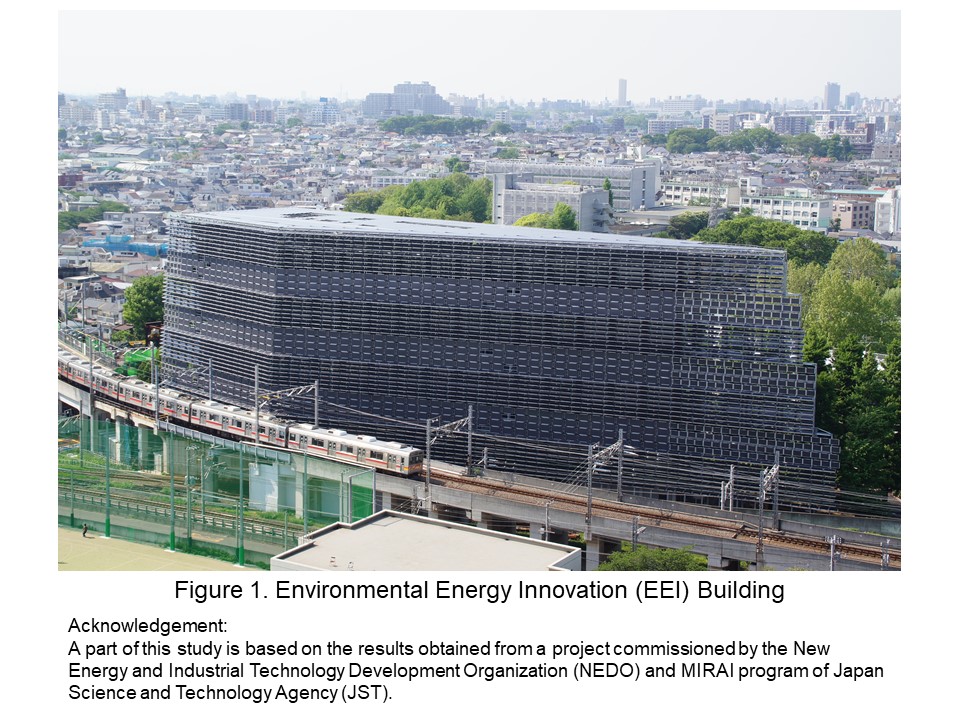
Photovoltaic (PV) cells powered water electrolysis cells (WECs) are capable of converting and storing the solar energy in the form of hydrogen (H2), thereby facilitating the continuous usage as well as distributing of this intermittent and diffusive energy resource (1). However, precious metal based catalysts are required to catalyse the two half reactions in WEC, e.g. Pt and its alloys for hydrogen evolution reaction (HER), and oxides of Ru and Ir for oxygen evolution reaction (OER), which has constrained the widespread applications of PV-WEC systems. Thus, advanced electrode materials for WECs that are active and cost-effective are highly sought after.
Herein, I will present some of our recent research progress regarding the development of advanced electrodes for WECs. These electrodes are mainly comprised of earth abundant elements, such as first row transition metals (Ni, Co, Mn, Fe) and/or carbon. For instance, by depositing mesoporous NiFe nanosheets onto the skeleton of macroporous nickel foam (NiF), a highly efficient, freestanding oxygen evolution electrode is prepared, showing hierarchical micro- to nanoscale porosities, and is among the most active in bases (2). Besides that, a Mn doped NiO/Ni heterostructured electrode (Mn-NiO-Ni/NiF) is also successfully synthesized. The prepared material is highly active for HER in both neutral electrolytes and natural seawater, exhibiting a Pt-like catalytic activity (3). A customised WEC was assembled based on the NiFe/Ni-F anode and the Mn–NiO–Ni/Ni-F cathode, which is highly active in splitting water, reaching a high current of 0.2 A at 1.8 V. Moreover, the WEC can be directly powered by PV cells tol enable the production of renewable hydrogen (Figure 1).
Reference
(1) X. Lu, et. al, J. Am. Chem. Soc. 2015, 137, 2901-2907
(2) X. Lu, et. al, Nat. Commun. 2015, 6, 6616
(3) X. Lu, et. al, Energy Environ. Sci. 2018, 11, 1898-1910
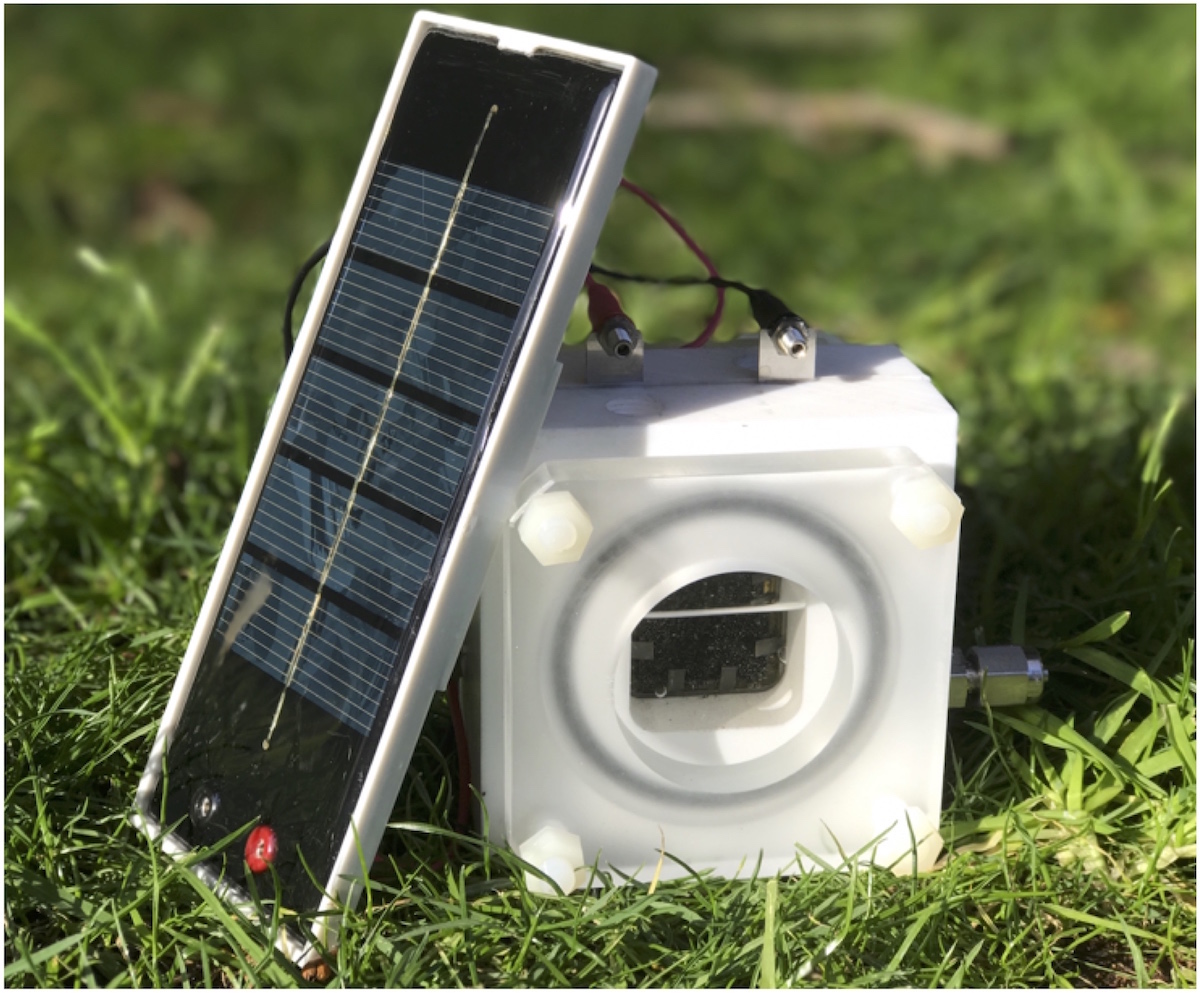
Automobile sales in China decreased by 2.76% to 28 million vehicles in 2018, that is the first decrease in the past 28 years. Market developments in New Energy Vehicle (NEV) including hybrid and pure electrical vehicles (BEV), as well as fuel cell vehicles (FCV) are inevitable and the number of NEV will break through up to 1.5 million vehicles in 2019. However, LIB with high energy density used in BEV is facing many safety risks with various faults and life issues due to less development accumulation in material process and manufacture. Meanwhile FCV is difficult to form into a mature commercial market, where many relative core materials and components are lower in quality and less reliable as compared with overseas products and most of them are depended on imports.
Shanghai AI NEV Innovative Platform upholds a critical function position for supporting industrial chain innovation, supporting R&D transformation to key products and servicing entrepreneurship in automotive field, by focusing on promoting the opening and coordination of innovative resources to reduce the cost of starting a new business. One of the major functions is battery material analytical service to give key solutions to safety, energy density and life of on-board LIB and to support developing high-performance FC stacks with low lost materials.
In this presentation, China's NEV policy, regulation, EV evaluation, material analysis situation will be explained and the function position of Shanghai AI NEV Innovative Platform will be introduced. Some LIB estimation methods and corresponding material analytical results relative to battery capacity (energy density), degradation (life), failure (warning) and exothermic (safety) items are given.
Lithium ion batteries (LiBs) are used in electric vehicles (EVs), hybrid electric vehicles (HEVs), compact devices and so on. However, both more power density and energy density is required, so active materials, binders, electrolytes, and separators are enthusiastically developed. Moreover, the ability of LiB determines not only materials but also the electrode structure. In the case of high output density cell, in other words, in the case of rapid charge or discharge condition, ionic conduction in porous electrode layer is dominant resistance, and it strongly depends on the heterogeneous porous structure. Recently, some researchers have been trying to understand the relationship between this porous structure and the effective ionic conductivity. In our previous research, the relative ionic conductivity was simulated in different porous electrode structure which consists of active material and binder, and the effect of morphology was discussed with electrochemical experiment, direct observation and numerical simulation. However, most of these research focused on only single component which is anode, cathode and separator. In order to increase the cell performance that is capacity, power density and durability, the effect of combination of these porous component have to be considered. In this study, various porous structure is modeled with direct observation results obtained by FIB-SEM and X-ray CT, and the charge and discharge simulation is carried out with some combination of these porous component. From this result, the morphology and the anisotropy of porous structure are evaluated to check the not only the internal resistance but also the ion flux distribution which cause to generate the Li dendrite. In addition, the effect of micro protective layer on ion flux distribution and conductive resistance is considered.
Silicon anode material has been considered as one of the most promising candidates for next-generation Li-ion batteries due to its high specific capacity. Its low conductivity and large volume change during charge-discharge process still hinder its practical applications. In this work, a conducting and flexible polymer is employed as a protective coating layer on the surface of commercially available silicon nanoparticles. The polymer can be prepared through hydrosilylation between hydride terminated poly(dimethylsiloxane)s (h2PDMS) and 3,4-Ethylenedioxythiophene (EDOT). The PDMS-b-EDOT was found successfully coated on the Si nanoparticles. The coated Si was found to show a much improved performance when it is used in making the anode for lithium ion battery. The cell assembled with a conventional PVDF binder shows reversible capacity of 1400 mAh g-1 after 50 cycles at the rate of 0.1C.
Acknowledgments: This work was supported by the Area of Excellence Grant from HKPolyU (1-ZE30), and the Science and Technology Foundation of Shenzhen (Grant No. JCYJ20170307150808594).
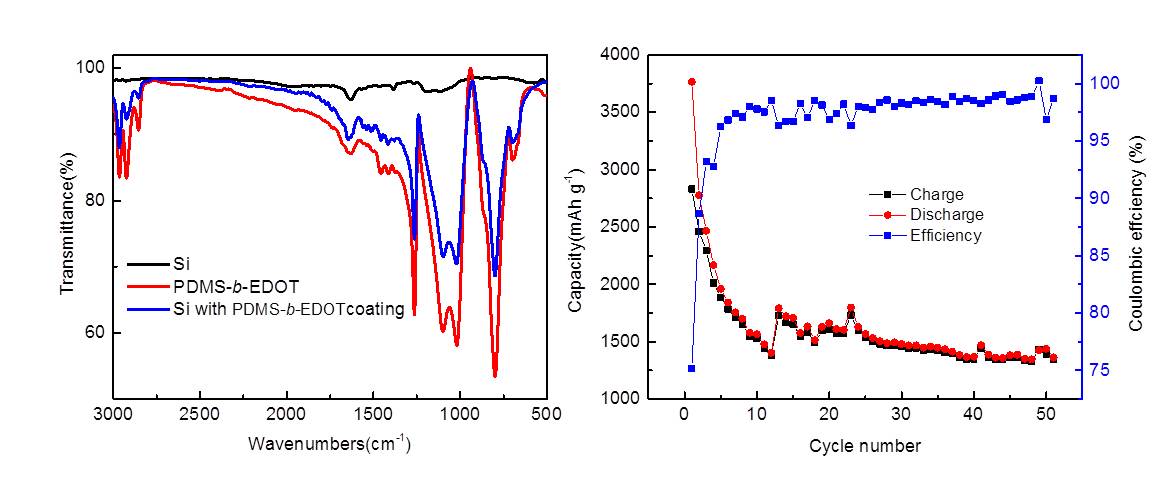
Lithium metal batteries <LMBs> are considered promising energy storage systems because of their high energy density and low redox potential. However, safety issue associated with the dendrite growth hinders their practical applications. One of the effective ways to suppress the dendrite growth and extend the cycle life is addition of the additive in the electrolyte. In this study, a novel low-cost electrolyte additive named as THP-Li salt was synthesized with a handy method for the first time, and introduced into both the solid-state electrolyte and the liquid electrolyte. For the solid-state electrolyte, the impedance value of solid polymer electrolyte <SPE> membrane was decreased apparently, and meanwhile, the all-solid-state LMBs with it delivered the excellent discharge capacity at high current density with good cycling performance <the capacity retention 78.7 % after 200 cycles> and higher coulombic efficiency. For the liquid ester-based and ether-based electrolytes, the addition of it greatly enhanced the overall cell performance of LMBs and particularly resulted in a higher discharge capacity, and remarkable improvement of the capacity retention <the capacity retention 68.4 % after 1000 cycles>. It is found that this novel additive can participate in the formation of stable solid electrolyte interphase <SEI> layer, preventing the side reaction between the electrolyte and electrode, suppressing the Li dendrites growth, which finally improved the safety and stability of LMBs.
A novel configuration by pressing two electrodes containing electrocatalysts for the oxygen reduction and evolution reactions (ORR and OER) into a bi-functional air electrode is designed for rechargeable Zn-air batteries. MOC/25BC carbon paper (MOC consisting of a-MnO2 and XC-72 carbon black) and Fe0.1Ni0.9CO2O4/Ti mesh on this air electrode mainly serve as the cathode of the ORR and the anode of the OER, respectively. Electrochemical studies include linear sweep voltammetry (LSV), rotating ring-disk electrode (RRDE) voltammetry, and the full-cell charge-discharge-cycling test. The discharge peak power density of a Zn-air battery with this unique air electrode reaches 88.8 mW cm-2 at 133.6 mA cm-2 and 0.66 V in the alkaline electrolyte under the ambient condition. After 100 discharge-charge cycles at 10 mA cm-2, an increase in 0.3 V between charge and discharge cell voltages is found. The long-time discharge-charge-cycling curve (10 h in each step) shows that the cell voltages of discharge (1.3 V) and charge (1.97 V) keep constant during the entire process. The performances of this rechargeable Zn-air battery are superior to most reports in recent literature.
Carbons in various forms are also chosen as substrates for uniform dispersion of a-MnO2 to form air electrode catalysts to evaluate the influences of carbon types on the catalytic activities of the ORR and OER (oxygen evolution reaction). The morphology and physicochemical properties of various a-MnO2/carbon composites are characterized by scanning electron microscopy (SEM), transmission electron microscopy (TEM), and X-ray diffraction (XRD). Electrochemical studies include rotating ring-disk electrode (RRDE) voltammetry of catalysts, linear sweep voltammetry (LSV) of air electrodes, and the charge-discharge-cycling test of full cells. The discharge peak power density of Zn-air batteries varies from 66.3 (a-MnO2/carbon nanotubes with diameter ca. 10 nm, denoted as a-MnO2/CNT10) to 40.5 mW cm-2 (a-MnO2/super fine mesophase graphite powder) in 6 M KOH under ambient condition. The rechargeable Zn-air battery with the air electrode containing a-MnO2/CNT10 is stably operated for 100 cycles at 10 mA cm-2, which shows that an increase in 0.09 V between charge (decayed ca. 0.05 V) and discharge (decayed ca. 0.04 V) cell voltages.
For the practical use of Lithium-air batteries (LABs), their cycle performance must be improved. In this system, oxygen supplied from the atmosphere reacts with Li+ and Li2O2 is deposited in the cathode during discharging. To obtain a large capacity and a high rate performance, the cathodes need to have a high surface area and a high electrical conductivity. Therefore, porous carbons are generally used for the cathodes.
To improve cycle performance, side reactions, which involve the decomposition of the electrolyte and result in irreversible capacity, need to be suppressed. It has been reported that oxygen functional groups existing on carbon materials, promote such side reactions. On the other hand, it has been also reported that amorphous Li2O2 tend to be formed on carbon materials having oxygen functional groups more than pristine carbon materials. Such amorphous Li2O2 easily decomposes during subsequent charging, and the charge over potential is relatively low. These facts indicate that there is a suitable amount of oxygen functional groups to increase cycle performance, which has not been clarified.
In this study, the quantitative effect of oxygen functional groups on cycle performance was investigated using carbon gels (CGs) as a model carbon material. CGs have a large mesopore volume which can contribute to the capacity of LABs, and their surface properties can also be tuned. While CGs originally have many oxygen functional groups, they were reduced by heat treatment at various temperatures. Then, the oxygen functional groups were quantitatively evaluated by temperature programed desorption analysis (TPD) performed under vacuum. The results obtained using CGs heated at 2200 °C showed that most of the functional groups were removed at this temperature and the resulting carbon can maintain a discharge capacity of 500 mAh g-1 for 21 cycles, while CGs heated at 1000 °C could maintain this capacity only for 8 cycles.
Lithium-air batteries are expected to become a secondary battery of the next generation owing to their high theoretical energy density. Carbon paper combined with a porous carbon are generally used as the cathode in this system because the surface area of a typical carbon paper is too low to be used independently. In contrast, carbon nanofibers (CNFs) with a fiber diameter of several tens of nanometers have a sufficient surface area for this purpose. In this study, sheet electrodes were developed using CNFs produced through the liquid pulse injection (LPI) technique. The CNFs can be efficiently synthesized and easily casted into a sheet electrode only by vacuum filtration. Cathode performance of the sheet electrodes for lithium-air batteries was evaluated and optimal conditions to obtain higher capacities were explored.
LPI-CNFs with a diameter around 20 nm were dispersed into ethylene glycol. The resulting dispersion was filtered under vacuum to form a sheet. Coin cells of 2032-type were assembled using the sheet and a solution of CF3SO4Li in tetraglyme (1:4, molar ratio) as the cathode and electrolyte, respectively, and the cells were galvanostatically discharged and charged in an oxygen atmosphere.
The LPI-CNF sheets had a mechanical strength similar to that of a commercial carbon paper and much higher surface area than that of them, suggesting that the LPI-CNF sheets can be used independently as cathodes.
From results of discharge/charge measurements, the LPI-CNF sheets showed about a 3 times larger discharge capacity than that of an electrode prepared from a carbon paper and porous carbon.
It has been reported that usable depth of electrodes is limited because of the influence of oxygen diffusion. Thus, the structure of the LPI-CNF cathodes such as porosity and thickness were optimized to increase discharge capacity.
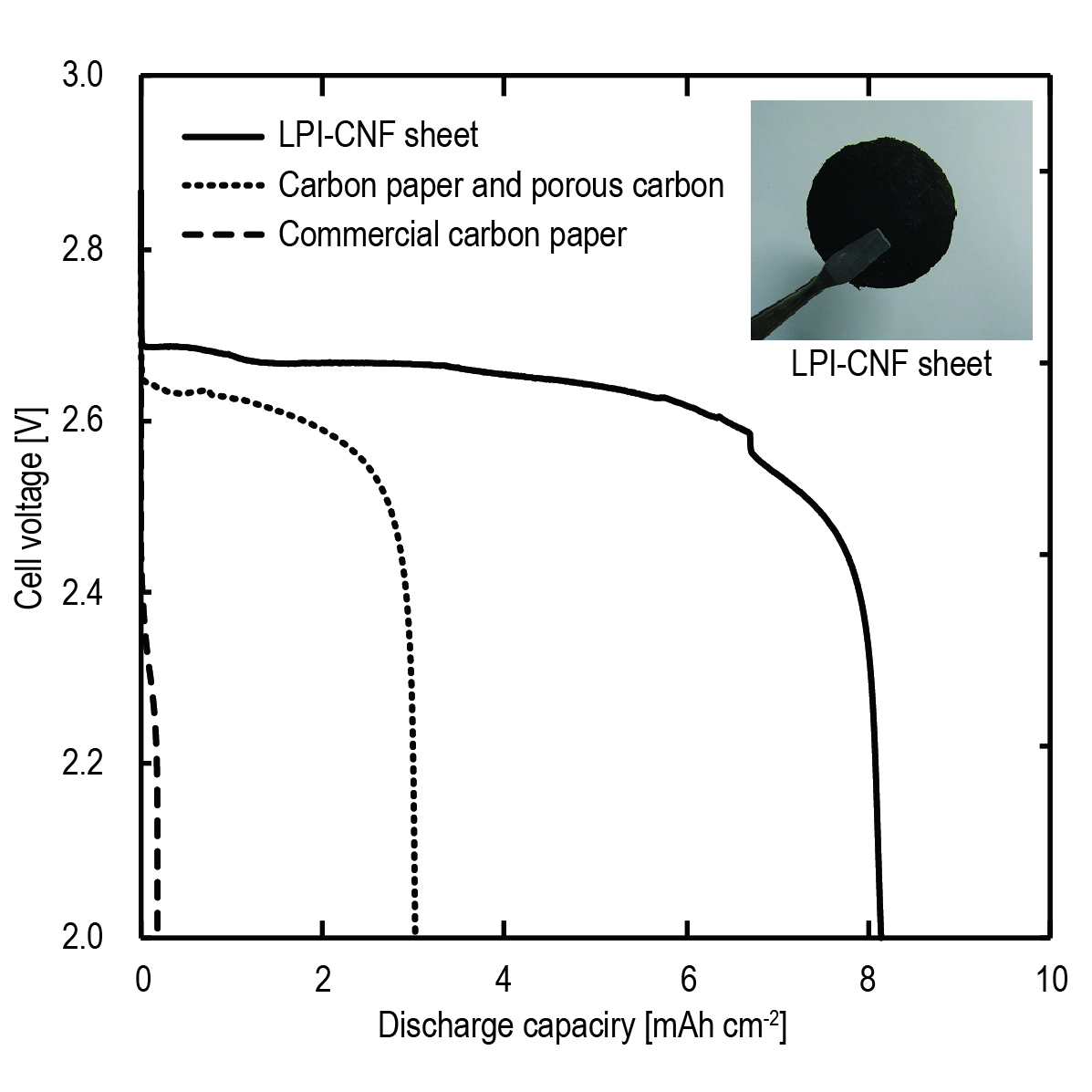
Lithium ion storage devices are indispensable for modern society because of their high energy densities, low self-discharge, no memory effects, and applications in many high-tech industries such as electronic devices, military, and battery powered vehicles. However, most commercial lithium ion storage devices use carbon electrodes, which have low theoretical capacity (≈ 372 mAh g-1) and are not expected to meet the future needs of the energy storage industry. Consequently, silicon, possessing high theoretical capacity (≈ 4200 mAh g-1), being abundant in nature, and exhibiting low discharge potentials, has become a promising anode material. Despite these advantages, the use of Si anode is hindered by its low electrical conductivity and large volume changes during the lithiation/de-lithiation cycles leading to subsequent pulverization. Herein we designed a porous composite nanostructure of silicon with N-doped carbon (NDC) from mesoporous silica sphere and dopamine, which can offer space to accommodate the volume changes and improve the electrical conductivity of the electrode for performance enhancements. Indeed, the as-synthesized Si/NDC composite delivered a high capacity of 2,518 mAh g-1 at a current density of 200 mA g-1 and maintained a high capacity of 980 mAh g-1 at a high current density of 5,000 mA g-1.
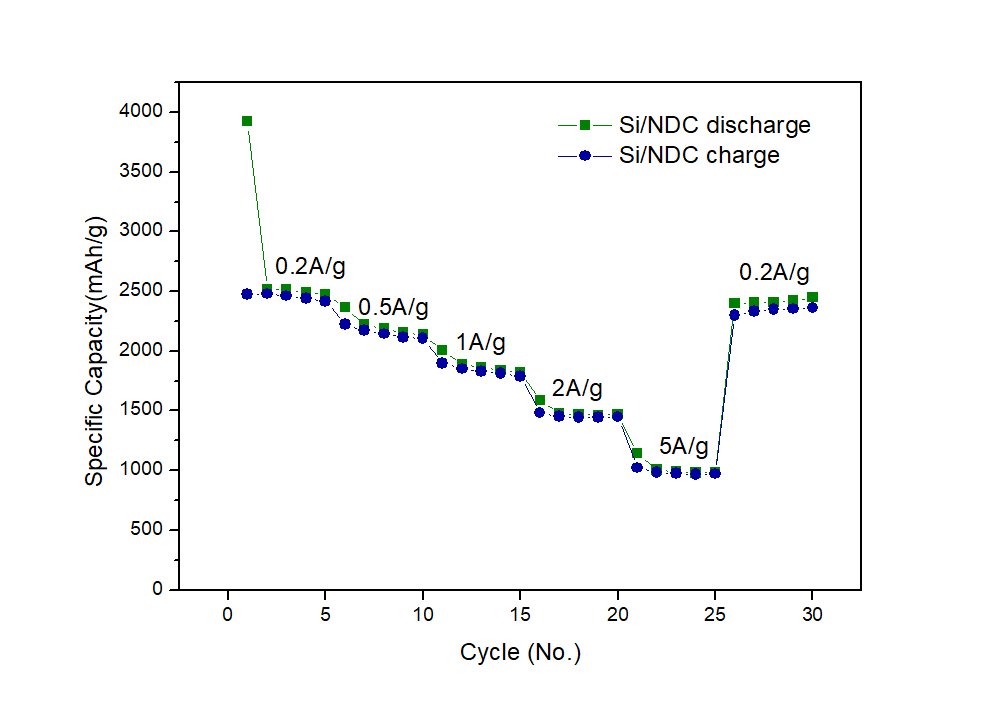
Side reactions on high-voltage cathode for lithium ion batteries would be influenced by physicochemical properties of carbon black (CB) conductor used in it. We have prepared various CB conductors with different surface characteristics and crystallinity, and have applied them to a 5V cathode, LiNi0.5Mn1.5O4 (LNMO) as conductors. By electrochemical evaluation some samples were found to be suitable for the 5V cathode. The reaction mechanism would be reported.
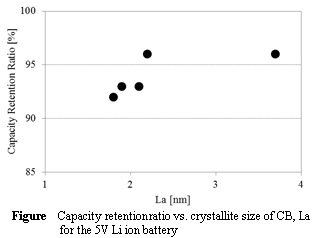
At the present time, ternary cathode materials, NCM, have attracted many researchers to study due to their excellent electrochemical properties, such as high specific capacity and high charge-discharge voltage. By tuning the portions of nickel, cobalt and manganese, NCM can obtain different electrode characteristic. However, their poor stability when worked at high operating voltage have limited their applications in industry. In this study, polyimide (PI) was covered on the surface of NCM523 cathode material by a simple liquid phase modification. At first, 2,2-Bis(3-amino-4- hydroxyphenyl)hexafluoropropane (BisAPAF) and 2,3,3,4-oxydiphthalic anhydride (ODPA) were mixed in the solvent, N-Methyl-2-Pyrrolidone (NMP), at room temperature to synthesize the polyamic acid (PAA). Then, a desired amount of NCM523 powder were added and dispersed in PAA solution by stirring for 4h to obtain NCM523/PAA material. Finally, the NCM523/PAA material was converted into NCM523/PI by multistep heating process. XRD analysis showed that the addition of PI did not affect the original layered structure of NCM523 cathode material. The energy dispersive spectroscopy (EDS) analysis showed that polyimide could be evenly distributed on the surface of NCM523 particles. TGA analysis also confirmed a slight weight percentage of PI was added to the NCM523 material. The effect of PI addition on the electrochemical properties of NCM523 cathode material is still under investigation, and it is hoped that the present polyimide (PI) coating can effectively prevent the undesired interfacial reaction between the electrode material and the liquid electrolyte.
All-solid state batteries (ASSBs) are expected as next-generation battery for electric vehicles (EVs), hybrid electric vehicles (HEVs) because it is safer than usual liquid-type Lithium-ion battery. Recently, the innovative solid electrolyte have been developed, and it is comparable to organic liquid electrolyte in ionic conductivity. However, it is desired to attain more power density and more energy density. In order to improve the performance of ASSBs, it is required to optimize an electrode structure as well as material characteristics such as active materials and electrolytes. Therefore, monitoring the state in electrode layer during charge and discharge using the numerical computation is a critical measure to understand the phenomena in a cell. In the relatively micro-scale system such as the electrode layer, even a slight difference in structure remarkably affects the battery performance. However, usual simulations employ the empirical overall characteristics such as the reactive interface area and the tortuosity factor, so the phenomena resulting from minute structure of electrode layer which notably affect the cell performance might be overlooked. Hence, in this study, the numerical computation technique that can reflect the micro-characteristics of electrode structure directly by building a multi-element network model based on porous structures was developed. And the effect of heterogeneous electrode structure on cell performance was considered.
In this study, 0.5 M nickel hydroxide, cobalt nitrate, and manganese nitrate were used as the metal sources with molar ratio of Ni:Co:Mn=1:1:1 and sodium hydroxide as the precipitant to prepare the NCM(OH)2 precursor by co-precipitation for application in the synthesis of NCM ternary cathode materials. The volume flow ratio of metal nitrate and NaOH was 1:2 and the pH value of the precipitation reaction was controlled at 10-12. After the reactants were mixed, the mixture was stirred at 50 °C for 12 h under nitrogen atmosphere. It was found that the color of the precipitate gradually changed from grey to brown in the experiment. It was speculated that the color change was resulted from the formation of manganese oxide-hydroxide. It was known that the manganese hydroxide could be reacted easily with trace oxygen even in a nitrogen atmosphere. SEM images showed that the precursor powder obtained by the preparation was irregular granular and had the obvious aggregation phenomenon. Besides, the XRD analysis showed that the precursor powder of the ternary positive electrode material was successfully prepared in this study and the precursor was composed of nickel cobalt manganese-hydroxide NCM(OH)2 and nickel cobalt manganese-oxygen-hydroxide NCMO(OH)2.
Vanadium redox flow batteries (VRFB), which use vanadium species as the active materials, have advantages such as the flexible design between power and capacity. Thus, VRFB is expected to store renewable energy. However, the current density of a single cell is small due to the higher internal resistance such as reaction resistances. Therefore, researches have been conducted to reduce the reaction resistance by addition of surface oxygen functional groups by heat treatment in air or liquid phase oxidation to the carbon electrode material. However, the conventional treatment methods have issues such as longer treatment time and necessity of waste liquid treatment. In consequence, in this research, we focused on electron beam irradiation as the effective oxidation method. It is considered that the surface oxygen groups can be added by the reaction between surface carbon and radicals and/or ozone from the water or the oxygen formed by the irradiation. This processing method can be performed in a short time of 60 minutes or less at room temperature.
In this study, Electron beam irradiation was performed on the carbon cloth, then, characterization and electrochemical measurement were performed. Two-sheet of Carbon cloth (CC) was used as the electrode material. The electron beam with acceleration voltage of 2.0 MV was irradiated to the CC under air atmosphere at Takasaki Advanced Radiation Research Institute. To evaluate the cell performance, current-voltage curves were obtained using a single cell with interdigitated flow channel. The current density of the irradiated electrode under air was improved compared with the non-irradiated electrode. X-ray photoelectron spectroscopy (XPS) measurements were performed to analyze surface oxygen groups. As a result, the surface oxygen, i.e., C-O, COO, etc., of electrode material increased by electron beam irradiation within 60 minutes.
Supercapacitors are one of the most promising energy storage devices because of their long cycle life, high power densities, and high discharge efficiencies. The power and energy densities of supercapacitors depend critically on the electrode materials. In recent years, metal-organic frameworks (MOF) have attracted much research attention as electrode materials for supercapacitors, because of their unique properties such as high porosities, large surface areas, and tunable morphologies, which are beneficial to the capacitive performances of supercapacitors. In this work, we synthesized Mn-based and Mn-Fe based MOFs via a simple solvothermal method, using 1,4-benzenedicarboxylate as the organic linker. The incorporation of Fe into the Mn-based MOF significantly enhanced the capacitive performances. The specific capacitances of Mn-based MOF and Mn-Fe based MOF were 21 and 75 F/g, respectively in 2M KOH at a scan rate of 5 mV/s. The enhancement is attributable to the synergistic effect between Mn and Fe.
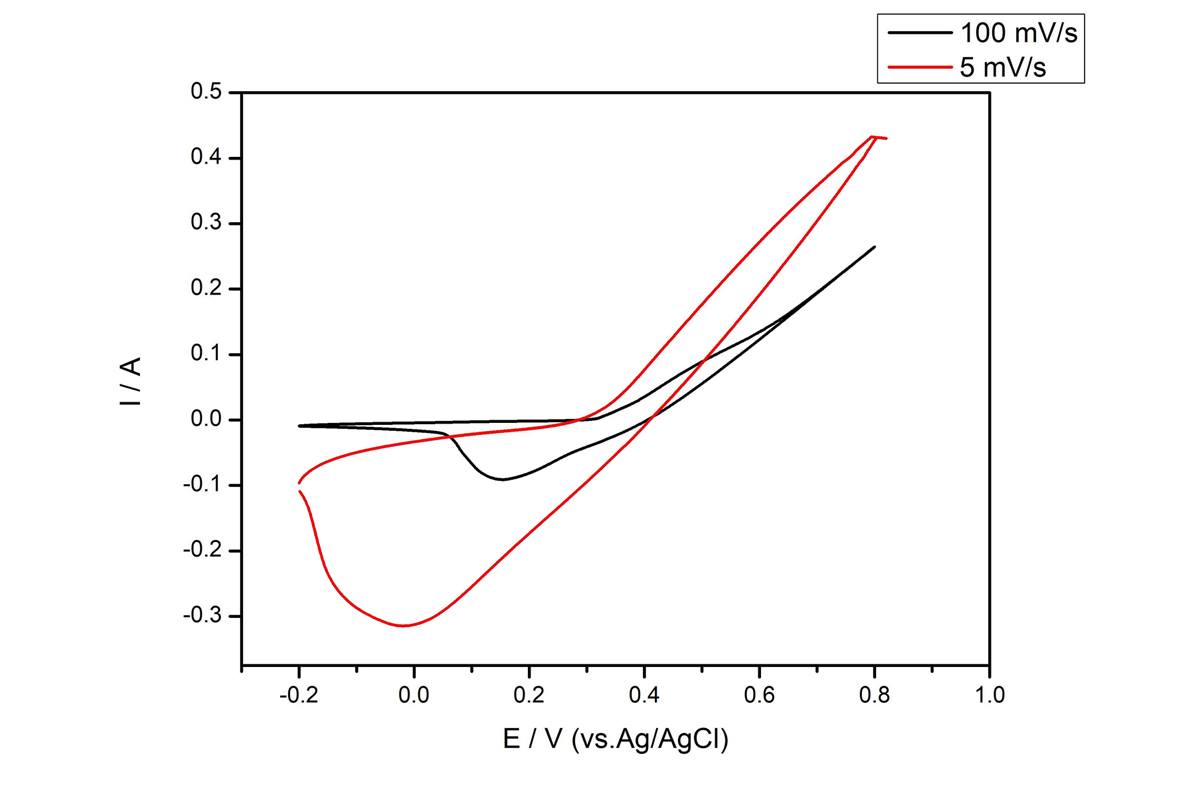
Recently, Microwave is an efficient, green and selective heating method, it has been employed to reduce graphene oxide (GO) in solvent or under dry condition. Firstly, we used modifification of Hummers method to fabricate graphene oxide (GO), then graphene oxide (GO)/Titanium oxide (TiO2) nanocomposites were synthesized with different wt/wt % of GO/TiO2 (1:1; 1:2; 1:3; 1:4 and 1:5), finally the nanocomposites were reduced by microwave method. To assess the properties of materials for use in supercapacitors, cyclic voltammetry and galvanostatic charging–discharging measurements were performed. And the results show that the microwave method synthesis of reduced graphene oxide (GO)/Titanium oxide composites with wt/wt % of GO/TiO2 (1:4) has the highest specific capacitance of 454 F/g at a scan rate of 10 mV/s. What's more, as shown in Figure 1, it has a high energy density of E = 24.2 Wh/kg and high power density of P = 500.1 kW/kg. As a result, graphene-based material obtained by MW-assisted reduction has a porous and loose structure and relatively high special surface area, making it perfectly suitable for supercapacitor devices.
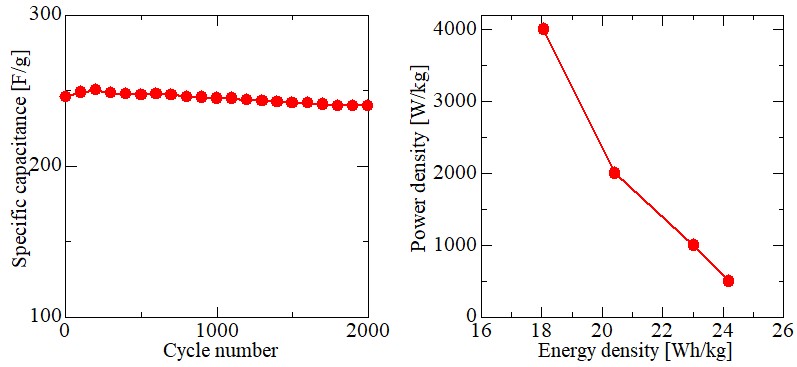
For widespread use of renewable energy, effective utilization of excess energy from the renewable energy is a key issue. Electrolysis of hydrogen carrier, especially ammonia, is a possible solution because ammonia possesses some advantages including stable chemical property, high hydrogen density, easier storage and non-explosion. Unfortunately, during electrochemical reaction of ammonia synthesis with metal catalysts, hydrogen evolution reaction also occurs, and thus the faraday efficiency of ammonia electrosynthesis becomes low. In this study, the effect of addition of tungsten into iron on improving electrochemical reaction of ammonia synthesis and suppressing hydrogen evolution reaction were investigated using 90%N2-10%H2, W-Fe-BaCe0.9Y0.1O3 (BCY)|BCY|Pt, 3%H2O-77%Ar-20%H2. W-Fe-BCY catalyst cathode was fabricated by the incipient wetness co-impregnation method. After addition of W into Fe catalyst, the current density decreased because of larger energy of tungsten hydride formation which suppresses hydrogen evolution reaction. Impedance spectroscopic analysis also suggested the same result of suppression of hydrogen evolution reaction. Furthermore, the ammonia formation rate became higher at lower operating temperatures than those of pure Fe catalyst. This was probably caused by lower coverage of hydrogen adatoms on W-Fe catalyst surface and retaining active sites for N2 dissociation. In addition, with an increase in ammonia formation rate and a decrease in current density, the faraday efficiency also increased by around two times with the addition of W into Fe catalyst.
Recently, Global warming has become a serious problem. Therefore, Japan is aiming at a hydrogen society and conducting demonstration experiments of hydrogen supply chains in various places. Fuel cells are the most popular source of hydrogen energy. However, the load followability of fuel cells has not been studied. In this study, we will construct a power generator using the SOFC single cell which is the highest temperature operation and the highest efficiency among fuel cells, and investigate the load following ability. Currently, it is desirable to make SOFC operable at low temperatures. Therefore, in this experiment, the operating temperature is 700 degrees, and the flow rate of each gas is 200 mL/min. First, the I-V characteristic of a single cell is measured in order to investigate whether it is a suitable experimental device. From the experiment, the power per unit area at peak was 0.1 W/cm2. Since this power value is equal to the nominal value, it can be said that an appropriate experimental device has been produced. Next, based on this value, a variable load is created using the programmable load function of the DC electronic load. The loading rate is repeated at 20% and 100% every 10 seconds from 40 seconds to 80 seconds. The single cell output when the created variable load is input to the single cell is shown in the figure. From the figure, it can be seen that in any case, tracking follows less than 0.6 seconds. From the experimental results described above, it is found that the SOFC single cell has high load followability. In the future, CO2 is expected to be reduced by replacing the thermal power generator with a SOFC generator for the peak load power supply.
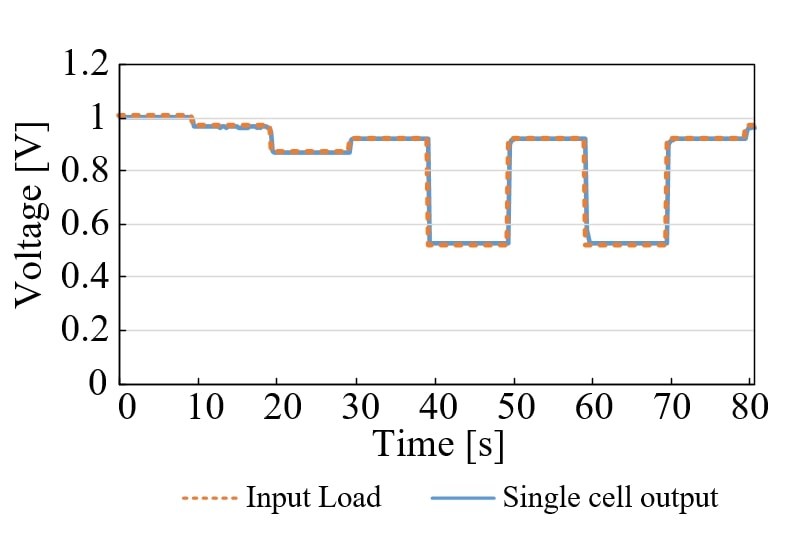
Anode materials based on transition metal phosphides were investigated for intermediate temperature fuel cells (ITFCs). Metal phosphides are world-widely investigated as highly-active and selective catalysts for hydrodesulfurization, hydrodenitrogenation, and hydrodeoxygenation. These reactions require catalytic ability for dissociation of H-H bond as well as C-S, C-N, or C-O bond. In addition to the catalytic activity, metal phosphides are known to be thermally and chemically stable and to possess electric conductivity comparable to metals and hardness similar to ceramics. Because of these features, metal phosphides are expected to function as electrodes in electrochemical cells. We have reported that molybdenum phosphide and tungsten phosphide as the anode of ITFCs demonstrated high power generation characteristics per electrochemical surface area. Accordingly, this study aimed to increase electrochemical surface area by supporting metal phosphides on carbon materials. Also, to increase the porosity of the anodes for ITFCs, carbon black (CB) and carbon nanofiber (CNF) were mixed with commercial platinum carbon (Pt/C) catalysts. Power generation and cyclic voltammetry were conducted to evaluate the catalysts' electrochemical activities. From the results of power generation and CV, molybdenum phosphide loaded on CB shows higher power generation characteristics per electrochemical surface area than Pt/C. It is suggested that phosphides loaded on carbon were well dispersed and many active sites were produced. Power generation measurements revealed that Pt/C and CB with the weight ratio 1: 1 and Pt/C and CNF with the weight ratio 1: 1 exhibited good cell performances. It indicates that increased porosity in the electrode gave rise to large triple-phase boundary.
In the proton exchange membrane fuel cell, the durability is recently the critical issue in its operation. As the Ce+3 cerium ion (Ce) is a potential scavenger for ·OH and ·OOH radicals, the main causes of the chemical degradation of the membrane, aminomethyl-15-crown-5-ether (CRE) and dual sulfonated 3,3-diphenylpropylamine (DSDPA) were grafted onto the poly(arylene ether ketone) (PAEK) to maintain high proton conductivity and chemical stability by alleviating the migration of Ce from the membrane. The chemical and physical structures of the synthesized CRE grafted dual sulfonated PAEK membrane (DSPAEK-CRE) along with the coordination complex of CRE and Ce ions were investigated using FT-IR, 1H-NMR and SAXs, and XPS spectroscopy. The Fenton's test showed huge improvement of anti-oxidation stability by the presence of CRE. While the CRE/Ce coordinated membrane showed higher proton conductivity and better chemical stability than the Ce+3 dispersed one, other properties such as water uptake, swelling ratio, and mechanical strength were not significantly affected by CRE.
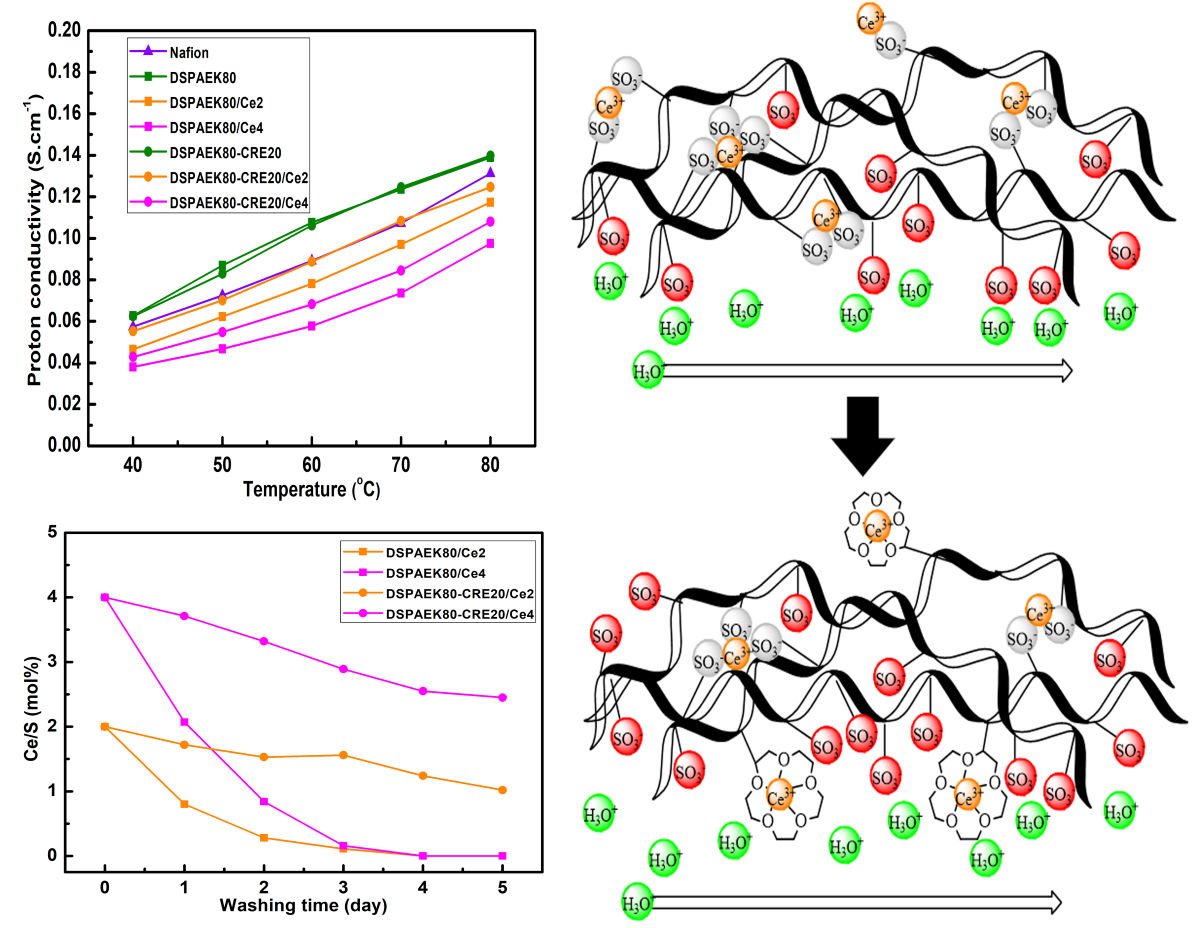
Recently, solid-state alkaline fuel cells (SAFCs) with anion-exchange membranes (AEMs) have attracted considerable attention as next generation fuel cells, because they can use non-noble catalysts and various fuels. The SAFCs show complex water behaviors; water is generated at the anode and is reacted at the cathode. Hence, SAFCs using gas as the fuel show low cell performance due to anode flooding and membrane drying. Although control of water behavior is crucial to improve cell performance, there are many parameters to be considered such as AEM properties and operating conditions. In such situation, modeling approach is effective because of less time-consuming, inexpensive, and more versatile than experimental approaches.
In this study, we make a mass balance model for SAFCs considering water transport in AEM and clarify guidelines to suppress anode flooding and membrane drying. Pore-filling anion conducting membrane[1] is used as AEM, and parameters needed for the calculation such as ion conductivity and water content of AEM were experimentally obtained. To make the AEM model, two mass balances of whole cell and AEM are considered. Then, outlet RHs and membrane IR loss were calculated by solving the two mass balances simultaneously under specific operating conditions and AEM thickness.
Fig. 1(a) and 1(b) show current density dependence of calculated outlet anode RHs and membrane IR losses with different AEM thickness, respectively. With thinner AEM, an increase in current density was obtained at 100% RH, which indicate the flooding is suppressed. Further, the suppression of membrane drying in the thinner AEM was confirmed by the low membrane IR loss. These results show that thinner AEM is effective for suppressing both anode flooding and membrane drying.
[1]Y. Oshiba et al., Journal of Power Sources , 345, 221-226 (2017)
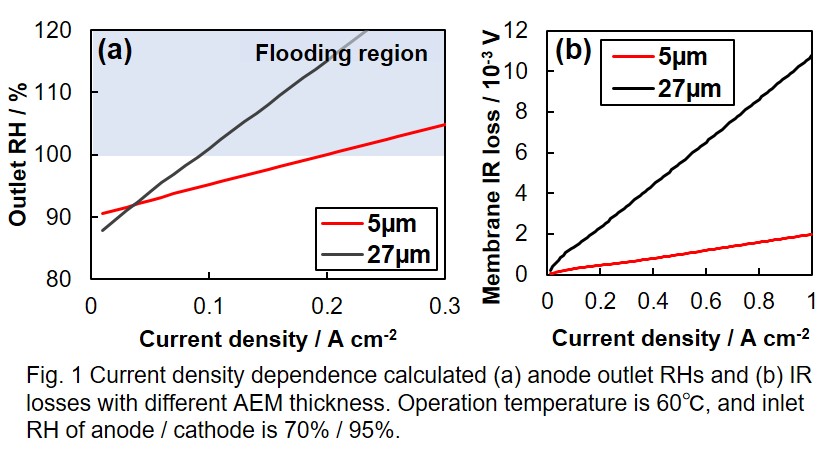
Direct methanol fuel cell (DMFC) has attracted attention as an alternative power source because of high energy density of liquid methanol. One of the main issues for DMFC is the sluggish kinetics of methanol oxidation reaction (MOR) at the anode. Therefore, we focused on developing a highly active anode catalyst by using reduced graphene oxide (RGO) having a high specific surface-area and a high electric conductivity as a catalyst support. Although many studies using RGO have been conducted so far, the effect of the particle size of RGO on the catalytic activity has not been sufficiently investigated. In this study, the catalyst was prepared using RGO with different average particle size, i.e., 5 μm (RGOL) and 0.5 μm (RGOS) and the effect of particle size of RGO on the catalytic activity was investigated.
PtRu catalyst supported on RGOL or RGOS was prepared from a GO slurry by using a high-power ultrasonic crusher followed by adding polydopamine (PDA) as a dispersant and PtRu deposition by a chemical reduction method using NaBH4.
For the prepared catalysts, PtRu/RGOL and PtRu/RGOS, characterization was carried out using TEM, FE-SEM, XRD and EDX. Catalytic activity of the catalyst was evaluated by cyclic voltammetry in an aqueous solution with 0.5 M CH3OH and 0.5 M H2SO4. Electrochemical surface area (ECSA) for the catalyst was also evaluated by CO stripping method.
PtRu/RGOS showed about 1.6 times higher ECSA and about 2.1 times higher MOR mass activity compared to that of PtRu/RGOL. The higher performance of PtRu/RGOS was attributed to the superior structure of the catalyst layer for facilitated mass transfer and ease of fuel access. This result suggested that RGO with the small particle size is proper for the support of PtRu nanoparticles to increase the MOR activity of PtRu/RGO in DMFC.
The efficient conversion of energy is one of the urgent problems because of the sharp increase in current energy consumption. To meet the electricity demand, the development of fuel cells (FCs) have attracted great interest by their sustainable, renewable, efficient and eco-friendly electrochemical conversion of energy. For widespread commercialization of FCs, the main challenge is to reduce the cost of catalysts although expensive platinum-based catalysts have been applied. However, it is still challenging to develop an inexpensive and effective alternative catalyst, due to its sluggish reaction towards the oxygen reduction reaction (ORR).
As the alternative catalysts, transition metal and heteroatoms co-doped carbon material have been attracted by their low-cost and high performance. In particular, the carbon materials containing the bonding of cobalt and nitrogen (CoNx) acted as high-performance catalysts for ORR. However, the fine design of CoNx is difficult, due to the aggregation of metal. Herein, we present a new synthesis method of graphene (G) with highly-dispersed CoNx species as an excellent electrocatalysts, by using sequential treatments of mixing with sulfuric acid, Co2+ ion-exchanging and 2-methylimidazole coordination. And we also report its excellent electrocatalytic performance.
The highly dispersed cobalt species was observed on the graphene by TEM images and STEM images. The results of ORR measurements were shown in Table 1. The samples after the treatment of Co2+ ion-exchanging and 2-methylimidazole coordination were carbonized under N2 atmosphere and denoted as Co/GS and Co-N/GS, respectively. Obviously, G and Co/GS performed sluggish ORR, while Co-N/GS showed both excellent onset potential and limiting current density. In particular, the limiting current density is comparable to commercial platinum catalysts (Pt/C). Moreover, Co-N/GS exhibits a high current density, and the number of electrons (n) in the ORR are also higher than other samples.
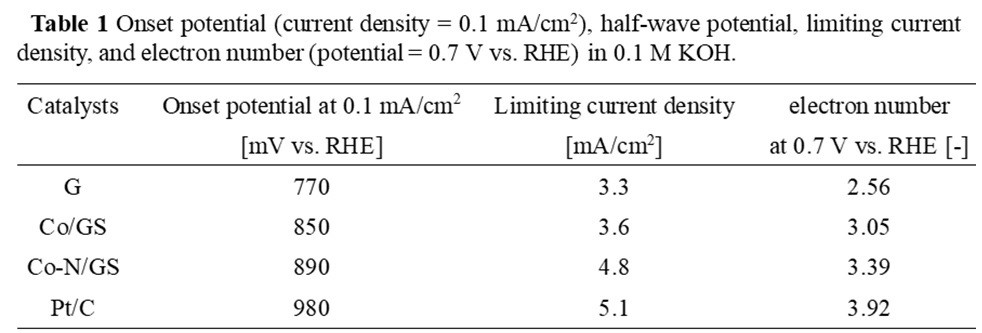
Polymer electrolyte fuel cell (PEFC) is beginning to be put into practical use as residential and transportation power generation system. However, the cost of PEFC is still high, since expensive platinum (Pt) is used as the catalyst. Therefore, development of non-Pt catalyst is required. We have been studying silk-derived activated carbon (SAC) as non-Pt catalyst, which is inexpensive but fairly active compared to the conventional Pt catalyst. The structure of the electrodes fabricated from such catalyst should be designed with a different concept. In this study, we investigated the effect of catalyst layer thickness on the performance of PEFC using non-Pt catalyst.
Membrane electrode assembly (MEA) was prepared using SAC as cathode catalyst. Catalyst layers with different thicknesses were fabricated on a carbon paper and was hot pressed to a Nafion membrane. Terminal voltage vs. current density and electrochemical impedance spectra of each MEA were measured at 80 °C.
The iR-free polarization curves of each MEA were deconvoluted by fitting the activation overpotential. As the amount of catalyst was increased, the activation overpotential decreased and the remaining overpotential increased. It was assumed that this residual overpotential was not concentration overpotential, since the shape of the curve was not convex downward. The applied voltage dependence of the impedance spectrum was observed. As the applied voltage was increased, the interfacial resistance initially decreased and then became constant. Interfacial resistance independent of the applied voltage was assumed to be related to the proton conduction in the catalyst layer. The interfacial resistance related to the proton conduction in the catalyst layer increased as the amount of catalyst increased. Therefore, it is considered that the increase of the residual overpotential was due to the increase of the proton conduction resistance in the catalyst layer.
Graphene oxide (GO) membrane is expected to be an alternative electrolyte membrane having high proton-conductivity and less fuel-crossover for a fuel cell application. However, the proton-conductivity of GO membrane is still not enough. In this study, effect of an additional oxidation of GO and an addition of sulfonic acid group to GO on the proton conductivity were investigated.
A commercial GO slurry with 1.0 wt% GO was subsequently treated with NaNO3, KMNO4 and H2O2 to obtain the additionally oxidized GO (GOh). By adding vinyl sulfonic acid (VS) to the GO and GOh slurries, VS treated GO (GOVS) and VS treated GOh (GOhVS) membranes were prepared after filtering and drying. Membrane electrode assembly (MEA) was fabricated by sandwiching the membrane by carbon papers with Pt/C catalyst on both sides. Current-voltage performance of the MEA as a H2-O2 fuel cell was evaluated, and the proton conductivity of the membrane was calculated from the ohmic resistance assuming that the cell resistance was governed by that of the membrane.
The proton conductivity of the membrane was higher in the order of GOhVS > GOVS > GOh > GO and found that each of the additional oxidation of GO and the VS treatment increased the proton conductivity as shown in Table 1. GOhVS membrane of which GO was additionally oxidized and also treated with VS showed the highest conductivity with 118 mW cm-2 fuel cell power-density. It was more than one order of magnitude higher than that of GO. It was found that the additional oxidation tof GO and the VS treatment are effective in improving the conductivity of GO membrane.
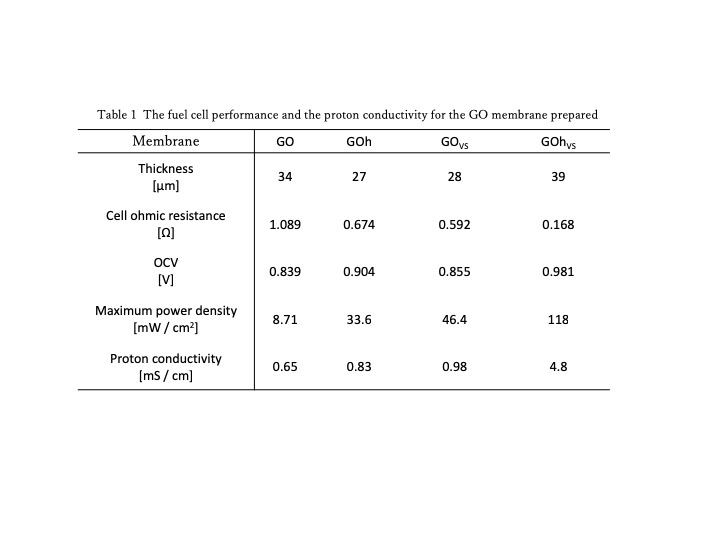
Polymer electrolyte water electrolysis (PEWE) is a key technology for the production of hydrogen in the power-to-gas process. As polymer electrolyte membranes for PEWE, perfluorosulfonic acid (PFSA) polymer membranes such as Nafion® are commonly used. In PEWE, although the produced hydrogen needs to be stored in pressurized gas tanks for transportation, the cell performance drops by high hydrogen crossover under the pressured condition. On the other hand, hydrocarbon-based polymer membranes including poly (arylene ether sulfone) (SPES) are expected to have a lower gas permeation property than the PFSA polymer membranes. However, the swelling of these hydrocarbon membranes is higher than the PFSA polymer membranes, which is a severe problem in fully humidified operating conditions of PEWE. The membrane with reduced swelling could be fabricated by a pore-filling technique, where the polymer electrolyte is filled inside pores of the porous substrate [1].
In our study, we prepared a pore-filling polymer electrolyte membrane using SPES for PEWE (Fig. 1A). This pore-filling membrane was prepared by drop casting 3 wt% SPES (IEC: 2.1 meq/g) solution over a 24 μm polyethylene porous substrate at 80 °C. The properties of the SPES pore-filling membrane was compared with that of SPES cast membrane and commercial Nafion 211.
The hydrogen permeability coefficient of the SPES cast membrane was found lower than Nafion 211, and that of the SPES pore-filling membrane is comparable with that of the SPES cast membrane (Fig. 1B). Moreover, the pore-filling membrane showed a lower swelling ratio between dry and wet conditions compared to the cast membrane (Fig. 1C). The results indicate that the SPES pore-filling membrane has both reduced hydrogen permeation and lowered swelling properties, which is suitable for PEWE applications.
[1] Nishimura, H. and T. Yamaguchi, Electrochemical and solid-state letters, 2004. 7(11): p. A385-A388.
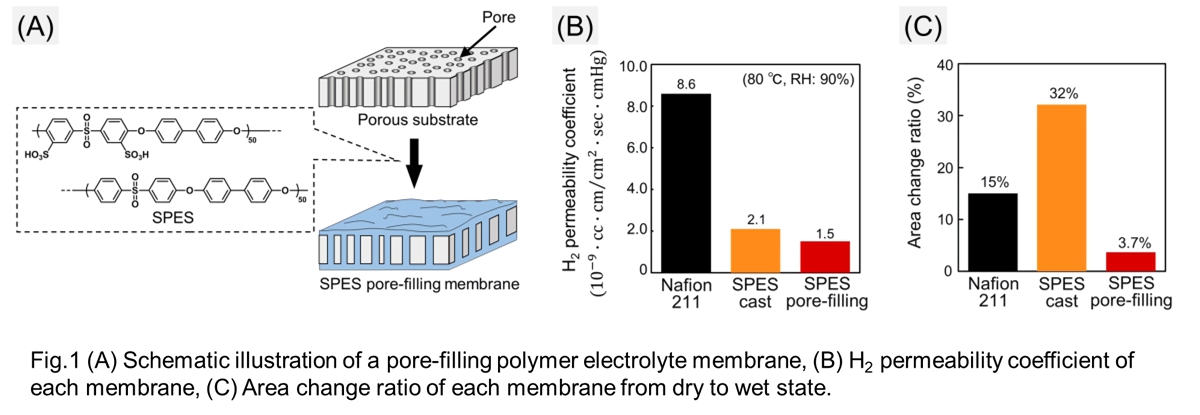
Fuel cells combined with carbon-free hydrogen productions, such as water electrolysis, are the most promising energy strategy to mitigate the global warming and climate changes. Since the reactions for fuel cells (oxygen reduction reaction, ORR and hydrogen oxidation reaction, HOR) and water electrolysis (oxygen evolution reaction, OER and hydrogen evolution reaction, HER) are heterogeneous electrochemical reactions, they require catalysts to reduce the activation barriers during the electrochemical reactions. In addition, since the ordinary catalysts used in the systems are noble metal such as Pt, Ru, Ir, etc., development of cheap catalysts is another key issue in the fields. In this presentation, alloys of both noble and transition metals are fabricated by electrodeposition method. The composition and shape of the catalysts were controlled through the modification of the electrolyte composition and the deposition potential. For the ORR of fuel cells, PtM alloys were electrodeposited and their ORR characteristics through the modification of the electronic structures were studied. In the case of hydrogen-involving reactions such as HOR and HER, the relatively fast kinetics enables the possible use of cheap Ni-based alloys as the catalysts materials. Addition of small amounts of noble metals to Ni or control of the electrochemical surface area as well as the crystalline structures enhance the reaction kinetics close to those by Pt-based materials. A variety of combinations of Ni-based alloys was fabricated by electrodeposition and their characteristics on HOR and HER were investigated.
Energy issue has become a considerable topic because of the rapid population growth and industrialization of the world. To reduce carbon emission and environmental pollution from burning fossil fuels, the development of alternative energies is urgent and essential nowadays. Hydrogen has been regarded as one of the most promising energy carriers because of its high gravimetric energy density and clean byproduct, water, when in use as an energy source. Electrolytic water splitting driven by renewable energies such solar and wind energies is considered a most promising environmentally friendly hydrogen production technology, which splits water into hydrogen and oxygen without hazardous byproducts. The development of high-efficiency and noble-metal-free electrocatalysts is the most crucial and challenging part of electrolytic water splitting. In this study, we successfully grown Ni-Fe based bi-metallic metal-organic frameworks (MOF) on nickel foam, denoted as (Ni, Fe)(BDC-NH2)(DMF,F)/NF, for both oxygen evolution reaction (OER) and hydrogen evolution reaction (HER) involved in alkaline electrolytic water splitting. The as prepared MOF loaded nickel foam exhibited outstanding electrolytic activities, achieving overpotentials of 286 and 348 mV for the OER and 250 and 353 mV for the HER at current densities of 50 and 500 mA cm-2, respectively in 1.0 M KOH, showing substantial activity enhancements as compared to pristine nickel foam. The OER efficiency enhancement may be attributed to the synergistic effects between Ni and Fe and the presence of fluoride, which is a strong electron withdrawing ion. As for the HER, the presence of the electron donating group, –NH2, in the organic linker is beneficial to the reduction power of the catalyst.
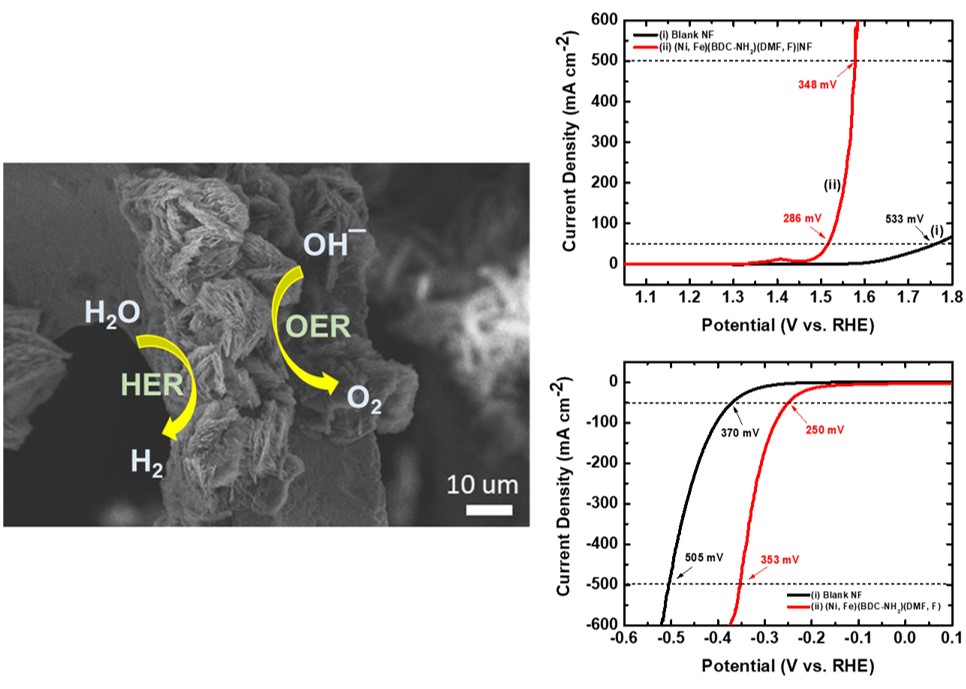
Efficient use of renewable energy resources is crucial to meet our future energy demand. Alkaline water splitting can produce hydrogen using electricity generated from intermittent natural energies, such as solar and wind. The oxygen evolution reaction (OER) is often considered as the bottleneck in water splitting because the OER still has large overpotential. RuO2 and IrO2 have high activities for OER, but these catalysts based on precious metals are very costly. In addition, high operating potential in OER region triggers corrosion of carbon supports of catalysts, leading their low durability.
Perovskite oxides with nonprecious metals have been recently attracting much interest because they are inexpensive and show high electrocatalytic activity. For electrochemical reaction, conductive supports need to be combined since most perovskite oxides have insufficient electrical conductivity. However, carbon supports are not suitable due to carbon corrosion.
Herein, we develop a composite electrocatalyst composed of perovskite oxide as catalyst and conductive metal oxide as support as shown in Fig. 1(a), and we have chosen LaCoO3 and SnO2, respectively. LaCoO3 is a model perovskite compound, which is well-known as OER catalyst. SnO2 is electrical conductive oxide and possesses high thermal stability and alkaline stability, suggesting that SnO2 can be stable during the synthesis of LaCoO3 and measurements in alkaline solution. Fig. 1(b) shows OER activities of LaCoO3, LaCoO3/SnO2 and physically-mixed LaCoO3+SnO2 and demonstrates that LaCoO3/SnO2 exhibited higher current than others. It implies a good interfacial contact in LaCoO3/SnO2. Moreover, Fig. 1(c) proves higher durability of LaCoO3/SnO2 than that of LaCoO3/CNT which employed carbon as support. These findings indicated that the composite electrocatalyst based on perovskite and conductive metal oxide support is a promising platform for development of highly durable OER catalysts.
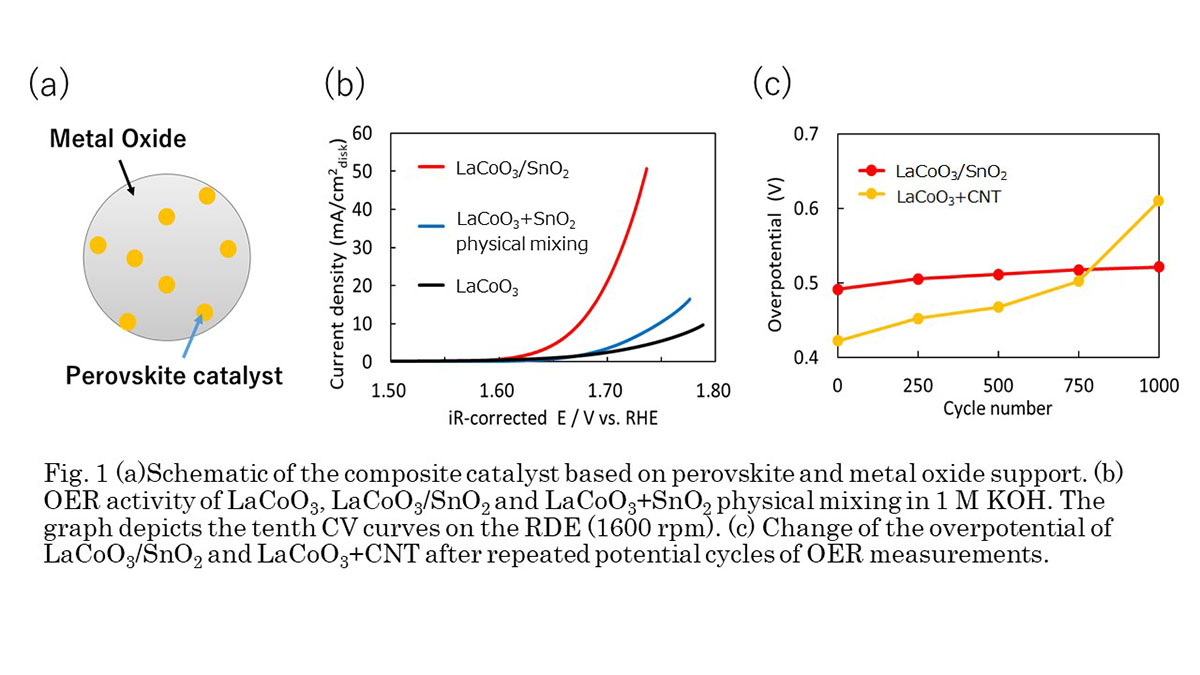
The development of green energy are getting increasing research attention. Hydrogen is an excellent energy carrier and is also considered an energy source suitable to serve as an intermediate energy carrier for solar and wind energies. The development of highly efficient, stable, and low-cost electrocatalysts to reduce the reaction potential of electrolytic water splitting can facilitate conversion of green energies into hydrogen energy. In this study, we successfully grew Ni-Fe-Mo based nanorod arrays on nickel foam, denoted as (Ni, Fe)MoO4@NF, as bifunctional electrocatalysts for overall water splitting. The product catalysts exhibited excellent electrocatalytic activities toward the hydrogen evolution reaction (HER) and oxygen evolution reaction (OER) in 1.0 M KOH, achieving overpotentials of 128, 226, and 305 mV at 10, 50, and 500 mA cm-2, respectively for the HER and overpotentials of 227 and 333 mV at 50 and 500 mA cm-2, respectively for the OER. The enhancement in OER efficiencies can be mainly attributed to the synergistic effects between Ni and Fe. And the enhancement in HER efficiencies can be mainly attributed to the synergistic effects between Ni and Mo. Furthermore, the nanorod array structure on nickel foam enlarges the reaction surface areas and thus the active site number for the water splitting reaction.
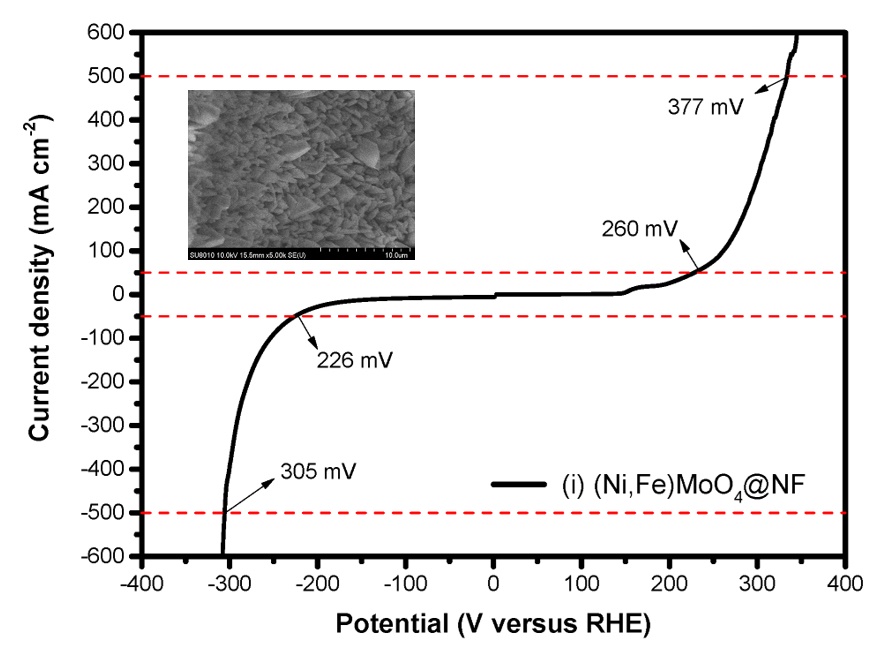
Hydrogen energy, an eco-friendly energy source for replacing fossil fuels, is widely regarded as a next-generation energy source with highly versatile application. However, there are technical limitations on hydrogen storage and production that should be satisfied for aspects of economy and efficiency. Among many technologies for solving the problems, liquid organic hydrogen carriers (LOHC) technology has been receiving much attention since it can be stored for a long time and safely transported to a destination using existing gasoline infrastructure. Recently, it has been experimentally reported that when biphenyl was mixed with diphenylmethane, it showed a reversible hydrogen storage and production capacity of 6.9 wt% H2 and 60 gH2/L, existing in a liquid state at room temperature. To understand this mechanism in detail, density functional theory (DFT) calculations were conducted using Gaussian 16 software package. We analyzed the reversible dehydrogenation reaction mechanisms based on the dehydrogenation enthalpy and free energy calculations. Furthermore, the same calculations were conducted with a various functional groups to propose higher efficient LOHC materials, which would make a great contribution to the development of optimal LOHC materials for the reversible hydrogen storage and production system.
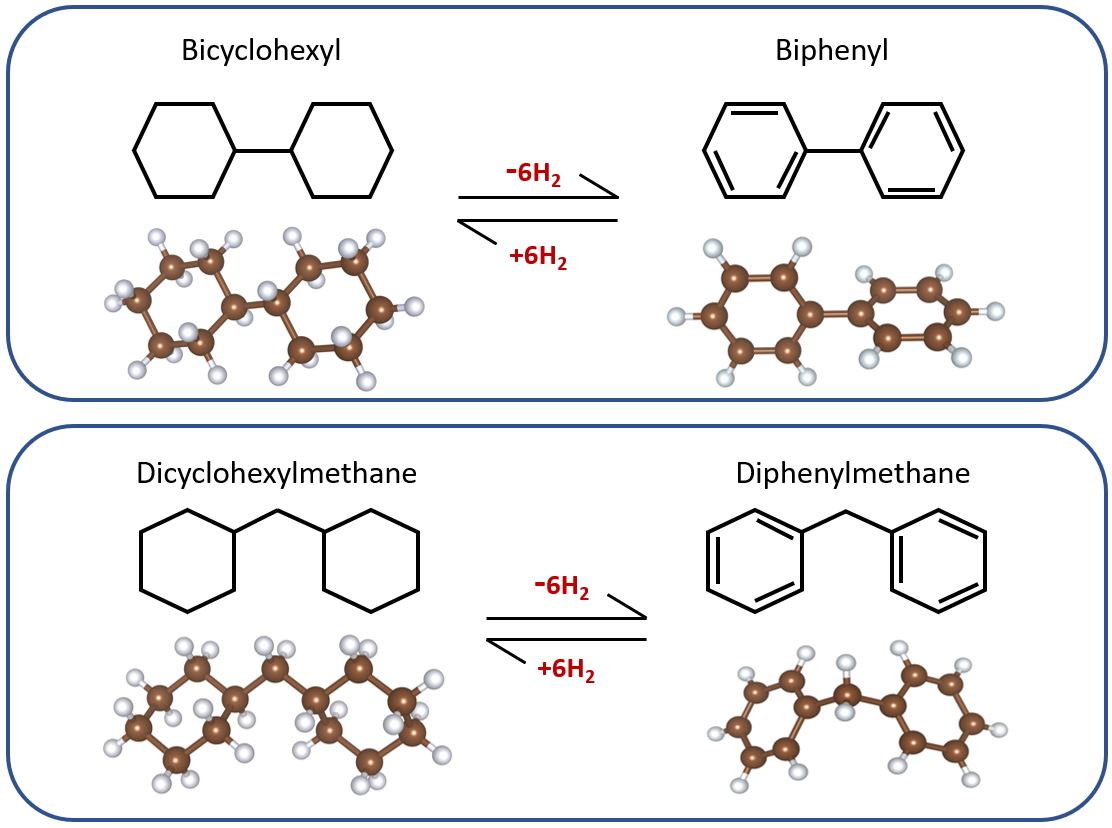
Hydrogen is a secondary energy source and can generate electricity by fuel cells without CO2 emission. Ammonia is considered for one of the promising hydrogen storage media. Ammonia has high gravimetric and volumetric hydrogen capacities (17.8 mass% and 107.3 kgH2/m3). And ammonia is easily liquefied at 1.0 MPa at room temperature. Hydrogen can be obtained by electrolysis of liquid ammonia. The theoretical standard voltage is 0.077 V, however the actual operation voltage is much higher due to the large overpotential for the anode reaction. In the anode reaction of N2 formation from NH2-, it is considered that either NH2- adsorption or N2 desorption can be the limiting step. Therefore, the catalyst effect on anode reaction was investigated by focusing on the metal nitride formation enthalpy ΔHfMNx which corresponds to the strength of metal-nitrogen bond. The electrolysis of liquid ammonia was performed using a three-electrode system with a counter electrode of a Pt plate, a reference electrode of a Pt wire (-2.59 V vs. SHE) and a working electrode of a catalyst plate (Ti, Ta, Fe, Co, Ni, Ru, Ir, Pt, Au, or Ag). The cyclic voltammetry (CV) of mono-component catalysts showed different activities for different metals (Fig. 1a). By plotting the current density at 0.3 V against the ΔHfMNx, the volcano plot was obtained (Fig. 1b). Next, to increase the catalytic performance, binary metal catalyst of Fe and Pt (Fe-Pt) having different bond strengths with nitrogen was prepared. Fe-Pt showed higher current density than the mono-Fe and mono-Pt catalysts at a low potential of 0.3 V.
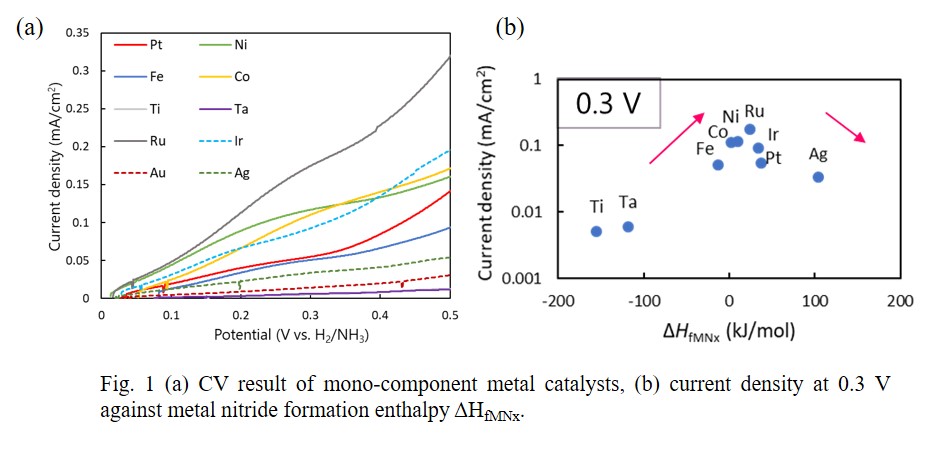
NH3 is one of the key chemicals in the world. For example, NH3-based chemicals occupy the vital position of a fertilizer, which directly affects the world's food supply. Besides, NH3 is considered a promising H2 carrier because of its high energy density, easy liquefaction, and no CO2 emission during H2 evolution reaction. Today, NH3 is synthesized from syngas and N2 at high pressure (15-30 MPa) and at high temperature (500 °C), which is known as a Haber-Bosch process. If this synthesis is achieved without using fossil fuel, we will obtain carbon-free NH3. We focused on electrochemical synthesis of NH3 which can be operated at atmospheric pressure by electricity from renewable energy resources. We chose a solid phosphate electrolyte (a CsH2PO4/SiP2O7 composite) which conducts protons at around 200 °C, based on the studies of intermediate-temperature fuel cells. Both electrodes consisted of Pt on carbon with 1 mg_Pt cm-2. Ideally, the electrochemical synthesis proceeds as follows. At an anode side, H2 is separated to protons and electrons (H2 → 2H+ + 2e-). At a cathode side, N2 reacts with protons and electrons (N2 + 6H+ + 6e- → 2NH3). Using the electrolyte and electrodes, however, NH3 was detected not only from cathode but also from anode probably because of the NH3 leakage from the cathode to the anode and desorption/decomposition of NH3-like contaminations. Thus, we struggled with changes in experimental conditions and improvement in the apparatus and experimental procedure. Ag-Pd membrane was found to be effective for preventing the gas leak, and by inserting Ag-Pd membrane between anode and electrolyte, NH3 detection in the anode side was limited, and electrochemical NH3 synthesis was confirmed in the cathode side.
Ammonia has been paid attention as a hydrogen medium for hydrogen energy. The aqueous ammonia solution has a high hydrogen mass density (6.1 mass%) and a vapor pressure (0.08 Pa) lower than atmospheric pressure at 20 °C. Electrolysis is one of the methods of generating hydrogen from aqueous ammonia solution. Hydrogen and nitrogen are generated at the anode and cathode, respectively, and the theoretical decomposition voltage is 0.06 V. Platinum is often used for the electrode catalyst but has a problem of the large overvoltage of the anode.
In this study, an electrode with platinum nanoparticles supported on carbon nanotube (Pt-CNT) was fabricated. CNT is a carbon material possessing a high specific surface area, that forms a sponge-like film by a dispersion-filtration process. The Pt-CNT electrode was adapted to electrolysis of ammonia aqueous solution to reduce the anode overpotential by increasing the Pt surface area.
Pt nanoparticles were deposited on CNT by polyol method at various temperatures of 100-180 °C. The electrochemical surface area of Pt was calculated from the amount of hydrogen adsorption and desorption in 0.5 M H2SO4 aq. The largest platinum surface area, 268 cm2 per 1 cm2 of electrode, was obtained for the Pt-CNT with Pt deposited at 160 °C. The ammonia electrolysis results at the anode with 1 M NH3 + 1 M KOH aqueous solution are shown in Fig. 1. The Pt-CNT electrode prepared at 160 °C and having the largest platinum surface area showed the highest peak current density and the lowest potential at 10 mA cm-2.
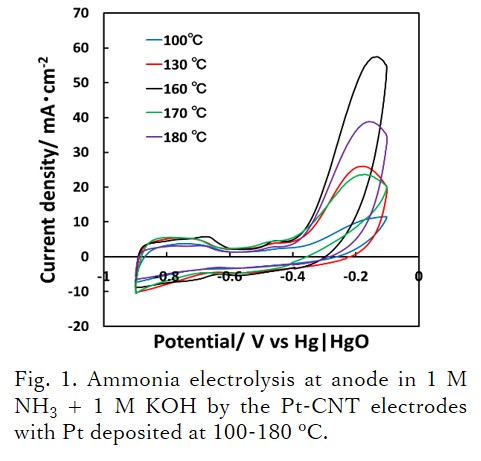
Among many eco-friendly energy sources, hydrogen energy has been attracting attention due to a higher versatility, but there is a difficulty in the practical use due to technical limitations in storing and transporting hydrogen. Liquid organic hydrogen carriers (LOHC) technology is one of the most promising alternative methods, storing hydrogen in a liquid state compound, thereby enabling stable and high-density hydrogen storage. Previou studies have reported various LOHCs such as metylcyclohexane, dibenzyl toluene, N ethylcarbazole, ammonia borane and bis-BN cyclohexane. Among them, it has been reported that bis-BN cyclohexane, a derivative of AB, can overcome the disadvantage of ammonia borane (i.e., AB is rapidly decomposed below 150 °C), because it is thermodynamically stable at 150 °C and has a hydrogen storage capacity of 4.7 wt%. In the current study, we conducted an ab-initio study to develop hydrogen storage materials with higher efficiency and reversibility using Gaussian 16 software package. The dehydrogenation mechanism of bis-BN cyclohexane was investigated by calculating the reaction enthalpies and free energies, and then highly efficient materials were screened by conducting the same calculation depending on various functional groups such as F, Cl, and CH3. When F was replaced in one of the H atom of bis-BN cyclohexane, the enthalpy and free energy for the dehydrogenation were 26 kcal/mol and 0.1 kcal/mol, respectively, which proved to be enhanced reversibility of bis-BN cyclohexane-based LOHC.
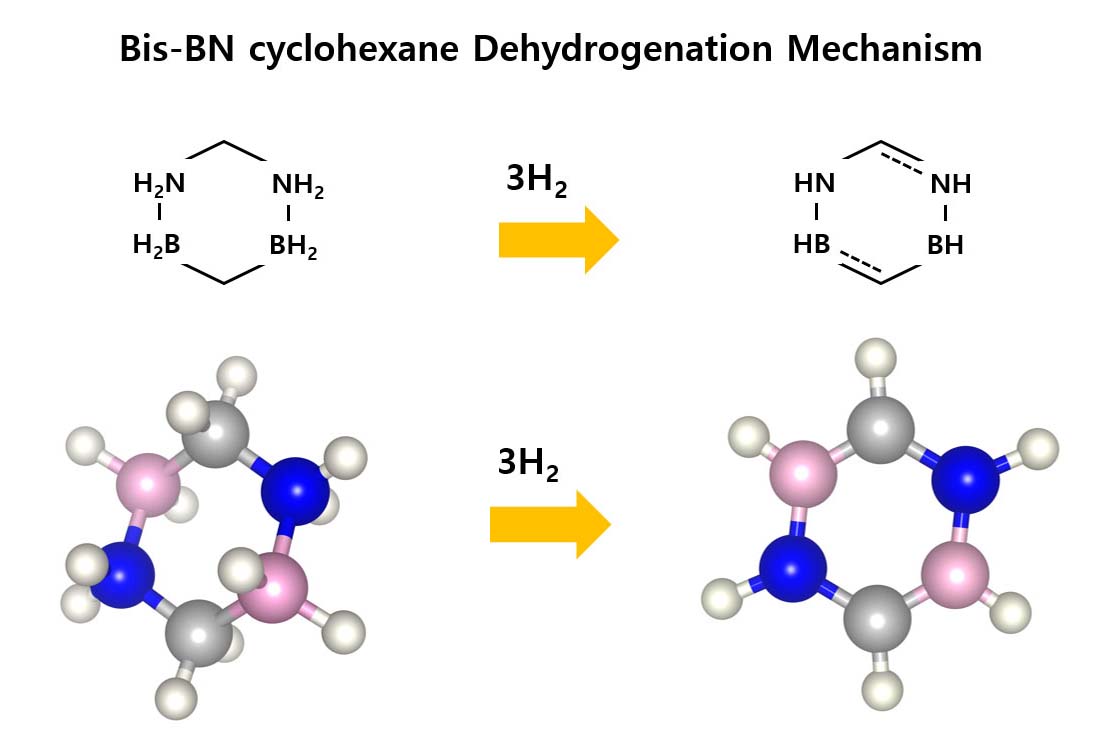
Electronic power generation in Japan contributed by thermal power generation in terms of economics, environmental compatibility, and stable supply. However, there is a problem that the environmental negative influence is high, such as the formation of greenhouse gases emitted when burning fossil fuels. Therefore, hydrogen has recently been attracted attention as a power source. Hydrogen has an advantage compared to the other energy medias, i.e., hydrogen can use be produced from various primary energies including renewable energies, and electricity is obtained by using a fuel cell. However, there is also an issue that the cost is high for transportation and storage due to the use of a high pressure tank because of the low volumetric energy density. Therefore, we propose an electrochemical device for production of hydrogen from methylcyclohexane, which is an energy carrier. The reaction, separation, and compression processes are performed by one device, the cell structure is similar to a PEFC, and the reaction principle is the electrolysis of methylcyclohexane by an external voltage.The formation of proton from methylcyclohexane carries out at an anode catalyst (reaction process), separation between hydrogen and organic compound by the Nafion membrane (separation process), and electrochemical compression based on the Nernst equation (compression process). In this study, hydrogen was obtained from reaction, separation, and compression from pure methylcyclohexane, and the concentrations of hydrogen and impurities were evaluated by gas chromatography. As a result, a current density was more than 50 mA cm–2 at a cell voltage of –2.0 V.
As an eco-friendly energy source to replace fossil fuels, hydrogen energy is seen as a next-generation energy source with its high general purpose applicable. However, there are technical limitations to stable hydrogen storage and release for economic feasibility and efficiency. Liquid organic hydrogen carriers (LOHCs) can be one of the ways to overcome this. In previous studies, it was demonstrated experimentally that biphenyl exists in a liquid state at room temperature when mixed with diphenylmethane, and has a hydrogen storage capacity of 6.9 %wtH2 and 60 g/L. Our preliminary study demonstrated that the dehydrogenation efficiency of biphenyl has increased when carbons were replaced with boron (B) and nitrogen (N) in the molecule. Based on the findings, the current study investigated the reversible dehydrogenation and hydrogenation mechanisms of BN-biphenyl and BN-diphenylmethane by predicting reaction enthalpies ($Delta;H) and free energies ($Delta;G) based on density function theory (DFT) calculations. In addition, alternative materials with higher efficiency are to be screened by adding functional groups (F, Cl, NH2, etc.) in the molecules. This will contribute to the development of an optimal hydrogen storage and release of highly efficient LOHCs.
Hydrogen, which is clean and storable fuel, is an attractive energy carrier for energy and environmental issues. In addition, hydrogen plays a vital role in chemical industry as a reactant. Nowadays, hydrogen is mainly produced from fossil fuels by steam reforming with CO2 emissions, so new hydrogen production process which is eco-friendly has been desired. Thermocatalytic decomposition of hydrocarbon is attracting attention because there is no emission of greenhouse gases such as CO2 during hydrogen production. Several researchers have investigated various catalysts for this reaction, but there is a problem of carbon deposition on the surface which blocks active sites of the catalyst. Based on the situation, “chemical looping methane cracking system” has been proposed. This system is composed of two reactors. In a first reactor, methane is cracked into H2 and carbon, and in a second reactor, deposited carbon is oxidized by CO2 into CO. The system has advantages in terms of separated syngas production and CO2 utilization. As an oxygen carrier, Fe/BaZr0.9Y0.1O3 composite was reported in our previous study, which exhibited high reaction kinetics for methane cracking because of high proton conductivity of BaZr0.9Y0.1O3
In this study, we synthesized Fe-doped BaZr0.9Y0.1O3 and investigated the reaction activity of these catalysts by thermal gravimetric analysis and gas analysis. Fe-supporting method, i.e., Fe doping, and the amount of Fe influenced the states of deposited carbon in methane cracking. For example, direction of growth and diameter of carbon fiber, and reaction kinetics also changed by the oxygen carriers. On the other hand, the carbon oxidation reaction with CO2 completed in a relatively short time for each catalyst. Besides, cyclic stability was investigated. Through the kinetic measurements, we discussed the effect of the feature of prepared catalysts on reaction kinetics and the efficiency of the system.
Zeolite templated carbons (ZTCs) composed of curved and single-layer graphene frameworks have uniform micropores (ca. 1.2 nm) and high surface areas (~4000 m2 g-1). Due to their outstanding properties originating from the porous structures, ZTCs have been utilized in many applications, e.g. hydrogen storage, CO2 capture, catalysts and electrochemical capacitors. To expand the utilization of ZTCs, metal atoms or heteroatoms have been doped to ZTCs. However, it is still challenging to fabricate single atomic transition metals coordinated with heteroatoms in ZTCs. In this work, we synthesized Co/N doped ZTC (Co/N-ZTC) by complexing Co ion with 2-methylimidazole in Y zeolite to expand the further utilization of ZTCs as shown in Figure 1. The first step is to anchor Co/2-methylimizole complex into HY zeolite as a precursor of Co/N-ZTC by complexing Co ion with 2-methylimidazole in HY zeolite. The next step is chemical vapor deposition (CVD) using methanol as a carbon source, followed by carbonization process. The last step is base and acid treatments to remove HY zeolite and aggregated Co particles. The obtained Co/N-ZTC has a high surface area (ca. 2000 m2 g-1) and single atomic Co species in CoNx moieties, which actually contributes to its excellent catalytic performance on oxygen reduction reaction. This synthetic concept is beneficial to fabricate single atomic transition metals coordinated with heteroatoms in ZTCs.
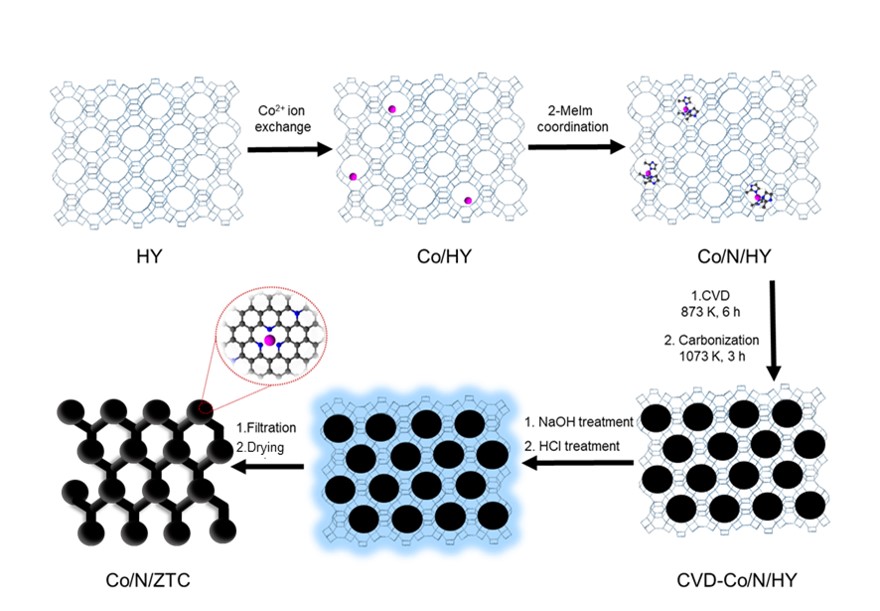
Hydrogen is paid attention as clean energy because it does not emit CO2 when converted to electricity. MgH2 is one of the promising hydrogen storage materials because of its high volumetric and gravimetric hydrogen densities and abundance. However, Mg expands and shrinks during hydrogen absorption and desorption, respectively. MgH2 powder pulverizes during hydrogen absorption and desorption cycles. In the tank filled with MgH2, pulverized powder drops and the density of packed bed at the bottom increases. This causes a problem of tank deformation during cycles. In this research, in order to absorb volume change of MgH2 and fix pulverized powder during cycles, MgH2 particles were retained in carbon nanotubes film. MgH2 and carbon nanotubes were co-dispersed in N-methyl-2-pyrrolidone. The MgH2-CNT composite was synthesized by vacuum filtration of the dispersion. The structure of MgH2-CNT composite (MgH2-CNT w/o press) was maintained after hydrogen ab/desorption (Fig.1 a), however, the hydrogen desorption rate was lower than that of MgH2 powder (Fig.1 b). In order to improve desorption rate, the MgH2-CNT composite was pressed to decrease its porosity. As the result, the desorption rate of pressed MgH2-CNT composite (MgH2-CNT w/ press) was improved compared to MgH2-CNT w/o press, but the film structure was broken into pieces. The MgH2-CNT composite was wrapped in stainless mesh and pressed (MgH2-CNT w/ mesh, press) to support the film structure. The composite achieved improved desorption rate and maintained film structure during hydrogen ab/desorption cycles.
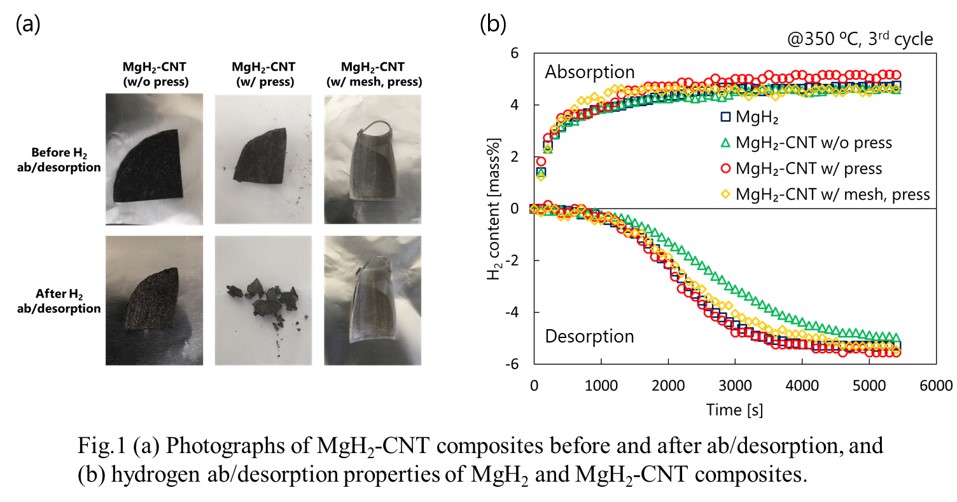
The world population is growing rapidly, which requires unique solutions to assure safe water, food and energy for all. Concurrently, the numbers of women and ethnic minorities entering Science, Technology, Engineering and Math (STEM) fields in the US is stagnant. An inclusive and diverse workforce is required in order to find sustainable ways to address these challenges by thinking globally but working regionally. This presentation will review where we are in terms of workforce development and provide examples of how we are teaming together to provide safer water, healthier food, and off the grid energy in rural areas of the Southwestern United States.
In recent years, China's chemical industry has made great development, which greatly promotes the national economic power and living standard but also faces a series of new challenges, such as environmental problems. In order to resolve these problems fundamentally, Chinese scientists have been undertaking research in the area of green chemical engineering for many years and achieved great progresses. In this presentation, several typical green chemical processes related to the Chinese resources characteristics and environmental requirements were presented, i.e. the C2/C4 processes for green methyl methacrylate production, CO2 green utilization by convert to dimethyl carbonate and ethylene glycol, green processes for gas (CO2, SO2, H2S, NH3) separation and recovery based on ionic liquids, green solvent-mediated extraction technologies, as well as utilization technologies of cellulous. Afterwards, the perspectives and development tendencies of green chemical engineering in China were proposed, and the solvent and process innovation for developing sustainable industrial technologies in China will remain a key point in the visible future.
The Korean Society of Rheology is a small academic society mostly focusing on fluid mechanics of non-Newtonian fluid. The number of member is about 1000 but a real acting member is about 200. In the society, a diversity committee was organized recently in 2018 during annual spring meeting of the society, 15 female rheologists and 3 student members were involved in the committee. The aims and main role of the committee is a build-up of network of female rheologists and rheologist candidates and share the information.
The challenge to organize the committee is a lack of self-motivation of each female rheologist to join the committee. Most of them believed that being a part of the committee is nothing to do with progress in academic activity or already gave up to make a progress in research even though they do not develop how to keep up a professional career as scientist in their own way. Right! the aims and role of the committee of “build-up of network” is not directly related to the academic activity. However, as long as the society plays a role to providing a playground for academic activity, the committee is a good way for female rheologist to gather or to share research and life along with the society of itself. Especially, female scientists working on a similar research area shares several hindrances from custom, life, and research is useful to find identity as well as to achieve successful career.
The situation of women in fields related to natural sciences, technology, engineering and mathematics (STEM) is one of the significant research topics of the 2000s. The main argument behind this agenda is that some professions traditionally considered to be suitable for women and some for men, due to gender stereotypes. It is also argued that provided the necessary social and economic conditions, women can accomplish as well as men do in mentioned fields. Engineering is one of these professions which is traditionally attributed to men. Same as other countries in the world, more than a quarter students are female in STEM in university. All of them can find a job in industry. However, 20 years after graduation, two out of ten women are leaving STEM careers despite STEM jobs being some of the fastest growing and highest paying around the world. One of the biggest factors that sees women leaving their STEM careers is a realistic work-life balance. More than 20% of women quit their jobs when they have children, as they cannot afford daycare or a full-time nanny. It is why flexible working conditions have become a non-negotiable point for women engineer. In this presentation, the current situation and future outlook of woman engineering in Taiwan will be reported.
The Society of Chemical Engineers, Japan (SCEJ) was founded in 1936. In 2002, we joined the Japan Inter-society Liaison Association Committee for Promoting Equal Participation of Men and Women in Science and Engineering (EPMEWSE) as one of the twelve initial members. EPMEWSE grew into the association of about 100 academic societies in STEM field, whose main roles are large-scale surveys on gender equality, proposals and requests to government, and symposiums. In 2003, the committee for gender equality was established in SCEJ. Since then, we have carried out various activities, such as “female engineer forum” in annual academic meeting, networking women engineers, dissemination of information on diversity by our journal and website. The number of female members of SCEJ has increased slowly but steadily and its ratio has doubled during the last 15 years. Recent technological breakthroughs symbolized by AI, IoT and robotics are significantly changing the human society beyond technology. At such times, it is increasingly important to maximize the capabilities of diverse members as an essential element for active innovation. In SCEJ, we share this vision and encouragement of constructive female participation is one of the main pillars of our strategy toward sustainable future. In this paper, an overview of the present situation of gender equality in Japan and the challenges for diversity promotion in SCEJ is presented.
The spread of artificial intelligence (AI) technology and its application is going to make major changes in business and society. While AI technology has come to be used in more complex and important situations in industries, technical or social issues have also been visible. In this talk, I will outline the history and latest technology trends in AI. I also introduce examples of activities in chemical industry, including anomaly detection, predictive analysis, and knowledge management powered by AI technology. Real application of AI raises both technical and social issues. I will also discuss on the challenges to resolve these issues and directions for the future. which will be discussed in my talk. Finally, I will introduce the activities of The Japanese Society for Artificial Intelligence, which is the largest academic society in Japan.
Dynamic programming (DP) provides the optimal closed-loop solution in the presence of uncertainty, and the solution is free from online computation time. Reinforcement learning (RL) method aims to acquire the approximate solution of DP by resolving the intractability in the curse-of-dimensionality, while maintaining the advantages of DP. Recent advances of RL are rooted in two agnostic characteristics: first, the development of deep neural networks (DNNs) enables the approximation of high-dimensional nonlinear functions by automatically extracting the feature of the domain, and second, the algorithm does not require the structures of system and cost.
Herein, this presentation introduces both model-free and model-based applications of RL to the control and optimization of process systems engineering problems. The model-free formulation is advantageous to the system which cannot be expressed as a continuous state space model such as hybrid model and commercial simulation software. To the system where the massive trial-and-error data acquisition is impossible, the model knowledge should be taken into account to enhance the data efficiency. Based on the Hamilton-Jacobi-Bellman (HJB) formalism which states the optimality, differential dynamic programming (DDP) method is utilized as a numerical method for solving the HJB equation. The feedback control law is obtained with the local second-order approximation of the cost function and system dynamics. The resulting model-based RL formulations for a tracking problem and a constrained dynamic optimization problem are presented.
In the big data era, small data problems still exist in many industrial sectors. Taking the high-value process industries as an example, a large number of materials and process methods are often tested at the design stage. However, only a small amount of data can be collected for each material-process combination (referred to as a “task”), which poses a serious challenge to data-driven process modeling. There is a great necessity to integrate the small data measured in different tasks and build the process model by sharing the information. In this work, a deep neural network-based word embedding technique is adopted to extract the qualitative task information for process modeling. Specifically, an autoencoder is used to learn embeddings which are combined with the quantitative process conditions as the inputs of a feed-forward neural network to produce the final predictions. The feasibility of the developed method is illustrated with an extrusion process. In the studied case, the proposed network shows both good interpretability and prediction accuracy.
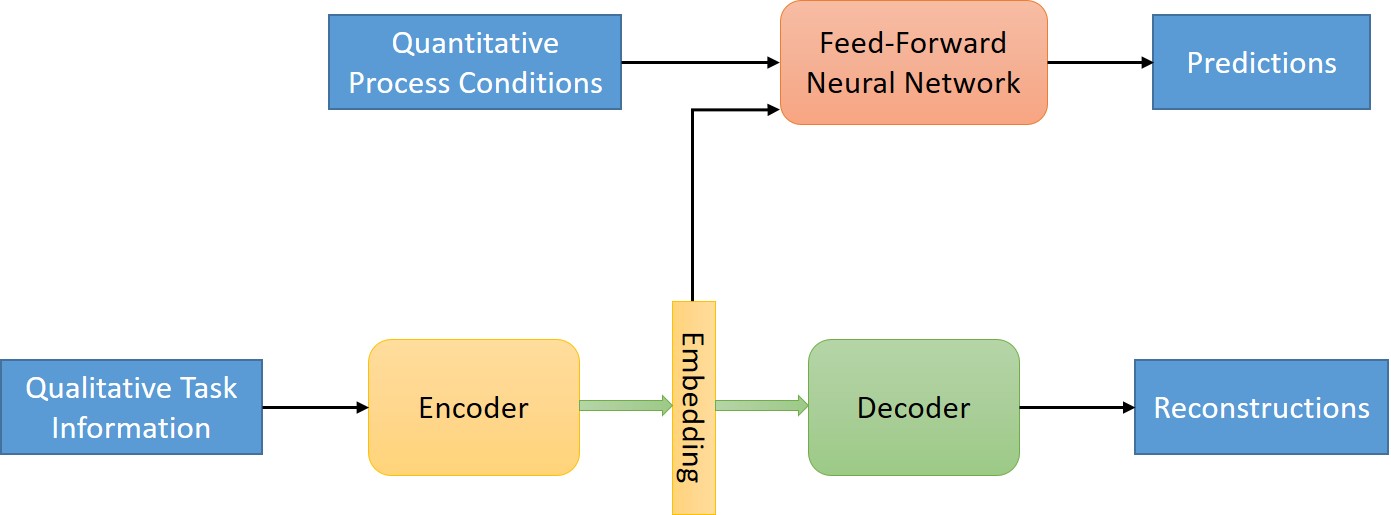
Many pharmaceutical companies and academic researchers are working together to develop continuous processing or flow manufacturing technology for small scale processes. Migration from batch to continuous is expected to bring about various benefits including reduction in production cost and waste, and improvement in product quality. Another advantage is the flexibility. The production volume can be easily adjusted by changing the operation time or the number of production lines. Flexibility can be further improved by modular approach, in which modules for unit operations are prepared, and processes are constructed on-demand by just connecting them each other. To achieve these goals, we need to acquire several new technologies. First, small scale continuous separation units must be developed. A new design strategy for modular flow system should be established. The modules must be designed by taking account of flexibility and optimality of production processes to be built with them. Process design will be to find the best configuration of modules, rather than calculating the flow rates and sizes. To start the operation right after connecting the modules, we must be able to build the instrumentation and control systems. The information system for the each module should be designed carefully so that the operation system, as well as the flow process itself, can be reconfigured easily. It is expected that this can be achieved through employment of IoT sensors and actuators. A database for managing the operation records, and data processing technology, including AI, are also necessary to handle and analyze a large amount of data collected from the IoT devices. The advancement in small scale modular flow technology, together with the information systems, promotes the creation of new systems concept in chemistry, including fully automated chemistry labs.
Recently, the application of supercritical fluid, particularly supercritical carbon dioxide (scCO2), and polymer has been expected because it is safe and harmless for environment in increasing social interest in global environmental deterioration and rising costs of fossil fuels. For example, a polymer foam is one in which cells are dispersed inside a polymer, and the amount of material used can be reduced by the presence of the cells. Other examples include atomization and fiberization. Unfortunately, it is difficult to obtain sufficient products with only supercritical carbon dioxide and polymers. Therefore, attempts have been made to add a solvent as the third component. As a result, it is beginning to be reported that the performance can be changed more broadly than when no additive is added. The cause of this change is expected to be due to the change in physical properties by the addition of solvent, but the physical property data of the CO2/solvent/polymer ternary system are limited. Particularly, a phase behavior is important for the process design. In this study, the phase behavior of a CO2/toluene/polystyrene (PS) ternary system was measured.
The phase behavior was observed by an apparatus based on a synthetic method. In this system, two types of the phase boundary were observed; bubble point (BP) and cloud point (CP). The BP pressures were defined as the pressure at which small bubbles appear in the cell. The CP pressures were determined by measuring the turbidity of the system by the variation of reflected light intensity. In addition, the effects of composition, temperature, and polymer molecular weight for the phase behavior were examined.
Physical properties such as density, viscosity, and vapor-liquid equilibrium are indispensable information for the chemical process design. The demand for these physical properties is increasing in these days. In particular, the PVT relationship is one of the most basic and fundamental physical properties however, as the measurement needs specialized equipments and a long measurement period, the experimental data are always insufficient.
Silicon alkoxides are used extensively as raw materials of silica materials such as thin film, monolith, and silica aerogel which has high thermal insulation performance though, there are few reports on the thermodynamic properties of these substances. In this work, PVT relationships of hexyltrimethoxysilane(HTMS) was measured by an experimental apparatus based on a general variable volume method. Experiments were performed at temperatures from 303 to 363 K and pressures up to 160 MPa, and measurements were repeated at least three times.
Furthermore, from the above-mentioned subject in the measurement of physical properties, complementation of data by calculation as well as measurement is required. On this purpose, the equation of state (EoS) is a powerful tool. In this study, Sanchez-Lacombe Equation of state (SL EoS), whose parameters could be determined from only the PVT relationship. The measured PVT relationships of silicon alkoxides were correlated by SL EoS and the SL parameters were determined. In addition, estimation of the SL parameters of HTMS from the SL parameters of methyltrimethoxysilane (MTMS) reported previously was conducted with considering the molecular structure.
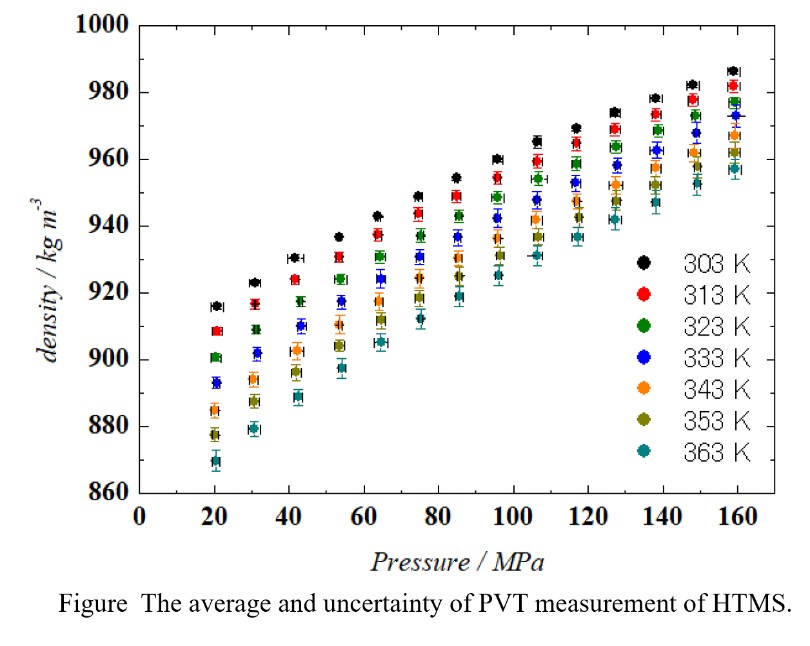
Methane hydrates (MH) in the Nankai Trough of Japan are considered as promising resources for developing CO2-free energy. In this work, the objectives were: (i) to develop an optical system for measuring method hydrate dissociation in situ, (ii) to measure change of occupancy ratio during MH dissociation and (iii) to develop a method for correlating occupancy ratio that can be used in large scale simulation systems. During the MH dissociation process, occupancy (θ) in each cage (θM or θS) changes based on degree of progress for dissociation. For analyzing the cage occupancy of MH, Raman spectroscopy was used as an in-situ technique to determine methane hydrate dissociation characteristics. MH films were synthesized with pure water and methane gas. The procedure used allowed MH films to form on the lower surface of the high-pressure optical cell sapphire window, which eliminated noise associated with the C-H stretching vibration of bulk methane gas. The changes in the relative cage occupancy ratio (3θM/θS) in the methane hydrates were monitored at equilibrium conditions and during changes of pressure in which dissociation occurred. The cage occupancy ratio (3θM/θS) in MH decreased with increasing pressure at equilibrium conditions due to increasing amounts of methane present in the S-cage. For an occupancy ratio (3θM/θS) of 3.37 (273.8 K, 5.0 MPa) the uncertainty in occupancy ratio obtained with procedures developed in this work was ca. 0.09 compared with a literature value of ca. 0.71. The Kihara potential parameters used in the model were redetermined to provide reliable correlation of the data. For depressurization conditions, (275.65 K, 7.60 MPa → 5.94 MPa), the cage occupancy ratio in MH increased up to 240 h monitoring time. The trend of the cage occupancy ratio with pressure and model will be useful for developing large-scale simulations of actual methane hydrates.
In recent years, several studies have reported the possibility of reducing energy consumption during the solution polymerization process of polyethylene by the introduction of a liquid-liquid (LL) separator. Besides temperature and concentrations, molecular weight (Mw) and polydispersity index (PI) are important factors for the design of the separation process. Unfortunately, the effect of Mw and PI to the phase behavior of PE + hexane + ethylene system has not been extensively studied. Previously, the LL phase behavior for PE + hexane + ethylene system was studied using polydisperse PE (PE30: Mw 30.0 kg/mol, PI 4.2) at 473 K. The addition of 1wt% of ethylene to the binary PE + hexane system increased the phase separation pressure by 1 MPa at almost the same magnitude over all feed PE weight fraction (wF,PE) range.
This study aims to provide experimental data and investigate the effect of Mw and PI to the phase behavior of PE + hexane + ethylene system. The experiments were conducted using polydisperse PE (PE4: Mw 4.0 kg/mol, PI 2.4) at 473 K with wF,PE ranging from 0.02 to 0.20 using a variable-volume optical cell equipped with a hand pump and a recording system. Comparing with PE30, the LL phase separation pressure of PE + hexane system for PE4 was about 3.0 MPa lower, and the addition of 1wt% of ethylene only increased the phase separation pressure by 0.8 MPa. The phase separation pressure increased as the Mw increased, and the addition of ethylene shifted the LL phase boundary to higher pressure. The results provided from this study could complement previous understanding for the design of the separation process.
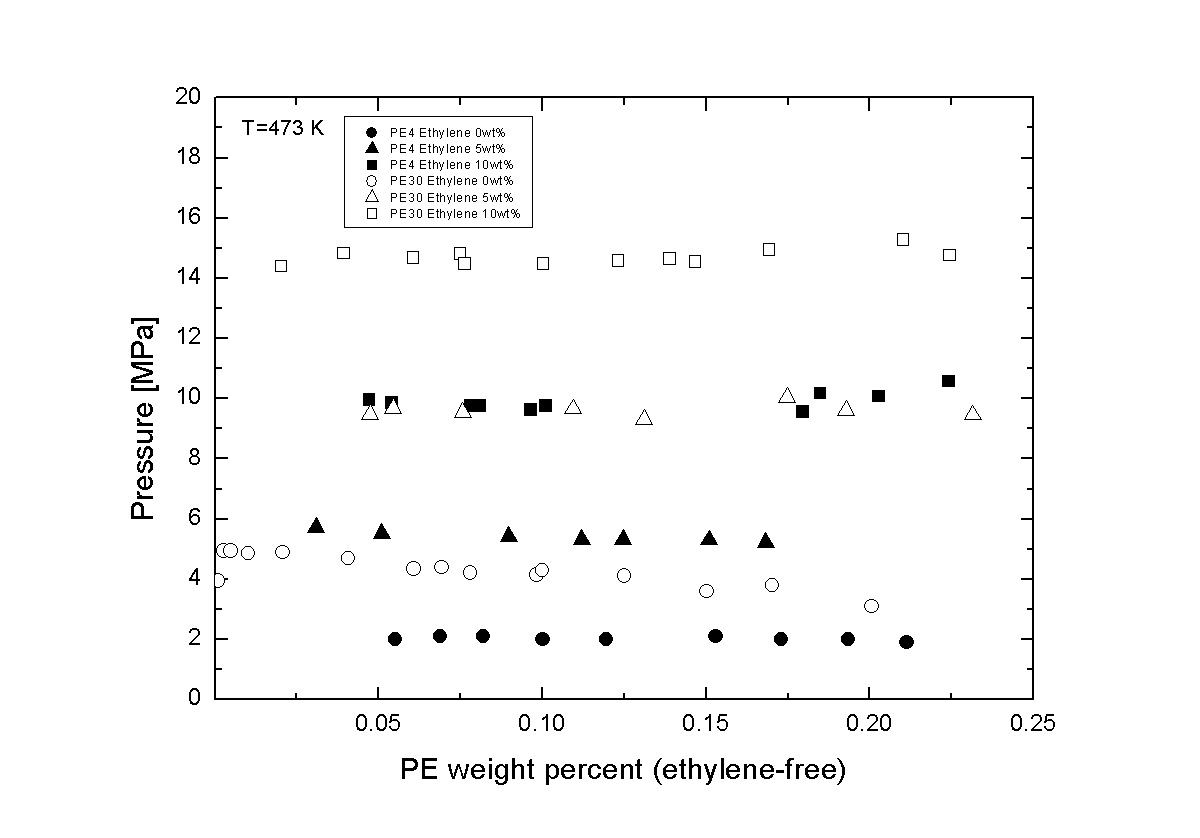
The author proposed a new activity coefficient model [Y. Iwai, Fluid Phase Equilibria 465 (2018) 24-33]. The new model was derived from Guggenheim quasi-chemical theory with Taylor series. The formula of the new model is similar with that of regular solution theory. However, new idea in the new model is the surface area parameters, which account for the number of interactions between molecules, were assumed to vary depending on partner molecules and the concentration of mixtures. The new model can describe an exceptionally high value or convex behavior of activity coefficient in the dilute region. The liquid-liquid equilibria for ternary systems and the vapor-liquid equilibria for constituent binary systems can be correlated well with the same parameter sets.
The following results will be shown in this presentation.
(1) The new model is applied to calculate the activity coefficients for the systems which are difficult to correlate by widely used models. The target systems are as follows.
The systems of activity coefficients show convex behavior.
The systems of activity coefficients sharply increase or decrease in dilution region.
The systems of partially miscible.
(2) The new model is expanded to a group contribution method. Some results of the group contribution method will be presented.
Diethyl carbonate (DEC) is one of the most promising compound that may be used as co-additive with ethanol/alcohols in gasoline blends because its higher octane number, lower vapor pressure and lower miscibility with water than ethanol. To apply DEC as gasoline additive, there are some aspects to be concern because blending process could change its physical properties such as vapor pressure and water miscibility. In order to know the physical properties of DEC-gasoline fuel mixture, the phase equilibria of DEC mixtures with several alcohols and hydrocarbons related to gasoline are required. Therefore, in this study, we reported the phase equilibria of DEC mixture with alcohols and hydrocarbons in binary and ternary systems at temperature range of 303.15 K – 323.15 K. From the isothermal vapor–liquid equilibrium (VLE) data, the vapor pressure of DEC mixtures with alcohols and hydrocarbons in binary and ternary systems were obtained. DEC is found to successfully decrease the vapor pressure in binary mixtures with hydrocarbons (isooctane, n-heptane, toluene) and alcohols (ethanol). In ternary mixtures, DEC is found to successfully decrease the vapor pressure of hydrocarbon + alcohol mixtures as well. The binary isothermal VLE data were well correlated using Wilson, nonrandom two-liquid (NRTL) and universal quasi-chemical (UNIQUAC) models with average absolute deviation (AAD) less than 2%. The binary parameters obtained from binary mixtures give good accuracy prediction results for ternary mixtures with AAD less than 5%. For the liquid-liquid equilibrium (LLE) containing of DEC and water, the water miscibility of DEC + alcohols + hydrocarbons mixtures were obtained. From the liquid-liquid equilibrium data of DEC + water + ethanol/ 1-propanol ternary mixtures, the presence of DEC in ethanol/ 1-propanol decrease the content of water. The LLE data for these ternary mixtures were well correlated using NRTL and UNIQUAC models with root mean square deviation less than 0.005.
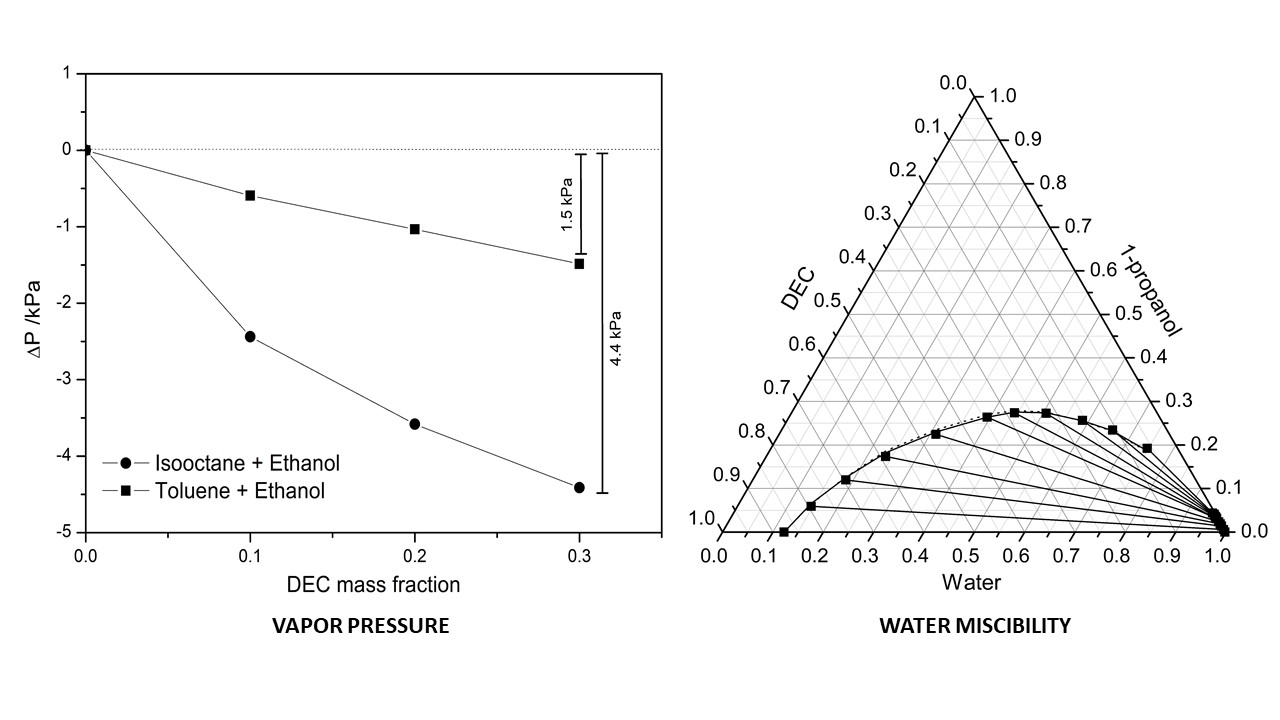
When the critical properties of a pure substance are known, it is possible to predict thermodynamic properties based on the corresponding state principle using an equation of state. However, we can hardly find experimental values of critical properties of complex molecules such as ionic liquids. Extending the Joback method, I succeeded in predicting the critical temperature of complex molecules [1]. Moreover the critical volume of [hmim][Tf2N] was determined to fit the density of ionic liquid.
To calculate a mixture properties, especially phase equilibria, a binary interaction parameter, mij , should be determined. Changing mij values of glymes, TCMs and [hmim][Tf2N], the solubility of CO2 in the ionic liquids were best fitted.
In 1977, we reported that the optimal mij values for the modified generalized BWR equation of state were found to belong to several family groups expressed as a function of the ratio of critical volumes [2,3]. This time, recalculation brought a simpler correlation. As shown in a following figure for the CO2 containing family group, the above three kinds of ionic liquids were found to be on the same correlation curve. It means that polarity of complicated substances plays small role. It shows that the correlation of binary interaction parameter for the CO2-nonpolar substances can also apply to more complicated polar systems, such as ionic liquids.
[1] H. Nishiumi, Fluid Phase Equilibria, 420 (2016) 1–6
[2] G.H. Hudson, J.C. McCoubrey, Trans. Faraday Soc., 56 (1960) 761
[3] H. Nishiumi, S. Saito, J. Chem. Eng. Japan, 10 (1977) 176–180
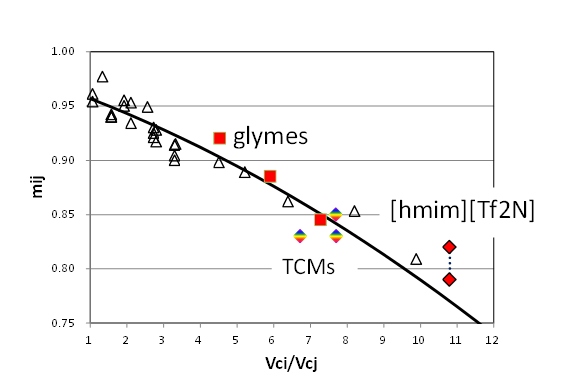
Hydrogen reforming technologies, which combine hydrogen with toluene or naphthalene and store/transport it as methylcyclohexane or decalin, are expected to be widely used in the future due to the ability to safely transport the fuel with the highest concentration of hydrogen possible.
A reference database of equations of state is essential for the optimal selection of substances and the development of international technical standards. To add to this database, we started the development of highly accurate equations of state for these organic substances and their mixtures. We adopted the Helmholtz-type functional form, as with all other international standard equations of state for water and alternative refrigerants.
Throughout the fitting process, we used three types of input information for correlation. The first is the appropriate ranges of values of exponents and coefficients in the equations of state, the second is the numerical information on the shape of the thermodynamic state surface, and the third is the published measurement information for each substances. The present fitting program, which was developed by Lemmon [1], includes these three elements in the objective function effectively, and therefore we carefully controlled the behavior of each compound while simultaneously fitting the experimental data.
In our presentation, we will report the current status on the development of the equations of state being developed for the pure components used in the aforementioned hydrogen reforming technologies.
[1] E.W. Lemmon, “Equation of State Fitting with the REFPROP Program”, National Institute of Standards and Technology, Boulder, CO USA (2019).
In the past few years, the use of the combination between zwitterionic ion chromatography (ZIC) and the interaction liquid chromatography (HILIC) [ZIC–HILIC] in identifying specific substances has been developed and considered to be the best technique in identifying certain substances in a solution. A zwitterionic betaine polymer is known to be able to convey whole neutral charge since it contains both anionic and cationic active groups which are sulfonate and quaternary ammonium groups in the same polymeric repeat unit. This study was conducted aiming to develop gel with the characteristic of reversible thermosensitive in adsorbing heavy metal ions from its solution. There are three gels used in this study to adsorb heavy metal ion from salt solution provided Zn(NO3)2; copolymer gel consisting of zwitterionic betaine N,N-dimethyl(acrylamidopropyl)ammonium propane sulfonate (DMAAPS), N,N-dimethyl(acrylamidopropyl)ammonium butane sulfonate (DMAABS), and DMAAPS copolymerized with thermosensitive N-isopropylacrylamide (NIPAM) gels. These gels were used to investigate the adsorption ability and its swelling degree which was synthesized by free radical polymerization before being affected by methylene spacer number, copolymerization, and temperature given. This research found that as the temperature increases, the ability of the gel in adsorbing the ions decreases. In the case of DMAAPS and DMAABS gel, the swelling degree value increases when the temperature also increases. Meanwhile, sulfobetaine which has larger spacer has higher adsorption ability but not with its swelling degree. In spite of having more spacer than DMAAPS, DMAABS found to have the smallest swelling degree value. In addition, NIPAM-co-DMAAPS was found to have both the highest adsorption ability and swelling degree value. Eventhough copolymer has less amount of sulfobetaine than DMAAPS and DMAABS gels', the copolymer gel was found to have higher ability of adsorption as many as ten times of other gels.
Polyvinyl alcohol (PVOH) is widely used in many applications due to its biodegradable properties. Cellulose and MMT are the most common organic and inorganic material used as reinforcing filler. Kenaf is one of the candidates of natural nanocellulose. Three compounds (PVOH-kenaf nanowhisker-MMT) were blended, cast and analysed. Kenaf nanowhisker loading was varied from 0 phr to 8 phr while MMT loading was varied from 1 phr to 5 phr. Mechanical properties, thermal properties and microstructure were analysed. In overall, the tensile strength exhibited highest value at 5 phr of MMT and modulus exhibited the highest value at 3 phr of MMT loading although increasing MMT loading could reduce the elongation at break. Increment of kenaf nanowhisker loading would increase the tensile strength, elongation and modulus until a maximum point where beyond the mechanical properties decreased. Among all, nanocomposites with 5 phr of MMT with no addition of kenaf nanowhisker had the highest tensile strength.
Glass transition temperature (Tg) of pharmaceutical polymers could be depressed by the pressurization with CO2. This phenomenon could be utilized for the formulation of pharmaceutical polymers in a short time and at mild temperature. However, there are some problems of the safety and cost under high pressure. Addition of organic solvent in CO2 could depress the Tg of polymers. Organic solvent is harmful to human, so addition of small amount of harmless solid co-solvent might be useful to lower the pressure. In this study, effects of solid co-solvent on the Tg of pharmaceutical excipients were examined with a visual method using the transmitted light intensity.
The Tg of Ethyl cellulose (EC)/CO2/ solid co-solvent systems was measured. For example, Tg of EC under atmospheric pressure was depressed by physical mixing with Vanillin (VAN) or l-Menthol (MEN) as solid co-solvent. Tg of EC with VAN or MEN wasn't depressed much under CO2. On the other hand, Tg of EC wasn't depressed by physical mixing of Xylitol (XYL). Therefore, it could be concluded that there are combinations of EC and solid co-solvent which can depress the Tg of EC and the Tg could be depressed by only addition of suitable solid co-solvent without CO2 pressure.
The state transition of EC with solid co-solvent was easily observed visually. It could be considered that Tg of EC was depressed by melted VAN or MEN dissolving into EC and wasn't depressed by melted XYL. From these facts, affinity between EC and solid co-solvent was examined by the solubility parameter (δ) which is an index of affinity between substances. The solubility parameters estimated by the group contribution method reported by Fedors [1] successfully explained that the affinity of polymers and solid cosolvent controls the Tg depression.
References
[1] Robert F. Fedors, Polymer Engineering and Science, Vol. 14, No. 2, California, (1974)

Biomass is a renewable and abundant resource that can reduce our dependence on the dwindling fossil fuel reserves. In particular, sugars are simple molecules that can be converted to biofuels and a wide array of platform chemicals. As found in plants and other organisms, fermentable sugars commonly exist as the repeating units in polysaccharides, which further form a complex network among themselves. Presently, one of the major challenges is to extract these sugars from these networks in an efficient and cost-effective way. The cleavage of the glycosidic bonds present in the polysaccharide structure is an important step in the process and understanding its mechanism can provide the insights necessary to develop better technologies to obtain the sugar monomers.
In this study, we used quantum calculations to determine a mechanism of the production of sugars from the acid-catalyzed hydrolysis of two model compounds, namely, cellulose and fucoidan. Glucose is the monosaccharide produced from the former and fucose from the latter. In both cases, our simulations showed that the process involves four steps. First, the oxygen in the glycosidic bond is protonated by an acid. Then, the C–O bond is broken, yielding a carbocation of either glucose or fucose. Next, the oxygen of a water molecule bonds with the positively charged carbon in the intermediate structure. Finally, the molecule is deprotonated, yielding the desired sugar monomer. Consistent for both cellulose and fucoidan, the initial step (i.e., protonation) is the rate-determining step because it requires the highest activation energy. Furthermore, our calculations showed that the depolymerization of cellulose via acid-catalyzed hydrolysis is less energy demanding than that of fucoidan.
Because of the insufficient supply of refined coconut oil as a raw material for biodiesel production in the Philippines, an exploration on the potential use of oil refining by-products, particularly coconut oil fatty acid distillate (COFAD), as an alternative feedstock has been done. The main problem encountered in the use of COFAD is its high free fatty acid (FFA) content. A pretreatment step via esterification using methanol as a solvent is needed in order to reduce the FFAs present by converting it to fatty acid methyl esters (FAME). In this study, the conversion of FFA in COFAD to FAME was done via homogeneous esterification using sulfuric acid as catalyst. The effect of catalyst loading (0.5, 1, 5 wt.% sulfuric acid) and methanol-to-COFAD molar ratio (3, 6, 10) were studied first in order to determine the best process conditions that would lead to a maximum FFA conversion and FAME content. It was found that a low catalyst amount (1 wt.%) and a high methanol-to-COFAD molar ratio (10:1) at a time of 30 minutes is a favorable combination to reduce the FFA from ~70% to ~1%. A kinetic study was further done using the best process conditions for esterification and the results were found to fit in the kinetic model having a pseudo-homogeneous first-order in the forward direction and second-order in the reverse direction. The effect of temperature on the rate of reaction was also determined by fitting the kinetic data to the Arrhenius Equation. The results of this study suggest that COFAD can be a suitable alternative feedstock for the production of biodiesel in the Philippines.
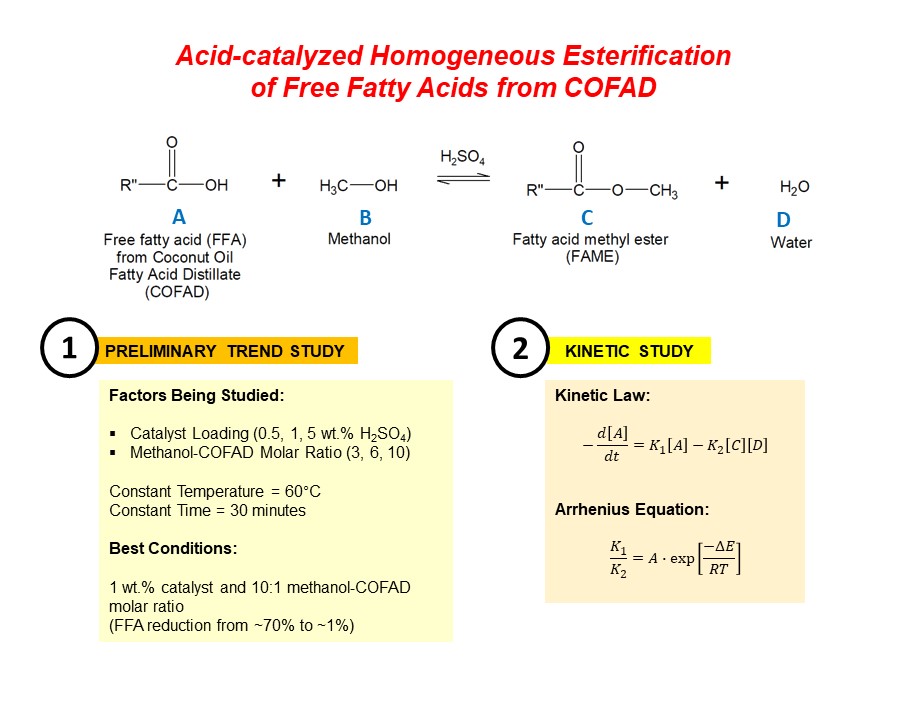
Polycarbonates (PCs) have excellent features such as transparency, impact resistance, thermal stability, dimensional stability, and flame resistance. A non-phosgene process for PC production from carbon dioxide, ethylene oxide, and bisphenol A, has been developed. This process provides an effective use for carbon dioxide, which is a greenhouse gas and an abundant carbon resource, and has attracted much attention in terms of greener and more sustainable chemistry. Diphenyl carbonate (DPC) is an important intermediate material in these non-phosgene processes. The DPC purity directly affects the downstream PC quality. High-purity DPC is important in the production of PC for optical media applications. One of the options for DPC purification is crystallization. Knowledge of solid–liquid equilibrium (SLE) data is crucial in the design and development of crystallization processes. Our group determined the SLE of several binary systems containing DPC. However, more experimental SLE data for systems containing DPC are still needed.
The object of this work was to obtain SLE data for ternary systems containing DPC. We investigated the SLE of two ternary systems, i.e., methanol + DMC + DPC and phenol + DMC + DPC in the reaction involved in the non-phosgene PC process. Two ternary SLE data were experimentally determined by a synthetic, visual technique designed in our laboratory. In the measurements of ternary systems, DPC free basis mole fraction of methanol or phenol “α” was changed from 0.3 to 0.9, and changes of SLE behaviors were discussed with an increase of α. The SLE predictions for two ternary systems were compared with the experimental SLE data on the basis of the NRTL parameters obtained from the constituent binary SLE data. Also, the National Institute of Standards and Technology (NIST)-modified universal functional activity coefficient (UNIFAC) group contribution model was also used for the prediction of two ternary systems.
Direct oxidation of formic acid is prominent in fuel cells. We recently reported the catalytic
activity of LaCoO3 for this reaction [Electrochem. Commun., 99, 1-4, 2019]. For the first time, density functional theory (DFT) calculations are used for analyzing the mechanism of this reaction. We sampled a different number of HCOOH adsorption configurations as adsorption plays a crucial role in oxidation. Similarly, proton adsorption in different oxygen environments of the surface was analyzed. By considering the electro-oxidation environment of HCOOH, comparison of decomposition was done with and without water. This study is expected to aid the understanding oxidation of HCOOH on noble-metal free material LaCoO3.
Graphitic carbon nitride, whose activity is due to the electronegativity difference between the carbon and nitrogen atoms, has gained popularity among metal-free catalysts. Experiments with graphitic carbon nitride have shown that addition of a conductive carbon support to GCN improves its activity towards oxygen reduction reaction (ORR) 1, 2. Following previous studies on doped GCN, substitution of nitrogen or carbon with heteroatoms such as sulfur and phosphorus can further enhance GCN's ORR activity 3, 4. In this work, we investigate through a density functional theory-based calculation the effect of substitutionally doping sulfur and phosphorus on the graphitic carbon nitride/graphene layer in terms of adsorption energies and charge transfer extent upon oxygen adsorption. The results of the calculations suggest that sulfur doping provides higher adsorption energy compared to phosphorus doping. In terms of doping location, the calculations reveal that doping along the edge sites gives the most energetically favorable structure for oxygen adsorption. Moreover, this work considers the possible relationship between the oxygen-GCN/graphene separation distance and the oxygen bond length as an indicator of the interaction of molecular oxygen as it adsorbs onto the GCN/graphene surface.
1 S. Lyth et al. J. Phys. Chem. C 113, 47, 20148-20151 (2009).
2 S. Yang et al. Angew. Chem. Int. Ed 50, 23, 5339-5343 (2011)
3 Y. Zheng et al. J. Am. Chem. Soc. 133 50, 20116-20119 (2011)
4 Q. Han et al. J. Mater. Horiz 4, 832-850 (2017)
Deposition of metal particles into porous supports such as mesoporous silica using supercritical carbon dioxide (scCO2) has attracted much attention to prepare supported catalyst because of its ability to disperse metal particles into pore structures [1, 2]. Prediction methodology of the solubility of metal precursors in scCO2 is important to efficiently design the supported catalyst using the scCO2 deposition method.
In this work, the prediction of solubilities of various acetylacetonate-type metal precursors in supercritical carbon dioxide was performed using a thermodynamic model with the PC-SAFT (perturbed-chain statistical associating fluid theory) equation of state [3]. Pure component parameters for the metal precursors (segment number, segment diameter, and dispersion energy) were determined with correlations to solubility data of the metal precursors in various organic solvents, which were newly measured in this study. The pure component parameters of the metal precursors determined with the correlations were applied to predict literature data of solubilities of the metal precursors in scCO2 [4, 5] using the PC-SAFT equation of state. The PC-SAFT equation of state could reproduce the solubilities over wide temperature and pressure ranges for various precursors under almost all conditions without kij.
References
[1] J. Morere et al., RSC Adv., 5 (2015) 38880-38891.
[2] S.B. Barim et al., Microporous Mesoporous Mater., 245 (2017) 94-103.
[3] J. Gross, G. Sadowski, Ind. Eng. Chem. Res., 40 (2001) 1244-1260.
[4] M. Haruki et al., Fluid Phase Equilib., 297 (2010) 155-161.
[5] M. Haruki et al., J. Chem. Eng. Data, 56 (2011) 2230-2235.
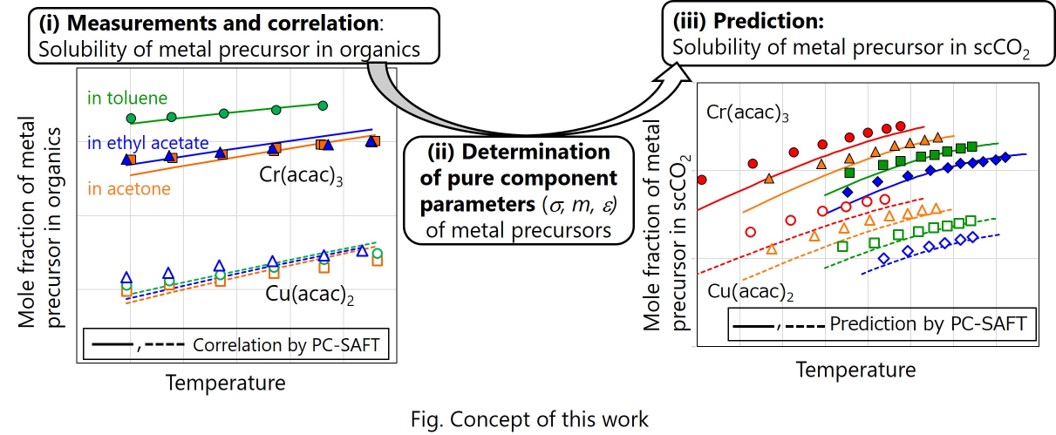
Alanine condensation in high temperature and high pressure water were performed by molecular simulation and flow-type experiment to investigate catalytic role and solvation effect of water. Relative energies of the species consisting alanine condensation and corresponding transition structures were optimized by geometry optimization with B3LYP/6-31+G(d,p) level of theory. We considered four selected reaction mechanisms of alanine condensations such as anionic, zwitterionic, cationic, and non-ionic form. We also calculated a water molecule participation onto non-ionic reaction mechanisms to quantify the catalytic role of water. Activation energies considered reaction mechanism were ranged 117 kJ/mol to 190 kJ/mol, while alanine condensation by zwitterionic mechanism showed a lowest activation energy. Activation energies in solution were calculated by the sum of the activation energy from DFT calculation and the solvation free energy from Monte Carlo simulation with the theory of energy representations by Matubayasi and Takahashi. Solvation free energy difference between reactant and transition state indicated that the alanine condensation with zwitterionic mechanism was promoted by high temperature and high pressure water, on the other hand, the alanine condensation by anionic mechanism was inhibited by water as reaction media. This solvation effects by solvation free energy difference did not have great influence on activation energy due to the solvation effect contributed around 10% to activation energy. The temperature dependence of alanine condensation by means of the flow-type experiments was indicated the second-order reaction and the activation energy was 48.5 kJ/mol. Future investigations on ionic mechanism of alanine condensation are needed to elucidate the catalytic role of water molecule and solvation effect of water as reaction media. The solvation effect of high temperature and high pressure water on alanine condensation should be responsible for the preferential solvation around reaction species, which would be shown by the analysis of solution structure in the presentation.
We developed non-polarizable force field for ionic liquids by using first-principles calculations based on density functional theory(DFT). The cation is 1-alkyl-3-methyl-imidazolium, N-metyl-N-proylpyrrolidinium, and N-butyl-N,N,N-trimetylammonium. The counter anions are chloride, tetrafluoroborate, bis(fluorosulfonyl)amide, and bis(trifluorosulfonyl)amide. The DFT calculations were implemented with the QUICKSTEP of CP2K[1]. The PBE-type generalized gradient approximation was employed for the exchange-correlation functional. The atomic charges assigned in the nonpolarizable force field were evaluated with the Blöchl method[2]. The initial van der Waals parameters were set to OPLS model developed by Lopes et al.[3], and they were optimized to reproduce the intermolecular forces obtained with DFT calculation. We performed the molecular dynamics calculations in the framework of the optimized molecular force fields, and evaluated transport coefficients with Green-Kubo formulae.
The calculated transport coefficients with only the update of atomic charges remain less accurate. The accuracy is also imbalanced between viscosity and electrical conductivity. In contrast, the fully-optimized force field including van der Waals parameters provides good agreements for them with the experimental data, and moreover, the obtained accuracy is consistent over the various ionic liquids. Therefore, it turns out that the suggested optimization scheme of non-polarizable force field is useful to predict transport properties of various ionic liquids. In this oral presentation, the detail strategy of force-field development and the calculated structural/transport properties will be explained.
[1] CP2K, version 4.1, The CP2K Foundation, Zürich, 2014.
[2] P. E. Blöchl, J. Chem. Phys. 103, 7422 (1995).
[3] N. C. Lopes, J. Deschamps, A. H. Padua, J. Phys. Chem. B 108, 2038 (2004).
Ionic liquids are salts with melting points below ambient temperatures. They are nonvolatile and nonflammable and solve various chemicals by chemical modifications. Ionic liquids have attracted much attention as potential gas absorption media. In order to use ionic liquids for the chemical processes involved with gas absorption, the understanding of the gas absorption property and mechanism is of primarily importance. This talk presents some of highlight data on gas absorption in the ionic liquids.
CO2 absorption property and mechanism were investigated for ionic liquids based on the cations 1-ethyl-3-methylimidazolium ([emim]+), N,N-diethyl-N-methyl-N-heptyl-ammonium ([N1227]+), N,N-diethyl-N-methyl-N-(6-hydroxy)hexyl-ammonium ([N122,6OH]+), and dodecyltributylphosphonium ([P444,12]+) and the acetate anion ([AcO]-). Each ionic liquid absorbed CO2 chemically and desorbed it reversibly. The largest CO2 solubility and temperature dependency at 313.2 K were observed in [emim][AcO] and [N122,6OH][AcO], respectively. The 13C NMR spectra revealed that CO2 was absorbed in ionic liquids with different absorption mechanisms, namely, the CO2-carbene ([emim][AcO]), CO2-alkoxide ([N122,6OH][AcO]), CO2-acetate ([N1227][AcO]), and CO2-phosphineylide ([P444,12][AcO]) complexes.
We measured high-pressure CO2 solubilities in [emim]+ ionic liquids with [AcO]-, 2-methoxyethoxyacetate ([C1OC2OC1CO2]-), and 3-(2-methoxyethoxy)propionate ([C1(OC2)2CO2]-) to investigate the effect of ether modification on the CO2 physical and chemical absorption. We success fully deconvoluted the high-pressure CO2 solubility into the contributions of physical and chemical absorption. The validity of this numerical analysis was quantitatively confirmed by the NMR spectra for the [emim][[AcO]+CO2 mixtures at high pressures, which can separately identify the chemical and physical species. According to the deconvolution results, the 2-methoxyethoxy group improved the physisorption (in mole fraction) and worsened the chemisorption compared to the unmodified acetate, whereas the negative effects on both the absorptions (in mole fraction) were observed by the 2-methoxyethoxymethyl modification.
I will talk also about the NH3 and water vapor absorption in the ionic liquids in the presentation.
Poly(ethylene-co-vinyl acetate) (EVA) has been used as a commodity material because of the controllability of its properties such as rubber elasticity, adhesiveness, or transparency by changing comonomer vinyl acetate (VA) content in EVA. Since EVA polymers are commercially produced by a solution polymerization method in EVA solution including monomer VA and diluent alcohol, phase equilibria of the EVA solutions at EVA production conditions are important.
This study has conducted the measurements of the phase equilibria for ethylene + ethanol + VA + EVA quaternary system at temperatures from 313 K to 403 K and at pressures up to 25 MPa. In the measurement, the EVA composition in the solution was kept at 10 wt% while ethanol/VA ratio was changed. Vapor-liquid equilibria were observed in lower pressure region and liquid-liquid equilibria appeared in higher ethylene concentration. It was also observed that increasing ethanol/VA ratio causes bubble point pressure (BP) increase and cloud point pressure (CP) decrease at higher temperatures. In addition, experimental results were compared with ethylene + methanol + VA + EVA quaternary systems [1]. It was found that BP and CP for ethanol systems were lower than that of methanol systems.
PC-SAFT [2] was applied to represent the phase equilibria of the quaternary system. Vapor-liquid equilibria of each binary system were correlated with the PC-SAFT to determine binary interaction parameters. Prediction results of phase equilibria for the quaternary system are shown in Fig. 1, showing relatively good results for PB but shift to higher pressures for CP at given composition.
[1] T. Nakamura et al., Fluid Phase Equilibria, 429 (2016)98.
[2] F. Tumakaka, G. Sadowski, Fluid Phase Equilibria, 217(2004) 233.
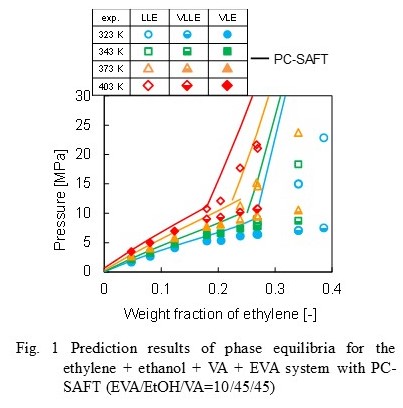
Deep eutectic solvents (DESs) are now widely acknowledged as a new class of solvents like ionic liquids (ILs) because they share many characteristics and properties with ILs. DESs generally have low vapor pressure and non-flammability, and their physicochemical properties are optimized. Then, DESs can be conveniently prepared by simply mixing a hydrogen bond donor (HBD) and acceptor (HBA) with a suitable composition. CO2 solubilities in DESs as reported in literature have been limited to hydrophilic ones and, to the best of our knowledge, hydrophobic DESs have not been systematically studied as potential solvents for CO2 capture [1].
In the present study, we have investigated the density, viscosity, and CO2 absorption behaviour of deep eutectic solvents (DESs), composed of halogenated onium salt (tetrabutylphosphonium bromide) and carboxylic acids (hexanoic acid or octanoic acid) at a 1 : 3 molar ratio (TBAC3HA or TBAC3OA). The densities and viscosities were determined at temperatures from 273.15 to 363.15 K and at atmospheric pressure. The CO2 solubilities in DESs and their saturated densities were measured at 313.15 K and pressures up to 8 MPa. The molarity of the CO2 solubilities were calculated from the experimental results. The experimental density was correlated by a quadratic equation. The viscosity data were represented fairly well by the Vogel-Fulcher-Tammann (VFT) equation. The CO2 solubilities increased with increasing pressure as observed for the typical physical absorption behaviour. The TBAC3HA and TBAC3OA gave higher CO2 solubilities than the ethylene glycol-based DES (TBAC3EG).
Reference
[1] L. F. Zubeir et al., J. Chem. Eng. Data, 63, 913-919 (2018).
Polymers have many excellent properties such as light-weight, electrical insulation and flexibility. Therefore, they are widely used as important parts in the industrial fields, especially, electronic industry. Recently, the thermal management inside the advanced electronic devices becomes more important because downsizing of the device proceeds with remaining high performances. However, thermal conductivities of polymers are generally quite low. Therefore, the addition of high thermal conductive fillers into the polymer matrix is often carried out to increase the thermal conductivity of the polymer materials. In addition to experimental works, theoretical studies are important to obtain the values in a wide range of the condition and to understand the fillers' configuration inside the polymer matrix. In the present study, the theoretical studies were carried out mainly using Hamilton-Crosser model to investigate the aggregation and orientation behaviors of the fillers. We focused on the hexagonal boron nitride/polyimide composites. By adjusting the configuration parameter in the Hamilton-Crosser model, the relationship between the effective thermal conductivity and possible configuration of the boron nitride particles was obtained.
Random laser action, resulting from the multiple scattering of light, can be observed in dye-doped nematic liquid crystals (NLCs). The intensity of random laser emission can be controlled by electric, thermal and magnetic stimuli, however, the magnetic control needs very strong magnetic field because the magnetic anisotropy of LC molecule is low. Recently, ferromagnetic NLCs (FNLCs) was reported; ferromagnetic nanoplatelets (MNPs) dispersed in an NLC are oriented in the same direction as the nematic director, which can be reoriented by very weak magnetic field by virtue of the ferromagnetism. Here, we report magnetic-field-induced change of the random laser action in dye-doped FNLC (DDFNLC). Dye-doped NLCs (DDNLCs) were prepared by doping nematic liquid crystal, E7, with 0.3 wt% of Pyrromethene 597 as a laser dye. A suspension of 0.6 wt% MNPs in 1-buthanol was mixed with DDNLCs. The mixture was kept at 70 °C for 24h to evaporate 1-buthanol to give DDFNLCs with 0.1 wt% of MNPs. DDNLCs and DDFNLCs were injected into homeotropic alignment cells. The samples were optically pumped by pulsed laser at 532 nm and the emission spectra were measured at different magnetic field intensities. Without any magnetic fields, no random laser action occurred. Laser action started from about 10 mT and 140 mT of magnetic fields parallel to the cell surface for DDFNLCs and DDNLCs, respectively (Figure). The random laser is likely to emit perpendicularly to the nematic director; in fact, in a magnetic field parallel to the cell surface, the nematic director in a homeotropic in an alignment cell rotates to the direction parallel to the cell surface and the random laser emission is switched on. Moreover, we can conclude that the addition of MNPs lowers the threshold magnetic field of the random laser action to about one tenth.
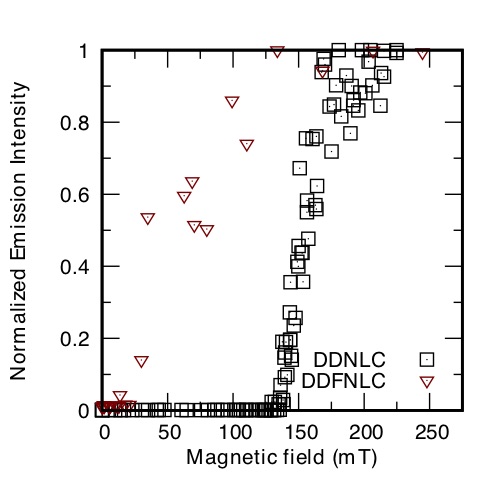
Studies on chloric behavior in high temperature processes (such as pulverized coal firing, waste burning and iron ore sintering) are important because volatile noxious compounds can be generated. For example, when heating coal to achieve burning and gasification, pyrolysis occurs first, volatile components are released and chlorine in coal is reported to be desorbed as HCl in this process. In addition, HCl is generated by the incineration of waste and then reacted to generate dioxins and chlorinated benzene. For blast furnace pig iron, some chlorine is captured into the solid-phase coke during the process of exhaust gas treatment at low temperatures. Our research group has previously studied the adsorption of HCl by Zn-doped O2-activated resins at 100 and 300 °C. It was clarified that a Zn-doped carbon compound adsorbs HCl much more than a carbon compound at 100 and 300 °C. However, the kind of reaction site and influence of metal on carbon active site have not been clarified with respect to the metal-doped carbon active site and the adsorption stability of HCl. Also, no research has focused on this point. In this study, electronic states of three carbon active site models (Armchair, Zigzag and Tip sites) before and after Zn doping were calculated by molecular orbital calculation (RHF/6-31G*). Calculation results of molecular orbital method for molecular models of carbon and Zn-doped carbon materials suggested that the presence of Zn may increase the number of chemisorbed sites for HCl molecules. In addition, it was estimated that ZnO does not contribute to the adsorption stability of HCl on the Zigzag sites. It has also been clarified that ZnO greatly affects the electronic state of the whole carbon material. In the future, this study makes it possible to propose a method to inhibit the generation of volatile hazardous compounds in high temperature processes.
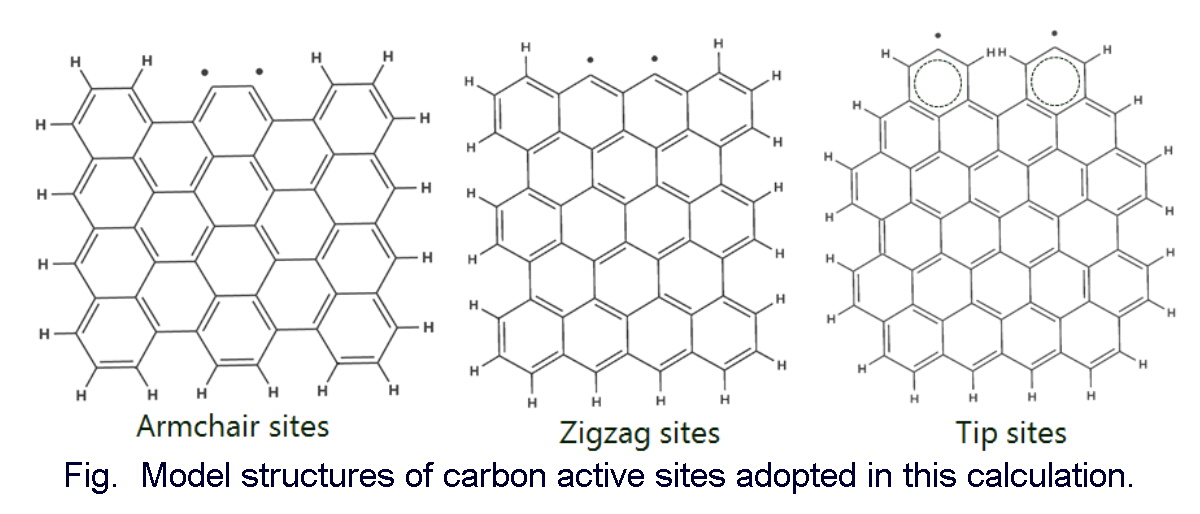
Liquid crystalline (LC) elastomers are very promising functional materials providing unique properties by coupling of "dynamic property of polymer networks" and "anisotropy of LC phases (such as orientation order of LC molecules)" [1-3], and thereby these materials are applicable to artificial muscles and soft actuators in the field of a variety of robotics. In this study, we demonstrate the spherical LC elastomers responsive to an electric field as micro size actuators. In addition, the creation of the spherical LC elastomers containing dual frequency LCs of which the dielectric anisotropy can be controlled by the frequency of AC field was newly investigated by using a flow focusing device (Figure 1). Then, the influence of the amounts of the LC molecules and the crosslinkers in the precursors on the deformation amounts of the elastomers was also discussed at the given frequencies of the applied AC fields.
The phase transition behavior of the elastomers was identified by polarized optical microscopy and differential scanning calorimetry. The results revealed that the elastomers exhibited a LC phase below 60 °C.
Acknowledgements
This work was financially supported by the Kyoto Technoscience Center and Murata Science Foundation.
References
1. T. Ikeda, J. Mamiya, Y. Yu, Angew. Chem. Int. Ed., 2007, 46, 506-528.
2. H. Yang, A. Buguin, J.-M. Taulemesse, K. Kaneko, S. Méry, A. Bergeret, P. Keller, J. Am. Chem. Soc., 2009, 131, 15000-15004.
3. K. Urayama, E. Kohmon, M. Kojima, T. Takigawa, Macromolecules, 2009, 42, 4084-4089.
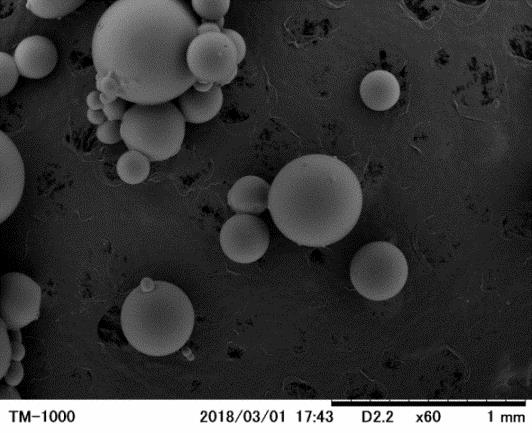
Amphiphiles having different hydrophobic chains (such as fluorocarbons and hydrocarbon chains) often exhibit unusual interface properties and liquid crystal behavior. To generate a new drug release function of liquid crystals, this study synthesized amphiphiles having oxyethylene units and thermotropic liquid crystal mesogens (i.e. cyanobiphenyl and biphenyl groups) in the hydrophobic two chains (CB-B2ES and HB-B2ES, respectively) and a CB-B2ES analogue without oxyethylene units (CB-DeS). Then lyotropic liquid crystal behavior of the amphiphiles in water was investigated as functions of temperature and elapsed time. Figure 1 shows chemical structures of amphiphiles and polarized micrographs for 30 wt% amphiphile / water mixtures at 30 °C at different elapsed times after preparation. Mixtures containing CB-DeS, CB-B2ES and HB-B2ES displayed maltese cross textures, suggesting formation of a lamellar liquid crystal. Lamellar liquid crystals in the CB-DeS / water mixture were stable and showed no morphology change without applying external forces or change in experimental condition. However, in CB-B2ES and HB-B2ES / water mixtures, lamellar aggregates displayed dynamic formation/breakdown behavior with elapsing time at a constant temperature. Namely, after preparation of fresh mixtures, population of maltese cross textures gradually increased but suddenly all the textures disappeared in a few min. The time to start the maltese texture breakdown for CB-B2ES was ~30 min at 30 °C, longer than that for HB-B2ES. It probably results from the higher stability of CB-B2ES lamellar LCs by additional electrostatic interaction between cyanobiphenyl groups. In addition, there were no change in 1H-NMR spectra before and after the texture breakdown. It suggested that the texture breakdown was not caused by decomposition of the surfactants. The dynamic liquid crystal behavior of the texture breakdown was expected to happen by phase transition from lamellar to another isotropic phase with elapsing time.
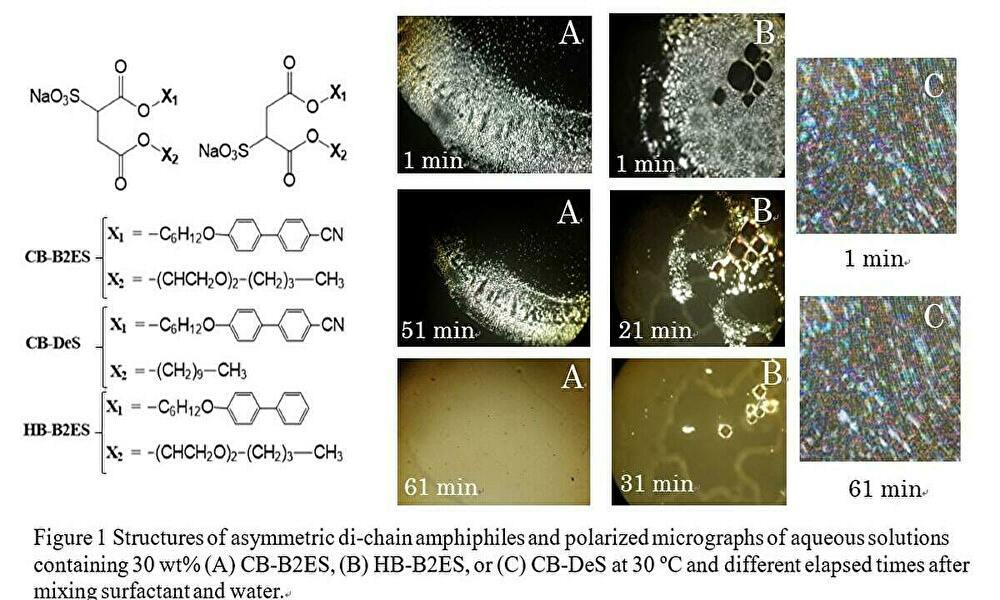
Clathrate hydrate of tetra-n-butylammonium bromide (TBAB) is expected as a cold storage material for air conditioning, but supercooling is a problem for practical use. The supercooling, widely known, is the state of maintaining the liquid phase even if it is cooled below freezing point, but the detailed mechanism is not clarified. For the purpose of visualization of the supercooling phenomenon, both the structures of TBAB clathrate hydrate and TBAB aqueous solution were observed. In general, although scanning electron microscope (SEM) is widely used in the observation of micro- or nano-size objects, it had not been possible to observe such as a solution or a gel directly since the inside of the SEM is under a high vacuum. Therefore, SEM observation was performed by a freeze fracture replica method. Freeze fracture replica method is utilized not only in medicine and biology fields but also in various fields since it is possible to obtain both of the information of a solution itself and the state of particles having a microstructure simultaneously. Specifically, cut-surface of the quenched sample was prepared and thin film is fabricated on the cut-surface. And by soaking it in an appropriate solvent, the thin film and the sample were separated to recover a replica film reflecting the morphology of quenched cut-surface. Finally, the replica film was observed by SEM.
In this study, we tried to observe the solution structure in the process of crystallization and melting of TBAB supercooled aqueous solution. Further, in actual use of a cold storage material, a hysteresis phenomenon (called a memory effect) accompanying a thermal history often becomes a problem. The memory effect was also investigated in relation to the solution structure by another analysis methods other than the freeze fracture replica method. The characteristics of the memory effect were clarified according to various analysis methods. We are going to discuss the results.
Here, we investigated the phase equilibria of the methane hydrate containing organic inhibitors (methanol; MeOH and ethylene glycol; MEG) and ammonuium chloride (NH4Cl). Conventional isochoric trace method to identify the equilibrium temperatures and pressures for methane hydrates with mixed inhibitor system was used, and two groups of mixed inhibitor solutions: (1) 5 wt% NH4Cl + 10 wt% MEG, 5 wt% NH4Cl + 20 wt% MEG, 10 wt% NH4Cl + 10 wt% MEG, 10 wt% NH4Cl + 20 wt% MEG aqueous solutions, and (2) 5 wt% NH4Cl + 10 wt% MeOH, 5 wt% NH4Cl + 20 wt% MeOH, 10 wt% NH4Cl + 10 wt% MeOH, and 10 wt% NH4Cl + 20 wt% MeOH aqueous solutions, were prepared. The phase equilibrium conditions of methane hydrates containing MEG/MeOH and NH4Cl solutions are located at lower temperature and higher pressure conditions than those of pure methane hydrate. In addition, as the concentration of MEG/MeOH and NH4Cl increase, the hydrate equilibrium conditions of methane hydrates are further shifted into left regions (lower temperature and higher pressure conditions). The hydrate inhibition performance of our mixed inhibitor system is in the following order; (10 wt% NH4Cl + 20 wt% MeOH/MEG) > (5 wt% NH4Cl + 20 wt% MeOH/MEG) > (10 wt% NH4Cl + 10 wt% MeOH/MEG) > (5 wt% NH4Cl + 10 wt% MeOH/MEG). After all, we calculated the dissociation enthalpies of methane hydrates containing mixed inhibitor solutions using the Clausius-Clapeyron equation, which fits well with the experimental data.
KEYWORDS : methane hydrate, phase equilibria, thermodynamic hydrate inhibitor, ammonium chloride
Methane hydrates vastly deposit in deep sea around Japan, and expected as one of unconventional natural gas resources. The depressurization method is being developed for methane gas production from subsea methane hydrates. Methane hydrates are only stable at high pressure and low temperature conditions. In the depressurization method, a pipe equipped with depressurization pump is inserted into the subsea methane hydrate layer. When the methane hydrate layer is depressurized by the pump, the methane hydrates dissociate to gas and water. When the well pressure returned to be seawater head pressure by an accident or during operation stop, the methane hydrates may reform and plug the flow channel in the well. As a solution to dissociate the hydrate blockage, injection of a thermodynamic hydrate inhibitor (THI) into the well is effective, because the THI can melt the methane hydrates by shifting equilibrium curve toward lower temperature, in other words, freezing point depression. In this study, as a part of a Japanese National hydrate research program (MH21, funded by METI), we demonstrate methane hydrate dissociation by injection of urea which is expected for environmentally-friendly THI. In combination with urea, we used kinetic hydrate inhibitors (KHIs) or promoters such as polyvinylpyrrolidone (PVP) and sodium dodecyl sulfate (SDS). The experiments were carried out in the rocking cell equipped with three glass windows. The cell was rocked to facilitate mixing of the fluids and solids inside the cell. Methane hydrates were first formed at 13 MPa and 278 K in the cell. A THI solution was stepwise injected into the cell to dissociate the hydrates. The dissociation behavior was recorded by a CCD camera. We tested a couple of different solutions of THI and the kinetic inhibitors/promoters. The present results suggest that there is a synergetic effect on the hydrate dissociation by combinations of urea and inhibitors/promoters.
Separation and recovery technologies for carbon dioxide (CO2) are needed to address global warming. Semi-clathrate hydrates (SCH) with tetra-n-butyl ammonium bromide (TBAB) are attractive as CO2 separation media, because they can be simply regenerated and reused. Although SCH as slurries can possibly be applied to continuous separation processes, the reasons for their rheological properties being Bingham fluid or pseudo-plastic fluids are unknown and are important for their practical application. In this work, the objective was to investigate the relationship between the SCH crystal morphology and flow characteristics of SCH hydrate slurries so that the fundamental basis for their rheological properties can be understood. The shape of SCH crystals in the slurries was changed by time maintained super-cooling after crystal formation, defined as the overcooling time. Initial TBAB concentration was 10.4 wt% in the TBAB aqueous solution before the hydrate slurry formation and experimental temperature was 278.5 K. The solid fraction (v/v) in the slurry was 0.12. The viscosities of the SCH slurries were measured with a rotational viscometer and results were analyzed with Herschel-Bulkley's model. Least-squares and mathematical optimization were used to determine viscosity index, fluid consistency coefficient and yield shear stress. Size and shape of SCH crystals were characterized with microscopy and particles were found to be needle-like and granular without overcooling time, and were only granular with an overcooling time of 30 min. The fluid behavior of the SCH slurry was only Bingham fluid with an overcooling time of 30 min. Therefore, the shape of the SCH crystals in the slurry was found to influence the rheological behavior of the slurries and their flow characteristics.
Biogas is a resource that has been proposed to provide carbon neutral energy and reduce CO2 emissions. However, biogas typically contains numerous impurities such as carbon dioxide, water and hydrogen sulfide, and these impurities must be removed before processing the mixtures with present technologies. Semi-clathrate hydrates (SCH) are attractive as gas separation media in biogas systems, because they are unaffected the presence of most impurities, however, there are issues related to their theoretical loading (adsorption amount). For tetra-n-butyl ammonium bromide (TBAB) semi-clathrate hydrates, it has been reported that CO2 absorption amount was much lower than theoretical values at TBAB concentrations above 1.5 mol%. The hypothesis explored in this work is that CO2 is not sufficiently absorbed in SCH slurries due to SCH crystal aggregation. The objective of this work was to investigate how to increase CO2 absorption amount in TBAB SCH slurries through experiments with a bubble column reactor. SCH slurries were loaded in the column, and gas mixtures were flowed through a filter from the bottom of the column. Loaded TBAB concentration was 0.55 mol%, experimental temperature was 278.2 K and experimental pressure was 0.8 MPa. Gas mixtures of He and CO2 were used in which initial CO2 composition was 0.20. The CO2 absorption amount was 1.86 mmol-CO2/mol-H2O. Occupancy of CO2 in SCH estimated from this result was 0.04. However, theoretical CO2 occupancy with a thermodynamic model was estimated to be 0.13, which indicates that the CO2 was not sufficiently absorbed by the SCH. The amount of hydrate in the slurry increased gradually as CO2 was absorbed into the slurry and CO2 tended to be enclathrated mainly in the inner cages of initial SCH particles. Thus, SCH formation in the initial stages of gas absorption is important for increasing the amount of gas absorbed into the slurry.
Natural gas is a growing energy source due to the less emission of carbon dioxide than other fossil fuels such as coal and oil. Various materials and methods have been investigated so far for effective separation, transportation, and storage. Among the options, gas hydrate has recently been received great attention due to its theoretically promising storage capacity and separation function. To evaluate the potential of gas hydrate as natural gas storage media, however, the fundamental thermodynamic properties should be fully investigated, particularly elucidating its distinct characteristics of cage occupation behavior of natural gas molecules. In this study, we investigated the binary gas hydrate containing trimethylene oxide (TMO) and CH4 molecules focusing on the distinct host-guest interactions between water cages (host) and guests (TMO and CH4). Pressure-temperature phase equilibria were measured. In addition spectroscopies such as synchrotron High Resolution Powder Diffraction (HRPD), Dispersive Raman, and 13C solid-state Nuclear Magnetic Resonance (NMR) were employed. The results indicated that the thermodynamic stability of TMO + CH4 hydrate was higher than that of pure CH4 hydrate. Particularly, structure II type gas hydrate was mainly formed at the concentrations of TMO below 5.56 mol%. When the ratio of water to TMO was 17: 1, abnormal tuning phenomenon was also observed. The cage occupancy of CH4 molecules in TMO + CH4 hydrate was significantly enhanced.
Light perovskite-type hydrides show great potential for hydrogen storage. Using density functional theory (DFT) modeling, all possible perovskite-type hydrides ABH3 (alkali metals A = Li, Na, K, Rb, or Cs, alkaline metals B = Be, Mg, Ca, Sr, or Ba) have been investigated to explore the structural stability and hydrogen release properties. The formation enthalpies and reaction enthalpies for hydrogen release were calculated based on the optimized experimental and hypothetical structures. The most favorable dehydrogenation pathways were obtained for all ABH3 systems studied. In addition, NaCaH3 was screened to be as one of the most promising material to store hydrogen among these perovskite-type hydrides. To facilitate the hydrogen release of NaCaH3, the dopants including alkali metals (Li, K, Rb, or Cs) and alkaline metals (Be, Mg, Sr, or Ba) were introduced to replace the Na and Ca sites in NaCaH3 structure, respectively. The reaction enthalpies of doped-systems were calculated by different dehydrogenation pathways. Among all dopants examined, the Cs was the most beneficial dopant for the dehydrogenation of NaCaH3 with the lowest energy required. However, there is no useful on hydrogen release using alkaline dopants in NaCaH3 system. Overall, for future experiment and theoretical work, these studies can provide valuable model to design new promising perovskite-type hydrides for hydrogen storage.
In this study, investigated the evaluation of ultrafine bubble (UFB) with diameters of 1 μm or less, which are important among fine bubble (micro / nano bubble) studies, using hydroxy (OH) radicals and sonoluminescence generated by the collapse of UFB when ultrasonic waves are applied to UFB. First, electron spin resonance (ESR) and potassium iodide (KI) techniques were used for the evaluation of OH radicals. From the measurement results of ESR, it was confirmed that OH radicals were generated by the collapse of UFB. Also, since the KI method stabilizes iodine dissociated from KI as I3- with an absorption wavelength of 355 nm when OH radicals are present, the generated OH radicals can be evaluated by measuring the absorbance of this I3- with a spectrophotometer. However, when air is used as an internal capsule gas, the observation of OH radicals generated by the collapse of UFB has been difficult to evaluate by the KI method because the difference in absorbance is very small. Therefore, distinct absorbance differences could be confirmed by increasing the amount of OH radicals generated by the collapse of UFB by using ozone as the inclusion gas. Furthermore, it was confirmed that the higher the frequency of ultrasound, the greater the difference in absorbance (Fig). On the other hand, sonoluminescence measurements confirmed the luminescence phenomenon with respect to UFB collapse by ultrasound, and further confirmed that the luminescence intensity of water with the addition of the same number of inorganic particles as UFB was smaller than that of UFB water. Since differences in experimental results were confirmed by the presence or absence of UFB in these multiple experiments, evaluation of UFB using OH radical as an index using ultrasound can be expected.
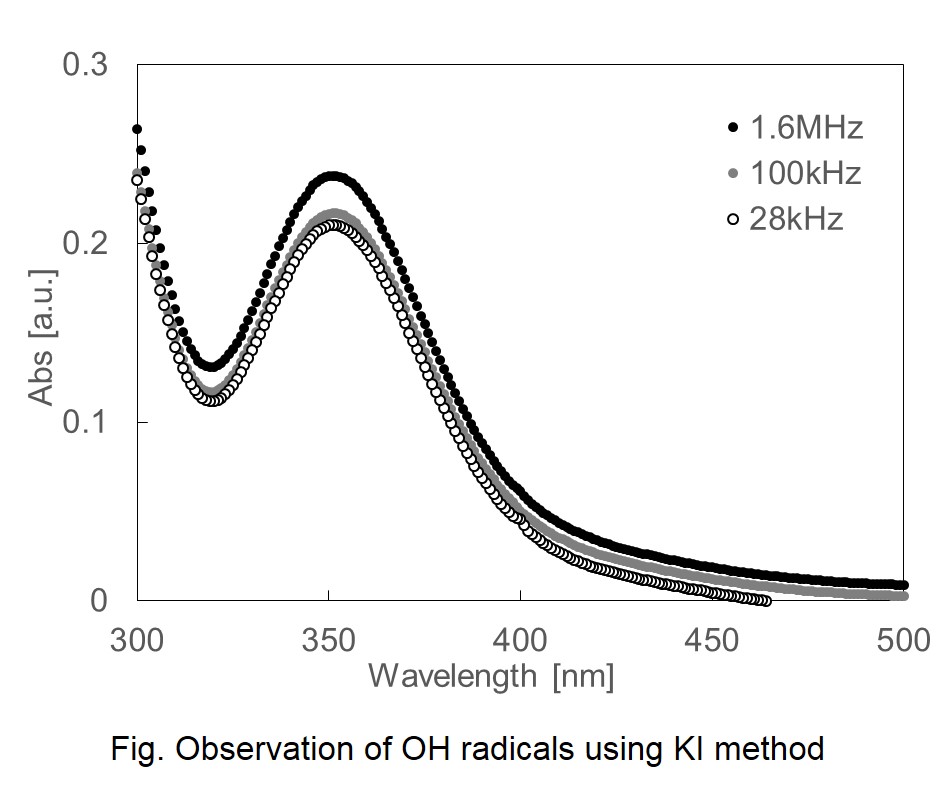
Friction is fundamental phenomena in various mechanical process. Therefore, better understanding of friction behavior from atomistic scale is significantly important. Conventionally, a flat metal surface has been used in the molecular dynamics for investigation of friction behavior. However, in the realistic system, a irregular morphology of the surface plays an important role for friction dynamics. Such surface modeler requires a lot of computational power in the molecular modeling, which becomes issue for application of molecular dynamics. In this paper, a novel molecular dynamics method will be presented for the modeling of friction behavior with less computational time.
Quartz is an important crystalline solid and its wettability plays an essential role in affecting various production processes. However, less attention has been paid to the crystal face related wetting behavior. In the present work, with the contact angle goniometer and the atomic force microscopy (AFM), the wettabilities of different faces of quartz were studied by measuring the contact angles between several solid-liquid pairs at both macroscopic and microscopic scale. The solid substrates investigated include (001), (100) and (110) faces of quartz, and the test liquids are water, glycerol and phosphoric acid (85 wt%). The results obtained show that the solid-liquid contact angles, which were measured by optical goniometer and AFM, are nearly identical, indicating that both methods are reliable, although the optical goniometer measured the contact angle at macroscale and the AFM yielded results at nanoscale. For the three faces of quartz tested, the contact angles become greater in the order of (001), (110) and (100), although the change in contact angle of phosphoric acid is more obvious than those of water and glycerol. In order to explain the effect of the crystal faces on the contact angles, the molecular dynamic simulations were conducted to investigate the wetting characteristics of water droplets on (001), (100) and (110) faces of quartz. The simulation results demonstrate that the surface densities of unsaturated silicon atoms and the first-layer water molecules on the crystal faces are all in accordance with the order of (001) > (110) > (100), which is in the exact opposite order of the contact angles that were obtained in the experiments. Therefore, it can be inferred that the differences in the surface atomic arrangements and the surface density of unsaturated silicon atoms are the intrinsic causes of the wettability differences between quartz faces.
Supramolecules such as micelles are used as various functional materials. These functionality is dependent on the amount and/or type involved in the interaction of supermolecules, it is mainly expressed in the aqueous solution. Therefore, we have to understand the 3D structure of supramolecule in aqueous solution, and their information play important role to create a novel functional material. In our recent study, we reported about the analysis of calix[4]arene-based micelle by using various experimental methods. Calix[4]arene-based surfactants showed that they are monodisperse with a defined aggregation number whose values are chosen from the face number of Platonic solids. We named it “Platonic Micelle”. Small-angle X-ray scattering (SAXS) provides nanoscale information about size and shape for disperse particle. However, it is difficult to understand a detail of the 3D configuration of the aggregate of the molecule forming the Platonic Micelle with only SAXS. Then, we considered that the 3D configuration of Platonic Micelle is able to understand by combination of the computational chemistry method and SAXS. The Platonic Micelle consisting calix[4]arene-based surfactant having four alkyl tails and four head groups were examined by SAXS and computational chemistry methods mainly using molecular dynamics (MD) simulation, molecular orbital method and CRYSOL program. CRYSOL program is able to provide a theoretical value about scattering. On the hands, a dynamics of Platonic Micelle can be analyzed with MD simulation. 3D configuration of Platonic Micelle was estimated by comparison between SAXS result and theoretical curve calculated in CRYSOL program by using 3D coordinates obtained in the process of MD simulation.
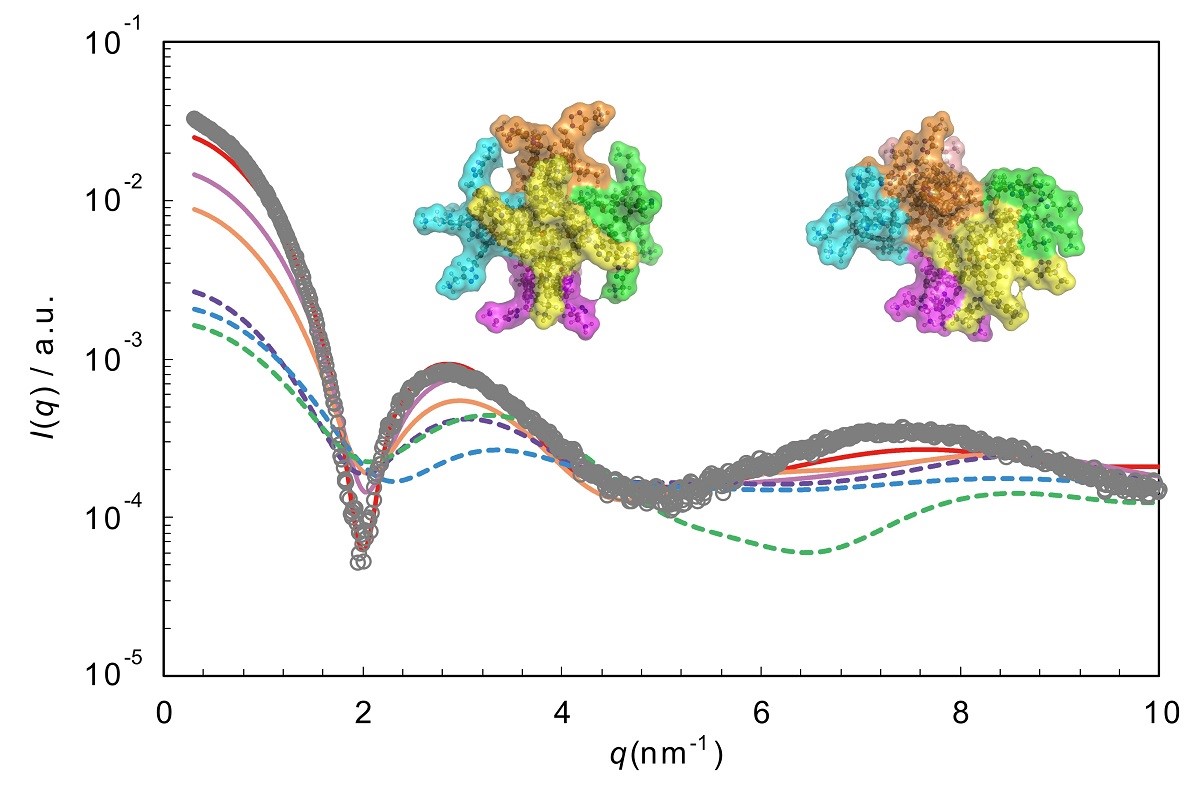
Several investigations have been reported on the phase behavior of ionic liquid (IL)+alcohol mixtures. For example, a 1-ethyl-3-methylimidazolum bis(trifluoromethanesulfonyl)amide ([C2mim][TFSA])+2-propanol mixture shows upper critical solution behavior. The critical temperature and critical mole fraction (xIL) of IL for the [C2mim][TFSA]+2-propanol mixture are 292.2 K and xIL = 0.149, respectively. However, the transport properties of IL+2-propanol mixtures, such as viscosity, electrical conductivity, and self-diffusion coefficient, have not been investigated systematically.
In the present study, the self-diffusion coefficients of [C2mim]+ (D+), [TFSA]- (D-), and 2-propanol (D2-pro) for the [C2mim][TFSA]+2-propanol mixtures were measured using PFGSE NMR spectroscopy together with the density, viscosity, and electrical conductivity. In Fig. 1, D+/D-, D2-pro/D-, and D2-pro/D+ ratios for [C2mim][TFSA]+2-propanol mixtures at various temperature are plotted as a function of xIL. The D+/D- and D2-pro/D- ratios decrease with decreasing xIL, where the decrease in D2-pro/D- is more remarkable than D+/D-. On the other hand, the D2-pro/D+ ratio does not considerably change. Then, the increase in D- with decreasing xIL is significant compared with D+ and D2-pro. This is probably because [C2mim]+ interacts with 2-propanol more strongly than [TFSA]- in the mixtures. We will give the detailed discussion about intermolecular interactions in the [C2mim][TFSA]+2-propanol mixtures based on the results of the density, viscosity, and electrical conductivity measurements in the presentation.
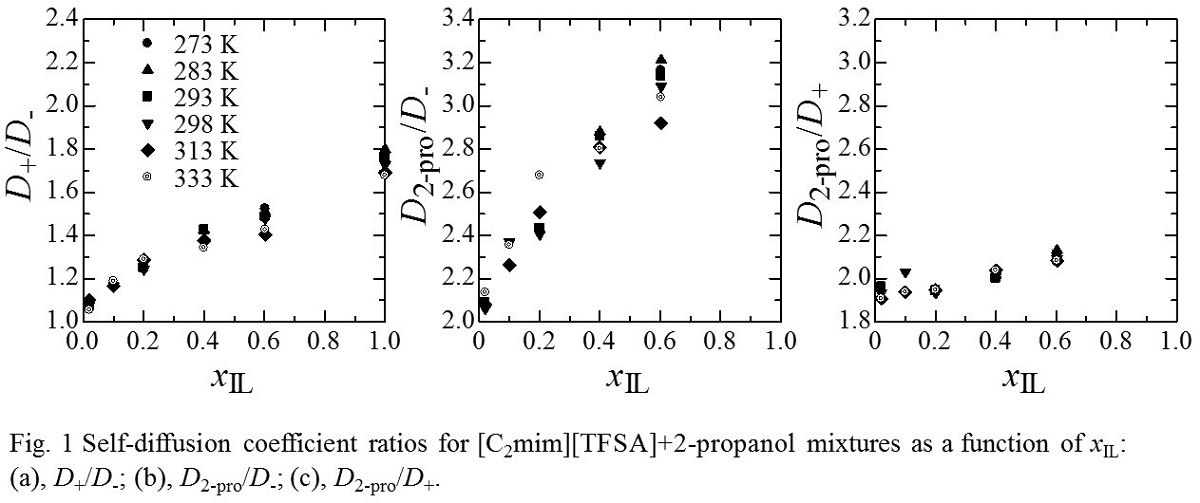
In order to investigate the transport property of ionic liquids, we performed molecular dynamics (MD) simulation by using the non-polarizable force field developed with first-principles DFT calculations. The DFT calculations were implemented with the QUICKSTEP of CP2K[1]. The PBE-type generalized gradient approximation was employed for the exchange-correlation functional. Further information for the optimization scheme will be presented in the oral presentation. The cation is 1-alkyl-3-methyl-imidazolium, N-metyl-N-proylpyrrolidinium, and N-butyl-N,N,N-trimetylammonium. The counter anions are chloride, tetrafluoroborate, bis(fluorosulfonyl)amide, and bis(trifluorosulfonyl)amide. All the MD simulation were implemented by using Gromacs package[2]. Self-diffusion coefficients was evaluated with the Einstein equation and the modification of periodic boundary condition. Viscosity and electrical conductivity were evaluated with the Green-Kubo formulae. The calculated transport coefficients are in good agreements with the corresponding experimental data. Even for several systems based on the same cation or anion, since the molecular charges were updated via first-principles calculation at each thermodynamic states, the effective charges and van der Waals parameters were assigned for the MD simulation. Thereby, the MD simulation in the framework of the present molecular force field is useful to predict transport properties of various ionic liquids. In this poseter presentation, the calculated structural and transport properties will be discussed over the various compositions of ionic liquids including the ternary mixtures.
[1] CP2K, version 4.1, The CP2K Foundation, Zürich, 2014.
[2] Gromacs, version 2016.5, The GROMACS development teams, Sweden 2017.
Ionic liquids (ILs) generally have negligibly small vapor pressure and high thermal and chemical stability. They show higher solubilities of acidic gases such as CO2, H2S, NOx and SOx than neutral gases like N2, H2, and O2. The mixtures of diglyme (i.e. diethylene glycol dimethyl ether) and lithium salts show unique the physico-chemical behavior resembling ILs [1], therefore, they are called as “solvate ionic liquids (SILs)”. Since Aki et al. [2] reported that [TFSA]- is the best anion in the imidazolium salts for CO2 absorption, [Li-diglyme][TFSA] was expected to have the excellent CO2 absorption capacity. The CO2 solubility and calorimetric data are required for the development of the CO2 separation process using SILs.
In the present study, we have investigated the enthalpies of CO2 solution in diglyme and [Li-diglyme][TFSA] (LiTFSA: 10 wt%) at 313.2 K and up to 7.0 MPa using a flow calorimetric technique. The experimental values of the enthalpies were consistent with the calculated ones based on the Henry's constants [3]. Furthermore, the CO2 solubilities were derived from the experimental calorimetric data for diglyme and [Li-diglyme][TFSA]. The CO2 solubilities determined by the present calorimetric approach agreed fairly well with the synthetic approach [4].
References
[1] K. Ueno et al., J. Phys. Chem. B, 116, 11323-11331 (2012)
[2] S.N.V.K. Aki et al., J. Phys. Chem. B, 108, 20355-20365 (2004)
[3] D. Almantariotis et al., Int. J. Greenh. Gas Con., 10, 329-340 (2012)
[4] D. Kodama et al., Fluid Phase Equilib., 302, 103-108 (2011)
Polymers have been widely used for controlled release materials in various fields such as fragrances and medicines. In this work, we have focused on copolymers as controlled release carriers with respect to their controllability of solubility and diffusivity of released solutes by changing copolymer composition as well as by tuning operation conditions. Regarding a solute, CO2 was selected by considering its potential antioxidant effect. We have conducted measurement and correlation the solubility and diffusivity of CO2 in poly (methyl methacrylate (PMMA)) and poly (methyl methacrylate (MMA) / ethyl acrylate (EA)) copolymer. This copolymer shows glass transition temperature, Tg, at 70–130 °C depending on EA content. In addition, Tg is reduced to near room temperature by CO2 dissolution, of which feature is very useful for controlled release design since solubility and diffusivity change drastically around glass transition. The measurement conditions were the temperatures of 10, 25 and 40 °C close to supposed practical conditions of the controlled release material. The measurement results of the CO2 solubility in PMMA increased with increasing pressure, and decreased with increasing temperature. These results indicated that the dissolution of CO2 in this copolymer could be governed by the condensability of CO2. In addition, it would be noted that the CO2 solubility data were correlated fairly well with the Dual-Mode-Sorption [1] in conjunction with the SL-EOS [2, 3].
Now measurements of Tg of this copolymer under high pressure CO2 are on-going with aiming the improvement of solubility/diffusivity correlation near glass transition by introducing Tg value to the correlation model.
References:
[1] N. H. Wang, et al., Kagaku Kougaku Ronbunshu, 2, 226 (1996).
[2] I. C. Sanchez and R. H. Lacombe, J. Phys. Chem., 80, 2352 (1976).
[3] I. C. Sanchez and R. H. Lacombe, Macromolecules, 11, 1145 (1978).
Recently, attention has been focused on a mixed fluid in which carbon dioxide (CO2) is dissolved in an organic solvent, a so-called CO2 expansion liquid. Since this mixed fluid can widely change the solvent characteristics only by pressure operation, its application as extraction of natural products and generation of fine particles has been studied. The equilibrium and/or transport properties such as density, dielectric constant, and viscosity of the mixture change greatly depending on the composition of CO2. So, for industrial process design, it is important to grasp the physical properties of the CO2 and organic solvent mixture. However, the measured data is insufficient at present because physical property measurements under high pressures need a special device and a long time. Therefore, the estimation of physical properties is greatly needed. In this study, the density of uniform fluid mixture under high pressure was focused on, which is the property greatly affected by composition. The density of CO2 and toluene uniform fluid mixture was measured, and the applicability of the three mainstream equations of state to density estimation was evaluated. The density of CO2 and toluene uniform fluid mixture was measured with a high pressure vibration type density meter equipped with a circulation pump and a variable volume viewing cell. The calibration of the density meter was conducted with water and cyclohexane. The measurement was conducted at temperatures from 313.2 K to 353.2 K and pressures up to 20 MPa. CO2 compositions were changed from 0 (pure toluene) to 80 mol%. In density estimation, the Peng-Robinson equation of state as a representative of the van der Waals types, the Sanchez-Lacombe equation of state as a representative of the lattice fluid theory types, and the PC SAFT equation of state as a representative of the statistical associating fluid theory types were used.
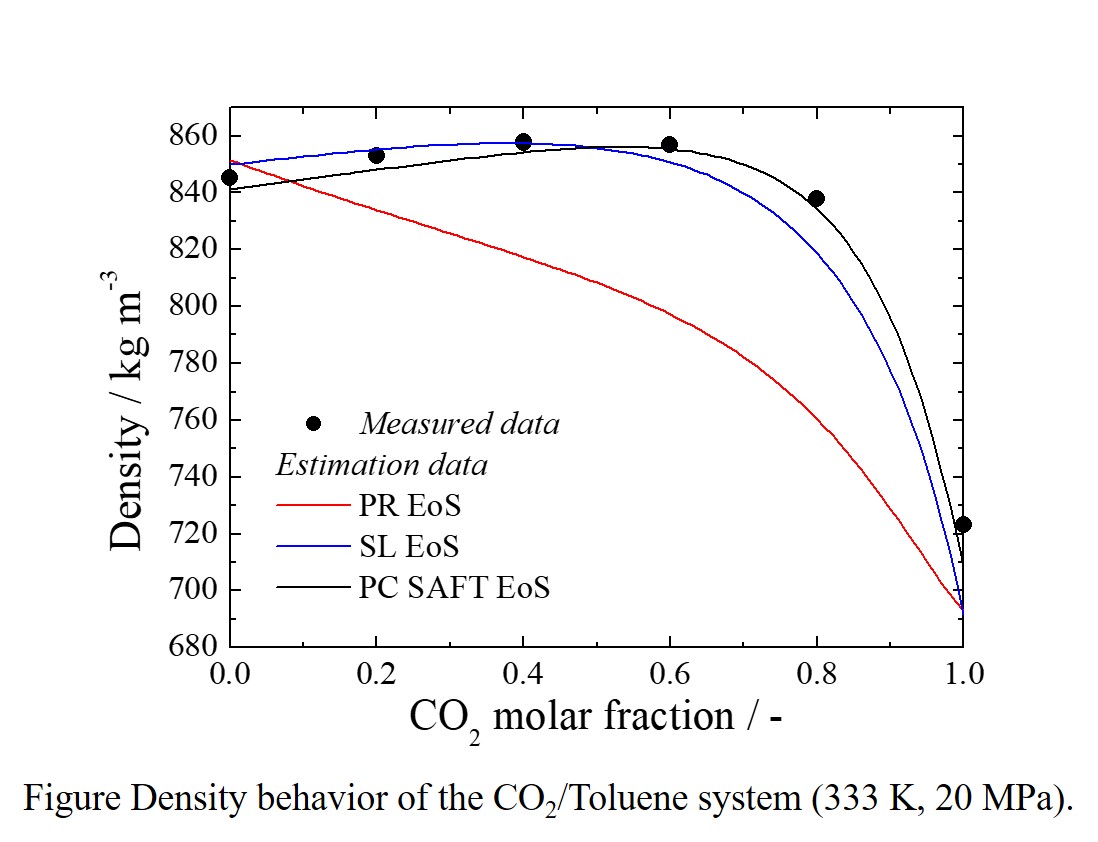
Vitamin K is essential for osteogenesis, and vitamin K deficiency causes osteoporosis leading to hip fracture and coronary disease. Menaquinone-7 (MK-7), one of vitamin K subtypes, is abundantly contained in Japanese traditional fermented food natto. Supercritical carbon dioxide extraction of freeze-dried natto was investigated at 293 K and 313 K at 100 atm, by means of semi-batch flow-type equipments. The extraction rate of the oil from freeze-dried natto was defined as a ratio of the extraction yield to a traditional hexane extraction yield. To improve an oil recovery during the extraction, the collection trap was cooled with brine bath. The extraction yield at lower temperature condition was improved due to an increase of oil solubility. The maximum yield of extracted oil was 158.4% at 293 K and 10 MPa. The qualitative analysis for the extracted oil by UPLC/Q-Tof was performed to identify elemental composition of valuable compounds. The elemental composition analysis was revealed that that the menaquinone-1, 2, 3, isoflavone, and linoleic acid were identified by comparing monoisotopic masses between theoretical and measured values. The time profile of the extraction rate was indicated that the amount of extraction oil increased with the cosumption of carbon dioxide. The time profiles of extraction rate were fitted by simple mathematical model. The time constants of the mathematical model were 0.15 at 293 K and 0.12 at 313 K. The time profile of the mathematical model is comparable with that of supercritical carbon dioxide extraction. The maximum extraction rate would be 180% at 293 K with 23 g/g of carbon dioxide.
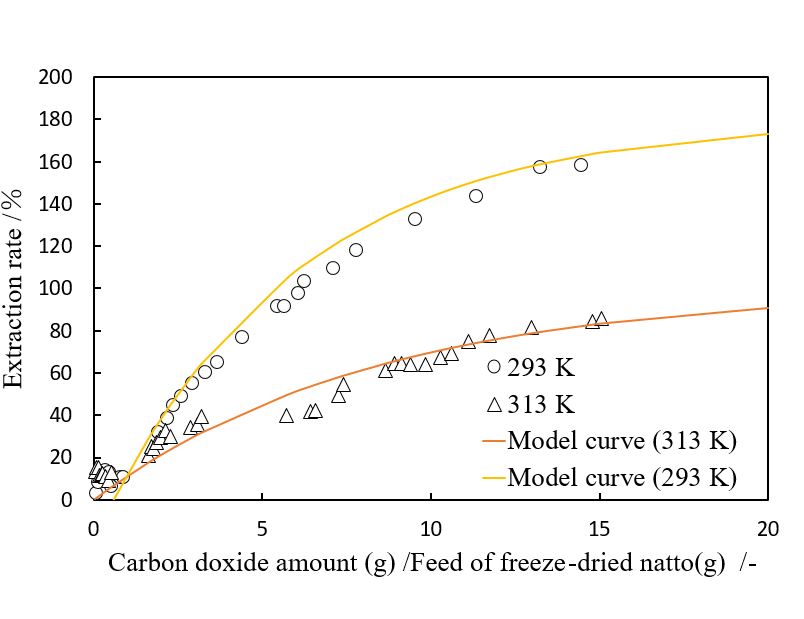
A mixture fluid of CO2 and an organic solvent is expected as a new reaction solvent [1] because its properties can be varied by changing pressure, temperature and/or composition. To use the mixture fluid for industry, fundamental property data in wide pressure and entire composition range are needed. However, reports on diffusion coefficients D1m in mixtures of CO2 and organic solvent are limited [1]. Furthermore, high accurate prediction models for D1m in mixture fluids are not well established. In this research, D1m's of phenol in a mixture fluid of CO2 and methanol under high pressure conditions were measured by the Taylor dispersion method. Moreover, the D1m data measured experimentally were compared to D1m values calculated by the Blanc's equation [1]. Each fluid (CO2 and methanol) was separately supplied by each syringe pump at a constant flow rate to the diffusion column. A methanol solution of phenol was loaded via the injector to the diffusion column. A response signal was obtained at the exit of the diffusion column with a UV-Vis photodiode-array detector. The D1m and velocity u were simultaneously determined such that fitting error, ε, defined by eq. (3), was minimized by changing D1m and u values. D1m decreased with increasing methanol molar fraction because fluid viscosity increased as methanol molar fraction increased. D1m's were predicted by the Blanc's equation defined by eq. (4). The prediction performance for all the data points was lower than 11% in relative deviation Herein, m is the amount injected, R and L are the radius and length of diffusion column, respectively, t is the time, and exp and cal designate experimental and calculation, respectively. x is the molar fraction, and D1A is the binary diffusion coefficient for phenol in A solvent.
[1] T. Funazukuri et al., Fluid Phase Equilib., 164, 117 (1999).
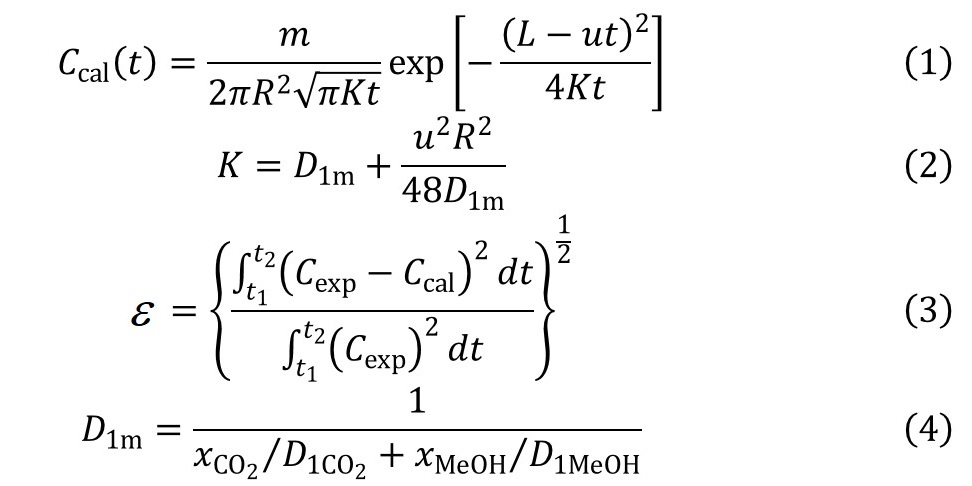
We mainly focus on the cocrystal formation of poorly soluble drug with CO2, targeting on the enhancement of drug solubility and improvement of drug dissolve behavior. In this work, norfloxacin was used as target drug, which have a very limited solubility about 0.28mg/g water at 25 °C. To form the cocrystal of Norfloxacin with CO2, we treat put Norfloxacin anhydrate in hyper-pressure cell in a temperature-controlled (30 to 60 °C) thermostatic oven and pressurize the CO2 into the cell until determined pressure (5 to 25MPa) is reached. Then the pressure and temperature are controlled as a constant for 2h. After this, the hyper-pressure cell is depressurized at 0.1MPa/min. And the solid (mixture of Norfloxacin and Norfloxacin CO2 cocrystal) remained in hyper-pressure is collected, we call it Norfloxacin Sc-CO2. After the experiment, the Norfloxacin Sc-CO2 is characterized mainly by powder XRD for semi-quantification of new formed cocrystal, and solubility test to check the dissolve behavior change. As results, we find out the higher pressure and higher temperature are preferred for cocrystal formation. Moreover, as can be seen in Figure, more cocrystal is formed, higher solubility of Norfloxacin we can get. In this research, the highest solubility is achieved at 25MPa, 40 °C, 0.64mg/g water at 25 °C, about 2 times higher than raw Norfloxacin. We also use the FT-IR to characterize the chemical change before and after Sc-CO2 treatment, and find two new peaks at 1650 cm-1 which may indicate the C=O vibration of CO2, and 990cm-1 which is still unknown. And TGA test give a mass loss around 189 °C corresponding with new heat absorbance in DSC test, which suggest the release of CO2 from the cocrystal.
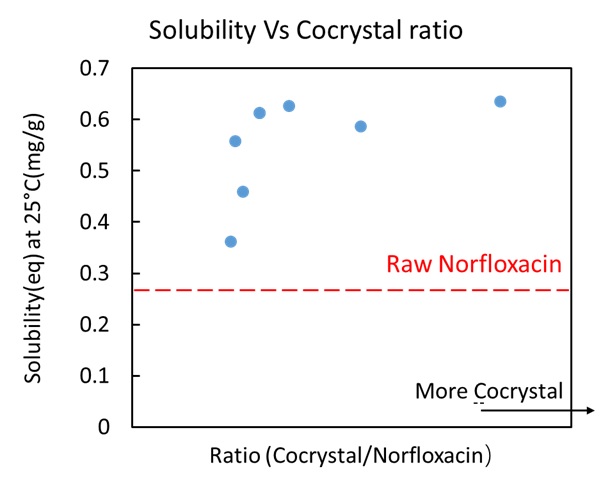
Supercritical carbon dioxide (scCO2) is considered as a green and environmental friendly solvent. scCO2 has been widely used for dyeing for textile and polymer processing. In the design and development of scCO2 process, solubility is one of the important and fundamental property. So far there are many calculation models developed for fitting and prediction of the solubility of dyestuffs. For example, Chrastil, Mendez-Santiago – Teja, Bartle et al., Kumar – Johnston, Garlpati – Madra, Sung – Shim, Adachi – Lu, and Ch – Madras proposed scCO2 density-based models to correlate the solubilities of solid compounds. Also the equations of state like Peng – Robinson and Soave – Redlich – Kwong were used to fit and predict solubility of solid compounds in scCO2. Recently the solubility calculation was performed by the equation of state combined with gE model. In these calculations of fitting and prediction of the solubility, we encountered some inconveniences in an accurate representation of the models to the whole range of the experimental results and in dependence of the functional flexibility for the model used. To overcome these shortcomings, the neural network was applied to represent the solubility. In the present work, we examined to correlate and predict accurately the solubility of anthraquinone and the derivatives in scCO2 by the neural network.
Recently, VOC (Volatile Organic Compounds) emission to environment has become a serious problem. In particular, the paint industry is the largest VOC emission source in Japan, because large amounts of VOC are used as diluents in paint. As a new alternative technology, a CO2 painting system [1], which replaces a part of solvent (diluent) with high pressure CO2, has attracted an attention, because it can reduce VOC emission and drying cost. The fluidity of paint is important in the painting process, however viscosity data of CO2 + organic solvent + polymer system are rarely reported. In this work, viscosity, density, and bubble-point pressure of CO2 + methanol system were measured at 40 and 80 °C. To ensure the measurements at one phase, our pressure conditions were set at 0.2 MPa higher than the saturation. Figure shows experimental viscosity data of CO2 + methanol system at 40 °C. Viscosity tends to decrease with increasing CO2 composition and increase with increasing pressures. Estimated saturated viscosity data of this work were smaller than that of Sih et al. [2], and the deviation were 4.5 ~ 8.9 %. However, viscosity data at 0.1 MPa in pure methanol which were obtained by extrapolation from experimental data were in good agreement with the reliable literature values [3]. Free Volume Theory proposed by Allal et al. [4] was applied for the viscosity correlation and prediction. The predicted results of CO2 + methanol viscosity at 40 °C could well represent the experimental data.
References:
[1] S. Kawasaki et al., J. Jpa. Soc. Colour Mater., 86, 163 (2013).
[2] R. Sih et al., J. Supercrit. Fluids, 41, 148 (2007).
[3] H. W. Xiang et al., J. Phys. Chem. Ref. Data, 35, 1597 (2006).
[4] A. Allal et al., Phys. Rev. E, 64, 011203 (2001).
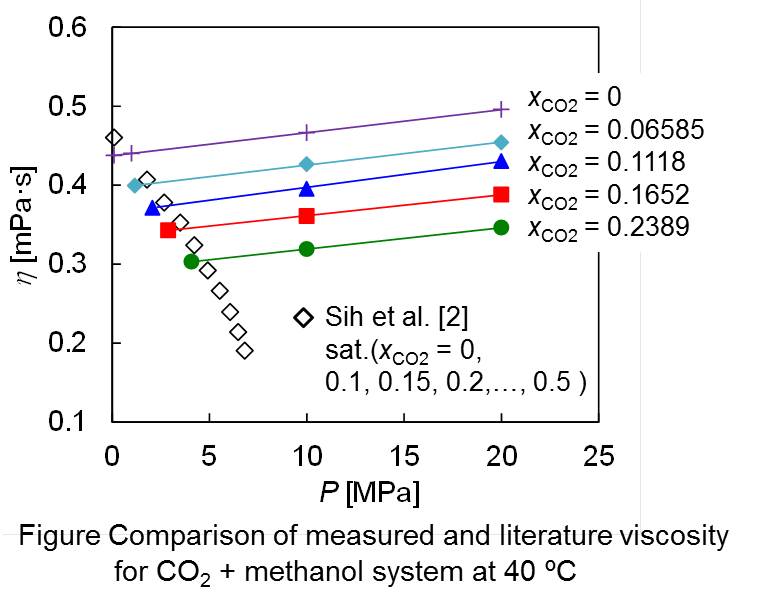
Most pharmaceutical drugs have several crystal polymorphs, i.e., solid phases with different crystal structures. The polymorphs have different properties with each other, such as the solubility, stability, and particle shape, therefore affecting the bioavailability and the separation efficiency. It is thus required in pharmaceutical industry to selectively crystalize a target polymorph with desirable property. Solubility data of the polymorphs are essential information for the selective crystallization. Here we measured the solubility of famotidine, a histamine H2 receptor antagonist, in various solvents at 298.15 K. Famotidine has the two polymorphs, a stable form A and a metastable form B. For both polymorphs, the solubility increased in the order of ethyl acetate < water < acetonitrile < ethanol < acetone < methanol. In all the solvents, the solubility of form B was larger than that of form A. The solubility ratio B/A varied with the solvent from 1.09 to 1.32 in the order of ethyl acetate < ethanol < acetone < acetonitrile < methanol < water. The experimental solubility ratio was smaller than that estimated (1.48) from the melting temperature and the molar enthalpy of fusion for the polymorphs. The solvent effects on the polymorphic solubilities and the solubility ratio are discussed in comparison with those for other pharmaceutical drugs.
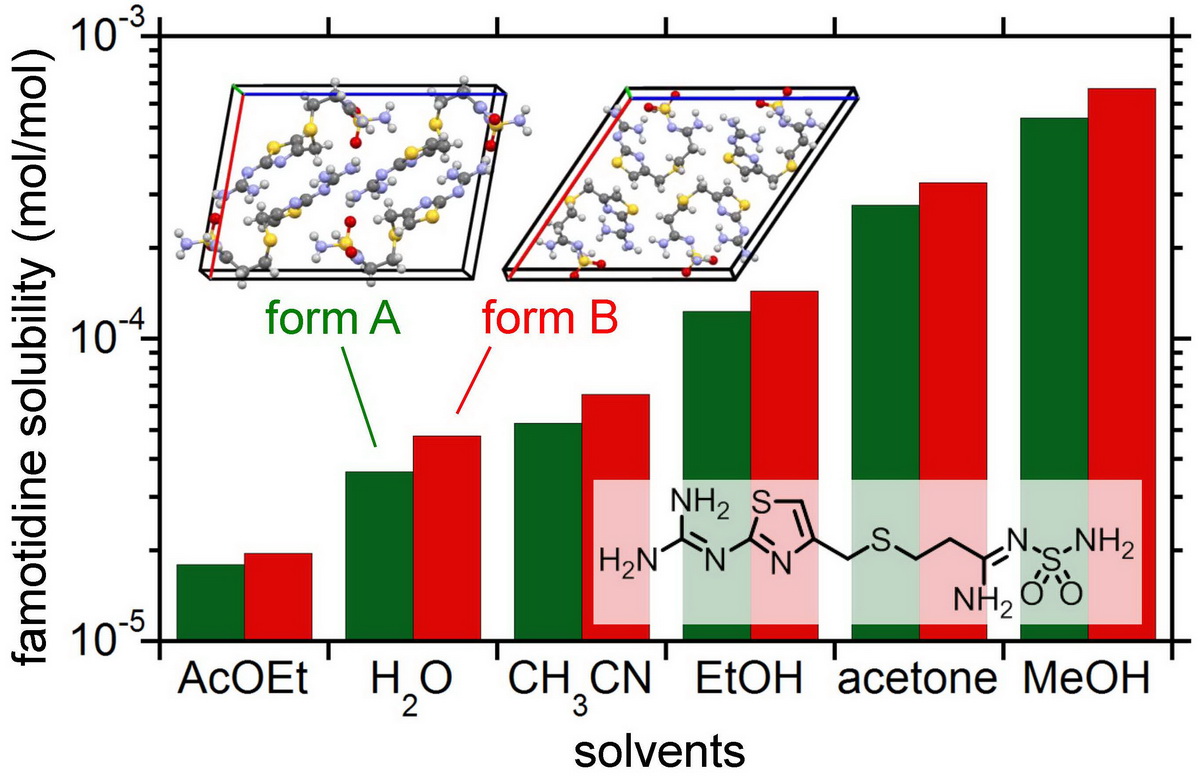
Kinematic viscosity is one of the important transport properties, and is required for designing chemical process as well as estimating transport parameters via dimensionless numbers such as Reynolds number, Schmidt number, Prandtl number etc. [1]. In some models for calculating kinematic viscosities, some excess free energy models based on the local composition idea with Eyring equation will be useful from a practical of point.
This paper reviews the models for calculating kinematic viscosity using modified Eyring and excess free energy models.
1. Kinematic viscosity at normal pressure
1.a. Correlation of kinematic viscosity for binary system [2]
1.b. Prediction of kinematic viscosity for multi-component system [2]
1.c. Prediction of kinematic viscosity using ASOG-VISCO [3]
2. Kinematic viscosity at high pressure
2.a. Prediction of high-Pressure viscosity from viscosity data at normal pressure [4]
2.b. Prediction of kinematic viscosity at high-pressure using ASOG-VISCO [5]
References
1) B.E. Poling, J.M. Prausnitz, J.P. O'Connell: The Properties of Gases and Liquids, 5th ed., McGraw-Hill, New-York (2001)
2) H. Matsuda, K. Tochigi, K. Kurihara, T. Funazukuri, V. K, Rattan: accepted for Fluid Phase Equilibria
3) K. Tochigi, K. Yoshino, V. K. Rattan: Int. J. Thermophysics, 26, 413-419 (2005)
4) K. Tochigi, T. Okamura, V. K. Rattan: Fluid Phase Equilibria, 257, 228-232 (2007)
5) H. Matsuda, K. Kurihara, K. Tochigi, T. Funazukuri, V. K. Rattan: Fluid Phase Equilibria, 470, 188-192 (2018)
Solid–liquid equilibria (SLE) for three binary mixtures of Dodecanoic acid with n-octadecane, n-eicosane, and n-docosane were measured using differential scanning calorimetry (DSC).Simple eutectic behaviors for all three systems were observed. The eutectic point of the (Dodecanoic acid + n-octadecane) system is at 300.15 K and 0.302 mole fraction of Dodecanoic acid, that of the (Dodecanoic acid + n-eicosane) system at 306.60K and 0.558 mole fraction of Dodecanoic acid and that of the (Dodecanoic acid + n-docosane) system at 311.15 K and 0.661 mole fraction of Dodecanoic acid.
Dimethyl ether (DME) and propane are easily liquefied because they have relatively low vapor pressure among liquefied gases and used for aerosol propellant. A new solvent has been proposed to synthesize nanoparticle by using the mixture of liquefied propellant and alcohol. Therefore, the polarity and the volatility can be controlled by the composition of the solvent. In our research group, the dielectric properties has been already measured for liquefied DME + ethanol and liquefied propane + ethanol mixture. In this study, the complex dielectric spectra of liquefied DME + propanol (1-propanol and 2-propanol) and propane + propanol (1-propanol and 2-propanol) mixture were measured at 303.2 K. The complex dielectric spectra of DME + 1-propanol and DME + 2-propanol liquid mixture were measured by frequency domain method with the network analyzer (HP8720C). Coaxial probe was used for the dielectric spectra measurement in the frequency range of 0.5 ~ 18 GHz. Frequency dependence of the complex dielectric spectra was fitted by single-phase Debye equation, and the static dielectric constants and the dielectric relaxation times of DME + propanol and propane + propanol liquid mixture at 303.2 K were determined. The static dielectric constants of all mixtures studied decreased with increasing liquefied gas concentration. The dielectric relaxation times of DME + propanol liquid mixture decreased with increasing DME concentration. For propane + propanol liquid mixtures, however, the propane composition dependence of dielectric relaxation time show maximum. The excess dielectric constants and the excess inverse relaxation times were calculated from the static dielectric constants and dielectric relaxation time studied. These excess values disclose the hydrophobic interaction between liquefied gas and alkyl chain of propanol plays important role of the liquefied gas dependence of dielectric properties for all mixtures studied at 303.2 K.
As a part of the development of the Hydrogen Organic Career, Hydrogen+Methyl-cyclohexane (MCH) system VLE model is developed for evaluation of MCH production process. Thermodynamic model using Peng-Robinson Equation of state which modified by Boston, Mathias is correlated using VLE data by Tsuji (2005) and Peter(1960). The conceptual MCH synthesis process is modeled using Aspen plus to evaluate the process performance and energy consumption.
The performance of polymer as biocompatible or separation material can be governed by its ability of adsorbing biological molecules. Considerable efforts have been devoted to characterize the polymer/water interface with the purpose of predicting the adsorption tendency, while the adsorption free energy is the direct measure of the extent of adsorption of an adsorbate of interest. In this study, the adsorption free energy was calculated by extending the energy-representation method to the polymer/water interface. We focused on the adsorption of amino-acid analogs onto poly(2-methoxyetyl acrylate) (PMEA), poly(butyl acrylate) (PBA), and poly(methoxyetyl acrylate) (PMMA). The MD simulation of the polymer/water systems was performed with GROMACS 5.1.4 in the NPT ensemble at a temperature of 300 K. The TIP3P model was used for water, and the polymer and amino-acid analog were described by potential functions that are based on the general AMBER force field (GAFF). The free energy of adsorption on the polymer/water interface was computed by the energy-representation method by viewing the polymer and water as a mixed solvent with a restraint on the adsorption depth. p-Cresol is one of the amino-acid analogs examined, and Figure shows its adsorption free energy ΔG onto each polymer at the Gibbs dividing surface. ΔG is favorable (negative) and p-cresol binds favorably to the polymers examined. The equilibrium content of water is larger in PMEA than in PBA and PMMA, while ΔG is in the order of PMEA ≈ PBA < PMMA. Thus, the adsorption free energy does not necessarily correlate with the interaction of polymer with water.
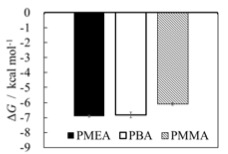
In recent years, Blood viscosity considered to be important from the viewpoint of prevention and treatment of cardiovascular diseases in a medical field. Measurement of blood viscosity is difficult due to its coagulation property and measurement method of blood viscosity has not been established yet. We developed a compact sized Falling Needle Rheometer which is able to measure the blood viscosity almost immediately after collection. A Falling Needle Rheometer can measure the viscosity of a liquid with high accuracy ±0.1% in a short time and a viscosity measuring method is simple and anyone can get highly precise data easily. The blood is withdrawn from the body flowing into vacuumed plastic tubes coated with an anticoagulant. On the other hands, blood was withdrawn with non-Coated with anticoagulant vacutainer tubes and measured within 30 seconds. The blood always remained inside the vacutainer vessel and the viscosity was measured via a falling needle with a distinctive mass. We observed the effect of human blood viscosity on the addition of anticoagulants. We chose EDTA and heparin as anticoagulants. As a result, the human blood with anticoagulant shows higher viscosity than that without anticoagulant. We succeeded in measuring the flow characteristics of human blood using Falling Needle Rheometer.
The Hansen solubility parameter (HSP) is one of the index for affinity of materials with some solvents. The basic principle of HSP has been ‘like dissolves like'. HSP values over 1200 kinds of pure solvents have been reported by Hansen in the data base of HSPiP program 2004. Furthermore, HSP value is used for various research fields, such as an evaluation of the solubility of solid in solvent, a compatibility and an affinity of polymers in solvent and a dispersibility of fine particles in solvent. The other side, one of the methods of HSP for a liquid or its mixture is able to measure from physical properties of the solvent (such as refractive index, surface tension, permittivity and dipole moment). In the case of solvent mixture, the non-ideality of the solution is so important for practical use, however, non-ideality of Hansen solubility parameter for solvent mixture has not been elucidated so far. In this research, the comparison between the HSP value calculated from the physical properties (δt is calculated from surface tension, δd is refractive index, δp is permittivity, δh is calculated from solvent polarity parameter) and the HSP value calculated from the volume fraction ideal was carried out, and the non-ideality of solvent mixture were discussed and confirmed. In addition, this non-ideality created the estimation equation by the activity coefficient used in creating the estimation equation of the mixture.
Ethanol has been widely used in our daily life as a solvent for deodorizer, medicine, cosmetics and pesticide because of its bacterial killing and human friendly natures. The knowledge of miscibility and solubility with some propellants is important for designing their spray cans. In this study, bubble point pressure of the three binaries, containing ethanol with conventional or new propellant, were measured by use of a static apparatus at the three isotherms, 293.15, 303.15 and 313.15 K. The propellants employed were two conventional ones, propane and dimethyl ether, and new one, (E)-1,3,3,3-tetrafluoropropene (HFO-1234ze(E)). These are expected as alternatives of CFC-12 and HFC-134a. The glass cell, with the inner volume of 37 cm3, was equipped in the apparatus, and the detail equipment has been reported elsewhere. The experimental temperature was measured by a thermistor thermometer with the estimated uncertainty, u(T)=0.04 K. The pressure was by the three pressure sensors with the different maximum capacities, 10 MPa(gauge), 1MPa(gauge) and 200kPa (abs.). The estimated uncertainty is u(P)=0.5 kPa for P > 100 kPa, and u(P)=0.06 kPa for P<100 kPa, respectively The three binaries showed the non-ideality in the solution, and the positive deviations from Roult law was observed in the whole range of the experimental temperature. The non-ideality in propane + ethanol and HFO-1234ze(E) + ethanol seemed to be larger than that in dimethyl ether + ethanol. The bubble pointy pressure was correlated with non-random two liquid (NRTL) model. The calculation showed good reproducibility Then.the average absolute relative deviations were 0.70, 0.62 and 1.68 % for ethanol with propane, dimethyl ether and HFO-1234ze(E), respectively.
FLiBe(2LiF-BeF2)molten salts are expected to serve as the coolant and the thorium-uranium fuel dissolver in molten salt reactors, with the advantage of low pressure operation, good stability under radiation, high solubility of uranium and thorium fuel, and low corrosion to structural materials. In order to purify and obtain the high quality salts, a mixture of H2 and HF is used to remove oxygen impurity from FLiBe molten salts.
In this study, Car-Parrinello molecular dynamics simulations with BLYP method were performed to investigate the structure, transport properties of H2, HF diffusion through liquid FLiBe(2LiF-BeF2) in the range of 773–973K. Radius distribution functions and first-shell coordination numbers of the molten salt obtained by Ab initio molecular dynamics calculations reproduce the data of experimental measurement. The structure of the melts reveals the existence of a network of BeF42-, Be2F73-,Be3F104-. The self-diffusion coefficients extracted from mean square displacements of F-, Li+ and Be2+ are in accord with values found in literatures. The diffusion coefficients of H2 and HF were obtained within error allowed. The results show that the diffusion coefficient of HF is a little higher than that of F- ion, because the F- in HF molecular easily stays bonded to Be2+ like other F- while the H+ of HF moves quickly.
Through the work, the diffusion coefficient of HF was obtained to calculate the basic data of gas-liquid mass transfer, and provide basis for reactor design and scale up the FLiBe purification process.
Nanoparticle Organic Hybrid Material (NOHM) is a new green platform material which is self–suspended liquid–like material consisted of inorganic core and organic canopy. This new platform, NOHM, has been evaluated to have high potential for various energy and environmental applications such as CO2 sorptive materials, electrolytes, and lubricants with a low vapor pressure and promising thermal stability at high temperature over 200 °C. More importantly, NOHM has a great tunability on both entropic and enthalpic designs by introducing tailored core and linkage with specific functionalities. In particular, the entropic property which related to the intramolecular interactions between core and canopy structure could influence on the system's thermal, chemical, and electrical properties. In this investigation, it was designed to evaluate the entropic packing effects of NOHM systems on thermal properties and swelling behavior. The four different NOHM systems with varying the core size and the suspension system were synthesized (single 7, 12, 22 nm suspension and ternary suspension) and their thermal properties and swelling patterns were investigated via thermal analysis and spectroscopic analyses including ATR FT-IR and DOSY NMR. Through the investigation, the entropic packing effects by core size were identified. In addition, the ternary suspended NOHM system were evaluated to have high potential for thermal fluid application.
In this paper, a machine learning method is proposed to extract molecular features as floating-point numbers in a high dimensional space by mapping a language-like description Simplified Molecular Input Line Entry Specification (SMILES) to a molecular fingerprint known as Molecular ACCess System (MACCS) which represent the molecular features as an one-dimensional array of molecular features. Two neural network models are build to predict the “sigma-profile”, the charge distribution of the molecule near a perfect infinite conductor, which is calculated by quantum mechanics. The sigma-profile can be used in the COSMO-SAC model for predicting thermodynamic properties such as activity coefficient. One uses MACCS as direct input, and the other uses the high dimensional space representation as input. Preliminary results showed that an accurate neural work model that uses the high dimensional space representation is much better than the one using MACCS. The results indicate that projection of molecular features into a high dimensional space with spatial features and distance metric is a much better representation of molecular features and potentially be a better predictor of thermodynamic properties.
Dry reforming of methane (DRM) is important in the reduction of greenhouse gases and their conversions to useful products. Substituted metal catalysts have emerged as a new category of oxide catalysts making an intensive impact on environmental catalysis. Density functional theory (DFT) is the powerful technique for finding the active nature of new catalytic material. Hence, in this study, we have extensively used DFT calculations to design and probe a novel DRM catalyst. We selected Ru and La2O3 due to their hindered nature towards carbon formation making it a potentially non-deactivating catalyst. Vacancy formation energy decreased on Ru substitution when compared to that observed with La2O3, thereby improving the reducibility of the substituted catalytic material. Carbonates play a crucial role in DRM reaction on basic supports and hence, so we probed different types of carbonates present over Ru-substituted La2O3. Our theoretical calculations were successfully verified with experiments. Reducibility of Ru-substituted La2O3 was probed using temperature programmed reduction profiles (TPR). DRIFTS was carried out to determine the importance of carbonates during DRM reaction. Both theoretical and experimental studies proved Ru-substituted La2O3 a good catalytic material for DRM reaction.
Recently, researchers and engineers in chemical companies are facing a huge variety of flows such as multiphase flows, non-isothermal flows and flows with moving boundaries. In other hand, high quality computing becomes more important. Some member in Japanese chemical companies formed a workshop for workers on the first wave of computational fluid dynamics (CFD) in 2008, which is called as chemical company workshop on CFD (CCW)(Ishiba et al., 2010, Ishiba et al., 2013 and Kawada et al. 2017).
In this presentation, we introduce our activities and current state of affairs. As regards the quality improvement of CFD, we compared numerical results in some problems:
(a) Turbulent flow in an agitation vessel
(b) Flow in a fluidization bed
(c) Vortex generation in a swirling flow
(d) A dispersed liquid-liquid two phase flow
(e) Heat transport in packed column
We have discussed that “how do CFD engineers provide better precisions for designing chemical reactors” and “what is useful for guidance of CFD” in the last decade. We need not only development of hard ware and software, but also development of qualified engineers to keep better productions. We expect that the discuss efforts of CCW is contributing sustainable productivity by using CFD.
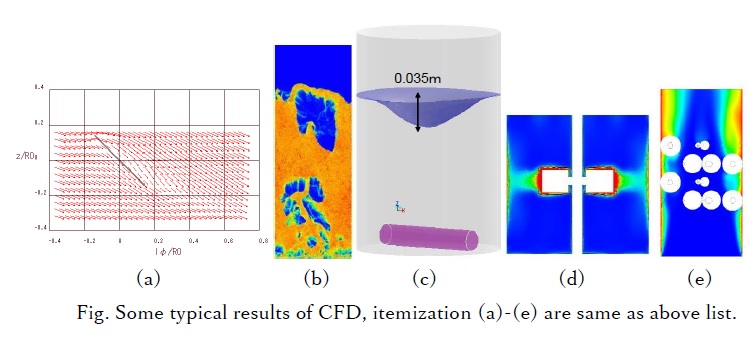
Nowadays an internal 3D structure of porous material is noninvasively analyzed with sub-micron resolution using X-ray micro-CT technology for understanding of internal phenomena. It is then expected that the important properties such as reaction efficiency, effective diffusion coefficient, permeability, thermal conductivity, mechanical strength will be predicted and designed based on the relation between the microstructure and these properties. However, a geometrical descriptor, which is an index to quantify the microstructure, can be arbitrarily defined, and hence, its appropriate selection to serve the material design is challenging and needs expert knowledge.
Therefore, this study proposed a machine learning-based framework to select the descriptors of microstructure for predicting specific material properties. For its validation, the relation between the descriptors and one specific material property of more than 1000 porous material samples were analyzed. The values of defined 62 geometrical descriptors were calculated using CT scan images. The specific porous material property was obtained by numerical simulations.
The framework employed RReliefF algorithm as filter method and support vector machine as wrapper method. Although the wrapper method is computationally expensive, its numerical load was reduced using RReliefF based on a descriptor ranking of importance to the specific material property. The framework selected 8 descriptors to minimize the prediction error for permeability. Among them, the conventional descriptors such as porosity, specific surface area, tortuosity, and hydraulic radius were also included, which validated the framework. Other selected descriptors were related to chord lengths of pores in three directions, which implied that the three-dimensional shape of pores caused the difference in the permeability of porous material with similar conventional parameters' values. It should be emphasized that the proposed framework is applicable to the identification of descriptors for predicting any specific material properties, which might not be related to the microstructure of porous material in the past.
Stir tank bioreactors are widely used for mammalian cell culture process for biomanufacturing. From the process development to manufacturing, various size of bioreactors are used. To enable successful scale-up, Number of factors are critical to efficient cell growth and substance production. Regarding process parameters of bioreactor, liquid mixing and gas transfer efficiency are well understood for the key process parameter and evaluate those of parameter are applied as an indicator to scale up to larger process. Volumetric mass transfer coefficient (kLa) is widely used to determine gas transfer capacity of bioreactor. kLa is affected by the bioreactor design such as impeller, vessel height and diameter, gas sparger shape and capacity. The kLa have been correlated as following equation.
kLa of bioreactors that used for process development to commercial scale has been determined by the equation. Many of engineering approach are discussed to determine kLa. Bioreactors have multiple sparger to supply oxygen for various culture condition, the generated bubbles also have different diameters and size distribution. It affects the specific interfacial area, but the size of bubble and distributions has not been verified well.
In this study, we discuss about kLa determination approach with bubble diameter and size distribution analysis regarding for the series of MobiusR bioreactor. The bioreactor family is single use bioreactors by configured flexible film-based bag for all liquid contact surface as single time usage. The bioreactor series has five tank sizes, 3L vessel for early process development, 50-200L for pilot-scale manufacturing, 1000-2000L for clinical scale manufacturing. kLa performance that of the bioreactor series are already published, but the correlation of engineering parameters from modeling are not well characterized yet. We verified kLa performance of the bioreactors with general mechanical models and analyze correlation between kLa to sparged bubble specifications. also discuss the unique sparger design and characterization.

While understanding the intrinsic reaction kinetics is a perpetual pursuit of chemical science, the effective reaction kinetics most frequently faced in chemical engineering is typically significantly different from it. The coupling of reaction and diffusion is a major cause of this difference and is hence a common topic for both chemistry and chemical engineering. It is, however, a challenge topic owning to its multi-scale nature with reaction at atomistic scales and diffusion ranging from micro- to macro-scales. By simplifying the particle-particle interactions in molecular dynamics (MD) with hard sphere (HS) models and improving its scalability in parallel computation with pseudo-particle modelling (PPM), the HS-PPM approach has been demonstrated effective for bridging the scales involved in reaction-diffusion coupling and advantageous over traditional MD or continuum-based simulation methods. The presentation will introduce the theories, models, algorithms, implementation and applications of this approach with example from petrochemical and coal-chemical industries.
Management and disposal of sewage sludge (SS) is drawing great attraction due to its large quantity and potential environmental concern. On one hand, SS contains relatively high heating value that could be recovered through further thermal treatments such as incineration and gasification. On the other hand, high nitrogen content leads to potential NOx emission during the thermal treatments. Hydrothermal carbonization (HTC) pretreatment could enhance fuel quality and remove unwanted pollutants like nitrogen and sulfur. Thus, it is popularly applied in the field of SS disposal. In this study, an integrated HTC pretreatment and CO2 gasification system was proposed and studied. Cold gas efficiency (CGE), carbon conversion factor (CCF) and ammonia emission were evaluated as key performance indicators. Nitrogen transformation behaviour from HC was studied from 400 °C to 900 °C indicating that the release of NH3 was mainly because of the decomposition of amide group. Meanwhile, gasification products from SS and hydrochar (HC) showed that NH3 (NOx precursor) emission could be reduced by 57% through HTC pretreatment although CGE and CCF were inhibited. However, this could be improved through co-gasification of HC with horticulture waste (HW). The preferred experimental condition was found to be 1:1 HC/HW mix ratio that CGE could reach 66%. The synergetic effect was believed due to the presence of calcium compounds in the HW. It was also observed that calcium element could improve both nitrogen removal efficiency during HTC and CGE during gasification.
Fluidized beds are used extensively in the petrochemical, metallurgical, food and pharmaceutical industries. Although a rich literature focusing almost entirely on large scale fluidized bed systems has been developed, little is known about gas fluidization in mini-channels. Such mini-fluidized beds have the potential to provide large interfacial areas, high transport rates, large wall surface area for heat exchange and may find important applications for various chemical and biological processes. However, the behaviors of mini-fluidized beds differ from their large scale counterparts and correlations that have been developed for the latter have been observed to be inadequate for predicting bubbling and slugging behaviors in mini-fluidized beds. In this study, the Discrete Element Method combined with Computational Fluid Dynamics (CFD-DEM) was applied for studies of solids mixing in a mini-fluidized bed. The effects of different operating conditions, such as superficial gas velocity, continuous and pulsating flow at the inlet, interparticle van der Waals interactions, on the efficiency with which mixing takes place were investigated through the simulations.
Small white glass particles (0.84 – 1.00 mm) and large black glass particles (1.19 – 1.41 mm) are mixed in a 40% fill, 20 rpm drum which is 100 mm in length and 98 mm in diameter. An inner particle axial motion blocking plate is placed in a rotating drum and the effect of its position on the particle mixing is studied. The plate has 78 mm inner diameter and blocks 34% particles' axial motion. The experimental results show that the degree of mixing increases by the blocking plate shearing. The shearing changes the dynamic angle of repose of the particles and the location of the plate affects the degree of mixing and segregation patterns. The particle motion in this system is realized by DEM simulation. It is found that the plate blocks particle motion deep in the bed, but enhances axial motion at the bed surface. The plate inserting increases the particle plate crossing number, the average particle axial velocity and the particle axial moving distance per revolution.
The dispersion of solid particles plays an important role in solid-liquid agitation. For example, “moderate” agitation is necessary in crystallization. Insufficient agitation causes crystals to stay at the bottom of the tank; thereby particles stick together or stick to the wall of tanks. This poses handling problems such as clogging of bottom lines and insufficient quality by coarse lumps. On the other hand, overpowering agitation causes crystals to break into small particles due to a strong shearing force, causing malfunction in subsequent processes, such as, a filtration process. Thus, it is extremely important to design both a proper apparatus and proper agitating speed to obtain desirable dispersion in solid-liquid agitation.
Designing solid-liquid agitated tanks, just suspension speed NJS and segregation state are important. To estimate NJS, Zwietering's empirical formula is widely adopted. The formula requires a geometrical constant which depends on the shapes of apparatus: The geometrical constant is often unavailable so that it needs to be obtained experimentally for each apparatus which has a lot of factors such as the shape of the agitating blade, the shape of the tank, the number of blades, and the blade position, thereby taking cost and time. Thus, NJS has been estimated with Computational Fluid Dynamics (CFD) instead of experiment. In addition, the extent of segregation has been evaluated at NJS based on particle concentration distribution obtained with CFD.
NJS, obtained with CFD simulation and experiment have been found to be adequately consistent with each other. Furthermore, the shape of apparatus has been found to affect the state of segregation at NJS.
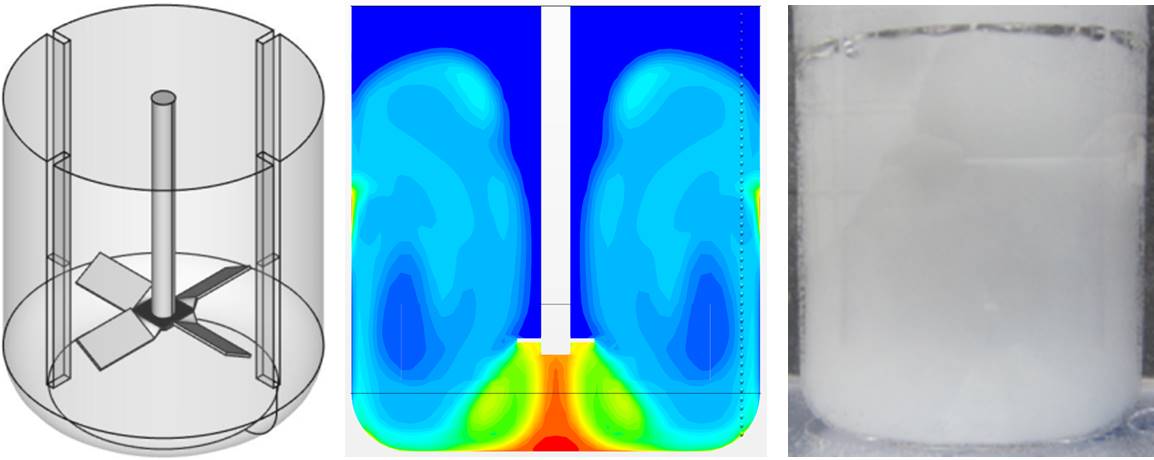
Processes using particle coagulation are one of prominent parts of many branches of industry. With growing interest in unsteady operations, they have been applied to agglomeration processes. Coagulates produced from unsteady operations tend to have unique properties and, in terms of industrial applications, more understanding of the relationship between unsteady flow and particle agglomeration is needed. As an unsteady flow, laminar chaotic mixing induced by adding periodical perturbation has attracted a lot of attention. In fact, it has been eagerly investigated to enhance mixing efficiency and to apply to industrial processes since 1980s. There is, however, no reports on particle aggregation behavior in a chaotic mixing field. Therefore, aiming at the development of a novel coagulation process, this study investigated particle aggregation in a simplified two-dimensional chaotic flow.
A schematic of the model flow in this study is shown in Figure 1. In this model, the system consists of two rotating cylinders. The motion of cylinders can be divided into three units protocols (protocol 1a, 1b and 2). In protocol 1a and 1b, one cylinder rotates for fixed time T. On the other hand, both cylinders rotate in protocol 2. This periodic operation is supposed to perturb the fixed point which locates at the center in between the two cylinders in protocol 2 and to induce chaotic mixing.
The temporal evolution of the number of aggregates can be described using an exponential model equation. Aggregation rate constant k showed less dependency on rotation rate of cylinders ω and higher k was obtained when T was shorter. These results indicate that chaotic agitation decreases the effect of breakage and promoted coagulation. The smaller ω or T where the system has higher unsteadiness, the larger aggregates were obtained.
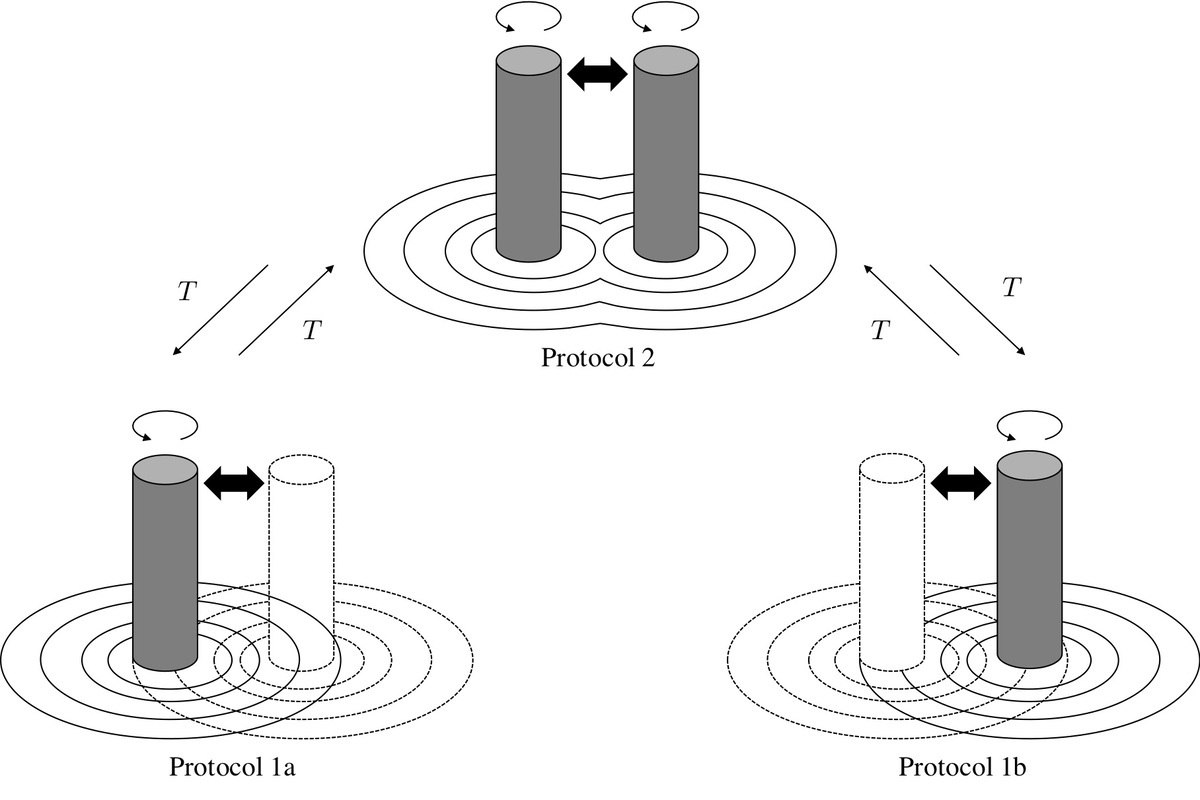
A mixing performance of an inner baffle was investigated in shear thinning fluid. The inner baffle was placed with a clearance between baffle and vessel wall. A traditional two-bladed paddle impeller was used. Four planar baffles was vertically placed in two ways: 1) standard baffle condition 2) baffle condition with a clearance between baffle and vessel wall. A mixing pattern was visualized by decolorization method based on an oxidation-reduction reaction with sodium thiosulfate and iodine. Flow field for shear thinning fluid in mixing vessel was measured by particle image velocimetry and was shown as stream line. An isolated mixing region (IMR) like doughnut ring formed under standard baffle condition, however, IMR dissipated when baffles were placed with a clearance between baffle and vessel wall. As a result, mixing time was drastically decreased. This study suggested that inner baffle promoted mixing in shear thinning fluid.
Injectable hydrogels are widely used for minimally invasive therapy. Among injectable hydrogels, shear thinning hydrogels have received much attention recently, as their viscosity decreases with increase in shear rate making it suitable for flow through long channels. Static mixers enable efficient mixing without an external energy source, and thus have been used for the fabrication of injectable hydrogels, such as dental impression materials. However, gelation behavior of shear thinning hydrogels in static mixers is still unknown. In this research, we study the shear-thinning behavior of hydrogels formed by physically cross-linking natural polysaccharides, such as xanthan gum and locust bean gums using a Kenics Static Mixer.
Mixtures of 1 wt% xanthan gum and 1 wt % locust bean gum in pure water formed hydrogel by mixing in static mixer with 16 elements at axial velocity of 100 mm/s. The mechanical strength of the formed hydrogels was measured using a rheometer. G' value for xanthan gum to locust bean gum ratio of 1:1 was found to be 18 Pa. The mechanical strength can be increased by increasing ionic strength. The pressure drop dependence on mixing conditions and hydrogel composition at different polymer ratios was characterized using the static mixer. An increase in axial flow velocity and number of mixing elements showed an increase in average pressure drop due to hydrogel formation. Furthermore, the viscosity of formed hydrogels decreased with increasing shear rates from 1.9 to 383 s-1 and was fitted to the power law model for non-Newtonian fluids. These results indicated shear-thinning property of hydrogels, which would be owed to the nature of physical crosslinkings. Pressure drop dependence of the above parameters will be discussed using non-dimensional Deborah number defined as the ratio of time taken by materials to adjust to applied stresses to characteristic time scale of an experiment.
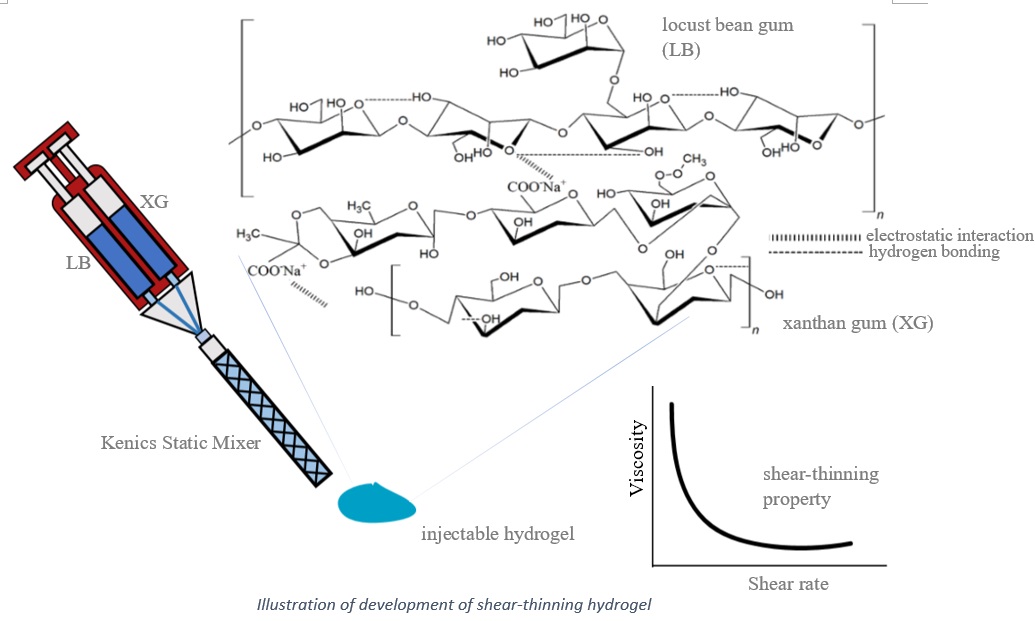
Particle suspensions in viscoelastic fluids such as polymer solutions or polymer melts are broadly used in industrial products. Understanding the rheology of them is essential for proper manufacturing operations. Among viscoelastic fluids, so-called Boger fluids are widely utilized for separately examining the effect of elasticity of the fluids due to the constant shear viscosity. In past experimental studies, suspensions in Boger fluids are reported to show the shear-thickening in the apparent suspension viscosity even at dilute suspensions[1]. To clarify the mechanism of this thickening, numerical studies were reported[2].
We studied unclear effects of fluid elasticity on the shear-thickening in dilute suspensions using newly developed direct numerical simulation based on Smoothed-Profile Method[3]. Oldroyd-B model, which represents the shear flow rheology of Boger fluids well, is utilized in our calculations. The fluid elasticity is quantified by the Weissenberg number (Wi) and the viscosity ratio between the solvent and polymer (beta). A small beta corresponds to a high polymer concentration or a high-molecular-weight polymer (strong elasticity of fluid).
We clarified that the modulation of the velocity field of the host fluid due to the polymer stress, which is more pronounced in lower beta conditions, relax the level of the polymer stress concentration, resulting in the non-trivial weakening of Wi-dependency of the shear-thickening in the normalized suspension viscosity observed in a high Wi region in the figure. This result indicates that the two parameters measuring the fluid elasticity has counter-acting effects on the suspension rheology and are essentially important for suspension phenomena in moderate or strong viscoelastic fluids such as non-dilute polymer solutions or polymer melts.
[1] R. Scirocco et al., J. Rheol. 49, 551 (2005)
[2] M. Yang and E. S. G. Shaqfeh, J. Rheol. 62, 1363 (2018)
[3] Y. Nakayama et al., Eur. Phys. J. E 26, 361 (2008)
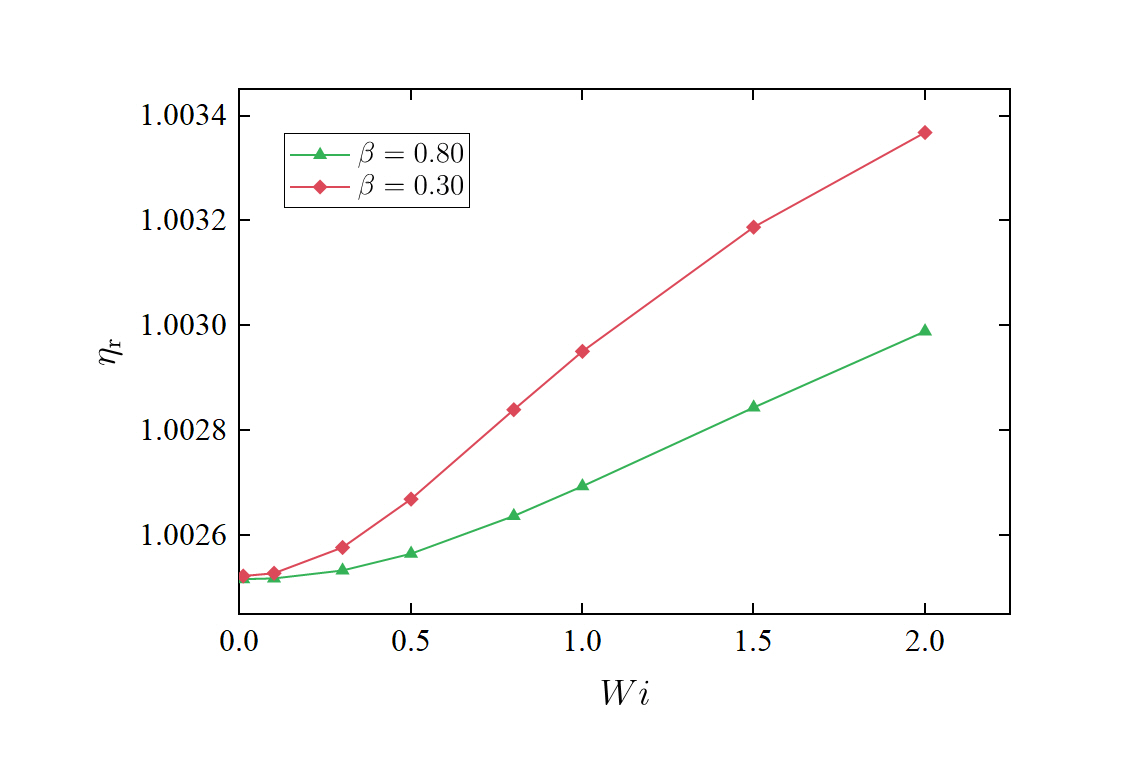
In the mixing operation, the flow pattern in the turning space of the stirring blades affects the circulation flow in the tank and is directly linked to the success or failure of the mixing operation. However, the flow pattern in the turning space is not clarified because measurement in the turning space is difficult. Especially in the transitional regime, the effect of vessel size and fluid viscosity have not been understood. Although computational fluid dynamics (CFD) is very useful technique to predict fluid flow, validation with experimental data is essential.
In this study, the three-dimensional flow velocity distribution in the turning space of the six-blade paddle in a non-baffled vessel from laminar, transitional to turbulent regime was quantified by CFD using ANSYS Fluent 18.0. Laminar, transition-SST, and LES model were used for each flow regime. In addition, the velocity distribution in the turning space was quantified by two-dimensional particle image velocimetry (2D-PIV) with the transparent impeller. The flow velocity data were converted from a Cartesian coordinate system into a rotational cylindrical coordinate system synchronized with the rotation of the blades. The flow velocity distribution of CFD results were validated by PIV data.
As a result, it was found that the discharge flow of the fluid shifted from the front side to the back side of the blade as the flow regime change from laminar, transitional to turbulence. Moreover, the fluid velocity faster than the rotational speed of the blade was observed in the back space of the blade in the transitional regime, and it was found that a negative pressure area was formed. The organized vorticity motion was formed in the back space of the blade not only in the turbulence but also transitional regime.

Solid-liquid mixing is widely used in crystallizer and chemical reactor with catalysis. In these processes, there is a problem that solid particles aggregate and collide with a stirring blade. The particle collision causes particle breakage and abrasion. Furthermore, when scaling up to the scale of industrial equipment, the particle dispersion state usually becomes insufficient. It is important to quantify the solid particle concentration distribution in the tank and grasp the dispersion state to solve these problems. However, it is difficult to measure the detailed particle concentration in the tank under many conditions. So, in this study, Euler-Lagrangian simulations were performed with various particle diameter, particle density, impeller speed N, Impeller diameter D, and tank diameter to quantify the vertical distribution of solid particle concentration in the vessel and identified the factor that determines the dispersion state.
The Euler-Lagrangian approach, which tracks all particle motion, was adopted. Turbulent flow in the vessel was represented by LES. The interactions of particle–particle and particle–solid surfaces were modeled using the distinct element method. Analysis was performed by changing the vessel diameter, impeller speed, particle diameter and particle density to 3 conditions respectively. The fluid was presumed to be water. The standard deviation of particle concentration in the vertical direction, σc, was calculated and time averaged σc, σc,av, was used as the evaluation index of dispersion state in the vessel.
It was found that σc,av/Cav was correlated with the value ut/ND0.8 obtained by dividing terminal velocity of single particle ut by impeller speed N and D0.8. This result showed that the uniformity of particle concentration in the vertical direction can be ordered by the ratio of ND0.8 to ut regardless of the particle property, impeller speed and vessel size.
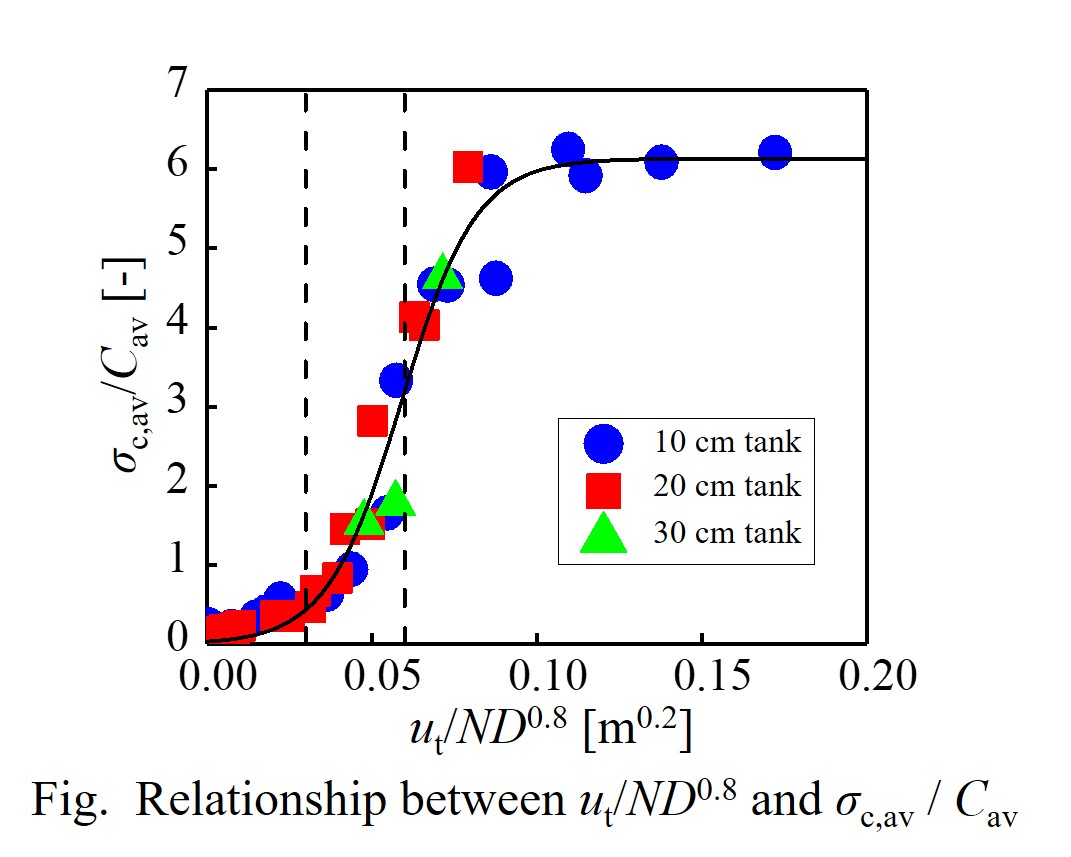
Mixing is one of the critical processes in the industry. One of the operating units used in the mixing process is a stirred tank. The efficiency of the stirred tank is greatly influenced by several factors including stirred tank design, operating conditions, and working fluid properties. The side-entry stirred tank is widely applied in the industrial process of crude oil in the refinery industry, water-molasses mixing in the bioethanol industry, pulp stock chest in the pulp and paper industry, and anaerobic digester for biogas reactors. Mixing time is one of the key parameters used in the design of a stirred tank. This research will model mixing time in a flat bottom cylindrical side-entry stirred tank with dimensions D = 40 cm and T = 40 cm using CFD ANSYS 18.2 by applying the RKE and SKE turbulence models. The stirrer used is three-blade marine propeller d = 4 cm which is an axial type impeller. The phenomenon of mixing in a side-entry stirred tank, qualitatively described through computational prediction results in the form of flow profiles and tracer density change contours locally. Moreover, quantitatively indicated by mixing time validated using experimental data carried out by the conductometry method. The simulation results show that the mixing time modeled with the SKE turbulence model shows a similarity level of 68.16%, while the RKE turbulence model shows 31.94%.
The recycling and utilization of powdery waste are becoming increasingly important for not only ensuring a sustainable environment but also decreasing the cost of waste disposal. In our previous work, focusing on the fact that the cohesion differs depending on the powder components, we report that it is possible to concentrate and separate specific components from binary mixed powders by using a vibrating fluidized bed. In order to apply this concentration and separation technology to various powders, systematically understand the aggregation and fracture characteristics of each powder in the vibrating fluidized bed are essential. In this study, the gas fluidization of three fine powder, viz. ZnO, TiO2 rutil, and TiO2 anatase were studied in a mechanically vibrating fluidized bed. The effects of the powder particle components and vibration amplitude on agglomeration and disruption in the fluidized bed were investigated. The temporal change of apparent agglomerate size was evaluated using the Ergun equation from the temporal change of bed height and pressure drop. Furthermore, the effects of powder species and vibration amplitude on aggregate size during aggregation-disruption equilibrium were evaluated based on a energy equilibrium model.
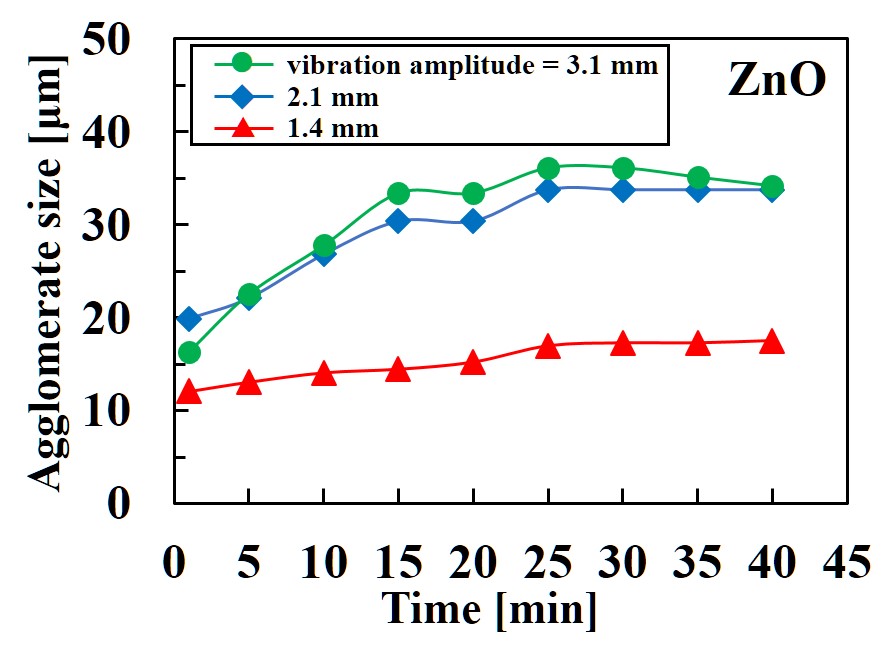
Bubbling fluidization process enables to enhance performance thermal conversion reaction between bed particles and raw material like biomass inside a bed column supported by gas distribution from the particle distributor at the bottom side. However, some unwanted inorganic materials like alkaline compounds contained inside biomass have the potency to create a slagging formation with oxide compounds from either inside or outside the bed column. The pyrolysis process was selected reaction to ensure the oxide compounds that were only coming from all particles placed first inside the bed column that easily associated with alkaline compounds at the high-temperature condition. The +88-125 μm silica sand and clay (bentonite) were the bed particles of Bubbling Fluidized Bed (BFB) pyrolysis process against Potassium Chloride (KCl) addition at 700oC as the use of biomass representation under superficial-N2-velocity condition. An agglomeration formation was confirmed by the decrease of average ΔP by the experiment which will theoretically should to increase by KCl additions, while the defluidization condition was initiated by the stuck up the whole particle movement that already stop moving completely even after getting more some KCl additions. Investigation on 0.05 gr and 0.1 gr encapsulated KCl addition variables within 40 samples x 15 minutes interval reaction time showed that the silica sand has a faster tendency to form initial agglomeration than clay started from 0.1136 gr KCl addition (by 0.174% of total silica sand weight). Meanwhile, the clay has more tendency to achieve defluidization formation easily than silica sand particle on variable 0.5 gr KCl addition by the rate of ΔP decrease 0.230% and 0.213% respectively. The endurance of silica sand to maintain fluidization in a longer time than clay indicates that silica sand could be considered as the better particle to be applied in this process.
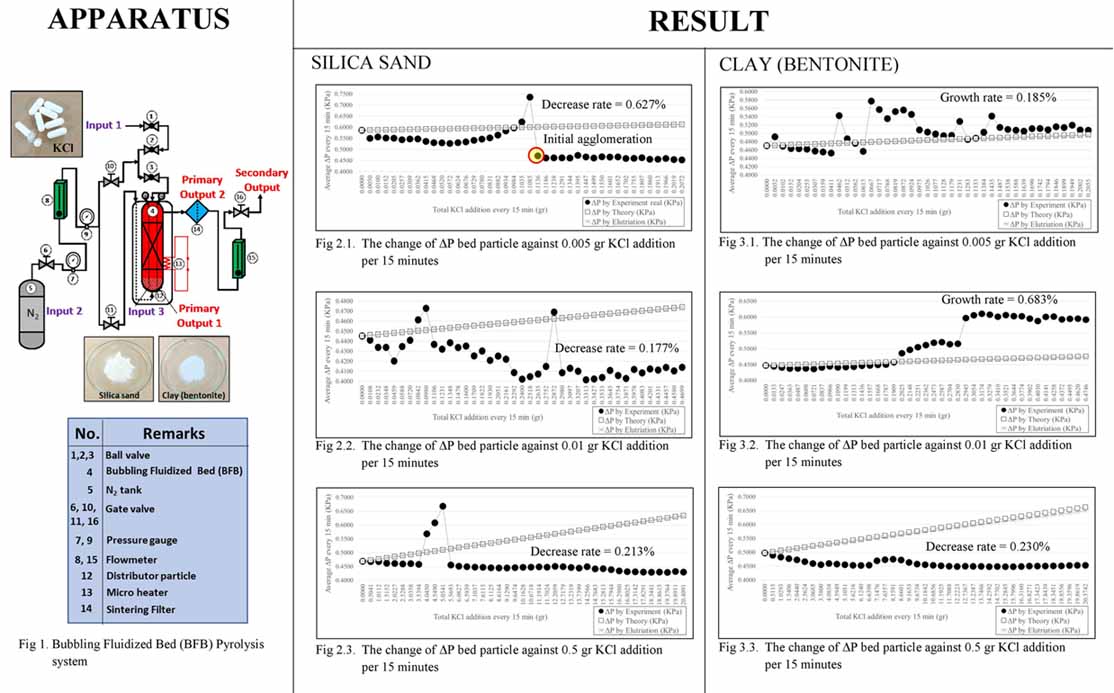
Separation is one of the important unit operations for industry. Wet separations such as froth flotation are utilized for particulate mixture. However, the conventional wet separations, which require large amount of water, are not convenient in dry districts. In particular, the lack of water is becoming a critical issue in mining areas with drought due to global warming. Therefore, the development of dry separations to replace the commonly used wet separations is in great demand. A gas-solid fluidized bed is one of the candidates for dry separation. When a particulate mixture having density difference is fluidized, lighter particles move up and heavier particles move down in the fluidized bed. This phenomenon is called “density-segregation”. Recently, we found that the density-segregation is enhanced when vibration is added to the fluidized bed. The vibro-fluidized bed is effective to separate particulate mixtures with small density difference. Here we investigated the dry separation of particulate ore with small density difference using the vibro-fluidized bed. We found that the density-segregation does not occur using only the fluidized bed without vibration regardless of fluidizing air velocity. In contrast, the vibro-fluidized bed enables us to separate the lighter mineral and heavier mineral based on the density segregation. The fluidizing air velocity is an important key factor to enhance the density-segregation by adding the vibration to the fluidized bed.
Hydroxyapatite-supported metal catalysts (M/HAp) has attracted attention in recent years especially in the oxidative dehydrogenation of light alkanes because hydroxyapatite (HAp) is a promising carrier with adjustable acid-base characteristics, high stability, and various metal substitutions. In the literature, HAp itself had shown very small catalytic activity in the oxidative dehydrogenation of propane (ODHP). Recently, we found that our heat treatment method, drip thermal treatment using a fluidized bed (DTFB), could improve the catalytic activity of nickel-incorporated hydroxyapatite (Ni-HAp) catalysts in partial oxidation of methane. In this study, HAp, metallic and bimetallic incorporated HAp (M-HAp or M1-M2-HAp) were prepared via DTFB under different atmospheres, and their catalytic activity in ODHP was investigated in a fixed bed reactor at different stoichiometric ratios of gas reactants. It was found that DTFB improved the catalytic activity of HAp itself in ODHP, and that metal species such as Co, V, and Mo were useful for metallic and bi-metallic incorporated HAp catalysts.
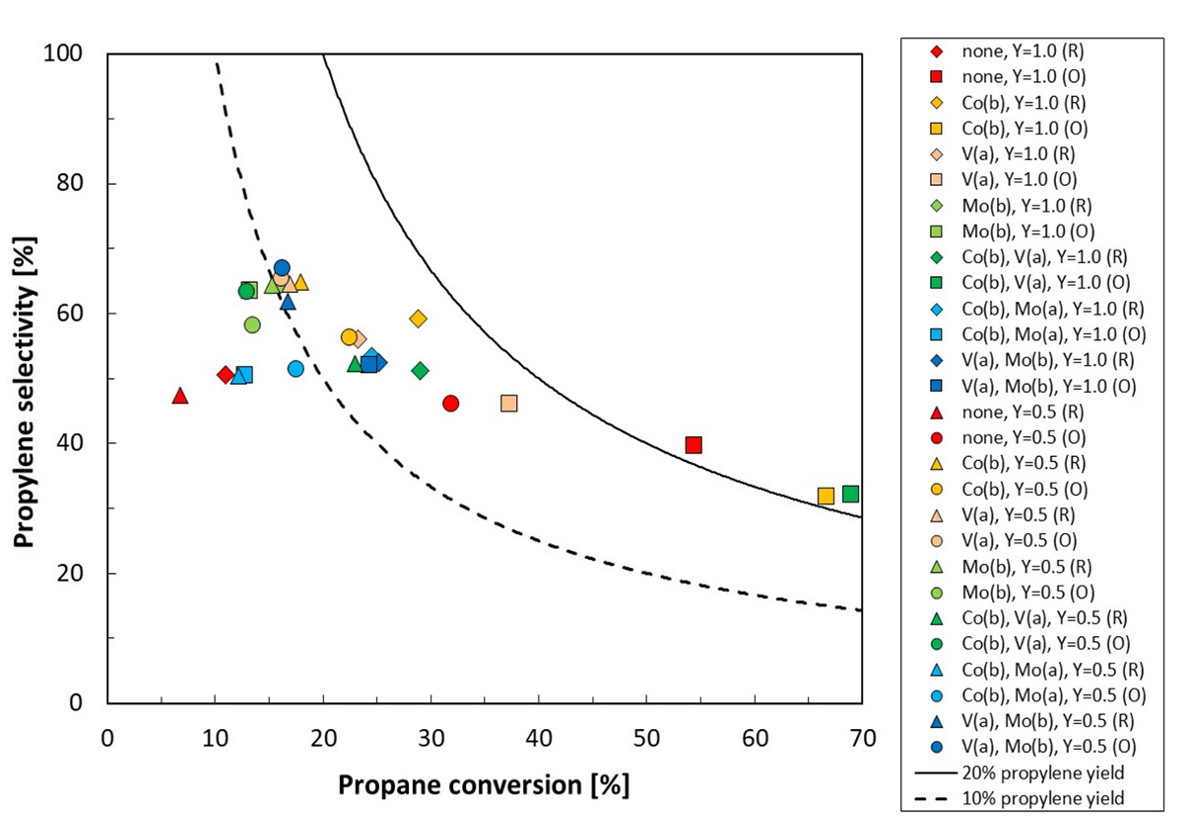
Thermochemical conversion of fuels via pyrolysis / carbonization, cracking, gasification and combustion has to involve a number of individual reactions called attribution reactions to form an intercorrelated reaction network for any conversion process. By separating one or some attribution reactions from the others to decouple their interactions existing in the reaction network, the so-called reaction decoupling enables a better understanding of the complex thermal conversion process and further the optimization of the conditions for attribution reactions as well as the entire conversion process to realize advanced performances. By far, numerous research works have been conducted about the application of reaction-decoupling method on gasification and combustion process in our research team. Some interesting findings were obtained: (1) catalytic cracking and reforming of tar on the surface of char is critical to deeply remove tar in gasification process, and there exists a loop between deactivation and regeneration of catalytic activity of char for tar removal; (2) tar generated from fuel pyrolysis has the highest activity and also capacity of NO reduction than char and pyrolysis gas do. Based on these fundamental findings, processes of fluidized bed two-stage gasification (FBTSG) and fluidized bed decoupling combustion (FBDC) have been proposed and commercially developed to break through the problems of tar generation for gasification and NOx emission reduction for combustion, respectively. After a series of tests at laboratory and pilot scales, two industrial demonstration plants with treating capacities respectively of 10000 t/a for gasifying herb residue and 60000 t/a for burning distilled spirit lees have been designed and built to verify the technical advantages of the proposed new processes. The results show that the FBTSG technology enables tar content below 50 mg/Nm3 in product gas and the FBDC technology lowers NO emission in flue gas to about 150 mg/Nm3 even burning fuel with 4 wt.% N (dye base). This report will summarize the fundamental finding, technical innvation, pilot test and industrial demonstration for both such technologies based on reaction decoupling.
Discrete Element Method (DEM) has been widely used to simulate powder behavior for the past several decades. DEM has many advantages compared to the continuum model; it is possible to include attraction forces such as liquid bridge, electrostatic and van der Waals forces and it accurately predicts the motion of individual particles in a system. One of the major drawbacks of DEM is the large calculation cost. Many of the particles used in industry are stiff and the contact time is short during collisions, which may require significantly small time step (in the order of micro to nanoseconds) in simulation. This makes it difficult or even impossible to complete simulations within acceptable time scale. Therefore, in order to increase the time step and reduce calculation cost, the particle stiffness is often reduced from the original material property. Although this approach is widely accepted for dry and relatively coarse particles where only contact force is dominant, it is reported that the particle behavior changes drastically when attraction forces are exerted on particles; particles with reduced stiffness become more “cohesive” than original particles. Hence, attraction forces are sometimes reduced to counter-balance this effect. In the present study, the effectiveness and limitations of this method are further discussed.
Dry powder inhalations (DPIs) is a dosage form for delivering powdered medicine to the lungs by an inhaled air flow of a patient, which is mainly used as a treatment for respiratory diseases such as bronchial asthma and chronic obstructive lung disease. The site of the human respiratory system where the powder inhalation formulation reaches depends on the size of the particle. Recent researchers actively conducted the design of DPIs for effective transportation in the human respiratory system, and they generally evaluated the lung reachability using a cascade impactor. Understanding particle motions and deposition behavior in not only a cascade impactor but also a respiratory system is necessary to improve the efficiency of DPI.
In the present study, we proposed the usage of a numerical calculation model combining computational fluid dynamics (CFD) and discrete element method (DEM). We constructed a cascade impactor model and a simple lung model to calculate the behavior of the fluid and particle transportation with CFD-DEM simulations. CFD-DEM simulations using a cascade impactor model demonstrated the experimental data of transportation ratios to each stage by adjusting the adhesion based on JKR theory. Furthermore, we investigated the effect of particle properties (particle sizes and particle densities) and the inhalation patterns (healthy and patient patterns) on the lung reachability of particles. As a result, we revealed that the relationship between the aerodynamic size and the lung reachability depends exponentially. The obtained relationship is essential knowledge for the design guide of DPIs because it enables ones to estimate the lung reachability of particles from the aerodynamic size.
1.Introduction
Jet mil is widely used for the process for dry powder milling. It has advantage of milling the sample without heating up the sample, because of its adiabatic expansion feature. However, in order to maximize the throughput, keeping the particle size small enough, optimizing the milling conditions is necessary. Conditions such as inlet pressure of the air, and feeding rate must be optimized by many trials before running the process for production. Those trials take lots of time and workload. Even after determining the optimized conditions, the size of the milled particles and throughput change with the variation of the lot of the materials to be milled. The flowability of the material also changes with time, which effects to the feeding rate of the feeder, and the particle size after the milling. To solve those problems. we propose real time measurement of the particle size of the milled powder, and discuss about the feed back control of the particle size.
2.Experimental method
We put a laser diffraction particle size distribution analyzer “Insitec” (Malvern Panalytical Ltd.), at the exit of a jet mill “STJ-200” (Seishin Enterprise Co., Ltd.). We used lactose for the milling sample. The inlet pressure of the jet mill was fixed to 0.6 MPa, and changed the feeding rate of the material.
3.Result
We could see the increase of the particle size, when we increased the feeding rate. This is caused by the insufficient milling force due to the too many particles in the mill. Therefore, we could change the particle size and the throughput, by just changing the feeding rate. We tried to optimize the feeding rate, using the real-time measurement data of the particle size analyzer. By using technology, the optimization of the jet mill process is possible, regardless the particle size and hardness of the materials to be milled.
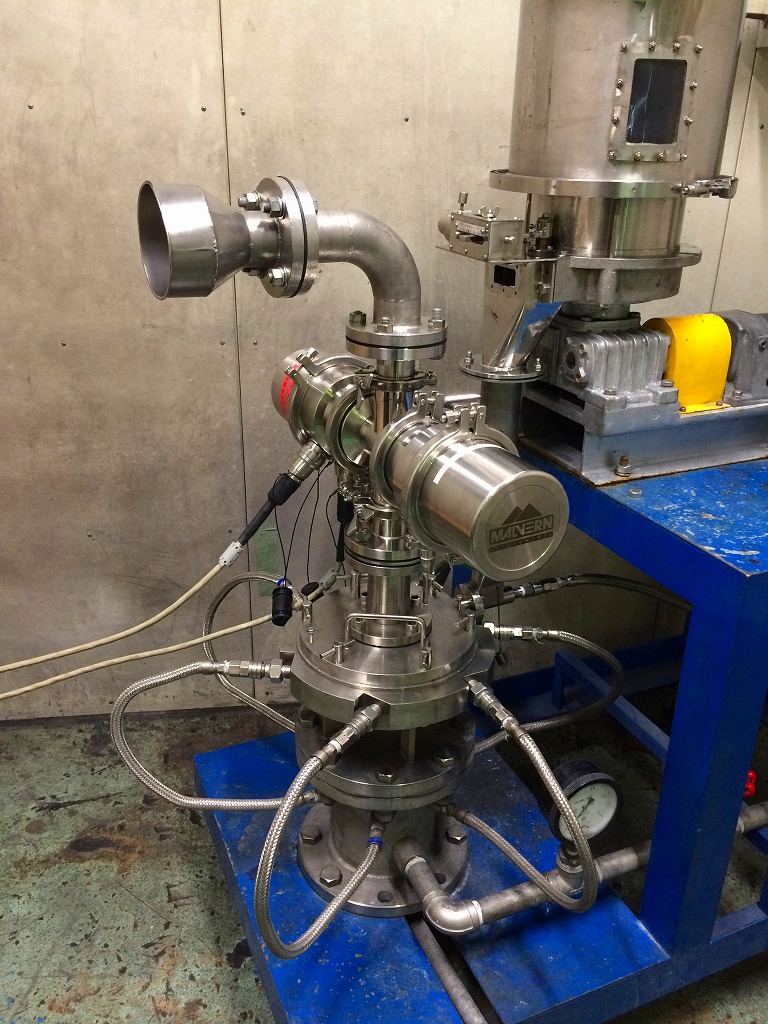
The entry of micrometer-sized outdoor particulate matters into indoor spaces via the re-entrainment of these particles from their sediment layer formed on medium-performance filter media used in air handling units of office buildings might have been of a certain concern. In the present study, we investigated the effect of loading of the medium-performance filter media, where micrometer-sized particles were deposited, with APA solution on the suppression of their re-entrainment by exposing to intermittent fast air-flow blowing.
We selected two types of unwoven and charged filter media as test media, the single-layer media composed of mixed fine fibers and coarse ones and the binary-layer ones composed of upper coarse fiber layer and lower fine one separately. The test media in sheeted or pleated form were loaded with Kanto loam particles at a given loading density, and then 10 ppm of APA solution at its given density. After one day for drying the test media, the media were exposed to intermittent blowings of fast air-flow at a given face velocity to count a number of particles released from the test media. For comparison the number of released particles from test media without APA solution loading or with DI water loading were counted in the same manner.
Fig. 1 compares the percentages of decrease in number of released particles from the binary-layer or single-layer filter media in sheeted or pleated form loaded with APA solution. It was found that the single-layer media had better performance on preventing re-entrainment of particles by APA-solution loading than the binary-layer ones. In addition, the pleated media were less effective in lowering the numbers of released particles from themselves compared to the sheeted ones. It was caused by the discrepancy of loading density between test particles and APA solution in the pleated media.

Particulate matter (PM) is a well-known air pollutant and most of them are soot emitted from fossil fuel combustion. PM diameter has been decreased with improvement of combustion technology. Especially, the concentration of PM2.5 (diameter less than 2.5 μm) has increased. Fine PM affects serious damage on human body. However, it is difficult for conventional method (e.g., bag filter, diesel particulate filter, and electrostatic precipitator) to remove PM from exhaust gas of combustor. In our research group, fluidized bed is used as a PM removal device. This device collects PM2.5 at high collection efficiency by adhesion force, which is dominant for small particle. On the other hand, the performance of this device strongly depends on fluidization state. Void fraction and gas-solid drag force is large at large flow rate. High void fraction makes PM difficult to approach to bed particle. PM separates from bed particle by large drag force. Thus, it is important for development of this device to understand the mechanism of PM collection.
In this paper, numerical simulation of this device has been performed based on combined computational fluid dynamics (CFD) and discrete element method (DEM) to calculate the trajectory of each individual bed particle and PM. PM is inlet with gas from the bottom side of fluidized bed and transferred upward with gas in fluidized bed while getting adhesion force such as van der Waals force, and separation force such as gas-solid drag force. When PM approaches to bed particle and adhesion force between PM and bed particle becomes larger than separation force, PM adheres to and is held on bed particle. CFD-DEM analysis also shows that adhesion force becomes dominant for PM diameter less than several tens μm at range of superficial velocity 0.3-0.5 m/s.
As the demand of copper has been rapidly increasing, the concentration of copper in raw ores has been decreasing, which has become a major issue for copper production. To meet a strong demand for copper production, it is highly anticipated to develop a new process which can efficiently separate copper minerals from gangue minerals. Among the available comminution techniques, high pressure grinding roll (HPGR) is expected to achieve high mineral liberation with relatively low energy consumption. It is known that HPGR grinding can selectively break grain boundary phases which have mechanical weakness. However, the mechanism of HPGR grinding is still unclear and the effect of HPGR grinding is limited.
The objective of this study was to investigate the effect of HPGR grinding on enhancement of liberation. To achieve this objective, HPGR grinding tests were conducted. The effects of operating conditions such as pressing force, feed amount and an initial roll gap, were investigated. After HPGR grinding, liberation of copper minerals was evaluated by a mineral liberation analyzer (MLA) and image analysis of pictures obtained from MLA was conducted to measure crack size and shape in grinding products. Experimental results indicated that liberation was enhanced because of the increase of cracks by HPGR grinding. These approaches also revealed how many cracks were generated and how the cracks penetrated through an ore or a boundary phase. To support experimental results, a numerical simulation was performed to evaluate forces acting on ores during HPGR grinding. The discrete element method (DEM) coupled with T10 breakage model was applied to reproduce a HPGR grinding. Simulation results suggested that the increase of force acting on ores led to the increase of crack in an ore. Therefore, experimental and simulation results revealed that the increase of the cracks in ores during HPGR grinding enhanced liberation.
Particle de-mixing may occur when particles of different physical properties are mixed. When mixing particles of different sizes, segregation bands and segregation cores may occur in the axial direction and radial direction in a rotating drum, respectively. Although theories and mechanisms of particle segregation have been proposed, a clear understanding of the underlying physics is still lacking. In this talk, size-induced particle segregation phenomena in rotating drums are reported. The mechanism of the segregation structure formation, the three-dimensional segregation patterns observed by experiments and by simulation, the control of the segregation intensity and the application of the segregation patterns will be systematically discussed.
The flow field, temperature distribution and species-in-phase distributions in a 13 MW pulverized-coal boiler are numerically studied using computational fluid dynamics (CFD). The gas phase is modelled using Eulerian frame, and the trajectories of the pulverized coal particles are described by the Lagrangian scheme. As the result, the predicted exhaust temperature and components are well agreed with the experimental data. The regions of the lower oxygen fraction locate approximately at the regions of higher temperatures. The secondary air injection mostly passes to the ceiling of boiler with very short residence time, and the trajectories of coal particles are similar to the secondary air paths. CFD technique successfully predicts the pulverized-coal combustion process in an industrial boiler.
In the past few decades, plastic products from polymers have been extensively used in daily life. In company with the convenience brought by plastic materials, plastic wastes become a critical issue for human society. One practical method to deal with used plastic products is pyrolysis process, which can turn plastic materials into short chain hydrocarbon and solid residues. Carbon black, the major residue material after plastic pyrolysis, has been widely adopted in many industrial applications. However, surface modification treatments are usually required for the recycled carbon black before used in various industrial applications, such as coating or filtration. Among various surface modification techniques, ball milling process has already been proved as a straightforward and easy mechanochemical treatment to modify surface properties of carbon black.
In this study, recycled hydrophobic carbon blacks from waste tire after pyrolysis process are used, and PSS-decorated carbon blacks are prepared through planetary ball milling. The shear force from milling process not only can decorate poly(sodium 4-styrenesulfonate) (PSS) onto carbon black, but also breaks the carbon aggregates into small fragments. The PSS-decorated carbon blacks become hydrophilic, and can be well-suspended in water. Effects of process parameters, such as milling time and solvents, on the surface properties and morphologies of PSS-decorated carbon black will be carefully examined via various analytical techniques, such as FTIR, SEM and thermogravimetric analysis. Dispersion stability tests will also be performed to prove the feasibility of making black pigment ink. Moreover, the printing quality of these inks will be examined to evaluate the possibility of applying recycled materials for printing and painting technology. In summary, this research offers general guidelines for reusing waste materials and pave the way for combining recycled materials with advanced technologies.
We have successfully applied a multiscale simulation (MSS) method [Murashima and Taniguchi, Europhys. Lett., 96, 18002 (2011)] to flows of a mono-dispersed linear entangled polymer melt in a contraction-expansion channel and in concentric cylinders. In our MSS method, a macroscopic model is coupled with a microscopic model through the velocity gradient tensor and the stress tensor. As the macroscopic model, the Smoothed Particle Hydrodynamics (SPH) method is employed, on the other hand, as the microscopic model, a slip-link model is employed. By using our MSS method, two-dimensional flows in a 4:1:4 contraction-expansion channel and axial flow in concentric cylinders are examined. From our multiscale simulations, we have evaluated detailed microscopic information that comes from the polymer chain dynamics, such as the local orientation of polymer chains, the average number of entanglements and the number density of entanglements along a polymer chain. In addition, we found that the number of entanglements generally decreases in the middle section of a polymer chain under flows. To explain this behavior, an equation for the entanglement density on a primitive path is proposed. These microscopic insights will bring us a stepping stone to design a polymer melt that has a specific property.
It is well known that certain cationic surfactant solutions with a counter ion cause significant drag reduction. In comparison with the coherent structure of the normal turbulence, vortex motion of drag-reducing flow can be restrained by the rheological property of surfactant solutions; consequently flow pattern might be greatly changed. The objective of this study is to clarify the flow characteristics of drag-reducing flow and to discuss the mechanism of the phenomenon.
The surfactant and counter ion we used were Ethoquad O/12 (C18H35N+(CH3)(C2H4OH)2Cl- and sodium salicylate (HOC6H4COO- Na+), respectively. Drag reduction rate (DR%) was measured by using PVC pipeline system having the diameter of 25 mm. We also measured the flow characteristics of the surfactant solutions with different concentrations and temperatures by using particle image velocimetry (PIV). From the experimental results, DR% at average velocity of 2.0 m/s increased from zero to 73% with the increase of the temperature from 10 to 50 °C at constant concentration of the surfactant (300 mg/L). From the velocity contour plot obtained from PIV, we found that the thickness of the lower velocity region of the drag-reducing flow was thick at 10 °C, while vortex motions seems controlled at 30 °C. On the contrary, the lower velocity region thickened with the increase of the concentration of the surfactant with constant temperature. Even if the same level of drag-reducing effects are taking place, we expected that the flow patterns are quite different depending on the concentration and temperature.
A nanofluid is a suspension of nanoparticles in a liquid and has attracted attention in diverse engineering fields, e.g. the nanofluid is expected as nano-ink for printed electronics. In such a situation, the knowledge of the effect of nanoparticles on wetting phenomena of nanofluid on a substrate is required. Therefore, the objective of this study is to investigate the effect of nanoparticles on wetting behavior in microscopic view using a phase-shifting ellipsometry we developed.
In this study, polydimethylsiloxane (PDMS) was used as a solvent, and PDMS-modified SiO2 nanoparticles were added within 3 wt% in the solvent. The particle size distributions of the nanoparticle suspension were evaluated using dynamic light scattering method, and consequently aggregates with a micrometer size were observed although the mean diameter was approximately 600 nm. In experiment, a droplet of pure PDMS or SiO2 nanoparticle suspension was put on a silicon substrate, and the microscopic wetting behavior near the contact line was quantitatively visualized by the phase-shifting ellipsometer. The phase-shifting ellipsometer can measure the two-dimensional thickness distribution of a liquid film at the nanoscale. Relations of the contact angle and the length of precursor film with a nanometer-scale thickness ahead of the contact line with capillary number were evaluated from the obtained thickness distributions to analyze the effect of nanoparticles.
The large difference in contact angle between the pure PDMS and the suspensions at the same capillary number was observed though the viscosity change with adding the nanoparticles is small. On the other hand, there was little difference in the precursor film lengths of both fluids at the same capillary number. These results indicate that the nanoparticles did not affect the precursor film region.
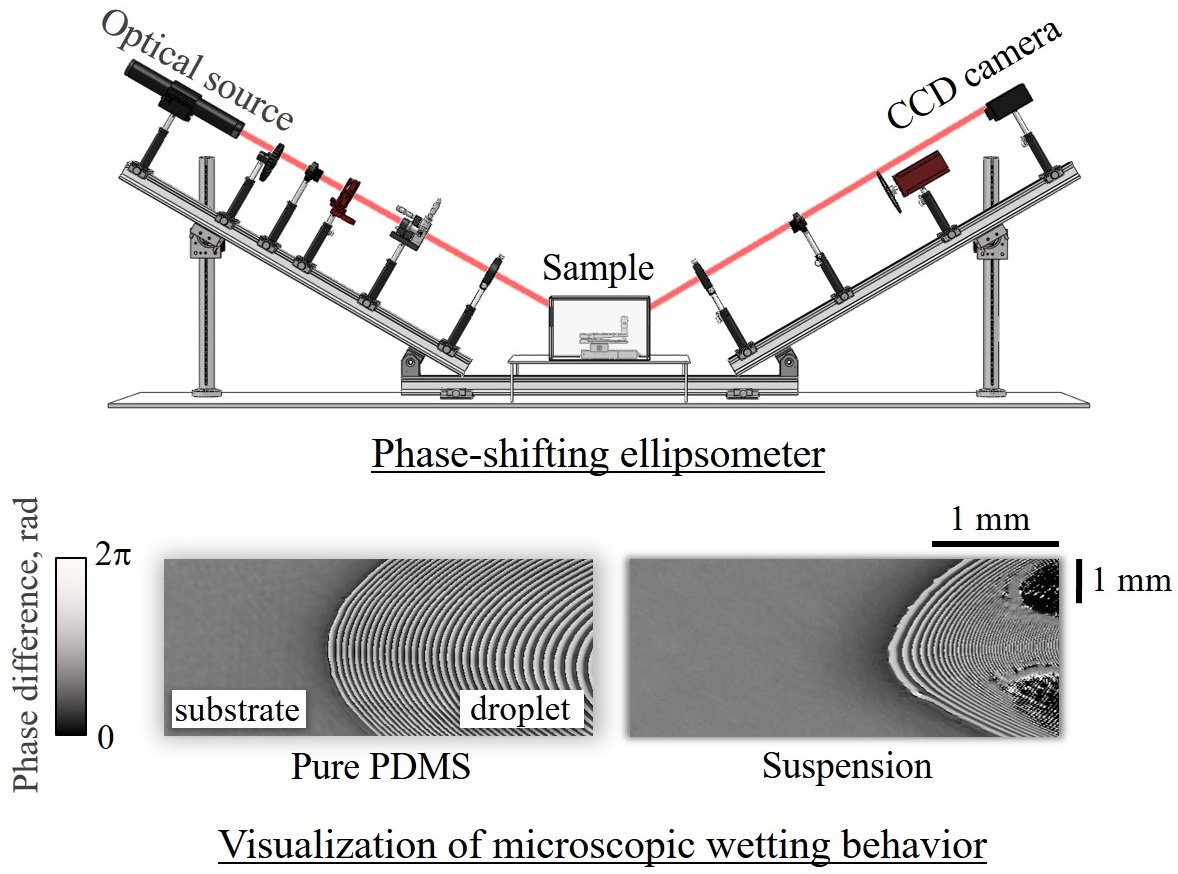
Most milky lotions and creams as cosmetics are emulsions and non-Newtonian liquids. In the emulsifying process of these manufacturing, a rotor-stator type emulsifying device is widely used. Each emulsifying device has a different shape of the rotating blades and stators. The size of the emulsified particles of the resulting emulsions varies depending on the device and its rotational velocity of the blades. The higher the shear rate produced by the emulsifying device, the smaller the size of emulsified particles produced. That is, it is considered that the size of the emulsified particles is greatly affected by the maximum value of the shear rate that the liquid receives as it passes through the emulsifying device. The emulsifying device is designed to generate a high shear rate. But the shear rate that the liquid receives is distributed because it depends on the route through the device. So far, we have evaluated the capabilities of emulsifying devices by experiments using specific model formulations. Today, we obtain the distribution diagram of the maximum shear rate that the liquid receives by numerical analysis. This distribution diagram can be used as an indicator of the capability of the emulsifying device.
In addition, the emulsifying device works like a pump that sucks and discharges liquid by high-speed rotation of the blades. This discharge amount is the processing capacity of the apparatus itself. When it is used in a mixing kettle, it also contributes greatly to total mixing.
This paper reports the evaluation of the capacity of the emulsifying devices by calculation of their maximum shear rate distributions and discharge amounts by using numerical analysis.
The technology of emulsions is used in various industrial application such as cosmetics, foods and pharmaceutics. It is also well known that mono-dispersed distribution is required stability. We focused on emulsions preparation by Shirasu Porous Glass (SPG) membrane emulsification. Compared to conventional emulsification method, this emulsification method doesn't require strong shearing force to prepare emulsions. It is also noted that the emulsions prepared by SPG membrane has mono-dispersed droplet size distribution and the droplet size. SPG membrane emulsification method requires only less energy input when prepare the same droplet size.
In this study, Oil-in-water (O/W) microemulsions prepared using SPG membrane emulsification method. Soya oil and ion-exchanged water were used as dispersed and continuous phase respectively. Sodium dodecyl sulfate (SDS) was used as anionic surfactant, and it added to ion-exchanged water. Soya oil was forced into continuous phase through SPG membrane (membrane pore size is 5 or 20 μm, and its surface is hydrophilic) using syringe pump. To disperse the oil droplet, the continuous phase was stirred by magnetic bar.
The effect of volumetric flow rate, stirring speed, and concentration of surfactants were examined. In this abstract, only about changing volumetric flow rate is described. In the condition that volumetric flow rate was changed 4 steps from 0.8 ml h-1 to 6.4 ml h-1 average droplet size, average droplet size had no significant change on each condition. Interestingly, these droplet sizes were about 3-4 times as large as membrane pore size (5 μm). On the other hand, coefficient of variation (CV), which is index of mono-dispersed distribution, increased with increasing volumetric flow rate.
Microfluidics, the potentiality of generating monodisperse droplets, is an interesting tool in the encapsulation process due to its capability of microparticles fabrication. Droplet generation which occurs by two immiscible fluid is controlled by providing of flow- or pressure-driven approach. To combining the size of droplet in both physical and operating parameters, using the dimensionless number characterize the flow motions in different systems was studied. The dependence of the droplet size/channel size on the flow rate ratio (Qc/Qd), viscosity ratio (λc/λd), Reynolds number (Re) and Capillary number (Ca) was investigated for a wide range of fluid properties and flow conditions. The data was collected from the two-channel size of the 100 and 190 μm etch depth of microfluidic flow-focusing devices. An increase of the flow rate ratio resulted in a decrease of the droplet size. The viscosity ratio played an important role in droplet generation. This study also reveals that the droplet size and flow regime could be correlated with the Re and Ca of both phases. A diagram of a changing of flow regime was obtained. Moreover, the results indicated that the monodisperse droplet not only occurs in a dripping regime but also could be produced in a tip-streaming regime.
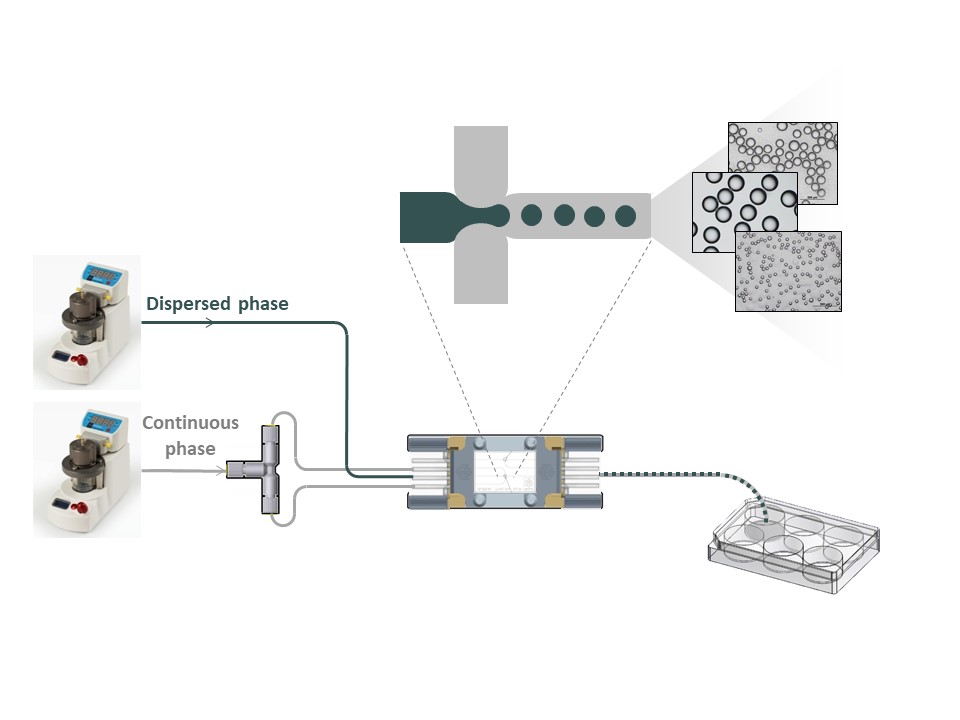
Magnetorheological fluid (MRF) attracts attention as a functional fluid of which viscosity can be controlled by magnetic field. Since MRF is a mixture of a base oil and magnetic particles, we often find particle sedimentation and/or oil separation due to the density difference and familiarity of the particles and the base oil. The objective of this study is to increase the sedimentation stability of MRF by using suitable stabilizing additives. Also, we consider the mechanism of stabilization with the connection of the network structure build by the additives and interaction with the magnetic particles.
We selected three stabilizing additives; a fumed silica, a styrene-based polymer, and an organogelator (PMDA-2C8/oleyl) and prepared MRF using such additives. We measured steady state flow characteristics and time-dependency of the viscosity of MRF by using a rheometer; Rheologia A-300, Elquest. Stability test was also conducted using a graduated cylinder. Morphological observation of the stabilizing additives was conducted by using a transmission electron microscope (TEM). From the experimental results, we found thixotropic behavior both for MFR prepared with the fumed silica and PMDA-2C8/oleyl. Particularly, PMDA-2C8/oleyl was expected to build internal structure due to the network formed by self-assembly of molecules. Although the viscosity of MRF increased with the addition of the styrene-based polymer, the MRF displayed no viscosity time-dependency. The styrene-based polymer can increase the yield stress of MRF, consequently prevent the sedimentation of particles. From TEM images, we can observe that fumed silica particles connected alternately, while the self-assembly of PMDA-2C8/oleyl formed network structure in the oil.
Magnetorheological fluid "MRF" is a slurry prepared with an oil and magnetic particles having the average particle diameter of several μm. Since the viscosity of MRF can be reversibly controlled by a magnetic field, MRF is classified as a functional fluid. The quick and large variation of the rheological property of MRF with respect to a magnetic field is convenient to the application such as dampers, brakes, and clutches of automobiles. In order to show good fluidity of MRF under no magnetic field conditions, suitable dispersant is generally added to prevent viscosity increase due to particle aggregation. Moreover, MRF has large difference of density between the oil and particles, consequently shows particle sedimentation and liquid separation of the upper layer. Therefore, the development of the technique to increase the stability of MRF is necessary.
In this study, we focused on the effect of fumed silica as a stabilizer, which is widely used for paint industries. We prepared MRF with oleic acid as a dispersant and several fumed silica additives <see table> with different surface characteristics. The rheological measurements and stability tests were conducted for thus obtained samples. From the results, we found that the degree of hydrophobization and the concentration of silanol groups of fumed silica affected to the rheological properties and stability of MRF. In addition, MRF prepared with hydrophilic fumed silica showed further reduction of viscosity by the addition of oleic acid as compared to hydrophobic fumed silica.

In this study, we numerically study and experimentally validate the flow resistivity of commercial nonwoven fabrics filters used for a bag filter system. A numerical method that coordinates the filter structure obtained by X-ray CT imaging with computational fluid dynamics using immersed boundary method is developed to represent a realistic flow field inside the filter during simulation. We investigated the effect of superficial velocity, porosity of the filter domain, and the type of filter then analyzed the results using Darcy's law. The results showed that the calculation results from our numerical method were quantitatively in good agreement with the experimental measurement. We also verify that the Kozeny constant can be estimated by utilizing the solid volume fraction defined by immersed boundary method. These results show that our simulation method can be used to clarify the effects of porosity, fiber arrangement, and fiber shape on the pressure drop. We will discuss the application of this method to coalescence of oil droplets in oil-water separation process.

There are lots of stuff, which is subject to the rheological issue, in a market. Typical examples are grease for mechanical industries, cream and hair gel for cosmetic industries, and gelatin for food industries.
On the other hand, there is few number of the research for mixing dealing with rheology due to complex factors, in spite of facing many of mixing problems in industries. One of the important factors is fluid viscosity. Therefore, as guided by N. Harnby et al. (Mixing in the Process Industries, 2nd edition issued 1997), in case of non-Newtonian fluid, mixing Reynolds number is modified with apparent viscosity, which is converted with coefficient of shearing rate (Kagakukogaku-Binran) proposed each type of impeller.
In this study, comparing with spinnability fluid and non-spinnability fluid (no 1st normal force difference fluid), as non-Newtonian fluid has been done, in terms of flow characteristics.
The mixing power has been measured with similar viscosity, the power for spinnability fluid is proportional to cubic of impeller speed for all type of impeller we have investigated. This is typical behavior in turbulence region. On the other hand, the mixing power for non-spinnability fluid perform differently. Exponent of impeller speed change from approximately 2 to 3, depending on impeller shape. However, flow is not observed, especially at the condition obtained exponent 2 of impeller speed.
Solution containing high-molecular-weight polymer or surfactant forming rod-like micelles show very complex flow behavior. Non-linear flow behavior became prominent especially under high shear rates or high extensional rates. That is due to non-uniform structure of dilute polymer or rod-like micelles solution, which is enhanced under the condition of high strain rates.
In this study, in order to detect non-uniform structure in complex fluids, optical tweezers was used to measure local viscosity of several Newtonian and viscoelastic solutions. Ethylene glycol solution, polyethyleneoxide (PEO, Mw = 3,500,000) solution and cationic surfactant solution were prepared as Newtonian and viscoelastic solutions. The cationic surfactants form rod-like micelles in the solution with the presence of counter ion supplier, which became highly viscoelastic. The average values of the local viscosity of these solutions measured by the optical tweezers were consistent with the viscosity measured by a rheometer. Then, distributions of the local viscosities were also obtained to quantify non-uniform structure of the solution. The local viscosity distributions of viscoelastic solutions were wider than that of Newtonian fluids. Especially, the distribution of rod-like micelles solution was much wider than that of the other solutions. The results suggest that the local viscosity distribution of each solution has non-uniformity information of viscoelastic complex fluids.
For the production of self-adhesive labels, high speed coating of adhesives is necessary to increase the productivity of labels. It is also required that the coated adhesives is as thin as possible to reduce the use of adhesives. Curtain coating is one of the candidate to achieve high speed and thin coating. However, curtain coating can cause some troubles like air entrapment resulting in the defect of the products. In this study, three-dimensional numerical simulations of curtain coating were carried out in order to investigate the mechanism of entrapment of air to coated films. The OpenFOAM tool box with VOF method was used for the simulation.
Simulation results reproduced four different regimes in curtain coating: coatable, heel formation, air entrainment, and air entrainment with heel formation. They are mapped on the diagram of the curtain Reynolds number versus the velocity ratios between coating speed (substrate speed) and impingement one. We will discuss the mechanism of air entrapment using numerically visualized flow fields.
In fluid processes in engineering fields, flow pattern characters are essential in the process performance, and are largely controlled by the geometric structures of the channel and/or driving element. In melt mixing in polymer processing, various elements, including screw and mixing elements, defines the channel geometry, and the resulting flow patterns are responsible for different mixing characteristics. Analyzing the flow pattern should be useful in understanding the mixing characteristics in connection with the different geometric structures of the mixing elements. Mathematically, the classification of flow field can be analyzed by the eigen-analysis of the deformation rate tensor [1,2]. However, such analysis technique have not been commonly applied in fluid processing. We have developed a simplified flow classification scheme based on the invariants of the strain-rate tensor and the vorticity tensor, which is frame-invariant [3,4] . The spatial distributions of these quantities offer an essential tool in understanding the flow pattern structure, and therefore can be useful to get insights into the connection between the geometry and the process performance.
[1] Tanner, R. I., and R. R. Huilgol, Rheol. Acta 14.11 (1975) 959–962.
[2] Chong, Min S., Anthony E. Perry, and Brian J. Cantwell, Phys. Fluids A 2.5 (1990) 765–777.
[3] Nakayama, Y., et al. AIChE J. 62.7 (2016) 2563–2569.
[4] Nakayama, Y., et al., AIChE J. 64.4 (2018) 1424–1434.
Ice cream is one of the most popular deserts in the world. Its physical and sensory properties depend on the microstructure of ice cream. Ice cream consists of bubble, ice, fat and the freeze-concentrated continuous phase. Because all the phases intricately interact each other, it is quite difficult to construct the precise principle for the control of ice cream properties in the production process. The microstructure of ice cream is determined in freezing process. During freezing process of the ice cream mix in an ice cream freezer, air is whipped into the mix. Air taken in the ice cream is broken down to small bubbles by the shear force. Also, the shear force induces fat globules coalescence which affects ice cream properties. Therefore, it can be considered that the shear force generated by the agitation operation dominates the microstructure of ice cream. In order to control ice cream properties from the perspective of agitation, in this study, the effect of agitation speed on the viscosity of the ice cream and the bubble size in the ice cream was investigated.
The commercial batch ice cream freezer with an impeller was used. During freezing process, the torque was monitored by a torque meter (ST3000II, SATAKE Chemical Equipment MFG. LTD.). Based on the measured torque, the apparent viscosity was estimated. The bubbles size in the ice cream was calculated from the image acquired by a digital micro scope (DMS1000B, Leica Microsystems LDT.).
The apparent viscosity decreased with the increase in the agitation speed. This means the agitation speed has an influence on the sensed creaminess during consumption. Furthermore, it was found that the increase in the agitation speed leads the increase in smaller bubbles with a narrower size distribution. These results imply that the rheological properties can be controlled by the agitation operation.
The gas-solid fluidized beds have been broadly studied, both experimentally and theoretically because they are widely applied in several industrial applications. However, most of the previous studies reported their findings based upon spherical particles while in practice, particles in gas-solid fluidized beds are generally non-spherical. In this study, the combined approach of CFD-DEM (Computational Fluid Dynamics - Discrete Element Method) is used to simulate the gas-solid fluidization process of ellipsoidal particles to analyse the effect of particle shape on bubble dynamics. Simulations for single jet fluidized bed by injecting gas jet only through central orifice showed that the bubbles for ellipsoidal particles are larger in size, have a greater bubble size distribution and higher bubble break-up frequency. The bubbles for ellipsoidal particles have lateral drift, therefore, while rising through the bed they travel away from bed centreline. Simulations for uniform gas injection demarcated that the bubble and solid flow patterns are asymmetrical for ellipsoidal particles compared to spherical particles. The bubble size is smaller and the bubble size distribution is broader for ellipsoidal particles. Both types of simulations exhibited that the difference in particle shape can result in different bubble behaviour, for example, a region of bubble formation, bubble trajectory and bubble properties. Moreover, ellipsoidal particles have preferred orientation which can depend upon the development of bubbles. The ellipsoidal particles align parallel to the fluid flow direction around the bubbles while they align perpendicular to the fluid flow direction at the top of the bubble. The findings deduced from this study can aid in the understanding of particle shape effect on gas-solid fluidized beds.
Particle suspension characteristics are predicted computationally in a stirred tank with solid concentration of 25% and driven by rigid-flexible impeller. The software of Fluent was utilized to investigate flow field structures in stirred tank. The effects of impeller type, length of flexible material, connect way of flexible material, mixing time were investigated by using the Eulerian–Eulerian two-fluid model and the standard k–ε turbulence model. It turned out that the structure of impeller has an obvious effect on solid particle distribution. The suspension of solid particles in the rigid-flexible impeller system was more homogeneous. It was also suggested that longer flexible material and longer mixing time results in well homogenous distribution of solid particles in the tank equipped with rigid-flexible impeller. On the whole, the rigid-flexible impeller could enhance the suspension of solid particles effectively.
Hydro thermal cracking process of residue oil is an important technical route in the area of heavy oil processing. Because of a few catalyst loading, low cost, and low blocking probability, the slurry bed is better to be applied in processing residue oil, especially for heavy residue. With the increase of conversion, the stability of residue oil becomes weaker, and some unstable compounds may be crystallized easier. The precipitates will be attached at the surface of catalysts and reactor, which will lead to the deposition of catalyst and blocking. The distribution of velocity and temperature inside the reactor is essential for reducing precipitation of unstable compounds, and preventing reactor from blocking. Based on the results of a pilot plant, an industrial hydro thermal cracking reactor of residue oil was developed. Then, the flowing and distribution of fluid and deposition of catalysts were simulated by CFD. To reduce the deposition of catalysts inside the large slurry bed reactor, the position of inlet of residue oil was optimized. Furthermore, the distribution of temperature inside the reactor was predicted by CFD. It can be found that the distribution of temperature inside the reactor was very uniform, the difference in axial temperature is less than 3K, the difference in radial temperature is less than 1K.
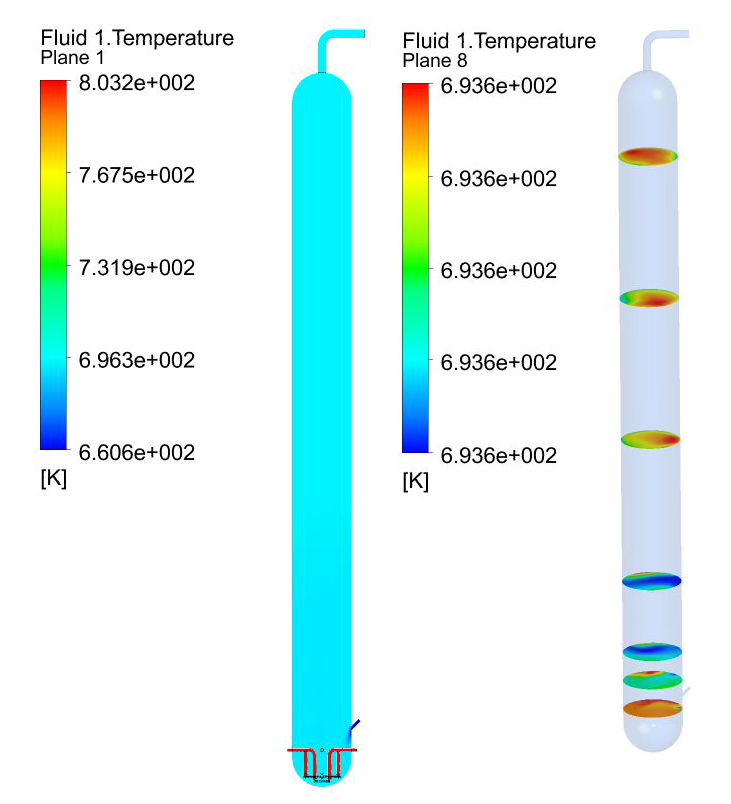
Though the grinding operation is a unit operation that has been known for a long time, it still often occupies an important position in industry. Thus, various grinders have been evolved and produced in a variety of shapes to meet changing needs. In principle, bead mills can provide grinding conditions under a high packing density and high energy density of the media as well as cover a broad range of output. Therefore, their future application is highly expected to respond to the requirements of various grinding operations by the current industry. However, bead mills have a short history compared to other types of grinders. Especially for dry bead mills, it is hard to say that they are well known. That is why we studied and reported the performance of horizontal dry bead mills in this presentation.
For the experiments, 2 sizes of horizontal dry bead mills with different capacities, lab and manufacturing scale, were used to study scaling up and down. The grinding experiments were performed by changing each typical grinding factor for bead mills, including the agitator peripheral speed, bead packing density, bead diameter, and material feeding speed. This set of experiments was conducted for 3 kinds of materials, silica sand of natural inorganic materials, alumina of synthetic inorganic materials, and activated carbon of organic materials.
As a result, common for all materials, similar rules were found between the particle size and specific energy, the amount of mechanical energy per unit amount of material. In addition, these rules were applicable for the different-size mills, indicating that the scale can be controlled by the rules and specific energy. Also, it is revealed that when using a single type of material, changing the bead diameter changes the energy efficiency, indicating that using small-diameter bead was effective for efficient grinding.
In an effort to achieve the highly efficient synthesize upconversion nanoparticles (UCNPs) with controlling over properties, we report for the first time a continuous flow synthesis of hexagonal β-phase NaREF4 NPs using microflow system. The precursor solution was prepared by the reaction of rare earth oleate, sodium oleate and ammonium fluoride, which avoided the production of NaF at room temperature and speeded up the hexagonal nanoparticle growth rates at high temperature. Specifically, the separation of nucleation stage and growth stage was achieved by means of segmented temperature control in the microflow system. The nucleation and growth reaction mechanism were further studied and the experiments of using different temperature, reactant concentration and flow rate were designed to study the influence on the shape and size of β-phase NaREF4. The ultra-small (5-6nm) β-NaYF4:Yb,Er nanoparticles were prepared by Gd3+ doping in the microflow system. And the monodisperse sub-10 nm core-shell nanoparticles β-NaYF4(Gd):Yb,Er@NaYF4 were prepared successfully by mixing the core solution and the shell precursor solution via a continuous microfluidic process. The β-phase nanoparticles exhibit green and red emissions under excitation of laser at 980 nm. Our research opens a door for the synthesis of upconverting nanocrystals in the continuous flow reaction system.
The growth of a pinhole generated in a thin coated liquid film was simulated numerically in order to study the mechanism of dewetting on a thin coated adhesives. Navier-Stokes equations of a one-fluid formulation were solved by projection method and the motion of the liquid-air interface was traced by a VOF method. Rheological properties of the liquid were approximated by a Carreau-Yasuda model. The OpenFOAM tool box was utilized to perform the numerical simulations. Simulated results were in good agreement with experiments where a pinhole was spread on a coated film of adhesives. The growth rate was proportional to the inverse of Ohnesorge number and therefore it decreases when the viscosity of the liquid is high and the surface tension is low.
Laminar film condensation of saturated vapor on the surface of a low-fin tube was numerically simulated in order to examine the effect of the shape of the tube. Navier-Stokes equations, an energy equation, and a continuity equation including phase change were solved simultaneously. Vapor-liquid interfaces were traced by VOF method. The OpenFOAM tool box was utilized to perform the numerical simulations.
Figure 1 shows an example of the simulation results. When the fin pitch is large, the condensate drips as a tuft from the lower part of the fin. When the fin pitch is small, on the other hand, the condensate falls as a curtain after filing the condensate between the fins.
The rate of condensation was obtained from the numerical simulations. When the fin pitch is small, the rate of condensation increases with the fin pitch. However, the rate decreases with the pitch when the pitch is larger than the certain value. It has thus suggested that there is an optimum fin pitch. Numerical simulations are expected to be able to optimize the shape of low-fin tubes.
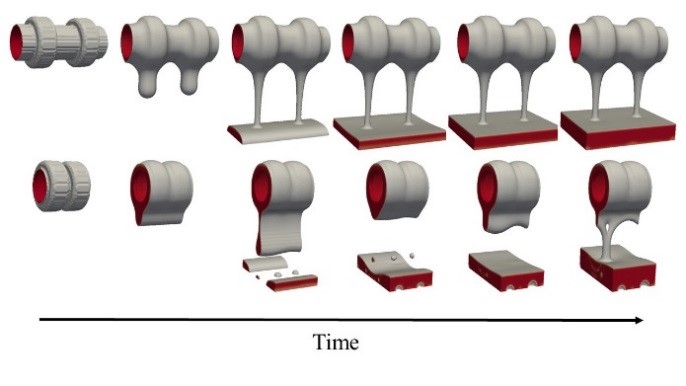
Particle generation process from droplet in a spray dryer is investigated. In the spray dryer, droplets generated from an atomizer are introduced to the dryer with hot air. While droplets are heated in the airflow, the air is cooled by exchanging heat with droplets. The atmosphere of the droplet such as temperature and humidity therefore changes with time in the dryer. Because drying behavior is influenced by the temperature and humidity around the droplet, drying of droplet should be evaluated by considering change in atmosphere of droplet. However, the drying of droplet has been studied under fixed conditions in the past researches. In this study, to observe the drying behavior, a droplet suspended on the tip of a wire is heated by the controlled air flow.
A slurry droplet of silica particles in water is studied. The effect of flow rate on the drying of droplet is investigated because flow around the droplet would affect the local heat transfer rate. Fig. 1 shows examples of the drying results with slurry droplet. At higher flow rate, mushroom-shaped particle are obtained. On the other hand, doughnut-like particle is obtained at lower flow rate. The results could be explained in terms of the particle Reynolds number.
The solution droplet of dextrin in water is also investigated. The effect of temperature on the drying is especially studied. As the drying proceeds, a solute layer is formed on the surface of the droplet. The permeability of water vapor through the solute layer is low especially for the use of dextrin. When the temperature is higher than the boiling point of the solution, boiling happens inside of the droplet then expanded particle is formed. On the other hand, the particle containing water inside of the particle is formed for the lower temperatures.
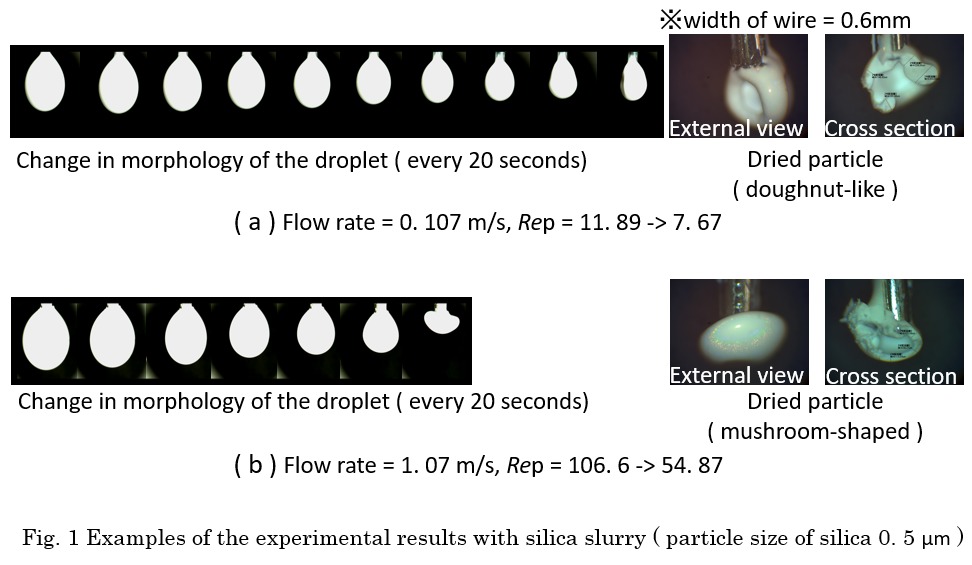
The gas dispersion in stirred tank is a widespread operation in the chemical and biochemical industry. In the process of gas dispersion, control of bubble size is important factor for the mass transfer process, and the performance relies heavily on its impeller design. Rushton turbine (RT) has been commonly used for the process because of its strong shear force. Thus, we proposed a novel kind of impellers, what we call fractal shaped impellers based on the RT. A kind of fractal structure, Koch curve was applied on blade tips of RT as shown in Figure. We expected that increase of the length of a side by iterations of fractal structure promoted shear around the wingtip and generated multiscale vortex to break up bubbles in gas dispersion.
Consequently, we investigated the effect of fractal shaped impellers on mass transfer process in gas dispersion. A stirred tank of transparent acrylic with four baffles was used for the experiment. An optical dissolved oxygen sensor was located in the front face of a baffle to evaluate the volumetric mass transfer coefficient (kLa) from variation of oxygen concentration in the tank. The bubbles discharged from a blade were visualized by high speed camera. The bubble size was measured by both photographic method and image analysis.
First, the kLa of each impellers was evaluated under the same power consumption. The kLa increased by using KF-I type impellers and KF-Ⅱtype impellers didn't make a difference. The generate bubble size also became smaller by using KF-I type impellers. Finally, we confirmed that the more small bubble generated from the blade, the more kLa increased in the tank.

Gas-liquid slug flow is a flow pattern in which gas and liquid flow alternately.
There are numbers of prior researches on enhancement of extraction and reaction using the mixing effect of circulating flow inside a liquid slug, however, there are few experimental examples focusing on the shape change of gas slug due to dissolution.
This investigation focuses on the shape changing of gas slug in order to control slug size by changing flow rate and channel geometry to apply it for size-controlled micro bubble production.
Liquid phase was degassed and then pressurized from a reservoir to T-junction microchannel made of PDMS with controlling flow rate. Oxygen gas was injected to the microchannel through the gas-injection nozzle by using syringe pump. Size-controlled gas-liquid slug was produced by injecting both fluid and observed with a close focus lens above the microchannel. The change of slug volume and shape effected by liquid flow rate were investigated from captured images.
Figure shows the time course of oxygen slug shrinking behaviour in condition of no flow of gas and liquid phase after slug production.
The change rate of slug length for flowing condition of liquid phase was larger than that of no flow condition, therefore, liquid phase flow promoted gas slug dissolution.
Without degassing of liquid phase, shrinking of gas slug was not observed. It is thought that dissolved gas concentration is important parameter to control gas slug size.
By measuring slug size, the possibility to control the gas slug size was indicated and precisely controlled microbubble production is expected using this method by injecting size-controlled gas slug into vessels filled with liquid.
This method for microbubble production might be the solution to overcome difficulties of small bubble detaching in conventional bubble formation from a nozzle or a slit.
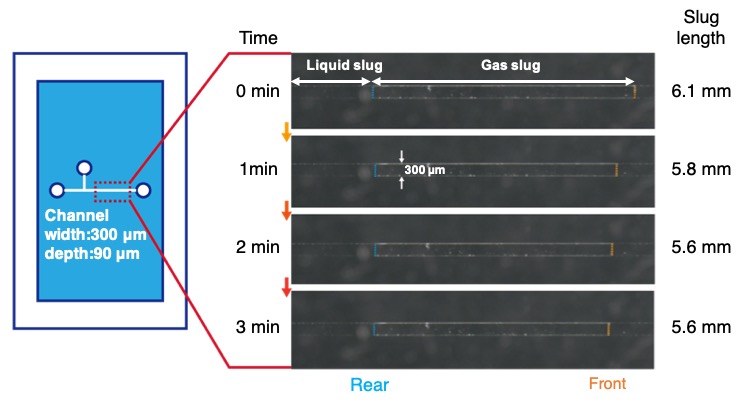
In many processes in which particles are operated, adhered particles on the wall of equipment and pipes cause problems such as contamination and blockage in feeding or transportation. Therefore, it is required to reflect the adhesion characteristics in the process design and the determination of operating conditions. However, the designing method and the prediction method of operating conditions with taking into the adhesion characteristics have not been established yet.
Because a particle behavior in these process operation is affected by fluid motion, the evaluation of adhesion characteristics based on the force induced by fluid motion is useful for establishment of the designing or the prediction method. As one of simple operation relating to the adhesion and fluid motion, we focused on the air jet removal of particles. In the air jet removal, adhered particles are separated from a wall by high-speed air flow ejected from a nozzle. The removal efficiency of the air jet removal depends on the dynamic pressure of the impinging air flow on a wall. It suggests that the separation force acting on a particle is determined by the dynamic pressure.
In this study, a slit nozzle having a width of 0.25 mm and a length of 20 mm was used as a reference nozzle, and 7-types of spherical silica particles having different particle diameter ranges were used as a reference particle. The removal efficiency of these particles from the borosilicate flat glass plate was determined experimentally. From the correlation between the diameter of reference particles and the required dynamic pressure for the removal, the separation force acting on reference particles was determined as a function of particle diameter and dynamic pressure. By means of these reference particles known to the separation force, the adhesion between the various wall surfaces and the reference particles was determined.
Lack of experimental data for droplet breakup is one of the limitations for the application of population balance model (PBM). We present here a new method to directly measure the breakage of droplet swarm in a pulsed disc and doughnut column (PDDC). A high speed camera was used to directly measure the droplet breakup frequency and daughter size distribution for a series of liquid-liquid systems. The multiple breakup was treated as an original breakup and several intermediate breakups in order to characterize the process quantitatively. The effects of pulsation intensity, dispersed phase viscosity and flow rate, interfacial tension were investigated in detail. The data covers the main factors affecting the droplet breakage in the PDDC and are sufficient to support the establishment of useful empirical correlations for breakup frequency and daughter droplet size distribution. The experimental results and correlations all indicate that the breakup frequency increases with the decreasing of the dispersed-phase viscosity or the interfacial tension, or the increasing of the pulsation intensity. The daughter droplet size distribution broadens considerably with decreasing interfacial tension. The correlation equations were then used in a CFD-PBM simulation to calculate the droplet number density, which further proved the feasibility of the correlations.
The bubbles in rice flour dough were investigated under constant temperature. The change of distribution in bubble size plays an important role in controlling food texture. If the formed bubble size depended mainly on three kinds of force, such as inertial, viscous, and surface tension, then the normalized mean bubble diameter should be a function of Reynolds Number and Weber Number. We obtained our experimental data mainly using a home size whipper, and we compared the data with the results obtained from the dough with nine kinds of rice flours prepared by different milling process in this work. We also added the size effect of rice flour particle as Bond Number. Furthermore, we carried out a dynamic wettability test in order to estimate wettability of rice flour surface. The results of the dynamic wettability test were described well by Washburn equation, and dccosθ was calculated as a parameter of wettability (dc : effective diameter of capillary in powder bed, θ: contact angle). The relationship between Bo and dccosθ/dp, normalized wettability parameter by particle size (dp) of rice flour, was obeyed by a straight line. Thus, it was suggested that the powder properties of rice flour could classify by interface properties. The mean diameter of the bubbles (dbm) generated by whipping was expected to be affected by the thickness (d) of the rod of whipper, its movement speed, physical properties of material and gravitational acceleration. The dimensionless mean diameter (dbm/d) was expressed by a dimensionless equation. It was found that We was high contribution for mean diameter from the result of its power index obtained from the dimensionless equation demonstrated. The empirical equation obtained was generally applicable to the variety of materials selected. Consequently, the bubbles in rice flour dough generated by whipping process could evaluate with the interface properties of rice flour.
Nitrile Rubber (NBR) latex is used for making various gloves. The rheological properties of Nitrile Rubber Latex blended with Titanium Dioxide (TiO2) were investigated using a rheometer. By carry out rotational and oscillatory tests, the relationships of viscoelastic properties such as viscosity, complex viscosity, storage modulus, loss modulus and phase angles were investigated.
Rotational test determine the relationship of viscosity and shear rate. Respond on the viscosity was investigated by increasing the shear rate. The samples under studied were pure NBR, compound NBR and compound NBR with different phr value of filler. In these tests, the viscosity of the NBR decreased with increasing shear rates.
Oscillatory tests were carried out to determine the relationship between complex modulus and angular frequency. The higher the angular frequency applied, the lower the complex viscosity were obtained for the samples. Viscoelastic properties such as storage modulus, loss modulus and phase angles were studied. The storage modulus of the sample decreased when angular frequency increased. Whereas the loss modulus increased with increasing angular frequency. This indicates that the fluids are more favourable on energy loosing rather than energy storing. By referring to the phase angles, the fluid's flow behaviour can be easily known. 0 °phase angle indicates the fluid exhibit perfect elastic behaviour, whereas 90 °phase angle indicates that the fluid is exhibiting Newtonian flow (water behaviour). NBR compounds shows viscoelastic behaviour
It is known that high pressure grinding roll (HPGR) is an effective grinding method to enhance the liberation of minerals with high energy efficiency. HPGR grinding has many kinds of operating parameters which affect the liberation state and the optimum operating parameters strongly depend on a types of ores. From the viewpoint of industrial application of HPGR in mineral processing, it is essential to decide the optimum operating conditions depending on ores. Since a batch of HPGR experiment in pilot scale requires huge amount of ore samples, it is difficult to conduct and repeat experiments in various operating conditions. Therefore, it is highly anticipated to newly develop a laboratory-scale HPGR which only requires small amounts of ores at an early stage of mine development.
The objective of this study was to develop a laboratory-scale HPGR which can reproduce grinding results similar to those obtained from a pilot-scale HPGR. To achieve this objective, the discrete element method (DEM) coupled with T10 breakage model was applied to reproduce a HPGR grinding process. First, grinding processes of ores in a pilot-scale HPGR were simulated by the DEM coupled with T10 breakage model. Comparison between simulation results and experimental results was also conducted for the validation of the simulation model. Good agreement was confirmed for throughput of ore, energy consumption and a working roll gap. After the validation of simulation model for a pilot-scale HPGR, this simulation model was applied to a laboratory-scale HPGR. An appropriate shape of a roll installed in a laboratory-scale HPGR was investigated. Simulation results indicated that the suitable roll shape for a laboratory-scale HPGR was designed by a dimensionless roll gap and dimensionless throughput. A laboratory-scale HPGR designed based on simulation results could experimentally reproduce grinding results similar to those obtained from a pilot-scale HPGR.
Very dilute high-molecular-weight polymer solutions induce complex flow behaviors. This is due to polymer deformation in a flow, which causes mechanical interaction between a deformed polymer and fluids, and between polymers in flows. We consider such polymer-fluids interaction and polymer-polymer interaction clarify the complex behaviors of polymer solution.
In this study, we measured the drag force of polyethyleneglycol (PEG) in flows by using a scanning probe microscope (SPM). Methoxy polyethyleneglycol thiol (mPEG-SH) was attached to the cantilever probe of the SPM, which was further immersed in flows of glycerol and polyethyleneglycol (PEG) solutions. Here, we have prepared several molecular weight of mPEG-SH from 10k to 40k. The mPEG-SH-bonded cantilever detects the extra force due to polymer-fluids and polymer-polymer interaction in flowing fluids. The extra force was increased with increasing the molecular weight. The conformation of the mPEG-SH polymer bonded to the probe of the cantilever was predicted, and the drag force due to the deformed mPEG-SH was calculated. The forces detected by experiments using the SPM and the forces obtained by model calculations were compared, and found to be reasonably close.
The mass transfer of the liquid-liquid extraction process in the alternating flow of two immiscible liquids in the microchannel was experimentally visualized. In this flow, each segment flows alternatively in the microchannel. In this study, water with congo red as the indicator, and cyclohexane with acetic acid were induced into the microchannel with the rugged wall of the diamond shape. The alternating flow of these two kinds of liquids was observed, and the mass transfer of acetic acid from aqueous phase into organic phase was visualized as the change of the color of aqueous phase. Figure 1 shows the experimental result. The microchannel was made of stainless-steel and placed between two quartz glass plates. The narrowest width of the microchannel is 0.3 mm, and the widest one is 1.45 mm in the diamond shape. Two kinds of liquids were fed into the microchannel with the syringe pumps at 0.07 mL/min (13 mm/s). Orange area is aqueous phase of water with congo red, white area is organic phase of cyclohexane with acetic acid. Blue area is aqueous phase of water, congo red and acetic acid which transfers from organic phase, and the color of aqueous phase changes from orange to blue as the concentration of acetic acid increases. The color of the aqueous phase completely changed from orange to blue after 9.95 mm from the confluent point. As the result, the distance from the confluent point where the color changed completely from orange to blue becomes longer as the inlet velocity increases. This result suggests that the ruggedness of the wall is not effective for this extraction process. This work was supported by the Grant for the Promotion of OUS Research Project (OUS-RP-30-4) of Okayama University of Science.

In laminar mixing with a large-type impeller, the initial injection point of the mixing object is known to influence mixing processes and the mixing completion time. This study investigated the relation between the injection points and the mixing performance of MAXBLEND, a large-type impeller, by CFD of tracer particles.
For this study, a 0.1 m diameter vessel was used. 1331 particles were placed on an injection point as a 53 mm3 cube. Based on the three-dimensional particle coordinates for every time, the distance from each particle to the nearest particle is calculated (Lnp). The average of these distances was calculated for every time (Lnp, ave).
In all, we investigated 48 injection points (Fig. 1). In Fig. 1, the results of the numerical simulation of mixing are shown as a relation between time and Lnp, ave . As shown there Lnp, ave gradually becomes larger with advanced mixing from 1 mm (t = 0). It becomes almost constant in a complete mixing state. For injection point No. 32, the mixing completion time was the shortest. However, the mixing completion time of No. 38 was the longest. Results showed a large difference in the complete mixing time depending on the injection point.
To investigate the scale-up effect, mixing in the 0.15 m diameter vessel was simulated. When the Reynolds number was equal using the same liquid, the relation between Lnp, ave and time in a large vessel differs from that in a small vessel.
However, these data are arranged similarly to the lines, independently of scale, using dimensionless mixing time, which is the product of the time and the impeller rotational speed, and the normalized average nearest particle distance, which is calculated by dividing Lnp, ave by the vessel diameter. Results demonstrated that mixing in the large vessel can be estimated from results of the small vessel using this relation.
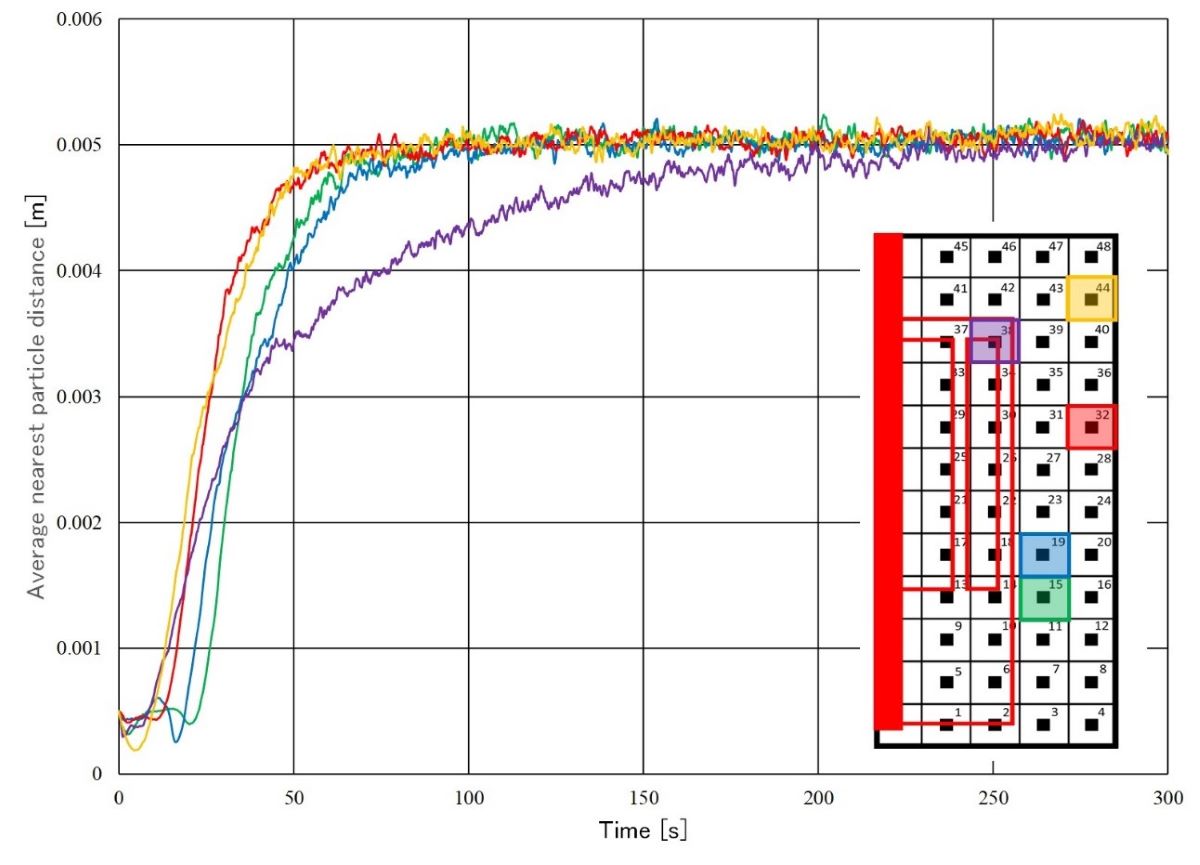
Fine particles make an important role for the production of functional materials in various industries such as foods, pharmaceuticals and paints. Because physical properties of fine particles depend on the particle size and the particle size distribution, it is important to accurately control these properties during the processing. Recent developments in functional materials have been required for more accurate control of the particles size and the particle size distribution.
Generally, fine particles are produced using a stirred tank with the aim of large-scale production. However, in the stirring tank, fine particles easily aggregate due to shear in a flow filed. Therefore, in order to control the particle size and the particle size distribution, the effect of shear on particle aggregation should be understood. However, there is the shear force (shear-rate) distribution in a stirred vessel and it differs with the impeller type. It is necessary to clarify how the difference in the impeller type affects the particle size and the particle size distribution. This study investigated the effect of impeller type on the size distribution of aggregate of fine particles.
Two types of impeller, a Rushton turbine and a 3-retreat impeller were used for particle aggregation. The size distribution of aggregates was measured by a microscope (VHX-100, Keyence Co., Ltd.) and a laser diffraction particle size analyzer (SALD-300V, Shimadzu Corp.).
It has been found that the 3-retreat impeller promotes particle aggregation as compared with the Rushton turbine impeller. Besides, energy dissipation with the 3-retreat impeller was larger than it with the Rushton turbine impeller. These results imply that an impeller with smaller energy dissipation would suppress particle aggregation. In the conference, the results using a Taylor-Couette flow apparatus having the relatively narrow shear-rate distribution will be also reported.
During the past decades, nanoparticles (NPs) have been widely studied as carriers of drug delivery system. Unlike the animal cells, plant cells have a rigid cell wall, and it is physical barrier for intracellular NP uptake. However, past our study revealed that the poly lactic-co-glycolic acid (PLGA) NPs were taken into the tobacco BY-2 cells with cell wall by controlling the NP exposure condition. In this study, we attempted to deliver PLGA NPs containing hydrophilic biomaterials into the tobacco BY-2 cells. The fluorescent BSA was used as model biomaterials. BSA adsorbed PLGA NPs were prepared as follows: PLGA NP was prepared by the emulsion solvent diffusion method. In order to adsorb negatively charged BSA on the PLGA NPs, the cationic lipid DOTAP was adsorbed on the PLGA NPs and BSA was then adsorbed on them. BSA encapsulated PLGA NPs were prepared as follows: In order to encapsulate hydrophilic BSA in hydrophobic PLGA NP, BSA was hydrophobized using DOTAP and the BSA/DOTAP complex was then encapsulated in PLGA NPs. BY-2 cells and PLGA NPs were mixed in MS medium for 1 hour. Then, the localization of NP and BSA was observed using CLSM. When exposing BSA adsorbed PLGA NPs, the PLGA NPs were taken up into the cells but BSA was remained on the cell wall. This is presumably because the adsorption of BSA on the NP surface reduced the cell affinity of PLGA. In contrast, when exposing BSA encapsulated PLGA NPs, the BSA was found to be taken up into the cells when the charge of the NP surface changed from negative to positive with the increase of DOTAP. These results indicate that hydrophilic biomaterials can be delivered into plant cells by hydrophobizing BSA with DOTAP and encapsulating in PLGA NPs.
Flow polarization images around a rising bubble launched periodically in a cooling 3 wt% gelatin aqueous solution were captured by the two-dimensional high-speed polarization camera. The flow polarization imaging involves two dimensional retardation profile and orientation angle profile, respectively. The retardation profile correlates significantly with elasticity of the transparent solution under the validity of the optical-stress rule. The gel point of the aqueous solution of gelatin was evaluated in terms of viscoelastic properties of the gelling solution measured by the rheometer.
When the solution temperature was kept at 33 deg-C, shape of the rising bubble with diameter of 8.4 mm was sphere. Because the solution behaves Newtonian fluid of sol and the bubble Reynolds number was order of 1. There is almost no observable change for both retardation and orientation angle profiles.
After cooling down of the prepared mixture to 23 deg-C at a cooling rate of 0.254 deg-C/min for 39.3 minutes, and then the solution was kept at 23 deg-C. The growth of network structure of gelation causes the transition of the bubble shape from spherical to spherical with a cusp at about 3400 seconds. Slight change in retardation and clear orientation angle profile can be observed around the rising bubble. This suggests that at this event the elasticity of the gelling solution became dominant.
At about 3600 seconds of gelation, the bubble shape transformed to oblate shape with a long tail. The long tail was surrounded by high retardation region (i.e., high elasticity solution) in vertical orientation much higher than the others mentioned before. Therefore, the solution surrounding the long tail, which was supplied by the negative wake, was stretched vertically.
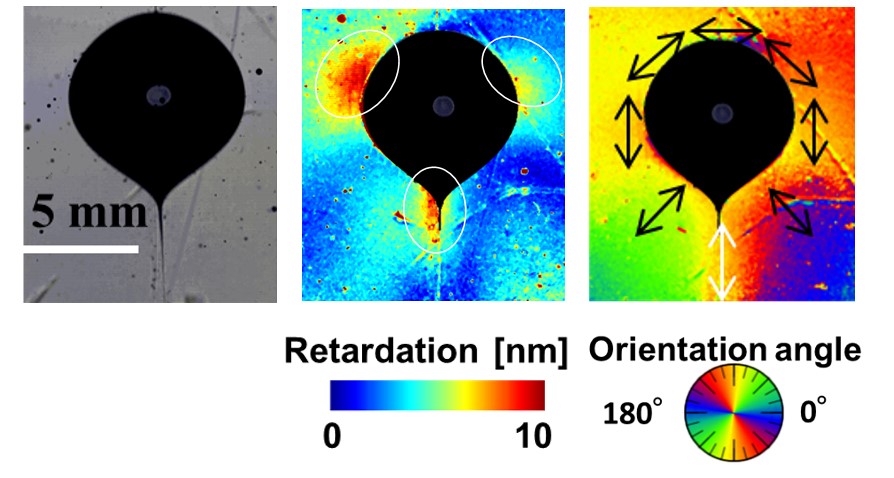
We have developed a flow system for systematic study of the dynamics of two-fluid displacement and flow in annuli. This flow is relevant to many industrial applications, especially in the cementing operations in oil/gas well completions, where drilling fluids are displaced from the annulus between the casing and the well bore by a series of spacer fluids and cement slurries. The annular flow apparatus was designed such that it can be operated at various degrees of eccentricity and different angles of inclination to simulate the type of flows in oilfield drilling and cementing operations. A special feature of the flow system is that the inner cylinder can be rotated during displacement, allowing the effects of helical flow on the performance of the annular displacement process to be studied. Flow and displacement tests with various model non-Newtonian fluids representing drilling and cementing fluids have been conducted at different eccentricities, pipe inclinations, and over a range of flow rates and cylinder rotational speeds. Flow visualization results consist of video images capturing the movement and evolution of the fluid-fluid interface that clearly illustrate the effects of annular eccentricity, displacement rate, cylinder rotation and fluid rheology on the displacement process. In addition, the velocity profiles through the annulus at a fixed point downstream were determined by Particle Image Velocimetry (PIV) method to elucidate the dynamics of the displacement fluid-fluid interface. PIV results obtained have revealed interesting phenomena in the two-fluid displacement region that depend on the fluid viscosity ratio and the annular eccentricity. Pressure drop measurements produce data that can be used to develop models for predicting friction losses associated with single-fluid flow and two-fluid displacement in eccentric annuli. The results obtained will be useful for assessing the effects of important variables such as eccentricity, pipe inclination, flow rate, pipe rotation and fluid rheology, that impact on the effectiveness of the annular displacement process.
Peristaltic pump is a most commonly used equipment to continuously introduce the fluids. However, the peristaltic pump may produce a pulsatile flow, limiting the applications for multiple purpose. To address this issue, we design a flow stabilizer connected to the outlet of the peristaltic pump. When the pulsatile flow enters the flow stabilizer, the elastic membrane is expanded, providing a buffer area for the pulsatile flow to deliver a steady flow at the outlet. The dampener was fabricated with PET and acrylic embedded with polyurethane as elastic membrane. The results show that the flow stabilizer with larger overall membrane area has better Fluctuation Reduced (FR) value. The elastic membrane arranged in parallel shows better FR than in series. Furthermore, we established a droplet generating system, which can continuously form uniform water-in-oil droplets. The system included a droplet generator, a flow stabilizer, and pumps. To continuously generate the droplets, a peristaltic pump connected with a flow stabilizer were used to feed the continuous phase. We used soybean oil with 5% w/v Polyglycerol polyricinoleate (PGPR) as the continuous phase, while pure water as the discontinuous phase. The results demonstrate that the monodisperse water-in-oil droplets with uniform size could be successfully generated. Moreover, the size of the droplets could be well controlled by altering the flow rate of the water. The droplet diameter increased from 0.311 mm to 0.519 mm (CV < 5.7 %) as the water flow rate increased from 5 μL/min to 80 μL/min. In conclusion, the integration of the flow stabilizer reduced the pulsatile flow of the peristaltic pump up to 99.25 %, allowing to continuously generate monodisperse droplets. We envision our continuous droplet generator system can apply to continuous and scalable production of chemical.
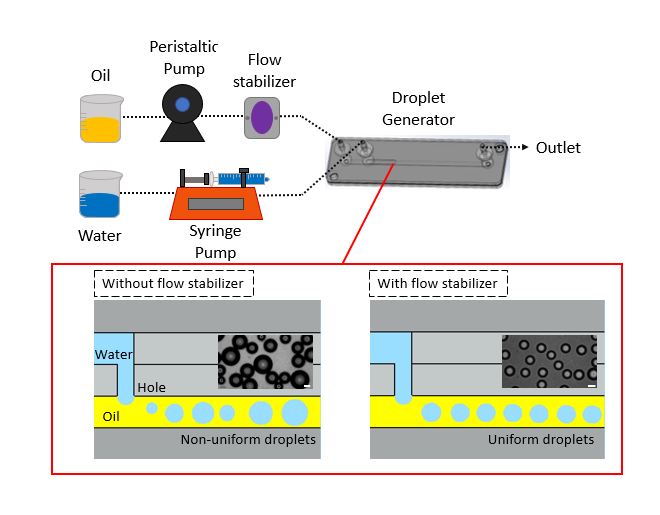
It has been well-known that photocatalytic degradation of indoor air pollutants such as volatile organic compounds (VOCs) requires a high degradation efficiency for a long time without lowering the efficiency due to coking on UV-irradiated TiO2 surface.
In our previous work, we fabricated a photocatalytic reactor where photocatalytic degradation of toluene vapor took place on TiO2-containing droplets formed by ultrasonic atomization under UV irradiation, and demonstrated that a stable degradation efficiency was kept continuously under the optimal operation conditions. Therefore, the present study aimed to improve the degradation efficiency by dispensing additive particles, such as carbon black (CB) and silica (SiO2) ones, into TiO2 suspension.
Two sorts of additives were added to the suspension of TiO2 particles in the photocatalytic reactor, and then the toluene generated at a concentration of 5 ppm was fed to the reactor where TiO2-contaninung droplets irradiating with UV-A ray. The test air was sampled at the inlet and outlet of the photocatalytic reactor, and the concentration of toluene was determined by a GC-FID to determine the decomposition efficiency Ed.
As a result, Fig1 shows the change in the toluene degradation efficiency with additive particle concentrations in the TiO2 suspension. It was found that the degradation efficiency was increased by dispensing the additives, and had an optimum value at the additive concentration. The addition of CB might increases the adsorption capacity to toluene while it might be considered that CB coats the surface of TiO2 particles and UV-ray does not reach TiO2 when the amount of addition exceeds a certain level. Although the effective surface area of TiO2 particles contributing to the photocatalysis increased due to the presence of suspended TiO2 agglomerates coated with SiO2 particles, the extreme increase in SiO2 particles could enhance the ultraviolet light shielding effect of the SiO2 particles themselves.
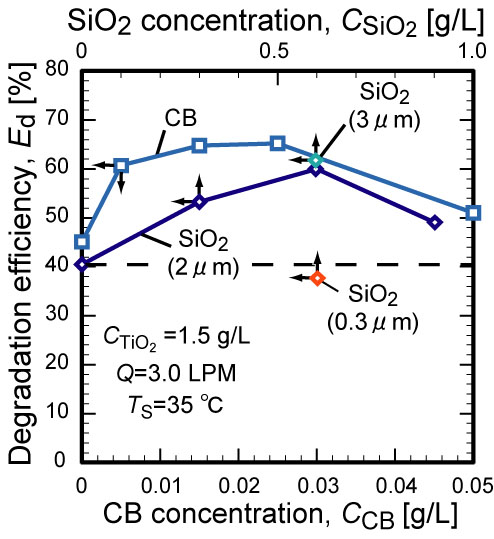
In this study, the growth of single bubbles, due to nucleate boiling, is computationally examined using the moment-of-fluid (MOF) method. The MOF method represents sharp deforming boundaries between phases by evolving both volume fractions and centroids. The numerical simulations are carried out by solving the conservation law equations for mass, momentum, and energy, taking into account the appropriate jump conditions at the interfaces between substrate, liquid, and vapor. The substrate is modeled as a rigid body and the liquid and vapor are simulated as incompressible fluids. In order to carry out the computations as efficiently as possible, dynamic adaptive mesh refinement (AMR) is used in which the computational domain is an adaptive hierarchy of rectangular grids as opposed to a single, uniform, rectangular grid. In this study, the single bubbles periodically growing from a single nucleation site is two-dimensionally and axisymmetrically computed under the temperature difference of 7 K between the heated wall and water. The continuous generation process of nucleate boiling bubbles is successfully reproduced and thermal and flow fields in nucleate boiling are clearly shown. It is showed that the second and subsequent bubbles after the first bubble is released are stably formed. The growth rate of the second and subsequent bubble is faster than that for the first bubble and the growth rate of the second and subsequent bubble becomes constant. It is verify that our computational results for the growth rate of bubbles, the bubble departure time and the bubble volume for the second and subsequent forming bubbles agree well with the previous study. Our computational method using the MOF method can be effective for computing boiling problem.

The dynamic motion of a drop rising in a highly viscous hydrophobically modified alkali-soluble emulsion polymer (HASE) solution with pH = 9.0 is experimentally examined. In this study, a 1.65 wt% HASE polymer solution, which is adjusted to pH ≈ 7.0 by adding a sodium hydroxide solution, is used as the matrix fluid and salad oil is used as the drop. For sufficiently small drops, a threadlike long trailing edge at the rear of a drop is observed, similarly as for the case of a small bubble. It is newly observed that the threadlike trailing edge for the drop is much longer and thicker than that for the bubble. From experimental observations, it is found that a drop is more susceptible to the effect of viscoelastic properties of the surrounding HASE solution than the for the bubble case. For the case of bubble rise motion, the threadlike long trailing edge turned into threadlike branches for increasing bubble size; no such the tendency can be observed for the drop case. In microscopic observations for the bubble, it was reported that very unique microstructures emerged from gas-liquid interfaces in the motion of large bubbles, but on the other hand, microstructures at the liquid-liquid interface cannot be observed for drops. It is revealed that there is a pronounced difference between how the viscoelastic properties of a HASE solution effects bubble morphology versus drop morphology.
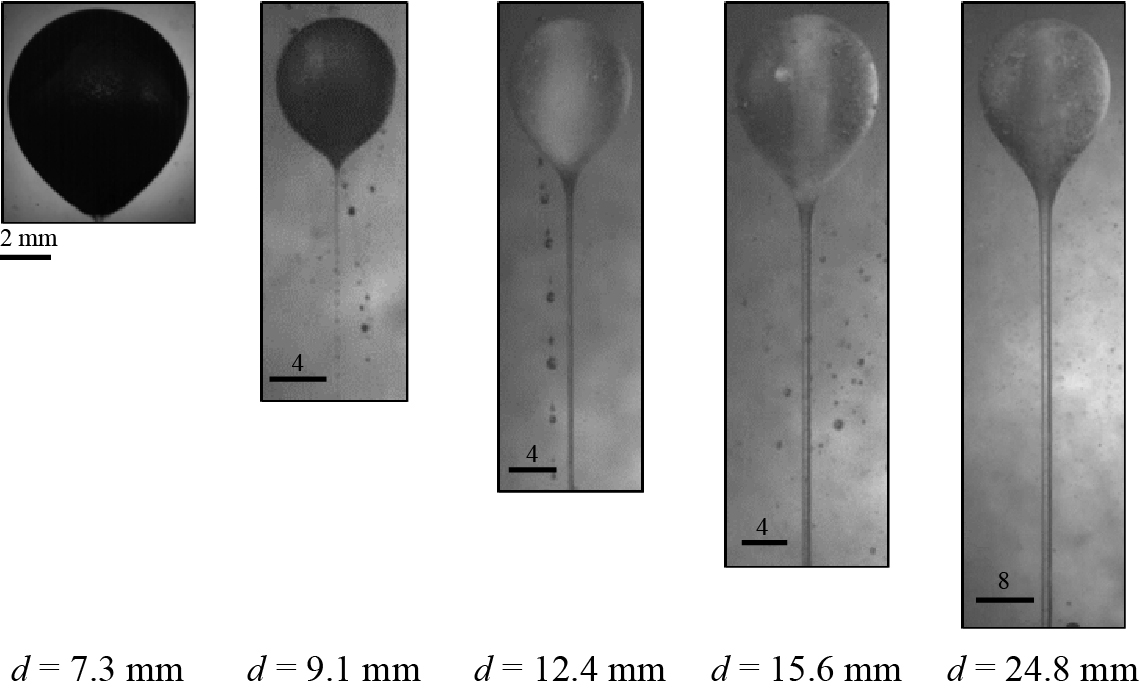
In the present work, a level set method with multi-levels was developed to simulate the breakup behaviors of multi-droplets in a macro extraction device, the pulsed disc and doughnut column (PDDC). The deformation and breakage behaviors of droplets in droplet swarm were accurately captured. It was found that the shearing effect of the continuous phase flow, the collision between droplets and internals, and the Plateau–Rayleigh instability of the interface of liquid column would lead to the breakup of droplets. These breakup patterns were in good agreements with the experimental results. Moreover, the influences of pulsation intensity and droplet size in droplet breakup behaviors were investigated. It was concluded that the higher the pulsation intensity, the easier the droplets to break up. In addition, large droplets were found to be more likely to break up into multiple daughter droplets. Generally, the droplet breakup frequencies predicted by numerical simulation presented acceptable agreements with experimental results.
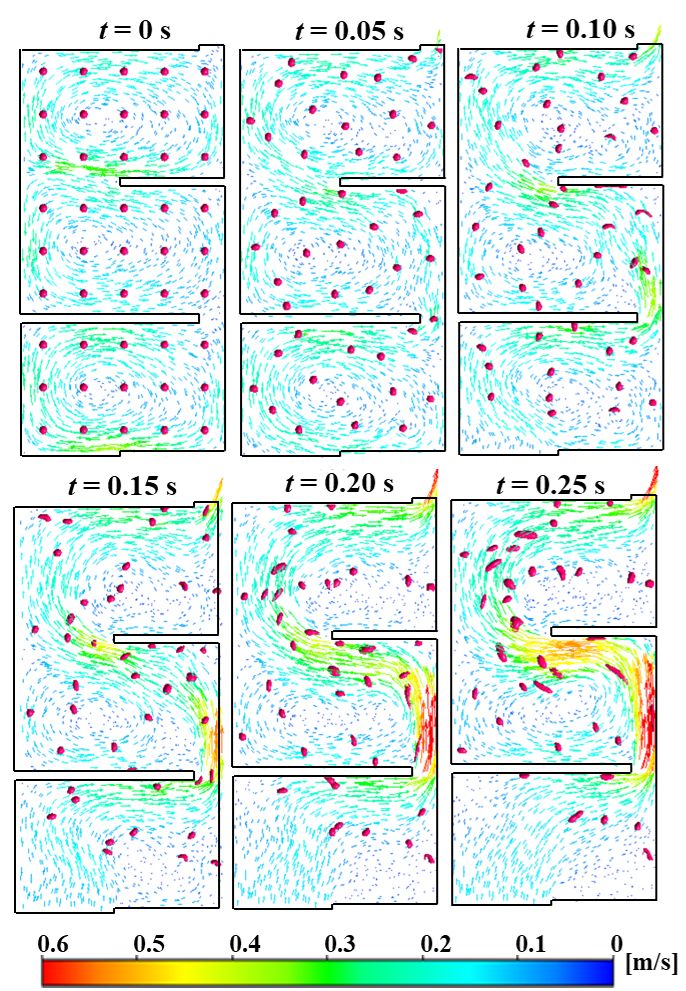
Interfacial tension is an essential physical property in liquid-liquid extraction. Under mass transfer conditions, the interfacial tension changes due to mass transfer and concentration variation. The measurement of dynamic interfacial tension in such condition is of vital importance to direct the design of extraction equipment. In previous study (Zhou at al., Chemical Engineering Science, 197, 172–183), we presented the quantitative relation between the droplet breakup frequency function and interfacial tension. In this work, the droplet breakup frequency function in mass transfer process is measured at four different heights of the pulsed column using the method developed in our previous work (Zhou at al., AIChE Journal, 63(9), 4188-4200). The dynamic interfacial tension at different height of the column is then calculated by regression method. With acetic acid – water as the dispersed phase and 5%TBP – kerosene as the continuous phase, the results show that the dynamic interfacial tension increases with height decreasing. Comparing the dynamic interfacial tension with the static interfacial tension of equilibrium liquid-liquid system, we have found that the former is smaller than the latter when the concentration of acetic acid in the continuous or dispersed phase is the same. This result indicates that interphase mass transfer leads to decreasing of the interfacial tension. The decreasing extent of the dynamic interfacial tension has a positive correlation with the mass transfer flux. Furthermore, under mass transfer conditions, binary breakage occupy the dominant position at different height and up to quintuple breakage can be observed.
Particulate flows in a mixture of gas and liquid, i.e. gas-liquid-solid three-phase flows are encountered in many powder handling processes, and it is of paramount importance to understand the complex interactions among phases. This work presents a simulation model for the study of gas-liquid-solid flows. In the given model, the solid-fluid interaction force is introduced by the Volume penalization (VP) method inherited by the study of Engles et al. (2015). Considering solid phase as a porous media, fluid is allowed to flow through the solid body with a certain value of permeability. The solution for determining the local permeability at solid surface is described in this study. The interface between gas and liquid is captured by the Volume of fluid (VOF) method coupled with the Level Set (LS) method. The interfacial interactions, such as the wetting of solid surface and surface tension force, are taken into account by using the Immersed free surface (IFS) model proposed by Fujita et al. (2015). The IFS model is originally designed for LS method, and it is adapted to the VOF framework in this work. Several simulations are performed to validate the proposed model. The resultant drag force acting on the particle as well as the computed surface tension force and contact angle are in good agreement with the theoretical values.
Global water scarcity and pollution became a serious problem around the world. In order to relieve this issue, membranes processes have been widely applied to water treatment. With the increasing requirement for water, it is indispensable to continue search for membranes that can perform more efficiency on water flux and ion rejection. Although novel Aquaporin channel synchronously transports water rapidly while completely rejecting ions [1], Aquaporin is very costly and has a complex fragile molecular structure. These drawbacks make it formidable to apply or produce on an industrial scale. Some materials were searched for replacing Aquaporin channel, an Amphotericin B-Ergosterol channel (AmBEr) is a type of self-assembly organic channel [2], AmBEr is considered to be potential candidates for the biomimetic artificial channels. In this study, AmBEr was constructed and explored via molecular simulations to understand the structural characteristics and transport mechanism on a molecular scale. The chemical structures of Amphotericin B and Ergosterol monomer were shown in Fig. 1. AmBEr molecular models were constructed and investigated via molecular dynamics (MD) simulation procedures, Monte Carlo (MC) simulations and Quasi-non equilibrium MD were adopted to simulate the properties of calculation models. Structural characteristics and water sorption behaviors were introduced. All these molecular models were constructed using BIOVIA Materials Studio® commercial software.
When we mix particles of different sizes in a rotating drum, segregation may be observed. In this study, the segregation of a granular mixture consisting of 50% v/v 0.55 mm glass particles and 0.77 mm glass particles in a high fill level rotating drum is investigated. The segregation patterns appear after few revolutions, and the surface segregation band size and number become stable within 30 min. For the spatio-temporal diagram, the two smaller-particle-rich segregation bands take longer time to move toward the drum center when the fill level increases from 60%, 70% to 80%. The segregation patterns inside the bed are observed by the cross-sectional slices. Peculiar segregation patterns composed by strikes and core-in-core regions are observed for the first time.
It is well known that the low-rank coals such as lignite and sub-bituminous with higher volatile and moisture accounts for a large proportion of coal, which is the most abundant fossil energy resource in the world.Compared to the conventional fixed and Circulating Fluidized Bed (CFB) riser, the downer reactor, in which gas and solids move downwards concurrently, provides prominent advantages such as more uniform gas-solids flow structures, shorter particles residence time, less gas-solids back-mixing.These unique characteristics is particularly beneficial and suitable for coal fast pyrolysis, which need short but uniform contact time to achieve high reaction selectivity and yields of desirable products.
The CPFD approach based on the MP-PIC method was used to study the hydrodynamics, heat transfer and reactions in CFB downer reactor for coal pyrolysis with binary particles. Firstly, the comparison of solids distribution profiles of binary particles showed the CPFD approach with the cluster-based drag model is capable of accurately predicting the gas-solids flow and particle mixing characteristics. On the basis of the suitable gas-solids flow model, we further simulate the heat characteristic by coupling the heat transfer model. The simulation results show the temperature mixing index predicted by the coupled heat transfer model is in good agreement with the experimental value. By analyzing the heat transfer characteristics of particles, it can be found that the heat transfer process mainly occurs near the entrance, the interaction between gas and particles near the nozzle plays a key role. Therefore, more attention needs to be paid on the inlet of particles design of the downer. Finally, the CPFD model was further extended to reveal the coupled flow-reaction behaviors on coal pyrolysis reactor with binary particles. The results demonstrate that the CPFD model can accurately predict the hydrodynamics, heat transfer and reactions behavior of binary particles.
Transfer lines are used for petroleum transportation in petrochemical industry, which refers to a pipeline connection between the furnace and the vacuum column in the crude oil distillation unit. A well designed transfer line can increase the evaporation rate of the feed in the vacuum distillation tower, improve oil product quality and save energy for vacuum distillation unit. To better design new pipelines or optimize the existing ones, it is necessary to describe the hydrodynamic behaviors of the multi component fluids flow in the pipelines. However, due to the complexity of the system, the model for analysis of the flow inside the transfer line has been paid less attention.
In this study, a commercial computational fluid dynamics package was used to develop a three-dimensional, fully turbulent flow model for the simulations of the multi component mixture across a pipeline. The simulated results of the pressure, velocity and Ma number distributions provided an insight into the phenomena occurring within the flow field in the transfer line. The analysis showed that the pressure drop of a transfer line is strongly affected by the structure of transition section and junction. On the basis of this, a new structure is presented to optimize the flow, and the pressure drop is lower than that of the original one. The modeling methodology and the results presented will be useful for evolving better designs of transfer line or other similar pipelines.
The bonded magnet is a composite material formed by mixing a resin and magnetic powder and is used as a magnet for a motor or a sensor. In the case of a bonded magnet by injection molding, it can be molded into various shapes, the degree of freedom in motor design is increased. Furthermore, if the magnetic properties of the injection molded bonded magnet can be enhanced, a more sophisticated motor can be manufactured. To enhance the magnetic properties, it is necessary to increase the concentration of the magnetic powder. However, as the addition amount of the magnetic powder is increased, aggregation of the magnetic powder occurs, the flowability decreases, and there is a problem that molding becomes difficult. To address this problem, measures have been taken to treat the surface of the magnetic powder with a silane coupling agent or the like to improve the affinity to the resin and to disperse the resin highly. However, at present the selection of surface treatment agents is conducted empirically.
Therefore, I focused on Hansen Solubility Parameter (HSP). HSP is a physical property value quantitatively evaluated the affinity between substances, and it is applied in various fields.
In this study, we examined the influence of HSP of magnetic powder on the flowability after mixing. First, the magnetic powder was surface-treated with various silane coupling agents, and HSP was measured to evaluate its affinity to PA6. Thereafter, the magnetic powder was added to PA6 at the same concentration, and the viscosity was measured to measure the fluidity. As a result, as the combination of the magnetic powder and the resin with better affinity in HSP theory, the flowability was improved, and it was possible to confirm a high correlation between the HSP and the flowability.
Evaluation of the flow properties of powders is essential for the designing and operations in powder-related industrial processes. In this study, the powder cohesion is evaluated by the measurement of the pressure drop across the bed during the fluidization and defluidization procedure in a FT4 Powder Rheometer (Freeman Technology). Glass beads with the diameter between 88 μm to 105 μm are fluidized in a cylindrical glass column with inner diameter of 50 mm by dried nitrogen. The pressure drop overshooting at incipient fluidization is used to characterize the powder cohesion and the bed cohesion is altered by Polyethylene glycol (PEG) addition and powder bed normal stress. When no normal stress is applied to the powder bed, the pressure drop shows a linear increasing during the overshooting period. However, when a 20 kPa normal stress is applied to the powder bed, the pressure drop shows a two-stage increasing during the overshooting period. A new cohesive powder fixed bed fluidized bed transition state is initially reported. The measured bed cohesion is ca. 45 Pa, which is comparable to the theoretical prediction of Molerus (1975) and Rumpf (1975).
In industrial incinerators, hazardous substances from the combustion waste are concentrated in fine particles. Collecting and reducing fine particles is particularly challenging, and thus it becomes one of the major problems in industrial incinerators. A control plate was introduced into an industrial incinerator to reduce the emissions of hazardous fine particles. However, the efficiency of the control plate against smaller sized particles is necessary to be investigated. The coupled discrete element method and computation fluid dynamic (DEM-CFD) are employed in a solid-fluid coupling problem even where the solid particle size is fine. One of the concerns in the DEM-CFD is the requirement of excessive computer capacity when the numerous particles are applied. Therefore, a coarse grain model is adopted here to perform the calculations using a single computer. For the sake of approaching the actual condition of industrial incinerators, poly-dispersed particle system is employed in this study, where expressed by a combination of two coarse ratio. The simulation results show that the control plate works well to capture the fine particles. In addition, the velocity of particle flow is significantly decreasing when a control plate is employed.
In wet-shaping process, it is well known that the particle dispersion state greatly affects the product qualities. Thus, it is important to evaluate and control the slurry characteristics properly. However, quantitative evaluation index that can compare the particles dispersion state under different slurry conditions such as particle concentration, primary particle size, particle density, shape, and solvent viscosity, etc. has not been established, yet. In this study, we measured the hydrostatic pressure of slurry prepared in various conditions under gravitational settling. Additionally, the time change of hydrostatic pressure for the slurry whose particles are assumed to perfectly disperse as primary particle was calculated for the slurries used in this study. In order to calculate the hydrostatic pressure curve more precisely, the particle size distribution measured by sedimentation was considered. The novel index, the ratio of measured hydrostatic pressure to calculated one, was introduced to discuss the particles dispersion state. It was shown that the index (hydrostatic pressure ratio) had a good connection to the final packing fraction of the sediment, indicating that the index should be useful to quantitatively represent the particle dispersion state regardless of the slurry conditions.
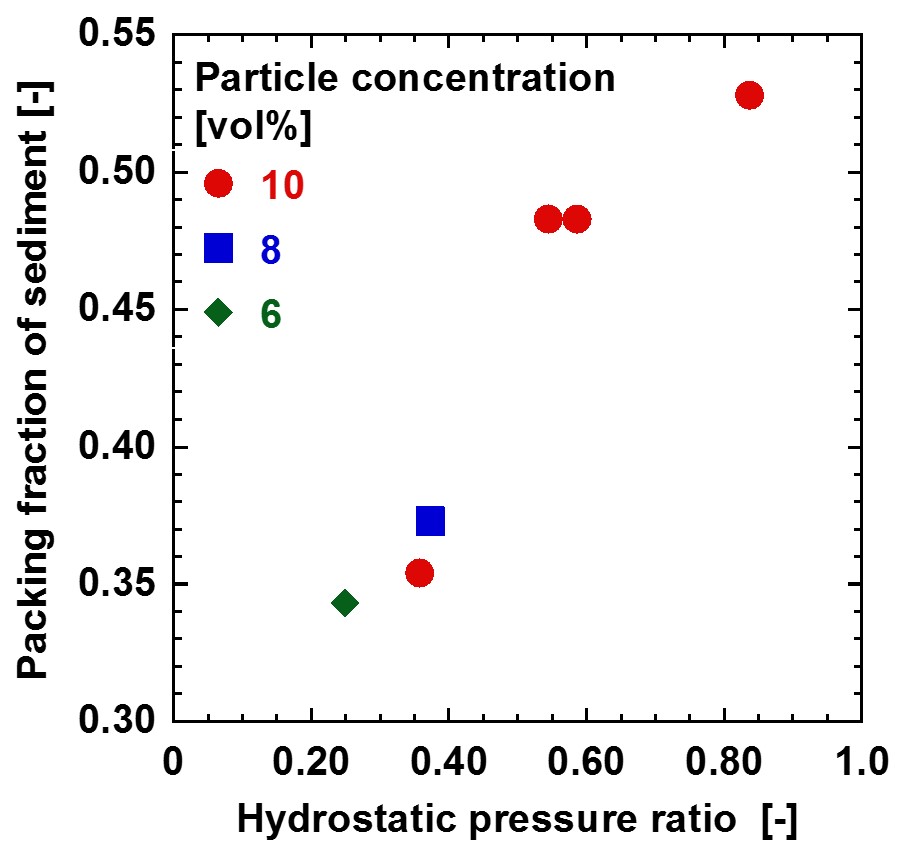
Phospholipid vesicles (liposomes) are soft colloidal particles which are applicable to fabricating carriers of biopharmaceuticals, protocell models, and immobilized enzymes. The permeability of lipid bilayer membranes towards small molecular mass compounds is of significance for the above applications of liposomes. In the present work, 5(6)-carboxyfluorescein-containing large unilamellar liposomes were prepared and suspended in gas-liquid flow generated in external loop airlift bubble columns. The release rate of the dye molecules from the liposomes was examined at 40 °C under various operation conditions of the bubble columns with different configurations. The permeability coefficient of the dye molecules through the bilayers of 1-palmitoyl-2-oleoyl-sn-glycero-3-phosphocholine lipids was clearly dependent on the superficial gas velocity of the bubble column (1-3 cm/s). The mean diameter and size distribution of liposomes were practically unaffected by being suspended in the bubble column, as evaluated with the dynamic light scattering measurements. These results indicate that the permeability of liposomes increased in the gas-liquid flow. On the other hand, the release rate of the dye molecules through the lipid bilayers incorporated with small fractions (1-5 mol%) of poly(ethylene glycol)-conjugated lipids exhibited significantly higher than that through unmodified lipid bilayers. The size distribution of the modified liposomes was altered by being suspended in the bubble column, indicating that the membrane integrity of liposomes was significantly altered. The effect of liquid shear stress on the structural stability of liposomes was separately examined by shearing the liposomes in a cone-and-plate geometry to assess the bubbles-liposomes interaction in the bubble column. All of the above results demonstrate that the structural stability of liposomes was controllable using the gas-liquid flow.
A small amount of polymer in turbulent flow reduces turbulent drag, which is called drag reduction. It is said that extensional rheological properties, such as long relaxation time and extensional viscosity of the fluid are keys for the phenomena. The characteristic extensional rheological properties of the solution deform vortices in turbulent flow, thus, the turbulent flow is also affected.
In this study, in order to focus on the effects of extensional rheological properties of fluids on vortex deformation in a turbulent flow, a flowing soap film known as a two-dimensional (2D) flow with a small influence of shear stress is used. The vortex shedding in the flow were visualized using interference patterns, and the local velocity fields were measured by particle image velocimetry (PIV). The vortices shed at the grid in the 2D flow was affected by polyethylene oxide (PEO, Mw = 3,500,000) concentration. The original shape of the vortices was deformed by increasing the PEO concentration, and the vortices were disappeared close to the grid at a certain concentration. However, the vortices again appeared at even higher concentration. In this study, we categorized these vortices into three types. Indeed, the generation of these vortices were affected by the extensional relaxation time of the PEO solution. The difference of these vortices were also analyzed by the fluctuation intensity of the flow field and by the turbulent statistics. Turbulent kinetic energy transfer, production and dissipation term of the turbulent kinetic energy were calculated the local velocity. The turbulent statistics implies variation of energy transfer in 2D flows, which was caused by the viscoelasticity of PEO solution.
In recent years, it has become clear that fine bubble (micro/ultrafine bubble) have properties different from those of ordinary bubble. For example, the surface area of fine bubbles per the same volume is larger than that of normal bubbles, including chemical reactions and physical adsorption at the gas-liquid interface, a dramatic improvement in mass transport, and having a positive/negative charge (zeta potential) on the surface of fine bubble. Cleaning using the features of fine bubble in particular has been noticed, and there is also a high industrial need. For example, the use of plastic cleaning in recycling industries and anti-corrosion cleaning of structures with flying sea salt particles in coastal areas has begun.
Therefore, in this study, the effect of fixed salt removal by fine bubble was investigated. As a result, it was confirmed that the cleaning effect of fine bubble water was higher than that of control water, and the effect was dependent on the concentration of fine bubble. It was also confirmed that the cleaning effect was higher in the cleaning of ultrafine bubble water than in the control water. The removal mechanism of the fixed salt seems to be that gas in the fine bubble dissolves by the pressure change around the fixed salt, resulting in supersaturation, and the bubble nucleus is generated, and a part of the salt is lifted by the micro bubble, which promotes the fixed salt exfoliation. And, it was confirmed that the cleaning effect was higher by the constant introduction of fine bubble than the system in which fine bubble existed only in the cleaning initial stage (Fig). From these results, the usefulness of fine bubble in cleaning can be expected.
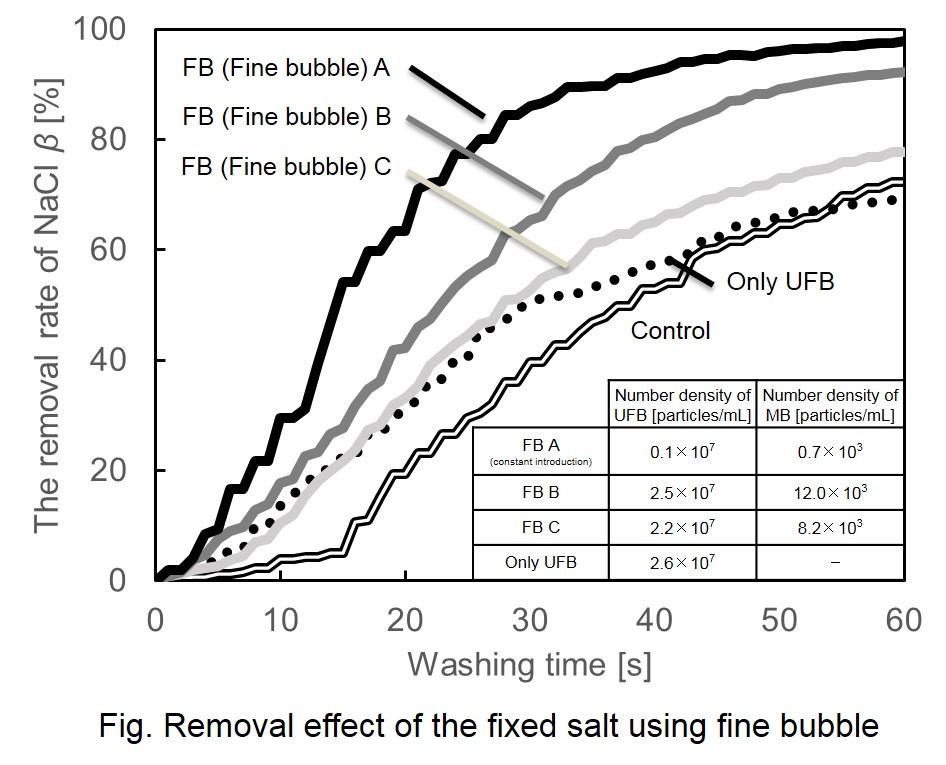
The magnetite nanoparticles including strontium were synthesized by hydrothermal method. After these particles were dispersed in the ethanol aqueous solution, and coated with the several nano meter silica shell by adding TEOS solution. The ε Fe2O3 particles were prepared by heat-treating these core-shell particles by the fixed temperature. Silica was removed from these core-shell particles by use of the NaOH solution, and the particles only of ε Fe2O3 were made. The magnetic property and the special quality of the form of particle and the particle diameter were argued to the dope amount of the strontium, the silica covering amount and the synthesis condition of the heat treatment temperature to this particle. As a result, the crystal system by heat-treatment time and the change in form of particle were checked by XRD and TEM.
Samples with 5% added Sr2+ were examined for several holding times set at 900 °C. Figure was XRD at 900 °C. The sample held for 1 hour has an aspect ratio of 1, and mostly contains ε phase and a little γ phase. Furthermore, in the sample which passed for 6 hours, although it was mainly ε phase, a little α phase was generated. The aspect ratio increased to 2 or more, and the rod width also increased to 60 nm. The crystal of silica developed with the increase of the amount of Sr2+. It is considered that this is because Sr2+ infiltrates into the silica by the doping of Sr2+, and influences the crystallization. It was found that the addition of Sr2+ causes the formation of an ε phase at a low temperature, the extension of the particles in a rod shape, and the change of the magnetic properties.
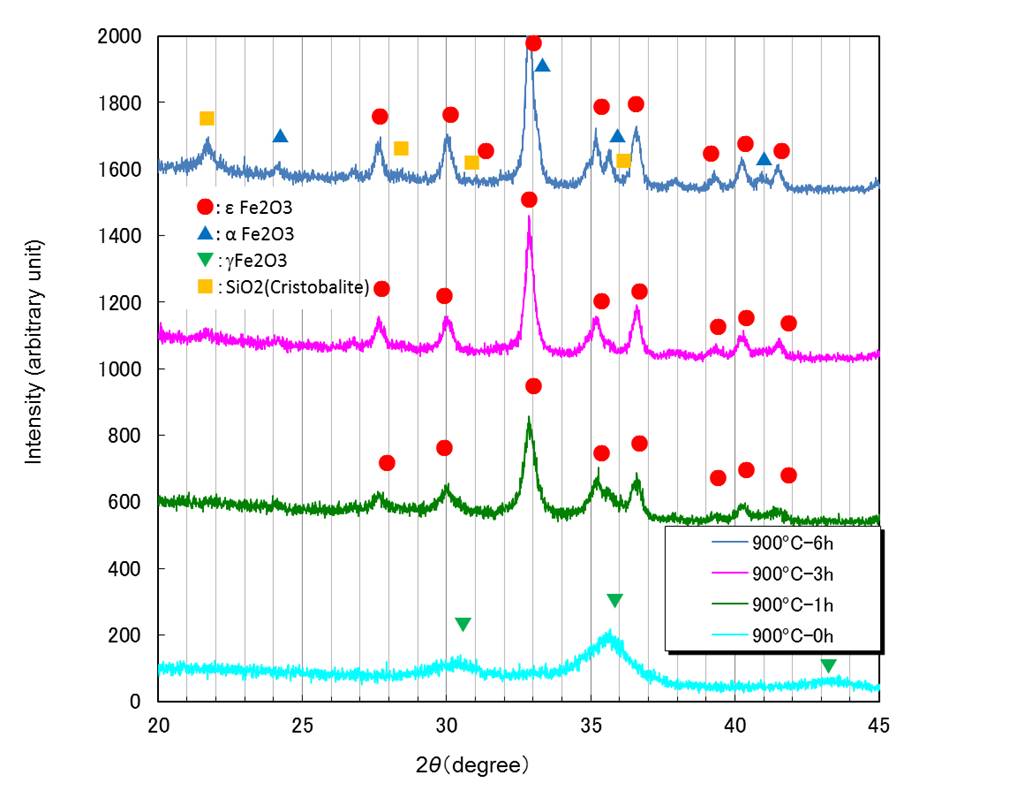
In chemical process industries, research and development on liquid mixing is important to save energy and resources, improve productivity and develop new materials. An appropriate impeller shape is selected to optimize mixing state in a chemical process. Very high viscosity of a fluid is an obstacle for performance of mixing processes. An anchor blade impeller is frequently used for mixing of highly viscous fluid is effective for heat transfer by scraping the tank wall but poor for the mixing. This is because the axial flow is not enough to be developed. It has been reported that mixing of highly viscous fluid can be improved by imposing unsteadiness on the flow field. This study, therefore, proposed two types of asymmetric anchor blade to improve agitation performance. Power consumption and flow patterns were experimentally and numerically observed. The asymmetric anchor blades proposed in this study were half anchor and G-shaped anchor. It is shown in Figure 1. As the results obtained by numerical simulation using a commercial CFD code (R-Flow), the power consumption using the asymmetrical anchor blades becomes smaller than that of the regular anchor blade. However, no significant difference between the half anchor and G-shaped anchor could be found. As the results of the flow pattern observation, it has been found that the mixing performance is improved in asymmetric anchor blades as compared with the regular anchor blade. It can be considered that asymmetric anchor blades make the flow field unsteady. Furthermore, it has been found that using the G-shaped anchor shows better mixing performance than the half anchor. The axial flow can be generated by the protruding portion of the G-shaped anchor. Mixing time was measured by decolorization experiments using iodine and sodium thiosulfate. The G-shaped anchor progressed the decoloring reaction most quickly and the mixing time the shortest.
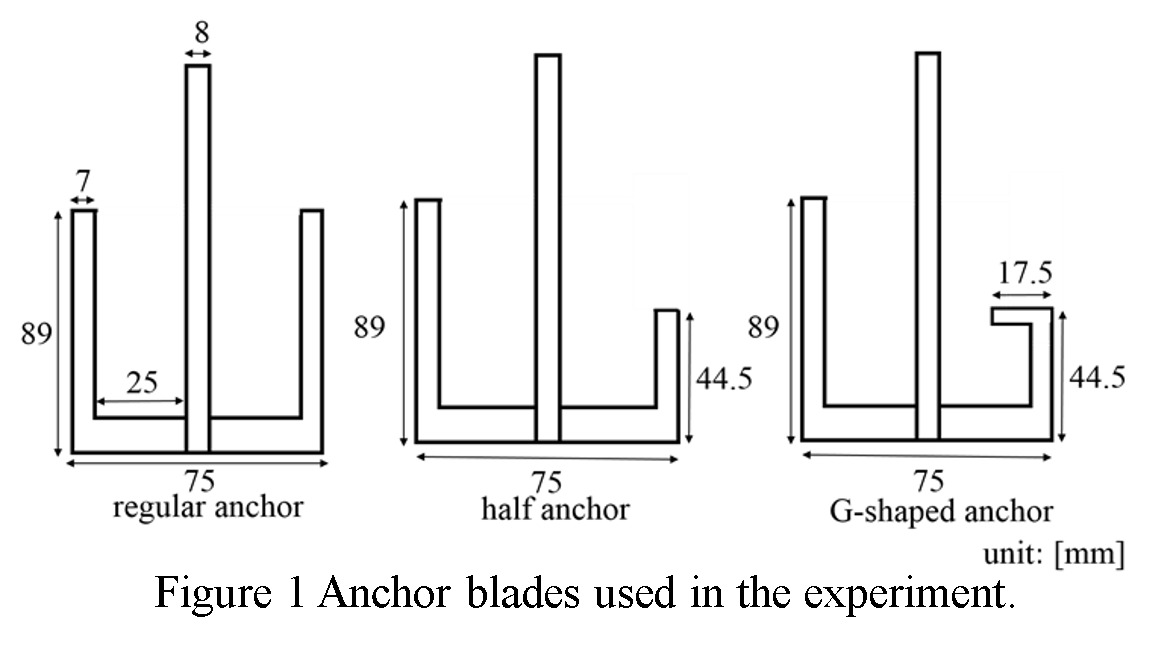
Semiconductor nanoparticles, known as quantum dots, are biocompatible semiconductor fluorophores and highly stable against exposure of light, which cannot be expected for organic fluorescent materials.1 Controllability of luminescence energy is also advantageous for bio-imaging since bio-permeability is good in near infrared to visible red region. However, toxic metals frequently used in quantum dots are problematic for practical use. In this context, non-toxic silicon-based nanoparticles meet the demand of bio-imaging although its stability cause the difficulty in the liquid phase synthesis, which realize large scale fabrication.
In this paper we fabricated silicon nanoparticles with two different liquid-based approaches, “Top-down” and “Bottom-up” methods. In “Top-down” method, Si powders are etched by hydrofluoric-nitric acid and decreased in its particle size to nm scale in suspension to obtain silicon nanoparticles, which show red light emitting (about 620 nm) in its PL spectra. In “Bottom-up” method, 3-Aminopropyltrimethoxysilane was used as precursors and reduced by reducing agent to obtain Si nanoparticles. The PL spectra of the nanoparticles show blue light emitting (about 420 nm), indicating that the obtained nanoparticles have smaller diameter than the nanoparticles prepared by “Top-down” method.
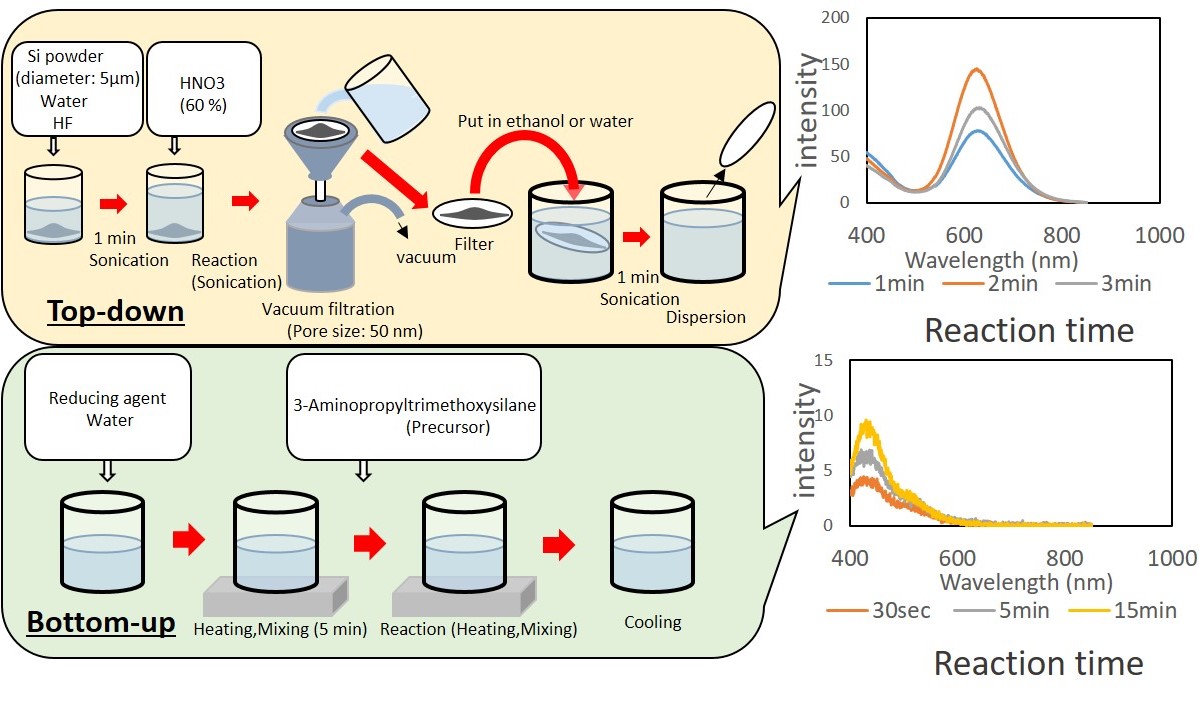
The dependence of the paddle rotating speed and its optimal paddle length for flow homogenization inside honeycomb has been investigated experimentally. Three types of honeycomb having various square hole size and the number of holes was used. The paddle length was varied within the range of 62, 81.6 and 120 mm and its width was 22 mm. The paddle was made of polylactic acid, which was fabricated using a 3D printer. The inlet volumetric flow rate was constant, 200 L/min. The air flowed into the header section and then into the honeycomb. The paddle attached to the motor was set to the windward side of the honeycomb. The flow rate was measured with a hot-film anemometer, which was positioned using a traverse device. The uniformity of the velocity at the honeycomb outlet was evaluated using the standard deviation of the velocity. The standard deviation is the arithmetic mean value calculated with the 169-point velocity data.
Table1 shows the experimental results. It was found that the optimum condition was almost 500 rpm of rotational speed with 120 mm paddle diameter.
Construction waste residue (CWR) consists of particulate organic and inorganic materials like woodchips and gravels. In Japan, the CWR should be discarded at a controlled landfill site to avoid decay of the organic materials. However, illegal dumping of the CWR is a serious trouble, because the discard at a controlled landfill site is “expensive”. If the organic materials are separated to reduce the amount to be < 5 wt%, the CWR can be discarded at an “inexpensive” least-controlled landfill site (≈ 1/5 $ of controlled landfill site). The organic materials can be easily removed from the CWR using a wet separation. Woodchips float and gravels sink in water. However, the wet separation has disadvantages; waste water treatment is necessary to avoid water pollution, a drying process is required after separation, and leakage of water may occur from the separator. Therefore, the development of dry separation is in great demand as a substitute for the wet separation. In this study, we focused on “density-segregation” in a vibro-fluidized bed. If a particulate mixture having different density is fluidized by an airflow through the bottom, lighter particles move up and heavier particles go down; this phenomenon is called “density-segregation”. If vibration is added to the fluidized bed, the density-segregation becomes clearer. We applied the vibro-fluidization to reduce the amount of organic materials in the CWR. We found that the upper layers of the fluidized bed consist of the organic materials, and the amount of organic materials in the lower layers is reduced to be < 5 wt%.
In the pharmaceutical industry, many of drugs are poorly soluble in water [1]. Ibuprofen, a nonsteroidal anti-inflammatory drug [2], is widely used to reduce fever and to treat pain or inflammation but it is poorly soluble in water. Coating with sugar is commonly used to enhance water solubility of drugs and expected to improve solubility, mask bitter taste of drugs and preserve medical effects. Due to relatively high values of the ionic product of H+ and OH- [3], mono- and oligosaccharides can be produced from the hydrothermal hydrolysis of polysaccharides [4]. The objective of this study is to demonstrate coating of less soluble drug crystal with products derived from hydrothermal hydrolysis of polysaccharides: ibuprofen was employed as a drug species, and polygalacturonic acid as a polysaccharide component. Mono- and oligo-galacturonic acids were hydrolytically obtained in a semi-batch flow reactor. The hydrolysis product solution played as a role of an anti-solvent for ibuprofen crystallization. The morphology and surface of ibuprofen crystal was observed with a scanning electron microscopy (SEM). Figure 1 (a) and (b) shows the SEM images of the neat ibuprofen crystal and coated ibuprofen crystal, respectively. The crystal structure was analyzed with the X-ray diffraction, and melting temperature of the ibuprofen crystals by differential scanning calorimetry. The effects of operating conditions on the amount of coating layer on the ibuprofen crystal surface were investigated.
References
[1] E. Merisko-Liversidge et al., Eur. J. Pharm. Sci., 2003, 18, 113-120
[2] A. Mauricio et al., Fluid Phase Equilib., 2013, 354, 185-190
[3] T. Funazukuri et al., J. Chem. Technol. Biotechnol., 2004, 79, 229-233
[4] T. Miyazawa et al., Ind. Eng. Chem. Res., 2004, 43, 2310-2314
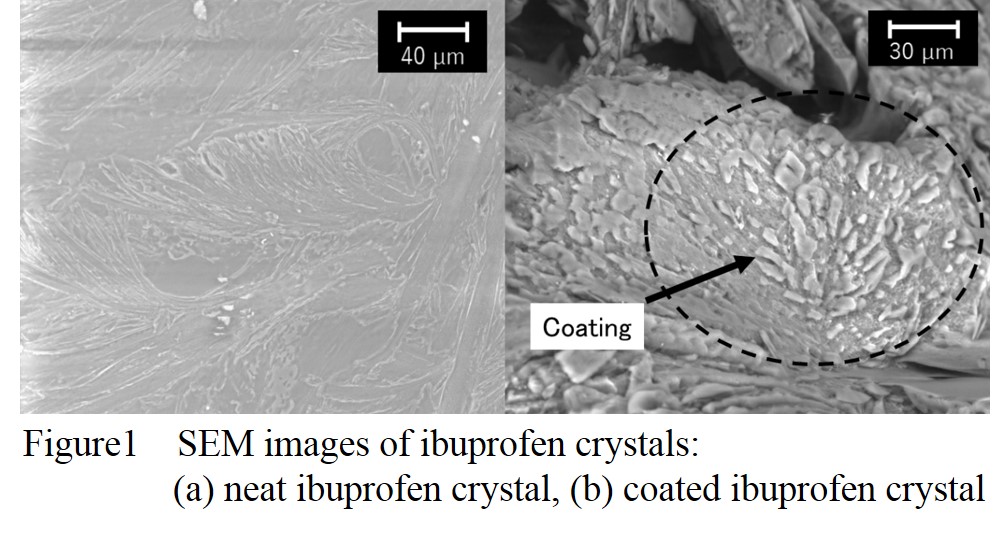
Fine bubble (FB) attracts keen attention and the appilcation is spreading in various fields. FB is classified into microbubbles (MB) and ultrafine bubbles (UFB) depending on the size. Although benefits of UFB have been recognized in many applications, there are many obstacles for deeper understanding of the effect due to the lack of methods to characterize UFB. This study aims to introduce series of UFB generators invented by the author and propose methods to identify and characterize UFB.
For identification, a method to differentiate bubbles and impurities was proposed. The dominant matter in water, either bubbles or impurities was successfully differentiated by analyzing signals obtained from a laser-based instrument, Nanosight LM-10. Comparison of the distribution patterns obtained from mixtures of UFB and various impurities (Fig. 1) suggested that UFBs are stabilized by adsorbing impurities in water. For characterization, the effect of salt addition on the number density and size distribution of UFBs was examined. Addition of NaCl solution into UFB water gave rise to UFBs' expansion and agglomeration depending on the condition. The dissolved gas concentration in NaCl solution and UFB determines the dominant change to occur. When the gas concentration in NaCl solution concentration is higher than that in UFB water, majority of the UFBs expand while the rest of UFBs agglomerate, vice versa. Furthermore, the net surface tension of single UFB in water was experimentally determined by using the invented system to estimate the volume of gas dissolved and/or dispersed in liquid. The net surface tension was lower than the surface tension of pure water.
These results provide supporting information for a suggested mechanism for stability of UFB in water by Yasui (2016) and the report of decreased surface tension of UFB water by Terasaka (2018).
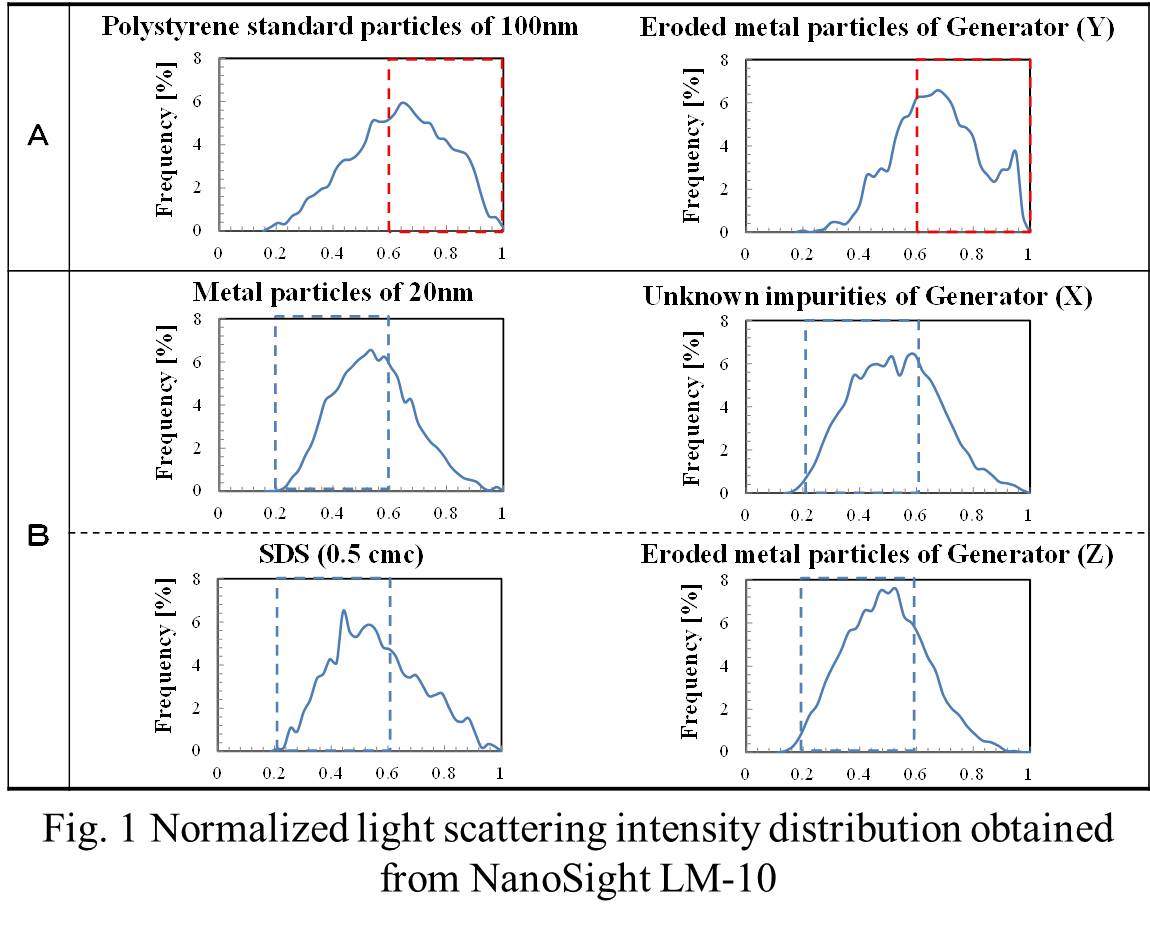
The flow field energy and mixing characteristics of the two-component layer jet asymmetric impingement mixer were studied by two-dimensional high-speed particle image testing technology (TR-PIV) and laser induced fluorescence (PLIF). In this study, the POD analysis method is used to extract the large-scale structure of the flow field and decompose the instantaneous flow field to obtain the main modal energy. The flow field energy is mainly concentrated in the first-order mode, which is easy to describe the flow characteristics of the whole flow field. Flow field reconstruction can accurately reduce the distribution of the initial flow field vortex structure. The asymmetric flow field energy formed by the up and down and left and right offsets of the stagnation point is always larger than the symmetrical flow field, and the mixing rate is lower than the symmetrical flow field. Under the same working condition, the stagnation cross flow field energy is higher than the stagnation point on the same side. The mixing efficiency is opposite; the lower tracer (stagnation point) is left (fully developed) to facilitate flow field mixing (Figure 1). Therefore, this asymmetry of the jet is beneficial to increase the flow field energy, and the initial development of the tracer promotes flow field mixing.
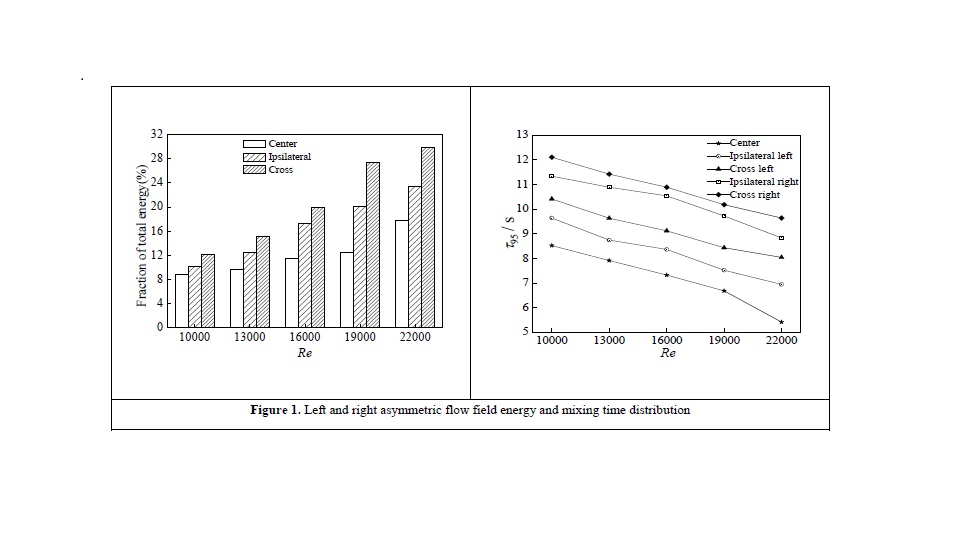
The extrusion process of ceramic pastes is commonly used for the production of high-value products such as catalyst pellets for the chemical reactor, honeycomb catalyst for purifying gas exhausted from an automobile, ceramic packings for adsorption and direct heat transfer, etc. Recently, extrusion-based 3D printing was successfully applied for manufacturing of ceramic superconductors, zeolite monoliths, and porous scaffolds.
Ceramic paste extrusion is a complex process which depends on the paste rheological properties, die and extruder geometries, and operational parameters. The paste rheological properties are controlled by several factors including volume fraction of particles and their size distribution, shape, packing density and surface characteristics, as well as amount and properties of binder and other additives. Modeling and quantitative analysis of paste molding are important to design the extrusion process for the production of high-value extrudates of desired strength, shape and morphology.
The objective of this paper is to construct the mathematical model of ram extrusion of ceramic materials and use it for the optimization of the extrusion process. The paste extrusion was modeled as a flow of non-Newtonian fluid. The paste continuity and momentum equations were solved numerically for fluid based on the modified Herschel-Bulkley viscous model. Fig. 1 illustrates the velocity distribution in the extruder. The effects of materials properties, extruder and die geometries, temperature and inlet paste velocity on the distributions of paste velocity and pressure in the extruder and die were investigated numerically.
References
1. M. Li, L.Tang, R.G. Landers, M.C.Leu, Extrusion process modeling for aqueous-based ceramic pastes, J Manuf Sci E-T ASME, 135, 051008, 2013.
2. N.Labsi, Y.K.Benkahla, A. Boutra, Hydrodynamic and thermal characterization of the flow of a Herschel-Bulkley fluid in a pipe, ESCAPE20, 1-6, 2010.
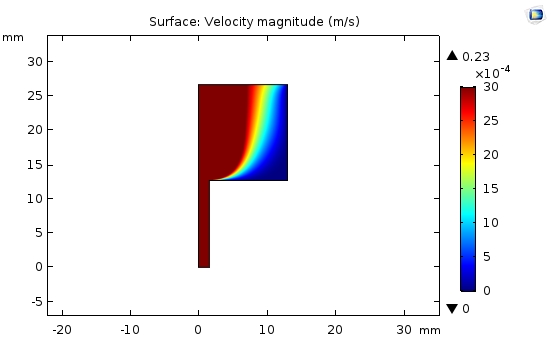
Bubbling beds are widely used in process industry, e.g. stripper of Fluid Catalytic Cracking (FCC) in petrochemical industry. It is important to enhance gas-solids contacting by improving the gas-solid flow, bubble distribution, bubble diameter and gas-solid backmixing in the stripper by adding internal structures. Different types of internal structures have been reported including disk and donut baffles and grid baffles. In this study, an Eulerian–Eulerian approach was used to compare the gas–solids flow behaviors in strippers with disk and donut and grid packing and in the empty stripper. Simulation results with respect to the solid volume fraction agrees well with experiments, indicating that the model is accurate in predicting gas-solids flow behaviors in bubbling beds. The CFD model also clearly predicts the local dead zones underneath the disc and donut baffles. The gas-solids flow behaviors are more uniform in the grid stripper than in other types of strippers. A machine-learning based method of capturing and characterizing the bubble was proposed. It was found that any strippers with internal structures can obtain smaller bubbles than the empty bubbling bed. The number of bubbles in the grid stripper is about 10 times more, and the bubble size is much smaller than those in the empty-type stripper. The present work indicates that the internal structures can enhance bubble breakup. The performance of the bubbling bed can further be improved by optimizing the internal structures.
Polymer hollow particles have many advantages: great light diffusivity, high heat blocking rate, low density, low cost, and good dispersion in resin. However, the conventional synthesis methods have problems with their uniformity and productivity, which prevent application for products. In this research, we developed a new method to synthesize a large amount of uniform hollow polymer particles. Polymer solid particles were synthesized by soap-free emulsion polymerization using styrene as a monomer and 2,2'-Azobis [2- (2-imidazolin-2yl) propane] dihydrochloride (VA-044) as a polymerization initiator. In the colloid of the polymer solid particles prepared above, methyl methacrylate (hydrophilic monomer) divinylbenzene (crosslinker), and ethyl acetate (good solvent for polystyrene) were added and the polymer solid particles were swollen with the monomers and the solvent. Then, VA-044 was added and the polymerization was started. Through drying the fine particles, polymer hollow particles were obtained. A TEM image of the polymer hollow particles synthesized by this method is shown in following. Monodispersed hollow particles were synthesized (Cv: 9.2%, Cv = particle diameter dispersion / particle diameter distribution × 100). In addition, it was shown that the hollow polymer particles have different optical characteristics and heat blocking properties.
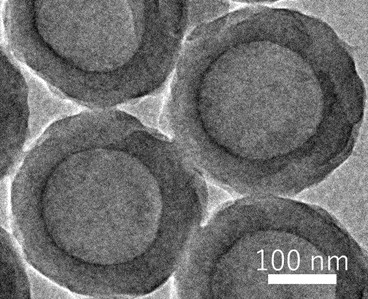
Mixing is a general process operation and plays an important role in many chemical process industries. It is used for various purposes such as gas-liquid, liquid-liquid, and dispersion of solid-liquid. In agitation in a stirred tank, a vortex is formed in a turbulent flow. When the vortex is formed, the circumferential rotational flow becomes dominant and makes the vertical mixing weaken. Consequently, performance of mixing decreases. Installing baffles can break the vortex and the flow is complicated, so that the performance of mixing is improved. Thus, the baffles play a very important role in fluid mixing. However, there are very few researches on the effect of geometrical configuration of baffles on mixing performance. Therefore, in this study, baffle length, width, clearance and the number of sheets were varied to investigate the agitating power consumption and mixing characteristics. A transparent acrylic tank with a semi-elliptical bottom was used as a stirring tank, and MAXBLEND© was used as an impeller. Five geometrical configurations of baffles with different length and width were used. Rotational torque was measured using tap water as the liquid to determine the power number, and the power diagram was obtained by plotting the power number as a function of the impeller Reynolds number. Decolorization experiments of iodine and sodium thiosulfate were conducted to determine mixing time. It is generally known that the power number in the stirred tank with baffles is independent of Reynolds number in fully developed turbulent flows. This study, therefore, tried to correlate the power number with the geometrical parameters, and a relatively good non-dimensional correlation equation with accuracy within ± 10% was successfully obtained in fully turbulent flow regions.
It is important to understand solute transport in micro-channels in various fields of engineering. For example, solute transport in natural flow channels, such as rock cracks or gaps in soils, is closely related to resource extraction or pollutant dispersion in underground. In a micro-channel, a laminar dispersion, which is known as Taylor dispersion, plays a significant role on the solute transport. However, most of the natural channels have an irregular shape and the solute dispersion is greatly influenced by the irregularity of the channel such as variance of the cross-sectional shape and the roughness of the channel wall. This is because dead water region (stagnant region) is formed in irregular-shaped channels.
The purpose of our study is to understand the formation mechanism of dead water region and its influence on solute transport and to make clear the dispersion process in various-shaped micro-channels. We examined the effect of the irregularity of wall surface on solute transport experimentally. We quantified the solute concentration field in micro-channels by image analysis based on absorption photometry and also measured the flow velocity distribution in the channels by particle image velocimetry technique. From the measurement results, we quantified the dead water region formed near the channel sidewall.
From the experimental results using rough-walled channels with various heights and wavelengths, it is found that dead water region decreases the effective aperture length and the solute transport is enhanced in flow direction. We developed a model on the formation of dead water region as a function of the height of wall roughness in micro-channels. The model describes well the formation mechanism of dead water region and the relationship between dead water region and solute dispersion in various-shaped channels.
The vast majority of environmental microorganisms adhere to every interface and form highly structured microbial aggregates called biofilms. Biofilms are structured communities of microbial cells enclosed in a self-produced extracellular polymeric substance (EPS). The presence of the EPS provides up to 1,000-fold greater resistant to antimicrobial agents when compared with their planktonic counterparts. The adhered cells usually cause piping corrosion in various types of facilities. Removal of adhered cells on various surfaces is an important issue that improves productivity and ensures safety in industrial processes. In this study, the effects of the physicochemical properties of microbial cell surfaces on cell detachment from solid surfaces were investigated using a parallel plate flow chamber (PPFC) and an atomic force microscopy (AFM). Gram-positive Lactococcus lactis was used as model microbial cell, and negatively charged glass slide was used as model substrate. The cumulative number of detached cells from the model substrate as a function of flow rate in PPFC was fit with the Weibull distribution function, and the drag force distribution was calculated from the hydrodynamic force required to remove attached cells. Based on the DLVO theory, because the microbial cells and the glass substrate are negatively charged, it can be predicted that the interaction force between the microbial cells and the glass increases with an increase of the ionic strength. However, interestingly, the drag force to remove the attached cells on the surface shifted toward smaller values with increasing ionic strength. AFM imaging of microbial cells attached on the glass surface was carried out with a stepwise increase of the contact pressure. The required removal forces estimated form the lateral forces in AFM deceased with an increase of ionic strength. This was found to be agreed well with the result in PPFC.
Wind flows through stairs cause various problems, such as subway trains wind, and chimney effects in stairs of high-rise buildings, but the flow structure in stairs has not been fully understood yet. In the present study, scale model of a 4-storey stairs and a 4-storey slope model having same inclination were fabricated using by a 3D printer. This model experiment was performed on the assumption that windows of the landing stairs were closed. Each model inlet was connected with a wind tunnel outlet in order to obtain uniform velocity distribution condition. The flow structures of the stairs model and the slope model were compared. Velocity was measured with the hot wire anemometer. The flow velocity was calculated with the OpenFOAM. The observed velocity was agreed with the CFD values. Therefore, the k-e model is applicable for flows of the stairs and slope model. Flow structures of the stairs were found to be similar to that of the slope.
Coupling the computational fluid dynamics (CFD) and population balance model (PBM) is a promising approach to simulate the liquid-liquid two-phase flow. In this study, the influence of the local turbulent dissipation on drop size distribution (DSD) in a pump-mixer is studied using the CFD-PBM approach. The breakup kernels obtained in our previous study (Zhou et al., 2019. Measurement of droplet breakage in a pump-mixer. Chem. Eng. Sci. 195, 23–38.) were adopted and the class method is selected to solve the population balance equation (PBE). The drop size distributions (DSDs) at five different rotating speeds were simulated to investigate the influence of the local turbulent dissipation. The prediction of the DSDs was compared with the experimental results and show a good agreement, which verified the correctness of the breakup kernels.
As an efficient equipment for gas-solid reaction, mass and heat transfer, fast fluidized bed is widely used in modern chemical industry. For example, catalytic cracking, fluidized coking, coal gasification and combustion, and the gas phase polymerization. In these processes, high-speed nozzle jets are usually employed to realize a full mixing and reaction between gas and solids. The dynamic contact of feed jets with fluidized particles will directly affect the reaction results. Thus, it is important to know the cluster behaviors in this mixing process. By combining the wavelet decomposition theory with particle concentration signals, method for identifying clusters in the jet mixing zone of fast fluidized bed was proposed. Characteristics of clusters during the dynamic mixing process were obtained. Comparisons between upward and downward jets were made by analyzing the cluster time fraction. Results show that the characteristics of clusters in the upward and downward jet mixing zones are quite different. Overall, the time fractions of clusters are much higher for the upward jets, especially in the initial contact region of jets with particles. For the whole jet mixing zone, when the jets are upward, the average cluster time fraction is about 8.91%, while for the downward jets, the average cluster time fraction is only 6.19%. Besides, it is shown that the cluster time fraction is quite high near the wall of fluidized bed in the upward jets mixing zone, which results in the low efficiency of mass and heat transfer between gas and solids. In the industrial production, some undesirable phenomenon occurs. For example, the coking problem in FCC riser. On the contrary, if the jets mixing with the fluidized particles countercurrently, the time fraction of clusters decreases significantly. The gas-solid mass and heat transfer efficiency is expected to be improved.
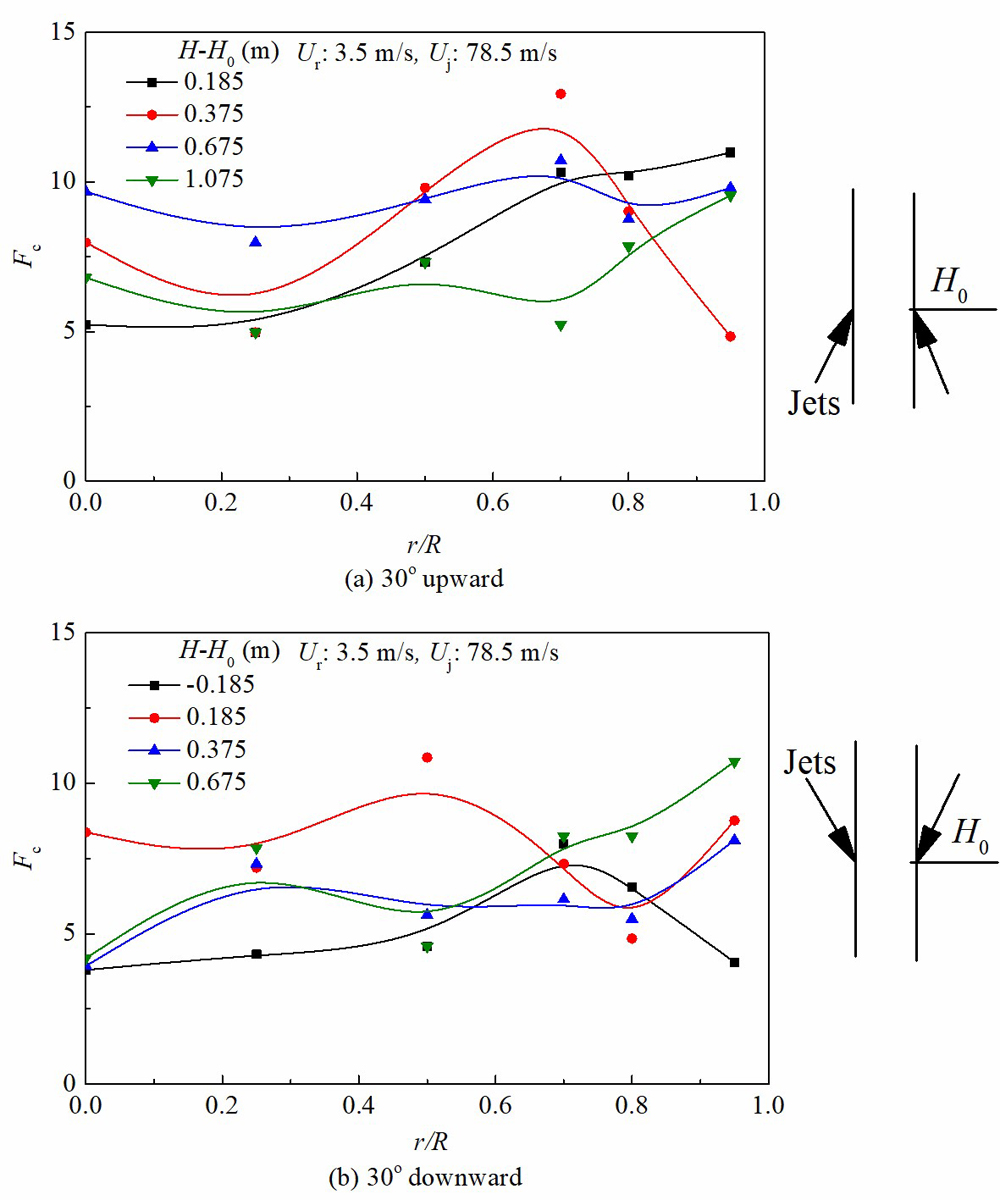
Solid-liquid mixing is widely used in crystallizer and chemical reactor with catalysis. In these processes, there is a problem that solid particles do not disperse uniformly and deposit on the bottom of the tank. So it is necessary to quantify the solid particle concentration distribution in the tank and investigate the conditions for improving particle suspension in order to solve these problems. However, it is difficult to measure the detailed particle concentration in the tank under many conditions. So, in this study, Euler-Lagrangian simulations were performed with various particle diameter, particle density, particle number, impeller speed, and impeller height to quantify the vertical distribution of solid particle concentration in the vessel and identified the factor that determines the dispersion state.
The Euler-Lagrangian approach, which tracks all particle motion, was adopted. Turbulent flow in the vessel was represented by large eddy simulation. The interactions of particle–particle and particle–solid surfaces were modeled using the distinct element method. The fluid was presumed to be water. The standard deviation of particle concentration in the vertical direction, σc, was calculated and time averaged σc, σc,av, was used as the evaluation index of dispersion state in the vessel.
Results show that particles suspension was promoted and σc,av decreased as the particle number increased because particles collisions increased around vessel bottom. And σc,av was correlated with terminal settling velocity (determined by particle size and particle density) and impeller tip velocity (determined by impeller speed and impeller diameter). Finally, when the flow pattern changed greatly by changing the impeller height in the liquid depth, H, the particle dispersion state with impeller height of H/3 and H/9 were promoted comparing to that with impeller height of H/5.
Nanoparticles are used in biomedical, optical, and electronic fields. In general, it is important for the synthesis of nanoparticles to bring about highly supersaturated reaction solution conditions. However, batch type reactions often result in wide size distributions of resultant particles and low reproducibility, because the non-uniform supersaturation condition inside the reactor cannot be avoided due to its poor mixing performance. In this study, therefore, we proposed usage of porous hollow fiber membrane (PHFM) device as a new approach of mixing process for the improvement of mixing property. PHFM devices are mainly used in the waste water treatment process. On the other hand, PHFM device have possibility to provide a more efficient mixing condition than the conventional mixing equipment, because they have large number of small pores in the wall surface of the hollow fiber. However, the mixing performance in PHFM devices have not been evaluated quantitatively. The objective of this study is characterization of mixing performance in PHFM devices by the Villermaux-Dushman method and understanding mixing mechanism in PHFM devices using the computational fluid dynamics (CFD) simulations.
Fig. 1 illustrates the champion data of the mixing time using different four mixing devices (PHFM device, batch-type mixer, T-shaped mixer, and microreactor). The PHFM devise shows much fast mixing time of approximately 0.3 ms as well as the microreactor. Moreover, PHFM devices achieved the high mixing performance despite a low Re number. This would be because the large number of small pores provide infinite water jet streams. Furthermore, the CFD simulations of the mixing process were conducted to investigate the mixing performance and the effect of pore size and feed flow rate on the mixing performance.
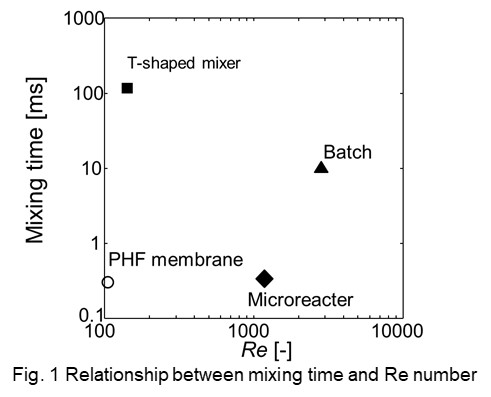
Microalgae have been paid attention for biofuels production in the bioenergy sector. Recently, an open-channel raceway pond system is commonly used from the viewpoint of the production rate and construction/operation cost. In the open-channel raceway ponds, a dead zone around the corner of a central baffle inhibits the mixing and, therefore, the dead zone volume is required to decrease in volume to increase the growth rate of microalgae. In this study, we experimentally seek to optimal geometry of a raceway pond for efficient production rate of biofuel energy. In practice, the tracer particles having the specific density of 1.02 are included in a newly proposed raceway ponds, and the sedimentation of particles are recorded every one minute with the use of a digital camera. In addition, the flow patterns in the raceway ponds are measured with the particle image velocimetry (PIV) and computational fluid dynamics (CFD) simulation. Based on the results obtained in the experiments, the physical model to design an optimal layout of the baffle in a raceway pond are proposed successfully.
In order to expand the absorption wavelength range of zinc oxide utilized as a photocatalytic catalyst, studies of Au nanoparticles depositing on zinc oxide (Au/ZnO) have been actively carried out. Since the Au nanoparticle can absorb visible light, Au/ZnO is expected to have catalytic properties for absorbing UV-ray and visible light. The purpose of this study is to generate Au/ZnO particles by an ultrasonic spray pyrolysis method (USP).
A dilute aqueous solution of Zn(NO3)2 and HAuCl4 was used as a raw material solution. Small droplets of raw material solution generated by ultrasonic nebulizer were thermally decomposed in the reaction tube. The generated Au/ZnO particles were characterized by SEM, XRD, TEM and UV-Vis equipment. In order to prevent particle aggregation, Trion X-100, a non-ionic surfactant, was added, and its effects were also examined.
The particle size was found to be several micrometer by SEM observation. ZnO and metallic Au crystalline were found by the XRD analysis. As shown in lower part of Figure, the color of obtained Au/ZnO particles was from thick purple to pale purple. As shown in the upper part of the Figure, the TEM images of the particles showed that the Au crystals were well dispersed inside the ZnO particles. Crystallite size estimated by Scherrer's equation was agreed with that measured from TEM images: the cristallite size decreased as decreasing the additive rate of HAuCl4. The obtained particles were measured by UV-Vis equipment. The smaller the size of the Au particles, the higher the visible absorption peak near 400 nm. This is considered to be the result of resonance with light having higher energy as the atomic vibration caused by surface plasmons increases as the Au particle size is smaller. In the case of adding Trion X-100, the absorption peak shifted toward the longer wavelength side: aggregation of Au particles was enhanced by the addition of Triton X-100.
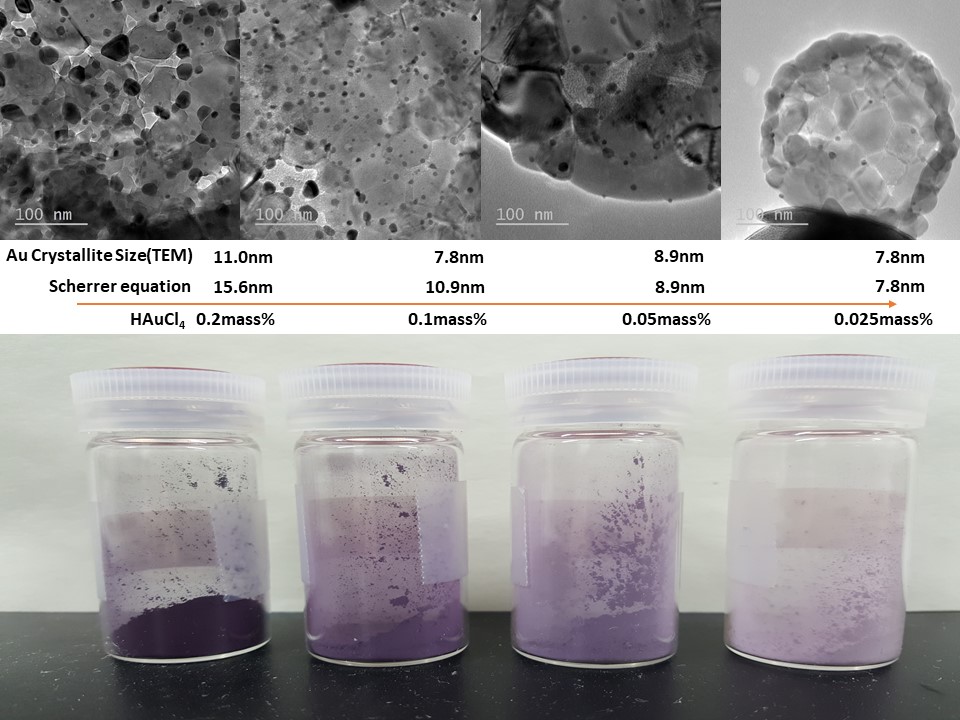
Coagulation coefficient of aerosol particles due to Brownian motion is an important issue in aerosol science and technology. Motion of aerosol particles is diffusive in continuous region (small diffusive Knudsen number, KnD), or like free molecular motion of gaseous molecular in free molecular region (large KnD). Fuchs (1964) presented an expression of coagulation coefficient in transition regime by so-called "Flux Matching" method: physical model of this method was very clear and have been well accepted. In his method, the particles transport inside of the "limiting sphere" was assumed to be like free molecular, or diffusive outside of the sphere.
These days, some researchers presented coagulation coefficient of aerosol particles by direct calculation of motion of aerosol particles. They employed Langevin dynamics equation to represent the stochastic motion of aerosol particles. In this study, we developed new model to calculate the coagulation coefficient. As shown in Figure, our model employed spherical space in which one scavenging particles are in the center of it: the spherical space moves together with the motion of the scavenging particle. Other colliding particles move in the spherical space until the particles collide to the scavenging particle (1). The collided particle is re-generated at the surface of the spherical space (2). The particle escaped from the spherical space (3) is re-entered (4). The coagulation coefficient can be calculated from the mean time interval of collision and the concentration of colliding particle.
By using the above numerical model, we have calculated the coagulation coefficient of spherical particles of from 4 nm to 400 nm in diameter. Our results were slightly greater than that of Fuchs. The difference was significant considering the uncertainty caused by Monte Carlo Method. The results were organized by using KnD, then we presented an expression of non-dimensional diffusion coefficient.
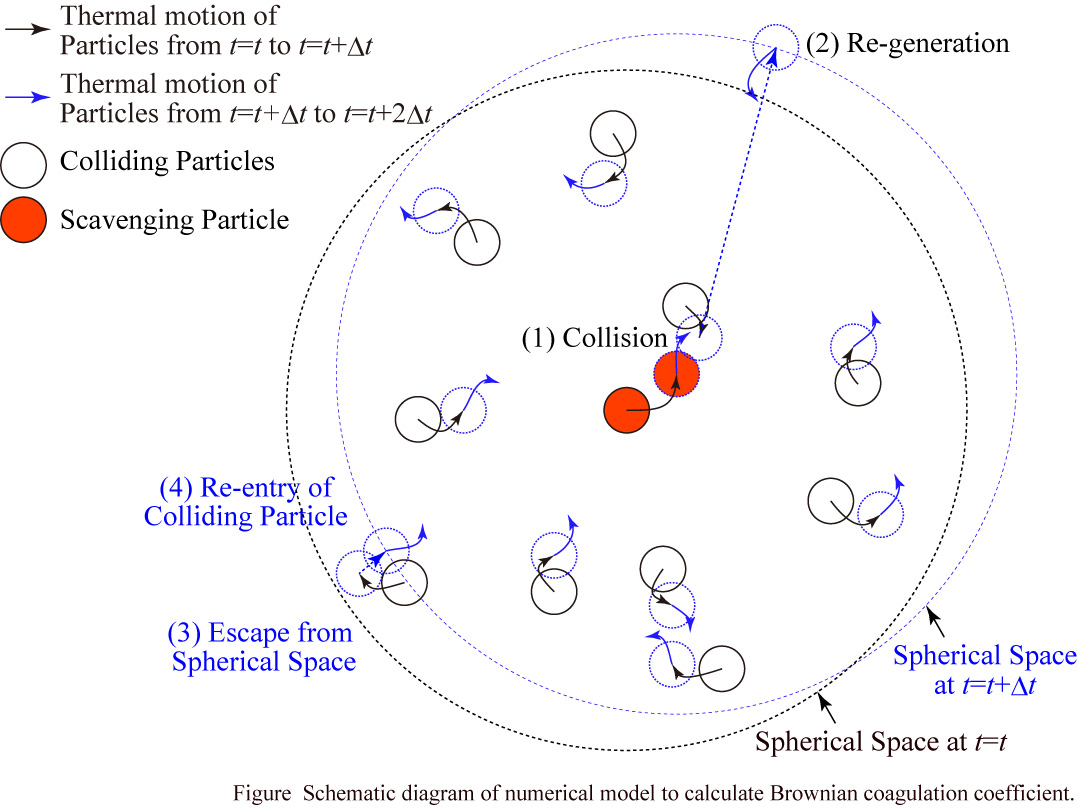
During the past decade, the proportion of food waste in municipal waste stream is gradually increasing and hence a proper food waste management strategy needs to be devised to ensure its eco-friendly and sustainable disposal in the world. The most well-kwon approach to treat food waste has been considered compositing, which is breaking down biodegradable waste by naturally occurring micro-organisms with oxygen, in an enclosed vessel or tunnel or pit. In order to achieve optimal compositing, the mixing ratio of food waste and micro-organisms in sewage sludge and the reaction behaviors are quite important.
In this work, we studied about reaction rate, salinity, carbon/nitrogen ratio, reaction temperature, and organic substance during compositing process in the mixture of food waste and sewage sludge to find optimal composition. For our study, the sewage sludge and food wastes were collected from a rural area and garbage trucks operated by Sangju City.
Compositing experimental was carried out with various mixing ratio of the food wastes and sewage sludge such as 10:30, 30:70, 50:50, 60:40, 70:30 and 90:10 wt.%, respectively.
Finally, we reveal that the optimum ratio for compositing was 60 : 40 wt.%. Moreover, the detailed results show that the temperature was 18 ~ 22 oC at the initial stage, then it was sharply increased to 44 ~ 46 oC up to 1day, which was maintained over the fermentation period. In the case of a pH change depending on fermentation process, it was decreased to 4.5 ~ 6.2 due to production of organic acid at the initial stage of reaction. Later on, ammonia was produced that leads to increasing pH value of 7. 3~ 8.0.
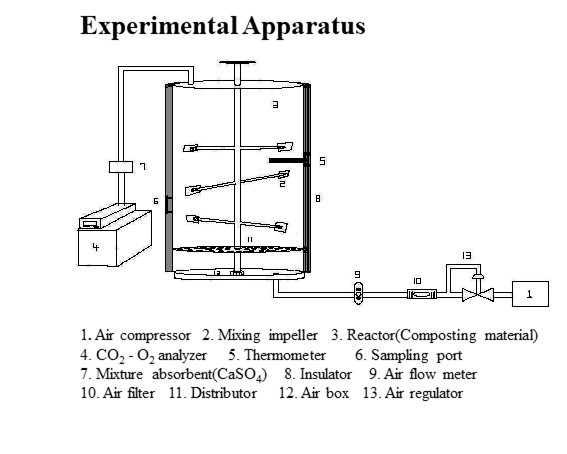
A constant drying rate is important to evaluate the performance of dryer. The constant drying rate is difficult to measure when a surface evaporation rate is extremely high like the material containing solvent with a low-boiling point. To measure the constant drying rate, the material surface must be wet during measuring. In this study, to keep the material surface wet, liquid (solvent) was supplied to the material (a sintered-glass ball filter was used as the material). The validity of the method was confirmed for water as the supply liquid. Ethanol and acetone were used as the solvents with the low-boiling point. The constant drying rate and the temperature of material were measured at steady state. The temperature of material obtained from the experiment was compared with the results calculated from the conventional method (Chilton-Colburn analogy).
Table 1 shows the results of constant drying rate, temperature of material and heat transfer coefficient on material surface. In the case of water, calculated temperature of material (wet-bulb temperature) is 297.8 K which is almost equal to that in experiment (297.2 K). The difference of the material temperature between the calculation results (Chilton-Colburn analogy) and experimental data was large when the material surface was assumed to be covered with the pure solvent (ethanol). It implies that the water vapor in air affects the evaporation of solvent (ethanol) on the material surface. The gas-liquid equilibrium (water-ethanol system) on the material surface is considered to predict the temperature of material, and the results are in good agreement with the experimental data (in Table 1). A heat transfer coefficient can be calculated from the experimental data (drying rate and temperature of material). The heat transfer coefficients obtained from the experiment are in orderly agreement with the values predicted (Ranz-Marshall equation).

Self-induced sloshing is oscillatory phenomenon of a liquid free surface caused by a flow of a fluid. This phenomenon is reported in some gas-liquid reactors, and it is important to predict and prevent its occurrence from the viewpoint of safe operation of the reactors. However, the mechanism of this phenomenon has not been clarified.
Therefore, in this study, self-induced sloshing caused by bubble flow in a rectangular vessel was experimentally examined in order to elucidate its generation mechanism. In our experiment, air bubbles were dispersed into tap water from the bottom of the rectangular vessel.
First, the effects of gas flow rate and liquid height on the oscillation of liquid surface were investigated by image photographing. Oscillation frequency and amplitude of liquid surface were analyzed. It was confirmed that self-induced sloshing occurred by increasing the gas flow rate at specific initial liquid height. The gas flow rate threshold varied depending on the initial liquid height. Pendulous oscillation of bubble flow was observed simultaneously with free surface oscillation. The frequency decreased with the increase in liquid height.
Second, PIV was carried out. Figure shows unique circulating flow observed only when self-induced sloshing occurred. Liquid circulating flow occurring on both sides of the bubble flow transitioned within one cycle of self-induced sloshing. It is suggested that the circulating flow contributes to the oscillation of bubble flow and liquid free surface.
CFD modeling was also considered for scale-up of the vessel. It is difficult to reproduce the self-induced sloshing caused by bubble flow because it is a multiscale phenomenon that includes both a small-scale bubble interface and a large-scale free surface. We tried to reproduce oscillation of bubble flow and liquid free surface simultaneously using Multi-Fluid VOF model of Eulerian multiphase flow model in ANSYS FLUENT.
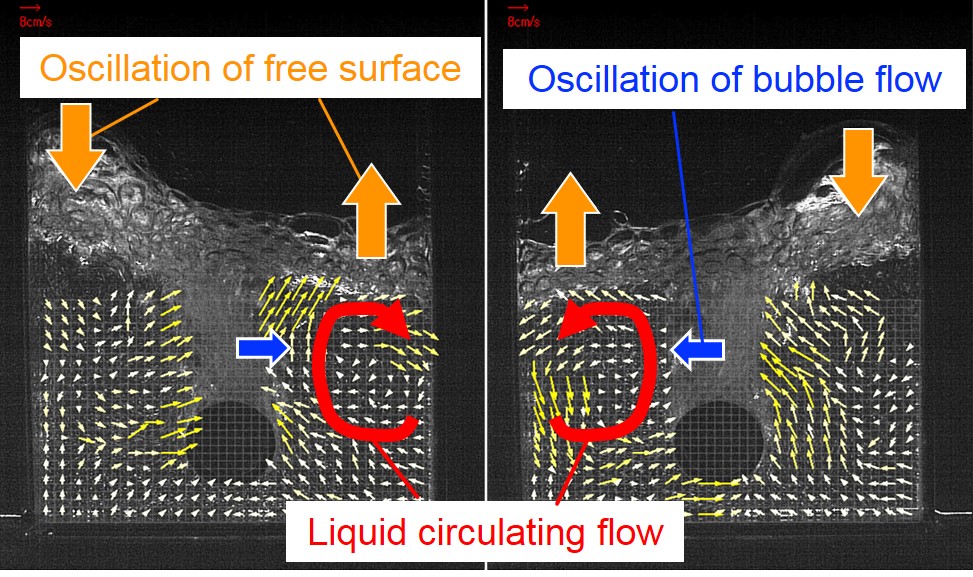
We are focusing on the practical use of methane hydrate, which is expected in the future as alternative energy. The surficial and shallow methane hydrate presented under the seafloor generates bubble groups (that is “plume”) by decomposition. For recovery and use as energy resource, it is necessary to consider the possibility of clogging in the recovery pipe due to rehydration of bubbles. The purpose of this research is to observe experimentally and evaluate theoretically the decomposition behavior of hydrate sedimentary layer and the rising behavior of bubbles generated by hydrate decomposition. Chlorodifluoromethane was used as a low pressure model gas of methane. Hydrate sedimentary layer was produced by cooling and pressurizing water in countercurrent contact with gas using a hydrate formation recovery device. The recovered hydrate was decomposed by the heating or depressurization method, without flowing water. Since the water was sufficiently saturated with the gas component during decomposition, the bubble radius reduction by gas dissolution was negligible. Two theoretical rising velocities were derived from the theoretical value with using the Navier-Stokes equation or the values in consideration of the bubble shape and hydrate film existence. The experimental rising velocities of small spherical bubbles radius agreed well with the theoretical value by Navier-Stokes equation. The relatively large elliptical bubbles showed a behavior close to the theoretical value of bubble with hydrate film. The rising velocity may decrease for any reason. Further investigation is needed for the influence of the bubble shape term in the theoretical formula. Under the pressure and temperature conditions closer to the hydrate equilibrium line, almost no generated bubbles could be identified. This may be because of fine bubble generation
Low temperature heat less than 423 K exhausted from factories and power plants has been wasted due to the low usability. If it is properly transported and distributed to each homes, it can be utilized for the air heating and hot water supply. Latent heat transport by using phase change slurry is expected to be used for filling this space gap. However, the latent heat transport slurry still has problems such as plugging in the pipes and increase flow resistance. The problems can be solved by encapsulating the phase change material in silica microcapsules. In this study, we developed a continuous process enabling large production of silica microcapsules for application to a latent heat transport slurry. In the first stage of this process, W/O emulsion was produced with a homogenizer, and in the second stage, W/O/W emulsion was formed with hydrolysis reaction occurring at the oil-water interface. The correlation between the water droplet diameter of the W/O emulsion and the diameter of the silica microcapsules indicated that the W/O emulsion process using the homogenizer determined the capsule diameter. It was also observed that silica microcapsules formed when the water droplets escaped from the oil droplets. Furthermore, by considering Shinner's equation, it was found that the average capsule diameter can be controlled by the rotation speed of the homogenizer. Finally, the stirred tank of the liquid-liquid dispersion process with the homogenizer was changed to the small one in order to make the residence time became uniform. Monodispersed silica microcapsules could be obtained with this continuous process.
Acknowledgements: This study was supported by JST-Mirai-project: #JPMJMI17EK.
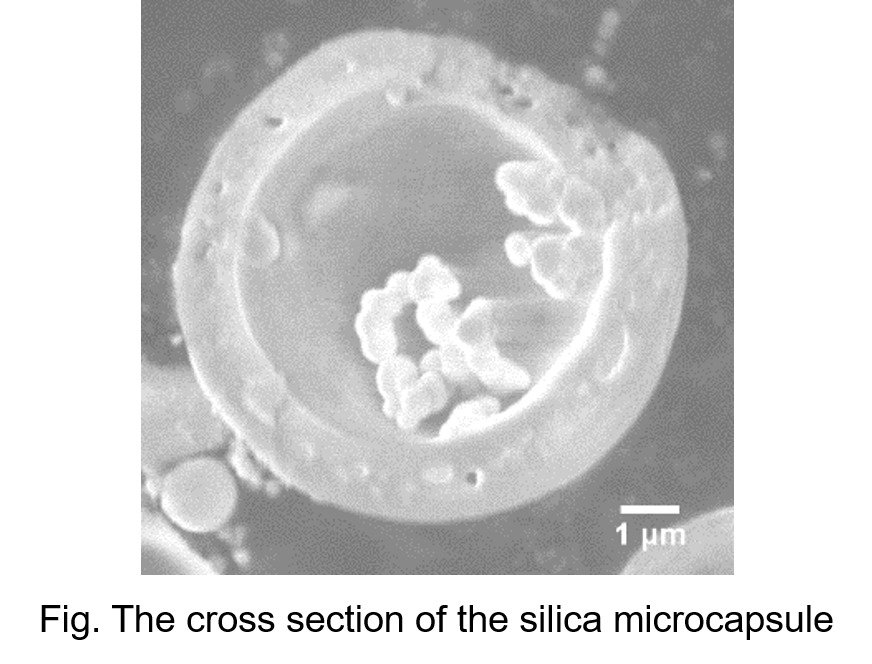
In order to design drop dispersion systems, such as flows inside solvent extraction columns, it is necessary to know the shape and motion of the dispersed droplets. In this study, numerical analysis of the motion of ellipsoidal droplets in a stagnant liquid was performed by using a three dimensional Front-Tracking method. Drag coefficients of the ellipsoidal droplets were determined from the numerical results by two different projected areas: one calculated based on spherical droplets and the other based on numerically obtained projected area. The drag coefficients based on the numerically obtained projected area were in good agreement with the ones predicted by the semi-empirical model for spherical droplets proposed by Myint et al (J. Fluid Sci. Technol., 1, 72, 2006). The drag model was derived by correcting the projected area, and successfully predicted drag coefficients for ellipsoidal droplets.
Dry powder grinding is an important unit operation in many industries such as mining, fine chemical, food and pharmaceutical, ranging from coarse mineral ore to submicrometer-sized fine drug powder. Recently, ultrafine dry grinding processes with high energy milling, which can produce fine particles with enhanced performance and/or improved properties, have attracted much attention. In the ultrafine dry grinding, planetary ball mills have been employed, and the milling conditions can vary the particle breakage induced by the impact energy of particles, altering the particle properties, such as size distribution, specific surface area and microscopic structure. Therefore, the impact energy must be appropriately adjusted to produce the particles with controlled properties. In order to understand the impact energy under given milling conditions such as revolution speed of the mill pot, size and density of the grinding balls and ball-to-particle filling mass ratio (BPR), the behavior of particles and balls is often simulated using the discrete element method (DEM). Many studies on the analysis of planetary mills using the DEM simulation have been published, indicating that the impact energy depends strongly on not only the milling conditions but also the particle properties. In the ultrafine dry grinding processes, both the particle size and the number of particles can drastically change as the milling time elapses, resulting in temporal variation of the impact energy. However, the impact energy in planetary mills has not been sufficiently analyzed taking into account the change in particle size and number of particles. In this paper, in order to study its effect on the impact energy, the DEM simulation of a planetary mill was performed under various conditions of particle size and number of particles. The results showed that the impact energy in the normal and tangential directions was greatly affected by these factors, suggesting that the grinding mechanism changes during milling.
Agitation impellers for liquid-phase mixing in chemical processes were designed based on a conventional disk turbine impeller with six flat blades which sucks liquid across the planes including the upper and lower edges of the blades. The altered impeller has the structure for the inflow entrance to be fully confined. We call this “fully closed impeller” and the prototype “open impeller”. The fully closed impeller was modified for the blade geometries, namely, the number and the axial width of the blade. An impeller with the 12 flat blades of standard width (12-STD) and an impeller with 6 flat blades of small width (6-Small) provided narrower flow paths between the neighboring blades of the rotating impeller. Additionally, an impeller with 6 flat blades of tapered width (6-Tapered) provided the flow path with a constant cross-sectional area. These flow paths were expected to produce nearly uniform liquid flows there. Liquid flows in the impeller rotational region of a baffled vessel with the closed impellers were examined for the flow path between the neighboring blades of the rotating impeller and the internal flows were compared with that with the open impeller. Energy consideration in terms of the dimensionless parameters on the basis of the flow and power measurements demonstrated that the closed impellers were successful in the head characteristic rather than the flow one. The power transmission efficiency were enhanced notably for the 6-Tapered closed impeller because of a reduced viscous loss.
One techniques for improving flowability is admixing smaller particles than main particles. In this technique, an adhesive force have a different value in all contact points between main particles. This is because a combinations of smaller particles coverage states changes in all contact points. This adhesive force distribution would improve a particle flowability. In this study, we examined effects of the force distribution on improving flowability by DEM simulation.
We used DEM simulation of a two-dimensional system. The particle diameter was 60 μm. Physical properties of the particle were mainly set based on glass material including TiO2 and BaO. Two kinds of Hamaker constants, 1.0×10-20 and 1.0×10-22, were used for changing an adhesive force. Adhesive force distributions were given to particle beds by following 2 types; 1) particle surface distribution by setting different adhesive forces at a contact point on the surface, 2) spatial distribution in a particle bed by arranging positions of different adhesive forces particles. The width of particle bed container was 600 μm and the container have a discharging hole of 400 μm at the bottom. The flowability was evaluated by a particle discharging rate. As a result, when we gave a particle surface adhesive force distribution, the flowability increases with increasing surface ratios of the smaller Hamaker constant. On the other hands, in spatial adhesive force distribution results, the flowability shows the maximum value at particle number ratio 50%, which means mostly the largest adhesive force spatial distribution. This is because a particle flow structure depends on the spatial distribution. From these results, we obtained a useful knowledge, which adhesive force spatial distribution has a large effect than the surface distribution for improving discharging flowability.
The mixture of functional latex particles and epoxy resin matrix is known as one of polymer composites and can improve various functions of epoxy resin. Since the remaining of particle aggregates deteriorates the appearance of epoxy composite, the production process of easily dispersed latex aggregates is now strongly required. If aggregates of weakly attached latex particles containing epoxy resin is obtained, such an aggregate may contribute to realized prompt and uniform dispersion of latex particles in epoxy resin matrix. In the present study, therefore, the dispersion state of epoxy resin in water was controlled by dispersion conditions, and the effect of the dispersed state of epoxy resin on the salt coagulation of latex particles was studied. Aqueous dispersion of epoxy resin was prepared using homogenizer or high shear device, Filmix. The droplet prepared using homogenizer had the diameter of 0.1 - 50 μm and easily settled down. In contrast, Filmix could produce highly stable dispersion of epoxy resin having the size of 0.03 μm. And then, the change of latex aggregates in the salt coagulation process was studied based on mean size and morphology. In the epoxy free salt coagulation process, latex aggregates first grew up and then gradually destroyed as increasing mixing time. Additionally, it was observed that tightly packed latex aggregates were produced. Similar trend was obtained when added unstable epoxy dispersion prepared by homogenizer. On the other hand, latex aggregates produced with stable epoxy dispersion was loosely connected and became larger as increasing mixing time. It was probably caused by the following mechanism: Fine droplets of epoxy resin covered the surface of latex particles and the surface layer was contributed to form loosely connected aggregate and increase bonding strength between particles.
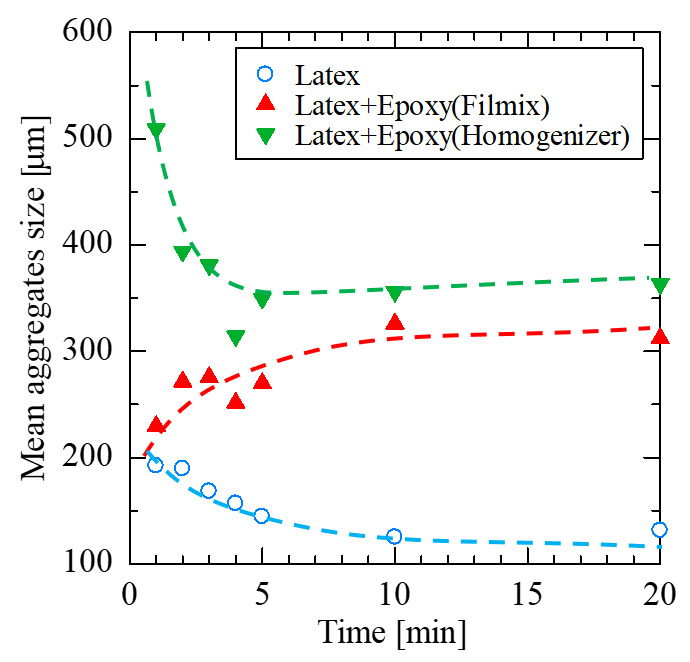
We propose a novel electrophoretic wet classification method using the applied electric field strength as an operation parameter. The influence of the applied electric field, electrolyte concentration, and particle size on the electrophoretic mobility was evaluated via direct measurements by microscopic electrophoresis. For high electrolyte concentrations or small particles, the electrophoretic mobilities decreased with decreasing applied electric field, unlike the basic theory of electrokinetic phenomena. Then, we fabricated an electrophoretic classification device and investigated the separation efficiencies for various particle sizes, electrolyte concentrations, and applied electric fields. For low electrolyte concentrations, the change in separation efficiency with respect to the applied electric field depended on the particle size. Finally, we performed a classification experiment using the applied electric field as an operation parameter. For low electrolyte concentrations, the classification performance changed according to the applied electric field. The applied electric field that provided the highest classification performance was the same as that where the difference in the separation efficiency was the highest. These results highlight the possibility of electrophoretic wet classification using the applied electric field strength as an operation parameter.
Keywords: wet classification; electrophoresis; electrophoretic mobility; particle
Fundamental understanding of the floating-sinking motion of solid objects in a gas-solid fluidized bed is important for various engineering processes such as a density separation technique. Basically the vertical motion of objects in a fluidized bed is explained by “hydrostatic effect”, i.e., the objects having the density larger than the apparent density of the fluidized bed sink into the bottom of the bed. However, recent studies have suggested that the floating-sinking motion of the object is influenced by various factors such as the object shape or the fluidization state of the bed.
The purpose of this study is to examine the fluid force (pressure force), which is the most significant force in the fluidized bed, acting on various-shaped objects and to investigate the shape dependency on the floating-sinking motion. We developed capsule-type pressure sensors and put them into the fluidized beds with various fluidization states. We measured the pressure difference between the upper and the lower surface of various-shaped objects. From the measurement results, it is found that the pressure around the object greatly varies with the object shape. The pressure field around the object in the fixed bed at low air velocity almost agree with the theoretical prediction from Brinkman equation which describes the permeation flow in porous media. On the other hand, the pressure in the fluidized bed at high air velocity largely fluctuates due to the interaction with rising bubbles, however, the average pressure difference between the upper and the lower part of the object reaches almost constant and does not depend on air velocity so much.
The results of this study suggest that the fluid force acting on an object in a gas-solid fluidized bed greatly depends on its shape and the floating-sinking motion is influenced by the fluidization state of fluidized bed.
Lithium-ion batteries (LIB) are used in various fields, but there is a demand for higher performance to meet the needs for further safety, cost reduction, and long life. Although titanium dioxide is characterized by its chemical stability and high theoretical anode capacity, oxygen deficiency is known to enhance performance via increased conductivity and ion diffusion rate. Thus, the titania-based materials have attracted much attention as an alternative of graphite for the anode material. Although the electrode performance is improved by introducing oxygen deficiency into titanium dioxide, there is a drawback of higher cost such as heating up to 1500 °C under pressurized hydrogen atmosphere. In this study, we propose a new simple method obtaining such a modified titania via a mechanochemical route. Mixture of anatase nanoparticles and polypropylene were milled by a high performance media agitating mill (Nippon Coke & Engineering, AL01). The mechanochemical effects were recognized as a phase transformation from anatase to rutile and color change from white to gray, attributable to the introduction of oxygen deficiencies. These effects were more intensive with smaller amount of polypropylene. Subsequent heat treatment at temperatures as low as 500 °C in the atmosphere of 5 % hydrogen/argon brought about carbon-coated and oxygen deficient titania. Their electrical properties were examined mainly by the impedance spectra measurement.
Demands for dry precise cleaning of various product surfaces contaminated with particles has been extended at various sorts of production processes such an assembly process of lithium ion batteries.Consecutive pulse-air jet (PAJ) blowings using a nozzle with a silt-shaped opening (rectangular nozzle) are effective for removal of micrometer-sized particles from various surfaces. In the present work, we aimed to make this dry surface-cleaning technique a more practical one for removing particles on separator film surfaces.
1.5 μm-sized PSL particles generated by a Colison atomizer were deposited to a silicon wafer used as a test surface placed in an inertial impactor. The test surface was exposed to PAJ blowings formed from the rectangular nozzle with the jet interval of 20 s and its duration of 1 s. Counting of the remaining particles was performed in the unit measurement area (0.25 × 0.33 mm2) using a microscope on the test surface at each pulse of blowing to determine the removal efficiency, fr_N. The planar distribution of the removal efficiency, fr_N on the test surface was obtained using the fr_N values of 143 points of the unit area in the staggered array of the measurement area (9.50 × 9.90 mm2).
Fig. 1 compares the planar distribution of particle removal efficiency between the rectangular nozzle and the circular nozzle with the same opening area. It was found that the rectangular nozzle successfully removed particles on a wider area at a higher efficiency compared to the circular one. The area mean removal efficiencies were over 90% for the rectangular nozzle, and 47% for the circular one.
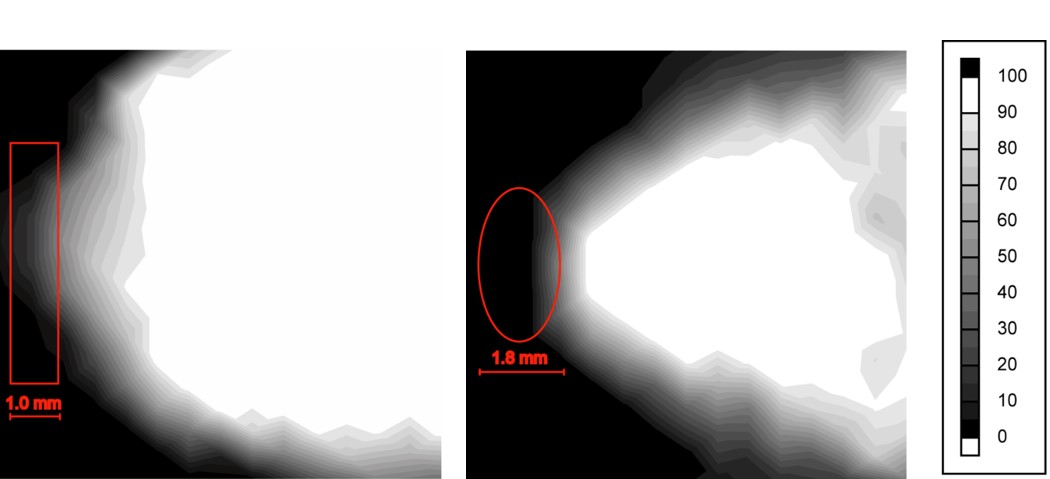
Nanoparticles are used in various industrial fields such as electronic devices, pharmaceuticals, and catalysts. The aggregation and dispersion of particles have a great influence on product quality in their manufacturing process. For example, production of multilayer ceramic capacitors includes a process of forming a thin film of the slurry and drying it. If there is a portion with a non-uniform degree of aggregation, it will cause product failure. So, understanding and control of the degree of aggregation of nanoparticles is important. In this study, we propose a new method to inspect the degree of particle aggregation using fluorescence spectrum analysis. Because this method is rapid, non-contact, and non-destructive, it can be a promising method of evaluating the degree of agglomeration of the nanoparticles on production lines.
We examined the influence of the aggregation degree of γ-alumina nanoparticle on fluorescence. We prepared two types of dry alumina particle aggregates with different aggregation states by different drying methods from a slurry of γ-alumina particles dispersed in water. By one, the slurry was dried at room temperature and, by another, the slurry was freeze-dried. From the difference in these drying processes, the particles dried at room temperature are more firmly agglomerated than freeze dried. The results of fluorescence spectrum measurement for these particle aggregates are shown in Figure 1. It can be seen that the fluorescence spectrum of the particles dried at room temperature is shifted to the longer wavelength side than freeze dried. The shift of fluorescence indicates the difference in the degree of aggregation from drying process. Namely, as the particles are aggregated, the wavelength of the fluorescence spectrum shifts to the longer wavelength side. This phenomenon would be considered to be similar to quantum size effect.
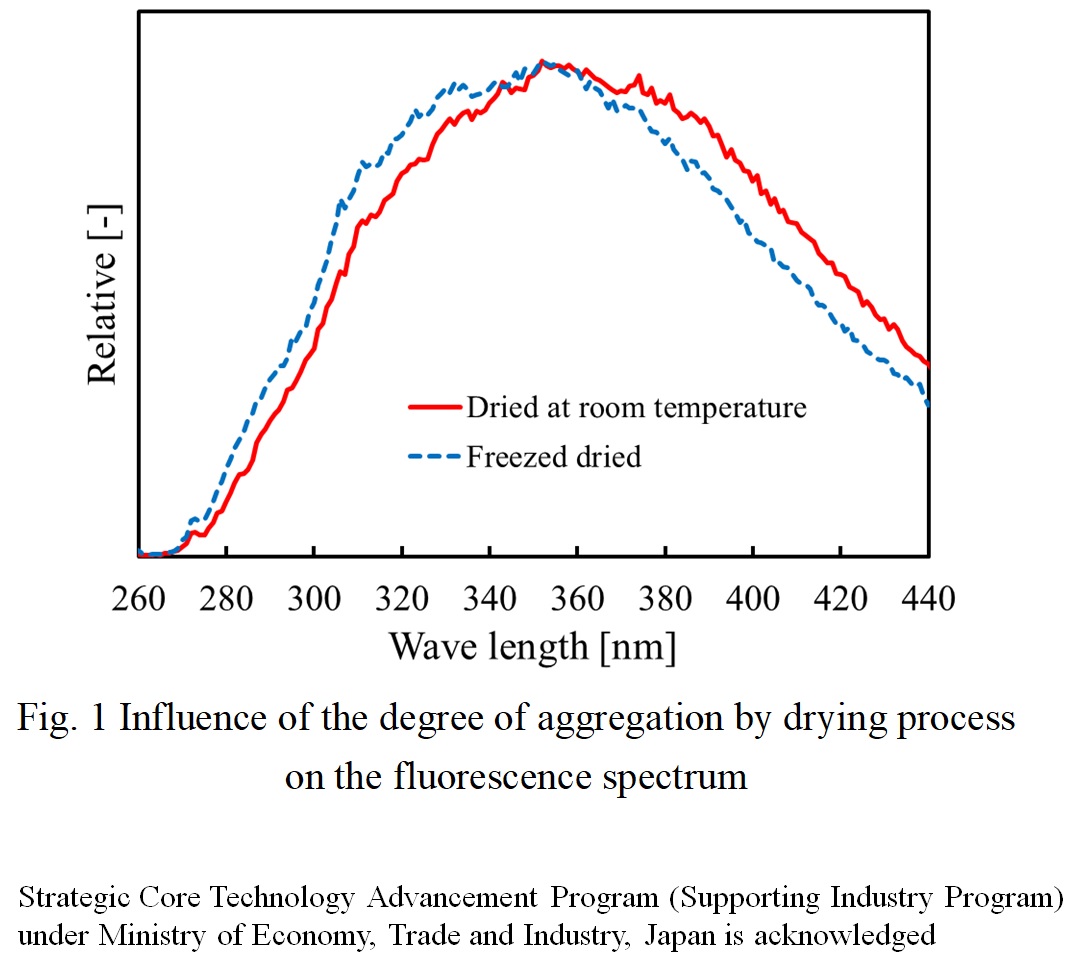
A rotary die-filling system is widely employed to produce pharmaceutical tablets. In order to manufacture the tablet, the powder should be fed into a cavity uniformly. For the efficient feeding of powder, the punches are equipped under the die. As the punch starts moving downward, the powder inside the shoe is fed into the cavity. The exact depth of the punches is controlled to measure the filling amount of the powder inside the cavity. Although this system is widely used, its effectiveness has not been examined so far. In the current study, the powder feeding process is conducted using the Discrete Element Method coupled with Computational Fluid Dynamics (DEM-CFD) method. For the representation of the arbitrary shaped moving wall boundaries, the Signed Distance Functions (SDF) are employed, where the scalar field of minimal distance from the nearest wall is computed at the beginning of the calculation. Besides, for the evaluation of the interaction between gas and moving wall boundaries, the Immersed Boundary Method (IBM) is coupled with the SDF, in which the tracking of the interface between gas and wall boundaries can be precisely calculated in the staggered grids. Through comparing the results between with and without the moving punches, the mechanism is revealed for the first time. Consequently, the yield rate can be drastically improved using the numerical simulation techniques.
Acknowledgement
This study was financially supported by JSPS KAKENHI (17H02825), JSPS KAKENHI (17KK0110) and by Grant-in-Aid for JSPS Research Fellow from the Japan Society for the Promotion of Science (18J12267).
When rotation of an impeller starts, strong torque (starting torque) is generated compared to the steady state in which the flow is fully developed. The starting torque is important for the strength design of the device. This study investigated the starting torque of two disk turbines within a mixing vessel, the relation between the starting torque and the distance of the two impellers, and the impeller rotational speed. Furthermore, CFD analysis was conducted to elucidate the starting torque generation mechanism.
Three starting torques, Ts1, Ts2, and Ts3, were observed as presented in Fig. 1. Ts1 is the torque generated during acceleration of the impeller. In this study we investigated Ts2 and Ts3. In Fig. 1, the relation between Ts2, Ts3 and the distance of two impellers (c) is shown. When c is small, Ts2 is small. Results show that Ts2 increases rapidly at c = 0.02 m and becomes almost constant from 0.035 m. Actually, Ts3 shows the same tendency, but Ts3 was not detected after 0.07 m. The following were found from the results of CFD analysis. Ts2 and Ts3 were generated when a flow is strong only around impellers and the flow of the whole mixing vessel is underdeveloped. When Ts2 was generated, two impellers produce the independent flow. When Ts3 is generated, two independent flows seen in Ts2 merge to one flow. Based on these results, Ts3 is not observed when c is large in Fig. 1 because the two flows generated by two impellers in each do not merge.
The relation between impeller rotational speed (n) and each of Ts2 and Ts3 was investigated. Ts2 and Ts3 were proportional to the square of n. Results show that Ts2 and Ts3 are torques based on pressure drag attributable to the relative velocity of impellers and a fluid.
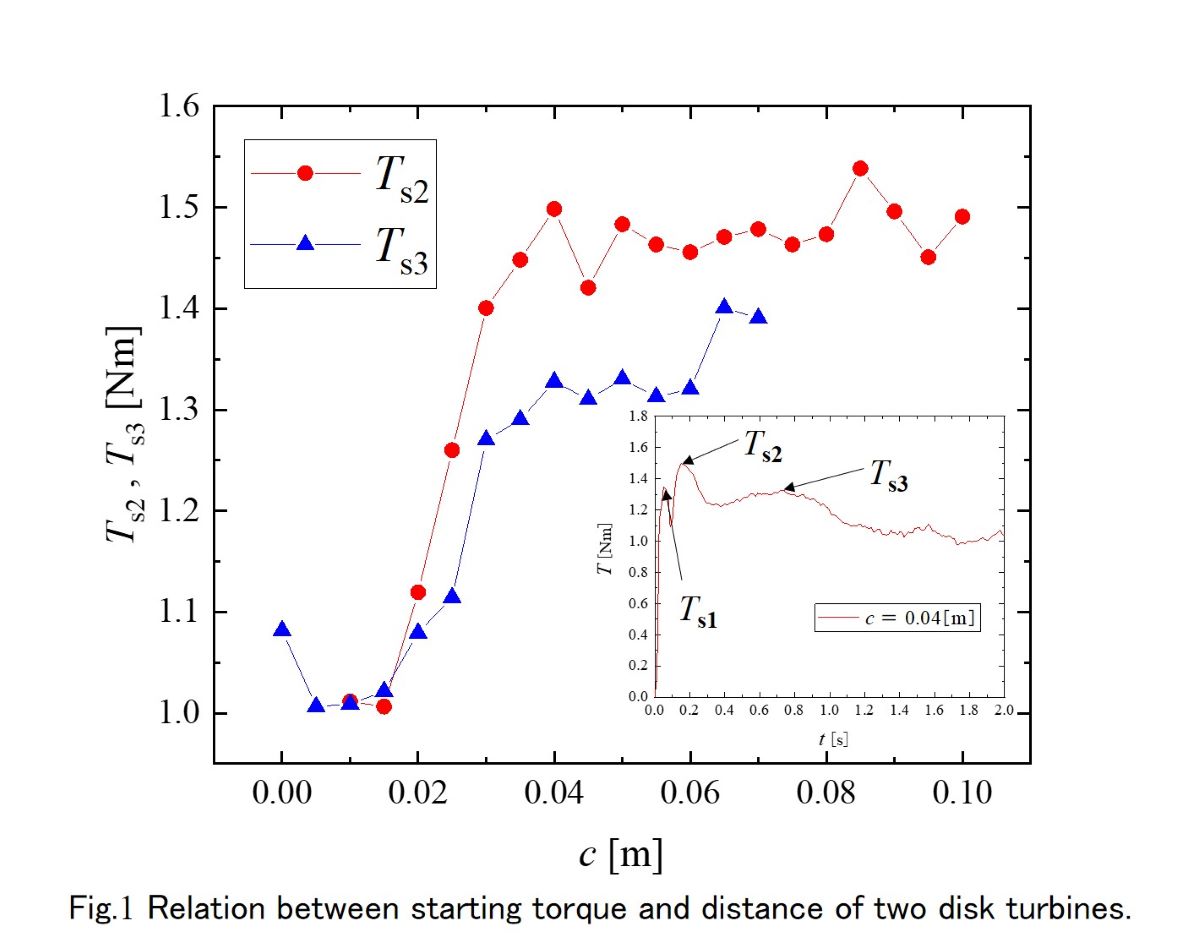
The removal of adhered microorganisms on surfaces is an important issue in every industrial process. The interfacial area of the gas-liquid interface increases and the residence time of bubbles in the liquid phase becomes longer with a decrease of an air bubble size. In addition, the production cost of air bubbles is low and their environmental load is also low. These positive features make air bubbles potentially suitable for use in physical cleaning technologies, such as removal of organic materials that have adhered to surfaces and cleaning of membrane fouling. However, cleaning effects using air bubbles and their mechanisms related to interaction forces are poorly understood. Thus, it is necessary to understand the interaction forces between air bubbles and target materials in detail for the further development of industrial usage of air bubbles. Atomic force microscopy (AFM) is a powerful tool for direct measurement of the interaction forces between surfaces. However, few studies have reported on quantitative measurement of interaction forces between a single microbial cell and a natural hydrophobic bubble surface. In this study, we attempted to conduct a direct measurement of the interaction forces between a yeast cell and a microbubble (MB) using AFM. We emphasize that the adhesive force between a cell and a MB measured in this study was one order of magnitude larger than those between microorganisms and hydrophobic substrates. This means that microorganisms that have only recently adhered on surfaces can be removed by adding a hydrodynamic drag force to the adhered MBs on the microbial cells. These findings provide useful information for various applications using MBs, including cleaning technology for any industrial process.
Segregation and mixing of binary particles with different densities are concerned in engineering. To improve its efficiency, the usage of vibrated fluidized bed which is a combination of fluidized bed and vibrated bed has been proposed. Due to the coexistence of both aeration and vibration, the phenomena of segregation and mixing of particles in vibrated fluidized bed is complex, whose detail is more important to understand for new designs. However, it is not easy to observe internal flows experimentally, considering the opaque nature of granular systems. Coupled DEM (Discrete Element Method) - CFD (Computational Fluid Dynamics) method is an attractive numerical tool to investigate particle motions in vibrated fluidized beds in detail, while large computational time is required to consider the dynamics of large amount of particles in real engineering systems. It is necessary to find out a proper approach to enable DEM-CFD calculations with reduced computational cost. In this study, enlarged particles are used while keeping the original bed size to reduce particle number. To obtain the similar segregation and mixing behavior in bed, governing equations are non-dimensionalized by characteristic variables in particle scale. Overall flow behavior is expected to be similar when the non-dimensional variables are kept same but changing particle size. In the present study, a numerical model based on particle-scale similarities is introduced and applicability of the proposed model is verified against density segregation problem in a vibrated fluidized bed by varying model particle size.
In an isothermal straight duct flow, the 'eight-vortex' secondary flow of Prandtl's second kind as in Fig. 1(a) is generated as a footprint of turbulent coherent structures [1]. When the bottom wall of the horizontal square duct is heated from below, the buoyancy affects these turbulent structures and drastically changes the skin friction and heat transfer rate over the walls and the behavior of coherent vortices under a various strength of buoyancy force the corner has been revealed at low Reynolds numbers [2]. However, at a transitional Reynolds number, the buoyancy effect has not been investigated.
At very low Reynolds numbers, the mean diameter of turbulent vortices is the same order of the duct width, therefore, the duct geometry strongly affects the generation mechanism of the secondary flow. As the bulk Reynolds number decreases, the secondary flow pattern drastically changes and becomes 'four-vortex' patterns [3]. And, at lower Reynolds number, the streamwise-localized turbulent puffs appear as in circular pipe flow.
In this study, the buoyancy effect on the four-vortex secondary flow pattern and localized puffs are investigated using direct numerical simulations. It is revealed that one of the four-vortex secondary flow patterns as in Fig. 1(b) is selectively stabilized by a weak buoyancy effect, and the generation of puffs is suppressed. Furthermore, it is revealed that the secondary flow also depends on the thermal physical property, i.e. the Prandtl number.
[1] Pinelli, A. et al., Reynolds number dependence of mean flow structure in square duct turbulence, J. Fluid Mech. 644, 107-122, (2009)
[2] Sekimoto, A. et al., Turbulence- and buoyancy-driven secondary flow in a horizontal square duct heated from below, Phys. Fluids 23, 075103 (2011)
[3] Uhlmann, M. et al., Marginally turbulent flow in a square duct, J. Fluid Mech. 588, 153-162 (2007)
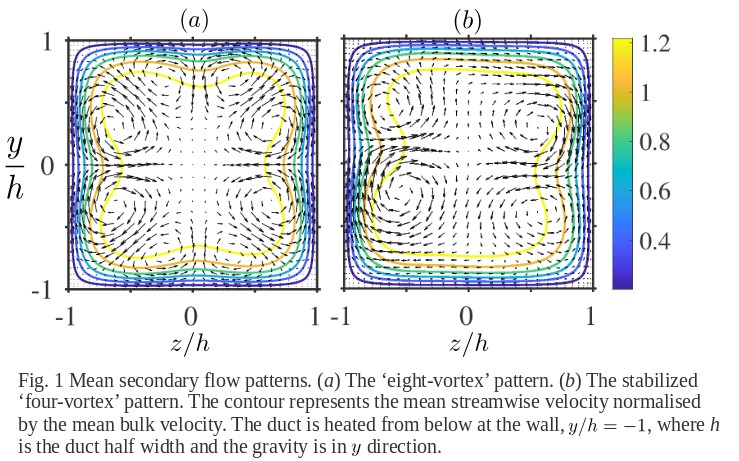
Heat transfer from a heated semi-circular cylinder placed in rectangular confinement has been investigated over wide ranges of the governing parameters as Reynolds number (1≤Re≤50), Prandtl number (0.7≤Pr≤50) and blockage ratio (0.2≤β≤0.8). The numerical solutions of the obtained governing equations for flow and heat transfer have been solved by considering, steady laminar flow in a channel. The combined influence of all governing parameters (Reynolds number, Prandtl number, and blockage ratio) on the flow and heat transfer characteristics have been delineated for the above ranges of the governing parameters. The streamline and isotherm profiles are obtained and used to represent the detailed flow and heat transfer characteristics. The gross engineering design parameters like recirculation length, drag coefficient, and Nusselt number are presented for scientific calculations and record. The distribution of pressure coefficient and local Nusselt number along the surface of the semi-circular cylinder are also presented to show the local variation in the quantities. The drag coefficient has shown an inverse relationship with the Reynolds number and positive dependencies on the blockage ratio, whereas the recirculation length has shown a reverse trend. Similar to drag coefficients, the Nusselt number shown positive dependencies on Reynolds number, Prandtl number and blockage ratio. Additionally, The functional dependence of recirculation length and average Nusselt number on Reynolds number, Prandtl number, and blockage ratio have been explored and the appropriate correlations to predict the intermediate values.
Keywords: Confined flow; Semi-circular cylinder; Nusselt number; Reynolds number; Blockage ratio; Prandtl number; Newtonian fluid
The flow and sedimentation characteristics of the microcapsules including phase change materials were investigated. As a phase change material, trimethylolethane (TME) clathrate hydrate which has the latent heat of 218kJ/kg was used at the concentration of 25 wt%. The mean diameter of microcapsules was 17 μm and the density of them with TME was 1.32kg/m-3 The concentration of silica hard shell microcapsules with TME was set at 10wt%. As drag reducing surfactants, oleylbishydroxyethylmethylammonium chloride was used with counter-ions of sodium salicylate whose molar ratio to the surfactant was fixed at 1.5. The concentration of surfactans was changed from 2.000 to 6,000 ppm. Polyvinyl alcohol (PVA) was also used as a stabilizer. The concentration of PVA was changed in two steps; 0 and 2000 ppm. Sedimentation experiments were performed in a test tube and the time variation of the apparent volume fraction of micorcapsule dispersion to the slurry was measured at 10 °C of temperature. The friction coefficients of the slurries treated with those additives were measured with a once-through flow system. The Reynolds number defined with water viscosity was changed from 200 to 25,000.
From the results, it was found that the microcapsules in the cases without additives and only with PVA settled to the bottom of the test tube immediately. On the other hand, the sedimentation delays in the cases with the combination additives of surfactants and PVA. The sedimentation was also found to occur slower with increase of surfactant concentration. From the measurements of the friction coefficients, it was found the friction coefficients show lower values in the larger region of 15,000 of Reynolds number. However, the friction coefficients increase with the surfactant concentration. Thus, the optimum condition was concluded to exist for the sedimentation and fluidity.
Acknowledgements: This study was supported by JST-Mirai-project:#JPMJMI17EK.
Since some Cu-based alloys, such as Cu–Co or Cu-Fe alloy, exhibit a metastable miscibility gap in the undercooled state, phase separation occurs when undercooling the alloys below their liquidus-line temperature. Such alloys are expected as new materials with novel properties depending on the phase separation structures. Although the phase separation structure is obviously affected by melt convection during undercooling, the correlation between the phase separation structure and the melt convection is not still clear.
The objective of this study is to elucidate the correlation between them in the Cu-Co alloy system. We utilized an electromagnetic levitator superimposed with a static magnetic field, which can control the strength of melt convection in an electromagnetically levitated molten alloy sample by the static magnetic field, to investigate the effect of melt convection on the phase separation structures of Cu-Co alloys. The sample diameter was 5 mm and the composition of alloys were Cu80CO20 and Cu58Co42. The strength of static magnetic field ranged from 0 to 5 T. Neutron computed tomography (CT) was used to visualize the three-dimensional phase separation structures. In addition, a series of direct numerical simulation (DNS) was also performed to calculate the three-dimensional velocity fields of melt convection in an electromagnetically levitated molten Cu-Co droplet under static magnetic fields, particularly magnetohydrodynamic (MHD) convection was focused on.
The neutron CT results showed that the phase separation structures depend on the static magnetic field strength. In particular, the marked difference in structure between 0.5 T and 3 T was observed, i.e., the size of Co-rich phases at 3.0 T is much larger than that at 0.5 T. The DNS results showed laminar-turbulent transition around 1 T. These results indicate that the marked change of phase separation structures has a strong relation with the laminar-turbulent transition.
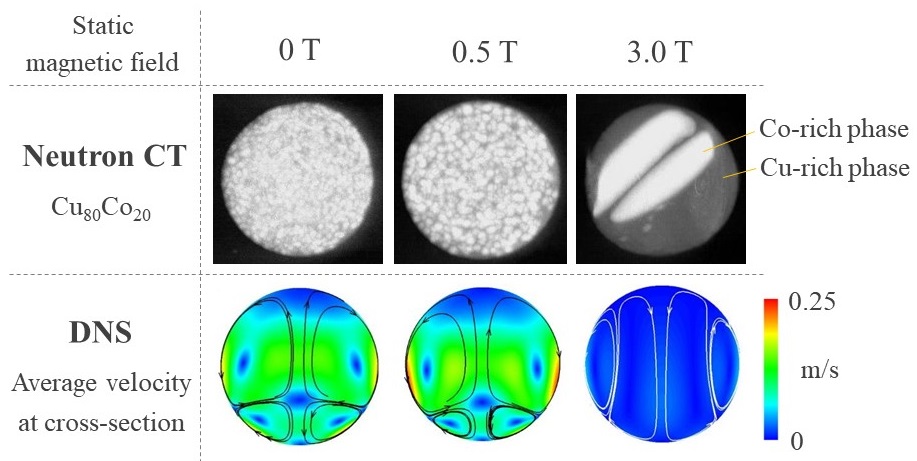
Containerless processing is an attractive synthesis technique as it permits deep undercooling in molten materials and the catalytic sites for heterogeneous nucleation are minimized. Thus, it provides a possibility to solidify the undercooled liquid into a selected phase to synthesize metastable materials with higher density and novel properties. It also offers a new approach to grow single crystal and forming new optical glasses using the containerless processing.
For oxide material, the containless processing is usually perfomed by aerodynamic levitation and electrostatic levitation methods. Electrostatic levitation furnace (ELF) is been operated in international space station (ISS) by Japan Aerospace Exploration Agency (JAXA) for thermophysical properties measuring of oxide melts in microgravity environment. Chinese academy of science (CAS) also is developing a new electrostatic levitation furnace for using in China space station (CNN).
In the recent years, we have successfully fabricated some fuctional oxide materails: the hexagonal BaTiO3 single crystal exhibited a dielectric constant value higher than 100,000 at room temperature; the new LaTi2O5 glass with a distorted five-coordinated TiO5 polyhedra glassy structure and a refractive index value higher than about 2.2. The thermophysical properties of density, viscosity and surface tension for high temperature melts up to 3,000 K have been measured using containerless levitation technology.
There is still a large demand for advanced combustion technologies for the stable production of power and electricity in our societies. Recently, numerical simulations have made outstanding achievements, and the number of research projects with Computational Fluid Dynamics remarkably increases with developing a computer performance. Under such situations, flamelet based tabulated chemistry has received much attention due to its high accuracy and relatively a low computational cost. In this work, using this approach based on a non-premixed flame, piloted methane/air jet flame was simulated by large eddy simulation. The numerical solutions showed good agreements to experimental data of temperature and major chemical species. Although the numerical solutions of temperature slightly overestimated the experimental data in the downstream, this difference was also reasonable because the effect of radiation was not included in the present simulation. Flame index, which is the indicator of local combustion mode, suggested the coexistence of premixed and non-premixed regions in the computational domain. Specifically, a premixed region was located in the inner side of the piloted jet while the combustion mode in the outer side of the piloted jet was non-premixed mode. To evaluate the influence of the flame type which is calculated prior to the main simulation, the look-up table based on premixed flame was constructed and used in an additional simulation. The detailed data obtained from the above simulations provided reliable insights for understanding the transport phenomena and chemical reactions of the chemical species in turbulent jet flames.
The combustion and heat release characteristics of hydrogen-methane/air (H2-CH4) diffusion flames on micro-jet array burner are focused in this research. The effects of H2-CH4 co-combustion and equivalence ratio on the flame structures, temperature, free radicals, heat release rate, and NO emission distributions of the H2-CH4/air diffusion flames are numerically investigated. The results show that the simulation results of OH distribution and flame length based on GRI 3.0 and Bilger mechanism are agreed well with the experimental results, showing an acceptable and repeatable results of H2-CH4 combustion based on those mechanisms. Furthermore, uniform and small flames can be formed at various H2-CH4 ratios. The intensity and distributions of heat release rate can be adjusted by H2-CH4 ratios and equivalence ratios. Finally, the dramatically enhancement of NO emissions at CH4 addition conditions are considered from the promotion of prompt NOx when CH4 added to the H2 flame.
An innovative multiphase AC arc (MPA) was drastically improved by diode rectification technique with bipolar electrodes. Temperature fields of the diode-rectified MPA (DRMPA) were successfully visualized on the basis of a high-speed camera with appropriate band-pass filters. The DRMPA had been developed to solve the electrode erosion issue, which was critical issue for MPA to be utilized in industrial fields. Diode-separation of AC electrode into a pair of cathode and anode led to drastic improvement of the electrode erosion characteristics. However, fundamental phenomena in the DRMPA are still poorly understood because of its novelty, although spatiotemporal characteristics of the arc and/or electrode temperature are necessary to develop the DRMPA for industrial applications. The purpose of the present study is to investigate temperature fluctuation characteristics of the DRMPA. Six phase AC arcs with and without diode-rectification were generated and their temperatures were measured by the high-speed camera system with appropriate band-pass filters on the basis of Boltzmann plot method. Figure shows electrode configurations and the two-dimensional temperature field of the DRMPA (a) and the conventional MPA (b)during one AC period of 60Hz. Results indicated that the arc temperatures of both DRMPA and MPA were fluctuated in the range from 7,000 to 13,000 K. The arc temperature near the electrode was higher than 10,000 K, while the temperature in the center region in the furnace was about 7,000 K. These obtained results suggest that the DRMPA is a promising heat source to fabricate attractive nanomaterials at a high productivity.
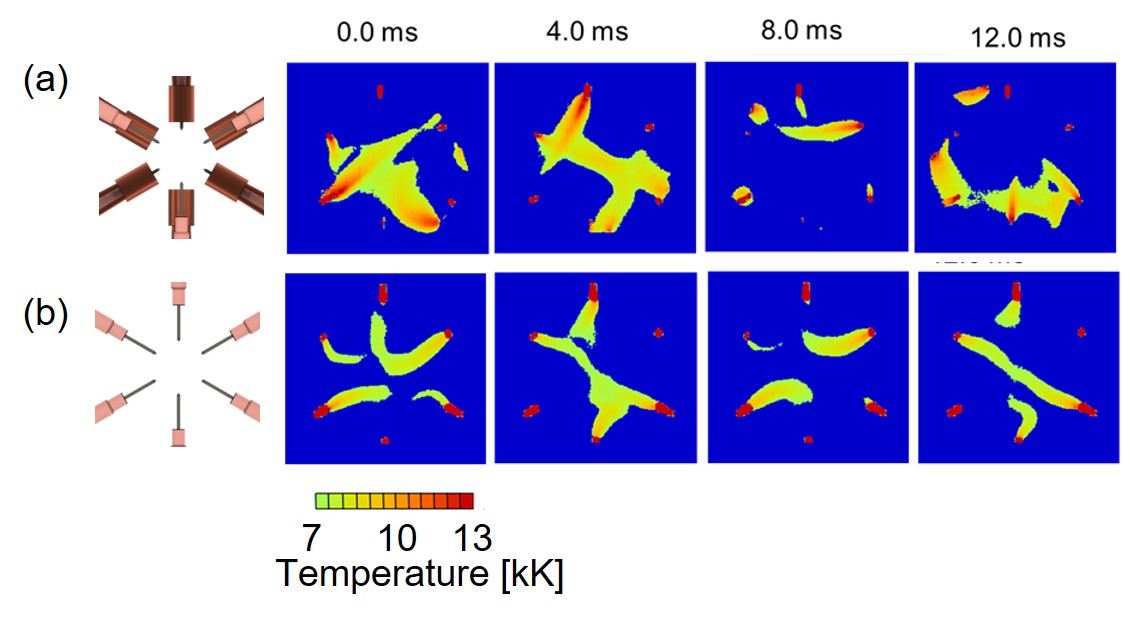
Thermochemical energy storage (TCES) has grown more attention in energy storage and conversion field, for its benefits in better reversibility, lower cost and safer chemical compounds, and higher energy releasing and storage density than conventional sensible and latent heat storage system among thermal energy storage systems. Calcium oxide/water/calcium hydroxide (CaO/H2O/Ca(OH)2) TCES system adapts for heat storage and releasing potential at 400 °C to 600 °C. Calcium carbonate (CaCO3) is used as a precursor for the TCES. However, the raw CaCO3 material from nature shows insufficient performance during heat storage capability and durability experiments. A composite material impregnated with silicon-related material of 0.6 wt% was developed and demonstrated superior reactivity and durability on repetitive operations than a conventional material studied previously. Instead of powder figure TCES materials, real reactors favor materials in pellet figure, then, the composite material in the pellet figure was developed and discussed kinetically TCES material performance in this study. The developed composite pellet material was evaluated by thermogravimetric analysis. The composite pellet was compared with a pure CaCO3 reference pellet on both hydration and dehydration processes. The heat output and storage density and their reaction rates of both materials were compared and discussed under the same operating condition. According to 6 cycles experiment, the composite pellet maintained stable reaction conversion and showed an increase of the hydration reaction rate. It was demonstrated that the additives for the composite had the positive effect and heat output density, Qh,m [kJ kg-material-1], of the composite pellet increased 32.7% in comparison with the pure pellet as shown in Fig. 1. Morphology change of samples before and after experiments indicated that the vapor diffusion and heat transfer were guaranteed by the additives which performed well as effective agglomeration prevention.
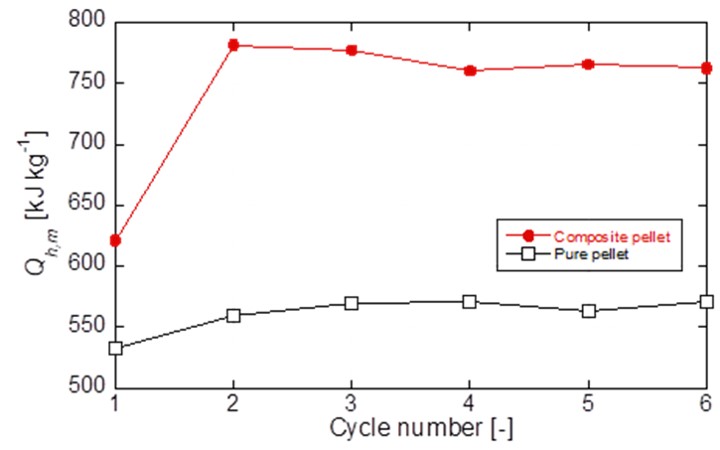
About 60% of the energy input in the chemical industry is discarded from the plant. Energy saving can be achieved in the entire plant by recovering these waste heats and reusing them as power and heat sources in the power plant. An adsorption heat pump has been developed for the purpose of regeneration of such unused energy.
In this study, saturated humid air was supplied to a device packed with 13X zeolite particles of 4 mm in diameter. The time variation of temperature in the apparatus was measured experimentally. Then, the maximum temperature was estimated from the relationship between heat balance and adsorption equilibrium. The trend of the maximum temperature calculated from the heat balance is consistent with experiment. Further, it was found from the result of the heat balance equation that the sensible heat of the moist air supplied and the heat of adsorption of the zeolite are mainly distributed to the sensible heat of the zeolite. In the future, it is important to make effective use of the sensible heat of this zeolite. In order to extract more thermal energy from the device, it is necessary to improve the heat transfer between the packed bed and medium.
A double pipe heat exchanger having a zeolite packed bed on the annular side was proposed as an apparatus. Flow direction of the humid air supplied to device was changed in two different ways. The one of them is supplying humid air vertically to the device and another is supplying the air in parallel. The influence of flow direction on heat transfer between packed bed and medium is studied with numerical simulation.
By inducing the inverse Marangoni convection, we successfully utilize a self-rewetting fluid to enhance the evaporative cooling of a spray system. The self-rewetting fluid is able to produce a surface-tension-driven fluid flow, which continuously replenishes the heated region to prevent dryout. As a result, cooling rate can be drastically increased. We find that the formation of a liquid film after the spray discharge is vital to this cooling enhancement, which requires a superhydrophilic surface and a proper spray height. Once the inverse Marangoni convection commences, the total heat transfer can be augmented three to seven times for a single pulse of spray. On the other hand, using the self-rewetting fluid in an intermittent spray system can be beneficial because comparable heat transfer rate can be delivered by spraying the self-rewetting fluid at much lower frequency. Although a longer spray pulse increases the heat transfer rate per cycle, the spray frequency also decreases for a given duty cycle which is unfavorable when a given time span is considered. Despite the moderate cooling rate per cycle for a shorter spray pulse, the time-averaged heat transfer rate is improved by the increase in spray frequency. For a fixed pulse duration, lower duty cycle leads to more sparse spray, higher surface temperature, and stronger inverse Marangoni convection. However, the resultant cooling rate is poorer and dry-out may occur if the duty cycle becomes too small. For large cooling-area application, we add more spray heads and find that deploying more nozzles helps to reduce the fluctuation in surface temperature but has little effect on the cooling rate. Increasing the spray frequency not only improve the cooling rate but also reduce temperature fluctuation. This enhancement becomes more apparent as the number of nozzles increases.
In recent years, printed electronics, in which wiring of electronic devices are formed by an inkjet method, has been focused. However, when a droplet is deposited on substrate by the inkjet method, there is a problem that it is difficult to control the width and the shape of the thin film. In our laboratory, it has been reported that the addition of surfactant to the coating solution causes Marangoni convection towards the center of the droplet at the surface due to the difference of surface tension, and the film becomes finer. However, the relationship between the flow in droplet and the shape of the film after drying droplet has not been clarified. Therefore, the purpose of this study is to clarify the effect of Marangoni convection on thin film shape by visualizing the flow inside droplet. Samples of the anisole-polystyrene solution with a surfactant are prepared. Each of them includes surfactant in various concentration and a small amount of fluorescent polymer as tracer. Surfactant in each solution is one of the four. Then a small amount of powder fluorescent polymer was added to each solution as tracer. Two experiments for prepared solutions were conducted, which are the dropping them on substrate and measurement of surface tension. Each solution was deposited on a hydrophilic substrate as a droplet with diameter of 80 micrometers using an inkjet method. Finally, the internal flow of droplet during evaporation and the shape of the thin film after drying were observed. Surface tension was measured for solutions including surfactant in various concentrations. As a result, it was revealed that the thin film after drying of a droplet became fine and ring shape tends to be suppressed by Marangoni convection. Additionally, the measurement of surface tension showed that the visualized flow is Marangoni convection.
This study focus on the synthesis of amorphous silicon nanoparticles by induction thermal plasma and understanding the formation mechanism. Crystalline Si powder with 5 μm of average diameter was injected into the induction thermal plasma at 20 kW-4MHz under atmospheric pressure. The powder feed rate ranges from 64 mg/min to 400 mg/min. Counter-flow quenching gas up to 70 L/min was axially injected from downstream of the torch to enhance the quenching effect for silicon nanoparticles. In the high temperature plasma region, the raw materials immediately evaporate. In the tail region of the plasma flame, supersaturated Si vapor starts to nucleate and then condenses onto its nucleus forming Si nanoparticles. The effect of the operating parameters such as quenching gas flow rate and powder feed rate have been investigated. The collected particles were characterized by using X-ray diffraction (XRD) and transmission electron microscopy. The amorphization degree was defined as the mass fraction of amorphous silicon in the silicon nanoparticles including both crystal and amorphous, and was calculated by internal standard method with XRD results. The obtained results show that higher quenching gas flow rate and lower feed rate lead to smaller diameter with higher amorphization degree. Figure 1 shows the diffraction patterns of nanoparticles with diameter which is equal to 140 nm and 8 nm, respectively. Smaller nanoparticles in Fig. 1 (b) are amorphous because of the appearance of the diffuse rings, while most small nanoparticles agglomerated together. For huge nanoparticle in Fig. 1 (a), some clear and regular diffraction spots are observed in the patterns, and means that the sample is crystal. This research indicates that induction thermal plasma can be used to synthesize pure amorphous material at a single step.
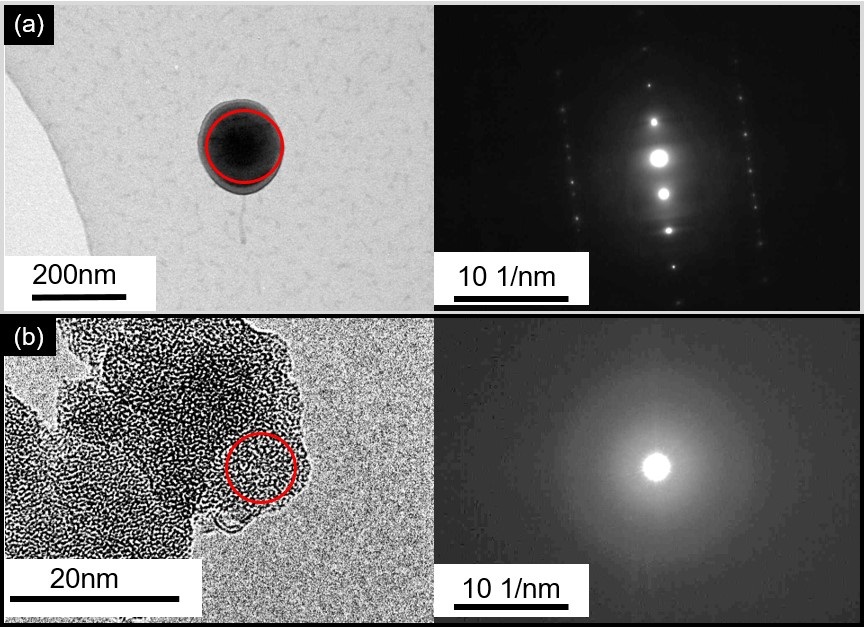
Oil and gas pipeline blockage due to gas hydrate formation in the deep ocean should be well managed because it would lead to environmental disasters and economic losses. To avoid this issue, researchers have been searching for effective hydrate inhibitors. Kinetic hydrate inhibitors (KHIs) are well-known substances to suppress gas hydrate formation with a small dosage (typically less than 1 wt%) whereas thermodynamic hydrate inhibitors (THIs) require a dosage up to 60 wt%. In this study, we examined inhibition performances of specific HBDs and HBAs using a high-pressure autoclave reactor and a high-pressure micro-differential scanning calorimeter (HP μ-DSC). We used a ramping method with a gradual decrease of temperature (0.2K/min) to measure onset points of hydrate formation which was detected by an abrupt pressure drop. The onset temperatures obtained by this method enabled us to estimate the performance of each inhibitor molecule as a KHI. Furthermore, we used COSMO-RS (COnductor like Screening MOdel for Real Solvents) program to see how the molecular structure and electron distributions of these HBDs and HBAs can affect CH4 hydrate inhibition. We obtained an electron density histogram named σ-profile and a characteristic function named σ-potential to visualize relationships between experimental results and screening results of each molecule. These results will demonstrate how HBD and HBA molecules affect CH4 hydrate inhibition with molecular interaction between inhibitor molecules and host water molecules and contribute to guiding us in the search of effective and environmentally benign inhibitors.
Incineration is one of the most general methods to treat industrial waste. Much amount of bottom ash is landfilled without being reused. Reduction of components such as harmful metals contained in bottom ash under appropriate incineration conditions makes it possible to reduce the amount of landfill waste and to increase the amount of reuse bottom ash. Management of conditions to control of bottom ash content has to be done for various kinds of industrial waste whose contents changes every day.
As the first step to improve incineration conditions, the effect of the primary air supplied to the bottom of a rotary stoker furnace is mainly investigated in this study.
Combustion characteristics of industry waste with typical component are numerically investigated using a combustion simulation program. It is confirmed that auxiliary fuel is necessary to burn the waste when preheated primary air is not supplied. On the other hand, preheated primary air enhances dry rate of input materials and enables to burn the waste without auxiliary fuel.
On practical process (commercial facility), components and calorific values of input material are commonly controlled by mixing some kinds of wastes. The preheated primary air effects on reduction of bottom ash amount, decrease of auxiliary fuel consumption and stabilization of furnace operation. The fluctuation ranges of the measured values such as temperatures in the facility are narrowed by preheated primary air, being independent of components of the input materials. This is mainly because the air enhances dry rate in the furnace. Consequently, preheated primary air is found to result in stable operation.
In order to develop a novel material for chemical heat pumps using hydration/dehydration of calcium chloride, the hydration equilibrium characteristics of calcium chloride encapsulated in silica hard-shell microcapsules has been investigated. The microcapsule with the mean diameter of about 20 micron has nano-size holes on their surfaces for hydration and dehydration reaction. In this study, the effect of the nano-hole size was focused on. The effects of the shell thickness on the equilibrium characteristics of calcium chloride were also discussed. The nano-hole size was changed from 147 to 1110 nm. The open ratio of hole area to the microcapsule surface increases with nano-hole size from 0.80 to 3.9 % in the present condition. The shell thickness was changed in two steps of 1.9 and 2.3 micron. The calcium chloride six hydration was inserted into the microcapsules. The equilibrium temperature of the dehydration was measured by a thermogravimetry at atmospheric pressure. The heating rate was set at 5 K/min.
From the results, it was found that the dehydration temperature of calcium chloride included in a microcapsule is slightly low. It was also found that the equilibrium temperature decreases with the nano-hole size decrease, in spite of the pressures loss increase for finer nano-hole cases. This indicates the equilibrium condition changes due to a capillary force by interface tension or osmosis effects in the nano-holes. In the case of thin shell, the dehydration temperature was found drastically to decrease. This might occur due to the above reasons under the condition of decrease of pressure loss effects. From the present results, it was concluded that the calcium chloride encapsulated in the microcapsules with fine nano-holes and with thin shell is a promising candidate for the high-performance chemical heat pump composites.
Al is widely used as a material for various heat exchangers because of its high thermal conductivity, small mass density, and high plasticity. The device performance has been improved by making the fins finer, however, it is difficult to make finer structure (< 1 mm). Carbon nanotubes (CNTs) also have high thermal conductivity and small mass density. In addition, simple fabrication of fine structure is possible via their self-organization process. Here we propose CNT-Al hybrid heat exchangers by growing micro-fins of CNTs directly on the conventional Al fins.
CNT arrays can be grown directly on Al sheets by chemical vapor deposition (CVD), however, their height remained 0.1 mm or less due to the low melting point of Al (660 °C). We realized 1.1 mm-tall CNT arrays by CVD at 600 °C [1]. To prevent the deactivation of catalyst pre-sputtered on Al, the C2H2 source was fed at low concentration with CO2 additive at high concentration. This method enabled tall CNT arrays but in a long CVD time (1.1 mm in 12 h). Then we elevated the C2H2 concentration and fed ferrocene (Fc) simultaneously, to grow CNTs fast and deposit Fe catalyst continuously. This method enabled >0.5 mm-tall CNT array in 2 h. Al sheet was prepatterned by using a pen-ink for selective catalyst deactivation (Fig. 1a) and the resulting CNT array was densified by wetting with ethanol and successive drying (Fig. 1b,c). Finally, we examined the heat dissipation performance using plate heater and N2 gas flow. Compared with the Al sheet, the performance improved about 1.5 times with the CNT fin arrays set parallel to the flow and about over twice set perpendicular to the flow (Fig. 1d). It is surprising to obtain such significant improvement. CNT fin structure induces vortex and make boundary layer thinner. Detailed analysis is underway.
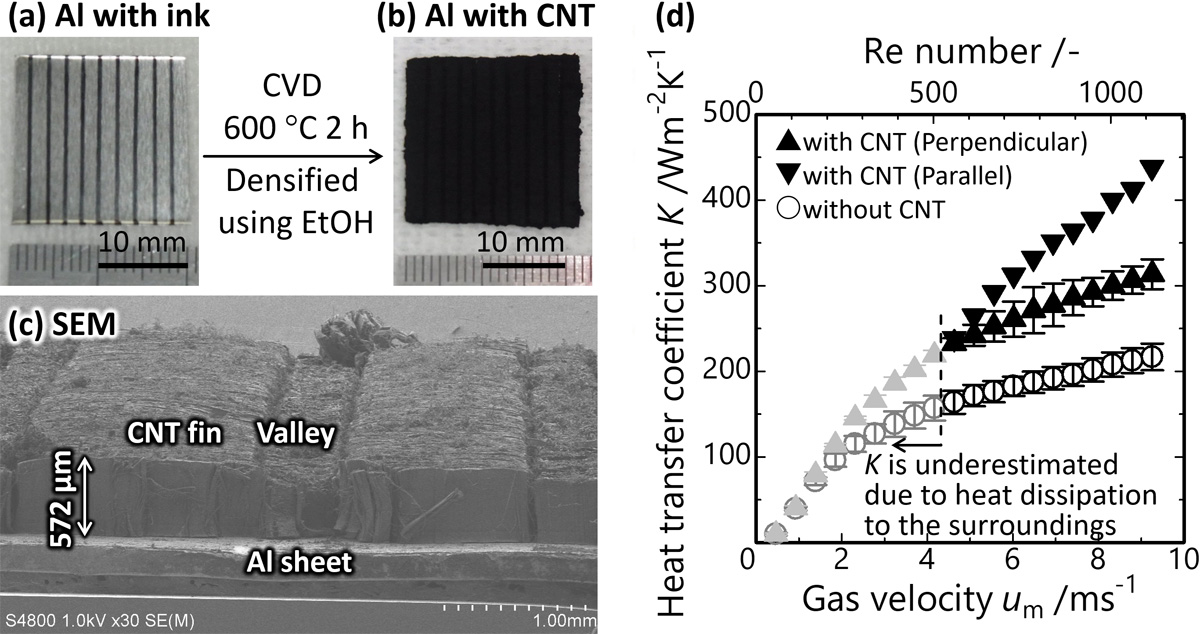
Nanoparticles in heated pipe flow are known to enhance the heat transfer ability of fluids. Although positive effects on the improvement of heat transfer ability of nanoparticles have been experimentally confirmed, it is difficult to identify the reason and mechanism of heat transfer with solely empirical way. Thus, we theoretically investigated the heat transfer mechanism of nanofluid containing graphene flakes (GFs), which exhibits good thermal conductivity, using coarse-grained molecular dynamics (CGMD). The size of 2.2 nm GF was used for nanofluids and four carbon atoms were replaced by one CG bead to maintain the hexagonal structure of GF. Heat transfer coefficient (HTC) of coolant, a mixture (50:50 wt%) of water and ethylene glycol (EG), containing GFs (1 wt%) was estimated in nanopipe flow system, of which the pipe is made of iron. Heat transfer trend was studied according to the functional groups (-H, -OH, -COOH) of GF. GF with hydrophilic functional groups (-OH, -COOH) showed higher dispersibility in the fluids than H-terminated GF. Also, nanofluid with COOH-terminated GF showed 25% higher thermal conductivity than that of without GF. In the nanopipe flow system with 0.1 â/ps of flow rate, we presented temperature, velocity, HTC profiles of nanofluids to elucidate the heat transfer mechanism. In the entrance region, GFs were located near the pipe wall and worked to transfer the heat of pipe to fluid. In the thermally fully developed region, GFs gradually moved to the center of pipe. Interestingly, the thermal boundary layer was maintained in the thermally fully developed region in the fluid. Additionally, GFs with hydrophilic functional groups showed larger HTC with higher rotation rate in the fluid.
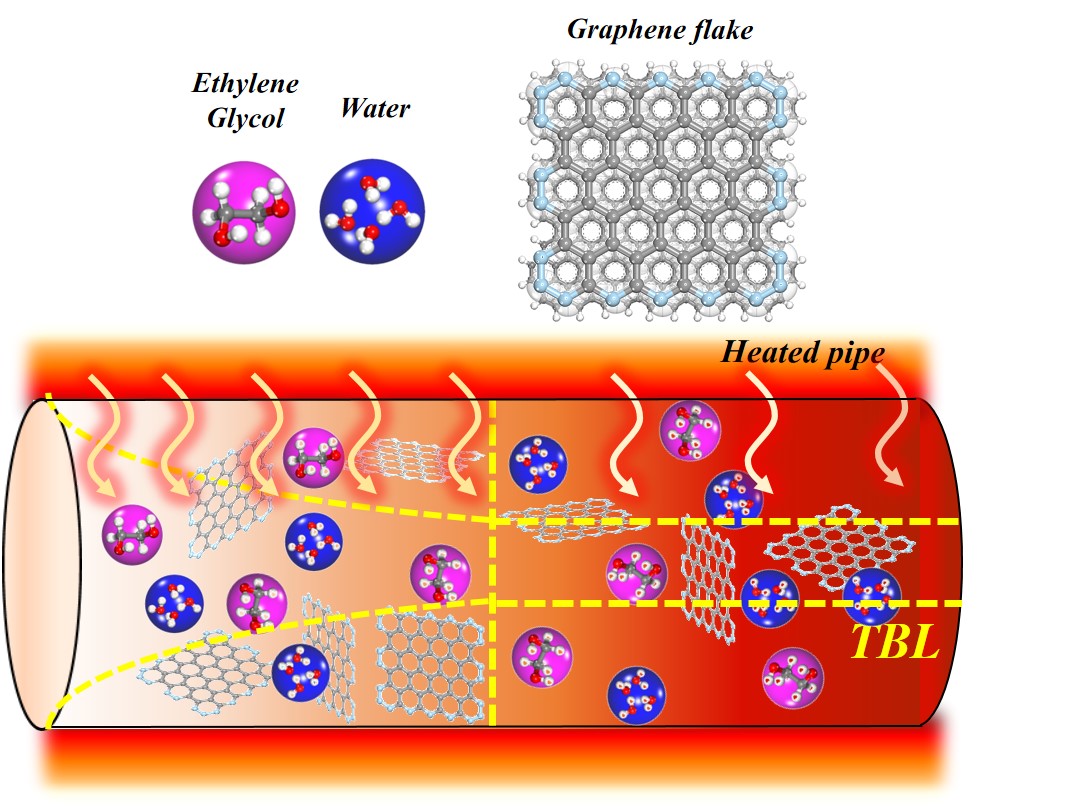
Copper nanowire (Cu NW) with high aspect ratio was obtained by D-glucose reduction under mild hydrothermal conditions. Use of oleylamine/oleic acid as Cu NW surface stabilizer led to obtain high aspect ratio over 1,000 of Cu NWs. Addition of small amount of sodium chloride for improvement of yields of Cu NWs up to over 90 % at optimum experimental condition. After centrifugal washing and recovery, direct surface modification of Cu NWs by immersing into hexane solution of fluoroalkylthiol self-assembled monolayer (SAM) were performed for achieving long lifetime well-dispersibility of Cu NWs into hydrofluorocarbon (HFE) -base heat transfer fluids. Applying the vacuum drying process of fluoroalkylthiol SAM functionalized Cu NWs in order to remove resume solvent such as deionized water and hexane surface led to obtaining highly dispersion stability over six months of fluoroalkylthiol SAM functionalized Cu NWs into HFE fluids.
The thermal conductivities of fluoroalkylthiol SAM functionalized Cu NWs dispersed HFC base nanofluid were measured by using transit thin hot wire (THW) method. A platinum thin wire coated with 3-mercaptopropyltrimethoxysilane (MPS) / tetraethoxysilane (TEOS) / 1H, H, 2H, 2H-perfluorodecyltriethoxysilane (PFDTS) hybrid film was used as a heating element and a resistance thermometer. High quality thermal conductivity measurement could be achieved by using thicker MPS/TEOS/PEDTS hybrid insulator coated platinum thin wire because of minimizing electrical leakage of fluoroalkylthiol SAM functionalized Cu NWs nanofluid in measurement cell. The effective thermal conductivities of obtained SAM functionalized Cu NWs dispersed nanofluids were increased as Cu NW concentration increases and maximum increase ratio was up to 80% comparing with the base HFC fluid.
Silicon carbide (SiC) is a promising wide-band gap semiconductor material for power devices due to its high electrical breakdown field and high thermal conductivity. But the performance of SiC devices is limited by the quality of the crystal growth because of the high dislocation density and high residual stress. In order to remedy these shortfalls, solution growth processes have been developed to grow high quality crystals. One of such solution growth processes is the Top Seeded Solution Growth (TSSG) method. However, it was found that in this growth process the Marangoni convection developing in the melt is strong and has an adverse effect on crystal homogeneity [1]. Therefore, we focus on the bottom seeded solution growth (BSSG) method shown in Fig. 1, since this technique had shown reduction in dislocation density in growth of GaAs [2]. In addition, the adverse effect of Marangoni convection is not significant because the seed is at the bottom of the crucible.
To the best of our knowledge, most numerical simulations in the literature were conducted in 2D. In this study, we carried out a 3D numerical simulation to investigate the transport phenomena occurring during the BSSG process of SiC. The simulation model includes the induced electromagnetic field, the radiative and conductive heat transfer in the furnace, and the mass transfer and fluid flow in the melt. The results showed that the Lorentz force in the 3D flow structures of melt is dominant while the contributions of buoyancy and Marangoni flows are small and the corresponding flow patterns remain axisymmetric. It was also found that the crucible rotation has a significant effect on growth rate. While the crucible rotation improves crystal uniformity, it decreases the average growth rate.
[1] T. Yamamoto et al., J. Cryst. Growth., 470 (2017), 75-88.
[2] K. Hoshikawa et al., J. Cryst. Growth., 94 (1989), 643-650.
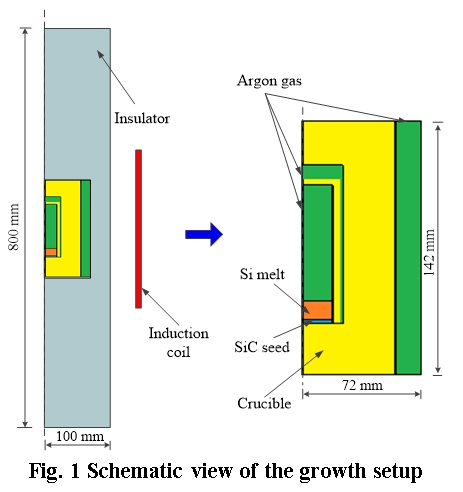
The direct numerical simulations of fully-developed turbulent plane channel flow with a spanwise narrow computational box to understand the turbulent heat transfer over the wall. We would like to demonstrate the effects of near-wall turbulent vortices on the heat transfer rate. The configuration is stably stratified channel flow with an imposed temperature difference between the top and bottom walls as shown in Fig. 1(a). The equations of continuity, Navier-Stokes and energy are discretized by using a high-fidelity spectral method and third-order Runge-Kutta semi-implicit scheme in the time integration [1].
In the present configuration, the spanwise narrow computational domain significantly reduces the computational cost and enables a parametric study of buoyancy effect on the instantaneous turbulent structures. In this study, the effect of the Richardson number which is the ratio of buoyancy force and inertial force are investigated at relatively high Reynolds number at the Prandtl number, Pr = 1. The obtained turbulent statistics are used to validate by comparing with the existing databases and the agreements and discrepancies due to the spanwise narrow computational domain are also discussed.
The vortical structures in the lower half of the channel flow are visualized as in Fig .1b using so-called Q criterion, i.e. the second invariant of the velocity gradient tensor. These turbulent vortices contribute strong turbulent intensity near the wall and turbulent heat transfer over the wall is enhanced. The effect of buoyancy on the turbulent statistics and the relationship between coherent vortices and the mean heat transfer rate will be discussed.
[1] J. Kim, P. Moin, and R. D. Moser. Turbulent statistics in fully developed channel flow at low Reynolds number. J. Fluid Mech., 177:133-166, 1987.
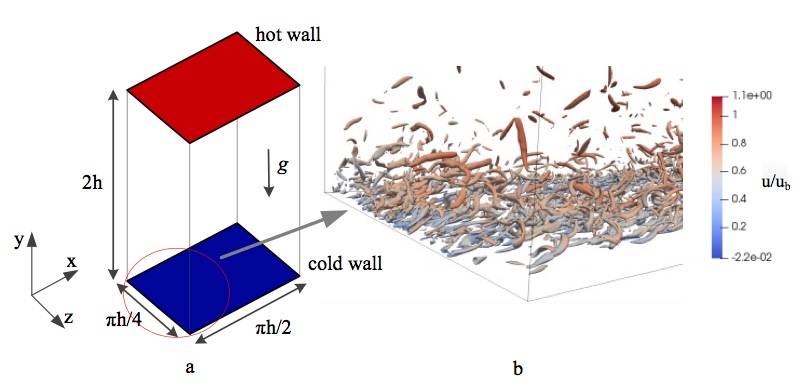
In a thin film evaporator (TFE), the axial distribution of liquid concentration is not clear, so it is difficult to predict the final concentration under various equipment design patterns and operating conditions. The focus of this research is on the evaporation of an acrylic polymer solution in TFE, a simulation model of which is proposed in this research.
In this model, the axial distribution of the concentration from top(inlet) to bottom(outlet) in TFE is simulated by sequentially calculating the shell balance of energy and mass. As outputs of this simulation, final concentration of the acrylic polymer is obtained. Parameters for correlating heat transfer coefficients and some factors are determined by least squares method using bench scale and plant scale equipment.
This simulation model is useful for predicting final concentration of polymer solution under unknown design patterns. For example, in case of changing blades number, there are several patterns (ex. position, number), and each of them have a different final concentration. By using this simulation, the several patterns of the final concentration can be calculated. As a result of changing blades number in plant scale, the measurements of the final concentration are within 2σ (95% confidence limit) of the predicted value, and it can be seen that both of them is in good agreement.
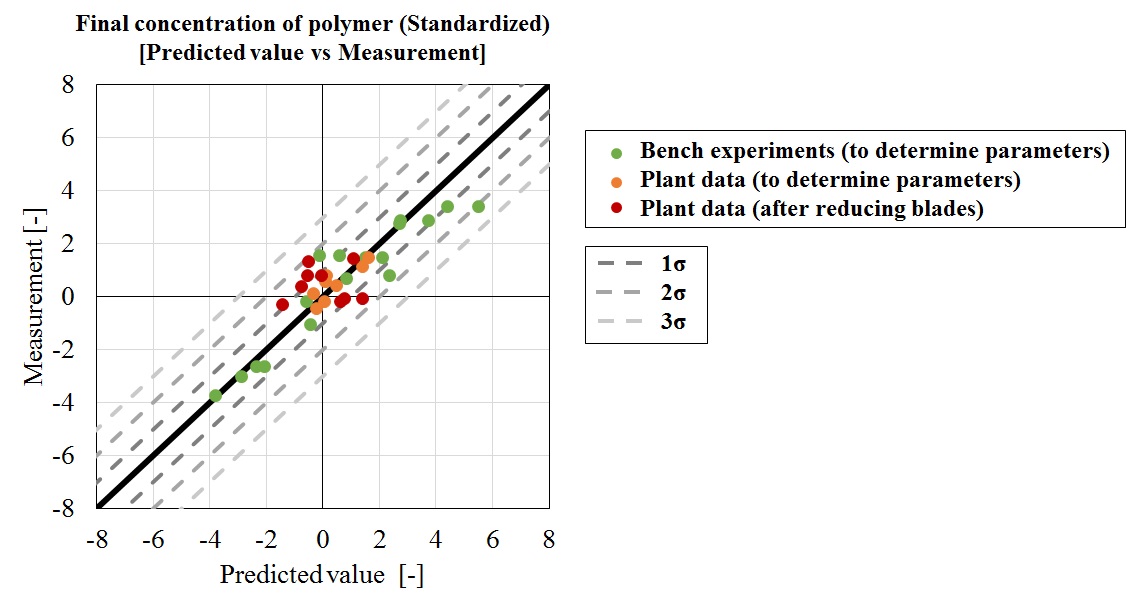
In general, a supramolecular gel is known to show reversible gel-sol transition responsive to various external stimuli such as heat and pH changes because of its weak non-covalent crosslinking. In this study, however, we designed a thermo-irreversible supramolecular gelator. The gelator was prepared by mixing a peptide lipid, NH2-C12-Gly-Gly-Gly-His (amino-C12G3H), and 4-ethylbenzaldehyde (EBAL) in an aqueous solution (pH 10.0). Mixing amino-C12G3H and EBAL forms an imine bond, which is a reversible reaction (Figure 1). We anticipated that the formation of an imine bond produced a supramolecular gelator to gelate an aqueous solution. Heating the resultant gel caused the gel-sol transition and evaporated the volatile aldehyde (EBAL). The removal of EBAL did not allow gelation upon cooling, which would achieve thermo-irreversible gel-sol transition in the supramolecular gel. In fact, the formation of a supramolecular gelator gave a supramolecular hydrogel and a microfibrous structure (self-assembly of the gelator molecules) was observed by TEM. After the supramolecular gel was heated at 80 °C for 40 min with keeping a cap of a sample vial open, the solution never turned to gel again (thermo-irreversible gel-sol transition). 1H-NMR measurements confirmed the removal of EBAL after heating. Finally, we tried to visibly record thermal hysteresis on a supramolecular gel. Tuning the EBAL concentration and heating time at 80 °C controlled the thermo-irreversible gel-sol transition, indicating that the present system can visualize and record the thermal hysteresis as gel or sol. The use of benzaldehyde as an aldehyde, which is more volatile than EBAL, allowed the thermo-irreversible gel-sol transition at 50 °C, meaning that the temperature for the thermo-irreversibility can be controlled by the selection of an aldehyde.
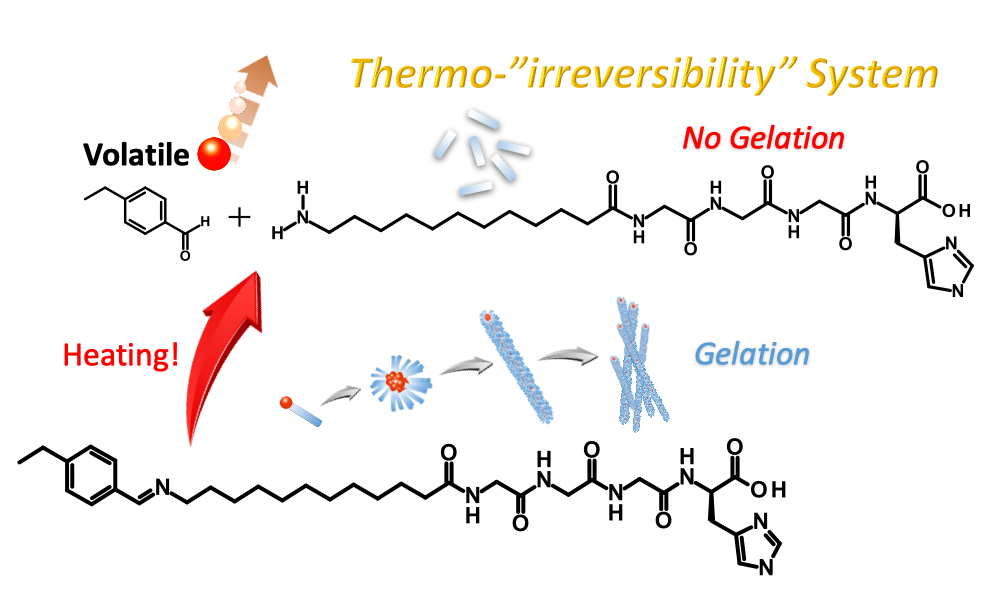
Power generation by variable renewable energy (VRE) is increased for decarbonization, which need suppress output to control the quality of electricity. As a power reserve, wind powered thermal energy system was proposed, which stores heat generated from rotating energy and produces steam to drive turbine or direct use. In this study, we examine Thermal Energy Storage system in Paper mill (TESP) and simulate to estimate capacity of thermal energy storage (TES) at paper mills all over Japan. Paper mills converts large amounts of energy by in-house boilers and turbines , the capacity utilization ratios (CUR) of which are fluctuated depending on the paper demand and fuel prices .
A concept of TESP is that heat from boilers and VRE is stored in TES and converted into steam or electricity like the system of concentrated solar power. Excess heat stored in TES generates constant electricity to sell to power grid. Constant generation of steam and electricity can reduce cost by raising CUR of energy plants, and decarbonize by accepting VRE .
We simulated energy balances with and without TES in a paper mills. Without TES, CUR of energy plants were low due to the fluctuation of energy demand. With TES, CUR were basically increased by storing excess heat. The necessitated capacity of TES varies by operation patterns. When production lines stop all together, large capacity of TES is required since large amounts of excess heat is generated. Through this simulation, we can estimate capacity of TES depending on paper demand all over Japan.
We conducted a simulation to design appropriate specification of TES depending on paper milling process and operation. This simulation will facilitate the design of appropriate scale of TESP depending on paper demand, cost and environmental impacts. Paper mills may be a supplier of heat and electricity from distributed energy sources.
Some processes such as flotation with nano or micro bubbles, mechanical operation like centrifuge separations and electro conglutination have been used for the demulsification of the wastewater produced from the well. Recently, demulsification by mean of usage of quick thermal response of microwave heating has been proposed as an efficient method. Our previous study found special microwave behaviors for interfacial tension between two liquids [1]. For example, there is hysteresis of interfacial tension between heating and cooling process and the tension after the irradiation does not return to the original value. Moreover, difference between thermal effect and non-thermal effect like non-equilibrium local heating, which is caused by the vibration of water molecule around the interface, is not clear. In this study, interfacial tension between decane-water was measured during and after microwave irradiation when concentration of NaCl in water was changed to investigate effect of saline solution on the microwave special behavior. First, hysteresis was observed between the heating and cooling interfacial tension as well. The above special behavior such interfacial tension reduction was confirmed and the effect was prompted by addition of salt in water phase. This is because microwave absorbs in water phase with salt more strongly. As a result, more emulsions are produced around the interface, and they interrupt tension along the interface. Recently, the efficient separation process of emulsion water produced at mining crude oil has been required. Finally, this technique has a potential as higher performance of the separation process by interface modification.
Thermal analysis of packed bed with two particles, which show different emissivities and thermal conductivities, was conducted by homogenization method. Sigmoidal curve as a function of Nusselt number with a thermal radiation coefficient was obtained. The emissivities are enclosed in the Nusselt number, and parameters representing shape of sigmoidal curve are mainly decided by ratio of the particle number and the thermal conductivities of two particles. Finally, it was found that thermal radiation analysis in more complex structures like packed bed and porous medium became simpler by homogenization method, and this multi-scale simulation is expected to contribute reduction of computational cost.
Fluctuation phenomena of plasma jet flow in an innovative long DC arc system with ring-shaped anode were successfully clarified on the basis of the high-speed camera visualization. The long DC arc with long electrode gap distance more than 350 mm has been applied to gas decomposition due to its advantages of long plasma length, resulting in long residence time of treated gas. However, large heat loss at a conventional hemispherical-shaped anode was critical issue in the long DC arc system. Therefore, a ring-shaped anode was utilized to convert large energy loss at the anode into the plasma jet flow. Calorimetric measurements were carried out to evaluate energy balance in the long DC arc system with the ring-shaped anode. Results indicated that the 60% of heat loss at the conventional hemispherical-shaped anode was converted into the plasma jet flow when the ring-shaped anode was utilized. High-speed camera observation revealed the effect of external magnetic field on the fluctuation phenomena in the long DC arc. Figure 1 shows the high-speed snapshots of arc and plasma jet (a) with and (b) without external magnetic field. Upper images correspond to the arc images while bottom images show the plasma jets. External magnetic field leads to arc swirl motion. Plasma jet fluctuates with the frequency of several tenth Hz when the magnetic field was applied. These understanding of arc and plasma jet fluctuation enables to improve the capability of long DC arc system.

Food market in Asia is expanding at dramatic rate. In the near future, there will be about 400 million rich people who will eat raw vegetables as well as Japanese people, which is a great business opportunity for the farmer in Japan who has the know-how to produce high-quality vegetables. However, the weather conditions in Asia, especially in south-east Asia, can induce poor growth of plants because of its distinctive high temperature and humidity. In this case, it is effective to put a light shielding material on the outside of the house film, but the yield loss may be caused by shy bearing of fruits due to the lack of solar radiation.
In this study, the authors investigated the effects of some greenhouse heat-shielding sheets on the yield of tomato production in hot and humid regions of Asia. In particular, the spectral and optical properties of the heat-shielding sheets were compared with those of conventional greenhouse sheets, and the thermal properties such as the temperature and the amount of solar radiation in the greenhouse covered with these were analyzed. Modern greenhouse sheets must be sufficiently strong to withstand different climatic conditions. It should allow good transmission of solar photosynthetically active radiation (PAR) and maintain the good heat insulation properties over a long time period.
Consequently, it became possible to analyze the degree of suppression of the temperature rise of the greenhouse due to absorption of heat rays and the distribution of visible light necessary for photosynthesis when using heat-shielding materials for the greenhouse at high temperature. It was suggested that focusing on the absorption rate and considering characteristic of film by wavelength are also important by this simulation.
There are many reports on calculation method for homogeneous food, but few method for heterogeneous foods such as cooked rice. In this study, using some containers for storing frozen cooked rice, which are commercially available, microwave thawing calculation method for heterogeneous food was proposed. Furthermore, change of temperature distribution with time for calculation result was compared to that of experiment result to verify accuracy.
As experiment method, cooked rice of 177g was filled into a container and was frozen with domestic refrigerator for 24 hours. When filled rice, 0.2 mm thick polypropylene film was set in the center of container to bisect the rice and get temperature distribution easily. After that, that sample was heated by microwave with 600W and temperature distribution of vertical section was captured by infrared thermal camera. Heating time was 180 s, time interval for camera shooting was 30 s.
Using FEMAP which is a commercial software, 3D model was made based on the size of microwave oven, cooked rice and container. Created model of cooked rice had 29% pore elements which were assigned randomly in the rice model. Calculation conditions were determined for electromagnetic field analysis and heat transfer analysis. When frozen cooked rice is heated, heat convection of vapor will be occurred because cooked rice has pore in the system. But heat transfer model used in this study can't calculate convection heat transfer. Therefore, we tried to estimate apparent thermal conductivity to represent heat convection. After setting condition, calculation was carried out by coupling two models.
As a experiment result, the temperature was risen from bottom side of container, then cold spot was confirmed above dent structure after microwave heating. Calculation results also showed the same tendency and change of temperature distribution with time was agreed with the experiment result. Thus, the calculation method for heterogeneous food was established.
Double film robber (DFR) heat exchanger that mechanically scrapes the temperature boundary layer by the combination of the rotating heat transfer tube and the fixed blades can achieve quite high performance, namely the heat transfer coefficient higher than 10000 Wm-2K-1. It, however, is known that its performance largely depends on the operating condition, and it is necessary to grasp the improving mechanism of heat transfer rate for designing the equipment and the operating conditions. This study discussed the heat transfer mechanism from thermal fluid flow in the DFR heat exchanger. The temperature distribution in the heat exchanger was measured by inserting the multiple thermocouples. Fig. 1 shows the temperature distributions of outer fluid with and without the tube rotation. Without tube rotation, the temperature of the fluid only in the vicinity of the heat transfer tube rises. Contrarily, the temperature of fluid rises uniformly over the whole radius. This means that, not only scraping the temperature boundary layer but also the fluid mixing that lets the fluid away from the heat transfer tube to participate in the heat exchange improves the heat transfer performance.
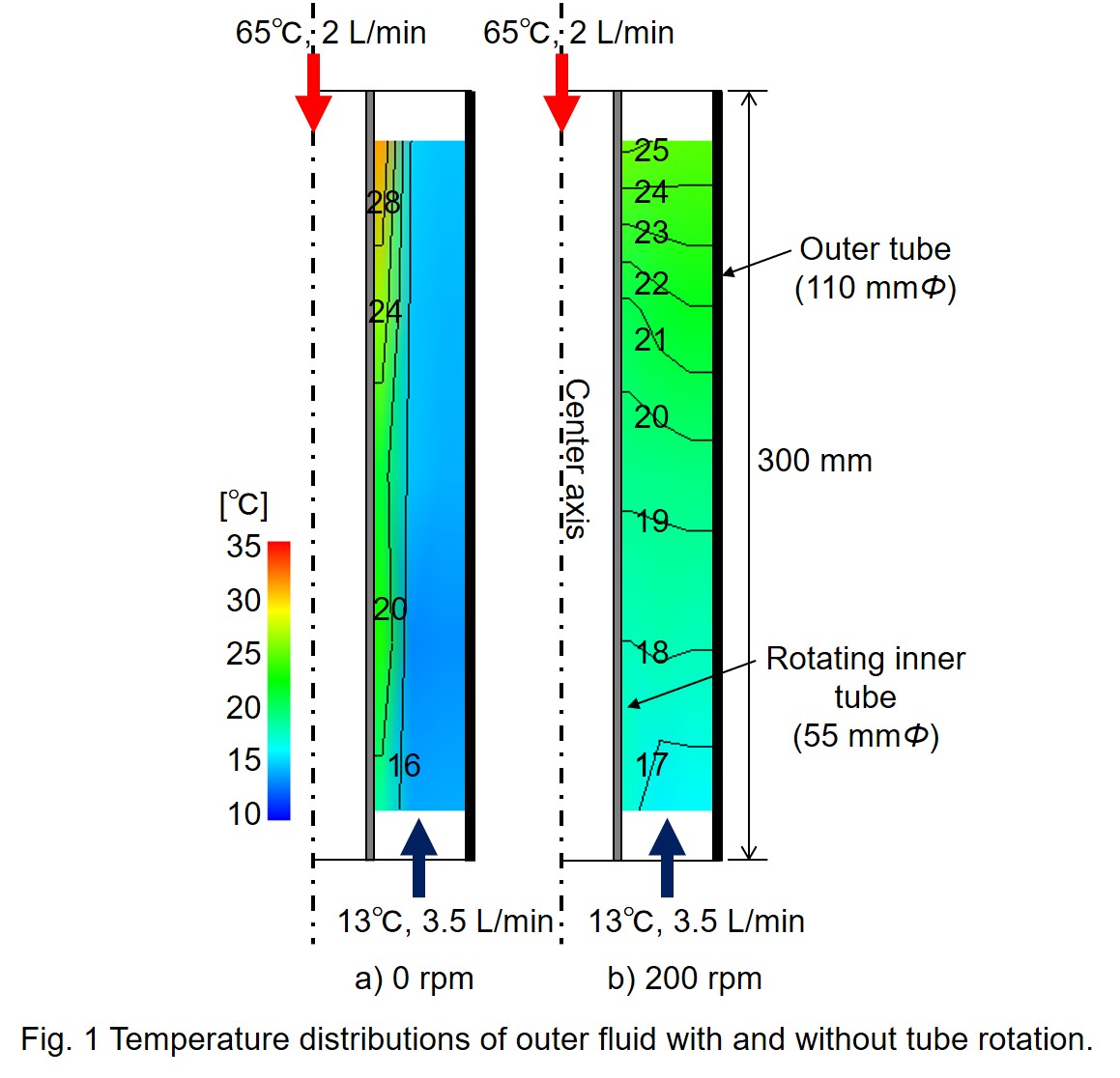
A mathematical model that simulates atmospheric freeze-drying for minced salmon was developed and validated with experimental drying runs. This study was targeted for an atmospheric freeze-drying that operated far over the glass transition temperature of the products, where we must admit the product deformation such as shrinkage and micro-collapse due to glass-rubber transition. The developed mathematical model was based on the mass and heat balance equations, and the solution could be obtained by assuming the quasi-steady-state energy balance at the sublimation interface. Air temperature could be programmed to increase as the progress of drying in order to accelerate drying rate. A simulation was carried out based on the mathematical model by applying the experimentally obtained parameters such as mass and heat transfer coefficients, air flow temperature etc. The apparent water vapor pressure of products was assumed to be dependent on the temperature and moisture content, and it was experimentally measured by carrying out the pressure rise test for samples with different temperature and moisture content. It was confirmed that the simulation well predicts the experimental drying kinetics. The present simulation is based on a mechanistic mathematical model, so it simultaneously gives the other important values such as product temperature, mass and heat flow rates, etc. The simulated product temperature suggested that the drying progressed far above the glass transition temperature of salmon, so some phenomena that may occur in a rubbery system (e.g. shrinkage, micro-collapse) are not avoidable in this drying system. This simulation approach would be useful to design favorable drying protocol, where freeze-drying progresses under atmospheric condition.
This paper offers how to realize quick refolding of high concentration protein via microchannel flow membrane dialysis. E. coli. are suitable host cells for mass production of proteins due to their fast proliferation and translation rate. On the other hand, proteins produced by E. coli. are often expressed as insoluble inclusion body, which have no activity. In that case, the “refolding” process to recover the original protein structure and activity is required. A quick refolding of high-concentration protein is important issue for industrial process but generally quite difficult. Dilution method can quickly refold protein but the concentration becomes low, while dialysis method can refold high concentration protein but requires long time. Considering the rate determining step of the dialysis is the slow permeation of denaturant through dialysis membrane, here, we propose the design to realize both of quick and high-concentration protein refolding by using microchannel flow dialysis.
Dialysis membrane was sandwiched with two microchannels; feed channel and permeation channel. Carbonic Anhydrase (CA) (as model enzyme) denatured by denaturant (guanidinium chloride (GdmCl)) was fed into feed channel. On the other hand, refolding buffer was fed into permeation channel. The denaturant was quickly removed from feed channel to permeation channel through dialysis membrane due to high specific membrane surface area in microchannel flow. As a result, CA can be refolded in only twenty minutes, which are much shorter than the time for conventional dialysis method, and just a bit longer than the time required for refolding of CA. Furthermore, the microchannel flow process realizes almost 100% protein recovery and active recovery for CA with concentration as high as conventional dialysis method within the quick process. The demerit of the microchannel flow is low flow rate but it can be easily solved by numbering up and increasing flow rate with longer channel flow.
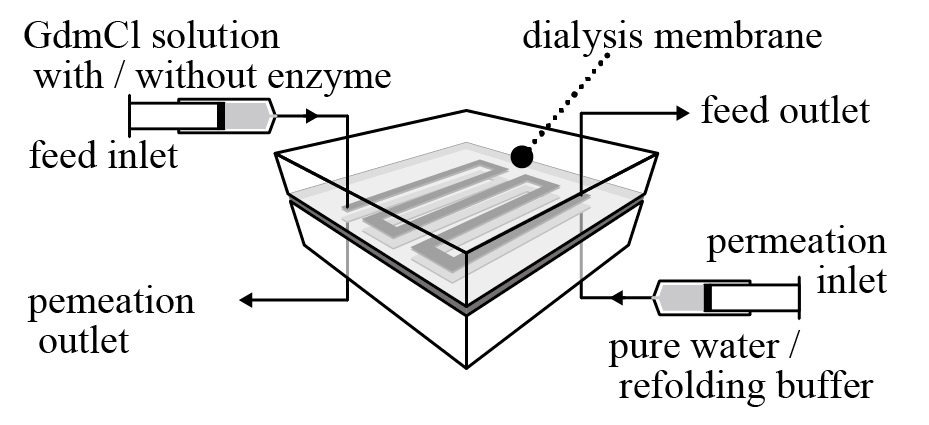
A “Biomembrane” is a highly-organized self-assembly of biomolecules (i.e. lipid, protein etc.) and a key interface for the survival of biological cell. The “Membranome” can be defined as the properties of vesicle (or liposome), which arise from the bilayer molecular assembly of amphiphiles, focusing on “emergent properties” which are not present in the individual components, and is gradually recognized as an important research methodology to investigate the potential functions of vesicles (or liposome) and to apply them for the bioprocess design. “Self-Organizing System”, such as liposome or vesicle, possesses several benefits in the recognition of (bio)molecules, where it can recognize them with (i) electrostatic, (ii) hydrophobic interaction, and (iii) stabilization effect of hydrogen bonds at its surface. A key of next chemical engineering is the use of “Self-Organizing System”, where “enthalpy-driven” nature of chemical process would be converted to “entropy-driven” one. We call this strategy as “Bio-Inspired Chemical Engineering”. In this study, the basic and applied aspect of the self-organizing system were reviewed, especially focusing on chiral separation and chiral conversion process.
Reference:
P. Walde et al., Chem. Commun., 50, 10177-10197 (2014). T. Ishigami et al., ACS Appl. Mater. Interf., 7, 21065-21072 (2015). T. Ishigami et al., Langmuir, 32, 6011-6019 (2016). M. Hirose et al., Langmuir, 31, 12968-12974 (2015). F. Iwasaki et al., ACS Omega, 2, 91-97 (2017). F. Iwasaki et al., ACS Omega, 2, 1447-1453 (2017).
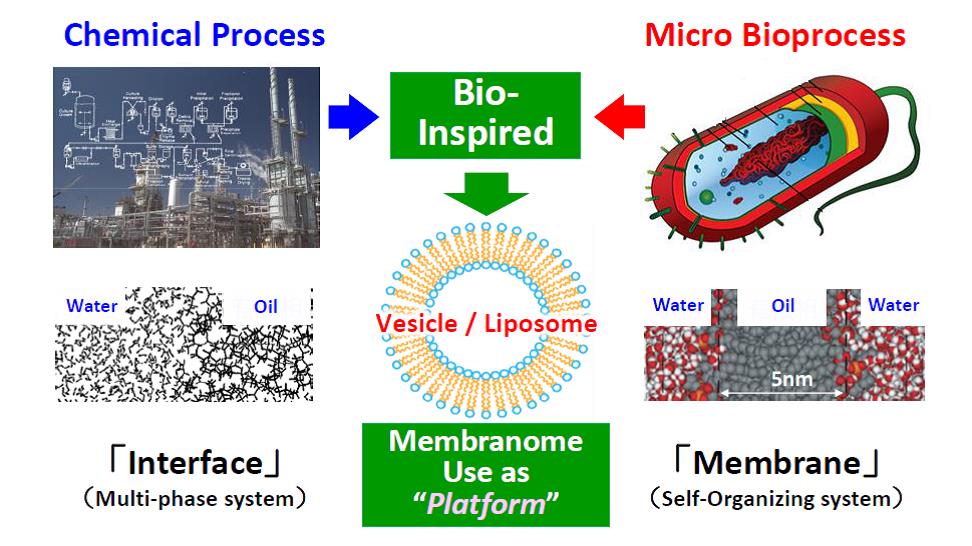
Polyamide and cellulose triacetate are known to be materials for reverse osmosis (RO) membranes, which are used in desalination of seawater. In order to deal with increasing water demands all over the world, a development of higher performance RO membrane and membrane processes are required. A drastic change in RO membrane materials would lead to one of the solutions to improve RO membrane performance. Amphotericin B-Ergosterol (AmBEr) is a biomimetic channel, and water and specific ions can be selectively transported through the channel [1]. RO membranes in which AmBEr channels can be embedded suitably are expected to be utilized high performance RO membranes. In order to design high water permeable channels, it is indispensable to understand microscopic channel structures and water transport mechanisms in a molecular scale.
In this study, a quasi-non-equilibrium MD simulation technique with applied (RO mode) or osmotic (forward osmosis, FO mode) pressure difference of several MPa was conducted to estimate water permeability through an AmBEr channel (Fig.). We had successfully carried out direct simulation of forward osmosis (FO) water permeation in artificial water channels [2]. In RO simulation, the virtual pressure was applied by increasing density of seawater side in RO simulations. Simulated FO and RO water permeability for an AmBEr channel were equal to or greater than the water permeability in Aquaporin [3] and carbon nanotube [4] water channels. No permeation of Na+ and Cl- ions were observed during the simulation time of several nanoseconds. The results suggested the excellent performance of AmBEr channel as an artificial biomimetic membrane material.
[1] H. Wu et al., J. Memb. Sci., 545, 229 (2018), [2] H. Wu et al., Desalination, 424, 85 (2017), [3] M. Kumar et al., Proc. Natl. Acad. Sci., 104, 20719 (2007), [4] B. Corry, J. Phys. Chem. B, 112, 1427 (2008)
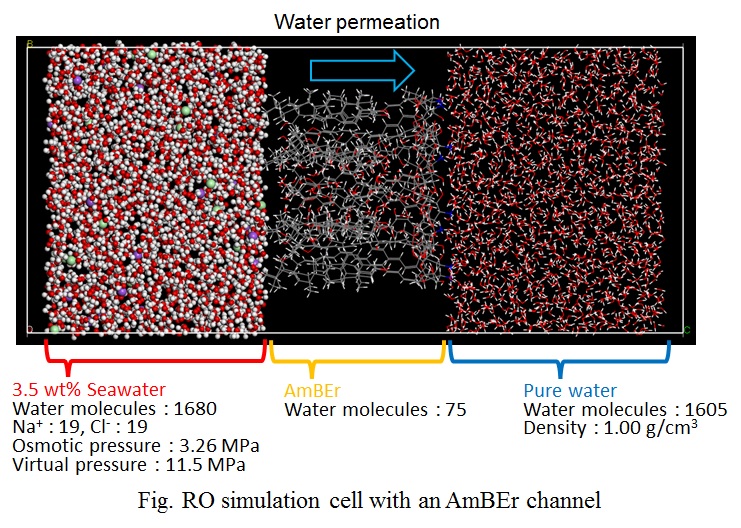
Nanofiltration has been applied to various separation systems, in particular, for the separation of aqueous or organic solvents. For a development of more efficient membrane process, better understanding of separation mechanism of solvent including multicomponent species is of fundamental. Molecular modeling becomes a powerful tool for prediction of membrane performance and design of membrane materials for particular separation systems. Our group has reported a novel simulation scheme of molecular dynamics for the permeation of feed solution through nano porous membranes. Molecular dynamics of multi component species in the feed, however, is still difficult to be simulated because a feed concentration of multicomponent such as ions cannot keep at a constant in our simulation techniques as well as other conventional non-equilibrium molecular dynamics scheme. In this paper, to model multicomponent solutions through nanofiltration or reverse osmosis membranes, we will present a novel molecular dynamics technique that can control the feed concentration including multicomponent species at constant. This simulation technique is completely new and first methodology that could model multicomponent solution systems in membrane separation from atomistic level, as long as our knowledge. We will report that this simulation technique works well and can produce the permeation of multicomponent feed solution. The flux and ions selectivity were calculated and compared to the theoretical values to examine the validity of our proposed scheme.
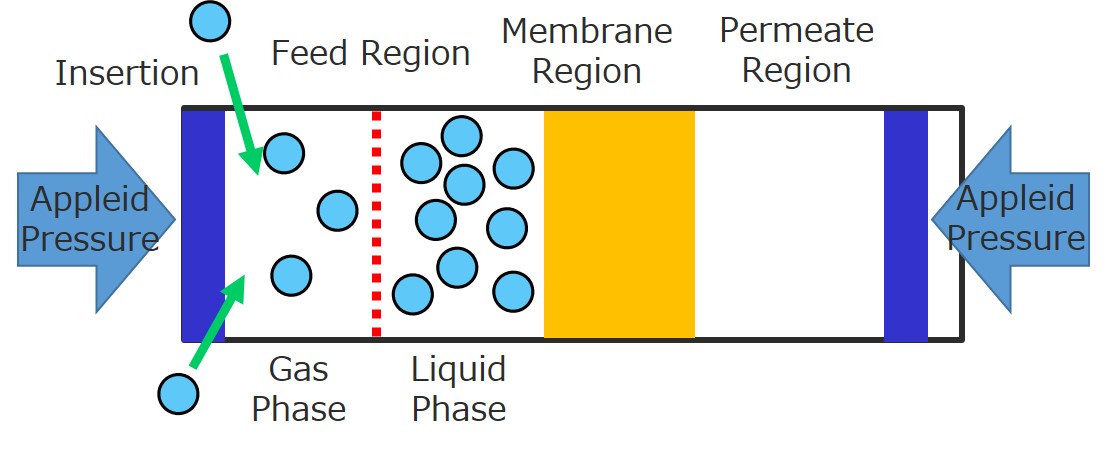
We have synthesized 80-cm-long mordenite membranes on mullite supports by secondary growth method. Mordenite has a moderate Si/Al ratio of 3–10 and regular pore size of 0.65 × 0.7 nm. These advantages allow mordenite membranes to be a potential candidate for separating water from acetic acid solutions with excellent acidic-resistant property and hydrophilicity. The enhancement of flux as well as high reproducibility is critical for industrial application of mordenite membranes. To improve the flux of membrane, we rapidly prepare mordenite membranes on macroporous mullite supports in a fluoride-containing precursor gel. The molar composition of synthesis solution is 1SiO2: 0.08Al2O3: 0.25Na2O: 0.2NaF: 40H2O. The hydrothermal treatment is carried out at 170 °C for 5 h. After synthesis, the as-synthesized membranes are characterized by XRD, SEM and pervaporation (PV) test. The surface SEM image of the membrane prepared under optimal conditions shows compact and highly intergrown zeolite layers composed with ellipsoidal polycrystalline grains. The membrane thickness is approximately 8 μm. High-flux mordenite membranes exhibit a long-term acid stability for a 90 wt% HAc/H2O mixture at 75 °C, the flux and separation factor ultimately keep stable at approximately 1.03 kg m-2 h-1 and 4500 for 10 d. Furthermore, mordenite membranes are successfully scaled-up from 10 cm to an industrial scale of 80 cm with transverse crystallization. These high performance 80-cm-long mordenite membranes with good roeprducibility show a promising industrial application for dehydration of water-acetic acid mixtures.
Two-dimensional (2D) nanosheet membranes are expected to function as size-selective molecular separation membranes, based on their unique atomic thickness with micrometer lateral dimensions. Stacked nanosheet membranes are formed by assembling single molecular sheets into thin membranes, and contain 2D nanochannels between the stacked sheets that allow water or solvents to pass through whilst rejecting unwanted solutes [1]. Therefore, they represent promising materials for potentially high-functional membranes for liquid separation such as water treatment and organic solvent filtration. The structural stability of nanosheet membranes during filtration is also a critical issue for their application.
In this study, we fabricated nanosheet membranes using single 2D nanosheets of niobium oxide (NbO) on a porous cellulose nitrate or anodic alumina support by a simple vacuum filtration. The thickness of NbO membranes were controlled by adjusting the volume of nanosheet colloidal solution used during the vacuum filtration. The stacked NbO nanosheet membranes had a dense structure and were highly stable during separation tests, because of the chemical cross-linking between nanosheets. The method allowed the formation of nanochannels in the NbO membranes. The NbO membranes showed high rejection performances against anionic dyes and salts in water [2,3]. Furthermore, membrane structure and separation performances in alcohols were also investigated. There was little difference in the interlayer spacing of the stacked structure between water and alcohols, suggesting the stable layered structure in alcohol solvents. The NbO membranes demonstrated relatively high rejection performances such as 85% rejection for Evans blue (EB, Mw: 960.8) in methanol. The channel structure and separation mechanism for NbO membranes in water and alcohols will be discussed.
[1] G. Liu, et al., Angew. Chem. Int. Ed.55, 2–16 (2016), [2] K. Nakagawa et al., Chem. Commun. 53, 7929-7932 (2017), [3] K. Nakagawa et al., Sep. Purif. Technol, 219, 222-229 (2019)
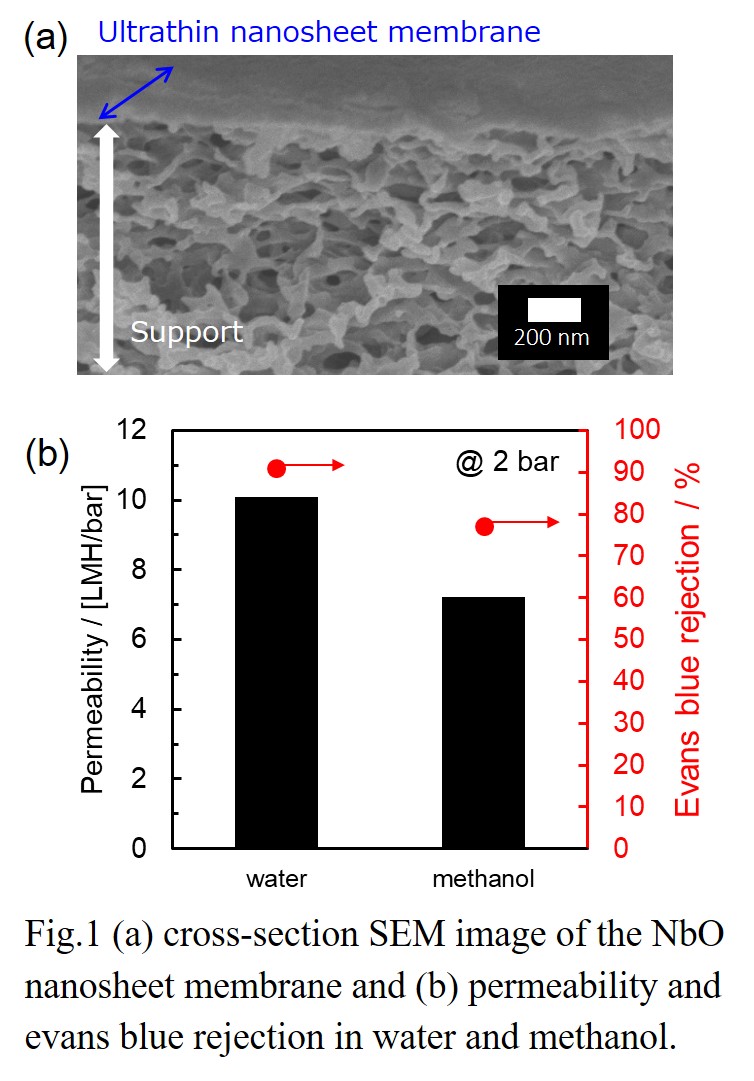
High purity propylene is an octane-enhancing chemical and also feedstock to industrially important chemicals. Purification of propylene from propane mixture is technologically and financially challenging because of their close boiling points. ZIF-8 membrane has the potential to separate propylene from propane effectively due to the gate opening effects, although the theoretical ZIF-8 aperture size (0.34 nm) is smaller than the kinetic diameters of propylene (0.4 nm) and propane (0.43 nm). In this work, defect free ZIF-8 membranes were successfully developed from the secondary growth seeding technique with sodium formate as deprotonating agent that facilitated continuous, well-intergrown ZIF-8 membrane on α-Al2O3 support. The defects formed by the crack formation in the membrane was steadily and effectively removed by the uniquely discovered self-healing property that the sodium formate extended. The ZIF-8 membranes demonstrated their excellent molecular sieve separation capability for equal molar propylene/propane mixture with the highest separation factor of 115 and average propylene permeance of 50.40×10-10 mol/m2 s Pa.
In this talk, I will report the development of novel omniphobic membranes and operation modes for various process applications with membrane contactors (MCs). An omniphobic membrane was fabricated for membrane distillation (MD) by effectively depositing ZnO nanoparticles on a hydrophilic glass fiber (GF) membrane to create hierarchical re-entrant structures, followed by surface fluorination and the addition of a polymer coating to lower the surface energy of the membrane. The omniphobic membranes possessed a particulate membrane morphology and an extremely high fluorine concentration on the surface. The omniphobicity of the fabricated membrane was indicated by the contact angles for water and ethanol, which were as high as 152.8±1.1 ° and 110.3±1.9 °, respectively. In particular, it will focus on the development of tuned hydrophobic, hydrophilic and asymmetric wettability membranes. Membrane contactors are membrane systems that can find application in different fields of industrial interest, covering, for example, gas-liquid operations, liquid-liquid extractions and vapor-liquid distillation. In past decade, the use of membrane absorption to capture carbon (membrane absorption, MA), to prepare emulsions (membrane emulsification, ME), to recover resources from sea (membrane crystallization, MCr) to carry out distillation processes for water scarcity issue (membrane distillation, MD) has been subject of many research activities worldwide. Focus of this talk will be placed on the applications of the developed novel aerogel membranes for MA and MD processes to resolve the carbon abundance and water scarcity issues, respectively, for achieving an ultimate goal toward a sustainable planet.
Silica membranes have been developing as hydrogen permselective membranes. A counter diffusion chemical vapor deposition (CVD) method is the preparation method for the silica membranes. One of the problems for the application of hydrogen permselective membranes is hydrothermal stability. In this study, effects of organic groups in the silica structure on hydrothermal stability was investigated.
γ-alumina (φ10 mm, L30 mm, Noritake Co..) was used for a porous substrate. γ-alumina layer or silica sol-gel layer was coated on the porous substrate. Aluminum sol 5S (Kawaken Fine Chem. Co) with polyvinylalcohol (PVA) was used for the coating of the γ-alumina layer. The parent sol of Tetraethoxysilane (TEOS):EtOH: H2O:HNO3=1:0.1:4:5 was employed for the silica coating. The coated substrates were calcined at 600 °C. CVD was carried out by using HTMOS (Hexyltrimethoxysilane) or TMOS (Tetramethoxysilane) as a silica source at 450 or 600 °C for 15 min. Single gas permeation tests were carried out by using H2 and SF6 at 270 °C.
The hydrothermal stability under steam was examined for the TMOS derived membrane deposited at 550 °C and for the HTMOS derived membrane deposited at 450 °C. The time courses of H2 permeance through the both membranes were shown the figure. The H2 permeance through the TMOS derived membrane decreased gradually, and the permeance was reduced by 37% under the steam treatment for 12h. On the other hand, the reduction rate of the H2 permeance through the HTMOS derived membrane on the silica coated substrates after 23h of the steam treatment was only 10%. In order to confirm the effects of coating of the substrates, the results through the membrane deposited on the coating of the γ-alumina layer were also shown as open plots in the same figure. The H2 permeance looks the similar indicating that there were little effects on the HTMOS derived membranes.
Membrane separation technology has been paid attention for one of the energy saving technologies. A silica membrane is categorized as one of the typical inorganic membranes, and the silica membranes show high hydrogen permselective performance comparing with the other inorganic membranes, such as zeolite and carbon membranes. On the other hand, it is generally known that permselective performance of silica membranes are affected strongly under hydrothermal conditions.
In this study, influence of steam on permeation performance of the DMDPS-derived silica membrane was evaluated to develop the silica membranes having relatively high hydrothermal durability. The silica membrane was prepared by counter-diffusion chemical vapor deposition method on a porous alumina support purchased from Nikkato co., Japan. After membrane preparation, permeation performance was measured using single component H2, N2 and SF6, respectively. Heat-treatment of the membrane was conducted at 573 K for 50 h. During heat-treatment, H2, N2 and SF6 permeances showed approximately constant value. To evaluate effect of heat-treatment, durability test was conducted under 0.1 ~ 1.0 mol% steam co-existed conditions at 573 K by using heat-treated and non-treated silica membranes. Comparing influence of steam on permeation performances of these membranes, permeance decreasing ratio of heat-treated membrane showed lower value than that of non-treated membrane in any steam concentrations. In addition, in-situ diffuse reflectance FT-IR spectra of heat-treated and non-treated silica powder was obtained. The heat-treated silica had less amount of adsorbed water molecules than the non-treated silica because the silanol group was decreased owing to heat treatment. From these results, it is considered that hydrothermal durability of the silica membrane is determined by the silanol group density.
In generally, permeation phenomenon in microporous membrane can be divided in three steps, adsorption, diffusion, and desorption. Though investigation of these factors in membrane is quite important to understand permeation mechanism, these factors are hardly evaluated in direct.
We previously reported non-destructive adsorption measurement for zeolite membrane.1 In this study, we estimated diffusion property of hydrocarbon in silicalite-1 membrane from gas permeation measurement.
Silicalite-1, pure silica zeolite with MFI-topology, membrane was synthesized by a seed-assisted crystallization method on an outer surface of porous tubular a-alumina support (Noritake, i.d. = 7 mm, o.d. = 10 mm, average pore size = 150 nm).
Diffusion and desorption behavior was evaluated as follows. At first, permeation flux of helium through silicalite-1 membrane was detected. After that hydrocarbon vapor were fed to a membrane with flowing helium. When micropore of zeolite membrane was saturated by adsorbed hydrocarbon, the helium flux drastically decreased. Finally, hydrocarbon feeding was stopped, and then micropore would open by desorption of hydrocarbon. Thus, we can estimate the diffusion and desorption behavior of hydrocarbon from the rate of helium flux increase by pore opening. In addition, diffusion coefficient of hydrocarbon in mocropore could be calculated by using Fick's second law.
(1) M. Seshimo, K. Matsumoto, M. Mastukata, Evaluation of micropore volume of zeolite membrane under non-destructive condition by nitrogen adsorption method, 16th International Conference of Inorganic Membrane, P2.11, July, 2016.
Acknowledgment
This work was partially supported by JST CREST (Japan Science and Technology agency, Create REvolutionary technological seeds for Science and Technology innovation program), Grant Number JPMJCR1324, Japan.
Zeolite membranes have unique properties such as molecular sieving and thermal stability. Therefore, the practical use of zeolite membranes for a purification process of natural gas has been investigated. Grain boundaries in inorganic membranes are known to degrade membrane performance, however, the detailed information of effect on selectivity still difficult to predict prior to the permeation test. Non-equilibrium molecular dynamics (NEMD) method is one of the theoretical prediction method of separation characteristics in inorganic membranes. The NEMD simulation is an atomistic-scale modeling, thus this can easily apply to the prediction of permeability and selectivity in multicomponent gas systems. The effect of trace components for membrane performance can be also investigated using NEMD.
In this study, we investigate the separation properties of CHA and MFI type zeolite membranes by NEMD for CO2/CH4 systems, and elucidate the mechanism of the effect of grain boundary on selectivity for ternary separation systems. Two different types of zeolite membranes having different pore sizes of MFI and CHA are considered to investigate the effect of pore size on selectivity. Two different models used in NEMD are shown in the figure. In the left side model in figure, grain boundary exists insides the zeolite crystal. In the right side model in figure, grain boundary runs lengthwise of zeolite crystal. In Generation region in the feed side gas molecules appear at every certain period. In Deletion region in the permeate side a permeated gas molecule is removed from the system. Our NEMD results indicates that the presence of grain boundary could increase the selectivity, which means that a control of grain boundary is a key factor to enhance the selectivity. In the conference, we will discuss the details of the effect of grain boundaries as well as pore size on this interesting phenomena regarding the selectivity.
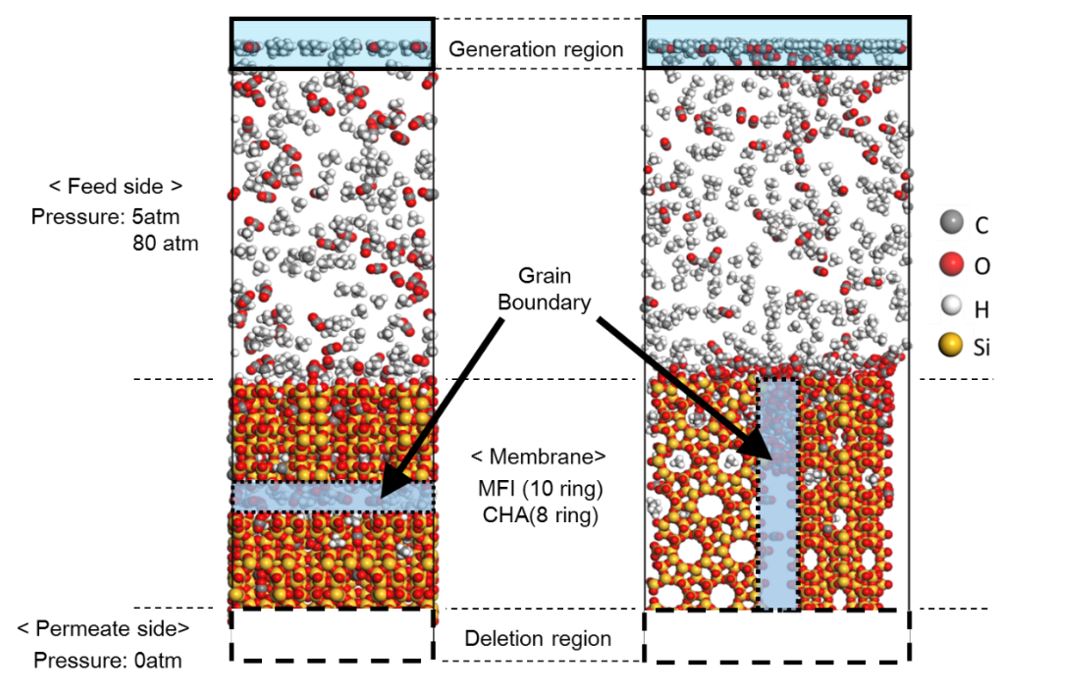
Palladium membranes made of pure palladium, palladium-silver, palladium-copper, etc. are promising in terms of high selectivity to hydrogen. Because palladium is limited in resources and costly, various attempts have been made to reduce necessary amount of palladium preparing not only membranes supported by porous materials but also foil-shaped thin self-supported membranes. Hoverer, self-supported membranes are difficult to seal with frames of modules because welding is not easy for thin foils. To utilize self-supported membranes in practice to process large amount of hydrogen, technology to compose modules is necessary.
In this study, therefore, membrane modules for self-supported palladium membranes have been developed. A prototype module had eight sheets of palladium-silver foils 0.02 mm thick and 30 mm × 60 mm wide including sealing area. The foil-shaped membranes and spacers were alternatively accumulated and combined by thermal diffusion. The combined structure was set inside a stainless-steel container and welded between one of the spacers and the container. The module had three ports for feed, permeate and retentate gases. The module size was 34 mm × 44 mm × 64 mm excluding three ports.
Hydrogen permeation performance of the module was investigated using 1-MPa pure hydrogen as a feed gas at 623 K. As a result, 6 L(at 293 K, 1 atm)/min hydrogen was obtained from the permeate port. Durability was proved at least for 467 hours. This kind of modules are expected to enlarge the applicability of palladium membranes.
Membrane gas separation have the potential to reduce energy consumption in chemical industry. Currently polymeric membranes are widely used. However, their applications are limited because of their low selectivity. Carbon molecular sieve (CMS) membranes have higher permselectivity than commercially available polymeric membranes and lower fabrication cost than silica and zeolite membranes. The CMS membrane are expected to expand the range of application of membrane gas separation. One of problems to be considered for application is the effect of impurity. In this study, we have investigated the effect of coexisting component on gas permeation and separation through CMS membranes. Mixed gas permeation experiments have been carried out for binary mixtures of hydrogen (H2)-nitrogen(N2) and tertiary mixtures of H2, N2 and water vapor. Two CMS membranes prepared from a polyimide have been used.
Permeance to H2 at a constant partial pressure did not change with increasing N2 partial pressure for both membranes. Permeance to N2 at a constant N2 partial pressure did not changed with increasing H2 partial pressure for one membrane. However, N2 permeance increased with increasing H2 pressure for another membrane. Consequently selectivity of H2 over N2 decreased with H2 partial pressure for the latter membrane.
Coexisting water vapor decreased both H2 and N2 permeance for both membranes. However, H2/N2 selectivity decreased for one membrane and it increased for another membrane. Water vapor had a complex effect on a H2/N2 mixed gas permeation for CMS membranes.
New class of tough gel membranes containing a large amount of ionic liquids (ILs) in an inorganic/organic double-network, termed inorganic/organic double network ion gel (DN ion gel) was fabricated. The inorganic/organic double-network could be easily synthesized in the same IL pot, which allowed the preparation of freely shapeable DN ion gel, including a film shape. The DN gels showed excellent mechanical strength (more than 25 MPa of compressive fracture stress) without any leakage of ILs under compression. From tensile stress loading/unloading test, it was confirmed that the excellent mechanical strength of the DN ion gel was owing to the inorganic network which acted as a sacrificial bond to dissipate the loaded energy and the organic network which played a role of hidden length to sustain large deformation.
The gas permeation under pressurized condition was examined by using the tough ion gel membrane containing more than 80 wt% of an IL. As expected, the ion gel film was not destroyed under high trans-membrane pressure differences up to 700 kPa. Regarding the CO2 separation performance, the CO2/N2 selectivity was almost same as that of the supported ionic liquid membranes. The DN ion gel membrane with optimized network composition and 80 wt% ionic liquid sustained about 1200 barrer of CO2 permeability and 25 of CO2/N2 selectivity for more than 300 h at 50 oC under humid condition. In addition, it was confirmed that the CO2 permeability as well as CO2/N2 selectivity of the ion gel membrane containing more than 90 wt% of an IL was almost same as that of the supported ionic liquid membrane. The superior gas permeability of the ion gel membranes stem from the fact that there is almost no diffusion resistance in the ion gel owing to its low polymer content.
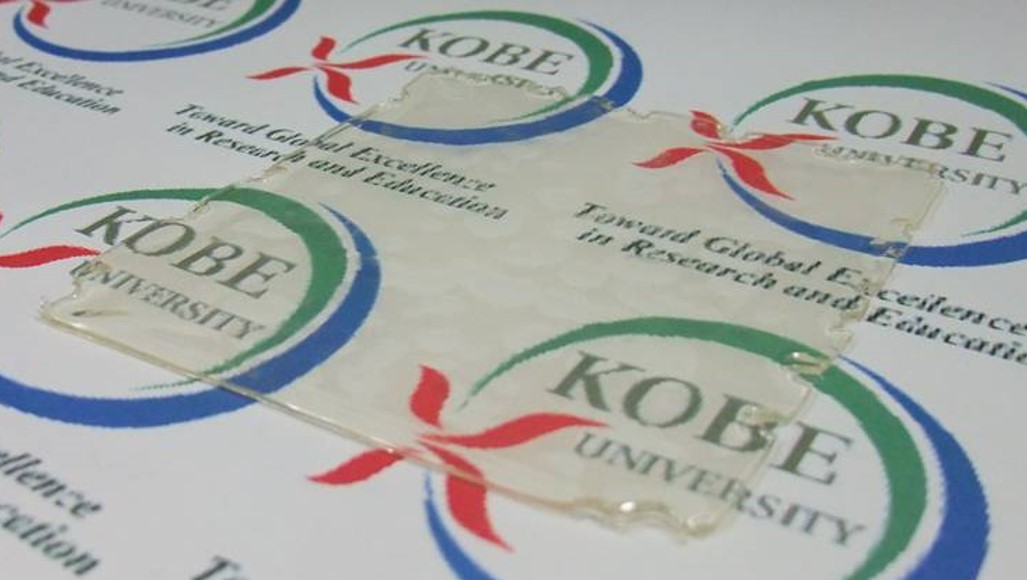
Membrane separation technology has been investigated and applied into purify natural gas, especially removing CO2 from CH4 to reduce the pipeline corrosion and increase heating value. Polymer membrane has easy processability, high reproducibility but reaches a limit in a trade-off between permeability and selectivity (Robeson upper bound line). Inorganic membrane owns excellent separation property and mechanical stability, while its high-cost membrane fabrication demands improvement. Blending inorganic particles into the polymer matrix to prepare mixed matrix membranes (MMMs) could be considered as an appropriate method due to it could combine both advantages of polymer membrane and inorganic membrane.
In this study, nanoporous SAPO-34 zeolite (~0.38 nm) and ZIF-8 particles (~0.42 nm) were severally added into polyimide (6FDA-TrMPD and 6FDA-mDAT) and polyethersulfone (PES) to prepare MMMs for CO2/CH4 separation. The filler, polymer and N-methyl pyrrolidone (solvent) were mixed to form a homogeneous solution with filler content in polymer about 0 wt.% ~ 40 wt.%. The solution was cast on a glass plate and the formed MMMs were peeled off after drying. The single gas permeation through the membranes was tested by vacuum method at 1 atm and 35 °C.
According to the figure, 6FDA-TrMPD/SAPO-34 MMMs (T-S-0~40) and 6FDA-TrMPD/ZIF-8 MMMs (T-Z-20~40) possessed the highest CO2 permeability. The 6FDA-mDAT/SAPO-34 MMMs (M-S-0~40) provided the best CO2/CH4 ideal selectivity. Addition of SAPO-34 could both increase the gas permeability and selectivity of PES/SAPO-34 MMMs (P-S-0~30) and 6FDA-mDAT MMMs. In term of 6FDA-TrMPD MMMs, all the SAPO-34 and ZIF-8 could only enhance the gas permeability at a slight loss of selectivity. Nevertheless, the separation performance of 6FDA-TrMPD MMMs containing 30%~40% SAPO-34 (T-S-30 and T-S-40) still exceeded the Robeson upper bound line (2008) of the polymer membrane, which was the same as the 6FDA-mDAT MMM with 40% SAPO-34 zeolite (M-S-40).
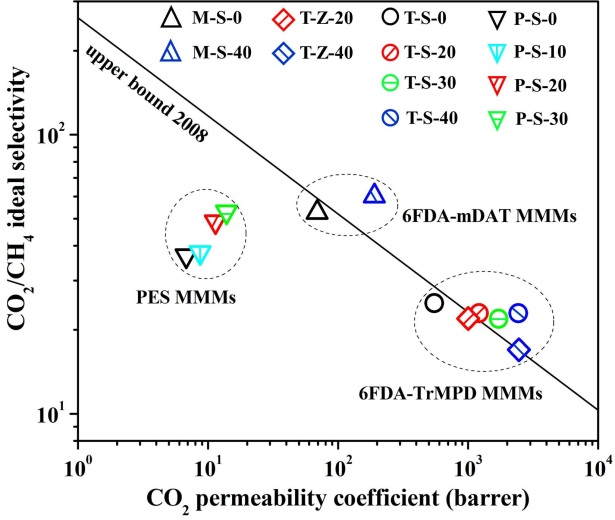
In recent years, microfiltration is used in wastewater and drinking water treatments, and food and pharmaceutical industries. In the process of using microorganisms, the feed solution is a complex mixture comprising bacterial flocks and microbial metabolite. Therefore, it is essential to clarify the mechanism of flux decline behaviors in microfiltration of microorganism and its metabolite. The key objective of this study is to examine the effect of polysaccharide-protein interaction on membrane fouling caused by microbial metabolite since the microbial metabolite is composed mainly of polysaccharides and proteins. Microfiltration experiments were performed in a dead-end filtration mode using various types of solutions at pH of 4.5 and 6.5 under constant pressure condition. Sodium alginate (SA) with the molecular weight (MW) of 129 kDa was used as model polysaccharide, and lysozyme with the MW of 14.3 kDa, the isoelectric point (pI) of 11.0 and bovine serum albumin (BSA) with the MW of 67 kDa, the pI of 5.1 were used as model protein in this study. The flux decline behaviors were observed in the case of mixture of polysaccharide and protein, and in particular, the filtration rate of solution containing SA and BSA was influenced by the solution pH. The BSA molecule is negatively charged at pH 6.5 and positively charged at pH 4.5, while at both pH values, the lysozyme molecule has a net positive charge, and SA molecule has a negative charge. It is obvious that the effect of the surface charge of protein on the filtration resistance should be considered.
Algal bio-fuel as alternative to fossil fuel has been attracting lots of attention due to the global warming and depleting natural fuel resources. However, the cost of bio-fuel production is relatively high. Especially, harvesting and dewatering of microalgae suspension are reported to account for 20 - 30 % of the total cost, because suspended solid (SS) concentration of microalgae culture is low with 0.02 - 0.06 wt%. Therefore, efficient dewatering process is required. This study examined the performance of dewatering of microalgae suspension by cake filtration using filter cloth.
Two hundred milliliter of microalgae suspension with 0.02 wt%-SS was filtered at constant pressure (70 kPa) using filter cloths (24.4 cm2 of effective area) made from polypropylene, which have different pore size 0.8 - 14 μm. Average permeate flux was increased from 5.9 to 2600 L/(m2 h) with the increase in pore size, while SS rejection was decreased from 94 to 53 %. The filtration behavior was analyzed by existing filtration models. As a result, when filter cloths with smaller pore size than algal cell size (about 8 μm) were used, filtration mode was finally settled into cake filtration. On the other hand, for the filtration using filter cloth with 14 μm of pore size, filtration mode was not settled into cake filtration. Then, in order to conduct cake filtration using filter cloth with 14 μm of pore size for expecting high permeate flux, pre-concentrated suspension (0.1 wt%-SS) was filtered with the intention of forming a cake layer quickly by the deposition of many algal cells on the filter surface. Consequently, microalgae suspension was successfully concentrated up to 18 wt%-SS with 360 L/(m2 h) of average permeate flux and 99 % of SS rejection. These results suggest the potential of microalgae dewatering by cake filtration with high flux and rejection.
Expression is the separation of liquid from a solid/liquid system by compression due to the movement of the retaining walls of the filter chamber. In the expression of slurry material, the application of mechanical pressure to the retaining walls causes a sudden increase of hydraulic pressure uniformly throughout the slurry. Initially, the process of expression proceeds based on the principle of filtration, where the thickness of filter cake increases over time. Filtration terminates when the whole slurry forms a layer of filter cake, and the consolidation of the cake follows. Exact identification of the time when the chamber is filled with the cake is essential for an effective expression operation. The electrokinetic response of expressed material provides us with some information on the status of the filter chamber. In this work, we have measured the time course of electric potential difference (EPD) between the retaining walls to elucidate the electrokinetic aspects of mechanical dewatering. The experimental apparatus used in this study consists essentially of a piston press with a cylinder and a piston. Filter media are placed at the cylinder bottom and the very end of the piston. EPD between the filter media was monitored during the experiment. As can be seen from the figure, the absolute value of EPD increases with the progress of the filtration period, followed by the decrease during the consolidation period. It was observed that the time when the absolute value of EPD began to decline coincides with the time when the filtration period ended. We have derived a theoretical equation of streaming potential for a flow path of the expressed material and combined it with filtration and consolidation theories to calculate the theoretical time course of EPD of expressed material. It has been found that EPD reflects liquid pressure variation throughout the solid/liquid mixture.
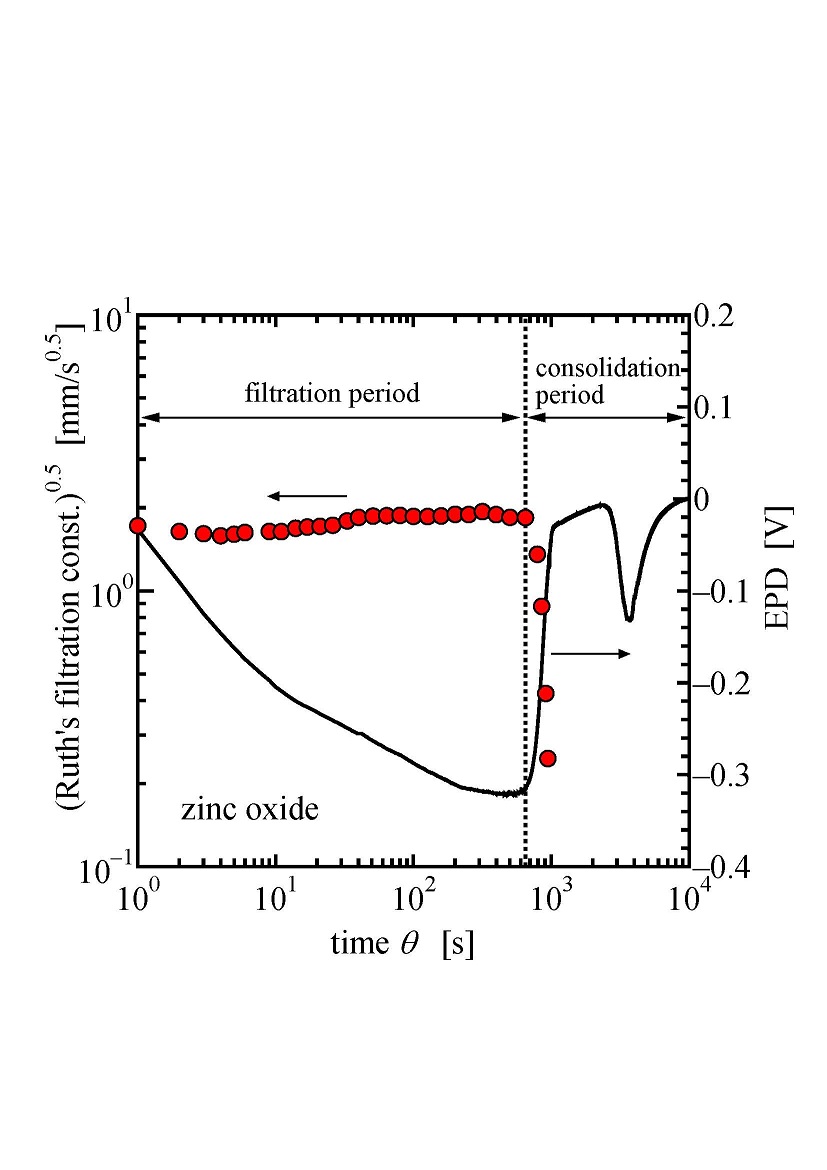
The application of membrane filtration processes has been increased because of global shortage of water. Membrane fouling is considered as a major factor limiting the use of the membrane filtration process and is the irreversible alternation in the membrane caused by specific physical and chemical interactions between membrane and various components present in the process stream. The fouling configuration can be classified into three simple mechanisms: pore narrowing by adsorption, pore blocking/plugging and cake/gel layer formation. In many actual processes the species causing the dominant fouling effects is not always known because of the complexity of the feed stream. Identifying the foulant and understanding fouling phenomena are required for adopting countermeasures for the fouling. Electrostatic and hydrophobic interactions are recognized as the major interactions causing fouling. The zeta potential of the foulant or the membrane, that is, the electrical potential at the surface of shear between the solid and the liquid, can be useful for the prediction of the electrostatic interaction. Adsorption is a major cause of membrane fouling in microfiltration of macromolecule containing solutions. The change ratio of zeta potential by protein adsorption is directly proportional to the surface coverage regardless of pH. In pore blocking or cake formation caused by fine particles the location of pressure drop in the system depends on the fouling configuration. The zeta potential reflected the local pressure drop part, where the gap between particle and pore in pore blocking filtration and the gap between particles in cake filtration. These observations shows the zeta potential will useful for monitoring the fouling configuration during the filtration operation.
Traditional pharmaceuticals have been made from chemical processes. Today, a significant fraction of valuable pharmaceuticals, such as hormones, insulin, growth factors, interferon, enzymes, drug intermediates, etc. are replaced by biotechnology processes. One of the building blocks is to make protein out of recombinant processes where extracellular or intracellular protein can be “engineered” and secreted from host biological cells which have been inserted with vectors carrying human genes. The host cells, e.g. the mammalian cells, bacteria and yeast can secret high amounts of recombinant protein in a bioreactor or fermenter. For extracellular protein, the first step in harvesting protein is to separate the protein from the cells. On the other hand for intracellular protein, the bacteria cells have to be lysed first before releasing the protein in form of inclusion body, for which separation follows. Disk stack and tubular centrifuges operating between 4,000–15,000 times gravity are popular choices to make separation of cells, cell debris, and proteins from the broth. We will discuss the various scenarios of centrifugal separation of protein in clarification, separation, classification and purification by washing during protein harvest. This is an extremely important step that affects yield and downstream processes, e.g., purification by chromatography. We will also discuss testing, modelling and prediction of protein separation in protein harvesting. Further, new technologies on separation of flocculated bio-solids and other popular biotech separation processes by centrifugation will also be discussed.

A deformable gel-packed chromatographic column was used to separate as-synthesized graphite oxide with different sizes. The synthesized gel (56 micrometer) was deformed by pressure of the fluid flow and the gaps in the gels showed a range of sizes. A suspension of graphene oxide (0.1 g/L, 10 mL) was injected, and graphene oxide in the elution had a size at 0.56 micrometer and 0.14 micrometer, whereas in half upper and bottom domain of the gel layer graphene oxide had a size at 33 micrometer and 2.9 micrometer, respectively, demonstrating that graphene oxide suspension was separated by size through gel layer. On behalf of graphene oxide, suspension of silica particle produced by dry process was also injected to the elastic gel -layer to separate silica particles due to their size and morphology.
To elute the filtered colloidal particle among the gel, the elastic gel layer was compacted and extended by the change of the applied pressure of water. At that time due to the dynamic change of the gel layer, the filtered particles was gradually eluted by the expansion of the gel's gaps as well as the convection of the fluid flow. The recovery percentage of the silica particles filtered was increased with increasing the repeated time of compaction and extension of the elastic gel layer.

The capture of solute into freezing part is difficult by the vigorous agitation of the freezing interface during the fast freezing of solution. We have been studying the applicability of ultrasonic irradiation (frequency: 20 kHz) to the agitating method, and found that the freeze concentration efficiency of solutes is improved greatly by this irradiation. In this paper, the effect of the frequency of ultrasonic irradiation on the freeze concentration characteristics for multiple solutes is examined.
Using three kind of solutions containing only one solute (Histidine, Vitamin C, and saccharose (these can widely be found in the food materials), 0.03 mol/L), we examined the freeze concentration characteristics with ultrasonic irradiation. The frequencies of ultrasonic irradiation were 20 kHz and 200 kHz, which were adjusted to the same output (11.8 W). From the experimental results, decreasing dissolved oxygen concentration (DO) can increase the concentration efficiency of all solutes in the case of 20 kHz ultrasonic frequency. On the other hand, in the case of 200 kHz ultrasonic frequency, increasing DO may increase the concentration efficiency. The DO dependence of the concentration efficiency differs depending on the frequency of ultrasonic irradiation and solute type.
Ultrasonic wave is applied in many situations, for example cleaning glasses, sensors, dispersion. In cleaning glasses, the frequency of ultrasonic is about 100 kHz. When the frequency of sonication increases to about 2 MHz and vibrates water, water becomes mist and flies away. This phenomenon is ultrasonic atomization. In this research, we applied this atomization to drying particles that is useful in chemical processes. This drying method is called ultrasonic drying.
It is expected that ultrasonic drying will be faster and consume less energy than drying by heat. We had three experiments to prove them. First was testing whether ultrasonic can dry wet particles. I tried to dry fly ash by ultrasonic and observed how humidity of fly ash changed. Next is measuring the rate of ultrasonic drying. We prepared three kinds of particles, alumina, silica and fly ash. I moreover prepared three different diameter of alumina and two different diameter of silica to see whether the rate of ultrasonic drying depends on the diameter of particles. Last is comparing efficiencies of ultrasonic drying and traditional drying. We measured the loss of weight of materials by drying and the consumption of electronic energy. Efficiency of drying, as shown in Fig. 1, is defined by the weight loss divided by the electric energy consumption.
The result of first experiment was that mist appeared from the surface of particles, so we were sure that ultrasonic can dry materials. Second experiment suggests that the rate of ultrasonic drying has positive dependence on diameter of particles. This experiment, however, cannot show difference in dying rate among different particles. Efficiency of ultrasonic drying gotten in last experiment is approximately 100 times better than one of drying by heat. Considering by those outcomes, ultrasonic drying will replace some current drying methods in a few decades.
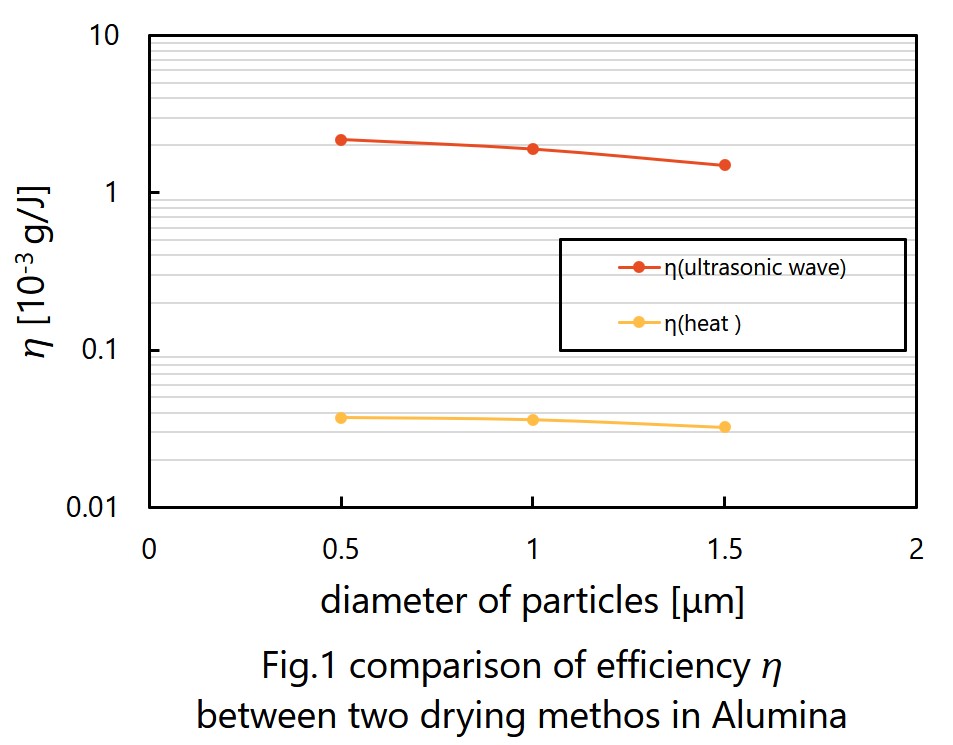
Consumer products largely originate from fossil resources which will be depleted sooner or later and contribute to CO2 emissions and climate change. Alternatives are sought with low carbon emissions and these are inexhaustible resources like plant derived biomass. Our motivation is to optimize the extraction process of lignin. The only water pre-treatment process and combination with organic solvent Soxhletation was carried out in the first stage to reduce impurities. Soda process and diluted acid process were chosen for extraction methods and microwave-assisted as the main instrument for heating up solution.
The results showed that pre-treatment process by using water following with isopropanol-hexane was given the best result. Water helped to extract sugar, alcohol, and some water soluble impurities. When isopropanol extracted the rest of polar impurities that water could not be done, Hexane was extracted non-polar impurities such as lipid. It could have extracted about 5.3 % weight loss of impurities without changed the lignin structure significantly due to TGA and FTIR results. This study aims to extract lignin in moderate temperature, pressure, and power in as little concentration and time as we could achieve. The process was done with soda process for 2 wt% NaOH concentration at 130 oC with 30-min extraction process as the best result rather than diluted acid process. The amount of lignin obtained about from this process was relatively higher both in 99.7% yield and 94.6% purity compared to other studies result. This type of lignin has similar characteristic to commercial dealkaline lignin.
This study aimed the treatment of the aqueous solution contaminated by antibiotics with duckweed, Lemna minor, which was reported to uptake organic compounds in the aqueous solution, and the removal of the antibiotics in the aqueous solution with duckweed under various conditions was measured to study the mechanism of antibiotics removal from contaminated solution. Firstly, it was confirmed that the molar concentrations of ciprofloxacin and sulfamethoxazole, which were selected as model antibiotics to be treated because of most popular antibiotics causing aquatic environmental pollution, could be reduced due to the mechanisms of hydrolysis, photo-degradation and uptake by duckweed. Ciprofloxacin was more degradable due to hydrolysis and photo-degradation in the aqueous solution than sulfamethoxazole, and the degrees of the molar concentration reduction due to uptake by duckweed were comparable for both antibiotics. In the cases of the treatment of ciprofloxacin of the initial molar concentration at 1×10-5mol/L, the reduction of the molar concentration due to the hydrolysis and photo-degradation shared 0.6 relative to the total reduction of the molar concentration, and the ratio of reduction due to uptake relative to the total reduction was 0.4. On the other hand, the molar concentration reduction of sulfamethoxazole due to the uptake relative to the total concentration reduction was 0.95, and the contribution of the hydrolysis and photo-degradation to the total reduction of ciprofloxacin concentration was so small. When the initial molar concentrations of both antibiotics increased up to 5×10-5mol/L, the contributions of these three factors to the antibiotics reduction were similar to the cases with the initial concentration as 1×10-5mol/L. Accordingly the uptakes of both antibiotics by duckweed were so influential to reduce the molar concentrations in the aqueous solution, especially for sulfamethoxazole, and this treatment method might have a potential to remediate the aquatic environment polluted by antibiotics.
The response surface methodology was applied to study and to optimize the surfactant-enhanced extraction of tea tree oil (TTO), i.e. the essential oil of Melaleuca alternifolia, by hydrodistillation method. Both Tween 20 and Tween 80 were used as surfactants added in the hydrodistillation vat with an aim to enhance the extraction yield of TTO. In principle, this study evaluated the relevance of several independent parameters, including the concentration of surfactant, extraction time, and liquid/solid ratio, against TTO yield with a design of experiment (DOE) based on response surface methodology. Central composite design (CCD) was used to optimize the processing condition of TTO extraction. The chemical compositions of tea tree oil were analyzed and quantized by GC-FID and were referred with the international standard "ISO 4730". Additionally, TTO obtained from optimal condition was examined on the stability of its microemulsion formulations as well as the antibacterial property, compared with the commercial TTO. The microemulsion stability was mainly determined by the particle size measurement with dynamic light scattering (DLS), whereas the antibacterial assay was carried out by agar disk diffusion method with Escherichia coli and Staphylococus aureus.
Keywords: Melaleuca alternifolia; Extraction; Design of experiment (DOE); Optimization
Solvent extraction (SX) is generally used for separation and purification of platinum group metal (PGM) in hydrometallurgical processes. The development of a successful SX process depends on the choice of appropriate extractants. Therefore, we have been studying the extraction behavior of PGM with newly synthesized extractants in addition to the structural properties of PGM complex anions extracted in the organic phase.
We have developed a new palladium extractant, thiodiglycolamide (TDGA), which can rapidly extract Pd(II) from HCl solution with a good selectivity and has a high oxidation resistance, compared with an industrial palladium extractant, di-n-hexyl sulfide (DHS). Currently, TDGA has been commercially available and already put to practical use in a PGM separation plant.
To date, there have been no effective practical extractants for rhodium in acidic chloride media, because the dominant rhodium species in relatively concentrated HCl solutions ([RhClx(H2O)6–x]3–x (x ≥ 4)) are poorly extracted into an organic phase. We have found that amide-containing tertiary amine (ACTA) compounds show a higher efficiency for the Rh(III) extraction from HCl solution than the conventional tertiary amine extractant, tri-n-octyl amine. The protonated ACTA molecules extract the mono-aquated dianion [RhCl5(H2O)]2– through the formation of an outer-sphere assembly, which was characterized by slope analysis, FT-IR, EXAFS, SANS, computational modeling, etc.
Prices of strategic metals and rare earth elements (REEs) have been rising over the past decade due to the global shortages in supply and increasing demands. These metals are essential components of advanced and emerging technologies associated with transport, environment, energy, defense, electronics, information and aerospace. With the utility of REEs projected to increase in the next decade, it is important to find alternative sources to conventional mining to cope with the demand. There are a few studies conducted on the potential of coal fly ashes as secondary resource of REE. Coal fly ash are waste products from coal burning in a coal power generation plants.
This research is aimed at extracting rare earth elements from coal fly ash by hydrochloric acid leaching. The purpose of this study is to explore the amenability of coal fly ash to metallurgical processing for the extraction of rare earth elements. Three process parameters were investigated in this study, namely, hydrochloric acid concentration, leaching time, and the leaching method. Results of the experiment showed that the recovery of rare earth elements increased with increasing hydrochloric acid concentration. Direct leaching method achieved higher recovery values for REEs compared to sequential leaching. Maximum recovery value for REEs was obtained at 1 h leaching time.
Scandium (Sc) is rare and expensive metal in high demand, providing excellent characteristics for various industrial applications. Since Sc is commonly found in crustal together with Y owing to its small ionic radius, the separation of Sc from yttrium (Y) and other rare earths is required. In the present work, separation and recovery of Sc in an aqueous chloride media was investigated by solvent extraction with carboxylic acid, Versatic acid 10.
The aqueous chloride solutions of rare earths were prepared by dissolving their oxides in 1 or 2 mol/L HCl solution. Organic solution was prepared by diluting Versatic acid 10 in IP Solvent 2835. Extraction of Sc and Y was carried out by shaking the organic and aqueous solutions at volume ratio of 1 : 1 at 25oC for more than 6 h. Concentrations of the metals in the aqueous solutions were determined by ICP-AES and those in the organic solutions were calculated based on material balance.
Figure 1 shows the effect of pH on the extraction yields of Sc and Y from the binary solution. Extraction of Sc proceeds from pH 3, and is increased with pH, while the extraction of Y proceeds from pH 4.5. Separation of Sc and Y is therefore easily achieved with Versatic acid 10. The conventional slope analysis of Sc with Versatic acid 10 revealed that the extraction is based on the cation exchange mechanism and the stoichiometry of Sc and the dimeric extractant of Versatic Acid 10 was 1 : 3.
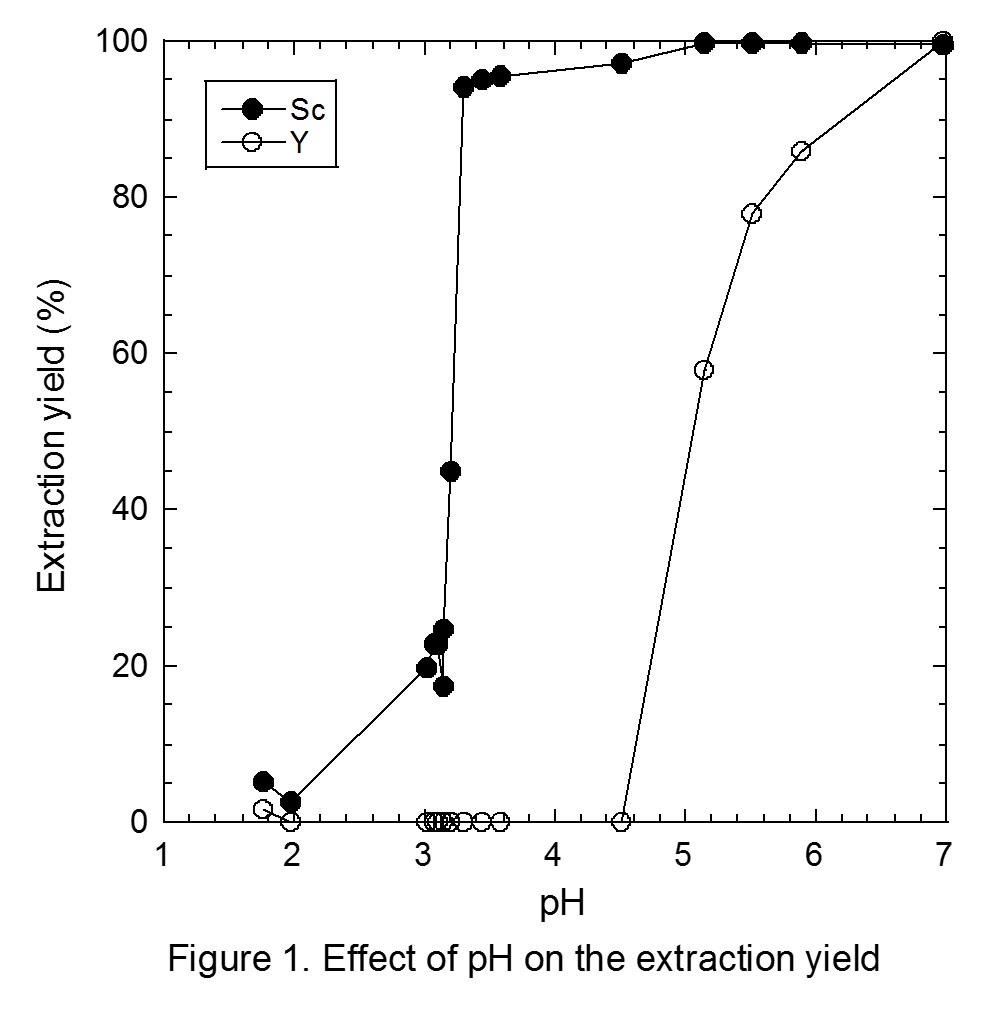
Two derivatives of p-t-octylcalix[4]arene were prepared to investigate extraction behavior of alkali metal ions. Tripropyl-monoacetic acid derivative (1) exhibited lithium selectivity among alkali metal ions, while Triacetic acid-monopropyl one (2) showed sodium selectivity. Then, they were employed for individual and stepwise recovery of alkali metal ions using microreactor system. Finally, they were employed for Li recovery from the seawater. Compound 1 was applied for Li recovery to concentrate Li ion at the 1st step and to strip the loaded metal ions, and compound 2 was employed to remove sodium ion for Li purification. Lithium ion was successfully completely recovered form seawater with two derivatives using microreactor system. Flow sheet for Li recovery with two derivatives using microreactor system is shown in Figure.
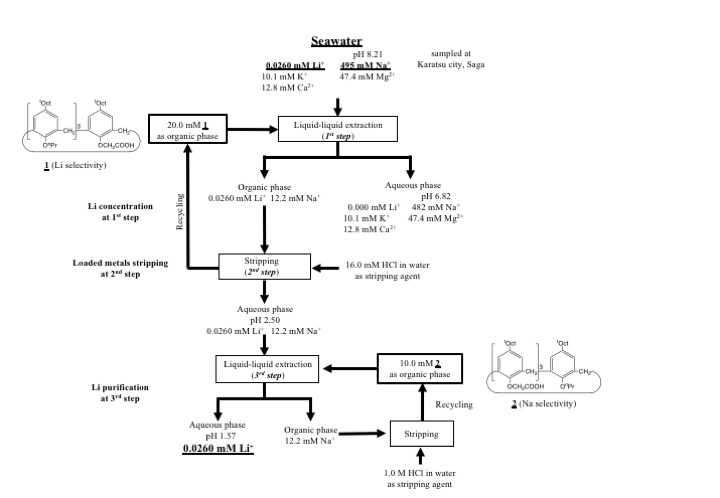
The polymer inclusion membranes (PIMs) composed by polymer and carrier without plasticizer have been used in this study. The extractant used in this study is containing in long alkyl chains and double bond. The great benefits of PIMs are to be used a small amount of extractant and less organic solvent and also are less leak of the extractant out of the membranes.
In the near future, it is expected that a large amount of wastes of used solar panels containing In(III), Ga(III) and Zn(II) is discharged. In this research, we were interested in alkyl-derivatives of sarcosine as an extractant to selectively separate In(III) and Ga(III) from Zn(II). Accordingly, a comparison of the metals(In(III), Ga(III) and Zn(II)) extraction was performed using four kind of extractants (two types of carboxylic acid and two types of sarcosine) and three polymers. Among them, We found the membrane containing poly(vinylidenefluoride-cohexafluoropropylene) (PVDF-HFP) as a polymer skeleton and N-oleoylsarcosine as a carrier. This membrane exhibited highly selective to In(III) and Ga(III) in hydrochloric acid solution. Finally we found that the PIM containing N-oleoyl sarcosine could perform the selectively separate In(III) and Ga(III) from Zn(II) from hydrochloric acid. In addition, we succeed in containing 60 % w/w N-oleoylsarcosine in the membrane.
We successfully developed a novel nanofiltration membrane that enables the separation of Mg2+ and Ca2+ from effluents in the electrodialysis process in salt productions. For that purpose, we first fabricated the polyamide layers using piperazine and trimesoyl chloride onto microfiltration membranes as supports, and then immobilized poly(2-methacryloyloxyethyl)trimethylaminium chloride) (polyMTMA) covalently on the surfaces and the pore walls of the polyamide layers by the plasma graft polymerization method. The polyMTMA grafted on the substrates made the membranes surface positively-charged, and at the same time reduced the pore sizes. Throughout the systematic nanofiltration experiments using various single salts with concentrations of 1.9 x 103 ppm, a membrane with a grafting amount of 0.24 mg cm-2 showed the following rejection performances that positively-charged nanofiltration membranes typically exhibit; the observed rejections (Robs) for NaCl, CaCl2, MgCl2, Na2SO4, CaSO4, MgSO4 were 0.20, 0.64, 0.65, 0.21, 0.35, 0.44, respectively. We also carried out Mg2+ separation tests from Na+-rich solutions by using aqueous solutions containing NaCl and MgCl2 with the ratios of 9:1, 14:1, and 19:1 as feed. The results indicated that around half of Mg2+ ions were retained with the permeation of more than 80% of Na+ ions.
Acknowledgement: Part of this study was financially supported by a grant from the Salt Science Research Foundation, Japan.
Oil/water separation has attracted more attention in both of academia and industry due to the increased amount of oily wastewater from the industrial process and frequent oil spill accidents, causing fatal damage to ecosystem and people's health. How to treat the oily wastewater has become a big challenge all over the world. In this work, an innovative aliphatic polyketone (PK) membrane surrounded by hydrophilic silica nanoparticles with hierarchical micro/nanoscale structure was developed by a APTES-assistance deposition process. With the APTES help to make the PK membrane positive charged, the negative charged silica was uniformed deposited on the membrane surface. The resultant silica-d-PK membrane displays superhydrophilicity, ultralow oil-adhesion underwater superoleophobicity, and distinctive self-cleaning ability, as well as excellent solvent resistance. More important, the membrane shows ultrafast and anti-oil-fouling separation performances for different oil-in-water emulsions. Therefore, it is very promising for large-scale applications.
Fouling problem caused by oil and other pollutants is one of the most severe challenges for membranes used for the purification of comprehensive oil-in-water emulsions. Poly(tetraflouride-r-vinylpyrrolidone) (F-VP) with low-adhesive superleophobicity is a class of novel material for fouling-repellent membrane modification to achieve highly-efficient separation of complex oily wastewater. In this work, the construction an ultrathin F-VP layer with a controllable thickness of 2 μm supported by polyvinylidene difluoride (PVDF) substrate was achieved, via an extremely simple, scalable and one-step surface modification process. Benefiting from the ultrathin fouling-resistant skin layer, the resultant F-VP/PVDF membrane exhibited a superior comprehensive fouling-resistant and fouling releasing property, while maintained a highly mass-transfer efficiency without significant flux sacrificing. The intrinsically non-fouling nature of F-VP modification layer endowed the F-VP/PVDF membrane with superoleophobic property to various oils, superhydrophilic/under oil superhydrophilic properties, and excellent antifouling property for comprehensive oil-in-water emulsions. It is capable of efficiently separating the oil-in-water emulsions with a high water permeability of 4612 L m-1 h-1 bar-1, high emulsion permeability (10000 ppm soybean oil-in-water emulsion) of 461 L m-1 h-1 bar-1 with high rejection ratio of >99.9%, and an outstanding stable fouling-resistant and fouling-releasing property of ~93% flux recovery, over 5-time continuous cyclic tests. Overall, this work provides an insight into a facile preparation of advanced composite membrane with ultralow fouling-propensity property, which shows a great potential in treating practically challenging emulsified wastewater.
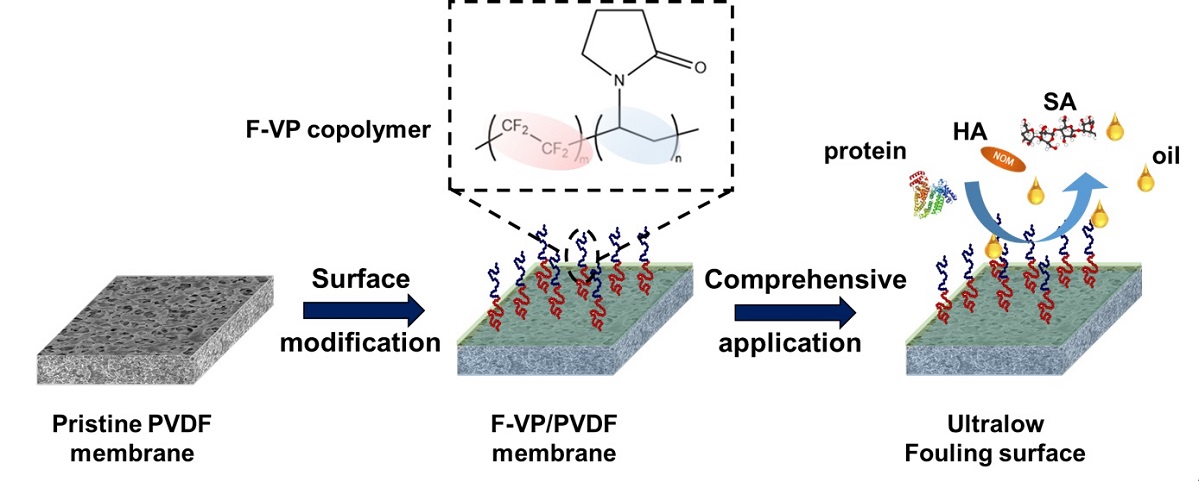
Membrane bioreactor (MBR) technology has many advantages from the views of high product water quality, small footprint and high possibility of treated water reuse. The critical challenges of MBR are membrane fouling and high energy consumption. Membrane air scouring is the main cause of high energy consumption in MBR. In fact, overall energy consumption can be reduced by operating at high flux or low air flow, on the other hand, serious membrane fouling will occur under high suction pressure. We investigated the fouling mechanism and main foulant type in high flux operation (42 LMH) comparing with low flux (25 LMH). The total amount of protein and polysaccharide clogged in the membrane at high flux operation was 2 times higher than that at low flux operation. Those clogging foulants in membrane pores were considered to be responsible for serious fouling at high flux operation. In order to mitigate those foulants, low concentration chemical cleaning, so-called maintenance cleaning (MC) was applied.
Additionally, we focused scouring efficiency to remove foulant from the membrane at low air flow operation. In order to increase scouring efficiency, new MBR structure that has 3 times higher scouring efficiency than the current MBR structure was developed. Scouring efficiency was improved by increase of the probability of contact of air and membrane in the new MBR.
A verification test using new membrane module at high flux and low air flow was conducted for a month with periodic MC every 3-7 days (Figure). The base membrane TMP (Trans Membrane Pressure) increasing rate was maintained at less than 0.05 kPa/d. The aeration energy consumption per product water was reduced 80% in high flux and low air flow operation.
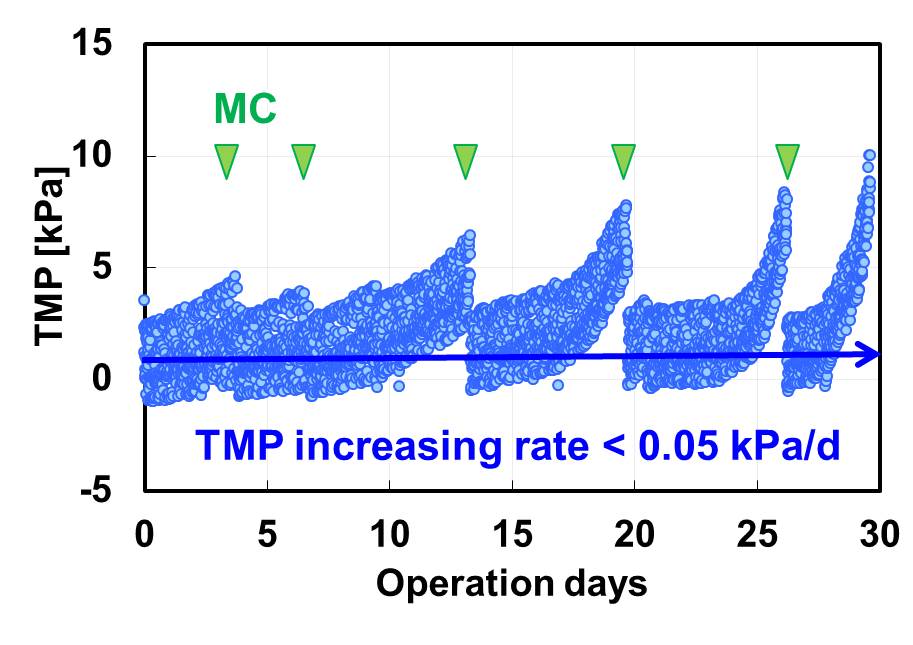
Aromatics have numerous applications in the chemical and petrochemical industries (Odedairo and Al-Khattaf 2011). Transalkylation which includes transfer of alkyl group from one molecule to another is one of the prominent catalytic processes for the conversion of aromatics, especially for the production of industrially important products like xylenes, ethylbenzene, cumene, and cymene (Brown and Nelson 1953). The products of transalkylation reactions have commercial importance as they are derived from low-valued by-products like diethyl or diisopropyl benzenes, toluene, and benzene. An attempt was made to transalkylate low-valued toluene to industrially important product of great commercial value. A series of zeolite (LaB, CeB, and PrB) containing rare earth metals lanthanum (La), cerium (Ce), and praseodymium (Pr) were used for transalkylation reaction. The modified beta zeolites were characterized by EDS, XRD, BET, FTIR, and TPD. The effect of various process parameters like metal loading (2–10 wt%), catalyst loading (1.44–8.63 w/w%), temperature (448–573 K),reactant ratio 1–15, and space time (3.2–9.29 kg h/kmol)on the conversion of reactant and selectivity of product was studied. Catalytic performance of praseodymium-modified beta zeolite shows highest cumene conversion (86.4 wt%)and cymene selectivity (65.7 wt%) compared to other zeolites. The maximum cumene conversion and cymene selectivity were obtained at 523 K, toluene-to-cumene ratio of 9:1, and a space time of 9.29 kg h/kmol. Kinetic modelling of the reaction was done to estimate the reaction kinetic constants and adsorption constants. The activation energy of the transalkylation was found to be 61.44 kJ/mol.
The objective of our research was to investigate the impact of dye-dye interaction on the separation performance of dual dye systems through an ultrafiltration (UF) membrane. Four representative charged dyes were chosen for single experiments, including rhodamine B (RhB) - a zwitterionic dye, methylene blue (MB) - a cationic dye, and eriochrome black T (EBT) and naphthol blue black (NBB) - anionic dyes. Four binary dye mixtures (RhB-MB, RhB-NBB, EBT-NBB and MB-NBB) were then studied in mixture experiments. A microporous poly(vinylidene fluoride) (PVDF) UF membrane was prepared via phase inversion method for the dye separation. The Donnan exclusion effect was proven as the predominant dye removal mechanism. The PVDF membrane surface was negatively charged in almost all experimental dye solutions (pH > 4.5). Therefore, zwitterionic RhB had nearly no rejection (1.1%), cationic MB exhibited low rejection (45.6%), whereas anionic EBT and NBB achieved high removal rates (83.5% and 89.1%, respectively). In dye mixtures, the mixed zwitterionic or same-charged dye solutions (RhB-MB, RhB-NBB and EBT-NBB) showed rejection efficiencies similar to their components' single dye solutions and filtrate permeance values in the range of the constituents' single dye solutions. On the contrary, in the case of the mixed opposite-charged dye solution (MB-NBB), intermolecular interaction induced the formation of micron-scale dye aggregates which provided stronger negative surface charge and were readily repulsed by the membrane. Hence, the MB-NBB mixture attained almost complete dye removal (98.0%) along with an enhanced permeation rate (111.1 L m-2 h-1 MPa-1). The excellent performance stability for all the dye feeds was demonstrated during three-cycle filtration tests. The separation mechanism proposed in this work can be applied to real dye wastewater systems of multi-components. The filtration performance may be predicted once the molecular interactions are known, and the surface zeta potentials of the solutes and membrane are identified.
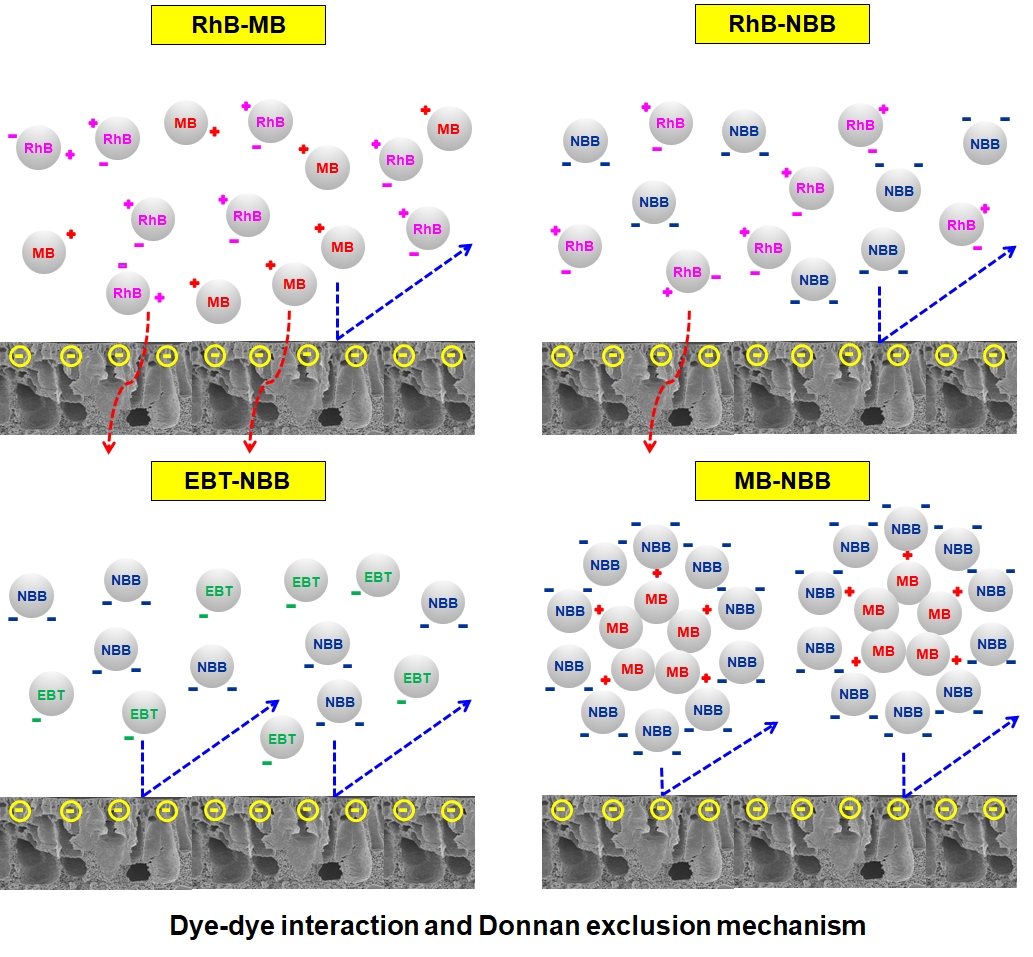
In this work, we demonstrated for the first time that by extruding solvents at the outermost layers of the extruded polymer solutions in the thermally induced liquid-liquid phase separation by using a triple orifice spinneret, both the surface and sub-layer structures of hollow fiber membranes were effectively tailored. Hence, four essential characteristics of the membranes, permeability, rejection, permeation stability and mechanical strength were balanced here simultaneously.
The ternary interactions among the extruded solvents, diluent and polymer played a substantial role in tailoring the surface pore size and permeation stability of TIPS-prepared membranes. At the interfaces between extruded solvents and polymer solutions, apart from the segregations of diluent or polymer that control the surface pores size, composite-like structure (spherules connected by the bicontinuous network) at the sub-layer substantially affected the membrane permeation stability. Regarding the importance of the ternary interaction in tailoring the surface pore size and the permeation stability of the prepared membrane in TIPS process, turn on a spotlight for selecting appropriate extruded solvents to obtain hollow fiber membranes with high water permeability, permeation stability, controlled pore size, and satisfying mechanical strength.

Jatiluhur dam is one of the biggest dams in Indonesia which serves water for various activities of millions of West Java population such as for fisheries, agricultures, recreations and also as a source of clean water and drinking water. The water comes from Citarum River which passing through different areas thus dissolves various impurities during their travel along the river body. One of the impurities that usually occur in surface water is natural organic matter (NOM) that extracted either from the soil or decaying of plants or animals contacted with the water body. NOM may harmful to human since during water treatment it will produce DBPs (Disinfection by Products) which are carcinogenic compounds.
This study is aimed to investigate the characteristics of NOM at Jatiluhur dam water and their removal efficiency using membrane. The water was obtained at 0.2 and 5 m depth and taken at two different seasons; rainy and dry season. Meanwhile, one commercial ultrafiltration membrane and two commercial nanofiltration membranes were investigated at various pressure and pH for NOM removal. The research found that the characteristics of NOM found on Jatiluhur dam were dominated by hydrophobic compounds either at rainy or dry season. The best permeability was obtained by using ultrafiltration membrane at pH 6 and 6 bar operated pressure. Whilst, higher rejection is obtained by nanofiltration membrane by around 73% of the NOM was rejected at pH 6 and 4 bar operated pressure.
Keywords: Membrane, NOM, Jatiluhur Dam, Drinking Water, Hydrophobicity
Energy conservation of distillation processes is still an important issue in process industries. Though the heat pump has been said to be a promising tool for energy saving, it has not been applied to many processes. One of the drawbacks that obstructs the installation is the high equipment cost of the custom-ordered compressor. In this paper, we propose to introduce a general-purpose heat pump system (G-HP) to the distillation processes. G-HP is superior to a custom-ordered heat pump in the cost and the maintainability, that is very important feature for the long term operation.
The G-HP proposed in this research uses water as the working fluid in the heat pump. The coefficient of performance (COP) decreases with the increase of the temperature difference between the heat source and the heat sink. Thus, it is preferable to select the heating and cooling stages that has small temperature difference. On the other hand, the efficiency of distillation is highest when the heat is supplied to the reboiler (highest temperature position) and removed from at the condenser (lowest temperature position). It means that the proper selection of the heating and cooling places is important.
In this study, by taking the simplicity of the process structure into account, the vapor to the condenser is selected as the heat source. The required compress ratio depends on the selection of the heat supply stage and affects COP. We executed the simulations of the cases having various VLE curves and product specifications, and derived the best location of the heating stage and the condition suitable for the introduction of G-HP. The effectiveness of the structures having double heat pumps that supplies heat to the middle of the column and the reboiler, and those having double feed streams is also discussed.
Since methanol is an attractive fuel and chemical for various applications, its demand will continue to increase in energy year. Most methanol is currently produced from fuel such as natural gas through steam reforming. A methanol–water mixture is produced from the carbon monoxide or carbon dioxide and hydrogen in the presence of a catalyst and distilled to acquire pure methanol.
Self-heat recuperation was recently developed as an energy-saving process design, in which overall-process internal energy caused by condition changes is recirculated within the process without the need for heat addition, leading to a reduction in the energy requirements of several chemical processes.
In this study, the feasibility of applying self-heat recuperation technology to the industrial methanol synthesis process which possesses both temperature and pressure changes, a reactor and separators was investigated from energy-saving and process design points of view, based on actual plant data. Based on simulation results, it was concluded that the use of self-heat recuperation technology is an attractive alternative for sustainable future development of the methanol synthesis process.
Mass transfer was both experimentally and theoretically investigated based on shell model for a packed distillation column equipped with wire-mesh structured packing. The experimental column consists of three packed beds stacked in series and total bed height is 5,320 mm. In order to observe local variation of HETP, thermocouples were embedded at an equal interval on the column centerline. Each thermocouple can be considered to measure the temperature of internal reflux liquid owing to its large heat capacity. Distillation test was conducted at normal pressure under total reflux condition with three kinds of binary systems. Local variation of HETP in each bed region was determined by comparing the observed temperatures with the calculated ones due to the process simulator package. After obtaining the corresponding overall HTU from the experimentally obtained HETP, the vapor-phase and liquid-phase film coefficients were calculated by solving a simultaneous equation deduced between two vertical locations. However since the stripping factor remains almost unchanged in the top and bottom regions, it was considerably difficult to obtain an appropriate simultaneous equation without approximation. On the other hand, it has been found that those film resistances can be easily determined by assuming that the tie-line and VLE equilibrium curve should have an orthogonal relation at an arbitrary theoretical stage.
As a result, this orthogonal model successfully gave comprehensive correlation of vapor-phase and liquid-phase HTUs with the corresponding F-factor and superficial liquid load.
Although this investigation is still in the process of analysis, the orthogonal model has a possibility to lead to further progress in distillation mass transfer from a view point of transport science.
The development of the industrial systems for the year 2050 has been well defined in the recent Research Agenda with many strategic sectors, such as water, energy, food, health, etc. The drive towards greater sustainability has prompted process industries to search for opportunities to decrease their production costs, energy consumption, equipment size, and environment impact as well as improve the raw material yields, remote control, and process flexibility. Distillation process as a dominant player among all separation technologies are typically energy and cost intensive. One of the major challenges in distillation process industry is thus to improve the energy efficiency of existing and/or new processes through economic and ecological strategies. Integration, intensification and hybrid approach of distillation have become the main trend to achieve green and sustainable chemical process. Process integration and intensification is defined as a set of innovative principles applied to the design of processes and equipment to satisfy those concerns about energy and ecology impact of the process. The energy efficiency of a distillation process could be maximum by optimizing the design and operational parameters. However, as distillation processes become more complex in structure and operation through integration, intensification and hybrid, to find their optimal design and operation conditions drawing out its full potential is also becoming more challenging. This presentation will review briefly applications and trend of integration, intensification, and hybrid of distillation processes with their optimization. The potential and reliability of these technologies are addressed briefly, which will enable distillation process to achieve higher efficiency and high capacity. The recent developments in current research are summarized to highlight the importance as well as the effects, challenges, and future prospects of distillation process integration, intensification, and hybridization.
Orthogonal model of interphase mass transfer in a packed column distillation process
Kunio Kataoka, Goro Nishimura, Hideo Noda and Hiroshi Yamaji
Kansai Chemical Engineering Co., Ltd
2-9-7 Minami-nanamatsu-cho, Amagasaki, Hyogo 660-0053., Japan
Mass transfer model was investigated for a distillation column which consisted of three packed beds of wire-mesh structured packing stacked in series. Thirteen thermocouples for local liquid temperature observation were embedded at an equal interval on the centerline of the packed beds. The distillation experiment was conducted with a binary solution of methanol and ethanol under total-reflux conditions. The F-factor was varied as the control parameter by changing the heat duty of the reboiler. The shell balance model was based on a cylindrical control volume having a local HETP as the shell height. The process simulation analysis was done by using a simulator package in the same condition as the experiment. Local variation of HETP, HTU, and volumetric overall mass transfer coefficient were analyzed by comparing the experimental data with the process simulation results,
In order to analyze interphase mass transfer based on the two-film theory, an orthogonal relation between the tie-line and the vapor-liquid equilibrium curve was assumed, so that the vapor and liquid compositions can be evaluated at the vapor-liquid contacting interface. This orthogonal assumption definitely determined vapor-phase and liquid-phase volumetric film coefficients of mass transfer. By means of dimensional analysis, the vapor-phase and liquid-phase mass transfer coefficients defined in the form of j-factor data were well correlated with the corresponding Reynolds number.
In the middle bed where the accuracy of local HETP observation is the best, a set of correlation functions were obtained by least square.
By virtue of the orthogonal assumption. the Reynolds number dependency of the mass transfer model in the form of j-factor was improved, especially in the liquid-phase j-factor correlation.
These days, many chemical engineers pay much attention to apply heat pump system for improving the energy efficiency of industrial separation processes. In distillation process, heat pump system can save energy significantly by upgrading the low-temperature waste heat to high temperature and utilizing it instead of steam for supplying heat to the reboiler. In this study, a blower based heat pump system was proposed to improve the energy efficiency of separation and purification processes in chemical industry. This paper showed the advantages and disadvantages of a blower based heat pump system and figured out when it can be applied. Blower based heat pump system is mainly used when there is only a small temperature difference between the hot and cold streams, where small pressure ratio and consequently smaller blower duty are needed. Several important industrial cases have been investigated to demonstrate the proposed configuration. By applying blower based heat pump systems, the latent heat can be circulated during the process, leading to a substantial improvement in energy efficiency. Notably, the operating costs can be reduced by up to 78%, 64% and 82% for the C3 splitter, C4 splitter and refrigerant separation processes, respectively.
Acknowledgement
This project is supported by the R&D Center for Reduction of Non-CO2 Greenhouse Gases (201700240008) funded by the Ministry of Environment as a ‘Global Top Environment R&D Program' and Basic Science Research Program through the National Research Foundation of Korea (NRF) funded by the Ministry of Education (2018R1A2B6001566) and by Priority Research Centers Program through the National Research Foundation of Korea (NRF) funded by the Ministry of Education (2014R1A6A1031189).
In order to improve the economics of the ETBE production, binary and ternary VLE data for ETBE(1)+Ethanol(2)+TBA(3) system are measured and correlated using NRTL-RK model. According to the obtained thermodynamic model, pressure dependence of the azeotropic point between ETBE(1)+Ethanol(2) system is evaluated using the Residue Curve Map. The separation feasible flow sheets are derived from the Residue curve maps and modeled using Aspen Plus. The process economics and performance are evaluated with those of the existing Uhde Process.
Since fossil fuel combustion systems will still be used to meet the energy demand of the future, capture of CO2 represents a global environmental challenge. Simultaneously, removal of hazardous chemicals is a critical issue from environmental standpoints. Therefore, environmental regulations for industries from acceptable levels of human exposure become continuously more stringent to cope with the emission of CO2 gas as well as to protect humans from toxic chemicals. For practical applications, the developed sorbents should be structured into pellets or beads, satisfying the stability, working capacity, shape, etc.
Herein, MgO was prepared by various synthesis methods of nano-sized mesoporous MgO to optimize the platform material for MgO composite for sulfur removal and CO2 sorption. To improve the removal and decomposition efficiency of sulfur compounds, various MgO composites were developed: MgO-SiO2, MgO-Fe3O4, carbon-coated MgO, etc. The developed MgO composite showed higher performance than commercial activated carbon in sulfur removal. Then we exploit new synthesis methods for the development of porous MgO composite beads. The as-prepared spherical beads featured diameters of hundreds of micrometres, hierarchical porosity, and high surface areas. With respect to pre-combustion CO2 capture, the sorption working capacity of the salt-promoted MgO composite beads is comparable to that of powder MgO, with remarkable cyclic stability. However, at more real regeneration condition using CO2 flow, stable operation was achieved after several cycles, where the working capacity was 1.3 and 1.6 times higher than that of the corresponding powder and pressed-pellet sorbents.
Finally, in the presentation, a platform simulation model of a dual fluidized-bed system for CO2 capture and sorption enhanced reaction, which consists of a fast fluidized-bed carbonator and a bubbling fluidized-bed regenerator, will be also introduced.
This simulation study utilizes zeolite 5A to separate oxygen from air in order to compare the performance of semicylindrical adsorber with that of traditional cylindrical adsorber for pressure swing adsorption (PSA). The semicylindrical adsorbers are designed to contact and exchange heat to each other by lateral surface area. Therefore, semicylindrical adsorber can have better heat compensation during adsorption and desorption, which increases the oxygen purity in Skarstrom cycle.
The air composition is simplified to 21% oxygen, 1% argon and 78% nitrogen. The extended Langmuir isotherm model is used to describe adsorption isotherms of gas components. Linear driving force model is used to describe the mass transfer resistance between gas and solid phase. Furthermore, the simulation program is verified with experimental data from literature. The results show the reliability of program and parameters. Then, we built a PSA process with semicylindrical adsorbers under appropriate operating conditions and compared it with a PSA process with traditional cylindrical adsorbers.
From the results of discussing the operating variables, heat compensation of semicylindrical adsorber does increase oxygen purity for oxygen separation from air, once the adsorber changed from cylindrical one into semicylindrical one. The benefit of heat compensation is more obvious for larger adsorber, higher operating and surrounding temperature, and higher feed pressure in the range of this study.
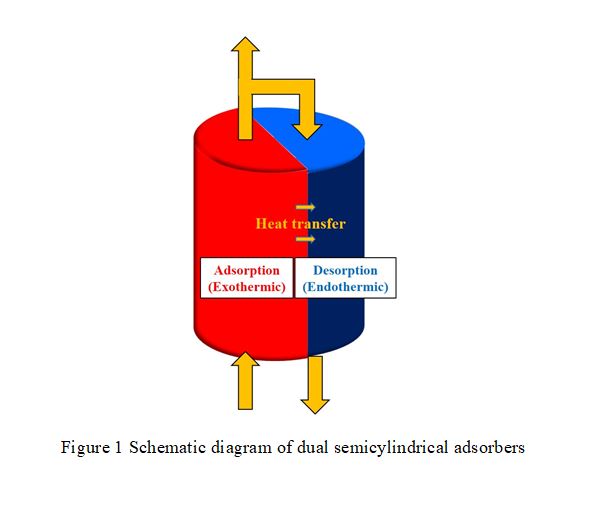
Low-grade fuel (e.g. coal and heavy oil) is one of the main sources of NOx and SOx at a time of combustion. The conventional processes for removing NOx and SOx, such as selective catalytic reduction and limestone-gypsum flue gas desulfurization, have a low NOx removal efficiency and require high cost. In our laboratory, we developed an absorption equipment having glass fiber filter, and found it attained good NOx removal performance. When the high contacting area and perfect mixing property of absorbent in this equipment are applied to simultaneous removal of NOx and SOx, there are a lot of merits, such as simplification of treatment process, reduction in operating cost, resource recycling for nitric acid and sulfuric acid, for gas treatment process. The objective of this thesis was to develop a new small model of absorption equipment for simultaneous removal of NOx and SOx, and evaluate its performance. In addition, the absorption kinetics of NOx and SOx in the equipment were analyzes. We developed new absorption equipment and indicated that NOx and SOx could be efficiently absorbed into water by using the equipment. Additionally, mixing characteristics of fluids or mass transfer characteristics in the equipment were suggested.
Up to now, many adsorbents were used for CO and CO2 separation through corporation Cu(I) to suppports. However, it is difficult to achieve high CO/CO2 separation factor, excellent CO uptake amount and large CO working capacity, simultaneously. In this work, the adsorbents were prepared by doping double metal ions consisting of divalent copper ion and various metal ion (K+, Al3+, Zn2+, Ni2+) onto MIL-100(Fe) support via impregnation method. Remarkably, the obtained adsorbent doped with copper (40 wt%) and zinc (5 wt%) showed higher CO/CO2 separation factor than the other adsorbents doped with the same concentration of copper and other metal ions (K+, Al3+ or Ni2+). The effect of zinc concentration was systematically investigated. These results proved that Cu-Zn@MIL-100(Fe) adsorbent promisses as a well adsorbent, and reveal a new route to prepare a adsorbent applied for CO/CO2 separation effectively.
Adipic acid is one of the basic materials to produce synthetic fibers like nylon-6/6. The effluent gas of adipic acid production mainly consists of nitrous oxide (N2O), oxygen, nitrogen, carbon dioxide, and water. A significant amount of N2O is emitted from the production process. Since N2O is one of the representative non-CO2 greenhouse gases, it should be recovered from the effluent gases for the mitigation of global climate change. Furthermore, the recovered N2O can be widely used in many industrial areas such as medical, automotive, and food and beverage. In particular, high purity N2O is a high value-added chemical used in chemical vapor deposition (CVD) process in semiconductor production.
Proper adsorbent selection is required for the design of adsorption separation process. In this study, to evaluate the performance of adsorbents in terms of equilibrium separation and kinetic separation, adsorption isotherms of N2O, O2 and N2 are measured on various carbon-based (activated carbon and carbon molecular sieve) and silica-based (zeolite and silica) adsorbents by a volumetric method. Adsorption amount, adsorption affinity and working capacity were compared among the adsorbents with respect to equilibrium separation. And adsorption kinetics for each adsorbent was also evaluated by applying either non-isothermal model or isothermal dual resistance model to experimental uptake curves. The physical properties and adsorption characteristics of each adsorbent-adsorbate system were used to each model. The validity of the equilibrium and kinetic results was confirmed by comparing the experimental breakthrough curves with the dynamic simulation results using the obtained values.
ACKNOWLEDGEMENT This research was supported by the Design Technology Development of Hydrogen Production Systems (100,300 Nm3/h) for Hydrogen Refueling Station (RD2017-0421) funded by KOGAS research institute.
Metal-organic frameworks (MOFs) offer many interesting opportunities in adsorption technology, with unprecedented capacities and chemical and structural tunabilities. A great deal of effort has been made to develop a method of synthesizing MOFs, including solvothermal, microwave-assisted, sonochemical, mechanochemical, and electrochemical techniques. Among the many MOFs, zeolitic imidazolate framework (ZIF) is undoubtedly the most extensively studied because of its facile synthesis coupled with its exceptional chemical and thermal stabilities. Controlling the crystal size and shape is crucial for regulating the structural flexibilities and mass transport properties.
Herein, we describe highly versatile and effective strategies to produce polycrystalline ZIF particles and membranes. The spray-drying method has been applied to fabricate the polycrystalline ZIF particles. The polycrystals with grain boundary structure enhanced both adsorption capacity and uptake rate. The support-surface activation has been applied to fabricate the polycrystalline ZIF membranes without the use of seed crystals. The flexibility tuning related with grain size could control the membrane separation performances.
The proposed synthesis strategies open new opportunities for creation and morphology-control of new MOFs.
Multi-functional sorbent derived from biodegradable lignocellulose aerogels have been successfully prepared from coir fibers with sulfur–free method and NaOH-urea system. Sulfur was avoided during pretreatment because of its environmentally harmful and disadvantageous for sorption applications. Interestingly, these pretreatments had strong effect on the physical properties of the aerogels produced. Excellent physical properties of lignocellulose aerogel can be obtained when the Kappa number, i.e., the lignin content, in the pulp is lower than 14.8. The aerogel has a macroporous structure, ultralight density, high porosity, good durability, and thermal stability. The lignocellulose aerogels were capable of absorbing approximately 22 times their dry weight of water and approximately 18 times their dry weight of oil. For dye adsorption, the cellulose aerogel could absorb methylene blue molecules up to 62 g/g aerogel, hundred times higher than those of synthesized from natural-origin adsorbents. Therefore, the prepared lignocellulose aerogels have great potential for various applications including liquid absorbents and dye adsorbents.
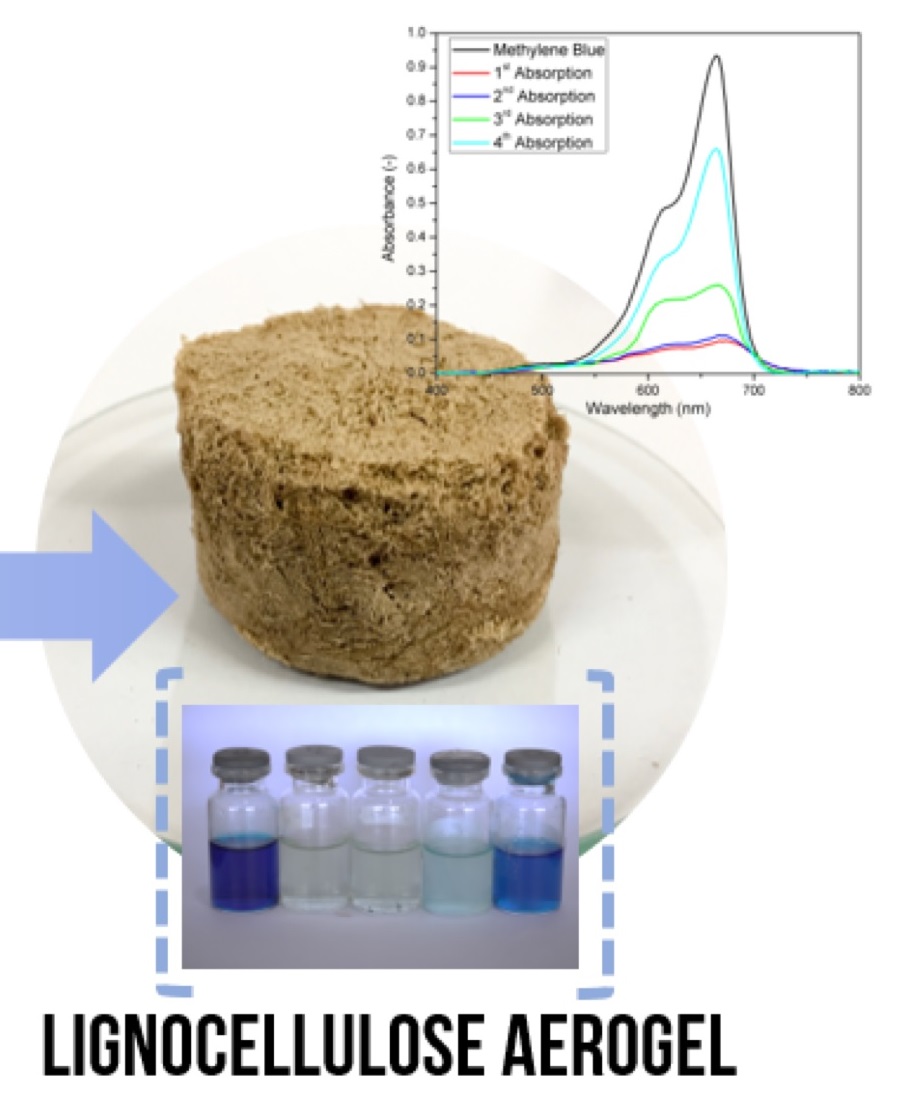
The separation of protein, which influences on the purity and the production cost of downstream processing, plays a critical role in the protein production process. The affinity separation method using a ligand is often used for separation of protein. In this study, a functionalized membrane was prepared by immobilizing cibacron blue (CB), a dye with an affinity for specific proteins, on a polyvinyl alcohol (PVA) nanofiber nonwoven membrane produced by an electrospinning method. To evaluate its separation performance, the adsorption test of bovine serum albumin (BSA), a kind of proteins, was conducted using it. The CB molecules were immobilized by covalent bonding of hydroxyl group of PVA and chlorinated triazine ring of CB under alkaline condition. The adsorption test of CB-enhanced affinity PVA nanofiber membrane was conducted by soaking it into the BSA solution as an adsorbate. After immersing the PVA nanofiber membrane in 15 ml of the BSA solution and shaking for 4 hours, the adsorption amount of BSA was obtained from the reduction in the concentration. Furthermore, the dependence of pH was also examined by testing the BSA adsorption amount under various pH conditions. As a result, after enhancing affinity by CB, the BSA adsorption amount of the PVA nanofiber membrane indicates 2.28~3.35 times increase due to functionalization. The adsorption amount of BSA became a maximum at pH 5.0, which is the isoelectric point of BSA. In conclusion, the BSA adsorption performance of the PVA nanofiber membrane could be greatly improved by the modification with CB. Moreover, the adsorption characteristics were heavily dependent on the solution environment.
The main aim of this study is to investigate the removal of phenolic compounds as pollutants in palm oil mill effluent (POME), the wastewater from palm oil industry, by palm kernel shell activated carbon (PKSAC). In the first, palm kernel shell (PKS), one of the wastes from the industry, obtained from Thailand was characterized by proximate and ultimate analyses, and FTIR one. Secondly, PKS was thermally treated to produce PKSAC by chemical activation with orthophosphoric acid. The yield of PKSAC ranged from 0.36 up to 0.72 and decreased with increasing temperature or time in the thermal treatment. The specific surface area of PKSAC (SPKSAC) was 400×103-800×103 m2 kg-PKSAC–1 and the highest at 673 K of thermal treatment temperature. The longer treatment time reduced SPKSAC. The types of functional groups on PKSAC surface were less than those on PKS surface and new functional groups of phosphorus species formed. Then, batch equilibrium adsorption of the model POME was conducted to remove phenolic compounds in POME using the PKSAC. The PKSAC could adsorbed phenol and m-cresol in the model POME and remove them from the solutions successfully. The adsorption isotherms of both phenolic compounds followed the Langmuir model. The saturated adsorbed amount of m-cresol was higher than that of phenol. This may result from higher hydrophobicity, i.e., lower solubility in water of m-cresol than phenol. The saturated adsorbed amounts of phenolic compounds increased with SPKSAC. The effect of the functional group types on PKSAC surface on the phenolic compound adsorption was unclear. Finally, the treatment process of POME with the PKSAC was discussed with the above results based on simple relationship of material balance and adsorption equilibrium. The treatment process would be expected as a promising treatment method since the PKSAC gave high saturated adsorbed amount with high yield production.
Biosorption is an eco-friendly, low-cost method and suitable for heavy metal adsorption among conventional methods of metal ion removal. Au(III) and Cu(II) adsorption from aqueous solution were carried out using low cost, biosorbent materials of sheep wool and chemically treated sheep wool. Sheep wool is a keratin-based natural fibrous material and contains many active functional groups. NaOH, Na2S, NaHSO3, and NaBH4 were used as chemical reagents for the treatment of the wool. The morphological and chemical characterization of the chemically treated wool and wool samples were performed by the Scanning Electron Microscopy and Fourier Transform Infrared Spectroscopy. The fibrous wool was transformed into a film like structures after the chemical treatment of Na2S. The functional group of amine was determined as being the main active site for the adsorption of Au(III) by FTIR analysis. The sheep wool and the chemically treated sheep wool samples adsorbed Au(III) from Au-Cu binary aqueous solution and the presence of copper ion had no effect on the Au(III) adsorption. Au(III) adsorbed substantially at low pH range. The experimental data fitted well with the model of pseudo-second-order kinetic and the adsorption amount of Au(III) adsorption increased with time and reached a plateau after 12 h. The rate determining step of Au adsorption would be defined as chemisorption due to the formation of a monolayer on the wool surface. Sheep wool is a low cost, eco-friendly material, and has a high capacity of adsorption, and could be used as a biosorbent for precious and heavy metals by modification of appropriate chemical treatment.
This paper investigates the separation characteristics of membrane + distillation hybrid processes for azeotropic ternary mixtures using simulation programs developed by the authors. When azeotropic mixtures are separated with azeotropic or extractive distillation, a solvent which is not in a feed mixture must be used. This sometimes results in contamination of the products.
The hybrid processes consisting of membrane and distillation have been studied as an alternative energy saving processes. However, they also have an advantage in that it is possible to separate the azeotropic mixture without a solvent. The separation performance of the hybrid process is maximized when the membrane module and the distillation column perform and cooperate properly.
In this paper, we conduct numerical simulations of the distillation process showed in Fig.1 with a VP or PV module using the numerical examples of ternary separations which include binary azeotropic mixtures. The results are summarized and the conditions for obtaining better performance in the hybrid processes are explained from the following viewpoints.
- Effect of feed compositions: the composition profiles of the distillation column will be affected.
- Effect of operating temperature: the compositions of the permeate and the retentate will be affected.
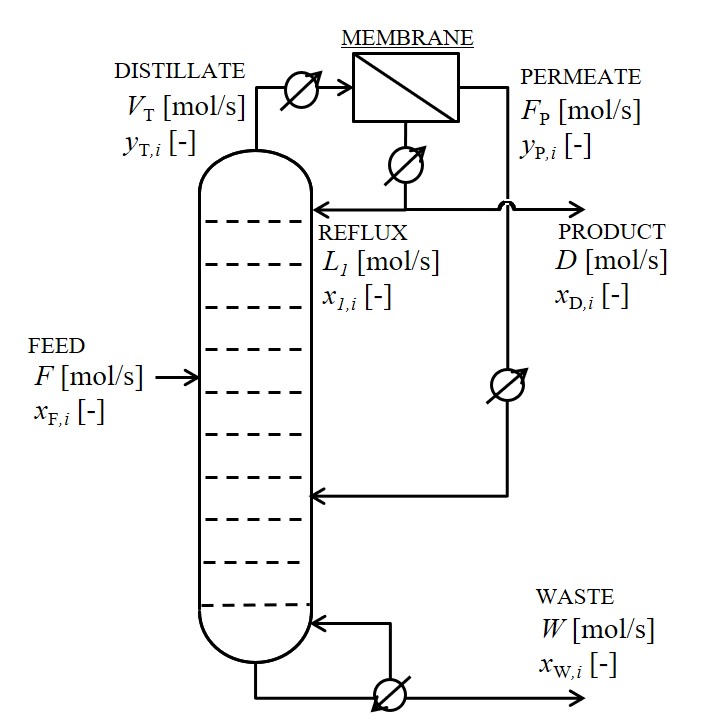
Hydrate-based gas separation is often investigated with using batch or semi-batch operations. In order to increase the throughput of gas mixture without increasing the apparatus volume, it is preferable to perform a continuous operation of hydrate-based gas separation. Therefore, we proposed a flow-type apparatus for performing continuous formation with passing gaseous mixture and subsequently decomposition with passing gas hydrate particles. Characteristics of multiple fluid and heat and mass transfer of hydrate slurry are essential for efficient operation of the apparatus. In this study, we focused on heat transfer characteristic in presence of bubbles in water and surfactant solution. First an apparent overall heat transfer coefficient under pressure during steady operation of the apparatus was calculated on a simple assumption. Next, to control hydrate amount and occurring position of hydrate-decomposition and hydrate-formation in apparatus, we focused on temperature profile of the inside fluid. A heat transfer model with using heat balance of defining heat of hydrate-formation and heat transfer of agitation of fluid was created for hydrate-based gas separation apparatus. To evaluate validity of the heat transfer model, a calculation value is compared with an experimental value. We are going to report in detail on the results of this study.
Hydrated-based gas separation is a method capable of selectively separating and recovering greenhouse gases. Although a conventional hydrate-based gas separation apparatus is a batch or a semi-batch system, continuous operation is preferable in order to increase the throughput of gas without changing the apparatus volume. In previous studies, we have considered a gas- liquid-hydrate slurry three-phase as a gas-hydrate slurry pseudo two-phase gas absorption apparatus, and investigated about effects of fluidity and solubility on mass transfer characteristics of hydrate-based gas absorber with using a column type apparatus. Recently, we proposed a flow type apparatus to allow continuous operation of hydrate formation (absorption) and subsequent decomposition (desorption). The aim of this study is to investigate mass transfer characteristics of the continuous apparatus with using HFC134a-N2 mixed gas system. The volumetric mass transfer coefficient was calculated especially during steady state of gas absorption. In addition, we investigated effects of hydrate particles and flow behavior on the volumetric mass transfer coefficient, and compared mass transfer performance between the hydrate-based gas absorber and a conventional bubble column. Sodium dodecyl sulfate was used as a hydrate dispersant. In the flow type apparatus, the gas-liquid contact was good and the hydrate slurry state was observed during hydrate formation. The experimental volumetric mass transfer coefficient was almost constant independent of HFC134a mole fraction in feed gas. In surfactant solution, bubble-hydrate slurry pseudo two-phase was formed easily because bubble size was decreased and hydrate formed on bubble surface was released by surfactant. As a result, the volumetric mass transfer coefficient increased in comparison with that in water. The volumetric mass transfer coefficient with hydrate was about 10 to 100 times higher than that of the bubble column. These results suggest that hydrate formation improve the gas absorption performance.
Refrigerant reclamation is the act of processing used refrigerant gas, which has previously been used in some types of cooling loop, such that it meets stringent purity levels before re-entering the marketplace. This process contribute to prevent the ozone depletion in the upper atmosphere. In this study, an existing batch distillation was used for reclaiming dichlorodifluoromethane CCl2F2 (R-12 or Freon-12), which is the most common representative of chlorofluorocarbons (CFCs), from waste refrigerant mixture. Since this is the existing batch distillation column, many designs variables are needed designing and many constraints, such as operating temperature and pressure of existing batch distillation or operating temperature of existing cooling and heating medium, are needed checking during design and optimization. Thus, a new systematic methodology was suggested to design and optimization the separation using an existing batch distillation. The details of a systematic methodology are described through the results from an industrial case study of R-12 recovery from a waste refrigerant mixture. Based on the comparison Txy diagram with experiment data, REFPROP can be selected as the thermodynamic models for the VLE behaviors. After design and optimization process using shortcut and rigorous methodologies, a real operation using industrial-scale batch distillation unit was carried out and compared with simulation results. Simulation results using Aspen Batch Modeler software are in good agreement with experiments carried out in a commercial batch distillation column at 8 bar.
Acknowledgements
This work was supported by the Basic Science Research Program through the National Research Foundation of Korea (NRF) and was funded by the Ministry of Education (2018R1A2B6001566), Priority Research Centers Program through the National Research Foundation of Korea (NRF) funded by the Ministry of Education (2014R1A6A1031189), and the R&D Center for Reduction of Non-CO2 Greenhouse Gases (201700240008) funded by the Ministry of Environment as a ‘Global Top Environment R&D Program'.
In this study, a continuous distillation column was proposed for reclaiming refrigerant. One of the challenges is that the distillation column has to be able to handle many different feed mixtures instead of building up many distillation columns. The experimental data of VLE behaviors of several mixtures were compared with simulation result to find the suitable thermodynamic models. Aspen Hysys V.10 was used to carry out all simulations in this study. Based on the comparison Txy diagram with experiment data, REFPROP can be selected as the thermodynamic models for the VLE behaviors. Three popular mixtures including R-22 and R-410a, R-32 and R-125, and R-12 and R-134a were used to design and optimize the distillation process via shortcut and rigorous methodologies. Then, the hydraulic performance of the proposed column was tested to verify whether the column can be used for each specific mixture or not.
Acknowledgements
This work was supported by the Basic Science Research Program through the National Research Foundation of Korea (NRF) and was funded by the Ministry of Education (2018R1A2B6001566), Priority Research Centers Program through the National Research Foundation of Korea (NRF) funded by the Ministry of Education (2014R1A6A1031189), and the R&D Center for Reduction of Non-CO2 Greenhouse Gases (201700240008) funded by the Ministry of Environment as a ‘Global Top Environment R&D Program'.
The main cause of the global warming is considered to be the emission of carbon dioxide. The utilization of carbon dioxide for agriculture achieves an increment of crop yield and an enhancement of quality of agricultural products. Exhausted gas contains 10-20 volume percentage of carbon dioxide and also contains toxic nitrogen oxides. Carbon dioxide in exhausted gas cannot directly utilize for agriculture. Therefore, expensive and purified carbon dioxide has been utilizing for agriculture. In our previous work, nitrogen oxides in exhausted gas decreased in 10ppm by flat glass-fiber filter NOx absorption equipment and treated carbon dioxide in exhausted gas from Kikugawa biogas power plant utilized in tomato cultivation factory (Bell Farm). For utilization of carbon dioxide in exhausted gas, storage and transportation of carbon dioxide became a problem. This was because the agricultural utilization was half day in spite of full day carbon dioxide production and the carbon dioxide production plant was far from carbon dioxide consumption place. To overcome this problem, we propose a completely exchange of potassium hydroxide for potassium carbonate with flat glass-fiber filter (GF) equipment. The merit of this method is that NOx removal and storage of carbon dioxide simultaneously achieve. The absorbent, saturated aqueous solution of potassium carbonate is transported to the farm using a tank lorry and carbon dioxide is desorbed with nitric acid produced by NOx absorption.
GF equipment had the characteristics of long residence time, near perfect mixing flow and large surface area. The gas-liquid contact area was 1.14×102 m2·m–3. From the estimation of mass transfer and chemical reaction, the averaged diameter of gas bubbles was about 1.35 mm in the filter. GF equipment achieved completely exchange of potassium hydroxide for potassium carbonate.
Distillation is a widely used in the chemical process industries. It was consumed a large amount of energy. Therefore, Energy saving of distillation technology is important. Several studies on energy saving distillation technologies have been reported such as VRCs and HIDiCs. Recently, the distillation-membrane hybrid separation technologies have been proposed. This technology has a high energy saving performance. However, this process have not been evaluated economic performances. In this study, we evaluate the economics of distillation process, membrane separation process, VRC, membrane-distillation hybrid process via model-based approach.
Extractive distillation technology have been attention to apply to the ethanol dehydration due to its nature of lower energy consumption compare to the traditional azeotropic distillation technology. However due to the increase of design parameters such as the solvent feed (S/F) ratio, solvent / feed location in the column, the optimization of the design of extractive distillation was quite challenging. In this work, we investigate a) the required solvent characteristics, b) the numerical analysis of the extractive distillation behavior in various S/F ratio and the reflux ratio, and c) numerical design method of the extractive distillation column. Based on the novel numerical design method, the example of the the extractive distillation coulmn for ethanol dehydration using ethylene-glycol will be presented.
Reactive distillation has advantages such as energy and capital saving, compact device, high reactant conversion since reaction and separation can be simultaneously performed in one column. However, the design and operation procedure of reactive distillation is more complicated than that of a conventional process due to the interaction between chemical reaction and distillation separation. As a result, multiple steady states occur. In a multiple steady state conditions, reaction conversion at the upper branch was the highest. High reaction conversion lead to not only a large amount of product, but also small amounts of unreacted components. If the decrease in the energy consumption of the recovery distillation column is larger than the increase in energy consumption of the reactive distillation column, the energy consumption of the reactive distillation process becomes energy-saving. This study evaluates the energy consumption of reactive distillation process for tert-amyl methyl ether (TAME) synthesis through multiple steady state conditions using steady-state simulation. Bifurcation analysis revealed that the multiple steady states did not exist under a reflux ratio 1, but existed under reflux ratios 2 and 3. Although the reboiler duty of reactive distillation column with high reflux ratio became large, the reaction conversion became also high. Due to decrease unreacted component, the reboiler duties of the recovery distillation columns at the multiple steady state conditions were lower than that at the reflux ratio 1. Compared to the energy input per mole of TAME product at reflux ratio 1, the energy inputs per at reflux ratio 2 and 3 were reduced by 17 and 12%, respectively.
An enzymatic membrane bioreactor system using the non-purified culture supernatant of white-rot fungus Trametes versicolor was developed to perform the decolorization of dye wastewater. The culture supernatant was periodically obtained from fungal cultures cultivated in cost-effective natural medium, which uses blackstrap molasses typically present in food waste, by gravitational sedimentation. The model dye wastewater containing an anthraquinone type dye and the supernatant exhibiting dye decolorization activity were mixed in a continuously stirred tank membrane reactor with an ultrafiltration membrane that permitted enzyme recycling in the reactor. The results obtained from the enzymatic membrane bioreactor showed that approximately 80% of decolorization and approximately constant permeation resistance were maintained for a few days of continuous treatment. The decolorization behaviors were well-described using a combined equation based on mass balance for continuous stirred tank membrane reactor and kinetics of enzymatic decolorization of the dye. In addition, dehydration of excess fungus that grows in the process of the decolorization treatment was carried out by mechanical expression. It should be noted that the moisture content in the compressed cake of fungus was finally reduced to 20 wt% under pressure of 7 MPa. The kinetics of expression such as the time variation of the moisture content in the compressed cake were accurately described on the basis of the multi-stage creep model. Furthermore, we confirmed that the squeezed liquid from the fungus body contains physiologically active substances such as superoxide dismutase-like materials.
Flocculation is a widely used process for particle removal in water/wastewater treatment. Recently, cationic cross linked polymer flocculant has been proposed. In this study, fundamental aspects of flocculation process using the cationic cross linked polymer flocculant are investigated. Suspension of kaolin (multidisperse) and PMMA particle (monodisperse) are used for flocculation tests under various conditions. When a little excess of cross linked polymer flocculant was added, a massive floc was formed. Cross linked polymer flocculant molecules cause the microflocs to form a massive floc. Interestingly, under conditions of low ionic strength, a massive floc was not formed. Extended cross linked polymer flocculant molecules are effective for junction of microflocs.
In response to the request of advanced industrial use of fine particles, a technique for uniformizing particle size efficiently has become increasingly important. One of the promising classification techniques is a microfiltration (MF) method using a sieving function of the membrane. However, a rapid decrease in the filtration rate caused by the membrane fouling during MF process makes efficient classification difficult. In this study, we focused on the ultrasonic irradiation and verified its effect to solve this problem of MF method. Colloidal silica was used as sample fine particle in the MF experiments. This particle had a mass-based size distribution of 0.1 to 1.0 μm and a surface mean diameter of 0.37 μm. The MF experiments were carried out under the condition of constant pressure using a membrane with a pore size of 0.45 μm. The ultrasonic irradiation with a frequency of 28 kHz was applied continuously to the filter during the MF experiment. The filtration rate and the particle concentration in the filtrate were measured through the MF experiment. The effect of the ultrasonic irradiation was confirmed by comparing with the experimental data obtained under the non-irradiation condition. As a result, when ultrasonic irradiation was performed, the filtration rate increased about twice, and the particle concentration in the filtrate also increased to a concentration at which the particle size distribution could be measured. Also, considering that only particles with less than 0.45 μm were present in the filtrate, effective particle classification was achieved by the ultrasonic irradiation. In conclusion, the ultrasonic irradiation can contribute to the suppression of the membrane fouling and the improvement of the filtration rate. Moreover, it enables effective classification of the fine particles through a MF membrane.
Excess sludge production by wastewater treatment plants represents a serious environmental problem that necessitates the development of effective sludge treatment/disposal methods. Excess sludge contains valuable materials such as extracellular polymer substances (EPSs) accounting for 10–40% of the dry weight of excess sludge, and their recovery is of great practical importance. In previous study (Cao et al., Chem. Eng. J., 2018, 354: 866–874.), we demonstrated that the EPSs recovered from excess sludge can be used as adsorbents for the removal of diverse heavy metal ions from wastewater, exhibiting performances that are on par with those of commercial adsorbents. In order to achieve the separation of EPSs with the adsorbed heavy metal ions from wastewater, combining EPSs recovery and heavy metal ions adsorption into a dead-end ultrafiltration, the ultrafiltration of EPSs solution was carried out to obtain the cake on the membrane and once this process was completed, heavy metal-containing wastewater was filtered through the cake. The removal rate could achieve more than 90% for typical heavy metal ions by EPSs cake when the certain concentration rates of EPSs and heavy metal ions were used. Calcium ion and filtration-aid (diatomite) could reduce the filtration resistance and had no effect on the removal of heavy metal ions.
Dynamic filtration plays an important role in the food production process and waste water treatment since the stable filtration operation can be maintained by removing the filter cake hydrodynamically. In this study, we developed a dynamic filtration method that jets the feed slurry tangentially toward the rotating drum filter medium. The tangential flow mode is more effective than the vertical one because of higher shear stress to the filter medium and more efficient cake removal. In order to evaluate the filtration performance of this dynamic filter, the constant rate filtration experiments were conducted using a corn starch suspension and the pressure variations in the filter were measured over time. The effects of the operational parameters such as volumetric flow rate Q of the feed slurry, rotational speed ω of the drum filter medium, and opening width w of the supply slit were investigated to find the optimum conditions for stable filtration operation. As a result, the stable filtration process with low pressure loss was attained under the conditions of ω = 1 rpm, Q = 50 L/min, and w = 2.85 mm. The experimental data also demonstrated that the filtration performance was much more efficient when the linear feed velocity obtained by dividing the volumetric flow rate by the slit area was about 1.7 m/s under low rotational speed. In conclusion, the dynamic filter with the tangential jet feed toward the rotating filter medium developed in this study is very useful as one of efficient and stable dynamic filtration systems.
In this study, the gold ore sand was sorted by the hydrocyclone, and the gold ore sand would be sorted into overflow and underflow. Both overflow and underflow then treat by chemical solvent to strip the gold from gold ore sand to get the result. The research is to figure out which hydrocyclone have the best separation effect to gold ore sand, that is, what kind of hydrocyclone can sort the gold ore sand with the lowest gold content concentration at the overflow and the highest gold content concentration at the underflow. The gold ore sand at the overflow would be removed, then we only need to strip the gold from the underflow to get the most portion of the gold.
In series A and series B of hydrocyclone experiments were carried out under a fixed 5% gold ore sand solution. The experimental results show that as the cone length of the hydrocyclone increases, the concentration and solid content of the overflow decrease. This is due to fact that when the cone length increase, gold ore sand can be separated more effectively in the hydrocyclone, the gold ore sand with large density and large particle size is discharged from the underflow with the main spiral vortex, and decrease the portion of large particles that carried gold from taken away by overflow spiral vortex.
It has been reported that when a diluted slurry is filtered at a constant rate by a precoat layer prepared by water containing fine bubbles (FBs), the filtration capacity of the layer becomes more than twice larger than using a precoat layer prepared by water without FBs. This study aims to clarify the reason why the addition of FBs to the precoat layer increases the filtration capacity. Precoat layer of kieselguhr was prepared by tap water containing FBs or tap water without FBs, followed by tap water permeation through the layer. In case of “with FBs,” FBs caught in the precoat layer grow during the water permeation period, and a part of them leave from the layer, resulting in a change of the surface of the layer from smooth to rough. The figure shows the effect of water permeation time on filtration capacity which is defined as the amount of captured particles per unit area of a filter medium until filtration pressure reaches a predetermined value. Filtration capacity increases with water permeation time until the capacity reaches a maximum value at 10 min. Up to the time 10 min, FBs grow, and a part of them leave from the precoat layer, increasing porosity and roughness of the layer. The increase of filtration capacity seems to be in accord with the increase of the roughness of the layer. When the permeation time is longer than 10 min, the structure of the layer is collapsed by over-grown bubbles leaving from the layer. It seems that several filtration mechanisms proceed successively or simultaneously. The degree of improvement by addition of FB water in preparation of the precoat layer can be evaluated in terms of an increase of effective filter area.
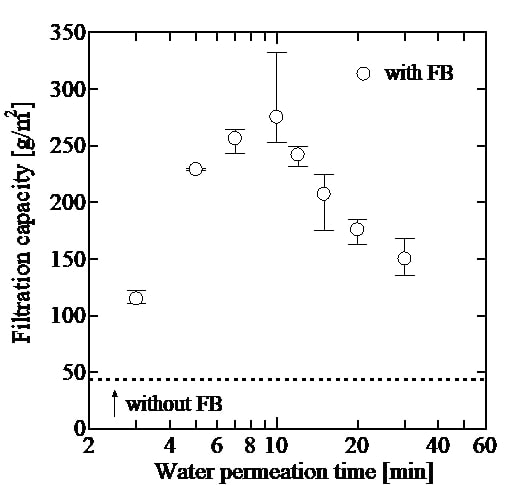
Poly(L-lactic acid) (PLLA) is one of the major biodegradable biomass plastics to reduce the use of fossil resources and the plastic wastes in the natural environment. We have been developing some microfiltration membranes of PLLA to reduce the wastes of filter media in filtration process in industries because the polymer is degradable under the hot and humid conditions in compost machines after use [1-5]. In this paper we developed microfiltration membranes of PLLA by using γ-butyrolactone (GBL) and surfactants via phase separation methods. PLLA was dissolved at 120 oC in GBL containing surfactants (none, Tween 20, Tween 40, Tween 80, polyoxyethylene (20) oleyl ether, and Span 80). The solutions were cast on glass plates with a 0.5 mm-thick frame of polytetrafluoroethylene at 70 oC and immersed in a 25 oC purified water to induce phase separation. Filtration characteristics were examined by dead-end filtration with purified water and 0.3 μm polystyrene latex beads. Asymmetric filtration membranes were formed when Tween 20, Tween 40 and Tween 80 were used as surfactants. The retention of the latex beads was more than 97% when the concentrations of PLLA and Tween 80 in GBL were 10-15% and 5-10%, respectively. The membrane resistance prepared from 10% PLLA solution in GBL containing 10% Tween 80 was about 1/20 of that prepared from 10% PLLA solution in 1,4-dioxane containing 15% Tween 80. The membrane will be one of the candidates of the compostable filtration membranes.
References
1) T. Tanaka, D.R. Lloyd, J. Membr. Sci., 238, 65–73 (2004).
2) T. Tanaka et al., J. Chem. Eng. Jpn., 39, 144–153 (2006).
3) T. Tanaka et al., J. Chem. Eng. Jpn., 44, 467–475 (2011).
4) T. Tanaka et al., J. Membr. Sci., 396, 101–109 (2012).
5) H. Minbu et al., J. Membr. Sci., 479, 85–94 (2015).
When a non-uniform electric field is applied to the particle dispersion, the particles move by receiving a force along the electric field gradient due to the magnitude of the polarization of the dispersion medium and the particles. This phenomenon is called dielectrophoresis, which can be useful from particle recovery from dispersion. When dielectrophoresis occur, particle aggregation simultaneously occurs. This phenomenon also can be useful for particle separation because it can enhance sedimentation of fine particles in liquid.
The objectives of the present work is to investigate the conditions in the application of the abovementioned aggregation phenomenon to the removal of silica fine particles from water. For this purposes, we tried to design the electrode structures that can give appropriate electric field profiles for high removal efficiency. Using the newly designed electrodes, the effects of the applied voltage, its frequency, and the voltage application time on the separation efficiency were observed.
In the experiment, water dispersed with silica particles (diameter = 20 nanometers) at 0.04 wt% was used as target dispersion. DC and AC voltage of 100 V with 0.1 ~ 1000 Hz frequency was applied to the dispersion, and the light absorbance of the dispersion were measured before and after the voltage application to evaluate the progress of particle aggregation and the removal. Figure1 shows the change in absorbance with respect to the change in frequency of the applied voltage. Note that the dispersion of nanoparticles is nearly transparent, the absorbance increases when the particles were aggregated. Such phenomenon may occur when AC voltage was applied, but the aggregation degree may not be high enough to enhance sedimentation. In contrast, the absorbance decreased when DC voltage was applied, suggesting that the DC voltage is effective to enhance the precipitation of silica particles than the AC voltage.
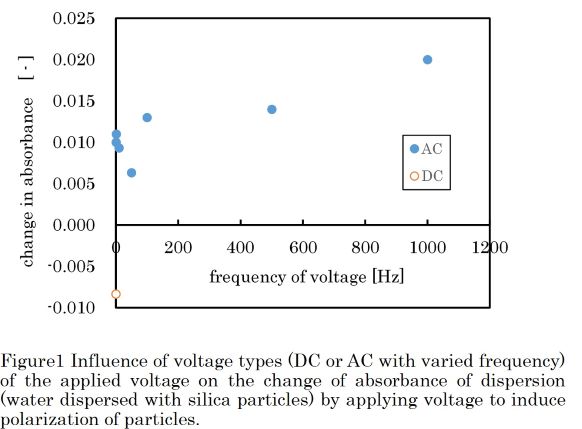
Post-combustion carbon capture from flue gas after the fossil fuel combustion is important to mitigate the global warming. CO2 capture by regenerable sorbents is a promising technology for post-combustion technologies because of its potential of low energy requirement and low operating temperature [1].
In this study, the post-combustion CO2 capture process in a dual fluidized-bed system has been investigated by developing a rigorous dynamic model for the system with K2CO3-based sorbent. The dual fluidized-bed CO2 capture process consists of a fast fluidized-bed carbonator and a bubbling fluidized-bed regenerator. As a case study, the K2CO3-based sorbent was used to sorb CO2 selectively from the flue gas by carbonation reaction. A ternary gas (CO2:H2O:N2=11:12:77 mol %) as an effluent gas from the fossil fuel-fired power plant and a binary gas (CO2:N2=95:5 mol %) as a regeneration gas were applied to the dual fluidized-bed process. The sorption and regeneration kinetic models were developed and applied to the carbonator and regenerator model. The developed model including the rigorous kinetic models was validated by comparing the experimental data [2] with the simulation results at various operating conditions. By using the developed model, the dynamic behaviors inside the carbonator and regenerator were investigated. The CO2 removal performance and the energy consumption for the regeneration of the sorbent were also evaluated at various conditions.
References
[1] Jayakumar A, Gomez A, Mahinpey N. Post-combustion CO2 capture using solid K2CO3: Discovering the carbonation reaction mechanism. Applied energy. 2016;179:531-543.
[2] Yi C-K, Jo S-H, Seo Y, Lee J-B, Ryu C-K. Continuous operation of the potassium-based dry sorbent CO2 capture process with two fluidized-bed reactors. International Journal of Greenhouse Gas Control. 2007;1:31-36
In this study, the experimental research work was conducted for the purpose to develop a higher performance removal agent for ethylene fabricated from the waste plum seeds of pickled Ume.
Plum seeds with residual pulp (O.ume) and pre-treated plum seeds (D.ume), which were removed pulp, washed and dried, were used as the raw materials for activated carbon. Using O.ume and D.ume, the activated carbons which were called O.AC-ume and D.AC-ume were prepared by a one-step-preparation method by using superheated steam, respectively. Predetermined amounts of Pd were loaded on the D.AC-ume to prepare activated carbons supporting Pd.
As results of the ethylene removal experiments using the various prepared ethylene removal agents, ethylene concentration in gas phase decreased with time by all the removal agents (Fig.1). There was no significant difference in the removal ability of ethylene between O.AC-ume and D.AC-ume. The removal ability would be markedly improved by loading Pd on D.AC-ume. In addition, as the loading amount of Pd increased, the ethylene concentration in gas phase decreased in a shorter time. Time course of change in the ethylene concentration in gas phase by O.AC-ume, D. AC-ume, and AC-Pd could be correlated by the pseudo-first-order kinetic equation, respectively.
SEM images of D.AC-ume and AC-Pd were taken by a scanning electron microscopy. As results of the quantitative elemental analysis and element mapping by EDS, it would be cleared Pd was almost uniformly supported on the surface of each AC-Pd.
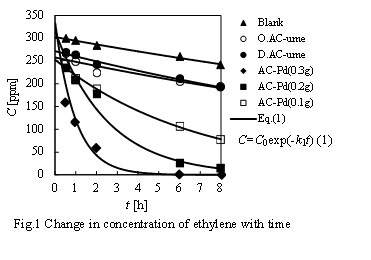
Recognition of lectin by microfibers with sialic acids
Takumi Inoue and Kazuya Uezu
Influenza viruses are significant human respiratory pathogens that cause both seasonal, endemic infections and periodic, unpredictable pandemics. The virus recognizes specifically sialic acids on the surface of human throat cells with the lectin, hemagglutinin, on the virus surface. Lectins are "proteins showing binding activity to sugar chains". To prepare the functional materials capturing the influenza viruses, we have been immobilizing sialic acids to the polymer brush on the surface of microfiber nonwoven fabric to mimick the interaction between sugar and lectin. An epoxy-group-containing monomer, glycidyl methacrylate (GMA) was grafted onto a nonwoven fabric made of polypropylene, and N-acetylneuraminic acid (NANA) was immobilized by the reaction after introducing the coupled monomer of iminodiacetic acid (IDA) and 1-ethyl-3-carbodiimide hydrochloride (EDC) on GMA polymer brush. We used a wheat germ-derived lectin (WGA) with specificity for NANA. In this study, the lectin adsorption experiment was conducted in gas phase. The lectin solution was aerosolized to be droplets. While WGA did not adsorb on GMA polymer brush, it adsorbed on IDA-EDC and NANA immobilized nonwoven fabric. The adsorption amount of WGA on NANA was more than twice compared to on IDA-EDC. These observations indicate that the microfiber nonwoven fabric having sialic acids recognized sialic acid-specific lectins in aerosol.
Chromium (Cr) and its compounds are widely used in elecroplating and leather industries, which tends to be a main source of Cr(VI) pollution in water. The expose of Cr(VI) is causes of health problems like liver damage, lung cancer and so on. Therefore, removal of Cr(VI) from water environment has received more and more attention. Adsorption is one of the preferable methods for the removal of Cr(VI) in the water environment. In addition, reduction of Cr(VI) to Cr(III) is effective for detoxication, since the toxicity of Cr(III) is much lower than that of Cr(VI). In present work, reductive adsorption of Cr(VI) has been investigated by using activated carbon (AC).
Coal-based activated carbon, M010 (Mitsubishi Chemical Calgon), was used as an adsorbent. Adsorption was carried out by shaking mixture of M010 and aqueous feed solution. After filtration, concentration of Cr species in aqueous solution was determined by ICP-AES and colorimetry.
Figure 1 shows the effect of pH on the adsorption of Cr(VI) on AC. The adsorption of Cr(VI) was highly influenced by pH of aqueous solution, and high adsorption amount was obtained pH range of 4 - 6. This is because the species distribution is affected by pH. In addition, the reduction of Cr(VI) to Cr(III) occurred during the adsorption processing, and thus Cr(III) appears in the aqueous solution after adsorption, especially at acidic pH region. Reductive adsorption of Cr(VI) is therefore achieved with the AC.
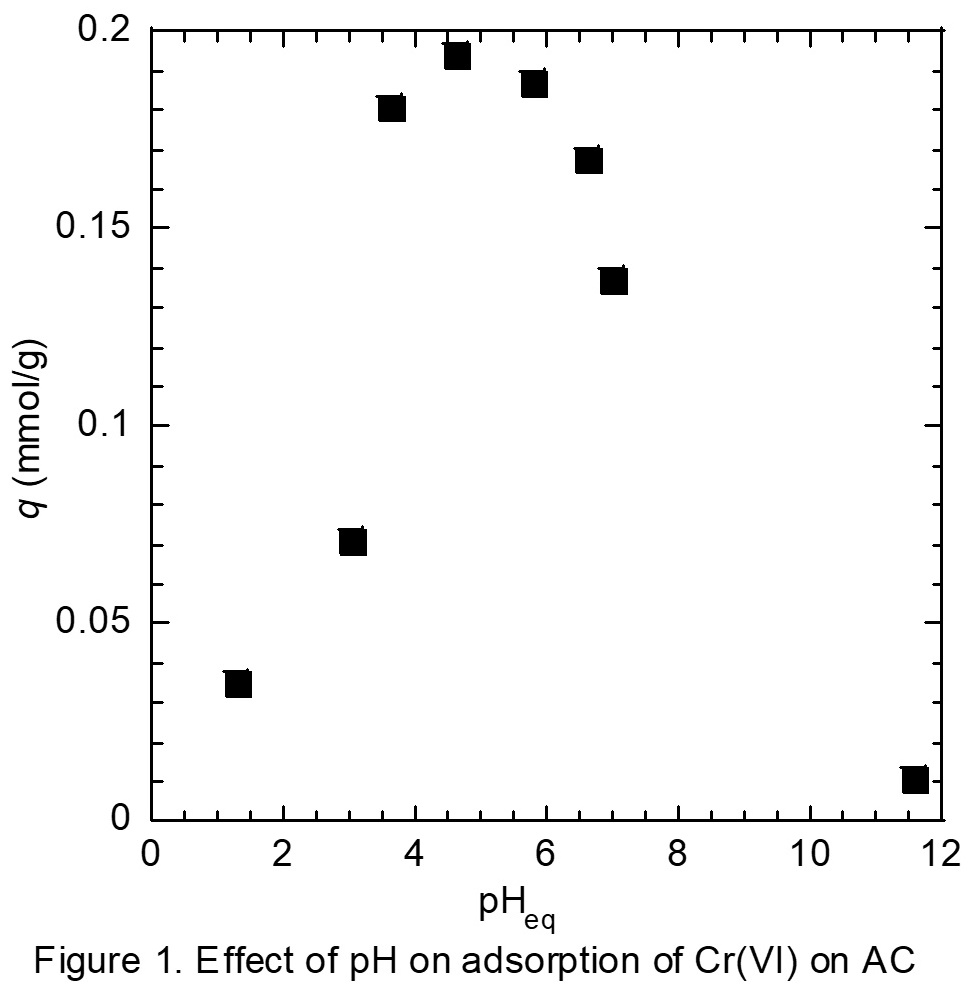
Plating waste sludge contains a large amount of valuable metals and need to develop an industrially sound technology for their treatments. In this study ion exchange/chelate fibers were used to develop the separation and recovery of Ni and Sn from the sludge. Adsorption equilibrium and separation characteristics were examined to understand the optimum conditions. The solid sludge as well as standard Ni and Sn ions were dissolved in 3M HCl solution. “Weak base type chelate fiber” containing a polyamine groups (called KC-31) as well as three other fibers were used in this study. The equilibrium data were in good agreement with the Langmuir isotherm for single-component system when using standard Sn individually of mixture with Ni, the equilibrium data were found to be in good agreement with the Langmuir isotherm. Fig.1 shows the results of the separation of Ni and Sn ions from the sludge solution. As shown, Ni and Sn ions can be completely separated from each other. The calculated maximum adsorption capacities for Sn from the sludge was 1.03 mol/kg when KC-31 fiber was used, while the adsorption capacity for Ni at the same conditions was zero. The water and or HCl 0.1~1M solutions were found as effective eluent to desorb the adsorbed Sn on the fiber. The adsorption breakthrough curve and desorption curve were scaled up from batch to a fixed bed reactor. When the flow rate was 1 mL/min, the adsorption breakthrough time and desorption completion times were 9 and 20 min, respectively. Obviously, it was revealed that the breakthrough time and the desorption time become longer when the flow rate reduced. As a main conclusion, it was found that Sn and Ni can be entirely and successfully separated and recovered from waste plating sludge by adsorption and consequently desorption using the fiber KC-31.
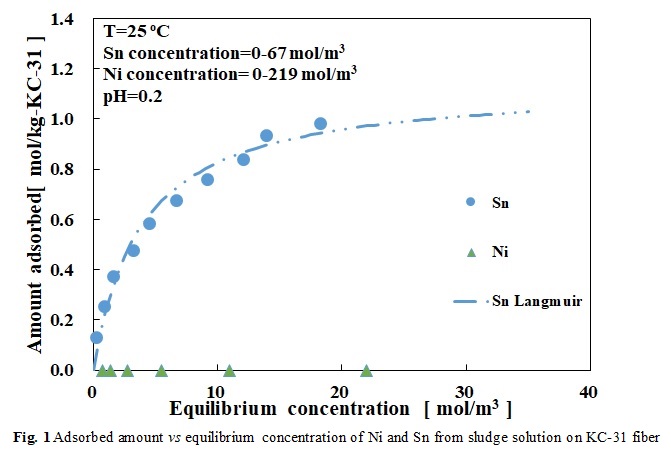
Separation of propane and propylene has a significant value in the petrochemical industry because propylene is an important feedstock for polypropylene, acrylonitrile, acrylic acid, and other many poly-gas chemicals [1]. Cryogenic distillation method is a general method to separate them, but it is one of the energy-intensive processes in petrochemical industries [2]. Therefore, the adsorptive separation process may be an alternative in economic and energy perspective. One of the main problems in developing the process was the difficulty of regeneration for adsorption bed because of the high affinity of propylene on adsorbents.
In this study, desorbent swing adsorption(DSA) separation of propane and propylene in zeolite 13X has been carried out. As a desorbent, carbon dioxide and helium were chosen. And adsorptive behaviour, depending on desorbent, temperature and pressure, was investigated by breakthrough experiments. To estimate the separation performance, the breakthrough experiments, composed of adsorption, rinse, desorption, and re-adsorption were conducted to design a 4-step DSA process.
The dynamic simulator was developed to predict the breakthrough results at various conditions. The required data for the simulation were used from the previous study [3] and the validation of the model was confirmed through the comparison between the model and experimental breakthrough results. The simulated separation performance of the DSA process will also be presented.
[1] M.C. Campo, A.M. Ribeiro, A. Ferreira, J.C. Santos, C. Lutz, J.M. Loureiro, A.E. Rodrigues, Separation and purification technology, 103 (2013) 60-70.
[2] C.A. Grande, A.E. Rodrigues, Propane/propylene separation by pressure swing adsorption using zeolite 4A, Industrial & Engineering Chemistry Research, 44 (2005) 8815-8829.
[3] J.J. Kim, S.J. Lim, C.H. Lee, Microporous and Mesoporous Materials, 274 (2019) 286-298.
Several methods of CO2 capture and storage have been investigated, and adsorption separation is known to be one of the key technologies. Zeolites are often used as adsorbents for CO2 separation due to its high CO2 adsorption capacity. However, zeolites adsorb H2O selectively rather than CO2 under humid conditions. Since flue gas from industries generally contains H2O, dehumidification of flue gas is necessary for present CO2 adsorbents, but it consumes extremely large amount of energy.
In this study, core-shell structured chabazite consisting of a chabazite aluminosilicate core coated with thin layer of hydrophobic pure silica chabazite was synthesized, and its CO2 adsorption property under humid conditions was evaluated.
A chabazite aluminosilicate core was synthesized by hydrothermal synthesis. Then, a pure silica chabazite coating was performed by a secondary growth of a core chabazite in fluoride solution under hydrothermal condition. CO2 adsorption property of the products under humid conditions were assessed by means of breakthrough measurements.
Crystal size was slightly increased after core-shell structuring, and the Si/Al ratio values of aluminosilicate core and core-shell structured sample were 5 and 8, respectively. This indicates the thin layer of hydrophobic pure silica chabazite was successfully grown on a chabazite aluminosilicate core. CO2 adsorption amount under the humid condition was assessed by adsorption-desorption cycles of CO2 with H2O vapor at 313 K. Figure shows the relative change of CO2 adsorption amount during adsorption-desorption cycles without heat treatment. CO2 adsorption amount on the chabazite aluminosilicate core was gradually decreased with cycles due to co-existing H2O vapor. In contrast, the negative effect of co-existing H2O vapor was suppressed on the core-shell structured chabazite. It was experimentally demonstrated that core-shell structuring on chabazite zeolites was effective for CO2 adsorption under humid conditions.
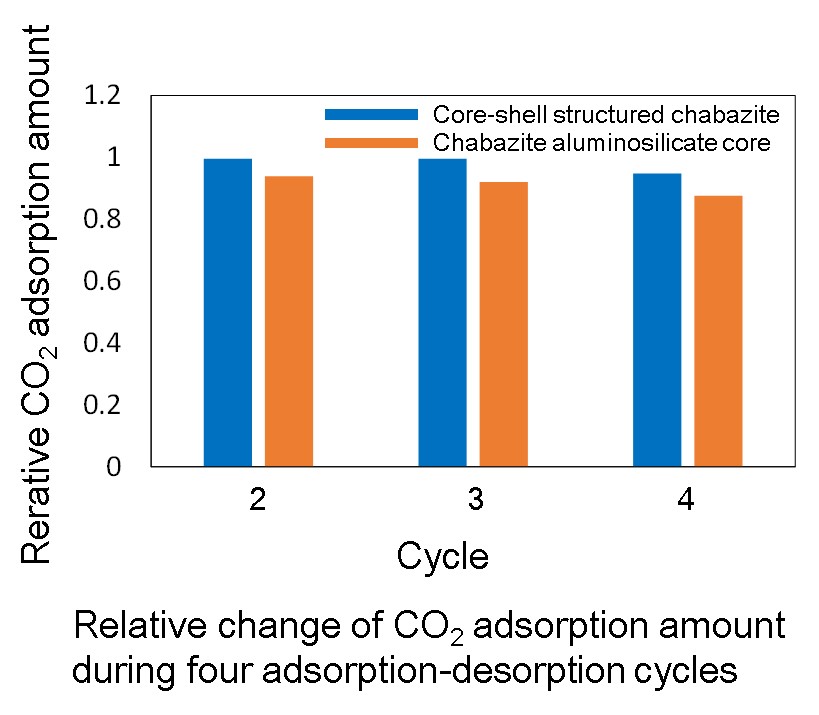
In this study, we developed the simulated moving bed (SMB) process that was customized for the continuous-mode separation of fucose and 2,3-butanediol (BD) with high purities. As a first step for this task, an effective adsorbent for the targeted separation was selected through a series of pulse tests for several potential resins that are commercially available. On the basis of selected adsorbent, the intrinsic parameters of fucose and BD were estimated through a multiple frontal analysis method. The estimated parameters were then used in the optimization of the fucose-BD separation SMB process. To experimentally verify the separation performance of the optimized SMB process, the relevant SMB experiment was carried out. Finally, we devised two potential strategies to make a further improvement in product concentrations and/or desorbent usage while keeping the purities and yields of fucose and BD almost unchanged. The results of this study will be helpful in making a substantial improvement in the economical efficiency of the microalgae-based fucose production process that utilizes the Klebsiella oxytoca fermentation as a final step for fucose purification.
In recent years, arrangements for reducing greenhouse gases have been reviewed with the rise in global average temperature. In fact, the Paris Agreement, new agreement about climate change suppression agreed in 2015, aim for holding the increase in the global average temperature to below 2 oC above pre-industrial levels, so greenhouse gases capture methods are much in demand. Hence, we focus on CO2 one of greenhouse gases and have been developing CO2 capture using amine-containing hydrogel film. This material is able to maintain the performance of CO2 capacity even under high humidity environment (R.H. > 95%) compared to other CO2 capture materials such as activated carbon, zeolite and so on. However, CO2 absorption kinetic of this material is not enough to use CO2 capture because ionic diffusion rate of HCO3- dissolved hydrogel film is too slow. In contrast, HCO3- diffusion in liquid phase is 10,000 times slower than CO2 diffusion in gas phase. In this study, we designed new type of hydrogel film with micro channels for gas diffusion, namely aeroporous hydrogel, for fast CO2 capture (Figure 1). We could prepare this material by mixing amine-containing hydrogel particles (GPs) and hydrophobic fillers like carbon black via dry process, molding film by uniaxial press, and humidifying under R.H. > 95%. After mixing these materials, SEM images showed GPs coated with hydrophobic filler. Then, we observed some void that can be gas diffusion phase in aeroporous hydrogel film by TEM images. CO2 absorption kinetics of this film are several times larger than that of conventional hydrogel film. Additionally, we discovered that CO2 absorption kinetics differed according to filler characters such as hydrophobicity and particle size because these affected formation of micro channels. Therefore, we expect that more improvement of CO2 capture efficiency can be achieved by using this material.
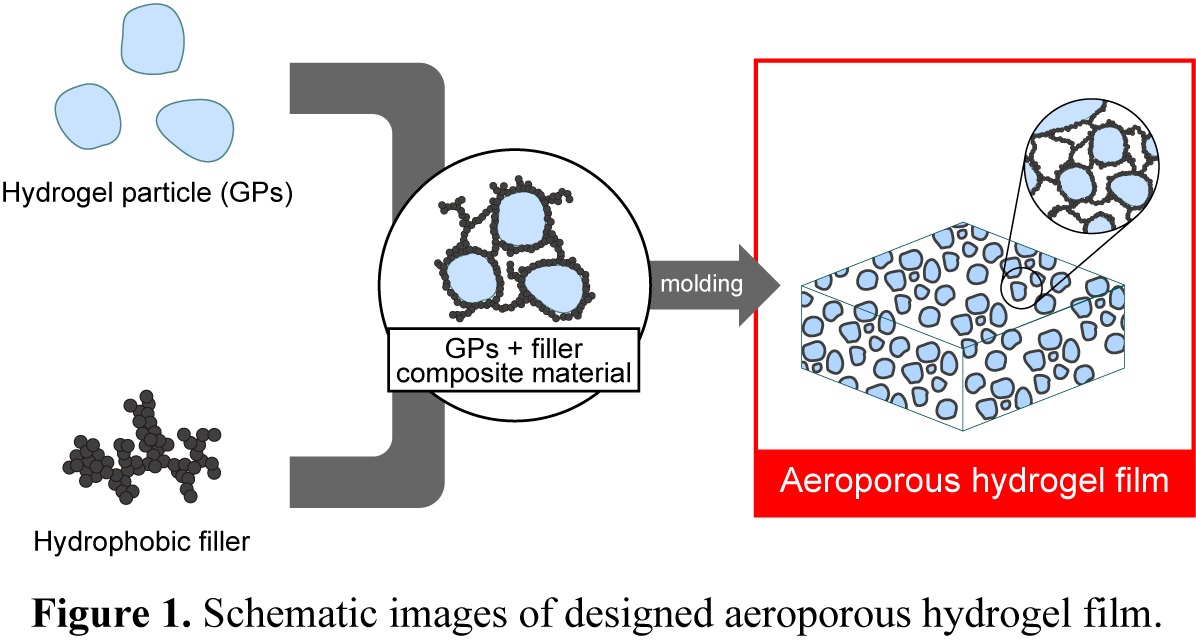
Nitrogen monoxide and dioxide are referred to together as oxides of nitrogen (NOx). Since NOx is toxic for human beings and may cause acid rain, both amount and concentration of NOx in exhaust gas are restricted to low levels by domestic or international legal control. In our laboratory, removal of NOx by adsorption against a zeolite and NOx recycling process for a production of nitric acid have been studied. Low concentration of NOx in exhaust gas can be concentrated by adsorption and thermal desorption by using zeolite. When concentrated NOx is absorbed to water, unable saturated nitric acid can be produced. In this study, we analyzed adsorption-desorption and oxidation mechanism on NOx concentration process for nitric acid production from NOx in exhaust gas. It was found that NOx (NO occupying the majority) is adsorbed on the zeolite and desorbed from zeolite as NO2 by thermal desorption. 100% of NO can be oxidized in NO2 by zeolite. NO2 is easily absorbed to water. This is very useful for NOx recycling process for a production of nitric acid.
Drying is in widespread use in wide a variety of industries, including the pharmaceutical, food, and organic chemical sectors. Vacuum foam drying has advantages, in that the drying process is rapid and heating can be eliminated. The process is now used in producing certain types of viruses and amorphous solid dispersion preparations. While the foaming of a solution is difficult to control under conditions of low vacuum, the application of a high vacuum above a certain level causes instantaneous foaming without any time lag. In our studies, we found that, when the volume of a solution is reduced to a certain extent and is then punctured with a steel needle (needle-stimulation), drying restarts under conditions of decompression (~1000 Pa) and forming is typically induced with a significantly high probability. Hence, the feasibility of vacuum foam drying under conditions of a low vacuum with the aid of the needle-stimulation-based induction of foaming was investigated. The sample solution, comprised of a sugar or a polymer as a solute and alcohol as the solvent, was vacuum dried in the two steps (initial and secondary drying), between which needle-stimulation was conducted. The probability of inducing solution foaming was estimated as a function of the initial drying period. The relationships between the initial drying period and the probability of inducing foaming were compared among different solute/solvent combinations and different needle-stimulation conditions. The changes in the solution viscosity during the initial drying period were also measured as a factor determining the probability of inducing foaming. Based on the obtained findings, the mechanism for how needle-stimulation induced the foaming was investigated.
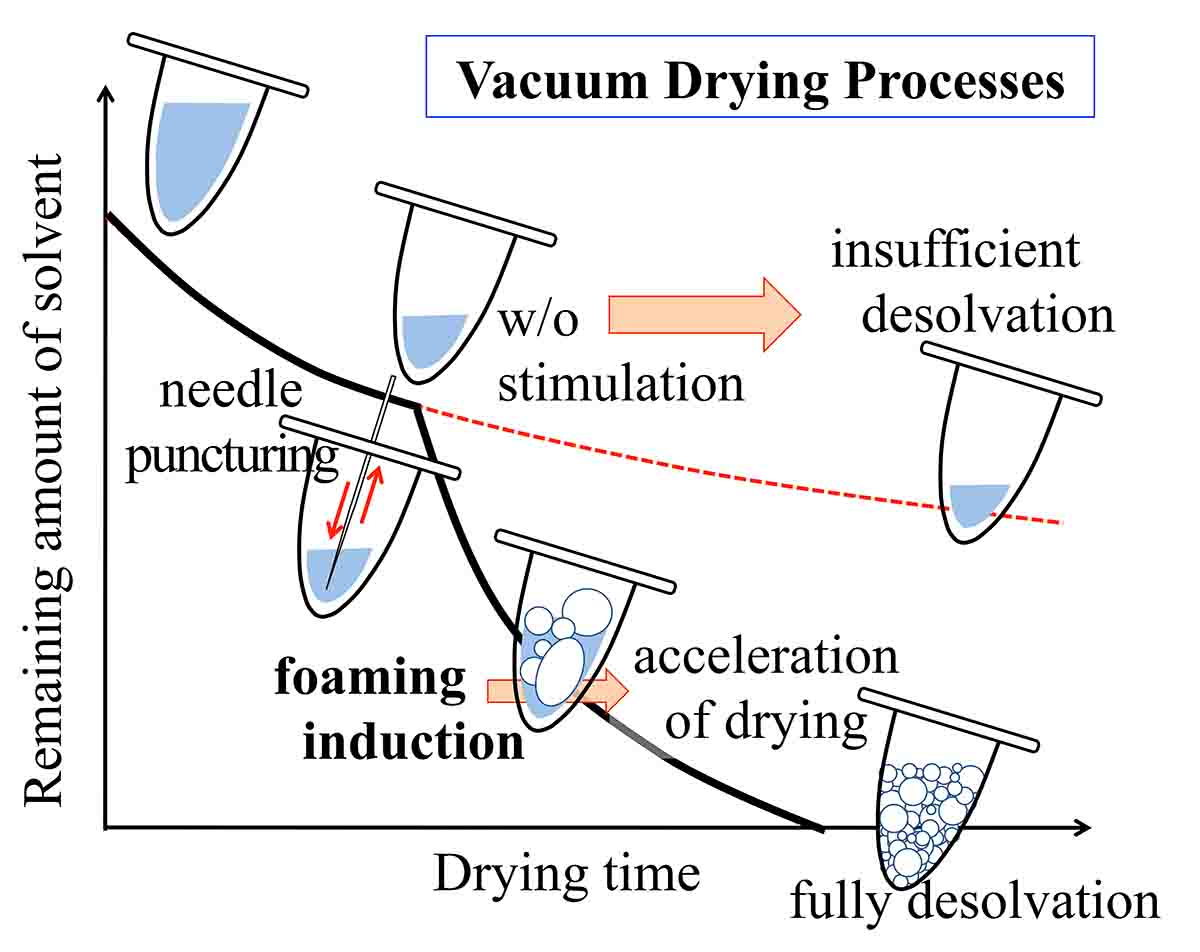
Chitosan is a superior metal adsorbent and is expected to be used in the removal of metallic ions in wastewater. Its adsorption capacity and selectivity can be enhanced by chemical modification. However, chitosan is easily soluble in dilute acidic solutions because of the protonation of the amino group. In most cases, crosslinking among amino groups of chitosan is carried out for insolubilization. The metal adsorption capacity generally decreases with an increase in the extent of crosslinking because amino groups on chitosan bind the metal ions. Recently, the preparation of chitosan-cellulose hydrogel beads enhanced the mechanical and chemical strength. The mechanically prepared gel beads were also soluble in the acidic solution and crosslinking of the gels was needed as an adsorbent. Recently, because ionic liquid can dissolve such polysaccharides as cellulose and chitosan, chitosan-cellulose beads by regeneration from ionic liquid 1-butyl-3-methyl imidazolium chloride were prepared.
In this study, chitosan-cellulose gel beads were regenerated from ionic liquid and their application to metal adsorbent was examined. The chitosan-cellulose gel beads, which were prepared from 1-ethyl-3-methyl imidazolium acetate, were more stable in the acidic and basic aqueous solutions than cellulose or chitosan. The adsorption of copper on chitosan-cellulose gel beads was examined and the adsorption amount of copper ion increased with pH, suggesting that amino groups on chitosan were related to adsorption. The adsorption isotherm of copper, zinc and nickel ions was well described by the Langmuir model and the adsorption ability of these metal ions obeyed the Irving-Williams series. Fe(III), Mn(II), and Co(II) from a buffer solution and Pt(IV), Au(III), and Pd(II) from a hydrochloric acid solution were not adsorbed on the chitosan-cellulose gel beads.
Industrial wastewater often contains heavy metals such as lead, copper and iron, which are used for various purposes. It is essential to utilize rare metals, especially precious metals, and the shortage of scarce metal resources is a problem and the collection of precious metals from the wastes is also important. Recovery of the metals in wastewater has been carried out mainly by precipitation method and adsorption method. The precipitation method is suitable for treating a large amount of wastewater of high concentration, however, a neutralization treatment is required and a large amount of high concentration alkaline waste liquid is generated. However, heavy metals are likely to be accumulated in the body and health damage often occurs since metabolic pathways are not established in the human body. New metal ion recovery method with hydrogels as a reaction and separation media has been investigated. Hydrogels based on N-3-(Dimethylamino)propyl acrylamide (DMAPAA) or (3-Acrylamidopropyl)trimethylammonium chloride (DMAPAA-Q) were prepared. The DMAPAA hydrogel exhibited high pH value inside when they swelled in water because the tertiary amino group was protonated by water and produced hydroxide ion retained in the hydrogel. When the hydrogel was immersed in the metal ion aqueous solution, the metal ion diffused into the hydrogels to produce metal hydroxide in the hydrogel. On the other hand, DMAPAA-Q hydrogel modified by various anions such as chloride, sulfide, and carbonate can produce metal salt inside the hydrogel, too. The metal salt in those hydrogels were easily separated from the solution. The selective recovery of a certain metal ion from the mixed metal ion solution was attained by using hydrogels with variety of anions according with metal ions. The results obtained here suggest the possibilities of the novel selective metal ion recovery method replacing the coagulation and/or adsorption methods.
Japan is one of the resource-rich countries in the world from the standpoint of "urban mine", and the establishment of simple, low-cost and environment-friendly technology for noble metal recovery is the urgent issue to be solved. In this study, the fabric membrane which can adsorb gold ions selectively was developed using electrospun nanofiber with extremely high specific surface area as an adsorbent. Prior to the development of nanofiber membranes, the nanofiber material useful for gold ion adsorption was explored, and as a result, it was found out that nylon 6 has a great affinity for gold ions. The objective of this study is to investigate the gold ion adsorption ability and selectivity of the nylon 6 nanofiber membrane. The nanofiber membrane was prepared by depositing nylon 6 nanofibers produced by electrospinning method. The mean diameters of nanofibers produced in this study were 143 and 206 nm at the nylon 6 concentrations of 10 and 20 wt%, respectively. As a result of the gold ion adsorption tests in a highly acidic environment of 2 M hydrochloric acid, the adsorption behaviors could be expressed by the Langmuir's adsorption isotherm, and the saturated adsorption amounts were estimated at 909 mg/g for 10 wt%-fabric membrane and 769 mg/g for 20 wt%-fabric membrane. The fabric membrane with thinner fibers has higher adsorption capacity due to larger specific surface area. The adsorption test of a mixture of Au3+, Cu2+, Al3+ and Fe3+ was also performed. As a result, only gold ions could be selectively adsorbed to the nylon 6 nanofiber membrane. In addition, the amount of gold ion adsorption tended to increase with an increase in hydrochloric acid concentration. Moreover, it was also observed that gold ions could be desorbed by immersing the gold ion-adsorbed fabric membrane in a neutral solution.
Selenium in aqueous solution exits predominantly as two chemical species: selenite (SeO32-, Se(IV)) and selenate (SeO42- , Se(VI)). Both oxyanions are known to bioaccumulate and could result in health problems. The value of a drinking water standard of selenium, 10 μg/dm3 was set by the World Health Organization to minimize the health risks. In this study, a series of iron-yttrium composite oxides were prepared by coprecipitation. The iron-yttrium composite oxides prepared were evaluated by XRD, SEM, BET surface area measurement and zeta potential analyser. The iron-yttrium composite oxides were formed via aggregation from primary nanoparticles. The specific surface area and the point of zero charge (PZC) increased with increasing yttrium content in the iron-yttrium composite oxides. The adsorption of Se(IV) and Se(VI) by the iron-yttrium composite oxides were investigated, and the adsorption mechanisms of Se(IV) and Se(VI) were discussed. The adsorption of Se(IV) and Se(VI) depended on pH and decreased with increasing pH. The adsorption isotherms of Se(IV) and Se(VI) at neutral pH fit well to Langmuir adsorption model. The maximum adsorption capacities of Se(IV) and Se(VI) were 2.04 and 0.418 mmol/g, respectively, which were higher than those of adsorbents based on on binary oxide previously reported. The adsorption of Se(IV) and Se(VI) was affected by ionic strength and decreased with increase in ionic strength. After adsorption of Se(IV) and Se(VI), the surface charges of the iron-yttrium composite oxides slightly decreased at lower pH than PZC, but the PZC did not shift. It was suggested that Se(IV) and Se(VI) were adsorbed on the iron-yttrium composite oxides by the formation of outer-sphere complexes. The results indicate that the iron-yttrium composite oxides could be attractive adsorbents for Se(IV) and Se(VI).
Mesoporous metal oxide particles have been widely used as adsorbents for VOCs adsorption, as they have high surface area, high thermal and chemical stability. In this study, mesoporous alumina, silica, and titania particles were synthesized by spray pyrolysis combined with sol-gel process. The spray pyrolysis method has advantages of synthesizing spherical micron-sized particles in one step and controlling the size and morphology of the product particles. Also, mass production is possible with this method as it is a continuous reaction process. In order to control specific surface area and pore structures, the particles were prepared by adding CTAB as a template and to improve abilities of VOCs adsorption, some transition metals were added. The product particles were analyzed by BET, XRD and FE-SEM.
In this work, MIL-100(Fe) framework was successfully synthesized by using a continuous tubular reactor under microwave irradiation for a short reaction time (20 - 50 min) and low temperature (80 - 110 °C). The effects of experimental conditions such as temperature and reaction time were systematically investigated. Compared to other approaches for preparation of MIL-100(Fe), this method can produce large quantity of MIL-100(Fe) for a shorter time and lower temperature. The obtained MIL-100(Fe) at optimum conditions were used for CO and CO2 adsorption after loading with various transition metals. The results showed that Cu(I)-containing MIL-100(Fe) was a potential adsorbent for CO separation due to its high CO adsorption capacity and high CO/CO2 selectivity, superior to some other adsorbents such as CuCo/13X, Cu(I)/Y, Cu(I)/AC, Cu(I)@SNW, etc.
By optimizing the raw material ratio of Ethylenediaminetetraacetic acid-type chitosan (EDTA-type chitosan), the extraction rate of rare earth elements were improved. The synthesis with a lower concentration of chitosan-acetic acid than in the previously reported preparation method, it was confirmed by IR measurement that no peaks attributable to the carboxyl group of EDTA were observed and the amide bond reaction between chitosan and EDTA was more progressed. By the optimizing preparation conditions, the extraction ratio of Nd, Dy, Sm, Tb was improved about twice. In the preparation method of this work, the amide bond reaction could be advanced over the competitive chitosan acetylation reaction. In addition, it was shown that the separation factor of rare earths did not change, and that there was nothing other than adsorption by EDTA-type chitosan. In the presentation, the results of mutual separation of rare earths by column method are also reported.
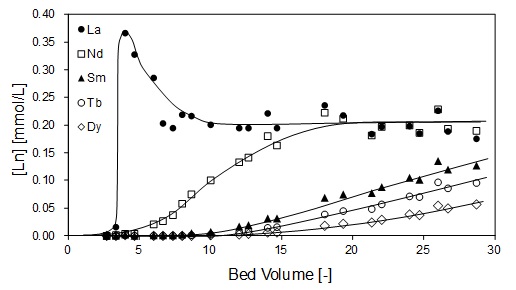
The inverted-capacitive deionization (i-CDI) technique usually employ carbon materials modified with permanently negative and positive charges for anode and cathode, respectively, where ion adsorption results from cell discharging and vice versa. Similar to the typical CDI systems, the permanently charged surface in the i-CDI cell repels ions of the same charge when the applied electric field is absent, which reduces the ion removal efficiency. In this work, MnO2 and polypyrrole-coated activated carbon (PPy@AC) with pseudocapacitive characteristics are employed as “memorized” anode and cathode in the i-CDI cell. The salt adsorption capacity (SAC) of MnO2//PPy@AC highly depends on the discharging time and the highest SAC of 27.55 mg g-1 is obtained at the 60-min discharging time. The SAC retention of this unique cell is 100% after 10 charge/discharge cycles at 1.2/0 V. The memoried desalination effect of MnO2//PPy@AC is confirmed by the unchanged conductivity of the cell when the applied cell voltage is interrupted, which has been demonstrated for water deionization and salt concentration applications.
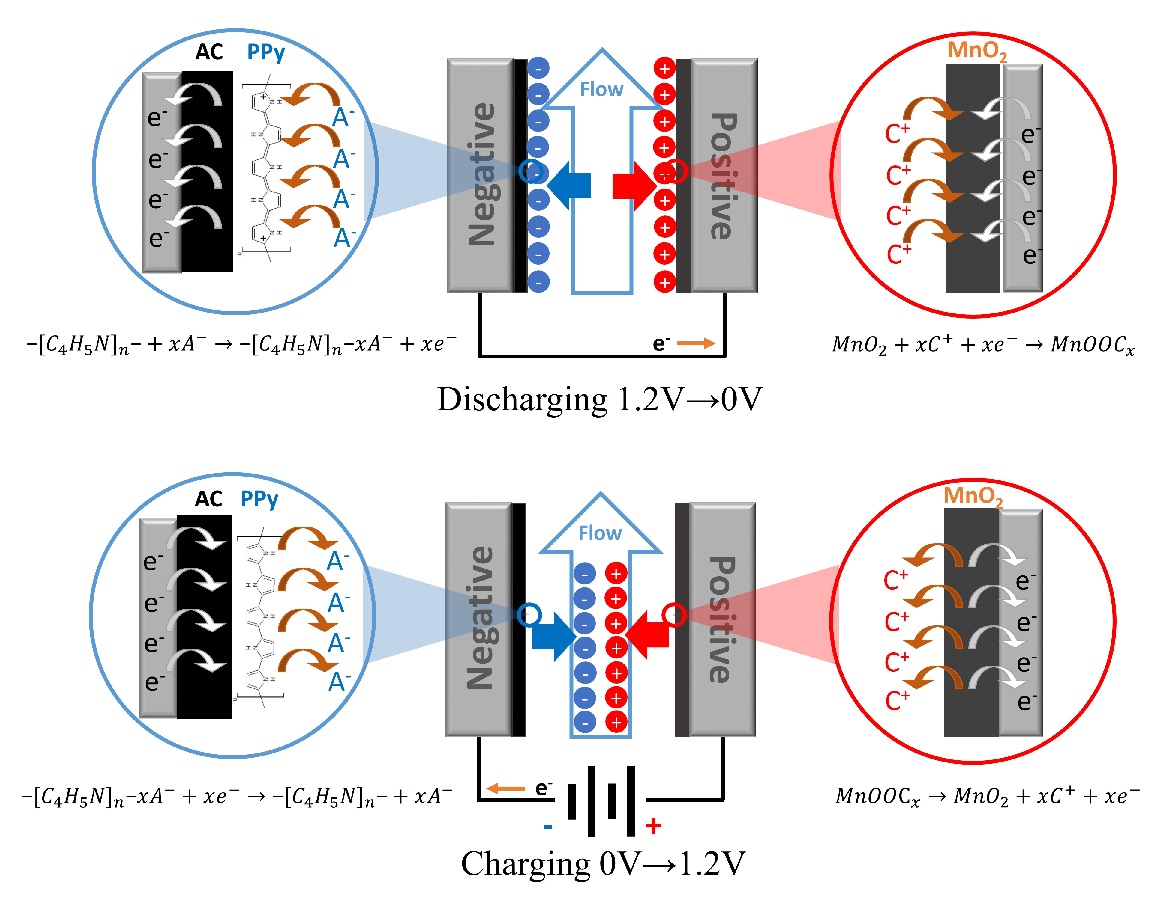
Propylene glycol is used in various foods such as coffee-based drinks, carbonated beverages and ice cream and also used as a solvent in flavoring substance. A simple method was developed for the analysis of propylene glycol (PG) in foods using gas chromatography with flame ionization detector (GC-FID). PG in foods were extracted with water-acetone (30:70) mixture solution, followed by centrifugation. The resulting solution was filtered using 0.45 μm membrane syringe filter and injected into GC. The chromatographic separation of PG was performed on DB-WAX UI column (30 mm x 0.25 mm, 0.25 mm). The calibration curves of PG were linear in the range of 0.5 to 100 μg ml-1, with good correlation coefficients (r2 > 0.999). Recoveries ranged from 83% to 119% for spiking levels of 10, 50, and 100 mg/kg PG in five samples (coffee beverage, dumpling, candy, chocolate, and snack), with relative standard deviation values below 9%. The limit of detections (LOD) and limit of quantifications (LOQ) were 0.16 mg/kg and 0.49 mg/kg, respectively. The proposed method was successfully applied to the determination of PG in foods. The detection level ranged from ‘not detected (ND)' to 2,389.6 mg kg-1. This method is suitable for routine monitoring and exposure assessment of PG.
Adiabatic gas adsorption rises the temperature of adsorption column because of the heat of adsorption, which results in the suppression of adsorption capacity and gas separation performance. We have thus focused on mixing capsules with phase change material (PCM) as a latent heat storage medium into adsorbent materials. To effectively utilize the PCM, it is essential to determine the amount of PCM. Therefore, we developed a detailed column model based on a set of partial differential equations along the column axis: each equation is based on the mass balance, heat balance, and adsorption rate equation for each component, and the adsorption amount, temperature, mole fraction of the fluid eluted from the adsorption column were obtained as a function of time.
In this study, we assumed butane adsorption on activated carbon, and the obtained temperature at the end of the adsorption column and the mole fraction of the butane eluted from the adsorption column as a function of time are shown in Figures 1(a) and 1(b). We assumed that an inert gas is used as a carrier gas and the mole fraction of butane was set to 0.0625. The adsorption column without PCM shows a sharp temperature rise due to the heat of adsorption and gradual temperature decrease due to the heat exchange with the gas flowing inside the column (Figure 1(a)), which results in an unusual breakthrough curve of butane (Figure 1(b)). On the other hand, when the capsules with PCM are uniformly dispersed in the adsorption column by the volume fraction of 0.5, the temperature becomes almost constant and the breakthrough curve of butane shows a sharp step, which suggests that the net heat of adsorption was successfully suppressed by PCM and the breakthrough behavior can be controlled by dispersing the capsules with PCM.
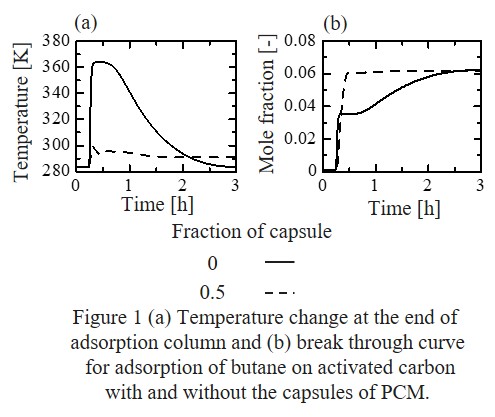
1. Introduction
The reverse osmosis (RO) membranes have been developed as polymeric membranes. Here, we have paid attention to inorganic materials such as zeolites to improve chemical resistance. Zeolite is a porous aluminosilicate with ion exchange properties. The pore sizes of zeolite can be controlled by the ion exchange. In this study, Faujasite (FAU) zeolite membranes had prepared for RO permeation. The membrane properties were controlled by the ion exchange procedures of LiCl.
2. Experiments
FAU membranes were prepared by using a secondary growth method on α- alumina substrates. Seed crystals were coated on the α-alumina substrates using a dip method. The molar ratio of the parent gel was SiO2:Al2O3:Na2O:H2O= 10.7:1:18.7:850. Hydrothermal synthesis was carried out at 90°C for 20h. Ion exchange procedures were performed in a 0.1M LiCl or NaCl solution for 16 h at room temperature. Water permeation test were performed in a 500ppm LiCl or NaCl, PEG6000 solution.
3. Results and discussions
Figure shows the time course of the permeation results of NaCl, LiCl and PEG6000 by changing the cations in the FAU zeolite membrane. The rejection through the as-made membrane (Na type) was 58% with the flux of 1.1 kg m-2h-1. While the rejection through the Li type membrane was only 3% with the flux of 6 kg m-2h-1. The membrane was not broken because the rejection increased at 45% after the ion exchange for Na type. The molecule size of PEG6000 is much larger than that FAU pores showing that the PEG6000 was permeate through the grain boundary of the FAU membrane. The size of the grain boundary must increase by the ion exchange procedure of LiCl to permeate the PEG6000. The possibility to control the permeation properties by the ion exchange procedures was shown by this experimental.
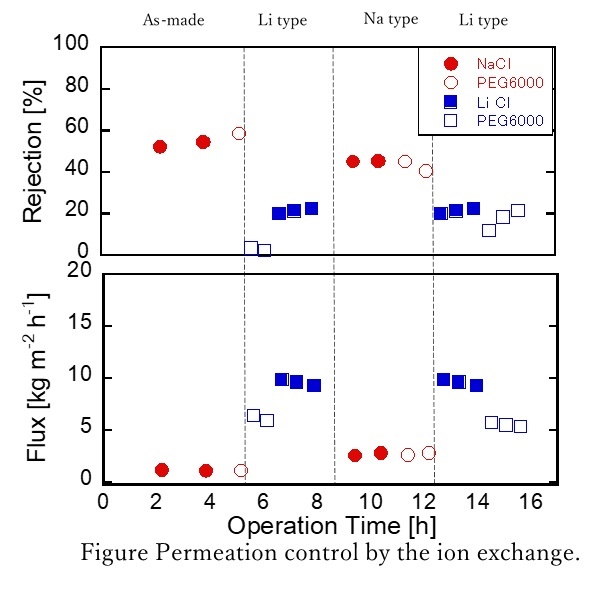
Bis(triethoxysilyl)propane (BTESP)-derived organosilica membranes have attracted a lot of attention in the high performances for hydrogen over large molecules such as C3H6 and C3H8. In the present study, the effect of acid molar ratio (AR) in sol and calcination temperature on network pore size and gas permeation property was evaluated. BTESP-derived sols were prepared with AR=10-2, 10-1, 100 and 10, and calcination temperature was controlled at 350-800oC. The effect of AR and calcination temperature on BTESP structure was evaluated by FT-IR, NMR, and N2 adsorption measurement.
Single gas permeation experiment of BTESP membranes showed high H2 permeances and high H2/SF6 selectivities. The pore size became smaller as AR decreased because condensation of much number of Si-OH groups in sol during calcination process densified the network pores. On the other hand, the pore size became larger as the calcination temperature increased because of a change in carbon structure of linking unit. Characterizations of the carbon structure by 13C-NMR measurement showed that the propylene groups were pyrolyzed and the proportion of methyl groups increased at high calcination temperature above 600oC.
In conclusions, pore size of BTESP-derived membranes can be controlled by acid molar ratio in sol and calcination temperature; dense BTESP network for separation of H2 over N2 was designed when BTESP membrane was calcined at low temperature or utilizing sol with low AR.
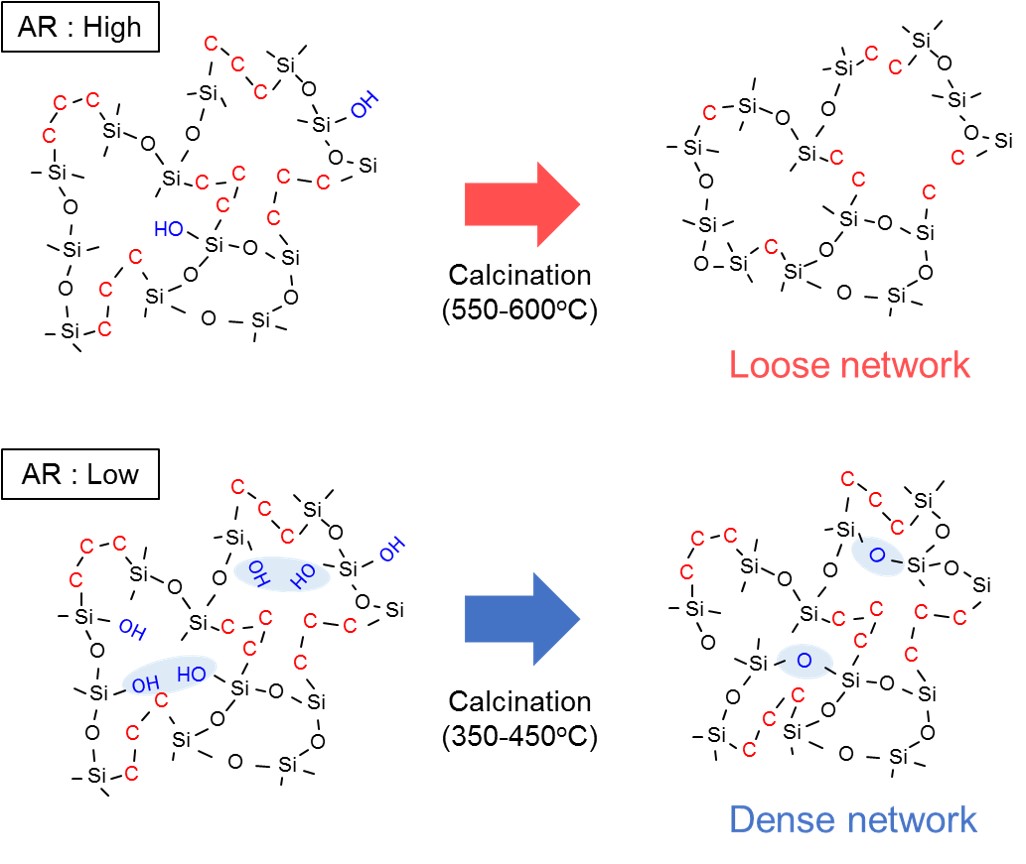
Platinum group metals (PGMs) are used not only for jewelries but also in various industrial scenes such as a catalyst, electronic components and so on. Among them, platinum, palladium and rhodium are used as an automotive exhaust catalyst for the purification of exhaust gases owing to their excellent catalytic properties. However, these resources are unevenly distributed (mostly in South Africa) and their reserves are limited. It is important to develop the recovery technique for selective separation of these metals from a spent automotive catalyst. The conventional recovery method for these metals is solvent extraction. The advantages of this method are high metal selectivity and easy back-extraction. In contrast, the use of huge amount of organic solvent is a critical environmental issue. To solve this problem, we focused on the membrane separation method. A polymer inclusion membrane (PIM) is a promising alternative of solvent extraction, which spends less organic solvent and extractant.
In our previous study, it was found that trioctyl (dodecyl) phosphonium chloride (P88812Cl) has high selectivity for platinum, palladium and rhodium as an extractant in the solvent extraction method. In this study, we prepared a PIM containing P88812Cl as an effective PGM carrier. The PIM was fabricated with the composition of 50% PVDF-HFP as a base polymer, 30% P88812Cl as a carrier and 20% 2NPOE as a plasticizer to obtain a self-standing transparent membrane. Batch adsorption and desorption experiments for Rh(III) were carried out to examine the optimum operational conditions for the membrane transport. In the membrane transport trial, the selective transport of Rh(III) over Fe(III) was conducted by using an ammonium chloride solution as the receiving phase. As a result, 60% of Rh(III) was selectively transported to the receiving phase and Fe(III) was hardly transported.
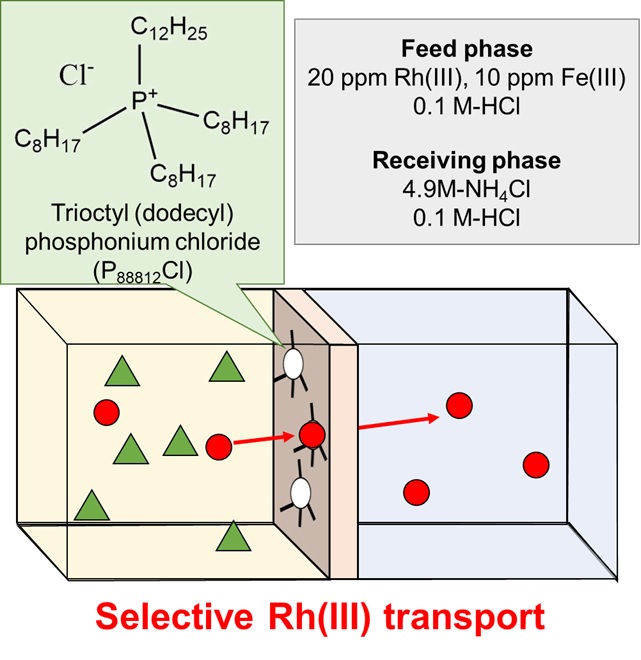
1.Introduction
Activated carbon is usually used as an adsorbent for general organic molecules in the water purifiers.However, the detachment properties of the activated carbon should be improved especially for the high temperature conditions.In this research, detachment properties of the zeolites were investigated. In order to suppress the detachment amounts, surface of the MFI zeolite particles was coated.
2. Experimental
The MFI precursor was crystallized from the parent gel of TPAOH: NaOH: TEOS: H2O: EtOH = 4.4: 0.1: 25: 756: 100 at 100 °C for 72 h.
The parent gel for MFI seed was prepared at a molar ratio of SiO2 : TPABr : NaOH : H2O : Al = 1.0: 0.1: 0.15: 50: 0.0 to 0.005. Colloidal silica was used as a silica source.After stirring at room temperature for 3 h with 1.0 g of the MFI precursor, hydro-thermal synthesis was carried out at 180 °C for 20 h in a 100 cc autoclave. The composition of the coating gel solution was a molar ratio of TPAOH: TEOS: Al: H2O =0.2:1:0.04:2501. The detachment properties were evaluated by a Thermal-weight analyzer.
3. Results and discussions
The effect of the coating on the added amount of MFI was examined. When the amount of MFI added to the coating solution was increased, the adsorption amount tended to increase. When the amount of MFI to be added was small, it was suggested that MFI crystals were dissolved during processing of the coating solution due to the effect of aluminum sulfate used as Al source.
4. Conclusion
MFI zeolite was coated by the MFI layer with low detachment properties. The amounts of seed crystals in the coating gel was important.
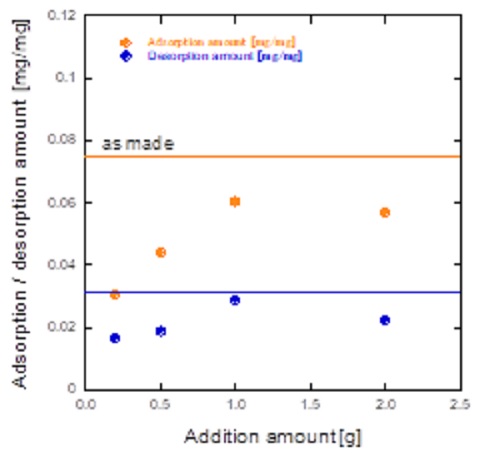
1.Introduction
Membrane separation is an important technique for saving energy. Heat and chemical resistance for liquid separation polymeric membranes should be improved to apply new application. Silica hybrid membrane have been developed by using a counter diffusion chemical vapor deposition (CVD) method. The pore sizes have been controlled by changing structure of silica precursor. The deposited membrane prepared by using Diphenyldimethoxysilane (DPhDMOS) as a silica precursor showed the H2SO4 rejection of 92%. In this study, the new silica precursor (3,3,3-Trifluoropropyltrimethoxysilane:TFPrTMOS) for the CVD was employed. The ion separation performances were evaluated for the silica membranes.
2.Experimental
A porous γ-alumina tube substrate was placed in a reactor. Deposition of TFPrTMOS and O3 was carried out for 60 min at 100~250 °C. O2 supplied at the inside of the substrate at 200 mL min-1. TFPrTMOS was supplied at the outside of the substrate by N2 bubbling at 200 mL min-1. Membrane performance after the deposition measured by liquid permeation test by using 100ppm of NaCl, Na2SO4, MgCl2, MgSO4 solution.
3.Results and Discussion
Fig.1 shows the relationship between rejection and diameter of the permeation molecules. Rejections of glucose were 60% and 33% through the TFPrTMOS and PrTMOS membranes, respectively. The neutral molecules such as glucose are separated by the molecular sieving mechanism. The difference of pore size can be explained by the higher reactivity of TFPrTMOS.
Rejections of ions were higher than those of the neutral molecules. The rejections of the divalent anions were higher than those of monovalent anions. This permeation mechanism should be based on the negatively charged for both PrTMOS and TFPrTMOS membranes. The negative charge for the TFPrTMOS membrane was lower than that for the PrTMOS membrane.The TFPrTMOS membrane showed higher glucose rejection of 60% with lower ion rejections.
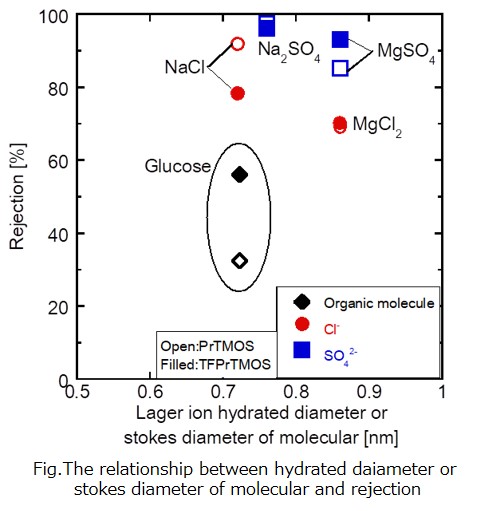
Metal-organic frameworks (MOFs) have been attracting attentions as materials for gas separation membranes. Mixed matrix membrane (MMM) is one of the methods to prepare composite membrane composed with polymer matrix and MOF particles as filler. In the case of stacking two-dimensional shape fillers horizontally in the plane of MMM, high gas selectivity can be obtained by reducing the permeation of non-permeable component. Zeolitic Imidazolate Frameworks-L (ZIF-L) is one of the two-dimensional MOFs formed by coordination bonding with zinc ion and 2-methylimidazole. In previous studies, the preparation of ZIF-L based MMMs and the increase of H2/CO2 selectivity were reported. The size of ZIF-L particles is expected to have influence on the gas permeation properties of MMMs. However, there have been no reports on the preparation and the gas permeation properties of MMMs using ZIF-L particles with different sizes.
In this study, the effect of the ZIF-L particle sizes on structures and gas permeation properties of MMM was investigated. First, ZIF-L particles with different sizes were prepared by changing the reaction time. Then, MMMs were prepared by suction-filtration of ZIF-L suspension with porous membrane support followed by complexation with polymer solution. Structural analyses of ZIF-L particles were performed using powder X-ray diffraction measurement and scanning electron microscope. Structure of the fabricated MMMs were analyzed using scanning electron microscope, and gas permeation properties are evaluated by single component gas permeation measurements using hydrogen, carbon dioxide, oxygen, nitrogen, and methane. The details will be reported in the presentation.
Silica membranes shows hydrogen permselectivity with thermal resistance and acid stability. Counter diffusion chemical vapor deposition (CVD) method is one of the method of preparing silica membranes where silica precursors and oxidants were supplied to the opposite side of the porous substrate. Membrane pore size can be controlled by changing structure of the precursor. We have been developing hydrocarbon selective or liquid separation membrane by using this technique. However, membrane deposition mechanism is not clear.
In this study, in situ gas analysis was conducted during CVD. Mass spectrometer was connected to the outlet of module of oxidant flow side. Membrane formation was evaluated by bubbling gas diffusion condition during CVD of each silica precursor.
A γ-alumina tubular support (φ:10 mm, L: 95 mm) was used as substrate. Deposition was conducted using silica precursor supplied by N2 bubbling to the outer side of substrate. Simultaneously, oxidant was supplied to the inner side of it and flow outlet was connected to the mass spectroscopy. Diffusion condition of bubbling gas was analyzed. Alkoxysilane tetramethoxysilane, tetraethoxysilane or alkyl alkoxysilane ethyltrimethoxysilane, butyltrimethoxysilane, hexyltrimethoxysilane were used as silica precursors. Deposition temperature was 270-600 °C, deposition period was 3-180 min.
The intensity of the molecular weight of 28 in mass spectrometer analysis should be N2 concentration. Diffusion amounts of N2 decreased by increasing the deposition periods. By changing silica precursor vapor concentration, membrane formation time was changed. The time was proportional to silica precursor concentration. Apparent activation energies were calculated from the decreasing rate of N2 diffusion. Activation energies of tetramethoxysilane and tetraethoxysilane were 40.9 kJ mol-1 and 74.1 kJ mol-1, respectively. The activation energies of alkylalkoxysilanes such as ethyltrimethoxysilane, butyltrimethoxysilane, hexyltrimethoxysilane were observed between 43-46 kJ mol-1 indicating the similar reaction mechanism for the tetramethoxysilane. Deposition reaction must be affected by the alkoxy group of silica precursor.
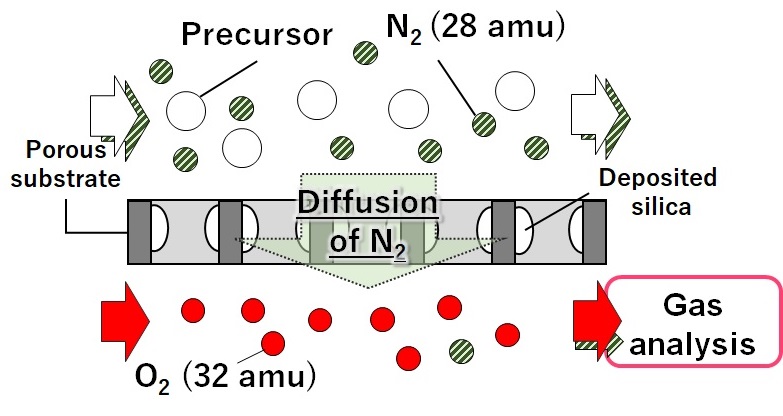
The sol-gel method was applied for the fabrication of amorphous silica membranes, which showed high H2 permselectivity. However, hydrothermal stability is not so high due to the condensation of high Si-OH density in amorphous structure. The incorporation of Si-F bounds in amorphous silica structure is an effective method to eliminate the Si-OH groups. In the present study, a molecular sieving membrane for H2 separation was fabricated using triethoxyfluorosilane (TEFS), which contains Si–F bonds and is categorized as a pendant-type alkoxysilane. The thermal and hydrothermal stability for TEFS membrane was evaluated. Tetraethoxysilane (TEOS) was used as a Si precursor to discuss the effect of Si precursor on hydrothermal stability and network pore size of silica membrane. TEFS membranes showed high H2 permeance (>1.0 × 10-6 mol m-2 s-1 Pa-1) and approximately the same pore size distribution, irrespective of calcination temperature (350, 550 and 750oC) due to the low Si-OH density in the amorphous structure, which could prevent the densification of network caused by the condensation of Si-OH groups during calcination process. TEOS membrane showed drastic decrease in H2 permeance of 80% and did not reach a steady-state even under mild steam condition (300oC, partial pressure of steam : 30 kPa). On the other hand TEFS membrane showed a decrease in H2 permeance less than 20% and reached a steady-state. In addition to this, TEFS membrane showed high H2 permeance (>1.0 × 10-6 mol m-2 s-1 Pa-1) and stable membrane performance even under severe steam condition (500oC, partial pressure of steam : 90 kPa). In conclusions, the hydrothermal stability of fluorine-SiO2 membrane was dramatically enhanced due to smaller number of Si-OH groups in the amorphous structure.
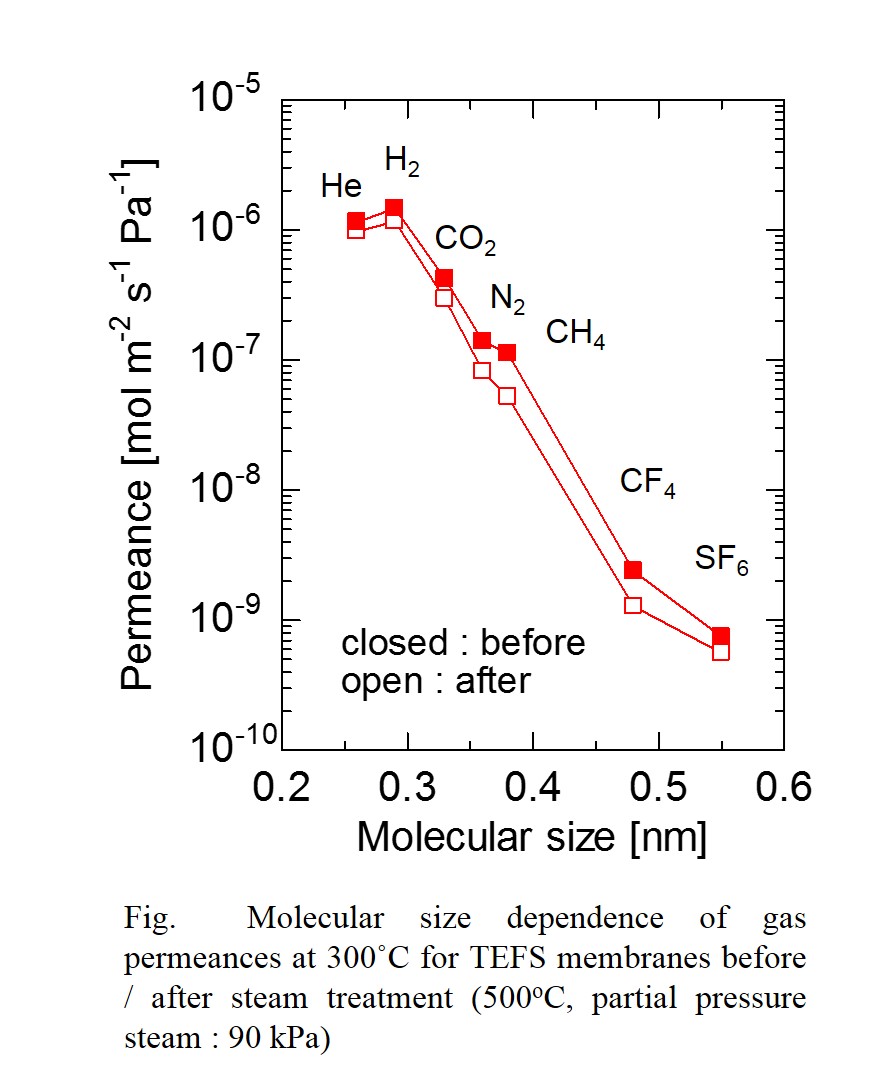
This study introduced a new synthetic route for fabrication of organosilica membranes on porous substrates by in-situ polymerization of liquid precursors initiated by atmospheric-pressure plasma jet. In this work, porous substrates were impregnated with 1,2-bis(triethoxysilyl)ethane (BTESE) as a monomer of organosilica, and then irradiated by the atmospheric-pressure plasma jet from upper surface of the substrates to polymerize the liquid monomers. Since reactive species generated in the plasma are supplied from the gas phase, the polymerization of liquid monomer can occur only at the gas-liquid interface. Therefore, it is expected that a very thin polymerized-layer can be obtained on substrates. Furthermore, in this process, not only volatile precursors but also non-volatile precursors can be used, which enables to control structure using various precursors. The chemical structure and the morphology of the resultant organosilica thin layer were evaluated by Fourier transform infrared spectroscopy (FTIR) and scanning electron microscopy (SEM), respectively. The gas permeation property was investigated using pure gases of different molecular sizes. After plasma irradiation, the polymerized layer with thickness of 200 nm was obtained on the outermost surface of the substrates, and all gas permeance decreased and permeance ratio increased. This result indicates that the polymerized layer is effective for gas separation. The permeance ratios for He/N2 and He/SF6 were found to be 25 and 1500, respectively.
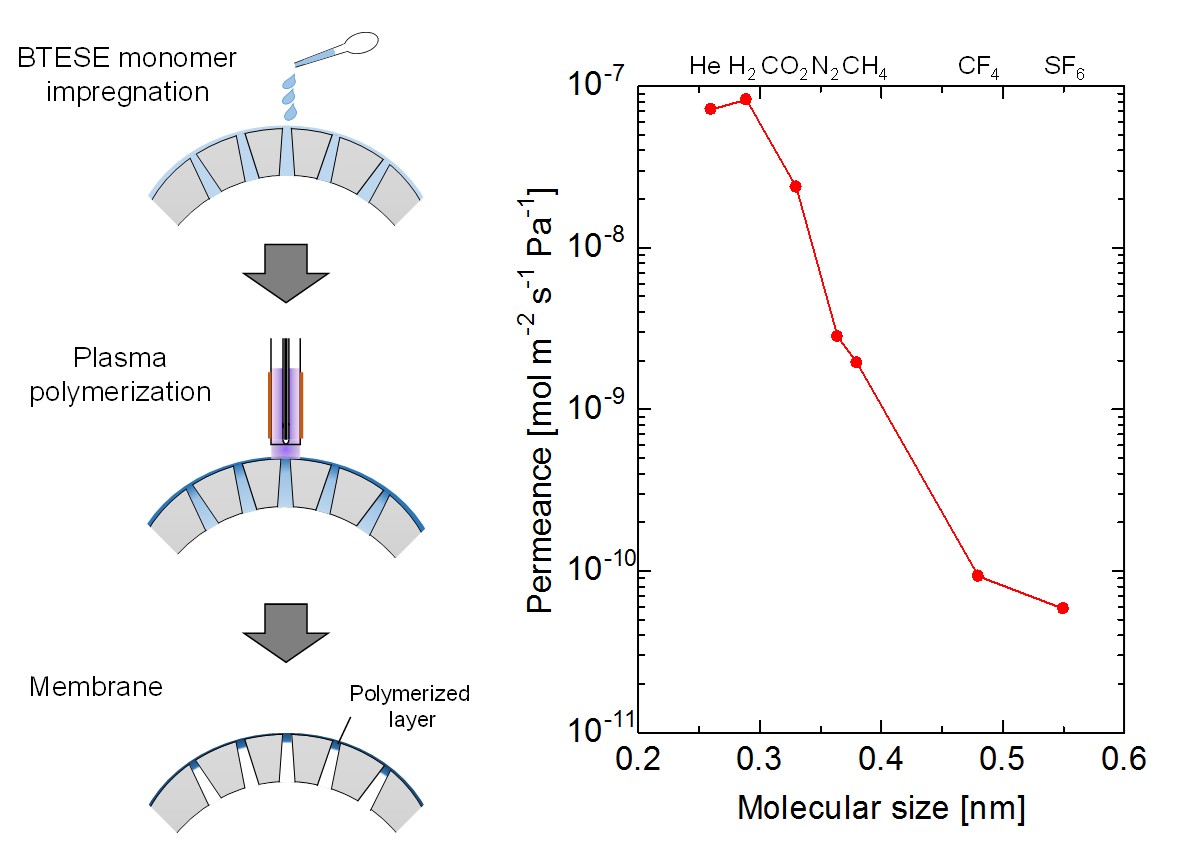
The Normalized Knudsen-based Permeance (NKP) method was useful for evaluation of sub-nano scale pore size in a range of 0.3-0.6 nm on microporous ceramic membranes for gas separation.1). However, the calculated pore size by the NKP method is affected by a small amount of larger pores or pinholes because this method can evaluate only average pore size. In this study, we evaluated relatively larger micropores around 1 nm based on the micropore filling phase permeation.2) Gas permeation properties thorough a micropore at temperatures below critical temperature, Tc were examined. Even if the bulk pressure is lower than a saturation pressure of the permeation gas, a potential field in a micropore would effectively work to compress the permeant and a liquid-like high density phase would be formed in pores. This phenomenon is ‘micropore filling phase permeation'. The formation of such a micropore filling phase leads to decrease the permeance. According to the Polanyi's adsorption potential theorem, the relation between the filling pressure pf and the potential energy EP is given by Eq. 1 (Fig. 1a). We calculated pore size dependence of EP and evaluated pore size distribution from pressure dependence of condensable gas permeance based on the Polanyi's adsorption potential theorem3). Several types of condensable gas species were employed as permeating and filling gases. Fig. 1b shows an example of pressure dependence of SF6 permeance. The pore size distribution was calculated from the slope of permeance as a function of pressure based on micropore filling model. These results suggested that large pores of 1.0-1.2 nm could be well evaluated by this method.
References
[1] T. Yoshioka, et al., AIChE J., 59, 2179 (2013), [2] T. Yoshioka, et al., J. Chem. Eng. Jpn., 46, 659 (2013), [3] T. Yoshioka, et al., Trans. Mater. Res. Soc. Jpn., 29, 3247 (2004).
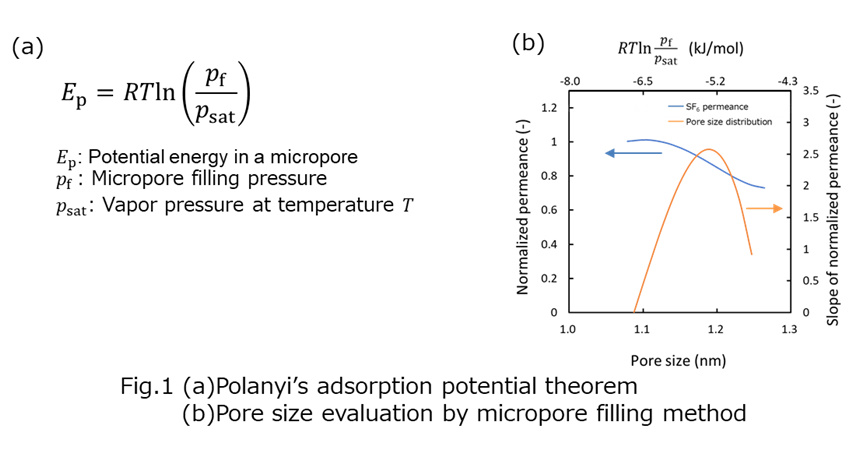
Currently, heavy metal contamination has become a severe environmental issue, because of the exponential increase in the use of heavy metal compounds in various industrial processes. Removal of toxic heavy metal ions has become a top priority in wastewater treatment. Various membrane-based technologies have been applied for this purpose and forward osmosis (FO) is the latest technology. The FO is more promising than others due to several advantages. In the present study, FO technology has been applied for removing chromium (Cr) from the water to elucidate the comparing the removal efficiency.
FO was conducted with under various Cr concentration in the feed solution for each experiment. NaCl solution (0.5 M – 2 M) was used as draw solution of FO. After the system was stabilized (~ 30 min), the samples were collected in 60 min intervals for 5 h from a 0.5 L reservoir of the feed and draw solution to measure the total Cr concentration.
The effect of pH on the removal efficiency of Cr(III) and Cr(VI), and water flux (Jw) was shown in Figure 1. Due to the change of the ionic forms, the water flux for Cr(VI) was slightly bell shape against pH.. The water flux for Cr(VI) was higher than that for Cr(III). Rejection of Cr(VI) was increased with increase in pH, because of electrostatic repulsion and large hydrated radii (0.461 nm) of Cr(VI). In the case of Cr(III), much higher rejection ca be obtained, because its hydrated radii is larger than that of Cr(VI).
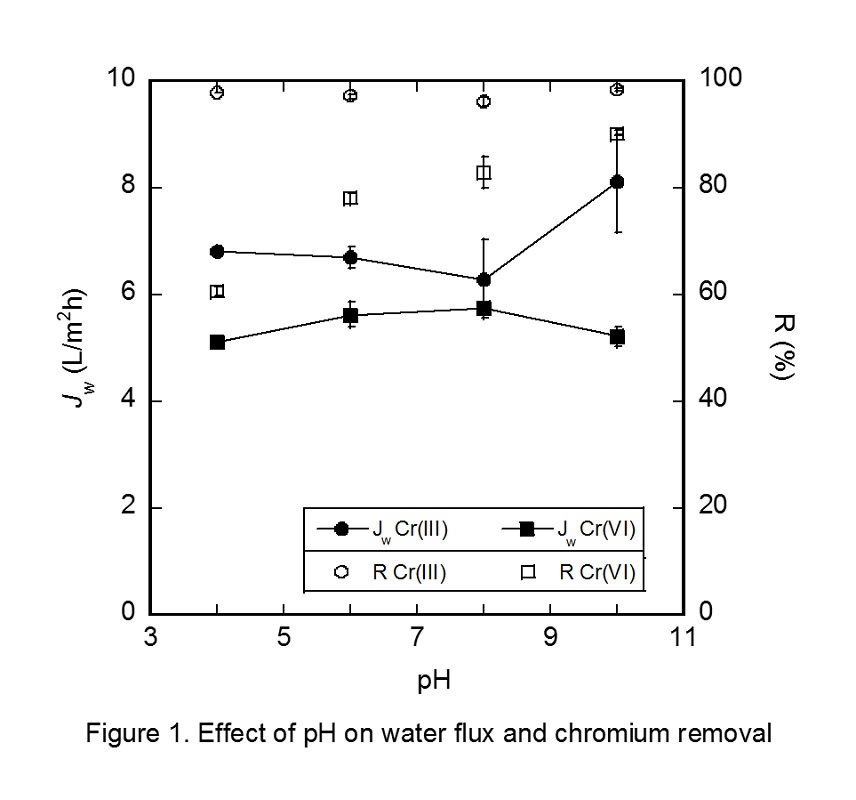
A new type of indium recovery method from acid leach solution of waste liquid crystal by using bipolar membrane electrodialysis (BPED) was developed. A chelating agent such as EDTA is added to an acid leach solution containing indium, tin, and aluminum ions, under which indium ions selectively form a chelate complex. The solution is then introduced to BPED system; only indium-EDTA complexes, negatively charged, are transported towards the anode side, while other metal cations are transported towards the cathode side. We examined the effects of operation conditions of BPED on the indium separation performances from a model acid leach solution, to clarify optimum operation conditions.
A laboratory-scale BPED setup used is a stack of five three-cell units composed of two bipolar membranes, an anion exchange membrane, and a cation exchange membrane. A model acid leach solution containing In(NO3)3 (0.02 M) and Al(NO3)3 (0.02 M) with EDTA was supplied to the feed cell and circulated. HNO3 (0.01 M) was circulated through the recovery cells of anions and cations, respectively. The effects initial pH, initial [EDTA]0/[In]0 ratio of the feed solution, and the voltage on the indium recovery performances, recovery ratio and selectivity, were examined.
For the constant [EDTA]0/[In]0 = 1 and the voltage at 20 V, the highest selectivity and the highest recovery ratio were obtained when the initial pH was about 2.5. Under the constant voltage at 20 V and the initial pH at 2.5, the recovery ratio increased with increasing the [EDTA]0/[In]0 ratio up to 2, but the selectivity was highest for [EDTA]0/[In]0 = 1. For the constant [EDTA]0/[In]0 = 1 and the initial pH at 2.5, the higher voltage resulted in the higher selectivity and recovery ratio up to 30 V. However, the specific power consumption for indium recovery was lowest for the voltage at 5 V.
Two-dimensional (2D) stacked nanosheet membranes have been expected as next generation membrane because of the ultrathin thickness and unique nanochannel. These membranes are formed by assembling single molecular sheets on support membrane by vacuum filtration etc. . Graphene oxide (GO) is one of the 2D material with specific property including good mechanical strength and surface charge. Therefore, GO is mostly used as nanosheet membranes and the fabricated GO membranes show high rejection for anionic molecules. However the instability of GO membrane in water is serious problem for their application. Recently, we have developed stable stacked nanosheet membrane using niobium oxide (NbO) nanosheets. The stacked NbO membranes had a dense structure formed by the chemical cross-linking between nanosheets and showed high stability during water filtration test. In this study, the composite membranes including two different layered structure utilizing NbO and GO nanosheets were fabricated to improve the performance for nanofiltration membrane. The weight ratio of NbO to GO (NbO / GO) was 55/45. The membrane having GO layer on NbO layer (Layered type) showed over 90% rejection of Na2SO4. That value was about 2 times higher rejection compared with that for NbO membranes with similar water permeability (Fig.1). This composite membrane also showed higher rejection of Na2SO4 than GO membranes with cross-linking agent. In additions, this membrane also showed higher rejection of NaCl than NbO and GO membranes. The differences of surface charge and structure of nanochannel between these membranes is discussed.
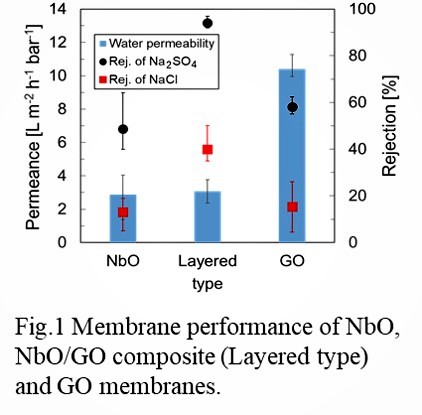
Organic solvent nanofiltration (OSN) is one of the emerging separation technologies in extensive processes for the purification or separation of organic solvents. However, OSN membranes are rarely applied in many chemical processes, because OSN membranes have poor stability and permeability in a variety of strong organic solvents. In order to overcome these drawbacks, OSN membranes were fabricated by thermally induced phase separation (TIPS) method using polyamide 6 (PA 6). OSN membranes are expected to be used in many organic solvents. Therefore, the relation between solvent property and filtration performance was investigated using various solvents. The result showed correlation between permeability and solvent property such as viscosity, absorbed amount in PA 6 (Fig.1). In conclusion, the permeability performance in PA 6 membrane could be estimated before filtration.
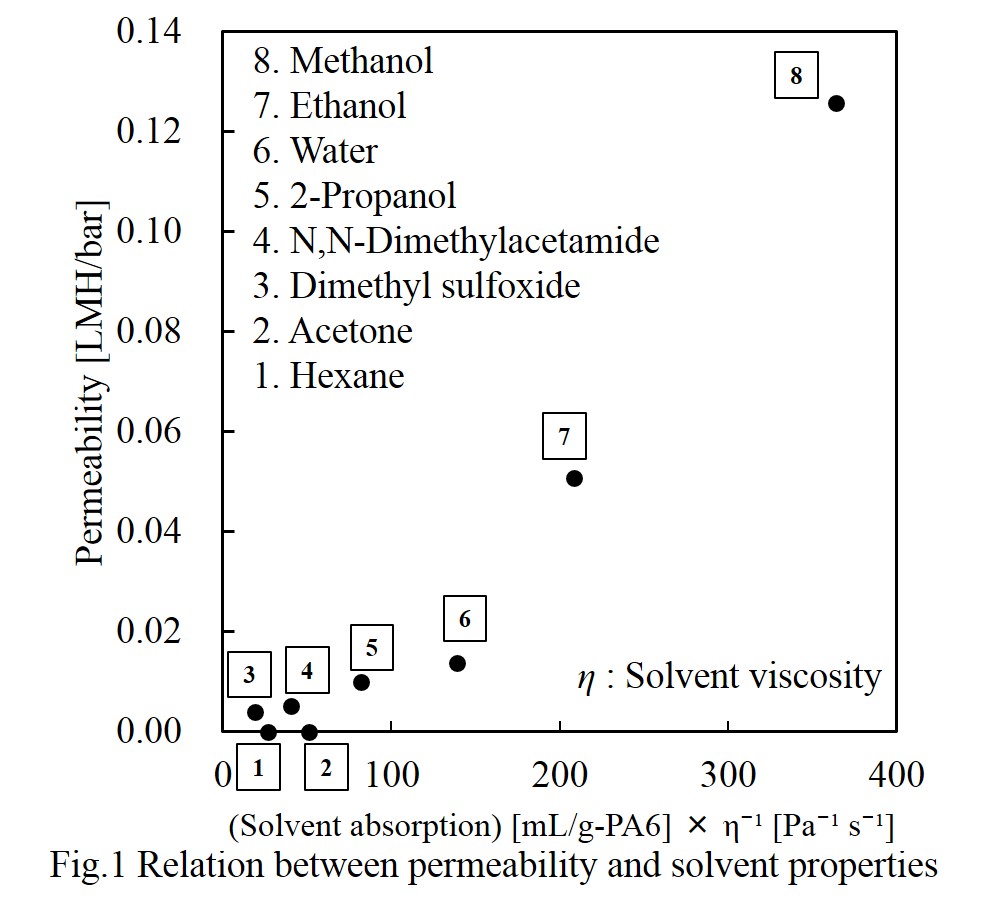
Metal organic frameworks (MOFs) have attracted attention as novel materials for catalysis, adsorption and membrane separation. Zr-based UiO-66 families are known as MOFs with remarkably high thermal and chemical stability. UiO-66-(COOH)2 consisting of pyromellitic acid (BTeC) and Zr cluster was predicted to be a suitable material for CO2 separation. However, compared to UiO-66 using telephthalic acid as organic linker, the extra two carboxyl groups of BTeC also form coordination bonds, inhibiting to form framework properly. This would make successful synthesis of UiO-66-(COOH)2 with high crystallinity difficult. Thus, no publication has reported successful synthesis of UiO-66-(COOH)2 membrane so far. Here, we investigated a preparation method of UiO-66-(COOH)2 membrane and evaluated its gas permeation property.
UiO-66-(COOH)2 membrane was prepared on a porous α-alumina support by secondary growth method. The support was immersed in a Zr source solution, and then UiO-66-(COOH)2 seed crystals were prepared on the surface of the support by solvothermal synthesis. The seed crystals were secondarily grown to a membrane under solvothermal condition. The gas permeation property of the membrane was evaluated by single-gas-permeation test.
Monocarboxylic acids such as acetic acid (AcOH) can compete with organic linkers and produce crystal growth in a preferred direction, because they have only one coordination site. Thus, the effect of AcOH as a solvent on the membrane preparation was investigated, and as a result, a continuous UiO-66-(COOH)2 membrane could be successfully synthesized as shown in Figure. From the single-gas-permeation test at 293 K, ideal separation factors of H2/N2 and CO2/N2 were found to be 4.41 and 0.93, respectively. The higher ideal separation factor of H2/N2 than the theoretical value for Knudsen diffusion control implies the membrane had few defects in the separation function layer. On the other hand, the ideal separation factor of CO2/N2 indicates this membrane was slightly CO2 selective.
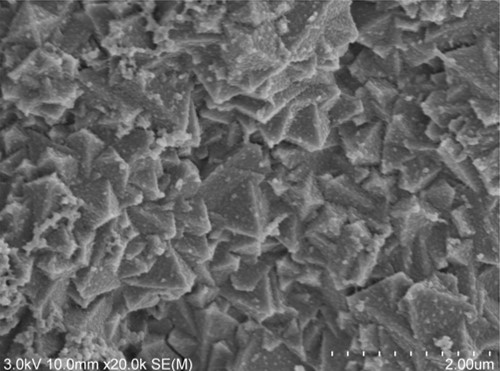
Silicon carbide (SiC)-based membranes were by coating allylhydoridopolycarbosilane (AHPCS) as a precursor of the separation layer, followed by sintering at 300-800 °C. SiC-based membranes showed molecular sieving performances for gas separation. A membrane pyrolyzed at 700 °C showed high permeance and permeance ratio, as H2 permeance of 3.3 × 10-6 mol / (m2 s Pa) and H2/SF6 permeance ratio of >10000. On the other hand, SiC-membranes pyrolyzed at 800 °C showed lower permenace and permeance ratio, due to densification of SiC porous networks. In addition, we found that SiC-based membranes pyrolyzed at high temperature showed high thermal stability and oxidation resistance. This is probably because by pyrolysis at high temperature, hydrosilyl group (Si-H) formed silicon-carbon group (Si-C) and Si-Si bonds which have thermal stability and oxidation resistance.
In recent years, forward osmosis (FO) process is attracting research attention to overcome a global water shortage. FO is a remarkable membrane separation technology utilizing an osmotic pressure gradient between solutions across a semipermeable membrane. FO processes have great advantages of lower energy consumption and less membrane fouling compared with pressure-driven membrane processes such as reverse osmosis (RO). In FO processes, it is important to develop a superior draw solution with high osmotic pressure, easy regeneration and low solute leakage. Our research group has been searching for better materials as a draw solute to put FO process into practical use in a few years. In this study, block co-oligomers with different numbers of branches were developed as a novel thermoresponsive draw solute for FO (Figure).
A series of the block co-oligomers were systematically designed and synthesized. The average degrees of polymerization of ethylene oxide and butylene oxide units of the block co-oligomers were varied to control the hydrophilic/hydrophobic balance of the molecules. The numbers of branch of the block co-oligomer was also controlled by changing the center molecule. Most of them showed lower critical solution temperature type phase separation at temperatures below 60 °C.
Aqueous solutions of the block co-oligomers were evaluated in terms of their phase diagrams, osmotic pressures and viscosities. The osmotic pressure of the dense phase the block co-oligomers were high enough to draw water from 0.6 M NaCl (model seawater) with high flux. Moreover, the leakage of branched block co-oligomers were much lower than that of conventional draw solutes due to the steric molecular structure. Meanwhile, the osmotic pressure of the dilute phase of the block co-oligomers solution were very low and reduced energy consumption during post-processing by low-pressure RO to collect pure water.

Organic chemical hydrides such as cyclohexane, methylcyclohexane, and decaline are promising hydrogen storage transport and production materials. Their dehydrogenation reactions have been extensively investigated to produce highly pure hydrogen supplied for polymer electrolyte fuel cells. Highly efficient hydrogen purification systems are thus required, and membrane separation technology is expected as an energy conservation technology in hydrogen purification from such hydrides. Carbon membranes are one of the strong candidates applied for these separations due to the good gas separation performance and the high chemical resistance. We have investigated carbon hollow fiber membranes based on poly(phenylene oxide) (PPO) and its derivatives as a novel polymeric precursors. Recently, the development of flexible carbon hollow fiber membranes was successfully achieved using sulfonated PPO (SPPO) as a precursor polymer.
In this study, the separation of hydrogen and toluene converted from methylcyclohexane as the organic chemical hydride was investigated using SPPO carbon hollow fiber membranes. Highly hydrogen selective carbon membranes were prepared by using one-step chemical vapor deposition (CVD) method. In addition, energy requirement for ultrapure hydrogen purification process by means of carbon membranes was evaluated and compared with that of pressure swing adsorption (PSA) method.
Removal of heavy metal ions in environmental water is an important issue because of its high bioaccumulation potential and high toxicity. The insolubilized alginate membrane was obtained by drying the soluble alginate solution, followed by crosslinking with calcium ion. The alginate membrane had smooth surface and applicable mechanical strength for practical use. Isothermal ion-exchange adsorption of Cu2+ in batch process was conducted on alginate membranes obtained. The result was consistent with the Langmuir type isotherm, and the Cu2+ ion-exchange capacities were estimated by fitting of the experimental data. It was found that the ion-exchange capacity of the alginate membrane was equivalent to alginate gel beads. For an improvement of water permeability, polyethylene glycol was added in the casting solution before drying process, and then, was removed from the prepared membrane. The permeation flux of the membrane was determined from the amount of pure water permeated under pressure and its value increased with the amount of polyethylene glycol added in the casting solution. An in-line removal experiment using the prepared membranes was also attempted and succeeded in removing Cu2+ ion under flowing condition. In addition, novel calcium alginate membrane embedded with zeolite as an ion-exchange material was successfully prepared for heavy metal ions removal from aqueous phase. The zeolite-embedded membranes were also subjected to ion-exchange tests in a batch process, because of its applicable mechanical strength. As a result, ion-exchange capacities of membrane were increased compared to the alginate membranes mentioned above, though ion-exchange of zeolite contained in the membrane was slightly inhibited by inclusion in the membrane. The biocompatibility of alginate is widely confirmed in vitro as well as in vitro. Therefore, the membrane is expected to behave well in various water purification processes, particularly for water resources and drinking products.
Ceramic membranes have the advantage of high mechanical strength, chemical resistance and thermal resistance. Development and many research works of silica (SiO2) membranes, titania (TiO2) membranes and zirconia (ZrO2) membranes have been conducted [1,2]. Amorphous SiO2 membranes can have suitably controlled pore size for gas separation. However, it has been reported that SiO2 was dissolved and densified by being exposed to water, resulting in degradation of membrane performance. On the other hand, ceramic materials such as TiO2 and ZrO2 have excellent resistance in water , and have been put to practical use for various waste liquid treatments as ultrafiltraton (UF) membranes and nanofiltration (NF) membranes. However, since these are crystalline materials, it is difficult to control fine pore size for gas separation.
In this study, in order to control pore size, we focused on Gallate-based organic chelate ligands having ester groups of various lengths in the side chain of the benzene ring in the TiO2-ZrO2 material. In particular, we aimed at more precise pore size control of TiO2-ZrO2 composite membrane by using Methyl Gallate (MG) with the shortest side chain among them. TiO2-ZrO2 colloidal sols whose colloid size was well controlled to be nano-scale were prepared. The sol was coated on α-alumina support and fired to obtain TiO2-ZrO2 ceramic membranes. TiO2-ZrO2-MG composite membranes were prepared, and the permeation characteristics of various gases were evaluated using a pressurized gas permeation apparatus. As the results, end of the ester group of MG was to be decomposed with increasing temperature. Differences in gas permeance of TiO2-ZrO2-MG membranes with varying porous structure were observed.(Fig.)
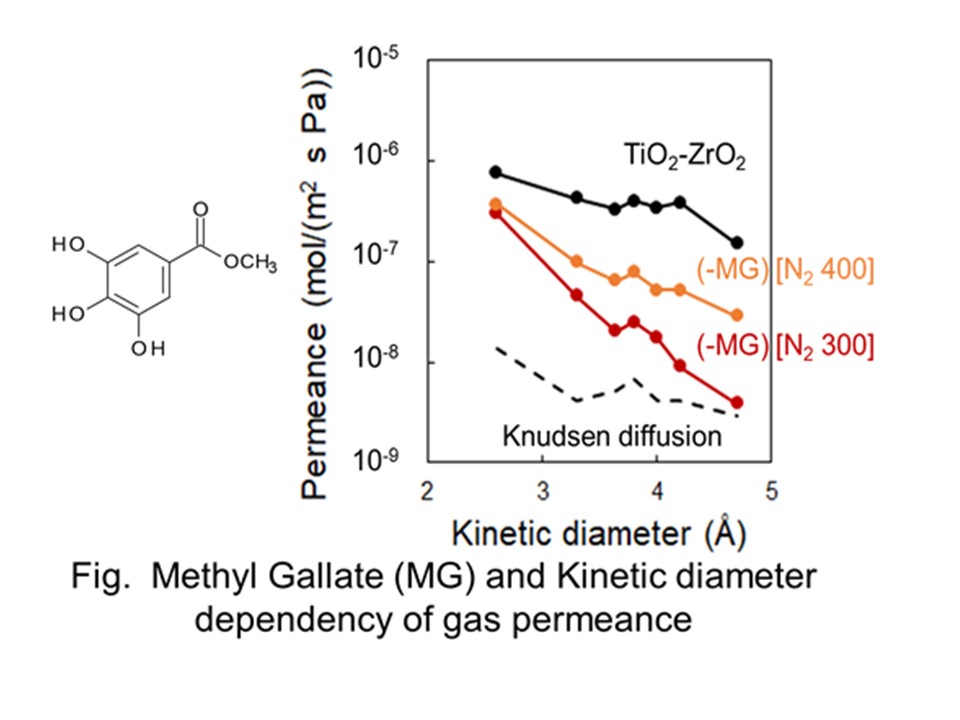
High silica Y-type zeolite (USY) are industrially used as catalysts for fluid catalytic cracking (FCC) of heavy gas oil. Products are generally gasoline fractions through a series of reactions such as cracking and isomerization, and recently the severity of decomposition has often been increased to increase the propylene yield. In comparison with conventional catalytic reactions, the contact time can be shortened by using catalyst membrane where reaction occurs in the course of the permeation of feed through a membrane. Thus, one can anticipate to improve selectivities to intermediate products during catalytic cracking with catalytic membrane reactors. In this study, we investigated synthesis of high silica Y-type zeolite membrane and its catalytic performance for n-hexadecane cracking.
Y-type zeolite membrane was synthesized on a tubular porous α-alumina support by a secondary growth method using seed crystals. Thereafter, the resulting Y-type membrane was subjected to be dealuminated by combining steaming and EDTA treatment. Dealuminated treatment was performed by steaming at 300°C for 30 min and successive EDTA treatment in an ice bath for 30 min. This treatment was repeated multiple times. Pt was loaded on Y-type membrane by an ion exchange method to obtain Pt-Y membrane. Cracking was carried out at 573 K through Pt-Y membrane for a mixture of H2 and n-hexadecane (9:1).The dealuminated treatment increased Si/Al ratio of Y-type membrane from 1.86 to 2.24. Table 1 shows the catalytic test result using n-hexadecane through Pt-Y membrane. Interestingly, C6 spices were only obtained with a high selectivity above 99% in the liquid component at 48.9% of the level of conversion of n-hexadecane. A trace amount of C4 spaces were observed in the gas product.
It was suggested that excess decomposition was suppressed when the contact time was shortened by using catalytic membrane.
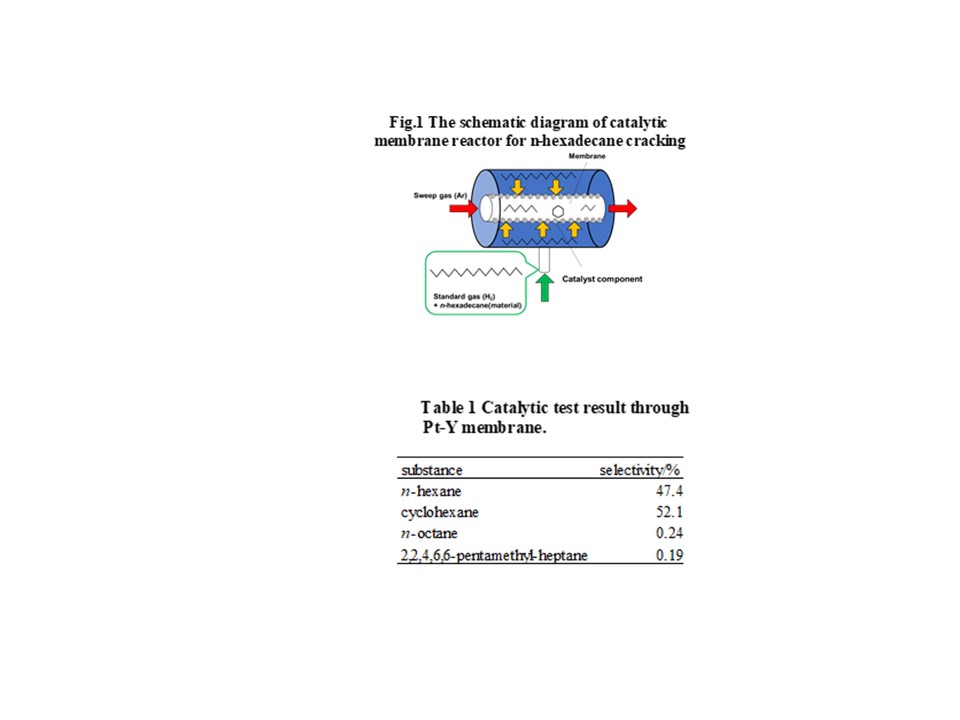
Global demand of platinum group metals (PGMs) has been continuously increased year by year, however, the resources are strictly limited. To address this issue, recycling of end-of-life products was often carried out in industrial processes, but the separation among PGMs is one of the difficult challenges. Metal recycling requires a separation process to ensure high recovery and purity. Membrane transport is one of the most effective methods for metal separation. This technique may provide a cheaper and more environmentally benign process compare to the conventional hydrometallurgy process i.e. solvent extraction. In this work, we show a successful separation of palladium(II) and rhodium(III) in a chloride solution using a polymer inclusion membrane (PIM) transport system. The PIM consists of three components, which are poly(vinylidene fluoride-co-hexafluoropropylene) (PVDF-co-HFP) as a polymer base, 2-Nitrophenyloctyl ether (2NPOE) as a plasticizer and an ionic liquid namely trioctyl(dodecyl) phosphonium chloride (P88812Cl) as a carrier, where P88812Cl was recently developed as an extraction solvent for PGMs. The performance of separation and recovery of the metals was examined with a transport apparatus. The effects of PIM composition and experimental conditions on the separation efficiency were systematically investigated. By properly adjusting the HCl concentration in the feed solution and the concentration of thiourea used for Pd(II) stripping in the receiving solution, separation of Pd(II) from Rh(III) with 98% recovery and 99% purity was achieved. Membrane stability is essential to the success of membrane separation. We demonstrate the high stability of the PIM by 7-cycles of membrane transport experiments.
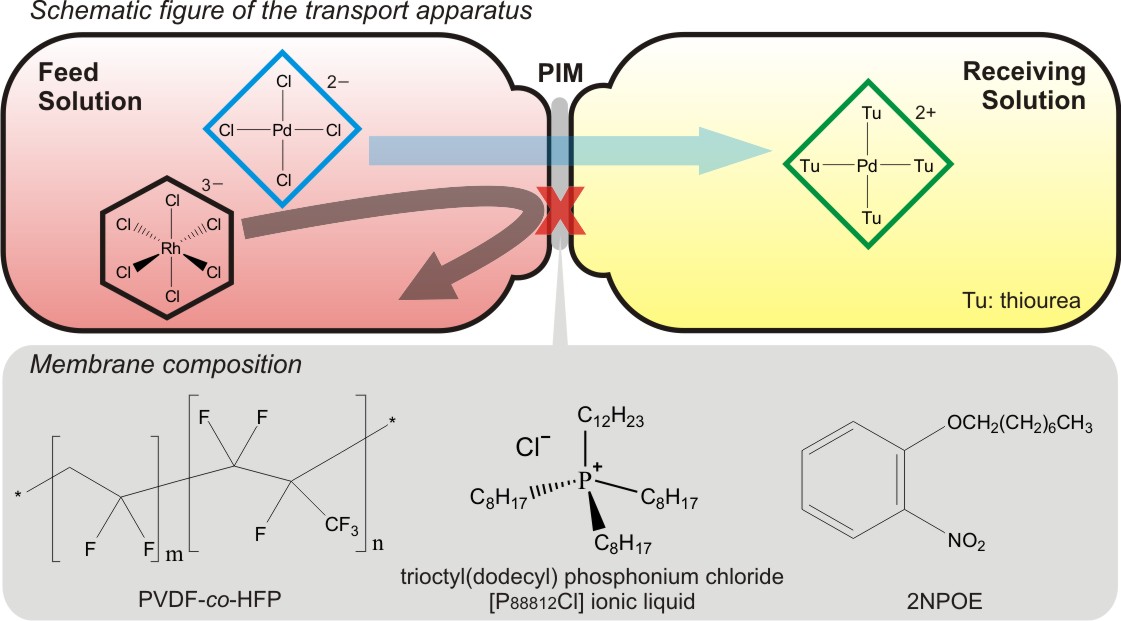
In recent years, the use of bio-alcohol, which is one of the renewable energy sources, has been recommended as an approach to depletion of fossil resources and global warming. However, the concentration of bio-alcohol produced by fermentation is too low, and concentration and dehydration are required to use it for industrial application. Moreover, since the separation process by distillation currently used requires a large amount of heat energy, energy saving is needed.
The membrane separation technique has attractive attention as an energy-saving separation technology to replace distillation. Membranes can selectively permeate the target molecular, and the separation properties are controlled by preparation material. Recently, zeolite has attracted attention as a membrane material because of the characteristic properties; uniform pores at the molecular level and adsorption property controlled by the composition of the framework component (Si/Al ratio). Therefore by using a hydrophobic zeolite composed of pure silica (Si/Al=∞) as the membrane material, it is possible to develop a separation membrane that selectively recovers only hydrophobic molecules such as bio-alcohol.
However, the permeability of existing hydrophobic zeolite membranes, MFI-type zeolite membranes, is generally low. Therefore, many membranes need to be used in order to gain throughput, which leads to high separation costs. Since the zeolite membrane separates through the pores of zeolite, its permeability is strongly dependent on the pore size. So, we focused attention on *BEA-type zeolite with larger pore size than MFI-type zeolite and the influence of synthesis conditions was investigated in detail. As the result, a pure silica *BEA-type zeolite membrane were successfully prepared, and it exhibits PV performance with a separation factor of 229 and flux of 0.62 kg m-2 h-1 for 1.0 wt.% n-butanol/water mixtures at 318 K, and is higher than that using pure silica MFI-type zeolite membrane.
Blend membranes of poly (vinyl chloride) (PVC) and poly (vinyl alcohol) (PVA) were prepared, and applied to the separation of liquid mixtures of ethyl acetate and toluene. A solution of PVC and PVA in N, N-dimethylacetamide was casted onto a glass plate, and dried under vacuum to obtain a dry membrane (thickness ~ 100 μm). The weight ratio of the polymers in the casting solution was fixed at 8 wt%, and the ratio of PVC to PVA was changed. The membranes were applied to the pervaporation (PV) experiments; the feed solution was an equal-weight (50/50) mixture of ethyl acetate and toluene, which are major volatile organic compounds (VOCs) used in printing industries. The PV was conducted at room temperature, and the downstream side was kept vacuum (~ 5 mbar). Almost no flux was obtained for the pure PVA membrane, while the pure PVC membrane was dissolved in the feed solution. With increasing the PVC ratio in the PVC/PVA blend membrane, the flux increased as shown in Fig. 1. The PVC/PVA blend membranes were ethyl acetate selective, and the weight fraction of ethyl acetate in the permeate increased with increasing PVC ratio. However, the PVC/PVA blend membranes with the PVC ratio higher than 40% were dissolved in the feed solution. The flux and the weight fraction of ethyl acetate in the permeate for the PVC/PVA blend membrane (PVC/PVA = 40/60) were, 142.5 g h-1 m-2, and 70%. According to the Hansen's solubility parameters, the distance between PVC and toluene (7.4) is larger than that between PVC and ethyl acetate (4.9). The distance between PVA and toluene is also larger (18.2) than that of PVA and ethyl acetate (12.0). This is consistent with PVC/PVA blend membranes being ethyl acetate selective, and the increase in the flux with increasing the PVC ratio in the PVC/PVA blend membranes.
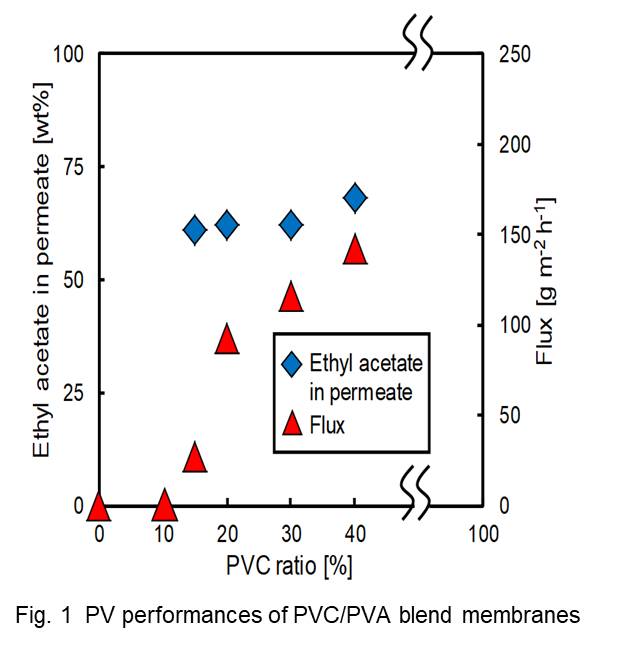
Membrane separation of organic solvents is expected as a low energy cost separation. Currently, polymer membranes are widely used for water treatment, and have the advantages of being inexpensive and easy to fabricate. However, polymer membranes have the possibility of dissolution and swelling in organic solvent conditions, so it is necessary to study the improvement of organic solvent resistance. We reported polyamide (PA) thin film composite (TFC) membrane using polyketone (PK) support membrane with organic solvent resistance. However, this support membrane is applied to the forward osmosis (FO) membrane method, and it is also necessary to improve the pressure resistance in order to use it in the reverse osmosis (RO) membrane method. The pressure resistance improvement was achieved by controlling the preparation conditions of the PK support membrane and combining the non-woven fabric. Further, the PA-TFC membrane was fabricated by forming a PA active layer by an interfacial polymerization on this non-woven composite PK support membrane. The membrane performance of water permeability and NaCl rejection was evaluated by RO test. This membrane had commercial RO membrane level performance and pressure resistance up to 30 bar. In addition, the permeability of each of the following pure solvents was evaluated by RO test (Fig. 1) : water, methanol (MeOH) , ethanol (EtOH) , 1-propanol, 2-propanol, N-Methyl-2-pyrrolidone (NMP) , and dimethyl sulfoxide (DMSO) . 1-propanol and 2-propanol did not permeate through the PA-TFC membrane. Also, the permeability was not correlated with the reciprocal of the viscosity (1/η) .
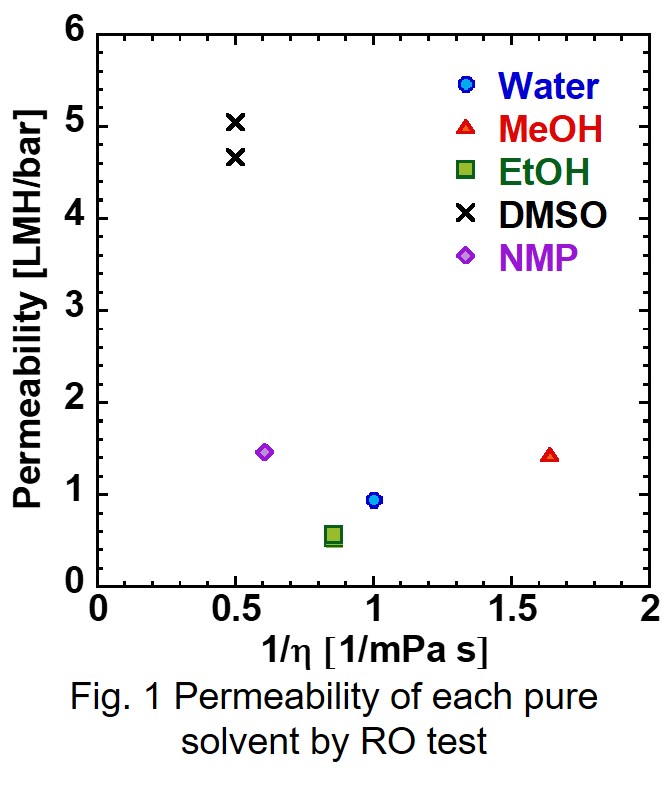
Recently we developed novel facilitated transport membranes (FTMs) with metal-containing ionic liquids (MCILs) as an O2 carrier. The FTM had higher O2 permeability than conventional facilitated O2 transport membranes. However, the O2/N2 selectivity of the MCILs-based FTMs were still low. In this research, we tried to propose a guideline to improve the O2/N2 selectivity of the FTMs. We synthesized several MCILs and prepared the supported ionic liquid membranes (SILMs). The O2 and N2 permeabilities of the SILMs were measured and compared with those estimated from the gas absorption amounts and the diffusion coefficients of the gases and O2 complexes in the MCILs (Figure). The diffusion coefficients were determined by Wilke-Chang equation, which is useful to estimate diffusion coefficient of solutes in many kinds of solvents. As shown in Figure, the experimentally determined permeabilities of O2 and N2 were much higher than the estimated ones. These results suggested that the diffusion mechanism of a solute in the MCILs were different from that in a conventional solvent. To clarify the diffusion mechanism of solutes in the MCILs, we analyzed the diffusion coefficients according to free volume theory, which is useful to describe the diffusion phenomenon of a solute in polymer materials. As the result, based on the free volume theory, it was found that the diffusion coefficients of the gas molecules and the O2 complexes were depended on the free volume of the MCILs. This means, even though the MCILs were liquid, they acted as a solid because of their high viscosity (20000 – 90000 cp). To improve the O2/N2 selectivity, switching the diffusion mechanism of gases and the O2 complex from that in a solid-like MCIL to that in a liquid MCIL, which could be achieved by decreasing the viscosity of the MCILs, could be effective.
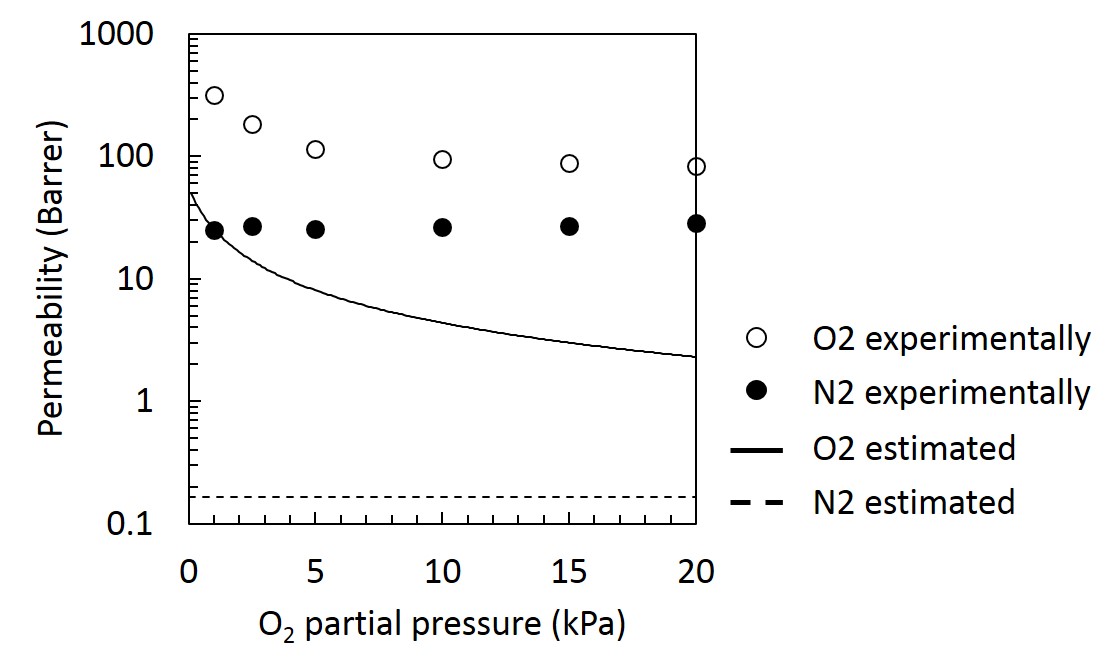
Membrane separation of organic solvents is attracting attention as an energy-saving process. Therefore a high-permeability nanofiltration membrane for demonstration is required1). However, the permeation phenomena of liquids in nanopores cannot be correctly predicted by the Hagen-Poeisuille law, and the permeability decreases as decreasing pore size2). This is thought to be due to the strong influence of pore wall potential and intermolecular interactions on the permeating molecules in the nanospace 3,4). In this work, the influence of molecular properties such as shape, size and interaction with pore walls on diffusion and permeation phenomena was analyzed using molecular dynamics (MD) method.
The interaction between the membrane material and solvent molecules was studied by utilizing a commercial software (BIOVIA Materials Studio 2018). Pores were formed in the crystalline structure of TiO2, and the pore surface was modified with -OH groups. The solvent molecules were filled in the pores, and the diffusivity was calculated. (Fig. 1). It was shown that methanol interacts with the pore wall more strongly than hexane, resulting in limited diffusivity of methanol. We have also adopted the Lennard-Jones potential and the Coulombic interaction, for modeling solvent molecules in nanopores. The interaction parameters were decided to express actual physical properties reported in literature. Non-equilibrium MD simulations of liquid permeation through nanopores on the above-mentioned TiO2 membrane structure were conducted as shown in Fig. 2. The transport behaviors of liquid-stated organic solvents were studied by the fluctuating wall MD technique2).
1) R. P. Lively et al., Nature Materials., 16, 276-279 (2017).
2) H. Takaba et al., J. Chem. Phys., 127, 054703 (2007).
3) J. A. Thomas et al., Inter. J. Therm. Sci., 49, 281-289 (2012).
4) T. Yoshioka et al., Sep. Purif. Technol., 220, 259-267 (2019).
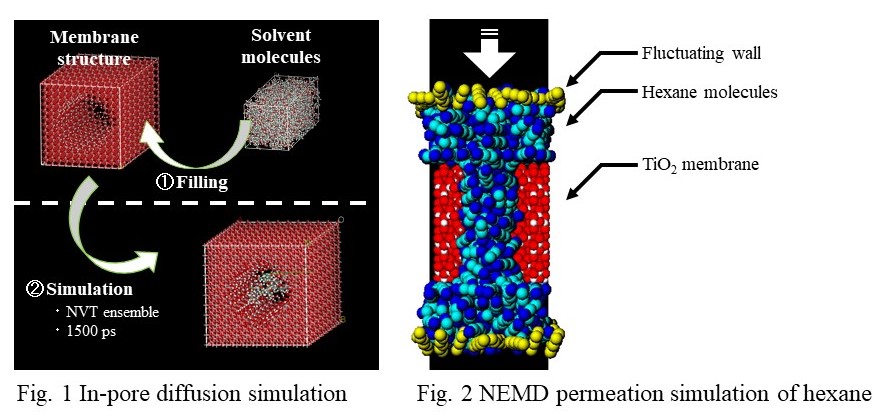
Silicalite-1 zeolite membranes have attracted great interest owing to their hydrophobicity, uniform pore structure, and high thermal and chemical stability, and thus have significant potential for use in the separation organic molecules from organic/water mixtures. Silicalite-1 membranes are generally obtained by hydrothermal synthesis (HT), the synthetic gel is prepared and immersing the seeded support in this gel to synthesize the membrane. Thus, although HT is an established method for the synthesis of zeolite membranes, it involves the use and subsequent treatment of large amounts of the synthetic gel, which is an alkali-mixed solution containing an expensive SDA.
Here, we report the preparation of silicalite-1 membranes on a silica-particle-coated tubular silica support using a gel-free steam-assisted conversion (SAC) method. The effects of the silica-particle layer formed on the top surface of the silica support and the physical properties of the silica particles themselves on the membrane-formation process were investigated. The silica particles coated served as the additional silica source for growing the silicalite-1 seed crystal layer into the silicalite-1 membrane. As a result, it was possible to form a dense and continuous membrane even under gel-free conditions. Furthermore, it was found that the properties of the silica particles, such as their primary particle diameter, had a determining effect on their solubility during the steam treatment, that is, on the supply rate of the silica source. The silicalite-1 membrane obtained using the spherical-silica-particle-coated support had an approximately 9-μm-thick separation layer and showed very high pervaporation performance, exhibiting a separation factor of 105 and flux of 3.72 kg m–2 h–1 for a 10 wt% ethanol/water mixture at 323 K. Thus, the gel-free SAC method can be used with a silica support coated with silica particles to readily prepare high-performance membranes without producing any chemical waste.
A molecularly imprinted polymer (MIP) is a polymer that has been processed using the molecular imprinting technique which leaves cavities in the polymer matrix with an affinity for a chosen "template" molecule. Permeability of a MIP film is sensitive to the specific binding with the template. This phenomenon called “gate effect” is applicable for biosensors. However, the mechanism of morphological change of MIP due to the specific binding is still unknown. A molecularly imprinted self-supporting membrane (MISSM) was developed for analysis the change in the internal structure and the permeability by the specific interaction with the template. The MISSM was prepared by copolymerization of mixed crosslinkers of triethyleneglycol dimethacrylate (TEDMA) and polyethyleneglycol diacrylate (PEDA) and mixed functional monomers of 2-vinylpridine (2-VPy) and methacrylic acid (MAA) in the presence of D-phenylalanine as a template with thickness 50 μm. (The membrane was defined as D-Phe imprinted membrane (DIM)).
DIM (TEDMA: PEDA=215:10 in molar ratio) was impregnated with fluorescein-labeled polyethyleneglycol (MW: 2,000), and the fluorescence intensity distribution in the depth direction of DIM (TEDMA: PEDA=215:10) was observed by confocal laser microscopy. The fluorescent intensity at the dense domain in the bulk of the membrane was increased to 1.5 times by the addition of the template. Those results indicate that the specific interaction with the template increases the porosity of the dense domain of the membrane.
The methanol aqueous solution was filtrated across the membrane in order to evaluate the convectional permeability. The filtration rate of DIM (TEDMA: PEDA=215:10) was increased to 3.4 times by the addition of the template, but rather was decreased by addition of the enantiomer.
As a conclusion, the blending ratio of the two crosslinkers contributes to the gate effect where the internal porosity of the dense domain and diffusive and convectional permeability of the molecularly imprinted membrane.
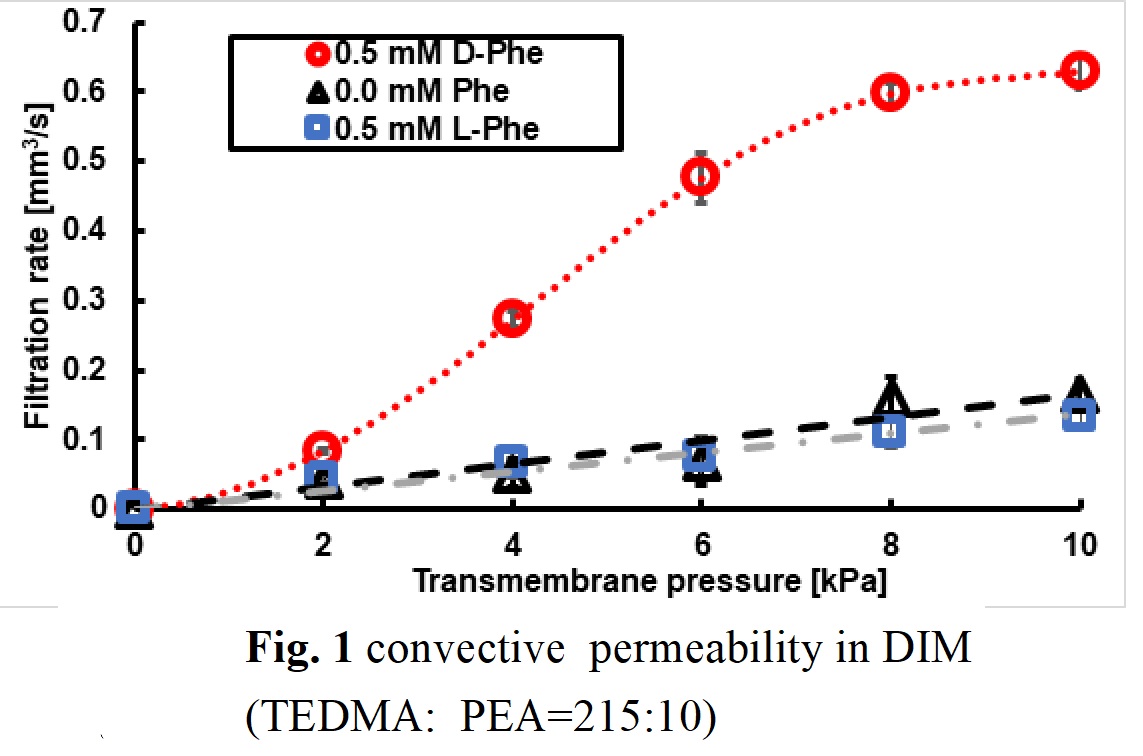
Forward osmosis (FO) process has received much attention because of their versatile potential application in water treatment. The development of FO membranes with both high pressure resistance as well as high water flux has been required because FO membranes can also be utilized under hydraulic pressurized conditions such as pressure-retarded osmosis (PRO). Recently, we have prepared aliphatic polyketone (PK) based polyamide thin-film composite (TFC) membranes and the potential of the PK based membranes as FO membrane has been demonstrated [1]. However, the highly porous structure of the PK support results in low mechanical strength of the support membrane. In addition, it was reported that the high pressure resistance and water flux are trade-off in FO membrane [1].That is, improvement in pressure resistance is required while keeping water flux. In this study, PK support membranes were treated with m-phenylenediamine (MPD) to control the membrane structure in order to enhance the mechanical strength. After the thermal treatment of PK support with MPD, the bottom surface structure became denser with the increase of treatment temperature (Fig 1a). As a result, it was found that the pressure resistance of PK based TFC membrane was improved over 20 bar under the condition of 110 °C (Fig 1b). The fabricated TFC membrane is expected to be applied for PRO process.
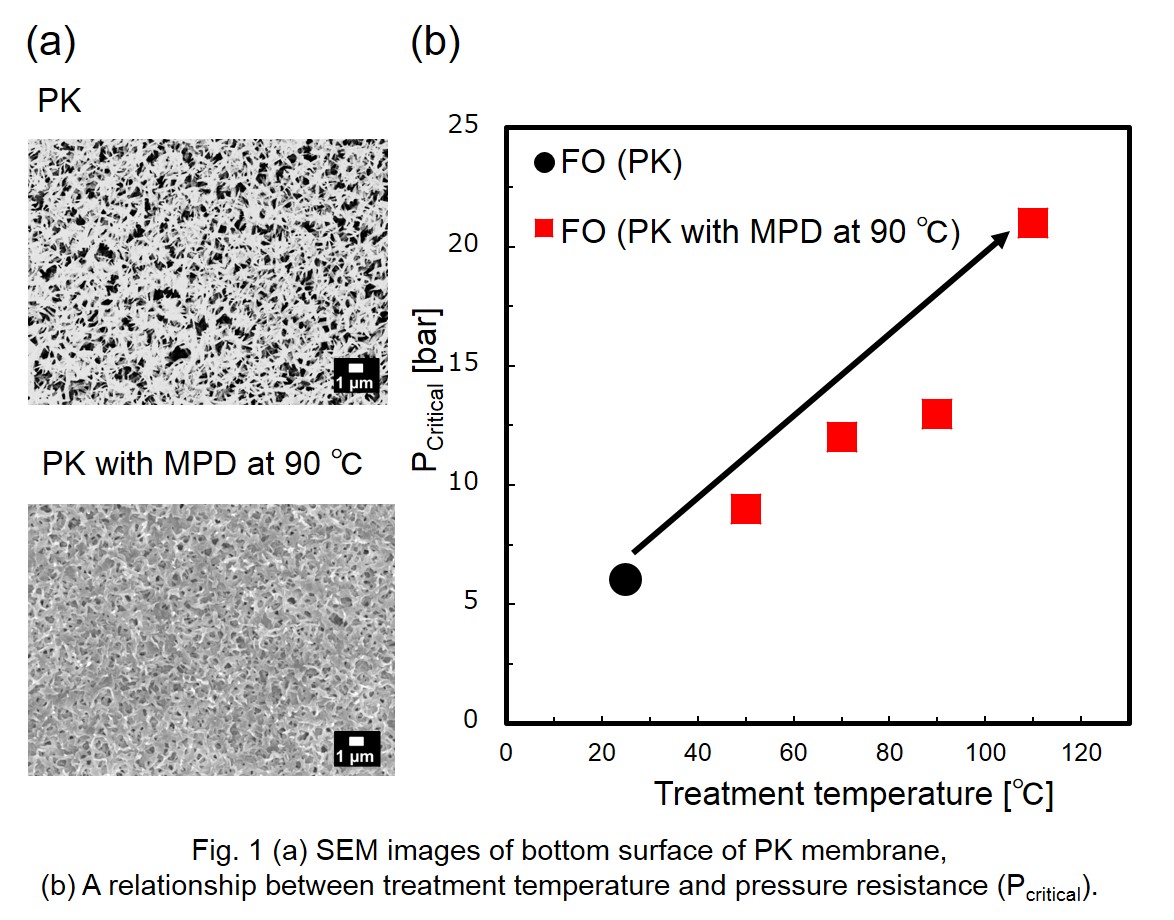
Graphene oxide (GO) nanosheets membranes have been extensively studied because their unique molecular sieving properties with fast water permeation, simple fabrication method as well as surface hydrophilic properties.. Vacuum assisted method is widely used for fabricating GO nanosheet membrane, but low regularity of laminated structure of nanosheets is a problem. In this study, GO nanosheet membranes were fabricated by pressure assisted method which enables to fabricate more stable laminated structure. The influence of the surface treatment on their layered structure and performance of GO membrane were examined.
In this study, GO nanosheets were fabricated by Improve Hummers method. GO membranes were fabricated by laminating GO nanosheets on porous α-alumina support under 1 bar (GO membrane). The heat treatment at 200 °C to reduce the oxygen functional group was performed (rGO membrane). Permeability was calculated from the weight of permeated water by dead-end system. Rejection was calculated from the absorbance of the permeate by using two dyes, Evans blue (EB, Mw:960.81) and Acid red (AR, Mw:635.59). Fig.1 shows the membrane performances of the GO and rGO membrane. As shown in Fig.1 (a), the permeability of GO membrane is around 10 times higher than that of rGO membrane. Fig.1 (b) shows the dye rejection of GO and rGO membrane. The rejection of GO membrane was about 90 % for EB and about 30 % for AR whereas the rejection of rGO membrane showed about 70 % for EB and about 10 % in AR. The reduction of the GO surface and structural changes of the layered structure would affect the membrane performances.
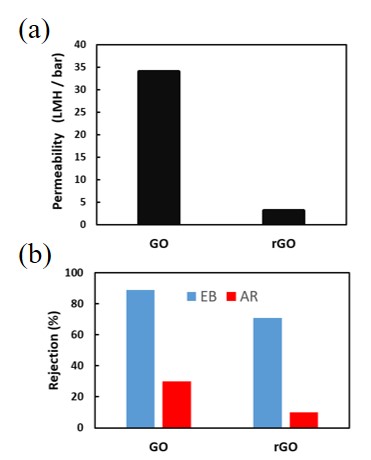
Conventional wastewater treatment process cannot completely remove trace pharmaceutical and personal care products (Cao et al., Chem. Eng. J., 2019, 370: 684–694.), and an advanced wastewater treatment process is expected. Forward osmosis (FO) relies on the osmotic pressure difference on both sides of the membrane as the driving force to realize the spontaneous diffusion of water molecules. Because of low energy consumption and low membrane fouling, FO has become a novel membrane separation technology in water treatment field. This study investigated the interaction between typical pharmaceuticals (ciprofloxacin, moxifloxacin and acetaminophen) in FO. The results showed that the factors affecting pharmaceuticals rejection rate included: 1) number of pharmaceutical molecules determining the collision probability between molecules; 2) pH influencing the charge on membrane surface and the patterns of pharmaceutical molecules; 3) size ratio of membrane pore and pharmaceutical molecule determining membrane pore blockage; 4) charge neutralization or electrostatic repulsion existing between pharmaceutical molecules.
In recent years, a facilitated transport membrane1) in which a polymer gel membrane is impregnated with an ionic liquid, are attracting attention as a core technology for the next generation carbon dioxide separation. By applying this to conventional carbon dioxide emission sources such as steel plants and thermal power plants, it is possible to reduce carbon dioxide emissions. However, ionic liquids have the disadvantage of low diffusivity because they have very high viscosity, and it is essential to improve the diffusivity of ionic liquids for practical use.
In this study, the diffusivity and liquid structures of several types of ionic liquid molecules with a primary or secondary amine group ([P4444][Ala], [aP4443][Pro]) were analyzed by molecular dynamics (MD) simulation. These ionic liquids have already been known to exhibit high carbon dioxide absorption. It was confirmed that the diffusion coefficient of [Ala-CO2] complex was higher than [Pro-CO2] (Fig. 1). We also evaluated the interaction and clarified the relationship between the interaction and the molecular structure. [Pro-CO2] was highly structured with other [Pro] molecules, while [Ala-CO2] showed no structured peaks in the radial distribution function (RDF) (Fig. 2). The diffusivity was very low in an ionic liquid having a structure that easily caused interaction with other molecules. It was suggested that ionic liquid molecules that formed intramolecular hydrogen bonds exhibited high diffusivity by reducing the interaction with other molecules. By designing a new ionic liquid based on the obtained knowledge, it is expected to develop a carbon dioxide separation process suitable for practical use.
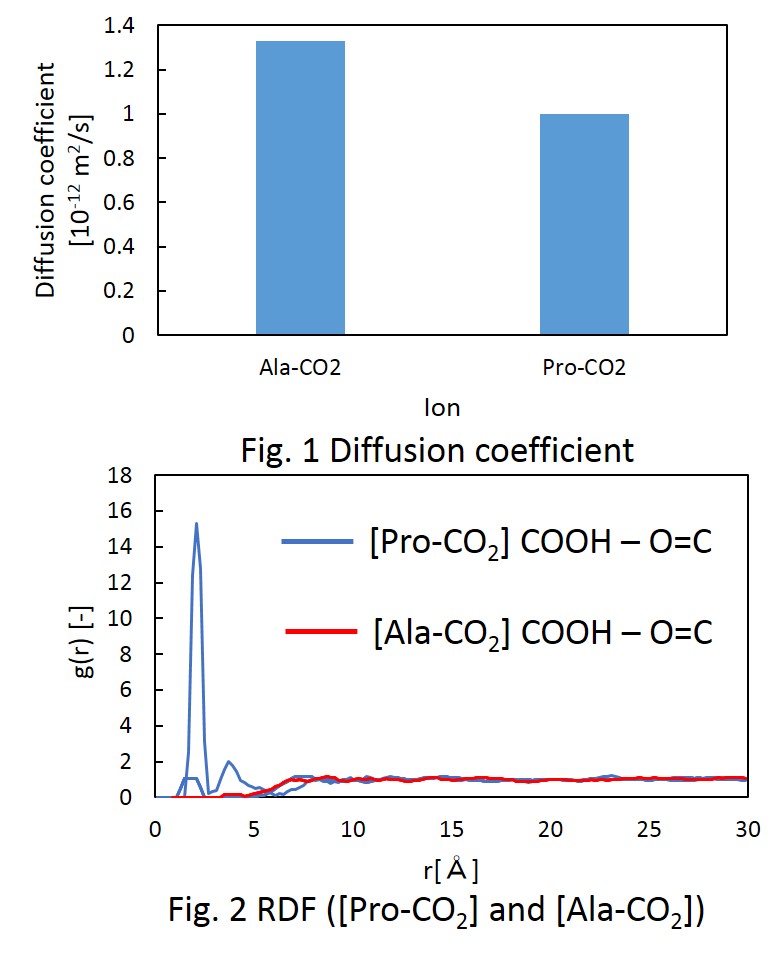
Volatile organic compounds (VOCs) are widely used in industries such as painting and printing as solvents or adhesives. A large portion of used VOCs used in the industries is discharged into the atmosphere to cause air pollutions. Membrane separation process can be applied to recover and separate VOCs from waste gas or liquid streams. In this study, polydimethylsiloxane (PDMS) membranes were examined for the pervaporation separation of mixtures of VOCs including toluene/isopropyl alcohol (IPA), which are major VOCs discharged from printing and painting industries.
Commercially available PDMS membranes with different hardness (20, 50, 70) were used as base membranes. The base PDMS membranes were chemically modified with tetraethyl orthosilicate (TEOS) and other silane coupling agents to control the affinity to the target VOCs. The membranes were applied to the pervaporation experiments under vacuum at the permeate side.
The base PDMS membranes were toluene selective against ethyl acetate for all the hardness, but the PDMS membranes with the hardness at 50 and 70 showed higher toluene selectivity (~80% in permeate) and lower flux (~400 g/m2/h) than the PDMS membrane with the hardness at 20 (~54 % and 2280 g/m2/h). The toluene selectivity was greatly improved by the chemical modification with TEOS as shown in Figure. The toluene fraction in permeate was ~77%, and the total flux was 567 g/m2/h for the treatment for 18 h without hydrochloric acid. The treatment conditions such as the treatment time and the addition of hydrochloric acid as an acid catalyst has slight effect on the pervaporation performances. Compared with the base PDMS membranes with the hardness at 50 or 70, the toluene selectivity of the treated PDMS membrane with the hardness at 20 was almost equivalent, and the permeation flux was 20% higher.
In recent years, researches on stacked nanosheet membranes fabricated using two-dimensional (2D) nanosheets such as graphene oxide (GO) membranes have attracted much attention because of the ultrathin thickness, easy fabrication methods, and their potential of high selectivity in water treatment and gas separation. However, the molecules permeate through the 2D interlayer channels formed between nanosheets for the stacked nanosheet membranes, which results in a long permeation pathway. On the other hand, nanosheets of MOF with a porous structure and functional surface groups are considered as excellent candidates for ultrapermeable and highly selective 2D membranes due to their nanoscale thickness, extreme low mass-transport resistance and 2D morphology. Gascon et al [1] have fabricated CuBDC/polyimide nanocomposite membranes, which showed a remarkable improvement in gas separation. In this study, the stacked CuBDC MOF nanosheets membranes were fabricated by vacuum filtration method. The addition effects of cross-linker into the stacked nanosheet membranes on their stability in the solvents were investigated.In the results of XRD pattern, two peaks at 2 theta = 17.09 and 34.18 °corresponding to the (201) and (402) crystallographic planes of the CuBDC structure were observed, which imply the formation of pore openings nanosheets (Fig.1). The structural stability was evaluated by immersing the stacked nanosheets membranes into water and organic solvents. It was found that the crystal structure of CuBDC was relatively stable in DMF and methanol as compared with water. For the permeation test using a cross-flow membrane filtration system, it was found that the addition of cross linkers such as triethanolamine stabilized the stacked nanosheet membranes. The effects of the cross linkers on their solvent permeation and separation performances will be compared.
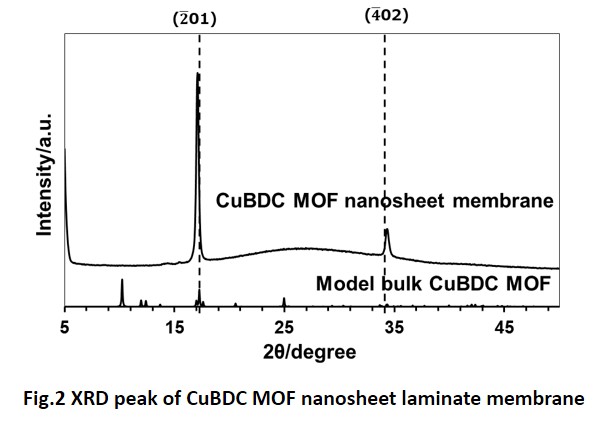
Methanol is an important material for chemical products. Conventionally, methanol is synthesized from synthesis gas. On the other hand, direct partial oxidation method from methane has been widely studied, as one good option to replace the conventional method, but the yield is still low. To solve this problem, we propose to use a membrane reactor. The membrane reactor is a physical device that combines a chemical conversion process with a membrane separation process to remove products of the reaction. Produced methanol is separated from the reactor by the membrane, leading to prevent further reactions of methanol to other chemicals including CO2. However, it is difficult to separate methanol and methane through molecular sieve membranes, because of their similar kinetic diameter. Recently, we have developed a new concept of chemically stabilized ionic liquid (IL) membranes, which are organosilica membranes prepared from silylated ILs.
The figure below shows the effect of temperature on permeation and separation performance in methanol/methane binary mixture system. The prepared membrane shows high selectivity toward methanol against methane. Separation factor was increased as high as 219 at 100 °C. Apparent activation energies (Ep) for permeation of methanol and methane were calculated to be 2.6 kJ/mol for methanol and 31 kJ/mol for methane using the Arrhenius equation. The obtained Ep of methanol was much smaller than that of methane, regardless of their similar molecular size. The obtained results indicated that the ILs group strongly affected the methanol permeation even at high temperature up to 200 °C. The silylated IL-derived organosilica membrane showed the great potential for separation of methanol from methane at high temperature.
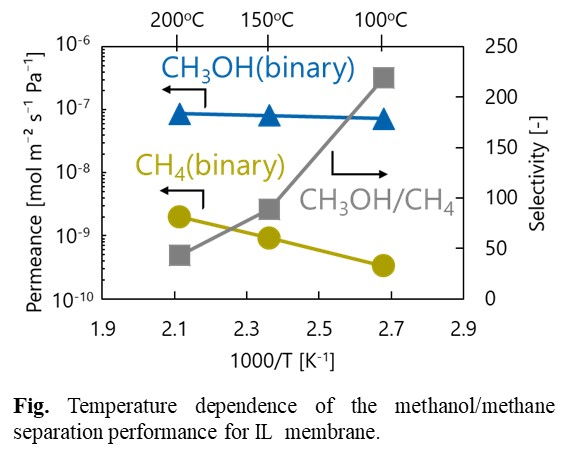
Zirconium based UiO-66, consisting of zirconium oxocluster (metal nodes) and terephthalic acid (organic linker), is known as the most chemically and thermally stable material among the metal organic frameworks. Moreover, it has been reported that UiO-66 membrane has good separation performance for CO2/N2 separation, which is necessary to reduce greenhouse effect. However, synthesizing continuous and defect-free UiO-66 membrane is a challenging work, because UiO-66 has no interaction with the supports. In this work, UiO-66 membranes were synthesized on the gamma alumina coated alpha alumina support by in situ growth method. Gamma alumina layer was prepared from the sol-gel coating of boehmite sol to increase the interaction between UiO-66 and support. Synthesized membrane was analyzed by XRD, SEM, FT-IR and CO2/N2 gas separation test. Gas separation result showed that UiO-66 membrane is a promising candidate for CO2/N2 separation.
Separation of propylene/propane mixtures is an important and challenging task in petrochemical industry, which is currently performed by energy-intensive cryogenic distillation. If effective membranes are developed, membrane technology may provide substantial energy and capital cost savings. In this study, the continuous and compact ZIF-67 membranes were synthesized on alumina supports by a counter diffusion-based in situ methods for propylene/propane separation. X-ray diffraction (XRD), field emission scanning electron microscopy (FE-SEM), and energy dispersive X-ray (EDX) mapping were used for the characterizations. After three synthesis cycles, the defects of the ZIF-67 membranes were completely healed, showing high quality of ZIF-67 membranes. The effects of the solvothermal synthesis cycles and time were investigated. Gas permeation tests revealed that the membrane prepared with three synthesis cycles at 120oC for 4 h had well-intergrown and compact ZIF-67 structure, showing propylene/propane separation factor of 73.82 with a C3H8 permeance of 1.04x10-10 mol m-2 s-1 Pa-1.
Poly[2-(dimethylamino)ethyl methacrylate] (PDMAEMA) has been paid great attention as CO2-switchable polymer, because various applications are recently expected, such as extractants of organic solvent and draw solutes of forward osmosis desalination. PDMAEMA can react with CO2 in water, which can increase drastically its lower critical solution temperature (LCST), characterizing the coil-to-globule transition from a soluble to an insoluble state. The transition certainly results from the protonation–deprotonation of the tertiary amine group in PDMAEMA side chains. However, it is still challenging to investigate the conformational transition of PDMAEMA in water at the atomistic levels. To provide detailed insights into the origin of the transition, it is essential to evaluate the microscopic interactions between the PDMAEMA side chains and water molecules. In this study, the coil-to-globule transition of DMAEMA oligomers is investigated by using molecular dynamics simulations. We calculate the radial distribution functions (RDFs) between the DMAEMA moieties and the surrounding water molecules to investigate the influence of the hydration structures in the vicinity of DMAEMA side chains on the CO2-switchable property. We also calculate the time evolution of the radius of gyration (Rg) to evaluate the temperature dependence of the coil-to-globule transition. The Rg is calculated by averaging the mass-weighted distance of each constituent atom of the oligomer from the center-of-mass position of the constituent atoms. Consequently, the values of Rg distinctly depend on the protonated/deprotonated states and the temperatures, indicating that the DMAEMA oligomer shows the conformational transition at the atomistic levels. We also confirm that the predicted LCST values from our simulations are correlated with the previously reported experimental LCST values. In our presentation, further details are shown, including the RDFs and the values of Rg at varied simulation conditions.
Protein chromatography is an important technique to separate and purify the protein of interest based on protein's size, hydrophobicity, and total charge. For purifying the protein with required level, loss of the purified protein is associated due to the multiple chromatography steps involved. Also, in some cases, high concentration of salt used for protein adsorption/desorption causes protein denaturation.
Recently, an ion recognition gating membrane grafting N-n-propylacrylamide (NPAM) and Benzo[18]crown-6-acrylamide (BCAm) is developed which can control its pore opening with response to low concentration of K+ ion at ambient temperature [1]. The NPAM moiety of the membrane can change its hydrophilic/hydrophobic property at certain temperature, and this membrane further controls the charge state by capturing K+ ion to BCAm moiety. Hence this grafted membrane has the potential to be applied for protein chromatography that can overcome its present problems. Herein, we evaluate the protein adsorption/desorption properties of this grafted membrane with response to specific ion.
The NPAM and BCAm monomers were grafted to the pores of polyethylene membranes by plasma-graft polymerization and the grafting is confirmed by FT-IR. A feed solution containing negatively charged γ-globulin and K+ ion was continuously supplied to the membrane followed by buffer solution, and concentration of γ-globulin in permeated solution was evaluated by Bradford assay in each steps. During γ-globulin solution supply, γ-globulins were gradually adsorbed on the grafted polymer capturing K+ ion. After the buffer supply, the adsorbed γ-globulins were desorbed from the membrane due to the K+ ion release from the grafted polymer (Fig. 1). Although protein adsorption/desorption was successfully controlled with response to K+ ion, the amount of desorbed γ-globulin is low due to the nonspecific adsorption of the γ-globulins to the membrane. We are currently considering monomer component of grafted polymer to suppress this nonspecific adsorption of the protein.
[1] Y. Asano, et al., SCEJ 49th autumn meeting, PA242, 2017
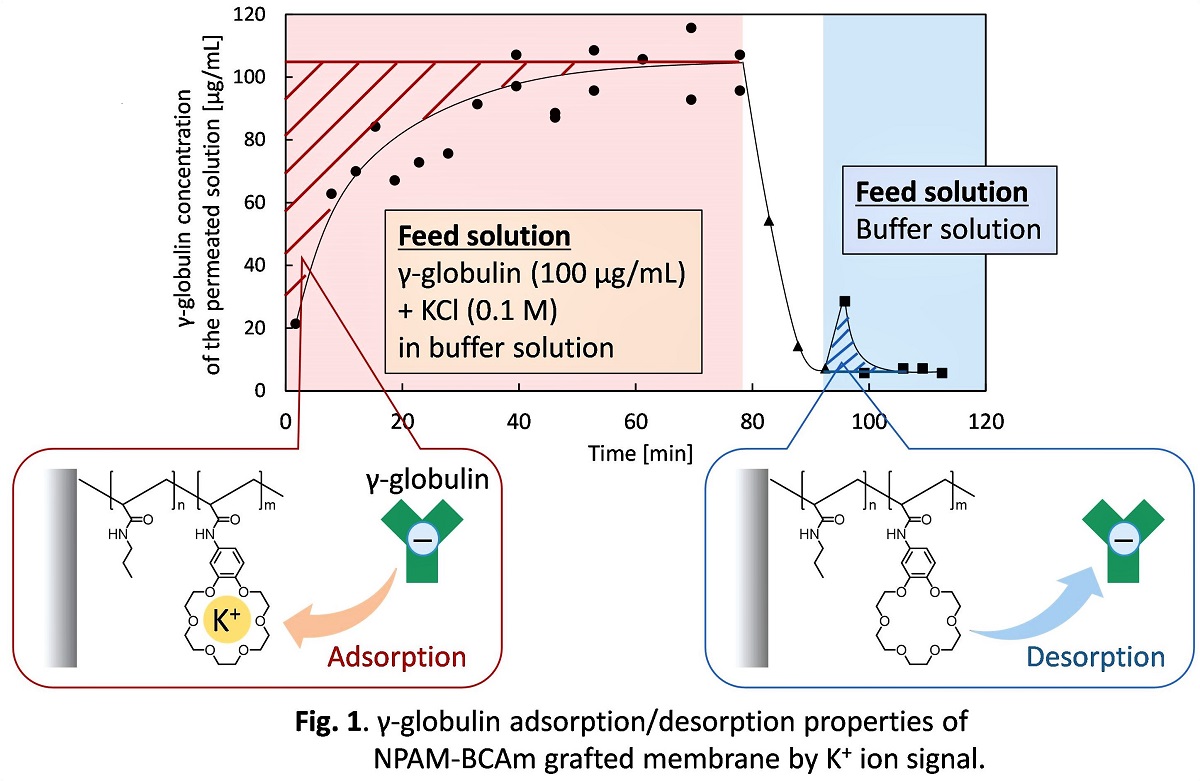
The use of plastic packaging for foods and beverages caused a serious environmental problem since most plastic waste is not recycled. One of the most common plastic materials for packaging is polyethylene terephthalate (PET). Million tons of PET bottles are produced every year, and discarded by consumers after use, resulting in a huge amount of plastic waste. The recycle of used PET bottles is a big challenge in the environmental conservation. In this study, used PET bottles were utilized as a raw material to prepare ultrafiltration membranes with the aim to obtain membranes which can be used for water treatment. Used PET bottles were cut into pieces and dissolved in various solvents. Polyethylene glycol was added as an additive to the PET solution. The polymer solution was then casted onto a glass plate using a casting knife and then immersed in a coagulation bath containing non-solvent. The effect of the type of solvent and non-solvent, as well as the concentration of the additive, on the membrane morphology was studied using Scanning Electron Microscopy. The ultrafiltration experiment was carried out using pure water and aqueous solution containing bovine serum albumin at a pressure of 1 bar to investigate the permeate flux and the rejection of the membranes. It was observed that the permeate flux increased when various hydroalcoholic solutions was used as non-solvent with the sequence water-ethanol, water-propanol, and water-butanol solution. The addition of more polyethylene glycol as the additive resulted in an increase in the permeate flux. The permeate fluxes ranged between 1.72 kg/m2h and 41.67 kg/m2h, depending on the preparation condition of the membrane. The membrane showed a rejection of bovine serum albumin of 90.6%. This result showed that used PET bottles can be used as a raw material to fabricate ultrafiltration membranes for water treatment.
MeOH synthesis from syngas is one of the most important reaction in industry. Because the conversion level of MeOH synthesis at equilibrium is thermodynamically limited, membrane reactor is expected to be effective for shifting the conversion level beyond equilibrium. MeOH synthesis is currently performed at 473-573 K and 5-10 MPa, and thereby steam partial pressure in the reactor reaches up to 0.6 MPa. Na-ZSM-5 membrane is a candidate to use in the membrane reactor for MeOH synthesis1). It is known that steam causes deterioration of zeolite structure at higher temperature. In this study, we focused on the stability of Na-ZSM-5 membrane against steam at high temperature.
Na-ZSM-5 membrane was synthesized on a tubular porous α-alumina support by a secondary growth method. The membrane was exposed to steam under conditions of 573 K and 0.6 MPa of steam. After the steam exposure, the separation performance for MeOH/CO2 and MeOH/H2 mixtures were evaluated.
Fig. 1 shows the permeation test results at 473 K. In the MeOH/CO2 permeation test, CO2 permeance increased and the separation factor decreased from 127 to 101 by steam exposure in the early stage up to 50 h. However, no significant change in the permeance and separation factor was observed up to 300 h. The MeOH/H2 permeation test gave similar results. According to XRD results, decrease in the crystallinity of ZSM-5 structure was hardly observed even after steam exposure for 300 h.
As a result, we concluded that Na-ZSM-5 membrane is very stable at 573 K and 0.6 MPa steam.
Acknowledgment
This work was financially supported by the Artificial Photosynthesis Project, NEDO.
Reference
1) K. Sawamura et al., Chem. Asian J., 4(7) (2009) 1070-1077.
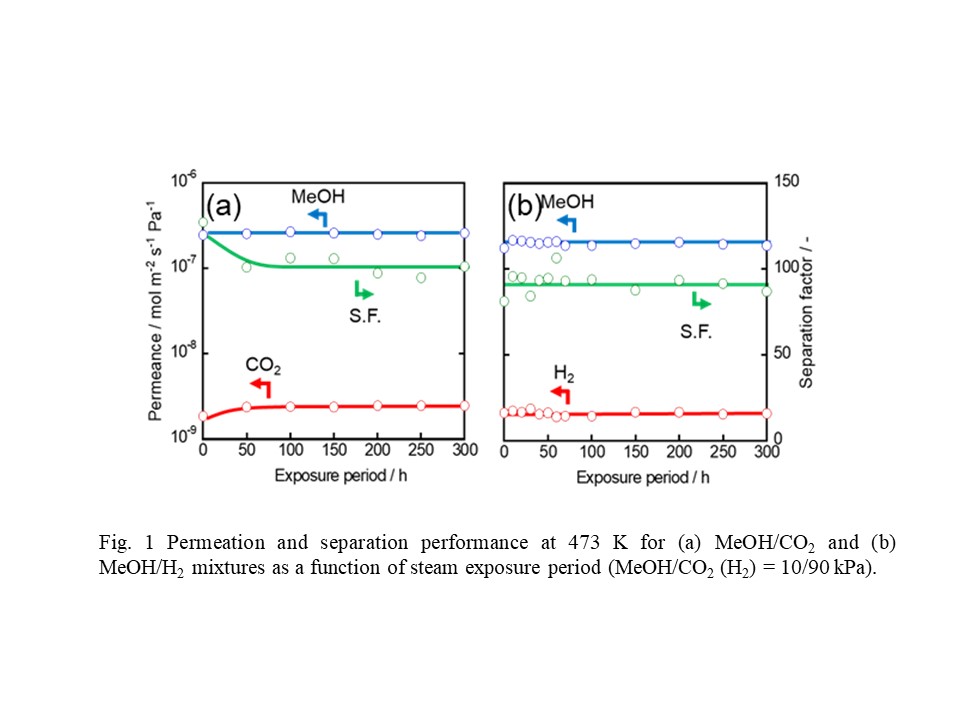
Rhodium (Rh) is the most expensive of the platinum group metals (PGMs) and is primarily used in automobile catalysts, along with platinum (Pt) and palladium (Pd). To date, no commercial solvent extraction reagent exists for Rh. In this study, new monoamide-containing quaternary phosphonium-based ionic liquid with chloride anion was developed for recovery of Rh. New ionic liquid [2-(di(2-ethylhexyl)amino)-2-oxoethyl]tributylphosphonium chloride (Fig. 1) was synthesized by simple two step reactions in our laboratory. Extraction of Rh(III) using novel ionic liquid was conducted by the batchwise method. An aqueous feed solution was prepared by diluting the standard solution of Rh(III) in 1.0 mol dm–3 HCl. An extracting organic phase was prepared by dissolving novel ionic liquid in toluene. Equal volumes (3 cm3) of the aqueous and organic solutions were mixed in a centrifuge tube and then shaken gently for 24 hours to attain extraction equilibrium. All extraction experiments were performed at 25 °C. After centrifugation, the initial and equilibrium concentrations of Rh(III) in the aqueous phases were measured by ICP-AES, to determine the degree of extraction. The effect of concentration of ionic liquid on the degree of extraction of Rh(III) was investigated. As expected, the degree of extraction increased with the concentration of ionic liquid and reached 70% using 200 mmol dm–3 ionic liquid.

In the near future, it is expected that a large amount of wastes of used solar panels containing In(III), Ga(III) and Zn(II) is discharged. These metal electronic wastes are significant metal resources for Japan with a few metal resources.
Solvent extraction involves the distribution of a solute between two immiscible liquid phases in contact with each other. We are concerned with the extraction equilibrium and dynamic of the distribution and its use scientifically and industrially for separation of solute mixtures. Here, we examined the extraction selectivity for In(III), Ga(III) and Zn(II) with N-oleoylsarcosine in dodecane from 1 M (=mol/dm3) aqueous ammonium chloride contain- ing these metals, respectively. For comparison, commercially available, carboxylic acid (Versatic 10, VA10) also was used to extraction selectivity for In(III), Ga(III) and Zn(II).
In the case of VA10, the extraction order was Ga>In>>Zn in the pH region. This is due to electrostatic force between carboxylic acid and metal ions. In the case of N-oleoylsarcosine, the extraction order was Ga(III)>In(III)>>Zn(II) in the pH region. The extraction tendency of these results a similar to that of VA10, although the extraction pH region with VA10 is higher than that with N-oleoylsarcosine. This is due to the difference of acid dissociation constants both extractants. In addition, carboxylic acids with a long alkyl chain were chemically modified, the hydroxamic acid was synthesized for comparison. The extraction selectivity for these metals between carboxylic acids and alkylhydroxamic acid was discussed.
One method for removing radioactive cesium in an aqueous solution is the solvent extraction in which cesium salts are formed using extractant. Generally, benzene, cyclohexane or the like are used as a solvent, but they are flammable liquid having a high boiling point. In addition, cesium aqueous solution is generated again after stripping with acid for solvent recovery and recycling. Therefore, in order to simultaneously achieve the separation and the volume reduction of radioactive cesium in the aqueous solution, we proposed the solvent extraction using a fluorinated solvent which is nonflammable liquid having a low boiling point and easy to distill regeneration. The aim of this study is to determine the optimum conditions for single extraction, to perform multiple extractions aiming to improve the removal rate, and to create a flow type device. The extraction experiment was carried out by changing the pH of 5ppm non-radioactive cesium aqueous solution using bis(2-ethylhexyl)phosphoric acid (D2EHPA) as an extractant. The higher the pH of the aqueous phase and the D2EHPA concentration, the better the removal rate. The highest removal rate was about 60% under the pH = 13. From the experimental results, the optimum extraction condition was determined as pH = 13 and [D2EHPA] = 0.15 mol/L. Next multiple extraction test was carried out under this condition, 90% cesium removal could be achieved in 3 times extraction. Finally, the flow type device using a static mixer for mixing and extracting parts was proposed and removal test was performed. The cesium removal performance of this device was equivalent to the batch system.
In 1955, “Itai-itai disease” was caused by water pollution of zindu-river with Cd(II) in Japan, The WHO has warmed that Cd(II) causes cancer in humans. However, Cd(II) is contained in zinc ore and is useful as raw materials in the high technology industries such as Ni/Cd battery. But separation of Cd(II) from zinc mine is difficult, because Cd(II) is similar to Zn(II) on their chemical properties. The objective of this study is to develop highly selective extractant for Cd(II) over Zn(II).
1,4-Di[[di(2-ethylhexyl)carbamoyl]methyl]piperazine (DDCMP) has been newly synthesized to develop a selective extractant for Cd(II). DDCMP has been designed so as to exhibit high selectivity for Cd(II) through electrostatic force and coordination ability of the tertiary amine of piperazine. As we expected, DDCMP in toluene exhibited a high selectivity to Cd(II) over Zn(II) from hydrochloric acid. This is attributed to high coordination ability and electrostatic force of piperazine for Cd(II). The extraction of Cd(II) was significantly dependent on concentration of hydrochloric acid. Here, we have quantitatively discussed the extraction equilibrium of Cd(II) with DDCMP in toluene from hydrochloric acid. It was found that Cd(II) was extracted as a 1:2 complex formed through ion pair formation and coordination bonding. The high selectivity for Cd(II) over zinc(II) with DDCMP was explained by determining these extracted species.
Moreover the cellulose triacetate membrane (CTA) containing 2-nitrophenyl octyl ether (NPOE) as a plasticizer and DDCMP as a carrier was prepared, characterized and applied to the active transport of Cd(II) and Zn(II) mixture. The polymer inclusion membrane (PIMs) used in this study was very effective and highly selective to transport of Cd(II) from the Cd(II)-Zn(II) mixture feed solution to receiving solution.
Nitrogen oxides (NOx) is toxic for human beings and causes photochemical smog, acid rain and so on. The NOx removal in exhaust gas is quite difficult. This is because NOx has low water solubility and low reactivity. Therefore, common gas absorber such as packed or bubble tower cannot eliminate NOx efficiently. Gas absorber equipped with glass fiber filter as a packed material can remove NOx with high efficiency. The high wetting area or high coefficient of mass transfer in glass fiber filter would enhance NOx absorption into water. The objective of this work is to clarify mechanism of NOx absorption into water in gas absorber having glass fiber filter. As a first step, the contributions to NOx absorption of mass transfer coefficient KG (KL) and gas-liquid wetting area a were evaluated by the simulation. Reaction and equilibrium of NOx in both gas and water phase was very complicated. Since N2O3 and N2O4 were unstable and existed only a very small amount, we made an assumption of rapid equilibrium in gas phase and penetration theory was adopted in water phase. In addition to the simulation, we measured KG and a, experimentally. As a result, useful information for equipment design or optimization of operating conditions was obtained. It was suggested that rate-limiting step in the absorption of NOx is the association reaction of NOx in the gas phase. It was also found that main dissolved spices of NOx depend on the NOx concentration of the inlet gas.
In previous study, the interfacial tension during microwave irradiation was measured in the presence of the non-ionic surfactant, Triton X-100. If the surfactant is short, quick increase during the pulse irradiation was observed due to desorption caused by the quick thermal response of microwave. Although operation of microwave irradiation is useful for demulsification, combinations of two liquids and surfactant are various. Accordingly, optimization of microwave local heating is required for industrial application of this technique. In this study, desorption of longer surfactant, Triton X-405 as a result of microwave irradiation was investigated at different power, and dimensionless number for the local heating around the interface was proposed to estimate surfactant behaviour for the desorption and disorder quantitatively.
2-Ethylhexylthioglycolate(EHTG) and 1-Dodecanthiol(DDT) as extractants for selective separation of indium(III) and gallium(III) over Zn(II) were used in the extraction tests. To evaluate the extraction abilities of EHTG and DDT in toluene, liquid-liquid extraction was carried out using 1 M aqueous ammonium nitrate solution containing 1 mM metal ions. The extraction equilibria for metal ions were performed by a batchwise method at 303 K for 24 h. The initial and equilibrium concentrations of metal ions in the aqueous solution were determined using a flame atomic absorption spectrophotometer model Z-2310 (AAS, Hitachi Co., Tokyo, Japan). The metal concentration in the organic phase was calculated from the mass balance between the aqueous and organic phases. The extraction order for the metal ions with EHTG was In(III) > Ga(III) > Zn(II), while DDT hardly extract In(III) and Ga(III), and only Zn(II) was extracted in the region of pH = 6 around. These differences are due to the effect of oxygen atoms(=O). In the other, these results suggested that EHTG is possible to selectively separate In(III) from an aqueous solution containing In(III), Ga(III) and Zn(II). Therefore, membrane transport experiments were carried out using EHTG as the carrier of the polymer inclusion membranes(PIMs). As a result, it was possible to selectively transport only In(III) from the metal mixture solution. The PIMs containing EHTG was expected as a selective extractant of In(III) over Ga(III) and Zn(II) from such as wastes of solar panels.
As gold is used in electronic devices such as mobile phones, PCs, and laptops, recovery of gold from waste electrical and electronic equipment (WEEE) is important. Solvent extraction is an efficient separation technique for the recovery of precious metals leached using acidic chloride solution. Oxygen-containing compounds such as dibutyl carbitol (DBC) and methyl isobutyl ketone (MIBK) have been used as the extractants for Au(III). In the present study, extraction behavior for Au(III) using various aromatic diethers was compared to study the structural factors for the extraction.
The following aromatic diethers were synthesized: 1-ethoxy-2-methoxybenzene (o-EMB), 1-methoxy-2-propoxybenzene (o-MPB), 1-butoxy-2-methoxybenzene (o-BMB), and 1-methoxy-2-octoxybenzene (o-MOB). DBC and 1,2-dimethoxybenzene (o-DMB) were purchased and also used for the extraction test. Extraction test was carried out by contacting an aqueous solution containing 0.1 mM Au(III) in 0.1-8.0 M hydrochloric acid (5.0 mL) and the extractant (1.0 mL) without dilution. After shaking the mixture at 30 °C for 24 h, the phases were separated and the concentration of Au(III) in the aqueous phase was determined by FAAS to determine the percentage extraction.
Figure shows extraction profiles of Au(III) using the diethers and DBC as a function of hydrochloric acid concentration. The extraction using o-DMB is comparable to that using the commercial extractant DBC. The extraction percentage decreases as the increase of carbon numbers at side chain: o-DMB > o-EMB > o-MPB > o-BMB > o-MOB. The result suggests that relatively less hydrophobic diether compound is more favorable for the extraction of Au(III).
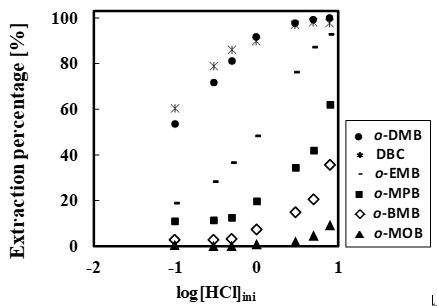
Due to the rapid expansion of worldwide lithium battery market, the issue for the recovery of lithium from waste battery or extraction of it from seawater and other aqueous solution has attracted great attention. Especially, there is virtually inexhaustible lithium resource in seawater, totalling approximately 250 billion tons. However, the concentration in is only about 0.17 mg L-1 so that it is difficult to extract Li+ ions from seawater. Thus, it is highly desirable to develop an efficient way to separate such a low concentration of lithium ion. In this study, two kinds of electroactive hybrid films were fabricated on the electrode by using a unipolar pulse electrodeposition technique. When the electrode was applied for the selective electrochemical extraction of low concentration of Li+ ions from aqueous solution via the electrochemically switched ion exchange (ESIX) process, both the Li+ ion adsorption capacities were over 35.2 mg g-1. The excellent ion separation performance of these hybrid film should be attributed to its low ion transfer resistance due to its porous structure and the high electric driving force during the ESIX process. It is expected that they can be applied as the promising electroactive material for effective separation of Li+ ions from seawater. In addition, a novel electric-field-accelerated ion-sieve membrane (EISM) system with potential-oscillation was designed for the continuous and selective separation of Li+ ions. (Acknowledgment: This work is supported by the JSPS KAKENHI Grant-in-Aid for Scientific Research C(Kiban C, 19K12395)
Macrocyclic compounds calixarenes have been used as platforms for the development of powerful extractants in solvent extraction system. However, most of calixarene derivatives is not soluble in typical organic solvents and toxic chlorinated hydrocarbons are used to dissolve calixarenes. In the present study, aromatic ethereal compounds have been synthesized as new solvents for calixarene derivatives.
Typically, 1-octoxy benzene (OB) was prepared by mixing 1-bromooctane and phenol in DMF under basic condition. Ten millimolar of a p-tert-octylcalix[6]arene hexacarboxylic acid derivative (tOct[6]CH2COOH) was soluble in OB. As the solubility of OB in water was less than 3.0×10-3 g/dm3, leak of OB into aqueous phase in solvent extraction is very small.
Extraction of L-tryptophan methyl ether (Trp-OMe), L-tryptophan ethyl ether (Trp-OEt), and L-tryptophan benzyl ether (Trp-OBz) was examined by contacting an aqueous solution containing Trp-OMe Trp-OEt, or Trp-OBz (0.2×10-3 mol/dm3, 10 cm3) and OB solution containing tOct[6]CH2COOH (1.0×10-2 mol/dm3, 2.0 cm3) at 30 °C for 24 h. Concentration of the amino acid esters in aqueous phase before and after extraction was determined using a UV-VIS spectrophotometer to calculate the extraction percentage. As the extraction is based on proton-exchange reaction, extraction of the amino acid esters increased with increasing pH. The order of the extraction depended on the hydrophobicity of the amino acid esters; Trp-OBz > Trp-OEt > Trp-OMe. The extraction behavior in OB agrees with that in chloroform, which was investigated in previous study.
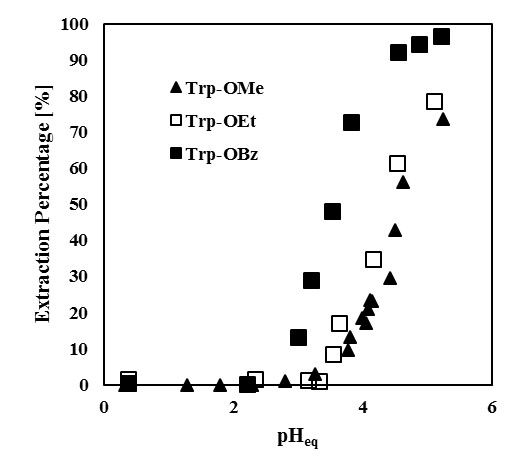
Among the main sustainable development goals of the European Union (EU) is a clean planet for all – the long-term vision for a prosperous, modern, competitive and climate neutral economy by 2050. The EU continues the path to a low-carbon, climate-neutral, resource-efficient and biodiverse economy in full compliance with the United Nations 2030 agenda. The adoption of process intensification methodologies that use the integration of reaction and separation in single, multifunctional units, will improve energy efficiency and competitiveness. One of these technologies is the membrane reactor (MR), where reaction and separation through membranes are integrated to achieve higher yields at lower CAPEX and OPEX.
Using selective membranes one product is remove from the reaction zone, shifting the reaction to the products, which increases the yield while also obtaining a pure product.
Among the EU projects working on MRs, FERRET, FluidCELL, BIONICO apply the MR concept for hydrogen production in a micro-CHP (combined heat and power) systems using both natural gas and biofuels (biogas and bioethanol). Hydrogen obtained from the reforming Palladium MR is used in a PEM fuel cell to produce electricity. Pd-MR were also used for the product hydrogen from syngas (DEMCAMER, CACHET II) and propene dehydrogenation (CARENA). Similarly, water gas selective membranes for CO2 hydrogenation to produce methanol using zeolite-MR (CARENA), or carbon-MR DME (C2FUEL). Oxygen membranes are used for the controlled delivered of oxygen for direct conversion of methane into ethylene (MEMERE). Supported ionic liquids membranes are used in ROMEO to improve the hydroformylation reaction. In this talk we will discuss the latest results of these EU projects on MRs.
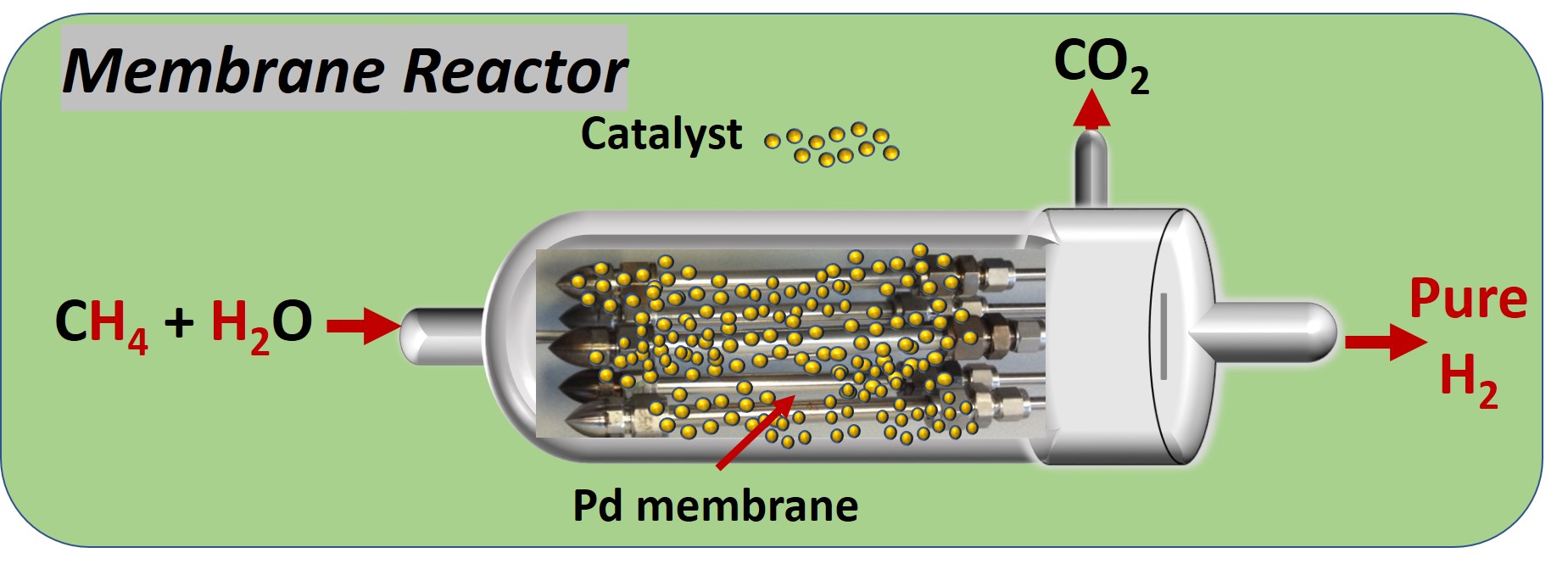
An energy career medium is required for the world-wide utilization of renewable energy. Ammonia is one of the promising energy career medium, and carbon-free hydrogen is easily produced via ammonia decomposition. Ammonia as well as produced hydrogen will be used as energy for power generation; however, methane synthesized by reacting the produced hydrogen with CO2 will be easily used in the present infrastructure. The most serious demerit of methanation is exothermic reaction; however, combined reaction system of NH3 decomposition and CO2 methanation, heat from exothermic methanation will be used effectively for endothermic ammonia reaction,
In this study, combined reactions of NH3 decomposition and CO2 methanation were conducted at 623 K in a hydrogen-permeable palladium membrane reactor, where heat transfer as well mass transfer of hydrogen were possible. Even if commercial Ru catalyst was used for both NH3 decomposition and CO2 methanation, the levels of NH3conversion and CO2methanation were increased by membrane reactor effect, namely effective hydrogen permeation from NH3 decomposition side to CO2 methanation side.
In order to improve the performance of combined reaction system, novel catalysts were prepared for NH3 decomposition and CO2 methanation at relatively low reaction temperature of 623 K. Among the catalysts developed, Ru/BaO/Al2O3 and Ru/ZrO2 gave high catalytic activity for NH3 decomposition and CO2 methanation, respectively. As a result of the improvement of both hydrogen production rate in NH3 decomposition and hydrogen consumption rate in the CO2 methanation, the increased difference in hydrogen partial pressure led to acceleration of hydrogen permeation. Furthermore, the reaction fields of ammonia decomposition and CO2 methanation were interchanged on the inside and the outside of the hydrogen permeable membrane in consideration of their catalytic activity. It was experimentally demonstrated that membrane reactor effect was improved by development of catalysts tin the combined reaction system.
As an efficient and convenient mean of transporting and storing hydrogen, it is proposed that hydrogen is converted into chemical compounds such as ammonia, which is called hydrogen carrier. Among the carrier candidates, ammonia has some advantages like possessing a comparatively large hydrogen storage capacity (17.7wt%), being liquefied easily at 20 °C and 0.8MPa, and emitting no CO2. However, to produce hydrogen by ammonia decomposition a higher temperature, usually over 600 °C, is needed because of endothermic and slow reaction.
In this study, a new type of membrane reactor that consists of a tube-wall reactor and a palladium membrane tube as shown in Fig. 1 is proposed for hydrogen production via ammonia decomposition. This reactor, in which uniform and direct heat supply can be realized compared with a conventional packed bed reactor, will allow ammonia to decompose efficiently.
A tube-wall reactor was made from aluminum tube with 8mm in inner diameter, 1mm thick and 100mm long. The inside wall was anodized to 0.1mm-thick alumina layer for the support of Ru catalyst, where the evaporation-to-dryness method using RuCl3 aqueous solution was applied for the Ru loading. Ether a rolled Pd77Ag33 tube (3.2mm in outer diameter, 0.2mm thick and 100mm long) or a composite Pd/Al2O3 tube (0.002mm thick and 90mm long), prepared by chemical vapor deposition was inserted at center of the tube-wall reactor. Ammonia decomposition was carried out in the range of 325 - 425 °C at 0.1 MPa to compare the differences between 1) the packed-type and the tube wall-type, and 2) the tube-wall reactors with and without hydrogen separation by Pd membrane. When performances between the tube-wall reactors with and without hydrogen separation by the 0.2mm-thick rolled Pd alloy membrane were compared, an increment of conversion was clearly observed.
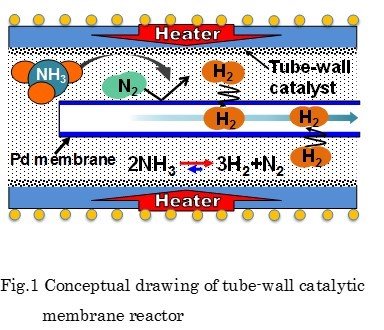
CO oxidation process in the catalytic converter hasn't showed best performance particularly when it is cold start-up, since the catalyst inside the converter is not active during this period. The purpose of this experiment was to develop the forced unsteady state operation procedure of CO oxidation using Pt/γ-Al2O3 with 0.05%-w and space velocity of 0.406 mmol s-1gram-1catalyst. The catalytic converter was gradually ramped-up, while introducing the feed gas containing CO in the air. The feed gas was modulated following a square wave model with switching time variation at 3, 6, 15, and 30 s and various operation modes. To gain the intrinsic reaction rate, the external mass transfer criterion was determined. Ramping-up the temperature from 50 until 150 °C increased the CO conversion with different profiles between steady state and dynamic flow rate. The dynamic system with modulated CO feed flow gave lower light-off temperature and higher average CO conversion than the steady state system which gave light off temperature 115 °C and average CO conversion of 48.86 %. The switching time of 3 s gave highest average CO conversion during ramping-up, which was 79.35 %. Meanwhile the dynamic operation system with modulated compressed feed flow gave higher light off temperature and lower average CO conversion than steady state system.
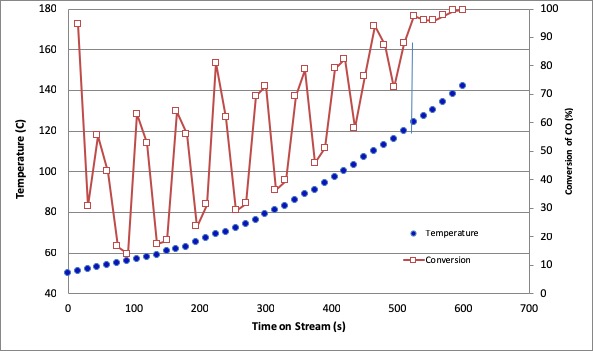
In this study, intracrystalline diffusivity of toluene within MFI-type zeolites (silicalite-1 and K-ZSM-5 (Si/Al=100)), possessing micropore which size is close to molecular size of toluene, in sub-, and super-critical fluid of cyclopentane was investigated using the constant volumetric method. This study clarified that concentration of toluene in sub- and super-critical fluid of cyclopentane (critical point: 511K, 4.5MPa) can be measured using Raman spectroscopy. Using change in toluene concentration with time due to adsorption of toluene onto the zeolite and the intracrystalline diffusivity was calculated using theoretical equation. Logarithm of intracrystalline diffusivities of toluene within silicalite-1 (MFI-type zeolite without Al in its framework) measured under 5 MPa was correlated with a single line against inverse number of temperatures. In contrast, above 473 K, the intracrystalline diffusivity of toluene within silicalite-1 was decreased and took minimum value around critical temperature. Formation of clusters between solvent molecules and diffusion substance near the critical point of solvent was considered to lead to the increase of diffusion resistance at pore mouth of silicalite-1. In addition, the intracrystalline diffusivity of toluene within K-ZSM-5 in supercritical fluid of cyclopentane at 543K was also measured. The intracrystalline diffusivity showed much higher value than that within silicalite-1. By increasing toluene concentration at outer surface of the zeolite, formation of the cluster may be suppressed and decreased diffusion resistance at pore mouth, which leading to increase the diffusivity.
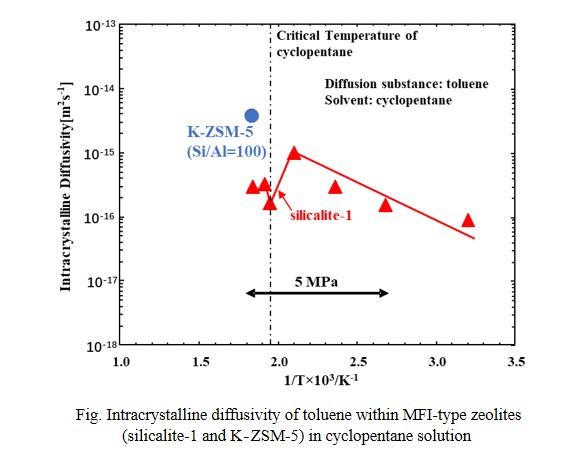
Metal oxides such as HfO2, ZrO2 and Y2O3 have optical, mechanical and chemical properties which raise interest for a variety of applications in fields such as sensors, optoelectronics, medical devices.... Atomic Layer Deposition (ALD) provides excellent uniformity, conformality in complex topographical structures, as well as good film purity. However, ALD is heavily dependant on the precursor choice, which may both determine film performances as well as the process Cost-of-Ownership with considerations around thermal stability, volatility, physical state. In this presentation, we will introduce recent developments on Group IV metal oxide precursors (high-temperature HfO2, ZrO2 ALD) as well as liquid lanthanide compounds (Y2O3, Sc2O3, Ln2O3) and illustrate films performances for applications such as hydrophobic coatings, anti-corrosion coatings and optical coatings.

Aluminum-rich cubic titanium aluminum nitride (Ti1-xAlxN, x>0.9) is an emerging material for cutting tool coating due to high hardness, thermal resistance, and chemical stability. Cubic phase is, however, metastable at x>0.67 (hexagonal phase most stable), and physical vapor deposition (PVD) consistently yields hexagonal-TiAlN. On the other hand, synthesizing cubic-TiAlN with x>0.9 was reportedly enabled by chemical vapor deposition (CVD), whose cutting performance is satisfactory for industrial application. However, film thickness distribution was found even in the lab-scale reactor, which is the biggest hurdle for mass production. Computer-aided reactor design is the only possible solution for it; whose reliability is definitely reliant on the quality of kinetic reaction model. Kinetic analysis was therefore carried out for TiAlN-CVD at 800 °C from TiCl4-AlCl3-NH3-H2-He, by changing the partial pressure of each metal chloride and NH3 (PAlCl3, PTiCl4, and PNH3). During the TiAlN growth, growth rate of AlN ingredient increased with PTiCl4, and vice versa, suggesting that some interactive reactions should exist between them. Gas-phase reaction simulation was performed by using existing elementary reaction model, but could not explain this interaction. Thus, individual growths of TiN and AlN were examined at 800 °C and PNH3=19.2Pa. Growth rate proportionally increased with precursor partial pressure as shown in the figure but decreased with the increase of PNH3 for all growths (data is not shown). TiAlN-CVD was previously found to be diffusion limited, but the decrement cannot be rationalized by the change of mass-transport coefficient. It should rather be regarded as transient region of diffusion and reaction limited. We thus performed step coverage analysis to extract surface reaction rate constants, and found that competing Langmuir-Hinshelwood (LH) mechanism could explain the overall phenomena. Consequently, complicated interactive reaction between Ti and Al precursors are getting clarified.
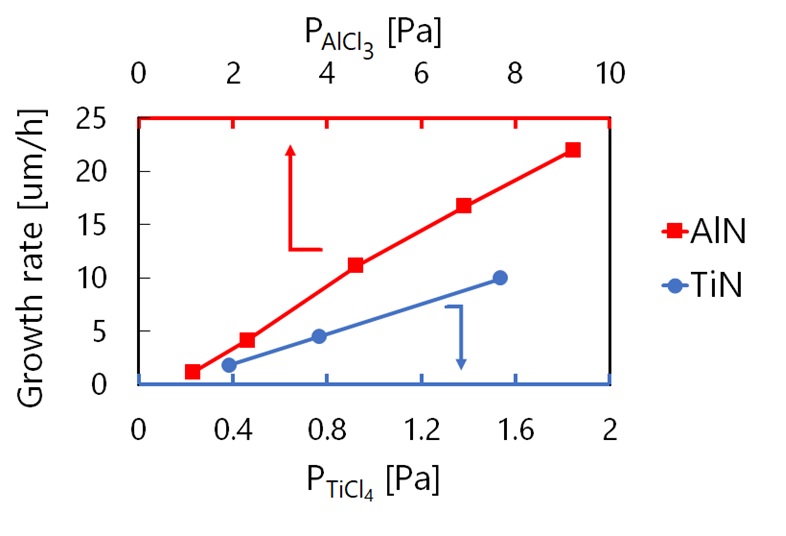
Titanium dioxide (TiO2) is applied to photocatalysts, photochromic materials, solar cells, etc. due to its characteristic electrical, chemical, and optical properties. Recent studies revealed that the photocatalytic and other performances of TiO2 thin films can be improved when silver (Ag) or carbon nanotubes (CNTs) are embedded in the films because of the changes of light absorbance and electron/hole transfer. Such films have usually been synthesized by liquid-based methods. However, the methods require many procedures, and the control of the properties and amount of the embedded nanomaterials is not easy. We recently developed a CVD technique to synthesize thin films in which well-characterized, pre-formed nanomaterials are embedded [1]. In this study, TiO2 thin films with embedded Ag nanoparticles and CNTs are synthesized by applying this technique. The properties and photocatalytic performance of the synthesized films are evaluated.
Titanium alkoxide vapor was fed into a microwave plasma field to form a TiO2 matrix. An aqueous suspension of either or both of Ag nanoparticles and CNTs was sprayed, and the resulting droplets were fed into the plasma field simultaneously. These simultaneous feedings enabled the synthesis of nanocomposite films through a one-step plasma-enhanced CVD process.
Observation of the films using a scanning electron microscope (see images) confirmed that the CNTs were successfully embedded in the film. Elemental analysis and absorption spectrum indicated the enhancement of the absorbance of visible light due to the existence of Ag and CNTs in the film. The films in which either Ag nanoparticles or CNTs were embedded showed higher photocatalytic activity than a TiO2-only film. The film with both of Ag nanoparticles and CNTs exhibited a further higher activity. The film caused 1.8 times dye-decomposing reaction rate of the TiO2-only film under visible light irradiation.
[1] Kubo et al., Thin Soild Films, 632, 55 (2017)
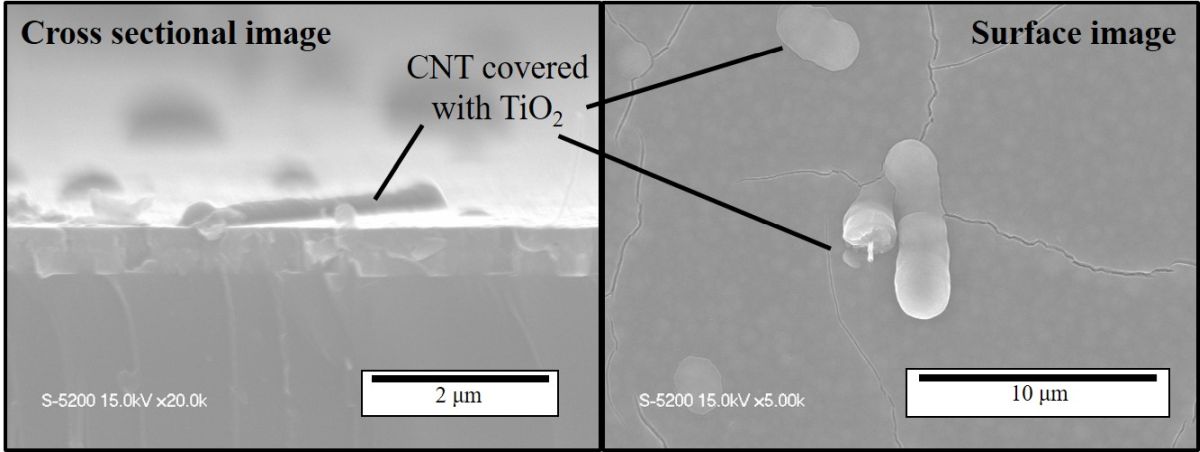
Methylammonium lead iodide (MAPI, CH3NH3PbI3) perovskite solar cells have attracted great expectations as next-generation low-cost solar cells, and development of large-scale film fabrication processes is required. Development of a chemical vapor deposition (CVD) process is required for its capability for large-area and high-purity fabrication of thin films. Although a CVD process for fabricating MAPI was proposed,1) it includes solid reactants that should be sublimated and therefore the flow rate control is difficult. In this study, a novel CVD process to synthesize a MAPI thin film from gaseous reactants, hydrogen iodide (HI), monomethylamine (MA, CH3NH2), and lead (Pb) vapor is proposed. As shown in Fig. 1, the reactor consists of two tubes. Molten Pb was placed in a tube heated at 873 K, and 0.3 % HI in He was supplied for generating PbI2 vapor in Reaction (1). PbI2 and HI were mixed with 10 % MA in He supplied from the other tube, to form a product film on a 10 mm×10 mm quartz substrate heated at 423 K in Reaction (2). The total pressure was approximately 2 kPa. Flat red-brown films were obtained at 423 K for 30, 60, 180 min. The film thickness was 0.4, 1.0, 2.8 μm respectively. The mass of the samples are on the liner plot. XRD patterns and UV-vis spectra of the obtained samples are in good agreement with the reference pattern of MAPI. MAPI was successfully synthesized by a proposed CVD method. XRD patterns of obtained samples show that the PbI2 peak decreased and the MAPI peak increased with time. The result indicates that the MAPI crystal grew with time, which can also be indicated by the result of observation with SEM.
1) M. M. Tavakoli, L. Gu, Y. Gao et al., Sci. Rep., 5, 14083 (2015).
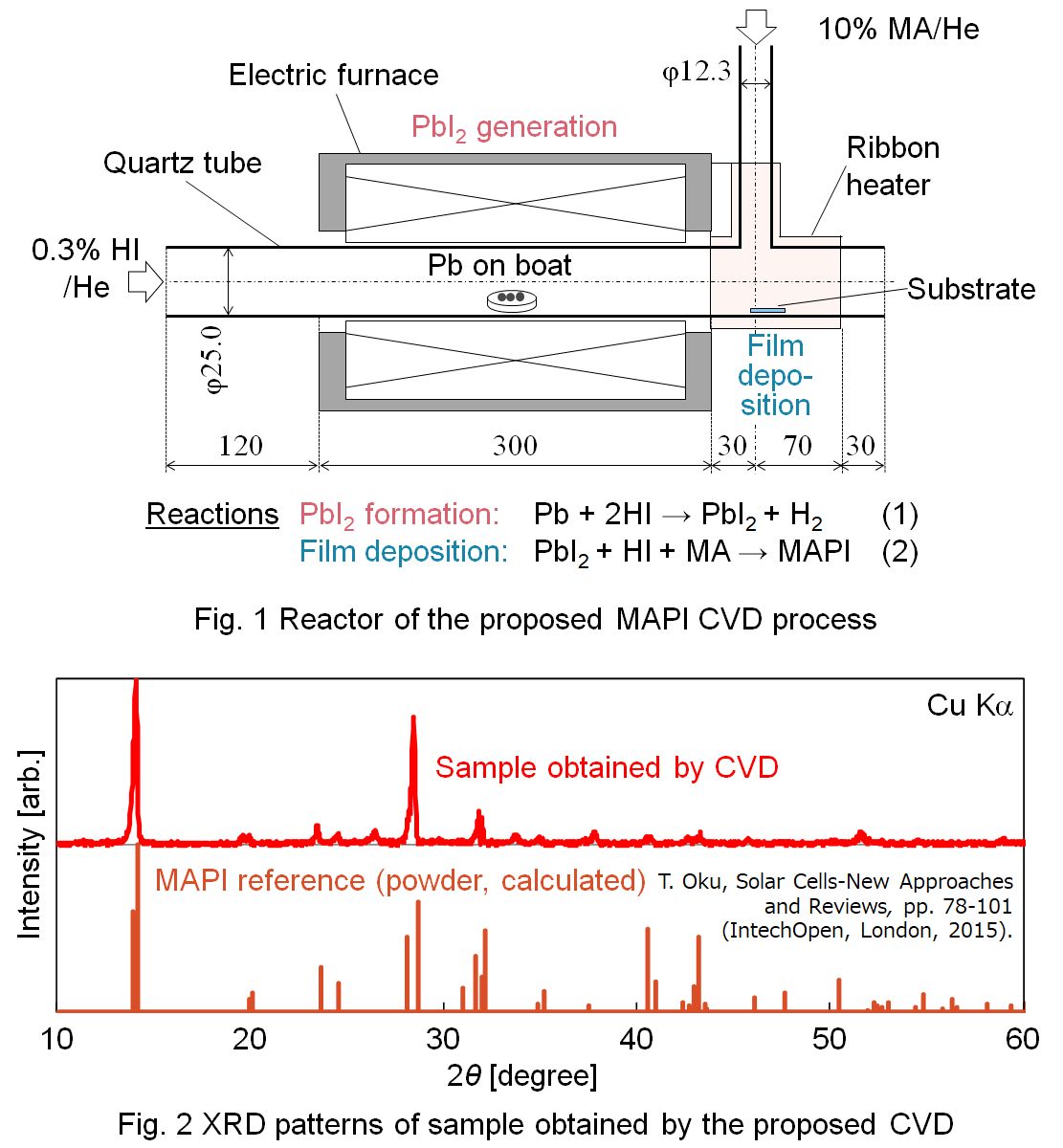
Utilization of CO2 by converting it into useful chemicals is sought. Catalytic hydrogeneration of CO2 to methanol is an attractive pathway as it is an important feedstock. So far, for this reaction, Cu/ZrO2 has been proposed as a promising catalyst and the interface of Cu-ZrO2 is considered as the active site. Therefore, high Cu loading and small Cu particles are essential for maximizing the number of the active site. Here, we successfully produce highly-loaded CuO (60 wt% as Cu) on ZrO2 nanoparticles by flame spray pyrolysis (see the left side of the figure) that can be scaled up to kg/h of the production rate. By decreasing the precursor feed rate, the particle size decreases because of the shorter particle residence time in the flame, which hinders the particle growth (as shown in the figure). Notably, when the catalyst was prepared at the feed rate = 2 mL/min, any Cu species were not detected by XRD indicating that Cu species were present as an amorphous and/or very small particles that are below the detectable limit. This catalyst showed about 5 times higher selectivity to methanol than a commercial Cu/ZnO/Al2O3 catalyst. In contrast, by preparing the catalyst at the higher feed rate (5 and 10 mL/min), CuO peaks appeared in the XRD pattern and their selectivity to methanol is about 50% less than that prepared at 2 mL/min of the feed rate. Therefore, the catalyst prepared at the feed rate = 2 mL/min that consists of smaller CuO and ZrO2 particles than that prepared at the feed rate = 5 and 10 mL/min would be beneficial as they maximize the interface of Cu-ZrO2 sites.
Recently, lignocellulose biomass has attracted as new carbon resources. Separation of the biomass components, which are cellulose, hemicellulose, and lignin, is necessary for biorefinery, and some separation techniques have been developed for long years. Especially, organosolv method, in which a mixture of water and organic solvents is used for depolymerization of lignin and hemicellulose, has been focused on due to its potential for contribution to biorefinery.
Many researchers have investigated kinetics of delignification and pointed out the effect of mass transfer on the delignification rate. However, no one have modeled the rate of delignification including effects of chemical reaction and mass transfer.
In this study, we have tried to model kinetics of delignification on organosolv method using 1-butanol by unreacted-core model, as shown in Figure 1. This model is used to express situations in which solid particles are being consumed by reactions, and the amount of the material being consumed is shrinking.
Delignification of cedar wood was carried out in a water/1-butanol mixture using batch reactor at 473 K for 0–8 h. After delignification, the products were filtered and divided into liquid and solid products. The solid products were dried, and then analyzed using elemental analyzer to measure carbon content. Chemical composition of cedar wood and the solid products were decided by NREL method.
Conversion of lignin (XL) was calculated in terms of carbon. Based on the unreacted-core model, the overall delignification rate equations were derived for the 3-step pathway shown in Fig.1. The experimental data were found to be well expressed by the rate equation derived on the basis of diffusion in layer of cellulose as the rate controlling step fot the overall delignification rate.
Acknowledgement
This work was supported by the Advanced Low Carbon Technology Research and Development Program (ALCA) as a project from Japan Science and Technology Agency.
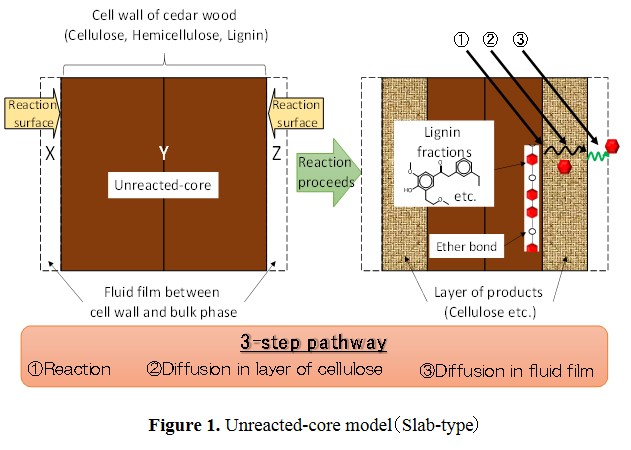
Cello-oligosaccharides are short chain bio-active molecules with the ability to improve the immune defense of plants, animals and humans. These oligosaccharides are only produced in very small quantities and their commercial use is restricted due to the absence of an efficient synthesis process.
Cellulose has a similar structure to these oligosaccharides albeit with a high chain length. Partial hydrolysis of cellulose can produce the desired oligosaccharides but the reaction is difficult to control because the reactivity of molecules increases with the shortening of polymer chain in a conventional hydrolysis reaction.
We have invented a carbon catalyzed semi-flow process for synthesis of food grade cello-oligosaccharides by partial hydrolysis of cellulose. Carbon catalyst was decorated with oxygenated functional groups, which acted as the active sites for hydrolysis. High rate of hydrolysis was achieved by adsorbing the cellulose on carbon catalyst by a solid-state milling step. During reaction, the semi-flow process rapidly removed the dissolved cello-oligosaccharides preventing their further hydrolysis to monomers. Total cello-oligosaccharide yield of 72 % was obtained by optimizing the process at a space velocity of 70 h-1 and a temperature of 473 K.
The composition of oligosaccharides mixture was determined by developing a quantification method based on MALDI-TOF mass spectrometry. The data showed main products had chain length of less than 8 monomer units but oligosaccharide with chain length as high as 13 was also detected. Kinetic data showed the rate of hydrolysis reduced with a reduction in chain length owing to the weaker adsorption of smaller oligosaccharides on carbon surface.
Consequently, we were able to produce a drop-in cello-oligosaccharide solution from cellulose with high yield. The product solution was free from any contamination and could be readily used in healthcare and agriculture industry.
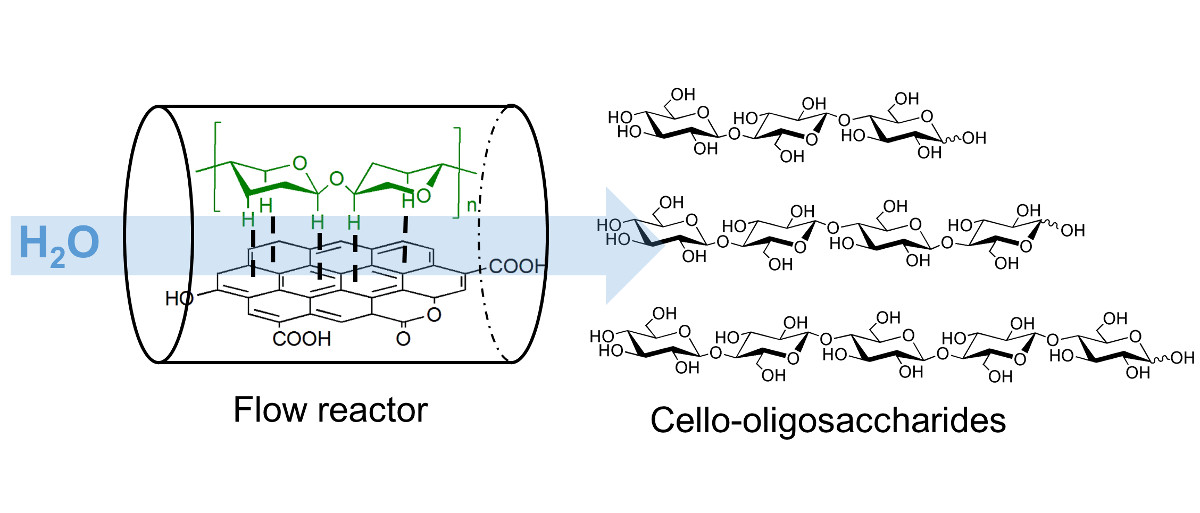
The catalytic solvent-less etherification of glycerol for glycerol oligomers using lithium orthosilicate (Li4SiO4) as a heterogeneous basic catalyst was studied. The Li4SiO4 catalyst was synthesized by solid-state reaction, and characterized mainly using various instruments, including XRD, BET, SEM, ICP-OES, ss-NMR, and the automatic titrator. The etherification reaction was performed from 230 °C to 260 °C for 6 h. GC analysis was applied to quantify the reaction products after being treated properly with silylation. With Li4SiO4 calcined at 900 °C for 6 h, the solvent-less etherification with 2.5 wt% Li4SiO4 catalyst at 240 °C for 3 h resulted in 82% for glycerol conversion and near 87% in the selectivity of di- and tri- glycerol in linear form. According to the ss-NMR and XRD analyses, Li4SiO4 was mostly transformed into lithium metasilicate (Li2SiO3) after reaction. Evidently, a significant portion of Si-O bonds of Li4SiO4 were broken during the glycerol oligomerization. Based on the Eley-Rideal mechanism, the activation energy of this catalytic reaction is 85.93 kJ/mol.
Keywords: Etherification, Glycerol, Lithium Orthosilicate, Catalyst, Diglycerol, Triglycerol
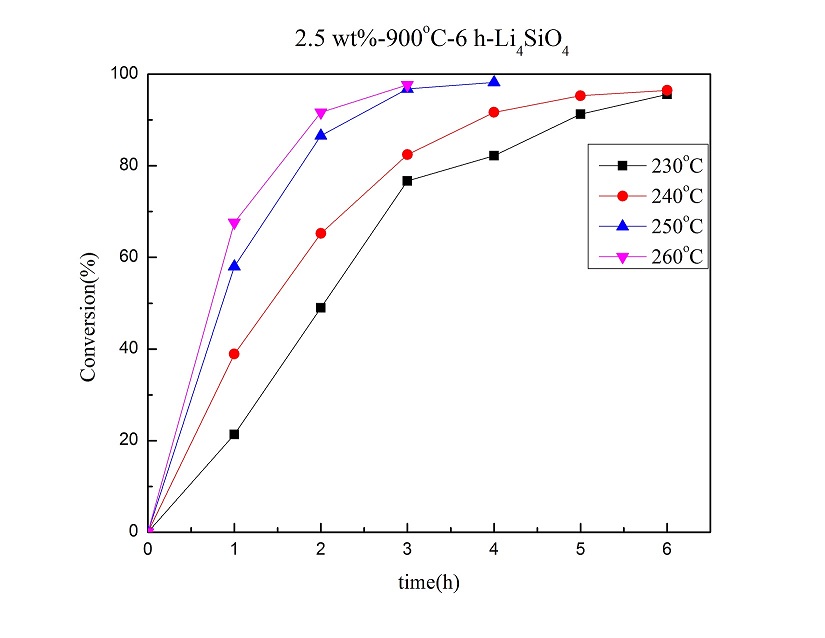
In this work, alumina supported Ca/La mixed oxides as efficient catalysts in oligomerization of glycerol were successfully prepared by the wetness impregnation method using La(NO3) and Ca(NO3) solutions as well as boehmite as support, and followed by calcination at 873K. Various instruments including BET, TPD, XRD, SEM, and ICP-OES analysis was employed for characterization of these catalysts. The catalytic etherification reaction of glycerol was typically conducted at 513 – 553K. In a typical run, the reaction was performed at 553K with a catalyst loading of 3 wt%, based on the mass of glycerol as the sole reactant and the atomic ratio of Ca/La = 2.7 on the catalyst. After 8 hours of catalytic etherification, nearly 75% of the glycerol could be converted to glycerol oligomers, while the selectivity of di-glycerol and tri-glycerol over all products was near 87%. The reusability and stability of the catalyst were tested. It was found that the recovered catalyst still showed good stability and conversion in two consecutive reactions. After 8 hours, the reaction still achieves 78% for glycerol conversion and 75% as the selectivity.
Keywords: etherification; alumina; glycerol; di-glycerol; tri-glycerol; Ca/La/alumina
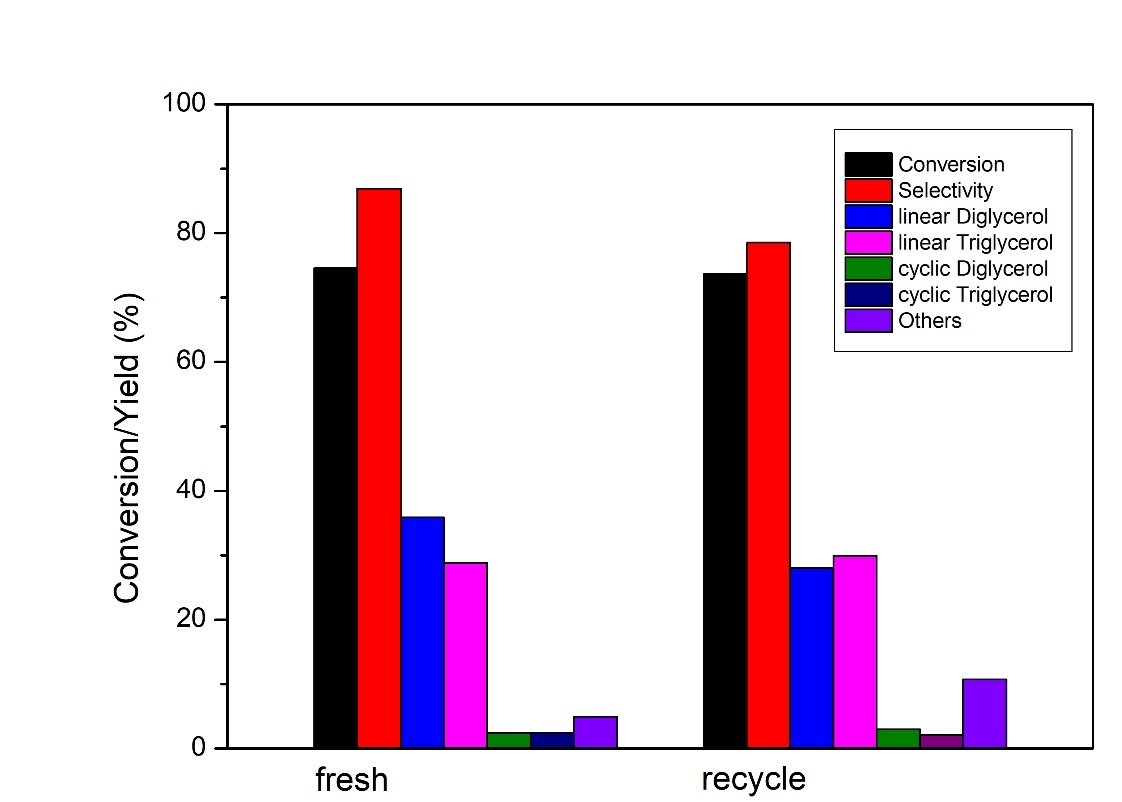
In this study, Ni/Mo bimetallic catalysts supported on zeolite ZSM-5, aka Ni-Mo/ZSM5, catalysts were successfully prepared by the wetness impregnation method to heterogeneously hydrotreat palmitic acid with an aim for the production of liquid alkane fuels. A Ni-content about 10 wt% of zeolite ZSM-5 support with various Mo-contents was found on these Ni-Mo/ZSM5 catalysts. Various instruments, such as XRD, SEM, BET, XPS, NH3-TPD and H2-TPR, were employed to characterize these catalysts. Typically, the catalyzed hydrodeoxygenation (HDO) reaction of palmitic acid was carried out in a batch autoclave at 573 K with an initial pressure of hydrogen at 35 bar at this temperature. With Ni-Mo/ZSM5 catalysts, the conversion of palmitic acid could reach near 99% at 573K after HDO reaction for 4h. Furthermore, a significant portion of isomerized alkanes were obtained in the product as revealed by GC-MS. That is, both hydrodeoxygenation and hydroisoermization reactions took place conjointly with Ni-Mo/ZSM5 catalysts.
Keywords: Biofuel, Palmitic acid, Zeolite ZSM-5, Ni-Mo/ZSM5 catalyst, Hydrodeoxygenation.
Methyl methacrylate (MMA) has been widely utilized as a raw material of poly methyl methacrylate (PMMA), a typical transparent polymer, and its global manufacturing capacity of MMA is ca. 4,500 kte/y. A few processes have been industrialized so far and ca. 30% of MMA can be produced from isobutylene. In fact, our MMA plants starting from isobutylene are well working in the world. Industrially, isobutylene is mainly derived from naphtha and it is preferable to find alternative isobutylene sources for further expansion of our activity. On the other hand, dehydration of an alcohol is a very useful reaction to obtain the corresponding olefin. As you may know, much attention has recently been paid on isobutanol dehydration to produce isobutylene, especially for the dehydration of bio-based isobutanol into isobutylene, which can be potentially utilized in MMA process. Therefore, our aim is to establish an efficient process for isobutylene production from isobutanol by dehydration. The established dehydration process could be combined with our MMA process starting from isobutylene. We have investigated the dehydration of isobutanol over alumina catalysts. The conversion of isobutanol reached 85% with 95% selectivity of isobutylene at 340oC. The main by-products were linear butenes that formed by isomerization reaction but it was reduced at high concentration of isobutanol. As a result of kinetics studies, it indicated that the reaction pathway consisting of the formation and decomposition of diisobutyl ether became preferable under high concentration of isobutanol. Characterization of alumina was executed to see correlations between crystal structure, acidic properties and catalytic performances. In addition, a long-term continuous reaction at a bench scale showed very stable performances for more than 1,500 h and a design of the potential process flow was proposed.
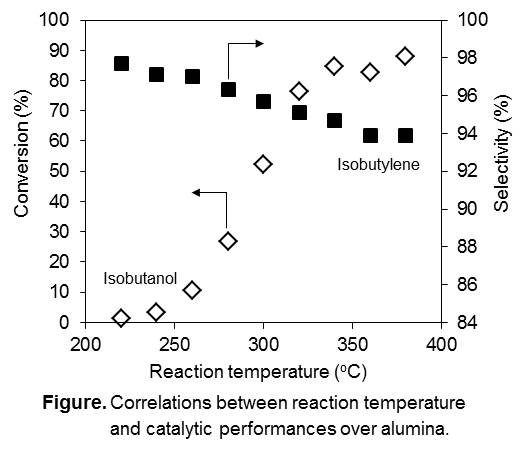
Industrial metallocene catalysts have to be supported on a MAO modified solid carrier. Micro-sized amorphous and porous silica is the most common used for supporting metallocence / MAO catalysts.
Commercial porous silica is made by a multi-step process with aqueous alkali metal silica as the precursor , which makes it less cost effective and not very environmentally friendly. Thus, there is a need to find a less expensive and more environmentally friendly silica precursor. Silica generated from agricultural waste is more cost effective and environmentally friendly than silica from traditional commercial processes.
In this study, spherical silica particles with a diameter of around 120 nm were fabricated from rice husk ash (RHA), and were used to support two bridged zirconcene complexes ((I) Me2Si(Ind)2ZrCl2 and (II)C2H4(Ind)2ZrCl2 ) for catalyzing propylene polymerization to produce polypropylene (PP) in a temperature range of 40-70 °C and in a solution MAO range of 0.1-0.6 wt%. Due to its small particle size, RHA-supported catalyst exhibited much higher activity than micro-sized commercial silica supported catalyst. At the optimum polymerization temperature of 55 °C and with increasing MAO concentration, polymer yield increased proportionally with the increase of number average molecular weight. Compared to (I), (II) produced more polymer molecules but with much shorter chain length, ascribed to the differences of Zr loading and bridge structure. With increasing polymerization temperature, polymer molecular weight and isotacticity decreased rapidly and resulted in a significant change of PP assembly morphology (shape and size). At 55 °C, (I) produced uniform PP assemblies which had dumbbell-like structure with smooth middle section and two fibrillar ends , while (II) produced spherical PP particles. The width of dumbbell middle part was essentially identical to the Batchelor microscale proposed in turbulent mixing theory.
Hydroxymethyl furfural (HMF) is a biorenewable important intermediate molecule for synthesis of a variety of furan derivatives that have a potential in fuel, solvent and polymer applications. Levoglucosenone (LGO), anhydrosugar available from cellulose pyrolysis, has recently been identified as a HMF feedstock. According to the recent studies, LGO can be converted to HMF under milder conditions only with acid and water as catalyst and solvent, respectively. To further explore the potential of this reaction, in this study, we demonstrate the HMF synthesis below 100 °C within a short time of a few minutes at high yields. HMF forms from LGO by the isomerization under acid catalysis, but LGO and HMF suffer from side reactions, excepting the hydration of HMF to levulinic acid (LA) and formic acid (FA), to form humins as unwanted polymeric side products. In the initiation step of this research, we employed high concentration of sulfuric acid (4.9 M) to promote the reaction at low temperatures and carried out the reaction in a batch reactor. However, the yield of HMF was limited to below 30%, and the formation of humins was visually apparent. This was likely caused by the presence of HMF and LGO with high concentration sulfuric acid for a long time to achieve the desired reaction temperature. To solve this problem, the reactor was changed to a microtube reactor, which enabled quick heating of the solution and precise control of the reaction time. As a result, the HMF yield was improved to above 60% in the reaction at 90 °C for 2.5 min. The highest total yield of HMF, LA and FA, indicating the reaction selectivity, was 87% at 4.0 min. When using conventional feedstock such as glucose or fructose, the product yield was much lower even with longer reaction time (<6 min).

Cellulose is one of the most important biomass resources which can be converted to value-added chemicals, e.g. mono- and oligo-saccharides, furans and organic acids. Among them, hydroxymethylfurfural (HMF), which is precursor of biofuels, polymers, medicine and the other chemicals, is one of the most important target compound. Normally, direct conversion of cellulose to chemicals is difficult because it is stable and insoluble any solvents. Because of these cellulose properties, special solvents and catalysts are developed, however, they are normally expensive and sometime toxic. For these reasons, direct conversion of cellulose to HMF by using eco-friendly way is still challenging research. Here we report that direct conversion of cellulose to HMF using saturated steam, i.e. only water. It is well known that high-pressure, high temperature water, such as subcritical or supercritical water, can promote chemical reactions including hydrolysis and dehydration of saccharides. To directly convert cellulose to HMF, firstly, glyosidic bonds in cellulose must be hydrolyzed, and then, obtained glucose must be dehydrated. Therefore, hydrolysis followed by dehydration must be proceeded in one pot. Because of high hydrolyzability of high-pressure, high-temperature water, cellulose and obtained HMF are easily converted to undesired compounds. To avoid this undesired reactions, we used saturated steam, whose hydrolyzability might be milder than subcritical water. Because of mild hydrolyzability, cellulose was effectively converted to HMF up to 21 %. In addition, we found that pretreatment of cellulose and amount of added water (W/G, molar ratio of water and glucose unit in cellulose) strongly affect to HMF yield. The obtained results indicate that possibility to produce HMF from cellulose using only water, without using special solvents and catalysts.
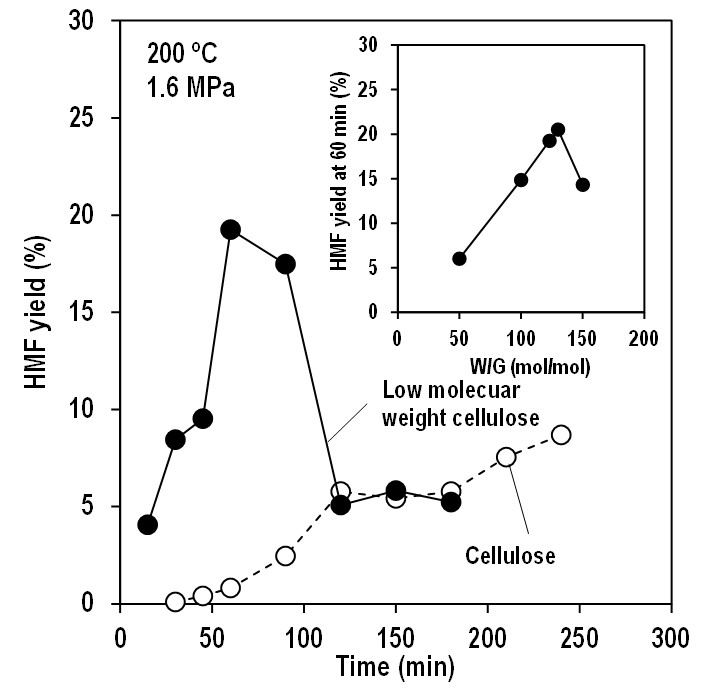
Lactic acid (LA) is the carboxylic acid that can be applied for using in food, pharmaceutical and chemical industries. An application of using lactic acid as the initial raw material for biodegradable polymer such as polylactic acid (PLA), has been an attractive issue for scientists and engineers. Although lactic acid is commercially produced by fermentation of aqueous glucose using microorganisms, biological processes have various drawbacks for example low reaction rates, and this will lead to the long reaction times and the huge reactors required. The low concentrations of products usually in water will require high energy consumption for separation and purification of lactic acid from water. Therefore chemical processes to synthesis lactic acid from petrochemical resources and other biomasses are still challenged. In this study cellulose, one kind of biomass, is used as the raw material to convert to lactic acid via hydrothermal process in a presence of catalyst. The reaction is conducted in either high pressure reactor or microwave reactor at 200oC, three types of catalysts are used, ZrO2, Al2O3 and mixture of ZrO2 and Al2O3. It is found that the catalytic conversion of cellulose to lactic acid in the high pressure reactor is quite low, the yield obtained from using ZrO2 and Al2O3 are 8.02% and 6.63%, respectively. In the case of hydrothermal process in microwave reactor using ZrO2 as catalyst, it is found that the production yield of lactic acid is higher about 35%. Therefore the microwave reactor can be used as an alternative method to increase the production rate of lactic acid.
In this study, the non-isothermal reaction characteristics and kinetics of biomass devolatilization and char gasification were investigated by TGA. Four kinds of devolatilization atmosphere (N2, N2+CO2 (10%), N2+CO2 (50%), N2+steam (10%)), three kinds of gasification atmosphere (N2+CO2 (10%), N2+CO2 (50%), N2+steam (10%)) and different heating rates (5, 10, 20, 30, 40 K per min) were adopted. Meanwhile, the gasification behaviors of in-situ char and ex-situ char were also compared. The results show that the volume reaction model and shrinking core reaction model can describe well the reaction behavior of biomass devolatilization and char gasification, respectively. With the increase of heating rate for a certain atmosphere, the typical reaction temperatures for both biomass devolatilization and char gasification increased obviously. At a given heating rate, the adopted inert and reactive atmospheres displayed a very weak influence on biomass devolatilization, regardless of reaction behavior and kinetics. However, the devolatilization atmosphere indeed had a remarkable effect on the following char gasification even for the same gasification agent. The in-situ char produced from the atmosphere of N2+steam (10%) had a higher reaction rate and a lower E than the ex-situ char generated from the N2 atmosphere, indicating the necessity of adopting in-situ char for gasification reaction analysis. For the adopted atmospheres, the calculated values of E for char gasification were ranked from large to small as N2+CO2 (50 %), N2+CO2 (10 %),N2+steam-2 (10 %),N2+steam-1 (10 %).
In order to obtain a phosphate rock equivalent, that is, calcium phosphates, from incineration ash of chicken manure which was obtained from power generation system using the manure, the incineration ash was treated with an aqueous solution of nitric acid to elute phosphorus. In using 0.3 M HNO3, most of the phosphorus could be eluted from 1.0 g of the ash within 0.1 h. Compared to composted chicken manure which was previously examined in our laboratory, the concentration of HNO3 should be increased for the elution. However, in case of incineration ash of chicken manure, since it was possible to remove inorganic species having a lower boiling or sublimation temperature and organic species by calcination in the power generation system, the concentration of phosphorus contained in the incineration ash together with the nitric acid extract became higher than those in the composted chicken manure. When nitric acid extract thus obtained was treated using aqueous NH3, the precipitation was formed. XRD showed that the precipitation is poor-crystallized calcium hydroxyapatite (Ca10(PO4)6(OH)2) which is one of main component in the phosphate rock. In order to confirm the certain formation of calcium phosphate species and the purity, the precipitation was calcined at 1,078 K for 5 h. XRD revealed that the calcined solid was tricalcium phosphate without evident contamination. These results revealed that phosphate rock equivalent could be easily obtained from the incineration ash of chicken manure and approximately 14% of phosphate rock imported into Japan can be replaced by the precipitation obtained from of the elution-precipitation treatment of the incineration ash of chicken manure.
Fenton reaction has been believed to be effective for degrading organic pollutants in the wastewater because Fenton reagent, ferrous ion and hydrogen peroxide, is not harmful and expensive. However, it is also well known that oxalic acid, a typical product of Fenton oxidation, forms oxalate complex of ferric ion to interfere with the regeneration of ferric ion to ferrous ion. As a result, Fenton oxidation is quenched with the generation of oxalic acid. Irradiation of UV light is often used to enhance the mineralization utilizing ligand to metal charge transfer of oxalate complex; however, energy consumption of light irradiation is costly. It is desired to accelerate Fenton oxidation to enhance mineralization.
In this study, effect of copper ion on the mineralization of phenol is examined. Mineralization of oxalic acid was enhanced in the presence of copper ion. It is well known that oxalate complex of ferric ion is hard to be decomposed by OH radicals generated by Fenton reaction. This is the reason why that mineralization of oxalic acid is inefficient on the light-assisted Fenton oxidation. In the presence of copper ions, oxalate complex of copper ion is formed. To clarify the reactivity of oxalate complex of copper ion with OH radicals, DMSO was added as a scavenger of OH radicals. Mineralization rate was significantly lowered in the presence of DMSO, indicating that reactivity of oxalate complex of copper ion is rather high. 500 mg/L phenol could be completely mineralized within 120 min in the presence of copper ion whereas more than 5 h is necessary in the absence of copper ion. Significant acceleration of regeneration rate of ferric ion was also observed in the presence of copper ion.
With the rapid and tremendous development of industries in the past few decades, several hazardous pollutants, especially arsenic, selenate, et al, were discharged into aquatic streams. Considering humans' health, the highly detrimental metal or non-metal ions beyond their permissible limits should be removed from the wastewater before discharge. The removal of metal or non-metal species from contaminated water has attracted worldwide attention of scientists. However, some species such as arsenite and selenate are extremely difficult to be removed by conventional methods.
With the aim to find an effective removal method for arsenite from wastewater, we applied supported Pt catalysts onto the removal of arsenite for the first time. The catalytic activity of the Pt catalysts on the removal of arsenite was investigated.
Arsenite was successfully oxidized to arsenate which can be easily removed by conventional precipitation method, with oxygen over supported Pt catalyst in an aqueous solution. The catalytic oxidation of arsenite with oxygen over Pt catalyst obeyed first-order kinetics, and the apparent activation energy was 50 kJ/mol. The catalytic activity of Pt catalyst was significantly influenced by the Pt particle size. The Pt catalyst possesses an excellent stability and can be used repeatedly with a high catalytic performance.
Thus Pt catalyst has a splendid prospective application on the removal of arsenite from contaminated water due to its outstanding catalytic performance, high chemical stability and recyclability.
The automotive three-way catalyst (TWC) is composed of platinum group metals (PGMs), which are mainly deposited on washcoated cordierite ceramic substrates via wet impregnation processes. Another substrate that consists of thermally durable Fe–Cr–Al metal foil is also used due to their attractive features such as higher thermal conductivity and lower pressure drop compared with conventional ceramic substrates, whereas the honeycomb catalysts are prepared via the same wet impregnation and/or slurry coating regardless of the different substrate materials. We recently succeeded to prepare an active Rh nanolayer catalysts on the Fe–Cr–Al metal foils using a pulsed arc-plasma (AP) deposition. Regardless of the very small geometric surface area of metal foils with nonporous and smooth surface, this new catalyst delivered a high catalytic performance for simulated TWC reaction with high turnover frequency compared with conventional Rh powder catalyst (Rh/ZrO2). A miniature honeycomb (11 mm×10 mm, 900 cpsi) was easily fabricated using flat and corrugated metal foils after coating of Rh nanolayer (Fig. b), and it showed steep light-off for NO, CO and C3H6 and complete conversion in the simulated TWC test at GHSV = 120000 h–1. Due to unnecessary of conventional wet processes such as impregnation and washcoating, we successfully fabricated the metal honeycomb converter with much higher cell density of 4,000 cpsi (Figure c) and 9,000 cpsi (Figure d), the activity of which was enhanced. The AP-processed honeycomb catalysts with surface-modified foils are promising not only for automotive TWC applications, but also for other industrial catalysts. It is a simple dry process compared to conventional wet catalyst preparation and thus the substantial decrease of PGM use may also be expected.
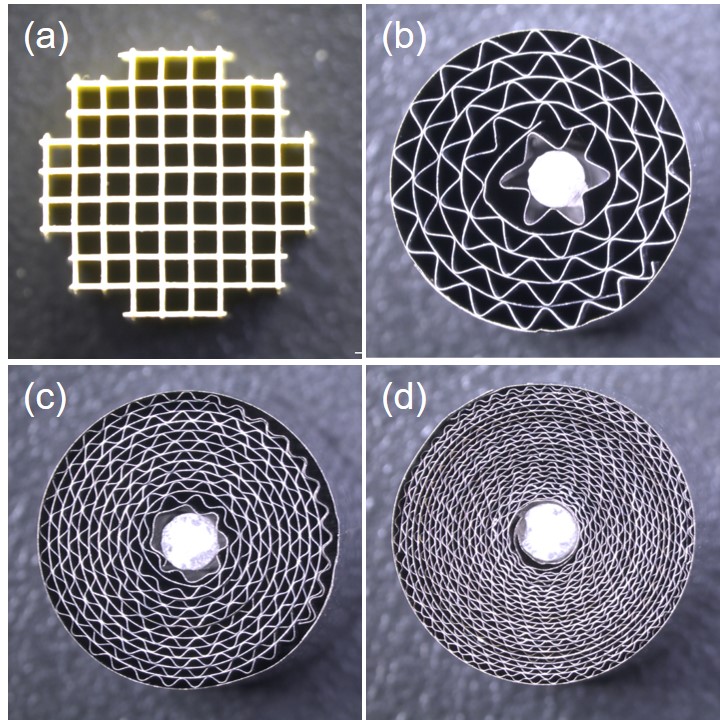
This study carried out the Density Functional Theory (DFT) calculation, to understand the catalytic activities of supported noble metal catalysts. The adsorption energies of the oxygen on the supported noble metal clusters (EDFT) were estimated for several structure models (e.g. Pt3/TiO2, Pt3/Al2O3, Pd3/TiO2, Pd3/Al2O3, Rh3/TiO2, Rh3/Al2O3 etc.). As a result, it was found that the EDFT varies depending on the chemical potential of oxide support (mMOx), d-band center of noble metal (ed) and the number of atoms (n) contained in the structural model. We proposed the empiric formula, Ecal=C1(mMOx-mO)2n/(n+1)+C2ed+C3, to estimate the EDFT values. The unknown parameters, C1, C2 and C3, can be determined so that the Ecal values corresponds the EDFT values. The figure shows the relationship between the Ecal and EDFT values. This correspondence suggests that the EDFT values can be estimated by obtaining the mMOx and ed values by the DFT calculation. The Brønsted–Evans–Polanyi (BEP) principle implies that there is a linear relationship between the activation energies (Ea) of the supported noble metal catalysts and EDFT values. Namely, there is a possibility that the catalytic activity (Ea) can also be estimated by the mMOx and ed values via Ecal values. To verify this possibility, this study carried out the experiments. The supported precious metal catalysts, with different noble metal (Pt, Pd, Rh) and different support oxides (Al2O3, SiO2, TiO2 etc.), were prepared by the impregnation method. Then, the propylene (C3H6) oxidation activities for prepared catalysts were analyzed by a fixed bed flow reactor. Moreover, the Ea values were obtained by the Arrhenius plot. As a result, a well matched correspondence was found between the Ecal and Ea values.
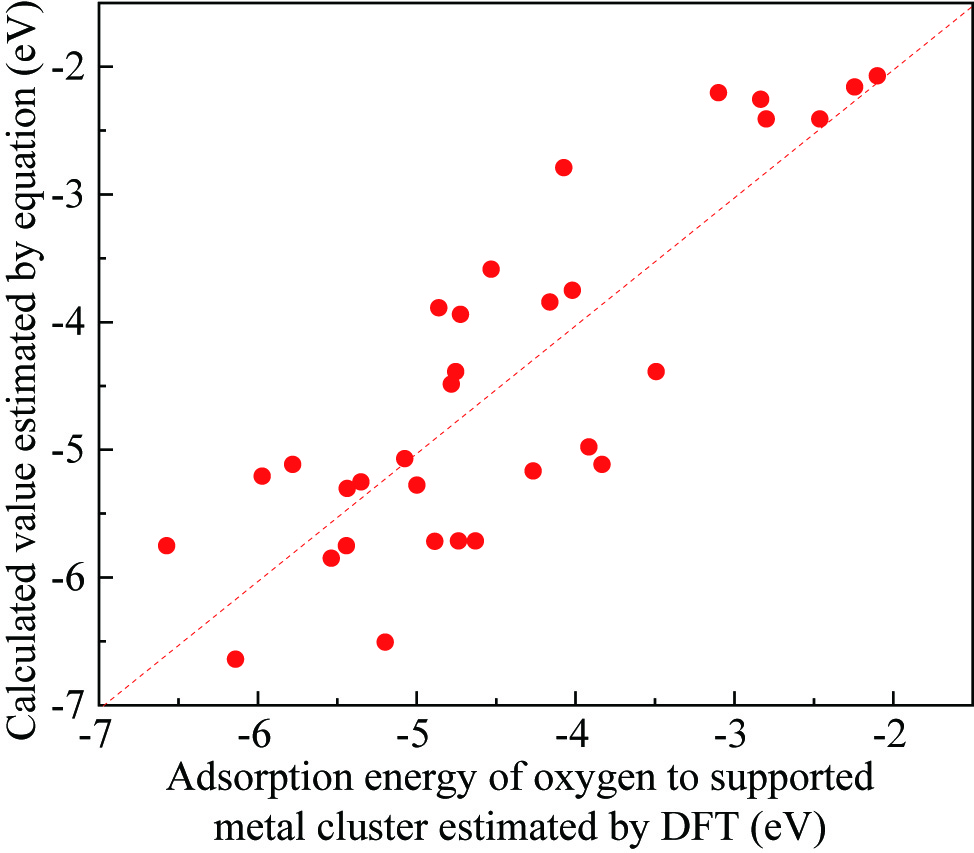
A photoresponsive tracer that changed color under ultraviolet (UV) irradiation was synthesized by immobilizing a photoacid generator and methyl orange on a poly(vinyl chloride) (PVC) carrier resin to understand photoreaction behavior in a dry powder photoreactor. The tracer changed color as a function of the received cumulative radiant energy.Tracer particles were fluidized in a fluidized bed photoreactor under various conditions and exposed to UV irradiation from the side of the reactor. The color change of the tracer during irradiation was recorded using a video camera. By analyzing the recorded images, the color transition of the tracer could be continuously detected as a change in the green component of RGB color value. The apparent photoreaction rate constant of the tracer in the fluidized bed photoreactor was successfully estimated by analyzing the rate of change in the green RGB value during irradiation. The transmission of UV into the powder layer were found to obey the Lambert-Beer law. The photoreaction behavior in the reactor was successfully reproduced by a simple two-phase model consisting of a reaction zone and a non-reaction zone. The present method for evaluating the performance of dry powder photoreactors by use of a photoresponsive tracer is very simple. Since the reaction behavior can be visualized, it is intuitively easy to understand and useful for designing dry powder photoreactors.
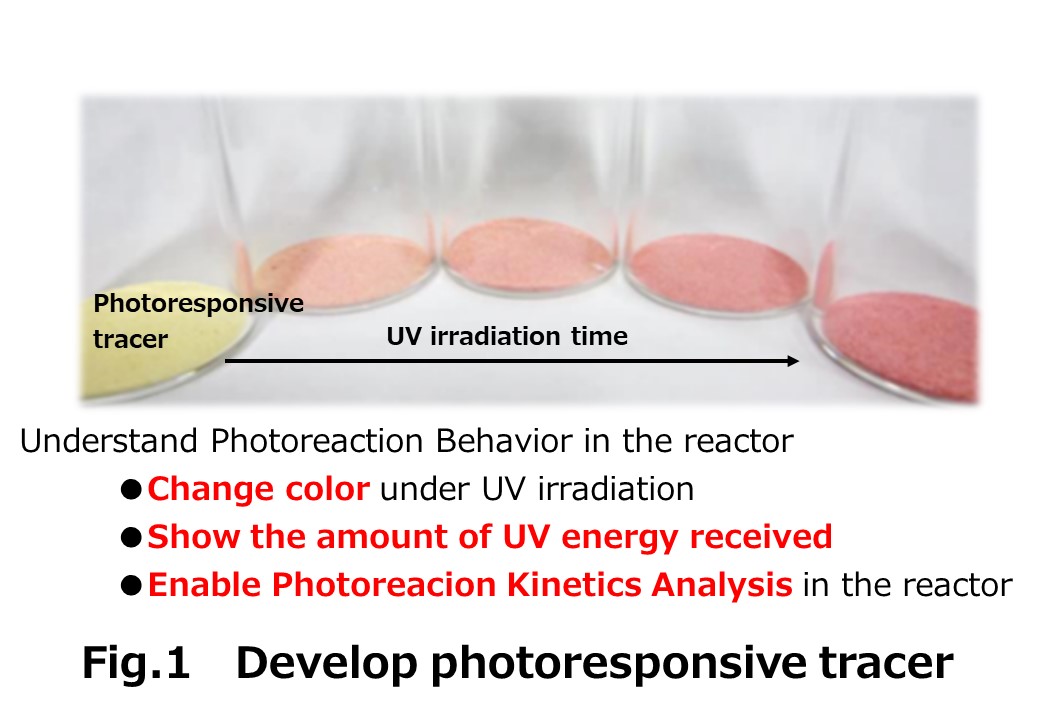
Advances in device technology have been accompanied by the development of new types of materials and device fabrication methods. Considering device design, initiated chemical vapor deposition (iCVD) inspires innovation as a platform technology that extends the application range of a material or device. iCVD serves as a versatile tool for surface modification using functional thin film. The building of polymeric thin films from vapor phase monomers is highly desirable for the surface modification of thermally sensitive substrates. The precise control of film thickness can be achieved in iCVD, creating a conformal coating on nano‐, and micro‐structured substrates such as membranes and microfluidics. iCVD allows for the deposition of polymer thin films with a variety of chemical functionality, and thus, substrate surfaces can be functionalized directly from the iCVD polymer film or can selectively gain functionality through chemical reactions between functional groups on the substrate and other reactive molecules. These beneficial aspects of iCVD can spur breakthroughs in device fabrication based on the deposition of robust and functional polymer thin films. This presentation reviews recent progress made in iCVD‐based technologies in various fields, especially for soft electronic device applications.
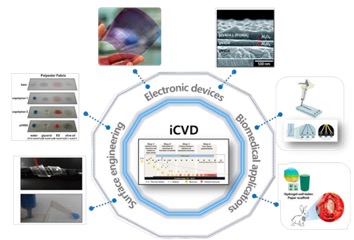
Unfavorable deposition of carbon called coke takes place in metal tube reactors used in hydrocarbon processes in the industry. The coke formation mechanism is unclear. In this study, a laboratory-scale thin tube reactor is employed for investigating mechanism of the coke formation from hydrocarbons on metal and inert substrates. Chemical vapor deposition (CVD) experiments were carried out using a quartz tubular reactor, in which 10 mm×10 mm substrates were placed. One of several hydrocarbons or a benzene solution of one of heavy hydrocarbons was supplied with diluent He to the reactor. The reaction temperature was 900 °C and the total pressure was 2.7 kPa. The space time from the inlet to the substrate was fixed at 15 ms. When benzene was supplied, coking rate was highest on the SUS 316L substrate followed by Incoloy, γ-Fe, Inconel, Nichrome, SUS 430, Ni, Cr, and α-Fe in order. This shows the catalytic activity of respective metals. On the Inconel substrate, the coking rate was approximately equal from ethylene, n-pentane, n-heptane, benzene, toluene, p-xylene, and biphenyl. The rate was almost independent of the reactant partial pressure. These resulted from solid-phase diffusion of carbon which was generated from hydrocarbons adsorbed on the metal surface near saturation. Naphthalene, phenanthrene, and pyrene exhibited ca. 10 times lower coking rate than the other hydrocarbons, which suggests more stable adsorption and slow decomposition on the metal surface. The coking rate on inert substrates, quartz, silicon, and carbon, was ca. 40 times lower than that on Inconel. The rate per unit surface area of the inert substrates obeyed an identical Langmuir-type rate equation. As a result, coking on metal surface starts with adsorption, fast decomposition on the surface, followed by fast carbon diffusion into the substrate, and slow carbon CVD on the deactivated surface continues even after completing the carburization.
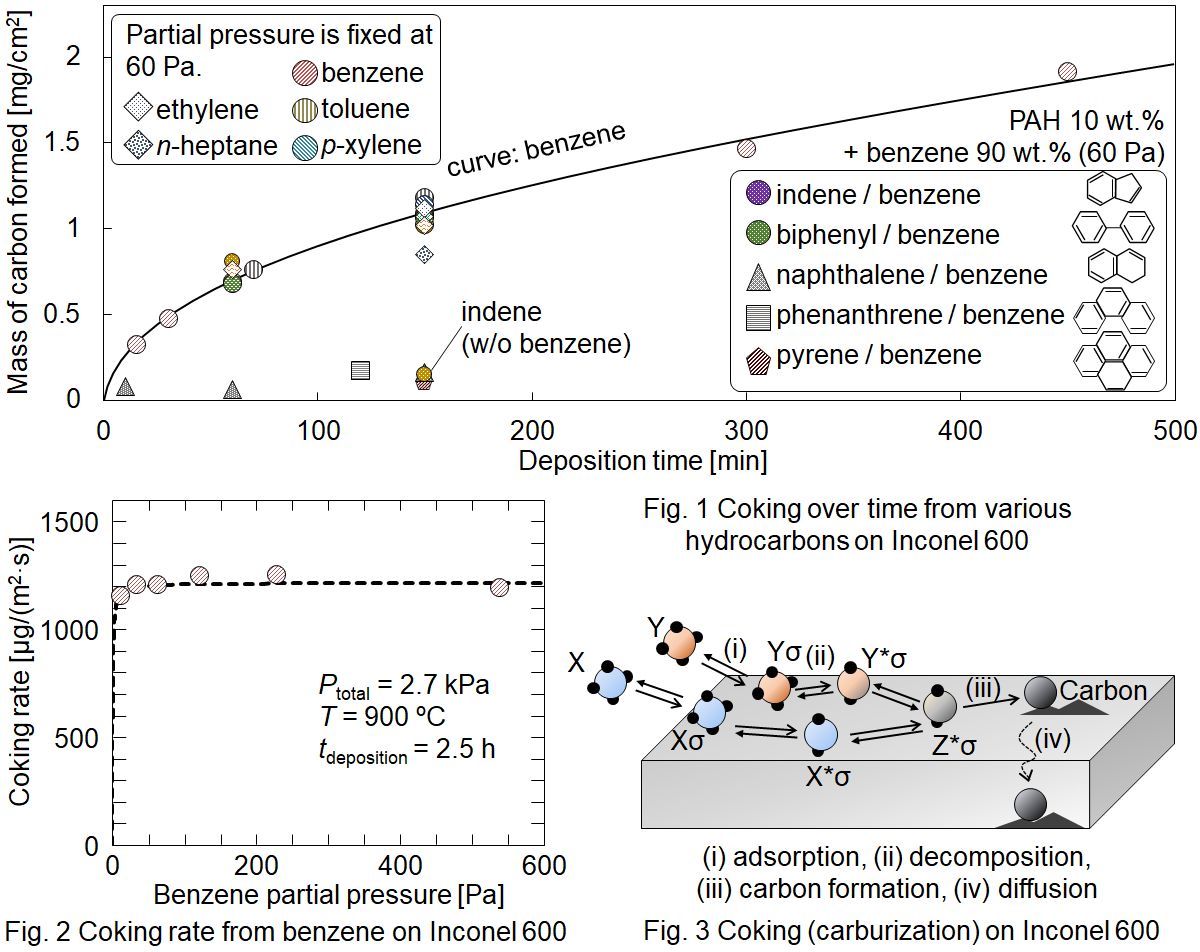
Carbon nanotube (CNT) is an emerging material with promising applications due to its superior properties. Mass production of CNT is most feasible with catalytic chemical vapor deposition (CVD). To synthesize high-quality single-wall to few-wall CNTs, catalyst nanoparticles must first be deposited on substrates. Then, using a high-temperature CVD reactor, hydrocarbons are decomposed into CNT on the substrates. The processes are intensive in material and energy. Yet, the consequential impact on the environment is rarely studied because of uncertainties in syntheses. Leveraging the experience in lab syntheses, this study aimed to evaluate the prospective environmental impact of CNT synthesized via three selected catalytic CVD methods. First, the CO2-assisted growth on flat substrates (on-substrate CVD) [Carbon, 136 (2018): p.143-149], represented the established millimeter long CNT growth. Second, the fluidized-bed growth on spherical beads (fluidized-bed CVD) with sputtered catalysts [Carbon, 50(4) (2012): p. 1538-1545], contrasted the effect of 3D CNT growth to previous 2D growth. Third, the fluidized-bed CVD with chemical vapor deposited catalysts [Carbon, 49(6) (2011): p. 1972-1979], showed a repeatable single-reactor production. We quantified the global warming potential impact of 1 g CNT production with life cycle assessment (LCA). The results for the three syntheses were 28.55, 9.94, and 2.10 kg-CO2equiv/g-CNT, accordingly (illustrated in graphical abstract). By comparing the three syntheses, we showed that the strikingly high impacts were mitigated through increasing CNT yield with fluidized bed and replacing the energy-intensive sputtering process. A scenario to substitute the remaining hotspot, argon (purging gas), with nitrogen could reduce the impact to 0.48 kg-CO2equiv/g-CNT. When considering scale-up from lab-scale (reactor diameter of 22 mm, productivity of 5 g per day) to industrial scale (diameter >30 times, productivity >3 to 104 times), the CNT production will be comparable to industrialized carbon fiber production (about 0.02 kg-CO2equiv/g-CF).
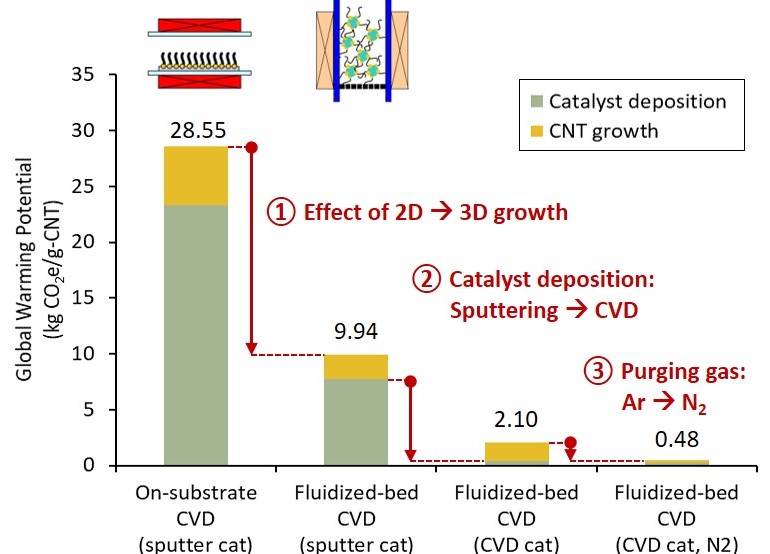
Ceramic matrix composites (CMC) consisting of SiC fibers (SiCf) and SiC matrix receive attention as a material for next-generation aerospace engines due to light weight and high heat resistance. SiCf/SiC-CMC is fabricated by weaving the SiC fibers, followed by infiltrating SiC into their interstices. Chemical vapor infiltration (CVI) from methyltrichlorosilane (MTS) and H2 is employed to infiltrate SiC fibers due to high conformality. However, perfect infiltration was unfeasible so far even by CVI because aspect ratio of the interstice is huge. We have found that SiC was formed by two growth species, one is MTS (contributes to uniformity) and the other is radical species (gas phase decomposition product of MTS, contributes to non-uniformity). Therefore, elimination of the radical species is mandatory for conformal deposition, and we proposed to use sacrificial layer for it [1]. We therefore introduced high MTS concentration (>1.2kPa), to realize higher conformality without compromising growth rate. Based on Langmuir-Hinshelwood (L-H) mechanism, we can achieve quasi-0th-order reaction at high concentration which will contribute to uniform deposition. Step coverage by MTS was thus improved from 60% to 88% using high MTS concentration. We also investigated SiCl4 gas addition into SiC-CVI for scavenging the radical growth species. Figure shows SiC growth rate and step coverage dependency on SiCl4 pressure. When SiCl4 was added, the radical was successfully scavenged, whose impact was enriched with higher SiCl4 concentration, while no impact on deposition by MTS. Consequently, combination of high MTS concentration to achieve L-H mechanism and SiCl4 addition to scavenge radical growth species is the key to achieve high growth rate and high conformality simultaneously.
[1]K. Shima et al., Society for Chemical Engineers Japan 47th Autumn meeting, Hokkaido University, O302 (2015).
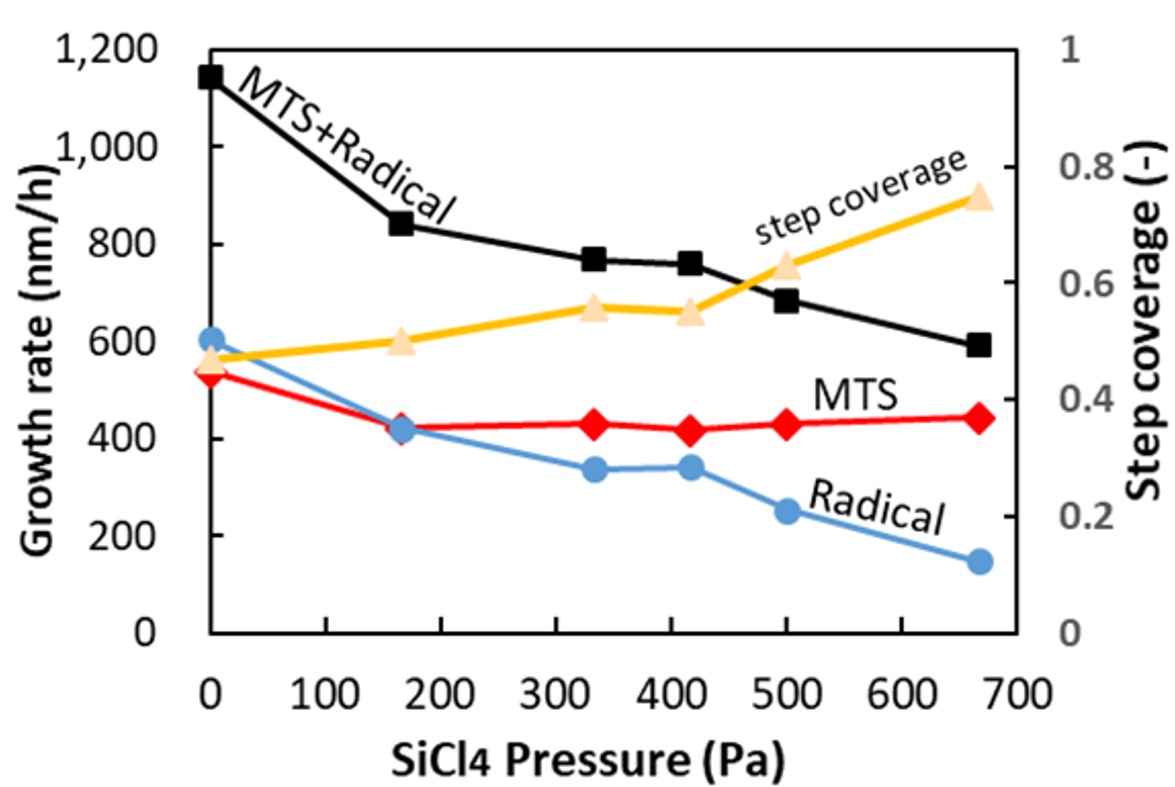
Silicon carbide (SiC) is widely used for structural materials due to high mechanical strength and corrosion resistance. Chemical vapor infiltration (CVI) from methyltrichlorosilane (MTS) is commonly adopted for its conformal deposition capability and high productivity. However, hazardous by-products, polymerized SiCl2 such as (SiCl2)n and X-(SiCl2)n-Y, are known to be piled up in a exhaust system of reactor. It compels a periodic cleaning work that takes several days for mass-productive reactor. To make matters worse, these are stable in vacuum i.e. reactor, while explode via hydrolysis when being exposed to air. Accordingly, we have to develop the way to inhibit (SiCl2)n production without resorting to unsafe experiments. First, the reaction mechanism to form (SiCl2)n was studied theoretically. The rate constants of elementary reactions starting from SiCl2 to (SiCl2)n and Cl-(SiCl2)n-Cl (n=1-3) were calculated with quantum chemical calculations, followed by coupling with existing model for H/C/Si/Cl system. Reaction kinetic simulation using the updated model revealed that SiCl2 is stable at a process temperature, typically above 900 °C; meanwhile, during temperature drop in the exhaust system, SiCl2 reacts into SiHCl3 and SiCl4 at 500-800 °C and (SiCl2)n below 400 °C. As the reaction mechanism was clarified, practical way to inhibit (SiCl2)n generation was sought. Here, we propose to inject additive gas into the exhaust system, which reacts with SiCl2 to form stable species. When CH3Cl is added at 600 °C, residual ratio of SiCl2 decreased to 0.1% in 2 sec (product: MTS). When CHnCl4-n (n=2-4) is added above 800 °C, the residual ratio decreased below 1% in 1 sec (product: SiCl4). It is recommended to add CH3Cl around 600 °C or CHnCl4-n (n=2-4) above 800 °C into exhaust gas to inhibit (SiCl2)n production. This conclusion has already been verified experimentally. Although this work was conducted for SiC-CVI, the same solution is applicable to Si-CVD from SiHCl3 or SiH2Cl2.

Malaysia is the second largest producer of palm oil, producing 17.3 million tons, or approximately one third of the total world supply in 2016. In parallel with the palm oil production, a huge amount of biomass residues are generated by the industry including oil palm plantations and palm oil mills: empty fruit bunch (EFB) 18.3, mesocarp fiber 11.0, palm kernel shell (PKS) 4.6, trunk 17.4 and fronds 125.3 t-wet/year. Mesocarp fiber is almost fully utilized as solid fuel for producing electricity and steam at palm oil mills. About PKS, some are utilized for electricity and steam at palm oil mills (the same use as mesocarp fiber), some are being traded as solid fuel. EFB is underutilized. There are three representative thermochemical conversion techniques developed for this kind of lignocelluosic biomass residue: torrefaction, fast pyrolysis and gasification, which produce solid fuel, bio oil and syngas, respectively. The most significant obstacle for commercialization of biomass use is not the level of conversion technology itself, but logistics. Logistics for biomass is still really immature in comparison with fossil fuels; such as coal, crude oil and natural gas. In this sense, biomass use in small scale is prioritized way to start due to its lower risk in terms of logistics. In this talk, the presenter will introduce torrefaction , of which product can be commercialized in small scale, or with less logistic risks. Combustion gas utilization for torrefaction will be introduced as a lower running cost process. The concept is illustrated in Fig. 1.
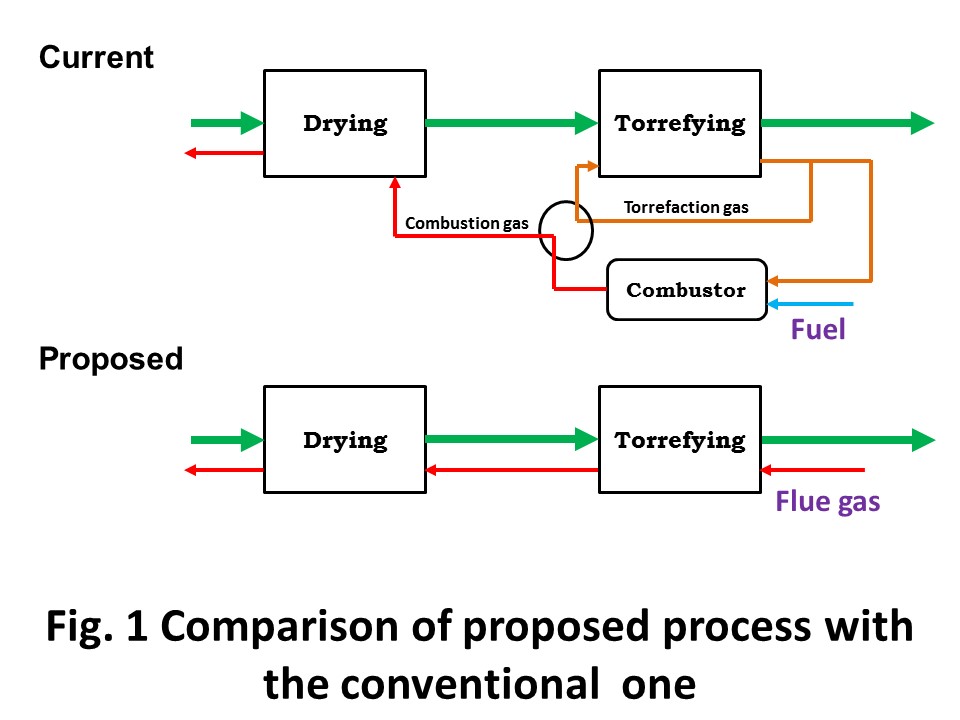
In this study, non-equilibrium atmospheric pressure pulsed discharge plasma technique using a gas-liquid slug flow in glass column is applied to water containing methylene blue (MB) degradation. The reactor was comprised of 4 rows glass column bundled by copper foils that attached on the outside of the column surface. Moreover, the foils were used as high-voltage electrodes totally in 5 parallels. As the ground electrode, copper foils were attached on column at distant of 25 mm from high-voltage electrode in the same way. The water solution and the gas were flowed simultaneously in glass column to form the slug flow system. The generated bubble motion interval was controlled by adjusting the flow rate of gas and liquid. In this time, MB solution and each gas were flowed at 1.5 and 0.15 ml/min, respectively. After the flowing bubbles in the glass column became steady, an electrical discharge was introduced into the slug flow system by using AC power supply with a bipolar pulsed output voltage to generate plasma in bubbles between electrodes. The output voltage is 9 kV at 10 kHz repetition and its pulse duration is 10 μs. The reaction was conducted totally in 120 min, and the degradation ratio was measured every 20 minute. As a result, over 90 % of MB were degraded for all of the gas species (O2, Ar, He). Especially in the case of O2, mostly all of the MB was degraded in 120 min. This implies many kinds of active species originated by oxygen were dissolved in plasma treated water. However, the amount of hydrogen peroxide was higher in Ar and He. Finally it was confirmed that the degradation rate in this method was higher than that in other plasma methods such as atmospheric pressure plasma jet.
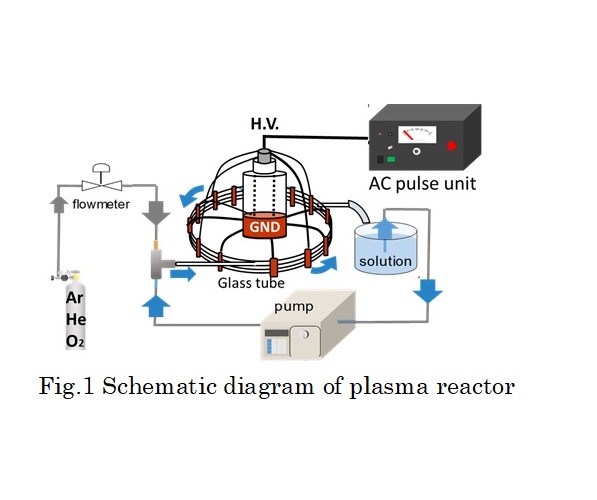
With record heat spreads all over the world, global warming has become an issue that cannot be ignored for human beings, and greenhouse gas emissions must be curbed and reduced. In particular, carbon dioxide (CO2), which accounts for the majority of greenhouse gas emissions, is the most important target of emission control and reduction. Although CO2 is a very stable compound with high standard redox potential, it can be converted to industrially useful substances such as carbon monoxide, formic acid and hydrocarbons reduction. It is possible to reduce not only greenhouse gases but also produce a resource. Various studies have been conducted to reduce CO2 using renewable energy, excess thermal energy and electrical energy. We have tried to reduce CO2 electrochemically using metal catalyst electrode and convert it to useful substance. Many studies have revealed that the main products of CO2 electrochemical reduction differ depending on the metal species. In the metal species, this study focused on zinc(Zn). Zn is known to produce carbon monoxide (CO) as a main product of CO2 electrochemical reduction as well as gold and silver, while having abundant reserves. In addition, it is expected to selectively generate CO because the overpotential of hydrogen generation is also large and hydrogen generation is suppressed. In this report, surface modification of Zn electrode has been performed by anodization. By changing the conditions of anodic oxidation, different surface modifications were successfully performed and it was successful that prepared Zn electrodes showed quite different product selectivity such as CO and formic acid in CO2 electrochemical reduction. In order to clarify the factor of this product selectivity, it carried out by surface analysis and electrochemical characteristics of the electrode. It was revealed that the product selectivity can be controlled by changing the anodization condition.
Recent manufacturing processes for high-performance crystal particles require the advanced control technologies of crystal structure and morphology. In order to develop the crystallization process for the desired crystal particles, it is important to understand the crystallization behavior from a microscopic viewpoint and actively control the nucleation and crystal growth in solution. We have studied the crystallization behavior of aqueous microdroplet of salt solution using electrodynamic balance (EDB), where a charged droplet could be electrically levitated in space over the periods of hours. It enabled us in situ observation of crystallization behavior in a levitated microdroplet with enough spatial and time resolutions. In this presentation, we directly observed the nucleation and crystal growth in the aqueous NaCl microdroplet . It was found that the finally produced crystal particles had different several morphologies which were mainly influenced by the diameter and the charge of a levitated droplet.
In essence, ionic liquids (ILs) are salts with melting points at or below 100 °C, which are composed of organic cations and organic or inorganic anions. Owing to their distinctive properties, such as low melting point, wide liquid range, extremely low vapor pressure, sound thermal stability and wide electrochemical windows etc., ILs are used in a number of application areas. However, some recent studies are noteworthy, showing that ILs are flammable during thermal upsets. Other studies have also indicated that the gas phase of decomposition products from ILs is spontaneous combustion and easy ignition. To accomplish the objective, thermogravimetric is used to examine the thermal stability of 1-ethyl-2,3-dimethylimidazolium nitrate ([C2mmim][NO3]; C7H13N3O3). Under the dynamic heating conditions, [C2mmim][NO3] is considered to be decomposed until approximately 280.0 °C. Meanwhile, lower hydrophilicity leads to better thermal stability of [C2mmim][NO3] than [C2mmim][X] (X represents halogen). However, due to the limitations of the dynamic heating experiment, [C2mmim][NO3] is found to be decomposed before the lowest measured decomposition temperature under dynamic conditions. Moreover, the combination of the homemade combustion test device and high speed camera are used to investigate the combustion process of [C2mmim][NO3]. The results indicate that the flammability of [C2mmim][NO3] is caused by the combustible decomposition products (see Figure). Therefore, the entire decomposition and combustion process of [C2mmim][NO3] is fully characterized based on the results of thermogravimetric with fourier transform infrared spectrometer.
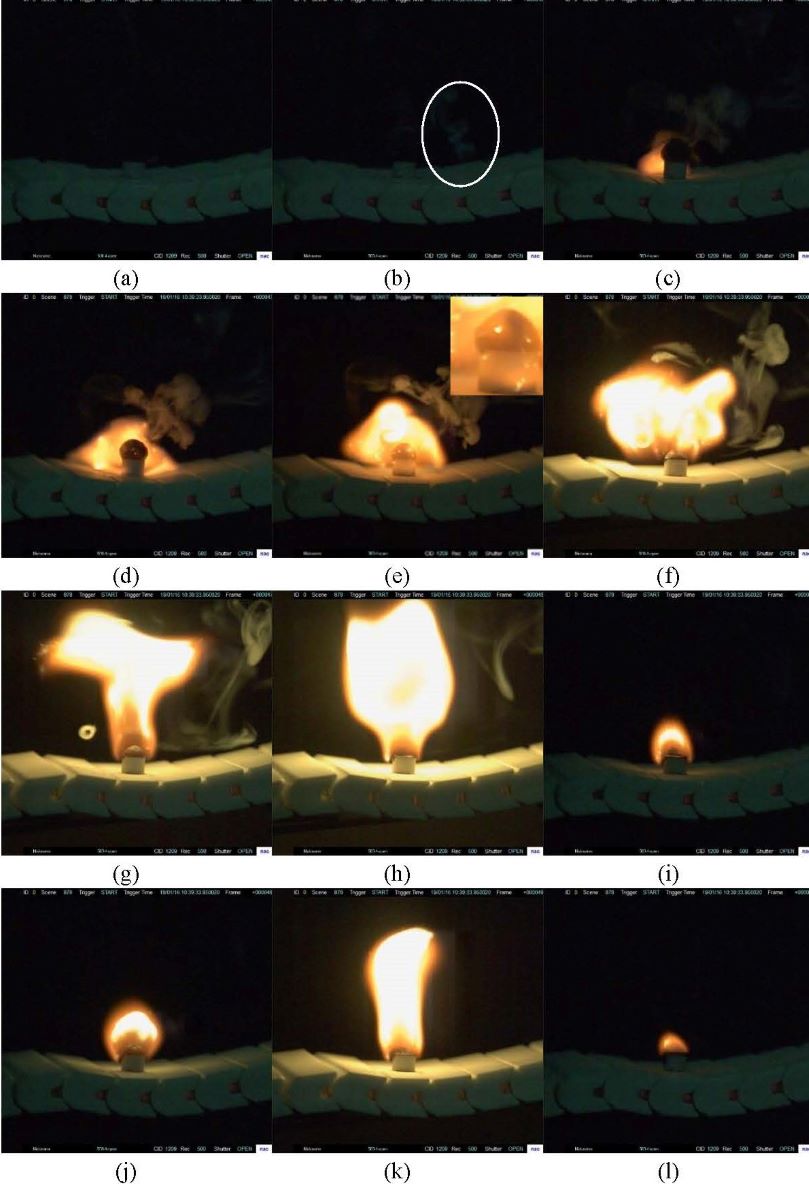
Grignard reagent is often synthesized from magnesium and halohydrocarbon in dry ether such as tetrahydrofuran(THF) or diethyl ether(DE). The Grignard reagent formation(GRF) is a strong exothermic process which has an induction period. If the material is accumulated due to improper initiation, it is easy to cause the thermal runaway after the reaction is suddenly triggered. With the development of green chemistry, more and more chemical companies have begun to develop safer Grignard reagents by changing the solvents. Therefore, it is particularly important to carry out the reaction thermal safety risk assessment for the GRF in different solvents and establish the critical criterion for the thermal runaway reaction of the GRF.
In this work, the n-butylmagnesium bromide GRF was taken as an example. The safety risk assessment of the GRF was carried out by using a cooling failure model using THF, DE, cyclopentyl methyl ether(CPME) and diethylene glycol dibutyl ether(DGDE) as solvents. RC1e and EasyMax have been manufactured by METTLER TOLEDO and used to measure the exothermic conditions of reaction. The kinetic model of GRF was obtained by the experiments. The experimental results show that the safety risk level of GRF by using THF and DE as solvent is grade 3, and it is reduced to grade 1 by using CPME and DGDE as solvent. The latter two reactions have lower exothermic and adiabatic temperature rise than the former two. The critical criterion for the thermal runaway of GRF with THF and DE was established, which has certain guiding significance for the safety of GRF. The experimental results also show that the reaction temperature and the stirring speed have influence on the induction period. In the next step, the authors intend to explore the mechanism of the factors which have the influence on the induction period of Grignard reagent.
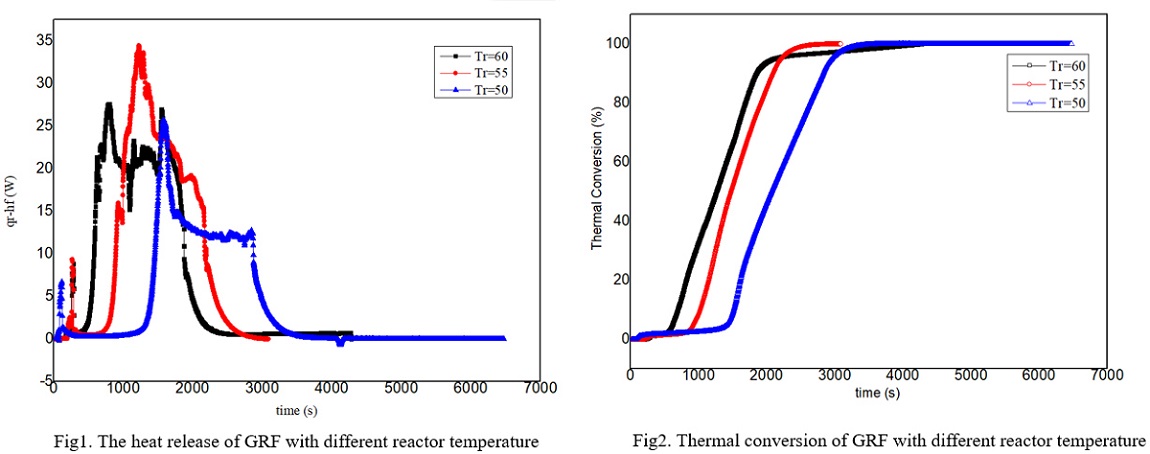
Introduction
Chemical manufacturing processes in flow system have attracted attention in the field of organic synthesis. To realize energy- and cost-saving processes in the organic synthesis, using immobilized catalyst in flow reactor is a strong tool. Macroporous monolith has a three-dimensional through pore and large specific surface area contributing to its high performance in flow application. In this study, the macroporous monoliths containing L-proline-based organocatalyst were developed for asymmetric aldol addition reaction in flow system (Figure 1 (a)). The effects of porous properties of the monoliths on their catalytic activities and enantioselectivities were investigated in detail.
Results and Discussion
Macroporous monolith was synthesized by copolymerization of O-acryloyl-4-trans-L-hydroxyproline, acrylamide, and N,N'-methylenebisacrylamide in DMSO/alcohol. The porous structures of the monoliths were controlled using different porogenic alcohol (EtOH, BuOH, OcOH, and DoOH). Different length of alkyl chain of porogenic alcohol gave different porous properties, which can be explained by solubility of monomers and polymers in the solvent system.
The L-proline-containing monolith was applied to batch and flow aldol addition reaction between p-nitrobenzaldehyde and cyclohexanone (Figure 1 (b)). Interestingly, the catalytic performance of the monoliths was controlled by their porous properties in batch system. These monoliths with different porous structures were packed in stainless steel columns to construct flow reactors. With a residence time of 12 h, the flow system using the monolith was stable during over 10 days operation and achieved high enantiometric excess (ee) (Figure 1 (c)). However, the porous structure of the monoliths did not affect the catalytic activity and selectivity significantly. To reveal the relation between the monolithic structure and activity and selectivity of the catalytic reaction, the behavior of the substrate solution diffusing through the monoliths will be reported in the presentation.
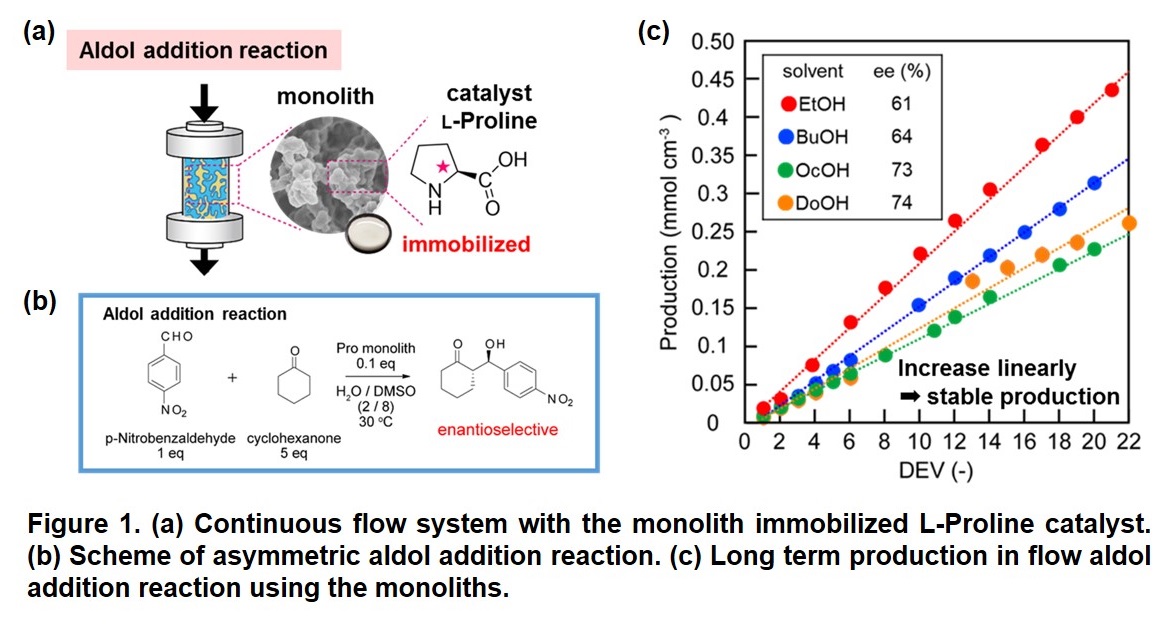
Transition-metal-catalyzed cross-coupling reactions are strong tools for production of active pharmaceutical ingredients with high reaction efficiency, selectivity, and energy saving. Because flow system has advantages over batch system for cost- or energy-efficiency, safety, and automation, the development of flow cross-coupling reaction has been motivated. Particularly, transformation of inactive and inexpensive aryl chlorides under flow condition are highly desirable but have been rarely reported.
Typically, flow cross-coupling reactions require careful design of reactor because of inorganic base reagents and salt byproducts. The inorganic components insoluble in organic solvent cause serious issues of clogging in the reactor. One general solution is to use solvent system which solubilize both organic and inorganic compounds. Some reports have demonstrated that use of organic/water biphasic solvent is beneficial for complete solubility of all the components and efficient cross-coupling reaction. We postulated three-keys to achieve challenging flow cross-coupling reaction: 1) organic/water solvent, 2) immobilized catalyst, 3) efficient mixing; but never demonstrated experimentally yet.
Herein, we first report an application of macroporous polystyrene-triphenylphosphine monolith (M-PS-TPP) to palladium (Pd)-catalyzed Suzuki-Miyaura cross-coupling reaction in flow system (Figure 1a). The M-PS-TPP was synthesized by copolymerization of three-fold cross-linking triphenylphosphine, divinylbenzene, and p-tert-butylstyrene. The macroporous structure of M-PS-TPP was fabricated via polymerization of water-in-oil high internal phase emulsion (HIPE) template. The M-PS-TPP had characteristic window and void structure with the pore sizes of 2–5 and 10–20 micrometer (Figure 1a, inset). Pd-loaded M-PS-TPP column was applied to flow Suzuki-Miyaura cross-coupling reaction between 4-chlorotoluene and phenylboronic acid in THF/water biphasic media containing K3PO4. Tuning the column length and residence time (tau) achieved efficient mixing and high production efficiency in the reaction (Figure 1b).
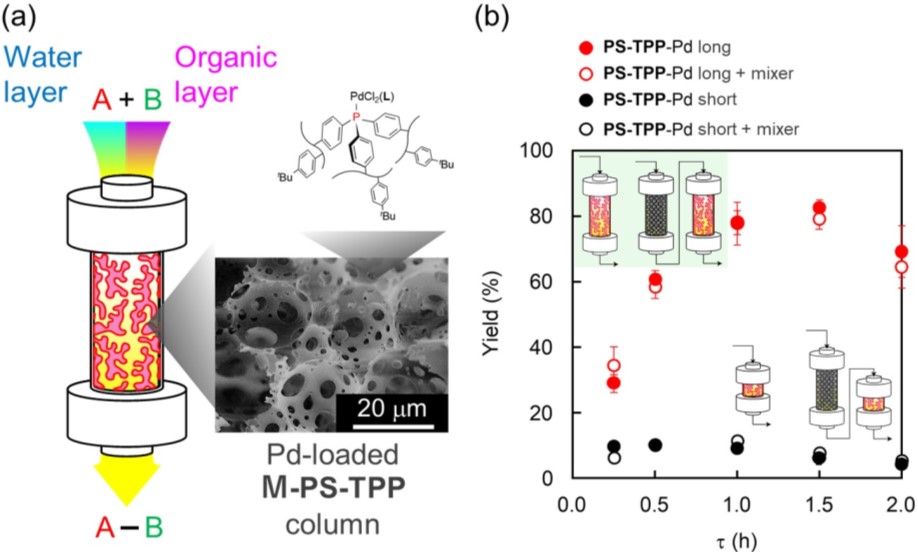
Silver nanoparticles have caught a wide attention due to its unique physical and chemical properties. Silver nanoparticles embedded in polyvinyl alcohol-polyvinylpyrrolidone (PVA-PVP/Ag) free-standing films are prepared by microwave irradiation within few minutes with varying ratios of the polymers. PVA and PVP perform as reducing agents and stabilizing agents as well as support for silver nanoparticles. The catalyst is characterized by UV-Vis spectrometry, SEM and TEM where the analytical results affirm the reduction of silver ion to silver nanoparticles in the polymer matrix. Good dispersion of silver nanoparticles in the film is confirmed by TEM analysis and the size of silver nanoparticles is found to be in the range of 2-10 nm. This film is used as catalyst for the synthesis of a β-enaminone, 4-phenyl-amino-pent-3-in-one from acetyl acetone and aniline, where silver nanoparticles act well as the catalytic agent of the composite catalyst. A typical reaction shows 89% conversion of aniline to β-enaminone at 600C with this catalyst. Parametric effects on the reaction are studied and heterogeneous kinetic model is proposed for the reaction, where Eley-Rideal model shows good fitting of experimental data. The model parameters are also evaluated and found satisfactory with a high value of correlation factor.
In industrial Vinyl chloride monomer (VCM) manufacturing, the oxychlorination process is most important in terms of elemental efficiency. In this study, we report the reaction kinetics analysis of deactivated catalysts in Oxygen-based oxychlorination plant.
The 11wt%CuCl2-3.4wt%KCl/Al2O3 (Upper) and 11wt%CuCl2-2.7wt%KCl/Al2O3 (Lower) catalysts were prepared according to the conventional impregnation method. These fresh catalysts were subjected to an endurance test in a commercial plant. After two years operation, the catalyst layer was divided into seven positions from the inlet and sampled (1st to 4th were upper catalyst, 5th to 7th were lower catalyst). The chemical properties of fresh and used catalysts were evaluated using a fixed-bed reactor and some instruments.
The figure 1 shows a relationship between oxychlorination activity of the catalyst sampled from each position of the reactor and the ratio of potassium and copper elements (K/Cu). The activity shown here is the relative activity when the initial catalyst performance is 100%. In the used catalysts, the K/Cu ratio increased with operation time due to a decrease of copper accompanying sublimation. As a result, a tendency of activity decreasing due to an increase in the K/Cu ratio was confirmed.
The table 1 shows the activation energy and the partial pressure dependences of raw material gases of the fresh and used catalysts, which was estimated by a kinetic study. A correlation was found between partial pressure dependences and the K/Cu ratio caused by sublimation of copper, but it was slight. On the other hand, the activation energy of the deactivated catalyst tended to increase significantly with the increment of the K/Cu ratio.
Furthermore such an increase tendency of activation energy was utilized for predicting catalyst life. As a result, the simulation applying the increasing tendency of activation energy showed a good agreement with the measured value after 2 years.
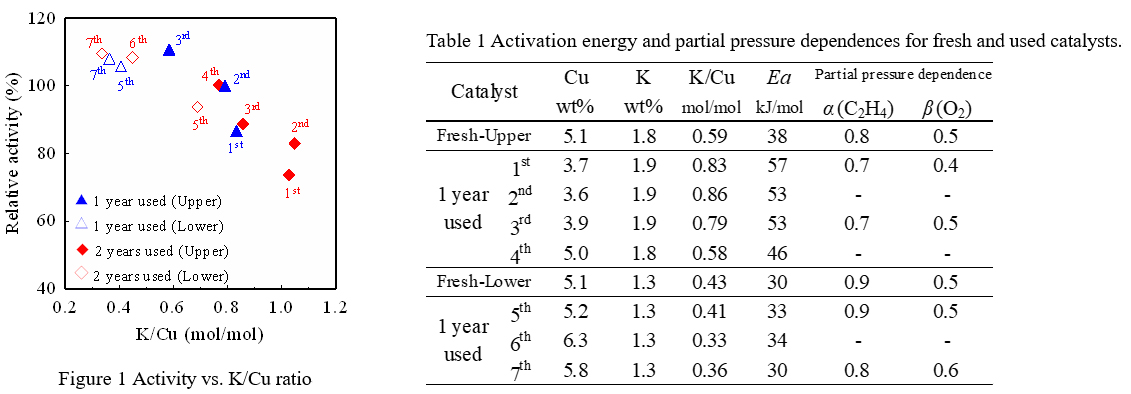
Oxygen-based oxychlorination is one of the efficient processes for producing 1,2-dichloroethane of a key material in vinyl chloride production. Despite abundant researches about the commercialized CuCl2-KCl/Al2O3 catalyst, its deactivation characteristics has not been fully understood. Besides, a carbon deposition property has not been examined in detail. Therefore, this study focuses on the clarification of the deactivation factor by XANES analysis of the commercialized catalyst as well as a measurement of the deposited carbon by temperature programmed oxidation (TPO).
The CuCl2-KCl/γ-Al2O3 catalyst was extracted from the industrial reactor after one- or two-years operation. The performance of the used catalyst was then evaluated by a fixed-bed reactor at laboratory scale. The deposited carbon was measured by TPO and the Cu oxidation state was investigated by Cu K-edge XANES analysis.
Table 1 shows a relative activity and the amount of coke on the two-years used catalsyt. The relative activity was defined as the conversion of the used catalyst devided by the conversion of the fresh catalyst. Althogh the catalyst at the inlet part was deactivated to 74-89%, the activity at the outlet part was still high. As for the amount of the coke, the more coke was observed at the outlet part, comparing to that amount at the inlet part. Fig. 1(a) shows XANES spectra of two years used catalyst. While the spectrum of the catalyst at the inlet part was similar to that of CuCl2, the catalyst at the outlet part was similar to that of CuCl. The Cu species of the outlet part catalyst were reduced state. Fig. 1(b) exhibits the relation between Edge jump energy (E0) and the reactor length. The E0 value was decreased from the inlet side to outlet side. The difference of the oxidation state might cause a deactivation of the catalyst and coke deposition property.
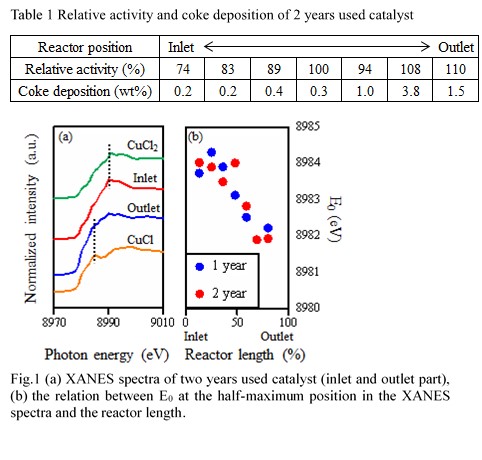
Organic-inorganic hybrid perovskites, such as methylammonium lead iodide (CH3NH3PbI3) have shown outstanding optoelectronic properties, promising extensive application in solar harvesting. Although most hybrid perovskite materials have been synthesized under solution process, recent demonstrations of the vapor phase synthesis of the hybrid perovskite nanostructures suggest there is an emerging interest in controlling their properties under highly-confined structures. In particular, single-crystalline 1D lead halide nanowires can be prepared via the vapor-liquid-solid (VLS) growth mechanism through the self-catalyzed growth mechanism, which then converted to hybrid perovskite. Since the conversion occurs on the preformed nanowire, electronic properties 1D perovskite depend on the original nanowire structure. In this study, we report the VLS growth of lead iodide (PbI2) nanowires on a c-sapphire (0001) substrate followed by conversion to CH3NH3PbI3 using methylammonium iodide, and confirm that the degree of perovskite conversion depends on the growth orientations of PbI2 nanowires. We observe two different growth directions; vertically-oriented [0001] nanowires and kinked nanowires. Photoluminescence (PL) measurements on each growth direction suggest that the oriented nanowires exhibit a higher degree of conversion compared to the [0001] oriented nanowires. In addition, [0001] oriented nanowires exhibit the position-dependent degree of conversion, depending on the presence of the catalyst tip on top of the nanowire. In particular, the conversion is observed both on the catalyst tip and the base of nanowire, suggesting methylammonium iodide incorporates into the nanowire either by vapor transport and surface diffusion. Our observation indicates that the vapor phase conversion of PbI2 to CH3NH3PbI3 is a diffusion-limited process. This finding is an important step towards a structural engineering of perovskite nanowires.
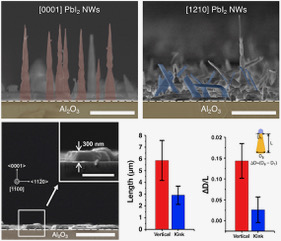
Methanol is an important industrial chemical and a raw material for the synthesis of various chemicals. It is mainly produced from synthesis gas, but the thermodynamic equilibrium in methanol synthesis results in a low conversion per pass. The use of a membrane reactor to improve the conversion per pass of the methanol synthesis has been considered. However, simultaneous membrane separation of methanol and H2O from H2 at high temperature is still difficult.
In this study, we developed a new concept on chemically stabilized ionic liquid (IL) membranes which are organosilica membranes with IL like properties prepared from silylated ILs. ILs have been used in membrane separation for more than a decade due to their special features such as non-volatility, thermal stability and ability to dissolve a large range of organic molecules. Gas/vapor permeation tests revealed that permeation separation performance of the membrane is strongly controlled by the affinity of the permeate molecules toward the IL, and its permeation and separation mechanisms are explained by a combination of the selective adsorption/pore blocking effect and the solution-diffusion mechanism.
The separation factors for methanol/H2 in the binary system were 12–48 in the temperature range from 100 to 200 °C. The membrane also showed high H2O/H2 separation performances in methanol/H2O/H2/CO2 quaternary system, and the presence of H2O and CO2 in the feed stream did not affect the methanol permeation performance. Methanol and H2O permeances of the developed membrane were higher than those of the Li-Nafion membrane, and comparable to values of the zeolite membrane. The silylated IL-derived organosilica membrane showed an excellent potential for the simultaneous separation of methanol and H2O from methanol synthesis gas.
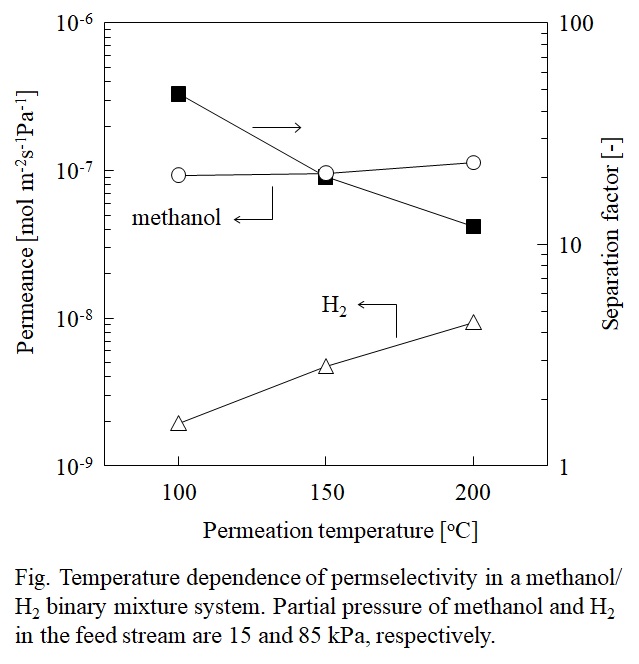
Synchrotron X-ray powder diffraction has begun to stretch its strategic presence from the sheer determination of crystal structures into the mechanistic and kinetic information of microporous zeolite materials. Not only can this technique be used to reveal the internal framework structure of zeolites and their active sites, but it can also be combined with other analytical tools to suit the particular needs for in situ or operando gas storage and separation and catalytic studies.
With a keen interest in materials and catalysis, our research group has focussed on the fundamental aspects of zeolite materials. We have developed a new structural methodology by combining state-of-the-art synchrotron X-ray facilities with other characterisation techniques, that can:
(i) Directly visualise how organic molecules behave and interact with the BAS of zeolites.
(ii) Provide mechanistic information for important industrial processes.
(iii) Engineer new catalytic system for industrial processes.
(iv) Explain the reaction mechanisms and kinetics of new biomass conversion reactions.
(v) Design a novel enzyme-mimic inorganic system.
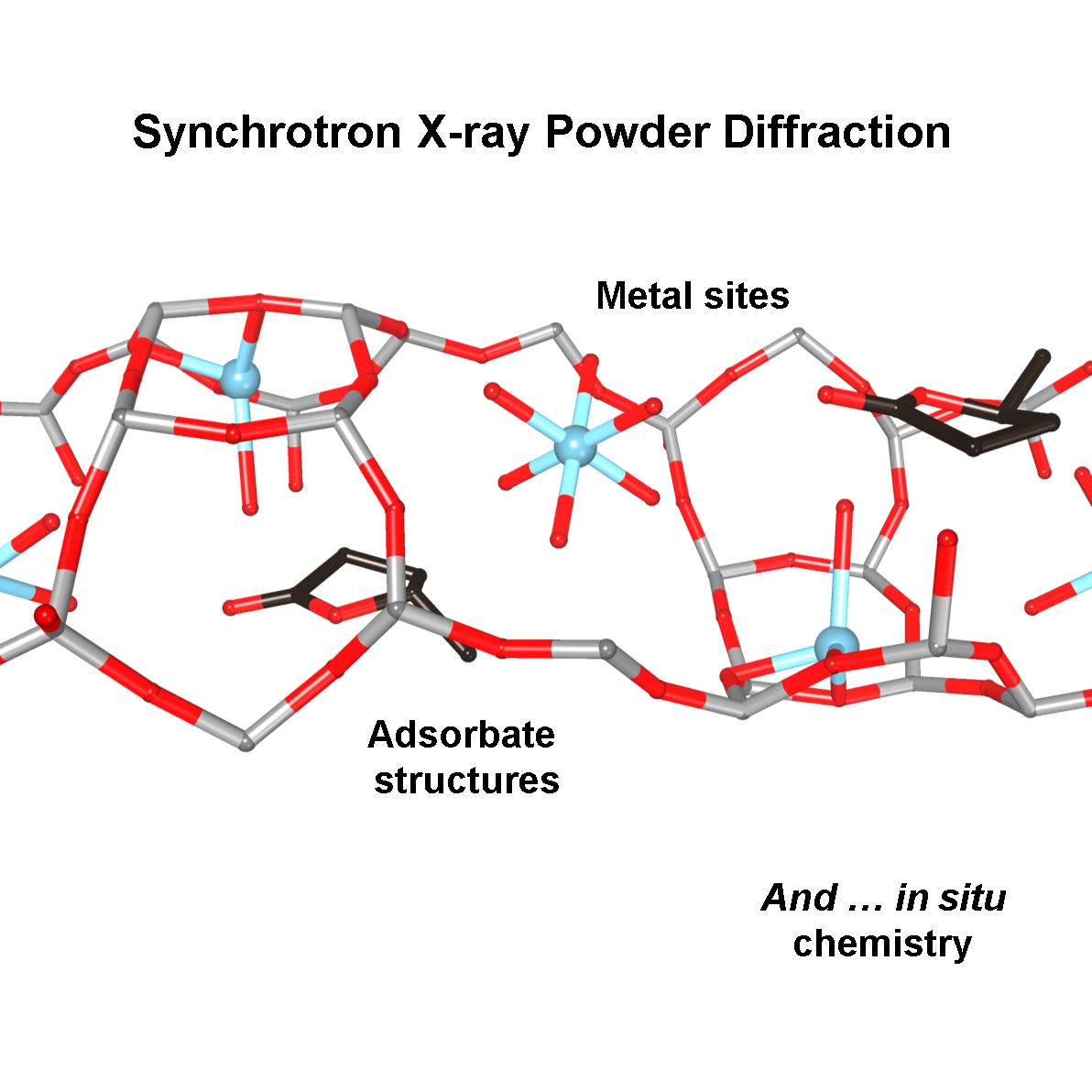
Atmospheric pressure plasma has been applied to induce a variety of unique reaction fields by supplying highly reactive species such as electrons, radicals, and ions. Among them, plasma reaction combined with water-based system has attracted intense attractions because plasma-water interaction generates various reactive species from dissociation of water molecule. Herein, applications of plasma-water interaction for fabrication of nanomaterials and treatment of waste water are introduced. Each application shows unique reaction system using various kind of plasmas and investigate the effect of plasma-water interaction. For fabrication of nanomaterials, plasma-assisted anodization and simultaneous reduction and immobilization of silver are described. Anodization of copper and zinc could be conducted using plasma in deionized water without addition of electrolyte. In this study, plasma-water interaction could increase electrical conductivity of deionized water by plasma electrolysis and trigger anodizing behavior. Meanwhile, silver nanoparticles were synthesized from reduction of silver nitrate with assist of plasma which provides reductive species. Especially, the reduction of silver could be accelerated by adding ethanol of which dissociation provides additional reductive species. When this process was conducted on the cellulose fiber, the reduced silver nanoparticles were simultaneously immobilized on the fiber. Treatment of waste water describes decomposition of phenol solution and immobilization of fluorine in fluorine-containing waste water. Decomposition of phenol aqueous solution was performed using in-liquid arc. Both oxidation and thermal decomposition were considered as the main decomposition mechanism. The oxidation occurred by hydroxyl radicals obtained from dissociation of water while the thermal decomposition was due to high enthalpy transfer from the plasma arc. The immobilization of fluorine was conducted to capture fluorine in waste water containing high concentration of HF. Alumina synthesized in situ by plasma could capture fluorine and significantly decrease the concentration of fluorine ion.
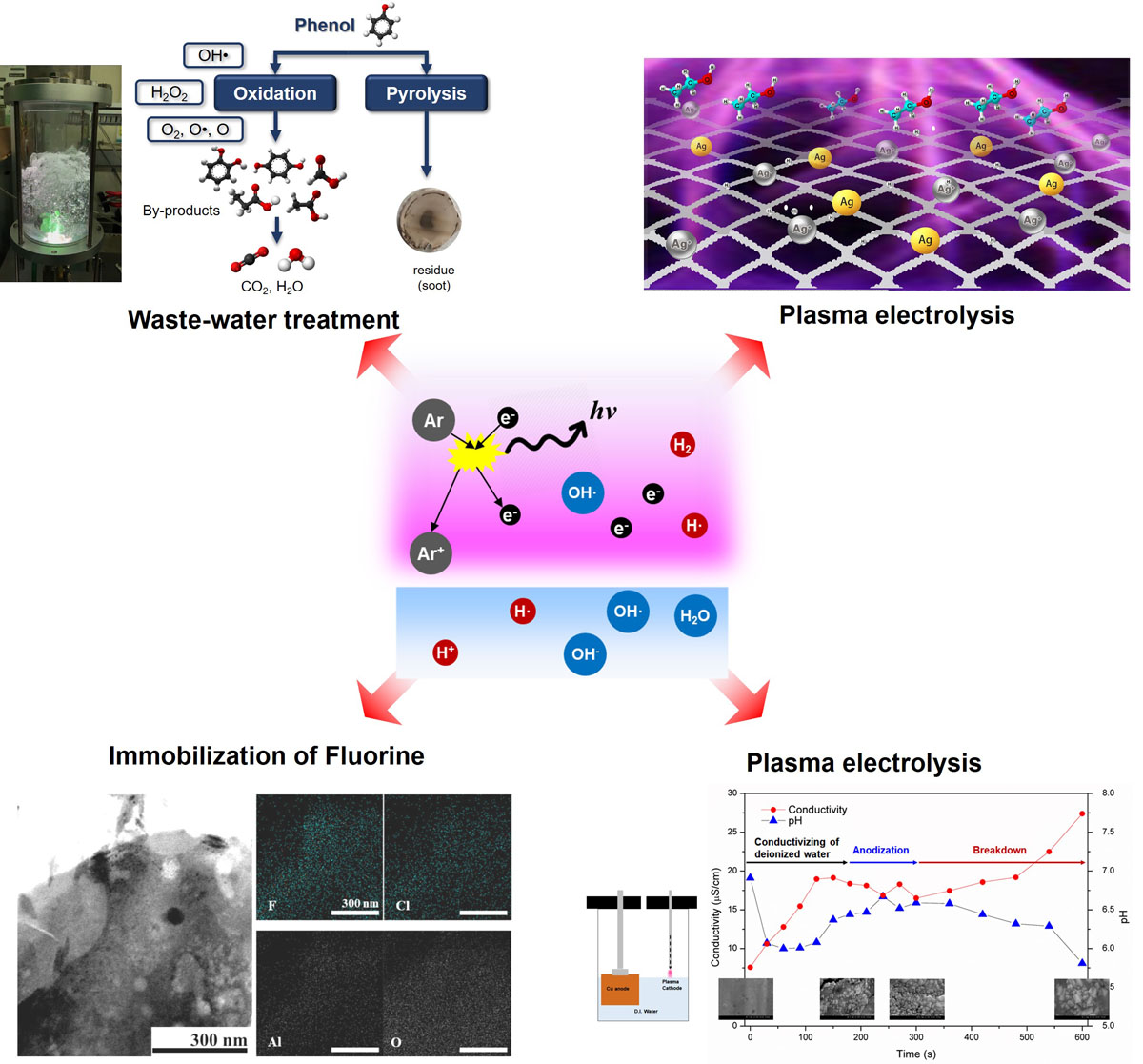
High aspect ratio nano-particles arising from the exfoliation or fragmentation of layered materials are widely used as fillers of polymers. Ultrasound irradiation is one of the potential methods to obtain the fillers rapidly and effectively. To keep up with the increasing demand of the filler production, ultrasound apparatus is expected to be developed to a large scale production process. However, ultrasound apparatus has been built only on an empirical basis since characteristic of the ultrasound and mechanism of layered compound fragmentation has not been revealed yet. In this study, the dependence of ultrasound irradiation conditions on fragmentation rate of the layered material, α-zirconium phosphate (α-ZrP), was investigated to construct the design methodology of the ultrasound process. Ultrasound generated from a horn mounted on a transducer with frequency of 20 kHz was irradiated to the α-ZrP aqueous suspension containing an intercalation agent. The fragmentation rate was evaluated by measuring the time course change of light transmittance of the suspension. The fragmentation rate was formulated with the proprietary developed fragmentation rate equation. The concentration of the α-ZrP and the ultrasound power input were varied and the fragmentation rate constants could be obtained by the linear fitting of the rate equation. It was found that the rate constant was linearly increased to the amount of ultrasound power input per unit weight of α-ZrP. Next, 4 types of sonication vessels having different volume were used to examine the vessel size effect. The smaller vessel used, the higher rate constant was obtained, and the rate constant was inversely proportional to the one-half power of volume. Eventually the fragmentation rate model could predict experimental results successfully, and the reactor model with the rate equation showed that a loop-type ultrasound reactor system with the smaller sonication vessel was promising for intensification of the ultrasound process.
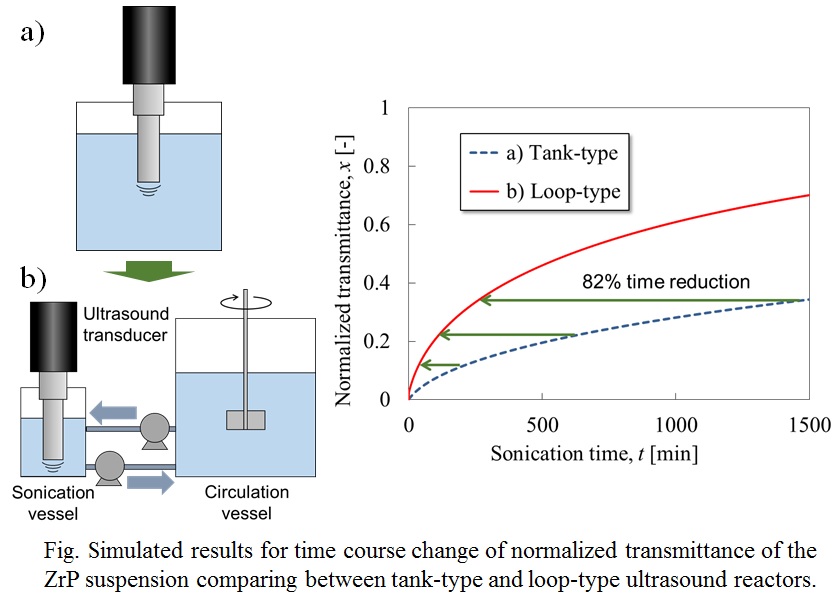
Microreactor technology as a promising tool of process intensification has received many research interests in the field of chemical and process engineering over recent decades. In this respect, the use of slug flow processing in microreactors represents an attractive alternative to carry out operations in biphasic systems (e.g., liquid-liquid extraction, gas-liquid/liquid-liquid reaction with or without the presence of homogeneous catalysts). The improved system performance can usually result from a precise manipulation of slug flow (e.g., uniform bubble/droplet dispersion, narrowed residence time distribution), and its superior mass transfer properties (e.g., high interfacial area, good mixing due to strong internal circulation). Up to now, a deep and fundamental understanding into mass transfer in slug flow microreactors is still limited, rendering the interpretation of the involved microreactor system somewhat empirical. When it comes to the emerging application areas, a number of opportunities exist for the use of slug flow microreactors within the context of green and sustainable chemistry, especially related to biomass conversion. In this presentation, our recent research highlights on mass transfer characterization in slug flow microreactors will be firstly summarized. The liquid-side mass transfer coefficient can well described based on the penetration theory, provided that the additional contribution of internal circulation within the droplet and slug under various operating conditions is properly considered. Then, the promising applications of slug flow microreactors in biobased chemical processes will be discussed. Typical examples include liquid-liquid reactive extraction of lactic acid, the synthesis of furanics (i.e. 5-hydroxymethylfurfural and furfural) from C5/C6 sugars in a biphasic system, the aerobic oxidation of 5-hydroxymethylfurfural to promising polymer building blocks (e.g., 2,5-diformylfuran), and enzymatic biodiesel synthesis. The microreactor operating principles, the slug flow mass transfer characteristics, the intensification potential as well as the (catalytic) chemistry insights will be addressed particularly.
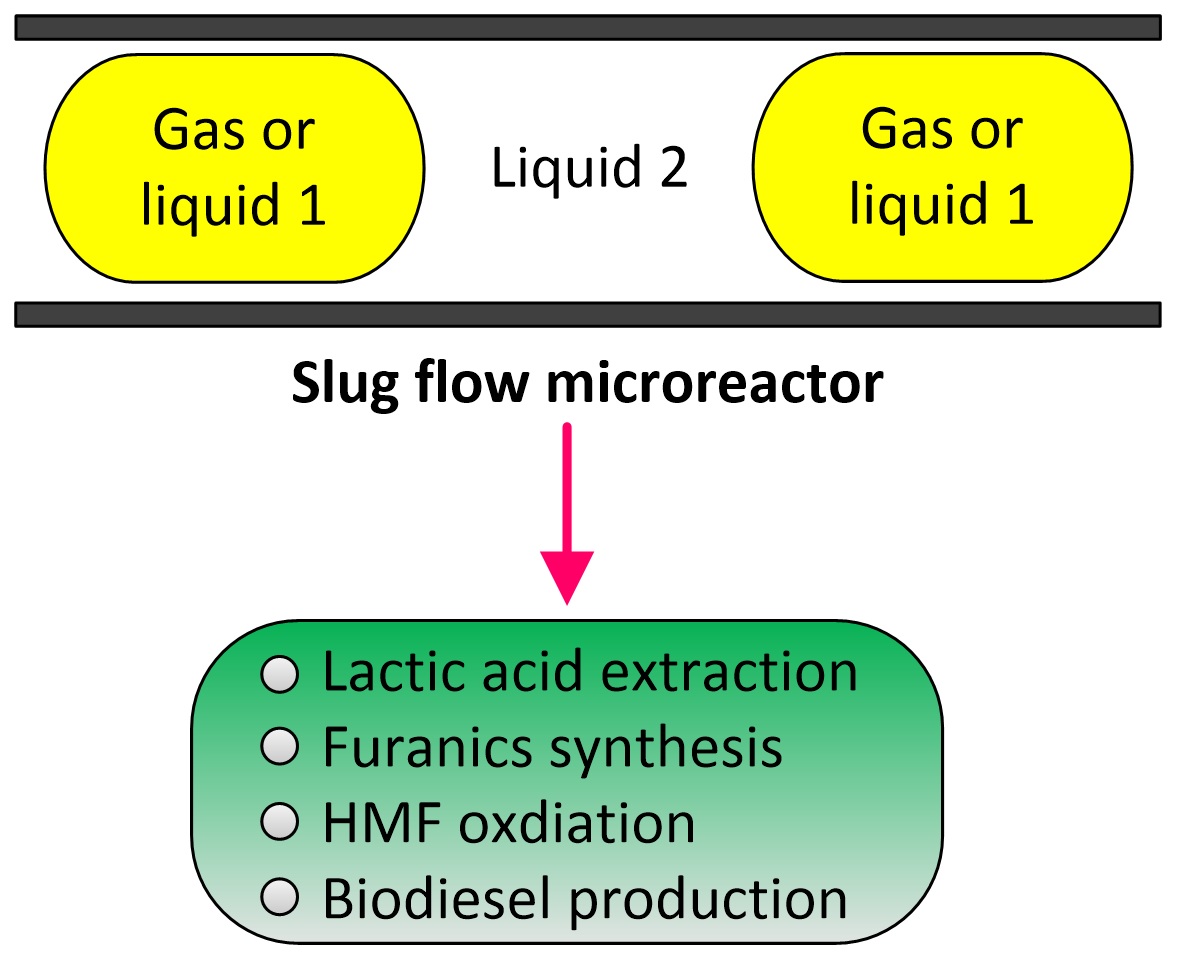
Recently falling film microreactors (FFMRs) are getting popularity for fast and exothermic gas-liquid reactions because of large specific surface area. Although FFMRs attain excellent mass transfer between phases, chemical reactions are often limited by diffusive mass transport in liquid phase. Therefore, this study aims to design novel reaction plates for promoting passive mixing and to derive the further potentials of FFMRs. First, micro-baffled plates with 2-dimensional structure are investigated numerically and experimentally in a systematic manner. The results indicate that the 2-dimensionally-structured baffles are not effective to enhance the overall mass transfer, although they can drastically change the wavy shape of gas-liquid interface and thicken the liquid film. A CFD model involving gas-liquid reaction is newly developed for the analysis of 2-dimensional wavy falling film. The CFD simulations show that gas absorption rate increases drastically in thin liquid film around the baffles while it decreases in the liquid film thickened between the baffles, and hence, the overall gas absorption rate slightly decreases compared to the standard plate without baffles. Subsequently, the micro-baffled plate with 3-dimensional structure is designed and examined. Fig. 1 shows the results of CFD simulations assuming that flat liquid film is formed on (a) 2-dimensionally-micro-baffled plate and (b) 3-dimensionally-micro-baffled plate. The vector plots in the figure show that the slantwise micro-baffled plate promotes secondary flow around the baffles, which is not observed on the 2-dimensionally-micro-baffled plate. This secondary flow is expected to enhance mass transfer. A CFD model being developed to resolve mass transfer across 3-dimensionally-wavy falling film will examine the effect of plate design and flowrate on gas absorption rate.
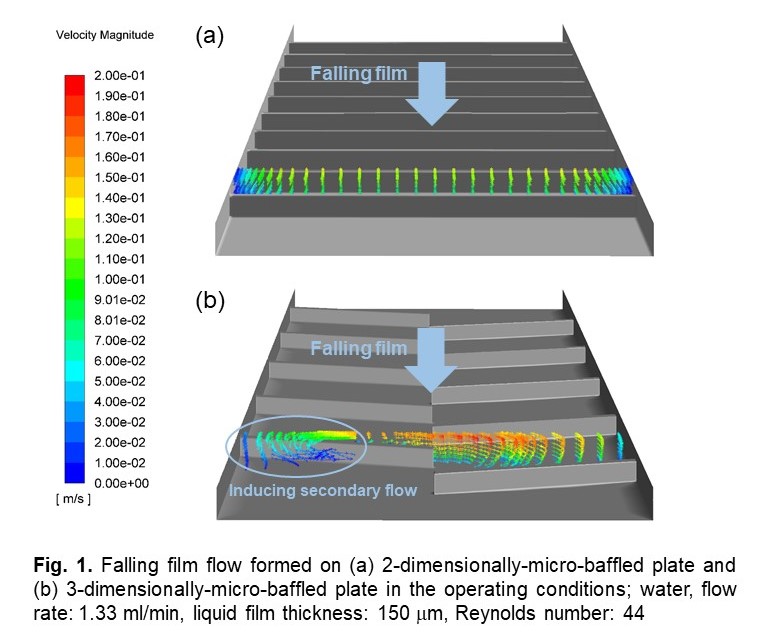
In a falling film microchannel, the interphase mass transfer strongly depends on the liquid-phase mass transfer behavior. The flow pattern of liquid film is predominantly laminar. And the liquid-side mass transfer relies heavily on molecular diffusion. Effectively improving the liquid film flow characteristics is the fundamental way to enhance the interphase mass transfer in falling film microchannels.
In this project, micro-mixing zones and wavy channel are configured respectively to improve the flow and mass transfer behavior of the liquid film in the falling film microchannel. The intensification mechanismes are systematically studied by experimental research and numerical simulation.
The results show that the fluid flow and mixing are improved by staggered flow mode in the double-side falling film microchannels with micro-mixing zones. Three flow patterns are observed inside the liquid film, including direct flow, cross flow, and vortex flow when the falling liquid film crosses the micro-mixing zones. Both cross flow and vortex flow intensify the surface renewal and turbulence of the liquid film, which is the fundamental reason for the enhancement of the liquid side mass transfer. The liquid side mass transfer coefficient of CO2 absorption into water is increased 7–14% by the configuration of micro-mixing zones. As the liquid flows on the falling film wavy microchannel, the liquid film resonates with the wavy microchannel wall. The surface fluctuation of liquid film can increase the gas-liquid interface area, and eddy might perturb the bottom of liquid film to enhance the mass transfer. Compared with flat microchannel, the falling film wavy microchannel increases the efficiency of CO2 absorption into water by 41%. The results suggest that falling film micorreactor with micro-mixing structrues can effectively enhance the interphase mass transfer behavior.
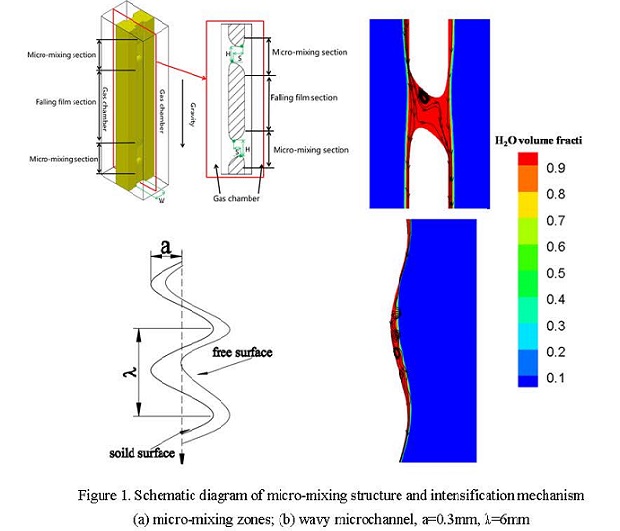
A large capacity micro-channel reactor called the Stacked Multi Channel Reactor (SMCR) was developed. SMCR enables having a larger capacity up to several tens liters by using a concept of numbering up of the channel than conventional micro-channel reactors and applying advantages of micro-channel reactor such as rapid heat and mass transfer to industrial chemical processes. Conventional micro-channel reactors have two dimensional structural junction such as Y-shaped and T-shaped for fluids mixing. These structures are not suitable to arrange numerous channels efficiently in an apparatus. Three dimensional structural junction for fluids mixing was adopted in SMCR. The SMCR consists of plates which have multi-channels on both sides and through-holes which connect the channels on both sides of the plate three dimensionally. This structure enables efficient arrangement of numerous channels on the plate and increasing the number of channels per unit volume of an apparatus by stacking the plates. In this work, the applications of SMCR to multi-stage continuous process, such as extraction, absorption and reaction, were investigated. Extraction experiments were carried out by using single channel equipment and SMCR bench scale equipment. The bench scale equipment consists of 3 SMCR and each SMCR has 24 channels with an inner radius of 1 mm. Total processing capacity of the bench scale equipment is approximately 0.6 liters and the processing flow rate could be on the order of several tens kilograms per hour. The bench scale equipment successfully reproduced the extraction performance of the single channel equipment. In this result, it was confirmed that SMCR can increase the throughput by numbering-up method maintaining performance in a single channel. Other applications on absorption and reaction process will be also presented on the day of presentation.
Recently, catalytic wall plate milireactor (CWPMR) has been proposed for process intensification of highly exo- and endothermic reaction by taking advantange of its high catalyst loading, scalability, and relatively low pressure loss. Although numerical study is indispensable to optimize device dimensions and operating conditions, neither of present options, namely the most accurate particle-resolved and inexpensive lumped continuum approaches, are able to achieve afforable computational cost and sufficient accuracy, respectively. In this study, computationally-inexpensive, detailed porosity profile-based continuum model has been developed and utilized to investigate different performance indices of CWPMR condcuting methane dry reforming. The new porosity profile model for CWPMR was developed by using DEM simulations. The examined range of packed layer thickness to particle size ratio (Np) was 1 to 5. The simulation results were compared to the experimental results for validation. The simulation results showed that mass and heat transport properties and their associated reaction performance were strongly influenced by the porosity profile. The highest reaction rates occured in the top region of packed layer where the momentum penetration was also observed, while the reaction rates were negligibly small in other regions as shown Figure 1. Such information can help to understand the interaction of reaction and transport phenomena in the CWPMR, as well as to improve the dimensions and design of the reactor.
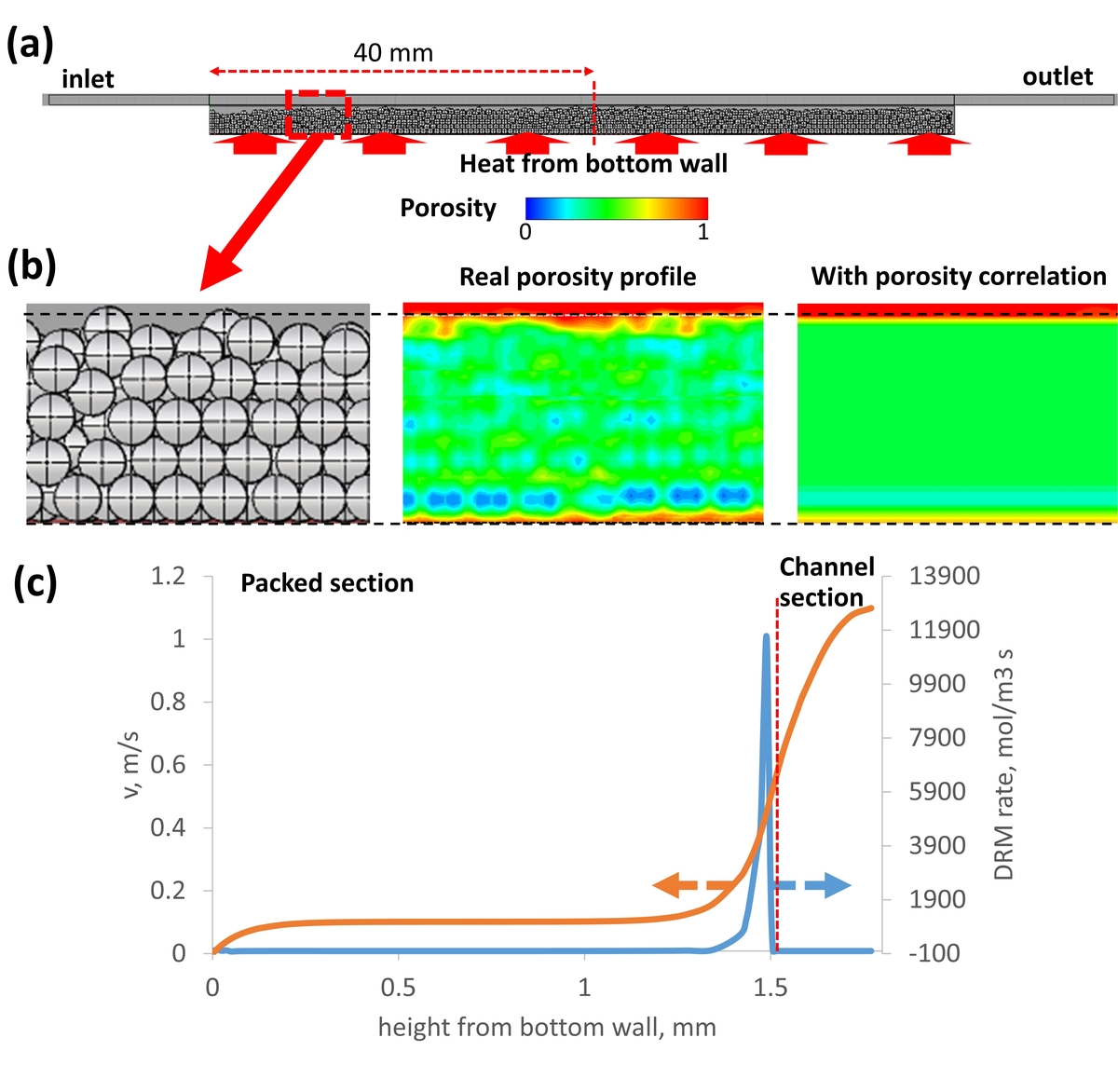
Most of our ‘playing field’ is in liquids where chemical reactions and separations occur. For enhancing the production rate of the target substance, various methods have been developed and applied. The rate was frequently controlled by mass-transfer or accurate triggering of reactions. Ultrasound has a power of thinning the liquid boundary film, enhancing mixing in narrow spaces and generating radicals with high accuracy. Also, ultrasonic irradiation is highly controllable and is easy to adapt to existing equipment. Works of ultrasound will facilitate reactions as well as separations. The irradiation ensures nucleation from supersaturated solutions. Solid surfaces of catalysts and silicon wafers are successfully cleaned. Reaction path appears only under sonicated conditions. Radical reactions are initiated by sonolysis of liquid medium.
Since ultrasound is pressure wave, the unique phenomena, cavitation occurs due to the pressure oscillation. Cavitation is characterized by generating fine bubbles in liquids followed by oscillation of those bubbles and eventual violent collapse to emit energies. Onset of cavitation dramatically enhances interfacial area; the field for reactions and mass-transfer are in play.
Ultrasonic irradiation to liquids causes a lot of physical and chemical changes, which are strongly related to our ‘games’ in chemical processing. Examples will be presented in the lecture to show a high potential for ultrasound as a game changer.

Poly(N-isopropylacrylamide) (PNIPAM) is a thermoresponsive polymer with a lower critical solution temperature (LCST). Poly(2-hydroxyethyl methacrylate) (PHEMA) has a high mechanical strength, so that a copolymer of poly(NIPAM-co-HEMA) is expected to be applied as advanced functional polymeric materials in various fields, such as sensors, actuators, and drug delivery system.
When ultrasound is irradiated to a solution containing vinyl monomers, the radical species are generated due to thermal decomposition of the monomers and then radical polymerization takes place without any chemical initiator. The synthesized polymer decomposes due to the high shear stress. Therefore, the polymer with a narrow molecular weight distribution can be obtained. It is expected to control the properties of the copolymer by controlling the condition of ultrasonic irradiation.
In this research, poly(NIPAM-co-HEMA) was synthesized using ultrasonic irradiation in a mixed solvent of water and ethanol without any chemical initiator. The effects of the ultrasonic power intensity, the ultrasonic irradiation time and the monomer molar ratio on the responsive temperature of synthesized polymers were investigated.
The responsive temperature of the copolymer obtained at the completion of the reaction linearly increased with the copolymer composition. The experimental results were in agreement with the estimated values by copolymer composition, which was formulated according to the results obtained by using chemical initiator (Shen et al., Colloid Polym. Sci., 2006, 284, 1001). However, the responsive temperature of the copolymer obtained in the early stage of the reaction was higher than that estimated by the copolymer composition. These results suggested that some parts of the polymer chain have higher NIPAM composition than overall composition because of the difference in the reactivity of the monomers. In conclusion, the composition and responsive temperature of the copolymer can be controlled by changing the ultrasonic irradiation time.
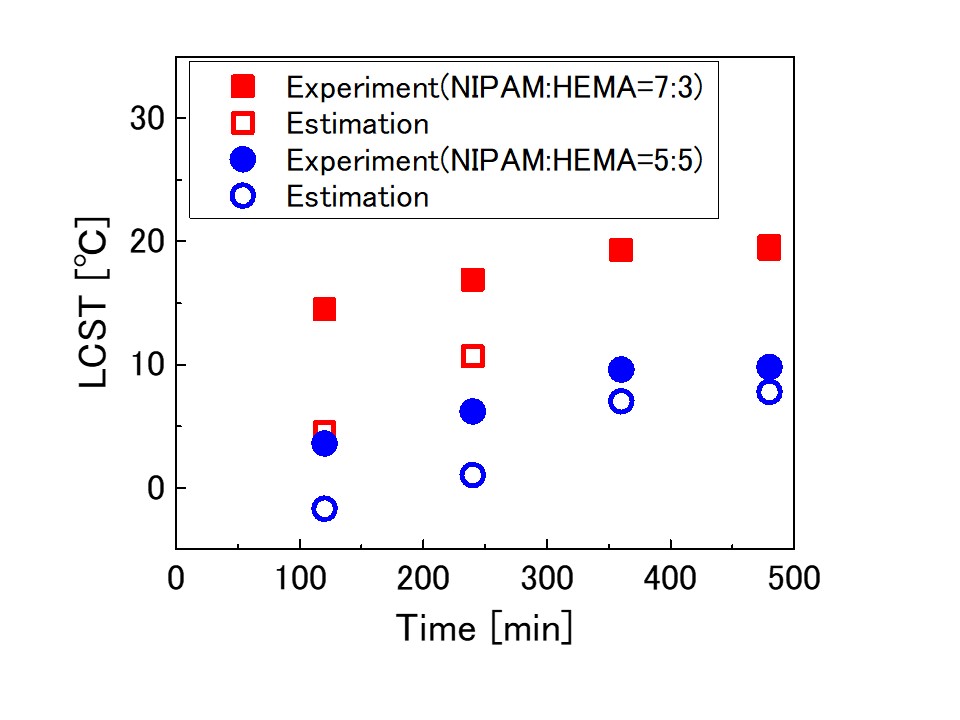
When ultrasound was irradiated to water, ultrafine bubbles were generated. Effects of ultrasonic power and frequency on ultrafine bubble concentration and diameter were investigated. Number concentration of ultrafine bubbles increased with time and approached asymptotically to an equilibrium value. Increase rate of ultrafine bubble concentration became higher as ultrasonic power increased. The equilibrium number concentration of ultrafine bubbles increased with decreasing frequency. The mode diameter of ultrafine bubbles was within 90 -100 nm. Effects of ultrasonic frequency and irradiation time on the mode diameter was small.
On the other hand, when ultrasound was irradiated to water containing high concentration of ultrafine bubbles (ultrafine bubble water), number concentration of ultrafine bubbles decreased with time and approached asymptotically to the equilibrium value. Reduction rate of ultrafine bubble concentration became higher as ultrasonic power decreased.
Generation and elimination of ultrafine bubbles by ultrasound were modeled to analyze experimental data. The generation rate coefficient of ultrafine bubbles increased with decreasing frequency because cavitation collapse became stronger. The reduction rate constant of ultrafine bubbles at 488 kHz and 1 MHz in ultrafine bubble water became much higher than those in ultrapure water due to aggregation and floatation of ultrafine bubbles. The equilibrium number concentration increased with decreasing frequency as shown in Figure 1. The results calculated by our model were in good agreement with the experimental data. The ultrafine bubble generator or eliminator using ultrasound is compact, simple in operation and produce or eliminate ultrafine bubbles in a short time. This method is contamination-free because the liquid pump and mixer are unnecessary.
Figure 1 Change in number concentration of ultrafine bubbles by ultrasonic irradiation to ultrapure water and ultrafine bubble water for different ultrasonic frequency at 15 W of ultrasonic power.
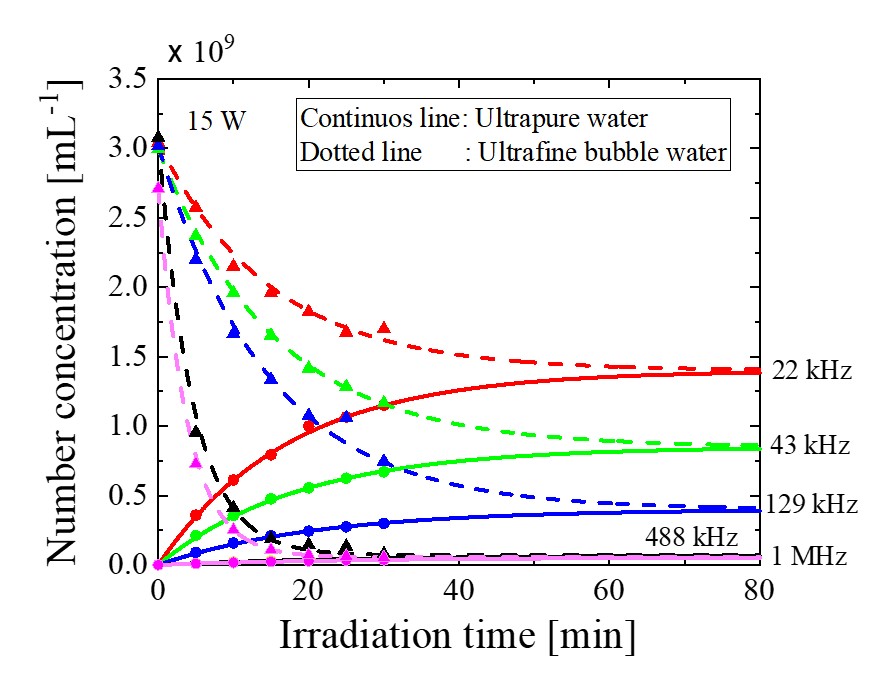
CO2 methanation (CO2 + 4H2 → CH4 + 2H2O, ΔH0298K = -165 kJ/mol) is one of the promising routes for converting CO2 into a useful resource of CH4. In a previous study, we developed a spiral-type Ni/CeO2 structured catalyst for enhancing a catalytic performance by promoting mass transfer diffusion. The developed spiral-type structured catalyst showed a high processing capability for CO2 methanation. This study focuses on the addition of O2 in the methanation feed gas, expecting for direct heat supply to the reaction field by H2 combustion. Therefore, in this study, the methanation performance of the spiral-type Ni/CeO2 structured catalyst was evaluated with changed O2 concentrations in the feed gas in the range from 0% to 10%.
The structured catalyst was prepared by an impregnation method and a wash-coating method. The catalyst component of 75 mg was coated on each spiral substrate. The methanation performance of the catalyst was evaluated by plug-flow type reactor. Four spiral catalysts were set in reactor tube. The reaction gas of 400 ml/min (CO2: 10vol %, H2: 40-60 vol%, O2: 0-10 vol%, N2: balance) was fed to the reactor.
Fig.1 shows the effects of O2 concentrations on CO2 conversions over the spiral-type Ni/CeO2 structured catalyst. In the CO2 methanation system without O2, the spiral-type structured catalyst showed a high activity at relatively low temperatures. By the addition of O2 in the methanation feed, the catalyst displayed a high performance at lower setting temperature. The increase in O2 concentration had a remarkable effect on the improvement of the catalytic performance. In case of 10% O2 in the methanation feed, 57% of CO2 conversion was obtained at room temperature without external heating. The result indicated that the generated high heat energy due to H2 combustion accelerated CO2 methanation on the spiral-type structured catalyst.
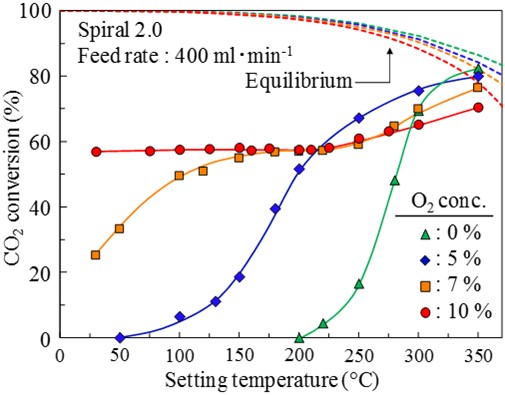
Nitridation on mesoporous silica by ammonia gas forms framework substituted nitrogen, and it has been known to work as base catalytic sites. Since the first attempt to use them as catalysts, several reactions have been catalyzed and further functionalization broadened applicable reactions. However, the detailed quantitative analysis of each silanamine site and their contribution toward catalytic reaction have been insufficient, and further study has been required for the future design of the catalyst
In this study, a series of nitrided mesoporous silica SBA-15 samples was synthesized at different nitridation temperatures. Quantitative analysis of formed silanamine species was conducted by both bulk and surface analyses (i.e., chemical analysis and XPS, respectively). For the quantitative analysis of each silanamine species, we used narrow scan spectra of XPS. The careful deconvolution of the spectra of N 1s level revealed the sequential formation of primary to tertiary silanamine species. The prepared samples were applied to several Knoevenagel and aldol condensation reactions as catalysts. The contribution of each silanamine species to the reaction was deconvolved by mathematical approach. Based on the result, the catalytic activity was in the order of primary > secondary ~ tertiary silanamine species. The order was different from the general textbook-order of the basicity of amine. This would be explained by more influential steric effect due to the formation of secondary and tertiary silanamine site inside the mesopore wall. Furthermore, primary silanamine showed significantly high activity for the reaction involving aldehydes, which would be explained by the formation of imine species. The formation of imine species was confirmed by FT-IR measurement.
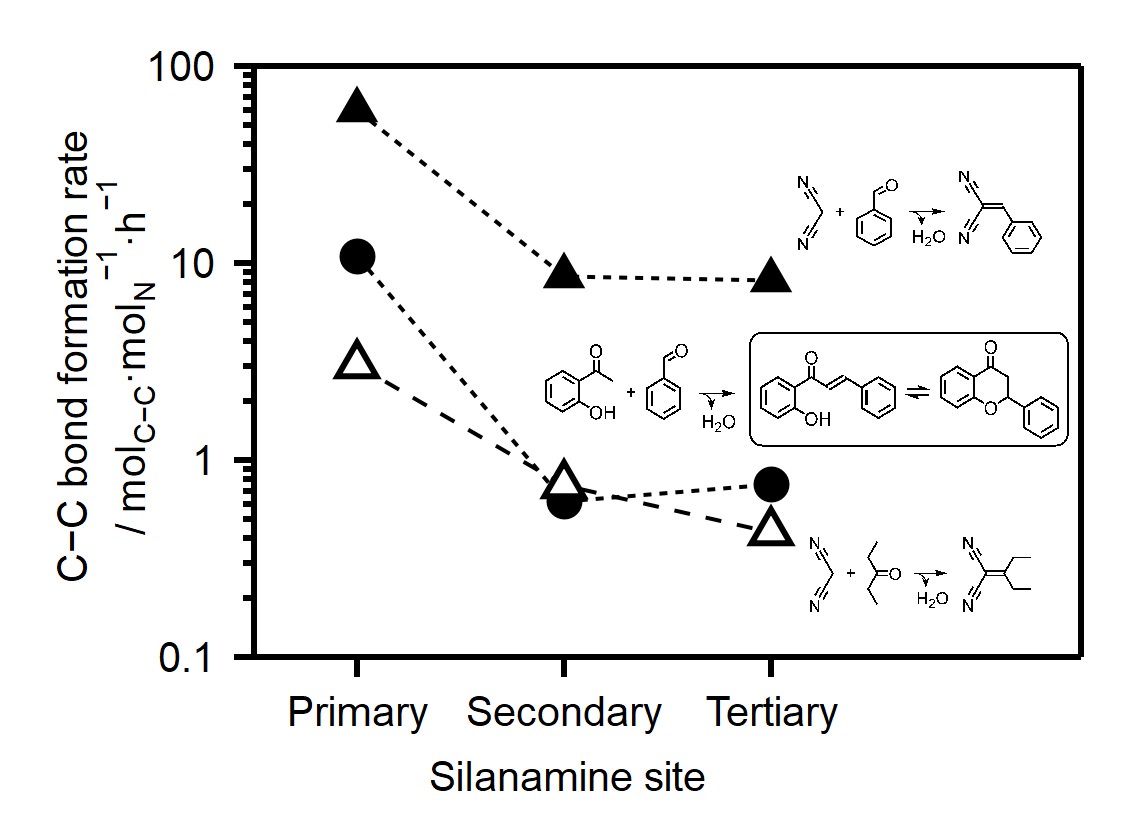
Mesoporous carbon that is a porous carbon material with regular meso-scale (2-50 nm) pores has large surface area and electrical conductivity, so it is used for various applications such as to catalyst support and for electrodes of electric double layer capacitors. Presently, mesoporous carbon is mainly produced by the template method. By the template method, however, it is difficult to form pores of over 20 nm, and the production cost is high due to the complexity of the process. In this study we have developed a method to produce mesoporous carbon by solid-solid reaction between carbon and iron oxide nanoparticles in dilute oxygen atmosphere. In the proposed method, the pore size of the mesoporous carbon can be arbitrarily controled by changing the size of the metal catalyst particles, and it may be advantageous in terms of time and cost for production because the process is simpler than the template method. Three composites were prepared by supporting iron oxide particles of 20-40 nm, 8-10 nm, and 4-6 nm respectively on carbon derived from coal tar pitch, and pore formation was conducted by heating each composite at 490 °C in the presence of oxygen. Nitrogen adsorption measurement of the prepared samples showed that pores of larger size were formed as the size of iron oxide particles became larger, suggesting the possibility of manipulating the pore diameter by selecting the size of iron oxide particles. In addition, by using iron oxide with a particle size of 10 nm or less, we succeeded in producing mesoporous carbon having pores of 7 to 50 nm by the proposed method.
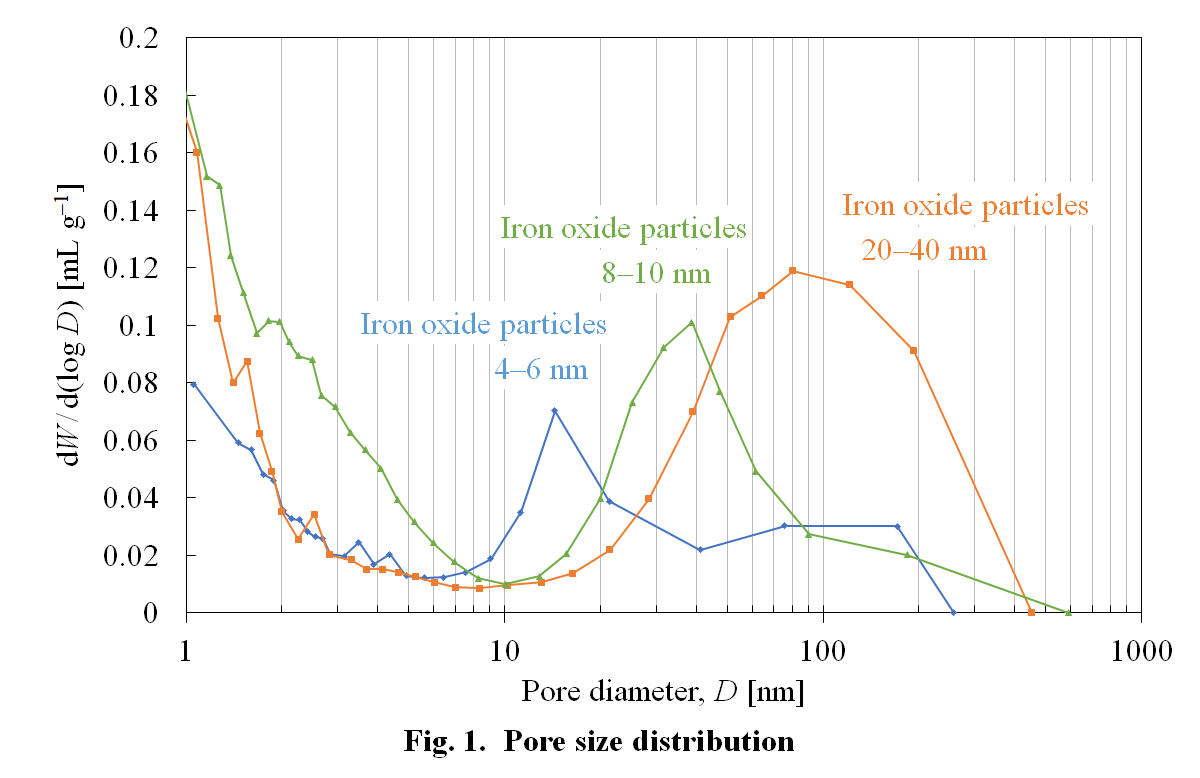
Nitrogen-doped carbons have attracted significant attention as catalysts for the oxygen reduction reaction (ORR) for fuel cell applications and H2O2 synthesis. Many research works have been devoted to the identification of the type of active nitrogen species doped in carbon framework to improve catalyst performance. For example, Nakamura et al.1 synthesized nitrogen-doped carbon catalysts possessing exclusively pyridinic or graphitic nitrogen species and have reported that pyridinic nitrogen present at graphene edge forms an active site. Our goal was to investigate the effects of the degree of crystallinity of carbon framework near active nitrogen sites on the ORR performance because it was anticipated to affect the binding strength of reactive oxygen species at active sites and potentially tune the selectivity to 2e– vs. 4e– reduction of O2. Tuning the degree of crystallinity of carbon materials may be accomplished through annealing in a conventional high-temperature furnace (>1200 °C). However, high-temperature annealing of nitrogen-doped carbons reduces their nitrogen concentrations. To minimize the loss of the nitrogen content of catalysts, high-temperature annealing may be conducted in a flow of NH3. However, it causes the decomposition of NH3, which generates radicals that gasify carbon materials. To address these challenges, we chose a microwave (MW)-assisted approach, which enables fast annealing of carbon materials.2,3 Here, we report that MW-assisted annealing of nitrogen-doped carbons in NH3 increases the degree of crystallinity while retaining porosity and active nitrogen species. We demonstrate that the annealed catalysts exhibit significantly higher ORR activity per pyridinic nitrogen site in an acidic electrolyte than a catalyst before MW-assisted annealing.
1. Guo, D., et al., Science 351, 361 (2016).
2. Mukai, S.R. et al., JP Patent 2015–23070; Kamatari, S. M.Eng. thesis (2015).
3. Ogino, I. et al., J. Energy Chem., 27, 1468 (2018).
Dehydrogenation reaction has attracted much attention for hydrogen production from hydrogen carrier such as methylcyclohexane and co-production of hydrogen and olefin or aromatic compounds from paraffin. Noble metals, such as Pt and Pd, are reported to exhibit high activity for dehydrogenation. Carbon is one of promising catalyst support because they have no acid/base sites, which causes undesired reaction such as cracking and isomerization. On the other hand, the metal fine particles on carbon support are easily aggregated during the catalyst preparation and the reaction, leading to deactivation of the catalyst, and Pt is active for C-C cleavage, causing low hydrogen selectivity. To maintain the metal particle size small, we employed a novel preparation method for carbon supported Pt fine particles by using an anion-exchange resin and Pt chloride anion as initial materials of carbon support and Pt, respectively. In addition, it has been reported that C-C cleavage reaction is suppressed by the addition of transition metal, such as Sn, Mn, and Fe, to Pt. Because Sn forms chloride anion in HCl solution, we considered that carbon supported Pt-Sn bimetal catalyst could be obtained by adding Sn chloride anion to Pt precursor solution in the preparation of Pt/C from the anion-exchange resin. In this study, the carbon supported Pt-Sn bimetalcatalysts with various metal compositions were prepared by using the anion-exchange resin and Pt and Sn chloride anions. Although Sn composition was smaller than the predetermined one, which was because Sn chloride melted and leached during the carbonization at 500 °C, Pt-Sn bimetal catalysts possessing 2-3 nm of metal particles were successfully obtained. Moreover, the metal loading of the obtained catalysts exceeded 10 wt% and hence they could exhibit high activity based on unit volume. We applied the prepared catalysts to dehydrogenation of paraffin to evaluate hydrogen production activity.
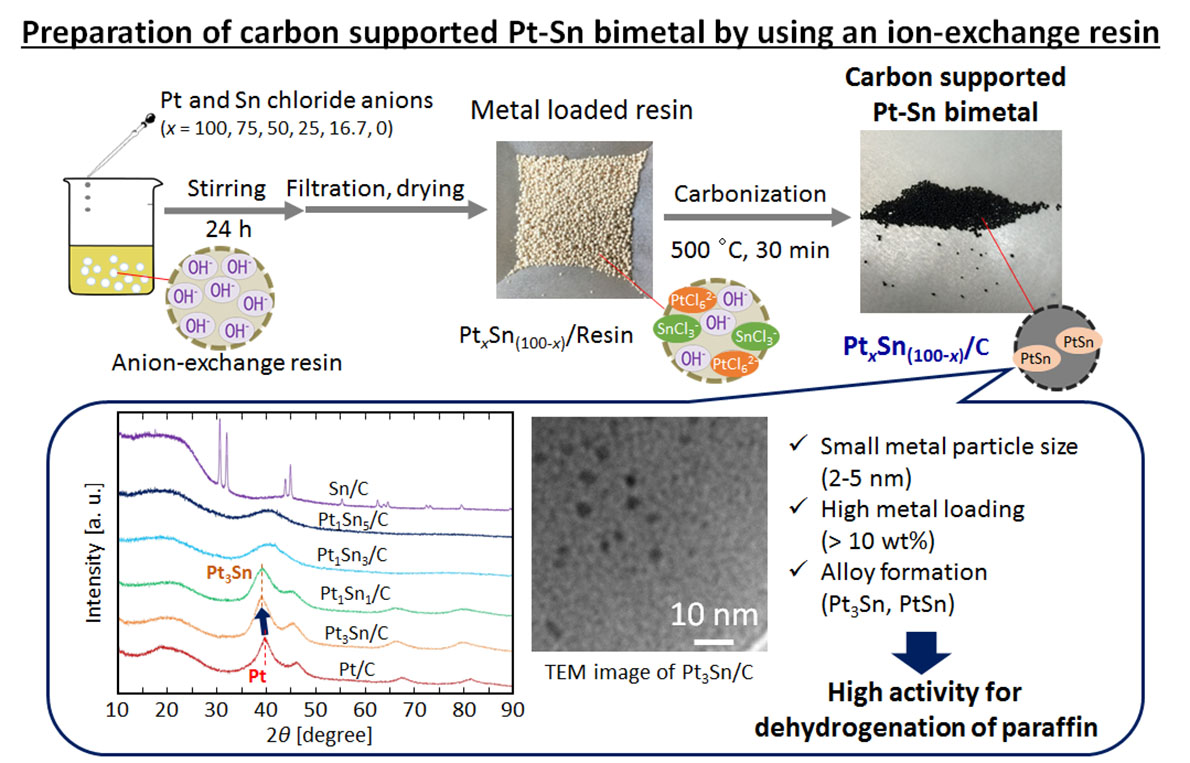
Polyoxymethylene dimethyl ether (POME) has gained much attention due to its unique properties such as high cetane number, better intermiscibility, and low soot and NOx formation. Therefore, POME has become a potential candidate for direct fuel or fuel additive in diesel engines. Conventionally, POME is produced through acetalization of formaldehyde with methanol by using acidic catalysts. Klankermayer and co-workers reported the homogeneous Ru and Co triphos-based catalysts with Lewis/Brønsted acidic co-catalysts for dimethoxy methane (DMM) or OME1 production from CO2 hydrogenation in methanol. To our best knowledge, POME synthesis from heterogeneous catalytic COx hydrogenation have not reported in the literature.
Wet impregnation method was used in current study for synthesis of X%Ru/BEA (X = 1, 3, 5) catalysts to produce POME from COx hydrogenation. POME synthesis experiments were conducted in autoclave batch reactors at 75 bar, 50 mL methanol and 100 rpm impeller speed. The prepared catalysts were characterized to check the catalyst structure, BET surface area and pore size distribution, Ru dispersion over BEA zeolite support and particle size, Ru reduction properties and metal-support interaction. Experimentally, 3%Ru/BEA revealed the best POME yield for COx hydrogenation at 125 °C under mentioned reaction condition. The optimized temperature range for CO2 hydrogenation over 3%Ru/BEA was reported as 150-175 °C. The adverse effects of water in product mixture and plausible reaction pathway were also investigated in presented study. The maximum OME1 and OME2 yields were 7.42 and 0.48 mmol/gcat.LMeOH, respectively at 150 °C, H2/CO2 ratio 3 after 2 h of reaction under same reaction conditions.
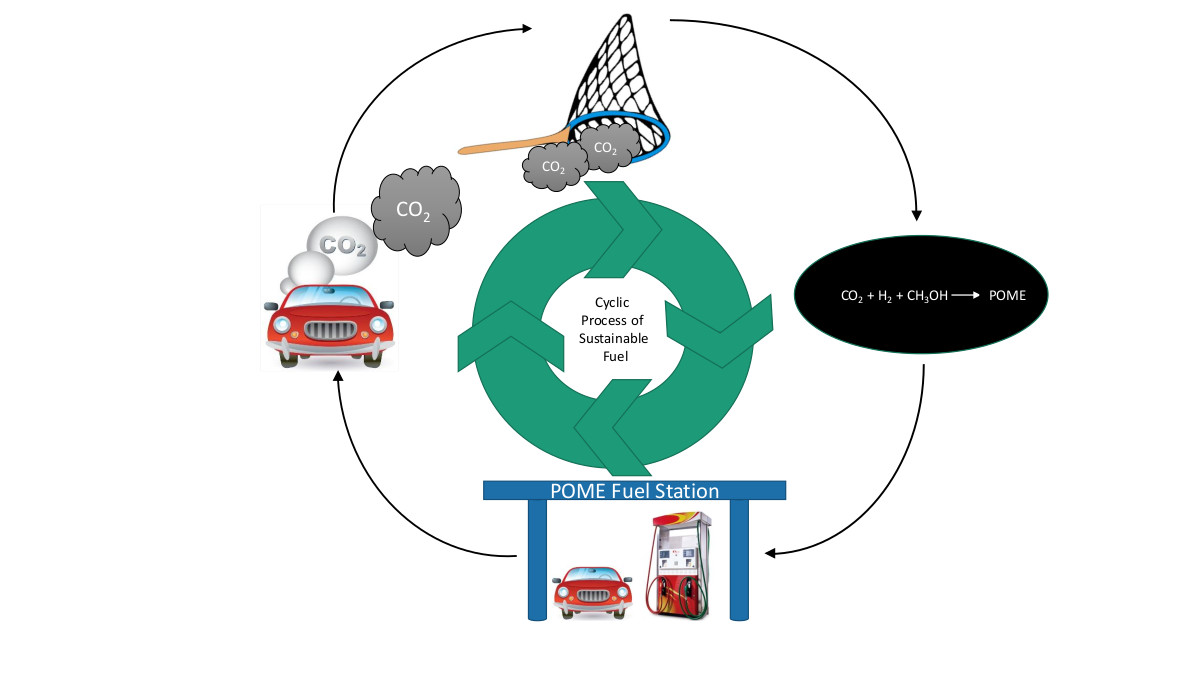
Isobutene is widely used as a starting material for alkyl t-butyl ether, isooctane, p-xylene, methyl methacrylate (MMA), butyl rubber and so on. Therefore, it is very important to establish an alternative route for isobutene production. Especially for us, it is preferable to obtain cheaply available isobutene for MMA production. Considering one of the routes, we have been studying the oxidative dehydrogenation (ODH) reaction of isobutane to isobutene as our aim. Our team has investigated various metal doped mesoporous silica catalysts and confirmed that SBA-15 modified with Cr and Mo (Cr, Mo-SBA-15) showed high performances for ODH reaction of isobutane. According to our investigation, the conversion of isobutane for SBA-15 and Mo-SBA-15 were quite low but Cr-SBA-15 showed the highest conversion of isobutane. However, in the case of Cr-SBA-15, it was quickly deactivated. On the other hand, in the case of Cr, Mo-SBA-15, the conversion of isobutene and the selectivity of isobutene were much higher than those of other catalysts. In addition, deactivation of the catalyst was remarkably suppressed than others. The binary metal system, Cr, Mo-SBA-15, had excellent functions for ODH reaction of isobutene.
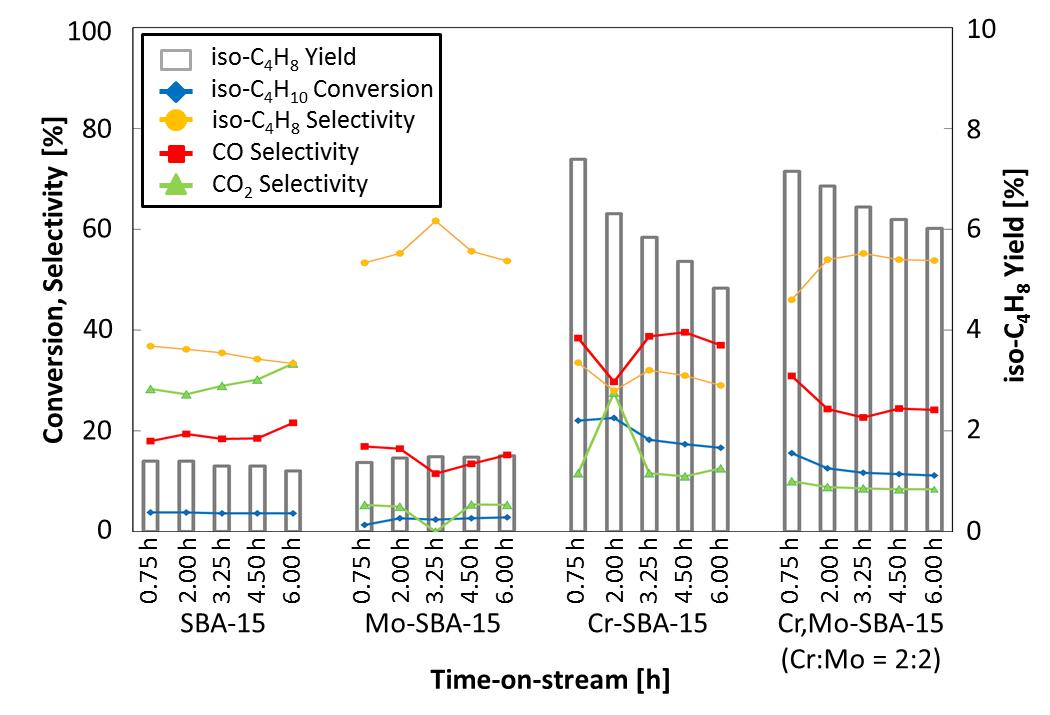
Propane dehydrogenation (PDH, C3H8 → C3H6 + H2) has gained much attention due to a direct production of valuable propylene. A metal sulfide is known to be a highly-active catalyst for PDH, however the loss of sulfide ion (S2-) from the surface frame structure by reduction with H2 leads to decrease of catalytic activity. In a previous study, we investigated a performance of SiO2 supported transition metal catalysts (Fe, Co, Ni, Mn, Cu) for PDH in the presence of H2S, expecting for replenishing S2- in the the surface frame structure of metal sulfide continuously. Among transition metal catalysts, a Fe/SiO2 catalyst showed a relatively stable performance with highly-active and selective for PDH with co-feeding H2S. In this study, we examined the effect of noble metal (Ru, Pd, Pt) addition to the Fe/SiO2 catalyst on its catalytic performance, in order to further enhance the dehydrogenation performance.
By the addition of noble metals, the catalytic activity of the Fe/SiO2 catalyst was largely enhanced. In particular, the Ru-added Fe/SiO2 catalyst showed a stable performance with high conversion and selectivity, comparing to that of the Pd- and Pt-added Fe/SiO2 catalysts. Figure shows the effect of the ratio of co-feeding H2S to propane (H2S/C3H8) on conversion over the Ru-added Fe/SiO2 catalyst. By increasing H2S/C3H8 ratio, a high conversion was obtained at the initial stage of the reaction, but the catalytic activity was decreased gradually. While, under low H2S/C3H8 condition, high stable performance was obtained. Almost no deterioration was observed for 3 h-dehydrogenation under 0.25 and 0.5 of H2S/C3H8. According to Fe K-edge XANES spectra, a high oxidation number of Fe species was confirmed. Such cation species could accept electron from intermediate species, which might promote the PDH performance.
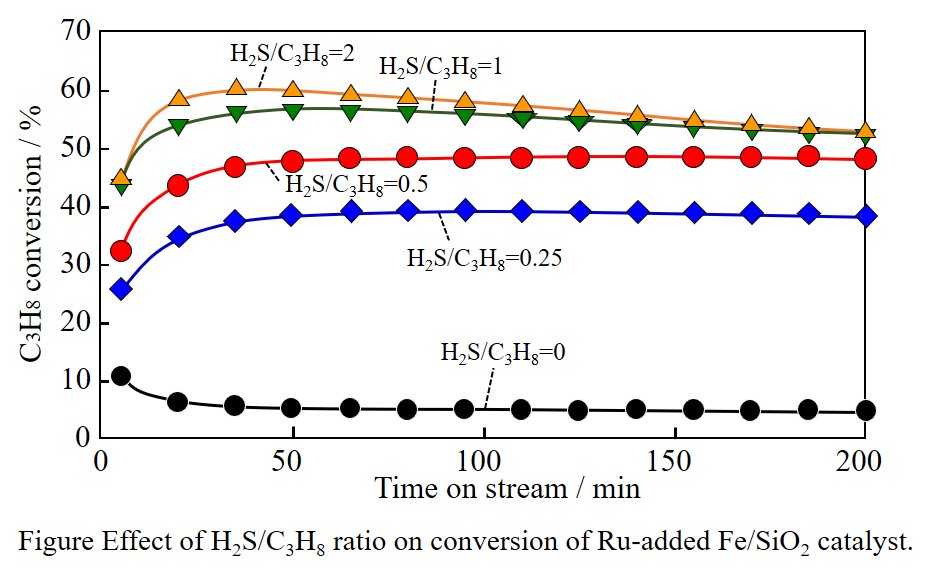
Biomass-derived polyols, such as glycerol, erythritol, and xylose, are attracting attention as renewable raw materials for basic chemical products, such as propanediols, butanediols, and 2-methyltetrahydrofuran. Because these polyols have high oxygen content (O/C = 1), deoxygenation reaction without C-C cleavage is required to convert them into the basic chemical products. In general, hydrodeoxygenation reaction is employed under pressurized hydrogen atmosphere and in the presence of metal catalyst containing Cu or Ru. To suppress oligomerization of polyols proceeding above 250 °C, catalyst with high activity at low temperature, that is, high metal dispersion, and without active site on catalysts support such as carbon support is needed. In conventional catalyst preparation methods including impregnation, it is difficult to achieve high dispersion on carbon support. To solve this problem, we focused on a new preparation method for carbon supported metal nanoparticle catalyst, which uses ion exchange resin as a precursor of carbon support. In this method, metal ions are loaded on an ion exchange resin by ion exchange and then the metal loaded resin is carbonized to convert the resin to carbon support. This study aimed at the preparation of carbon supported Cu catalyst by using the ion exchange resin as a precursor of carbon support and the investigation of hydrodeoxygenation reaction pathway of erythritol (C4 polyol) over the Cu/C catalyst. The Cu/C catalyst possessing 14 nm of Cu fine particles and 67 wt% of metal loading was successfully prepared by the ion exchange technique. We applied the obtained Cu/C catalyst to hydrodeoxygenation of erythritol to butanediols to investigate the reaction pathway by varying reaction time and hydrogen pressure. It was suggested that the main reaction pathway was 1,2-butanediol production from erythritol by sequential hydrodeoxygenation via 1,2,4-butanetriol.
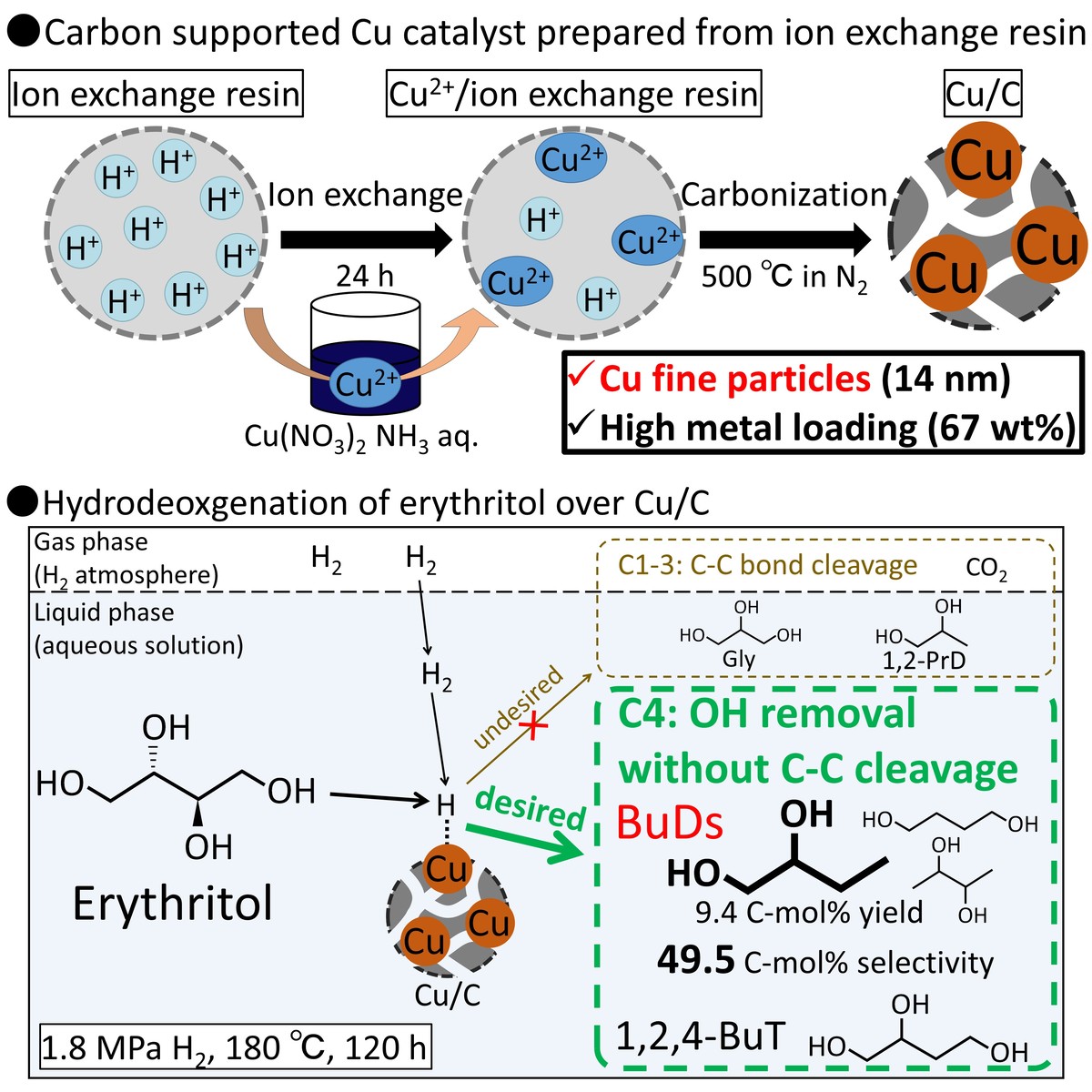
Alumina (γ-Al2O3) and silica(SiO2) have been widely used as adsorbents or catalysts/catalyst supports for hydrodeoxygenation in bio-oil, because of their high surface area, high thermal and chemical stability. The HDO is one of the promising methods for upgrading bio-oil by removal of oxygen-containing compounds. In this study, SiO2/γ-Al2O3 composite particles with different Al to Si ratios were synthesized by spray pyrolysis combined with sol-gel process. The spray pyrolysis method has advantages of synthesizing spherical micron-sized particles in one step with controlled size and morphology of the product particles. Also, mass production is possible with this method as it is a continuous reaction process. In order to control specific surface area and pore structures, the particles were prepared by adding CTAB as a template. The product particles were analyzed by BET, XRD, FE-SEM and TPD. Also, the produced gas and liquid products from HDO were analyzed by GC with TCD/FID.
This study reviewed the technologies that have been applied to hydrogen liquefaction processes so far. First of all, various types of hydrogen liquefaction processes were closely reviewed, and their advantages and disadvantages were compared. In particular, the effect of refrigerants and types of refrigeration cycles on energy efficiency of the process were analyzed. Then, recently developed innovative conceptual approaches to the hydrogen liquefaction process were reviewed. Lastly, a new approach was suggested to increase an energy efficiency of the hydrogen liquefaction process in South Korea.
Propane dehydrogenation (PDH) is one of the most promising candidates of propylene production process to meet the growing demand of propylene in the future. However, precious metals such as Pt have been required for high catalytic performance. Therefore, there is an urgent need to develop new catalysts based on non-precious metals for PDH reaction.
The scheme of PDH reaction is shown in Fig. 1. The initial reaction step from propane is dehydrogenation to propylene or cracking to ethylene and methane and then aromatic compounds can be produced through the excessive reaction. Therefore, it is required to increase the selectivity of dehydrogenation pathway and depress the excessive reaction. To meet these requirements, we focused on Brønsted acidity derived from Ga-species and diffusivity of zeolites which have large micropores.
As an ideal catalyst for PDH reaction, we have synthesized high silica Ga-Beta from dealuminated zeolite using dry gel conversion method. Ga species was well incorporated into *BEA structured zeolite frameworks and worked as Brønsted acid sites. The high silica Ga-Beta with Si/Ga ratio up to 177 can be synthesized. On the PDH reaction, synthesized Ga-Beta showed the highest propane conversion, the highest propylene yield and the highest selectivity of dehydrogenation on the initial reaction step in Ga-based zeolites. The combination of large microporosity and acid sites derived from Ga incorporated into the zeolite frameworks is likely to lead to the excellent catalytic performance of the Ga-Beta. Moreover, the Ga-Beta with higher Si/Ga ratio shows longer catalyst lifetime on PDH reaction since coke deposition rate was depressed by the decrease of the acid amount. This work provides new insights for PDH reaction over Ga based zeolite catalysts, which would contribute to the progress in activation and transformation of light alkenes to value-added chemicals.

Formic acid is regarded as a promising energy carrier because hydrogen can be produced at mild conditions. Formic acid can be decomposed according to the following two pathways.
Dehydrogenation : HCOOH → H2 + CO2 (1)
Dehydration : HCOOH → H2O + CO (2)
Selectivity of the reaction pathway (1) is very important issue not only because low selectivity will lead to wasting much energy carrier, but also because CO is a poison for fuel cell catalysts in the subsequent conversion of hydrogen into electrical energy. Hence, an efficient catalyst for dehydrogenation of formic acid should be developed.
Considering the separation and reusability of catalysts, heterogeneous catalysts are more suitable for practical applications than homogeneous catalysts. Catalyst support is also crucial for H2 selectivity. Al2O3 or TiO2 support may have the activity to decompose formic acid without generating H2. In this work, carbon supported metal catalysts were used for formic acid decomposition.
Catalysts were prepared from a weak-acid-cation-exchange resin (WK11, Mitsubishi Chemical Corporation) and metal cation solutions. The resin and the aqueous solutions of [Pd(NH3)4]Cl2 and Ni(NO3)2 were stirred at room temperature for 24 h. Treated resins were filtered and dried followed by the heat treatment in N2 steam at 500 °C to prepare Pd/C, Ni/C and Pd-Ni/C catalysts.
Thermogravimetric analysis and powder X-ray diffraction patterns provided that the Pd and Ni particles were highly loaded and highly dispersed. A fixed bed reactor was used for the decomposition experiments in gas phase. Formic acid was able to be completely decomposed below 200 °C for all catalysts. H2 selectivity was above 85 % for Pd/C and Pd-Ni/C catalysts, indicating that they are suitable for H2 production from formic acid. Liquid phase decomposition was also performed.
2,5-furan dicarboxylic acid (FDCA) derived from the oxidation process of 5-hydroxymethylfurfural (5-HMF) is a valuable platform chemical for a wide range of industrial applications - particularly the bioplastic industries. This research aims to incorporate 1 wt.% palladium nanoparticles (Pd NPs) into vanadium(V) oxide (V2O5) which was used as an alternative heterogeneous catalyst for HMF oxidation. The incorporated Pd/V2O5 catalyst was prepared by colloid-chemical reduction step and immobilization step, where the combination of these two steps proceed differently - stepwise (ST) and simultaneous (SI) process. For the colloid-chemical reduction step, an aqueous solution of PdCl2.H2O (0.086 mmol Pd, 250 ml DI) was mixed with 2 wt.% of polyvinyl alcohol (PVA) solution - uses as a nanoparticle stabilizer blocking part of the active sites by covering the majority of the metal surface. The mixed solution, then, was reduced by adding slowly of 0.1 M NaBH4 solution. In case of ST process, adding 3 g V2O5 powder for Pd NPs immobilization was done after the reduction step while the simultaneous (SI) one was done at the same time. Morphology, particle size and distribution, as well as, the chemical composition of synthesized samples are characterized by various techniques i.e. TEM, BET, X-ray diffraction, UV-vis spectrophotometer. The modified Pd/V2O5 catalysts obtained from the two different processes (ST and SI) affected the surface characteristics – different Pd NPs size and distribution as well as specific surface area. The potential oxidation of 5-HMF over incorporated Pd/V2O5 catalyst was higher than the one without Pd NPs – raising 5-HMF conversion percentage about two times.
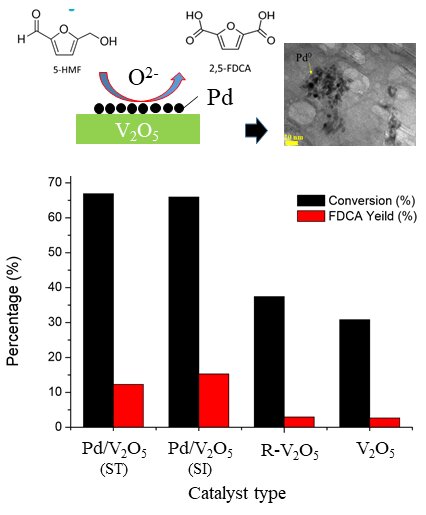
The allylic oxidation is one of important reaction in chemical industry to convert olefin into unsaturated aldehyde for valuable intermediates. It is generally reported that Bi-Mo oxide catalyst loaded on Co-Fe-Mo complex oxide support is effective for allylic oxidation. In this reaction, the oxygen atom in Bi-Mo oxide is consumed in allylic oxidation, gaseous oxygen is uptaken in Co-Fe-Mo complex oxide, and the lattice oxide of the support is transferred to Bi-Mo oxide to regenerate the active center. It is commonly reported that Fe atoms, which is dissolved in CoMoO4 matrix in the support, are responsible for the lattice oxygen transfer and this step is considered to be the rate-limiting in allylic oxidation. Therefore, the allylic oxidation activity can be enhanced by improving the dispersion of Fe atoms in the support. We herein investigated the effect of preparation condition on the dispersion of Fe atoms in the support and the catalytic activity for the allylic oxidation. Co-Fe-Mo complex oxide was prepared by co-precipitation method and the initial pH value of the metal precursor solution was varied to control the precipitation rate of each metal which can be related to the dispersion. When the starting pH value was high, the Fe atoms in the support was highly dispersed without forming greatly agglomerated Fe2(MoO4)3. Furthermore, the allylic oxidation of allylbenzene to cinnamaldehyde was performed by using α-Bi2(MoO4)3 loaded Co-Fe-Mo complex oxide prepared. The catalyst with higher dispersion of Fe showed the higher cinnamaldehyde yield, which could be due to the improvement of the oxygen transport capacity and the promotion of reoxidation of the active center.
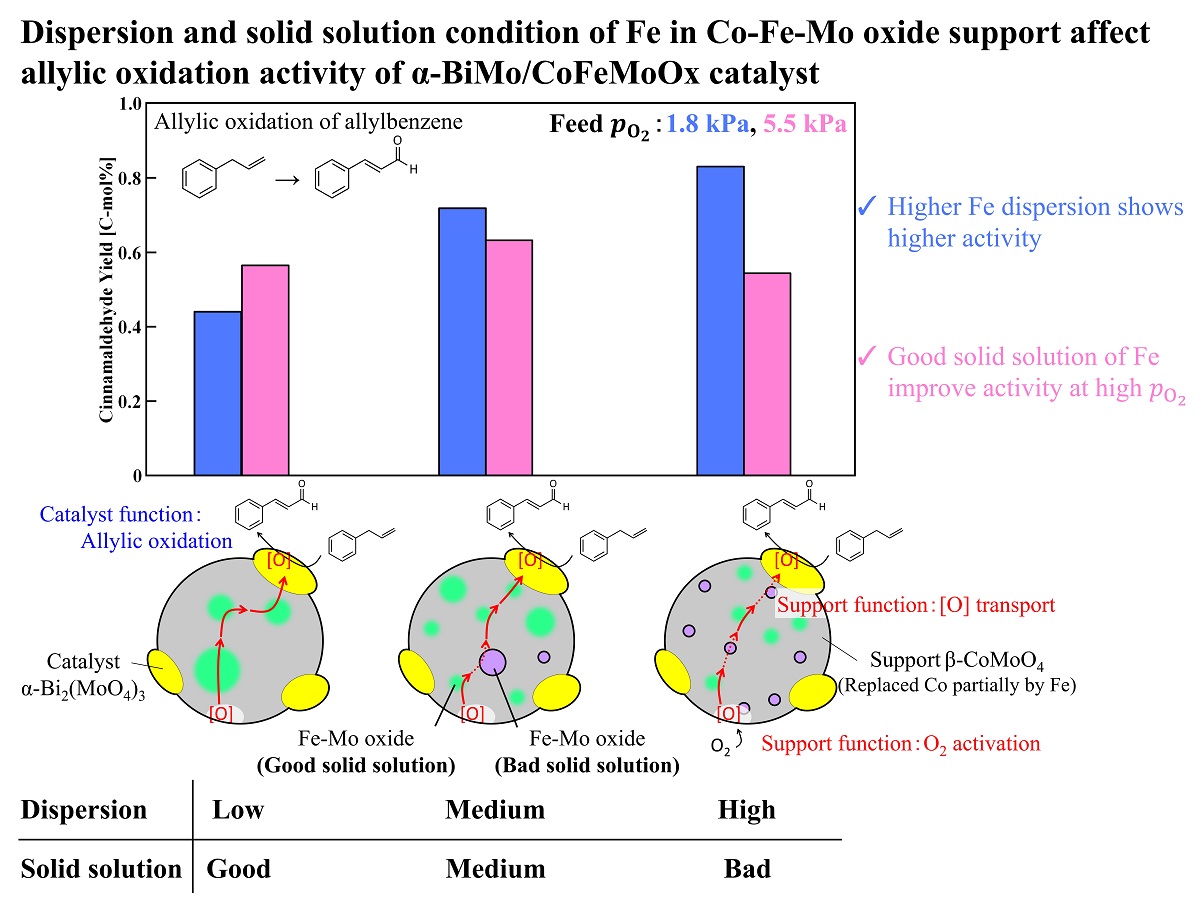
Benzene, toluene and xylene (BTX) are value-added chemicals as basic petrochemical products. These chemicals are mainly obtained from naphtha by the catalytic reforming process. Meanwhile, direct conversion of light alkanes to BTX is a promising process to utilize natural gas as a feedstock for their production. Zn2+-exchanged ZSM-5 (Zn-[Al]-MFI) zeolite was known to be an effective catalyst for converting ethane to BTX. However, the catalyst was rapidly deactivated by a coke deposition. Here, we examined incorporation of Ga into the zeolite framework (gallosilicate). Ga species in the zeolite framework is known to promote aromatization of light olefins. Additionally, gallosilicate zeolite has lower acidity compared to alminosilicate zeolite. In this study, we prepared Zn2+ ion exchanged MFI type galloaluminosilicate (Zn-[Ga, Al]-MFI) for ethane dehydroaromatization (EDA) reaction in order to improve catalyst life time as well as BTX yields.
Both Zn-[Ga, Al]-MFI and Zn-[Al]-MFI samples showed typical XRD patterns of MFI zeolite. From NH3-TPD spectra of the samples before Zn2+ exchange, the acidity is higher in the order of [Al]-MFI > [Ga, Al]-MFI > [Ga]-MFI, indicating that the substitution of Ga for Al weakened the acidity. Then, we concluded that Ga is successfully incorporated into the zeolite framework. The amount of Brønsted acid of [Al]-MFI decreased after Zn2+ ion exchange. Meanwhile, the amount of Brønsted acid of [Ga]-MFI did not change after Zn2+ ion exchange, indicating that proton near Ga sites is hardly exchanged. This result suggested that proton near Al sites of [Ga, Al]-MFI was selectively exchanged with Zn2+ ion. The conversion of ethane and the BTX selectivity on EDA reaction were shown in Figure 1a and 1b, respectively. The catalyst lifetime has been successfully improved because the deactivation by coke deposition on the strong acid sites was suppressed by substitution of Ga for Al.
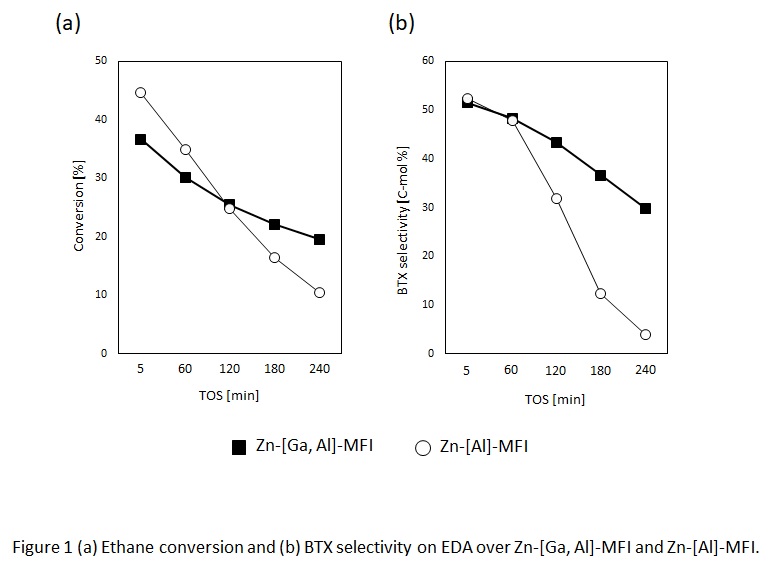
It was previously reported that the gas-phase one-step oxidation of benzene to phenol was carried out by using Cu/HZSM-5 modified with Ti as the catalyst. In this case, the almost same yield and selectivity of phenol was obtained by direct oxidation of benzene in comparison with the Cumene method. However, the morphology of Cu/HZSM-5 catalyst modified with Ti was the fine particle and the utilization of this morphology was not benefiting industrially. Cu/HZSM-5 was prepared by the Cu species impregnating on HZSM-5 which was one of zeolite. Although the Cu species was the active sites in this reaction, phenol di not produce when using supports other than HZSM-5. Therefore it was desire to prepare the forming of HZSM-5 zeolite, which had high thermal stability and did not use a binder. In this study, it is synthesized the binderless HZSM-5 (BLHZ5) following the preparation method of the patents from Nippon Shokubai and prepared the Cu catalyst doped on binderless HZSM-5 (Cu-BLHZ5) by an ion exchanged method.The structure and character of BLHZ5 supports which were prepared by hydrothermal synthesis method for different treatment times were investigation by XRD measurements and N2 adsorption-desorption measurements. From Fig. 1, it was cleared that XRD spectra of the BLHZ5 support indicated the formation of MFI structure for all hydrothermal synthesis time, even at 4h. On the other hand, the surface area and pore size of BLHZ5 were measured by N2 adsorption-desorption methods. No significant change of micro pore size for BLHZ surface area was observed for different synthesis time. However, the increasing of the BLHZ5 surface area was observed with increasing the synthesis time. Therefore, it is estimated that the optimum points of synthesis time is 72h.
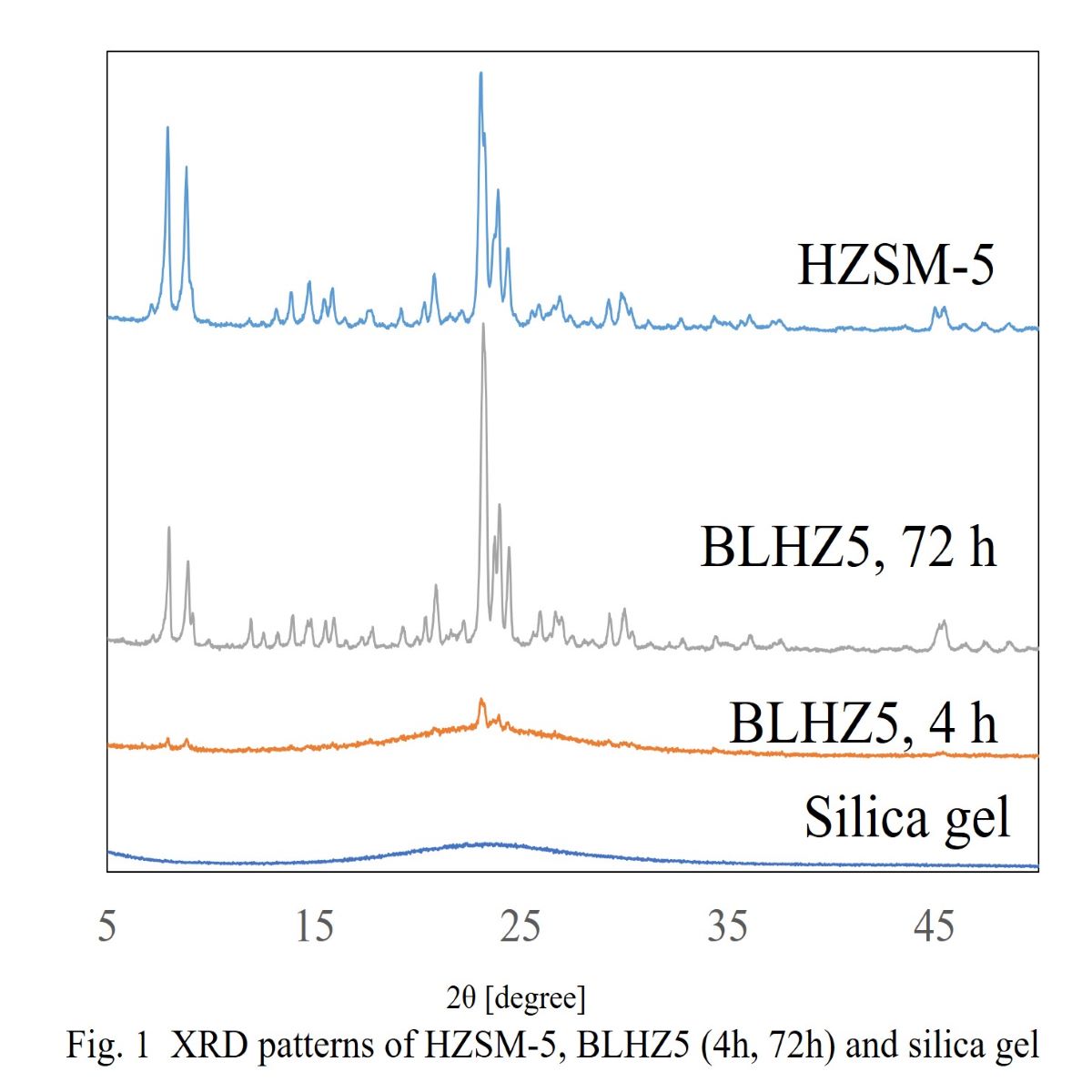
The reactive adsorption desulfurization (RADS) of a model gasoline n-hexane containing thiophene was conducted over a NiO/ZnO-Al2O3-SiO2 adsorbent in N2 and H2, respectively. A declining RADS trend has been observed in N2, without the presence of H2, indicating that NiO is sulfurized and exhibits activity for RADS. TPR and XPS results presented NiO in the adsorbent is difficult to be reduced because of the strong interaction between NiO and the support. The sulfurization of NiO into NiSx is a primary condition for RADS process the same as the presulfurization of hydrotreating catalyst, while metallic Ni is an intermediate reduction product of NiSx. The unreduced NiO/ZnO-Al2O3-SiO2 adsorbent performs a better desulfurization than the reduced adsorbent at the beginning of desulfurization process. NiO is assumed as the main active component and present a good desulfurization ability in RADS. Various pretreatments of the adsorbent showed the participation of hydrogen and n-hexane in pretreatment conducted at 420 °C contributed to the activation of adsorbent and the improvement of desulfurization performance under the reaction temperature of 300 °C. At last, some change of RADS mechanism is presented and discussed.
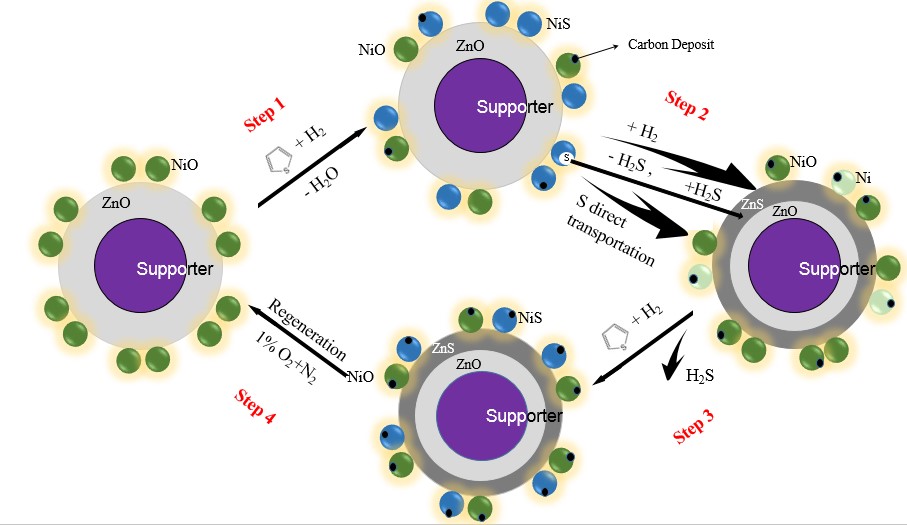
Methane steam reforming reaction is used to obtain hydrogen for use in fuel cells. In general, catalyst poisoning by the sulfur compounds is one of the main causes of catalyst performance degradation. Sulfur durability of alpha-alumina supported precious metal catalysts for methane steam reforming reaction were investigated. Methane conversion of all catalysts decreased in addition of tertiary-butylmercaptan (TBM) as a sulfur impurity in the reaction gas. Methane conversion of Ru catalyst was eventually deactivated almost completely in methane steam reforming with TBM. The time until catalyst deactivation depended on the amount of precious metal loading, and was further proportional to the sulfur adhesion amount and CO unit adsorption amount. In the TBM addition test of Rh catalyst, the methane conversion decreased to some extent, but thereafter the methane conversion reached a plateau and became a constant value. The methane conversion at the plateau was dependent on the loading of precious metal and the reaction temperature. There was a difference in adsorption characteristics with sulfur depending on the precious metal species. The performance degradation by sulfur poisoning in methane steam reforming reaction behaved differently depending on the precious metal species and their physical properties.
Nitrous oxide (N2O) is one of the greenhouse gases that lead to depletion of the ozone layer. Therefore, effective decomposition of N2O is imperative. In this study, MOR zeolite-supported Fe (Fe-MOR) catalysts were prepared by the various methods, and the effect of the preparation method on the N2O decomposition activity of the catalysts was investigated.
The Fe-MOR catalysts were prepared by the liquid and solid-state ion-exchange methods, using iron (III) nitrate enneahydrate (Fe(NO3)3·9H2O) and MOR zeolite as the support. In the liquid-state ion-exchange (LS) method, the MOR zeolite was immersed in Fe(NO3)3·9H2O aqueous solution and stirred at 80 °C for 3 h. After stirring, the ion-exchanged zeolite was filtered and washed, followed by drying at 110 °C for 12 h. This process was repeated arbitrarily. The dried sample was calcined at 500 °C for 3 h. In the solid-state ion-exchange (SS) method, the MOR zeolite was ground with Fe(NO3)3·9H2O in a mortar for 30 min. The mixture was dried at 110 °C above 12 h, after which, the dried sample was calcined under the same conditions as in the LS method. The Fe-MOR catalyst that was prepared by the LS process, which was repeated 4 times using Fe(NO3)3·9H2O aqueous solution (Fe/Al = 0.25), was denoted as LT-0.25-4. N2O decomposition was carried out using a fixed bed flow reactor at 500 °C.
The order of the N2O decomposition activity of catalysts used the same amount of Fe is as follows: SS-1-1 > LS-0.25-4 > LS-0.5-2 > LS-1-1. It is assumed that the Fe-MOR catalyst that was prepared by the SS method was not washed after grinding. Thus, much of the Fe species remained on the cation exchange sites, and this led to higher activity.
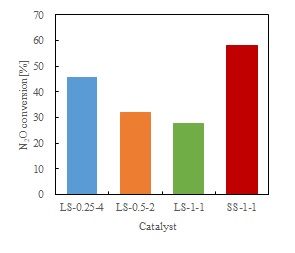
Incorporating covalently bound organic moiety to the surface of SiO2 is a general approach to tailor its surface properties for adsorbents and catalysts. Examples include tuning surface hydrophobicity/hydrophilicity by incorporating alkyl groups with various lengths, tailoring surface functionality by incorporating amine- and sulfonic acid-containing groups, and controlling interlayer spacing of layered silicates by grafting with alcohols. Functionalization of amorphous silica provides a cost-effective advantage. However, it involves a general challenge to achieve site-specificity and control a microscopic environment around functional groups. In contrast, connectivity defects (e.g. SiO–) contained in pure-silica zeolitic materials offer opportunities to achieve precise control of material properties. The location of connectivity defects in crystals is dictated largely by the local structure of zeolitic materials as well as the crystallographic location of charge-compensating structure-directing agents used in the synthesis of zeolitic materials. We chose lamellar precursors of a pure-silica MWW-type zeolitic material because these materials are known to possess abundant connectivity defects near the surface of zeolitic nanosheets and allow incorporation of bulky species between zeolitic nanohseets. Here, we report the site-specific functionalization of these materials with alcohols and alkanolamines and application of functionalized materials to the synthesis of metal-encapsulated catalysts.
Saccharification is a key step for the conversion of a main component of lignocellulosic biomass, cellulose, to chemicals and fuels. Enzymatic hydrolysis is the most popular saccharification method but suffers from disadvantages from an economic perspective since it is expensive and time-consuming. A potential alternative method is herein proposed, where cellulose is first pyrolyzed to anhydrosugars such as levoglucosan, and then anhydrosugars are hydrolyzed to glucose. Pyrolysis is a very fast reaction and does not require any catalyst or solvent. The yield of anhydrosugars reaches more than 90%, though it depends on reaction conditions significantly. It has been known that anhydrosugars are readily hydrolyzed to glucose in an acidic aqueous solution. Sulfuric acid is often employed as the catalyst. However, such homogeneous catalyst generates undesirable waste stream and is difficult to be recycled to the process. The present study demonstrates the availability of a solid acid catalyst for this reaction. A type of strongly acidic cation exchange resin was employed as the catalyst, and a main study was performed with levoglucosan as anhydrosugar model compound. The catalysis was very selective, producing glucose with near-complete yield. When compared to sulfuric acid at the concentration equivalent to the proton concentration in the test with solid acid, the reaction rate was comparable, and, moreover, the selectivity was better. The reaction rate was not altered by the concentration of levoglucosan in the range between 0.1 M and 0.5 M. The catalyst was also active toward cleavage of glycosidic linkages, which was confirmed in the test with cellobiose. Finally, the catalytic test was carried out with biooil from cellulose pyrolysis and successfully produced glucose with sufficient yields, based on anhydrosugar concentration of the oil, even in the presence of various other organic compounds.

Caffeic acid phenethyl ester (CAPE) is a pharmaceutical ester with anti-cancer activity. It is recovered from propolis but is very expensive because of its low content (about 0.1%). On the other hand, esterification of caffeic acid and transesterification of chlorogenic acid (ester of caffeic acid and quinic acid) have been reported as chemical synthesis methods. Both caffeic acid and chlorogenic acid are contained in coffee beans at a relatively high concentration (approximately 8%) and these remain in spent coffee grounds (SCG). There is a possibility that CAPE might be synthesized from SCG. We have reported that ion-exchange resins show high catalytic activity of ester synthesis in non-aqueous system. In this study, we investigated whether CAPE was produced from SCG by ion-exchange resin catalysts.
First, extraction of caffeic acid and chlorogenic acid from SCG was performed using a conventional Soxhlet extractor. No caffeic acid was detected in the extract, but the chlorogenic acid content was about 0.6%, which was higher than that of propolis. Next, batch experiments of the CAPE production were performed using two kinds of ion-exchange resin catalysts. The resin catalyst was added to the reaction solution in which the extract was dissolved in phenethyl alcohol, and well shaken at 70°C. In case of using porous strong base anion-exchange resin, CAPE was not formed, which meant that the transesterification of chlorogenic acid did not proceed. In case of using porous strong acid cation-exchange resin, however, the CAPE concentration gradually increased as shown in Fig.1. Two sets of results under the same conditions overlapped each other, indicating a good reproducibility of the experiment. In addition, the CAPE concentration became higher than the initial value of chlorogenic acid. CAPE was considered to be formed from caffeic acid residues in other substances as well as in chlorogenic acid.
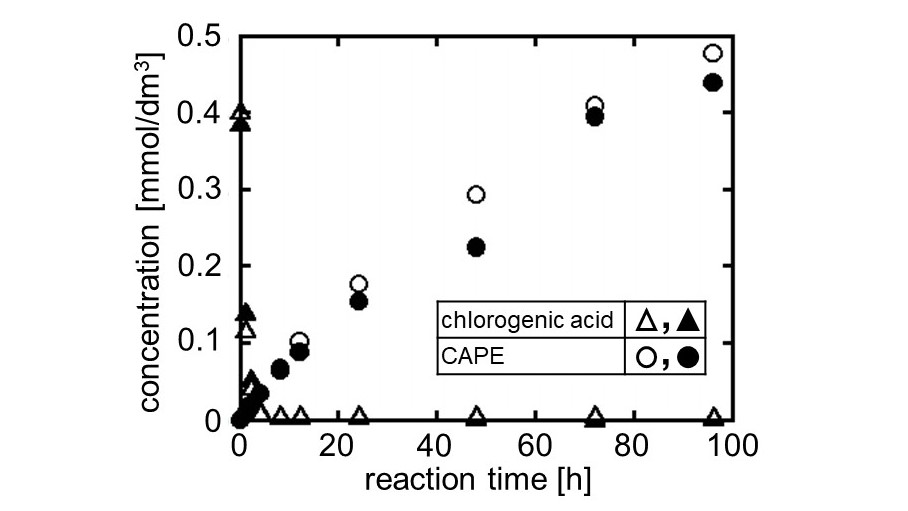
Undaria pinnatifida, brown macroalgae native to northwest Pacific areas, has been considered as a successful invasive species and is feared to cause a reduction in diversity and richness of native macroalgae. Though management of these invasive species is being investigated, it is often faced with failures which call for a resourceful utilization way of U. pinnatifida in a cheap and less energy-intensive way. In this study, U. pinnatifida is focused on as a feasible source for the production of solid acid catalyst. Solid acid catalyst from U. pinnatifida was prepared using sequential carbonization methods of pyrolysis and hydrothermal carbonization (HTC), and the influence of the combined carbonization methods on the characteristics of solid acid catalysts was investigated. The evaluation of catalytic performances of prepared catalysts was carried out using the esterification reaction of acetic acid and ethanol. Though catalysts prepared via HTC method without pyrolysis pretreatment showed better acidity, it had less porosity. Catalysts prepared with pyrolysis pretreatment showed higher specific surface area and coherently showed higher catalytic activity. When the catalytic performance was compared with conventional catalyst Amberlyst-15, U. pinnatifida derived solid acid catalyst showed higher conversion rate of acetic acid and ethyl acetate yield. Through this study, it is shown that marine biomass, U. pinnatifida can function as a solid acid catalyst with good catalytic performance and favorable reusability profile.
Lignin, a polymer with alkyl phenol units, has attracted attention as a resource for phenols. Our previous study has suggested a lignin conversion process to produce monomeric phenols from lignin. The degraded lignin that was depolymerized in water/1-butanol mixed solvent, was converted to monomeric phenols over TiO2-FeOx catalyst with high activity for oxidative decomposition and demethoxylation of lignin units. However, the catalyst was not effective for cleavage of C-C bond between the units of lignin structure. Thus, this study investigated the catalytic reaction of the lignin over a mixed catalyst of TiO2-FeOx and H-ZSM-5 for C-C bond cleavage.
3 wt% of degraded lignin in quinoline solvent was used as feedstock because quinoline was found to be inactive over the catalyst, and also had a good solubility against the degraded lignin, which was consistent with the investigation based on Hansen solubility parameters. The reaction was carried out using a fixed-bed flow reactor at 673 K for 2 h under atmospheric pressure.
As a result, TiO2-FeOx catalyst exhibited only 1.7 mol% of phenols from the lignin. H-ZSM-5 exhibited only 0.5 mol% of phenols, meaning that H-ZSM-5 was not effective for oxidative decomposition. Moreover, the degraded lignin molecular size was too large compared with pore size of H-ZSM-5 that the molecules could not diffuse into the pore and be decomposed. On the other hand, the physically mixed catalyst was high activity for recovering monomeric phenols from the lignin, achieving 11.7 mol% of phenols. Furthermore, GPC chromatogram indicated that molecular weight of products in the mixed catalyst was lower than that of products in only TiO2-FeOx or H-ZSM-5 catalyst individually. The mixed catalyst could dissociate C-C bond in the degraded lignin, leading to the improvement of the yield of phenols. In addition, the between the type of zeolite and reaction activity will be reported.
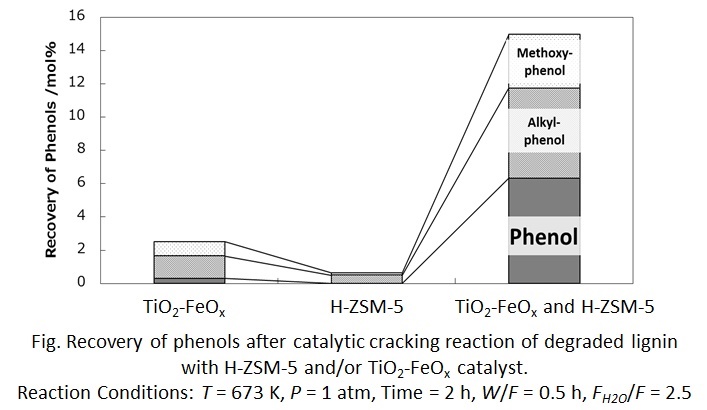
Lignin valorization is one of the biggest challenges for developing biomass-based chemical industry. Recent innovative works has enabled depolymerization of lignin to phenolic monomers with the yield close to the theoretical maximum. Hydrogenation in alcohol with heterogeneous catalysts is an example of the effective methods. The product from such effective depolymerization is a mixture of phenols derived mainly from the cleavage of β-O-4 linkages between phenylpropanoid units. However, the obtained highly functionalized phenols are not common in current industry and, therefore, needs further processing for utilization in the intended applications. The present study shows that simple phenols without functional groups at para-position form selectively in lignin depolymerization in hot compressed water with bases, such as sodium carbonate, as a type of catalyst. Alkali lignin derived from hard wood and bamboo released guaiacol and mixture of phenol, guaiacol, and syringol, respectively, as the main phenolic products. The selectivity to these phenols were more than 60% among identified phenols. The total phenols yield was not so high, up to 9%, but the selective formation of simple phenols was unusual when considering that the weakest and most abundant linkage was β-O-4. Although the reaction mechanism has not yet been clear, analysis of remaining lignin at different reaction times with several techniques showed that the lignin was condensed rather than depolymerized while releasing the phenols. Temporal change in the phenols composition indicated that the simple phenols were directly released from the lignin. On the other hand, utilizing this findings, the study also demonstrated a process that produced the simple phenols and high calorific value fuel gas along with near-complete recycle of the base catalyst.
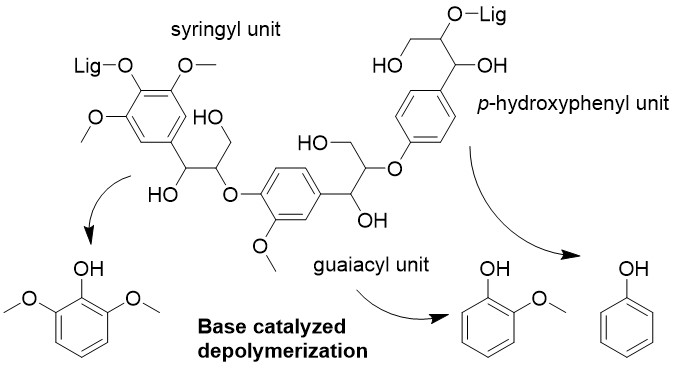
Pyrolysis of cellulose has been studied for investigating combined effects of operating variables such as heating rate, type of reactor and a structural property of cellulose (crystallinity) on characteristics of its conversion into volatiles and char. A commercially available microcrystalline cellulose (MCC; crystallinity index (C.I.) = 87%) was subjected to ball-milling, which amorphized the MCC to C.I. of 60% and finally 0%. The MCC and amorphized celluloses were pyrolyzed at 445–764 °C with heating rates of around 103 °C/s in a Curie-point reactor where the secondary homogeneous and heterogeneous secondary reactions of volatiles were minimally involved. Results of the pyrolysis revealed two important characteristics. Firstly, the char yield was even below 1 wt% when the peak temperature was 590 °C or higher, and was much less than that from slow pyrolysis in a thermogravimetric analyzer, ca. 10 wt%. Suppression of the secondary reaction of the volatiles was thus effective for avoiding the char formation. Second, the char yield was almost independent of the crystallinity. The yield of the key product, H2O, formed by cross-linking, was hardly influenced by the crystallinity. The above-mentioned findings lead to a novel concept of char-free fast pyrolysis of any types of cellulose to produce mono- di- and oligo-anhydrosugars at high yield within seconds.
Biomass gasification process needs to be developed to ensure the future energy system. The important issue of the gasification system is to remove tar component generated in the gasification process. In order to achieve this purpose, a suitable catalyst should be developed for eliminating tar by steam reforming. Our group have already developed a powerful structured Ni/Al2O3 catalyst for steam reforming of toluene or naphthalene as the main components of tar [1][2]. In this study, we investigated the properties of the structured Ni/Al2O3 catalyst for simultaneous steam reforming of toluene and naphthalene mixture as to evaluate a viability for the practical application of the structured catalyst to tar reforming [3].
The structured Ni/Al2O3 catalyst was prepared by a sol-gel method and an electroless plating [3]. After H2 reduction at 800 °C for 1 h, the performance test was evaluated under the following conditions: setting temperature was 800 °C-830 °C; feed rate of toluene or mixtures (toluene/naphthalene=9/1) were 9.6×10–4 mol·min-1, and feed rate of naphthalene was 9.6×10–5 mol·min-1; steam to carbon ratio (S/C) was 1.5.
Figure shows reforming conversions for steam reforming of toluene (SR-T), naphthalene (SR-N) and mixtures of toluene and naphthalene (SR-TN) over the structured Ni/Al2O3 catalyst. In case of SR-T and SR-N, both reforming systems showed a high activity at 800 °C: each conversion was almost 100%. On the other hand, mixed reforming system showed deactivation in short time at 800 °C: the conversion was decreased from 92.9% to 33.6% during 3 h. Considering that reactivity of toluene is higher than naphthalene [4], naphthalene might not be sufficiently reformed and converted into a carbon precursor. Such serious problem was solved by setting reforming temperature at 820 °C or 830 °C. This result suggested a progressive advantage of Ni-based structured catalyst with high heat transfer ability.
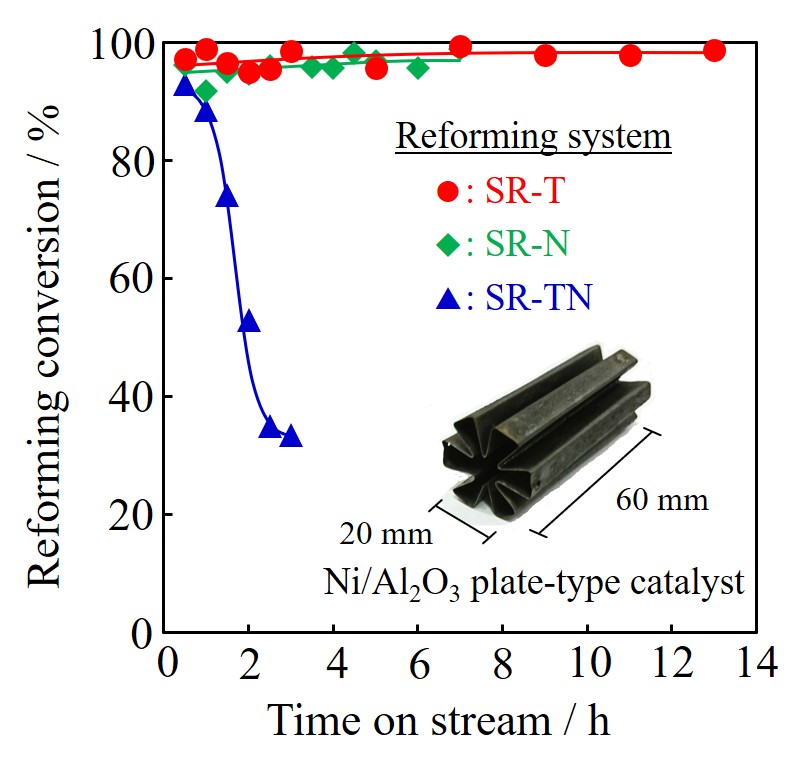
Gasification of woody biomass can provide synthesis gases (CO, H2) at low temperature, however, byproducts such as tar, char, H2S, and NH3 are also generated at the same time. As these byproducts affect downstream equipment operation and reduce total energy efficiency, they should be treated appropriately before entering the downstream equipment. From this background, our research group have been proposed a new consecutive gasification and purification process that is consisted of biomass gasification, cyclone for char collection, metallic filter for volatile minerals, selective H2S decomposition, simultaneous decomposition of tar and NH3, and selective CO2 absorption. While the consecutive gasification and purification processes have been studied in our research group for a long time, developing CO2 selective absorbent material for produced gases is still remained as a research topic. Therefore, this study was started as a first step for developing selective absorbent material. At first CO2 absorption basic condition (material loading amount, pretreatment method, reactant flow rate, temperature, inner size of reactor, etc.) for obtaining the CO2 breakthrough profiles with all absorbent materials was determined. Then CO2 breakthrough profile was obtained with each sample under 10%CO2/Ar mixture flow, and the most excellent absorbent material was selected in terms of CO2 absorption capacity. In addition, both temperature and time needed for regenerating the used material was investigated using XRD and TG-DTA measurements. Finally, selected material was applied for CO2 absorption-regeneration cycle test to see the possibility of recycle usage.
With the aim of efficient use of triglycerides as alternative fuels, deoxygenation of them and conversion to hydrocarbons are important for improving combustion heat. The basic approach of this conversion is a hydrodeoxygenation process, but using a pressurized hydrogen atmosphere incurs high process cost. Alternatively, we focused on a fluid catalytic cracking (FCC) process that can convert triglycerides to hydrocarbons producing CO, CO2, and H2O without using hydrogen atmosphere. Here, the deoxygenation pathway producing H2O is desirable for efficient conversion because the deoxygenation producing CO or CO2 cause a carbon loss. However, the detailed mechanism of H2O formation pathway has not been understood well. This study focused on the effect of a hydrogen transfer reaction that proceeds in the FCC process and investigated the reaction mechanism of ester deoxygenation using deuterated reagents as a hydrogen donor.
Ethyl hexanoate (ester model compound) and deuterated n-hexadecane (n-C16D34, hydrogen donor model compound) were mixed with an FCC equilibrium catalyst. The mixture of feedstocks and catalyst was instantaneously heated to 500°C using a Curie point pyrolyzer, and the reaction products were analyzed using a GC-MS. Figure 1 shows the mass chromatogram of the produced water in the catalytic cracking of ethyl hexanoate/n-C16D34 mixture compared with that of ethyl hexanoate/n-C16H34 mixture. In the reaction with n-C16D34, formation of HDO as well as H2O was observed whereas that of D2O was hardly observed. This result suggests that the ester received one hydrogen atom from the hydrogen donor and produced H2O. Thus, it was indicated that the hydrogen transfer reaction contributes to the deoxygenation of triglyceride, which can be useful information for a catalyst design with efficient conversion of triglycerides to hydrocarbon fuels.
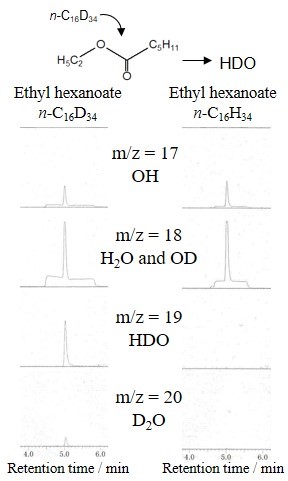
Woody biomass has high oxygen content and requires an efficient deoxygenation process for upgrading to hydrocarbon fuel. Co-processing of bio-oil in the fluid catalytic cracking (FCC) of heavy oil is one of the effective methods for that purpose. Our recent study revealed that the hydrogen transfer reaction in the FCC can accelerate deoxygenation producing water rather than CO2 and CO evenunder a hydrogen-free atmosphere, which is an efficient deoxygenation pathway avoiding carbon loss. However, the effect of bio-oil property, which depends on the type and condition of the liquefaction pretreatment, on the deoxygenation pathway and the product composition in the co-processing FCC has not been understood well.
The previous study reported that the co-processing FCC of bio-oil prepared with fast pyrolysis resulted in a large amount of coke formation and low liquid yield. This may be due to the formation of condensed products during the pyrolysis that were difficult to upgrade in the FCC process. In this study, we focused on the solvolysis liquefaction that can produce bio-oil with high liquid yield (~90%) at a milder temperature than pyrolysis, thus avoiding the condensation reaction.
Bio-oil was prepared from the solvolysis of palm kernel shell (PKS). Catalytic cracking of the mixture of bio-oil and tetralin (heavy oil model compound) was investigated using a Curie point pyrolyzer connected directly to a GC-MS, and compared with the reaction of the mixture of powdered PKS and tetralin. The catalytic cracking of the bio-oil/tetralin mixture showed higher H2O/(CO2+CO) and Monoaromatics/Polyaromatics (3+ring aromatics) ratios than that of the powdered PKS/tetralin mixture. This result suggests that the pyrolytic reaction should be avoided through the whole process of liquefaction and catalytic cracking for the efficient conversion of the woody biomass, and the solvolysis pretreatment is adequate for that prosess.
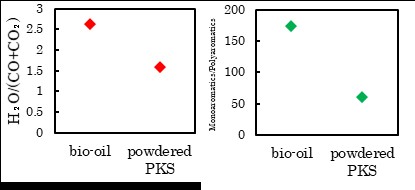
Microalgal biomass has high productivity and expected as an alternative fuel resource. Euglena gracilis is one of such promising microalgae, whose mass cultivation in an open pond has been achieved recently. During the many steps of the fuel production from microalgae, oils are extracted from algal cells, purified and converted to transportation fuels. The most common conversion method is transesterification to biodiesel, but the biodiesel is an oxygen-containing fuels whose heat value and thermal stability are lower than that of hydrocarbon fuels. Conversion to hydrocarbons are usually conducted with hydroprocessing, but using pressurized hydrogen atmosphere requires high operation cost. Then, we focused on the fluid catalytic cracking (FCC) process, which is the major oil refinery process that can upgrade heavy oils to light fractions without using hydrogen atmosphere. In our previous study, we confirmed that the FCC process can convert wax esters derived from Euglena gracilis to hydrocarbons fuels with efficient deoxygenation. Furthermore, the FCC process is expected to be resistant against the impurities because it uses a circulating fluidized bed reactor and the catalyst is regenerated continuously in the regeneration tower. Therefore, in this study, we investigated the catalytic cracking of unrefined microalgae oil and compared the reaction with that of refined oil.
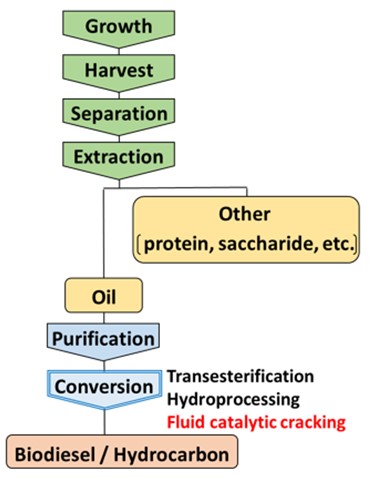
Polyisobutylene (PIB) manufactured by the living cationic polymerization exhibits desirable properties such as thermal stability and high barrier properties. Living polymerization often requires quite low reaction temperatures to avoid termination and chain transfer, for example, the polymerization of PIB is operated at around -80 to -70 °C in batch system. Living cationic polymerization of isobutylene (IB) utilizing TiCl4 in the batch system at low temperatures has been investigated [1-3]. It has been proposed that cationic reactive chain ends are generated in the equilibrium between dormant (tert-alkyl chloride chain ends) and active (ion-paired chain ends). However, the whole reaction mechanism remains to be elucidated due to the difficulty of direct evaluation of concentrations of the dormant and active species in the equilibrium. Moreover, understanding of the reaction mechanism is a key for process intensification.
Quantum chemical approaches have been used well to investigate polymerization reactions [4, 5]. These approaches have been showed the details of chemical reactions such as molecular geometries of reactants, products and transition states, as well as the changes of enthalpy, entropy and Gibbs free energy. The information provided by quantum chemical studies have helped not only to better understand reaction mechanisms, but also to design more efficient reaction processes.
In this work, we report the investigation of the reaction mechanism of the ionization equilibrium in the PIB polymerization with several catalysts using quantum chemical calculations. Experimental results of PIB polymerization with different catalysts are also discussed.
[1] Storey, R. F., Choate, K. R., Jr., Macromolecules, 30, 4799-4806 (1997)
[2] Fodor, Z., Bae, Y. C., Faust, R., Macromolecules, 31, 4439-4446 (1998).
[3] Tawada, M., Faust, R., Macromolecules, 38, 4989-4995. (2005)
[4] Dossi M., Storti G., Moscatelli D., Polym. Eng. Sci., 51, 2109 (2011)
[5] Deglmann P., Muller I., Becker F., SchaferA. , Hungenberg K.D., Weiß H., Macromol. React. Eng., 3, 496 (2009)
A kinetic model was developed for the synthesis of methyl acetate (MA) from dimethyl ether (DME) over ferrierite catalyst. Two types of active sites were considered; zeolite-exchange site that stabilizes acidic protons and methyl and acetyl groups, and CO-binding centers for non-competitive binding of DME and CO (Cheung et al., J. Catal., 245 (2007) 110–123). Pseudo-steady-state approximation was applied to develop the reaction rates, and kinetic parameters were estimated by fitting experimental data under a variety of temperature, pressure, space velocity, and feed composition. The developed model was used to evaluate the effects of operating conditions on the conversion and selectivity.
Clean and efficient utilization of low-rank coal is of great significance to the sustainable development of energy in China. “Regenerative Calcium Carbide Production Process” was proposed for clean and efficient utilization of low-rank coal. This technology takes pulverized medium to low rank raw coal and raw lime as raw materials that can form pellets. Then the pellets were sent into sealed calcium carbide furnace after pyrolysis in preheating furnace to obtain calcium carbide and pyrolysis oil and gas at the same time. The pyrolysis process of pellets is the key step of the technology. A comprehensive analysis of the influence of lime addition, pellet properties and operation conditions on pellet pyrolysis process plays an important role in comprehensively understanding pellet pyrolysis process and optimizing this new technology.
Firstly, the thermogravimetric experiments and basic experiments of pellet pyrolysis in fixed bed were carried out. The effects of calcium oxide, heating rate, pyrolysis temperature and pyrolysis time on the pyrolysis process of pulverized coal were investigated. The experimental data were provided for the establishment of pyrolysis kinetics. The results show that the addition of calcium oxide, the increase of heating rate, pyrolysis temperature and pyrolysis time can increase the volatile in the pyrolysis of pulverized coal. Then, the double distributed activation energy model based on genetic algorithm is chose to establish the pyrolysis kinetics. The results show that the double distributed activation energy model based on genetic algorithm can accurately describe the dynamic process of pellet pyrolysis. By comparing the pyrolysis kinetics, it is found that the addition of calcium oxide can reduce the activation energy of pulverized coal pyrolysis and increase the reaction rate of coal pyrolysis.
Meerwein-Ponndorf-Verley (MPV) reduction can selectively produce unsaturated alcohols from corresponding unsaturated aldehydes by using secondary alcohols as a hydrogen donor. Recently, bio-alcohols are expected to be used for MPV reduction. In bio-alcohols, large amount of water is included, and leads to decrease in the catalytic activity of Zr supported catalysts for MPV reduction due to the strong adsorption of water over Lewis acid sites on Zr species. In this study, MPV reduction of cinnamaldehyde to cinnamyl alcohol was carried out over Zr supported catalysts using activated carbon (AC) as supports possessing the hydrophobic properties.
Zr/AC catalysts were prepared by an impregnation methods. Zr loading was 10 wt%. In this study, 20 kinds of ACs were employed as supports of Zr/AC catalysts. Surface area of micropores and mesopores was determined by means of N2 adsorption isotherms. MPV reduction of cinnamaldehyde was carried out in an autoclave under 1 MPa (gauge) of N2 at 453 K for 1 h in 2-propanol with or without water (12.5 wt%).
To evaluate the hydrophobicity of each Zr/AC catalyst, water resistance was defined as cinnamyl alcohol yield in the presence of water divided by that without water. Over the Zr/AC catalysts possessing the mesopore surface area greater than 100 m2/g, the lower levels of water resistance were observed, suggesting that Zr species over the surface of mesopore was strongly poisoned by water. With respect to the Zr/AC catalyst indicating the highest water resistance, Zr species was selectively loaded in the micropore of activated carbon. These results suggest that the porous structures in AC strongly affect the water resistance of Zr supported AC catalysts.
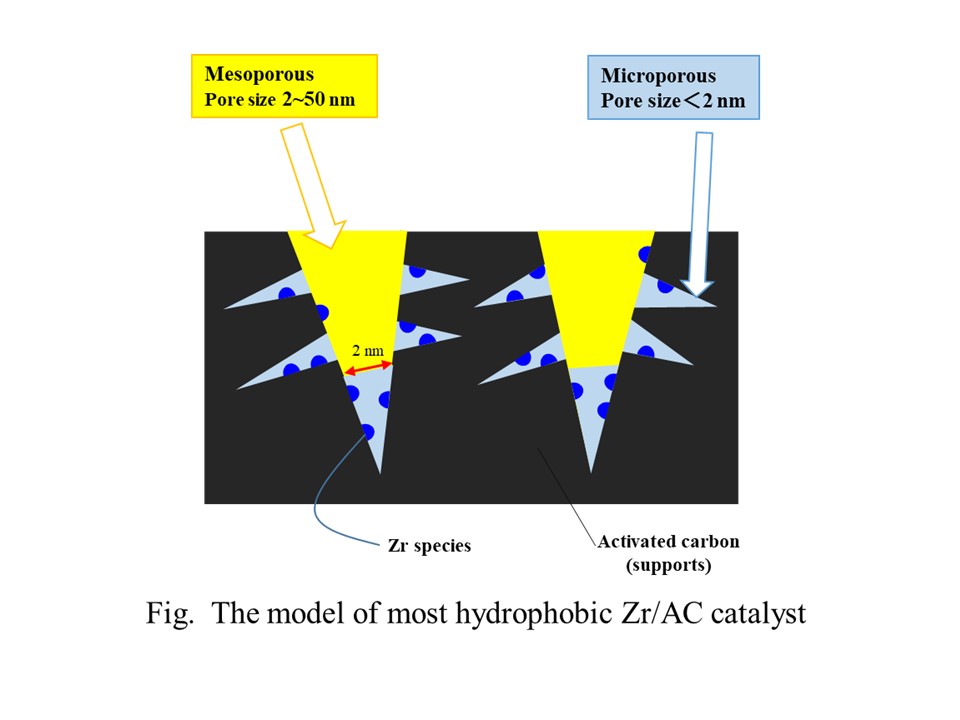
Short-chain fatty acids (SCFAs) have been used as raw materials in wide range of chemical and medical applications. One technique to produce SCFAs is oxidative cleavage of long-chain fatty acids (LCFAs). However, unless the LCFAs are unsaturated, the yield of SCFAs is often very low because the carboxylic group of the fatty acid is more active than other part of the molecule. This work explores the idea of introducing a double bond into saturated LCFA, i.e., stearic acid, via selective dehydrogenation using commercial heterogeneous catalysts. However, cracking of the LCFA is also catalyzed. Different type of metals was therefore investigated to study the effect of metals on the cracking and dehydrogenation. The experiments were conducted in an autoclave reactor under inert atmosphere. The temperature was in the range of 250-350 degree celsius. The products were analyzed by gas chromatography equipped with mass spectroscopy (GC/MS). The results reveal that the introduction of double bond in the aliphatic chain of the stearic acid is possible although the yields of the unsaturated LCFAs are low. Effects of various parameters, such as temperature, pressure, and reaction time, were also investigated and reported.
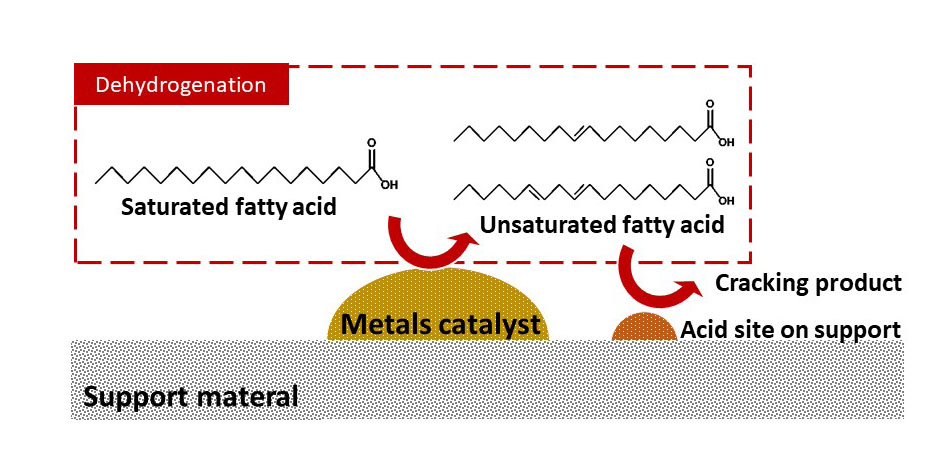
Short-chain fatty acids (SCFAs) and medium-chain fatty acid (MCFAs) are valuable raw materials in wide range of chemical and medical applications. They can be converted to other derivatives by known chemical reactions. Unfortunately, both SCFAs MCFAs are not as abundant in nature as long-chain fatty acid (LCFAs). In this work, the oxidative cleavage of oleic acid, which is one of the most abundant unsaturated LCFAs in nature, was studied. The oxidation was induced by hydrogen peroxide catalyzed by a commercial alumina-supported metal catalyst. The products were analyzed by gas chromatography equipped with mass spectroscopy (GC/MS). The results revealed that MCFAs and SCFAs were detected in a product. In addition, aldehydes were also found. In this work, effects of catalyst loading, oleic acid-to-hydrogen peroxide ratio, reaction time were investigated and reported.
Lactic acid is produced by the decomposition of sugars by lactic acid bacteria by fermentation, and is used as a raw material for biodegradable plastics.
Since the result of lactic acid fermentation depends on culture conditions such as sugar type and concentration, temperature and pH, it is necessary to set appropriate conditions depending on the bacteria used.
In this study, lactic acid fermentation using shochu lees without sterile condition at high temperatures was conducted to investigate effects of cultivation pH (5-7) and temperature (55,60 °C). Sludge collected from a pond on campus was used as inoculum.
The result was that most sugar was consumed and lactic acid was produced at the operating conditions of 55 °C and pH 6.5.
Many important chemical reactions, such as the water-gas shift reaction and ammonia synthesis via Haber-Bosch process, are reversible in nature and the conversion of product(s) limited by chemical equilibrium. Here, we have shown that by de-coupling the overall reaction into two or more sub-reactions via the use of a heterogeneous mediator (a reaction scheme known as “chemical looping”), it is possible to overcome the chemical equilibrium of the overall reaction and achieve almost full conversion of the products.
We demonstrate this possibility by performing the water-gas shift (WGS) reaction at 820 °C: If WGS is performed at this temperature using conventional reaction scheme with an equimolar feed of carbon monoxide and steam is used, the product stream will contain approximately equal amount of carbon monoxide, steam, hydrogen and carbon dioxide on a molar basis when equilibrium is achieved. On the other hand, by feeding the reactants counter-currently over a packed bed of solid mediator that can supply and uptake oxygen over an appropriate range of oxygen fugacities (rather than at a fixed oxygen fugacity), such as non-stoichiometric perovskites (and in this particular case, La0.6Sr0.4FeO3-δ), we are able to produce separate streams of high purity hydrogen and carbon dioxide separately, achieving average conversions over 80% for both carbon monoxide and steam.
The conversion that can be achieved depends on the oxygen fugacity – oxygen capacity relationship of the solid mediator and can be further increased by optimising the length of the bed and the cycle time (duration of each feed stream in the cyclic process). In theory it is possible to achieve full conversion of carbon monoxide to carbon dioxide in one half-cycle and steam to hydrogen in the other. In this way, not only have the equilibrium limitations been lifted, downstream separation units can be simplified or even eliminated.
A methanation processes using synthesis gas derived from naphtha, biomass or coal can generally be performed in both fixed and fluidized bed reactors. The fluidized bed methanation allows isothermal operation due to the high heat transfer coefficients, simple and easy control of the operation. Further advantage is that it is possible to easily remove, add and recycle catalyst continuously during operation. On the contrary, special attention should be paid to attrition and the entrainment of the catalyst particles. In the fixed bed methanation, the heat of reaction has to be considered because of the high amount of CO in the syngas. For controlling the temperature inside the reactor, several methanation reactors are connected in series with intermediate gas cooling or recycle of product gas.
However, the standards for natural gas pipeline network in Korea and Japan are calibrated in the range of 9,700 ~ 10,800 kcal/m3. In order to connect the SNG produced from coal to the pipe network, the calorific value should be adjusted by adding gaseous fuel such as LPG (Liquefied Petroleum Gas).
For this purpose, it is necessary to synthesize paraffinic hydrocarbons having C2 ~ C5 carbon number by designing a catalyst so that FT (Fischer-Tropsch synthesis) reaction occurs simultaneously with the methanation reaction. Therefore, in this study, the reaction characteristics to produce the higher calorific SNG (including C1 to C5 range hydrocarbon) over the hybrid catalyst were investigated in bench-scale fixed bed reactor (FBR), bubbling fluidized bed reactor (BFBR) and slurry bubble column reactor (SBCR).
Acknowledgement:
The authors are grateful to the financial support from Korea Institute of Energy Evaluation and Planning (KETEP, No. 20173010050110).
References:
Kang, S.H., Woo, K.J., Bae, J.W., Jun, K.W. and Kang, Y., Korean J. Chem. Eng., 26, 1533-1538(2009)
Among various methods to produce hydrogen from methane, catalytic direct decomposition of methane is the most environmental friendly process because COx is not generated. CH4 direct decomposition with the catalyst normally provides two hydrogen molecules and carbon deposited on the catalyst as an amorphous carbon or carbon nanotube or film-like carbon. After reaction, those carbonaceous species were separated from the catalyst and collected as functionalized carbon materials. In the most cases, a fixed bed reactor was used for this reaction, and the catalyst deactivation was observed after a short reaction time due to carbon deposition. Some research groups had reported that the usage of plasma or membrane reactor improved the catalytic performance for the direct decomposition of methane; however, catalyst deactivation was still observed, and the way for separating solid carbon from the catalyst and catalyst regeneration method are not clear. From these backgrounds, our research group recently proposed a newly circulating bed reactor which consists of cyclone type reactor for methane direct decomposition reaction and riser reactor for regenerating the carbon deposited catalyst with steam to produce synthesis gas. As a novel circulating bed reactor is under construction, methane direct decomposition with Fe-based or Co-based catalysts and steam gasification of the carbon deposited on the catalysts were performed in a fixed bed reactor in the present study. It was found from the obtained results that the catalytic activity for methane direct decomposition depended on metal loading amount and type of metal and support. Moreover, the kind of carbon deposited on the catalyst was changed with the aforementioned parameters. Since it could be predicted that the reactivity of those carbonaceous species with steam might be changed, the results obtained from steam gasification of carbon deposited on the catalysts were also presented.
Over last decades, electrochemical advanced oxidation processes based on Fenton reaction (EAOP-Fenton) have been paid great attentions because they are capable of continuous generation of strongly oxidizing radicals that can completely oxidize organic pollutants into CO2 and H2O. Among the EAOP-Fenton processes, Fered-Fenton (FF) process, which relies on the electrochemical reduction of Fe(Ⅲ), has demonstrated great effectiveness and has potential for practical application. In FF process, a variety of factors have an impact on the efficiency, although the cathode potential that is especially important because not only in-situ generation of Fenton reagent but competition reactions can occur on the cathode. Furthermore, many researchers have shown the utility of FF process, but most of them have referred to a batch reactor. It is required to develop a flow-type reactor, which achieve continuous treatment, for the application of FF as an industrial method. We have previously presented a flow-type reactor with macro porous carbon electrode as cathode, which is water-permeable. The electrodes were prepared through the carbonization of carbon particles molded with binder.
In this study, effect of reaction conditions such as flow rate, current, on the degradation ratio was examined to understand the electrochemical reaction in the electrodes. It was found that ionic transfer in the electrode is a key factor. Therefore, we measured the liquid potential in up and downstream of the cathode to elucidate the ionic transfer in the cathode. Anode electrode was placed in the downstream of the cathode. Liquid potential in the downstream side was raised with the increase of current, whereas that in upstream side was not changed, indicating that reaction does not occur on the electrode in the upstream side. Change of liquid potential in the cathode was also estimated using electrodes with different thickness.
As photocatalysis is one of useful methods for the cleanup of polluted water, various photocatalyst powders have been reported. Once photocatalyst powder was dispersed into the polluted water, clean water without any organic compounds could be obtained under light irradiation; however, the separation process is necessary to remove the powders from clean water, which imposes high cost and reduces the recovery rate. To solve these problems, our research group proposed a novel catalyst system that photocatalyst powder is encapsulated in alginate shell, and both reactants and products could be permeated through the shell by the concentration gradient between inside and outside. Usage of this system makes catalyst recovery easy, and catalyst-loaded capsules could be successively used several times if the capsules are not broken. In our previous study, two kinds of photocatalyst-loaded alginate capsules were successfully prepared and applied for the degradation of methyl orange under light irradiation. It was found that this new system operated smoothly, and encapsulated nitrogen doped TiO2 powder prepared by original sol-gel method showed higher activity than commercial TiO2-loaded capsules under the irradiation of ultraviolet and/or visible light. Characterization results obtained by various analytical methods suggested that catalyst surface area, crystallinity of anatase TiO2 phase, light absorption property, and powder dispersibility inside the capsule might be key factors to determine its activity. In this study, high surface area TiO2 powders were prepared by original sol-gel method and loaded into the alginate capsules. These capsules were also tested, and the performance was compared with the results obtained in a previous study. Finally, it is indicated which are significant factors to exhibit excellent performance for the degradation of methyl orange under light irradiation.
The reactant (carbobenzoxy phenylalanine) is soluble in an organic solvent and hydrogenated to the product (phenylalanine) using solid catalyst. Phenylalanine is not soluble in the organic solvent, so it needed to be dissolved in an aqueous phase. This was the gas-liquid-liquid-solid four-phase system. Mass transfer becomes more complicated in comparison to three-phase reactors as the catalyst needs to efficiently contact a gas phase as well as two immiscible liquid phases. The catalyst surface properties (hydrophilic versus hydrophobic) also play an important role in the reaction related to the wetting efficiency of the liquids at the solid interface. Gas-liquid-liquid cocurrent upflow reator was used. Column inner diameter was 2.0 cm. Gas flow rate was 1.7x10-6m3/s. Liqud flow rate ratio of water to organic solution was 3. 1-octanol was used as organic solvent. Reaction temperature was 323 K.
To improve Pd/Al2O3 (3 mm in diameter, 3.2 mm inlength) reaction rate, 0.3 mm glass beads were inserted to the catalyst bed. Object of glass bead was calming the gas and liquid flow patern and incresing the gas and liquid velocity.
Gas and liquids hold up was measured to determined the residence time. Water was the continuous phase in this reaction system. Each liquid residence time was calculated from holdup and flow rate. Total liquids flow rate were varied and conversion was measured in each liquid flow rate. Figure 1 shows the effects of the organic solvent residence time on the conversion. Two type of catalyst bed were used. Diluted bed is shown in green mark and catalyst only bed is shown in blue mark. Conversions were linealy increased with increase of the residence time. Slopes of the lines show the reaction rate. The raction rate was increased 1.6 times by using glass beads.
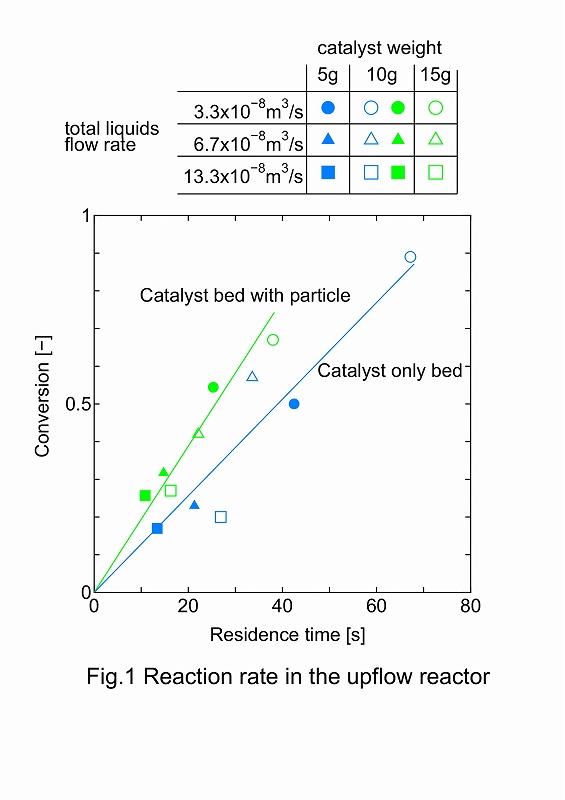
Zeolites are microporous crystalline aluminosilicates, and are industrially used as adsorbents and catalysts because of their very specific physicochemical properties such as ion exchange, adsorption properties.and solid acidity. CHA type (CHA) zeolite, which is one of the most important zeolite, has a three-dimensional pore system with ellipsoidal large cages (6.7x10 â) that are accessible via eight-membered ring windows (3.8x3.8 â). High silica CHA zeolite SSZ-13 and silicoaluminophosphate zeotype SAPO-34 with CHA topology are of great interest as they exhibit a particular shape selectivity for converting methanol or bioethanol to light olefins such as ethylene and propylene. Pure silica CHA also has potential for industrial applications such as adsorption and separation of organic molecules and gas storage because of a larger void space due to the absence of counter cations in the pores and the hydrophobicity. Recently, the hydrothermal conversion of one zeolite into another, i.e., interzeolite transformation has attractive interest from the standpoint of an alternative strategy for zeolite synthesis. Zones and van Nordstand have already reported the interzeolite conversions of cubic P and FAU zeolites used as only aluminum source to high-silica CHA zeolite SSZ-13 with Si/Al ratio of 13. In this study, we investigated influence of Si/Al ratio of FAU zeolite as silica and aluminum sources in the interzeolite conversion to high-silica CHA zeolite. As a result of detailed investigation, by using FAU type zeolite as a silica source and an aluminum source, the Si / Al ratio of the obtained SSZ-13 was successfully extended to 10 to 200. In addition, Moreover, highly crystalline CHA zeolite (Si / Al =100) with a particle size of 1.0 μm was obtained using FAU type zeolite having a Si / Al ratio of 100 as a raw material at 160 °C. for 4 days.
In recent years, the light olefin manufacturers have often confronted an unpredictable regional supply-demand imbalance between light olefins. Therefore, the olefin plant requires an olefin interconversion technology as a simple and optional process to respond quickly to the sudden imbalance of light olefins. The olefin interconversion process is typically divided into two processes: the ethylene-to-propylene (ETP) process and propylene-to-ethylene (PTE) process. The ZSM-5 zeolite was known to exhibit the highest ethylene selectivity in zeolite-catalyzed PTE reaction, and the post-modification with phosphorus could further increase the selectivity. However, the P modification was accompanied by lowering propylene conversion due to the decrease of the strong acid site, which leads to a decrease of the yield of ethylene. Herein, the post-treatment of ZSM-5 zeolite with ammonium hexafluorosilicate (AHFS) was carried out in order to improve the yield of ethylene in PTE reaction. The AHFS-treated ZSM-5 showed a considerably increased yield of ethylene than the pristine (H-Z50) and P-modified ZSM-5 (P-Z50) as shown in the figure. AHFS-treated ZSM-5 exhibits high ethylene selectivity and propylene conversion simultaneously, thus results in the improved ethylene yield. The origin of increased catalytic performance was investigated using ammonia temperature-programmed desorption (TPD) method and solid-state 27Al MAS NMR spectroscopy. From the TPD measurement, it was observed that the number of medium acid sites was increased and the number of weak acid sites was decreased. The NMR spectra indicated that the extra-framework aluminum species (EFALs), which known as having weaker acid strength than framework Al species, increased after AHFS treatment. Therefore, the AHFS treatment causes the generation of EFALs on the external surface of the zeolite and the selective increases of the medium acid site, so that thus improve ethylene selectivity and yield. The synergetic effect of Brønsted acid sites and EFALs would be suitable for acid-catalyzed PTE reaction.
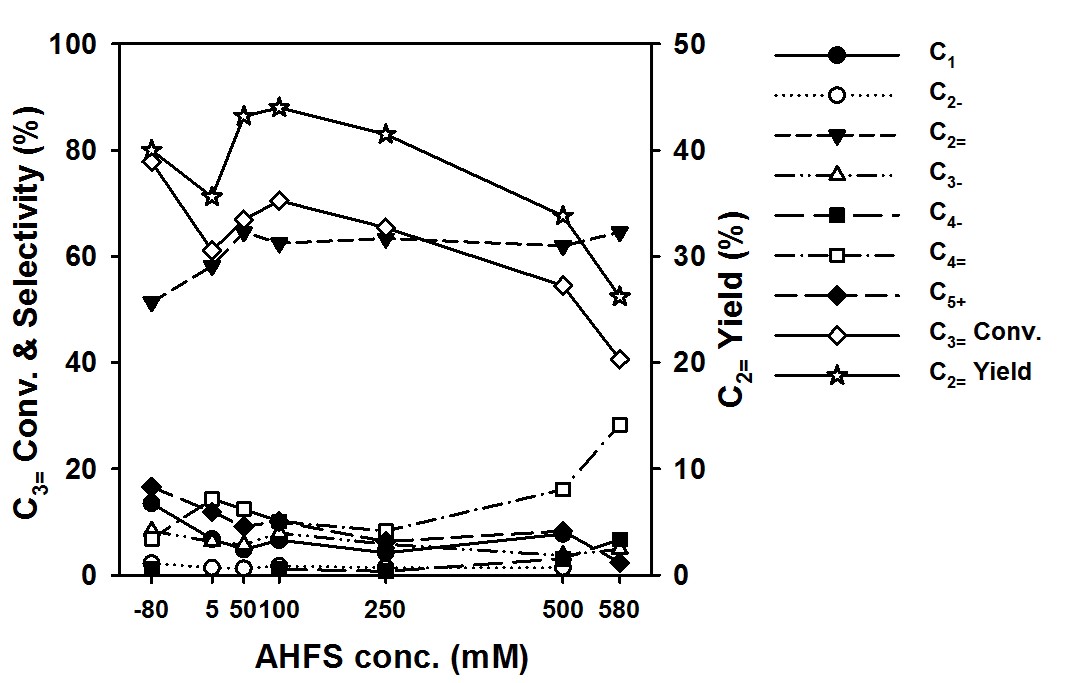
Recently, in electrochemical sensing of H2O2, manganese dioxide has drawn attention as a promising electrode material due to its excellent catalytic activity which can promote H2O2 decomposition. However, many challenges are encountered with its practical application due to the poor electronic conductivity, chemical and mechanical stabilities. Considering this, in our study, we applied carbon nanowall (CNW) as the base nanoporous structure for depositing MnO2 films on it to improve the electrochemical sensor performance of MnO2.
CNWs template was synthesized by plasma enhanced chemical vapor deposition in a CO/H2 microwave discharge system. Glassy carbon with an area of 1cm2 was used as the substrate. The applied parameters of the CNWs deposition process were as follows: CO flow rate: 23sccm, H2 flow rate: 2sccm, pressure: 250Pa, microwave power: 80W, and deposition time: 60 seconds. After synthesizing CNW, MnO2 coating was anodically electrodeposited on CNWs using a three-electrode system consisting of the CNW/GC as a working electrode, an Ag/AgCl electrode as a reference electrode, and a platinum wire as a counter electrode at a constant potential of 1.0V vs. Ag/AgCl in the 0.25M Mn(CH3COO)2 solution.
The morphological and elemental characterization of the fabricated electrodes were carried out by SEM and TEM-EDX. Cyclic voltammetry and amperometric tests were applied for evaluating the sensor performance of the fabricated electrode.
In addition, new challenges of applying anodic deposition technique for synthesizing MnO2 films on porous CNW structure will be introduced and potential biosensor application will be discussed.
1. Liqiang Luo, Electrochimica Acta 77 (2012) 179– 183.
2. Chunyan Guo, Sensors and Actuators B 206 (2015) 407–414.
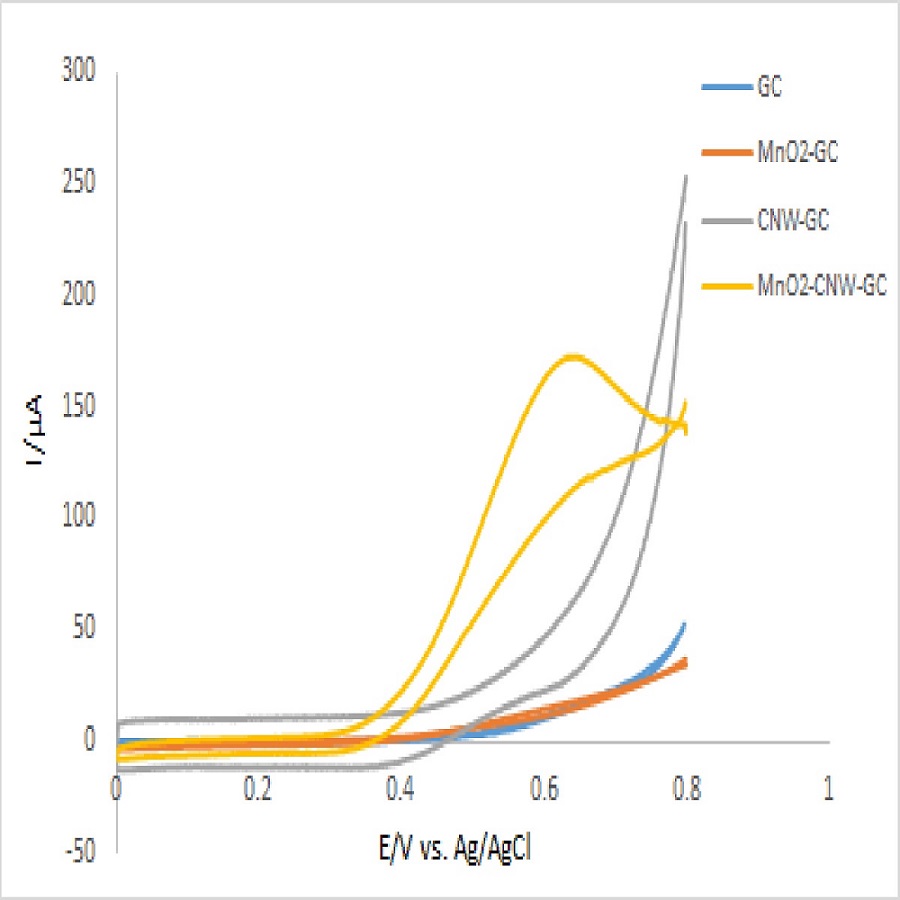
The utilization of surplus electricity from renewable energy resources is one of the social problems; accordingly, non-thermal plasma is drawn attention as its utilization methods.
In this study direct synthesis of liquid hydrocarbons from methane and carbon dioxide using pressure-swing plasma is studied.
In traditional Gas to Liquids (GTL) process, low-pressure conditions are preferred for the reforming reaction of methane to form syngas while high-pressure conditions are preferable for the synthesis of higher-hydrocarbons from syngas (Fischer-Tropsch Synthesis).
In addition to conventional plasma system, in this study, unprecedented pressure-swing of CH4-CO2 plasma is applied for the solution of trade-off pressure conditions.
It is expected that dissociative reaction by plasma and synthesis reaction by pressure-swing will proceed concertedly and liquid hydrocarbon will be synthesized directly.
As pressure-swing plasma system, we utilized a uniquely modified diaphragm pump as a pressure-swing reactor with creeping discharge which develops inside the chamber of reactor.
Electrode has structure that quartz plate as dielectric put between cupper tape as ground electrode and carbon tape as high-voltage electrode and plasma forms near ground electrode. We can also put other metal (e.g. Co foil, Fe foil, and so on) on cupper tape.
Pressure-swing range is approximately 1 – 3 bar, frequency of swing is ~25 Hz. Typical applied voltage of plasma is 9 kV, power consumption of plasma is approximately 4.5 W. Timing of plasma discharge is pulsed and manipulated by micro-controller, typical pulsed frequency is 100 Hz.
The conversion of methane and carbon dioxide and the selectivity of product hydrocarbon are investigated by GC.
From the experiments, we observed that the conversion is improved and the selectivity of product hydrocarbons is shifted to heavier hydrocarbons in pressure-swing condition.
Moreover, we discussed and considered the relation between discharge timing and the selectivity.
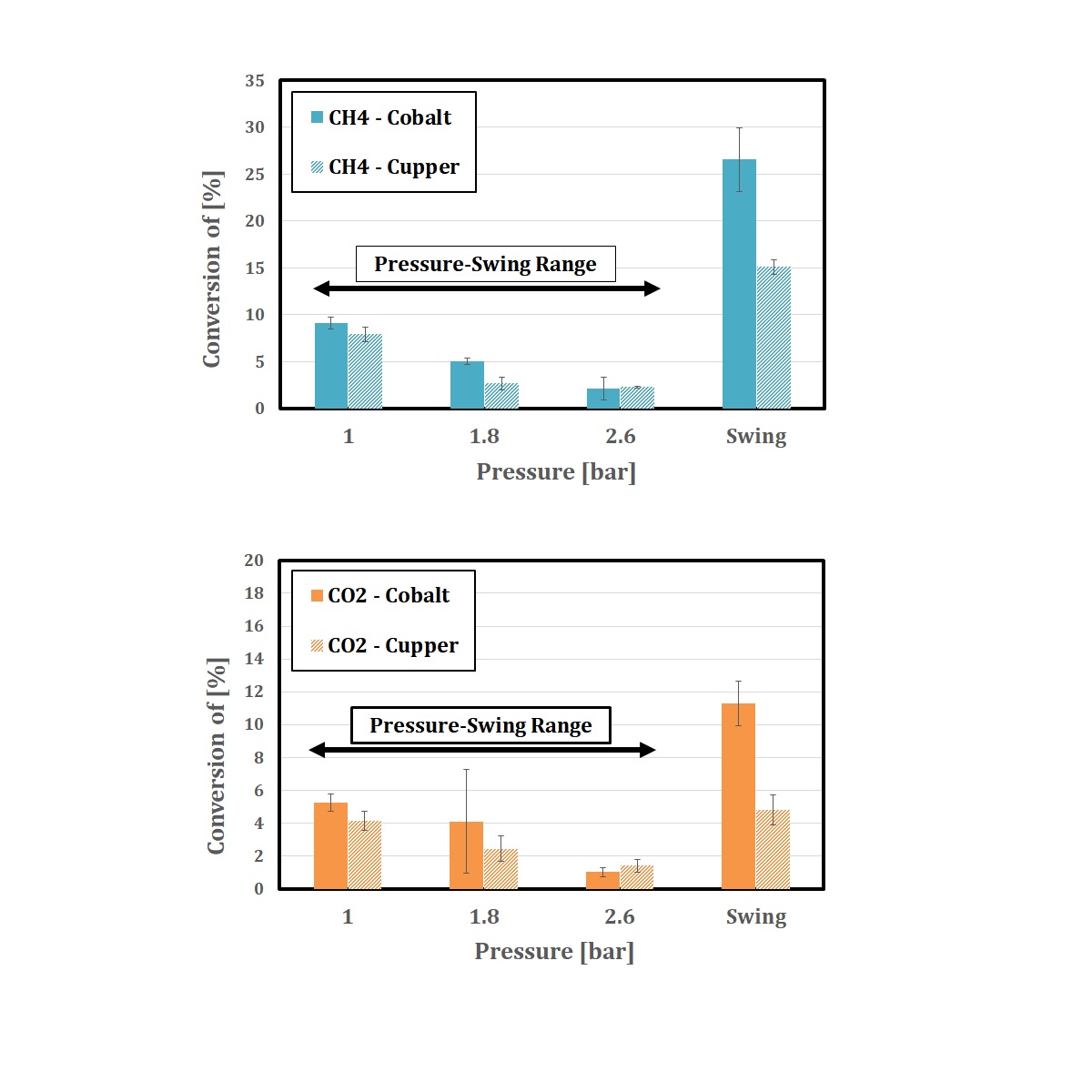
Lithium air battery is one of the most promising energy storages due to its high theoretical energy conversion comparing to conventional lithium ion battery. However, development of lithium air battery to practically use in actual application has been faced many problems such as dendrite on lithium anode, decomposition of electrolyte and pore clogging on cathode. Focusing on cathode, many researches applied highly porous and functional carbon materials such as graphene or carbon nanotube to fabricate cathode by evaporation method. Despite the good properties, those materials too expensive to practically use. Moreover, evaporation causes aggregation of carbon material due to high surface tension, decrease surface area for cathodic reaction.
In this work, we applied carbon black (CB), which is extremely cheap material comparing to graphene or carbon nanotube, as the active material for cathodic reaction and Polyvinylidene fluoride (PVDF) as the binder. Moreover, [C4mim][Tf2N] ionic liquid was impregnated in PVDF to improve ionic conductivity, electrical conductivity and reaction gases selectivity. Those explained materials were dispersed in N-Methyl-2-pyrrolidone (NMP) and dried by supercritical carbon dioxide at 20 MPa, 40 °C. Cathodes were assembled into meshed coin cell with 1 M LiTFSI/TEGDME electrolyte. The capacity was tested with air, pure O2, O2/CO2 mixing gases at 0.075 mA cm-2.
CB/PVDF cathode dried by supercritical CO2 has 92% of porosity, while CB/PVDF/[C4mim][Tf2N] cathode has porosity around 84%. Despite the lower porosity, Li-air battery applied CB/PVDF/[C4mim][Tf2N] cathode provides capacity at 23.2 mAh cm-2 (42.4% efficiency), which is larger than CB/PVDF cathode at 19.6 mAh cm-2 (35.7% efficiency). The discharge products were confirmed as Li2O2 by XRD in both cases. The improvement of specific capacity is considered that ionic liquid gel enhances ionic conductivity and improves selectivity and solubility of reaction gas on surface of cathode.
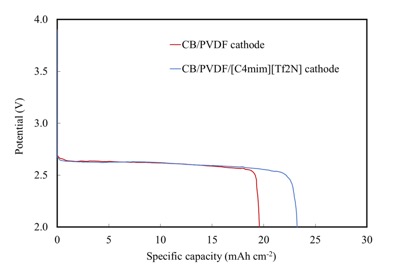
Bi2Te3 type semiconductor is well known as a thermoelectric conversion material generally used in a temperature range around room temperature, and is also put to practical use as a Peltier element for cooling. The Bi2Te3 type semiconductor is generally produced from depositing fine metal powder by a melt under high vacuum or inert atmosphere, and sintering from a ground alloy or mechanical alloying method, but these synthesis process are complicated and the cost benefits are low. Therefore, direct synthesis of single phase fine particles was attempted by preparing a neutralized co-precipitate from each metal chloride mixed aqueous solution, adding a reducing agent and subjecting it to hydrothermal treatment. An aqueous solution of chloride of Bi, Te, Sb, and/or Se was mixed in an appropriate ratio, and the aqueous solution of NaOH was added dropwise with stirring vigorously to prepare a co-precipitate of each composition. HCOOH or NaBH4 as a reducing agent is added to the aqueous solution, hydrothermal treatment is performed at 473 K. for 24 h in an autoclave equipped with a Teflon bottle, the product is filtered off with suction with a 0.45 μm filter, and after distilled water washing, and dried at 333 K or less. As a product, a plate-like fine crystal having a diameter of about 100 nm and a thickness of about 20 nm was obtained, in which the chemical composition was almost uniform in all of Bi2Te3, (Bi, Sb) 2Te3 and Bi2 (Se, Te) 3 ). The electrical resistance and Hall effect for representative product samples were measured. As the results, both products show relatively low efficiency, and it is found that Bi2Te3 and Bi2 (Se, Te) 3 show n-type, and (Bi, Sb) 2Te3 shows p-type semiconductors.
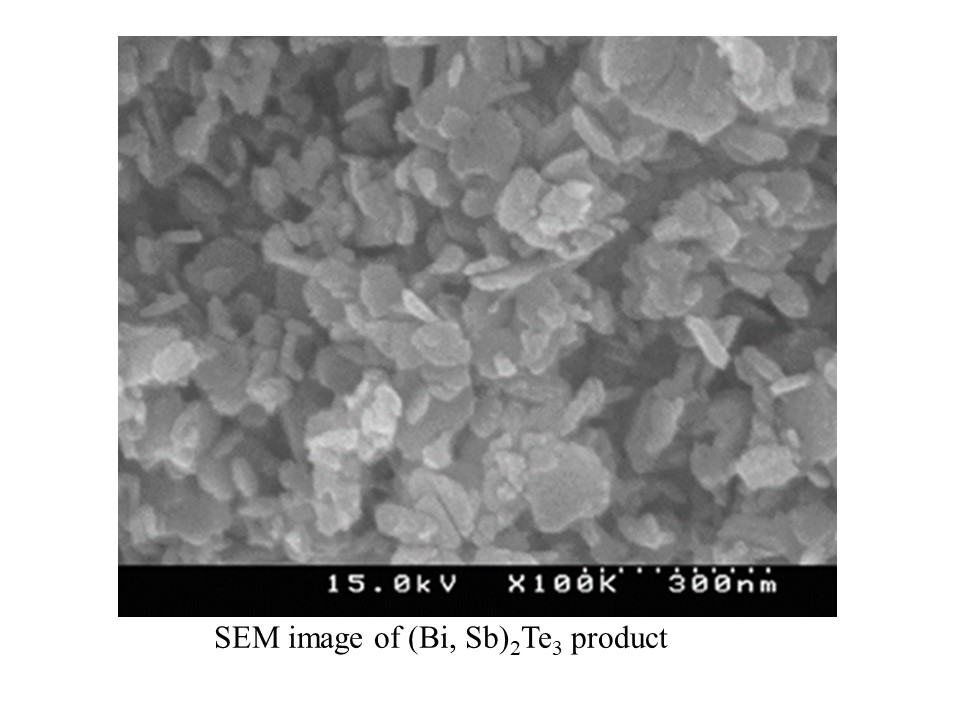
Examination of fouling mechanism in heat exchanger is demanded to minimize fouling trouble. This study analyzed fouling deposits recovered from heat exchanger to reveal the chemical structure of these deposits. The basic structure of the deposits was determined by nuclear magnetic resonance, pyrolysis and X-ray diffraction. The deposits consisted of diene and iron oxide. The CHNS elemental analysis showed that H/C atomic ratio was approximately 1.4 and the deposits had oxygen. The infrared spectroscopy analysis indicated that the deposits had carbonyl groups.
Acknowledgment: This study was supported by the Advanced Production System Project Committee of the Society of Chemical Engineers, Japan.
Introduction
Berry fruits are well known to contain large amounts of polyphenol compounds. Among them, flavan-3-ol and anthocyanidin derivatives are a group of secondary metabolism compounds currently attracting a great deal of attention owing to their health benefits. Berry fruits are often consumed as processed products such as juices and jams in addition to fresh fruits. Most processing methods are heat-drying, but there is little detailed research on how polyphenol compounds contained in fruits change as a result of processing. Therefore, we wanted to chemically track how the polyphenol compounds contained in the fruit change with processing. Therefore, we selected Red Ruspberry (Rubus idaeus L.) as an experimental model plant because it is widely known for edible fruits and is rich in useful polyphenols such as flavan-3-ol.
Results and discussion
The HPLC chromatogram of the fresh raspberry-MeOH extract is shown in Figure 1. The peaks in the chromatogram were identified as catechin (1), epicatechin (2), procyanidin B4 (3), procyanidin trimer (4) and hydrolyzable tannin (5), respectively. In dried fruits, it was confirmed that hydrolyzable tannin was decreased. Measurement of DPPH radical scavenging activity, which is an indicator of antioxidant activity, showed that the activity was reduced in dried fruits. In this report, we will discuss in detail the chemical changes of polyphenol components by drying and heating.
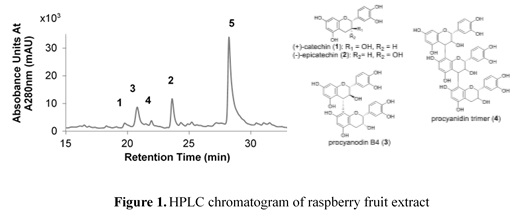
Reactive dyes, which are most widely used for dyeing cotton, have reactors capable of chemical reaction with the hydroxyl groups of cotton fiber. Depending on the type of reactor, the dyes vary greatly in the size of the reactivity and the dyeing temperature. Therefore, the optimum dyeing temperature depends on the reactor.
The dye molecules adsorbed by the addition of the initial neutral salts are markedly less substantivity between the fibers and the dye when the alkali is added. At this time, dye molecules and fibers are covalently bonded by chemical reaction.
The alkali catalyzes the reaction when the dye and the fiber react with each other because the concentration of the OH group in the fiber is increased by the addition of the alkali to increase the reaction. At the same time, however, the OH group concentration of water is also increased, facilitating the hydrolysis, and the pH of the bath is determined by the kind and amount of alkali. The reaction proceeds rapidly as the pH of the bath is high.
In this study, we used the regression analysis to determine the optimum alkali injection timing at the time of the exhaustion equilibrium. The point in time when the substantivity between the fiber and the dye was significantly lowered was calculated and it was decided that the optimum alkali injection time point.
The main factors affecting the primary exhaustion equilibrium during the dyeing process with reactive dyes are neutral salts, that is, in general, the neutral salt, which inhibits the electrostatic barrier(Donnan potential) between fibers and dyes, Eliminate the repulsive force on the fibers.
It also facilitates the action of the Van der Waals force, facilitating the access of the dye to the fiber surface, thereby enhancing the adsorption of the dye.
The amount of neutral salt used is determined by the amount of dye. The more dyed dyes require more neutral salts, the more the amount of neutral salts added, the higher the adsorption of dye in the dyes. This is the basic condition for the next fixing reaction step. In order to increase the adsorption of the reactive dye which is lower than the direct dye, the use of a large amount of neutral salt is required, but the adsorption rate is not improved.
In this study, the basic method of determining the optimum injection timing of alkali additives was analyzed by analyzing the input method and the input amount of the manganese which are the main factors of the dyeing equilibrium of reactive dyes.
Poly(N-Isopropylacrylamide)(PNIPAM), a thermo-sensitive polymer, is well known for undergoing coil-to-globule transition at lower critical solution temperature (LCST) of 32 °C. As this LCST is close to the temperature of the human body, considerable research efforts have been directed towards its potential use in drug delivery systems, functional materials, and humectant absorbents. Conventionally, PNIPAM is produced in aqueous system through the addition of an initiator, however these methods require continuous stirring and lengthy treatment times (more than 6 h). Recently, plasma initiated polymerization methods have been attracting attention because of the generation of free radicals in the process. To generate plasma, pulsed power is commonly used. It is an instantaneous form of energy that, when temporally compressed, can produce a tremendous amount of electricity. This study presents a novel, more efficient PNIPAM polymerization method that uses pulsed arc discharge. An optimal raw material conversion, over 90%, is obtained with an initiator concentration of 0.1mol/L at 4 pps for 1 min in the presence of 2,2´Azobis(2-Methylpropionamidine) Dihydrochloride as an initiator. Furthermore, the effect of the initiator concentration and the distance between the cathode and the aqueous solution are studied. When the cathode is submerged in the aqueous solution, these conditions produce a yield over 80% and an average molecular weight of 261±2.61 (see Table 1).

Plasma technology has great potential for converting excess renewable energy into value-added chemicals. In the previous research in our laboratory, we were able to synthesize ammonia efficiently by pressure swing of N2-H2 plasma. In this research, we will consider the process of synthesizing ammonia by pressure swing of N2-H2O plasma.
Nitrogen gas and water vapor were used as feed gas, electrodes were inserted inside the pressure swing reactor to generate plasma, and then the product gas was analyzed. Nitrogen gas was bubbled into pure water and water vapor, which is a hydrogen source of ammonia, was introduced. The pressure-swing was performed by using a modified diaphragm pump. The product gas was trapped by bubbling into pure water, and the obtained aqueous solution was analyzed by HPLC.
The amount of ammonia synthetic efficiency when the reaction is carried out under a constant pressure and under pressure swing is shown in Figure. By performing pressure swing, the efficiency of ammonia synthesis increased from under a constant pressure.
Moreover, when the metal electrode was changed from copper to platinum, an increase in the synthesis efficiency of ammonia was confirmed under both constant pressure and swing conditions. This indicates that the rate-determining step of ammonia synthesis in this study is a surface reaction, and pressure swing enhances the surface reaction.
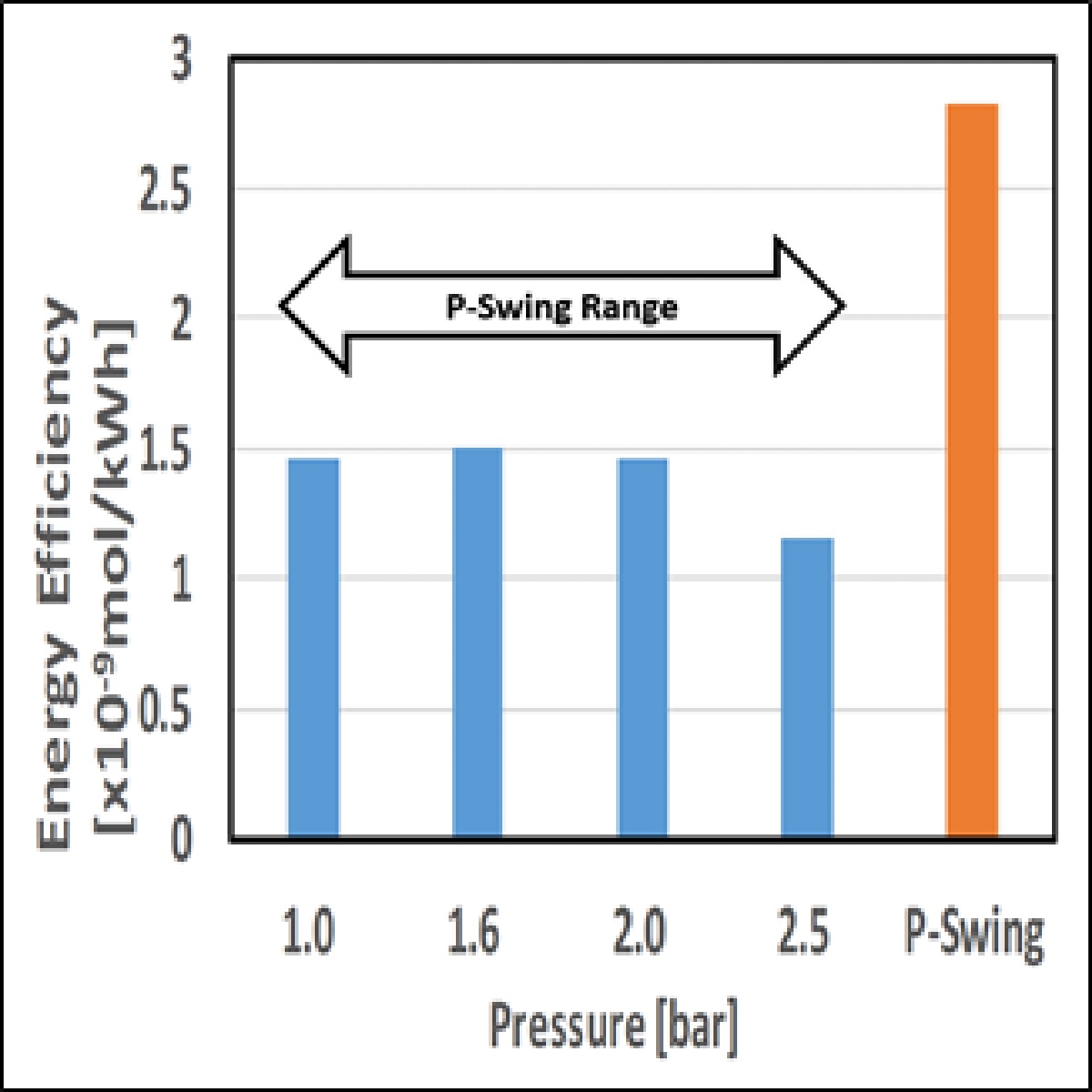
It has been well known that Ammonia is a very important chemical substance for the life of humankind. Simultaneously, conventional ammonia production process needs nitrogen gas and also hydrogen gas which has been produced from either LNG or coal. This study is regarding ammonia production from nitrogen gas and water (Do not hydrogen) by plasma/liquid interface (P/L reaction). We have developed the unique reaction which produces ammonia at the plasma gas phase/liquid (water) phase interface (P/L reaction locus). Although the outermost of surface water molecules on the water phase show a unique orientation, the hydrogen (H) of water molecule on a water surface is possibly oriented toward the gas-phase side. Activated nitrogen extracts H from H2O at water phase surface to produce ammonia, which dissolves in the water.
In excited nitrogen gas (N2 plasma) phase, several excited state have been reported. These include atomic nitrogen (Natom), excited nitrogen molecules (N2*), nitrogen ions (N2+), and the like, which have different lifetimes and reactivities. We have already shown that atomic nitrogen is highly reactive by quantitative analysis of N(4S) nitrogen atoms. Furthermore, it has been reported that increased the amount of ammonia production starting from low reactivity nitrogen species (N2* and N2+) pathways by activating the water phase. Upon UV irradiation onto the water phase, the activated nitrogen with low reactivity also promotes a reduction reaction system using water molecules.
In this study, we examined the P/L reaction pathways that changed the conditions of the water phase. The reaction pathway of ammonia production was examined by changing the pH, changing ionic strength, and changing the amount of water.
This poster focuses on the utilization of the synergy of microwave irradiation and graphene-based catalysis as applied to various reactions related to biomass conversion processes including cellulose depolymerization, glucose conversion into platform chemicals, and transesterification/esterification/etherification of oil fractions and products in biomass. The result are part of the research contributions of the Japan team to the recently concluded JST e-ASIA Joint Research Program on “Development of Functional Nanocarbon-Based Catalysts for Biomass Conversion Processes.”
Conversion and utilization of inedible lignocellulosic biomass, which mainly consists of cellulose, hemicellulose and lignin, have greatly attracted attention to reduce carbon dioxide emission and to establish the sustainable society. Cellulose and hemicellulose are polysaccharides, which can be converted into valuable products and fuels. Lignin is a three-dimensional polymer of aromatic compounds with cross-linking via C-O-C ether bonds and C-C bonds, which can be converted into aromatic products by depolymerization; however, the lignin conversion to aromatic monomers is still challenging. We reported the bond cleavage reactions between aromatic monomers using lignin model compounds in supercritical water at 673 K in the presence of supported palladium, platinum, and rhodium catalysts without added hydrogen gas and without causing hydrogenation of the aromatic rings in the previous paper. Thus, we applied this technique to the lignin into aromatic compounds. In this paper, we found that lignin could be converted into aromatic monomers in supercritical water at 673 K over supported metal catalysts. We investigated the effect of supported metal catalysts on lignin deporimarization into aromatic monomer in supercritical water.
Acid-catalyzed condensation between alcohols and carboxylic acids to produce ester compounds (i.e., Fischer esterification) plays an important role in chemical industries. Since Fischer esterification is an equilibrium reaction, it is mandatory to shift the equilibrium to obtain the ester products with high yields. Increasing reaction temperatures more than 100 °C to remove water by-product from reaction systems is a typical procedure to shift the equilibrium. However, undesirable side reactions might occur at higher temperatures (e.g., degradation of reactants/products, etherification of alcohols, and condensation between alcohols and acid catalysts). In addition, separation/purification of the products generally requires distillation process, as well as neutralization process of acid catalysts, which severely raises energy costs.
In the present study, we have prepared ionic liquid catalysts (ILCs) that undergo phase separation with ester products, while water by-product is selectively absorbed in the ILC phases [1,2]. The phase separation of esters and water efficiently shifted the equilibrium at moderate temperature, and high conversion values over 90% was obtained for the synthesis of wax esters from long-chain fatty acids/alcohols. The ILCs were not contaminated in the ester phases. On the other hand, the partition of unreacted acids/alcohols and ester products was strongly dependent on the structure of ILCs. Details on the relation between the partition behavior and reactivity will be discussed. Moreover, our preliminary studies to utilize flow reactors will also be presented.
References
[1] Y. Kohno, T. Makino, M. Kanakubo, React. Chem. Eng., 2019, 4, 627-633.
[2] Y. Kohno, T. Makino, M. Kanakubo, Fluid Phase Equilib., 2019, 490, 107-113.
When ultrasound is irradiated to water, degassing, that is, decrease of dissolved gas concentration occurs [1]. However, the effect of ultrasonic frequency on degassing behavior is few reported. In this study, the change in dissolved oxygen with ultrasonic irradiation time was investigated for a wide range of ultrasonic frequencies.
Experiments were carried out using a cylindrical vessel with a 56 mm in inside diameter. Transducers (Honda Electronics) attached to the vessel were a Langevin type multi-frequency transducer with 45 mm in diameter at frequencies of 22, 43, and 129 kHz, and disk type transducers with 50 mm in diameter at 209, 308, 400, 514, 1018, and 1960 kHz. Transducers were driven by a power amplifier. Ultrasound at 15 W of the ultrasonic power was directly irradiated to a 100 mL sample in the vessel. The ultrasonic power which was the energy applied to the sample per unit time was obtained by calorimetry. Ultrapure water was used as the sample. The degassing behavior was measured by the fluorescence dissolved oxygen meter.
The effect of ultrasonic frequency on time change of the dissolved oxygen by ultrasonic irradiation is shown in the figure. The dissolved oxygen decreases with ultrasonic irradiation time, and the decrease rate is maximum at 300 kHz. Dependence of sonochemical reaction on the ultrasonic frequency at 15 W was investigated by the KI method. In this method, triiodide ion is generated from iodine ion by ultrasonic cavitation. Sonochemical efficiency was also maximum at 300 kHz. Because a lot of cavitation bubbles generated in the sample at 300 kHz, the dissolved oxygen decreased significantly. It was proved that frequency dependences of sonochemical efficiency and degassing rate correlate each other.
[1] N. Gondrexon, V. Renaudin, P. Boldo, Y. Gonthier, C. Pettier, Chem. Eng. J., 66 (1997) 21-26.
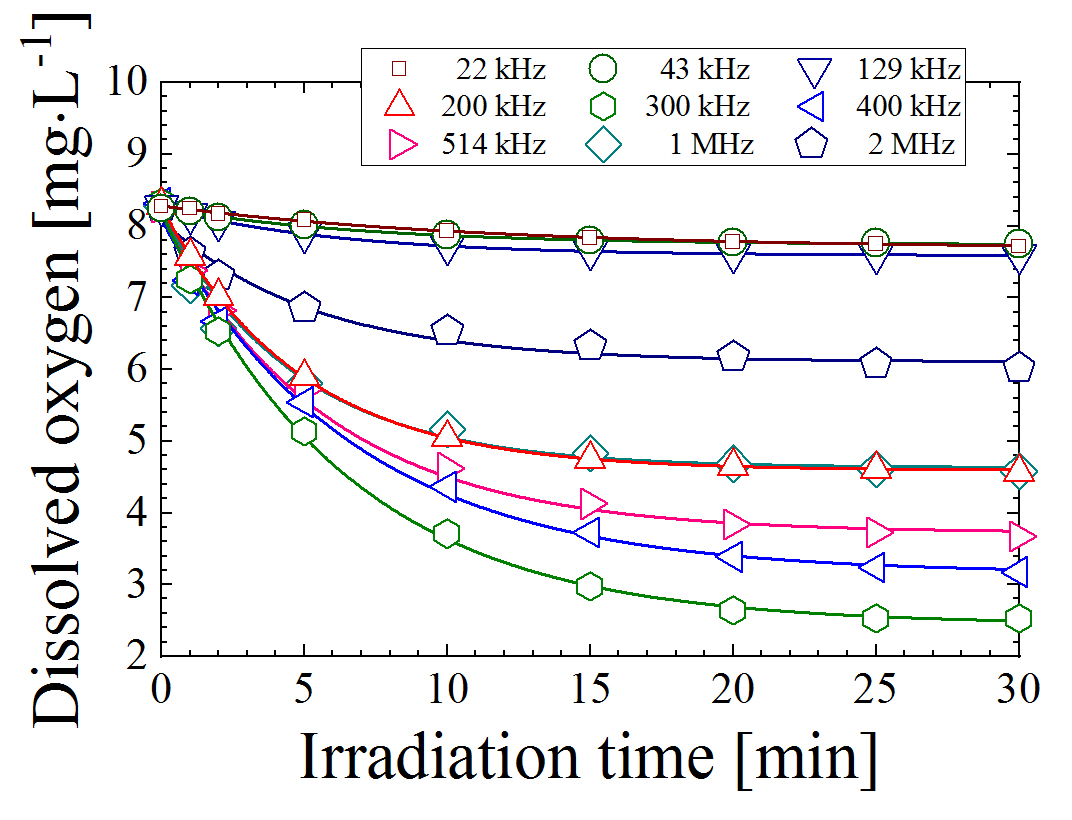
Recently, attention about phenomena and effects caused by supply of fine bubbles to aqueous solution is increasing. With regard to fine bubble species, the dissolution phenomena of hydrogen has not been clarified. Reduction of the concentration of oxygen active species owing to the dissolution of hydrogen fine bubbles is expected for application of food, substance synthesis, and environmental conservation fields. In this study, effects of molar fraction and bubble size of hydrogen/nitrogen fine bubbles on dissolution rate, solubility and reaction characteristics with oxygen species active species were investigated.
We have previously reported that OH-radical formation was enhanced by the existence of microbubbles under the specific frequency (45 kHz) of ultrasound irradiation. In the present work we have performed the experiment of ultrasonic degradation of azo dyes with various frequencies with and without microbubbles. It was found that for 45 kHz ultrasonic irradiation microbubbles enhances the degradation of azo dyes. To confirm that the effect was due to the cavitation bubbles formed by the irradiation ultrasound, we have introduced microbubbles with various gases and it was found that Kr and Ar gases have much larger formation of OH radicals, while He gas was very few effect on the enhancement of OH radicals. It was concluded that the cavitation bubbles were formed due to the ultrasonic irradiation and OH radicals were formed from these cavitation bubbles. Thus microbubbles have some effects on the enhancement of cavitation bubbles only in the case of 45 kHz ultrasonic irradiation.
In recent years, a great interest has been taken in microwave enhanced chemical reaction and many research have been conducted using microwave as a heat source. It is said that microwave heating has many advantages such as generating a uniform temperature distribution within a irradiated medium, quick heating, enhancing a reaction rate and improvement of selectivity on reaction products.
On the other hand, ultrasonic are also utilized for chemical reaction and it is reffered to as sonochemistry. There arises some effects by ultrasonic such as macroscale and microscale mixing due to the moving or oscillation of bubbles generated by cavitation and hot or high pressure spot derived from the collapse of bubbles.
In this study, experiments of esterification were carried out where irradiation intensity of microwave and ultrasonic were changed, and the effect of both irradiation on the conversion or reaction rate of esterification was investigated. The irradiation of microwave and/or ultrasonic was conducted until the reagent temperature reaches 333K.
As a result, when the irradiation of microwave and ultrasonic were introduced simultaneously where microwave power was varied with constant ultrasonic power, apparent reaction rate constant became larger than in the case that only microwave was irradiated. As for conversion, which is the result determined by reaction rate and reaction time, it decreased as microwave power become larger under constant ultrasonic power since the reaction time shortened because of quick ascent of temperature due to large microwave power , whereas it increased as ultrasonic power become larger under constant microwave power.
In this work, a spiral microchannel reactor was fabricated, and then applied to a selective synthesis of monoglycerides (MON) from palm fatty acid distillate (PFAD) and glycerol via esterification in the presence of sulfuric acid. An angle-less stainless-steel microchannel reactor with 200-cm length and 1×1 mm cross-sectional square-shape channel was designed to overcome the pressure drop related to a high viscosity of PFAD and glycerol. The flow patterns of both reactants were determined by using different fluid mechanic equations. The effects of reaction temperature and residence time on the PFAD conversion and the MON selectivity were investigated. Moreover, the results were compared with those obtained from stirred-tank batch reactor. It was found that the esterification of PFAD with glycerol under batch conditions gave the highest PFAD conversion (>95 wt.%) but the MON selectivity was only 40% due to the formation of di- and tri-glycerides. At a similar conversion, the spiral microchannel reactor gave higher MON selectivity than the batch reactor. The suitable condition for MON synthesis in the spiral microchannel reactor was 2 wt% sulfuric acid (based on the PFAD weight) at 200 °C and 2 h residence time under which the PFAD conversion and the MON selectivity were 81 and 74 %. The selective MON formation was explained by counter rotating vortices flow and solubility parameter of reactants and products.
To enhance the thermal controllability of the reaction system, a compact reactor was introduced, where heat transfer with both cooling media and cool feed gas was utilized. A computational fluid dynamics model was developed to analyze detailed profiles of mass, momentum and heat, and it was shown that the compact reactor could efficiently remove the generated heat. The space velocity and feed temperature were manipulated to increase the production rate, and the proposed reactor could produce twice of methanol with its peak temperature maintained below that of the conventional reactor. When the diameter of the catalytic bed in the compact reactor was increased, the reaction stayed in the kinetic regime, resulting in high methanol productivity as well as the maximum utilization of the bed.
Extraction with slug flow (alternating flow of different phases) gives fast mass transfer rates and rapid phase separation than the conventional extraction operations. Therefore, there are many advantages such as a reduction in volume of the device and a drastic decrease of the solvent used in the process. The circulating flow in each liquid segment and the interface area per the unit liquid volume largely depend on the geometry of the liquid segment. When the extraction by the slug flow is performed in a narrow diameter tube, the pulse flow (pulsation) of the pump that supplies the liquid gives a great influence on the flow condition in the tube. When the movement of each liquid segment is not kept uniform, the liquid flow disturbance cannot ignore the influence on the extraction rate. So, this unstable change of the flow is not desirable in analysis of extraction rate and device design. Therefore, a syringe pump with little pulsation has been used in many studies on the slug flow. The syringe pump is suitable for extraction by the slug flow since it shows no pulsation. However, it is not possible to supply continuously more liquid than the volume filled of the syringe. This indicates that it is not difficult to handle more than the volume of the syringe. The development of a stable flow liquid pump that supplies liquid without pulsation is expected.
In this study, two diaphragm pumps were interlocked to control the flow rate and the reciprocation frequency of the membrane. We succeeded in generating a liquid-liquid slug flow with a fixed length of about 1-6 mm. It was also confirmed that the generated slug flow was a stable flow of about 1 hour. We have found the possibility of becoming a new slug flow generation device.
Extraction by slug flow gives high mass transfer rate and rapid phase separation than the conventional extraction operation. Therefore, there are many advantages such as the volume of the device becomes small and the solvent drastically reduced. The slug flow extraction is expected as a sophisticated separation process. Especially, these advantages become more prominent in the multistage extraction. In this study, the extraction by the slug flow was applied to mutual separation of lithium, cobalt and nickel ions in the mixed aqueous solution. By combining forward and backward extractions, cobalt ions could be recovered with concentrating about 1000 times. We succeeded in developing a process with lithium, cobalt, nickel ion purity of 85% or more and recovery rate of 90-95%. Furthermore, it was also confirmed that the flow state of the liquid is influenced by the hydrophobicity (PTFE tube) and hydrophilicity (glass tube) of the extraction tube. The overall mass transfer volumetric coefficient is affected by (1) the interface area of the oil phase and aqueous phase, (2) the strength of the circulating flow in each segment of the liquid, (3) whether the mass transfer resistance is in the aqueous phase or the oil phase, and (4) the volume flow ratio of the oil phase and the aqueous phase, and so on. In general, the total mass transfer volumetric coefficient increased when the liquid with low mass transfer resistance wetted the wall of the extraction tube. This suggests that the wetting of the pipe has a great influence on the extraction rate in the slug flow extraction. It is necessary to select the tube material for operation properly. Furthermore, we confirmed that the overall mass transfer volumetric coefficient can be easily calculated from the experiments and the extraction rate can be simulated by a numerical method.
Quenching flow method using flow microreactors is known to be suitable for kinetic analysis of chemical reactions. This is because the characteristics of the flow microreactors such as fast mixing, precise residence time control, and precise temperature control makes it possible to control precise reaction conditions. The product can be accurately analyzed by various analytical methods such as gas chromatography. We have already reported kinetic analysis of organolithium reaction by quenching flow method using flow microreactors. Herein, we apply this method to the Schotten-Baumann reaction, which is the reaction of amine and acid chloride in the presence of basic aqueous solution. In this presentation, we report the kinetic analysis of the amidation and the comparison of the kinetic difference between various amines.
Among multiphase reactors in the chemical and pharmaceutical industries, packed bed compact reactors with internal diameters on the order of millimeters or micrometers are of interest. However, the design and operation method of packed bed compact reactors has not been established because it is difficult to analyze the flow pattern, which greatly influences heat and mass transfer performance, by visualization. In this study, an experimental system consisting of a packed bed compact reactor was constructed, and a method of estimating the flow pattern in the reactor was developed through numerical simulation as well as experimental analysis of the measurement results of voltage or differential pressure. The results show that when gas and liquid were supplied to the reactor, the developed method made it possible to distinguish the flow patterns of trickle flow and pulse flow from the shapes of the measured voltage or differential pressure and to estimate the pulse frequency of pulse flow (i.e., peak frequency of power spectral density), which is useful in grasping the degree of mixing of gas and liquid. It was suggested that the design of the mixer capable of producing shorter gas and liquid slug as well as the design of the reactor inlet should be developed in order to realize the process with higher gas and liquid mixing.
Introduction
Recent medical/orthodontic curable compositions have acquired high physical properties by using the newly designed long-chain silane coupling agent[1]. However, since the synthesis process required hydrosilylation as shown in Figure 1, it was essential to remove the platinum group complex from the synthesized material. In this study, we synthesized a long-chain silane coupling agent from a both-terminal-equivalent compound[2] such as ethylene glycol as a substrate using a micro flow reactor, and evaluated the influence of various synthesis conditions on the yields, etc. of the resultant silane coupling agent.
Results and Discussion
In comparison to the batch method, the flow method more efficiently synthesized mono-substituted products. Since the mixed solutions of 2-isocyanatoethyl methacrylate and ethylene glycol were heterogeneous, the reactions may have occurred at the liquid-liquid interface. The flow method provided larger surface area of the liquid-liquid interface than the batch method because the flow method produced fine emulsions using a chip (static mixer) for mixing the solutions. This resulted in more efficient reactions compared to the batch method.
Reference
[1] Fuchigami K, Fujimura H, Teramae M, Nakatsuka T. Precision synthesis of a long-chain silane coupling agent using micro flow reactors and its application in dentistry. Journal of Encapsulation and Adsorption Sciences, 2016, 6(1), 35-46.
[2] Huang X, Liu Y, Wang S, Zhou S, Zhu D. Synthesis and self-assembly of 2,9,16-tri(tert-butyl)-23-(10-mercaptodecyloxy)phthalocyanine and the application of its self-assembled monolayers in organic light-emitting diodes. Chemistry - A European Journal, 2002, 8(18), 4179-4184.
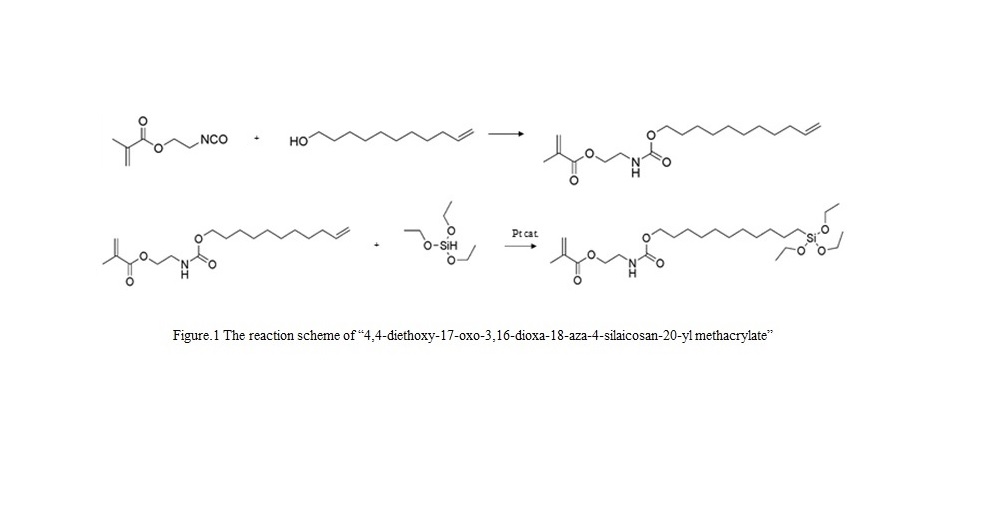
The main objective of this study is to investigate the flow pattern with gel reaction inside a continuous circular flow pipe and to identify the governing dimensionless number of flow patterns with gel reaction. The flow channel consists of a transparent main flow pipe and a transparent branch flow pipe which is connected to the main flow pipe. 10 mass% PVA and 3 mass% borax solutions are used as working fluids. 10 mass% PVA solution flows in the main flow pipe with steady-state conditions. Reynolds number (Rem) based on the mean velocity and the diameter of the main flow pipe is less than 30. The borax solution are injected from the branch flow pipe to the main flow pipe. The duration of the injection time and injection volume flow rate from branch flow are varied correspondingly to deliver a fixed volume of borax solution. At first, three flow patterns are observed inside of flow pipe, Capsule (C), Capsule + Stretched (CS) and Capsule + Stretched + Fingering (CSF) flow pattern. To identify the dimensionless number of three flow patterns with gel reaction quantitatively, we introduced Rem and β which is the volume flow ratio of the main flow to that of the branch flow. The results show that when β is less than unity, C flow forms and β is the main parameter that determines the flow pattern with gel reaction. When β exceeds unity, Rem is the main parameter that determines the flow pattern with gel reaction. When Rem exceeds 10.0, CSF flow forms. These results indicate that β and Rem play key dimensionless number in the gel formation and flow stability in a flow channel.
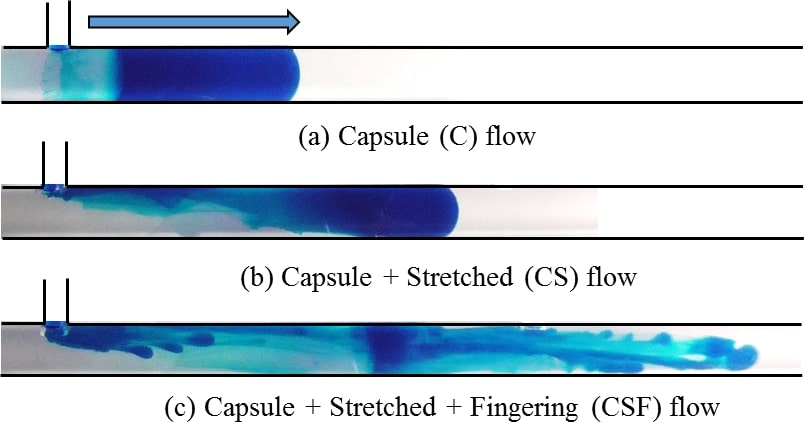
Hydrogenation is an important chemical reaction process in the production of petrochemical products, perfumes, and pharmaceutical intermediates. A gas-liquid-solid three phase reaction was carried out in a slug flow reactor in order to improve the apparent reaction rate by enhancing mass transfer rate of gas to the solid catalyst surface through the liquid. Hydrogenation of alpha-methyl styrene (AMS) using hydrogen gas was employed as the model three-phase reaction. The reactor was an aluminum tube of length 300 mm and inner diameter 4 mm. A thin alumina layer was formed on the inner wall and contained palladium as a catalyst. The hydrogen and AMS were introduced into a T-joint installed at the upstream of the reactor to form the gas-liquid slug flow. The AMS conversion obtained by the slug flow was much higher than that without slug flow. In order to examine the effect of the hydrogen absorption promotion by the circulating flow in the AMS slug, the total flow rate of the reactants was varied while the lengths of the gas and liquid slug were fixed to be constant. Although the absorption must be increased due to the faster surface renewal, only slight improvement could be observed. When the total flow rate was fixed and the ratio of the gas slug length to the liquid slug length was increased, the apparent reaction rate was improved significantly. These results indicate that the diffusion in the thin liquid film directly toward the solid catalyst was dominant for the reaction rate enhancement. Furthermore, the influence of the specific surface area of the liquid film layer was investigated from the mass transfer model by conducting the reaction experiments using the tubular reactors with different inner diameters.
In recent years, with the increase of global energy demand and adaptation to a sustainable society, there is a demand for higher efficiency of energy use in chemical plants. As one of the methods to improve the efficiency and energy saving of the chemical reaction process, this study examined the electric heating catalytic reaction process. The electric heating is a system in which Joule heat is supplied to a catalyst carrier having electric resistance. In this system, thermal energy is directly supplied to the reaction site. The etched aluminum foil was used for a catalyst carrier. This material has through holes at a density of about 10,000 holes / mm2 and its diameter can be controlled to 1 to 4 μm. A reaction space such as a microreactor can be realized by using the through holes as reaction channels. Further, the catalyst metal can be supported by making the wall surface of the flow path porous, and it also has a function as a structured catalyst. With regard to electric heating, thermal energy is generated by supplying current to the base aluminum. In the evaluation of the electric heating performance, the model reaction was the methanol steam reforming. Evaluation factors were temperature rising rate, temperature reached, power consumption, and hydrogen generation rate. As a result of conducting the activity test, energy consumption was reduced by 40% in the electric heating as compared with the power consumption of the process by the external heating. In the future, we will study the temperature non-stationary operation in order to evaluate the startup performance of electric heating.
Multiphase reaction systems for organic synthesis are encountered in many chemical industries producing petrochemical derivatives, fine chemicals and pharmaceuticals.
Operating multiphase flows in the microscale has proved to be effective owing to its enhanced mass transfer. Additionally, microreactors bring the advantage of safety, easy control and flexible scalability by numbering up compared to the large chemical reactors. In microstructured devices where the diameter falls into the range of 100 to 1000 microns, time scales are small and molecular diffusion is the dominant driving force for mass and heat transfer. Enhancing the performance of microreactors requires improving advective mass and heat transport which can be realized by implementing helical structures. The flow in the helical structures is known to generate secondary flow vortices in the radial and tangential directions, which are believed to enhance the convective transport.
In order to provide an insight into the transport phenomena taking place, this research work aims to simulate multiphase flows with a focus on the effect of helical structures on mass transfer. A new numerical model is suggested to reduce the computational domain from a full-scale helical structure to one straight 3D slug. The numerical model is built using the Volume of Fluid (VOF) method and simulations are run using the open source OpenFOAM software. A multiphase simulation of water-air segmented flow showed that the diffusion of oxygen from air to water is faster in a helically coiled microcapillary compared to a straight microcapillary even at low Reynolds numbers.
Mixing characteristics under laminar flow conditions was examined. A thin tube is co-axially inserted into the channel through which the solution of reactant A flows. The solution of reactant B was co-currently fed from the thin tube into the A solution. The mixing characteristics of B into A in the channel were evaluated under the condition of flow ratio A : B = 100 : 1. An orifice was installed downstream of the junction of the two solutions for promoting mixing. The influence of the flow rate ratio of the two solutions, the installation position and the geometrical shape of an orifice on the mixing characteristics was evaluated by Dushman reaction. As a result, in the co-axial double tube type mixer, the mixing characteristics of the two solutions became better as the total flow rate increased, even under co-current and laminar flow conditions. Moreover, it was found that the double tube type mixer was much better compared with mixing characteristics in a beaker stirred by a magnetic stirrer. The mixing characteristics when the orifice was placed downstream of the confluence point were significantly better than those without the orifice under the same Reynolds number condition. These results are considered to be due to the promotion of mass transfer in the greatly stretched thinner flow from the inner thin tube because the flow rate of the solution in the annular region is greater than that from the inner thin tube. When the orifice is inserted, it is thought that the contraction flow when passing the orifice and the expansion from there have developed the same effect. These flow characteristics of the flow from the inner thin tube were also confirmed by numerical simulation.
We describe the stability of liquid-liquid slug flow in this study. Knowledge of slug stability is necessary to utilize the liquid-liquid slug flow for unit operation. Fragmentation or coalescence of slugs causes unexpected reaction performance and extraction efficiency, and affect the productivity or product purity. Establishment of the stable operation guideline for the liquid-liquid slug flow is necessary.
We made the liquid-liquid slug flow by using dodecane as an organic phase and water colored with rhodamine B as an aqueous phase. The stability of slug flow based on two control systems was examined: active slug formation with solenoid valves and passive slug formation without solenoid valves. The optical sensor was set in the flow path to measure the slug velocity. The experiment was conducted with different aqueous slug lengths.
We depicted the map for the stable slug operation, in order to the capillary number and valve frequency. Then, the behavior of slugs at various flow rates and slug lengths was investigated. When aqueous slugs of different lengths were alternately formed, a long-length slug caught up with a short-length slug. Optical measurement suggested that the velocity of the aqueous slugs was faster than the flow velocity assuming the plug-flow, and the long-length slug flowed faster than the short-length slug.
In conclusion, the stability of the liquid-liquid slug flow depended on the capillary number and the valve frequency. The uniform length of the dispersed slug contributed to the steady operation.
Hydrogen obtained by water electrolysis using electric power derived from renewable energy is attracting attention as a clean next-generation energy. The difficulty of storage and transportation of hydrogen can be solved by converting hydrogen to chemical hydride. The production of chemical hydride with hydrogen derived from water is important technology for hydrogen energy society. The methylcyclohexane (MCH) is one of useful hydrogen carrier due to about 6 wt% of its high hydrogen content and low melting point. The system combining hydrogen formation by electrolysis of water and hydrogenation of toluene to form MCH will be useful to produce chemical hydride from water. The hydrogenation process can be expected as a new energy storage method in a decentralized society because the device can be miniaturized while using electric power derived from individual renewable energy. Hydrogenation of toluene to produce MCH proceeds in the presence of catalytic Pt/Al2O3 powder at the permeation side of Pd-Ag membrane electrode in our previous study. In this case, it is difficult to fill up a lot of catalyst powder in small space. Structured catalyst will solve the structured problem and give lower pressure drop than that of catalyst bed.
In this study, the electrolysis of water with hydrogen permeable Pd-Ag membrane electrode and hydrogenation of toluene from hydrogen permeated through the membrane in catalytic layer made of washcoated Pt/Al2O3 catalyst on stainless steel mesh. The potassium aqueous solution was supplied to reaction cell with HPLC pump at 0.8 MPa and toluene was supplied by bubbling with nitrogen at 0.1 MPa. The hydrogenation was conducted around 373 K. The stability of hydrogenation-electrolysis cell was stable for several hours. The effect of temperature and flow rate of toluene on hydrogenation rate and hydrogen utilization efficiency was evaluated, which revealed that the hydrogenation was enhanced in higher temperature region.
Syngas production had been great attention among the researcher especially from non-conventional feedstocks. Syngas is a basic feedstock for many commercial important chemicals and fuels and can be produced as a result by dry reforming of methane (DRM). However, conventional reactors involved high reaction temperature due to the high endothermicity of DRM. Membrane reactors are expected to decrease the reaction temperature by shifting the thermodynamic equilibrium of DRM. Several researchers have explored the performance of membrane reactors using metal and silica membranes in DRM, and confirmed hydrogen yield was improved. However, this reveals insufficient activity of conventional catalysts in low reaction temperature. Previously, we have developed Ru/Y2O3-ZrO2catalysts to beapplied to the low temperature DRM. In this study, we aimed to evaluate the effect of membrane performance on membrane reactor performance using our developed catalyst in DRM. In the case of the membrane reactor using a Pd membrane at 500 °C, CH4 and CO2 conversions were 32.5% and 25% respectively, which were a half-more higher than the conventional reactor. The hydrogen yield was found to be 33.9% that was three times higher than its conventional reactor, and interestingly,H2/CO ratio counted as 1.08 for the Pd membrane reactor and 0.70 for the conventional reactor. This indicates H2 separation gave a significant impact on not only the H2 yield but also H2/CO ratio. To compare with the Pd membrane reactor, Ni-doped silica membrane was also prepared by sol-gel method and its gas permeances were 0.53 × 10-6 mol m–2 s–1 Pa–1 for N2 and 3.20 × 10-6 mol m–2 s–1 Pa–1 for H2. The performance of the membrane reactor using the silica membranes will be presented as a comparison.
Key words : DRM, membrane reactor, syngas.
A great interest has concentrated to liquefied ammonia as a chemical hydrogen carrier in Japan because of its higher hydrogen content, i.e., 17.6wt%-H2 per unit weight of NH3. As far as ammonia is used as an energy carrier, its decomposition for obtaining H2 should be carried out at as low temperature as possible. However, the decomposition rate is known to remain very low at lower temperatures below 500 °C although the equilibrium conversion in the range 0.1-0.5 MPa at 300 °C reaches more than 80%. In practice, according to our data, the conversion remained around 10% at 300°C when 2wt% Ru/Al2O3 catalyst was used. Therefore, it is required to propose an innovative technology that can not only realize a higher conversion even at lower temperature below 400 °C but also obtain pure hydrogen.
As a way of improving such a situation, in this study, we have focussed on adoption of more active catalyst other than conventional Ru/Al2O3 and composite thin palladium membrane. A packed-bed palladium membrane reactor incorporating these catalyst and membrane is set up and then used for testing the ammonia decomposition at low temperatures.
First, it was found that Ru/CeO2 had a higher activity for ammonia decomposition when compared with Ru/Al2O3 catalyst at 350 °C. This is considered to be related to the basic property of CeO2 support itself, which may promote the recombinative desorption of N species. About 0.01 mm-thick palladium-silver alloy membrane supported on porous YSZ tube (11 mm in outer diameter) prepared with electroless-plating was used. The decomposition was carried out using the membrane reactors packed with either Ru/Al2O3 or Ru/CeO2. When comparing the performances between the conventional and membrane reactors at 300 °C, it becomes obvious that the conversion was increased by employing the Ru/CeO2 catalyst-packed palladium membrane reactor.
As an application of zeolite membranes to chemical reactions, various esterification reactions have already been examined mostly in liquid-phase perfectly mixed reactor to aim an equilibrium shift by selective water separation. Differently from such a batch operation, a vapor-phase flow one that makes efficient and continuous production possible, is considered to be advantageous. Dehydration reaction of alcohols, limited thermodynamically, is also industrially important and operated at higher temperatures, producing ethers together with water. This study focuses on vapor-phase dehydration reaction of ethanol to diethyl-ether, that is, 2EtOH → (Et)2O + H2O, which is equilibrium-limited. A membrane reactor incorporating chabazite (CHA) membrane and solid-acid catalyst is employed for removing water vapor selectively from the reacting mixture, thereby obtaining higher conversion.
CHA zeolite membrane was synthesized on a porous alumina tubular support (2.6mm in outer diameter and 105mm in length). A double tube membrane reactor, where around CHA zeolite membrane tube either granulated H-ZSM-5 or Amberlyst 15 (acidic ion exchange resin) as catalyst was packed, was built. Ethanol dehydration to diethyl ether was examined in the temperature range of 130 - 160 °C.
Prior to reaction, vapor permeation performance of the CHA membrane using an 80wt% ethyl alcohol-water mixture was evaluated at 150 °C. It was observed that the water content in the permeate was nearly 100wt% and the permeance was in the order of 10-7 mol/ (m2 s Pa). As the feed rate of ethanol decreases, i.e., the residence time increases, the reaction can proceed more. The yield of diethyl-ether in the membrane reactor is increased by 7% on the basis of the conventional reactor, where granular H-ZSM5 is used as catalyst. This is simply because more water vapour can be separated. More conversion is expected to be obtained when the more active Amberlyst instead of H-ZSM5 is used.
To decrease the pumping power for transporting thermal energy, a latent heat transportation system, which uses phase change material (PCM) slurries as a heat media has been attracted. Especially, the micro-encapsulation of PCMs is one of the promising techniques for preventing the pipe blockage due to the particle growth. The authors successfully fabricated silica hard-shell microcapsules containing PCMs. The microcapsules consisted of an inner hollow cavity and an outer SiO2 shell with porous structures. PCMs can be charged into the inner hollow cavity through the pores in the SiO2 shell. However, the charged PCMs are readily leaked out through the pore in the SiO2 shell during the utilization for the latent heat transportation system. To prevent leak of PCMs, the pores in the SiO2 shell are required to be covered with materials possessing micropores. In this study, the modification of ZIF-8 (Zeolitic Imidasolate Framework-8) film over an outer surface of spherical SiO2 was investigated.
Spherical SiO2 (CHROMATOREX) was obtained from Fuji Silysia Chemical Ltd. Japan. To facilitate the nucleation of ZIF-8 over the SiO2 surface, 3-(2-imidazolin-1-yl)propyltriethoxysilane (IPTES) was modified over the SiO2 in an aqueous solution of HCl at 333 K. The IPTES-modified sample was dispersed in a mixture of Zn(NO3)2 and 2-methylimidazole (Hmim) followed by still standing at room temperature for 24 h to form ZIF-8 film. The obtained sample was denoted as ZIF-8/SiO2.
From the result of XRD measurement, ZIF-8 structure was formed at the Hmim/Zn molar ratio of 30 during the preparation process of ZIF-8/SiO2. The roughness surface was observed over the ZIF-8/SiO2 by SEM. From the mapping of Zn obtained by SEM-EDX analysis, Zn species existed over the outer surface of SiO2. These results suggest that the ZIF-8 film can be formed over the outer surface of SiO2.
Acknowledgements: This study was supported by JST-Mirai-project: #JPMJMI17EK.

In order to obtain the value-added cheicals ethyl cynnamate, this produce should be synthesized with high stereoselectivity. The Horner-Wadsworth-Emmons (HWE) reaction is a promising reaction to obtain the ethyl cynnamate. The high selectivity of HWE reaction required the sever low temperature or basic conditions. To overcome these severe reaction condition, the effect of liposome membranes as a reaction field was examined because liposome that is a closed lipid bilayer exhibits the enhanced-effect of reactivity for some reactions [1].
In this study, ethyl diethylphosphonoacetate and ethyl diphenylphosphonoacetate were used as E-prefer and Z-prefer substrates for of HWE reaction, respectively. The HWE reaction was, at 25 oC for 8 hours, performed to mix the substrate with benzaldehyde in the presece or absence of K2CO3, sodium iodide, 1,8-diazabicyclo[5,4,0] undec-7-ene (DBU), and liposomes. The obtained products were analyzed by a 1H-NMR for a quantification of E- and Z-isomers.
The effect of liposomes on the stereoselectivity of two substrates was tested. Use of the liposomes existing in the gel phase resulted in the enhanced activity of the substrates and furnished the products with same E/Z stereoselectivity as in the liposome-free system. The membrane environment in the gel phase most likely assisted the formation of adducts that induced selective generation of the E-isomer. It is noted that the energy barrier for the Z-isomer could be reduced by the addition of liposomes. Therefore, the observed effects of liposomes were likely to result from the use of their voids for the stable formation of intermediate adducts and their activity similar to the basicity of DBU. Figure shows the case of ethyl diethylphosphonoacetate. The possible role of liposomes is to assist the proton removal from the reactant, rather than providing the basic interfacial environment.
[1] T. Shimanouchi et al., J. Biosci. Bioeng., in press.
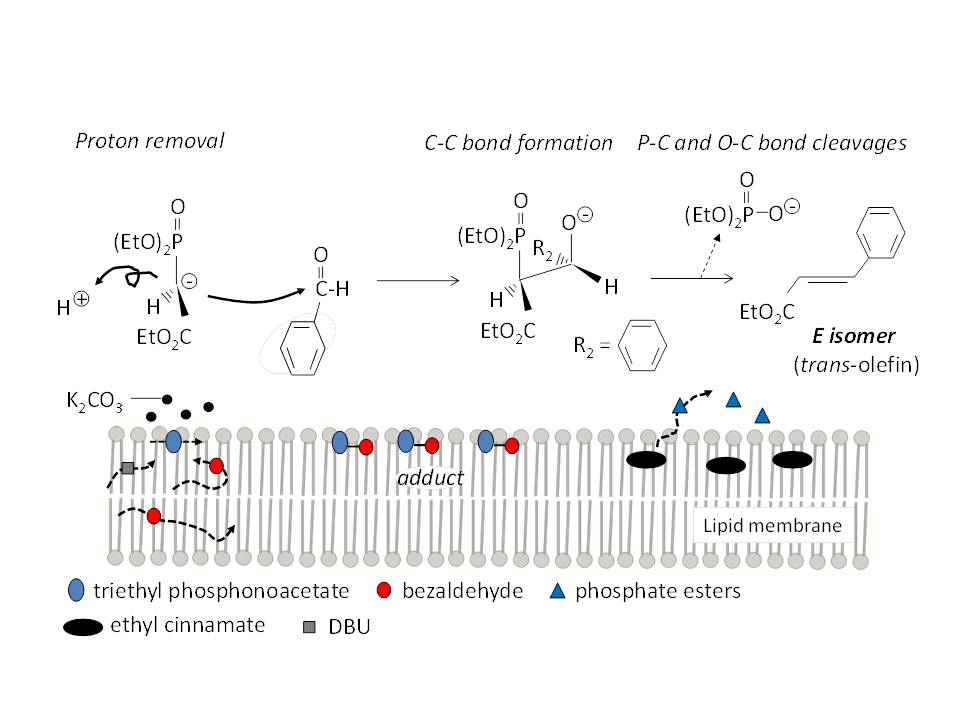
The transparent conductive film is a thin film having conductivity with an average transmittance of 80% or more in the visible light region and a resistivity of 10 -3 Ωcm or less, is used for flat panel displays and the like. At present, indium tin oxide is mainly used as a transparent conductive film, but since the price is so high due to concern about depletion of indium, development of alternative materials is required. Zinc oxide thin films are known as transparent conductive films, are reported to be further lowered in specific resistance by adding aluminum to form aluminum-doped zinc oxide (AZO), and thus are expected as alternative materials. Thermal CVD is a surface coating method in which substances in the gas phase are deposited on the substrate in solid form using chemical reactions on the surface of the substrate, and heat is applied to promote the chemical reaction to raise the temperature of the substrate. And, it is mainly used for oxide film formation. Further, by reducing the pressure in the apparatus, the mean free path of the reaction gas becomes longer, and the film thickness uniformity is improved. Therefore, an AZO thin film was prepared by a low pressure thermal CVD method, the average transmittance in the visible light region and the resistivity were measured, and the relationship with the film forming conditions was studied.
Silicon nano particle is a promising material as an electrode of Li ion rechargeable battery. Productivity of the silicon nano particle is low, so improvement of the productivity is required. We have investigated combination of plasma enhanced Chemical vapor deposition (PE-CVD) and high speed jet as a gas supply method in order to obtain high deposition rate of silicon material. In this study aggregated silicon nano particles were rapidly deposited on cupper substrates using Plasma Enhanced CVD in SiH4/H2 system to improve productivity of silicon nano particles.
In our experiments input power and frequency of the power supply was 50 W and100 MHz respectively, and pressure of an experimental vacuum chamber was 800 Pa. The deposited particles was evaluated by SEM image. Deposited mass was measured by an electronic balance. Crystallinity was analyzed by Raman spectroscopy. Deposition thickness and surface roughness was measured by a laser 3-dimensional measuring instrument.
Figure shows SEM image of deposited silicon particles. Diameter of the silicon particles are several tens of nm. Thickness of silicon materials by 1 min deposition is several tens of micrometer. Raman analysis show the deposited particles are mixture of amorphous and nanocrystalline silicon.
Relation between deposited mass of silicon and both distance of two electrodes and mass flow rate of the source gas was investigated in order to obtain better productivity of the nano particles.
Velocity of the source gas introduced into a vacuum chamber was several hundreds of m/s in our experimental setup. The experimental result shows that the nano particles were generated during convection in the vacuum chamber after and transported to substrate by the jet of source gas.
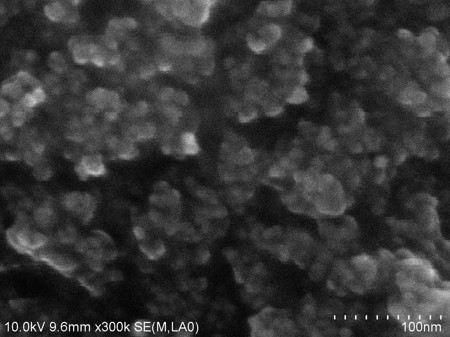
Atmospheric-pressure plasma jets (APPJ) have recently been a topic of great interest. Especially, dielectric barrier discharge (DBD) jets, which can be driven at room temperature come to play an increasing role on process of organic materials which are sensitive to heat and biomedical applications. Cancer treatment, sterilization and dental treatment are example.
For less invasive APPJ optimization, we tried to develop a new type of jet which can process objects at low temperature and high speeds. This APPJ can generate stable, arc-free discharge with only air plasma gas. High voltage electrode was Ti wire and coaxially inserted into nozzle. Material of the nozzle was quartz tube. Inner diameter of the quartz tube was 4mm, and outer diameter was 6mm. Ground electrode was Ta foil with irradiation hole and placed at the tip of the nozzle. Size of the irradiation hole was 1mm. Voltage applied was 4kVp-p, and the frequency was 25kHz. Feed gas was dry air, and the flow rate was 5, 7.5, 10slm. The polymer film based on poly-methyl methacrylate (PMMA) was used to etch, placed downstream from the jet nozzle. Irradiation time was 60s. At each flow rates, etching was performed at a distance such that the temperature of the irradiated object was about 40°C(Jet to object distance was; 7mm at 5slm, 4mm at 7.5slm, 3mm at 10slm). As shown in the figure, the results were 0.05μg/s/W at 5slm, 0.11μg/s/W at 7.5slm and 0.13μg/s/W at 10slm. From this result, temperature may not significantly affect etching. The effects of thickness and hole size of the ground electrode were also evaluated.
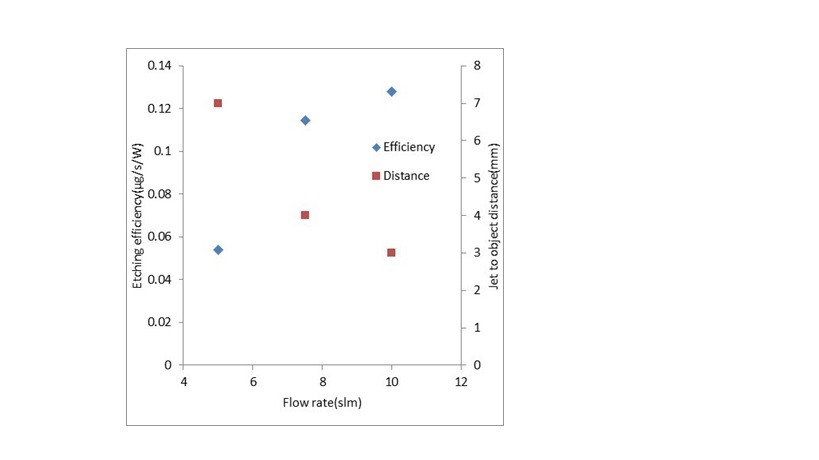
Carbon nanotubes (CNTs) have various excellent properties and potential applications. When synthesizing CNTs, metals such as Fe are normally used as catalyst, which need be removed for many applications. Wet process using acid solution is widely used as removal, which causes difficulty in redispersion of CNTs due to strong agglomeration upon drying. In addition, oxidation is also often combined to the acid etching to remove the carbon shell covering the catalyst particles, which causes damage to CNTs. To solve these problems, dry process has been developed in which halogen gas is flowed through CNT powder at high temperature and remove catalyst metals as metal chlorides. However, halogen gas is highly dangerous and require special facilities, thus challenges remain in industrialization. Here, we propose a highly safe process using FeCl3, which is solid and has negligibly small vapor pressure at normal temperature and pressure. CNT powder by floating catalyst chemical vapor deposition (CVD) and FeCl3 power were set apart in a quartz glass tube, the tube was filled with Ar and heated using a furnace. FeCl3 evaporates and diffuses through the CNT powder, removing Fe catalyst by the reaction of Fe (s) + 2FeCl3 (g) → 3FeCl2 (g). Over 80 % of Fe was removed from CNT by scanning electron microscope-energy dispersive X-ray spectroscopy measurement (Fig. 1). Raman spectra showed the retained intensity ratio of G-band to D-band peaks, showing CNT was not damaged (Fig. 1). From TEM images, CNTs had metal particles covered with carbon shells before purification (Fig. 1) while had empty carbon shells after purification (Fig. 1). Furthermore, this method proved effective for various CNTs, removing Fe catalyst from multi-wall CNTs synthesized by supported catalyst CVD and removing Ni-Y catalyst from single-wall CNTs synthesized by arc discharge method.
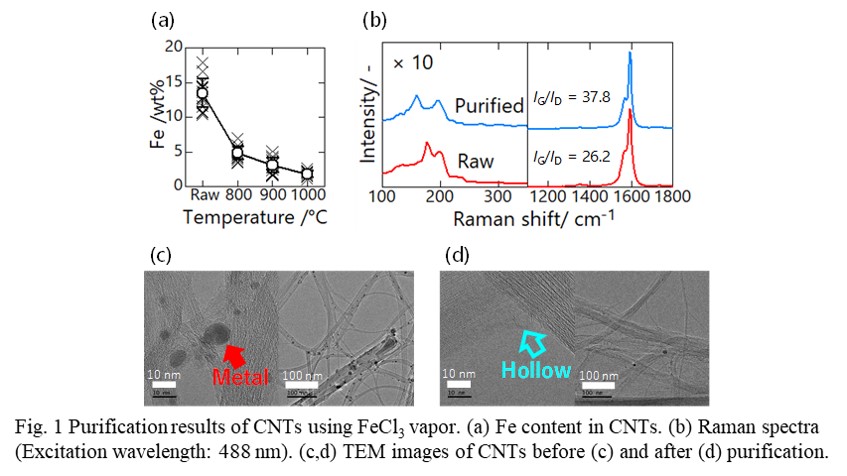
Carbon nanotubes (CNTs) have been extensively researched owing to their unique one-dimensional nanostructure and properties. Mass production has been established for multi-wall CNTs (MWCNTs) instead of single-wall CNTs (SWCNTs). Floating catalyst chemical vapor deposition (FCCVD) yields high-quality SWCNTs [1,2] but the productivity is small because individual SWCNTs are much lighter (~1/10,000 of 150-nm-diameter MWCNTs of the same length). Generally, catalyst precursors are fed to externally heated reactors, and heated in >1 s, and catalyst particles gradually nucleate at low density. We have previously proposed and developed the flame-assisted CVD (FACVD) method [3], in which a premixed flame is used to heat and mix the gas quickly in ~1 ms. The FACVD method yielded 1 nm-diameter, high-quality SWCNTs. However, the flame requires oxygen at high concentration, causing narrow growth window and small productivity (~0.3 mg-CNT/min).
In this work, we report the FCCVD method with a micro-nozzle for preheating catalyst precursors. We used ferrocene and sulfur vapors as catalyst precursors, preheated and mixed them with CH4/H2/Ar, and synthesized SWCNTs at 1200 C. Product is yielded as black smog continuously from the reactor (Fig. 1a). The product was clean ropes of SWCNTs with few particles (SEM, Fig. 1b) with a Raman spectrum characteristic for high-quality SWCNTs (sharp G-band peak, high G-band to D-band peak intensity ratio of 102, and strong RBM peaks, Fig. 1c). The thermogravimetry analysis in air showed the ash content of 6.66 wt%, corresponding to carbon purity of >95 wt%. A productivity of 8.0 mg-CNT/min and carbon yield of 4.2% were achieved using a lab-scale reactor (inner diameter of 40 mm).
[1] A.G. Nasibulin, et al., Chem. Phys. Lett. 402, 227 (2005).
[2] T. Saito, et al., J. Phys. Chem. B 110, 5849 (2006).
[3] S. Okada, et al., Carbon 138, 1 (2018).
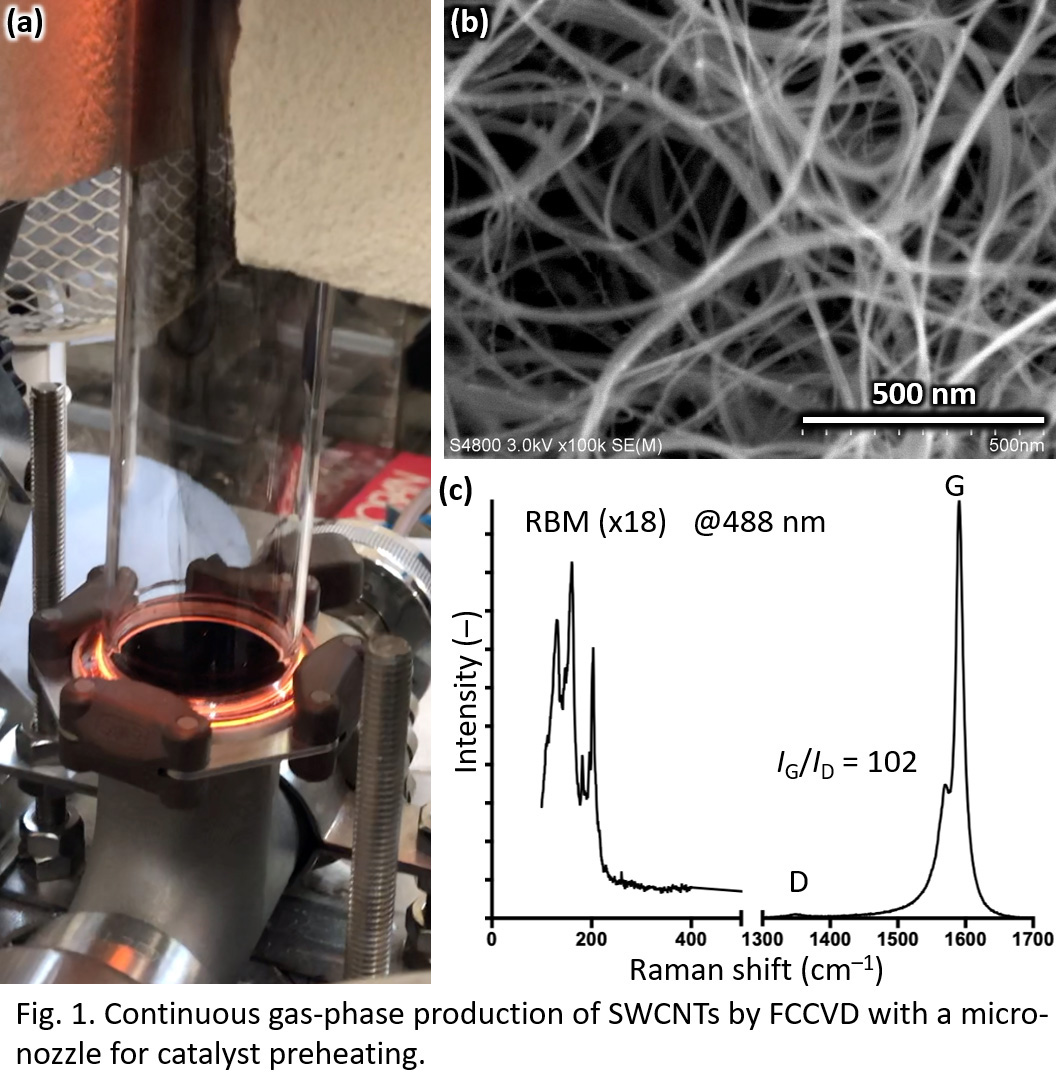
Carbon Nanotubes (CNTs) are attractive with high hopes in many different fields for their excellent properties. However, the practical applications of CNTs has been a challenge due to their high price and/or insufficient quality. Floating catalyst chemical vapor deposition (CVD) enables the synthesis of high quality CNTs, but it has had an issue with its low catalyst usage. To combat this situation, many groups have conducted research to improve the productivity of this process, and as a result it has been reported that the implementation of sulfur can increase the overall yield of floating catalyst CVD [1]. Many groups have proposed positive roles of sulfur; Fe-S to be the active site for catalytic reaction or reduced surface energy of Fe-S for nucleation of small Fe particles. However, these models are not supported by clear evidences and are not applicable to supported catalysts.
Here, we propose an opposite model; sulfur deactivates the Fe catalyst, small amount of sulfur forms an inactive region on a Fe particle, and the inactive region works as an entrance for the carbon source without being covered with graphitic carbon. The analysis of this is difficult for floating catalysts, therefore for this research, supported catalysts were used by implementing graphite sheets as substrates to replicate the floating catalysts of spherical structure. Scanning electron microscope (SEM) shows that Fe on graphite grew no CNT without sulfur but many CNTs with sulfur (Fig. 1a). To confirm the importance of having inactive region within the catalyst particle for CNT synthesis, thin Al2O3 layer were deposited on top of the Fe catalysts. The thin Al2O3 layer significantly enhanced the CNT growth (Fig. 1b) in a similar manner as sulfur. Our new concept enhancing catalyst activity by making inactive region on catalyst particles enables new catalyst design.
[1] H.M. Cheng, et al., Appl. Phys. Lett. 72, 3282 (1998).
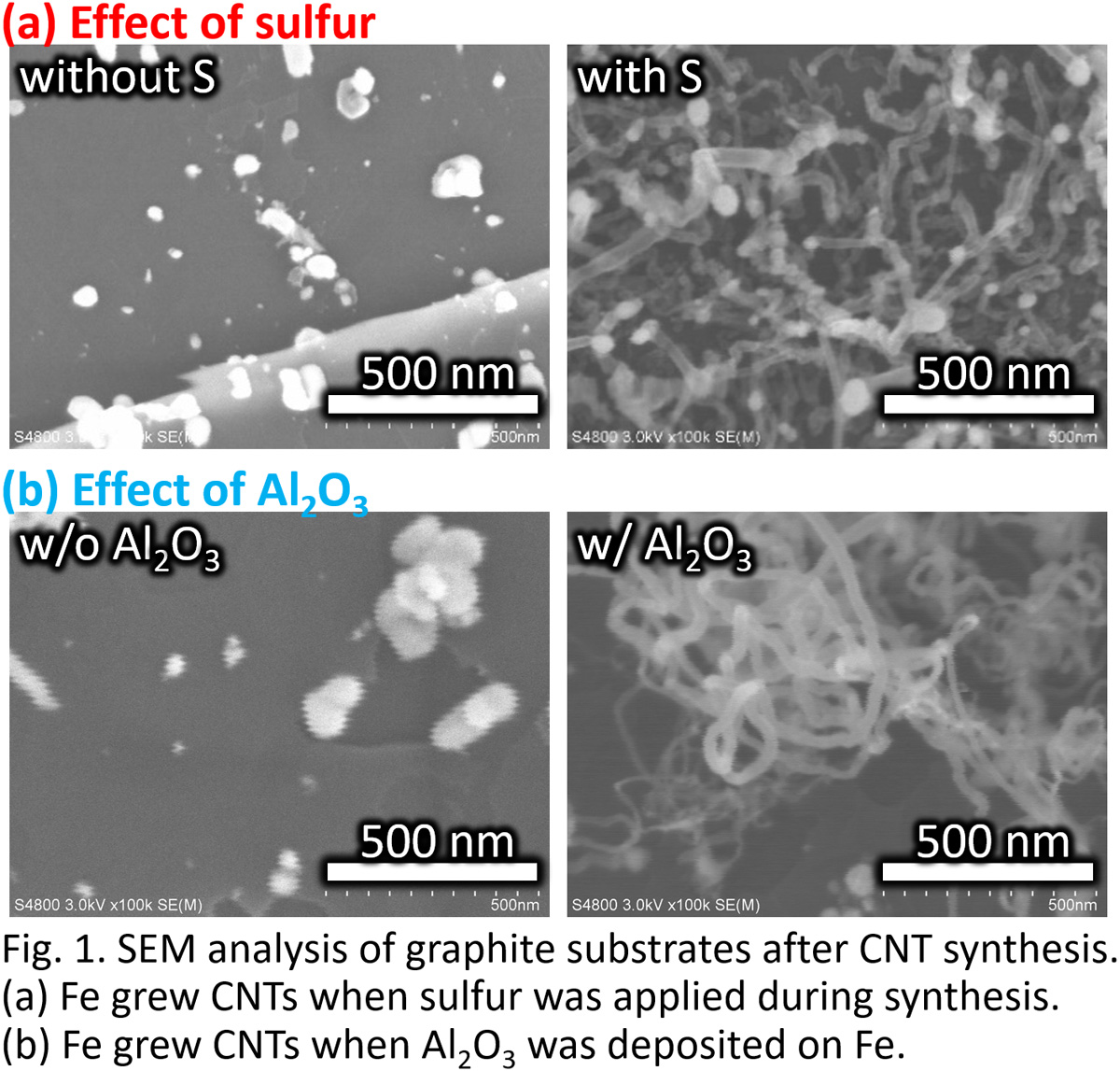
Chemical vapor deposition (CVD) has been widely used for fabrication of functional films. Solving mass transfer of relevant chemical species and their chemical reactions to make deposition during CVD is essential to predict the film thickness profile thereby to design an optimal reactor without resorting to empirical approach. As the figure shows, sometimes the substrates for CVD have microstructures on the surface, but solving the equations in a single geometry that includes both reactor and microstructures is unfeasible due to scales difference. Accordingly, microstructures have been separated from the reactor, where equations were solved individually and iterated until boundary condition of their interface becomes identical. However, it always imposes repeated calculation, which cannot be implemented in the commercial software, thus troublesome. Here, we propose a concise low-cost multiscale simulation method by using COMSOL, a software basing on finite element method. Microstructures and reactor were separated likewise iteration method, while the equations were concurrently solved by coupling the geometries with boundary conditions expressed by equations. The boundary conditions are concentration and flux of each species. The concentration was set to be continuous. The flux was defined as integral of deposition rate in the microstructures because total consumption rate of the precursor in the microstructures equals to the precursor flux across the interface. Hence, automatic low-cost multiscale simulation was enabled. Then, we imparted time-dependent simulation capability to cope with shape change of the microstructures by the deposited film. Growth rate profile in the microstructures obtained above was used to update the shape, which will be used for simulation in next time step, by level set method. By repeating this at each time step, time-dependent multi-scale simulation was enabled. We applied this methodology on W deposition to get profile evolution successfully and the result showed the importance of feedback by microscale topography.
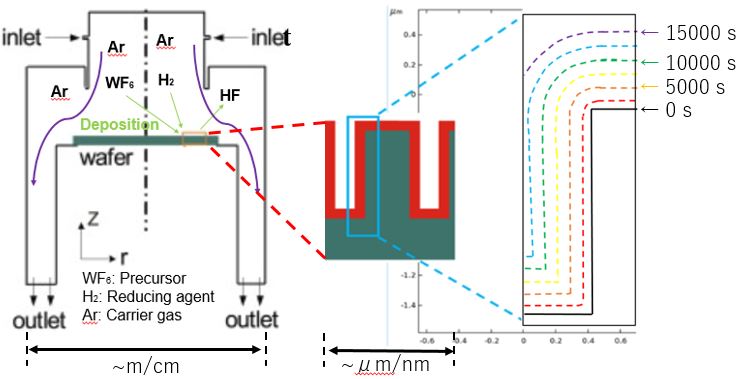
Nowadays, AI and IoT have become widespread, and demand for semiconductors has increased; therefore, reduction of costs and improvement of production efficiency are needed in producing a single crystal silicon ingot which is a key material of semiconductors. A 300 mm diameter single crystal silicon ingot is mainly produced by the Czochralski (CZ) method. To keep high product quality, the crystal radius and the crystal growth rate must be controlled precisely by manipulating the heater input, the crystal pulling rate, and the crucible rise rate. Expecting that model predictive control would be useful to realize precise control, we constructed the gray-box model of an industrial 300 mm CZ process in our past research. To predict the control variables using the gray-box model, it is necessary to calculate the initial values of the melt temperature and the heater temperature, which are not measured in the industrial CZ process. When the initial values were determined by minimizing the error of the controlled variables between the measured values and the calculated values using the gray-box model just before the prediction period, the prediction accuracy at the end of the pulling process was lower than the other period. In the present work, we proposed the method of estimating the initial values by the statistical model, which was built with the data of past batches. Moving window partial least squares was used to develop the statistical model since it can cope with the time-varying characteristics of the CZ process, which originate from changes in the crystal length and the crucible position. The prediction accuracy was validated using the data of two batches, and the results showed that the proposed method could reduce the prediction error on average by 24% in comparison with the conventional method of using only the data of the current batch.
Soft-sensors were commonly used by engineers to predict quality variables that can only be infrequently sampled using sensors readings that are continuously available. Soft-sensor models can be data-driven or model driven. Data-driven models using non-parametric models such as artificial neural network are simple to develop given sufficient data. However, there are usually concerns about the extrapolation ability of the model beyond the data range. Model-based soft-sensor usually requires a physical model and an observer algorithm such as Kalman filter to estimate hidden state variables that cannot be directly measured. However, the effort required to develop a physical model is usually quite cumbersome. The recent development of deep learning opens up the possibility of development of more complex data-driven models that may be able to capture the actual system dynamics. For example, recurrent neural networks can be cast into a sequence to sequence (Seq2Seq) conversation models that can predict subsequent conversions based on past speech. In this work, such a Seq2Seq model formulated into an observer-predictor model that allows identification of hidden states of the system based on past actions and outcomes, and predict future outcomes based on current and future actions. The model is applied to quality predictions during mode-transition for the Tennessee Eastman Process. We found that after learning a few mode-transition data, the model could predict mode-changes that have not been encountered. An industrial distillation column separating c4/c5 product was also studied. Results show that not only the model could successfully predict quality variables in the product stream, but also has much better gain consistency than a simple back-propagation network.
We propose an innovative monitoring method that can estimate the water content of granules by using only process parameters (PPs) obtained through standard instruments, e.g., thermometer and hygrometer. Thus, no investment is required to install specialized equipment such as a near-infrared (NIR) spectrometer, which is a common tool for process analytical technology (PAT). In addition, the proposed method is scale-free; the water content can be estimated with accuracy, regardless of the manufacturing scale, by selecting scale-independent PPs on the basis of variable importance in the projection (VIP) of partial least squares (PLS). The results of experiments have demonstrated the followings: 1) the prediction accuracy of the developed method is equivalent to a NIR spectra-based method commonly used in the pharmaceutical industry, 2) the developed method is robust against changes in manufacturing scale, and 3) the prediction accuracy of locally weighted partial least squares (LW-PLS), which can cope with both collinearity and nonlinearity, is significantly higher than that of PLS. The developed method is a powerful tool for scale-up study in batch processes because it enables scale-free monitoring for the water content of granules during fluid bed granulation at lower cost without additional investment. The developed method is expected to enhance the implementation of real-time monitoring of fluid bed granulation processes as a cost-effective alternative to the existing NIR method.
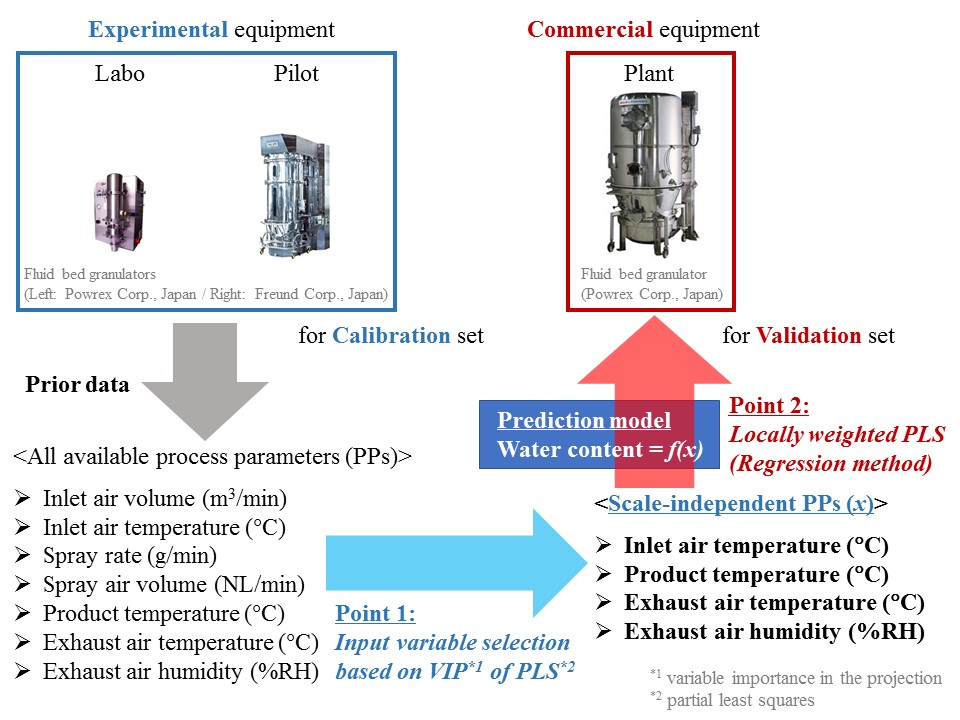
When designing a soft-sensor, we have to determine its parameters such as the number of latent variables of partial least squares (PLS) model. The parameters are usually selected to minimize the cross validation error, however, a soft-sensor model with one set of parameters should not cope with all the operation conditions. In such a case, the estimation error for some samples becomes large. In this research, to reduce the estimation error for those samples, the adaptive soft-sensor design method is proposed. In the proposed method, the leave-one-out cross validation error is calculated using the all the model construction samples. Then the samples with large estimation error are identified, and the model construction samples are divided into three groups. For each group, the parameters are optimized to minimize the leave-one-out cross validation error for the group. In addition, linear discriminant analysis (LDA) is conducted to find the discriminant axis in the input variable space. If the classification performance of LDA is not enough, kernel LDA is used. In online procedure, each of the model validation samples are classified into one of the three groups, and the parameters are adaptively selected. By using the selected parameters, the soft-sensor is developed and the output estimate is calculated. The usefulness of the proposed method was confirmed thorough its application to twelve industrial process data. The root mean square error (RMSE) was improved at most by 11.8%, and at least the same as the RMSE of conventional method using only one set of parameters.
Continuous manufacturing (CM) in the pharmaceutical industry has been paid attention to, because it is expected to reduce the costs of manufacturing. One of technical hurdles in continuous manufacturing is establishment and maintenance of predictive models for process monitoring. Conventionally, calibration models with optic spectra such as infrared or Raman spectra have been used as the predictive models for process monitoring. The calibrated models predict product qualities such as active pharmaceutical ingredient's content, moisture content, particle size, and so on. However, any changes in rots, ratio of ingredients, or operation conditions may affect the relationship between sensor information and the product qualities, which results in deterioration of predictive models. Operators must update calibration models to assure predictive accuracy; however, calibration always requires data acquisition. Thus, the use of calibration models intrinsically increases economical costs. To tackle this problem, the authors have been attempting to propose a calibration-free approach with infrared spectra, which employs an equation in physics. To apply the calibration-free approach to real processes, it is important that a model provides accurate and reliable prediction. In this study, we propose a method to improve predictive accuracy of a calibration-free approach after assessing predictive errors using a rational indicator. We verified that the update method succeeded in non-ideal binary mixtures.
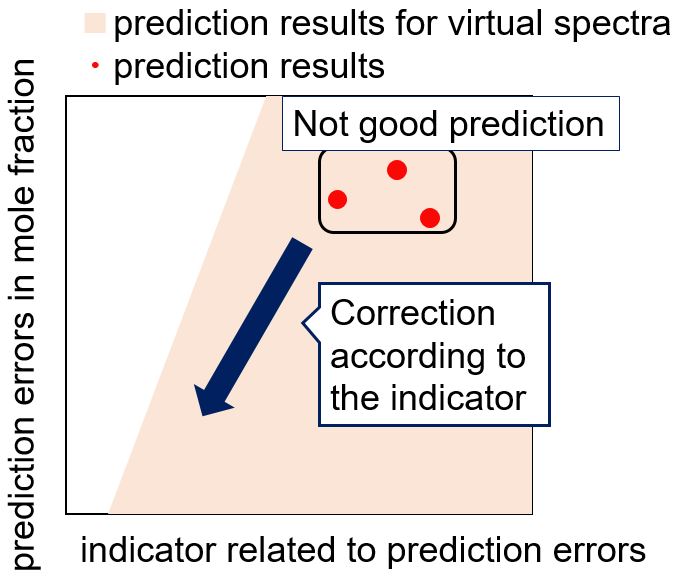
As the most important component of China's process industry, the refining and chemical industry is not only the pillar industry of economic and social development, but also an important cornerstone of the real economy. After decades of development, China's refining industry's production capacity has ranked second in the world, and has made great progress in product quality, cleanliness, supporting technology and process automation. With the rapid improvement of computer software and hardware, the development of machine-learning models and algorithm, the process industry has entered the era of big data. Also, with the impetus of the " Made in China 2025 " national strategy, intelligent refining related construction has been put on the agenda.
Modelling is the core of intelligent refining. The main feature of process industry contains high complexity, high dimensional and nonlinear characteristics, and so on. Centralized modeling will cause problems such as poor model performance. Therefore, system decomposition technology is built on model-based large-scale industrial process control strategies play an important role. EMD (Empirical Mode Decomposition) is an adaptive decomposition method proposed by Huang (1998) et al. for nonlinear processes. It has been effectively applied in different industrial fields and its effectiveness has been verified. CEEMD (Complete ensemble empirical mode decomposition) is an improved method of EMD. By adding two sets of white noise signals with opposite positive and negative, phenomenon of modal aliasing could be solved to some extent, and more multi-scale information in complex industrial processes can be better separate and identify.
CEEMD method is used to decompose the industrial FCC device in this work, and a soft sensor model is established at each sub-scale to capture more sub-scale information to achieve better overall measurement behavior. By comparing the results of decomposition modeling and centralized modeling, it can be found that the decomposition modeling method has advantages in measurement accuracy and better generalization performance.
Optimal control theory is applied to determine Pareto-optimal fronts for multi-objective optimization problems for seeded batch crystallization processes. A transformation of variables first suggested by Hofmann and Raisch (2010) is used to determine nearly-analytical expressions for the optimal supersaturation trajectory at each point on the Pareto front. A simple crystallization kinetic model for potassium nitrate crystallizing from water is used to illustrate the method.
Four sets of objective functions are considered in this work. Result show that if one objective is based on higher moments (e.g. the third moment of nucleated crystals) while the other is based on lower moments (e.g. the number mean crystal szie), the Pareto-optimal front is relatively wider, indicating significant competition between the two objectives. This is consistent with the conclusion of previous work (Tseng and Ward, 2017). In these cases, a constant growth rate trajectory may represent a good trade-off between two objectives. By contrast, if both objectives are based on higher or lower moments, the trade-off between the two objectives is less significant and the optimal trajectories for each single objective are similar.
This work demonstrates the inherent trade-off between objective functions in batch crystallization process and offers guidance for determining the “best” operating recipe when more than one objective is important. This understanding can facilitate the design of batch crystallization recipes.
References
Miller, S. M., Rawlings, J. B. (1994). Model identification and control strategies for batch cooling crystallizers. AIChE Journal, 40, 1312–1327.
Hofmann, S., Raisch, J. (2010). Application of optimal control theory to a batch crystallizer using orbital flatness, 16th Nordic Process Control Workshop, Lund, Sweden, 25–27 August 2010.
Tseng, Y. T., Ward, J. D. (2017). Comparison of objective functions for batch crystallization using a simple process model and Pontryagin's minimum principle. Computers & Chemical Engineering 99, 271-279.
Despite the fact that the modern chemical plants are becoming more complex than they used to be, their operating procedures are still synthesized manually. Since this practice is laborious and error prone, it is desirable to develop a viable approach to automatically conjecture a sequence of executable actions to perform various tasks in realistic processes (Li et al., 2014). In this work, the automata (Cassandras and Lafortune, 2008) are adopted to model all components in the given system. To facilitate efficient procedure synthesis, the entire operation is divided into distinguishable stages and the intrinsic natures of each stage, e.g., stable operation, condition adjustment, material charging and/or discharging, etc., are then identified. The control specifications of every stage are also described with automata to set the target state, to create distinct operation paths, to restrict operation steps to follow the preferred sequences and to avoid unsafe operations. A system model and the corresponding observable event traces (OETs) can then be produced by synchronizing all aforementioned automata. The corresponding operating procedures can be formally summarized with sequential function charts (SFCs) according to these OETs. ASPEN Plus Dynamic has been used to verify the correctness of these SFCs in simulation studies. Since more than one procedure may be generated, these simulation results can also be adopted to rank them based on operability, safety and other economic criteria. Three examples, i.e., a semi-batch reaction process and the startup operations of continuous flash and distillation processes, are reported to demonstrate the effectiveness of the proposed synthesis strategy in practical applications.
References:
Cassandras, C. G., Lafortune, S., Introduction to Discrete Event Systems, 2nd edition, Springer, New York, NY, USA, 2008..
Li, J. H., Chang, C. T., Jiang, D., Systematic generation of cyclic operating procedures based on timed automata. Chem. Eng. Res. Des. 92, 139 – 155, 2014.
Gaussian process regression (GPR) has been gaining popularity due to its nonparametric Bayesian form. However, the traditional GPR model is designed for continuous real-valued outputs with a Gaussian assumption, which does not hold in some engineering application studies. For example, causal analysis of defects in steel products is to discover the relationships between a set of process variables and the number of defects, which is the count data output; the Gaussian assumption is invalid and the GPR model cannot be directly applied. Generalized Gaussian process regression (GGPR) can overcome the drawbacks of the conventional GPR, and it allows the model outputs to be any member of the exponential family of distributions. Thus, GGPR is more flexible than GPR. However, since GGPR is a nonlinear kernel-based method, it is not readily accessible to understand the effect of each input feature on the model output. To tackle this issue, the sensitivity analysis of GGPR (SA-GGPR) is proposed in this work. SA-GGPR aims to identify factors that exert higher influence on the model output by utilizing the information from the partial derivative of the GGPR model output with respect to its inputs. The proposed method was applied to a nonlinear count data system. The application results demonstrated that the proposed method is superior to the PLS-Beta, PLS-VIP, and SA-GPR methods in identification accuracy.
Plant alarm system notifies an operator of plant state deviations. A poor alarm system might cause sequential alarms, which are triggered in succession by a single root cause in chemical plant. The sequential alarms reduce the capacity of operators to cope with plant abnormalities because critical alarms are buried under numerous unimportant alarms. In this paper, we propose an identification method of sequential alarms in time stamped alarm data. The time stamped alarm data, which is composed of the occurrence alarm tags and time, is generally logged in a plant operation data. Repeated alarm occurrence patterns in plant operation data can be regarded as sequential alarms. The proposed method formulates the problem of identifying sequential alarms in plant operation data as the problem of mining repeated similar alarm subsequences. The identified sequential alarms help engineers to decrease the number of unnecessary alarms more effectively. The usefulness of the method is proved by a case study of an azeotropic distillation column.
In biopharmaceutical drug product manufacturing, establishing and maintaining a sterile production environment after a product change-over is essential to guarantee the product quality. Inside an isolator, both machine exterior and interior surface require intensive cleaning/disinfection, achieved through hydrogen peroxide decontamination, and clean-in-place (CIP)/sterilization-in-place (SIP), respectively. Numerous sensors are available to constantly monitor the process and provide real-time measurements of process variables. Generally, the stored sensor data is only used for backtracking actions. In our work, we use this stored data sets for establishing a predictive monitoring system of the process and performing early failure detection. The first step includes data preparation and data classification to failed and successful runs. Followed by the boundary definition of successful runs, i.e., “Golden Zones” and the prediction of the complete process performance following a few minutes of operation. The prediction is achieved through the application of machine learning algorithms, such as Random Forest and k-Nearest Neighbor. The final step compares and assesses the distance of the prediction to the “Golden Zone” boundaries to guide the decision-making process by the operators. We further explore opportunities to improve the machine learning algorithms to achieve the earliest possible failure detection points, i.e. to maximize the “time distance to the alarm”. This could be especially helpful in the case where failures can be detected before the introduction of the hydrogen peroxide to avoid the need to repeat the aeration process which is the most time-consuming step in the procedure.
Our approach was applied to a hydrogen peroxide decontamination process of an industrial filling line resulting in a 50% reduction of the number of erroneous runs to be repeated leading to significant operational time and financial savings.
In process industries, fault detection and diagnosis (FDD) are the first and the most important steps of uncovering abnormal situations and conducting timely corrections. For decades, many FDD methods have been developed and they can be briefly categorized into data-driven and model-based approaches. Recently, combining different kinds of methods to create hybrid approaches that could overcome disadvantages of individual methods has become an attempting research topic. In previous work, we had already achieved better fault detection performance by combining data-driven method with process knowledge. In this work, we expand this idea to create a hybrid fault diagnosis approach, by combining the use of principle component analysis (PCA), qualitative reasoning, and process-knowledge. PCA is utilized as the detection tool in this approach. Meanwhile, qualitative reasoning is used for diagnosis because it has the ability to estimate process behavior with limited and uncertain information, mimicking fault reasoning activity of expert engineers. Process knowledge are important operating information, such as mass or energy balance, non-measured process parameters, and controlled/manipulated variable ratio in a control loop. In this approach, process knowledge is enhanced into both PCA fault detection and diagnostic qualitative reasoning as an effort to achieve better FDD performance.
This approach is tested on Tennessee Eastman Process. Before the test, target process is divided into several units of operation to construct qualitative unit model, and most importantly, to extract operating information using process knowledge. The equations describing these process knowledge are established both quantitatively and qualitatively. The quantitative equations are used for detection propose in the same way as our previous work. The qualitative knowledge equations, as well as qualitative unit models, are represented in consistency matrices for diagnosis propose. As a result of online sample testing, this approach achieved better fault diagnosis effectiveness in comparison with traditional PCA-contribution plot method.
This study investigated the fault diagnosis performance of the entire and early detections for complicated chemical processes using the time-series recurrent neural networks (RNNs). The investigation included various layers and neuron nodes in RNNs using lean and rich training datasets and compared these RNNs with the artificial neural networks (ANNs). Further, the mechanism of classification of the RNNs was revealed in this study. The benchmark of the Tennessee Eastman process was used to demonstrate the performance of the recurrent neural network-based fault diagnosis model. The results showed that the ANNs and the RNNs required only a single hidden layer to reach their maximum accuracy, regardless of whether they use lean or rich training datasets. It was also observed that the ANNs required a higher number of the nodes than the RNNs.
Furthermore, the accuracy of the RNNs using the lean training dataset was equivalent to that of the ANNs using the rich training dataset. The variant RNN can distinguish between the fault types using the rich training dataset. We discovered that the classification mechanism of the ANNs was a priori classification, which was incapable of separating the fault types having similar features. RNNs did not have this limitation, as they were not a priori classification. In summary, the RNNs demonstrated a better performance with regard to the fault diagnosis in chemical processes than the ANNs, and were effective in classifying the fault types with subtle features when there is sufficient data.
In order to mitigate the detrimental outcomes of process anomalies, modern chemical processes are generally equipped with safety interlocks. The conventional approach to design a protective system is usually aimed for prevention of the hazardous outcomes caused by a single abnormal event. However, since there may be more than one independent event producing multiple undesired effects within a realistic process, it is therefore necessary to develop a design methodology for the multi-input multi-output protective systems (see Figure 1). Specifically, the aim of this work is to construct a MINLP model to minimize the expected lifecycle loss of multi-event interlock and to generate the corresponding system configuration. In particular, the resulting specifications should include: (1) the number of online sensors in each alarm channel, (2) the voting-gate logic in each alarm channel, (3) the alarm logic, and (4) the number of shutdown elements for each shutdown operation. A simple example, i.e., the sump of a distillation column connected with a fired reboiler, is used in this paper to illustrate the aforementioned novel approach. From the optimization results, it can be observed that the proposed design strategy is indeed superior to the traditional one.
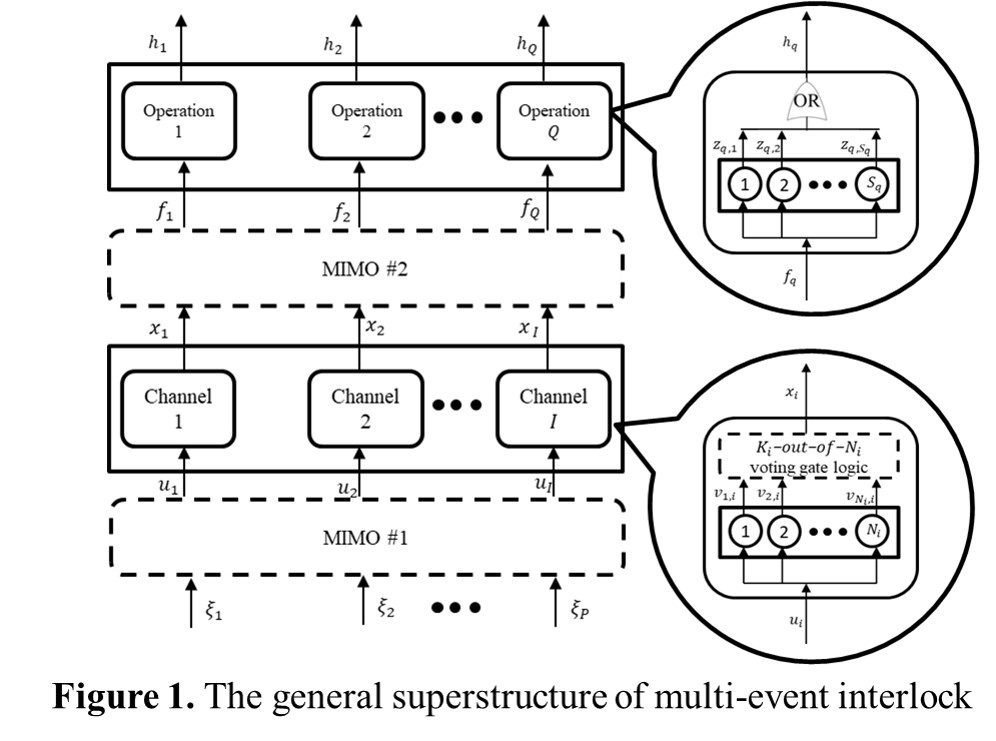
In recent years, cyberattacks against plant control systems can certainly be a growing threat. Conventional plant control system was closed system. However, it has been connected to external networks such as MES, ERP, and maintenance network. This change enables the various way of cyberattacks.
The cyberattacks against plant control system can directly harm physical space and cause accidents and disasters affecting human life.When the plant control system is under the cyberattacks, on-site plant operators should handle the situation suitably. However, plant operators are usually not aware of cybersecurity for plant operations. They don't have enough experiences and knowledges of cyberattacks.
What can they do under the cyberattacks? They must maintain safe operation and prevent the cyberattacks. The simple and effective way to prevent the cyberattacks is to cut off the attack path by disconnecting network cables.
Then it's important to minimize the negative impacts on plant operations such as safety, productivity and so on. For this purpose, if zoning and conduit of the network has been done in advance, operators can make a decision which zone should be cut off under the situation considering the network monitoring and impacts on plant operations.
To make a suitable decision requires enough useful information for plant operators.
In this paper, we developed a support tool for plant operator to make a decision against cyberattacks by combining two important information.
One is the vulnerability information of the components of the plant control system such as OS, middleware and applications of each OPC server, HMI, and so on. It is based on CVSS (Common Vulnerability Scoring System.)
The other is network monitoring information in the plant control network.
The developed GUI shows the options of the points to cutoff the network and supports plant operators to make a suitable decision against the cyberattacks.
In this study, a new methodology was developed to enhance the performance of control system in chemical process. An artificial neural network (ANN) was used to develop a model of the control system. For this, the process model was initially developed using Aspen HYSYS, and operation data was generated based on various operation scenarios. Then, the generated data was implemented to ANN for training, and results were tested and analyzed. Subsequently, the developed ANN model was integrated with an optimization algorithm so that manipulated variables were optimized in real time to maximize the operation efficiency. The developed model predictive control (MPC) system was tested based on various operation scenarios, and the results showed higher performance of the control system against conventional control methods.
Acknowledgment:
This work was supported by a research project entitled “Development of Integrated Interactive Model for Subsea and Topside System to Evaluate the Process Design of Offshore Platform” funded by the Ministry of Trade, Republic of Korea (Project no. N10060099).
Human interventions are common and indispensable during process operations. However, even in this era of big data where large volumes of process measurements are regularly collected and monitored, very little is known about human operators and their cognitive state while operating the plant. This absence of measurements prevents a scientific evaluation of the contribution of operators to the overall system performance. In this paper, we will discuss the need for an informatics-based approach to study the operational behaviors of plant personnel. Next, using the control room operator as an example, we will identify various technologies such as eye tracking and electroencephalography that can offer insights into the operators' cognitive state and their decision-making processes. Finally, we will explore the various ways by which such studies could help enhance the operator's performance – including context-aware interfaces, decision-support systems, and training protocols.
This paper provides a brief introduction to Reinforcement Learning (RL) technology, summarizes recent developments in this area, and discusses their potential implicationsfor the field of process systems engineering. This paper begins with a brief introduction to RL, a machine learning technology that allows an agent to learn, through trial and error, the best way to accomplish a task. We then highlight two new developments in RL that have led to the recent wave of applications and media interest. A comparison of the key features of RL vs. Model Predictive Control (MPC) and other traditional mathematical programming based methods is then presented in order to clarify their relative merits and shortcomings. This is followed by an assessment of areas that RL technology can potentially be used in process systems engineering applications. Particular focus is given on integrating planning and scheduling layers in multi-scale, multi-period, stochastic problems.
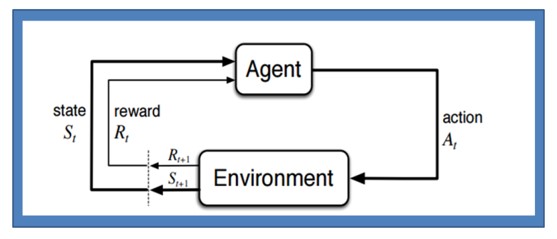
Gas hydrates are ice – like crystalline of natural gas and water. Several methods can be used to prevent hydrate formation such as solvent absorption, adsorption, and membrane process. This work studied modelling and optimization of natural gas dehydration using solvent absorption method. Triethylene glycol (TEG) was used as solvent to remove water from natural gas. Latin Hypercube sampling (LHS) was studied as sampling technique in term of its ability to represent the nonlinear model for optimization problem. The nonlinear model represents the relationship between the operating conditions and amount of produced dry natural gas. In the optimization, the total cost of the process was minimized. Both equipment and operating costs were considered in economic evaluation. The TEG absorption process was simulated using Aspen HYSYS version 8.8. The results show that LHS is able to accurately represent the nonlinear model between operating conditions and the total cost of the process for optimization problem. The optimal operating conditions of the process were obtained.
Model equations used in process design involve parameters, which can be estimated from experimental data. Estimating accuracy of model parameters is critical to ensure robustness of processes. The objective of this study is to quantify estimation accuracy using Bayesian inference techniques in parameter estimation. In this work, the Markov chain Monte Carlo (MCMC) method is used to obtain probability distribution. This algorithm repeats random sampling in parameter space and approximates the profile of posterior probability distributions by the density of sampled points. This method can handle complex nonlinear models. We demonstrate this method for estimating parameters in the Non-random two-liquid (NRTL) model for vapor-liquid equilibrium. The NRTL parameters are estimated by the MCMC method, and the influence of the number of experimental data on estimation accuracy is quantified. We compared two estimation cases, where 8 experimental data points and 13 experimental data points[1] are used, and the difference in the parameter accuracy is quantified. This estimation results for ethanol-water system are shown in Figure 1 for three parameters, a,b12, and b21 that describe intermolecular interactions in the NRTL model for the binary system. In addition, the proposed method is demonstrated for a multicomponent system that involve a larger number of components.
[1]Dortmund Data Bank Software & Separation Technology“VLE - Vapor Liquid Equilibria of Normal Boiling Substances”
http://www.ddbst.com/ddb-vle.html (2019.2.16)
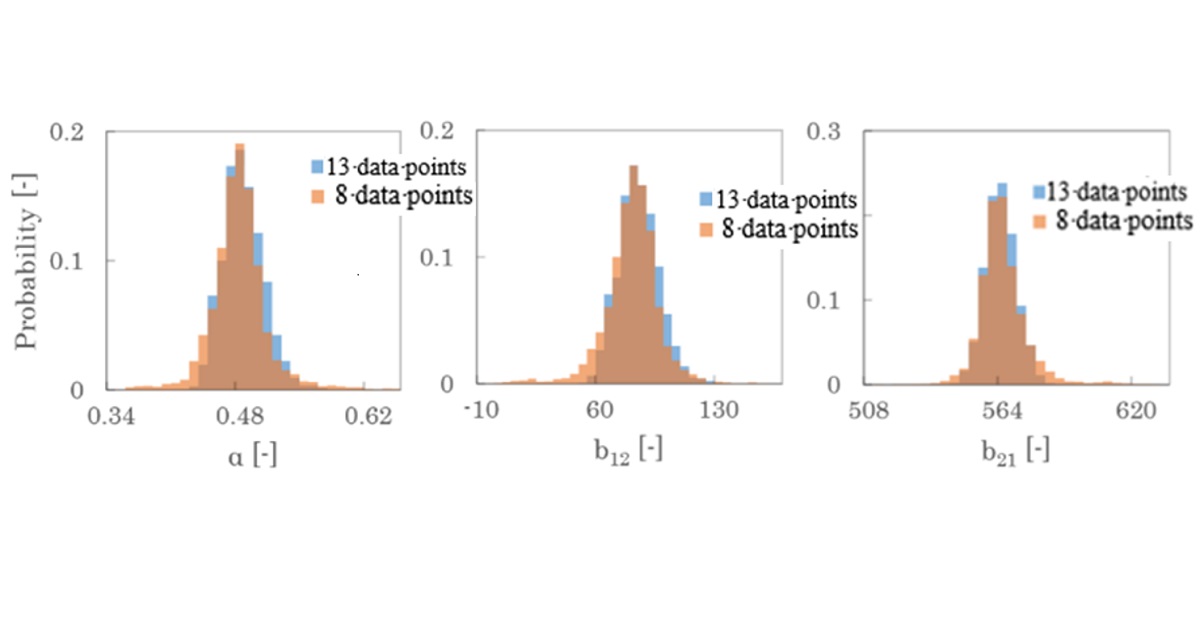
The growth in global economy has made water a limited resource in both quantity and quality. Freshwater resources available for our use are less than 1 % of the total water on the Earth. Reverse osmosis (RO) desalination technology became popular over the last decade due to its potential to produce freshwater from seawater. However, energy consumption in RO plants remain high and emission of concentrated brine from the plant has an impact on the environment.
This study aims to analyse the energy efficiency of various RO based desalination processes. Firstly, single-stage RO with pressure exchanger (PX) is analysed. Minimum normalized specific energy consumption (NSEC) is reduced from 5.00×105 J/m3 to 2.05×105 J/m3 by adding PX with 0.95 efficiency. Secondly, a simulation on multi-stage RO with PX is carried out. It is found that two-stage RO reduces minimum NSEC by 5.4 % compared with single-staged operation and increase recovery by 13.6 %. Even though multi-stage design may require higher capital cost and operating cost, optimised-stage RO design has certain advantages.
In the on-going research, membrane distillation (MD) and pressure-retarded osmosis (PRO) will be combined with multi-stage RO process to improve the overall energy efficiency. MD is a thermally driven membrane process that produces pure water, and PRO is an osmotically driven membrane process with external pressure, which is lower than the osmotic pressure difference, applied on the higher salinity solution side. The use of these processes are limited to when one has low-cost heat source, e.g. waste heat, and inexpensive lower salinity solution, e.g. wastewater. Since MD is less concentration-sensitive, it is expected to further concentrate the brine output, and highly concentrated brine is assumed to support PRO to generate greater energy and reduce minimum NSEC of the total process.
Heat ingress from atmosphere to LNG inside a tank due to temperature difference causes continuous evaporation of LNG that leads to increase of pressure and temperature. Therefore, it is necessary to continuously estimate the change in pressure and temperature inside the tank, using accurate numerical model in real time operation. For this, a new methodology was developed in this work to estimate total amounts of boiled off gas (BOG) and its composition and physical properties more accurately than conventional method, based on various operation conditions.
This work focuses on the efficient design with various heat integration methods and membrane arrangement for reactive distillation (RD) processes in order to enhance the energy saving. It is well-known that thermally-coupled, multi-effect, and external heat-integration approaches can reduce energy consumption in comparison with conventional distillation systems. Therefore, in this work, two processes will be discovered to demonstrate that hybrid configuration via various heat-integration and unit combination (such as pervaporation, PV) can provide further energy reduction compared to the conventional RD configuration. The first process is the diphenyl carbonate (DPC) production process that will be chosen to show a synergetic effect when thermally-coupling and external heat-integration arrangement are combined in the same reactive distillation sequence. The results show that in the DPC production process, the hybrid heat configuration can reduce energy consumption by 47% in comparison with the conventional RD configuration. On the other hand, another process is the ethyl levulinate (LAEE) production process that will be investigated to show a synergetic effect when thermal intensification is implemented in the hybrid RD-PV configuration in the LAEE production process. The hybrid heat-integrated configuration assisted with PV arrangement through excess ethanol (EtOH) design can save around 73% of energy consumption compared to the conventional LAEE RD configuration. Figure 1 shows the flowsheet of hybrid configurations for DPC and LAEE production processes, respectively. Finally, several control schemes of the DPC process would be investigated and tested the control performance based on this highly integrated configuration. Results show that the best control scheme has good disturbance rejection for throughput and feed composition disturbances.

For the chemical reactor systems using phase transfer catalyst (PTC), the third liquid phase that is insoluble in both aqueous solution and organic solvent is separated by regulating concentrations of salt and catalyst. Previously, our research group has demonstrated that application of alternate current (AC) voltage in formation of a layer of the third phase could increase a yield of the product for the phase-separable reactor using polyethylene glycol (PEG) as PTC. The AC application is considered to change the property of the third phase, which influences acceleration of mass transfer of product between two phases. In order to intensify the phase-separable reactor with third phase, it is necessary to optimize flow characteristics in the organic phase and the third phase to maximize the mass flux stably.
In the present study, influence of flow characteristics in the third liquid phase to dynamic behavior of batch-type phase-separable reactor is investigated for synthesis of phenyl benzoate by using PEG. Time variation of conversion of benzoyl chloride and apparent selectivity of benzoyl chloride to phenyl benzoate is analyzed by the rate based model. When experiments were carried out by using different types of impeller, higher value of the apparent selectivity was seen in a case of using the six-blade flat paddle impeller (6FPI). A clear characteristic of vertical circulation flow in the third phase was also observed by the flow visualization experiments, especially when 6FPI and two types of reverse pitched blade impeller were used. Hence, it is made clear experimentally and numerically that the vertical circulation flow in the third phase is an influencing factor to enhance the overall reaction efficiency and that it could be controlled by type of impeller, its rotational speed and concentration of potassium hydroxide for preparation of the third phase.
Pure, isomorphic, round, and free-flowing dimethyl fumarate granules in a size range of 250–2000 μm were successfully produced directly from esterification through the three-in-one intensified process of three distinctive steps of reaction, crystallization, and spherical agglomeration (SA) in a 0.5 L sized jacketed glass stirred tank. Dimethyl fumarate was prepared by sulfuric acid catalyzed esterification of fumaric acid with methanol. The reaction temperature was below the maximum allowable limit of 65 °C as determined by reaction kinetics to avoid the runaway situation. The dissolution rate of primary crystals of dimethyl fumarate was inversely proportional to the particle size which was strongly affected by the antisolvent addition and temperature cooling schemes during crystallization. However, the dissolution rate of the round granules was mainly dependent on the exterior dimension of the granules and not so much on the primary crystal size inside the granules. The mechanical properties such as density, porosity Carr's index, friability, and fracture force of round dimethyl fumarate granules generated in (1) three-in-one processes with the final temperatures at either 5 or 25 °C (Three-in-one I and II) and (2) SA of dimethyl fumarate, which was done separately and disconnected from the train of reaction and crystallization process at either 5 or 25 °C (SA I and II), were thoroughly studied and compared. The concept of scale-up for Three-in-one I and II was also verified in a 10 L sized jacketed glass stirred tank. Powder manufacturability such as flowability, blend uniformity, and compressibility had been substantially enhanced by spherical agglomeration. The added values of free-flowing and easy-to-pack properties to dimethyl fumarate in addition to its original intrinsic slip planes in the crystal lattice would make direct compaction into tablets feasible.
The Natuna gas field, located in the Natuna Sea, was discovered in 1973, is one of the largest natural gas reserves in Indonesia with estimated natural gas reserves of 222 TCF. However, until now, the use of Natuna gas is still hampered because of the very high CO2 content reaching 71%, while the methane content is around 28%. The dry reforming of methane (DRM) process is one of the potential ways to be applied in solving these problems to convert CH4 and CO2 become a synthesis gas containing CO and H2 as a raw material that can be applied to manufacture as intermediate products or end products in the petrochemical industry such as acetic acid.
The conversion of carbon dioxide and methane to acetic acid is carried out in three stages. In the first step, carbon dioxide and methane are reformed to produce the synthesis gas at temperature of 800 °C and pressure of 1 bar. In the second step, the synthesis gas is converted to produce methanol at temperature of 150 °C and high pressure of 50 bar. In the third step, the acetic acid is produced by reacting methanol and CO in the methanol carbonylation process. The modeling and simulation of the acetic acid production were conducted by using Aspen Hysys v.10, considering mass and heat balances. The cubic equation of state was applied for reforming and methanol processes. In order to produce 71 MTPD of the acetic acid, the feed flow rates of CH4 and CO2 are 190 MTPD and 520 MTPD, respectively. The total energy required is 46.3 MMBtu per ton of acetic acid. The acetic acid has a purity of 99.4% with a concentration of 500 ppm methanol, and moisture content of 5,700 ppm.
Keywords: Dry reforming of methane, Modelling, Simulation, Acetic Acid
The solid particles or liquid droplets entrained by multi-phase flow in process plants can cause erosion, which may result in leakage of piping system or equipment. Hence, it is essential to evaluate erosion rate for determining design margin and taking counter-measures. To date, many models have been proposed for prediction of erosion induced by particles and droplets, but there is large difference in their prediction accuracy. The present study aims to validate CFD-based prediction accuracy of major erosion models using the published experimental data, for engineering applications.
Among many erosion models proposed to predict particle-induced erosion rate, the models of Finnie, Tabakoff & Grant, E/CRC, Oka and DNV are usually applied for evaluating erosion. Experimental data in literature were used to investigate CFD prediction accuracy of the five erosion models. CFD simulations were conducted for different flow velocities and piping geometries containing elbows and reducer. CFD results show that Finnie model under-estimates the erosion rates significantly, and other four models over-predict the erosion rates for all the cases. Among them, the erosion rates predicted by Tabakoff & Grant model are closest to the experimental results with moderate and acceptable conservativeness. Therefore, Tabakoff & Grant model is applicable to predict particle-induced erosion rate in engineering applications.
Also, CFD simulations were performed to validate CFD prediction of liquid droplet induced erosion rate, using the data of water impingement experiments conducted by Isomoto et al.. The investigated erosion models include the models of Haugen, Isomoto and DNV. CFD results show that all the three models over-predict the erosion rates. Among them, the erosion rates predicted by Haugen model for all the water impingement velocities are closest to the experimental results with moderate and acceptable conservativeness. Hence, Haugen model is applicable to predict droplet-induced erosion rate in engineering applications.
Mathematical model is powerful conceptual framework to elucidate underlying biological mechanisms and guide further experiments. Researchers usually use equation – based model which is deterministic and assumes a homogeneous population, therefore, is not appropriate for systems characterized by a high degree of localization, distribution and dominated by discrete decisions. In this study, we developed a cell – based model that is more suitable for understanding the heterogeneity of stem cell population which is a challenge in bioprocessing for application in regenerative medicine.
Previously, different positions of region with cells deviated from the undifferentiated state of hiPSCs in cultures with SNL and MEF feeder cells were observed (Kim et al., 2014). In culture with SNL feeder cells, the deviation from the undifferentiated state occurred at the central region of the colony. In contrast, in culture with MEF feeder cells, the deviation from the undifferentiated state occurred at the peripheral region of the colony. Later, it was suggested that anomalous low and high migration rate at the central and peripheral region, respectively, led to deviation from the undifferentiated state in hiPSC colonies (Shuzui et al., 2019). Based on this hypothesis, we have developed a model in order to understand more deeply about these phenomena.
Our model described several cell behaviors including cell division, contact inhibition, cell migration, cell – cell interaction, cell – substrate interaction, and cell deviation. Using the model to understand the spatial heterogeneity of cell movement rate in colony, we explored that cell division was main factor that led to higher movement rate at the peripheral region than that at the central region of colony. The simulation results indicated that the model was able to reproduce the deviation from the undifferentiated state similar to the in vitro observation. The result also partially confirmed the in vitro hypothesis that stated anomalous cell migration triggered the deviation from the undifferentiated state.
The trade of LNG is usually regulated by contracts between suppliers and buyers which are generally 20-25 years long and provide security to buyers; however, their rigid take-or-pay clause transfers risk of surplus volume to the buyer. New suppliers have emerged due to liberalisation in local markets. The concomitant emergence of new small-scale customers has led to a competitive LNG market characterized by high demand variability. Consequently, there is an increased need felt by regasification terminals to purchase LNG through spot (i.e., short term) contracts. In this study, we seek to quantify the relative benefits of shifting from long term contracts to purchasing LNG on the spot market.
In this paper, we consider procurement of LNG by a buyer with its own demand variability and a set of producers each with its own selling cost. This collective demand may be met through either a long-term contract or through spot market purchase. Our goal is to identify critical conditions under which spot purchases are superior to long-term contracts and vice versa. Towards this, we develop MILP models to assess the minimal procurement cost i.e. sum of transportation cost and LNG price , taking into the account the dynamics of producers, shipping, and buyers. The set of producers is modelled with each producer having specific production profile along with storage tank and berth capacities and selling price associated with it. Similarly, a buyer is modelled with its varying demand over the planning horizon. The voyage of the LNG carrier is modelled as being dependent solely based on demand at consumption sites. Minimal procurement costs based on long term and short term contracts are calculated using these models and compared in this study. The results of the paper can be used to develop critical insights about the benefits of different LNG procurement contracts.
The nitrogen expander and single mixed refrigerant (SMR) liquefaction processes are recognized as the most favorable options to produce liquefied natural gas (LNG) at offshore sites. These processes have a simple and compact design that make them capital costs efficient. Nevertheless, huge operating costs, mainly due to the lower energy efficiency is an ongoing issue, so far. This lower energy efficiency is primarily due to the entropy generation that is dependent on the temperature gradients inside the main LNG cryogenic heat exchanger. The temperature gradients inside the cryogenic exchanger are strongly dependent on the refrigerant flow rates and pressures of refrigeration cycles. However, there are highly non-linear interactions between process decision variables and constrained overall energy consumption. Therefore, optimization of the LNG processes is still a challenging task in order to find optimal values of decision variables corresponding to minimize energy consumption. In this context, this study examines algorithm-specific parameter-less optimization methodology naming as “Jaya” to improve the energy efficiency of LNG processes for offshore applications. It was found that using the Jaya algorithm, the energy efficiency of SMR process and nitrogen dual expander liquefaction process can be enhanced up to 14.3% and 11.63%, respectively, as compared to their respective bases cases. This research was supported by the Basic Science Research Program Foundation of Korea (NRF) funded by the Ministry of Education (2018R1A2B6001566) and the Priority Research Centers Program through the National Research Foundation of Korea (NRF) funded by the Ministry of Education (2014R1A6A1031189).
Biopharmaceuticals are therapeutic drugs driven from biological means such as monoclonal antibodies, engineered protein hormones, cytokines and vaccines. As the biopharmaceutical sector has matured, pressure is increasing for design of flexible process configurations that can cope up process variability associated with the manufacturing of biopharmaceuticals. Due to biological nature of the reactants, it is challenging to maintain required purity of final product and other quality control measures. Under the risk of high clinical failure linked to drug development coupled with greater process variability, design of decision support system for multi-product facilities in biopharma remains a challenge. A lot of work has been done towards planning, scheduling and optimization in process system engineering (PSE), and recently increasing efforts are being made to understand process design and optimization in biopharmaceutical industry. Therefore, the purpose of present study is to conduct research and develop novel models to fill the gap between computer aided process design tools and mathematical optimization and scheduling. In the present work an attempt is made to compare process scheduling using mathematical programming versus conventional software tools such as SchedulePro®[1] to explore techno-economic benefits, if any. An example adopted from SchedulePro® library, on a microbial biopharmaceutical process, has been modelled and validated using mathematical programming based approaches [2]. The Gantt chart is given in Fig.1. Another case study from a process for Lethal Toxin Neutralizing Factor (LTNF) production from E.coli, for the treatment of snakebite, has also been considered for validation of the proposed model.
References
[1] SchedulePro® software, Intelligen, Inc., USA: http://intelligen.com/schedulepro_overview.html
[2] M.A. Shaik; A. Dhakre; N. Patil; A.S. Rathore, Capacity optimization and scheduling of a multiproduct manufacturing facility for biotech. therapeutic products, Biotechnol. Prog., vol. 30, no. 5, pp. 1221-1230, 2014.
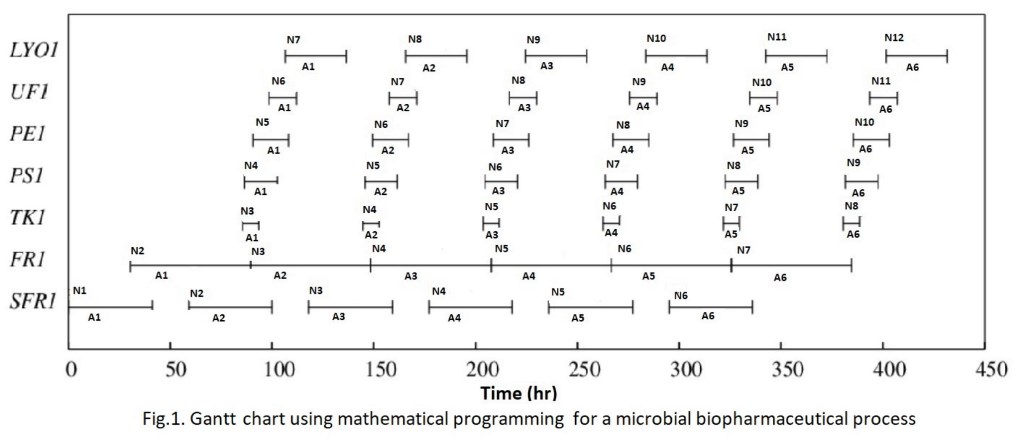
Recently, lignocellulosic biomass have emerged as a renewable energy source due to reduce environmental pollution with carbon-neutral fuel. However the storage problem due to weak water-resistance and which has a disadvantage of low heating value compared to fossil fuels. In order to overcome this problem pretreatment process (crushing, crushing, compression molding, carbonization, torrefaction) are required and in this study torrefaction was selected. Removal of moisture content through the torrefaction process increases energy per unit weight, which has advantages for storage, transportation and finally improves fuel properties. But if the process time was too short, heating value can't be increased, on the other hands, the useful heating value can be decreased caused by long processing time. So proper conditions were needed. In this study, the development of heat value one-dimensional prediction model for optimization of the torrefaction process was performed. A comparative analysis was conducted with the results of torrefaction experiments (200, 230, 270 °C, 20, 30, 40 min). Steuer's heating value estimation equation (r2 = 0.937, RMSE = 11.664) was selected as the most suitable empirical formula. Finally, derive the optimal torrefaction condition, according to the process conditions through case study.
Fluid catalytic cracking (FCC) is one of the most critical thermal conversion processes in refineries, and the modeling of FCC process is a useful tool to investigate, simulate, and optimize this complex industrial process. The selection of key variables in FCC process modeling mainly relies on the design handbooks or operating experience. However, the causal relationship between modeling variables and target variables may vary over time owing to the changing operating conditions, flexible feedstocks and some other issues occurred under uncertainty. It is essential to analyze the key variables that have an impact on the target variable in real time. A filter-wrapper hybrid feature selection strategy is proposed in our work to find out the key variables in an FCC process with respect to certain target variables. In the filter stage, the irrelevant variables are screened out by the ReliefF algorithm from the dataset that contains 445 candidate variables. Next, in the wrapper stage, the genetic algorithm (GA) is used to generate a large number of subsets, and the support vector regression (SVR) is carried out to test the performance of different subsets with the multi-objective considering both the prediction error and the magnitude of the subset. For the demonstration purpose, the process variable like the pressure of reactor and product indices like gasoline yield, diesel yield are chosen as the targets. The results indicate that the hybrid strategy can reduce the magnitude of subset over 92% within 30 mins by which it suggests the potential for implementation in industrial scenarios.
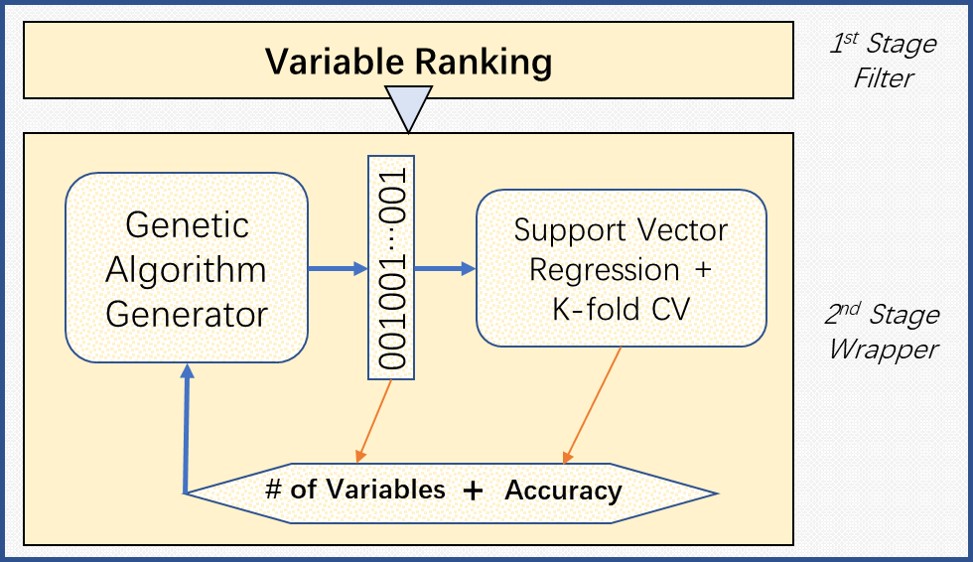
Salts are generally prepared by acid–base reaction in relatively large volumes of organic solvents, followed by crystallization. In this study, the potential for preparing a pharmaceutical salt between haloperidol and maleic acid by a novel solvent-free method using a twin-screw melt extruder was investigated. The pH–solubility relationship between haloperidol and maleic acid in aqueous medium was first determined, which demonstrated that 1:1 salt formation between them was feasible(pHmax 4.8; salt solubility 4.7 mg/mL). Extrusion of a 1:1 mixture of haloperidol and maleic acid at the extruder barrel temperature of 60 °C resulted in the formation of a highly crystalline salt. The effects of operating temperature and screw configuration on salt formation were also investigated, and those two were identified as key processing parameters. Salts were also prepared by solution crystallization from ethyl acetate, liquid-assisted grinding, and heat-assisted grinding and compared with those obtained by melt extrusion by using DSC, PXRD, TGA, and optical microscopy. While similar salts were obtained by all methods, both melt extrusion and solution crystallization yielded highly crystalline materials with identical enthalpies of melting. During the pH-solubility study, a salt hydrate form was also identified, which, upon heating, converted to anhydrate similar to that obtained by other methods. There were previous reports of the formation of cocrystals, but not salts, by melt extrusion. 1H NMR and single-crystal X-ray diffraction confirmed that a salt was indeed formed in the present study. The haloperidol–maleic acid salt obtained was nonhygroscopic in the moisture sorption study and converted to the hydrate form only upon mixing with water. Thus, we are reporting for the first time a relatively simple and solvent-free twin-screw melt extrusion method for the preparation of a pharmaceutical salt that provides material comparable to that obtained by solution crystallization and is amenable to continuous manufacturing and easy scale up.
The United Nation 2030 Agenda for Sustainable Development has dedicated Goal 6 (Clean Water and Sanitation) for better water management, with 8 targets and 11 indicators identified for progress monitoring. Some of the common strategies to achieve better water management include the “4Rs” techniques – reduction of pollution at source, removal of contaminant from wastewater, reuse of wastewater, and recovery of by-products. Within the process system engineering community, some systematic techniques have been developed since the past 3 decades, aiming to design sustainable chemical processes. One of the most promising techniques is arguably process integration, with pinch analysis and mathematical programming tools developed specifically to handle water management issues. However, most developed techniques were meant for water network systems at steady state condition, i.e. without changes in process condition. This paper presents a new design methodology based on a recent developed corner point method, for the synthesis of flexible water networks system. In this case, the flowrate and purity of water sources and sinks may change periodically over time. Hence, the synthesised water network should be able to absorb the changes of sources and requirements of sinks. Literature example is used to illustrate the proposed methodology.
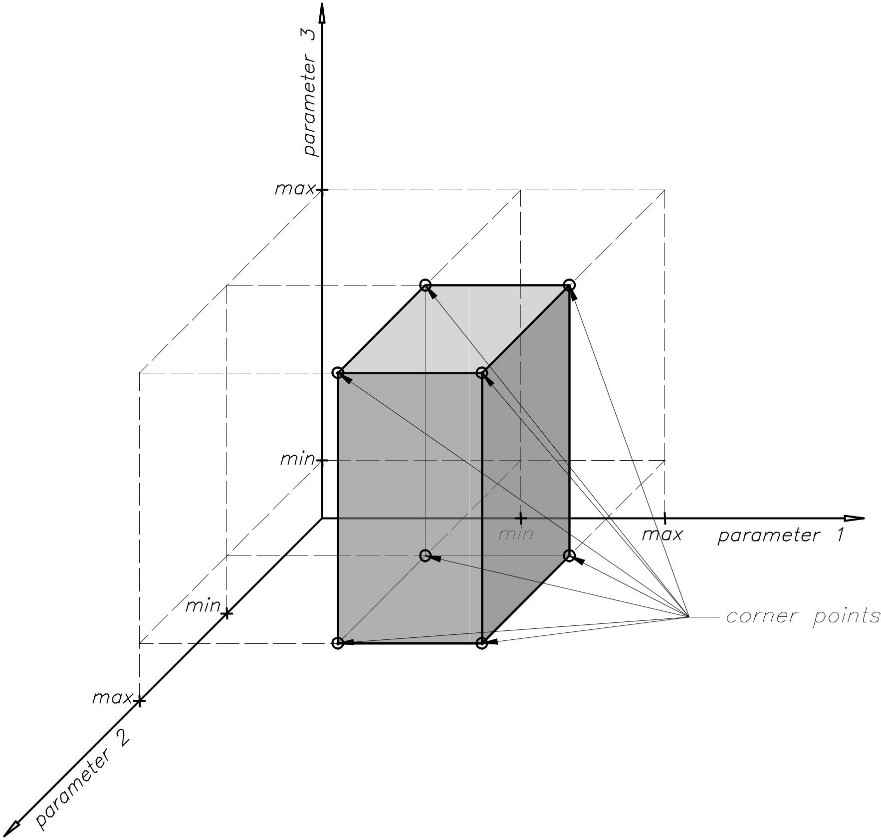
Monoclonal antibodies (mAbs) are an important fraction of the growing biopharmaceutical market. The rapidly expanding demand for mAbs is making it necessary to optimize the production processes to reduce manufacturing costs and time. Generally, production in continuous mode can improve process efficiency. Continuous manufacturing has been previously studied for individual process units in the upstream, e.g., perfusion cultivation, and downstream, e.g., chromatography separation using simulated moving bed. Integrated continuous production modes have been demonstrated experimentally, and stability in end-to-end operation have been presented. This work aims to explore the available design options and map favorable production modes at different production scales and sizes. The work also aims to explore the impacts of recent developments in cell design and advancement of cell tolerance on the process performance and resulting favorable operating modes.
Production data has been obtained from a pilot scale research facility for the production of mAbs from Chinese hamster ovary (CHO) cells. Different models for the large-scale cultivation and chromatography separation have been fitted against the production data, and the appropriate models were selected. After confirming the model performance using the production data, we performed economic process assessment. Different scenarios were considered regarding operation modes, i.e., batch or continuous, and equipment, i.e., single-use or multi-use, for the individual units as well as the end-to-end process.
The simulation results indicated that the favorable scenarios varied in the upstream and downstream depending on the production scale and the CHO cell performance. The superiority of the fully integrated continuous process has been seen regarding productivity. Sensitivity analysis revealed the relevance of the cell performance. This finding will open up a new research opportunity for PSE to tackle simultaneous design of cells, products, and processes.
It is very important to consider all the units and operating parameters of the individual units in the gas-oil-separation-plant (GOSP) optimization. However, the differences in the governing principle of these units make it extremely difficult to optimize the GOSP operation. Also in real operation, optimum parameters for the individual units are difficult to implement and establishing the optimum control condition for the individual unit will be difficult to achieve as all the units are interlinked to each other.
The current practice is to set the parameters determined at the design stage by simple laboratory test without accounting for the changes in temperature (fixed ambient temperature) and pressure on the crude oil properties as reservoir pressure. This results in loss of the quantity of the crude oil at the stock-tank causing a loss in the profitability of the plant.
The objective of this project is to develop a generic integrated framework for maximizing the oil recovery by optimizing the gas-oil-separation-plant (GOSP) parameters. A typical Saudi Aramco GOSP plant consists of multi-stage separators, heater-treater, and stabilization units along with the stock tank to mimic the oil train. Amongst the various parameters, only the controllable parameters such as pressure, and temperature were considered as optimization parameters to achieve the maximum oil recovery.
The GOSP plant model was developed using “Omegaland” software. To evaluate the effect of the various parameters many runs were initiated for generating the data. Based on the generated data a model was developed using artificial intelligence techniques. The model served as a tool for optimizing the controllable parameter to maximize the oil recovery which is the ultimate goal of the GOSP.
The generic integrated framework model serves as a guide to determine the optimum operating condition for maximizing the oil recovery resulting a significant monetary gain by improving GOSPs efficiency.
Carbon Capture and Storage (CCS) is one of the options for mitigating global warming by reducing carbon dioxide emissions, which involves source separation of CO2 from gaseous effluent streams, transportation of CO2 through suitable storage, and storing the same underground or geological reservoirs for a permanent period. Since CCS is a resource intensive process with multiple uncertainties, it must be modeled and validated under several circumstances for practical use. This study focuses on worst-case analysis based on continuous-time formulation for CCS systems under uncertainty. In the model, end time of operating life of CO2 sources, maximum storage capacity for different sinks, and compensatory power carbon footprint are considered as uncertain parameters. Recent work of Shaik and Kumar [1] has been extended to consider these uncertainties in the model. Two case studies are solved to validate the model over different time periods (40 yr and 50 yr). Similar to He et al. [2] the revised model [1] is also solved for different risk levels (α= 0 and α= 1) which demonstrates the modification and simplification of the model [1] compared to He et al. [2]. As shown in Table 1, the same optimal solutions are obtained compared to the literature for the minimum and maximum amounts of total CO2 captured. When compared to the worst-case solutions, the nominal solutions (without uncertainty) pertain to higher risk or perhaps infeasible zones.
References
[1] M. A. Shaik; A. Kumar, Simplified model for source–sink matching in carbon capture and storage systems, Ind. Eng. Chem. Res., vol. 57, no. 9, pp. 3441–3442, 2018.
[2] Y.-J. He; Y. Zhang; Z.-F. Ma; N. V. Sahinidis; R. R. Tan; D. C. Y. Foo, Optimal source–sink matching in carbon capture and storage systems under uncertainty, Ind. Eng. Chem. Res., vol. 53, no. 2, pp. 778–785, 2014.
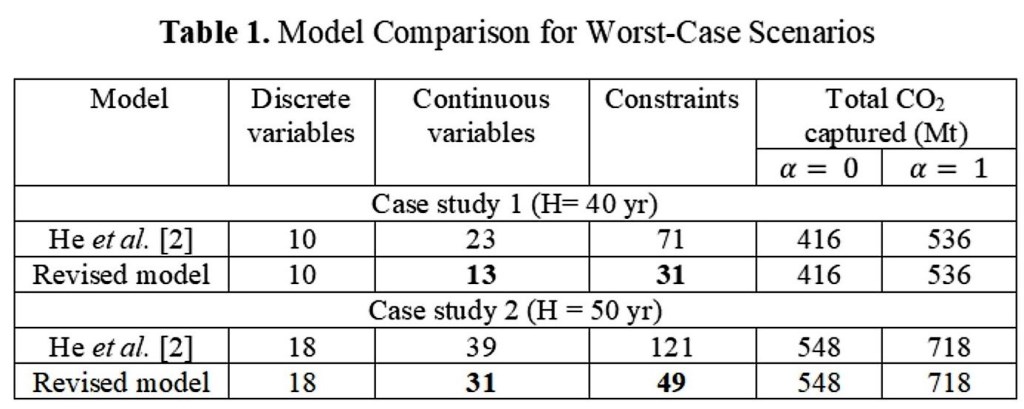
The grand challenges facing human societies are all closely interconnected with the sustainable provision and consumption of energy, water and material resources for constantly growing and developing populations, as well as the subsequent processing and management of wastes and pollutions. In this work, a series of decision-support platforms are developed combining comprehensive database, agent-based simulation and resource technology network optimization, to deal with the challenges of energy, water, food, and waste systems through a nexus manner for a circular economy. As key components of smart city development strategies, the data-driven systematic tools and models can simulate different constraints and targets seamlessly with respect to environmental, economic and social costs and benefits in a bottom-up approach to inform infrastructure planning, investment and decision making for city regions globally.
From macro-level down to detailed systems, smart energy technologies, operational strategies and market design will be specially discussed. To tackle the increasing global energy demand the climate change problem, the integration of distributed resources, renewable energy, and negative emission technologies provides promising solutions for sustainable and resilient energy future. Compared with traditional design and operation of energy systems, the novel process that combines real-time prediction and optimization, model predictive control, demand-responsive scheme and other game-theoretic decentralized market strategies will improve energy systems performance from both the supply and demand side. The state-of-the-art modelling, machine learning, and blockchain technologies will be introduced and applied to the smart energy systems for overall economic and environmental benefits.
Though a global optimization procedure using a randomized algorithm and a commercial process simulator is easier to implement for complex design problems, a dominant problem is a heavy computation load. As the process simulation is repeatedly executed to calculate the objective function, it is inevitable to spend long computation time to derive the optimal solution, especially when the target process has recycle flows that need convergence calculation. Thus, the reduction of the number of iterations is crucial for such an optimization procedure.
Though some design variables such as the number of stages of a distillation column can take only an integer value, in most cases optimization algorithms derive continuous values as the next promising search point. Thus, the process simulation must be executed by rounding off them to integer values. This rounding step affects the selection of the next search point in the optimization procedure. In this work, an estimation procedure of the objective function having integer design variables is proposed. In the proposed procedure, the values of the objective function at the nodes of hyper-triangle that includes the suggested next search point are used to estimate the objective function at the suggested next search point. Figure 1 shows a two-dimensional case. In this example, the objective function at point (NR1, NR2), f(NR1, NR2) is estimated by using the objective function values at three integer points, (N1L, N2L), (N1L, N2U) and (N1U, N2U).
The proposed procedure is applied to the optimal design problem of a distillation process. Simulated annealing is used as the randomized algorithm. The results showed a significant reduction of the number of iterations, and the results were the same or better than those obtained by the traditional optimization implementation. In the presentation, the effect of normalization of design variables is also explained.
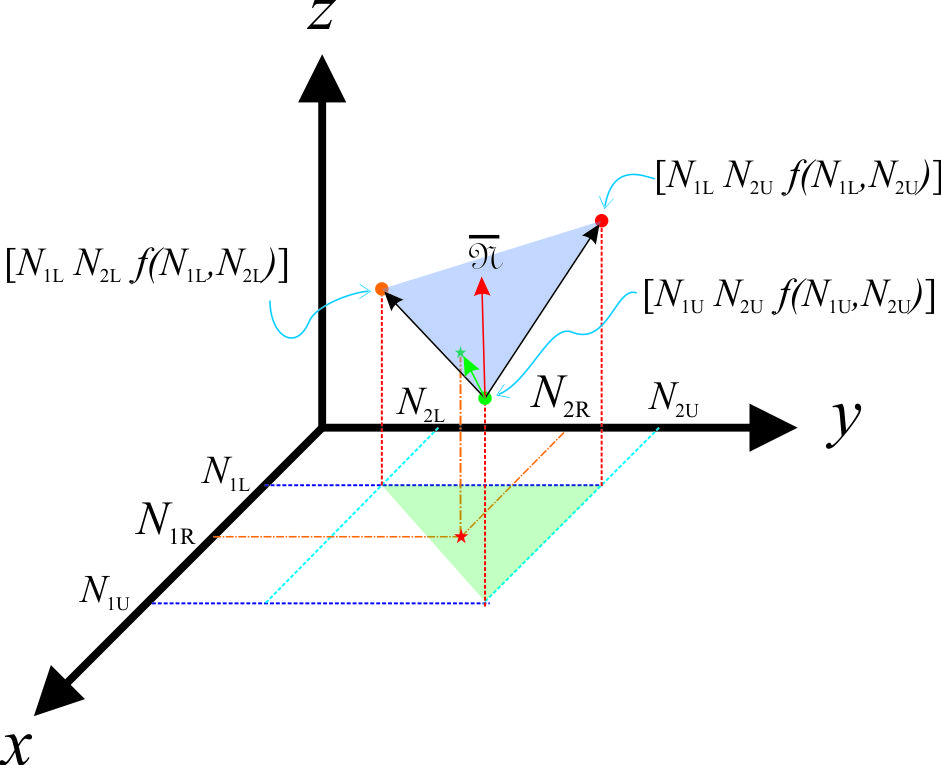
Although the efficiency and energy contribution of renewable energy is rapidly growing, coal is still an important fuel to meet the global energy demand. The integrated gasification combined cycle (IGCC) has high efficiency and minimum cost penalties, compared with conventional coal power plants. Since the operational change of one unit in the integrated IGCC process can influence the other units, techno-economic analysis for performance and cost assessment of the integrated overall process is essential. Furthermore, the techno-economic analysis of IGCC with carbon capture process (CCP) for various types of coal is important because about 53% of global coal reserves are of low rank with various qualities.
In this study, a techno-economic analysis of the entire syngas process including carbon capture unit was conducted for a 500 MW-class IGCC with Shell gasifier using various types of coal. The process simulation of the integrated syngas purification process was performed using Aspen Plus. The performance of Shell gasifier using various coals was simulated using a gPROMS software package.
Firstly, the amount of oxygen and intermediate pressure steam fed to the gasifier were optimized to maximize the cold gas efficiency of Shell gasifier. The parametric analysis of the oxygen to coal feed rate ratio was conducted over the range 0.65~0.85, and the steam to coal feed rate ratio was conducted over the range 0~0.2. Then, the carbon capture efficiency ranged from 80~95% was optimized to minimize the energy consumption of the syngas purification process with a CCP. Finally, to using optimized conditions of gasifier and CCP, a comparative performance evaluation of four difference coals was conducted for the overall IGCC process. And the estimated cost of electricity (COE) considering CO2 T&S cost and coal price was compared among the IGCC processes using four coals (two bituminous coals and two sub-bituminous coals).
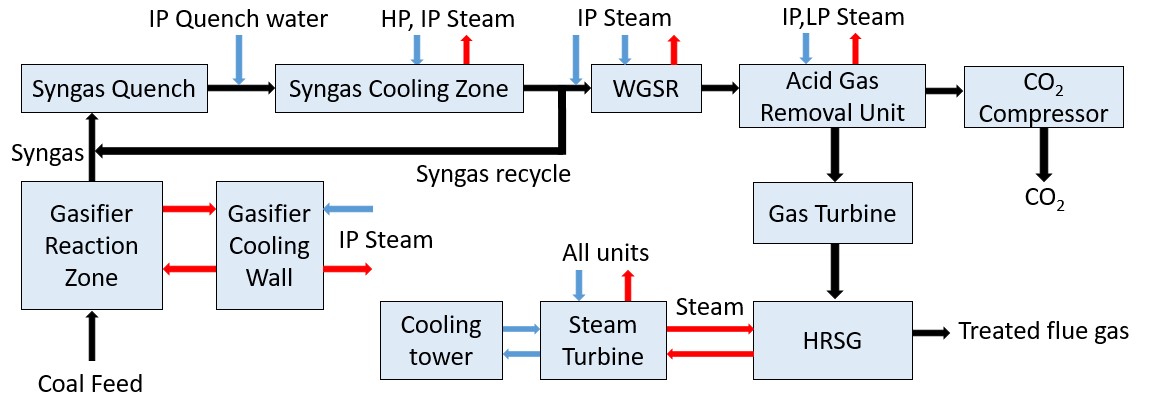
Sterile drug products, represented by injectables of biopharmaceuticals, are manufactured in batch processes by filling drug solution into vials/syringes. Decontamination is responsible for establishing the proper environment for filling, which is typically performed by injecting hydrogen peroxide (H2O2) into the environment such as isolators or clean rooms. Manufacturing of sterile drug products requires changeover processes such as decontamination and cleaning which are time intensive. However, a model can deal with scheduling considering the process design of decontamination is not established.
In this work, we present a model for designing simultaneously decontamination processes and scheduling of filling. The model was developed by incorporating two sub-models: decontamination process model and scheduling model. We defined sterility assurance level of products and the duration required for finishing all batches to be produced as objective functions. Requirements for calculating these two functions are batch information (i.e., the number of batches, batch size, oxidation resistance of product etc.) and decontamination condition (i.e., injection rate of H2O2, relative humidity etc.).
The model was applied to the design case which is 10 batch production of three different sets of products. The calculation result revealed that batch information, especially production size and oxidation resistance of product, is critical to the process duration. At most, 18.1% of the duration can be saved by changing decontamination condition and production schedule. In future, more rigorous simultaneous optimization of decontamination processes and scheduling will be performed. We will also develop a design framework for decontamination processes by incorporating the scheduling model.
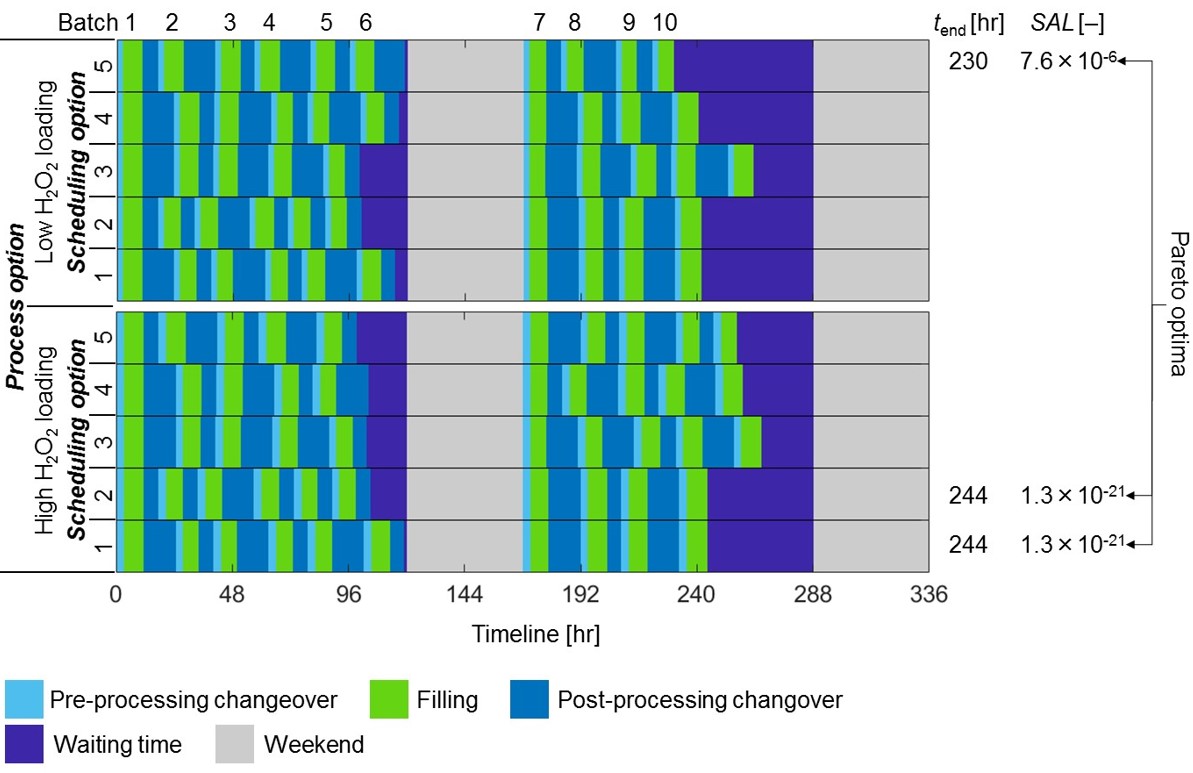
Water integration in batch processes has gained increased attention recently[1-2]. Both freshwater usage and wastewater discharge can be reduced obviously when regeneration reuse is adopted in the design of multi-contaminant water-using networks (WUNs)[3]. It is usually a hard work to design the WUNs involving regeneration reuse, and becomes even worse when batch processes are considered. The paper presents a simple and systematical design approach to manually generate batch water-using networks with multiple contaminants and regeneration reuse. It is assumed that the network runs in cyclic mode and the regeneration unit in continuous mode. The design objectives are to minimize the freshwater usage and wastewater discharge, regeneration flowrate and the costs of storage tanks. The proposed design approach consists of two stages: the batch WUNs are firstly treated as a continuously ones. The concepts of concentration potentials and a modified iterative method are adopted to determine the concentration for regeneration and guide the network design[3] on the first stage. Then, heuristics rules are proposed to guide the design of intermediate storage tanks under the assumption that wastewater can be reused between adjacent batches. The effectiveness of the proposed method is illustrated by two examples from literatures, as good as or even better networks can be obtained.
[1] Li A.; Liu C.; Liu Z. A heuristic design method for batch water-using networks of multiple contaminants with regeneration unit, Chinese J. Chem. Eng. 2019, https://doi.org/10.1016/j.cjche.2018.10.018.
[2] Li, B.H; Liang, Y.-K.; Chang, C.-T. Manual design strategies for multi-contaminant water-using networks in batch processes. Ind. Eng. Chem. Res., 2013, 52(5):1970–1981
[3] Pan C.; Shi J.; Liu Z.Y. An iterative method for design of water-using networks with regeneration recycling. AIChE J. 2012, 58(2):456-465.
Chromolaena odorata L. (C. odorata) with several common names i.e. Siam weed, Bitter bush, Christmas bush, Devil weed, and Camphor grass, is a weed that found in tropical continents. Leaves, roots and flowers of C. odorata have been used as medicinal plants for centuries. Preliminary phytochemical screening showed the chemical composition of C. odorata extracts having phenolic compounds such as flavonoids, saponins, tannins and steroids. The total phenolic compounds (TPC) in medicinal plants are largely acknowledged as biochemical activities such as anti-inflammatory, antiviral, antimicrobial, anti-mutagenic, anti carcinogenic and especially antioxidant agents. This work is interested in antioxidant and antimicrobial activity of an ethanolic extract of C. Odorata leaves. Though, it is found that many solvents can be used to extract TPC from plants. Ethanol with ultrasound assisted extraction was selected. The response surface methodology coupled with the nonlinear solver were used to find the optimal extraction variables. The Central Composite Design (CCD) was employed as the sampling technique. Three studied variables are the ratio of ethanol to the dried leaves of C. odorata (X1), aqueous ethanol concentration (X2), and the extraction time (X3). The extraction conditions were fixed at 40 kHz and 60 °C. It is found that the maximum yield of TPC was 96.49 mg GAE/g dry extract at 57 % v/v of aqueous ethanol concentration, 43 mL of solvent/g of dried sample and 35 minutes extraction time. The relationship between yield and variables is shown below with the prediction error of 13%:
Yield of TPC = 32.9036 – 8.3032 X1 + 6.4377 X2 – 8.7779 X3 + 8.5326 X22
Nowadays, demand of natural dye has increased due to harmful effects of waste from synthetic dyeing to environment and living organisms in water resources. Some synthetic dyes might cause in skin irritation. Natural dye is therefore coming to a better choice for natural fabric dyeing. Teak or Tectona grandis is a tropical hardwood tree. Its weather resistance and beautiful surface made teak as a valuable wood for outdoor furniture and house construction. Moreover, teak leaves are used in food and vegetable wrapping in rural area and some might fall down and waste them as fertilizer for soil. One of the methods to extract natural dyes from teak leaves is ultrasonic assisted extraction (UAE). The yield of natural dye obtained from this method depends on type of solvents and extraction conditions. This research studied optimization of ultrasonic assisted extraction of natural dye from teak leaves. The response surface methodology coupled with the nonlinear solver was employed to find the maximum yield of natural dye. The response surface methodology gives the model represented relationship between extraction parameters and the natural dye yield. Then, the nonlinear solver was used to solve the model for the maximum yield of natural dye. Two different solvents used in extraction, which are water and ethanol, were studied. For each and mixed solvents, the considered parameters in the optimization were frequency of ultrasound (x1), ratio of solvent volume to dried leaves (x2), extraction temperature (x3), and extraction time (x4). The model represented relationship between extraction parameters and the natural dye yield was obtained for each and mixed solvents. The optimal values of extraction parameters were successfully obtained for both solvent conditions.
This research presents a comparative life cycle assessment (LCA) of three photoluminescent types of organic light emitting diodes (OLED): fluorescent, phosphorescent, and thermally activated delayed fluorescent devices (TADF). OLED is garnering attention as a next generation display technology with high luminance, high resolution, and low power consumption. However, general OLED displays employ fluorescent materials with 25% luminous efficacy or phosphorescent materials with 100% theoretical luminous efficacy containing scarce metals such as iridium. Recent developments have discovered new materials exhibiting 100% luminous efficacy without scarce metal, called TADF materials. To analyze the environmental advantage of this new material development, we comparatively assessed lifecycle greenhouse gas emissions (GHG) of three types of OLED employing distinct materials: fluorescent, phosphorescent containing iridium, and TADF. The functional unit of this LCA is provision of one OLED television display. The system boundary considered raw material extraction to the use phase. The lifecycle inventory of fluorescent materials referred to past studies, and that of phosphorescent and TADF were constructed from patents and publications. Energy demand for the material synthesis and OLED fabrication was estimated from lab scale data to manufacturing scale using the authors' a scale up methodology. As a result, the GHG of the TADF and phosphorescent material synthesis were 4-60 times greater than that of the fluorescent material. The major GHG contributor in these materials were the solvent use. Additionally, there was little difference among the lifecycle GHG of OLED displays employing three materials. Because the amount of emissive materials in an OLED display is in the order of 1 mg, the high energy demand of TADF and phosphorescent materials contributed little to the overall GHG of one display. This study sorely analyzed GHG, but further analysis should consider material criticality, which TADF materials shows advantage over other materials.
Absorption column is one of the key equipment for the production of nitric acid, which needs to facilitate both low emission of nitrogen oxides and high concentration of nitric acid product. Based on this, multi-objective optimization of the absorption operation through a framework integrating evolution algorithm and process simulation was conducted, with cooling water usage, reaction pressure, reactant feed & recovery position, mass flow of the middle reflux as key variables. Firstly, Radfrac module of Aspen Plus software was used to model the working process of absorption column, the predicted results of which are in good agreement with the real data collected from a local plant. Then, on the MATLAB platform, the interface program linking NSGA-II algorithm with Aspen Plus simulation was made. Hybrid coding was applied in the evolution algorithm, using real number and integer coding for different types of variables. Finally, simulation process with a population size of 100 and a terminating generation of 30, was performed. The calculation results show that the proposed method can be utilized to obtain a Pareto optimal solution set with uniform distribution. When the concentration of nitric acid is greater than 62.8%, the content of nitrogen oxides increases rapidly with the increase of concentration. Otherwise, the content of nitrogen oxides remains almost unchanged at about 10ppm. Compared with the actual operating condition, the concentration of NOx in the exhaust gas can be reduced by 70ppm while increasing acid concentration by 2%,and the industrial water consumption can be saved by 1200kg/h when adopting optimum settings.
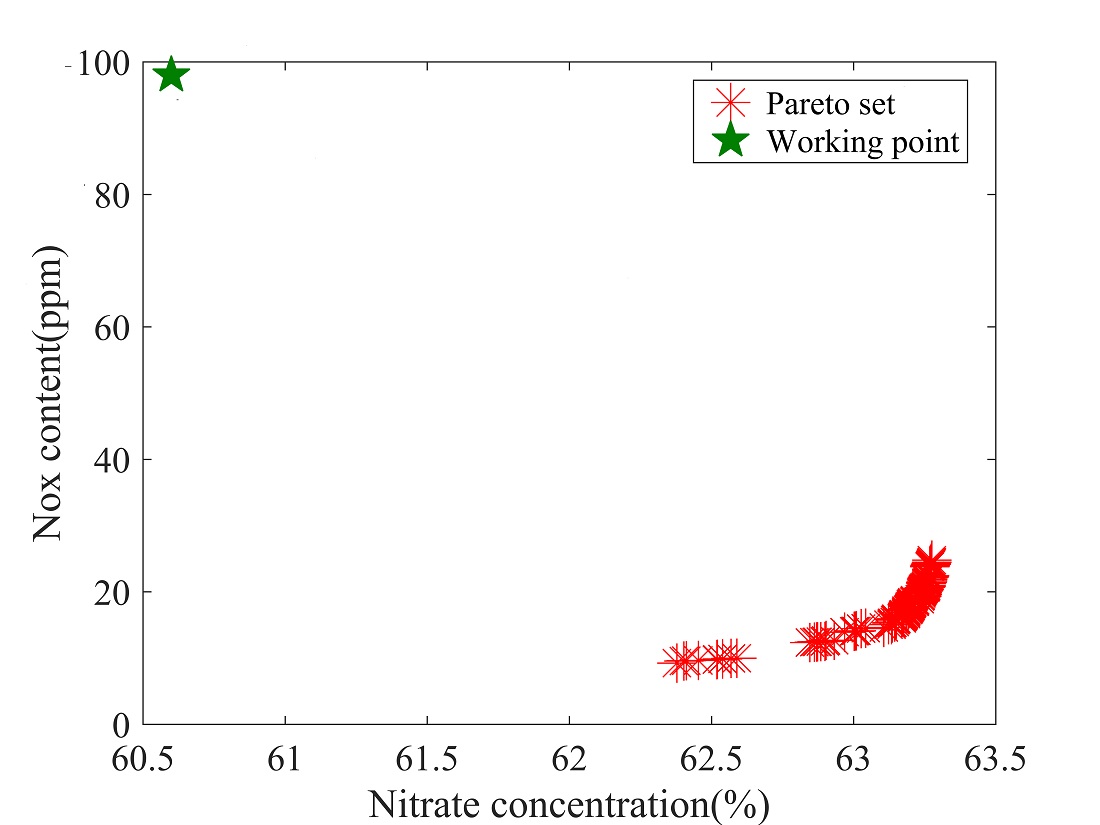
In batch plants, as process equipment are shared by different tasks to produce different products, they use freshwater for equipment cleaning. Also, some tasks require external utilities to meet heating and cooling demands. Now a days, due to stringent environment regulations and increasing cost of effluent treatment and energy, industries are motivated towards water and energy savings. The proposed mathematical formulation deals with wastewater minimization and minimum utility consumption along with the optimum production schedule. For production scheduling, a recent unit specific event based model of Vooradi and Shaik [1] has been adapted and water allocation network (WAN) has been accomplished by considering water reuse opportunities between washing units. Heat exchanger network (HEN) has been modeled by aligning the heat producing and heat consuming tasks in a common time of interval. The model is validated on a case study, from Seid & Majozi [2], comprises of five processing units. The reaction tasks occurring in units U1, U2 and U3 require cooling while tasks in units U4 and U5 require heating. The resulting Gantt chart is shown in Fig. 1 for the optimum production schedule including WAN and HEN. The objective value for total profit is $4809.76, which is comparable to the reported value from the literature.
References
[1] R. Vooradi; M.A. Shaik, Improved three-index unit-specific event-based model for short-term scheduling of batch plants. Comp. Chem. Eng., vol. 43, pp. 148-172, 2012.
[2] E. R. Seid; T. Majozi, Optimization of energy and water use in multipurpose batch plants using an improved mathematical formulation, Chem. Eng. Sci., vol. 111, pp. 335–349, 2014.
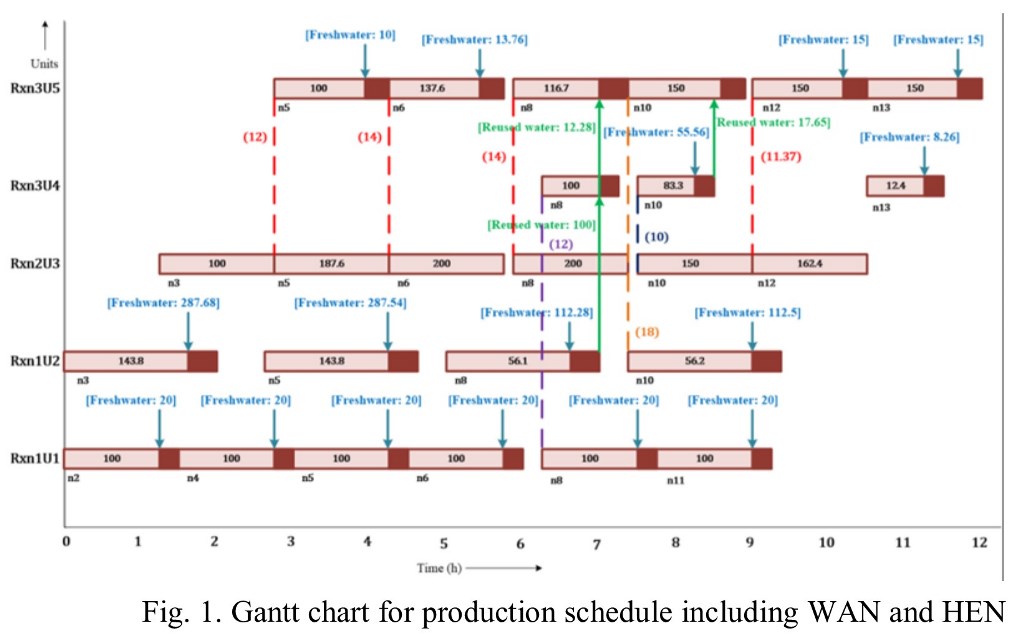
In many developing counties, processing manufacturing (i.e. chemical processing plant, manufacturing facilities, etc) plays an important role in contributing to the country's economic. With the cross-border trading, industrialists are further challenged with global monetary policies, government regulations, resources availability and environmental challenges. The United Nations has initiated the Sustainable Development Goal to encourage the industrialist moving forward to sustainable processing and manufacturing. Despite the Sustainable Development Goal initiatives are encouraging, the industrialists are facing challenges in achieving it. There is a lack of industry expert within the organisation to implement process improvement strategy effectively. The application of lean and green approach has shown positive result in many organisations (e.g. Toyota, Boeing, etc). The lean and green approach is able to reduce the non-value-added product from both operation and environmental perspective. However, the lack of experience personal has delayed the effect of lean and green approach. A systematic framework of lean and green approach should be developed to close the sustainability gap in the processing facility. By doing so, a lean and green index will be used as a benchmarking tool to allow the industrialist to monitor the progressive performance. By including the industry expert and practitioners' input in the framework, analytic network process method will be used together with an adaptive approach. The adaptive approach leverages on the back-propagation method that enables the framework evaluates continuous improvement with time step. The lean and green framework is expected to guide the industrialist for continuous improvement. An industry case study will be used to demonstrate the practicality of the lean and green framework.
Energy transition to renewable-based energy systems with adequate energy carriers such as hydrogen is needed for sustainability. The implementation effects such as greenhouse gas emission reduction largely depend on the specific characteristics in regions. The technologies would not always be implemented in the regions with preferable effects because socioeconomic drivers are needed for the diffusion of the technologies. The driving forces in regions are affected by the region-specific resources, such as financial and human resources in the local governments and firms. In terms of both implementation effects and socioeconomic drivers, the regional suitability for implementing technologies related to energy carriers should be explored for effective policy making and investment decision making. In this study, the regional suitability is explored from two analyses in Japan. Firstly, a region-specific analysis was performed to assess the implementation effects based on the simulation of energy systems. It quantitatively presented the influence of region-specific characteristics, such as energy demands sizes, energy use patterns, and existing structure of energy supply, on the environmental impacts of the technology implementation. Secondly, a factor-specific analysis was carried out by mapping regions based on three factors on implementation, i.e., environmental effects, socioeconomic driving forces, and potential scales. The analysis offers material for discussion on the regions which have preferable implementation effects and can proceed with implementation and on major drivers in the regions. Co-working process inside regions was further generated to explore suitable regions for technology implementation. Through the process, regional suitability, such as actor-network and actors' attitudes toward adopting new technologies and changing the regional systems, which cannot be assessed quantitatively, would be examined and grown. The analysis results can be also used in the co-working process to know prospective regions and actors, motivate actors, and share visions among actors.
Product designers generally prioritize functionality enhancement to meet design demands from the stakeholders in a product life cycle, which affects diverse aspects, e.g., the environment and our society. From an environmental perspective, functionality enhancement tends to cause additional environmental impacts. From a social perspective, the enhancement does not always satisfy the users' satisfaction. Ideally, the designers should be aware of such design consequences of functionality enhancement on the entire life cycle when designing products for sustainability. However, it is difficult for the designers to grasp the design consequences because the consequences are diverse. Therefore, a method is needed to grasp the effects of the functionality enhancement on various aspects in the product design stage.
This study aims to develop an activity model for multi-functional product design for sustainability based on a function-based assessment. To support product design for sustainability, we introduced function-based assessment methods to present the effects of the functionality enhancement on a specific aspect. The methods quantify the changes in the environmental impacts and consumer satisfaction caused by the functionality enhancement based on the linkage of product functions and design variables. To show the roles of our function-based assessment methods in the product design stage, we developed an activity model for supporting multi-functional product design for sustainability.
We performed several case studies, e.g., food packaging, and umbrella, to confirm the applicability of our methods. In the umbrella case, two designs were compared: redesign of the size from small to medium, and that from small to large. Both designs satisfied consumers at the same level, whereas the latter redesign had larger environmental impacts than the former redesign. The result determined the former design to be adopted from environmental and social perspectives. Case studies indicated that the function-based assessment methods could assist the designers in deciding for sustainability.
The modern process industry is required to provide high-grade products with higher yield and low production costs. However, defects are always occurring due to variations during manufacturing process. Thus, it is crucial to predict the occurrence of defects in real time. However, regression methods such as multiple linear regression (MLE) and partial least squares (PLS) are not adequate to describe the defect count data, because they assume that the number of defects (response variable) follows a normal distribution and may yield negative estimates. When the response variable is binary or count data, generalized linear model (GLM) is widely used. GLM assumes that the predictor variables and the response variable have a linear relationship through a link function. Hence, GLM can cope with binary or count data but cannot cope with strong nonlinearity and multicollinearity. Partial least squares generalized linear regression (PLS-GLR) was proposed to overcome multicollinearity, and local likelihood estimation (LLE) was proposed to overcome nonlinearity. However, these GLM-based methods cannot cope with a complex system which has multicollinearity and nonlinearity at the same time. In this research, we developed partial least squares local likelihood estimation (PLS-LLE) to cope with both nonlinearity and multicollinearity by constructing a local PLS-GLR model each time when a predicted value of the response variable is required. The effectiveness of PLS-LLE was validated through a numerical example, in which the predictor variables have a linear relationship, the predictor and response variables have a nonlinear relationship, and the response variable follows a Poisson distribution. Root mean squared error (RMSE) and R-squared (R2) coefficient of determination were used as evaluation indices. Fig. 1 shows the result of repeating this simulation 50 times. It was confirmed that PLS-LLE showed higher prediction accuracy than the existing methods.
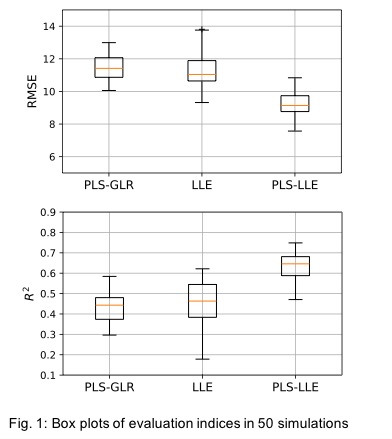
Batch or semi-batch reactors are frequently utilized for industrial-scale chemical production. Online estimation of product qualities is important for controlling the reactors. For example, if we can estimate the concentration of a product with high accuracy, termination of reaction or modification of reaction conditions can be determined accordingly. It is, nevertheless, difficult to sample products online due to extreme such reaction conditions as high temperature and pressure. Even if sampling is possible, analyzing the samples takes some time, making online estimation difficult.
In this study, we propose a scheme for building data-driven or soft-sensor models for solving this issue. Our goal is to time-series predict a product quality (objective variable) from online monitored process variables by a soft-sensor model with high accuracy. The soft sensor model can be built on the process variable data and a product quality data, which is usually measured a few data per batch, i.e. final product quality. Therefore, constructing robust models as well as identification of the Domain of Applicability (AD) is crucial for time-series prediction. Process variable values far from those of final products must be handled property.
Our proposed scheme consists of two methods: in order to make the AD of a soft-sensor model wider, artificial samples with pseudo objective variable values are generated (1). Confidence of each predicted value can be represented by variance of the value using Gaussian Process (GP) (2).
As a case study, we conducted time-series prediction of Melt Flow Rate (MFR) of a semi-batch process plant by using a soft-sensor model. Predictability of the proposed scheme was evaluated by comparing modeling methods, whether or not incorporation of pseudo data. As a result, the error in the high MFR region where the density of data points was scarce was greatly reduced, and predictive ability improved at the same time.
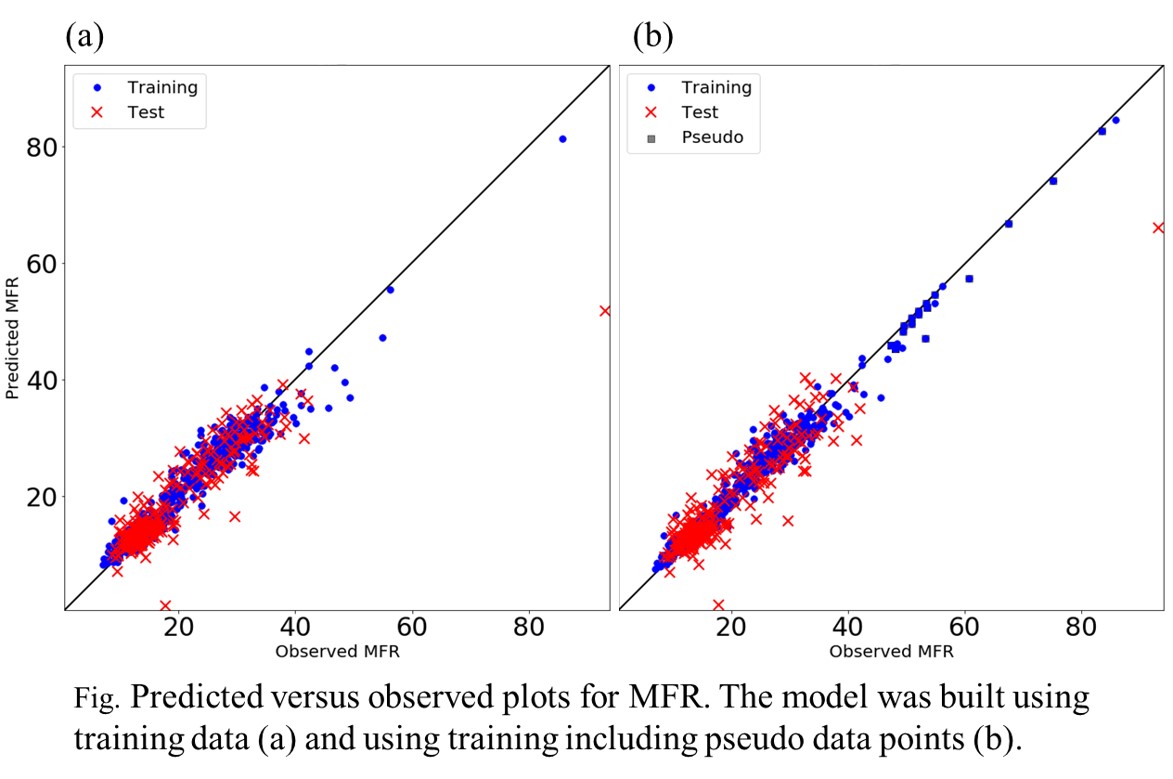
Utilizing hydrogen as an energy carrier is one of important technologies in order to make effective use of renewable energy. The use of hydrogen carriers is expected to transport and store hydrogen in a long-term and stable manner. At Fukushima Renewable Energy Institute, AIST (FREA), research is being conducted to use organic hydride (methylcyclohexane) as a hydrogen energy carrier. Since renewable energy such as solar power generation and wind power generation involves short- and long-term fluctuations, methods to suppress fluctuations of electric power with a battery and hydrogen flow rate by a buffer tank are required. From the viewpoint of cost, however, it is important to reduce the amount of such additional equipment. Therefore, in this study, we examined methylcyclohexane production by a fixed-bed catalytic reactor using hydrogen generated by alkaline water electrolysis with renewable electricity. A control method to supply toluene depending on input electric power to the electrolyzer was developed based on the data obtained under steady state conditions. The method was applied to a hydrogen energy carrier production system operated by using triangular waveforms and renewable energy waveforms. As a result, hydrogen produced from simulated power of PV panels is effectively stored as methylcyclohexane.
Hexamethylene diisocyanate (HDI) is an important raw material in the polyurethane production. Traditionally, the HDI synthesis route involves extremely toxic phosgene as an industrial scale reagent. Recently, thermal decomposition of hexamethylene-1,6-dicarbamate (HDC) has been considered as the most attractive non-phosgene process for the HDI synthesis because HDC can be synthesized by the reaction of 1,6-hexanediamine and the green reagent dimethyl carbonate (DMC). Therefore, synthesis of the intermediate HDC is crucial to the whole process and receives much attention. In this study, three strategies are proposed to design the separation processes in HDC synthesis. Reaction products are fed into a series of distillation columns for separation. These design strategies fall into two categories. Strategies 1 and 2 belong to the first category where DMC and MeOH, which can form a minimum-boiling homogeneous azeotrope, are almost entirely withdrawn from the first column top. Strategy 3 belongs to the second category where some amount of DMC is specially obtained from the first column bottom. Excess reactant ratio of DMC to HDA is adopted between 4 and 8 as suggested from literatures. External heat integration and internal heat integration are utilized to decrease energy consumption. Simulation results show that the processes designed by strategy 3 require the least total annual cost and much economic benefit is achieved through internal and external heat integrations under different excess reactant ratios. The key cost saving from internal heat integration is attributed to the full utilization of DMC-methanol azeotrope characteristic at high pressure, and the higher overhead temperature allowing condenser duty to be released to column bottom.
Palm kernel shell (PKS) is one of the byproducts generated from palm oil mills when fresh fruit bunches are converted into crude palm oil (CPO). Due to the increased production of CPO, PKS increased proportionally. PKS is currently used as fuel source in biomass boilers for heat and power generation. Malaysia, world's second largest producer of palm oil, generates significant amount of PKS annually. For 2018, about 6 million tons of PKS was produced in Malaysia. In view of this, Japanese companies have shown increased interest to utilize PKS as a fuel source to reduce carbon dioxide emissions in nation's power generation industry. As a result, large amounts of PKS have been exported from Malaysia to Japan for power generation. However, with increasing demand on PKS for power generation, it is imperative to evaluate the inherent vulnerability and sustainability of such supply chain. Currently, no documented information available on actual properties of such biomass for international trading and its supply chains between Malaysia and Japan. In addition, it is important to shape supply chains considering alternative technologies and implementation strategies, such as industrial symbiosis. Therefore, the objective of this study is to understand the feasibility and vulnerability of supply chains consisting of export routes for PKS from Malaysia to biomass-derived power plants in Japan. To achieve the objective, life cycle of the supply chain is evaluated based on carbon dioxide emissions. Cradle-to-grave information on palm oil production in Malaysia and exporting mechanism of PKS to Japan are first gathered. Inventory data are obtained from Malaysian palm oil production processes. For supplementary/missing data, ecoinvent and IDEA databases, as well as published articles on palm oil mill production processes are used. Outcomes of this study will contribute heavily towards important decision-making on optimizing the supply chain of PKS between Malaysia and Japan.
Yeast extract (YE) frequently used for bioprocesses, and the compositions were varied in the dependence of the suppliers. The difference of YE compositions often affect on the cell yields in bioprocesses. We focused on evaluation model by a metabolomics approach using non-targeted analysis and statistical calculation. In this study, it was investigated that a statistical models to predict the growth of Escherichia coli from YE component composition as an experimental model of bioprocess. The components of yeast extract were extracted from media containing varying concentrations of yeast extract and analyzed using gas chromatography-mass spectrometer. The yeast extract was categorized into three clades by principal component analysis (PCA). The E. coli growth using yeast extract showed approximately 30% difference at equivalent amount of supplementation. The bacterial growth in the media was estimated for the component profiles by partial least squares regression analysis (PLS-R). A predictive model was developed from the relationship between bacterial growth (as subjective attributes) and component profiles (as objective attributes), and correlation coefficients were calculated. Most of the amino acids in the media stimulated growth; however, methionine had negative effect on growth. In a culture validation, Asp, Val, Glu, and Trp stimulated the bacterial growth, but Met inhibited. The other amino acids tested, Ser, Ile, Asp, Lys, Phe, Leu, Thr, and Gly did not show significant effects on the growth. The results indicate that the metabolomics approach can provide useful feedback information to improve the cultivation.
The purpose of this research is to develop a plant factory with high energy efficiency and capable of adding value. Cultivated plants assumed in this paper are spinach. When grown in a low temperature and high humidity environment, these vegetables have added value such as improved sugar content.
In recent years, plant factories have been developed at home and abroad. However, as a problem of plant factories, much energy is consumed for light source and air conditioning to grow plants. This increases plant production costs as compared to outdoor cultivation and facility cultivation in greenhouses. Therefore, in order to reduce the room temperature rise in the plant factory due to the heat generation of the light source, appropriate temperature control is required.
In this paper, in order to investigate the energy saving reduction method of temperature in a plant factory, a facility combining root zone cooling and hanging cultivation is proposed and thermal analysis is performed. Here, in "hanging cultivation", plants are hung upside down, and water containing nutrients is sprayed to the roots for growth. And, the light for growth is emitted from the under.
Plants have been found to grow normally even at high temperatures by cooling the roots. In this study, in order to make the surroundings of the root cool in the plant factory, we analyzed the temperature change of hanging cultivation with and without the aluminum cooling plate. In addition, analysis of spray cultivation was also conducted.
As a result, the plant factory which brought up the plants by hanging cultivation and installed the cooling plate could lower the root zone more effectively. Therefore, it is assumed that this method can reduce the energy consumption of plant factory compared with other methods.
This work aims to enhance the performance of a reactor by optimizing its design parameters. For this, computational fluid dynamics (CFD) was used to analyze a multi-tubular reactor that involves an exothermic reaction. The design parameters such as baffle configuration, layout and diameter of the tubes, flowrates of feeds and coolants were considered to estimate their impacts on turbulent flow in a shell and its consequent impact on the performance of the reactor. Lastly, these parameters were optimized, and its simulation results showed higher conversion and selectivity for the desired reaction.
Acknowledgment:
This work was supported by a research project entitled “Development of Integrated Interactive Model for Subsea and Topside System to Evaluate the Process Design of Offshore Platform” funded by the Ministry of Trade, Republic of Korea (Project no. N10060099).
Due to the shortage of fossil fuel, bioethanol is a potential green fuel considered to be a sustainable alternative to petro-derived gasoline. The availability of environment-friendly and economical fuels is a worldwide priority. The raw material for bioethanol production are corn, sugar cane, wood, and carbon captured from flue gas. Though the raw materials are different, the product purity of ethanol is at most in the range of 5 to 12 mol percent. The high amount of water in the product leads to higher separation energy cost. There are a lot of methods to break azeotrope between ethanol and water. In the present works, most of the studies compare their results with only traditional industrial processes. Also, most studies do not consider dilute feed conditions. In this study, a comparison between some of the common configurations of extractive distillation, azeotropic distillation and membrane distillation with dilute feed conditions is made using Aspen Plus V10 to obtain optimum results. The results shows that in the 10 mol% ethanol-water feed condition, extractive distillation with pre-concentration distillation column can obtain the lowest total annual cost.
Transportation is a major consumer of fossil fuels and a major cause of air pollution. As an alternative fuel to gasoline to reduce greenhouse gas emissions, the development of bioethanol has received great attention. Bioethanol can be produced from saccharide raw materials, starchy raw materials and cellulosic raw materials. The latter, also known as lignocellulose, are one of the most abundant substances on the planet and are therefore considered an important material to be used to replace petrochemicals for sustainable development. In the process of bioethanol production, lignocellulose needs to be pre-treated by chemical or physical methods to degrade its constituents into monosaccharides for fermentation. The use of zinc chloride-containing ionic solution for lignocellulose hydrolysis has the advantages of high yield, short reaction time, no need for pre-treatment, and is a very promising technology. The ionic solution hydrolysis is then followed by distillation and filtration, and the glucose and salt in the hydrolysate are separated by membrane before the subsequent fermentation. This work aims to reduce the capital and operating costs for hydrolysate separation through the synthesis of an optimal membrane network, while maintaining product specifications and recovery ratios, thereby improving the economic viability of the process. A superstructure-based mathematical programming model for the membrane separation system is developed to facilitate its design and optimization, and to determine the required number of membranes, network structure and operating conditions through appropriate objective functions. A case study will be presented to illustrate the proposed approach.
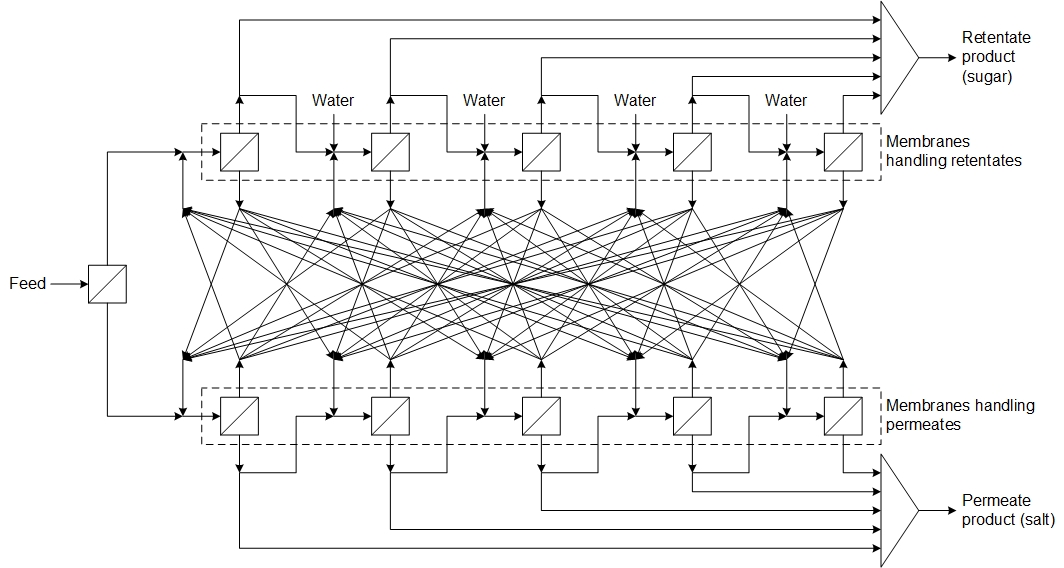
Potable water and energy are gradually insufficient for human needs. To exploit sustainable resources, technologies have been developed to desalinate seawater and produce power using salinity gradient. Reverse osmosis (RO) is one of the major technologies for desalinating seawater, while pressure retarded osmosis (PRO) is a promising technology for power production. The RO desalination plant has the problems of extensive energy consumption and brine discharge, which can be alleviated by hybridizing the RO process with the PRO process as an integrated RO/PRO system. This study is to pursue a higher goal, that is, the power generated by the PRO can provide the energy consumption required for the entire integrated system. Namely, the hybrid system can achieve stand-alone operation (without external energy supply) for seawater desalination. In this study, we conduct feasibility analysis and optimization design for the stand-alone operation of two hybrid membrane osmosis desalination systems (i.e., RO-PRO and PRO-RO systems). Based on the rigorous mathematical model of RO and PRO processes, the feasibility of stand-alone operation is analyzed, and the optimal system design and operating conditions of the hybrid systems are developed through mathematical programming by minimizing the requirement of specific total membrane area. The result shows that the PRO-RO system is a more favorable design structure for a stand-alone hybrid membrane osmosis desalination system. Furthermore, the operation of the membrane osmosis process is bound to be affected by membrane fouling. Based on the membrane fouling model, this study explores the effect of membrane fouling on system energy and water production efficiency, and proposes a dynamic adjustment strategy of operational variables to cope with the fouling effects. The optimal operating strategy is obtained by maximizing the water production while the system maintains stand-alone operation.
Optimum design of the utility system is crucial in offshore platforms that have a restriction in space and weight. The utility system mainly includes production of electrical power and treatment of cooling and heating mediums for the operation facilities in the platform. In this study, the required amounts of electrical power, total heat duty for cooling and heating were analyzed through the operation periods of gas and oil well platforms. In addition, various operation scenarios were included for the analysis. Then, the utility system was designed to meet the requirements of utility consumption. Lastly, numerical model of the utility system was optimized to minimize overall capital and operating costs, having a higher energy efficiency of the platform.
Acknowledgment:
This work was supported by a research project entitled “Development of Integrated Interactive Model for Subsea and Topside System to Evaluate the Process Design of Offshore Platform” funded by the Ministry of Trade, Republic of Korea (Project no. N10060099).
In this study, the isopropyl-acetate (IPAc) production via reactive distillation (RD) process is taken to observe the control performance with the assistant of virtual model. The artificial neural network (ANN) was trained to be the virtual model, and the Aspen Plus Dynamics was considered as the real plant. The inputs of the ANN model contain the feed flowrate of isopropyl alcohol (IPA) (FIPA), the setpoints of the temperature controllers (TC12SP, TC3SP ), and the feed composition of IPA and acetate acid (HAc) (XIPA,F, XHAc,F). Then, the corresponding outputs are the IPAc and water mole fraction in the products (XIPAc, XWater).
In reality, the catalyst activity would become smaller with time. However, the virtual model would not have the aging phenomenon if the model is built under the steady-state. At length, the model mismatches between model and process would become greater if the virtual model does not be adjusted. To this end, this study focused on the updating method for the models which are established under the steady condition .In order to maintain the product purity, the model predictive control (MPC) was utilized to control the product concentration.
The method of updating model is designed as once per day and an adaptive filter would be added. Based on the measurements, the weights and biases of the adaptive filter would be modified by least mean square (LMS) algorithm. According to the results, the on-spec products could be generated for 6 months if the model had been updated. Otherwise, the off-spec products would start to be produced after 4 months if the model were not updated.
Reference:
Lee, H. Y., Li, S. Y., Chen, C. L. Evolutional Design and Control of the Equilibrium-Limited Ethyl Acetate Process via Reactive Distillation-Pervaporation Hybrid Configuration. Ind. Eng. Chem. Res. 2016, 55, 8802-8817.
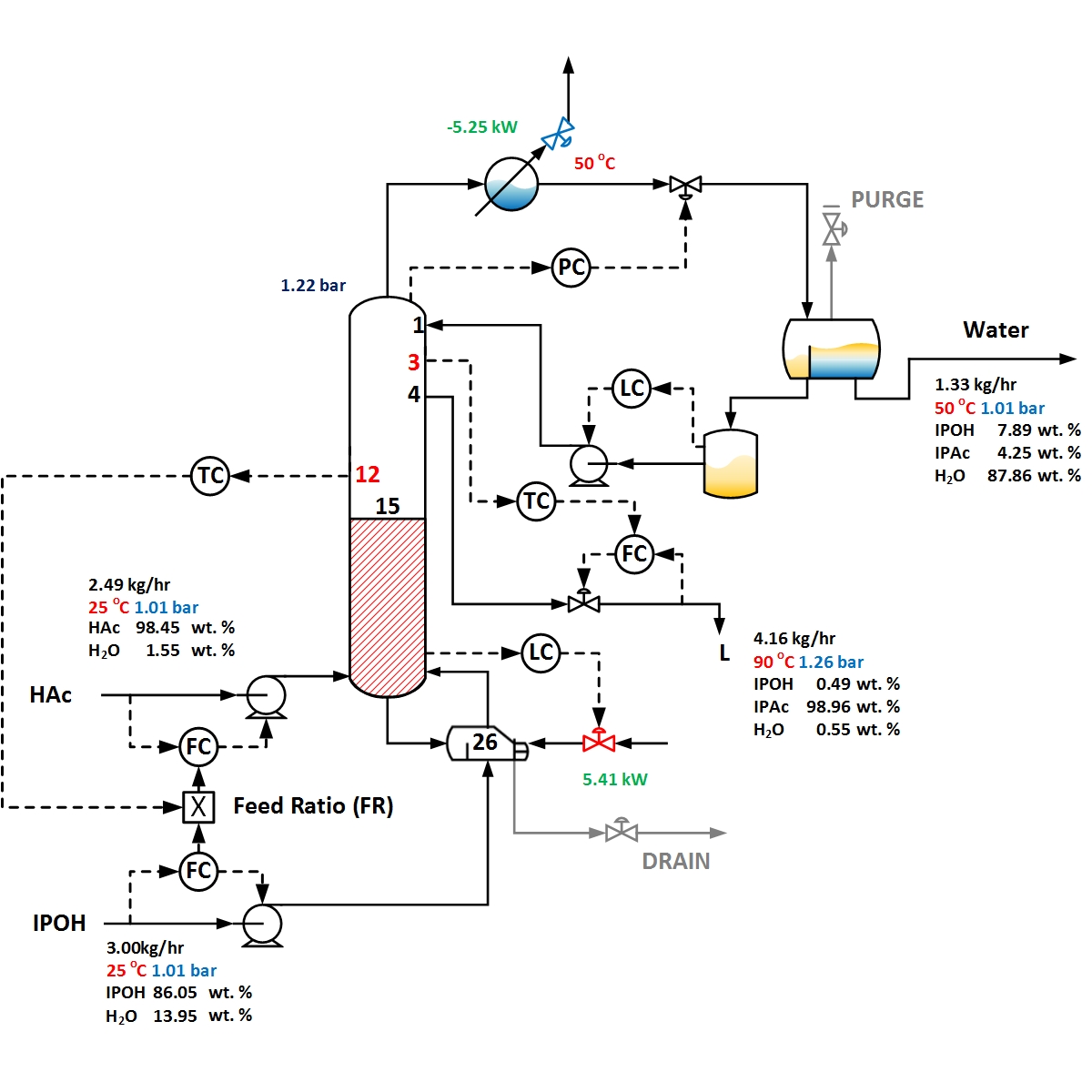
In this study, an internally heat-integrated reactive distillation column (r-HIDiC) is proposed. The silane (SLC) multi-tasking reactive distillation (RD) process is chosen as the case study. The flowsheet of the SLC production process is utilizing two RADFRAC columns from Aspen Plus V10.0 simulator. One column is operated at a high pressure (HP) and another column is in a low pressure (LP). HP column has no reboiler and it is divided into two sections, the rectifying and reactive sections. LP column has no condenser and it has a stripping section. The bottom product from HP column will be sent to the top stage of LP column. The top vapor of LP column will be recycled to the bottom stage of HP column through a compressor. The desired products will be obtained in the top stream of HP column and byproduct will be obtained in the bottom stream of LP column. An iterative optimization procedure is applied to obtain the optimal design that have the minimum total annual cost (TAC). Later on, the multi-tasking reactive non-HIDiC process will be assisted using the optimal results. Then, an internally heat-integration will be implemented in the process (r-HIDiC). The whole reactive section of HP column is a heat source, and the stripping section of LP column acts as a heat sink. Figure 1 shows the flowsheet of SLC multi-tasking single RD (left side) and r-HIDiC (right side) configurations, respectively. The heat required for evaporation in the stripping section is obtained from the reactive section, reducing the heat duty of the reboiler (however work is required for the compressor). From the simulation result, the SLC multi-tasking r-HIDiC configuration can achieve energy saving of up to 15% compared to the SLC multi-tasking single RD configuration.
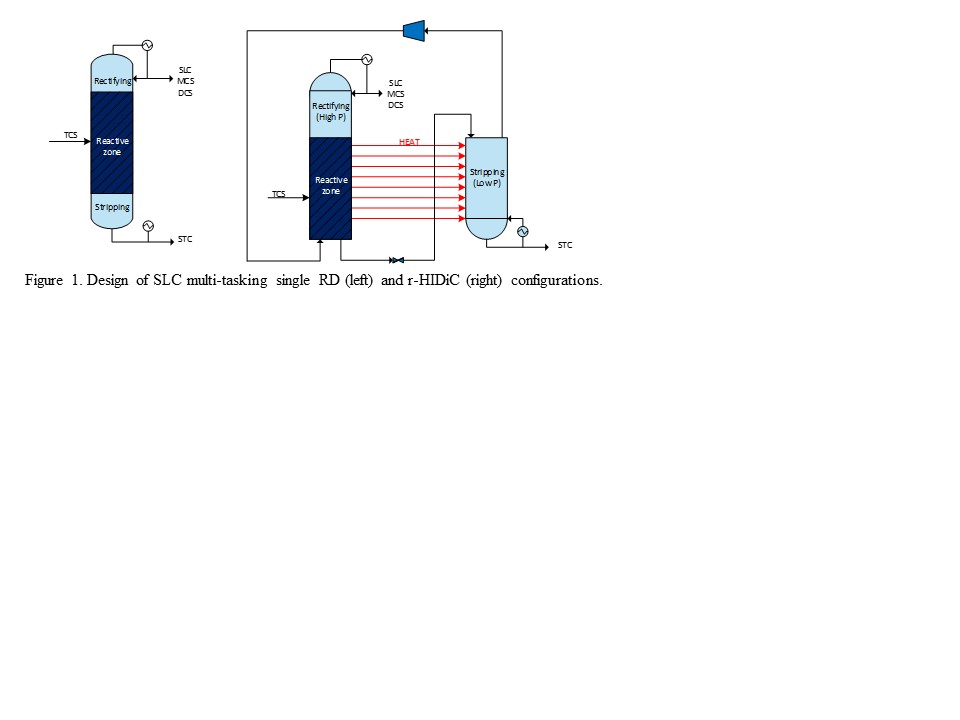
Relative humidity (RH) has shown its importance in almost every field from weather prediction to pharmaceuticals industries. The RH estimation is particularly important to maintain the product quality and to prevent the equipment from corrosion reactions. For RH estimation as a function of dry-bulb temperature and wet-bulb temperature, psychrometric chart is used which is a graphical representation of the physical and thermodynamic properties of the psychrometric processes. Nevertheless, the RH observation from psychrometric chart is not an easy task, mainly due to the high chances of human error. Therefore, the rigorous and user-friendly estimation of RH is an ongoing issue, so far. In this context, we are going to implement the state-of-the-art “Machine learning” technique to develop a simple, robust, and rigorous predictive tool for the estimation of relative humidity. The performance of the proposed machine learning-based predictive tool is validated through the psychrometric chart and also compared with previous published estimation tools. This work was supported by Basic Science Research Program through the National Research Foundation of Korea (NRF) funded by the Ministry of Education (2015R1D1A3A01015621) and by Priority Research Centers Program through the National Research Foundation of Korea (NRF) funded by the Ministry of Education (2014R1A6A1031189).
At present, HPLC / MS is used as a method of discriminating a liquid. This method is a high-precision physical-chemical analysis method that detects a specific mass from chemical components to be separated. However, these analysis methods require expensive equipment, and there is a problem that it is difficult to put them into practical use as a simplified method. Furthermore, in order to understand the chemical composition, pretreatment of the liquid sample is required.
For the above reason, in this research, without using a high-precision analysis device, a tea-based beverage is photographed using the image sensor (the camera of a smartphone), and the type is determined and classified by analyzed the image. After that, we linked the relationship with tea-based beverages and examined the possibility of classification.
In comparison results of histograms of photographed images, it was confirmed that green tea, black tea, and oolong tea can be classified by comparing histogram results indicating Blue brightness, Red brightness, and Green brightness.
Next, the number of peak elements and the peak class for Red and Blue was shown as scatter plots. As a result, according to the number of peak elements, it was confirmed that the variation was large in any sample and the classification was difficult. On the other, in the peak class, it was shown for each type of sample, and it was confirmed that it could be classified.
From the above results, it has been confirmed that classification of tea-based beverages is possible easily from images taken using a familiar high-performance image sensor such as a smartphone. In the future, we will deepen examination of methods that can classify samples more accurately, methods of discriminating unknown samples, and further studies using multivariate analysis.
We have the aim that the new environmentally harmonious industrial process to realize a sustainable society. One of the ideas that is attracting attention in chemical process development is Process Intensification(PI). PI has meant an approach aiming at a drastic improvement in process performance through new connections, high precision and compactness for each of the important components of the process. Structured catalyst would be novel tool for PI as the promotion functions of catalytic reaction, heat transfer, and fluid mixing.
In this study, Micro-Partition (MP, supplied by Nano Cube Japan Co., Ltd.) (Fig.1) was utilized as the structured catalyst. When the MP structured catalyst(MPC) would be filled into the gas-solid catalytic reactor, it is expected that reactivity will be improved because the reactants fluid is disarranged. It was suggested from computational fluid dynamics(CFD) that MPC could change the flow in unidirectional.
In the experiments of the MPCs are stacked in the same direction, it was confirmed that the bottom catalyst didn't effectively contribute to the reaction. The flow could be changed by structure of MP. It was also carried out the experiments that the direction of the MPCs was changed variously for confirming the contributions toward reactivity when designing the reactants flow voluntary. It was achieved the high reactivity when the MPCs were packed like to promote mass transfer by convection. In other words, it is possible to improve the reactivity by to finely control the fluid and to design the mass transfer in the catalytic reactor by using the structured catalyst.
Furthermore, it was observed what occurring about relationship between mass and heat transport and chemical reaction around the catalyst was analyzed in detail utilizing simulation software COMSOL Multiphysics. And it was proposed MPC packing method to maximize the reactivity based on the simulation results.
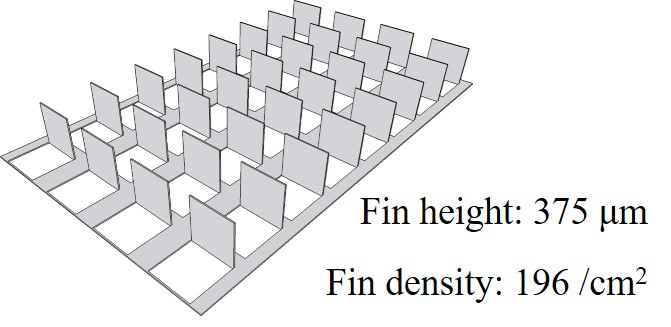
Solvent-based post-combustion carbon capture (PCC) is a mature and essential technology to solve the global warming problem. The high energy consuming issue and the flexible operation required by the power plants inquire the development of effective control systems for PCC plants. This study proposes the optimal-based control approach that utilizes optimal setpoint values for the quality controllers. The five optimal-based control schemes studied all employ L/G (liquid to gas ratio in absorber) as one quality control variable. Performance comparisons with a typical conventional control scheme are conducted employing a rate-based dynamic model for the integrated MEA (monoethanolamine) solvent PCC process developed on Aspen Custom Modeler. Compared to the typical control scheme, the optimal-based control schemes provide faster responses to the disturbance changes from the flue gas conditions and the setpoint change of the CO2 capture efficiency as well as better results in terms of IAEs (integral of absolute errors) of capture efficiency and reboiler heat duty during stabilization period. LG-Tstr and LG-Tabs-Cascade are the best schemes. In addition to L/G, these two schemes employ the control of Tstr (the temperature of a stage of stripper) and a cascade control of Tabs (the temperature of a stage of absorber)(outer loop) and Tstr (inner loop), respectively.
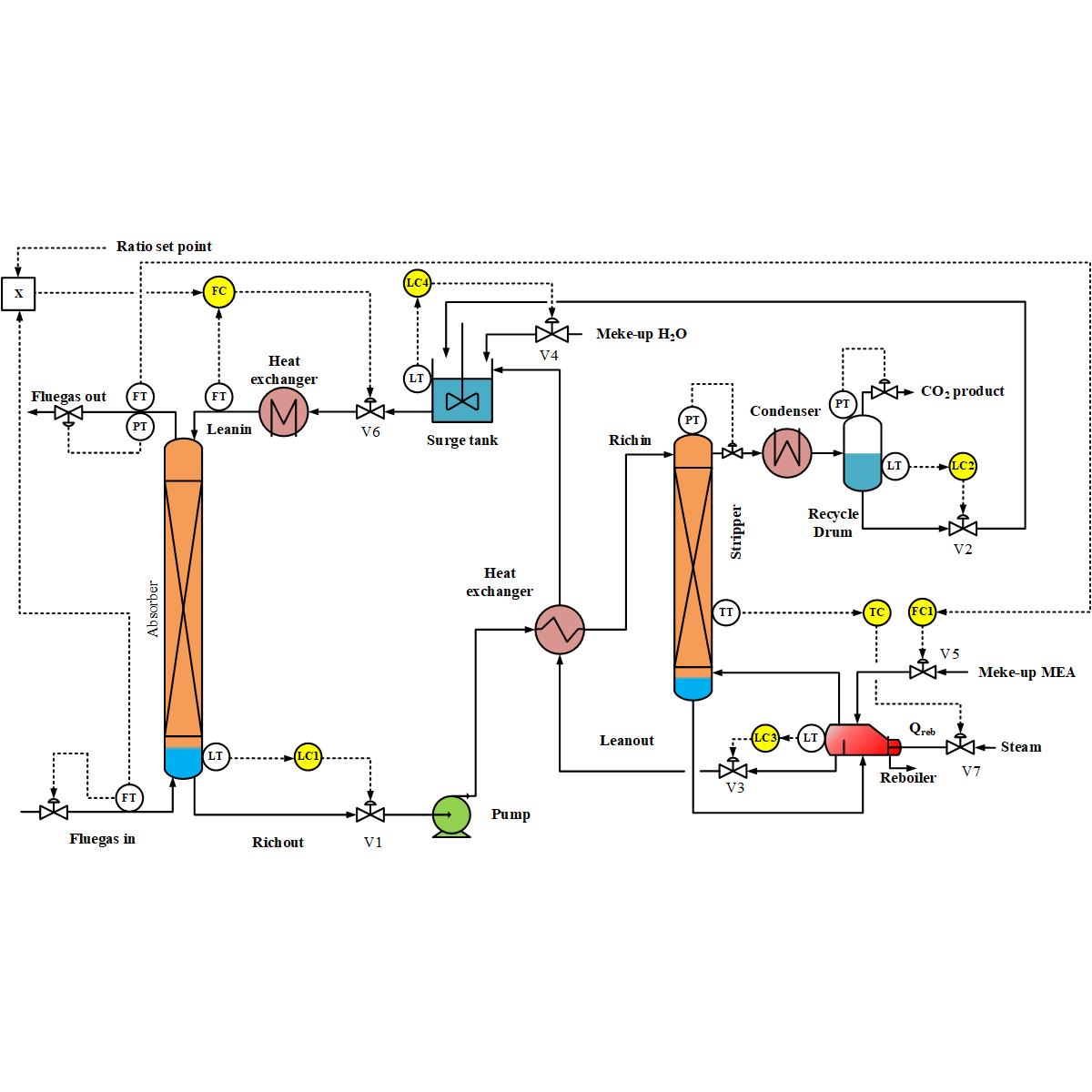
An oscillatory baffled reactor is a continuous tubular reactor with baffles arranged at equal intervals, and oscillatory flow is added to the net flow in a laminar flow region. Vortices are periodically generated in each baffle section, and mixing in the radial direction is promoted while axial dispersion is suppressed. We proposed a micro-scale oscillatory baffled reactor, μOBR, as a new tool for reaction analysis. In this study, the mixing mechanism and axial dispersion were investigated by the flow visualization and the tracer response experiment, respectively. The μOBR is the microchannel on the transparent acrylic resin plate with the size of depth 0.8 mm, width 0.8 mm, baffle width 0.4 mm, baffle distance 1.2 mm. The number of the baffles was 25 along the microchannel. In order to conduct the mixing characteristic experiment, the colored water with Rhodamine B was employed as the tracer. The flowing state in the 10th and 20th baffle spacing section in the channel were visualized by a microscope high-speed camera with the flame rate of 125 fps. The step response, F curve, was obtained from the concentration of Rhodamine B. The fitting of the response profiles with the F curve were carried out to calculate a parameter D/uL representing axial dispersion. The Reynolds number, Ren, was calculated from the net flow rate, and the oscillatory Reynolds number, Reo, was calculated from the frequency and amplitude of the oscillatory flow. The higher Ren gave the higher D/uL. It was difficult to suppress the axial dispersion because the vortices generated at the baffle wall could not grow larger and axial flow passed through the channel directly. On the other hand, the flow visualization showed that the radial mixing was enhanced and better plug flow property was obtained with the Reo increase.
State estimation of chemical processes is an important technology for controlling product quality and efficient operation. Especially, estimating difficult-to-measure values by soft sensor have been attracting attention, because it is faster and cheaper than measuring actual values.
The purpose of this study is to apply the time series data for estimating the product quality of a chemical plant. The authors focused on applying several neural network algorithms, such as Recurrent Neural Network (RNN) which enable utilization of time series data. Various algorithms, such as PCR, PLS and SVR, have been applied, however most of these methods have the disadvantage of not utilizing dynamic characteristics.
As a case study, we used a dataset from the Tennessee Eastman Challenge Process, and the concentration of a component was estimated from 33 explanatory variables. Several representations of time series data were investigated to tackle with the difference between sample intervals of the target variable and explanatory variables. Moreover, we tested various neural network architectures and traditional machine learning algorithms.
As a result, we found the superiority of neural networks compared with other algorithms. Specially, among neural networks, CNN-RNN hybrid model gives excellent results.
This hybrid model achieves much better than the traditional SVR in both R2 and RMSE, and better than the simple LSTM. We also found that it is efficient to use the samples without target data.
The results show that the proposed hybrid model provides an accurate tool to estimate process quality with the help of dynamic feature extraction by the CNN on the proposed data format.
Dealing with the unpredictable performance of a power plant has become one of the most challenging problem faced for all power plant engineers in the world. Engineers have to deal with unplanned maintenance and overhaul of power turbines resulting in a massive profit loss as it is not able to keep up the efficiency to achieve the production demand of electricity in time. To deal with the issue, production scheduling and maintenance planning are often considered and optimised independently in practice especially in power generation industry. However, conflict between production and maintenance scheduling has been an issue in managerial decision due to its interdependency. Hence, in conjunction with the advancement of Industry 4.0, a well-structure production-maintenance schedule modelled with MatLab is proposed to setup a reliable and systematic approach to deal with both maintenance and production problem. On top of that, machine configuration scheme is studied and analysed in this paper to provide an enhancement in stability and accuracy to the scheduling system. With the deployment of a P-Graph model, it provides a visually appealing interface to the users, allowing them to understand the insights of the system's decision-making principle. Optimal solutions are obtained from the model based on the load demand, allowing the system to select the best machine configuration scheme correspond to the objective of the research. This not only aimed to improve the system efficiency, also to maximise the plant profit and minimise any possible time and energy waste. It is believed that the development of the holistic package of smart scheduling smart system can be a promising breakthrough to the industry by improving the reliability, accuracy and availability of modern manufacturing system.
The global warming is serious problem in the world. Therefore, utilizing the renewable energy and low-temperature waste heat is attracted attention. Binary cycle is kind of heat engine and one of the technologies to be used a low-heat energy. Binary cycle is low power generation and thermal efficiency. Hence, improvement in power generation and efficiency are required for this technology. In order to high power generation performance, in this study cascade binary cycle utilizing separation membrane was employed.
Microreaction technology has attracted attention of chemical engineers, because microchannels show high heat and mass transfer rates. Intensification of multiphase processes, such as gas-liquid reactions and extractions, is an important application of microreactors. Slug flow is a typical flow pattern of multiphase flow in microchannels, and widely used in this field. In slug flow, gas and liquid slugs flow alternately, and a high interfacial mass transfer rate is often observed due to an extended surface area and the strong recirculation motion of fluids in each slug. Slug length is an important parameter representing the slug flow, and strongly influences the mass transfer rate, because the specific surface area and the rate of circulation decreases with increasing the slug length. Thus, to keep mass transfer rate high, it is necessary to monitor and control the slug length online. One of the typical approach to the slug length monitoring is to measure the pressure variation in the microchannel, and the periodic change in the pressure is related with the slug length.
The purpose of this research is to develop a technology to measure slug length by using AI technology. Air-water slug flow was generated in a microchannel and the slug length was varied by manipulating the flow rates of both phases. Then, photographs of slug flow with different length were taken. An artificial intelligence was trained to relate the image and the slug length by using the deep learning algorithm. With the trained AI, the slug length was successfully identified from the image of the slug flow.
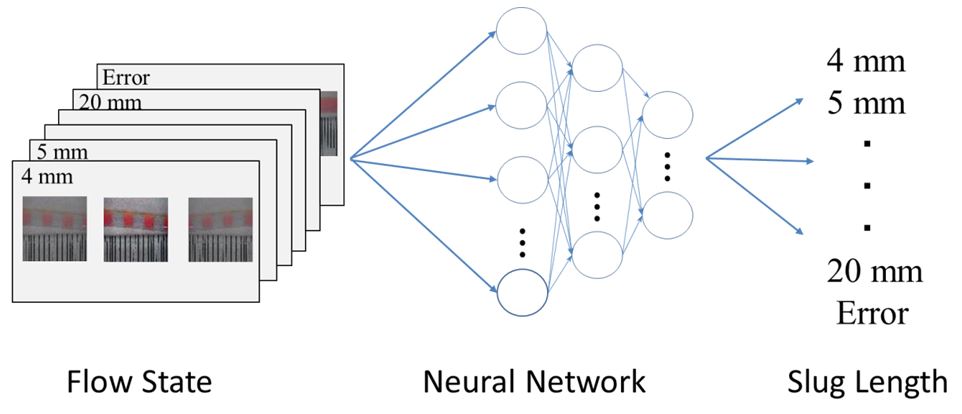
Tissue culture technique has been widely used for pharmaceutical and biomedical applications such as drug development, tissue repair, and even transplantation. However, the tissue culture process is limited due to time-consuming, labor-intensive and risk of contamination. For instance, the development of lung cells into a tissue requires periodic medium change for at least one month, allowing to proliferate and differentiate. Furthermore, standardized medicine produced using the conventional process is not suitable for personalized treatment due to compatibility and efficacy. In this work, we introduced microfluidic technology into the tissue culture process to develop a Plug-and-Play tissue culture platform which can eliminate the risk of contamination and improve the cell culture efficiency. In addition, the culture platform can be operated automatically in specific cell culture processes, such as mucus washing and air-lifting. The Plug-and-Play tissue culture platform includes a tissue card, a fluid control base, peristaltic pumps and pinch type valves controlled by a computer. This tissue card had two independent chambers separated by a microporous membrane to generate liquid-liquid interphase and air-liquid interphase cell culture environment for cell proliferation and differentiation, respectively. The Plug-and-Play culture platform mounted with miniaturized devices can simplify the tissue culture procedure for personalized application. It only requires inserting the tissue card at the beginning and removing it after finishing. The results demonstrated that the human lung cancer cells (A549) and human bronchial epithelial cells (HBEC) can be cultured in both submerged and air-lifted conditions at a dynamic flow condition for long-term cell culture. Taken together, these results conclude that the Plug-and-Play culture platform is capable of applying to diverse and complicated tissue culture procedures with a simple and easy culture process.
In recent years, in the chemical process industry, it has been performed a lot of methods in many design processes using simulation to reduce design costs. In process design of the chemical process industry, operating variables (such as the operating pressure) are determined so as to minimize target variables (eg, equipment cost). By automating this calculation process, which has conventionally been performed manually, the number of simulation steps can be significantly reduced. For that purpose, application of optimization calculation method is useful. In addition, there are multiple target variables in the chemical process industry, rather than one. Additionally, such variables are often in a trade-off relationship with each other (e.g., torque and discharge flow rate of a mixier) For this reason, in process design of the chemical process industry, application of multi-objective optimization is required rather than single-purpose optimization. Therefore, we performed optimization calculation of the mixing process in order to investigate the applicability of the multi-objective optimization method to the design of the mixing process, which is a particularly high demand process in the chemical process industry.
To find a new useful catalyst, many different catalysts must be prepared and the performance must be evaluated. Usually catalyst evaluation is conducted in a laboratory using conventional chemical apparatuses. The performance data should be collected for different temperature, flow rate and feed concentration. Since the experimental procedure is fixed, efficiency of catalyst testing is expected to increase greatly by introducing automated experimental apparatus. There are several commercial products for such purposes, but they are very expensive and thus deposition of solid substance or clogging incurs high repair cost. This study aims at development of a new catalyst evaluation system which can be built at a lower cost, and allows flexible operation. As an example of heterogeneous catalyst reaction, dehydration reaction of ethanol over alumina catalyst was used. Nitrogen gas was used as a carrier gas and the stream was equipped with a mass flow controller. The reactor was a glass tube filled with alumina power, and placed in an electric heater. The reacted gas stream was brought to a 6-way valve, which was used as an injector for a gas-chromatograph. The mass flow controller, electric heater and the 6-way valve were connected to a personal computer. The main control system was built on a Microsoft Excel, which directly send out the signals to control each devices. The spreadsheet software also records the state of the system, such as flow rates and temperature. A system capable of automatically finding the optimum conditions for this device was also incorporated to further improve the efficiency of the device. The developed system was realized at a low cost, since a popular spreadsheet software was used as the platform of the measurement system.
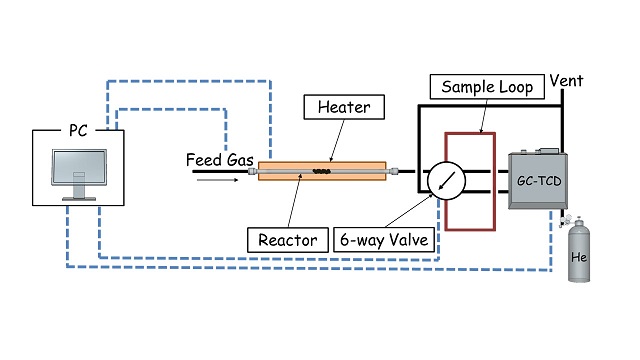
Distillation is a very popular separation technology and one of the drawback is the high energy consumption rate. To improve the energy efficiency, a variety of distillation apparatuses and processes have been proposed to date. Our group has also proposed another new distillation system, which is called Pressure Driven Distillation System (PDDS). This system is different from the conventional distillation in that the mixture is separated under isothermal condition. To gain the driving force for separation, the pressure distribution is formed. Since the system is isothermal, the heat released from the condenser can be used as a heat of evaporation at the reboiler. This thermal configuration of PDDS enables us to reduce the energy consumption rate greatly. In this study, we constructed PDDS and the separation performance was experimentally evaluated. The results showed that the vapor and liquid compositions at each stage were close to the equilibrium values, and that PDDS showed a sufficiently high separation performance.
The experimental apparatus was converted so that it allows flexible change in the configuration. For this, we built the interfaces to sensors and actuators, such as pressure sensors and valves, so that they can act as IoT devices. Through the internet connection, the measurements are sent to a database in a host computer, which can be viewed graphically on a website. It is also possible to control pumps to change the stage pressure by sending commands from the host computer. A program was built on a host computer so that solenoid valve is manipulated in the direction of decreasing the pressure, when an abrupt increase in the rate of pressure change is detected.
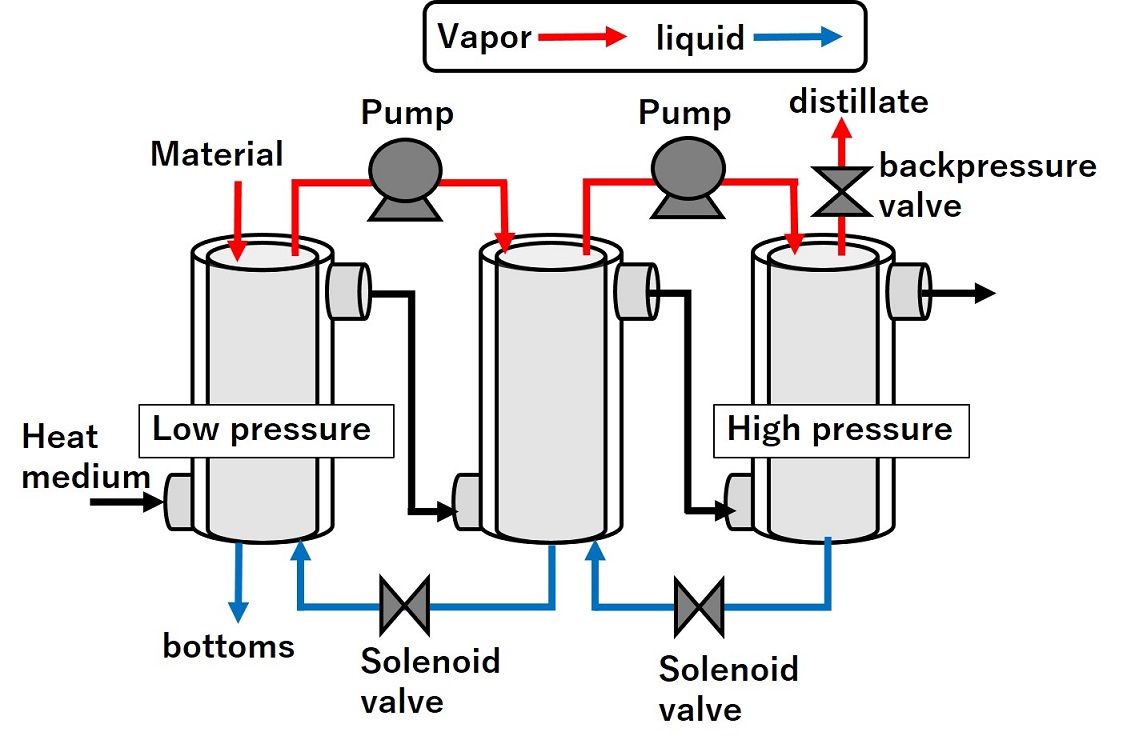
Landfill gas (LFG) from natural degradation of municipal solid wastes (MSW) consists mainly of methane and carbon dioxide (CO2), which can be used as a potential source to produce high-value chemicals. This study aims to develop new methanol production processes from LFG, or LFG-to-MeOH process by integrating of various gas processing technologies: carbon capture, steam methane reforming (SMR), water gas shift (WGS), and CO2 hydrogenation. Based on the rigorous process models developed using Aspen Plus, this study identifies the optimal process configuration and operating conditions of the LFG-to-MeOH process with two design specifications: maximizing methanol amount or the total energy production. Then, the capability of the proposed processes is analyzed using three evaluation metrics such as carbon balance, energy efficiency and unit methanol product cost (UPC). As a result, it was analyzed that the carbon balance and energy efficiency of the proposed processes can be achieved up to 72% and, respectively, which are very improved against existing LFG utilization processes. In addition, the UPC of methanol from the proposed process was estimated at 370 USD/ton, which is competitive in a real methanol market. Since the proposed processes can be operated while minimizing any outsourcing of material (hydrogen) and energy (utilities), they have large potentials for application, in particular to isolated LFG wells.
Food flavor is an important factor in determining the appetite and taste of food. The production of the emulsified flavor powders and the controlled flavor release from the powders have been extensively investigated. Spray drying is one of the most widely used processes for producing powders containing emulsified flavor in food industry. Flavor encapsulation and the release rate are significantly affected by wall material and emulsifier. Wall materials are one of the most important factors which may influence the barrier properties against the flavor diffusion in spray-dried powder. In this study, release rates of d-limonene from spray-dried powders were investigated using various wall materials, such as maltodextrin (MD) (dextrose equivalent (DE) = 25 and 19), lactose (Lac), and sucrose (Suc). d-Limonnen and hydrolyzed casein protein (Emulup) were a core material and an emulsifier, respectively. A pilot-scale spray dryer (L-8 type, Ohkawara Kakohki Co., Ltd.) was used to produce spray-dried powders. Two techniques were employed for measuring the release rate of d-limonene; a hand-build DVS system assembled with GC-FID detector under a ramping humidity condition for short term releasing experiment, and the conventional method by which the powders were placed in a desiccator keeping at constant temperature and relative humidity (RH) for long term releasing experiment. For the conventional method, the release rate constant of d-limonene were estimated by applying the Avrami equation. Logarithm of the release rate constants were proportionally increasing to RH for Lac as well as for MD. For the ramping humidity experiment, a linear correlation was found between the humidity inducing release of d-limonene from the powders and the glass transition temperature of wall materials. The release rates were significantly dependent on the wall material.
To date, numerous attempts have been made to improve the solubility of hydrophobic ingredients in physiological fluids. One such method for improving the water solubility of a hydrophobic substance is the use of an “amorphous solid dispersion.” We recently developed a new amorphous solid dispersion technique that does not involve the use of a surface active agent (Satoh et al., Food Chem. 2016, 197: 1136–1142). In this method, (i) sugar is amorphized and (ii) added to an organic solvent containing a hydrophobic substance, followed by homogenization. (iii) The homogenized solution is then dried to a solid. This sole amorphous sugar-based solid dispersion (SAS-SD) technique was applied to curcumin, known as food additive, anti-inflammatory, antitumor, anti-amyloid agents. The SAS-SD of curcumin was prepared by vacuum foam drying from methanol, using disaccharides as drug carrier-forming component. The analyses of microscopic morphology and thermal characteristics of the SAS-SD indicated the plasticizing effect of curcumin on the carrier sugar matrix. Aqueous dissolution profiles of curcumin from the SAS-SD were compared among different sugar types and sugar/curcumin compositions. All the SAS-SD samples exhibited “spring & parachute” type dissolution profiles of dissolved curcumin concentration. Markedly increased dissolution, represented by the area under the time course curve of dissolved curcumin (AUC60min), was observed when α-maltose was added in the composition range equal to and above 100 g-sugar/g-curcumin. Furthermore, heating the SAS-SD at close to and above the melting points of curcumin significantly prolonged the curcumin dissolution in water, resulting markedly increased AUC60min value.
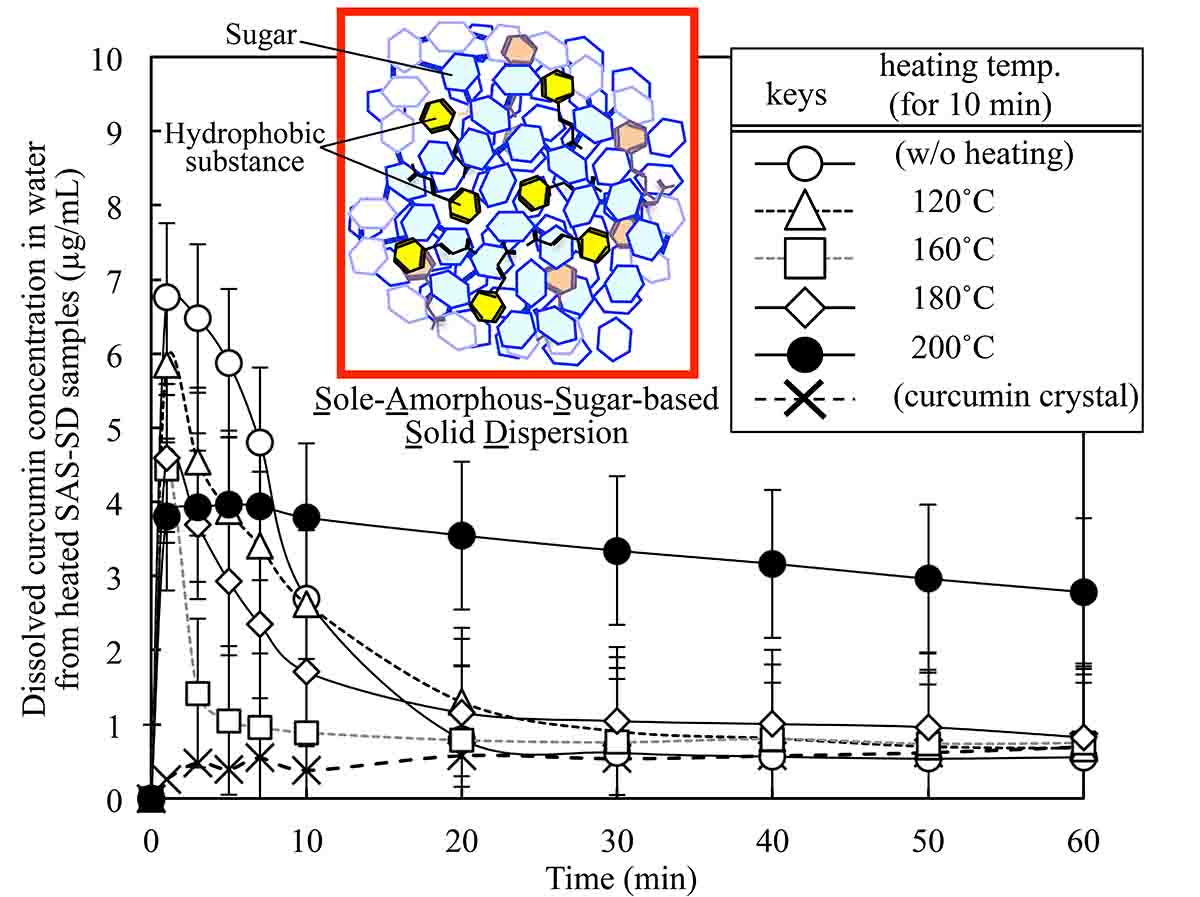
Reported phosphate binders for the treatment of hyperphosphatemia have high pill burden, cost and associated disadvantages like deposition in bones and adverse health effects. In present report, a synbiotic preparation was formulated using Lactobacillus casei JCM 1134 and deacetylated Aloe Vera (DAV) and evaluated its phosphate accumulation efficiency with the commercials. Aloe Vera powder was boiled in water bath at pH 8.0, 65 °C for 12 min. The centrifuges pellet was considered as DAV. Under optimized conditions, L. casei and DAV were mixed with additives and kept for incubation of 3h at 37 °C. Later the mixture was spray dried with supernant of DAV preparation and a synbiotic spray dried powder (SD) was obtained. Milk and coca-cola were taken as standard phosphate rich food. CaCO3, LaCO3, Al(OH) 3 and SD were studied as phosphate binders. In-vitro broth study was conducted and supernant was assayed for remaining phosphate using ascorbic acid method. Spray drying increased phosphate accumulation capability of L. casei in in-vitro broth. SD was observed as the second best after CaCO3 (accumulated phosphate 95% and 93% w/v from milk and coca cola respectively) and accumulated phosphate around 88% and 87% w/v from milk and coca cola respectively. However, LaCO3 and accumulated phosphate ~ 67% and 37% w/v while Al(OH)3 accumulated phosphate 83% and 73% w/v from milk and coca cola respectively. For safety, efficiency and cost, SD could be the best answer for preventing hyperphosphatemia. As CaCO3 is the best among tested phosphate binders, but it conferred hypercalcemia and gastrointestinal side effects etc. However, SD is composed of probiotic and Aloe vera which have GRAS status, and therefore, it is safe, affordable and comparatively effective as CaCO3.
There has been growing interest in gaining insights into the design of novel foods whose digestibility is controllable based on life stages and health conditions. Physical digestion is especially important in the case of solid foods, since their size reduction caused by breaking down can promote chemical and enzymatic digestion and release of nutrients simultaneously. Gastric digestion is the major digestion process in human gastrointestinal tract. The development of simple in vitro gastric digestion devices that enable quantitative analysis of the digestion dynamics of solid foods has been necessary. The authors and co-workers developed a human gastric digestion simulator (GDS) that simplifies the antrum geometry, is capable of simulated gastric peristalsis, and which enables direct observation of the disintegration of food particles in the gastric contents. This presentation provides a brief overview of our findings regarding the digestion dynamics of solid foods by GDS analysis. First, the concept and development of the GDS is introduced. The disintegration characteristics of solid foods using the GDS are described next, providing insights into the digestion processes influenced by gastric peristalsis. The GDS is expected to offer potential as a tool for designing novel nutraceutical and functional foods for which digestibility is well controlled.
A freeze-dryer with a radiative heating device was constructed and the inner vapor transfer property was regulated by separating the drying chamber and the condenser with an orifice. It was confirmed that the inner vapor transfer property substantially affected the acceptable operation range for avoiding product collapse, and it was revealed that this coefficient was key to quantify the drying performance of a freeze-dryer. Model foods that contained flavor components (i.e. saturated linear alcohols and ethyl esters) were freeze-dried under various operative conditions and the retention of those components were evaluated. It found that the inner vapor transfer property significantly affected the retention of the flavor components in relation to the dried cake properties. A mathematical model was used to obtain the contour diagrams of the selected parameters (e.g., product temperature and total drying period) during drying as a function of the heating condition and chamber pressure. The inner vapor transfer coefficients of the freeze-dryer were used to draw the operation lines on the diagrams. An attempt was made to depict the retention of the flavor components in combination with the contour diagrams and operation lines. It could be a rational method to predict end-product quality of a dried food based on mechanistic mathematical model.
Enzymatic hydrolysis process of polysaccharide is frequently used in food industries. Generally, small amounts of enzyme is added into the substrate solution or suspension. Efficient mixing in such system is quite difficult. Moreover, if a strong shear force is applied to enzyme, the three-dimensional structure of enzyme breaks down. This leads the deactivation of enzyme. Therefore, a reactor having the efficient and gentle mixing characteristic have been required.
In this study, Taylor-Couette flow reactor (TCFR) consists of two concentric cylinders with the inner one rotating was applied to hydrolysis process of polysaccharide. Above a critical Reynolds number (Recr) in the circumferential direction, there appear pairs of counter-rotating toroidal vortices (so called Taylor vortex flow) spaced regularly along the cylinder axis. The toroidal motion of Taylor vortex flow enhances not only heat and mass transfer but also mixing without the locally strong shear force. Furthermore, all the fluid elements leaving the annulus have the same residence time when the relatively small axial flow is added. In this study, in order to optimize enzymatic hydrolysis process of polysaccharide using TCFR, the effect of the rotational speed of inner cylinder and the axial flow rate on the yield of sugars was investigated.
The yield of sugars increased with the increase in circumferential Re, but it decreased in highly Re region where a wavy motion occurs. In wavy Taylor vortex flow region, the axial dispersion is promoted while the intra-mixing in Taylor cell is enhanced. This axial dispersion would induce the decrease in the yield of sugars. Thus, it can be concluded that TCFR should be operated in laminar Taylor vortex flow region in enzymatic hydrolysis process of polysaccharide.
The organogel is expected to be useful in various fields such as cosmetics, pharmaceutical products and food industry. However there is still few research on lecithin organogel using edible oils.
In this study, for focusing on safety to the human health, we studied on a biocompatible organogel using soybean lecithin, water and edible oil as a gelling agent , polar substance and an oil phase respectively. The range of gel formation was clarified by changing the component. Also the dynamic viscoelasticity of the gel was measured using a rotary rheometer.
The product was classified into four regions: Organogel region, Two phases region A (water + pasty solid), Two phases region B (oil + pasty solid) and No preparation region. Fig. 1(a),(b) shows the triangular phase diagram in the case of olive oil and MCT(Medium Chain Triglyceride) oil used as the oil phases. The gel formation region was different depending on the type of edible oil. This was considered to be due to the difference in the fatty acid composition of the triglycerides.
Olive oil composed mainly long-chain fatty acids having 16 or 18 carbon atoms. It showed a wide gel region at water concentrations ranging from 10 wt% to 30 wt%. MCT oil composed medium-chain fatty acid having 8 or 10 carbon atoms. It showed a wide gel region at water concentrations ranging from 40 wt% to 70 wt%. In order to confirm the influence of fatty acid composition, the organogel was prepared using triglyceride consisting of a single fatty acid composition as the oil phase. It has been found that the gel region depends on the main component of the fatty acid constituting the edible oil and the carbon chain length.
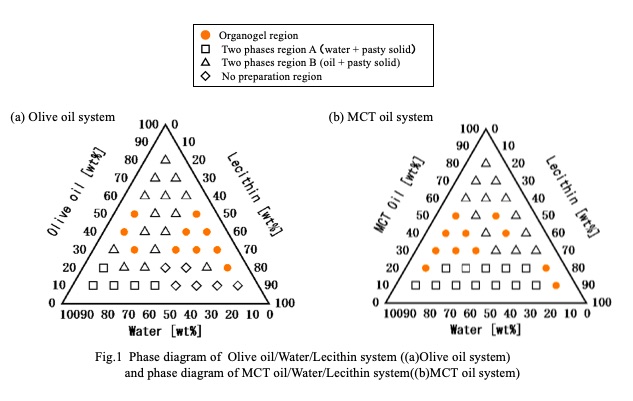
Dried persimmon is a famous and traditional product in Japan. There exist various modified or unique manufacturing procedures depending on production regions; and different treatments during the drying process will influence its final properties and consumer acceptance.
In order to know the influence of two traditional treatments on the final properties of dried persimmon, the effects of kneading and brushing on the properties of dried persimmon were investigated. In this research, four types of dried persimmons were produced by a traditional drying method, which kneading and brushing were used. A secondary surface was formed during the drying process. Moisture and sugar content, color, thickness and texture of the secondary surface were measured; Sugar crystal on the surface was observed using scanning electron microscopy (SEM);X-ray computed tomography (X-ray CT) was applied to investigate the moisture distribution of the secondary surface. Kneading had a significant (p<0.05) influence on the properties (moisture, color, thickness and texture of the secondary surface) of the product; while, the effect of brushing was not obvious. According to the sugar analysis, brushing assisted the sugar crystalize on the surface as white powder. Kneading treatment promoted the drying process and influenced the properties of dried persimmon through influence its moisture evaporation. Brushing assisted sugar crystalize on the surface by creating tiny scars on the surface of dried persimmon. This information therefore given some fundamental knowledge for making high quality dried persimmon; it is possible to help us improve the quality of dried persimmon during drying process and provide some information for the following storage strategy.
Thermal protein denaturation (TPD) is considered to be the main factor of the physicochemical changes in kuruma prawn muscle during thermal treatment. TPD in prawn muscle originates the reduction in water holding capacity and myofibrillar shrinkage, which results in appearance and texture changes. In this study, prawn samples were heated at 50, 65, 75 and 85 °C for 3, 5, 10 and 20 min. Heat transfer, and moisture loss due to cooking were evaluated. The kinetics of thermal TPD was investigated by using DSC-dynamic method. Prawns were assumed to be hygroscopic porous medium and viscoelastic material. Modeling of moisture transfer was conducted using a model based on Darcy's law combined with structural mechanics model according to viscoelastic strain-stress in a 2D-axi-symmetric model. The internal pressure of element was assumed to be directly proportional to the volume of water and inversely proportional to the volume of the element. Simulation of heat transfer and TPD was also developed. An implicit finite element method was applied using FORTRAN program. Governing and boundary equations were solved numerically using Garlekin's finite element method.
Kinetic parameters, activation energies, and pre-exponential factors, and enthalpy values for predicting TPD were obtained. Shrinkage occurred in both longitudinal and radial directions, especially at the higher heating temperature. For heating processes at 75 °C and 85 °C, actin denaturation plays the most important role in volume shrinkage; moreover, the simulated moisture transfer and volume reduction showed a good fitness with the experimental values. With the prolonged heating process, internal pressure increased firstly, then decreased and tend to equilibrium finally. The moisture distribution and simulated internal pressure distributions showed that due to the slow water release, shrinkage was delayed, and promoted incremental change in the internal pressure; then the released water acts to reduce the internal pressure, which was closely related to the actin denaturation.
Methane with a potential of 25-CO2-equivalents on global warming is the second highest compound of greenhouse gases. The current level of global methane has hit a historic high over the past 800,000 years. Therefore, to mitigate methane emission is a critical task in this generation for preventing serious climate change. Methanotrophic bacteria in the soil as one of the global methane sinks have been a potential strategy for the removal of atmospheric methane as well as environmental remediations. However, methanotrophic reactions in the conventional process consumed high energy power due to the low solubility of methane in aqueous phases. In this study, we demonstrated a novelty gas-solid reaction system under a non-aerated condition for methane degradation by methanotrophic bacteria. Associating with the simple filtration technique and a freeze-thaw treatment, Methylococcus capsulatus (Bath), a representative of gamma-proteobacterial methanotrophs, showed a significant improvement in the immobilization efficiency from 47.8% to 87.0% for loading of 9.64 μg-DCW/mm2-support onto the glass fiber membrane. Through this novel method of cell immobilization, a real gas-solid reaction with high cell loading was achieved for rapid methane degradation. Notably, the rate of methane consumption showed the 7-fold enhancement in the gas-solid system comparing to the rate in the aerated aqueous phase reaction with stirring. Moreover, the catalytic efficiency in the developed gas-solid system is 8.3-fold higher than that in the gel-entrapment system when 2.80 μg-DCW/mm2-support and 42oC-reaction temperature were employed. It indicates that water barriers still dominate the resistance of mass transfer in the gel-entrapment system and limit the affinity between catalysts and gaseous substrates, which is not suitable for a gas-solid reaction. Therefore, the result in this study can facilitate to develop an effective bioprocess of the removal of atmospheric methane with low energy consumption.
Food powders are the most common format in the packaged food sector. Typical food powders are dairy or dairy-based powders, infant formula, instant coffee, cereal based powders, instant soup powders and powdered microorganisms such as probiotics.
Amongst others, the popularity of the powdered format is driven by its increased storage and shelf-life stability due to decreased moisture content as well as by advantages for transport, storage and handling due to decreased bulk weight and volume. Desired functional properties can be tailored by applying unit operations and combinations thereof including drying, micronization, encapsulation, agglomeration and coating. An overview and selected examples of recently applied approaches will be addressed in this presentation:
— Micronization of green coffee in oil and roasting of the micronized suspension for aroma protection1
— Drying of emulsions with ultra-high oil content for structuring of liquid oils2
— Structuring of amorphous, porous sucrose containing particles to enable sugar reduction3
— Mixing and drying to produce a powdered composition of bioavailable iron and stable probiotics for food fortification4
Furthermore, an outlook at emerging powdered food ingredients and products will be provided. More specifically, the technological challenges and opportunities of novel alternative protein sources (e.g. plant, insects or microbial sources) as well as of stable probiotics for liquid products will be enlightened.
References
1. Pouzot et al., WO 2016 102335 - Coffee compositions and uses thereof, 2016
2. Sarkar et al., Microstructure and long-term stability of spray dried emulsions with ultra-high oil content, Food Hydrocolloids 52, 2015
3. De Acutis et al., WO 2017/093309 - Amorphous porous particles for reducing sugar in food, 2017
4. Berrocal et al., WO 2018/087208 - Composition in powder form comprising iron and probiotic bacteria, 2018
Wastewater containing high concentrations of oils and fats is a serious problem because it causes not only pollution problems such as eutrophication in aquatic environments but also malfunction of wastewater treatment facilities such as conventional activated sludge process, membrane bioreactor, or anaerobic digestion process. Conventionally, pressure floatation equipment has been used, while it brings industrial waste of sludge and gives off offensive odors. Microbial degradation has been studied as alternative methods. However, the oil degradation ability of microorganisms demonstrated was too low to substitute the pressure floatation equipment.
We developed a symbiotic microbial agent which consists of three types of microorganisms isolated by our group, and succeeded in dramatically accelerating the oil-degradation rate. The mechanism is as follows: A bacterium, Burkholderia arboris, secrets lipase and hydrolyzes oils and fats (triacylglycerol) into fatty acids and glycerol and degrades the fatty acids. Then, two kinds of yeasts, Yarrowia lipolytica and Candida cylindracea, degrade the fatty acids and glycerol, respectively. By using this symbiotic relationship, oils and fats can be converted into inorganic carbons or microbial cells without reverse reaction which is attributed to the accumulation of the fatty acids and glycerol. This microbial agent showed remarkable oil degrading capacity compared with other existing oil degrading microbial agents. This high oil degradation ability allows us to substitute pressure floatation equipment with our microorganism agents. By installing our products, decrease in offensive odors from sludge, reduction of industrial waste, simplifying the treatment process, and space-saving would be achieved, resulting in a cost-effective pretreatment system for oils and fats in wastewater.
3rd generation biorefinery research utilizing microalgae is ongoing in many countries because fuel/chemicals production from carbon dioxide by photogenic microorganisms is essentially sustainable. Among various photogenic microorganisms, cyanobacteria is recognized as a proper platform for chemicals production due to their high growth rate. In this study, we aimed to develop an effective continuous process producing 1.3-propanediol (1.3-PDO) by genetically engineered cyanobacteria using an airlift bioreactor system. Firstly, to achieve PDO production in cyanobacteria, a synthetic metabolic pathway consisting of five genes were introduced into the host strain (PCC7942), which produces 1.3-PDO from DHAP through glycerol. Using the cyanobacteria (TA2984), successful 1.3 PDO production (0.7 mM) associated with cell growth was confirmed and the optimal culture conditions for 1,3-PDO production were pH8.0 and 220 (μE/m2/s). Based on this result, we examined the possibility of continuous process using TA2984. As a bioreactor for continuous process, an airlift fermenter with an internal draft tube was used because it achieves homogeneous distribution in a reactor with low hydrodynamic shear. Using the air-lift bioreactor system, The continuous 1,3-PDO production was performed for 40 days. However, its operation sometimes becomes unstable due to the increase of culture pH at high cell concentration. Therefore, we then introduced pH-stat system by CO2 supply. Using the pH-stat system, continuous 1,3-PDO production was achieved using air-lift bioreactor for 60 days and the highest 1,3-PDO productivity was increased to 0.227 (mM/day) at the dilution rate of 0.178 (day-1). Furthermore, it was found that glycerol addition to medium was effective to improve 1,3-PDO production. Based on these results, enhanced continuous production of 1,3-PDO using air-lift bioreactor with the productivity of 0.367(mM/day) was successfully performed for more than 60 days.
Methane has attracted attention in recent years not only as a clean alternative fuel for transportation vehicle but also as a chemical feedstock because it exists abundantly as the main component of natural gas, shale gas, and biogas. However, methane exists as a gaseous state at ordinary temperatures and pressures, making it expensive to store and transport from remote places where it is generated to places where it will be consumed. Therefore, efficient methodologies for converting methane to liquid fuels and/or valuable chemicals are required.
Methanotrophic bacteria have been considered to be a suitable host strain for the biological methane conversion because they are capable of utilizing methane as sole energy and carbon source. However, there are several obstacles in the use of methanotrophic bacteria for the biological methane conversion; for example, (1) slow growth rate, (2) slow mass transport of methane, (3) maintenance of intracellular redox balance, and (4) limitation of genetic manipulation tools. In this talk, we would like to introduce our achievements regarding (3) and (4). Methylococcus capsulatus (Bath) was used as a model methanotrophic bacterium. To maintenance of intracellular redox balance, the method for real-time monitoring of intracellular NADH:NAD+ ratio was established using a genetically encoded NADH sensor protein and electrochemical method (Bioresour. Techonol., 241, 2017, 1157-61). For a gene replacement, efficient counterselection method was proposed using a mutated pheS gene as a marker (Appl. Environ. Microbiol., 84, 2018, e01875-18). We anticipate that these our achievements will be utilized widely by the methanotroph research community, leading to improved productivity of methane-based bioproduction and new insights into methanotrophy.
Cellulosic biomass consisting of plant matter is the most abundant carbon-neutral renewable resource on the planet. Researchers from interdisciplinary fields have focused on biorefinery utilizing (ligno)cellulosic biomass for the production of bioenergy and biochemicals in recent years. To achieve the efficient utilization of cellulosic biomass as feedstock, the pretreatment step is one of critical issues to be solved (1, 2). To explore an alternative way to produce value-added biochemicals from biomass, we have focused on the potential of insect biorefinery in which a unique silkworm-baculovirus protein expression system is exploited in collaboration with Faculty of Agriculture in Kyushu University (3, 4). Herein, our efforts on combining the unique protein expression system and the enzymatic protein manipulation will be presented toward the sustainable production of functional proteins with mulberry leaves as a sustainable plant resource.
References
1) N. Kamiya, H. Takahashi et al., Biotechnol. Lett., 30, 1037-1040 (2008)
2) Uju, T. Oshima, M. Goto, N. Kamiya et al., Bioresour. Technol., 138, 87-94 (2013)
3) Patmawati, K. Minamihata, N. Kamiya et al., Biotechnol. J., 13, 1700624 (2018)
4) Patmawati, K. Minamihata, N. Kamiya et al., J. Biotechnol., 297, 28-31 (2019)
Development of rapid and powerful mutagenesis and high throughput adaptive evolution tools is of importance for creation of hyper cell factories by discovery of novel functional genes or biological dark matters and genome-phenotype association using integration of different approaches. ARTP (atmospheric and room temperature plasma) mutagenesis system developed by our group can directly cause complex genome mutation including chain break and bases mutation via a unique mechanism. Mechanistic study and various practical applications in cell breeding demonstrated that ARTP mutagenesis is apowerfultool. For developing an integrated platform capable of combing ARTP mutagenesis and high throughput adaptive evolution, we further developed a microdroplet-based microbial culture (MMC) system which can be operated automatically with high throughput culture on microchips, good repeatability, online detection of growth states, reprogrammable software, automatic addition of gradient chemical factors. The ARTP mutagenesis together with MMC system is an enabling platform for smart integrative biobreeding by further combining with genome editing technology, which can greatly contribute to green biomanufacturing.
This work is supported by National Key Scientific Instrument and Equipment Project of NSFC (2162780028), the Tsinghua University Initiative Scientific Research Program (20161080108) and the JST CREST Project of Japan.
Glucose and xylose, which are the main components obtained by hydrolyzing biomass such as waste of agricultural products and plants, could be used in ethanol fermentation. However, the uptake kinetics of each the sugar may drastically change when glucose/xylose mixture is given to yeast as a carbon source for the ethanol fermentation. The objective of this study is to apply the developed quantification method to the determination of metabolites contents in ethanol fermentation media based on infrared spectroscopic information.
Fermentation was conducted using Pichia stipitis NBRC 10063 (NITE Biological Resource Center, Chiba) with glucose, xylose or glucose/xylose mixture as the carbon sources for 120-168 hours in yeast nitrogen based (YMB) medium. The infrared spectra of fermentation samples were collected using a Fourier transform infrared (FT-IR) spectrometer equipped with an attenuated total reflectance (ATR) accessory in the ranging from 4000 to 400 cm-1.
For the spectra of glucose and xylose in the YMB medium that represented the very similar spectral features, we extracted 14 absorption bands assigned to C-C, C-O, C-H and C-OH of the sugars and ethanol in order to characterize the spectra. Under the assumption that the spectral additivities could be satisfied, we tried to choose the best combination for the metabolite content determination in the fermentation media. Consequently, the wavenumber combination of 1036, 1050 and 1046 cm-1 was selected for the quantification, and the calculated contents of sugar and ethanol components excellently agreed with the contents measured using an HPLC method. In addition, the kinetic sugar uptake and ethanol production behaviors were accurately grasped during fermentation using glucose, xylose or glucose/xylose mixture medium based on the information estimated using the developed quantification method. These results suggested that the mid-infrared spectroscopic method would be acceptable as the simple, rapid, non-chemical and non-destructive monitoring of such fermentation processes.
Sugar fatty acid ester is one of bio-based and non-toxic surfactants. Its hydrophilic–lipophilic property can be controlled by the type of fatty acid side chain. Recently, medium-chain triglyceride (MCT), which has medium chain fatty acids (length of 6-12 carbons), has received much attention because of its preventive effect on lifestyle-related diseases. In order to use MCT in foods, its solubilization or micellization is important and hence sugar ester consisting of similar medium-chain fatty acid is required. However, such a sugar ester is not available. This is because in the industrial production method using homogeneous catalyst such as Na2CO3, reduced pressure condition is necessary to improve the product yield, but the reactant with medium-chain fatty acid also evaporates and hardly reacts under the condition.
We reported the ion-exchange resin pre-adsorbed with the reactant sugar shows a high catalytic activity for sugar ester synthesis at 60 °C and atmospheric pressure1). This method has a possibility of producing sugar ester with medium-chain fatty acid which could not be synthesized conventionally. In this research, syntheses of sucrose ester with caprylic acid (carbon number: double bond number = 8:0) were discussed using microporous anion-exchange resin catalyst. In the synthesis experiments, first, sucrose was adsorbed on the resin and then methyl caprylate was added to initialize the reaction. For comparison, an experiment to produce the conventional sugar ester with long-chain fatty acid was also performed using methyl oleate (18:1). As shown in the attached figure, in the case using the resin, the conventional long-chain ester formed more rapidly than the case using the homogeneous catalyst (Na2CO3) at atmospheric pressure. The novel medium-chain ester was also formed similar to the conventional long-chain ester. Therefore, this method using the heterogeneous resin catalyst has potential to efficiently and continuously produce sugar ester with medium-chain fatty acid.
1) T. Sasayama et al., Chem. Eng. J., 334, 2231 (2018)
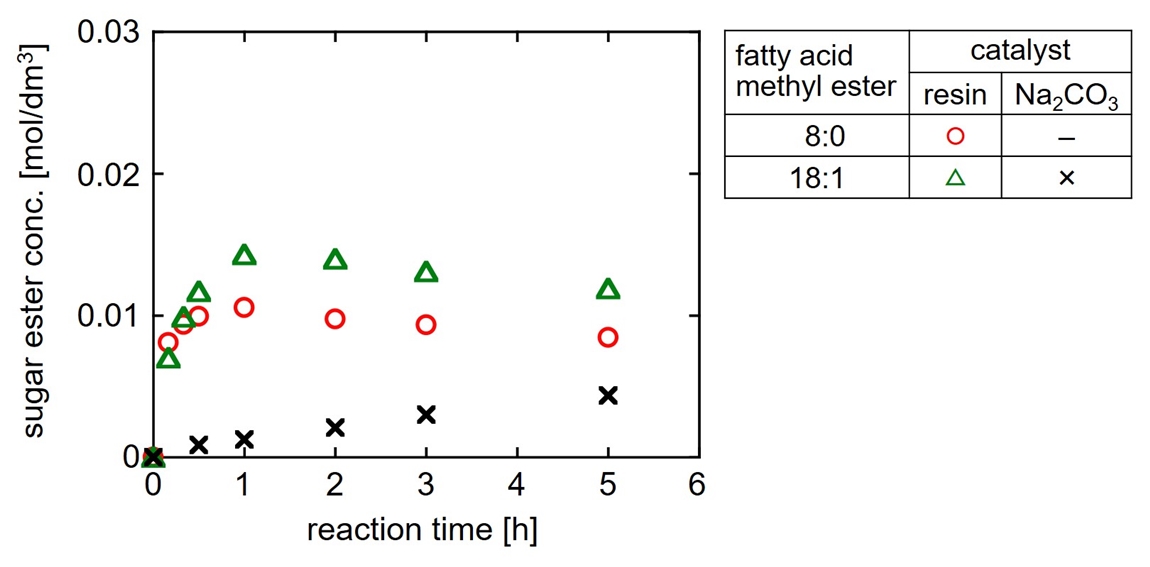
Synthetic biology aims to create a production system by synthetic or genetically engineered microbes. It is important to rationally design a genetic edition strategy in computer before expensive and time-consuming biological experiments. Flux balance analysis, a linear programming-based framework, have been widely used to predict the metabolic fluxes of cellular organisms in different culture conditions. Mass action models have recently been proposed to simulate large-scale cellular metabolism. However, both the models work just on the steady state; dynamic models are required to predict the cellular metabolism because synthetic microbes are often grown in a batch culture. In 2016, to simulate the dynamics of cellular metabolism, we constructed detailed kinetic models of E. coli central carbon metabolism to predict the dynamics of genetically engineered cells under aerobic condition. This model employed several major transcription factors of Cra, Crp PdhR, and IclR to consider gene expression regulation at different genetic mutants, and used detailed enzyme kinetics to take into account enzyme modification and allosteric bindings. On the other hand, useful compounds such as fermentation products are produced in anaerobic and microaerobic conditions, while cell growth are optimal under aerobic condition. Rational fermentation design of genetic microbes requests considering the mechanisms by which how dissolved oxygen affect fermentation and cell growth. Thus, we have proposed a kinetic model that predicts the dynamics of E. coli central carbon metabolism at different dissolved oxygen concentrations by considering transcription factors of ArcA/B and Fnr, respiratory chain reactions and fermentative pathways, and catabolite regulation. The model accurately predicted the metabolic characteristics and molecular mechanisms of fnr and arcA gene-knockout mutants. We used the model to design an aerobic-microaerobic dual-phase cultivation method in a pfl-knockout mutant to maximize lactate production. The model will be a platform for designing microbial cell factories to produce a variety of biochemicals.

Integration of in silico and experimental approaches is highly desired for understanding of photosynthetic organisms and creation of green microbial cell factories. We previosuly developed Genome Scale Model (GSM) of cyanobacterium Synechocystis sp. PCC6803 [Yoshikawa et al., 2011]. The developed GSM is applied to prediction of metabolic fluxes under diferent trophic conditions and to design of genetic modification for valuable compounds production. Ethanol production improvement by Synechocystis sp. PCC6803 strain [Yoshikawa et al., 2018] was designed and it was experimentally proved. Recently GSM was reconstructed with detail information of photosynthesis and understanding of electron transfer in photosynthesis system.
Metabolic flux analysis (MFA) based on quantification of 13C-labeling patterns of metabolites by mass spectroscopy (MS) is a powerful tool to quantify fluxes experimentally in a metabolic network of microorganisms. Cells are cultivated with a 13C-labeled substrate, and metabolites are extracted from the cells for use in MS analyses. Metabolic fluxes are determined using stoichiometric constraints coupled with extracellular measurements and 13C-labeling patterns of the metabolites. We developed a bioinformatics tool, OpenMebius, to determine metabolic flux from the 13C-enrichment data of isotopically labeling experiments [Kajihata et al., 2014]. Metabolic fluxes of different cultivation condition of Synechocystis sp. PCC6803 was performed and it provides new understanding of central carbon metabolism of photosynthetic organisms. Combination of the these in silico and experimental flux analysis provides us good strategies for modification of metabolic pathways to create useful cell factories of photosynthetic organisms.
Anaerobic co-digestion using biomass as a raw material has not only the advantage of energy recovery but is also a technology to reduce the environmental burden by resource circulation, prevention of global warming and creation of a recycling society.
Unutilized biomass has an important role in effective utilization of biomass. Now, there is great interest in the reuse of corn stover for renewable energy production from both output and environmental point of view. However more than half of the corn stover components are hardly decomposable organic matter. In this study, we aimed to elucidate the effect of heating as a pretreatment on biogas production of anaerobic co-digestion using corn stover from the view of a change in the physical characteristics of the raw material.
The specific heating conditions of corn stover and experimental flow are shown in the Fig1. For the raw materials, corn stover was pulverized to about 10 mm in size with a pulverizer and food waste was crushed with a food processor. About the heating pretreatment, 3 levels of samples were set and each was used as the 1st, 2nd, 3rd-week samples. The organic loading amount was set to 1.5 g-VS / L-digester / day, C / N ratio was set to 40.then the raw materials input amount was calculated. Into a 235 L volume reactor, the raw materials were charged and heated to about 53 °C.
In this study, the bulk density and open porosity of utilized corn stover were measured to explore the effectiveness of the pretreatment. The result shows that the 3rd week sample had the highest biogas production. Furthermore, the bulk density of the corn stover total solids directly affects the biogas production rate, a sample with a higher bulk density of corn stover total solids shows the lower biogas production rate.
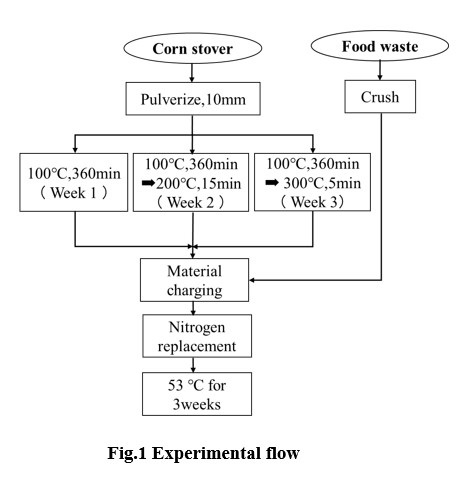
Microalgae are an attractive and green resource with large-scale production capacity for lipid. After harvesting, microalgae always have water contents > 80 wt%. Through the traditional extraction methods, microalgae must be dried before the subsequent extraction and heated to remove the extractants after the extraction, resulting in a great increase in energy consumption; the extraction temperature is generally > 100 oC with long extraction time. Therefore, it demands an energy-saving and efficient extraction solvent.
Dimethyl ether (DME) is the simplest ether and colorless fuel gas at ambient temperature and pressure. As a commercial product, DME comes from a variety of feedstock such as fossil fuels and waste products. DME is environmentally friendly, efficient, and energy-saving as an extraction solvent. DME is partially soluble in water, rendering that drying is unnecessary for wet feedstock. The high solubility of lipid in DME ensures high efficiency. Due to a low boiling point at -24.8 oC and sufficiently high vapor pressure at room temperature, the gaseous DME after the extraction process can be removed completely and easily without heating.
Here, we conducted the DME extraction of various microalgae and firstly reported the latest development of pilot-scale DME extraction prototype for lipid extraction of wet microalgae. The wet microalgae samples with moisture contents higher than 90% grew using the wastewater at a wastewater treatment plant in South Africa. The harvesting and extraction machines also located at this plant. After harvesting, the extraction reaction of microalgae proceeded continuously at ambient temperature. Both lipid and water were extracted together and separated easily after the extraction. The yield, elemental composition, heating value, and molecular weight distribution of lipid extracted by liquefied DME were studied. The energy balance was calculated, indicating the extraction using liquefied DME as the solvent can decrease energy consumption greatly in pilot scale.
Oxygen supply is a crucial parameter in biotechnological production. While oxygen transfer has been well studied for viscous cultivations in stirred tanks, little is known about the oxygen transfer in shake flask cultures with elevated viscosity media. In our previous study, it was experimentally shown that the maximum oxygen transfer capacity OTRmax in shake flasks increased with increasing viscosities up to 10 mPa s. It was further demonstrated that the increased thickness of the liquid film at the shake flask wall inherently promotes the oxygen supply to the medium at moderately elevated viscosities1). Although the shaking diameter is an important parameter to determine the oxygen transfer in shake flask culture, is not well discussed in the past.
In this study, OTRmax was investigated using a biological model system. Corynebacterium glutamicum DM1730 was studied in culture medium with different shaking diameter (25, 50, 70 mm) at elevated viscosity (1-27 mPa s), using polyvinylpyrrolidone as viscosifying agent. The oxygen transfer was monitored using a respiration activity monitoring system (RAMOS)2) with 20 mL medium in 250 mL flask. As a result, the OTRmax significantly increased by changing shaking diameter from 25 to 50 mm under each viscosity condition. It was hypothesized that with the increase of shaking diameter, a larger part of the shake flask wall became available for the liquid film and the bulk liquid was more pressed into one corner of the flask. Meanwhile, no further increase of OTRmax was observed by changing the shaking diameter from 50 to 70 mm. It was suggested that the volume of liquid film already reached the maximum at 50 mm shaking diameter under the examined condition.
1) Giese et al., Biotechnol. Bioeng., 111, 295-308 (2013)
2) Anderlei et al., Biochem. Eng. J., 17(3), 187-194 (2004)
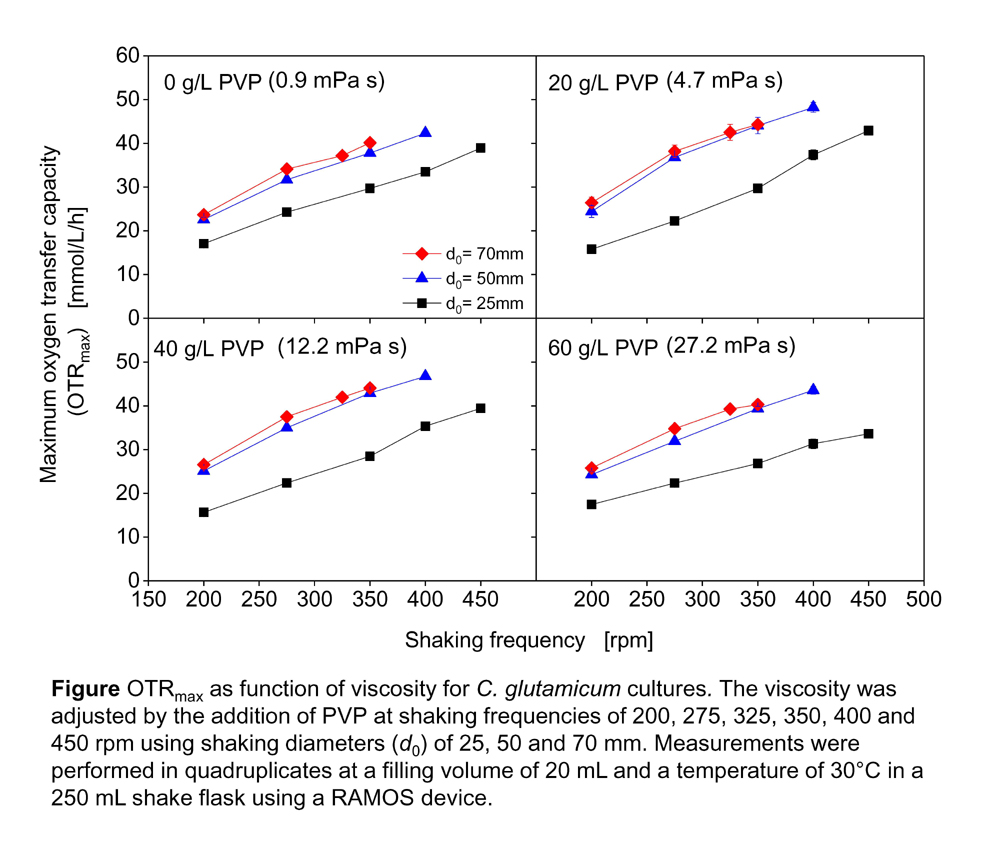
Natural media are often used for various commercial bioprocesses by manufacturers to cut raw material cost. However, the components of the raw materials varies between lot-to-lots and brand-to-brands. The varieties of raw materials influence to the cell growths and materials productivities, and results in unstable production across batches in manufacturing processes. To ensure the quality of raw materials among batches, it is necessary to perform a laboratory screening to purchasing the optimal one, and ensure a desirable performance in industrial process. To solve the serious problems in bioprocesses, it is developing that a modeling methodology using composition of raw materials, named us “substratome”(1), obtained by non-targeted metabolomics-like methods can estimate the cell growth and bio-productions. Here, we will present that two model studies: [1] Escherichia coli growths have been estimated from hydrophilic components in yeast extract obtained by gas chromatography-mass spectrometry (GC-MS)(1), and [2] bioethanol production have been estimated by the volatile components in corncob and corn stover hydrolysates obtained by GC-MS; by partial least square regression (PLS-R)(2). Additionally, we will present preliminary results to solve the same issues by using artificial intelligence.
References
1) Tachibana S, Watanabe K, Konishi M. (2019) J. Biosci. Bioeng. (in press)
2) Watanabe K, Tachibana S, Konishi M. (2019) Bioresouc. Technol. 281: 260-268
Cancer is a complex disease that relies on both oncogenic mutations and non-mutated genes for survival, thereafter coined as oncogene and non-oncogene addictions. The need for more effective combination therapies to overcome drug resistance in oncology has been increasingly recognized, but the identification of potentially synergistic drugs at scale remains challenging. Here we propose a gene-expression-based approach, which uses the recurrent perturbation–transcript regulatory relationships inferred from a large compendium of chemical and genetic perturbation experiments across multiple cell lines, to engender a testable hypothesis for combination therapies. These transcript-level recurrences were distinct from known compound–protein target counterparts, reproducible in external datasets, and correlated with small-molecule sensitivity. We applied these recurrent relationships to predict synergistic drug pairs for cancer, and experimentally confirmed the synergistic effects of one combination of a retinoid and an mTOR inhibitor and the other combination of a protein synthesis inhibitor and a CDK inhibitor in two breast and two lung cancer cell lines. Our results corroborate a gene-expression-based strategy for combinatorial drug screening as a way to target non-mutated genes in complex diseases.
Recombinant proteins expressed in E. coli are frequently misfolded into insoluble aggregates called inclusion bodies, which require a complicated downstream process for purification including a refolding step. Therefore, the increase of solubility of expressed proteins has been a critical issue in recombinant protein production using E. coli. It is known that the solubility is increased by lowering the protein synthesis rate under proper DO environment. In this study, we developed a DO-stat fed-batch culture system, which allows to maintain DO in a fermenter constant by glucose feeding. Using the DO-stat fed-batch system, anti-CRP scFv production by E. coli employing the pET expression system was investigated. By employing a PID control to determine glucose feeding rate, DO in a fermenter was successfully maintained. The results of the fed-batch operation at DO=40% showed the solubility of anti-CRP scFv improved from 23-29% by flask and batch cultures to approximately 100%. The anti-CRP scFv production also increased from 0.14 g/L by a batch culture to 2.6 g/L. DO in a fermenter significantly influenced on the solubility and production of scFv and the optimal DO level was found to be between 40-60% for successful scFv production. It was also found that the increased addition of yeast extract was effective to increase anti-CRP scFv production by avoiding the proteolytic degradation of scFv that sometimes happened in the mid or later phase of fed-batch cultivation. Thus, it was found that the DO-stat fed-batch culture system greatly improves the solubility and production of anti-CRP scFv using E. coli.
The characterization of polyphenol oxidase (PPO) taken from the seed kernel of the Philippine mango (Mangifera indica var. Philippines) was studied. PPO was obtained by extraction followed by partial purification through ammonium sulphate precipitation. The partially purified PPO has an optimum pH of 7.0 and an optimum temperature of 30 °C using catechol as substrate. The PPO showed maximum activity when catechol was used as the substrate, followed by other diphenol substrates 4-methylcatechol, L-DOPA, and hydroquinone. Meanwhile, no enzyme activity was detected from two monophenol substrates p-cresol and tyrosine. In the determination of kinetic parameters using catechol as substrate, the Michaelis-Menten constant (Km) was found to be 2.50 mmol/L while the maximum reaction velocity was 0.12 U/min.
The cellular signals such as proliferation were regulated by lipid modification of proteins that are activated on a membrane-anchored state. Thus, the artificial lipid-modification of proteins is key technique in biomimetics although biocompatible modification has been challenging due to hydrophobicity of lipid derivatives. Herein, we introduce in situ decoration strategy of membrane with a protein and a synthetic amphiphilic lipid using microbial transglutaminase (MTG). MTG catalyzes the cross-linking reaction between a specific glutamine (Q) in a protein and lysine (K) in the lipid-fused peptide. In our previous report, synthesized lipid-G3S-MRHKGS lipids fully were fully recognized by MTG, yielding > 90% conversion of a protein fused with LLQG (Q-tagged protein) into a lipidated form in the presence of MTG1,2. Especially, cholesterol (Chol) containing peptide (Chol-G3S-MRHKGS) renders the conjugated protein stable anchoring ability on the cell-surface. Therefore, we applied Chol-G3S-MRHKGS for in situ cell-surface decoration with the protein: simply mixing cells to a mixture of cholesterol-G3S-MRHKGS, Q-tagged proteins and MTG. The protein decoration efficacy depended on the concentration of the subjected peptide, however, high concentration caused the cytotoxicity toward the cells, indicating the trade-off relationship between decoration efficacy and biocompatibility.
1 M. Takahara et al., ACS Appl. Bio Mater., 1, 1823-1829 (2018).
2 M. Takahara et al., Chem. Eur. J., accepted (2019).
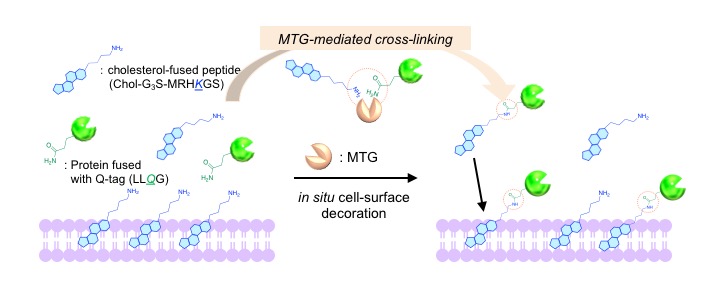
[Introduction]
Blood-brain barrier (BBB) hamper the delivery of drug carriers into brain. Widening BBB tight junctions via focused ultrasound (FUS) can be a promising approach for enhanced nanoparticle delivery into brain. However, there is currently a poor understanding of how nanoparticles pass the opened BBB gaps. In this study, FUS-assisted BBB permeation of gold nanoparticles (AuNPs) with different size are examined in vitro and in vivo for elucidating the optimum design of nanoparticles for brain drug delivery.
[Materials and Methods]
3, 15, and 120 nm AuNPs were applied to bEnd3 cells cultured on Transwell® culture insert in vitro and ICR mice via i.v. injection in vivo under existence of Sonazoid® microbubbles, followed by FUS irradiation. TEER was measured to evaluate the barrier function of the in vitro BBB model. The amount of permeated AuNPs was measured using ICP-MS.
[Results and Discussion]
TEER measurement indicated that gaps are transiently opened for 4 h in the in vitro BBB model by FUS. The amount of permeated AuNPs in vitro was significantly increased by FUS for 3 and 15 nm NPs, while no significant difference was observed for 120 nm NPs. The permeated amount increased with decreasing NP size. FUS irradiation also significantly increased the NP delivery efficiency to brain in vivo; in the case of 0.7 MPa FUS, the efficiency increased by ca. 3-10 times. It was found that smaller particles are not necessarily better, and 15 nm NPs showed the highest efficiency. We consider that this optimum size is determined by the competition between permeation through disrupted BBB gaps and blood half-life. While smaller particles are better for the permeation through narrow gaps, they are rapidly excreted from blood by renal clearance. This hypothesis was supported by our kinetic model calculation considering NP size-dependent permeation and clearance.
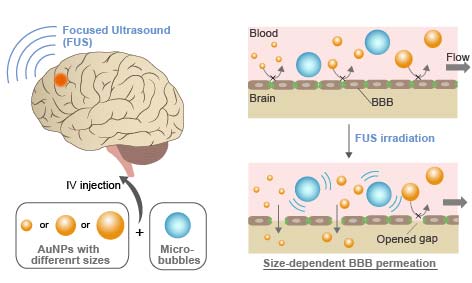
Regenerative medicine using induced pluripotent stem (iPS) cells has recently attracted significant attention. To realize the therapeutic potential of iPS cells, a mass cultivation system in the undifferentiated state and efficient differentiation protocol must be established. In this study, we developed a three-dimensional method for culturing human iPS cells using hollow fibers. The cells immobilized inside the hollow fibers can proliferate and form multicellular aggregates, capable of achieving a high cell density.
We first cultured human iPS cells for under conditions that maintained their undifferentiated state. The cells proliferated and formed cylindrical multicellular aggregates that grew in the longitudinal direction of the hollow fibers. The cells maintained the proliferative activity of 7-fold expansion for 4 days in at least three serial passaging. The cells well maintained the specific pluripotent marker of SSEA-4 during passaging.
We then cultured human iPS cells for 7 days under conditions that maintained their undifferentiated state and then switched the culture conditions to allow spontaneous cell differentiation. In the 7-day undifferentiated culture, a high cell density of approximately 10-fold that of the initial seeding density was achieved. The upregulation of gene expression of three germ layers was observed in the culture of differentiated cells. Expression of the lineage-specific cell-surface marker CXCR4 (a definitive endoderm marker) was about 30% at day 5 in the differentiation culture, which was 2-fold higher than that in the traditional monolayer culture. After hollow fiber culture, we isolated the CXCR4-positive cell population using the magnetic-activated cell sorting (MACS) separator system. We were successful in obtaining a population that had potential to differentiate into a specific lineage using the efficient hollow fiber culture method.
In conclusion, the hollow fiber culture method has potential for the large-scale preparation and differentiation of human iPS cells.
The fabrication of functional tissues has emerged as a promising technology for clinical applications, such as disease treatment and drug discovery, as an in vitro tissue/organ models. It has been revealed that the mechanical environment of tissues, determined by geometric cell patterns or material composition, play a key role in developing proper tissue function. Herein, we describe the feasibility of inkjet bioprinting with multi-ink for fabricating disk and filament-shaped tissues by patterning the cells onto substrates. Inkjet bioprinting, which is based on drop-on-demand non-contact deposition of liquids, allows the fabrication of tailor-made patterns using biocompatible materials with a simple and low-cost process. To achieve rapid hydrogelation, horseradish peroxidase (HRP)-catalyzed cross-linking was applied. HRP is a catalyst for phenol conjugation by consuming hydrogen peroxide (H2O2). A key advantage of utilizing this method includes the versatility of material choice to design various patterns. In this work, alginate (Alg-Ph), gelatin (Gela-Ph) and hyaluronic acid (HA-Ph) derivatives possessing phenolic hydroxyl groups were used. Bioink containing Gela-Ph, HA-Ph, and HRP was ejected through an inkjet nozzle head with 60 μm in orifice diameter onto Alg-Ph hydrogel sheet to form dot and line patterns that promote cell adhesion (Figure a). If the width of the gap between the dots and lines is required, a simple design modification can be done quickly with software without additional steps. Then, HEK293T/eGFP and 3Y1 cells were seeded onto the hydrogel sheets. After the optimal times of cultivation, disk and filament-shaped tissues were obtained by degrading Alginate-Ph hydrogel by adding alginate-lyase in medium (Figure b and c). We hope that this approach is promising for fabricating tissues and tailor-made cell patterning and will generate further interest in the field of tissue engineering.
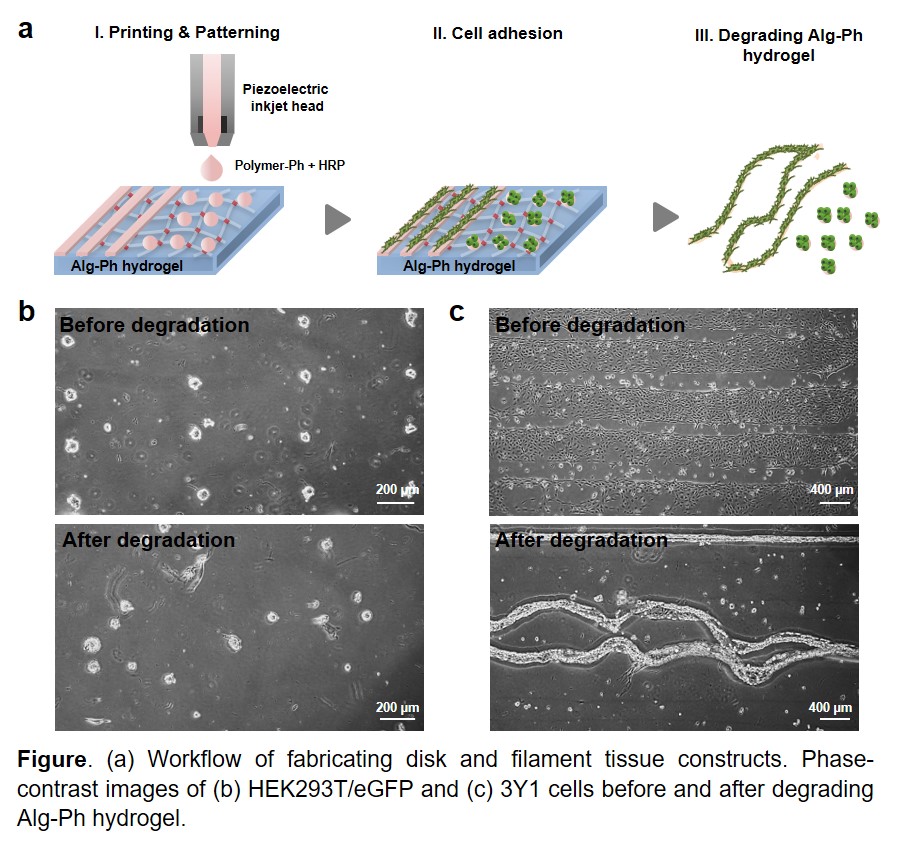
Bioprinting attracts increasing attention as an effective approach for fabricating cell-laden 3D constructs. 3D printing enables us to create physical objects from digital designs and printing precursors. The advantage of 3D printing is that it makes easy to prepare 3D constructs with different morphology, simply by modifying the digital design on computer. The aim of this study is the development of bioinks containing nanofibrillated chitosan (NC) for extrusion 3D bioprinting. Extrusion 3D printing is the most widely used printing system for developing 3D constructs. Chitosan is a well-studied polysaccharide in the field of biomaterial for medical and pharmaceutical applications because of the biodegradability, biocompatibility, and bioactivities. We evaluated the feasibility of NC as a component of bioinks for an enhancement of the shear-thinning property of the solution gellable through horseradish peroxidase (HRP)-catalyzed crosslinking of polymers possessing phenolic hydroxyl (Ph) moieties. Shear-thinning property is known to be an important property for fabricating constructs with the shape as designed in extrusion 3D bioprinting.
NC was mixed at 1 w/w% in the solutions of gelatin and hyaluronic acid derivatives possessing Ph moieties (Gelatin-Ph and HA-Ph). The addition of NC increased the viscosity at a lower shear rate but the value decreased drastically with increasing shear rate. In addition, the 3D construct obtained by extruding the ink containing NC, HA-Ph, gelatin-Ph, and HRP onto the substrate in air containing 16 ppm hydrogen peroxide was more consistent with the blueprint than that obtained from the ink free from NC. The fibroblast cells enclosed in the 3D constructs showed around 90% viability and spread in the constructs. These results demonstrate the feasibility of nanofibrillated chitosan as a component of bioinks in extrusion 3D bioprinting.
Fabrication of in vitro functional tissues which can accurately model disease condition are required for efficient drug development. Although there are a lot of neuromusclular diseases, very few drugs for them have been developed so far. In the present study, we aimed to develop in vitro functional innervated skeletal muscle tissues which can potentially model disease conditions. Previously, we developed in vitro skeletal muscle atrophy models [1] and in vitro 2D co-culture system of skeletal muscle cells and motor neurons [2]. By utilizing these systems, we developed the microdevice for 3D co-culture of skeletal muscle cells and motor neurons. The microdevices consist of two chambers; one is for skeletal muscle tissues and the other is for motor neurons. The chambers are connected each other by microtunnels which are small enough only the axons of motor neurons not cell bodies can pass through. We used the microdevices, made human skeletal muscle tissues using fibrin-based gel, and co-cultured human iPS-derived motor neurons. Glutamate selectively activate motor neurons. The constructed co-cultured tissues were actually contracted by the addition of glutamate into the chamber for motor neurons. In addition, the contraction was inhibited by the addition of tetrodotoxin which can suppress the firing of action potentials in neurons. The formation of neuromusclular junctions (NMJ) were observed by the immunofluorescence staining. These results indicated that the skeletal muscle tissues on the device were functionally connected with the motor neurons via NMJ as similar to the human body. Thus, our microdevice would be a powerful tool as an in vitro assay system for neuromusclular disease related drug development.
References:
[1] Shimizu, K., Genma, R., Goto, Y., Nagasaka, S., Honda, H., Bioengineering (Basel), 4(2):56 (2017)
[2] Yamaoka, N., Shimizu, K., Imaizumi, Y., Ito, T., Okada, Y., Honda, H., BioChip Journal, in press.
Spatiotemporal regulation of cell-material interactions has attracted a great deal of attention. Fine arrangements of cells are necessary in the field of cell engineering for applications such as regenerative therapies with artificial tissues and organ-on-a-chip techniques for drug evaluation. In addition, spatiotemporal manipulation at a single-cell level allows cells to be sorted based on their characteristics in image cytometry. Although, numerous methods have been developed for the spatio-temporal control of cell immobilization, most of these depend on cellular adhesivity for cell attachment. Thus, these methods required hours of incubation to immobilize cells and cannot be applied to cells with no adhesiveness. Rapid control of cells is essential for current “omics” analyses requiring high-throughput approaches. Non-adherent cells have also attracts growing attention in cancer immunotherapy, and detection of circulating tumor cells have significant benefits in the medical field.
Therefore, we have developed photo-cleavable materials for the quick immobilization of both non-adhesive and adherent cells, based on a poly(ethylene glycol) (PEG)-lipid conjugate (PEG-lipid) [1] and applied them to unique single-cell analysis [2,3]. Contrary to most conventional approaches that control the adsorption of serum proteins, our materials regulate the characteristics that directly binds to the cell membrane. Recently, we developed photo-switchable surfaces for the reversible immobilization of non-adhesive cells [4]. Spiropyran, a molecule that photo-isomerizes leading to a substantial difference in water solubility, was attached to PEG-lipid conjugates. This photo-switchable material enabled rapid and spatially selective in situ control of both the attachment and detachment of cells in a light-induced manner. In this presentation, this new material is mainly introduced with other recent our progresses in material-based cell manipulation technologies.
References: [1] Angew. Chem. Int. Ed., 51, 128-131 (2012); [2] Lab Chip, 31, 1933-1938 (2017); [3] Sci. Rep., 7, 14962 (2017); [4] ACS Appl. Bio Mater., 2, 33–38 (2019).
INTRODUCTION:
Surface modification can enhance regenerative performance of medical implants. Our group have been exploring short peptides with cell-selective adhesion/growth [1,2]. These peptides are screened from combinatorial peptide library by evaluating the dual effect on different types of cells, which enhances the adhesion/growth of cells that enhance the regeneration and inhibits the cells with negative affect on implanted area. For the application of these peptides, we have been investigating bio-compatible scaffold material for medical applications. In this work, we have developed a hybrid material of polysaccharide and collagen processed by vitrification method [3]. We here report the optimization of polysaccharide-collagen hybrid material and its peptide-modified effect for evaluating its medical usage performance.
METHODS:
Ten different types of material conditions were designed to examine the combination effect with the polysaccharide and collagen hybrid film. Their mechanical properties and cell-selective adhesion performance was investigated with endothelial cells, fibroblasts, and smooth muscle cells, which mainly consists of blood vessel and to be controlled in the regeneration of vascular tissue.
RESULTS:
We found optimized condition of polysaccharide and collagen combanied material made by vitrification. As a result, we found that our cell-selective peptides can provide cell-selective enhancement of endothelialization on newly designed polysaccharide and collagen hybrid material. The mechanical property measurement indicated that these functionalized hybrid film can show sufficient mechanical strength, and can be optimized easily by layer-forming method. Therefore, our new hybrid material can be a new candidate material to design medical implants such as sheets or vessels which can exceed the implantation of non-functionalized bare polymer material.
DISCUSSION & CONCLUSIONS: Our hybrid material combined with cell-selective material can serve as new regeneration enhancing material in medical usages.
REFERENCES
[1] Kanie et al., Materials. 2016; 9(9) 730.
[2] Kanie et al., Biotechnol Bioeng. 2012; 109:1808-16.
[3] Takezawa T, Cell Transplant. 2004;13:463-73.
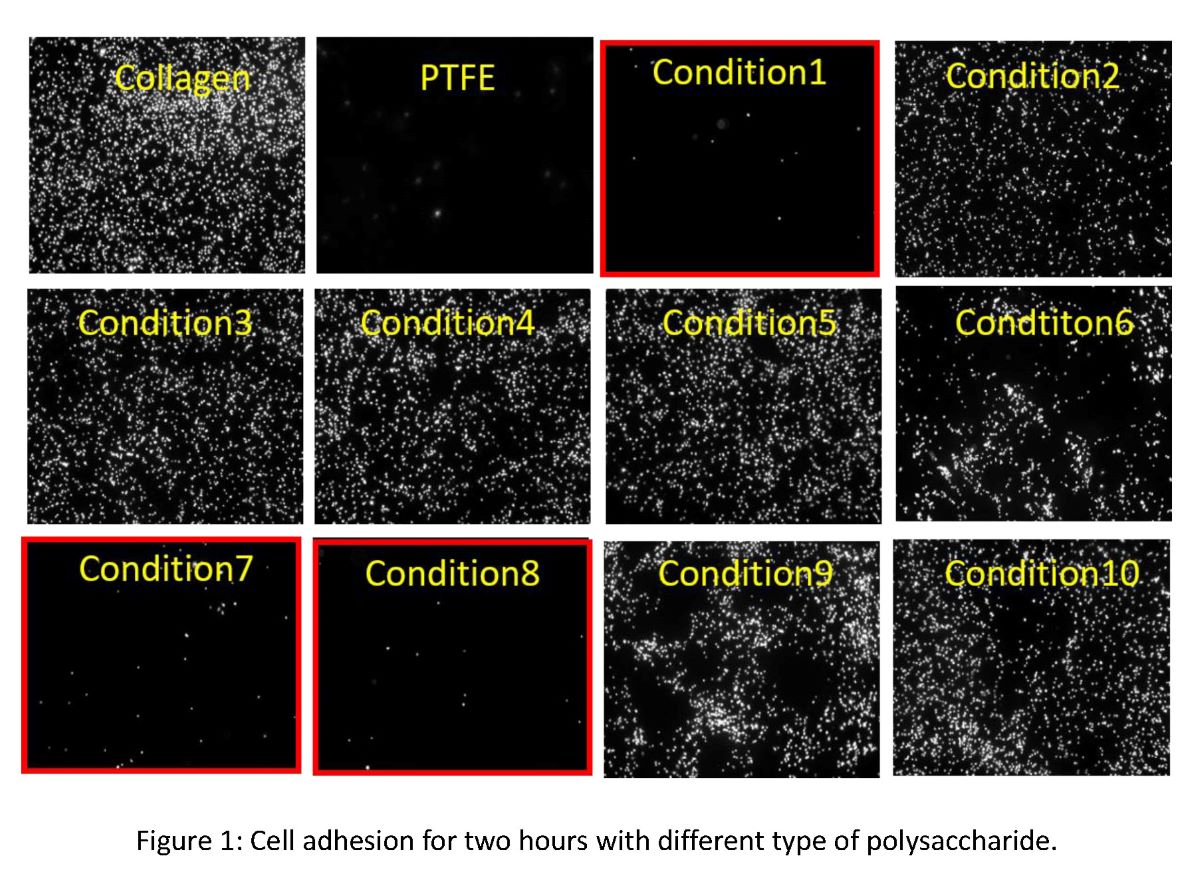
Recently, treatments by transplanting tissues obtained from living cell culture have been performing as regenerative medicine. In this case, the quality of cell products varies between specimens and changes during culture. At present, quality evaluation of cultured tissue generally relies on invasive techniques. However, in the production process of cultured tissues, it is better to avoid consumption of cells for quality evaluation due to the scarcity of raw material. We aim to be able to determine the transplant timing of cultured tissue from the information obtained by non-invasive method. In this research, we considered each cellular behavior (migration, division, differentiation, etc.) as a “module”, and the strength of cell-cell adhesion and cell-substrate adhesion as energy. We constructed a cell culture simulator where all cellular behaviors are determined by energy calculation using kinetic model. In corneal epithelial cell sheet formation culture, it was observed that the fluidity of cell sheet changes during the culture. In addition, the cell sheet fluidity was different between specimens. By using simulator constructed, it was able to express the changes of cell sheet fluidity of each specimen by changing cell characteristic parameter values. As a result, it was suggested that the different cell sheet fluidity between specimens was due to the increase and decrease in cell-cell adhesion strength, and structural strength of cell sheet was high when the cell sheet fluidity was low. In addition, when the cell sheet fluidity was low, the calculated value of sum of tight junction energy in the cell sheet was maximum value. From this result, it was suggested that measurement of trans-epithelial electrical resistance, which is directly correlated with the formation of tight junction, was effective as a non-invasive and quantitative method for evaluating the strength of cell sheet structure during culture.
Alginate and chitosan have favorable properties as biomaterials such as nontoxicity, biodegradability, biocompatibility and antibiotic property. Alginate and chitosan ultrafine fibers generated through electrospinning have drawn widespread attention at tissue engineering scaffolds, drug release carriers, wound dressings and so forth. While both alginate and chitosan are water-soluble, the electrospun mats have to be insolubilized before the usage in these applications. Herein, we proposed the method of preparing alginate and chitosan water-insoluble nanofibers through electrospinning and horseradish peroxidase (HRP)-mediated crosslinking of phenolic hydroxyl (Ph) moieties under stimulating of vaporized H2O2. In details, alginate and chitosan were firstly modified with Ph moieties, namely alginate-Ph and chitosan-Ph. Alginate-Ph blending (alginate-Ph 2% w/v, polyethylene oxide (PEO) 9% w/v, Pluronic F-127 5% w/v, HRP 160 U/ml ) and chitosan-Ph blending (chitosan-Ph 1% w/v, PEO 10% w/v, Pluronic F-127 10% w/v, HRP 160 U/ml ), were electrospun separately to fabricate nanofibers under conditions of voltage 11~15kv, needle to collector distance 8~15cm and flow rate 0.1 ml/h. The resultant fibers were then exposed to the air containing 3 ppm H2O2. The diameters of alginate-Ph fibers before and after exposure to the air containing H2O2 were 171 nm and 200 nm, respectively. Similar results were observed in the case of using chitosan-Ph. Successful crosslinking was confirmed for both alginate-Ph and chitosan-Ph fibers from the result of keeping fibrous structure after 48 h of soaking in PBS. In contrast, the fibers non-exposed to the air containing H2O2 dissolved immediately after soaking in PBS. These results clearly indicated the possibility of obtaining insolubilized nanofibers through electrospinning and HRP catalyzed reaction in the air containing H2O2.
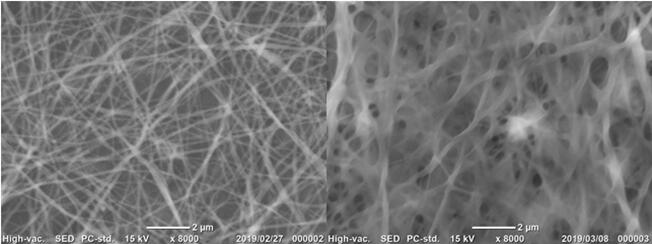
Endoscopic submucosal dissection (ESD) for the treatment of esophageal mucosal lesions is associated with high rates of postoperative stenosis, resulting in significantly decreased quality of life. Several therapies are available for the prevention and treatment of esophageal stenosis after ESD, including prevention via pharmacological treatment, endoscopic esophageal dilatation, stent placement, and autologous cell transplantation. However, no single method has been currently recognized as effective in clinical practices. Therefore, simple yet effective preventive methods are crucial to reduce the risk of postoperative esophageal stenosis.
Considering the operability under the endoscope, a spray material that can be administered through a 1.5 m-long and 4 mm-diameter endoscopic instrument channel is expected to be promising. Therefore, in this research, we developed a novel in situ cross-linkable powder for the prevention of esophageal stenosis after ESD. The powder was composed of alginate and gelatin; alginate can be rapidly cross-linked by calcium ions, whereas gelatin can be cross-linked with collagen on the submucosal exfoliated surface by transglutaminase. Therefore, by spraying them with their cross-linker solutions, hydrogel can be formed immediately with a firm adhesion to the wound surface.
Because there was no appropriate small animal model for evaluating esophageal stenosis-preventing material, we developed a brand-new stenosis model in rats by combining mechanical and trypsin treatment to rat esophagus. The rat model successfully caused stenosis, which was close to ESD-induced stenosis in clinical. The result of material administration to this model is shown in the figure below. The body-weight loss caused by stenosis was clearly reduced by the application of alginate/gelatin-mixed powder compared with untreated control group. The esophageal patency rate after 1 week and 2 weeks after surgery was also significantly improved compared with the control group. From these results, it is expected that this sprayable material is useful for preventing esophageal stricture after ESD.
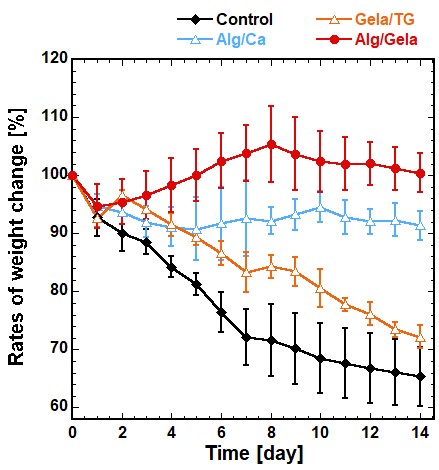
The prospect of regenerating organs and tissues would bring new possibilities of improving current treatments or find solutions for untreatable situations, thus having an enormous impact in the quality of life of patients. Tissue Engineering has been integrating principles of engineering, chemistry, materials science, biology and health sciences in order to develop regenerative-based therapeutic strategies combining stem cells and biomaterials. From the different sources of biomaterials, polysaccharides have been proposed to produce matrices able to interact favourably with cells. Due to their hydrophilic nature and richness in chemically active groups, such polymers can be used to produce a variety of structures fabricated using aqueous-based or other environmental-favourable procedures. Examples are shown in the modification of polysaccharides from marine origin and processing of devices into different sizes and shapes (e.g. hydrogels, multilayered coatings and membranes, particles) with structural and functional characteristics suitable to be used in tissue engineering and regenerative medicine applications. In particular, distinct strategies involving bioinspired approaches and nano/micro-technologies will be shown to engineer hybrid soft systems containing cells, in the form of microparticles, microgels or thin films, that could give rise to biomedical devices using bottom-up strategies.
Human skeletal muscle myoblast (HSMM) sheet transplantation is promising therapy for severe heart failure. The myoblast sheet has proved to secrete multiple cytokines such as vascular endothelial growth factor (VEGF), hepatocyte growth factor (HGF) and fibroblast growth factor-2 (FGF-2), which associate with cardiac functional improvement. The purpose of this study is to explore the regulation of cytokine productions and the impact of human skeletal muscle fibroblasts (HSMFs) on the regulation in HSMM sheet. Our current results demonstrated that cell density/myo-myo contact regulate the VEGF production in HSMMs. The VEGF productivity was high at low density in HSMM culture and vice versa while the productivity was low and unchanged by cell density in HSMFs. By varying ratio of HSMFs, it was shown that the VEGF productivity was increased by 2-fold (maximum level) by addition of small population of HSMFs (at 15%) in HSMM culture but the productivity was more reduced at higher ratios of HSMFs. For HGF, the productivity was HSMF ratio dependency and HGF was undetectable in HSMM culture alone suggesting that HGF was mainly secreted from HSMFs. Furthermore, FGF-2 was undetectable in all conditions. By using a cell tracking system and time-lapse observation, we found that HSMFs showed fast-random migration and disrupted myoblast alignment in HSMM culture. This evidence implied that a minor population of HSMFs in HSMM culture might promote VEGF productivity through physical myo-myo contact disruption. Our studies provided the fundamental understanding of VEGF regulation, which is useful to develop complex HSMM sheet or engineered tissue for transplantation, and highlight the role of fibroblasts on VEGF secretion regulation from adjacent tissue in pathological conditions.
Islet allotransplantation is a forthright approach to restore normoglycemia without daily, lifelong insulin injections. Nevertheless, the majority of the islets are lost almost immediately after transplantation due to poor access to nutrients from lack of vascularization which results in need of multiple donors for a single operation. In order to address this issue, highly-porous polymeric scaffold was fabricated as an implantable bioartificial pancreas utilizing modular tissue engineering approach. Pancreas β-cells were immobilized in three-dimensional scaffold and studied for its functionality as bioartificial pancreas in 7-day perfusion culture. During the 1-week perfusion culture, the amount of glucose consumption was observed decreasing and the produced lactate remained relatively low and constant in the cell-laden micro-scaffolds. Referring to the glucose-dependent function, the insulin secretion kept increase during the perfusion culture. Additionally, as visualized by live/dead staining, the immobilized cells remained viable after 7 days of perfusion. The β cells seemed to persist in clusters rather than separated single cells. These results demonstrated the potential of the micro-scaffold to maintain aerobic respiration for cultured cells, which could be resulted from the highly porous structure of the constructs.
AMBIC (AMBIC.org) is an industrial–academic–government consortium dedicated to addressing research and development challenges in upstream cell culture bioprocessing identified by the 22 industrial and 2 government members. Focal areas of the center include industrially-relevant biology, process monitoring and control, and consensus and standardization issues. Proposed areas of common interest to industrial members are elucidated through summer workshops organized around the topical areas of cells, raw materials, processes, and equipment, resulting in a call for proposal to academic members. Academics then present proposals which are voted on by industrial members to yield 2-year research and development projects in academic labs that address these biomanufacturing challenges under the guidance and mentorship of our industrial sponsors during monthly meeting. These activities have resulted in the start-up and execution of approximately 18 active and several graduated research projects under way at the academic participating institutions including Johns Hopkins University, University of Delaware, University of Massachusetts, Lowell, Clemson University, and University of Maryland, College Park. This presentation will discuss the activities of the AMBIC center followed by an overview of the projects underway within AMBIC. Projects currently under way include efforts to develop a community reference cell, process, and media, elucidating the solubility of nutrient concentrates and chemical complexes, understanding and manipulating the epigenome, identification of inhibitory waste products, sensors development for Surface Enhanced Raman Spectroscopy (SERS) and “Smart Marbles”, adaptation of process models for cell culture media and process feeding, controlling glycolytic pathways through chemical additives, and evaluating extracellular vesicles, ER stress pathways, and host cell proteins,. Progress obtained on these projects will be discussed along with a description of how the biopharma ecosystem is partnering and collaborating to identify and address critical common biomanufacturing challenges.
The monoclonal antibodies (mAbs) are widely used to produce therapeutic proteins. The rapidly evolving market for mAbs including biosimilars is making it necessary to realize superior manufacturing processes regarding costs and time. Generally, production in continuous mode can improve process efficiency. Continuous manufacturing for mAbs is intensively researched for individual unit operations in the upstream (e.g., perfusion) and downstream (e.g., chromatography using simulated moving bed), and for the end-to-end process. However, it is yet to establish process design models that can indicate when the novel continuous mode becomes more beneficial than the conventional batch mode.
We present a simulation-based approach for designing mAb production processes considering the continuous mode as an alternative. Differential equation models for cell cultivation and protein A separation have been applied based on fundamental physical phenomena. The model parameters were estimated using production data from a pilot scale research facility for the production of mAbs from Chinese hamster ovary (CHO) cells. After confirming the model performance using the production data, we performed economic process assessment. Different scenarios were considered regarding the operation modes, i.e., batch or continuous, and equipment, i.e., single-use or multi-use, for the individual units as well as the end-to-end process.
The simulation results indicated that the favorable scenarios varied in the upstream and downstream depending on the production scale and the CHO cell performance. The superiority of the fully integrated continuous process has been seen regarding productivity. Sensitivity analysis revealed the relevance of the cell performance, which was represented by the maximum doubling and death rates in the model. This finding will open up a new research opportunity to connect cell design with product and process design on a simultaneous basis.
Chinese hamster ovary (CHO) cells have been widely used as a host for biopharmaceutical protein production. Usually, producer cell lines are established from a recombinant cell pool containing thousands of cells with random integration of transgene. Thus, the screening of producer cells is time-consuming and labor-intensive process. We have previously reported an accumulative transgene integration system (AGIS) using Cre-recombinase and mutated loxPs, in which transgenes can be efficiently introduced into a chromosomal locus carrying a loxP target site [Kameyama et al., Biotechnol. Bioeng., 105, 1106–114 (2010); Obayashi et al., J. Biosci. Bioeng., 113, 381–388 (2012)]. In this study, the system was applied for establishing high-producer CHO cells. The founder cells, in which a mutated loxP and an expression cassette encoding the red fluorescent protein (DsRed) were introduced into the hprt locus of CHO cell genome, were used. An expression cassette of anti-prion scFv-Fc was introduced into the donor plasmids. Cells were transfected with donor plasmids and Cre-expression vector by lipofection or electroporation. To accelerate the screening process, the target cells were selected by change in color of reporter fluorescent proteins. Simultaneous transgene integration from two donor vectors was possible for the screening of cells with multiple copies of transgene. A minicircle DNA vector as a donor facilitated the transgene integration. We obtained targeted CHO cells with 6 copies of transgene into the hprt locus after three rounds of transfection and screening. The scFv-Fc productivity increased corresponding to the transgene copy number. This procedure is promising for the generation of producer cell lines for the production of pharmaceutical recombinant proteins.
This work was supported in part by grants for developing key technologies for discovering and manufacturing pharmaceuticals used for next-generation treatment and diagnoses, both from METI and AMED under Grant Number JP17ae0101003.
Digital counting of fluorescent signals generated in many small compartments can significantly improve the detection sensitivity of quantitative PCR and enzyme-linked immunosorbent assay (ELISA). However, the reported digital ELISA systems still need extensive washing steps to remove background signal, which hampered its performance. To address this problem, creation of a vesicle (Protocell) array that amplifies the binding signal of external protein as a fluorescent signal was attempted. We chose mutant β-glucuronidase (GUS) as a reporter enzyme that needs assembly of the four subunits by the dimerization of dimers, and which is inhibited by a set of interface mutations. Using a thermostabilized GUS mutant IV-5, we screened out an interface mutant (M516K, F517W) to create IV5m - a mutant with high thermostability and activity that is inactive on its own but becomes active when dimerized. After tethering short N-terminal tag and transmembrane (TM) sequences derived of epidermal growth factor receptor, the fusion protein was expressed by a cell-free protein synthesis system inside protocells, which were formed by the centrifugation of inverted emulsion. When corresponding tag-specific antibody was applied outside of the protocells, a clear increase in GUS activity was observed inside vesicles by adding fluorescent substrate, probably due to spontaneous integration of the expressed protein into the vesicles and dimerization by the antibody bound to the displayed tag. Furthermore, using a flow cytometry (FCM) digital signal was obtained by counting fluorescent protocells in response to external anti-His6 antibody concentration. Furthermore, SpyTag/SpyCatcher system was tested on this biosensor by expressing SpyTag-TM-IV5m in protocells, and adding His6-tagged SpyCather protein and anti-His6 antibody outside of protocells. An antibody dose-dependent increase in the population of fluorescent protocells was also detected by FCM, implying its potential applicability to antigen detection system. We are now testing the single molecule detectability of the system.
Acknowledgement: SICORP of JST.
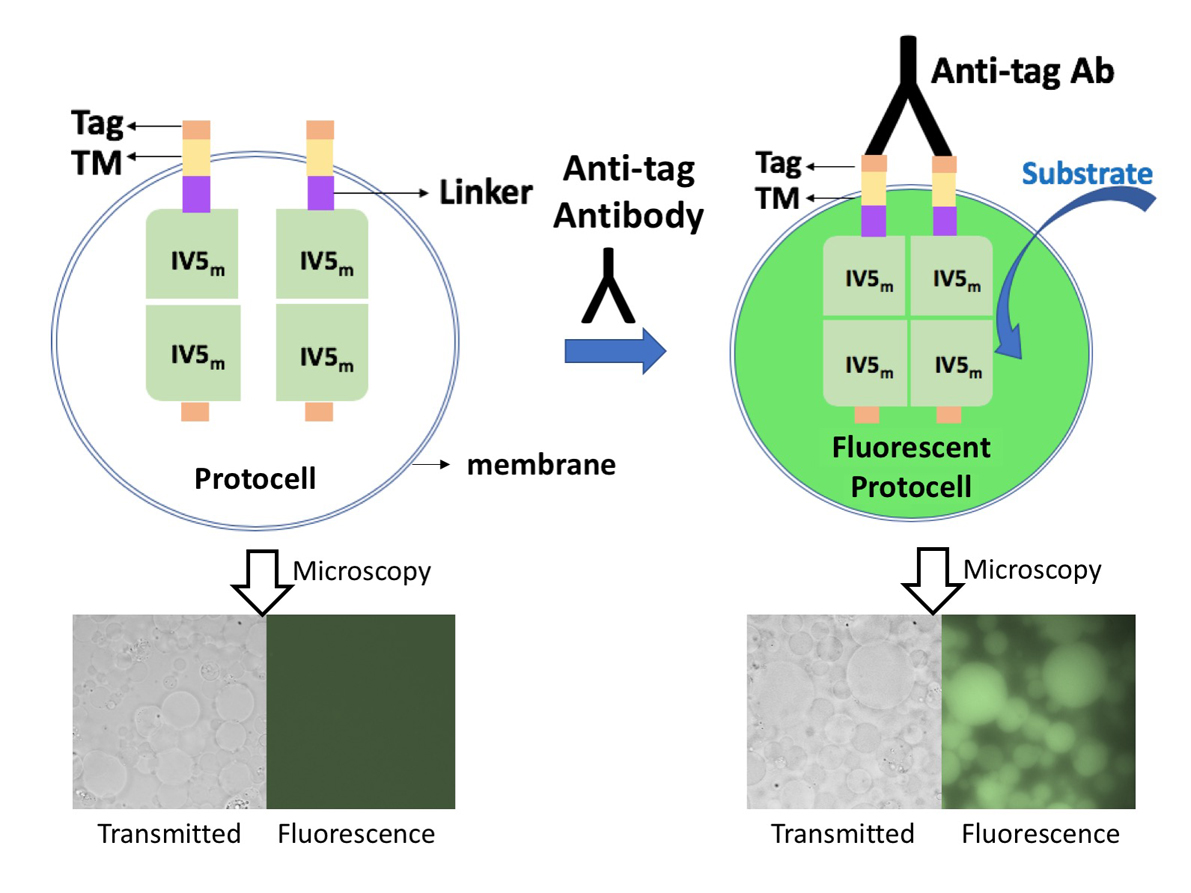
In the last years, the demand for human induced pluripotent stem (hiPS) has increased along with the progress of the clinical trials. This trend indicates the necessity for establishing freezing processes of hiPS cells for preservation and transportation. Generally, there are two methods for freezing cells: slow freezing and vitrification. In the field of cryobiology, both experimental and modeling studies have been conducted on slow freezing. The process can benefit from scalability, simplicity in operation, and no direct contact with freezing agent. However, the process could suffer from the quality variation intracontainer, and intra- and interfreezer.
We present a model-based design of slow freezing processes for hiPS cells considering the quality variation inside a container (i.e., a vial). A single-cell model was developed that integrated mechanistic models describing a radial and temporal temperature profile, cell volume change through transmembrane water transport, and intracellular ice formation during slow freezing. The overall inputs of the model are the cooling rate of the freezer, the vial diameter and material, and the cryoprotective agent type. The outputs are the maxima of cell volume change and the intracellular ice crystal volume as the cell quality indicators, and the required freezing time as the productivity indicator.
The model showed sufficient performance compared with a recently reported experimental study on hiPS cells. Based on this confirmation, the model was applied for three design cases. The choice of a cryoprotective agent, cooling rate, and vial diameter significantly affected the quality evaluation. When considering the productivity, the optimal vial diameter changed depending on the cell demand and the acceptable intracellular ice crystal volume. In the ongoing work, we are performing rigorous performance assessment of the model by extensive experiments. Advanced process optimization such as dynamic temperature optimization is another ongoing subject.
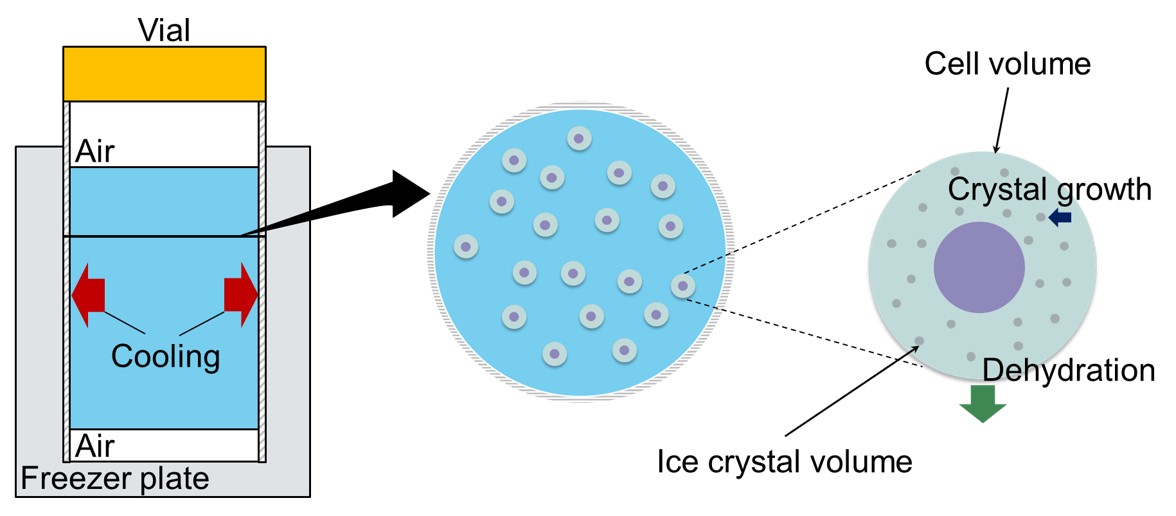
In recent years, researchers have shown an increase interest in lung disease owning to worse air pollution globally and high pulmonary attention. Several studies have examined issues related to the development of pulmonary administration of drug delivery. Yet, they still face several problems with the effectiveness of preclinical predictions on human drug responses and the shortage of high fidelity in organ-level cell testing without breathing simulation in vitro. The aim of this study was to fabricate a live and simple bronchial-like monitor with breathing motion mechanism for pulmonary drug testing. This bronchial-like monitor is regulated by deformation of the elastic membrane, leading to spontaneously air flow passing in and out. The deformation of membrane is dominated by different diameters of microchannel embedded in the bronchial-like monitor. The restriction of microchannel is contributed from the liquid flow controlled by a peristaltic pump. Therefore, the breathing mechanism can be manipulated by liquid flow rate and channel size. When liquid flow rate sets to be 0.84 ml/min (shear stress is 0.15 dyn/cm2), 328 μl/min of air flow rate and 0.49 dyn/cm2 of shear stress can be generated in the airway channel of the monitor. Additionally, the pattern of pressure drop in the airway channel also shows periodic tendency as successfully mimicking breathing motion of human. The Reynold number notes to be 0.30 that fully supports the laminar air flow in the bronchial-like airway. Furthermore, we cultured lung carcinoma A549 cells in the monitor with cyclic air flow to recapitulate the physiological relevant bronchial-like breathing model. This model, in the future, can be utilized to reconstruct the human healthy bronchiolar epithelium and to observe the toxicity and efficacy of pulmonary drug with breathing motion mechanism.
The intranasal delivery of vaccines has recently emerged as an attractive alternative to injection. The main mechanism of the intranasal vaccination is that the antigens in the vaccine transport via M cells in the nasal epithelium, then resident dendritic cells capture antigens and process them to induce the immune responses. However, it shows several disadvantages: short residence time of the antigens in nasal cavity due to the rapid nasal mucociliary clearance and weak immune responses due to the inefficient antigens transportation to the immune system.
To overcome these issues, a Solid-in-Oil (S/O) nanodispersion technique was developed for intranasal vaccine delivery. It is based on nanodispersions of hydrophilic antigens coated with hydrophobic surfactant molecules in an oil vehicle. Surfactant molecules and the oil vehicle could increase the nasal residence time of the antigens due to its mucoadhesive effect. Moreover, nanosized particles is expected to improve the delivery efficiency of the antigens to the immune system and induce strong immune responses (Fig.1).
We investigated the potential of intranasal vaccination by using S/O nanodispersions loaded with a model antigen ovalbumin (OVA). S/O nanodispersions containing OVA in different oil vehicles were prepared and the formulation using squalene oil was chosen due to the small particle size. Moreover, nasal absorption and nasal residence time of OVA were assessed to be increased by S/O nanodispersions. Finally, the OVA-specific antibody levels from serum and nasal mucosal washes from the mice were evaluated after intranasal vaccination. We found that intranasal administration of S/O nanodispersions induced strong mucosal and systemic immune responses and could be used for the future intranasal vaccination.
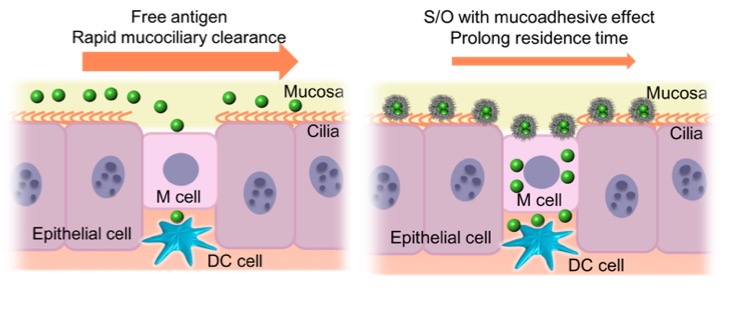
Transdermal delivery has been developed as one of the most attractive administration methods of vaccine antigen, which is safe and convenient. In transdermal vaccination, we need to deliver antigen to the immune cell in the skin to start the immune response. However, it is difficult for hydrophilic macromolecules such as protein to be permeated into the skin due to hydrophobic barrier function of stratum corneum; the outmost layer of skin. In recent years, it has been reported that skin permeability of the antigen is enhanced by using a solid-in-oil (S/O) nanodispersion, in which hydrophilic substances were coated with a hydrophobic surfactant and dispersed in oil as nanometer-sized particles. The purpose of this research is to prepare a practical transdermal vaccine by S/O technique from commercially available injection vaccine, in which antigen is dissolved in saline because osmotic pressure of injection vaccine is adjust with body fluid. In this study, fluorescein isothiocyanate-labeled ovalbumin (FITC-OVA) and isopropyl myristate (IPM) were used as a model antigen and an oil base with skin penetration effect, respectively. To check the effects of salts on nanoparticle formation and skin permeability, FITC-OVA was initially dissolved in saline according to commercially available vaccine and prepared S/O nanodispersions. As a result, it was confirmed that the particle diameter increased and the skin penetration amount decreased in the sample of high salt concentration. It is shown that it is important to reduce the salt concentration to make a transdermal vaccine from injection one.
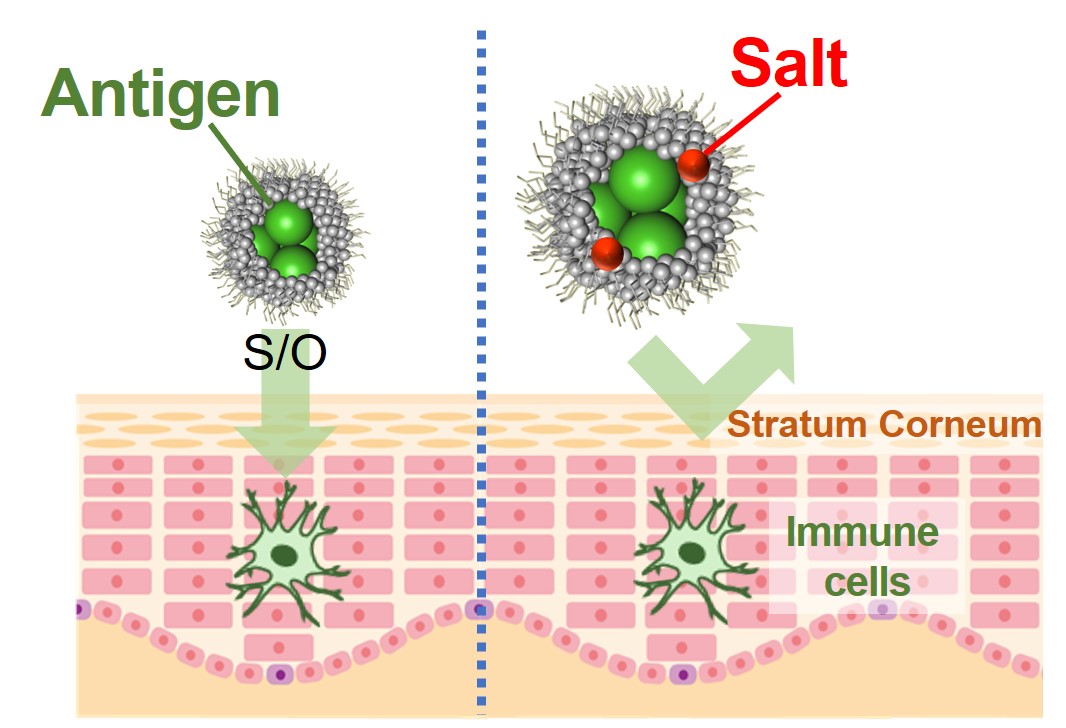
Stem cells are attractive source for tissue engineering applied on regenerative medicine, translational medicine, and drug discovery. Batch type culture is the typical way for stem cell culture, which is laborious and expansive. Moreover, the digestive enzymes or EDTA solutions to detach cells are causing cell damage and increasing production costs. For reducing the costs, we developed the continuous culture system culturing the human embryonic stem cells (hESCs) on thermoresponsive polymer surfaces (Fig. 1). hESCs could be detached from the thermoresponsive polymer surfaces by reducing the medium temperature below the lower critical solution temperature (LCST) of the thermoresponsive polymer (poly-N-isopropylacrylamide and its copolymer). After reducing the temperature, the thermoresponsive surface will become more hydrophilic, creating an unfavorable environment for cell attachment. Thus, hESCs can be partially detached by gentle pipetting. The remained cells could be confluent again by adding fresh medium. This continuous culture system could be used for 3D-cultivation. However, the barrier of applying this system is hESCs became harder to attach on the thermoresponsive surfaces coating with the extracellular matrix (ECM) after multicycles. This maybe cause by degradation of ECM after long-term culture. Therefore, we investigated the precoated and uncoated methods with different ECM; recombinant vitronectin (rVN) and recombinant laminin-511 (iMatrix-511). Comparing with traditional precoated method, the uncoated method where ECM is added into culture medium upon seeding cells, provides cost-effective and time-efficient method and maintains hESCs pluripotency during long-term culture. This uncoated method applied to continuous culture system saves processing time and cost and contributes to the regenerative medicine.
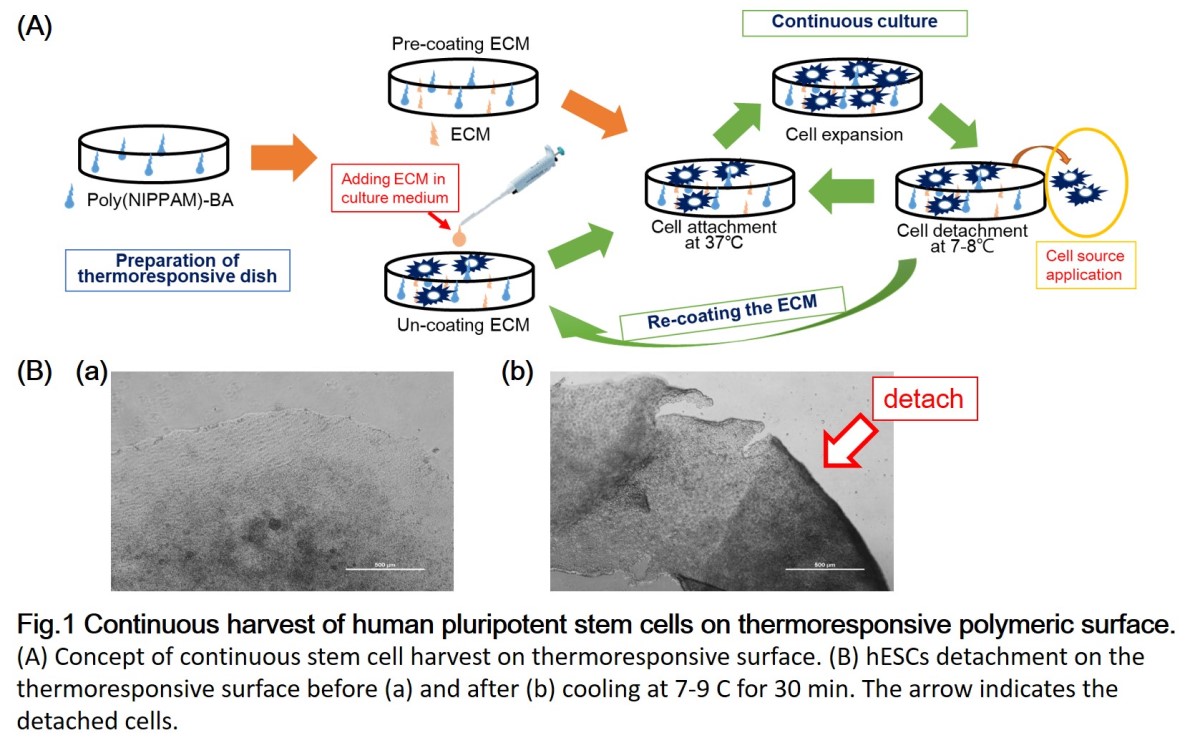
Transdermal delivery has been developed as one of the most attractive administration methods of peptides, which are used as biopharmaceuticals for refractory diseases or synthetic antigens for vaccination including cancer treatment or prevent from infections. In transdermal vaccination, we need to deliver peptide antigen to the immune cell in the skin to start the immune response. However, it is difficult for hydrophilic macromolecules such as peptides to be permeated into the skin since stratum corneum; the outmost layer of skin shows the hydrophobic barrier function. In this study, we developed oil-based formulation of peptides mediated by ionic liquid (IL) in order to achieve the efficient skin permeation. We used cytotoxic T cell epitope peptide (OVA 256-264, sequence: SIINFEKL) as a model peptide. This peptide is hydrophilic and not soluble in isopropyl myristate (IPM), which is an oil base with skin penetration effect. To disperse the peptide in IPM, the ILs consisting of choline cation and fatty acids anion were synthesized. These ILs are biocompatible and show high affinity to oil because they are derived from natural molecules and fatty acids have long alkyl chains. We successfully dispersed the hydrophilic peptide in IPM by adding the ILs and ethanol as co-solvent. Subsequently, we checked whether the peptide in oil formulation shows skin permeability and the permeation mechanism of peptide. The peptide with ionic liquid in oil formulation permeated into the model mouse skin, while the penetration of peptide in aqueous phosphate buffer was low. Moreover, we revealed that this ionic liquid in oil acts as the skin permeation enhancer by extracting and disordering the lipid in the stratum corneum. These results suggested that oil-based formulation using biocompatible ILs is a promising strategy for transdermal peptide delivery.

Vaccines are the most useful means for preventing infection, in which antigens are mainly administered by injection, and induce a systemic immune response in whole body to eliminate pathogens. In the case of an oral vaccine, antigens are captured M cells and delivered into Peyer's patches, lymph node-like lymphatic tissues, by the transcytosis, followed by the presentation of mucosal immunity. The ability of oral vaccines to activate mucosal immunity is attractive compared to injection because it is possible to prevent the initial infection. In this study, we tried to develop an oral vaccine delivery using a solid-in-oil (S/O) nanodispersion, in which hydrophilic drugs are coated with hydrophobic surfactants and dispersed in oil phase as nanoparticles. In addition to prevention of antigen degradation by low pH or enzymes, it is expected that the antigens are effectively delivered to the lymphatic tissues using oil-bases because hydrophobic materials such as lipids are known to be formed micelles and absorbed by lymphatic tissues rather than blood circulation. The S/O nanodispersion was prepared using ovalbumin (OVA) and sucrose fatty acid esters as a model antigen and surfactants, respectively. From in vitro release study using artificial intestinal fluid containing lipase and bile acids, the S/O nanodispersion using sucrose laurate (L-195) and perilla oil showed higher antigen release, while that using sucrose erucate (ER-290) and squalene oil released antigens gradually, resulted from the length of alkyl chain of surfactants and ester bonds of oils. From the oral vaccine study in vivo, the OVA-specific IgA production in the small intestine of mice was increased by the S/O nanodispersion using ER-290 and squalene oil compared to aqueous vehicle, phosphate buffered saline (PBS). These results suggested that the S/O nanodispersions releasing antigens gradually is suitable to deliver antigens to Peyer's patches, and induced mucosal immunity effectively.

Introduction.
Vancomycin is the drug of first choice for treating Methicillin-Resistant Staphylococcus Aureus (MRSA) infections which is the main causative bacteria of nosocomial infection. Therapeutic drug monitoring (TDM) of VCM is strongly recommended in order to prevent side effect and creation of the resistant bacteria. However, TDM does not work sufficiently, because frequent measurement of blood level of VCM is still difficult. We developed a blood-VCM sensor with a paste electrode of graphite particle on which a molecularly imprinted polymer (MIP) is immobilized covalently in this study. The sensitivity of the sensor to the VCM concentration in whole blood and plasma was evaluated.
Experimental method.
Graphite particles were coated with photoinitiator of radical polymerization was dispersed in a polymerization solution and irradiated with xenon lamp light. The MIP carbon was mixed with silicone oil and filled in a glass tube to prepare a carbon paste electrode immobilizing MIP of VCM.
The analyte solvent was prepared by dissolving VCM in phosphate buffer, bovine whole blood or plasma, and the relationship between current obtained by differential pulse voltammetry and the VCM concentration was observed.
Results and Discussion.
The calibration line of the VCM-MIP electrode is compared in each analyte solution at Fig. 1. First, the electrode indicated sensitivity to VCM in all analyte solutions. However, the sensitivity in plasma is about twice as high as in PBS or whole blood. It can be thought he detection of VCM is not interfered by blood cells. But oxidation of uric acid, or other kind of oxidative species in plasma enhances background current and oxidative current of vancomycin. But the enhancement is probably suppressed by the blood cells. However, the result indicates that the VCM-MIP electrode enables the sensing of VCM in whole blood without separation between the plasma and blood cells. The property is advantageous for real time monitoring of VCM.
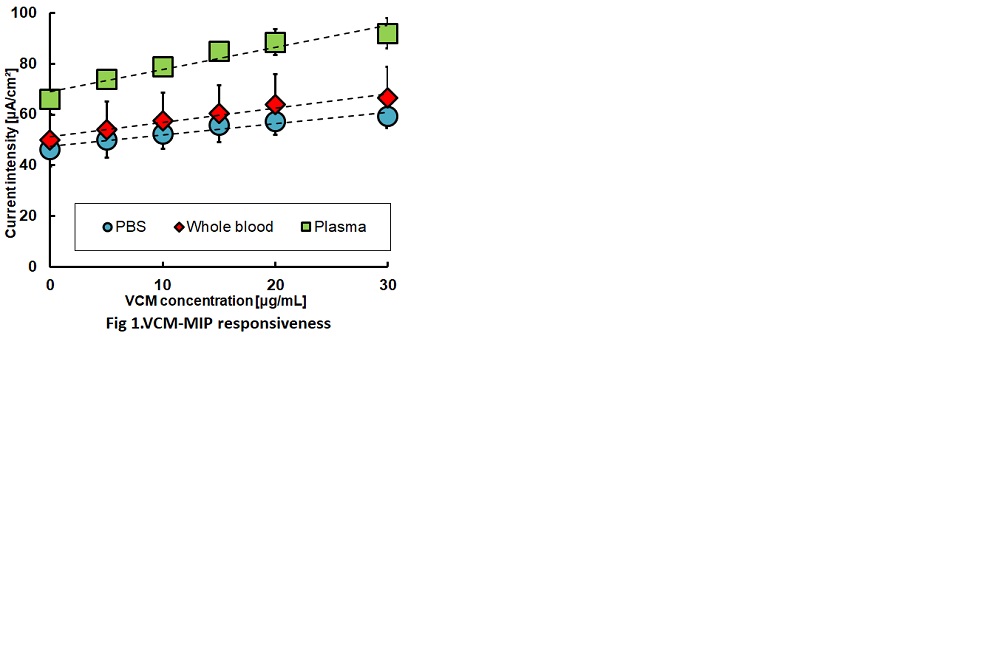
Human pluripotent stem cells (hPSCs) includes human embryonic stem cells (hESCs) and human induced pluripotent stem cells (hiPSCs) are a promising source for regenerative medicine and tissue engineering. Typically, hPSCs are used to culture on the extracellular matrix (ECM) coated dishes, such as Matrigel, recombinant vitronectin (rVN) and laminin-521 (LN-521), which were secreted from animal or human cells. However, those ECMs provided uncertain chemical composition. Therefore, the xeno-free synthetic biomaterials offer not only a chemical defined composition but also a reproducible culture condition.
In our previous study, we successfully cultured hPSCs on polyvinylalchohol-co-itaconic acid (PVA-IA) hydrogels, with optimal crosslinking elasticity, conjugated with vitronectin-derived oligopeptides (KGGPQVTRGDVFTMP), which provide RGD binding motifs for cell adhesion. The further key cell binding mechanism will be investigated by using PVA-IA hydrogels grafted with synthetic peptides from different chain compositions. Those synthetic peptides chains contain five variants of α-chain, four variants of β-chain and three variants of γ-chain of laminin, respectively. These synthetic peptides will be investigated by comparing the ability to support long term hPSCs culture and differentiation into cardiomyocytes (CMs). Therefore, we prepared PVA-IA hydrogels grafted with different oligopeptide sequences derived from Laminin α-chain (RGD), α1-chain (IKVAV) and β1-chain (YIGSR and PDSGR) to compare the efficiency of cell attachment and differentiate into CMs (Fig. 1). We also design some motifs with different length of joint segment to mimic the original ECM and evaluate the length effect on the culture of hPSCs. In this study, the expression four pluripotency gene (Oct3/4, Klf4, Sox2, and Nanog) of hPSCs is evaluated for ability to support hPSCs growth. hPSCs are induced into cardiomyocytes to screen the optimal synthetic peptide. We expected to screen the optimal combination of synthetic peptides for hPSC culturing and differentiation.
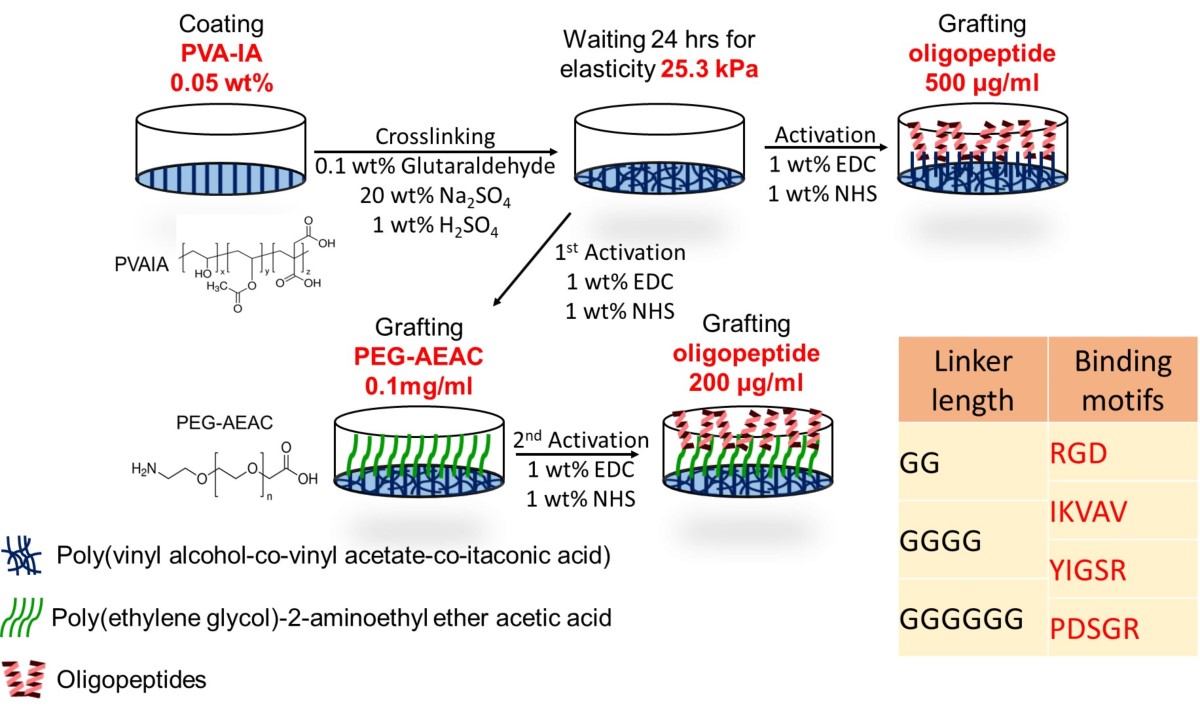
Cancer vaccine, a prophylactic therapy against cancer by administering a cancer antigen to activate the host immunity, has come to draw a great deal of attention due to its low risks of side effects. In this study, we focused on the transcutaneous drug delivery system for the cancer antigen delivery. This delivery route would be the ideal way, because skin immune cells are known to induce a strong immune response. However, the stratum corneum (SC), the outermost layer of the skin, works as a hydrophobic barrier to prevent the penetration of antigens which are mostly hydrophilic. To overcome this problem, we tried to use Reverse Micelle Formulation (RMF). In RMF system, hydrophilic drugs are enclosed inside the aqueous core of reverse micelles and dispersed in oil phase which SC prefers. Despite there were numerous reports regarding transcutaneous delivery using RMF, there was no report on a transcutaneous vaccine due to its still low skin permeability. In this study, we used amphiphilic Skin Permeation Enhancer (SPE) as surfactant which forms reverse micelles to realize even higher permeability. To the best of our knowledge this is the first report on this strategy, and we conducted experiments to prove its effectiveness.
We chose K-TRP-2 (KKKGSVYDFFVWL) peptide as a cancer antigen, and fatty acid glycerol ester as amphiphilic SPE. By dropping the aqueous solution of antigen onto surfactant-containing oil, we obtained uniform RMF. As a result of in vitro experiment, RMF showed a significant improvement in skin permeation of antigens. Also, RMF enabled the successful antigen delivery to the skin immune cells, which is a key step to induce an immune response, and its transcutaneous treatment recruited more cytotoxic T lymphocytes into tumor microenvironment than an injection treatment and strongly suppressed a tumor growth.
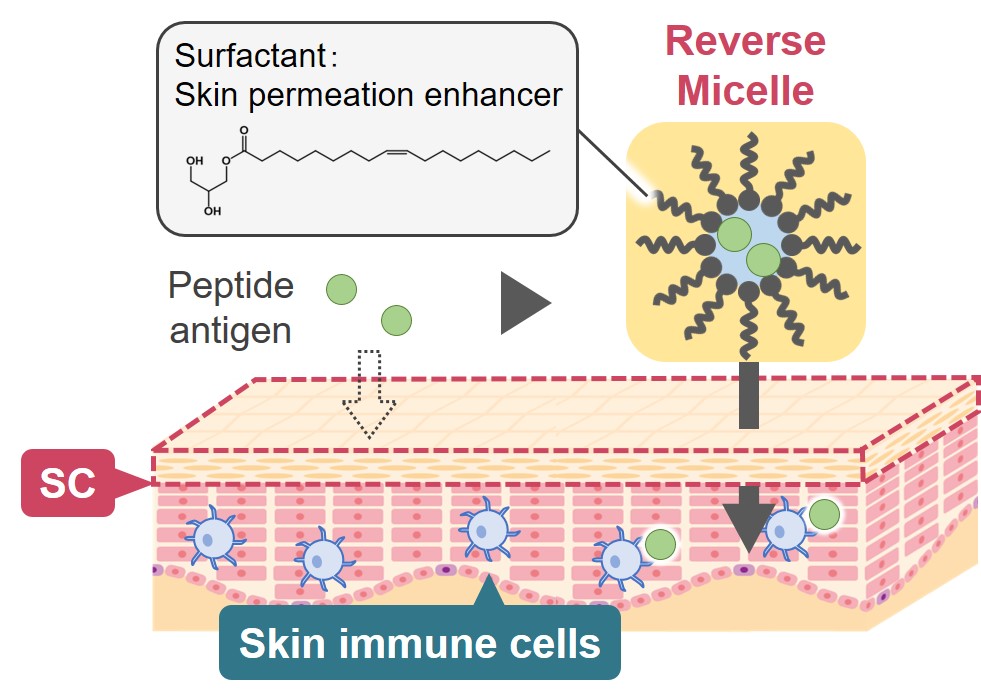
Preparation of three-dimensional (3D) organ models composed of liver cells is expected as an efficient approach to in vitro cell-based drug screening and development. Various types of hydrogel-based 3D cell culture systems have been developed, but the lack in the capillary networks in hydrogel matrices causes severe problems in terms of insufficient supply of oxygen and nutrition. Here we proposed a facile strategy for creating perfusable hydrogel-based liver cell culture systems. We utilized a bicontinuous aqueous two-phase dispersion, which was composed of polyethylene glycol (PEG)-rich and gelatin methacrylate (GelMA)-rich phases, to produce cell-encapsulating microporous gelatin-based hydrogels. The interconnected pores were utilized to perform perfusion culture of encapsulated HepG2 cells.
We first prepared an aqueous two-phase system of PEG/GelMA, and then remixed the separated two phases by controlling the mixing ratio, with the addition of a photopolymerization initiator and cells. Immediately after mixing, the GelMA-rich phase was photocrosslinked by irradiating UV light, to form millimeter-sized tablets of microporous sponges. We confirmed that most of the encapsulated cells were viable during this mixing and crosslinking processes, and after cultivation for 1 week. In contrast, cells encapsulated in uniform GelMA hydrogel were mostly dead after 1 day of cultivation. The expressions of hepatocyte-specific genes were upregulated for the hydrogel sponges, which was confirmed by RT-qPCR. Additionally, we performed perfusion culture of the cells, by packing the obtained hydrogel sponges into microfluidic perfusion chambers, and evaluated the functions of the encapsulated cells. The presented hydrogel sponges are useful because we did not need any complicated devices or protocols for preparing hydrogel sponges, and they would be applicable as a unit platform for organs-on-a-chip systems.
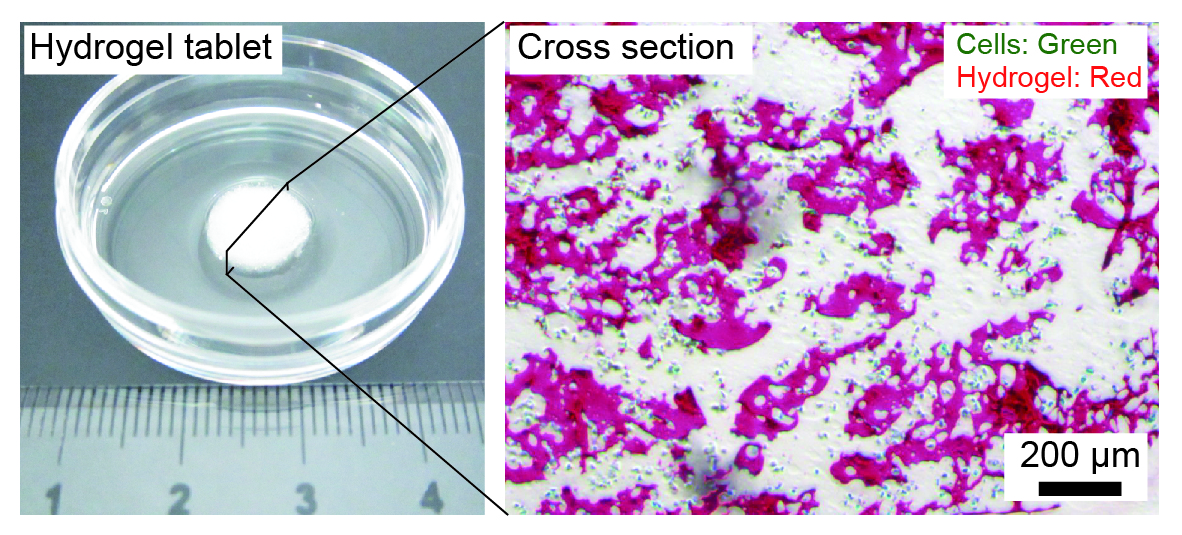
In this study, we report synthesis of hydropholic surface and active-target superparamagnetic iron oxide nanoparticles (SPIONs) for hyperthermia cancer therapy. Superparamagnetic iron oxide nanoparticles (SPIONs) capping oleic acid were prepared by thermal decomposition method. The synthesized iron oxide nanoparticles were encapsulated with the polyaspartamide (PA) to enhance their biocompatibility and hydrophilicity (PA-encapsulated SPIONs). A polysuccinime (PSI) which is biocompatible and biodegradable is the backbone of PA. In addition, multifunctional polymers including hydrophilic O-(2-aminoethyl) polyethylene glycol (PEG) and hydrophobic octadecylamine (C18) were grafted on PSI for amphiphilic structure, and on biotin for increasing the cancer cellular uptake. The diameter of the PA-encapsulated SPIONs was confirmed by TEM and DLS. The structure of the polyaspartamide was confirmed by 1H NMR. The structure and biomedical properties of PA-encapsulated SPIONs were investigated in vitro and in vivo experiments.

A vaccine is a drug that administers an antigen derived from a pathogen to the body and induces antigen-specific immunity. In the case of therapeutic vaccines, it consists of antigens and adjuvants (additives to enhance the immune response), and various delivery systems that deliver them to immune cells have been reported. In several studies, strong vaccine effects were induced using intelligent lipid or polymer-based delivery systems. However, most of the candidates have not been put to practical use because novel, synthesized compounds must be confirmed the safety in human. Mostly, it takes over 10 years to accept to use clinical phase, and it is hard to balance high safety and effect of vaccine delivery. To overcome this problem, we used a clinically accepted adjuvant, oil-in-water (O/W) emulsion, as vaccine carrier. Though it has high safety and effect for human, the efficiency is limited because hydrophilic antigen and O/W emulsion are administered separately. In this study, we tried to create a solid-in-oil-in-water (S/O/W) adjuvant that encapsulates antigens in oil phase using solid-in-oil (S/O) technology and can simultaneously administer antigen and adjuvant. Composition of S/O/W adjuvant is based on MF59, commercially available O/W emulsion, and ovalbumin (OVA) was used as a model antigen. The S/O/W adjuvant was determined as a nano-sized emulsion (ca. 300 nm) and over 90 % of antigen was encapsulated after 24 h. From in vitro study using dendritic cells, efficient intracellular delivery and lysosomal escape of antigens were achieved by S/O/W adjuvant. Furthermore, when S/O/W adjuvant was administered subcutaneously to mice in vivo, the antigen-specific humoral and cellular immunity was induced more effectively than O/W emulsion and OVA free. These results suggested that S/O/W adjuvant, which can achieve co-delivery of antigen and adjuvant, is a novel approach to develop effective carriers for therapeutic vaccine such as cancer immunotherapy.

Virus-like particles (VLPs) can be produced using recombinant DNA technology by expressing viral surface proteins that spontaneously assemble into particulate structures similar to authentic viral particles. VLPs serve as safe and effective vaccines and diagnostic antigens. The baculovirus–insect cell system has been used extensively for the production of a wide range pf VLPs. However, the baculovirus system has several inherent limitations including contamination of VLPs with progeny baculoviruses. Stably transformed insect cells can be used as attractive alternatives to the baculovirus–insect cell system. In the present study, the production of influenza VLPs by recombinant insect cells was investigated.
The DNA fragments encoding hemagglutinin (HA) and matrix protein 1 (M1) of an influenza virus A (H1N1) were individually cloned into the plasmid vector pIHAbla and pIHAneo. The pIHAbla and pIHAneo contained the Bombyx mori actin promoter downstream of the B. mori nucleopolyhedrovirus (BmNPV) IE-1 transactivator and the BmNPV HR3 enhancer for high-level expression, together with either a blasticidin or a neomycin resistance gene for use as a selectable marker, respectively (Yamaji et al.: Biochem. Eng. J., 41, 203–209 (2008)). After cotransfection with the resultant plasmids, Trichoplusia ni BTI-TN-5B1-4 (High Five) cells were incubated with blasticidin and G418, and cells resistant to the antibiotics were isolated.
Western blot analysis of a culture supernatant showed that transfected High Five cells secreted HA and M1. Sucrose density-gradient sedimentation analysis and dynamic light scattering of the culture supernatant suggested that secreted HA and M1 molecules were produced in a particulate form. Hemagglutination assay using chicken erythrocytes revealed hemagglutination activity in the culture supernatant. Taken together, recombinant insect cells may offer a promising approach to the development and production of influenza VLPs.
Mesoporous silica nanoparticles (MSNs) conjugating doxorubicin (DOX) via a pH-sensitive cleavable linkage, hydrazine (HYD) were synthesized. MSN-HYD-DOX were encapsulated with the polyaspartamide (PASPAM) grafted with the hydrophilic o-(2-aminoethyl)-o′-methylpoly(ethylene glycol) (PEG) and the cell permeating ligand, biotin (Biotin). The chemical structure of the synthesized MSN-HYD-DOX and PASPAM-g-PEG/Biotin was confirmed using FT-IR and 1H-NMR spectroscopy. The mean diameter of the MSN-HYD-DOX@PASPAM-g-PEG/Biotin nanoparticle was 142 nm and 121 nm, respectively, examined by dynamic light scattering (DLS) and transmission electron microscope (TEM). The HYD bond was effectively cleaved in acidic condition, and thus DOX was released much faster at pH 5.0 than at pH 7.4. The cell viability in MSN-HYD-DOX@PASPAM-g-PEG/Biotin system was much lower than that of the free DOX drug because of efficient intracellular drug delivery associated with the biotin ligand.
Gene delivery methods for animal cells are one of the most important tools in biotechnology fields such as gene therapy, generation of transgenic animals and pharmaceutical protein production. We have attempted to develop a gene transfer method based on retrotransposon. Retrotransposons are mobile elements that transfer themselves in a cell genome by the “copy-and-paste” mechanism. The process is known as retrotransposition. A retrotransposon, long interspersed element-1 (LINE-1, L1) is categorized as a non-LTR retrotransposon, comprised of a 5' untranslated region (5'UTR), two non-overlapping open reading frames (ORFs) separated by a short inter-ORF sequence, and a 3'UTR that ends in an adenosine-rich tract. We constructed an L1-based vector plasmid including the essential components for retrotransposition. An intron-disrupted Neor reporter gene and a scFv-Fc expression unit under the control of CMV promoter were inserted into 3'UTR region in order to evaluate retrotransposition and scFv-Fc production. CHO-K1 cells transfected with the plasmids were screened using G418 for 10 days. The established cell clones produced scFv-Fc proteins in the culture medium. To control retrotransposition, we removed the ORF2 sequence from L1 vector to generate ORF2-deleted L1 (L1[$Delta;orf2]) vector, and constructed ORF2 expression vectors (pORF2 and pORF1-2) for providing ORF2 proteins. Under the optimal ratio of L1[$Delta;orf2] vector and ORF2 expression vector, no significant difference in the number of G418-resistant colonies formed was observed compared with that for L1 vector although it slightly decreased. The scFv-Fc gene was detected in all clones by genomic PCR. Real-time PCR revealed that scFv-Fc gene was integrated into the genome at the range from one to six copies in the clones.
Stem cells are an attractive prospect for regenerative medicine and tissue engineering. However, stem cell are difficult to differentiate into specific cell types. Thus, reliable methods to differentiate stem cells into desired cell types are necessary to be developed. Here, we developed nanosegment-grafted biomaterials having different elasticity. [1] We also developed optimal differentiation media to induce the differentiation of hES cells into cardiomyocytes. We developed several biomaterials having different elasticity for hPSCs differentia-tion into cardiomyocytes. We prepared (1) ECM (extracellular matrix)-coated dishes, (2) PVA-IA (polyvinylalcohol-co-itaconic acid) hydrogel dishes having different elasticity that are grafted with several ECMs [2], and (3) PVA-IA hydrogel dishes having different elasticity that are grafted with cell-adhesion oligopeptide (oligovitronectin). We also investigated the differentiation efficiency using different induction medium: (a) Commercial cardiomyocyte induction medium, (b) RPMI 1640 medium supplemented with B27 and bovine serum albumin (BSA), (c) CDM3 medium (xeno-free culture medium) developed by literature [3] and in this study. On day 0, we replaced the expansion medium into cardiomyocytes differentiation medium containing the GSK3β inhibitor. On days 1-2, we observed that 30%~40% of the cells in the medium shown in medium (a) and 50~60% of the cells in the medium (b) were died and detached from the surface. However, the center of the colony of living cells were getting thicker and became compact. These cells were differentiated into cardiomyocytes on days 5-6. On day 8-10, we successively observed the contracting colonies on each biomaterial surface. We successfully screened the optimal elasticity of bio-materials, preferable nanosegments immobilized on the biomaterials as well as the cell culture medium for the optimal differentiation of hPSCs into cardiomyocytes. This system will be used for developing for cell sorting system, which will be a great benefit to its clinical application in regenerative medicine.
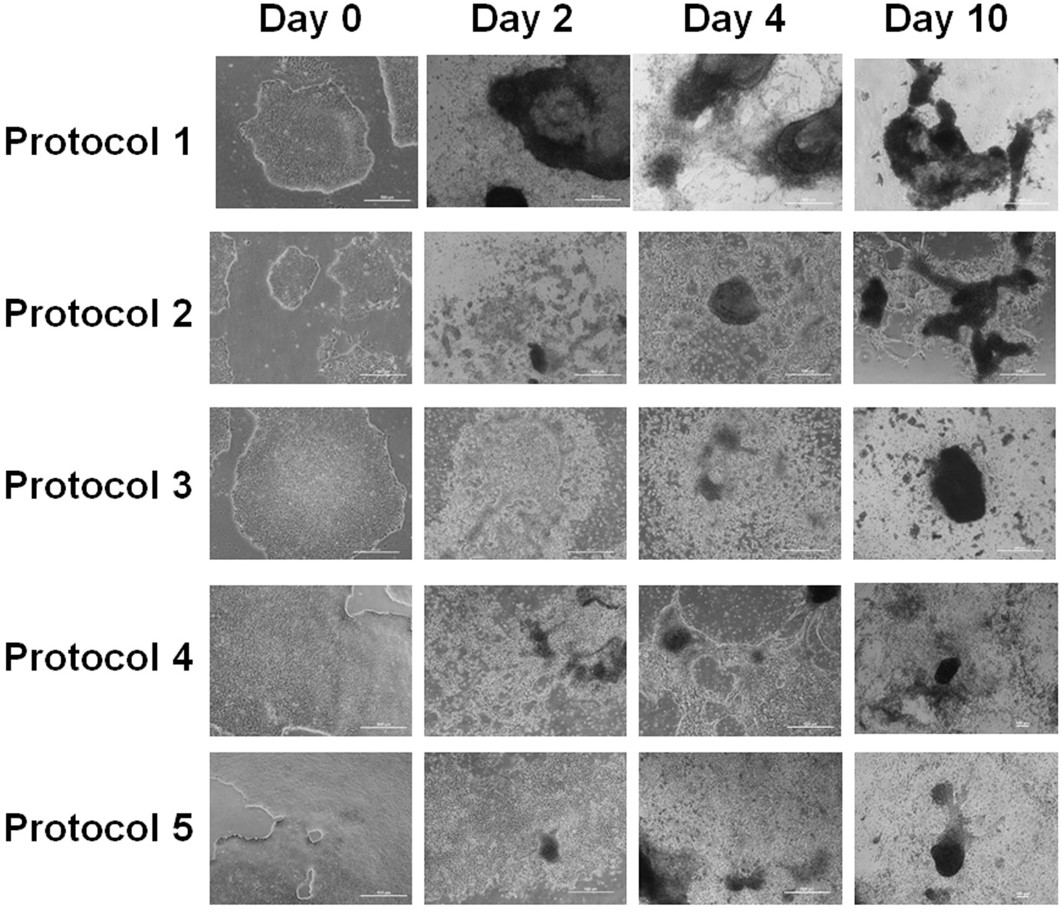
For acute and fulminant liver failure patients, liver transplantation is only an effective treatment. However, it has a big problem in donor organ shortage. As a bridge use for liver transplantation, bio-artificial liver (BAL) systems with extracorporeal blood circulation have been an attractive choice. For constructing BAL systems in which functional hepatic cells are filled in a bioreactor, hepatoma cells derived from liver carcinoma are a candidate cell source due to their high proliferative capacity, although liver function of hepatoma cells is considerably lower than that of primary hepatocytes. In our previous study, genetically engineered mouse hepatoma cells with inducible high liver function were established by transducing liver-enriched transcription factor (LETF) genes (Yamamoto et al., Biochem. Eng. J., 2012, 60, 67-73; J. Biosci. Bioeng., 2018, 125, 131-139). In this study, human hepatoma HepG2 cells were genetically engineered to express liver function in response to heat treatment. For this purpose, we constructed a heat-inducible expression of LETF genes, in which a tetracyclin-responsive artificial transactivator is expressed under control of a heat-shock protein promoter with transcriptional amplification and the transactivator then induces LETF genes. The gene expression system was constructed on transposon vectors and introduced into HepG2 cells. Transgenic cells (HepG2/HSP/8F) were screened by drug (puromycin and blasticidin) selection. For inducing overexpression of LETF genes, cells were heated at 43 °C for 30 min using water bath. Albumin secretion and cytochrome P450 activity were measured for the cells with or without heat treatment. The liver functions of HepG2/HSP/8F cells were enhanced by the heat treatment. The cells with heat-inducible liver function can be a new cell source for various hepatic studies including construction of BAL systems.
Encapsulation of water-insoluble bioactive compounds using chitosan-oleic acid complex particle was investigated. One-step preparation of chitosan-oleic acid complex particles encapsulating bioactive compounds with a narrow diameter distribution was carried out by the simple mixing of a chitosan aqueous solution and an ethanol solution containing oleic acid at room temperature. The formation of particles with mean diameter below 1 micrometer was confirmed by dynamic light scattering and laser diffraction measurements. A characteristic peak indicating aggregation of alkyl chain of oleic acid molecules was observed by small angle X-ray scattering measurement, suggesting that the particle had hydrophobic domains formed by aggregation of oleic acid molecules inside the complex particles. These characteristics agreed with scanning-transmittance electron microscopic images of complex particles. Various water-insoluble compounds including curcumin, capsaicin, and vitamin E were successfully encapsulated into the complex particles. Diameter distribution of the complex particles encapsulating bioactive compounds were maintained during storage over a month, suggesting that the particles were highly stable. The particle suspension could be concentrated by evaporation and powderized by freeze-drying without significant changes in their diameter. The results demonstrated that our method for encapsulating water-insoluble hydrophobic bioactive compounds using chitosan-oleic acid complex particles were potentially applicable as edible materials for development novel food dispersion systems.
A local anesthesia (LA) relieves the sense of a specific part of the body. It is used in the medical procedure for needle puncture or venous cannulation. The main administration of LA is injection, but this method is not only invasive and painful but also requires specialized knowledge and risk of secondary infection, so an alternative administration is required. Transdermal delivery of LA has advantages that enable to bring anesthesia effect without any pain and difficulty. The transdermal LA is available in commercial, but the current marketed product is not popular because it cannot eliminate pain completely and needs long-term continuous administration. Therefore, we aim to improve the effect of transdermal local anesthesia using non-aqueous base materials. Previously, the relationship of the pharmacokinetics and pain-relieving effect of LA are not revealed completely. These facts make difficult to improve analgesic effectiveness of LA. In this study, we conducted early clinical study in human and compared the results obtained in clinical trials with in vitro studies in laboratory scale. We used lidocaine as LA, and polyethylene glycol 400 (PEG400), isopropyl myristate (IPM) and isopropyl alcohol (IPA) as the base. In clinical study, we found that LA using IPA induced actual analgesic effectiveness and achieved painlessness within 10 minutes. On the other side, we found that IPM showed high permeation across the pig skin in vitro. It is suggested that high permeability across the skin did not lead improving analgesic effectiveness. Subsequently, we measured the amount of drug in the skin, and the sample using IPA as the base showed highest amount of lidocaine in the skin (shown in Figure 1, SC: stratum corneum). It is suggested that staying drug in the skin leads improving actual analgesic effectiveness because the result of clinical study corresponds with the result in vitro.
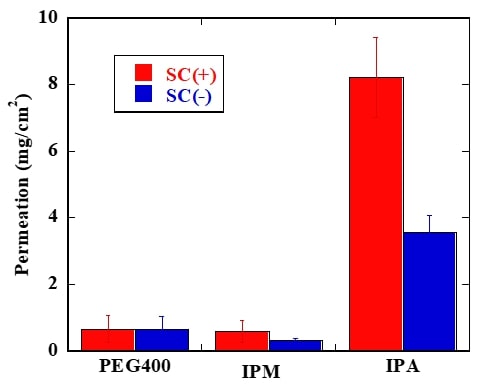
In recent years, the number of Japanese cedar pollinosis patients are increasing, and pollinosis immunotherapy has attracted much attention. However, the administration of a whole pollen allergen by injection has the risk of side effects such as anaphylactic shock. In this study, we tried to develop a simple, non-invasive method of pollinosis immunotherapy by the way of transcutaneous administration and used cedar pollen T cell epitope peptide A (PepA: SMKVTVAFNQFGP) with a low risk of adverse effects as an antigen. The presence of stratum corneum (SC) which is the hydrophobic barrier in the outermost layer of the skin makes it difficult for the hydrophilic antigen to penetrate the skin. To overcome the barrier, antigens were dispersed in hydrophobic solvent as nano-order particles using the solid-in-oil (S/O) nanodispersion, in which antigens are coated with hydrophobic surfactant molecules, to permeate through the SC. In this study, K-PepA, in which hydrophilic trilysin was conjugated to PepA, was used to increase the solubility in water and stability of the S/O nanodispersion.
First, the mice were vaccinated with K-PepA thrice with a one-week by injection. One week after the final immunization, splenocytes were harvested and T cells were quantified using flow cytometry. Similar to PepA, an increase in the number of Th1 cells was observed by K-PepA, suggesting the efficacy for pollinosis immunotherapy. Second, the S/O nanodispersion was obtained by freeze-drying the water-in-oil emulsions containing K-PepA in water phase and surfactant, a sucrose laurate in oil phase, and dispersing it in isopropyl myristate. The permeability of K-PepA enclosed in S/O nanodispersion to mouse skin was evaluated in vitro and a significant improvement in permeability was confirmed as compared with the PBS solution. These results suggest that the S/O nanodispersion containing K-PepA is a promising approach to effective transcutaneous pollinosis immunotherapy.
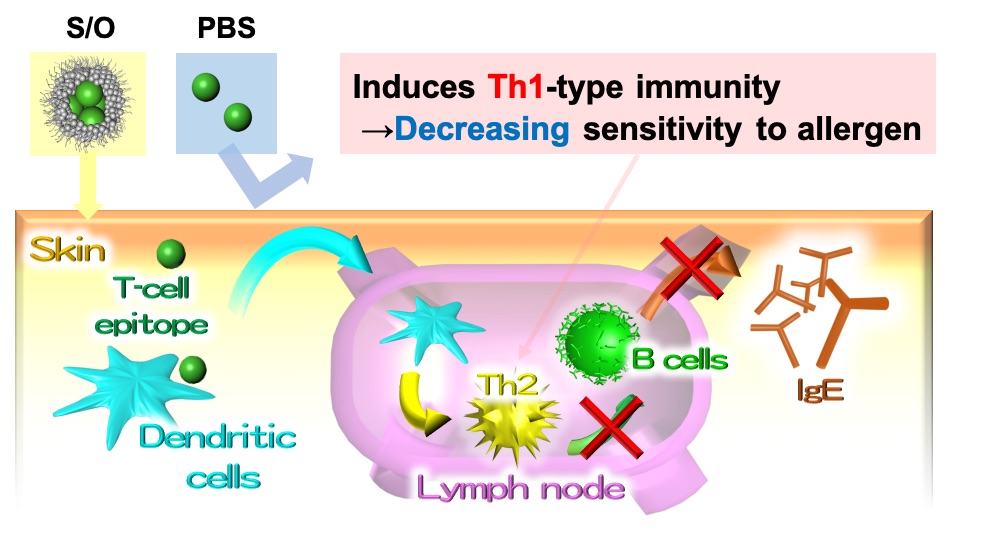
Transdermal drug delivery system (TDDS) is a drug administration method that has attracted attention in terms of safety, convenience, and low invasiveness. However, it is difficult for hydrophilic micromolecular drugs to be delivered into the skin surface since the stratum corneum, which is the outermost layer of the skin, has a hydrophobic barrier function. Therefore, it is effective to use a method of dispersing drugs in an oil base having a transdermal penetration promoting effect, but hydrophilic drugs are not soluble in oil base. In this study, the use of ionic liquids (ILs) to solubilize poorly soluble substances was considered. It is important that ILs are low toxicity and consist of biocompatible materials. So far, choline has been used as a cation in many reports on the application of ILs to TDDS. In this presentation, we synthesized a new biomaterial-based IL using ethyl esterified β-alanine as the cation, and compared with a choline-based IL. In both ILs, oleic acid was used as the anion, which is expected to have high affinity to oil base. We selected ovalbumin epitope peptide as a model drug. The peptide is hydrophilic and was insoluble in oil base, isopropyl myristate (IPM), but the addition of the β-alanine-based IL succeeded in dispersing the peptide in IPM. On the other hand, the peptide is not clearly dispersed in a simple mixture of IPM and choline-based IL. Furthermore, when the permeability of the peptide to pig skin in vitro was evaluated, it was hardly penetrated by the aqueous phosphate buffer solution because of stratum corneum's hydrophobic barrier function, but showed high permeability by the solution dispersed in IPM using β-alanine-based IL. These results suggest that the combination of a new biomaterial-based IL using amino acid as the cation and IPM is a useful strategy for TDDS.
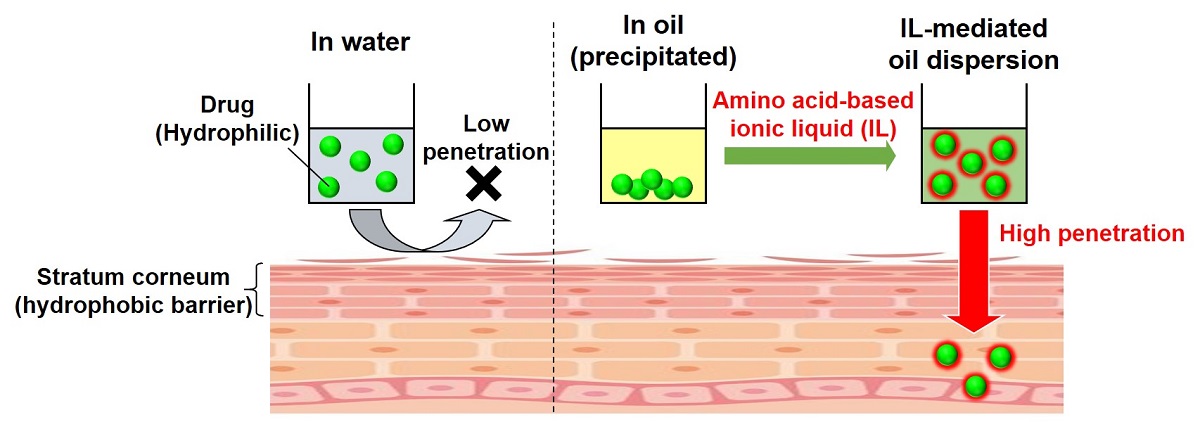
Vaccine is the most effective way to prevent infection by administrating antigen to enhance immunity. Currently, most vaccines are administrated by subcutaneous injection, but it has some problems. Therefore, transcutaneous immunization has attracted attention as a new vaccination method. Transcutaneous immunization is a novel vaccination strategy that delivers antigens to intact skin topically to induce protective immune responses. This needle-free strategy is easy-to-use, safe, and low invasive compared with conventional subcutaneous injection. The starting point of transcutaneous immune mechanism is a capture of antigen by dendritic cells (DCs) in the skin. DCs as a strong immune response inducer, could be expected by the transcutaneous route. However, the skin surface is covered with hydrophobic stratum corneum, which make it difficult to deliver hydrophilic antigens to DCs. To overcome this difficulty, we developed a novel formulation of nano-dispersed solid-in-oil (S/O). The novel S/O formulation can be prepared only by high-speed stirring, and it can contain various additives in large amounts. In this study, we tried to improve the vaccine effect by two approaches of promoting skin permeation and activating immune cells, by adding skin permeation enhancer and adjuvants to the novel S/O formulation.
On the study of antigen uptake by DCs, after 12 hours of vaccine administration to mice, skin cells were analyzed by flow cytometer. As a result, the novel S/O formulation containing skin permeation enhancer and adjuvant significantly increased the antigen delivery rate to the skin DCs, it is 4 times of aqueous solution. In the evaluation of vaccine efficacy, blood antibody level after vaccine administration was measured. As a result, the novel S/O formulation induced antibody production equivalent to injection.
In conclusion, by adding skin permeation enhancer and vaccine adjuvants to the novel S/O formulation, we succeeded the development of transcutaneous vaccine which has an effect comparable to injection.

In recent years, biopharmaceuticals have attracted much attention. This is because they are considered effective for diseases that cannot be treated with conventional small drug molecules. Therefore, there is a need to establish a useful method for administering biopharmaceuticals to patients. At present, administration methods for such biopharmaceutical are limited to injection, because oral administration degrades protein molecules, which are the main active ingredients of pharmaceuticals, by digestive enzymes. On the other hand, injection administration is less convenient because it requires a medical doctor, and it often involves the risk of needle stabbing and pain. In the present study, we aim to establish a simple and safe administration method to replace injection and focus on transdermal administration. For the purpose, we need to overcome the serious problem of transdermal administration, which is a strong barrier of skin surface for transdermal delivery of biomolecules. In this research, we proposed a novel drug carrier called “reverse micelles” for the transdermal drug delivery. Reverse micelles are oil-based molecular assembly, in which various kinds of biomolecules can be entrapped into the water cores. Focusing on the fact that the skin surface is hydrophobic, we thought that the entrapped biomolecules in reverse micelles could permeate into the skin. This reverse micellar method has been used for small molecule drugs so far, however it has not been applied to large biomolecules such as peptides or proteins. In this study, we have developed reverse micelle formulation that enables successful transdermal delivery of biomolecules, and discussed the permeation mechanism by reverse micelles.

In the production of pharmaceuticals, xenoantigens derived from animal cells and animal-derived materials may be present in the final products. These compounds are often problematic and must be identified. Among them, xenoantigen carbohydrates have immunogenic effects and difficult to remove from drugs because they bind to proteins.
Anti-αGal is a natural antibody in humans. Binding of this antibody to αGal antigens (αGal epitope) expressed on porcine xenograft surfaces is a major factor affecting engraft survival. Recently, studies showed that some therapeutic antibodies and cell processing materials used in reproductive medicine contain the αGal epitope. Another major xenoantigen is N-glycolylneuraminic acid (Neu5Gc). An enzyme is responsible for Neu5Gc synthesis; when the gene encoding this enzyme is mutated, humans cannot synthesize Neu5Gc. Humans produce antibodies against Neu5Gc glycan as heterogenous structures, causing the immunogenicity of therapeutic proteins containing Neu5Gc glycan epitopes. Therefore, rapid and robust methods for detecting the αGal epitope and Neu5Gc are required. We chemically synthesized various structure-defined N-glycans including human-type glycans (G0, G2, and SG), uniform isomers (6-G1 and 3-G1) and heterogenic antigens including αGal or Neu5Gc. We also produced high-grade 2-AB-labeled N-glycans. These compounds are suitable for mass spectrometry, capillary electrophoresis, and high-performance liquid chromatography analyses. We simultaneously developed polyclonal antibodies that specifically bind to xenoantigen carbohydrate, αGal, and Neu5Gc using chicken. Some antibodies were modified with fluorescent probes or enzymes for versatile detection.
In this poster, we introduce new methods for detecting xenoantigen carbohydrates in cell culture supernatants or purified antibodies with our reagents. Xenoantigen carbohydrate attached to Fc and/or Fab regions of the antibody can be detected using our methods. We also introduce a method for detecting xenoantigens in the cell culture supernatant in the early stages of cell establishment.
Biological membranes are dynamic and heterogeneous lipid bilayer structures involved in numerous cellular processes, not only as simple boundary but also active uptake of external molecules. A new approach, termed as membrane-lipid therapy, has proved the possibility that some of lipophilic molecules can show therapeutic effect as like drug, by interacting with biomembrane. Therefore, the alteration of lipid membrane properties has been expected to promise a novel and great potential of therapeutic effect. Here, a self-assembled pro-drug system have been investigated, focusing on controlling the self-assembly behavior by surroundings such as pH. Pro-drug structures were inspired from self-assembling fatty acids (FAs). FAs are amphiphilic molecule with hydrophobic carbon chain and hydrophilic carboxyl group, whose phase states strongly depend on pH condition and molecular structure. The aryl carboxylic acids Oxaprozin (Oxa), a main kind of nonsteroidal anti-inflammatory agent, was chosen as model molecule and designed to Oxa-lipid prodrug molecules possessing carboxyl group with different carbon chain length and achieved control of drug self-assembly behavior under different pH conditions. Designed pro-drug molecules achieved the control of drug self-assembly behaviors based on pH condition, which could realize the development of biological microenvironment-sensitive drug delivery system. It can be expected that the variation of self-assembly structure might contribute to enhanced therapeutic efficiency.
Reference: P.V. Escriba et al., Trends Mol. Med., 12, 34 (2016). Han J. et al., J. Phys. Chem. B, 121, 4091 (2017). M. Bucciantini et al., FASEB J., 26, 818 (2012).

Supramolecular polymers based on molecular self-assembly has attracted attention in fabricating bio-functional materials because of design diversity and biomimeticity in structural and functional aspects.[1] Self-assembling peptide amphiphiles (PAs) undergo spontaneous supramolecular assembly in aqueous solutions and have shown a potential in the use in biomedical applications, such as drug delivery carriers. In this study, we developed a novel co-assembly system based on PAs to fabricate a carrier that enables the control of assembled structures. To encapsulate small molecular drugs into PA nanomaterials, we introduced a complementary hydrogen bonding interaction into PAs and drug derivatives. Cyanuric acid (Cya) and melamine (Mel) derivatives are known complementary hydrogen bonding pair, which forms 3:3 network structure called rosette, thus we synthesized Cya-conjugated PAs (Cya-PAs) and Mel-attached model drug (Mel-NBD). To vary the assembled structures to study the influence of the structural aspects on the efficiency in intracellular drug delivery, several hydrophobic substituents of Cya-PAs were introduced; from C0 (Cya-PA1), C6 (Cya-PA2), to C12 (Cya-PA3). When Cya-PAs and Mel-NBD were mixed in a 1:1 molar ratio, they formed distinct nano-assemblies. Interestingly, the morphologies and dimensions of the assemblies were highly dependent on the PA design; i.e. globular objects (~100 nm) were observed with Cya-PA1, whereas fibrous assemblies were obtained with Cya-PA2 (2-300 nm) and Cya-PA3 (> 1 μm). In vitro study on intracellular delivery of Mel-NBD using HeLa cells showed that the cellular internalization efficiency increased in the form of assembly compared with Mel-NBD alone. Moreover, the cellular uptake was differed by the size of the carrier. These results indicate that this co-assembly system provides controllable nanostructures for an efficient delivery of small molecular drugs.
[1] R. Wakabayashi et al., Chem. Commun., 2019, 55, 640–643.
Metabolism and differentiation of culture cells are influenced by changes in cellular morphology, cell-cell and/or cell matrix interactions, and medium components, and so on. To control the destiny of cells, it is important to understand the relationship between these parameters and cell properties. In this study, we focused on the effects of cellular morphology on cell properties. Monolayer culture has been widely used as a conventional culture technique. On the other hand, a spheroid (spherical organoid) culture has been established as typical three-dimensional culture technique. In this study, we investigated the difference of cell proliferation and neuronal differentiation of NT2 cells, model cell of neural research, in the monolayer and spheroid cultures.
For the spheroid culture, we fabricated the microwell chip which consisted of 195 circular microwells (600 μm in diameter) on a poly-methylmethacrylate plate, and the surface was modified with polyethylene glycol to promote spheroid formation. Traditional tissue culture plate was used for monolayer culture. NT2 cells were cultured in a medium containing retinoic acid (RA), an inducer of neural differentiation.
In the monolayer culture, the cells adhered and extended on the plate. In the spheroid culture, the cells were aggregated in each microwell and formed the spheroid within 24 hours of culture, and the spheroid morphology was maintained during culture period. Although RA treatment suppressed the cell proliferation in both culture systems compared to RA non-treatment condition, the cell proliferation ability in monolayer culture was higher than that in spheroid culture. The neuronal differentiation ability of NT2 spheroid culture was higher than that of monolayer culture, and the differentiation ability was dramatically enhanced by RA treatment.
These results indicate that the proliferation and differentiation properties of NT2 cells are influenced by the difference of cell morphology.
Stimuli-responsive drug delivery systems have attracted attention because of their potential to maximize therapeutic effects and minimize side-effects. Recently, authors have developed an amphiphilic short-chain peptide (KHHA7), which consists of a hydrophobic domain based on seven alanine residues and a hydrophilic domain based on a lysine and two histidine residues (KHH), as a dispersant for a poorly water-soluble anticancer drug paclitaxel (Ptx). As the histidine residues form a stable chelate complex with intermediate metal ions such as Cu(II) and Ni(II), the dispersibility of the complex between Ptx and KHHA7 alters in the presence or absence of metal ions. In the present study, two analogs of KHHA7 (KHHA3WA3 and KHHA6W), in which one of the alanine residues in KHHA7 was substituted to a tryptophan residue, were prepared to investigate the effect of substitution on the dispersibility of the complex.
The amphiphilic peptides were chemically synthesized by Fmoc solid-phase synthesis method. The products were purified using HPLC and identified by MALDI TOF-MS. The complex between peptides and Ptx was prepared by mixing an aqueous solution containing the peptides as well as Cu(II) and an ethanol solution of Ptx, followed by removal of ethanol in vacuo and lyophilization. To the complex was added 0.10 mL phosphate buffer solution to evaluate of the apparent solubility of Ptx. When Ptx was complexed with the peptide alone, the dispersibility of Ptx was not significantly different from that of the blank sample. The apparent solubility increased with increasing the concentration of Cu(II). The dispersibility of Ptx complex using KHHA3WA3 and KHHA6W was comparable to that using KHHA7, suggesting that the effect of substitution to tryptophan on the complex stability is small.
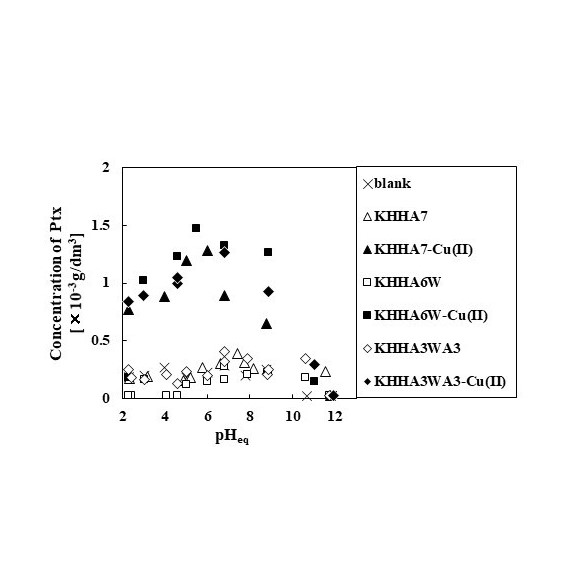
Mesenchymal stem cells including adipose-derived stem cells (ADSCs) are expected as a cell source for tissue engineering and regenerative medicine, because they can be differentiated to osteoblasts, chondrocytes, adipocytes, and so on. 2D monolayer culture that cells are extended on a culture substrate has been widely used as a conventional culture technique. On the other hand, 3D culture, such as spheroid (spherical organoid) and cell-sheet, has attracted attention as a new culture technique. In this study, we investigated the difference of ADSC properties in the monolayer (2D) and spheroid (3D) cultures.
As a spheroid formation platform for 3D culture, we fabricated a microwell which consisted of 195 circular microwells (400μm in diameter) on a poly-methylmethacrylateplate, and the surface was modified by polyethylene glycol to promote the spheroid formation. Traditional tissue culture plate was used as a monolayer culture platform for 2D culture. The cell proliferation and differentiation properties of ADSCs were compared between monolayer and spheroid cultures.
In the 2D culture, the cells adhered and extended on the culture plate, and proliferated during culture period. In the 3D culture, the cells were aggregated in each microwell and formed the spheroid within 6 hours of culture. The spheroid morphology was maintained in each microwell. However, the size of ADSC spheroids was almost same during culture period, and the cell proliferation of spheroid culture was suppressed than that of monolayer culture. The expression levels of differentiation marker genes (osteoblast, chondrocyte, and adipocyte differentiations) in the spheroid culture were higher than those in monolayer culture.
These results indicate that the proliferation and differentiation of ADSCs are influenced by the difference of cell morphology, and the spheroid culture is a promising method to promote the cell differentiation.
In development processes of anti-cancer drugs, cell-based assays have been used as one of drug screening techniques. Generally, monolayer culture of cancer cells has been utilized as in cancer model, but it is difficult to mimic morphology and environments of in vivo neoplasm. On the other hand, cancer cell spheroids, which are formed by the rearrangement and compaction of cell aggregates, have attracted attention as more useful solid cancer model. We have developed a spheroid culture platform, microwell chip, which can achieve size control, easy medium change, and spheroid mass production. In this study, we investigated the difference of drug responses of cancer cells in the monolayer and spheroid cultures.
The microwell chip consisted of 200 circular microwells (600 μm in diameter) on a poly-dimethylsiloxane plate, and the surface was modified by polyethylene glycol to promote the spheroid formation. Traditional tissue culture plate was used as a monolayer culture. HCT116 cells (colorectal cancer cell line) and doxorubicin (anti-cancer drug) were used as the cancer model cell and model drug, respectively. The cells were treated with different doxorubicin concentrations, and the changes in cell morphology and cell survival were evaluated in the both culture platforms.
HCT116 cells formed a single spheroid in each microwell within 3 days of culture. The spheroid growth was inhibited by the doxorubicin treatment, and the collapse phenomenon at outside region of spheroids occurred by the doxorubicin treatment of high concentration. In the monolayer culture, the cells were detached from culture plate with the increase of doxorubicin concentration. The cell survival rate against doxorubicin in spheroid culture was higher than that in monolayer culture, indicating that HCT116 spheroids have high drug resistance than monolayer culture.
These results suggested that spheroid culture has a potential as cell-based assay technique for drug screening.
Hybrid liposomes (HL) composed of L-α-dimyristylphosphatidylcholine (DMPC) and polyoxyethylene (25) dodecyl ether (C12(EO)25) were effective for therapeutics and detection for tumor of orthotopic graft model mouse of breast cancer.
In the therapeutic effects of HL for breast cancer, high inhibitory effects of HL without drugs on the growth of breast cancer (MDA-MB-453) cells were obtained along with apoptosis in vitro. Membrane fluidity of MDA-MB-453 cells treated with HL was significantly increased as compared with that of control and DMPC liposomes. We examined therapeutic effects of HL for orthotopic graft model mice of breast cancer after the inoculation to mammary gland. Reduction of tumor in the group treated with HL was observed, although enlargement of tumor in control and DMPC groups was confirmed on the basis of volume, weight and autopsy. Many apoptotic cells were observed in the tumor section of orthotopic graft model mice of breast cancer treated with HL using TUNEL method.
With regard to detection (diagnosis) on breast cancer using HL, enhanced selective accumulation (diagnosis) of HL/ICG including a fluorescence probe (Indocyanine green; ICG) only toward breast cancer cells having high membrane fluidity without affecting normal breast cells was confirmed in vitro. Enhanced accumulation of HL/ICG into the tumor of orthotopic graft model mice of breast cancer was observed into the tumor of orthotopic graft model mice of breast cancer was observed. These data indicate that HL accumulated in tumor cells in the mammary gland of the orthotopic graft mouse model of breast cancer for a prolonged period of time, and inhibited the growth of MDA-MB-453 cells.
Therapeutic effects by HL and detection (diagnosis) by HL/ICG of cancer with enhanced tumor accumulation for orthotopic graft model mouse of MDA-MB-453 for the use of HL as theranostics agents were revealed for the first time in vivo.
Specific binding on liposome of the trehalose with a high hydration power has been reported. Trehalose liposomes (DMTre) have been produced by using sonication of a mixture of L-α-dimyristoylphosphatidylcholine (DMPC) and α-D-glycopyranosyl-α-D-glucopiranoside monomyristate (TreC14) in buffer solutions with no organic solvent. Inhibitory effects of trehalose liposomes on the growth of tumor cells along with apoptosis have been reported. Growth inhibition against colon, gastric, hepatocellular and leukemia cells has been obtained using trehalose liposomes without drugs.In this study, we investigated inhibitory effects of trehalose liposomes on the proliferation of human breast adenocarcinoma ( MDA-MB-453 ) cells were examined in vitro and in vivo. DMTre with a hydrodynamic diameter less than 100 nm, were preserved for 4 weeks. The inhibitory effects of DMTre on the proliferation of MDA-MB-453 cells accompanied with apoptosis were obtained after the enhancement of accumulation of DMTre into MDA-MB-453 cell membranes. An increase in membrane fluidity of MDA-MB-453 cells treated with DMTre was observed on the basis of fluorescence depolarization method. DMTre suppressed the activity of NFκB. DMTre caused apoptosis for MDA-MB-453 cells through the activation of caspases and mitochondria. Suppression on the filopodia formation of MDA-MB-453 cell by DMTre was observed using confocal laser microscopy. Inhibitory effects of DMTre on the invasion of MDA-MB-453 cells was also obtained using invasion assay. Tumor weights on the xenograft model mice of MDA-MB-453 intravenously administered with DMTre markedly decreased as compared with those of the control group. Brown color indicating apoptotic cells was observed in many tumor cells of tissue section of tumor in xenograft model mice after the treatment with DMTre. DMtre suppressed metastasi in hepatic metastasis mouse model of breast tumor after the intrasplenic inoculation of MDA-MB-453 cells. Therapeutic effect of DMtre were also obtained using hepatic metastasis mouse model of breast tumor.
Among various drug delivery systems, micro/nanocarriers consist of liquid metal are being actively studied. Eutectic Gallium-Indium alloy (EGaIn) liquid metal has been reported to have a low melting point, low toxicity, and proper tissue/cell penetration. EGaIn has a characteristic property, deforming by the control of light and heat irradiations. In this study, we describe transformable liquid metal nanoparticles delivering anti-tumor drug molecules. These “nanotransformer” particles are synthesized through sonication, and extrusion of either EGaIn solution or EGaIn mixed with amphiphilic lipids. The resulting nanotransformers are loaded with an anti-tumor drug, doxorubicin that can be released upon deformation of EGaIn nanoparticles excited with light. The nanotransformer particles showed no toxicity in mammalian cells. A proper photo-thermal ligand added to the nanotransformer helped to increase the yield of deformed liquid metal nanoparticles, resulting in efficient drug delivery.
A phospholipid forms a self-assembled membrane such as micelles, bicelles and vesicles to reduce an exposure of hydrophobic chain groups in aqueous solution. Interestingly, bicelles are disk-shaped aggregates composed of long-chain phospholipids that make up a planar region and either detergent or short-chain phospholipids that compose flanking rims. They have an advantage over micelles in their ability to mimic natural membranes and, therefore, capture membrane proteins in their biologically relevant orientation as demonstrated in structural studies of the transmembrane segment, functional studies of membrane protein and drug delivery system.
Previously, we reported that as “bicelles”, are made of comprise a mixture of long-chained phospholipids (e.g., 1,2-dimyristoyl-sn-glycero-3-phosphocholine, DMPC) and short-chained phospholipids (e.g., 1,2-dihexanoyl-sn-glycero-3-phosphocholine, DHPC) at high concentration in aqueous solution, wherein DHPC detergents cover the rim of DMPC bilayer. In addition, bicelles can be reformed vesicles depend on a various condition such as total lipid concentration and DMPC/DHPC fraction ratios. However, it is very difficult to control of vesicle size by using simple flow microfluidic chip.
In this study, we demonstrate simple method to control the size of vesicles through dilution of bicelles solution by using microfluidic chip which has integrated with passive micromixer and microchannel structure to produce the flow focusing. The results shows that the final production is formed vesicle structure of ordered phase through fusion of bicelles. In addition, we verified the membrane properties with the membrane fluidity (1/P_DPH), polarity (GP340) and optical density (OD500). Our novel microfluidic chip has potentials to create a lipid vesicles which can be controlled size by using total flow rate ratio and DMPC/DHPC fraction ratio.

Quantum dots (QDs) are promising fluorescent probes for many biological applications because they have superior and unique optical properties in comparison to conventional organic dyes. Traditionally, covalent coupling is employed to immobilize or conjugate antibodies onto QD surface for preparation of QD-antibody immunoprobes. In this study, we proposed a simple and effective technique to conjugate CdTe QD with immunoglobulin G (IgG) antibody using high-affinity bifunctional peptides. First, five CdTe QD-binding peptides were obtained from phage display screening. To identify the shortest amino acid sequence needed for the QD-binding activity, the screened peptides were subjected to truncation assay using SPOT-peptide array. Linking the truncated peptides with an antibody Fc domain-binding peptide1 was later done to design mediate bifunctional peptides for bioconjugation of CdTe QD with IgG antibody. The affinities of bifunctional peptides to CdTe QD and IgG antibody were confirmed by surface plasmon resonance (SPR) system. Due to no extensive surface preparation steps and chemicals as covalent conjugations, the designed bifunctional peptides suggest simply and biological-friendly conjugation process of CdTe QD with IgG antibody. Our peptide-mediated molecule conjugation strategy would be beneficial in development of QD and antibody-based molecular imaging.
1Sugita, T. et al. Screening of peptide ligands that bind to the Fc region of IgG using peptide array and its application to affinity purification of antibody. Biochem Eng J. 2013, 79, 33–40.
Engineering of collagen-based hydrogels in microfluidic devices is a promising technology for cell culture experiments with well-controlled environmental parameters. However, it is not a trivial task to integrate microfabricated, cell-encapsulating hydrogels into microfluidic devices. Here we present a new approach to precisely engineering type-I collagen-based hydrogels in microfluidic devices, with the help of gelation agent-incorporating composite silicone substrates. We created microposts composed of polydimethylsiloxane (PDMS) and phosphate salt (Na2HPO4) powders, which work as a neutralizer for acidic collagen solution into collagen hydrogels selectively around the microposts. It was possible to encapsulate living mammalian cells into the hydrogels, which could be extended to perfusion culture of cells for organs-on-a-chip applications.
In the experiments, we fabricated PDMS microfluidic devices equipped with microposts with various morphologies, by soft lithography and replica molding techniques. After introducing an acidic collagen solution into the channel and incubating the solution for several minutes, washing buffer was introduced to remove the non-gelled collagen solution from the channel. As a result, we successfully fabricated collagen hydrogels selectively around the microposts (see the attached figure). Additionally, we were able to create vascular tissue models, when we employed a microchannel whose lumen was completely made of the composite PDMS substrate containing phosphate salt powders. Living mammalian cells could be encapsulated in the hydrogel matrices while keeping high cell viability, showing its applicability to perfusion cell culture. The presented strategy would be highly useful because we could fabricate collagen hydrogel-based microstructures in microfluidic devices without the need for complicated devices or operations.
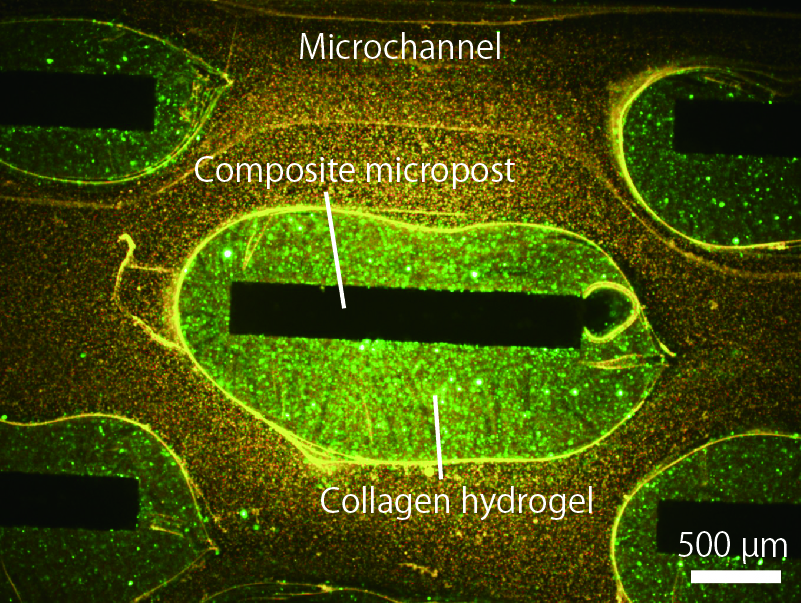
Neonatal hyperbilirubinemia, which is also called neonatal jaundice is a common symptom in the newborn. Bilirubin accumulates in the newborns' blood and high concentration of bilirubin is potentially toxic to the central nervous system, so it's critical to monitor the level of bilirubin. Current bilirubin diagnosis is still based on diazotization reaction and calibrated with the standards using an automated clinical chemistry analyzer to obtain the bilirubin value. The total measuring time is about 30 min. However, most of the diagnosis has to be completed in large hospitals or medical centers due to the costly diagnosis equipment. For those who lives in remote areas or are lack of medical resources, it's impossible to obtain immediate medical diagnosis.
In this work, we combine the advantages of paper-based diagnosis technology, the efficiency of the active separation process, and the aspects of the microfluidic platform to construct a bilirubin diagnosis chip which can measure the values of total, direct and indirect bilirubin. The diagnosis time of bilirubin chip can be controlled within 5 min and the requirement of sample volume is only one drop of the blood. The samples can be quantitatively analyzed by using the bilirubin chip directly and the colorimetric readout which can be obtained through a smartphone camera without using the expensive and bulky equipment. Moreover, we will establish a standard operating procedure for neonatal bilirubin testing and apply it directly to clinical trial. After the comparison of the clinical chemistry analyzer and transcutaneous bilirubin meter, we can establish a real time, easily operate, and precise bilirubin testing system to meet the goal of point-of-care diagnosis.
Mesenchymal stem cells (MSCs) have been ideal candidates for cell therapy because of extensive proliferative ability and stemness. We tried to use nonwoven fabrics (NWF) as a cell culture scaffold. NWF has three-dimensional fiber aggregates formed by heat bonding, which has a high surface area for cell adhesion and elongation. Although NWF have been reported to be a candidate scaffold for large scale expansion of MSCs, quality of cells grown in NWF was not known well. In this report, MSCs grown in a disc scaffold of NWF for 3 weeks showed higher osteogenic differentiation potential and percentage of CD90 positive cells, compared with MSCs grown in a dish bottom surface. Amount of extracellular matrix (ECM) per unit surface area of fibers was larger than that on a bottom surface of dish at first 2 weeks of culture. The osteogenic differentiation potential of the MSC inoculated onto cell-free ECM-coated dish was higher as the amount of ECM increased. Consequently, the higher percentage of CD90 positive cell and higher osteogenic differentiation potential of cells grown in a NWF disc than cells cultured on a dish might at least partly due to the higher amount of ECM.
Keywords: mesenchymal stem cell, nonwoven fabric, ECM, CD90, osteogenic differentiation
Nanostructured multi-phase lipid career (NMLC) is recognized as potential delivery vehicle for sensitive biological compounds. It has been reported that the drug release behavior from NMLC is affected by the type of lipids, emulsifiers and conditions employed for preparation. In this study, multi-phase lipid particles were prepared by hot shear homogenization method with wax and triglyceride mixture. This particulate system is designed to release compounds dissolved in the triglyceride phase by the reaction of intestinal enzyme (i.e. lipase). The carnauba wax, distilled water and coconut oil were homogenized (15,000 rpm, 100°C, 5 seconds) and cooled rapidly at 0°C. Samples with different ratio of coconut oil and wax, addition of emulsifier (i.e. sorbitan monooleate, sodium cholate), and different cooling temperature (i.e. 0°C and 30°C) were prepared. The particle size and surface structure were observed with a scanning electron microscope (SEM). The NMLC dispersion was reacted with simulated intestinal fluid (i.e. lipase, maleic acid buffer (pH 6.5), 37°C). After the reaction, the amounts of the free fatty acids (FFA) produced by the coconut oil were measured by neutralization titration. The particle size of the prepared NMLCs was in the range of 2–100 μm. Formation of the channel of coconut oil could be observed on the surface of the particle. When these NMLCs were applied to the intestinal fluid, FFA were successfully released from the NMLCs. The released amounts of FFA were similar for the samples without emulsifiers. This was because the coconut oil phase exposed on the particle surface did not differ largely among the samples. The amounts of FFA formation were greatly increased in the samples with the emulsifiers. It found that the emulsifier would help the lipase reaction, which accelerates the hydrolysis of coconut oil.
Availability of quartz crystal microbalance (QCM) technique as screening method of drug–loaded ceramic material was examined. Hydroxyapatite {apatite; Ca10(PO4)6(OH)2} was coated on a QCM sensor with wet synthesizing or self-assembled monolayer (SAM)-mediating procedure. Adsorption and desorption behavior of two anticancer reagents: mitoxantrone dihydrochloride (MXT) and doxorubicin hydrochloride (DOX) were followed on the QCM sensor-supported apatite. The 80 μL reagent of 1g/L-distilled water was injected into 8 mL water-containing glass cup where the sensor tip had been immersed. The decreased frequency (ΔFdec) in injection was about 300 for MXT or 500 Hz for DOX, which indicated adsorption of both reagents occurred in agreement with the order of the adsorbed amounts on apatite particle.
After he frequency (F) became constant for about 1 h, phosphate buffered solution (PBS, pH 7) of 100 mmol/L was injected. MXT and DOX showed opposite profiles. For MXT, the F increased in injection, indicating that desorption occurred possibly due to substituting MXT by ions in PBS on the surface. On the contrary, the F for DOX did not increase but did decrease more after the constant F, i.e., adsorption in pseudo-equilibrium. This result was much different from that for apatite particle, in which desorption of DOX was clearly observed in a batch system. Dependency of the injected concentration of PBS (0 – 100 mmol/L) on the ΔFdec was examined. As the concentration increased, the ΔFdec became larger, suggesting that PBS facilitated adsorption of DOX as opposed to MXT.
The Zeta potentials of MXT and DOX were much different: MXT was almost zero while DOX was highly-positively charged: about 23 mV. From these results, we considered that negatively–charged phosphate ion in PBS bound to positively-charged DOX and then less-charged DOX adsorbed on the surface, with possibly weak binding such as van der Waals adsorption.
Vancomycin is the first-line antibacterial agent against methicillin-resistant Staphylococcus aureus (MRSA). Overdose of vancomycin leads to kidney damage, but underdose allows creation of the resistant bacteria. Therefore, therapeutic drug monitoring (TDM) is strongly required for chemotherapy with vancomycin. However most of hospitals outsource the analysis of the drug concentration in blood. It takes 2-3 days to obtain the data of the blood level, but there is no guarantee that the appropriate administration is done during the days. Then, we are developing a real-time vancomycin sensors using molecularly imprinted polymers (MIP). MIP is a synthetic polymer which memorizes structure of a target molecule in its matrix during its synthesis. Although their function resembles antibody but MIP can be obtained more easily and economically because their materials are same as familiar plastics. We are developing a vancomycin sensor by fixing MIP on the indium tin oxide (ITO) electrode surface. We investigated the polymerization conditions and operating conditions and attempted to develop a vancomycin sensor showing high sensitivity even in whole blood. In this study, we investigated the polymerization conditions and attempted to develop a vancomycin sensor showing high sensitivity even in whole blood. The results are shown in Fig. 1. MIP electrode indicates same sensitivity in the whole blood and the buffer solution. However, a large background current was detected in the whole blood sample, which is probably due to coexisting redox species in blood. Thus, we are trying to study the mechanism of the background-current generation and to develop the correction-method of the current.
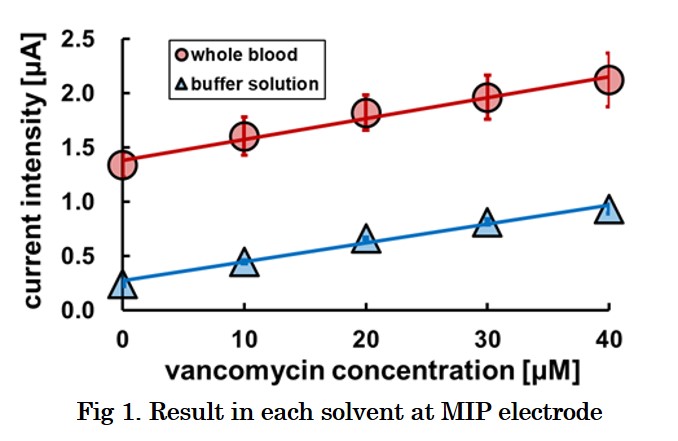
Introduction
A molecularly imprinted polymer (MIP) is a polymer synthesized by molecular imprinting and characterized by binding specifically to a template substance. We are developing sensors using MIPs whose porosity is sensitive to the template specifically. In order to elucidate the mechanism of the sensor, we prepared MIP nanoparticles (MIP-NP) with the feature of increasing the particle size with respect to the template concentration. However presently, the mechanism by which MIP-NP increases the particle size is not known. Therefore, this time, MIP-NP is produced using various templates to elucidate the mechanism of MIP-NP particle size increase.
Experimental Methods
Dopamine or vancomycin were immobilized covalently on the aldehyde introduced surface of glass beads as a template. MIP was synthesized at the surface of glass beads by radical copolymerization of functional monomers and crosslinker shown in Table 1. MIP-NP was obtained by separating the MIP from glass beads surface. Non-imprinted polymer (NIP)-NP was prepared as the reference by the same operation except for omitting the template immobilization on the aldehyde introduced surface of glass beads. The particle diameter was measured by dynamic light scattering (DLS) spectroscopy.
Result and Discussion
The diameter of the particles are shown in Table 1. Each MIP-NP was smaller than respective NIP-NP. And MIP was expanded by the addition of the template, while NIP-NP was insensitive. MIP-NP possesses cavities imprinted by the template in the matrix, while the NIP does not. Those results indicate that the MIP-NP shrinks during the liberation from the template-immobilized surface and expands by rebinding with the template. Analysis of the relation between the size of MIP and the specific interaction with the template would be helpful for design of highly sensitive using MIP.
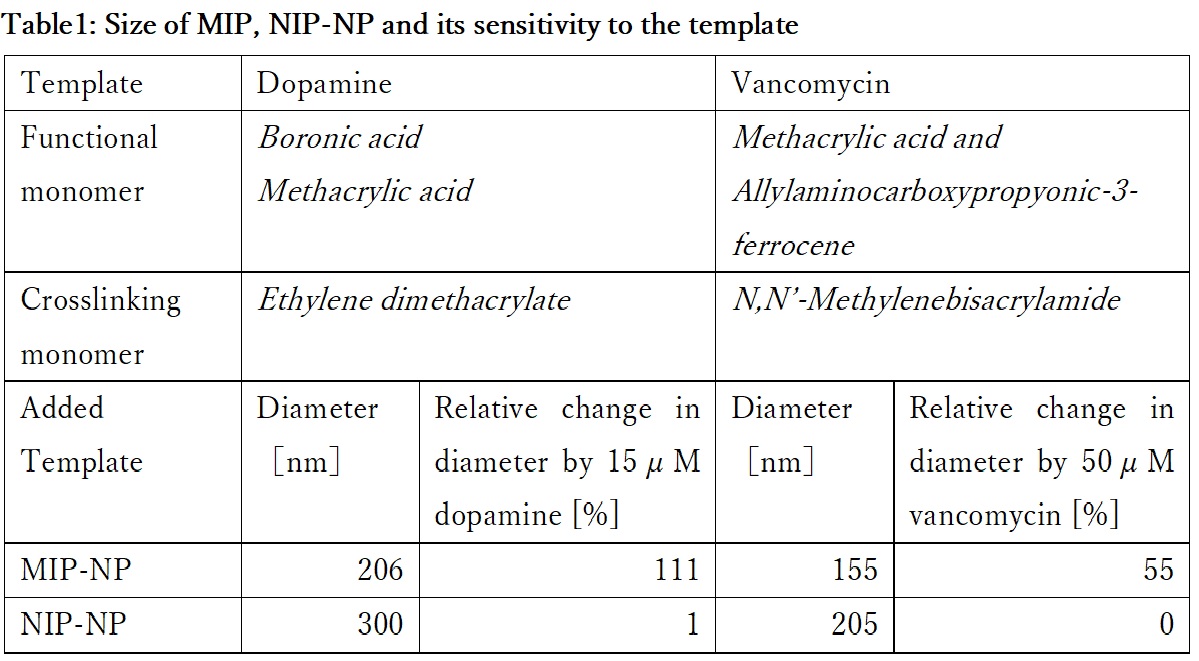
Thin film transistor (TFT) technology has been widely utilized in display, but seldomly been used in biosensing in spite of its priority in relatively high electron-mobility, economic-friendly manufacturing and lower energy consumption. We detected human serum albumin molecules by immobilizing anti-human albumin on dual-ligand modified surface of IGZO (indium gallium zinc oxide)-TFT chips with 400 transistors densely arrayed. AC power was applied on the chips and two neighboring transistors were activated. After recognition and combination, charged antibody-antigen pairs hindered movement of ions in medium between the two transistors due to electrostatic interactions, resulting in the change of permittivity of the dielectric and capacitance. By calculating output current, we could determine the impedance value, which would be reciprocally influenced by capacitance. We have detected the antibody-antigen reaction at the low level of 20 ng/ml for albumin molecules. Furthermore, we have compared 1 × PBS(Phosphate Buffer Solution), 0.1 × PBS(PBS : water = 1:9), 0.01 × PBS(PBS : water = 1:99) and 0.001 × PBS(PBS : water = 1:999) as solvents, where the results show that higher diluted PBS provides larger magnitude of signals for antibody-antigen reactions probably due to lower ion strength. The present IGZO-TFT biosensors is promising for a label-free multiple immunoassays method in the future. In next step, concentration of antigen will be decreased to determine sensitivity of the system and multiple types of antibody-antigen pairs will be immobilized and detected.
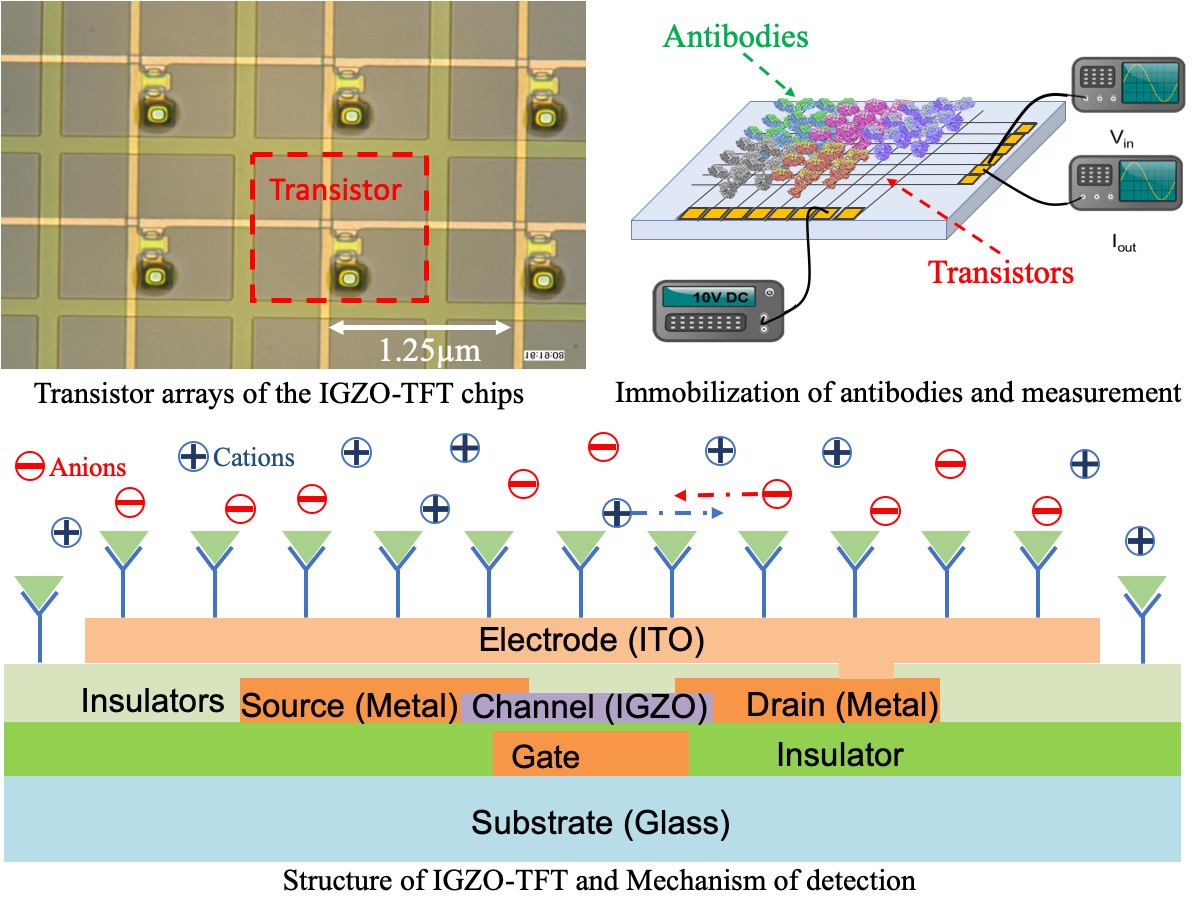
Human mesenchymal stem cells (hMSCs) are multipotent stem cells that can differentiate into mesoderm lineages such as osteocytes, adipocytes, and chondrocytes as well ectoderm (neurocytes) and endoderm lineages (hepatocytes) without generating tumors. The advantages of hMSCs used in cell therapy are their stemness, easy isolation, and no ethical concerns. These make them to serve an ideal candidate for regenerative medicine. However, the differentiated cells should be typically purified by magnetic-activated cell sorting (MACS) or fluorescence-activated cell sorting (FACS). This is laborious and expensive process. In this study, we developed a cell sorting dishes using thermoresponsive polymeric surface for isolation of targeted differentiated cells. hMSCs were differentiated into desired cell lines on the thermoresponsive surface and subsequently the temperature in culture medium was reduced below lower critical solution temperature (LCST), which enables to separate differentiated cells from non-differentiated cells. This method is an easy and economical process to be able to apply into mass production in future. Therefore, the sorting process on thermoresponsive polymeric surface should be crucial for future regenerative medicine application.
In this study, we first developed the establishment method of primary human amniotic fluid stem cells (hAFSCs) and human adipose stem cells (hADSCs) under the xeno-free condition. Subsequently, we designed the culture method of hAFSCs and hADSCs on thermoresponsive polymeric surface coated with poly(N-isopropylacrylamide), PNIPAAm, and several ECMs, such as (1) collagen I (2) fibronectin (3) synthemax II (oligo-vitronectin based substrate) (4) rVN (recombinant-vitronectin). After differentiation of hAFSCs and hADSCs into osteoblasts, we reduced the temperature in culture medium below LCST and detached the cells on the thermoresponsive surface (Fig. 1). We will investigate optimal PNIPAAm-ECM combinations for the differentiation of hAFSCs and hADSCs as well as the effect of cell sorting characteristics, which should be useful for the application in the regenerative medicine.
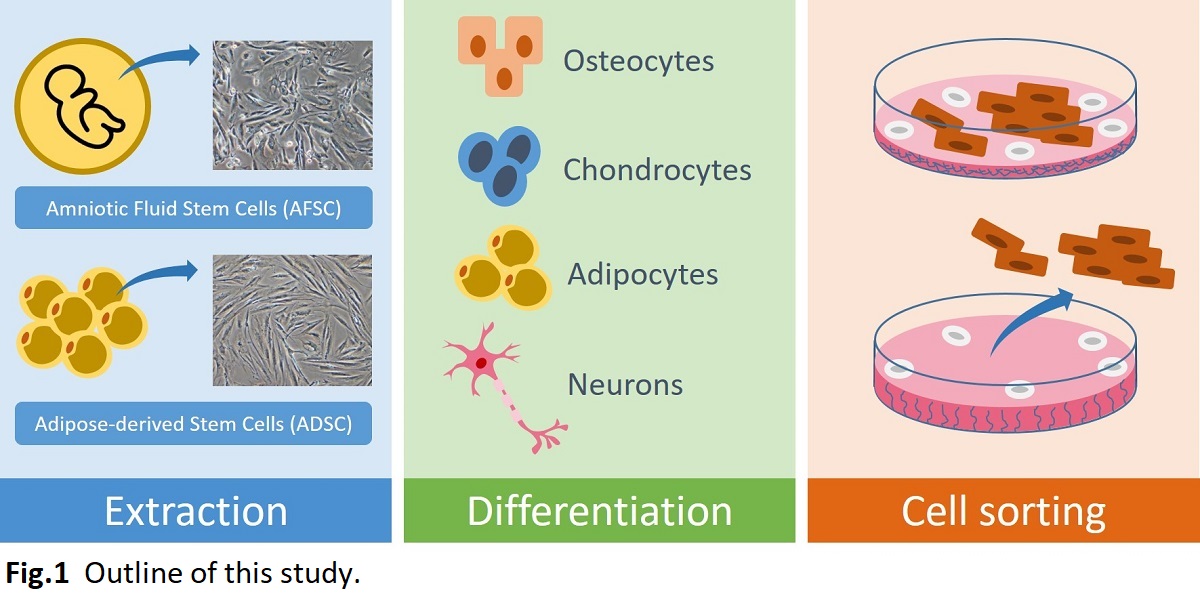
Microporous monoliths have been attracting increasing attention as separation materials due to their structural features. Poly(methyl methacrylate) (PMMA) is a polymer having biocompatibility and is insoluble in lower alcohols while it is soluble in the alcohols containing a small amount of water. Thus, microporous monoliths of PMMA can be made from its solutions in lower alcohols containing water via thermally induced phase separation method. In this study, we prepared composite monoliths of PMMA containing particles of hydroxyapatite (HA), which is one of the biocompatible inorganic materials that adsorbs proteins. The adsorption characteristics of proteins on the monoliths were also evaluated.
PMMA was dissolved in ethanol containing 20% water and HA powders at 70 °C. The polymer solution was then cooled for 1 h in a stainless-steel cup. After cooling, the solidified polymer was taken out and immersed in water to prepare a monolith. Bovine γ-globulin (BGG) and bovine serum albumin (BSA) in sodium phosphate buffer were adsorbed on a disk-shaped monolith in a custom-made holder and desorbed by raising the buffer concentration. The protein concentrations were determined by the bicinchoninic acid method and electrophoresis was performed to examine their adsorption characteristics.
The composite monoliths were successfully prepared by cooling the polymer solution at 0 °C. The dispersion of HA particles was improved by the pretreatment of HA powders with an aqueous solution of a nonionic surfactant Tween 80 before suspending in ethanol. The prepared monolith adsorbs much BGG and slightly BSA in 20 mM phosphate buffer (pH 6.8). The adsorbed BGG on the monolith was eluted with 400 mM phosphate buffer. The electrophoresis showed that BGG was separated from the mixture of BGG and BSA. We also examined adsorption characteristics of protein conjugates on the monolith. This study was partly supported by Kakenhi and Manufacturing Technology Association of Biologics, Japan.
For the improvement and change of the function of protein, the amino acid residues in the protein are selected and they are mutated to appropriate amino acid residues. Error-prone PCR is one of common method to improve and change the function of proteins; however, the identified variant is not always the one with enough function: In the error-prone PCR approach, the residue positions which should be mutated might be identified, but the selected amino acid at each position is not the most appropriate residue at each position. In this study, we combined the saturation mutagenesis with error-prone PCR: positive candidate amino acids at the critical positions identified by error-prone PCR were decided by means of saturation mutagenesis, and a smart-sized synthetic library was prepared to discover the variants with most appropriate function.
Here, we applied this methodology for improve the affinity of anti-human podoplanin antibody, LPMab-16, for rat podoplanin without deactivation against human target. The single chain fragment of variable region (scFv) was prepared from the sequences of humanized LPMab-16 Fv. For improvement of the affinity for rat podoplanin, w the scFv were mutated by means of error-prone PCR positive clones were selected from the variant library by means of phage display method. In the comparison of primary structure between positive and wild-type clones, the positions which should be mutated to promote affinity were determined.
In the secondary step, saturation mutagenesis was independently conducted at each decided position and the affinity of all the variants for both human and rat podoplanins were analyzed to determine amino acid candidates. Small-sized library was generated by conducting simultaneous saturation mutagenesis with the decided amino acid candidates, and the positive clone with 27 times higher affinity for rat podoplanin was able to be identified without deactivation for the binding to human podoplanin.
Polyacrylonitrile (PAN) nanofiber membrane was prepared by electrospinning technique. The PAN membrane used in this work comprises a polyethylene terephthalate (PET) spunbond fabric as a supporting layer with upper and lower PAN nanofiber membrane. After 3 M NaOH and diluted HCl treatments, the weak cationic exchange membrane (i.e., P-COOH) was obtained. The P-COOH membrane was then functionalized with tris(hydroxymethyl)aminomethane as an affinity nanofiber membrane (i.e., P-Tris). In this study, lysozyme was chosen as a model protein. The physical properties of the nanofiber membranes were characterized in terms of fiber diameter, porosity and pore size, specific area of the surface, FTIR and SEM analysis. The adsorption experiments were carried out in a well-mixed system under the various operating conditions (e.g., modification pH, adsorption pH, and the molar ratio of reactants, P-COOH/Tris). The dynamic adsorption characteristics of the P-Tris membranes for lysozyme by membrane chromatography were assessed by measurements of the breakthrough curves. The influences of operating conditions (e.g., adsorption pH, lysozyme concentration, no. of sheet membrane, and flow rate) on the adsorption performance of membrane were investigated in an AKTA prime chromatographic system (GE Healthcare).
Lipid modification of proteins regulates important biological events because the attached lipid moiety activates protein function by affinity to cellular membrane. The lipidated proteins also work for anchoring on drug delivery carriers composed of a lipid bilayer such as liposome. Therefore, protein-lipid conjugate is an effective way to functionalize proteins, and the strategy has attracted attention of researchers in various fields. Herein we focused on cross-linking reaction between specific glutamine (Q) and lysine (K) residues catalyzed by microbial transglutaminase (MTG) to achieve protein-lipid conjugate. Since MTG shows strict substrate recognition and site specificity under mild conditions, it has been demonstrated an effective biocatalyst for labeling proteins with artificial lipid-fused peptide substrates [1, 2]. A recombinant enhanced green fluorescent protein (EGFP) fused with amino acid sequence containing MTG-reactive Q (LLQG) at the C-terminus (abbreviated as EGFP-Q) was expressed in E. Coli. As for K substrate, lipid-fused peptides with MTG-reactive K (lipid-G3S-MRHKGS: abbreviated as lipid-K) were synthesized by Fmoc solid phase synthesis. Prepared EGFP-Q and lipid-K were cross-linked by MTG in homogenous water-phase, and obtained EGFP-lipid after MTG reaction was purified in an established method [2]. Finally, mixing EGFP-lipid and liposomes possessing various charges led to the decoration of liposomes with EGFP-lipid, especially the combination of EGFP-lipid and cationic liposome showed the enhancement of the anchoring ability on cellular membrane.
[1] M. Takahara et al., ACS Appl. Bio Mater., 1, 1823-1829 (2018).
[2] M. Takahara et al., Chem. Eur. J., accepted (2019).

Acinetobacter sp. Tol 5 shows high adhesiveness to various abiotic surfaces from hydrophobic plastics to hydrophilic glass, and stainless steel. This adhesive property is mediated by fiber protein AtaA, which is a member of the trimeric autotransporter adhesin (TAA) family. The adhesive feature of AtaA can be conferred to other non-adhesive Gram-negative bacteria by transformation with ataA gene, and bacterial cells displaying AtaA on their surface can be quickly immobilized onto various types of supports and used as immobilized whole-cell catalysts. While it has been reported that the adhesiveness of Tol 5 through AtaA is nonspecific, material preference of Tol 5 has never been evaluated quantitatively. In this study, we compared the adhesiveness of Tol 5 among various material surfaces. Materials used in this study was polystyrene, glass, stainless steel, and anti-adhesive materials, such as polytetrafluoroethylene (PTFE), Mica, poly (oligo (ethylene glycol) methacrylate) (pOEGMA) brush, and 2-methacryloyloxyethyl phosphorylcholine (MPC) polymer. Bartonella henselae and Yersinia enterocolitica, which adhere to abiotic surfaces through their TAAs, were used as control bacteria. The bacterial cell suspension was applied onto material surfaces. After a certain time incubation, adhered cells were stained with crystal violet and quantified by measurement of the absorbance at 590 nm. Although Tol 5 showed high adhesiveness to most of the materials, the amount of the adhered cells depended on the materials. This result suggests that Tol 5 has material preference for cell adhesion. These findings give us a clue to elucidate the mechanism of the nonspecific, high adhesiveness of AtaA.
Solid-fat microspheres (SFMSs) are micrometer-sized spherical particles consisting of solid fat having a high melting point. They can be utilized for oral delivery of lipophilic bioactive components as well as preparation of powder fats. Generally, SFMSs are produced by solidification of oil droplets in oil-in-water (O/W) emulsions containing solid fats liquefied at high temperature. However, formation of fat crystals on the surface of oil droplets during their cooling process often cause flocculation and partial coalescence, and it results in instability of SFMSs. Therefore, stabilization of SFMSs during their formulation and storage processes is needed to improve food quality and shelf life.
In this study, we tried to stabilize SFMSs by coating with protein and polysaccharide using the electrostatic deposition technique. Monodisperse O/W emulsions containing palm oil droplets as starting materials of SFMSs were prepared by the microchannel (MC) emulsification technique. MC emulsification is a method for preparing highly monodisperse emulsion thus it is useful for finding out the effectiveness of biopolymer coatings on the stability of emulsions and SFMSs. MC emulsification was carried out using silicon MC plates installed to MC module at 65 °C. Sodium caseinate (SC) solution was used as the continuous phase and palm oil was used as the to-be-dispersed phase. Monodisperse O/W emulsions with mean droplet diameters of a few ten micrometers and coefficient of variation lower than 5% were successfully obtained. SFMS dispersions prepared by cooling the O/W emulsion were mixed with chitosan (CHI) solution to obtain SFMSs coated by CHI/SC layer via electrostatic interaction between positively charged CHI and negatively charged SC (Fig. 1). The CHI/SC ratio affected the diameter distribution and stability of SFMSs. During long-term storage at room temperature and heating-cooling treatment process of SFMSs, formation CHI/SC layer showed remarkable stabilizing effect for SFMSs by suppressing “oiling off” and fat crystallization.
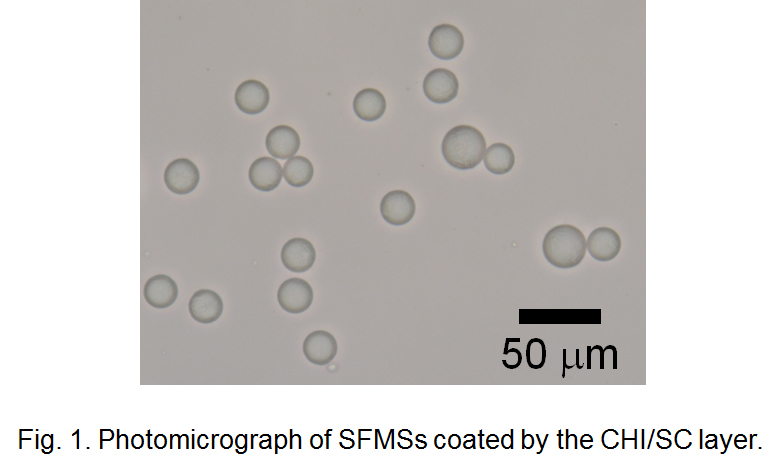
Liquid marble (LM), a self-standing microdroplet covered with hydrophobic polymeric particles, forms discrete space that can control physical and chemical exchange of substances between inner and outer environment. LM has been used as a micro-(bio)reactor because it provides easy-to-handle compartment for biological entities. In this study, we studied cell-free protein synthesis (CFPS) in LM, and the simultaneous hydrogelation of internal aqueous phase was tested to stabilize the whole system. Hereafter, we designated the LM in which the inner aqueous phase is a hydrogel state as hydrogel marble (HM). First, we constructed an LM/HM system by encapsulating the aqueous solution of CFPS components and the hydrogel precursors in LM. It was confirmed that CFPS in LM is possible under appropriate conditions (high humidity and suitable temperature) and enzymatic hydrogelation also proceeds to yield HM. As a result, capturing and immobilizing the cell-free synthesized proteins in hydrogel network was achieved, and by altering the hydrogel components and introducing cysteine residue to the target recombinant protein leaded to the efficient protein immobilization in HM [1]. We then tried to detect the gene after taking out from HM to apply the present system to directed molecular evolution. First, we prepared HMs containing the blank or target plasmid DNA encoding the gene of a target enzyme. Eventually, HMs exhibiting enzymatic activity are visually discriminated by floating HM on a substrate solution. HMs were taken out randomly, and the plasmid DNA coding target enzyme was detected only from the colored HMs. These results suggest the potential of HMs to utilize as a reactor to match genotype in LMs and phenotype in HMs. Quantitative evaluation of enzymatic activity produced by CFPS would be the next target for point-of-care testing and diagnostics.
[1] N. Kamiya, et al., Biotechnol. J., 13, 1800085 (2018).
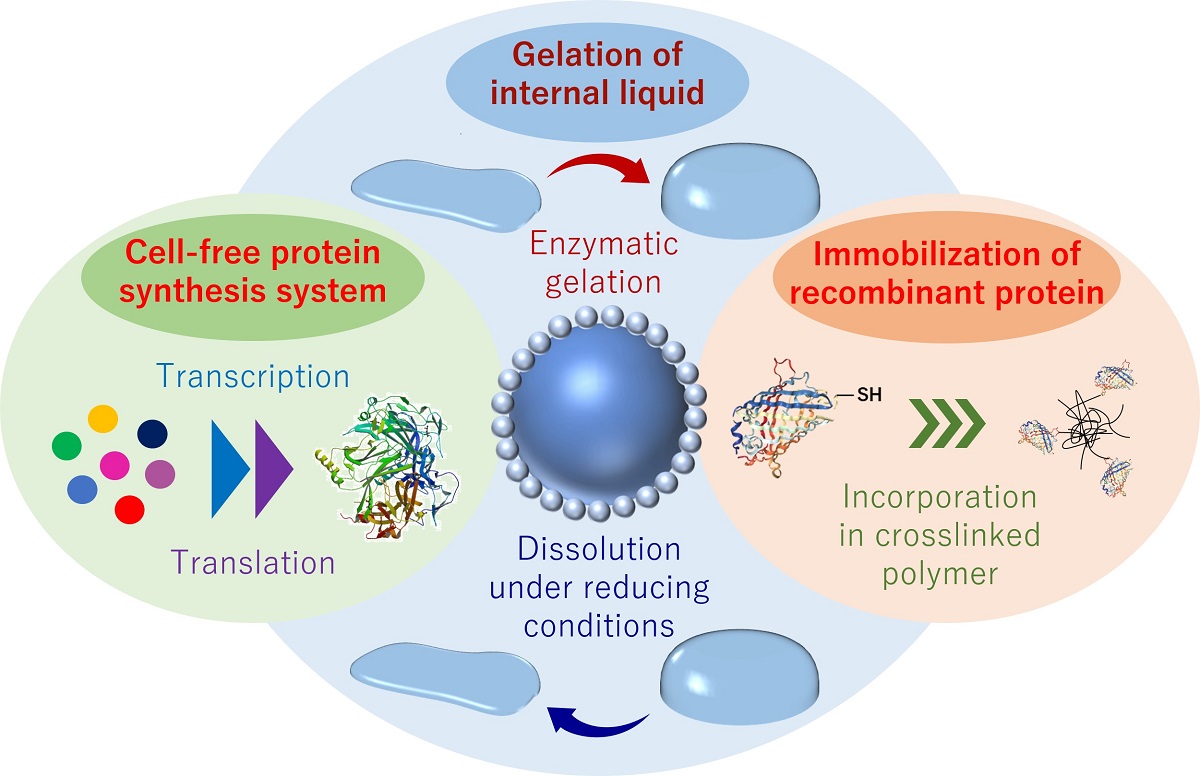
Analysis of the secretion of neurotransmitters in the nervous system is important for elucidating the mechanism of neural network. Then, development of a probe which can track a specified neurotransmitter in real time with high selectivity has been required. Molecularly imprinted polymer (MIP), which is a molecular recognition material obtained by polymerization with a template-effect of the target molecule may be applicable for the probe. In this study, nanoparticle of MIP including fluorescent group (fMIP-NP) were developed as the probe of dopamine secration. The serotonin, as the template, was immobilized on glass beads by using mixed anchor (1:1 in molar ratio) of 3-aminopropyltrimethoxysilane and 3-(2-aminoethylamino) propyltrimethoxysilane with glutaraldehyde. The template-immobilized beads were fluidized in a mixed solution of a fluorescent monomer, a template-affinity monomer, and a crosslinking monomer under UV irradiation. The colloidal fMIP-NP was collected from the surface of the beads by washing with N,N-dimethylformamide. And the dispersion medium of the colloidal fMIP-NP was replaced with 0.15 M phosphate buffer. The fluorescent intensity of the fMIP-NP was increased by addition of dopamine but was insensitive to L-3,4-dihydroxyphenylalanine (L-DOPA) as shown in Fig. The fluorescent nanoparticle prepared without the template was insensitive to both of dopamine and L-DOPA. Those results indicate that the specific interaction between the dopamine and the dopamine-imprinted cavity in the enhances the fluorescent intensity of fMIP-NP. The in vivo concentration of dopamine is said to be several nM. The relative change in the fluorescent intensity of the fMIP-NP is 4.2 % to the dopamine concentration of 15 nM which corresponds to the concentration of dopamine in vivo. Thus, the dopamine secretion in nervous system can be detected by diversion of a fluorescent voltage sensitive dye imaging system (e.g. MiCAM series in Brain Vision Inc.), which can detect relative change of 0.05% in fluorescent intensity.
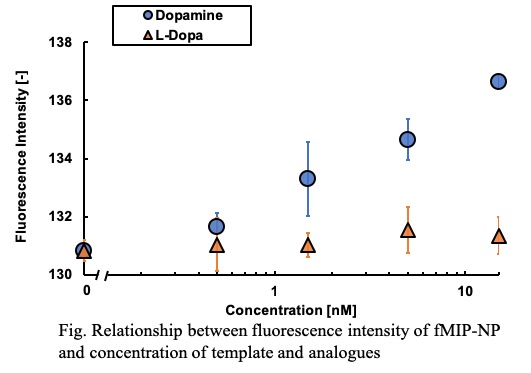
Molecular evolution based on mutagenesis is widely used in protein engineering. Recent advances in genetic engineering allowed us to prepare an extremely large library, beyond the limit of organic synthesis. However, such a large library are often difficult to obtain optimal proteins due to a large sequence space and finally leads to high costs in screening experiments. The success of protein engineering crucially depends on preparing a small library with high enrichment of functional proteins. Here, we propose a novel approach that combines molecular evolution with machine learning. In this approach, we conduct two rounds of mutagenesis where an initial library of protein variants is used to train a machine learning model to guide mutagenesis for the second round library. This enables us to prepare a small library suited for screening experiments with high enrichment of functional proteins. We demonstrated a proof of concept of our approach by altering the reference green fluorescent protein so that its fluorescence is changed into yellow. A small library of GFP variants was generated by means of point saturation and site directed random mutagenesis. Sequence and functional data acquired from the variants in the library were used for training a machine learning model to create the second round library. Mix primer techniques in overlap extension polymerase chain reaction generated the second-round library which consisted of 80 variants proposed by machine learning. The library turned out to contain yellow fluorescent proteins in high number. We successfully obtained a number of proteins showing yellow fluorescence, 12 of which had longer wavelengths than the reference yellow fluorescent protein. These results show the potential of our approach as a powerful method for directed evolution of fluorescent proteins.
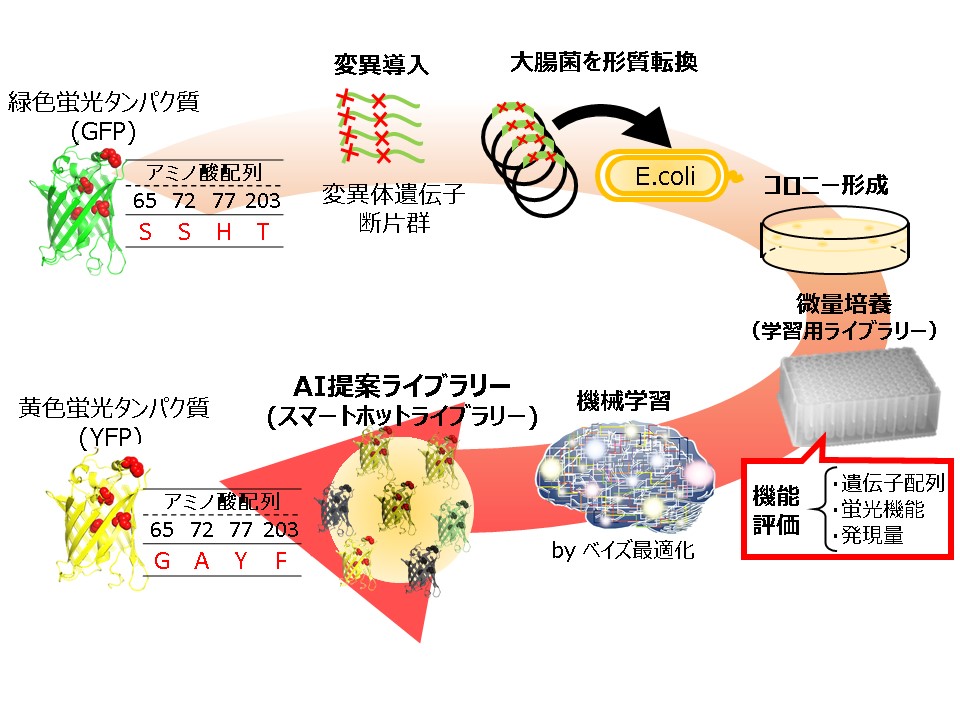
The adsorption of lysozyme on Reactive Gren 19 dye–ligand affinity nanofiber membrane was investigated at 25 °C in a batch system. The effects of operating parameters such as initial pH, immobilization dye concentration, and initial lysozyme concentration on the adsorption were analyzed using Taguchi method. The optimum adsorption conditions were determined as initial pH 7, immobilization dye concentration 3 mg/ml, and initial lysozyme concentration 3.0 mg/ml. At optimum conditions, the adsorption capacity of dye–ligand affinity membrane for lysozyme was found to be 686 mg/g. Based on the optimal conditions, the thermodynamic and kinetic studies were investigated under various operating conditions, such as adsorption pH, lysozyme concentration and temperature. To purify the lysozyme from chicken egg white by using the membrane chromatography, it was to find the optimal purification strategy, including adsorption (e.g., adsorption pH, concentration of CEW, and operating velocity), wash (e.g., liquid velocity) and elution (e.g., type of salt and concentration and liquid velocity) stages. Under the optimal conditions, the results showed that the lysozyme was recovered with a high yield of 98.5% and a high purification factor of 143.3 in a single step.
S-Adenosylmethionine (SAM) is an important methyl donor involved in the methylation of diverse biomolecules, including DNA, amino acids, and secondary metabolites. Although SAM-dependent methyltransferases can become versatile tools for the biocatalytic manufacturing of various useful compounds, SAM-dependent methylation has not yet been industrialized due to the complexity in SAM regeneration. In living cells, SAM is demethylated to S-adenosylhomocysteine (SAH) in association with the methylation of recipient substrates, and subsequently degraded to homocysteine, adenine, and ribose. Homocysteine is then re-methylated to methionine by using another methyl-donor molecule, methyl tetrahydrofolate (THF). Finally, SAM is regenerated by adenylation of methionine with ATP. Although methyl THF can be produced from serine or glycine, carbon sources taken up in the cells are mostly routed into energy production and other biosynthetic pathways, limiting the amount of carbon input which can be utilized for the production of methyl THF and following SAM regeneration.
In this study, we newly designed a SAM-regeneration pathway, in which methanol is used as a source of methyl group, and installed it into Escherichia coli. A heterologously expressed methanol dehydrogenase (MDH) catalyzes NAD+-dependent oxidation of methanol to formaldehyde, which is then spontaneously conjugated with THF to yield methylene THF. An endogenous enzyme in E. coli (methylene THF dehydrogenase) mediates NADH-dependent reduction of methylene THF to methyl THF, which serves as a methyl donor to regenerate methionine from homocysteine. We demonstrated that integration of an methyltransferase into the recombinant E. coli equipped with this pathway allowed methylation of a recipient substrate into its methylated derivative using methanol as a source of methyl group. Moreover, deregulation of SAM biosynthesys and regeneration further enhanced methylation reaction.
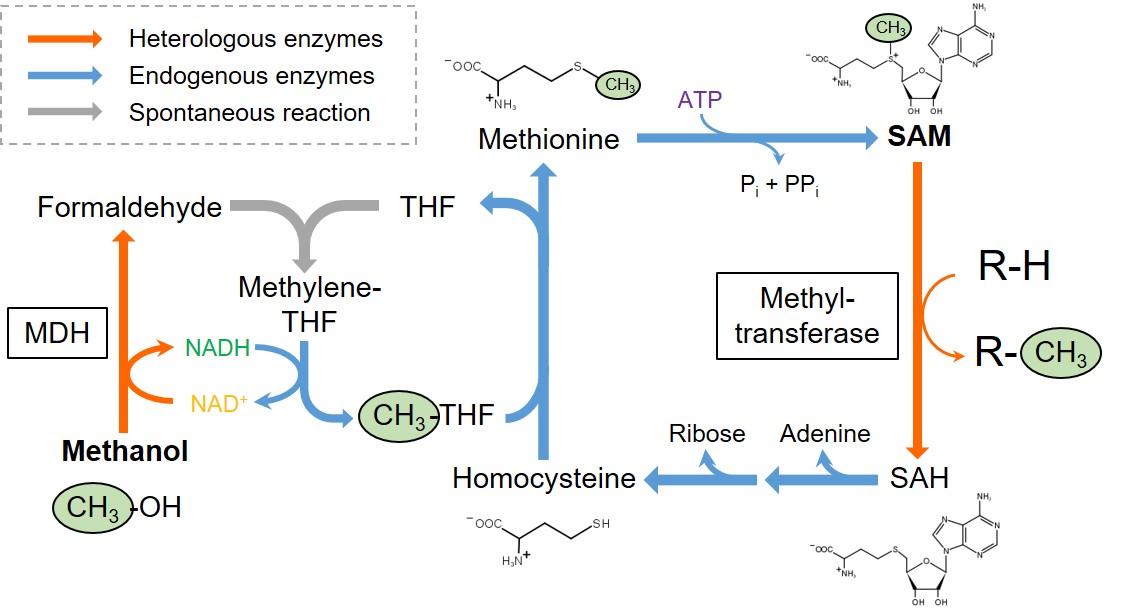
Lipase catalyzes ester hydrolysis under an ordinary temperatures and pressures. In organic solvent, lipase catalyzes ester synthesis and transesterification and lipase has substrate specificity. Lipase is one of important enzyme for industrial application. However, lipase is immediately inactivated in the presence of organic solvent in which the substrate dissolves. Enzyme immobilization is one of solution to improve the stability of enzyme. Yasuda synthesized the amphiphilic macromonomer (2-[p-(1,1,3,3-tetramethylbutyl) phenoxypolyethoxy] ethyl methacrylate, MAX-n, n is the degree of polymerization of the polyethoxy group). Amphiphilic particles obtained by seed copolymerization of MAX-n was a good immobilization support of lipase. In hexane, immobilized lipase on amphiphilic polymer particles had long-term activity and good transesterification activity. However, low immobilization amount of lipase was a problem. In this study, to enhance immobilization amount of lipase, we synthesized amphiphilic polymer micelle of MAX-n and polymer micelle was incorporated into pores of porous particle. The degree of polymerization of the polyethoxy group of n was affected immobilization amount of lipase and stability of lipase in the presence of hexane. When the degree of polymerization of the polyethoxy group was 4.39, the half-life of lipase in hexane was extremely long at 8500 hours.
Krill oil contains huge amount of long chain polyunsaturated fatty acids (PUFAs) such as eicosapentanoic acid (EPA) and docosahexanoic acid (DHA). However, the easily oxidizable characteristics of DHA and EPA make a short shelf life of those compounds. To increase the oxidative stability of EPA and DHA, krill oil was encapsulated in Saccharomyces cerevisiae yeast cells. Rosemary oil (RO), an antioxidant, was added with an amount of 5 wt% of krill oil to reduce the degradation rate of EPA and DHA. The solid content of feed solution was 25 wt%, where the ratio of yeast to krill oil was 2:1. The slurry of yeast, krill oil and water were incubated at 40 °C for 4 h. Non-encapsulated oil was removed by centrifugation and washed with distilled water before spray drying to reduce the surface oil in spray-dried powder. A pilot scale spray dryer (Ohkawara L-8 type) was used to encapsulate krill oil in yeast cells. Four different powders were prepared, where RO was added in two powders and another two powders were without RO. One powder without RO and one powder with RO were washed by hexane after spray drying. Around 0.5 g powders were put in the small vial and placed the powders in drying oven at 50 °C. Thin layer chromatograph with flame ionized detector (TLC-FID) was used to analyze total oil and surface oil content of encapsulated powders. The maximum total oil and surface oil was found around 0.058 g/g-yeast powder and 0.01 g/g-yeast powder, respectively in the powder with RO and hexane washing. The content of EPA and DHA in the powder with RO had higher value than that of powder without RO after the storage of 4 weeks at 50 °C storage.
There are two methods of filleting process of large size frozen fish in the early stages of distribution : a method of cutting thawed fish with a knife and a method of cutting frozen fish with a band saw. The method of cutting thawed fish with the knife has problems in terms of hygiene and freshness. On the other hand, the method of cutting frozen fish with the band saw has problems in terms of safety and yield. We have proposed “cryo-cutting” as a cutting process for frozen fish without using the band saw. Samples were prepared as follows ; a thawed bonito (whole fish body) was cut into a cylindrical shape by knife and re-frozen at a temperature range from -70°C to -40°C. Notched samples was prepared by cutting a V-shaped notch on the back side of the fish sample along the dorsal fin. To try to fillet bonito, a cylinder splitting load was applied to the samples with and without the notch. A wedge-shaped jig was attached to the upper compression plate and pressed into the back side of the sample or into the notch of the samples. As a result, the sample could be split into two parts along the median plane of fish body. By using the jig, it was possible to certainly split into two parts in processing temperature range from -60°C to -40°C. Furthermore, in this temperature range, the load required for splitting could be significantly reduced by 50% and more. The reduction in stress was due to stress concentration at the notch tip. These results have shown the possibility of increasing the cutting accuracy and reducing the cutting stress, by use of the wedge-shaped jig. This study could be a new method for filleting frozen fish.
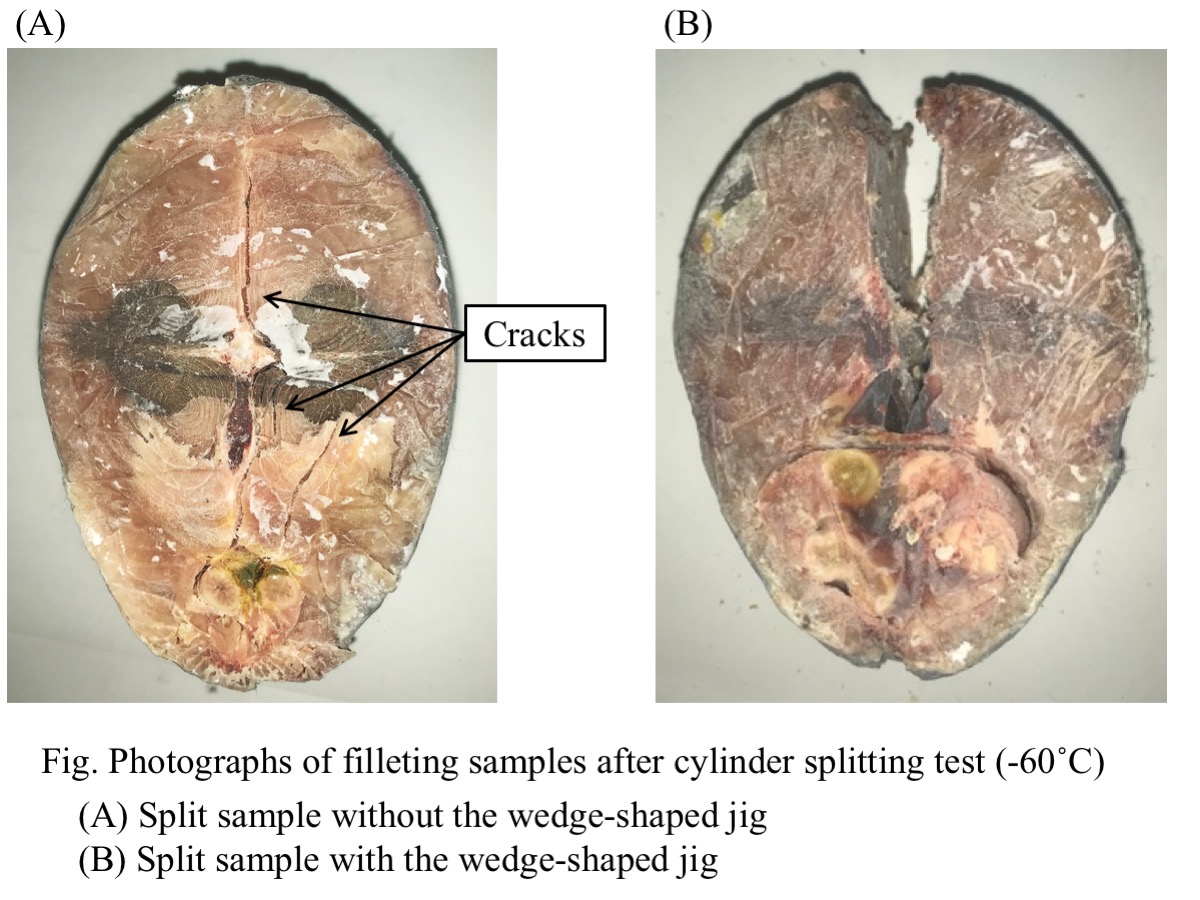
Peptides are heteropolymers composed of amino acid residues linked by peptidic bonds between the carboxyl group of one amino acid residue and the α-amino group of another. They are molecules of paramount importance in several fields, especially in hamaceuticals, health care and nutrition fields.
Peptides are mainly obtained from solid phase peptide synthesis (SPPS) as an established technique. SPPS is a cyclic process with four steps in each cycle: deprotection, washing, coupling, and rewashing. As a result, SPPS is typically performed with long coupling time, large excesses of reagents, and many repetitive washing steps between each steps.
Microfluidic reactors for biomolecule syntheses have many advantages over conventional bulk reactors. Benefiting from minimization of the reaction scale and enlargement of the specific surface area, the microfluidic chemical reactions result in improvement of yields, selectivity, safety and efficiency.
We report our development of flow peptide synthesis in a microchannel. The flow peptide synthesizer consisting of the microchannel with the width of 1mm and depth of 0.2mm on a glass plate and a filter for resin trap. During a coupling reaction, a syringe pump made reciprocating flow of resin beads suspension in the microchannel to restrain aggregation and blockage of resin beads.
Model peptides (Met-enkephalin) were synthesized in a continuous-flow manner. Coupling time of 10 min gave better yields and less side products than that of 40 min with a conventional batch synthesizer. Additionally, two equivalent of amino acid gave good yields similar to four equivalent of amino acid in the conventional batch synthesizer. Therefore, the flow peptide synthesis in a microchannel can contribute to significant reduction of the total coupling time and consumption of amino acid.
High density adsorbent STREAMLINE Direct HST (GE Healthcare) was used to investigate the fluidization and axial liquid mixing characteristics under various operating conditions (e.g., liquid velocity and viscosity and rotational speed) in a specially designed stirred fluidized bed column (SFBC). The results showed that the experimental Richardson-Zaki constant of n is approximately 3.6-4.7, and the experimental terminal velocity of the adsorbent particle is some degree different from the theoretical value (< 20%). Based on the liquid viscosity and density, and adsorbent density and particle diameter, the bed height in the fluidized bed at a desired liquid velocity can be estimated. More experiments were conducted with SFBC for investigating the axial liquid mixing using 5% acetone (v/v) as a tracer and the fluidized bed height was maintained at a constant bed height (i.e., two times settled bed height). The results revealed that the axial liquid mixing was much affected by the liquid velocity and viscosity, and the rotational speed of agitator. As the rotating speed was increased in a higher liquid viscosity, the liquid flow was found to be more stable. Hence, the rotational speed was significantly contributed to the liquid mixing efficiency.
The medical application of cell engineering has attracted a lot of attention. For example, circulating tumor cells (CTCs) separated from blood offer tremendous potential for diagnosis of cancer. The analysis of CTCs is would be useful for progressions of precision medication. In order to attain those medication, it is essential to develop the cell separation technology. Centrifugation, which is based on weight and density, and affinity separation are conventional cell separation method. In addition, cell size and deformability also play a role in cell separation. A novel cell separation method based on size and deformability is worth of development, because it enables the cell separation without rare protein and marker.
In this study, we applied the metal mesh device (MMD, Figure 1.) to the cell separation. MMDs are thin metal films with a through hole structure with precisely controlled pore size. The well defined pore structure of MMD would be appropriate to separate cell based on size and deformability. The aim of this study is achieving cell separation of MMD only with the physical property of cell, and obtaining basic information.
We will report the cell separation of several cell lines with MMD. Since HL60 (floating cell) and HeLa (adhesion cell) cells were reported to have different size and deformability, the cell separation of those cells were conducted with MMD. The permeability of MMDs with different hole size was studied. We carefully observed the cells having high and low permeability, and investigated the relationship between permeability and physical properties.
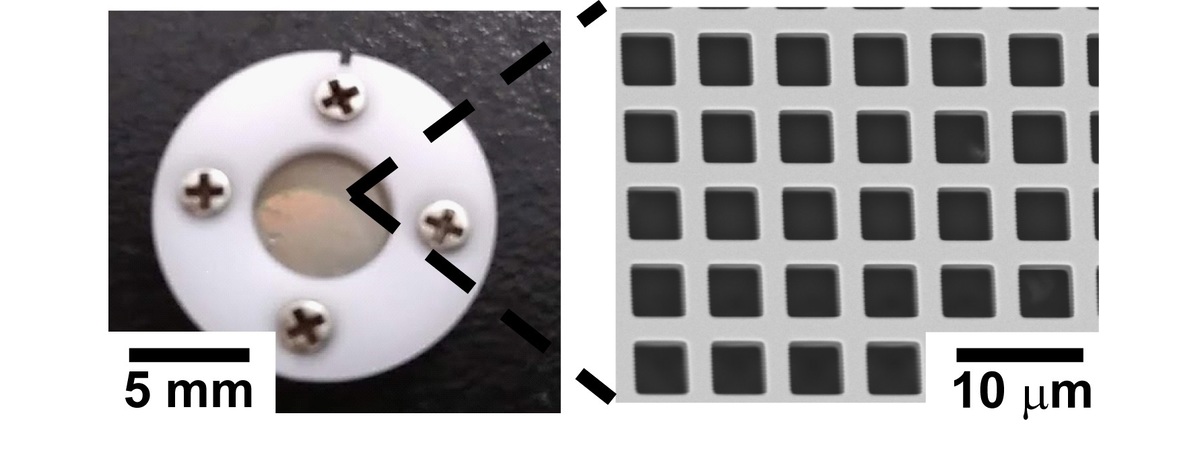
Efficient oxygen supply in bioprocesses is required for aerobic microbes, which demand oxygen as the final electron acceptor in the respiratory chain reaction. In general, compressed air as babbles through a sparger is introduced in a stirring tank reactor. The bubbles sizes are ~ mm of diameters, and stirring paddles collapses and disperses the babbles, and increases oxygen transfer rate. However, the stirring blades often damage the microbial cells, and requires large input powers. To solve the trade-off problem between efficient oxygen supply and cell damages, fine babble sparger (FBS) attempted to apply the microbial cultivation. Here, influence of FBS using on a biosurfactant-, mannosyletythritol lipids (MEL), production by an absolute aerobic fungi, Pseudozyma hubeiensis were investigated. Pseudozyma hubeiensis SY62 was inoculated in 1 L of a MEL-production medium prepared in a 2-L table top bioreactor equipped an alumina porous sparger with 1.3 μm diameter pores (FBS sparger, Noritake Co. Ltd.). Reference cultivation were performed in the equivalent condition except without the alumina porous sparger. Cell growths were measured by a dry cell weight method and the MEL concentrations were determined by a HPLC with an evaporative light scattering detector.
Agitating at 200 rpm, cell growth at the third day with FBS sparger increased to 19.2 g/l, which was higher than that without the sparger (5.7 g/l). Although MEL production were never observed without the sparger, the production reached to 4.7 g/l for three days. However, the significant differences in cell growths between with and without FBS sparger were not observed at 525 rpm. Interestingly, MEL productions for three days with the sparger were induced to 48.9 g/L, which was 1.7 fold larger than that without the sparger. The results indicates that aeration with SPG sparger can achives an efficient oxygen supply without excess stirring.
We have developed polymer particles (g-particle) having grafted polymer chain for adhesive cell culture. To keep adhesive cells on particles surface, a graft chain having both an epoxy group and a hydrophilic carboxyl group is required. This is because the reaction between the epoxy group and the amino group of the extracellular matrix facilitates cell adhesion. The cells grown on g-particle forms three-dimensional matrix in the particles gap and three-dimensional cell matrix has many physiological functions. However, when cell suspension added to g-particle dispersion, the rate of cell growth and adhesion were not high. This was because g-particle moved freely without being dense state in the cell culture dish. In this study, to form and keep a packed state of g-particle by magnetic force, we tried to synthesize a new magnetic g-particle containing paramagnetic Fe3O4 nanoparticles. In suspension polymerization, monomer and hydrophobic modified Fe3O4 nanoparticles were polymerized and the graft polymerization of methacrylic acid and glycidyl methacrylate was carried out. Carboxyl group and epoxy group were introduced as graft polymer chains into the base polymer particles by using pre-incorporated azo groups in polymer particles as an initiator. The number average particle size of magnetic g-particles was 103 μm and they contained 5 wt% of Fe3O4 nanoparticles. They could be gathered by applying an external magnetic force. In addition, the adhesion and growth rates of cells were compared using conventional g-particles and magnetic g-particles. As a result, it was found that cell culture in the presence of magnetic g-particles shows better results.
Blood is one of the most important biological samples. This is not only an analysis target for diagnosis and research but also widely used for treatment. For example, it includes blood transfusion and blood products. Blood contains various blood cells and components that constitute plasma. Separation of these components is one of the most basic operations for its diagnosis, analysis, and utilization.
Conventionally, centrifugation is a general method of blood separation. Centrifugation is based on the specific gravity difference in principle. This is a batch method, thus, processing large amounts of blood requires large devices. In addition, it is possible to separate only target blood cells by using an appropriate centrifugation solution, however, precise separation is difficult.
In this study, we tried that the blood cell separation using a Metal Mesh Device (MMD Fig. 1) with precisely controlled pore size and pore arrangement. The MMD has a nickel mesh structure manufactured by MEMS technology. Therefore, MMD is expected to be applied as a separation membrane, because; it has a large number of through holes accurately designed in the submicron order. It is already reported that the collection and classification of PM2.5 present in the atmosphere using MMD*.
MMD as a separation membrane has an advantageous of blood separation. That is, separation can be achieved using the simple phenomenon of passage/capture when blood is introduced. Blood cells are expected to be separated according to the size and hardness of blood cells by the mesh structure precisely designed on the submicron order. In this study, we reported the blood cell passage rate in the case of using MMD with various pore sizes and evaluated the blood cell passage control by surface PEG modification.
* H.Seto, et al., Chem. Lett., vol. 43, 4, 408-410 (2013)
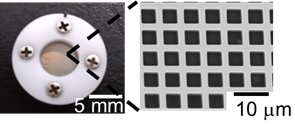
Biopharmaceutical proteins such as therapeutic antibodies are usually produced by recombinant Chinese hamster ovary (CHO) cells. High producer cell lines are screened from transfected cells with random integration of target genes. Since transgene expression is susceptible to the surrounding environment of integrated genomic locus, producer cell lines should be selected from a large number of recombinant cells with heterogeneous transgene insertion. In contrast, targeted integration or site-specific integration into a characterized genomic locus enables more predictable transgene expression and less clonal variability, and hence stable production of target proteins can be expected. Genome editing technology based on programmable nucleases such as TALEN and CRISPR/Cas9 has recently emerged as a versatile tool for precise editing of target locus in the cell genome. Previously, we have demonstrated targeted knock-in of transgenes into the hypoxanthine phosphoribosyltransferase (hprt) locus of CHO cells using TALEN- and CRISPR-mediated precise integration into target chromosome (PITCh) systems [Sakuma et al., Int. J. Mol. Sci., 16, 23849-23866 (2015); Kawabe et al., J. Biosci. Bioeng., 125, 599-605 (2018)]. Here, we attempted to generate targeted knock-in CHO cells based on the homology-independent targeted integration (HITI) system. Transgene cassettes in donor vectors (pHITI/DsRed) were flanked by gRNA recognition sites to eliminate the vector backbone sequences after integration into the cell genome. To evaluate the targeted knock-in efficiency of transgene cassettes, CHO-K1 cells were co-transfected with donor vectors and respective Cas9/gRNA expression vectors. After seeding of transfectants, we counted numbers of colonies showing both drug resistance and DsRed expression. For the established clones, the targeted integration was confirmed by genomic PCR using specific primer sets for joint-regions. The transgene knock-in efficiency into the hprt locus using HITI system was 6.7-fold and 5.0-fold higher compared with those using homologous region (HR) and PITCh systems, respectively.
>Biologics are gaining importance in treatment of diseases, such as cancer, because they are safer alternatives to the conventional treatment. They are mostly produced in bacterial, yeast or mammalian cells. When there is a need for a correct protein folding and posttranslational modifications of biologics, mammalian cell lines are a go-to. Chinese hamster ovary (CHO) cell lines are the dominant mammalian cell lines in production of biologics. They do not propagate human viruses, can grow in suspension cultures, protein folding and modification is human-like and the production of the CHO cells is high.
>The demand for biologics grows. To meet the quantitative demands for the new biologics at sustainable cost, we must further increase the productivity of the CHO cells. Here, we explore the effects of cell cycle inhibitors aphidicolin and caffeine on productivity of CHO cells. We inserted an IgG1-expressing plasmid into a CHO cell lines, which were either treated with aphdicolin or caffeine during transfection, or were not treated in control samples. Aphidicolin treated cells had a 3.5-times higher productivity than control, while caffeine had no effect. While trying to identify the reason for the productivity increase in aphidicolin-treated cells, we noticed that inserted gene copy number or gene expression level remained the same between the aphidicolin treated and control cells. The inserted gene mainly in chromosome 2 in control samples, while in treated samples, the gene was found on many different chromosomes, suggesting that the location of the gene integration might influence the productivity. Because there was no change in gene expression levels between the cell lines, we hypothesize that the difference arises in the downstream steps of protein synthesis. Because the aphidicolin damages the DNA in vicinity of microRNA genes, we further hypothesize that the changes in microRNA expression might contribute to the higher productivity.
The past decade has seen a significant transition from static and passive material to dynamic, bio-based, and stimuli-responsive biomaterials in the cell-seeding technology. Recent advances towards such biologically active hydrogels have been directed to design biomaterials with a superior feature for higher-order cell culture than conventional 2D culture. One obstacle in the fabrication of biologically active hydrogels is to develop in situ crosslinking of gel precursors without impairing bioactive agents to mimic the extracellular matrix condition. Enzymatic crosslinking methods have been suggested as a potential way to introduce external functionality such as sol-gel or gel-sol transition to cell culture scaffolds. Herein, we propose to utilize the horseradish peroxidase-mediated cross-linking that can enable both redox-responsive hydrogel formation of tetra-thiolated PEG via disulfide linkage and incorporation of chemically thiolated materials in the hydrogel. Enzymatic fabrication of redox-responsive hydrogel using different types of gelatin revealed that chemically thiolated gelatin (Gela-SH) and heparin (Hepa-SH) can be co-incorporated into the polymeric network, yielding the dual-functionalized hydrogels. Hepa-SH with different degree of thiol modification was incorporated by considering its optimum binding ability with growth factors and a conflicting property such as the intrinsic anti-proliferative effect. Interestingly, the type of gelatin had a significant effect on the physical and biological aspects of hydrogels; alkaline-treated gelatin (Gela(B)-SH) exhibited superior performance over acid-treated gelatin (Gela(A)-SH) to generate the dual-functionality, cellular adhesiveness and binding ability of growth factor, originating from the two natural biopolymers. Eventually, the Gela(B)-SH/Hepa-SH dual-functionalized PEG-based hydrogel supported both cellular attachment and binding of basic fibroblast growth factor (bFGF) under cell culture conditions, which increased the proliferation (~38%) and phenotype transformation (~89%) of NIH3T3 cells cultured on the hydrogel. This hydrogel system strategy also facilitated faster fibroblast (NIH3T3) and endothelial cell (HUVECs) confluency, which makes it possible to fabricate 2D cellular sheets efficiently.
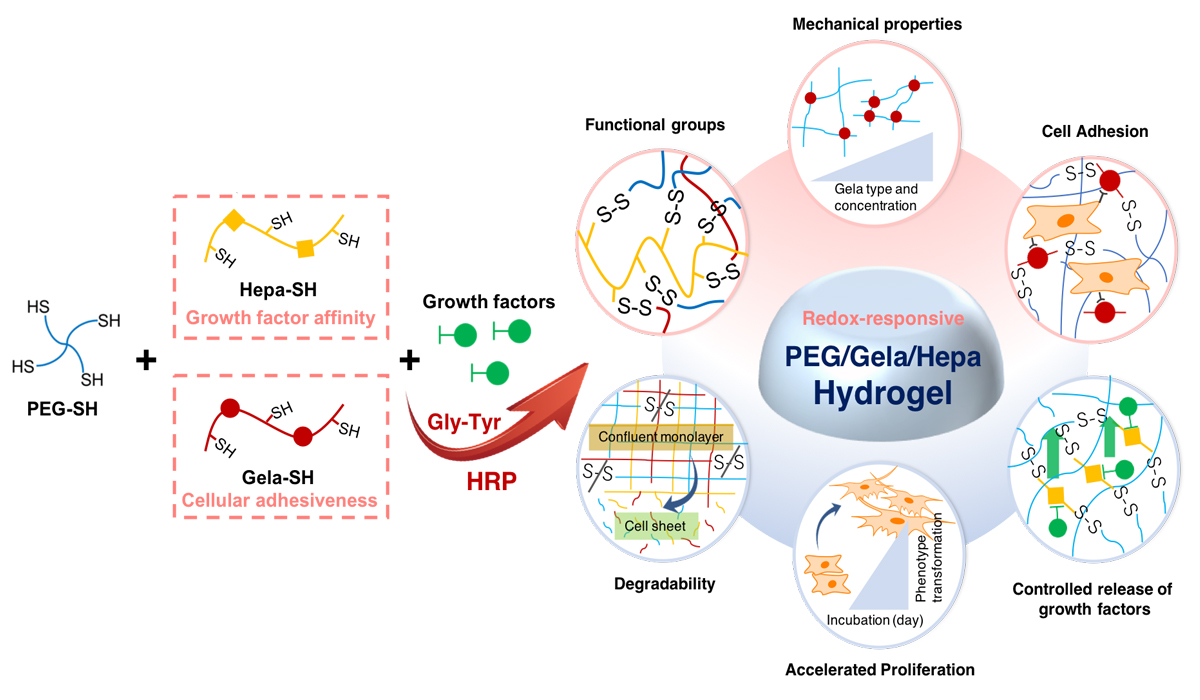
A carotenoid compound β-cryptoxanthin (BCX) is believed to have several functions for human health such as prevention of diabetes mellitus , carcinogenic inhibitory action and immunostimulatory action. However, bioavailability of BCX might be low when orally-administered, due to the extremely low solubility in aqueous media. Emulsification is one of the efficient techniques to obtain highly dispersible formulation for poorly water-soluble ingredients. In the present study, highly dispersible solid formulation containing BCX was prepared by emulsification techniques followed by lyophilization. Kumquat (Fortunella spp.) is a citrus fruit cultivated in Asian countries. BCX was extracted from dry kumquat using the mixture of pyrogallol and ethanol. An O/W emulsion was prepared using an ultrasonic homogenizer by mixing a hexane solution containing the kumquat extract, and an aqueous solution containing sodium caseinate and a sucrose fatty acid ester (L-1695) as an emulsifier. Subsequently, the resulting O/W emulsion was lyophilized to obtain a solid formulation. For the evaluation of the dispersibility, the formulation was added into an sodium phosphate-buffered solution. After filtration of the aqueous mixture using a φ0.80 μm membrane filter, concentration of BCX in the filtrate was determined using HPLC.
Under acidic and neutral conditions, the water-dispersibility of BCX for the solid formulation was much higher than that of kumquat extract alone. Addition of both L-1695 and sodium caseinate was effective to enhance the apparent solubility of BCX under wide pH conditions. Only in the presence sodium caseinate, the dispersibility was very small under weakly acidic condition which is close to isoelectric point for casein. Thus the solid formulation prepared by emulsification techniques was effective to enhance the dispersibility of BCX.
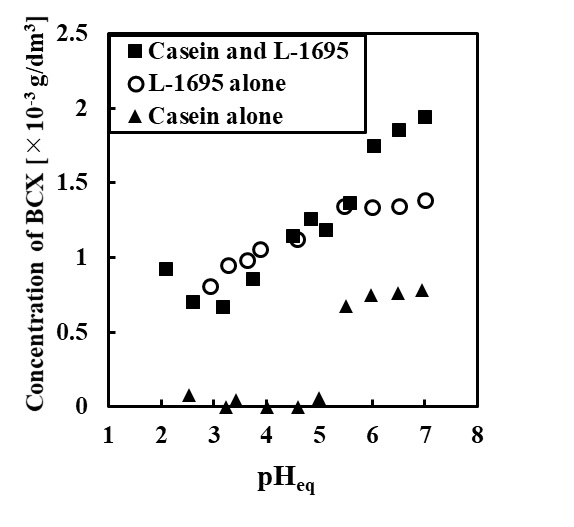
Hepatocytes are a promising cell source for liver tissue engineering and drug screening studies. For the success of such applications, hepatocytes have to maintain liver-specific functions at a high level. Various approaches, such as spheroid (three-dimensional cell aggregate) culture and co-culture, have been adopted to preserve hepatocyte functions in vitro. In this study, we constructed a co-cultured spheroid, which combined hepatocytes with other cells, and evaluated the effects of co-culture on the expression of hepatocyte functions.
As a culture platform for spheroid generation, we fabricated a microwell chip which contained 397 microwells (400 μm in diameter) on a poly-dimethylsiloxane substratum, and its surface was modified with 2-methacryloyloxyethyl phosphorylcholine co-polymer to create the non-adhesive area. In this study, three kinds of cells, primary rat hepatocytes (Hep), mouse fibroblasts (NIH3T3), and human adipose-derived stem cells (ADSC) were used for the spheroid culture, and the spheroid properties were compared in the Hep-spheroid, Hep/3T3-spheroid, and Hep/ADSC-spheroid conditions.
The formation of Hep-spheroid was required approximately 2 days of culture, but the spheroids formation was promoted with the presence of 3T3 cells or ADSCs. Although the 3T3 cells covered the spheroid surface, the ADSCs coagulated in the center of spheroid. Furthermore, almost same spheroid size was maintained in the co-culture conditions during culture period, but the size of Hep-spheroids decreased with the increase of culture time. The albumin secretion ability of co-cultured spheroids (Hep/3T3 or Hep/ADSC-spheroids) was higher than that of mono-cultured spheroid (Hep-spheroid), and especially the function of Hep/3T3-spheroids was highest under all conditions.
These results indicate that the co-cultured spheroids are a promising technique for the maintenance of hepatocyte functions, and the combination of cell species is important factor for modulation of cell functions.
Hydrogel materials have been widely used in tissue engineering and regenerative medicine research. For example, collagen and its derivatives are commonly used as scaffolds to incorporate cells and form 3D complex structures either by molding or 3D printing. However, these structures typically change their form dramatically in cell culture after fabrication due to cell traction forces and/or hydrogel degradation. Here, we propose a 4D (3D+time) tissue engineering approach that incorporates these changes in the design and completes the final structures during cell culture.
We encapsulated NIH 3T3 cells (RIKEN CELL BANK) in type I collagen (3 mg/mL, Nitta Gelatin Inc.) at different cell densities, and monitored the shape change for at least 3 days. Gelatin methacrylate (GelMA) was also used as a hydrogel to encapsulate cells. GelMA has emerged as a preferable hydrogel material in tissue engineering, especially for the applications of 3D bioprinting due to its photocrosslinkable and biocompatible features. By varying the UV crosslinking conditions (e.g. UV intensity and time) and GelMA concentration, as well as cell density, we observed different degrees of hydrogel shape changing during cell culture. We then fabricated bi-layer structures using two components with different shape changing properties. The bi-layer strips curved towards the side which had higher shrinking ratio (or lower swelling ratio). Their curling ratio was recorded and calculated. Furthermore, to demonstrate the capability of this 4D tissue engineering approach, we fabricated a bi-layer structure consisting 6 flower pedals, using collagen hydrogel with and without cells as the inner and outer layers, respectively. We observed the structure to form a flower shape by “closing” its pedals during the 3 days of culture.
In summary, our 4D tissue engineering approach can be employed to form designed structure after fabrication, and will be further explored for use of 3D bioprinting.
Chinese Hamster Ovary (CHO) cells are widely used as host cells in antibody production. The antibody production process has to aim towards high productivity and/or high titer, low operation costs and short production time. To improve productivity, cell flocculation can be applied in cell removal and/or cell culture processes to decrease impurity and turbidity. Calcium chloride is one of the cell flocculants that was studied and optimized for application [1,2]. In addition, low concentration calcium chloride is also being used as supplement in culture medium. In this study, we investigated that calcium chloride addition improved product titer, and decreased turbidity and impurities of cell culture supernatant after cell flocculation.
IgG-producing CHO-HcD6 cells were cultured as batch cultures using serum-free medium supplemented with calcium chloride at the beginning of the cultivation with 6 different concentrations (0.5, 1, 2, 5, 15 and 60 mM). Samples were recovered at the end of batch cultivation until cell viability dropped under 60 %. Cell and IgG1 concentrations during cultivation were analyzed using Vi-cell cell counter and ELISA, respectively. Dipotassium hydrogen phosphate was added at the end of cultivation, and the cells were removed from supernatants by centrifugation. Supernatants were collected for IgG1 concentration, turbidity (OD600) and host cell proteins measurements by CHO Host Cell Protein ELISA kit (Cygnus). Highest IgG1 concentration was 263 mg/L in 2 mM CaCl2. In addition, the turbidity of supernatant after centrifugation was decreased 28.2 % compared to control (without addition).
References:
[1] Chen et al., Bioprocess Biosys. Eng., 40:703–714 (2017).
[2] Burgstaller et al., J. Chem. Tech. Biotechnol., 93:1881-1890 (2018).
For medical biodegradable polyester materials to be used for soft tissue, they must be made in nonwoven or mesh form. There are many ways to make it into nonwoven form, but in order to be used for medical use, it should be a process that does not use chemical additives in manufacturing process and can produce small quantity.
In this study, various processes for the preparation of nonwoven fabrics for soft tissues were studied using biodegradable poly glycolic acid (PGA) and poly lactic-co-glycolic acid (PLGA). The web was well formed in the needle punching process. However, since the strength of the nonwoven fabric is weak and the loss of the process is large, it is considered unsuitable for medical use. The melt blown process was difficult when setting the spinning temperature during manufacture, but it was possible to produce thin, low weight nonwoven fabrics. The flat knitting process is capable of producing meshes with a small amount of 100 ~ 200g of yarn and is suitable for applying expensive biodegradable materials with little loss. In the case of the mesh fabricated by the flat knitting process, it is expected that it can be applied to the part where stretchability is needed in the future because of its excellent stretchability. Circular knitting can produce meshes with a small amount of yarn, and can be manufactured in a thin and light form, but has a disadvantage of curling the cutting portion at the time of cutting. In order to improve the morphological stability, the heat treatment process was introduced and the curling phenomenon was improved and the physical properties were also improved. We have provided a base for manufacturing nonwoven fabrics and meshes for soft tissues that can be used variously according to therapeutic purposes by using medical biodegradable polyester material.
Cataract is caused by the aggregation of crystallin proteins in lens cells of the eye, leading to light scattering and vision impairment. Cataract is known as one of the leading causes of blindness worldwide. Deposition of human γD-crystallin (HGDC), which is a major protein in eye lens, has been linked to cataract. In this study, we used the nuclear magnetic resonance (NMR) spectroscopy in combination with equilibrium chemical unfolding to investigate the structural stability of HGDC. The relatively unstable regions of HGDC were identified by comparing the residual dipolar couplings (RDCs) of HGDC in the environments without and with 5 M urea. Our results suggested that the structure of HGDC is relatively unstable in the regions including residues L92, Q113-R115, and D150-Y151. The structure of HGDC obtained by GeNMR online server was further refined using both residual dipolar couplings results and torsion angles derived from the chemical shift data. Comparison of the structures obtained from different conditions indicated that, relative to its N-domain counterpart, the C-domain of HGDC was more significantly affected by urea. Biophysical characterization of the mutants, which will be obtained by point mutation of the above suggested unstable regions, will be needed for verification.
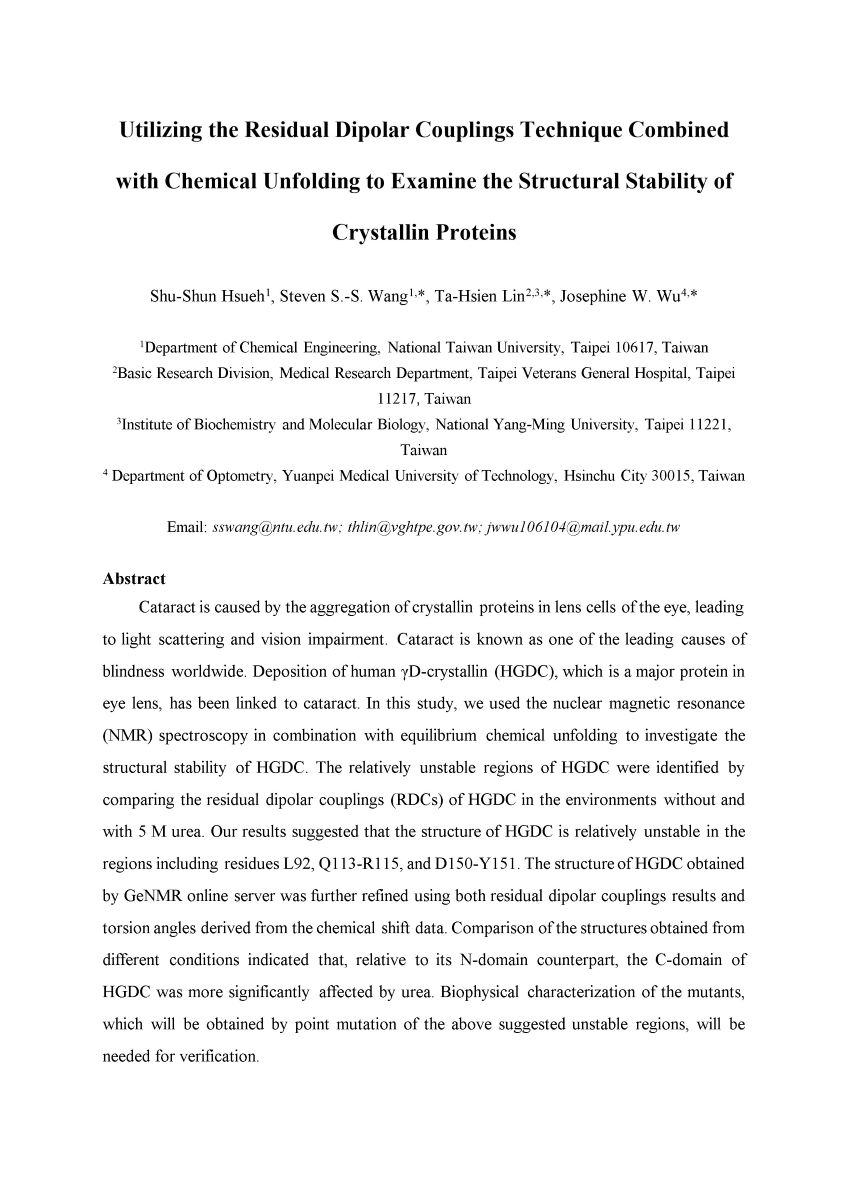
Chinese Hamster Ovary (CHO) cells are the most commonly used host cell for the production of recombinant therapeutic proteins. In the endoplasmic reticulum (ER) of mammalian cells, ER chaperones are responsible for the folding and assembly of secretory proteins. Soluble ER chaperones have a KDEL (Lys-Asp-Glu-Leu) motif at their C-terminus that is recognized by KDEL receptors. Mammalian KDEL receptors are a family of three members that function to ensure the retrieval of ER chaperones from post ER-compartments back to the ER. In this study, we induced ER stress in CHO cells to investigate its effect on the gene expression level of KDEL receptors and soluble ER chaperones, and whether or not this response is correlated. We also hypothesize that overexpression of KDELR1 could increase the rate of retention of chaperones to the ER; therefore, increase the abundance of chaperones in ER and enhance protein folding and assembly.
The target molecules are the three KDEL receptors [KDELR1, KDELR2 and KDELR3] and KDEL chaperones [Binding immunoglobulin protein (BiP), Calreticulin, endoplasmin (GRP94), and Protein disulfide isomerase (PDI A1)]. KDEL receptors' and KDEL chaperones' gene expression during ER stress induction by tunicamycin were analyzed using Real-Time-PCR (RT-qPCR), KDEL receptors showed less than 2 fold-increase in expression level during ER stress. On the other hand, KDEL chaperones showed several fold increase. This uncorrelated upregulation proposes a possibility of the saturation of ER retention machinery (KDEL receptors), or at least hindered retention of ER chaperones under stress conditions. Recombinant stable overexpression of PDI showed increased extracellular secretion of PDI to the extracellular culture medium, indicating the saturation of ER retention machinery in CHO cells. The stable over-expression of Kdelr1 in recombinant IgG1 producing CHO cells improved IgG1 specific productivity.
Cardiac tissue engineering is an emerging field that holds great promise towards the development of innovative treatment strategies for heart disease. Nanofibrus scaffold act as a 2D surface, due to the lack of cell infiltration and hydrogels, which possess a 3D environment, suffer from lack of good mechanical properties. Therefore, by combining these two types of scaffolds, it would be possible to attain a desired 3D environment with good mechanical properties.
In this study, nanofiber-reinforced composite hydrogels were fabricated by incorporating poly (ε-caprolactone) (PCL)/gelatin nanofibers into chitosan (CS)/heart extracellular matrix (ECM) hydrogels.
To fabricate PCL/gelatin nanofibers, the dual electrospinning technique was used. To fabricate CS/ECM hydrogel, the decellularized heart tissue using appropriate combination of detergents was mixed with CS. After preparing solubilized ECM and CS solution, they were mixed in certain quantities together with specified amount of glutaraldehyde as crosslinker. Then the prepared (PCL)/gelatin nanofibers with specified size were put on the homogeneous hydrogel solution and let the hydrogel solution to penetrate into the nanofibers.
Fourier transform infrared spectroscopy (FTIR) spectra show evidence of intermolecular interactions between the CS and ECM in hydrogel.
To evaluate the physical characteristics of the fabricated nanofibers, scanning electron microscopy (SEM) and contact angle analysis were performed. The mechanical properties of the nanofiber-reinforced composite hydrogels were evaluated using Uniaxial tensile teste and the results indicated that the moduli of the nanofiber-reinforced hydrogels were remarkably higher than those of hydrogel alone. The tensile test results indicate that by varying the ratio of both hydrogel and nanofibers components, moduli between 1 to 3 Kpa and 5 to 100 Mpa could be achieved, respectively. By similar test, the native heart modulus was measured to be about 31 Kpa. By incorporating electrospun PCL/gelatin:CS/ECM (the ratio of 2:1), satisfactory mechanical properties close to that of native heart tissue were obtained.
Achieving precise manipulation of stem cell self-renewal and differentiation behaviors will maximize the potential benefits of stem cell therapy. Here, the multifunctional concept of using robust and chemically defined modifications to support stem cell culture is demonstrated to provide synergistic coupling with concurrently immobilized FGF-2 and chitosan, and the resulting cell culture matrix/interface enables the proliferation of spheroids of human adipose-derived stem cells (ADSCs) with augmented stemness in the form of self-renewal and enhanced (trans-)differentiation potential for diversified cell lineages in the mesoderm, endoderm and ectoderm. The modification and the co-immobilization are performed using a straightforward one-step vapor-based coating technology applicable to a wide range of cell culture materials. The concurrent immobilization of FGF-2 and chitosan revealed an important prospective for designing a material interface that confirms that effective and sustainable factors to determine stem cell fate are obtainable using a facile multicomponent modification approach on culture substrates.

Introduction
The safe and convenient yeast Saccharomyces cerevisiae is widely studied for the production of chemicals. D-Lactic acid is used as one of the biodegradable plastic materials. D-Lactic acid production by the engineered microorganisms often requires neutralization of the culture medium and the addition of neutralization reagents, which increase the cost of D-lactic acid production considerably. Previously, we developed a method improving various tolerances such as thermotolerance of yeast through CRISPR-Cas mediated genome evolution. In this study, a lactic acid tolerant yeast was constructed by this method and the resultant yeast was metabolically engineered to obtain a yeast producing D-lactic acid.
Method
First, we constructed a mutant library of lactic acid tolerant yeast by genome evolution method and screened a lactic acid tolerant yeast. Secondly, we integrated glycolytic enzyme genes and D-ldh (from Leuconostoc mesenteroides) into genome DNA of the lactic acid tolerant yeast to modify the expression of these genes. Then, the best strain producing D-lactic acid was screened from the transformants. Finally, we cultured the resultant strain in a non-neutralizing condition, and its fermentation ability and transcription levels of glycolytic enzyme genes and D-ldh were investigated.
Result
We selected δpHδLA2-51 as a lactic acid tolerant yeast, which could grow on YPD+60 g/L lactic acid medium. Engineered strain δ2-51/dP_36, which was constructed by modifying the expression of the glycolytic enzyme genes and D-ldh in δpHδLA2-51, produced D-lactic acid in a yield of 0.30 g/g-glucose in non-neutralizing condition. In the log phase, δ2-51/dP_36 showed higher transcription levels of 9 glycolytic enzyme genes and D-ldh compare to control strain δpHδLA2-51/dP/H.
Acknowledgements
This work was partly supported by JSPS KAKENHI (grant number JP18K14069 and JP18KK0413).
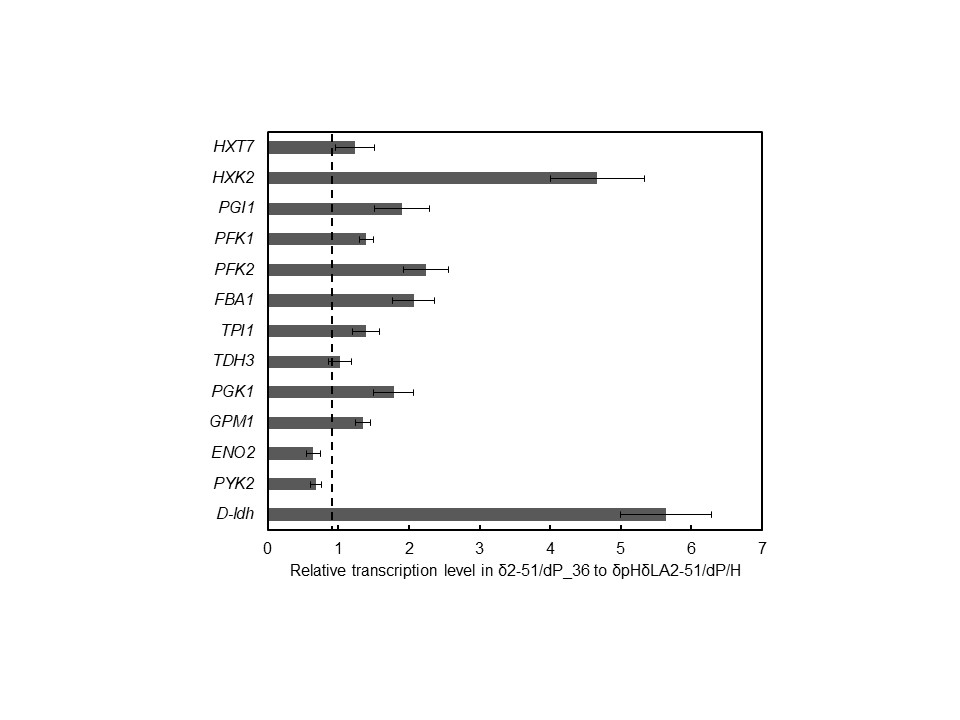
Biodiesel fuel is monoalkyl esters of long-chain fatty acids, which is synthesized by bio-based oils and alcohols as alternatives for fossil fuels. Biodiesel fuel production is usually catalyzed by an alkali catalyst. The use of an enzymatic catalyst allows the use low-grade oil feedstock containing a high percentage of free fatty acids, easy recovery of glycerol, mild reaction conditions, and reduced wastewater. However, an obstacle of enzymatic methanolysis is the limited stability of lipases in the presence of methanol. Therefore, in this study, we improved the stability of the lipase from Thermomyces lanuginosus DSM 10635 in methanol by using protein engineering methods1). The plasmid pE_TLLHis6N, which was constructed by cloning the lipase from T. lanuginosus DSM 10635, was used for producing the wild-type lipase and as a template for constructing site-specific mutant lipases. Escherichia coli BL21 (DE3) cells transformed with the pE_TLLHis6N plasmid (or its derivatives) were cultured in LB liquid media containing 50 mg/L ampicillin sodium salt. The protein expression was induced by the addition of isopropyl-β-D-1-thiogalactopyranoside (IPTG). The proteins were purified by using HisTrap column. The purified enzyme solutions were incubated in the presence of 50% (v/v) methanol at 40°C and the remaining activity was measured. Figure shows the time courses of the remaining activity of the wild-type and mutated lipases in the presence of methanol. Deactivations of the wild-type and mutated lipases obeyed first order kinetics for 0.5~2.0 h. The half-lives of three mutated lipases (A28S, A163D and F174Y) were longer than those of the wild-type lipase. In particular, the half-lives of the A28S were observed to be 6.5 times longer than those of the wild-type lipase. The half-lives of three mutated lipases (A28S, A163D and F174Y) were successfully improved by using protein engineering methods.

Many useful compounds such as, fuel alcohols, plastic and polymer materials, have been produced via the metabolism in microbial cell factories. In order to improve the conversion rate from substrate to the desirable target, it is required to identify and eliminate a rate limiting reaction in the pathway. Specific enzyme activity (Vmax), the parameter representing the maximum reaction rate, is one of the important clues for identifying the rate-limiting reaction. By comparing the Vmax value with actual metabolic flux for each reaction, it should be possible to identify a rate-limiting reaction in the pathway. However, because conventional method for measuring Vmax requires different assay protocols for each enzyme, it was time consuming to investigate multiple enzymes. In this study, we developed a method to simultaneously measure the Vmax values of multiple enzymes in a pathway using a kinetic model with a time course of the intermediate metabolite concentration in vitro experiment. To test the proof of concept, we estimated Vmax values for 9 glycolytic enzymes in Escherichia coli using a previously reported kinetic model and a hypothetical time course data which was generated from a simulation using the model with an arbitrary Vmax set. The parameters of Vmax were optimized to fit the experimental time-series data of the intermediate metabolites. As a result, we successfully estimated the initially set Vmax values. Here we demonstrated the Vmax values estimation using a crude cell extract obtained from wild type E. coli cells. In vitro reaction experiment was performed using the crude cell extract with addition of glucose and essential cofactors. After starting reaction, a sample was collected at every 10 minute and was analyzed with a liquid chromatography tandem mass spectrometry to obtain the time series of intermediate metabolites. In the poster presentation, we would like to discuss more specific research contents.
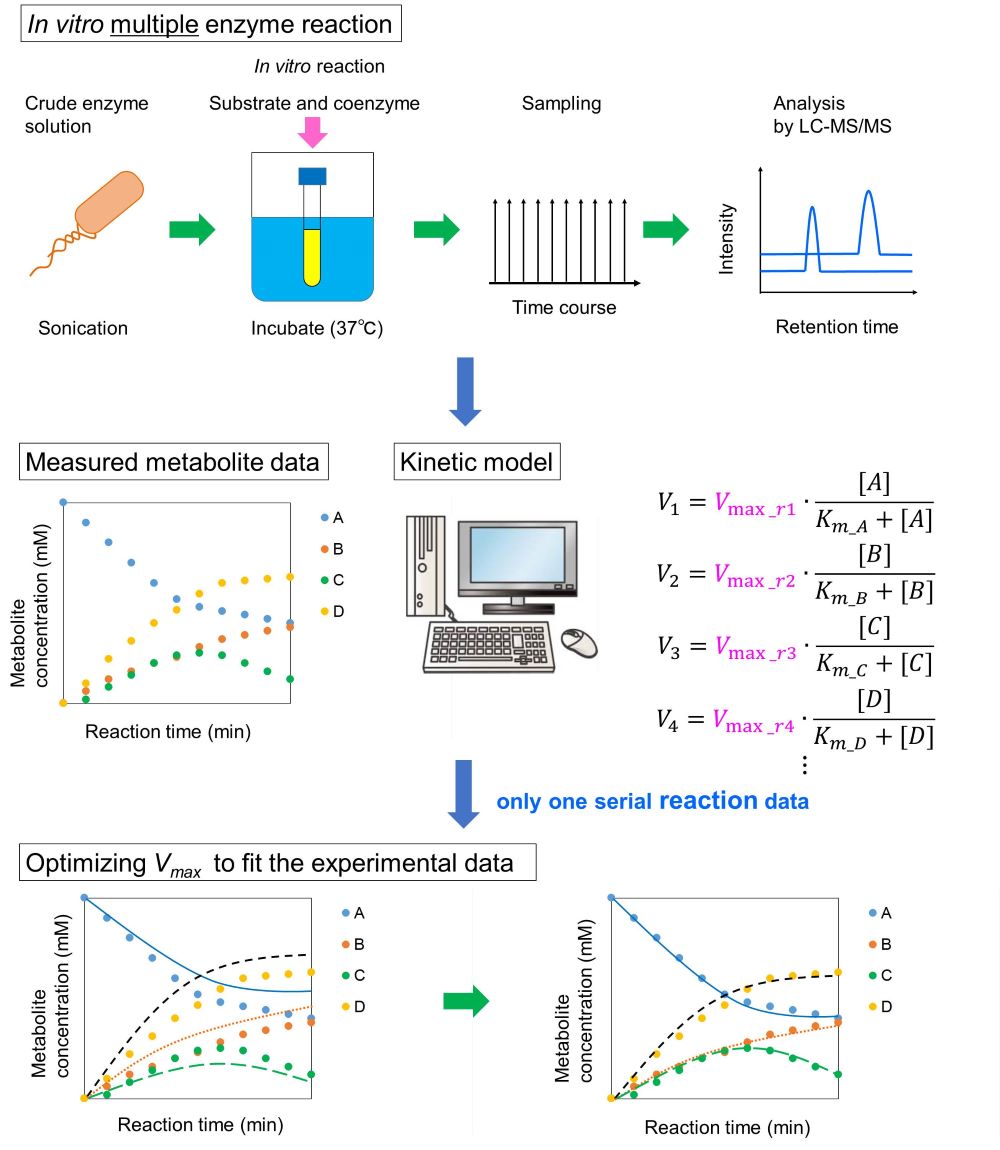
para-Aminobenzoic acid (PABA) is a building block for pharmaceuticals, and it has a great potential to serve as a raw material for aromatic polymers including engineering plastics. Currently, it is produced mainly by multi-step chemical conversions from petroleum-derived toluene via p-nitrotoluene and p-nitrobenzoate. With the recent increases in environmental consciousness, there is a growing interest in the production of PABA from renewable resources by fermentation. Escherichia coli can synthesize PABA from glucose via the central metabolic pathway shikimate pathway and folate pathway. Therefore, in this study, we aimed PABA production from glucose with E.coli. Firstly, we introduced into E.coli two genes pabAB and pabC which express aminodeoxychorismate synthase and 4-amino-4-deoxychorismate lyase respectively and used this engineered strain to produce PABA from glucose. The strain produced up to 1.92 g/L of PABA from 20 g/L glucose. Secondly, to increase PABA production, we tried to enhance the shikimate pathway of this engineered strain by introducing aroA, aroB, aroC, aroD, and pA1lac promoter-controlled aroFfbr respectively. However, these strains exhibited no increase in PABA production. Thirdly, we tried to enhance the folate pathway of E. coli overexpressing pabAB and pabC genes by adding Glutamine at 10 mM. As a result, by adding Glutamine at 10 mM, PABA production increased up to 3.03 g/L. This result suggests that the folate pathway is the rate-limiting step and the folate pathway needs to be enhanced to further increase PABA production.
Introduction
Although, yeast Saccharomyces cerevisiae has been used to produce various bio-based chemicals including solvents and organic acids, most products inhibit their growth at high concentrations. In general, it is difficult to rationally improve stress tolerance in yeast by modifying specific genes because many unspecified genes are involved in stress response. Previous studies reported that various stress tolerance in yeast was improved by introducing random mutations such as DNA point mutations1) and DNA structural mutations. In DNA point mutagenesis, protein functions and activities can be altered by changing several bases. On the other hand, in DNA structural mutagenesis, expression levels of multiple proteins can be altered by changing a wide range of bases. In this study, we developed a novel mutagenesis strategy combining point mutagenesis and structural mutagenesis to construct yeast with high 2,3-butandiol (2,3-BDO) tolerance.
Results
A DNA point mutation and a structural mutation were simultaneously introduced into S. cerevisiae YPH499 strain while stepwise increasing the concentration of 2,3-BDO. Resultant mutant YPH499/pol3δ/BD_392 showed 1.3- and 2.6-fold higher cell concentrations than parent strain YPH499 after 96 h cultivation in media containing 125 and 150 g/L of 2,3-BDO, respectively.
Conclusion
We successfully developed the novel mutagenesis strategy combining point and structural mutagenesis and constructed yeast with high 2,3-BDO tolerance. The strategy developed in this study achieves efficient modification of yeast genomic DNA, and thus it can be applied for construction of mutant yeasts with various stress tolerance. Besides, it is expected to further elucidate resistance mechanisms and further improve tolerance by detailed analysis of mutants with improved tolerance.
Acknowledgments
This work was partly supported by JSPS KAKENHI (grant number JP18K14069 and JP18KK0413).
Reference
1. H. Abe et al.; J Biosci Bioeng 108:199–204 (2009)
Isopentenol is promising biofuel with more favorable combustion properties. Because isopentenol shows some attractive characteristics, such as higher energy density, lower water miscibility, and better low-temperature fluidity than other biofuels, it is expected as alternatives of gasoline and jet-fuel. Supplies of petroleum, the conventional source of isopentenol, are unsustainable, and chemical synthesis processes could cause serious environmental problems. As an alternative, the biosynthesis of isopentenol from biomass is more sustainable and environmentally friendly. Therefore, we tried to produce isopentenol by engeneered Escherichia coli. Firstly, we introduced seven genes (atoB, mvaS, mvaE, ERG12, ERG8, MVD1 and nudB) into Escherichia coli and used this engineered strain to produce isopentenol from glucose. This strain (ISO-1) produced 68.1 mg/L isopentenol and accumulated 3.83 g/L mevalonate from 20 g/L glucose. Secondly, we constructed ISO-2 strain enhanced pathway after mevalonate. This strain produced 171 mg/L isopentenol and accumulated 1.01 g/L mevalonate from 20 g/L glucose. Thirdly, we constructed ISO-2 with glcB knockout (ISO-2ΔglcB) and aceBA knockout (ISO-2ΔaceBA) and tried to strengthen the flux to isopentenol. As a result, it succeeded in further improving the isopentenol production. ISO-2ΔglcB and ISO-2ΔaceBA produced 434 mg / L and 472 mg/L isopentenol. This result suggests that reducing Acetyl-CoA consumption and redirecting metabolic flux for isopentenol production is important for isopentenol production. ISO-2ΔaceBA succeeded in about 7 times isopentenol production of ISO-1.
Fatty acids are used for fuels, cosmetics, pharmaceuticals. Currently, they are made from natural fats and oils. Production technology using bacteria has been studied, but it has not reached a practical level. Previous studies have shown that palmitic acid and oleic acid account for 90% of the fatty acids excreted from cells when producing fatty acids from glucose using Corynebacterium glutamicum. In this study, we tried to produce palmitic acid and oleic acid using metabolically engineered C. glutamicum. First, we disrupted fasR(strain1). Second, we introduced the plasmid containing cgR0949-tfu0939 encoding cellobiose degrading enzyme, β-glucosidase(BGL), into strain1 to produce fatty acid from cellobiose. This strain intracellularly produced 0.606 g/L of palmitic acid and 0.536 g/L of oleic acid from cellobiose in test-tube after 72h. Third, we disrupted two genes (pyc and ppc) to accumulate acetyl-CoA. The strain disrupted fasR and pyc (strain2) extracellularly produced 0.130 g/L of palmitic acid and the strain disrupted fasR and ppc (strain3) ectracellularly produced 0.0676 g/L of oleic acid from glucose in the test-tube after 72h.
Pichia membranifaciens KS47-1 have been isolated from environment as a resistant yeast as growth inhibitory materials in hydrolysates derived from lignocellulosic biomass. The strain has a great potential of host yeast for cell factories to be applied a broad ranges of bio-products, after introducing metabolic pathways. In this study, the responses of gene expression in the strain were differentially analyzed between in a corncob hydrolysate and in the hydrolysate removing the inhibitory materials by activated carbon treatment by RNA-sequence analysis. The hydrorated corncob (1:10 of solid/water ratio) were hydrolyzed at 121°C for 1 h by 3.0 % sulfuric acid, and subsequently treated at 50°C for 3 days by a cellulase. Activated carbon (AC) of 3% w/v were added and absorbed inhibitory materials in the hydrolyastes for 3 h, and were removed by a filteration. Although KS47-1 growth was observed in the both of hydrolysates prepared, the latent growth was shown in the hydrolyastes without AC treatment. Duplicated RNA-seq analyses were performed for the logarithmic growing cells in each hydrolysates with 11.4 to 13.7 M reads (Q30: >94%). Top-Hat2 mapping was carried out with 103% of mapping ratio and 30% coverage. The sequencing depths were among 4.4 to 6.8 folds. According to gene ontology analysis, toxicity compounds in hydrolysates stimulated many of membrane transporters. The expression levels of ATP-binding multi drag transporters, TPO3, SNQ2, and PDR5 were increased 1.74, 1.63, and 1.46 as log2 fold changes, respectively (p value = 0.00005). The results implied that KS47-1 efficiently evacuate the inhibitory compounds by the activities of the transporters responded to increasing the toxic compounds in the cytosol.
In order to solve environmental and resource exhaustion problems and achieve an environmental sustainable society, a biorefinery that produces a variety of bio-based products from renewable biomass resources is important. At present, by microbial organisms using C5/C6 sugars, the production of target compounds currently being produced from petroleum is important. In particular, it is expected that the demand for unsaturated hydrocarbons having double bonds, which can be used as a polymer raw material, will increase rapidly.
To produce these compounds, we focused on ferulic acid decarboxylase (FDC). FDC can catalyze the decarboxylation of the R-C=C-COOH side chain end of the hydrocarbon unsaturated carboxylic acid (such as ferulic acid) and converts it to R-C=C (such as styrene). For this decarboxylation reaction, FDC requiters a prenylated-FMN (prFMN) as a cofactor, which is synthesized from FMN and dimethylallyl-phosphate by prenyltransferase.
In this study, to bio-synthesize target α,β-unsaturated compounds, we screened several genes encoding FDC and prenyltransferase. Then the FDC showed the highest decarboxylase activity was selected as a template and we developed FDC variants to enable production of target molecules efficiently based on the rational design of enzyme. Recent years has seen significant interest in a rational design in which a mutation is introduced at pinpoint relative to the active site of the enzyme. As a host for enzyme screening and substance production, Escherichia Coli was selected. Finally, with the combination of precursor-producing microbial cell and decarboxylase mutants, we aim to develop a microbial cell factory that produces α,β-unsaturated target compounds efficiently and directly from renewable carbon source glucose.

Metabolic engineering is a promising method for maximizing the production of specific metabolites. Saccharomyces cerevisiae and Escherichia coli are common hosts for metabolic engineering. However, these microorganisms require an aerobic growth phase with aeration and vigorous agitation before the fermentation production phase. As a consequence, bioproduction systems are often economically unsustainable, particularly for the bulk production of chemicals or biofuels. Moreover, because of the requirement for aeration during the growth phase, it is usually challenging to scale-up the fermentation process. This study aimed to construct a platform microorganism for anaerobic bioprocessing (ABP), which requires neither aeration nor vigorous agitation.
The lactic acid bacterium Lactobacillus plantarum maintains a similar growth rate under both aerobic and anaerobic conditions, which enables the growth-associated production of lactate without the need for aeration and vigorous agitation. Therefore, L. plantarum is a suitable host for ABP. However, the strain converts most of the fermented sugar into lactate. To prevent the production of lactate, we disrupted both L- and D-lactate dehydrogenase genes (ldhL1 and ldhD, respectively) in L. plantarum. Then, to promote ethanol fermentation, we introduced in the ΔldhL1 ΔldhD strain pyruvate decarboxylase and alcohol dehydrogenase genes from various origins. For the strain showing the highest ethanol titer, ethanol fermentation was performed from 150 g/L glucose in a 1 L jar fermenter. After 100 h of fermentation, 56.7 g/L of ethanol was successfully produced.
Our next challenge is to produce ethanol from lignocellulose hydrolysates which contain both C6 and C5 sugars. To redirect the phosphoketolase pathway (which produces equimolar amounts of pyruvate and acetate from pentose sugars) to the pentose phosphate pathway (which only produces pyruvate from pentose sugars), we replaced the phosphoketolase gene (xpk1) with the transketolase gene (tkt) from Lactococcus lactis. Using this strain, ethanol fermentation from C5 sugars are now under consideration.
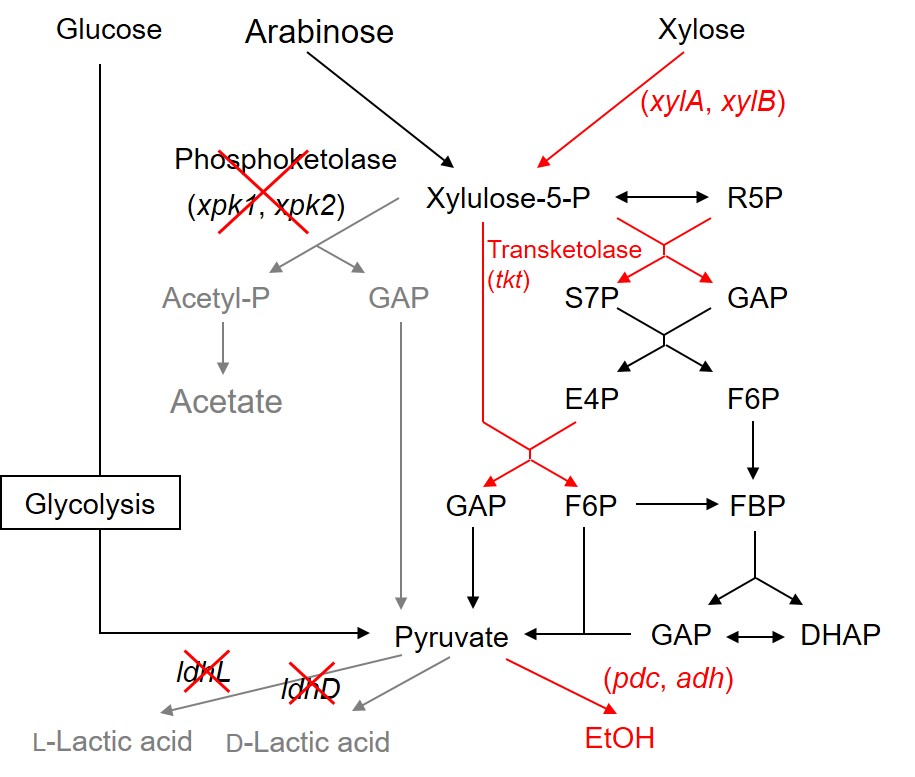
1. Introduction
Polyhydroxyalkanoates (PHAs) are biodegradable and produced by microorganisms from biomass. They are expected to reduce plastic wastes and carbon dioxide emissions compared to conventional fossil resource-derived plastics. Compostable PHA filtration membranes will be useful to develop environmentally benign filtration processes. In this study, PHA porous membranes were prepared using phase separation method, and membrane forming conditions were examined for application to microfiltration membranes.
2. Materials and methods
Typically PHA (extrusion grade, Goodfellow) was dissolved at 10-20% on a hot stirrer at 85 °C in 1,4-dioxane (DIOX), 1-methyl-2-pyrrolidone (NMP), or N,N,-dimethylformamide (DMF). After cooling to 50 °C, the PHA solution was cast onto a glass plate with a 0.5 mm thick frame which was preheated at the same temperature as the solution. It was immersed in a water bath (25 °C) to induce its phase separation. The filtration resistances of formed flat-sheet membranes were calculated from the filtration rates measured by the filtrations of purified water at 10 kPa, and the retention ratios were from the filtrate turbidity at a wavelength of 660 nm after filtration of suspensions of latex beads with a diameter of 0.3 μm.
3. Results and discussion
Flat sheet membranes were obtained from the 20% PHA solutions while no flat ones were obtained from the 10% polymer solutions. The prepared PHA flat membranes have asymmetric structures having a dense layer in the surface portion in contact with non-solvent water at the time of phase separation, and a porous structure inside. The PHA membrane prepared with DMF as a solvent showed the lower filtration resistance and the higher retention of latex beads compared to the membrane prepared with DIOX and NMP. The polymer concentration was optimized to be 18%. The PHA filtration membrane will be one of the key materials to achieve sustainable development goals (SDGs).
Fatty acids are valuable products because they have wide industrial applications in the manufacture of detergents, cosmetics, food, and various biomedical applications. In enzymecatalyzed hydrolysis, the use of immobilized lipase results in high production cost. To address this problem, Eversa Transform lipase, a new and low-cost liquid lipase formulation, was used for the first time in oil hydrolysis with gac oil as a triglyceride source in this study. Response surface methodology was employed to optimize the reaction conditions and establish a reliable mathematical model for predicting hydrolysis yield. A maximal yield of 94.16% was obtained at a water-to-oil molar ratio of 12.79:1, reaction temperature of 38.9 degree C, enzyme loading of 13.88%, and reaction time of 8.41 h. Under this optimal reaction condition, Eversa Transform lipase could be reused for up to eight cycles without significant loss in enzyme activity. This study indicates that the use of liquid Eversa Transform lipase in enzyme-catalyzed oil hydrolysis could be a promising and cheap method of fatty acid production.
Rice husk, a form of biomass material, is a potential source of renewable energy. Recovering silica from rice husk is an important element in manufacturing high value-added products, and ensures efficient utilization of a bio-resource. This paper reports the synthesis of SBA-15 mesoporous silica from recycled rice husk ash waste. Next, graphene oxide/order mesoporous carbon (GO/CMK-3) nanocomposite was synthesized using the SBA-15 template. This investigation characterized GO/CMK-3 materials through transmission electron microscopy (TEM), field–emission scanning electron microscopy (FESEM), X-ray diffractometry (XRD), surface area analysis, and Raman spectrometry. Various experimental parameters including the kind of adsorbent, initial concentration of dye, and solution temperature were investigated. TEM of the synthesized GO/CMK-3 revealed that carbon material possessed a well-ordered array of mesopores with a uniform pore size. The surface area and pore volume of RH-CMK-3/GO sample were 936 m2/g and 1.077 cm3/g, respectively. GO/CMK-3 showed the higher capacity for dye adsorption than that of pure SBA-15 and CMK-3. Increasing the initial concentration of methylene blue (MB) could enhance the adsorption rate. The adsorption capacities were decreased with an increase in the solution temperature. The thermodynamic analysis reveals that the adsorption process was exothermic and spontaneous. The GO/CMK-3 composite contained considerable degree of oxidation with different functional groups, which could efficiently bind a dye molecule to form a dye complex. The GO/CMK-3 composite is a potential low-cost adsorbent for removal and recovery of industrial dye from wastewater.
Shochu lees is a distillation residue discharged during shochu production, and it is one of major organic wastes available for sustainable bioenergy production. The nonconformity with the composition variation of the waste may lower the activity of methanogens in a two-stage hydrogen and methane fermentation process. One of them is the effect of organic acid concentration on methane production. In order to maintain the activity of methanogens, the organic acid concentration in the substrate must be kept constant. However, the appropriate organic acid concentration for the activity of methanogens has not been reported. In methane production, 70% of the produced methane is due to the decomposition of acetic acid and is carried out by the acetylotrophic methanogens. In this study, we focused on acetic acid concentration. Sodium acetate (0.002, 0.01, 0.02, 0.03 and 0.2 mol/L) was added to the fermented broth which had been acclimated for a long time, and cultivation was carried out at 37 °C, at pH 7. Methane gas was most generated at acetic acid concentration of 0.03 mol/L. Therefore, it was found that the acetic acid concentration in the substrate of 0.03 mol/L was suitable for the activity of acetylotrophic methanogens in methane production. The results showed that the activity of methanogens can be maintained by maintaining the acetic acid concentration at 0.03 mol/L in the acetic acid concentration in the substrate. In this case, methane was produced immediately after the start of fermentation. This study showed that by maintaining the acetic acid concentration in the substrate at 0.03 mol/L, the activity of methanogens is maintained and the production of methane in a short time can be achieved.
Introduction
It is known that red raspberry (Rubus idaeus) contains various polyphenol compounds at high concentration and its functionality is expected to have health maintenance and disease prevention effect. Not only the fruits, but also the leaves of raspberry plants, are highly esteemed for tea making around the world and are largely used for food. We are interested in the relationship between the polyphenol content of raspberry and the cultivation environment. In this report, we discuss the results of on the effect of light and temperature on polyphenol accumulation in raspberry leaves.
Results and discussion
When raspberry was cultivated in a plant factory unit and light intensity, wavelength, and temperature were varied, the amount of total polyphenol increased under blue light. Quantitative determination of flavan-3-ol derivatives {(+)-catechin, (–)-epicatechin and condensed tannin}, quercetin derivatives and hydrolysable tannin (Figure 1), was carried out using HPLC. Among them we confirmed flavan-3-ol derivatives increase under blue light. Semi-quantitative RT-PCR showed no correlation between flavan-3-ol derivatives-related gene expression and the amounts of the compounds measured in the leaves.1
Ref. (1) R. Kobori et al., Metablites,2019,9, 56.
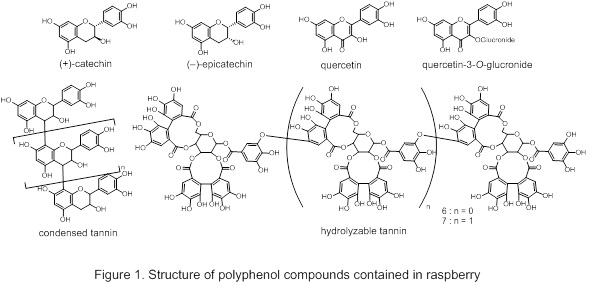
Cattle urine is one of large amount of waste in dairy industries, and often insufficiently decomposed in a reservoir and sprayed on farmland as fertilizers. However, the immature fertilizers sprayed causes problems in exhausting awful smell and in water pollutions of land water. In this study, it investigated the botanical effects of mature and immature cattle urine on germination of Japanese mustard spinach, Brassica rapa var. perviridis, and enhancing growth of tomato, Solanum lycoperisicum L., and B. rapa. Treatment by long-term aerations led microbial degradation of malodorous substances and germinating-inhibitory materials, and reduced the awful smell from the fermented urine. Immature fermented urine inhibited germination of B. rapa, but mature urine never. In hydroponics, the growth of B. rapa and S. lycoperisicum were enhanced by the matured fermented urine, with diluting 1/10 in water (Fig. 1). Equivalent results were observed in a commercial culture soil. Murashige and Skoog medium including 1/10 mature fermented urine also enhanced the growth of B. rapa. The weight with the mature fermented urine was three fold larger than that without the fermented urine. Total nitrogen, phosphate and potassium as inorganic nutrients were less than 290 mg-N/L, 26 mg/L, and 2,700 mg/L, respectively. The amounts of N, P, and K as nutrients were insufficient to stimulate the growth to the equivalent levels, as inorganic fertilizers. Interestingly, the fermented urine maintained the growth stimulating ability after autoclaving (121 °C, 20 min). From the results, there is possibility that thermal-stable organic chemicals in the sufficient fermented urine can act to stimulate the growth of plants, and next-generation fertilizers from cow urine may be produced in the future.
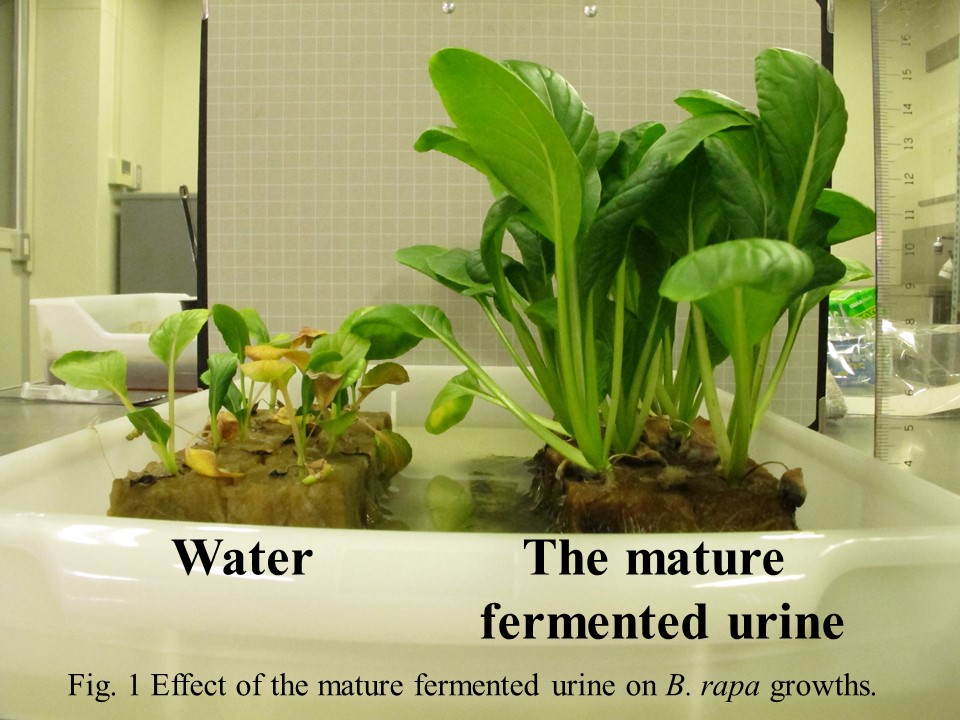
The utilization of biomass is required to establish a sustainable society. Rice bran, a byproduct in the refining of brown rice, is mainly used for producing rice oil. At this time, the defatted rice bran is generated as a residue. A method of effectively utilizing defatted rice bran is required. Several studies have reported that defatted rice bran contains various functional substances, especially protein and amino acids. The protein of rice bran has a highly nutritious with a well-balanced amino acid composition. Rice bran also contains many useful amino acids, such as γ-aminobutyric acid which has various functionalities.
We suggested that the preparation of an extract containing functional substances from defatted rice bran could be connected to new possible applications. Hot compressed water was used as the solvent for extraction. We expected that hot compressed water would hydrolyze the protein of defatted rice bran and increase the amount of amino acid extracted. The purposes of this study are to evaluate amino acids in the extract prepared from defatted rice bran and to reveal the reaction of protein or amino acids in hot compressed water.
The defatted rice bran was prepared from rice bran by the extraction process using hexane. The defatted rice bran was treated under different temperature conditions to prepare an extract. The extract was deproteinized and subjected to amino acid analysis.
Fig. 1 shows the total amount of 20 amino acids that constitute a protein obtained at each of the evaluated temperatures. The total amount of amino acids decreased as the temperature increased. The results suggest that the protein of rice bran was not decomposed amino acids in these temperatures. It is also considered that amino acids were decomposed or bonded to other substances by intermolecular dehydration or Maillard reaction.
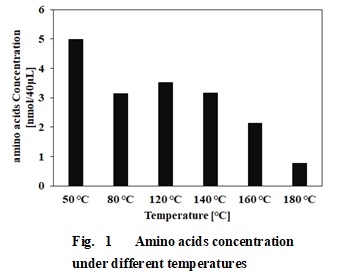
The production of biofuels by engineered microorganisms has recently become an attractive option, because of the global environmental problems and the combustion of fossil fuels. Among various biofuels, long chain alkanes and alkenes are superior compared with other biofuels like ethanol due to its high energy density and compatibility with modern internal combustion engines. Although an Escherichia coli strain that produces alkanes and alkenes was constructed by heterologous expression of acyl-acyl carrier protein reductase from Synechococcus elongates (SeAAR) and aldehyde decarbonylase from Nostoc punctiforme (NpAD) (1), its productivity did not fulfil industrial requirements.
In this study, effects of the promoter for NpAD expression on the alkanes production by engineered E. coli was evaluated. And improvement of the solubility of SeAAR was tried.
Plasmids pESeAAR-trcNpAD and pET7SeAAR-T7NpAD which express SeAAR and NpAD simultaneously were constructed. pESeAAR-trcNpAD expresses SeAAR by T7 promoter and NpAD by trc promoter, whereas pET7SeAAR-T7NpAD expresses both SeAAR and NpAD by T7 promoter. E. coli BL21 (DE3) cells were transformed using these plasmids and the resultant transformants were named BL21/pESeAAR-trcNpAD and BL21/ pET7SeAAR-T7NpAD. Furthermore, random mutation was introduced into the SeAAR gene using error-prone PCR to obtain mutated SeAAR which solubility was improved.
The amounts of alkanes produced by BL21/pET7SeAAR-T7NpAD was 1.5-fold larger than those by BL21/pESeAAR-trcNpAD. And mutated SeAAR which solubility was improved was successfully obtained.
(1) Andreas, S. et al.; Science, 329, 559-562 (2010).
We successfully isolated new freeze-tolerant yeast SRT88 from Hokkaido Saroma Lake. In this study, taxonomic characterization of SRT88 and bread manufacturing using the strain. The strain identified as Zygosaccharomyces rouxii that is known as a fermenting yeast in soy source manufacturing. The freeze tolerance of the yeast was observed higher than that of Torulaspora delbrueckii NBRC1129 known as freeze tolerant yeast. To characterize the strain in the dough for frozen storage method, fermentabilities in dough were examined after freezing and thawing. Although SRT88 fermentability demonstrated 117 mL lower than a commercial dry yeast 316 mL, the strain showed 114 mL after 1 week-frozen-storage which was higher fermentability than a dry yeast of 67 mL and maintained the level of fermentability after 2 weeks-frozen-storage. Furthermore, SRT88 fermentability was improved to use glucose. The fermentability using glucose was 40% higher than that using sucrose. In an analogous fashion, crumb hardness of baked bread using SRT88 was 1.17± 0.16 N , on the other hand after storage was 1.68±0.23 N lower than that using a commercial dry yeast was 1.92±0.40 N. According to the results, SRT88 showed an advantage for bread manufacturing including frozen storage. SRT88 gave different flavor to bread from commercial dry yeast on the basis of volatile component analysis with GC/MS and statistical analysis of orthogonal projections to latent structures discriminant analysis (OPLS-DA). Heat map result showed that SRT88's bread has characteristic volatile component of 2-Ethyl-1-hexanol (Fig. 1).
In conclusion, SRT88 showed stable fermentability during frozen dough method and flavor is different from commercial dry yeast to fewer frozen damage to dough after frozen. The results demonstrated a possibility that SRT88 use frozen dough method

Non-conventional yeast (NCY) in cool temperate zone and subarctic zone has possibilities of adapting to frozen stress in winter. Several freezing-tolerant-NCYs, which demonstrated higher freezing-resistance than previous reported yeasts, have been isolated from environment. The mechanisms of frozen resistance of the isolates have not been revealed. Saccharomyces cerevisiae, well-known yeast species, accumulates sugar alcohols and amino acids in their cytosol, and resists to frozen stresses with buffering by the materials. In this study, we investigated the frozen-adapting mechanism of the isolates, Zygosaccharomyces rouxii SRT88 and Candida tropicalis SRF61, to comparing metabolomes among the taxonomically related strains.
Metabolites were extracted by methanol/chloroform (1:2) from freeze-dried cells, and trymethylsilirated by methoxamine hydroxylate and N-Methyl-N-trimethylsilyltrifluoroacetamide. The trimethylsilylated derivatives were analyzed by GC-MS. Orthogonal projections to latent structures (OPLS) were used for modeling the differences of metabolites.
According to OPLS, high correlated modeling were achieved between metabolite composition and freeze-resistance (R2>0.95, Q2>0.90) .The significant metabolites were filtered by variable importance in projection (VIP) scores and p values in analysis of variance (VIP ≥ 1.0, p ≤ 0.05).Based on the results, C. tropicalis SRF61 accumulated higher concentrations trehalose and aspartic acid than the referenced strains, and Z. rouxii SRT88 higher D-mannitol. Aspartic acid was a novel cryoprotectant metabolite in the best of our knowledge. The possibility of variety in freezing-tolerant mechanism of NCYs were demonstrated in this study.
Microbial production of 1,5-diaminopentane is from renewable feedstock is a promising and sustainable approach to produce bio-based polyamides. In this study, we constructed beta-glucosidase (BGL) secreting Corynebacterium glutamicum, and direct 1,5-diaminopentane production from cellobiose as well as glucose was demonstrated. First, C. glutamicum was metabolically engineered to create L-lysine (a direct precursor of 1,5-diaminopentane) producing strains. Then L-lysine decarboxylase (ldcC) derived from E. coli and BGL from Thermobifida fusca YX (Tfu0937) were co-expressed. This engineered C. glutamicum strain produced 27 g/L of 1,5-diaminopentane from cellobiose in CGXII minimal medium in a fed‐batch cultivation. The yield was 0.43 g-1,5-diaminopentane / g-glucose (1 g of cellobiose corresponds to 1.1 g of glucose). These results demonstrated the feasibility of 1,5-diaminopentane production from cellobiose or cellooligosaccharides as alternative substrates using engineered C. glutamicum strain.
Mevalonate is a precursor of isoprenoids and has been used in cosmetics and as building block for the production of functional polymers. It is difficult to industrially produce mevalonate by chemical synthesis, because mevalonate used in cosmetics is need to be (R)-enantiomer. Thus, mevalonate is produced by fermentation of microbes from glucose. However, there still remain problems that yields of mevalonate is not sufficient. Therefore, we tried to develop highly efficient production of mevalonate by metabolic engineering of Escherichia coli.
First, we introduced into E.coli three genes which express Acetyl-CoA acetyl transferase, HMG-CoA synthase and HMG-CoA reductase (atoB, mvaS and mvaE respectively). This strain produced 2.16 g/L mevalonate from 20 g/L glucose.
Next, we tried to improve production capacity of mevalonate by disrupting some genes. Because three molecules of acetyl-CoA are required to synthesize one molecule of mevalonate, the amount of acetyl-CoA is considered to affect the production of mevalonate. To accumulate acetyl-CoA, we constructed MG1655ΔppcΔaceBA strain. This strain produced 6.00 g/L mevalonate from 20 g/L glucose.
Finally, we tried to produce mevalonate from cellobiose. To give the E.coli an ability to break down cellobiose, we displayed β-Glucosidase(BGL), Tfu0937, on the E.coli cell surface using Blc as an anchor protein. BGL-displaying MG1655ΔppcΔaceBA strain produced 5.72 g/L mevalonate from 20 g/L cellobiose. We succeeded in producing mevalonate from cellobiose for the first time.
Shikimic acid is a valuable hydroaromatic compound and a key metabolic intermediate. Currently, shikimic acid can be obtained from fruit of Chinese star anise, but there are problems of feedstock limitation and extraction cost. Therefore, production of shikimic acid from renewable resources such as cellulosic biomass is required. Corynebacterium glutamicum is widely used for industrial production of amino acids including L-glutamate and L-lysine. However, C. glutamicum doesn't accumulate shikimic acid, and can not assimilate cellulose originally. Cellulose is degraded to cellobiose by cellulolytic enzymes, and cellobiose is degraded to glucose by β-glucosidase(BGL). At first, we tried to produce shikimic acid from cellobiose using metabolically engineered C. glutamicum with BGL. In this study, to accumulate shikimic acid in C. glutamicum, we disrupted several genes including aroK, qsuD, qsuB, nagD. We also disrupted pyk gene for improving availability of PEP, and mutated gnd gene to improve pentose phosphate pathway. Furthermore, we expressed the BGL gene(cgR0949-tfu0939) in C. glutamicum to produce shikimic acid from cellobiose. As a result, we successfully produced 2.8 g/L of shikimic aicd from cellobiose using engineered C. glutamicum. Deletion of pyk and mutation of gnd improved shikimic acid productivity.
Microbial bioproduction have attracted much attention because of the increasing demand for environmentally-friendly bioprocesses. We focused on the production of mevalonate by Escherichia coli. Mevalonate is one of the important compounds, which is utilized as the intermediate of a medicinal or a cosmetic compound and is the metabolic intermediate for synthesizing terpenoids. Here, we attempt to improve the production of mevalonate by using single gene knockout strains. The plasmid including mevalonate-producing genes (pMev) was transformed into a single gene-deficient E. coli BW25113 strain, and cultivated with 20 g L-1 glucose and 5 g L-1 yeast extract containing minimal medium. Mevalonate production was determined using a gas chromatograph equipped with a flame ionization detector. BW25113 harboring pMev produced mevalonate from glucose at a concentration of 0.8 g L-1 after 48 hours cultivations (WT). Then, the effect of single gene knockout on mevalonate production was evaluated. The deletion of several genes was effective for improving the production of mevalonate. The production of mevalonate with a gltA-deficient strain, an aceA-deficient strain, an aceB-deficient strain and an acnA-deficient strain were increased compared with WT (1.4 g L-1, 0.9 g L-1, 1.3 g L-1, 1.0 g L-1, respectively). These genes are involved in acetyl-CoA catabolism in the glyoxylate shunt, and acetyl-CoA level is critical for enhancing the production of mevalonate because acetyl-CoA is metabolic intermediate for the synthesis of mevalonate. The deletion of cyaA, which is involved in catabolite repression, was also effective for the improvement of the production of mevalonate (1.7 g L-1).
Photosynthetic microalgae attract much attention as a sustainable green cell factory, and genetically modified microalgae have been expected to be a useful tool for bioenergy and recombinant protein production. However, random integration of transgene in the microalgae nuclear genome is susceptible to gene silencing of heterologous gene expression1. Here, we attempted to perform targeted gene integration into a pre-determined nuclear genomic site of Chlamydomonas reinhardtii using Cre/loxP recombination system for stable transgene expression. We constructed an expression vector plasmid encoding reporter genes (zeocin resistant gene and green fluorescent protein [GFP] gene; Zeo-2A-GFP) and mutated loxP to generate founder cells. The plasmids were introduced into C. reinhardtii by electroporation and the cells were screened by zeocin. Cell clones exhibiting the stable expression of the reporter genes during culture were selected from transformants using FACS. A donor vector containing target genes flanked by corresponding mutated loxPs was constructed and introduced into founder cells together with a Cre expression vector. After Cre-mediated gene integration, paromomycin resistant gene and IFNα-4 expression cassettes of the donor vector were integrated into a pre-introduced target loxP site placed downstream a promoter. Targeted knock-in cells lost the zeocin resistance but acquired paromomycin resistance. The optimal ratio of donor vector and Cre expression vector was determined by counting the number of paromomycin resistant colonies. For the established clones, the targeted integration was confirmed by genomic PCR using various specific primer sets. RT-PCR revealed that IFNα-4 was expressed in five independent transgenic cell lines tested. In conclusion, we succeeded in site-specific transgene integration into the C. reinhardtii cell genome using Cre/loxP system. This result suggests that Cre-based cell engineering is a promising approach to generate smart microalgae expressing foreign genes.
1. Scranton MA et al., Plant J. 82(3):523-531 (2015)
Chitosan and its derivatives have been widely used as an antimicrobial agent either alone or blended with other polymers. The chitosan derivatives with quaternary ammonium groups have higher efficient activity against bacteria as compared to pure chitosan, such as N-[2-hydroxyl-3-trimetylammonium) propyl] chitosan chloride (HTCC). However, HTCC is a water soluble derivative of chitosan. Hence, biodegradable polyvinyl alcohol (PVA) was chosen and used as an effective additive to HTCC to improve fiber spinning ability. In this work HTCC/polyvinyl alcohol nanofiber membrane has been successfully made by electrospinning process. The HTCC/PVA nanofiber can be stabilized against water by isothermal crosslinking with water soluble blocked di-isocyanate. Microbiological assessments showed that the water stable HTCC nanofibers have a good antibacterial activity against E coli.
Emulsifiers that uniformly mix immiscible materials such as water and oil are widely used in food, cosmetics, and so on. Although many emulsifiers currently used are chemically synthesized, naturally-occurring emulsifiers are required from the viewpoint of the safety sought by consumers. We found that the cell wall mutant of Saccharomyces cerevisiae widely used in fermented food had a strong emulsifying effect on the cells themselves. Therefore, we focused on the emulsifying effect of cell wall proteins. Then, we found high emulsifying activity in Gas1 protein, which is bound to the cell wall via glycosylphosphatidylinositol (GPI) anchor. In addition, it was found that the Gas1 protein strongly activates mouse macrophage, the immunocompetent cell. Thus, this protein is expected to be applied as an emulsifier capable of imparting an immune enhancing effect. Gas1 protein belongs to Gas family of proteins in S. cerevisiae, including other four proteins with high homology. When we examined the relationship between protein structure and their activities by evaluating other Gas family proteins and Gas1 mutant proteins, the region required for high emulsifying activity was elucidated. Currently we are clarifying the regions required for macrophage activation. Meanwhile, S. cerevisiae has many proteins localized in the cell wall via different bond modes from GPI anchor. We have been also examining emulsification and macrophage activation for such proteins, and our results suggest that several proteins have the same function as Gas1. We think that there are proteins involved in emulsification and macrophage activation in the cell surface of S. cerevisiae and we will surely develop not only naturally-derived emulsifiers but also functional emulsifiers by utilizing them. This presentation will report the above details.
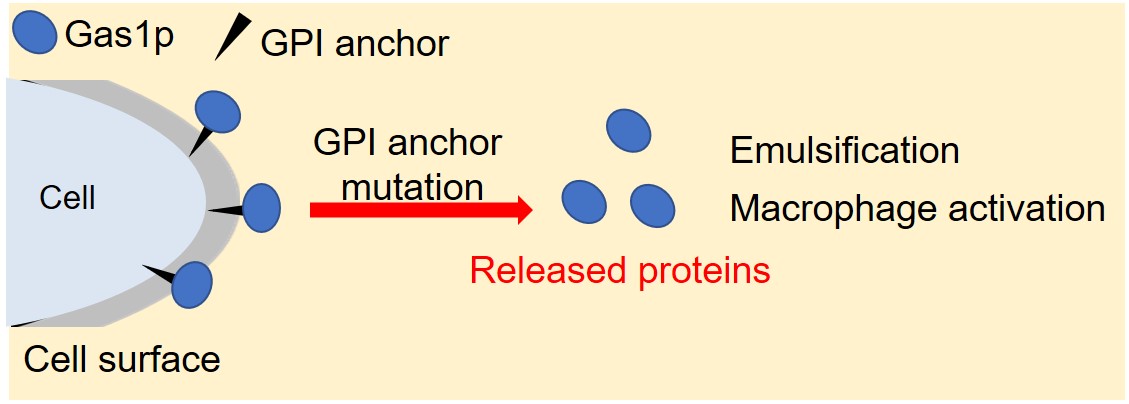
Flocculation is an aggregation phenomenon of microbial cells in which the cells form flocs. Flocculation can contribute to the efficiency of industrial production processes. For example, in repeated batch fermentation production of ethanol using flocculating yeast, the centrifugation step required for cell recovery can be eliminated. Besides yeast, Escherichia coli is known as an industrial bacterium. Although E. coli naturally does not form floc, we succeeded in inducing them to floc formation by overexpression a native bcsB gene, encodes a component of cellulose synthase or deletion of degP gene, encodes a periplasmic protease1). However, floc formation is less than 100 mg/L and not enough to be used in fermentation production. In this study, we aimed to understand the formation mechanism of E. coli flocs and further increase the formation efficiency. Since E. coli flocs were proteinous, the amount of protein included in flocs were measured, and the value was used as an index of floc amount. When each strain was cultured in LB medium containing glycerol, only the ΔdegP strain increased the floc formation. Amount of floc formation reached approximately 230 mg/L in the presence glycerol. Meanwhile, the uptake of glycerol into cells was not confirmed. Next, we focused on the high viscosity of glycerol. Additing thickening agent such as carboxymethyl cellulose and polyvinylpyrrolidone into medium did not increase the floc formation. In contrast, the addition of ethylene glycol, which is classified into the same polyols as glycerol, significantly promoted the floc formation. Thus, it was suggested that floc formation of E. coli ΔdegP strain was enhanced by polyols. Further analysis will aim to elucidate the action of polyols on E. coli flocs.
1) Ojima et al. (2015) AEM 81:5900-5906
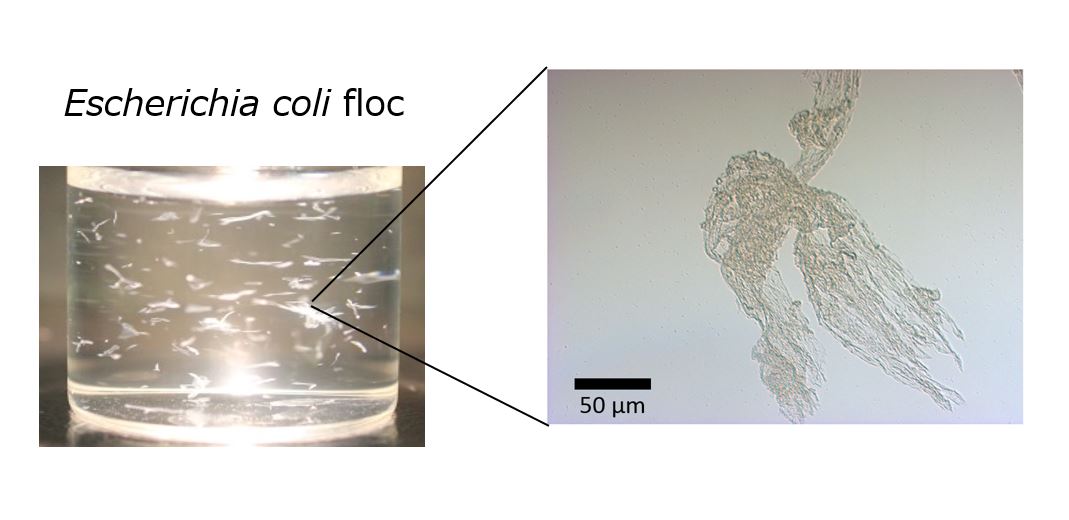
From the standpoint of the food safety management, it is very important to control microorganisms that can grow in a refrigerator. We evaluated the growth characteristics and sterilization conditions of Exiguobacterium sp. and Pantoea sp. which were isolated from a food manufacturing environment. These two microorganisms were capable of growth at refrigeration temperatures (4 °C and 10 °C), but their optimal growth temperature was approximately 30 °C. Thus, these microorganisms were classified as psychrotrophic bacteria. Heat treatment and sodium hypochlorite exposure were effective for the inactivation of the two microorganisms and the sensitivities toward these sterilization conditions of them were higher than those of Escherichia coli (E. coli). Although Exiguobacterium sp. and Pantoea sp. exhibited similar alkaline tolerance at pH 8.0, the degrees of their acid tolerance were different from each other. Exiguobacterium sp. was easily killed by acetic acid (pH 2.68) and citric acid (pH 2.0), while Pantoea sp. was relatively insensitive to these acids. In particular, Exiguobacterium sp. should be careful because the microorganism exhibited an unusually high resistance to ozone treatment and UV radiation whose conditions were enough to kill Pantoea sp. and E. coli. This is probably due to the protective effects of carotenoids, antioxidant enzymes and DNA repair enzymes in Exiguobacterium sp. cells against oxidative stress and DNA damage. Interestingly, Exiguobacterium sp. and Pantoea sp. were effectively sterilized by pulsed electric field (PEF) treatment under the condition that was not sufficient to kill E. coli (Fig. 1). Since the Exiguobacterium sp. and Pantoea sp. cells were cultivated at 4 °C, the cell membranes of the two microorganisms seemed to become more fragile with increasing unsaturated fatty acid content. Our results suggested that PEF treatment has a high potential to be used in the sterilization of psychrotrophic bacteria associated with spoilage of food at refrigeration temperatures.
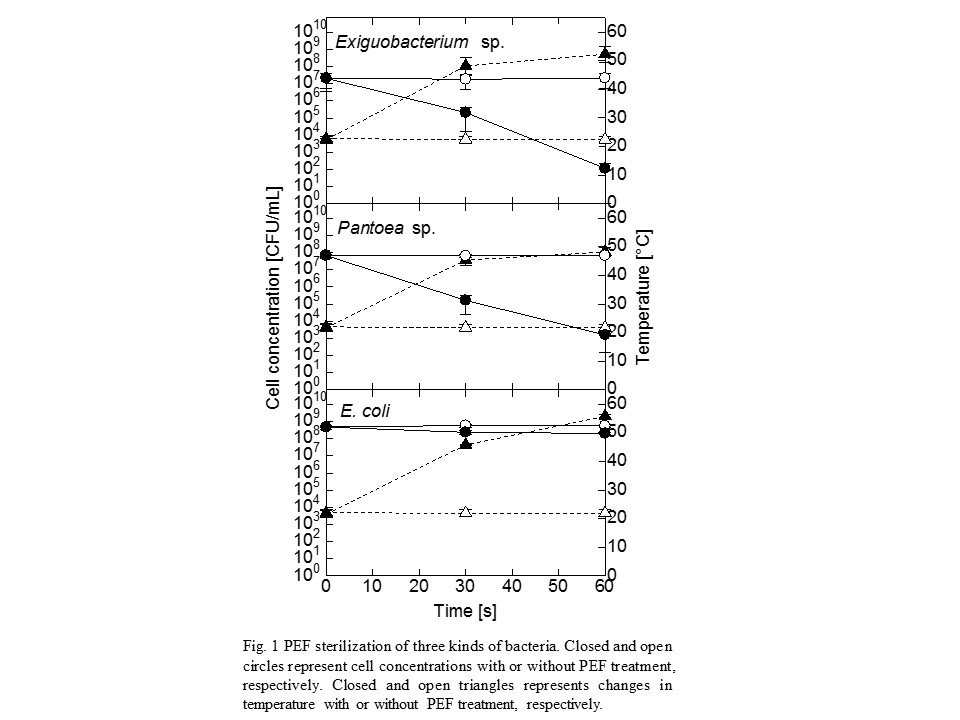
Beta-carotene is distinguished as a vitamin A precursor and make an effect of the antioxidant action and immunostimulating activity. In recent years, it is mainly produced by extraction from plants and chemical synthesis from petroleum which causes an unstable production and serious environmental problems. In order to achieve the requirements of mass production, in this study, we carried out metabolic engineering using CRISPR-Cas9 to edit genes of beta‐carotene biosynthesis from cellulosic biomass in Schizosaccharomyces pombe. This yeast is superior in protein production capacity compared to other yeasts. First, we carried out destruct genes of encoding proteases and acetaldehyde dehydrogenase. At the same time, we introduced carotenogenic genes (crtYB, crtE, crtI) into genomic DNA of S. pombe. And this recombinant strain is successfully produced the beta-carotene from glucose. Furthermore, a main component of cellulosic biomass is cellulose. Cellulose is degraded to cellobiose by cellulolytic enzymes and cellobiose is degraded to glucose by beta-glucosidase (BGL). To produce beta-carotene from cellobiose, BGL gene is introduced into S. pombe and expressed BGL on cell surface. As a result, this recombinant strain is successfully produced 1864 μg / g DCW beta-carotene from cellobiose. It is assumed that adjusting the Redox balance and strengthening metabolic flux enhance beta-carotene production.
Cordycepin, a nucleoside analogue (3'-deoxyadenosine), is the major active constituent of Cordyceps militaris and was first reported as a metabolite isolated from a culture broth of C. militaris. To date, many biological functions of cordycepin have been discovered; cordycepin has anti-tumor, anti-metastatic, anti-bacterial, anti-viral, immunomodulatory and anti-inflammatory activities. In the last decade, studies targeting cordycepin as a therapeutic agent have been in progress. These studies include application to a variety of cancers, especially leukemia (ClinicalTrials.gov, verified by OncoVista, Inc., 2009), trypanosomiasis and restenosis, and also include the design of derivatives to protect against rapid oxidation in vivo. Therefore, the large-scale production of cordycepin is currently desirable. As for the production method of cordycepin, the surface liquid culture using Cordyceps militaris mutant (G81-3) has been proven to be favorable for the higher production. However, the cordycepin productivity of the liquid surface culture was not so high because the culture period was long.
In this study, the cordycepin production by C. militaris mutant (G81-3) was examined using rotating disk contactor (RDC) for further improvement of the cordycepin productivity. When the specific biofilm surface area (total biofilm area divided by medium volume) of RDC was set at 5.1, the maximum cordycepin concentration obtained by RDC culture was 7.4 g/L, which was comparable with that of the liquid surface culture. Besides the cordycepin production rate was 2.7 g/(L*d), which was around 9 times that of the liquid surface culture. The RDC can be expected to be used as cordycepin production equipment because such excellent productivity was obtained.

Introduction
Utilization of renewable feedstocks for the production of bio-based chemicals such as D-lactic acid by engineering metabolic pathways in the yeast Saccharomyces cerevisiae has recently become an attractive option. In a previous study, we constructed efficient D-lactic acid producing S. cerevisiae YPH499/dPdA3-34/DLDH/1-18 by global metabolic engineering strategy1). However, the growth of the strain was strongly hampered by the presence of high concentrations of D-lactic acid, and thus it was not possible to achieve high titer D-lactic acid production without neutralization. In this study, expression of 11 endogenous transcription factors was optimized using the cocktail δ-integration strategy2) to improve D-lactic acid tolerance in YPH499/dPdA3-34/DLDH/1-18.
Results
DNA fragments, which contained 15 types of promoters and 11 types of transcription factor genes (HAA1, HSF1, MSN2, MSN4, PDR1, PDR3, RIM101, SFP1, SKN7, WAR1, and YAP1), were transformed into YPH499/dPdA3-34/DLDH/1-18. Among the resultant recombinant strains, YPH499/dPdA/DLDH/Lib-Tras143 with high lactic acid tolerance was selected. In non-neutralized flask fermentation, YPH499/dPdA/DLDH/Lib-Tras143 showed 1.2 fold higher D-lactic acid titer than YPH499/dPdA3-34/DLDH/1-18. In the transcriptional analysis by real-time PCR, the expression of 3 transcription factors HAA1, PDR3, and SFP1 was upregulated in YPH499/dPdA/DLDH/Lib-Tras143. Among them, the expression level of PDR3 was the highest, which may be a promising target for improvement of D-lactic acid tolerance in yeast S. cerevisiae.
Conclusion
The D-lactic acid tolerant strain YPH499/dPdA/DLDH/Lib-Tras143 has been successfully constructed by optimizing the expression of transcription factors. Transcriptional analysis revealed that 3 transcription factors (HAA1, PDR3 and SFP1) could function to improve lactic acid tolerance.
Acknowledgements
This work was partly supported by JSPS KAKENHI (grant number JP18K14069 and JP18KK0413).
Reference
1) R. Yamada et al.; Biotechnol Bioeng114:2075–2084 (2017)
2) R. Yamada et al.; Microb Cell Fact 9:32 (2010)
Lignocellulosic biomass is a promising feedstock for biofuel and other biochemical production to improve sustainability and the bioeconomy, and consists of cellulose and hemicellulose encapsulated in a lignin matrix. To convert biofuels from the lignocellulosic biomass, saccharification processes including hydrolysis are required before yeast fermentation. However it is one of serious problems that various toxic compounds coproduced by the saccharification processes. In this study, estimates of growth and fermentation inhibition during bioethanol fermentation were made using component profiles of corn cobs and corn stover at different degrees of hydrolysis. The component profiles were acquired by non-targeted gas chromatography mass spectrometry and targeted high-performance liquid chromatography(1). Correlations between the comprehensive analysis results and yeast growth and ethanol production were modeled very accurately by partial-least-squares regression analysis(1) and deep-learning. Acetate, apocynin, butyrovanillone, furfural, furyl hydroxymethyl ketone, m-methoxyacetophenone, palmitic acid, syringaldehyde, and xylose, were compounds with very variable importance in projection values and had negative correlation coefficients in the model. In fact, methoxyacetophenone, apocynin, and syringaldehyde inhibited fermentation more than furfural in equivalent concentration. Furthermore, deep-learning accurately estimated the time courses of cell growth and fermentation.
References
1) Watanabe K, Tachibana S, Konishi M. (2019) Bioresouc. Technol. 281: 260-268
The history of science and technology (S&T) that has been managed by the human race showed have much effect on the life patterns of the including ways to develop the quality of life and culture. Almost 100 years the era of industrialization indicating the existence of the dynamics of change, where social relationships between the community and the development S&T more and more quickly change. Consumptive behavior especially in exploring and exploitation of non-renewable natural resources already been surpassed the boundary of the natural capacity to meet the needs of human life. So that in realizing sustainable development has happened the transformation of economic development based on industry headed toward the sustainable development based on information. The era of this information demonstrate the ability a region and its people in doing efficiency and using information to achieve welfare competition on the situation at the global cooperation. So that the dynamics of the developments based on the knowledge are more complex. The development of roadmap of inclusive industrial systems, on the basis of locality characteristics for glucomannan industrialization from the Ammorphophallus Muelleri Blume (Indonesia Konjac) has been studied.
Introduction
Patchoulol is a sesquiterpene alcohol and an important natural product for the chemical industry. Although patchoulol is a component of plant patchouli essential oil, extraction from it is not a method suitable for large-scale production. Furthermore, using plants as resources for the production of sesquiterpene includes slow growth and varying composition depending on the geographical position and climate conditions.
Yeast Saccharomyces cerevisiae is widely used for production of various chemicals including the patchoulol by metabolic engineering. However, a limiting number of gene expression could be modified by conventional metabolic engineering in previous reports. Recently, global metabolic engineering strategy (GMES), which enables simultaneous modulation of many gene expressions, has been developed1). In this study, we constructed a mevalonate pathway engineered S. cerevisiae by GMES to realize efficient patchoulol production.
Methods
First, DNA fragments, which contained fifteen types of promoters and patchoulol synthase gene, were transformed into yeast YPH499. The resultant patchoulol synthase expressing strain was named YPH499/PAT167. Next, DNA fragments, which contained fifteen types of promoters and eight types of mevalonate pathway genes, were transformed into YPH499/PAT167. The resultant mevalonate pathway modified strain was named YPH499/PAT167/MVA442.
Results
As shown in the Figure, YPH499/PAT167 produced 8.4 mg/L patchoulol in 48 h cultivation, whereas YPH499/PAT167/MVA442 produced 39.5 mg/L patchoulol. By using the GMES, patchoulol production in a 48 h cultivation was improved 4.7 times, and the patchoulol volumetric productivity by YPH499/PAT167/MVA442 reached 19.8 mg/L/d.
To conclude, efficient patchoulol producing S. cerevisiae was successfully constructed by using GMES. GMES could also be applied for generating metabolically engineered S. cerevisiae capable of producing various bio-based chemicals.
Acknowledgements
This work was partly supported by JSPS KAKENHI (grant number JP18K14069 and JP18KK0413).
Reference
1) R. Yamada et al.; ACS Synth. Biol., 6, 659-666 (2017).

Shikimate pathway is one of the most important metabolic pathways in bacteria for synthesizing various aromatic compounds including aromatic amino acid.
Previous our study, we designed the metabolic pathway of Escherichia coli to enhance shikimate pathway by accumulating the intracellular PEP concentration and to produce chorismate derivatives in high yields. In order to avoid consuming PEP when uptake of glucose, we have generated a recombinant strain with replacing the endogenous phosphotransferase system (PTS) with GalP/Glk system (GGS) (PTS- GGS+ strain). In order to prevent leakage of carbon flux to the TCA cycle, we also disrupted two genes encoding pyruvate kinase (pykA, pykF), from PTS- GGS+ strain.
In this study, we designed two “Metabolic Pathway Units”. first, we further modified the metabolism in E. coli to be confined the use of the glucose to the production of a target compound, MA. This pathway is the “MA Production Unit” using glucose as a substrate. Second, to regain the capacity of cell growth, we introduced an exogenous Dahms pathway that supplements the metabolites necessary for cell growth with xylose into the strain. This pathway is the “Cell Growth Unit” using xylose as a substrate. We attempted to produce MA in high yield by combining these two unitized pathways.
INTRODUCTION: Intestinal microbiome has recently been shown to play an important role in immune modulation, health and diseases. To understand the roles, great efforts have been made to develop in vitro models of the gastrointestinal human–microbe interface. However, most of reported models are microfluidics-based devices. Here, we fabricated bacteria-encapsulated microbeads to fabricate a simple, robust and tunable in vitro intestine model.
METHODS: A mixture solution of calcium carbonate, sodium alginate and E. coli was prepared and processed to form micro-droplets through a microfluidic water-in-oil emulsification. The microbeads were then gelated by changing pH(Fig.1). The surface of microbeads were sterilized, and then cultured in cell culture medium for 1 week. After 1 week, the presence or absence of leakage of E. coli, and the oxygen state inside the microbeads were characterized. Moreover, co-culture with a CACO-2 cell layer was performed to confirm the metabolism occurring in the presence of E. coli sealed in microbeads.
RESULTS & DISCUSSION : E. coli microbeads of different diameters were successfully fabricated by modulating the flow rate in different channels in the device. After 1 week of culture, no leakage of E. coli was observed, and it was confirmed that the E. coli in the microbeads were alive. In addition, the oxygen concentration in the microbeads was extremely reduced after 1 week, due to the anaerobic condition caused by E. coli oxygen consumption. The microbeads were immersed in tryptophan solution, and the production of indole was confirmed. CACO-2 cells are known to perform a sulfate conjugation reaction. Indoxyl sulfate produced from indole could be detected by co-culturing the E. coli microbeads with CACO-2 cells, further confirming the interaction between the CACO-2 cells with the E. coli encapsulated in the microbeads.
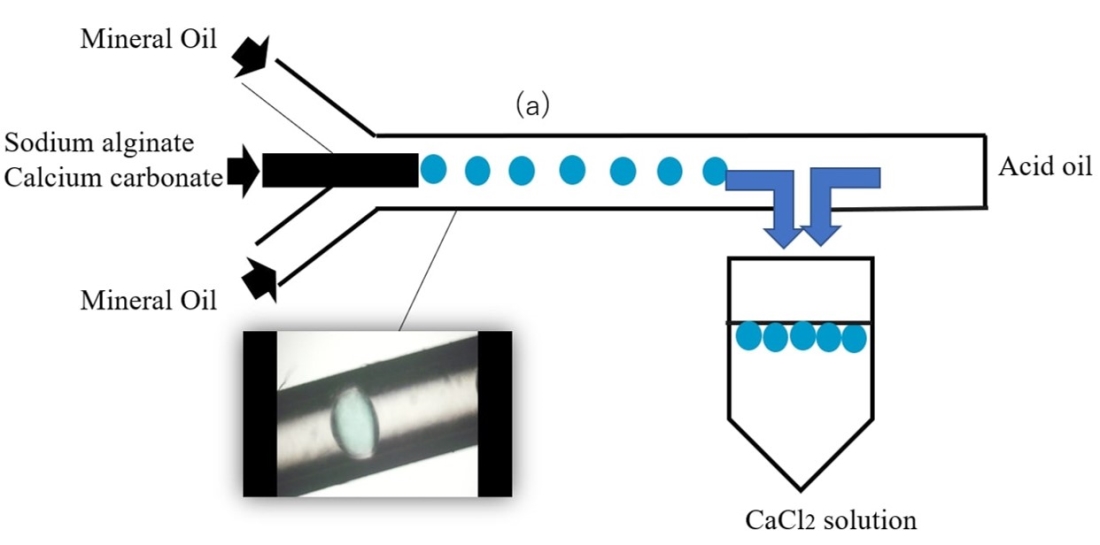
Twelve microorganisms were initially screened for their abilities to catalyze the biotransformation of phloretin. Two main products were identified in LC analysis after 1 hr of whole-cell bioconversion using Streptomyces avermitilis. To analyze the structural change of the product, TMS derivatization using BSTFA was done. After GC/MS analysis, product 1 is found to be hydroxylated in the A-ring of the phloretin with mass increase of 88 (192 to 280) in the A-ring fragment, and also for the whole phloretin molecule (562 to 650). Product 2 is also interpreted to be hydroxylated in the A-ring of the phloretin. But, its fragmentation pattern is different with product 2 with mass increase of 88 (179 to 267) in different A-ring fragment. Maximum conversion was 6.7 %, which was achieved for 1 hours of reaction, and the substrate (phloretin) and reaction product was completely metabolized after 3 hours of whole-cell reaction. Three kinds of Cytochrome P450 inhibitor, Coumarin, Erythromycin and Quinidine was added with 0.5mM final concentration, but, did not prevent the accumulation of the products, which means the reaction proceed not by P450 monoxygenase, possibly by other forms of oxygenase.
The purification and C-phycocyanin from Spirulina platensis was performed by employing the liquid biphasic flotation technique (LBF). LBF is a combination of both the liquid biphasic system (LBS) and solvent sublation, where the partitioning of the biomolecules in the system is enhanced through the effect of bubbling. The influence of various process parameters such as molecular weight of phase forming polymer, phase forming salt, phase composition, system pH, phase volume ratio, air flotation time and crude extract concentration were studied to optimize the C-phycocyanin recovery yield and purity. Desirable conditions for the purification of C-phycocyanin are found in the polymer-salt system consisting of polyethylene glycol (PEG) 4000 and potassium phosphate combination, where the increase in purification fold from 2.43 to 3.49 can be achieved in the optimized LBF. This technique has effectively enhanced the purification of C-phycocyanin in a cost effective and simple processing.
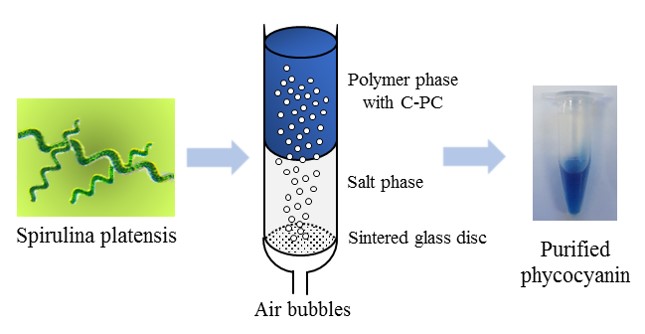
As the mechanisms of biological functions have been successively clarified, synthetic biology has become a feasible approach. One of the goals to synthetic biologists is to reproduce behaviors in the natural systems and ultimately to create artificial life [1]. We have applied synthetic biological approaches to tissue engineering. Three-dimensional (3D) tissue construction from individual cells is an important process in regenerative medicine to enhance cell function. For transplanting tissue-engineered constructs, a limitation of oxygen/nutrient supply due to an insufficient vascular network causes cell death. Thus, it is necessary to develop a system for inducing a vascular network under hypoxic condition to 3D tissue constructs. In our previous study [2], we developed a hypoxia-inducible transgene expression system in which a target gene can be expressed in response to hypoxic stress using hypoxia-responsive promoter RTP801 as a trigger, tTA transactivator as an amplifier, and ODD sequence as a noise canceler. In this study, to improve hypoxia and nutritional limitation inside the genetically engineered 3D tissue constructs, a hypoxia-responsive expression system of vascular endothelial growth factor (VEGF) was introduced into cells. Then we demonstrated that genetically modified cells could control the VEGF expression autonomically in an oxygen concentration dependent manner. Using the genetically modified cells, 3D tissue constructs were fabricated. The tissue constructs were transplanted into mice, and we evaluated the feasibility of the hypoxia-responsive VEGF gene expression system in vivo. The results indicate that the hypoxia-responsive VEGF gene expression system is promising for preparing 3D tissue constructs in regenerative medicine.
[1] S. A. Benner and A. M. Sismour, “SYNTHETIC BIOLOGY,” Nature, 2005, vol. 6, no. 7, pp. 533–543.
[2] Ono A, et al. “Hypoxia-responsive transgene expression system using RTP801 promoter and synthetic transactivator fused with oxygen-dependent degradation domain.” J. Biosci. Bioeng., 2017;124:115-124.
The polymerization of proteins can create active and large bio-macromolecular assemblies that exhibit unique functionalities depending on the properties of protein units in the polymers. Herein, we report the polymerization of proteins and its functions in diagnostic application. We engineered proteins; Escherichia coli alkaline phosphatase (BAP), horseradish peroxidase (HRP), and chimeric antibody-binding proteins (pG2pAs) for conducting the polymerization reaction. The proteins were fused with a tyrosine-containing peptide tag (Y-tag) through a flexible linker at the N- and/or C-termini. The recombinant proteins were then expressed in E. coli or silkworm (Bombyx mori). Trametes sp. laccase (TL) was used to activate the tyrosine residues in the Y-tags with molecular O2 to form a tyrosyl free radical, which initiated the tyrosine coupling reaction between the Y-tagged enzyme units. The proteins without Y-tag were not recognized as substrates by TL even though there are several tyrosine residues in the primary structure of both enzymes. Conversely, the Y-tagged proteins showed sufficient reactivity to conduct TL-catalyzed formation of large and active proteinaceous polymers. Furthermore, the TL also enabled co-polymerization of two Y-tagged proteins; BAPs and a chimeric antibody-binding protein, Y-pG2pA-Y, to form bifunctional proteins. While, the Y-tagged HRPs were also co-polymerized with Y-HRP-pG, a fusion protein of HRP with an antibody-binding protein. In these constructs, enzymes play a role as reporter and other parts are for specific binding with IgG, making them compatible with the enzyme-linked immunosorbent assay (ELISA). The detection limit of the ELISA of ovalbumin (OVA) with anti-OVA IgG depended on the molar ratio of enzyme and pG-conjugated proteins in the TL-catalyzed cross-linking reaction. In general, the higher molar ratio of enzymes, the higher ELISA signal. The present enzymatic polymerization of functional proteins promises to provide highly active protein polymers as diagnostics probes for biomedical applications.
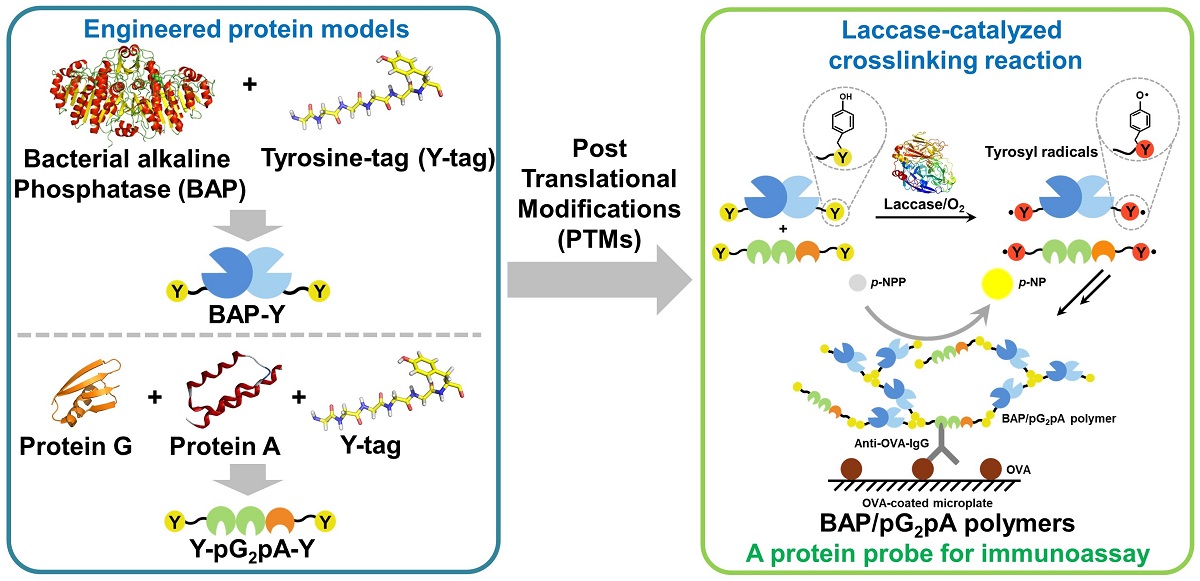
Immobilized metal affinity chromatography (IMAC) has been widely used for the one-step purification of recombinant proteins. In light of its superior selectivity and binding strength, we have previously reported the employment of IMAC adsorbents for the purification and immobilization of enzymes. However, the biocatalysts thus prepared exhibited low operational stability in repeated-batch operations due to the desorption of enzymes. In this study, we report the preparation and applications of loofa sponge-based bifunctional epoxy-IMAC adsorbents for the selective adsorption and covalent immobilization of His-tagged enzymes. Loofa sponge is the fibrous vascular reticulated system of the matured dried fruit of Luffa cylindrical. Its high porosity, structural stability and resistance to cellulose-mediated degradation make loofa sponge an ideal matrix for the development of supermacroporous adsorbent for the purification of recombinant proteins from unclarified cell homogenates. To increase the density of the accessible functional groups for activation, the loofa sponge was grafted with hydroxyethyl cellulose (HEC). The results of equilibrium study showed that upon HEC grafting the adsorption capacity of the loofa sponge-based IMAC adsorbent was increased by 62% from 1.51 mg/g to 2.45 mg/g. By controlling the concentration of iminodiacetic acid (IDA) and reaction time during conjugation, a series of bifunctional epoxy-IMAC adsorbents containing both metal chelating groups for selective adsorption of His-tagged proteins and epoxy groups for covalent immobilization of the adsorbed enzymes were prepared. The difference in kinetics of protein adsorption and covalent immobilization allowed the sequential adsorption and immobilization of the model enzyme, His-tagged trehalose synthase. The immobilized trehalose synthase thus prepared with the bifunctional epoxy-IMAC adsorbents exhibited superior operational stability in repeated-batch operations, retaining 96% of the initial activity after 20 cycles. Furthermore, the superporous structure of loofa sponge allowed the adsorption and immobilization of proteins from unclarified cell homogenate without observable fouling.
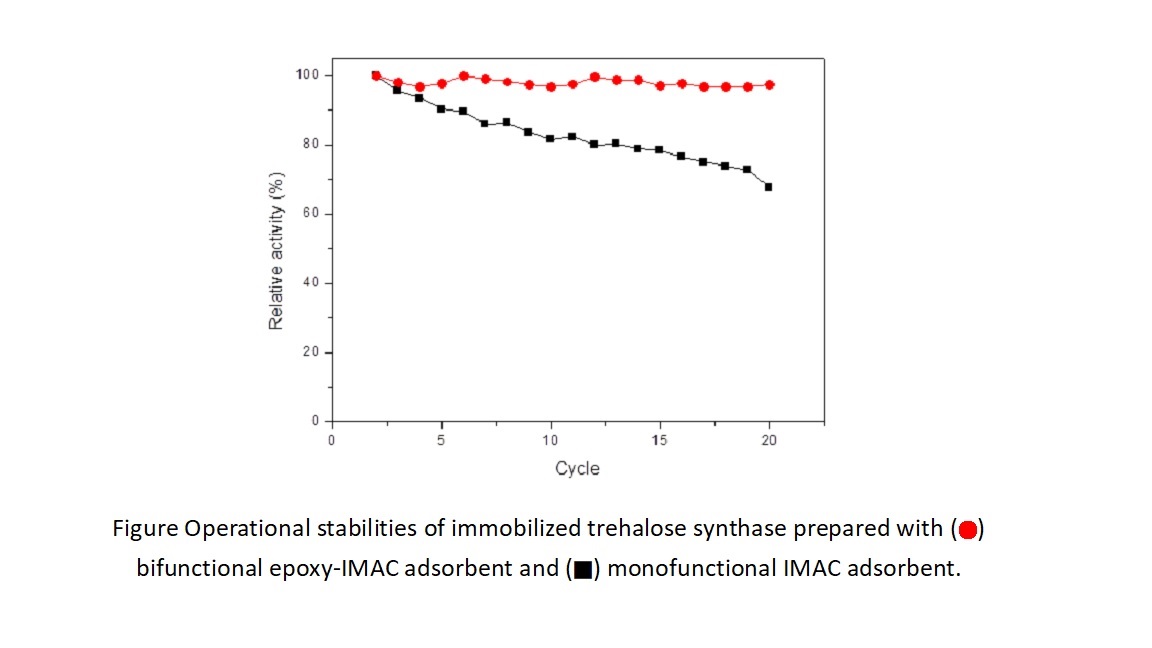
In this study, an immobilized metal ion affinity (IMAM) approach was adopted for coupling cellulases. The mini-scaffolding protein gene (CipA) and the endoglucanase gene (CelA) were constructed via recombinant genetic engineering approach. The immobilized nickel ion IMAM membrane was used to purify and immobilize the CipA from the fermentation broth to make an IMAM-Ni2+/CipA membrane under a 12 h adsorption. The endoglucanase (CelA) with docking domain is used as the model enzyme coupled to the above affinity membrane. The catalytic activity of the immobilized CipA-CelA was clearly higher at a wide range of pH compared to the free CelA. The optimal temperature for the immobilized CipA-CelA was also increased to 70°C. Moreover the immobilized CelA could be reused 4 times with 70% of residual activity. To check the metal ion effect during the construction of IMAM, some metal ions, like iron, cobalt and copper ions would enhance the enzyme activity; however, casium and znic ions would suppress the enzyme activity. Effect of metal ions addition on the enzyme activity immobilized in IMAM is lower than that of free enzyme.
Elaeocarpus serratus L. (Ceylon-olive) leaves are the by-products in the harvest or agricultural processing of Ceylon-olive fruits, containing many high-value bio-phenols and flavonoids with anti-oxidation activity, and are valued to enhance the nutrition for humans. The purpose of this study is to investigate the effect of non-thermal ultrasound and solvent on the extraction of Ceylon-olive leaves. The fresh Ceylon-olive leaves were thoroughly cleaned, freeze-dried, defatted and ground to get raw biomass powder. The extraction efficiency was explored by using various solvents (methanol, ethanol and water) without or with ultrasound at different operation modes to extract the bioactive compounds from Ceylon-olive leaves. The main compounds of bioactive extract were determined by high performance liquid chromatography. The characteristic structure of Ceylon-olive leaves before and after extraction, including morphological structure, functional groups and crystallinity, was analyzed by using field emission scanning electron microscope, Fourier transform infrared spectroscopy, and high resolution X-ray diffractometer. Using methanol as the solvent, the total phenolic and total flavonoid contents of the Ceylon-olive leaves extract with ultrasonic extraction were 1.45 times of those without ultrasound, and myricetin and myricitrin contents with ultrasound-assisted extraction were 1.57 and 1.38 times of that without ultrasound, respectively. When using aqueous ethanol, the contents of total phenolic compounds, total flavonoids, myricetin and myricitrin were all enhanced by the increase of ethanol concentration under ultrasound. The crystallinity of Ceylon-olive leaves after various extractions showed about 21.83% to 44.13% increase, compared to that before extraction, and the morphological structures of Ceylon-olive leaves were observed to be seriously crumbled and punched by ultrasonic extraction, leading to the enhancement of bioactive compounds transported. In this study, the strategic ultrasound and appropriate solvent demonstrated the significant effect on the promotion of extraction efficiency for Ceylon-olive leaves.
Keywords: Ceylon-olive leaf, ultrasound, bioactive compounds, extraction
Phyllostachys makinoi (Makino bamboo), the endemic species of Taiwan, are natural materials with potential bioactivity beneficial to human health. In this study, the objective is to develop the green processing method for the extraction of bioactive compounds from Makino bamboo (RB) via ultrasonic pretreatment. Two different solvents (ethanol and water) were used in extraction of Makino bamboo with or without ultrasonic pretreatment (40 kHz, 60°C, 3 h), and the crystallinity were examined by the high resolution X-ray diffractometer. From the observation by field emission scanning electron microscope, the microstructure of Makino bamboo was seriously crumbled and cracked via ultrasonic pretreatment before the extraction, leading to the enhancement of extraction efficiency. Using water as the solvent, the yields of the extract after ultrasonic pretreatment and without ultrasonic pretreatment were 3.98% and 3.56%, respectively, showing that ultrasonic pretreatment would give the extract yield enhanced to 1.12 times of that without ultrasound. Besides, the total phenolic content with ultrasonic pretreatment was 1.08 times of that without ultrasound. Under ultrasonic irradiation, the antioxidant capacity and total flavonoid content of the Makino bamboo extract by using water were 1.91 and 1.40 times of that using 95% ethanol, respectively. The diffraction peaks for Makino bamboo in various extraction conditions within the 2 theta range of 15-25 °were much sharper than those for RB, and the crystallinity index of RB was 47.21%; the crystallinity of Makino bamboo after extraction showed about 3.47% to 7.99% increase, compared to that before extraction (RB). The efficient method by ultrasonic pretreatment to assist the extraction of Makino bamboo has been explored, and ultrasound can be regarded as an effective, mild and non-toxic technology to extract bioactive compounds for the valorization of Makino bamboo.
Keywords: Makino bamboo, ultrasound, pretreatment, extraction
Polyacrylonitrile (PAN) nanofibrous membrane was prepared by electrospinning technique. The PAN membrane used in this work comprises a polyethylene terephthalate (PET) spunbond fabric as a supporting layer with upper and lower PAN nanofibrous membrane. After 3 M NaOH and diluted HCl treatments, the weak cationic exchange membrane (i.e., AEA-COOH) was obtained. The AEA-COOH membrane was then functionalized with ethylenediamine (EDA) and bromoacetic acid (BrA), sequentially. This modified ion exchange membrane (namely AEA-BrA) has more acidic groups as compared to the AEA-COOH membrane. In this study, lysozyme obtained from chicken egg white (CEW) was chosen as a model enzyme. The adsorption characteristics of the AEA-BrA membrane were assessed by measurements of the breakthrough curves in membrane chromatography. The influences of adsorption pH, CEW concentration, and liquid flow rate on adsorption performance of the membrane were investigated in an AKTA prime chromatographic system (GE Healthcare). On the basis of the results, the optimal conditions for the capture of lysozyme were carried out in 10% (v/v) CEW at pH 9 and flow rate of 0.1 mL/min for the ion exchange membrane process. Moreover, the two-step elution scheme (0.6 M and 1.0 M NaCl, pH 9) was chosen for eluting the adsorbed lysozyme. The lysozyme fraction eluted by second step 1.0 M NaCl was recovered with purification factor of 402 and yield of 91% in AEA-BrA ion exchange membrane chromatography.
Polyacrylonitrile nanofiber membranes (PAN) were fabricated via electrospinning technique. The PAN membrane comprises a polyethylene terephthalate (PET) spunbond fabric as a supporting layer with upper and lower PAN nanofibrous membrane. After NaOH and HCl treatment procedures, the modified membrane is a weak ion exchange membrane (namely AEA-COOH). The AEA-COOH membrane was characterized in terms of fiber diameter, porosity, specific area, pore size, ionic density, and binding capacity. In this study, lysozyme was chosen as a model protein. The adsorption efficiency of the AEA-COOH ion exchange membrane for lysozyme was assessed by the measurements of breakthrough curves in a small stirred cell system (Model Millipore 8010). The capture of lysozyme from diluted chicken egg white (CEW) was carried out with a working volume of 10 mL under the different feed concentrations, flow rates, rotating speeds, and operating pressures. The optimal adsorption conditions were found to be adsorption pH 9, 1 in 10 dilution of CEW, average flow rate of 0.1 mL/min, rotating speed of 200 rpm, and initial operating pressure of 0 psi). Furthermore, the elution of lysozyme was also investigated in stirred cell experiments. It was successful in achieving purification of lysozyme in a high yield of 98.2% with a purification factor of 62.9 in a single step.
Heat-sensitive materials (food, pharmaceutical etc.) have to be dried at low temperature. Drying method of such materials is often demanded the maintenance of shape (porous product), color and high rehydration rate. Freeze drying satisfies above demands, but it has some problems like necessity of extremely low pressure, non-uniform heating (conductive or radiant heating) and long drying time.
Some problems of the freeze drying are considered to be solved by our method. Figure 1 shows the outline of experimental apparatus in our study. The frozen materials are put in the vacuum chamber. In the vacuum chamber, air with low temperature (about 273 K) and low humidity circulates under the reduced pressure. Frozen materials are heated by the convective heating due to circulating air. The drying progresses with the sublimation in materials. The sublimation occurs at the relatively high pressure (10 kPa in our study).
The drying characteristics of frozen materials (carrot and brick plate) for our drying method were studied experimentally and theoretically. The changes in temperature and moisture content of material during drying were measured in the experiment. The properties (color, volume and rehydration characteristic) of material (carrot) after drying were examined. Equations of heat and mass transfers were used for the numerical analysis. The effects of operational conditions on the drying characteristics of frozen material (brick plate) were examined by using the numerical analysis.
Sublimation rate on the material surface is much higher than that in the inner part, i.e., the present drying method is suitable for small or thin material. The changes in volume and color during drying are smaller than those in our previous study (fluidized bed drying of frozen carrot under reduced pressure, at 333 K and 12 kPa). The humidity and temperature of circulating air largely affects the drying rate.
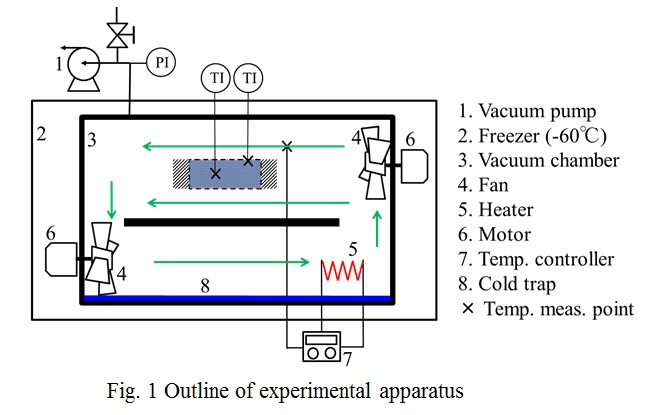
β-Cryptoxanthin (BCX) is contained in citrus fruits such as Wenzhou orange and is expected to have various functions such as osteoporosis prevention, diabetes improvement, cancer prevention by immune improvement, and skin care effect. As BCX cannot be synthesized in human body, it must be taken from food. However, BCX is very hydrophobic and the absorption rate in oral administration should be low. In the present study, bioaccessibility of BCX after complexation with sodium caseinate was assessed using the Caco-2 cell model. BCX was recovered from a citrus fruit kumquat (Fortunella spp.) cultivated in Miyazaki by extraction using a mixture of ethanol and pyrogallol. The extracted BCX was complexed with casein by mixing an ethanol solution of BCX and an aqueous solution of sodium caseinate, followed by evaporation of ethanol in vacuo and lyophilization. For cell permeability test, Caco-2 cell was cultured onto 6-well plates for 3 weeks to prepare the cell monolayers. After pseudo-digestion by enzymatic hydrolysis using pepsin in acidic media followed by that using pancreatin in neutral media, the complex between BCX and casein or the blank sample without containing casein was injected to apical side of the cell monolayers. After incubation for 8-24 h, the concentration of BCX in basolateral side was analyzed to determine the cell-permeability of BCX. The permeability of BCX for the blank sample was negligible. In contrast, BCX complexed with casein was efficiently permeated the Caco-2 cell monolayer. The result suggests that complexation with casein would enhance the bioaccessibility of BCX.
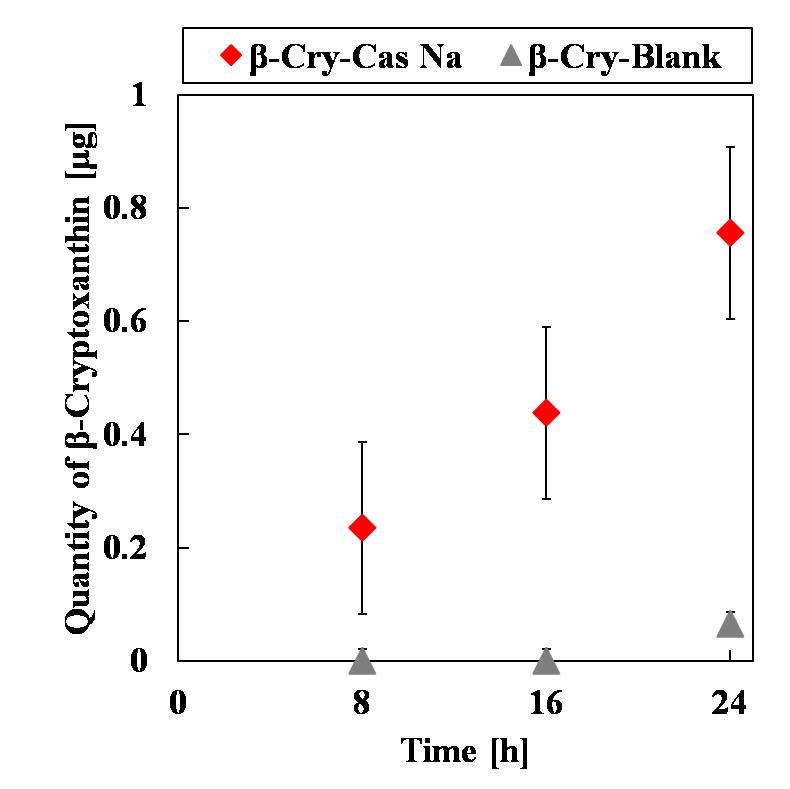
It is not necessary to use preservatives and colorants, since frozen storage has good shelf life and quality retention. Frozen shrimp products are usually distributed in the form of frozen ice blocks. Ice-blocked shrimp cannot be removed intact unless ice is completely melted. When thawing time is getting longer, freshness of shrimp will rapidly decrease. Shortening of thawing time is required to maintain freshness and texture. In this study, we examined a new processing method to crush and separate ice on the surface of ice-blocked shrimp.
Cylindrical pure water ice and saline water ice (20%) were used as glazed-ice samples. Cylindrical fish sausage and minced shrimp were used as food samples. Compression test and split test were performed at each test temperature (-20°C~-70°C) by using material tester. The results showed that breaking stress of pure water ice and saline water ice is always smaller than fish sausage and minced shrimp at each test temperature. Predicted that pure water ice and saline water ice are destroyed preferentially over fish sausage and minced shrimp.
Four types of model ice glazed food were prepared by subjecting fish sausage (with and without packaging film) to ice glaze treatment of pure water or saline water. Split test was performed with constraint condition (fish sausage without packaging film) or unconstraint condition (fish sausage with packaging film) at each test temperature (-20°C~-70°C). The result support previous prediction and indicates crushing saline water ice glaze was easier than pure water ice glaze at same temperature. It becomes possible to maintain their original flavor and nutrition. It also have advantage for cost reduction. It is considered that the saline water ice is easy to melt and break, so it is suitable for separating the ice glaze of complex shaped foods.
Abstract
The blanching is carried out with 90 to 100°C. hot water and uses a large amount of water in order to suppress the color tone, texture change and bacterial growth of vegetables. The tissue is seen to be transparent and soft. By blanching whole vegetables in a short time at high temperature with microwaves, the amount of water used decreases, and physical properties, the number of bacteria, etc. can be improved.
A fiber optic thermometer is placed at the center and at the end of the cabbage, and when the center temperature reaches 100°C, it is taken out, water-cooled and shredded and stored at 5°C and 15°C. I checked. As a comparison, what was immersed in 100°C hot water for 0 second, and was water-cooled was used. The color was determined by removing chlorophyll from cabbage, powdering and measuring Hunter color difference ⊿E. Texture investigated the maximum breaking strength of the cabbage leaf vein with the creep mete.
As a result, it was found that microwave blanching is superior to hot water in terms of color tone and texture, and the number of bacteria is equal
There was no change in oxygen concentration and ethylene concentration in both microwave and hot water blanching, and it was presumed that the enzyme was inactivated although it was indirect
The lettuce changes its color from green to white to black upon heating. The launching temperature is 50°C. for both microwave and hot water. It is presumed that this is because milky white lactucanium contained in cabbage is eluted at around 50°C. and oxidized at a higher temperature. Lettuce blanching is very difficult.
Protein aggregates can be modified by freezing and aging process. In this research, sodium caseinate suspensions (1%) were adjusted to different pH (5.5 and 8.0) and salt concentrations (0.01 and 0.1 M NaCl), followed by being frozen at –35 °C for 1 hour, 2 days or 5 days. After thawing, samples were analyzed by a tunable resistive pulse sensing (TRPS) particle analyzer. According to the results, particle diameter decreased after being frozen for 1 hour and increased after being frozen for days. While particle concentration increased after the 1-hour freezing treatment and decreased after days of freezing. It was found that the change of particle diameter and particle concentration in the 1st hour can be strengthened by repeating the freeze-thaw cycle. The changes of particle diameter and particle concentration were also related to pH and salt concentration of the sample. Particle surface characteristics were also found being related to freezing process, pH and salt concentration. In addition, the difference in freezing temperatures (–5 °C, –20 °C and –35 °C) did not strongly influence the change of particle properties during freezing process. Based on the results, freezing processing is a potential technique to control the properties of sodium caseinate suspensions.
The main component of alcoholic beverages is ethanol, and they form the complex aroma and taste by adding the other ingredients. We have been tried to apply the infrared spectroscopy, which could grasp the information of the quantitative multiple components and the interactions between the molecules, to the evaluation the aroma and taste related information. However, the alcoholic beverages are usually drunk at different temperatures. This study then aims to experimentally understand the influence of the ethanol concentration in the aqueous solution and the temperature on the infrared spectroscopic characteristics.
Ethanol aqueous solutions (12 to 22 vol%) were used as the simplest alcoholic beverage model. A Fourier transform infrared spectrometer equipped with a high-pressure gas cell was used for spectrum measurement of the gas phase. The gas over the sample was circulated from the sample compartment to the gas cell using a pump. The absorption spectra were continuously collected at 290 to 303 K.
The absorption peak intensities corresponding to the vibration modes of ethanol molecule around 1067, 1395, 2901 and 2988 cm-1 continuously became higher until the equilibrium state. At such absorption peaks, the linearity was observed between the natural logarithm of the absorption at equilibrium state and the reciprocal of the absolute temperature of the sample, and the influence of the ethanol concentration on the slope value was negligible. In addition, for the Arrhenius plot using the rate constant obtained under the assumption that the kinetic volatile behavior of ethanol could be expressed by the first order reaction equation, the slope values could be constant among the samples used in this study. These results suggested that the influences of the ethanol concentration in the aqueous solution and the temperature on the kinetic volatile behavior of ethanol could be grasped based on the infrared spectroscopic information.
Boiled red beans (azuki beans) called as "Niazuki" is very popular in Japan. After dipping the beans in water at the room temperature, the beans are boiled. Usually, the dipping water is once disposed in order to decrease the astringent ingredients in boiled red beans, and this operation called as "Shibukiri". However, the drained water contains not only astringent ingredients but also the functional ones. The heating method without "Shibukiri" operation has been then proposed empirically, and the scientific and objective method for the quality evaluation through the "Niazuki" production process is desirable. The aim of this study is to grasp the quality change behavior of the boiled red beans during the heating process using an infrared spectroscopic method, which could be based on the information of vibrational modes between molecular compounds and be simple, rapid, non-chemical and non-destructive.
Firstly, we constructed the stable and quantitative infrared spectroscopy measurement method of the cross section of the boiled red beans using a Fourier transform infrared spectrometer equipped with an attenuated total reflection accessory. Additionally, by comparing the spectral feature changes of the cross section of the red beans during heating with those of the boiled soups, the spectral feature changes of the red beans during heating were experimentally suggested to be quantitatively evaluated based on the soup spectral information that could be easily collected during the heating operation. Moreover, the infrared spectral absorption bands relating to the astringent ingredients in the soup could be extracted by performing the sensory evaluation test. Consequently, this study could be a very important step in the developments of the infrared spectroscopic monitoring for the control of the heating process of the "Niazuki" production.
1-Methylcyclopropene (1-MCP) is known as ethylene inhibitor agent that effective to delay ripening rate in fruits. Controlled release packaging with 1-MCP as active compound is an alternative method to extend the shelf life of fruits. Currently, 1-MCP coated paper has been investigated to develop the functional packaging for fruits. Therefore, this research is aimed to investigate the effectiveness 1-MCP coated paper during preservation of apple.
The formation of 1-MCP coated paper was done by dissolving a weight of 1-MCP inclusion complexes (1-MCP ICs) powder into 0.5 mL of shellac solution. The effectiveness of 1-MCP coated paper were examined in the apple fruits with different weight of 1-MCP ICs powder: 5, 10, 30 and 50 mg for over 30 days. All EPS were closed and stored at 4 °C for initial 15 days. Thereafter, apples were transferred to 20 °C storage temperature for another 15 days. After this treatment, the apples were stored at 20 °C for another 15 days to evaluate shelf life of apple and were also measured the physicochemical properties.
The results showed that apples treated with 1-MCP coated paper inhibited the increase in ethylene production rate during storage time compared to control. During storage time at 4 °C, the release of ethylene from apples with treatment of 1-MCP coated paper were less than the control apples. Low ethylene production rate of 0.22 nL/g FW/h could be observed at 50 mg of 1-MCP ICs powder. On the other hand, for the control apples without treatment of 1-MCP coated paper, the ethylene production rate was 44.7 nL/g FW/h. The finding results indicated that 1-MCP coated paper with 50 mg of inclusion complex was effective to delay the ripening rate and maintain the quality of apple during storage time.
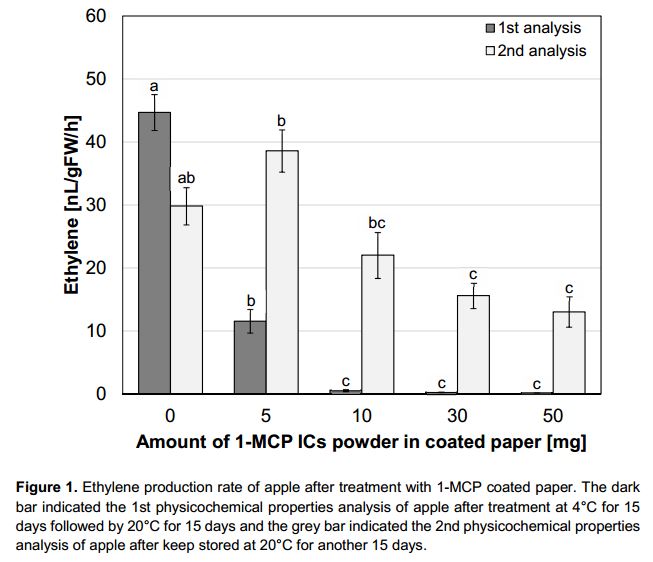
Sweet potato has individual differences in property such as shape, starch content, amount of enzyme. When baked using household cooking tools, the taste differs depending on the individual property even under the identical cooking condition. This study aims at predicting suitable cooking condition of sweet potato for maximizing on the maltose production by the enzymatic reaction during cooking process. The sweetness of sweet potato mainly contributed by maltose. Starch contained in sweet potato is gelatinized by heating, and maltose is generated by the hydrolysis of the gelatinized starch by β-amylase. Gelatinization is accelerated by heating, whereas β-amylase is inactivated by heat. Therefore, heating condition must be optimized in order to maximize resultant amount of maltose. First, in order to investigate the gelatinization kinetics under non-isothermal condition, the degree of gelatinization was measured under selected heating rate. A diagram of the gelatinization rate as a function of temperature and gelatinization degree was prepared to predict the gelatinization behavior of sweet potato at selected cooking condition. Second, the inactivation kinetics of β-amylase was separately measured after extracting the enzyme from a sweet potato. The measurement was carried out under isothermal condition at selected temperatures. The obtained results can predict the remaining enzymatic activity throughout cooking process. Finally, the heat transfer in sweet potato under oven cooking was calculated by the finite element method by counting heat balance between the heat received by the sweet potato from the oven and the heat used to evaporate on the sweet potato surface. Based on the simulated temperature profiles, the amount of maltose produced as a result of baking was predicted. This simulation could be useful to optimize a cooking condition that controls the amount of targeted components.
Freeze-drying is known as one of the best drying method for maintaining original product qualities. Each product has a particular operational temperature limit known as collapse temperature. When temperature of in-drying product reaches over collapse temperature, structural collapse occurs and it may lead quality loss of products. However, some extent of collapse is more or less accepted in industry if it does not lead serious quality defect. In this study, model freeze-dried food products were prepared and influence of the degree of collapse during freeze-drying on quality of products was examined. Samples with different collapse temperatures were obtained by changing the amount of sodium chloride. Collapse temperature was defined as a point at which the significant electrical conductivity change was observed in the temperature ramp test from -60°C to 10°C. A linear correlation was confirmed between collapse temperature and the degree of collapse that was evaluated by alternative test (i.e. the tapping test) on a prepared sample freeze-dried at fixed drying condition. Prepared samples confirmed flavor components, that is methionol and hexanoic acid. The amount of flavor components before and after freeze-drying was measured by gas chromatography. It found that the collapse temperature was clearly correlated with the retention of methionol. On the other hand, the retention of hexanoic acid did not obviously change depending on the collapse temperature. This result indicated that the degree of collapse affects the retention of some flavor components. The present study clarifies a rational choice in better freeze-drying conditions that realize product quality at desired level.
Potato pulp is an agricultural waste containing large amount of arabinogalactan. The compound is known to behave as prebiotics which modify the gut microbiota as nutrients to support the growth of lactic acid bacteria such as the genus Lactobacillus and Bifidobacterium. Potato-pulp-arabinogalactan "PPA" have not used as probiotics commercially. The development of a cost-effective PPA extraction is promise for the industrial application. In this study, the effect of the extracting procedures were investigated on the growth of gut-microflora by in vitro experiments. Crude saccharides "CS" were prepared by 50 g dried potato pulp suspended in 1 L of pure water. The suspensions were autoclaved at 121°C for 2 h, and filtered by a filter paper. The filtrate were concentrated around 1/4 by a rotary evaporator, and aggregated by 4 × volume of ethanol. Dialyzed saccharides (DS) were prepared to dialyzed CS by a dialysis membrane (cut off MW < 10,000). Enzyme-treated saccharides (ES) were prepared to digest CS by a crude amylase, Gruku-Gin (Amano Enzyme) and dialyzed. All saccharides were lyophilized or heat-dried to store. According to size-exclusion chromatography, the molecular distribution of CS were between 400 and 200,000. A peak of oligosaccharides was observed around MW 800. The peak were disappeared in charts of DS and ES. Based on the saccharide composition profiling after acid hydrolysis, glucan were occupied 50% in the total amount of glycan in CS and DS, and decreased to approx. 5% in ES. When thirteen strains of gut microbes were cultivated in GAM broth including the saccharides instead of glucose, CP and EP selectively stimulated several non-pathogenic strains in the genus Bifidobacterium and Clostridium, but not pathogenic Enterobacteriaceae. From the results, PPA would behaved as prebiotics without dependence of the extracting procedures, and can be extract by further simple processes.
Introduction
There is currently great interest in the study of compounds from food sources with biological activities, as these compounds are generally considered highly safe. In particular, polyphenols are thought to have various health benefits and are found in many health foods, as well as in vegetables and fruits. However, the structure-activity relationships (SARs) of polyphenols are not well understood, because they are typically obtained as a mixture of various analogs, which makes purification difficult.
"Tannin" is a mixture extracted from plants and contains a large amount of water-soluble polyphenols that is used in the plant “tanning” process of converting animal skin to leather, which relies on the polyphenol–collagen protein interaction in the skin. We have previously confirmed that polyphenol compounds having a galloyl group and high radical scavenging activity interact more strongly with gelatin (the material obtained after the acid or basic hydrolysis of collagen). Therefore, it was thought that it could be possible to predict the functionality of the polyphenol compound present in the mixture by confirming whether or not it binds to gelatin.
Results and discussion
Green tea leaves and raspberries were selected as plants containing polyphenol compounds. Green tea leaves are rich in polyphenol compounds such as tea catechin, (–)-epigallocatechin-3-O-gallate (EGCG) (1). Raspberry also contains many kinds of polyphenol compounds such as condensed tannin and hydrolyzable tannin in addition to (+)-catechin (2), (–)-epicatechin (3). Green tea leaves and raspberries were each extracted with methanol to prepare a polyphenol crude extract. The compounds bound when gelatin was added to these extracts were a group of compounds that tended to have high radical scavenging activity. It was suggested that functionality such as radical scavenging activity can be predicted by confirming whether it is strongly bound to gelatin.
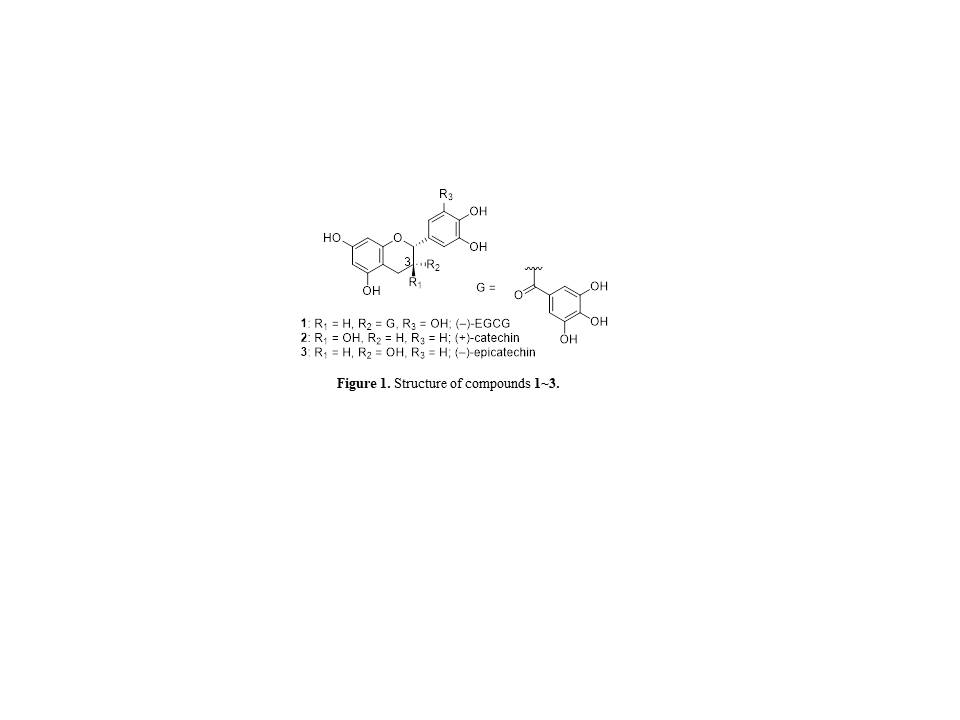
Ion channels are important membrane proteins that allow ions to pass through the channel pore for cell function regulation. Their protein functions include establishing the control of electric potentials accompanying with the ligand binding to the channel and the opening/closing the pore. Currently, while the expansion of ion channel measurement demands for cell function evaluation and regulation, the intact membrane fabrication on conductive substrate, especially for the cytoplasmic face analysis, is still challenging.
In this study, we investigated the design of peptide interface between cell membrane and highly oriented pyrolytic graphite (HOPG) substrate. By using the bifunctional peptides capable of substrate binding and strong cell membrane binding, immobilization of cell membrane attaching onto substrate after osmotic shock was evaluated.
In order to screen cell membrane strong binding peptides, we designed peptide array that allow multi-peptides synthesis on a cellulose membrane and binding assay with NIH-3T3 cells was conducted. Screened candidate peptide was fused with HOPG binding peptide and evaluated the bi-functionality expression using chemically synthesized peptide. After the surface modification of HOPG with peptide candidates, cultured NIH-3T3 cell was sowed and cultured. Prior to the cell disruption, cell membrane was stained by Cell mask orange and the cell culture surface was soaked in cold MilliQ for osmotic shock. The cell membrane structure was observed with fluorescent microscope.
Herein, we show that bi-functional peptides screened using peptide array are suitable interface enabling surface functionalization just by dropping peptide solution on the graphite. The peptide interface revealed some superior properties for cell culturing and for stable immobilization of cell membrane attaching onto substrate even after the cell disruption process. The developed peptide-based interfaces on HOPG substrate open the door for new biosensor developments for ion channel activity evaluation from the stimuli by intracellular ligand molecules.
n-3 Fatty acids such as eicosapentaenoic acid (EPA) and docosahexaenoic acid (DHA) have been associated with cardiovascular function and other diseases. However, EPA and DHA are easily prone to oxidation due to many double bonds. This study focused on the oxidation stability of EPA and DHA encapsulated with maltodextrin by spray drying. Krill oil was emulsified with saponin and sodium caseinate emulsifiers by mechanical and high-pressure methods and then the emulsion was spray dried in an Ohkawara L-8 spray dryer to produced powders. The oil droplet size after the spray drying was measured as well as the amount of surface oil, the oxidation stability and the retention of the EPA and DHA after storage at 25, 50 or 70 °C for 1, 2 and 4 weeks. The results showed that the amount of surface oil and oil-droplet size affected the oxidation stability of krill oil in spray-dried powders. Krill oil of small oil droplet size was more stable than that of large one.
Keywords:
DHA, EPA, Krill oil, Oxidation stability, Powder, Spray dryer
1. Introduction
Recent advancement of genome-editing technology allows the site-specific integration of gene of interest (GOI). The information of genomic loci that support high level expression of GOI, in combination with such genome-editing technology, will be useful to rapidly establish good CHO cell lines suitable for the production of biopharmaceuticals. In this study, we aimed to screen the DNA regions that strongly express transgenes.
2. Methods
CHO-K1 cells were obtained from Riken Cell Bank and maintained in F12 medium supplemented with 10% fetal calf serum and antibiotics. HIV- or mouse stem cell virus-based vectors that expressed eGFP under the control of CMV promoter were produced. CHO cells were infected with the vectors in low multiplicity of infection to prevent multiple integrations. Cells with strong fluorescence intensity were sorted by flowcytometer and expanded for further analysis. Integration sites were determined by inverse-PCR. To integrate model antibody expression unit, reverse reaction of Cre recombinase on mutated lox P sequence or CRISPR/Cas9 integration was performed.
3. Results and discussion
Several integration sites were determined for the clones with high/low expression. The integration sites of lentivirus vectors are not completely random (preferences: transcribed region). Chromosome immunoprecipitation analysis of parental CHO cells suggested that some histone modification was higher in integration sites of high-expressing clones, suggesting that genomic loci that support high level expression of GOI were partly related to specific epigenetic status. The expression of model antibody was higher in higher eGFP-expressing locus.
This research is partially supported by the developing key technologies for discovering and manufacturing pharmaceuticals used for next-generation treatments and diagnoses both from the Ministry of Economy, Trade and Industry, Japan (METI) and from Japan Agency for Medical Research and Development (AMED).
Meropenem is an antibacterial drug used as a final-line against multidrug-resistant bacterial infections. In general, overdose of antibacterials damages kidney, but underdose allows creation of the resistant bacteria. Thus, therapeutic drug monitoring (TDM) of antibacterials are strongly required. Development of TDM of meropenem is urgent because there is no effective therapeutic method against infection of meropenem-resistant bacteria. Thus, we are developing a real-time meropenem sensor using molecularly imprinted polymer (MIP). A MIP is synthetic polymer whose matrix is imprinted with structure of the target molecule during the synthesis process. Copolymer of methacrylic acid (functional monomer) and N,N-methylenebisacrylamide (MBAA: crosslinking monomer) imprinted with meropenem was grafted on the surface of graphite particles. The particles ware mixed with silicone oil to prepare a carbon paste electrode for sensing meropenem. Cyclic voltammetry of 5 mM potassium ferrocyanide was performed with the electrode. Fig. (A) shows the correlation between the current and the concentration of meropenem or imipenem which is the analogue of meropenem. Both of the currents depended on meropenem and imipenem with the similar sensitivity We thought that the poor selectivity was due to the high hydrophilicity and flexibility of MBAA. Therefore, ethylene glycol dimethacrylate (EDMA), which is more hydrophobic crosslinker, and MBAA were blended (molar ratio of 1:1) to prepare a new MIP carbon paste electrode, and the same experiment was performed. As shown in Fig. (B), the current at this electrode was approximately twice as sensitive to meropenem as to imipenem. Therefore, more rigid MIP of the electrode, may detect meropenem without interaction in blood and will enable the TDM of meropenem.
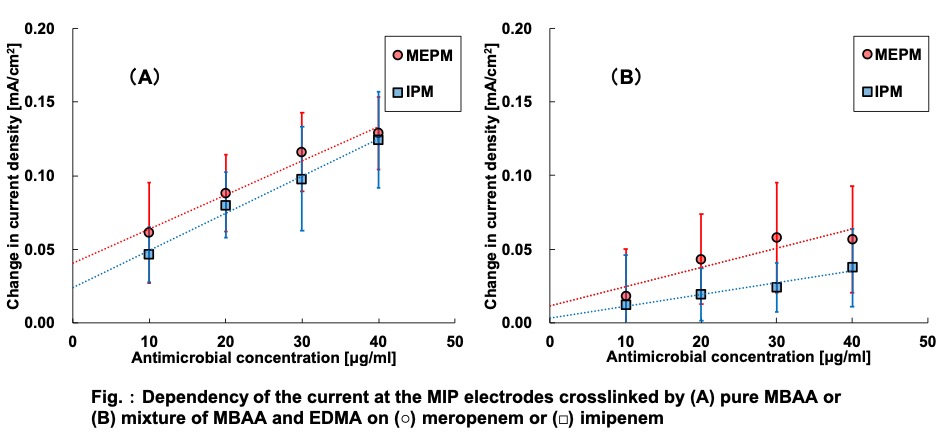
We believe they are many broad candidates available in nature, which can move beyond difficulties to out boundary so that the good platform for fermentation of lignocellulosic biomass could be built without too much genetic modification. However, it is not easy to achieve the candidates due to the unique adaptation possessed by many yeasts upon the environmental stress.
In this study, we have developed the simultaneous method for screening the candidate yeasts, which capable to grow and ferment lignocellulosic lysate into ethanol and fine chemicals such as lactate. By using culture collection in National Bio-resource Collection (NBRC) Japan, and Indonesian National Culture Collection (InaCC), the screening of the yeast strain, having a potential of growing and fermentation in the medium containing fermentation inhibitors, was conducted. Regarding the possibility of bio-resources in Asian for bio-refinery, we would like to discuss also in this presentation.
Formic acid (FA) is considered as a promising liquid organic hydrogen carrier for the fuel cells. FA is well-known compound to transfer into H2/CO2. With its properties, we concerned FA as the source of high-pressure CO2/H2 without any compressing procedures. These high-pressure gases can utilize for not only the high-pressure H2 for FCVs, but also various chemicals as solvents and reagents. In our presentation, we show the development of the continuous production of high-pressure H2/CO2 over 150 MPa, and easy separation from the generated gases under high-pressure conditions.
For the development of the high-pressure gas generation by the FA dehydrogenation, we used the Ir complex as a homogeneous catalyst. The catalyst can successfully produce the high-pressure gas with a high rate (TOF = 2500 h-1 at 30 MPa) at the temperature of 80oC. Whereas in the high-pressure conditions, the catalyst was deactivated gradually with decreasing the reaction rate. To overcome this, we developed higher durable catalyst by modification of the ligand, and the modified catalyst can generate high-pressure CO2/H2 for longer time. For the further development, we found that the iridium aqua complex coordinated with a pyridyl-imidazoline ligand showed the higher performances on the FA dehydrogenation at the pressure as high as 153 MPa.
We also demonstrated the high-pressure H2/CO2 gas separation by cooling the gas to change the supercritical to gas-liquid phase. Using our system, more than 99 mol% of H2 (96 mol% of purity) and 94 mol% of CO2 (99 mol% of purity) were separately obtained as a gas and liquid, respectively, under the high-pressure conditions.
Ours system has a potential to be used as a simple and easy to handle system for the generation of high-pressure CO2/H2 and these separated high-pressure gases can be used for the variety of application such as fuel cell vehicles.
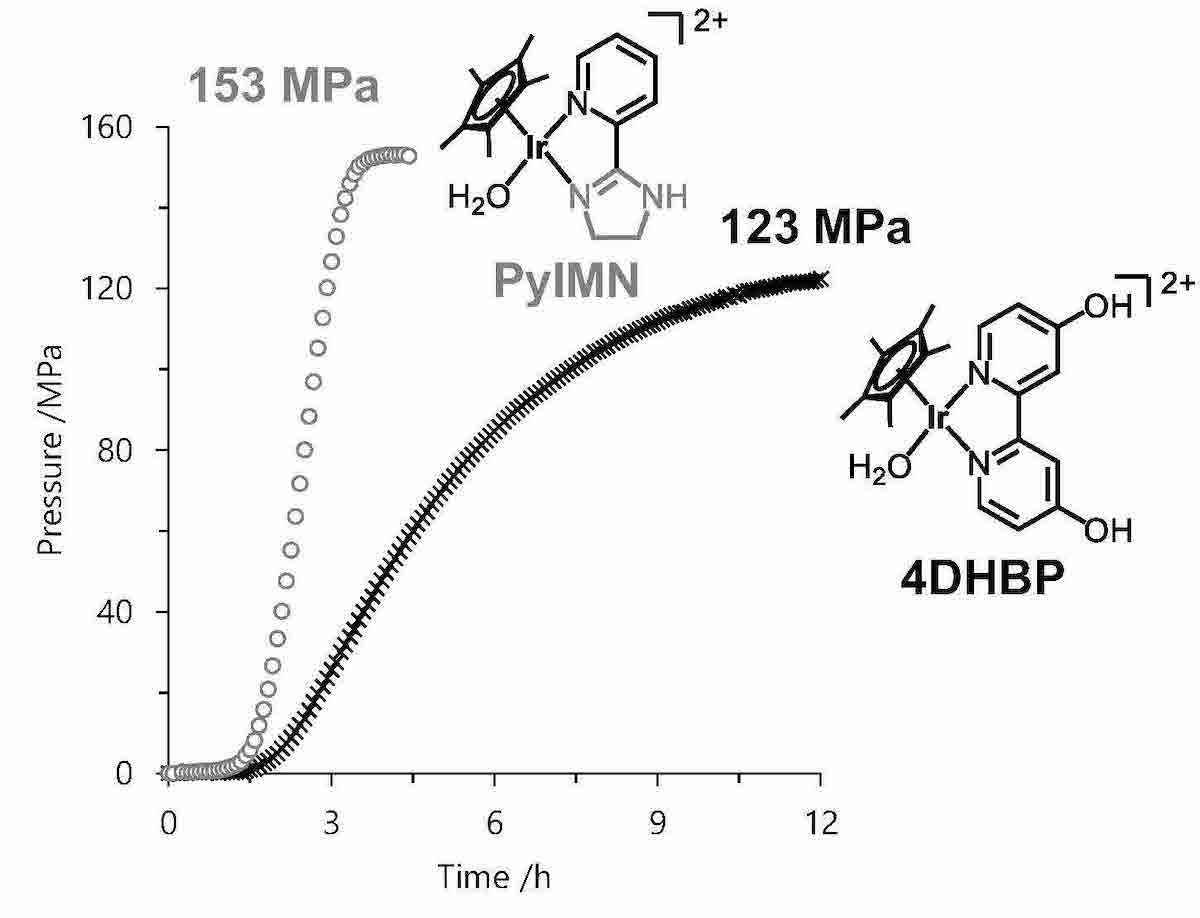
Carotenoids exist in plants usually as the (all-E)-configuration which have higher crystallinity and lower solubility in organic solvents compared to the Z-isomers. When they are converted to Z-isomers (cis forms), bioavailability increases due to the lower crystallinity and higher solubility [1, 2]. We have studied Z-isomerization of carotenoids such as lycopene and beta-carotene and behavior of the isomers in extraction process and fine particle formation process. Since Z-isomers have higher solubility in supercritical CO2, extraction of carotenoids from plant materials is enhanced. Fine particle formation process is also influenced due to the difference in the crystallinity as well as the solubility.
Z-isomerization behavior of lycopene in the oleoresin was studied by adding various vegetable oils and the key component to enhance the isomerization was revealed. When the plant materials were pretreated to convert Z-isomers, the extraction rate of carotenoids by supercritical CO2 or subcritical dimethyl ether increased considerably [3].
For particle formation by SAS process, smaller particle was obtained by Z-isomerization pretreatment, whereas (all-E)-form of carotenoid produced larger crystal form of particles [4].
Reference
[1] K. Murakami, M. Honda, R. Takemura, T. Fukaya, M.Kubota, Wahyudiono, H. Kanda, M. Goto, Biochem. Biophys. Res. Commun., 491, 317, 2017
[2] M. Honda, Yo Watanabe, Kazuya Murakami, Nguyen Ngoc Hoang, Wahyudiono, H. Kanda, M. Goto, Eur. J. Lipid Sci. Technol., 2017, 1700293 (1-8), 2017
[3] K. Murakami, M. Honda, Wahyudiono, H. Kanda, M. Goto, Sep. Sci. Technol., 52, 2573-2582, 2017
[4] T. Kodama, M. Honda, R. Takemura, T. Fukaya, C. Uemori, Wahyudiono, H. Kanda, M. Goto, J. Supercritical Fluids, 133, 291-296, 2018
The history, principles and potential of Process Intensification (PI) will be introduced. A range of “tools” that are particularly suited for the development of PI-based processes will then be described, with particular reference to the re-engineering of pharmaceuticals to improve bioavailability, and to provide targeted response and controlled release modalities. Examples of PI success stories and “not-so-successful” case studies will be presented, as well as some lessons learned from the coal-face during my travels along the Journey to Technology Transfer & Commercialisation.
Curcuma xanthorrizha Roxb, known as Temulawak or Javanese ginger, is a plant species. Its rhizomes are used as a medicinal herb. It contains curcumin as an active compound and ethereal oils mainly consisted of sesquiterpenes. In this work, Curcuma xanthorrizha Roxb ethanolic extract was micronized with an addition of PVP using supercritical antisolvent (SAS) method. The ethanolic extract was obtained from dried Curcuma xanthorrizha Roxb using soxhletation. For the micronization, the extracted compound solvent was a mixture of acetone and ethanol (90:10 (v/v)), while the supercritical CO2 was used as an antisolvent. The SAS process was carried out at temperatures of 40, 60, and 80oC, pressures of 8, 10, and 12 MPa, and PVP concentrations of 0, 2, and 4%. The produced particles were analysed by SEM (Scanning Electron Microscopy), FTIR (Fourier Transform Infrared Spectroscopy) and HPLC (High Performance Liquid Chromatography). The effect of operating conditions on the particles size and morphology was evaluated. Based on the HPLC analysis, the extract mainly contained curcumin. By using this process, the extract microparticle had smaller size than standard curcumin (6.42 ± 3.45 μm) and PVP (33.25 ± 18.83 μm). Microparticle extract with size ranging from 0.6 – 5.95 μm were successfully formed. The particle size decreased as the temperature increased, whereas pressure did not significantly affect the particle size or morphology. The best result was predicted at a pressure of 12 MPa, temperature of 40oC, and 2% PVP concentration in solution. Extract microparticles have amorphous form and it does not form crystal. From the experimental result, it can be concluded that SAS method with an addition of PVP is very effective to reduce the size of particles and increase the bioavailability of extract.
Keywords: Micronization; Curcuma xanthorrizha Roxb; Supercritical antisolvent; PVP; Curcumin;
A mixture of CO2 and a co-solvent is widely employed as a solvent or mobile phase for supercritical fluid extraction, chemical reaction, supercritical fluid chromatography etc. Kinematic viscosity is one of important transport properties, and is required for designing chemical process as well as estimating dimensionless numbers such as Reynolds number, Schmidt number, Prandtl number [1]. A more accurate estimation method for kinematic viscosity is increasingly demanded. The authors have proposed the estimation method using modified Eyring and activity coefficient equations [2-5].
This paper deals with the estimation of kinematic viscosities for CO2 + alkane (decane, tetradecane, hexadecane, octadecane) systems at high pressures using the modified Eyring and Wilson-VISCO model by the following equations [6].
where
The correlated results are compared with those of McAllister model [5] based on Eyring model..
where
The kinematic viscosities for ternary systems (CO2 + alkane + alkane) were then predicted using binary parameters.
References:
1) B. E. Poling, J. M. Prausnitz, J. P. O'Connell: The Properties of GASES AND LIQUIDS, fifth edition, McGraw Hill (2001)
2) K. Tochigi, K. Yoshino, V. K. Rattan: Int. J. Thermophys., 26, 413 (2005)
3) K. Tochigi, T. Okamura, V. K. Rattan: Fluid Phase Equilib. 257, 228 (2007)
4) H. Matsuda, K. Kurihara, K. Tochigi, T. Funazukuri, V. K. Rattan: ibid., 470, 188-192 (2018)
5) H. Matsuda, K. Tochigi, K. Kurihara, T. Funazukuri, V.K. Rattan: ibid., 492, 137-144 (2019)
6) K. Tochigi et al.: AIChE 2018 annual meeting, Oct.28 – Nov. 2, Pittsburgh (2018)
Supercritical carbon dioxide (scCO2) extractions and fractionations with co-solvents can provide many advantages for pharmaceutical and natural foods, which are no solvent residual, mild critical conditions and capability of tuning solvent property by varying pressure and temperature. Solubility data of pharmaceutical compounds are important information to design scCO2 extraction and fractionation processes. The objective of this work is to acquire the solubility data of pharmaceutical compounds in scCO2 with co-solvent and to analyze their behavior of co-solvent adding effect in term of enhancement factors (E: Eq(1)) based on local compositions. Solubility of aspirin derivatives in scCO2 with a methanol were measured at 333 K and 12.0-20.0 MPa by changing the methanol contents. The enhancement factor (E) were calculated from the measured data and correlated with thermodynamic models. Local compositions of MeOH co-solvent (xLMeOH ) were evaluated by considering the similarity of the local composition to the cybotactic region in spectroscopic measurements around an indicator, in co-solvent and CO2 system. The UV-Vis spectral data of the co-solvent with CO2 were obtained from literatures [1]. Figures 1a and 1b show the E and xLMeOH values as a function of pressure. At lower pressures (P < 10 MP), interactions of aspirin with co-solvent methanol were dominant due to low polarity of CO2. The contribution of local composition (xLMeOH ) was significant (Fig.1b). With increasing pressure, solubility of aspirin in CO2 generally increased, however, the E values (Fig. 1a) tended to decrease. The reasons for this may be attributable to a decrease in xLMeOH values (Fig. 1b). Polarity of CO2 becomes stronger at higher pressures and consequently strengthen the interact with the solute, leading to a reduction in xLMeOH values (Fig. 1b). Thus, analysis of solubility based on local composition provides better understanding in molecular interactions.
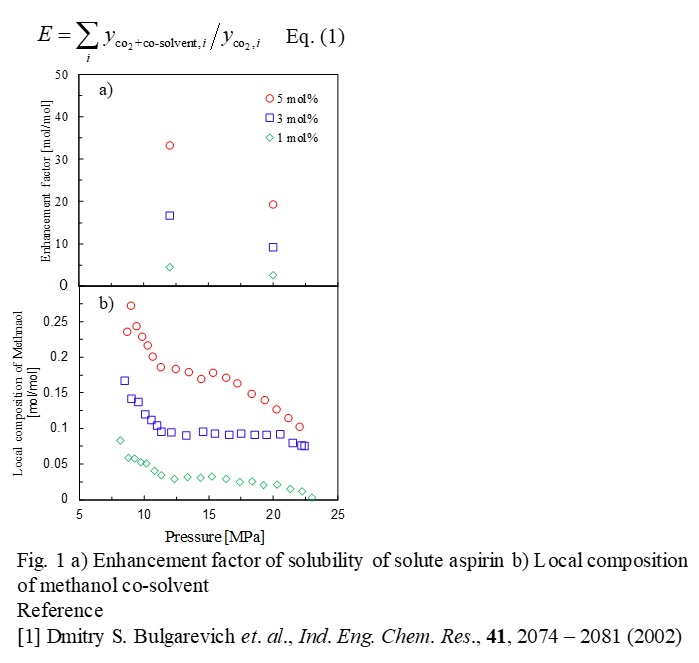
Activated carbon has been widely used to prevent emissions of volatile organic compounds (VOCs) in industrial processes because of its high adsorption ability. Regeneration of used activated carbon is required for its reuse in the industrial processes with the aim of SDGs. Supercritical carbon dioxide (scCO2) is a promising solvent for the regeneration of activated carbon because of its high diffusivity into the microstructure and ability to operate at a moderate temperature (critical point : 304 K) resulting in less damage to the microstructure of the adsorbent.
We have studied the scCO2 regeneration of the activated carbon used in exhaust facilities of semiconductor production factories, suggesting long used activated carbon could not be regenerated because of high boiling point adsorbates [1]. The experimental results show these high boiling point adsorbates were not removed from activated carbon by the scCO2 regeneration, and these adsorbates were caused by propylene glycol monomethyl ether (PGME) and propylene glycol monomethyl ether acetate (PGMEA) as main VOC components at practical semiconductor manufacturing processes [1]. The activated carbon with PGME and PGMEA was influenced by heat treatments (200-500 °C) at the exhaust facility, and high boiling point adsorbates were observed in the case of heating temperature of higher than 250 °C, which suggested that heating temperature of 200 °C prevented high boiling point adsorbates.
In this study, practical applications of the scCO2 regeneration process of activated carbon used at the exhaust facility of a semiconductor production factory were studied while considering the performance of the exhaust processor with the scCO2 regenerated activated carbon and reduction effects of industrial wastes and CO2 emissions.
Reference
[1] Ito, Y., I. Ushiki, Y. Sato and H. Inomata, Kagaku Kogaku Ronbunshu 45, 29-34(2019)
High Density Polyethylene (HDPE) is a type of polyethylene used in a lot of products, from containers for high purity chemicals, package for food to bottles for water. It is impact resistant, long lasting, and easily molded. This type of polyethylene is manufactured at low temperatures and pressures, using Ziegler-Natta and metallocene catalysts or activated chromium oxide (known as a Philip catalyst). In this process, impurities like oligomers, additives, and products of side reactions are generated. These impurities increase the toxicity of the polyethylene, and may migrate to the packed product if found in high concentrations. For the purpose of extracting them, many extraction methods like soxhlet, accelerated solvent extraction, and microwave extraction have been known in the literature. However, these methods have many disadvantages like long extraction times, use a lot of solvent, and require further clean-up of the solvent. To overcome these problems, supercritical fluids have become an alternative because of their tunable solvating properties by changing pressure and temperature. In this research, we use supercritical carbon dioxide because it does not require further clean up, has an easy achievable critical point and functions as a good swelling agent for polymers, which facilitates extraction. We succeeded on extracting hydrocarbons from C16 to C22 at 22 MPa and 60 °C using 1 L/min flow rate and studied the effect of time on the extracted yield. These results were also compared to soxhlet which selectivity for hydrocarbons was found to be less than the shown by supercritical carbon dioxide extraction (see Fig. 1)
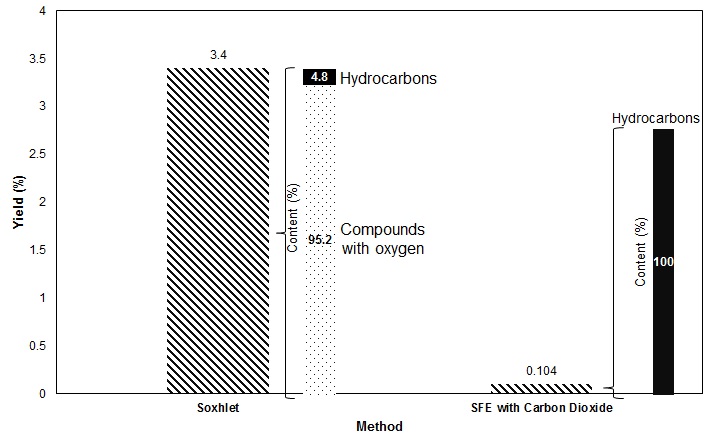
Polyvinyl chloride (PVC) consumes less petroleum, which is an exhaustible resource, and is cheaper than other plastics. Foaming of the PVC is also a subject of interests in engineering because the foam is superior in thermal insulation, cushioning and light weight property. In the forming, use of carbon dioxide (CO2) as plasticizer/blowing reagent has been attracting attentions due to its characteristics which form microcellular plastics. Unfortunately, in the case of the PVC, the PVC does not dissolve CO2, and use of CO2 as plasticizer/blowing reagent is impossible.
In the PVC molding process, the mixture of PVC, organic plasticizer, and stabilizer (antioxidant reagent) was heated up because PVC is a thermosetting plastic. In this study, we are focused on the plasticizer instead of PVC as a CO2 reservoir for the foaming of the PVC during the heating stage. In theory, solubility of the CO2 into the plasticizer is high at low temperature. The CO2 would separate from the PVC mixture during the heating stage which result in the formation of bubbles in the PVC mixture matrix. As the separation of the CO2 and the thermal curing take place at the same time, the control of the foaming process would be difficult.
In this study, we examined the preparation of PVC foam using carbon dioxide as a blowing agent, Diisononyl phthalate (DINP) as plasticizer, and LOX-13 as a stabilizer by a batch process. As described above, foaming and thermal curing occurs at the same time, the structure of the PVC foam strongly depends on the heating time and temperature. So, the relationships between foam characteristics and the heating time and temperature were examined.
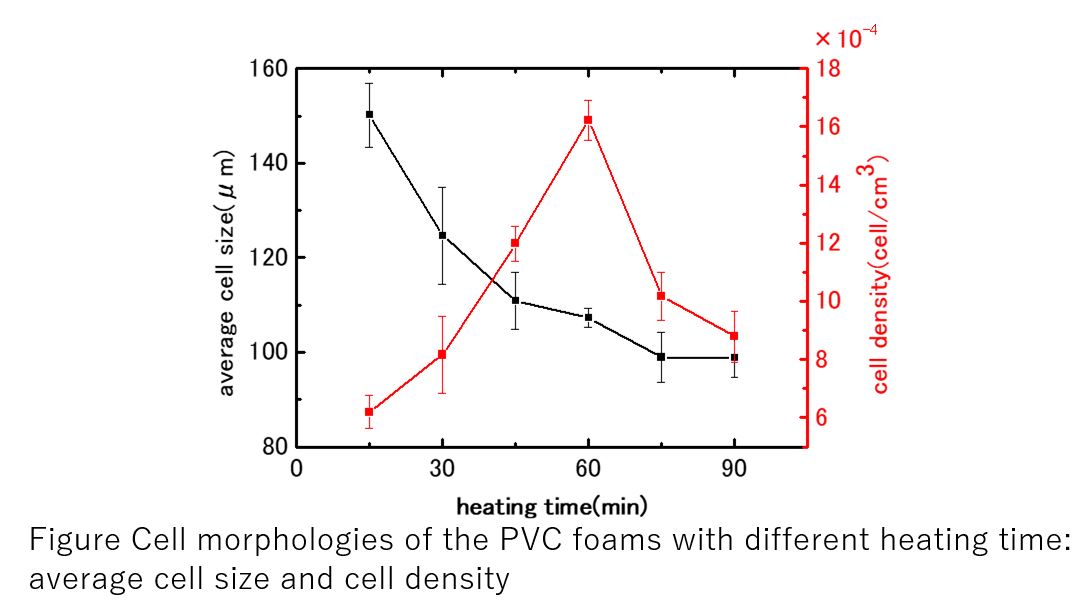
Fast flow liquid-liquid extraction process using CO2 microemulsion has been developed to extract and separate hydrophobic compounds from liquid. The process can be adapted to aqueous ethanol solution of a biaryl compound, which is a model of solution obtained after Suzuki-Miyaura cross coupling reaction. Ethanol aqueous solution of the biaryl with salts and CO2 are mixed in a micromixer at 40 °C and 20 MPa, which forms microemulsion of CO2-rich phase/water-rich phase. Because of large interface area of phases fast extraction can be achieved. After extraction, CO2-rich phase and water-rich phase are separated in a separating cell. The level of water-rich phase is maintained by controlling the aperture of a control valve in the bottom outlet line to keep the differential pressure between lines from bottom and top of the cell at constant. Pressure is controlled by a backpressure regulator equipped in the top outlet line. The above process can extract more than 80% biaryl continuously to CO2-rich phase.
This study investigated effects of water/ethanol ratio of the model liquid and extraction pressure on biaryl extraction ratio at 40 °C. Biaryl extraction ratio increased with increasing water/ethanol ratio at 20 MPa. It is probably because the solubility of biaryl in liquid decreased with increasing water/ethanol ratio since the biaryl is a hydrophobic substance. Biaryl extraction ratio increased with increasing extraction pressure. Carbon dioxide density increases with increasing pressure under a constant temperature, so the solubility of the biaryl should increase at higher pressure conditions. Thus, it is considered that the higher solubility in CO2-rich phase resulted in higher biaryl extraction ratio under higher pressure conditions. In the presentation, relationship between biaryl solubilities and water/ethanol ratio or extraction pressure will be discussed based on the biaryl solubility data.
Liposome is widely recognized as an ideal drug carrier for its unique characteristics such as possession of internal space, bio-compatibility and sub-microstructure. In the conventional production methods, multi-step processing and batch production restrict production efficiency. To overcome this problem, flow production method using supercritical carbon dioxide and microfluidic system was proposed in this study.
Supercritical carbon dioxide was used as a main solvent for lipids because of its high bio-compatibility, tunable properties by temperature and pressure and low critical temperature, which is beneficial for the production of thermo-sensitive products. Moreover, supercritical carbon dioxide can be thoroughly eliminated after the process simply by depressurization and therefore, solvent separation step can be omitted from the process. Liposome was produced in the micro-channel, where slug flow of supercritical carbon dioxide phase and liquid phase is formed. Each liquid slug in the flow behaves as a tiny container separated by supercritical slugs and steadily flows along micro-channel with a constant space time. This regularity of the slug flow guarantees that the product properties have no deviation. After the production of liposome, supercritical phase and liquid phase were separated by gravitational force and continuously flows out through metering valves.
Obtained liposome was observed by transmission electron microscope (see figure). Nearly spherical structure less than 1 μm can be recognized. The size of this structure was measured by dynamic light scattering method and confirmed to be controllable in the range of 100 – 300 nm by changing flow rate of raw materials. Drug encapsulation, which defined by the ratio of total drug used in the process and entrapped drug in the structure, was measured by high performance liquid chromatograph. Furthermore, surface functionalization of liposome by chitosan is also achieved using the same method. The external surface of liposome was confirmed to be positively-charged after functionalization by dynamic light scattering method.
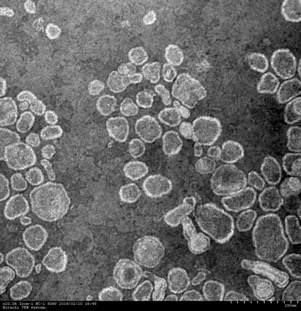
Organic photovoltaics (OPV) gains attentions because of various advantages including light-weight, flexibility, and low-cost. However, OPV suffers from low power conversion efficiency (PCE). To improve PCE, ordered bulk heterojunction (OBHJ) has been proposed as an ideal structure, in which p/n-types organic semiconductors are deeply interdigitated in nano-scale. Nevertheless, conventional technologies can fill only shallow features with the aspect ratio below 3. Meanwhile, we have developed temperature-driven supercritical fluid deposition (TSFD), which successfully filled micrometer-scale trenches (aspect ratio of 10) with anthracene. Accordingly, TSFD will be the only solution if it can fill the nano-scale high-aspect-ratio features with organic semiconductors. In TSFD, organic semiconductor is dissolved in hot supercritical CO2 and transferred to a cooled substrate under the constant pressure. The temperature drop causes supersaturation, resulting in precipitation and crystallization of the solute on the substrate. By carefully controlling the temperature drop, deposition can proceed in quasi-equilibrium, ending up with excellent crystallinity. High concentration supply of the solute leads to relatively high growth rate. As the process should start with ultra-thin and continuous film formation, followed by filling the remaining features, initial growth behavior during TSFD of tetracene was examined in this work. Dependences of supersaturation, supply concentration, and substrate temperature were studied. Small grains were found on the substrate besides the film, but completely eliminated by suppressing the flow rate fluctuation and adjusting the substrate temperature. Ultra-thin tetracene film was therefore formed with no grains. Under ultraviolet light irradiation, green emission from tetracene film was observed on the entire substrate surface. The thickness was 30 nm as shown in the figure. X-ray diffraction revealed the strong (001) orientation. The lateral size of the film was several orders of magnitude larger than those fabricated by the conventional methods, which is preferable for high PCE. Filling nano-scale high-aspect-ratio features will be realized.
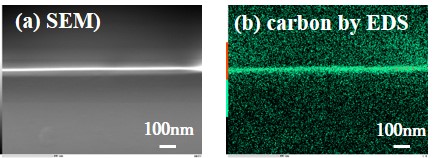
High-temperature and high-pressure water has been recognized as a green chemical medium for monosaccharide reactions because dehydration and/or retro-aldol condensation can proceed without the use of a catalyst. There are some reports on the monosaccharide containing the hydroxyl groups (-OH) such as glucose and fructose. We previously reported the reaction of N-acetyl glucosamine, which contains an acetoamide group (-NHCOCH3). In this work, we investigated the reaction of sialic acid and fucose, which are monosaccharides; however, there is no report on these two monosaccharides previously. Sialic acid contains both an acetoamide group (-NHCOCH3) and a carboxyl group (-COOH). Fucose contains a methyl group (-CH3). The dehydrations of sialic acid and fucose were proceeded in high-temperature and high-pressure water. In addition, the chemical structures of the dehydration products were affected by the functional group contained in sialic acid and fucose. From the comparison of the sialic acid, fucose, and other monosaccharide, we will discuss the effect of functional groups on monosaccharide reactions in high-temperature and high-pressure water.
The declining amount of petroleum resources has prompted researchers worldwide to explore various alternatives including biomass as feedstocks. In this context, 5-hydroxymethylfurfural (5-HMF) has attracted growing interest because it can be produced from biomass-derived sugars, and has the potential to be further converted into fuels and fine chemicals. Acid-catalyzed conversion of fructose to 5-HMF has been widely investigated. However, glucose is more cost-effective and readily available. This research focuses on the conversion of glucose into 5-HMF employing the synergy of subcritical H2O and supercritical CO2. Carbonic acid resulting from the synergy of supercritical CO2 and subcritical H2O could acted as an acid catalyst. The operating conditions were optimized, and addition of alcohol such as isopropanol and low transition temperature mixtures was also investigated. In addition, combined reactive separation technique was also employed to further increase the yield. In this approach, since 5-HMF has low polarity, scCO2 dissolve 5-HMF. Thus, continuous CO2 flow enables simultaneous reaction and separation, and could also suppress the formation of by-products.
The highest yield (30.4%) and selectivity (62.8%) was obtained under the condition of 2 wt%, 200 o C, 20 MPa, 1.5 h. This was likely due to the higher solubility of 5-HMF in scCO2 at higher pressure. Addition of isopropanol also had positive effect on the yield of 5-HMF. These results suggest the applicability of adding isopropanol and the use of reactive separation approach employing the synergy of subcritical H2O and supercritical CO2 to the conversion of glucose to 5-HMF.
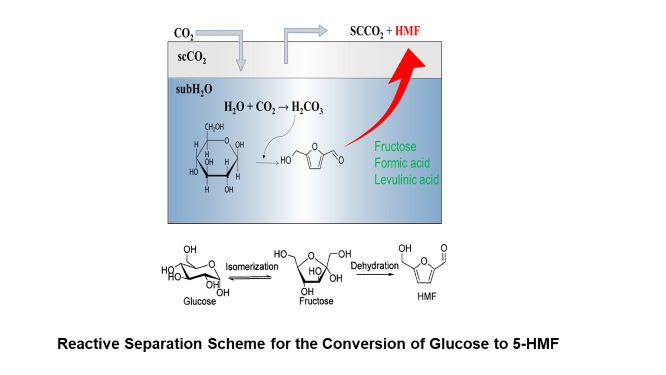
Rutin (quercetin-3-O-rutinoside) is a flavonoid glycoside which is widely distributed in many plants such as buckwheat and onion. It has several functional properties such as antioxidant, anti-inflammatory, anticarcinogenic and other effects in human body. However, it has low absorption efficiency in the body and lower antioxidant activity and bioavailability compare with its aglycon, quercetin. Quercetin can be obtained via hydrolysis of the glycosidic bond between quercetin regidue and rutinose one. Conventionally, a liquid acid catalyst such as hydrochloric acid is used for the hydrolysis. Although the high yield of quercetin can be obtained by using the conventional method, there are some problems such as high impact to the environment and high cost due to considerable after treatments such as neutralization. Therefore, in this study, solid acid catalysts like graphene oxides (GOs) were employed as alternative catalysts and microwave (MW) irradiation was used as a tool of rapid heating of the starting material. The objectives of this study are to explore suitable operating conditions for high efficient hydrolysis of rutin and to develop a new isolation process of quercetin after the hydrolysis of rutin under hydrothermal conditions. As a result, we found that relatively high yield of quercetin was achieved at hydrothermal conditions (160-180oC) for 15-30 min in the presence of graphene oxide with microwave irradiation as shown in Fig. 1. In the conference, a suitable reaction and separation conditions for higher yield of quercetin by using this technique.
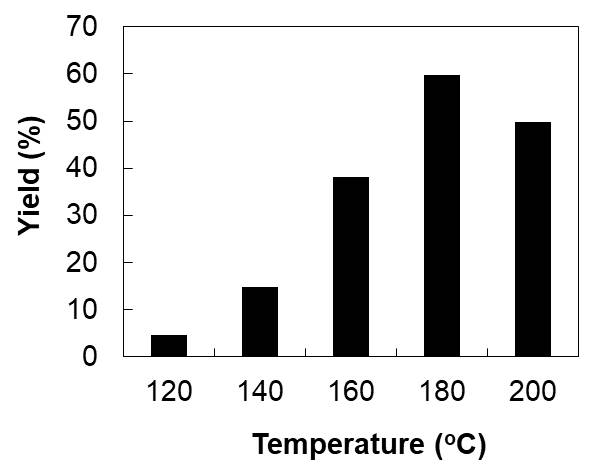
Development of drug delivery systems (DDS) and regenerative medicines (RM) are important in improving the quality of life (QOL) of the patients in medical care. Hyalurinic acid (HA) is a biocompatible polymer with high molecular weight (~600 KDa) alternating co-polymer consisted of two saccharide repeating units. HA have properties such as strong water retaining ability, high viscosity, gelation, biocompatibility and biodegradability which makes it a promising material for drug delivery systems and regenerative medicines. It is known that desirable forms and functions can be designed by controlling the molecular weight of the HA. Current methods for degrading the HA are by enzymes or acid or base degradation which require multiple steps, toxic chemicals and long reaction times (hours). In this work, we studied the decomposition of HA in high temperature water without any catalysts using batch type and flow type reactors. Results revealed that the hydrothermal treatment of HA with long reaction times lead to low molecular weight HA with different chemical structure from the initial HA and undesirable decomposion products. On the other hand, the hydrothermal treatment of HA conducted at short reaction times (below 10 s) using the flow reactor lead to low molecular weight HA having the initial chemical structure and no decomposition products. The estimation of molecular weight of the hydrothermal treated HA was possible by a kinetic model assuming random depolymerization. Hydrothermal treatment using a flow reactor system is an efficient method to obtain low molecular weight HA without chemical changes in the product HA and undesirable degradation products.
The catalytic activities of metal/metal oxide depend strongly on their exposed crystal facet. However, the active facet is thermodynamically unstable and the catalyst deteriorates with morphological change during the usage. Therefore, the regeneration process of facet-controlled catalyst has significant importance in the chemical engineering.
In previous study, it is reported that supercritical hydrothermal treatment with carboxylic acid enables the morphological control of AlOOH during the dissolution-recrystallization process [T. Fujii et al. Crystal Growth and Design, 16, 1996–2001 (2016)]. In this study, to develop the method for reactivation of degenerated catalyst, the change of exposed facet for ceria nanoparticles under supercritical hydrothermal condition with carboxylic acid is investigated.
In the experiment, spherical ceria nanoparticles was treated under supercritical hydrothermal condition at 400 °C with decanoic acid in batch-type reactor. As the modifier concentration increased, the morphology of nanoparticles changed from spherical to cubic shape exposing (100) facet. Moreover, the size distribution became narrower and the nanoparticles below 4 nm disappeared after supercritical hydrothermal treatment at higher modifier concentration. This narrowing of the size distribution accompanying with the morphological change from spherical to cubic implies that the morphological change was induced by the dissolution-recrystallization process affected by the organic modifier. Our previous study revealed that the in-situ surface modification by organic molecules during nanoparticles formation in supercritical hydrothermal condition enables the formation of ceria nanocubes exposing (100) facet, having high catalytic activity [J. Zhang et al. Advanced Materials, 19, 203–206 (2007).]. These results indicate that morphology and exposed facet can be controlled not only by in-situ surface modification, but by the post-treatment with organic modifier.
In APPChe 2019, we will discuss on the detailed mechanism of morphological change during the supercritical hydrothermal treatment and the feasibility of this method for the reactivation of facet-controlled catalysts.
Reaction kinetics of hydrothermal synthesis was evaluated through the formation of nickel oxide nanoparticle as a model in the wide range of high-temperature compressed water. Mixing state in supercritical hydrothermal synthesis was considered to find reaction control conditions. Rapid mixing can be achieved by low kinetic viscosity with small eddy size. Figure 1 shows the relationship between the mixing rate and Kolmogorov scale at mixing point; rapid mixing achieved with short mixing length in supercritical water. Based on the mixing study, the reaction rate of nickel nitrate was conducted changing pressure and temperature. Acceleration of reaction rate in the supercritical region was observed and investigated in terms of the solvent effects with the changes in dielectric constant using Kirkwood model. The role of water in terms of reactant was also investigated, and it was found that the reaction is retarded under dilute conditions where the water dissociation suppressed such as high temperature or low pressure. The fundamental kinetics study would pave the way for the practical use of supercritical water as a medium of nanomaterials synthesis.
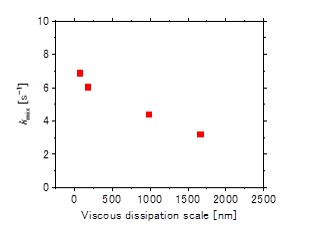
With the advent of electric cars that do not consume any petroleum fuel and the commercialisation of shale oil, the petrochemical industry is facing a big turning point. There is a need for an economically feasible process for petroleum fuels, which is less burdensome to the environment, and at the same time, makes it possible for a direct chemical conversion to the olefins. Upgrading bitumen through subcritical hydrothermal processing is a promising process. By using physicochemical properties of water at near critical conditions, it is possible to crack the asphaltene to light oils. Besides, since the operating temperature is lower than other processes at a high temperature, there is an advantage of suppression for the coking formation. However, since the operating temperature is relatively low, it is necessary to advance the reaction sufficiently. Therefore, a highly active catalyst capable of activating the reaction at a relatively low temperature is required.
In this study, highly concentrated Cr-substituted CeO2 nanoparticles were synthesised by the nonequilibrium reaction using a flow-type reactor under sub/supercritical hydrothermal condition. The oxygen storage capacity (OSC) of Cr-substituted CeO2 nanoparticles was compared according to the loading amount of Cr and the presence of the surface modifier. In a batch reaction, Cr substitution hardly proceeded, however in the flow-type reaction, more than 30 mol% of Cr was substituted. Moreover, the activity of Cr substituted CeO2 nanoparticles was evaluated using the bitumen upgrading under subcritical water conditions. The weight fraction of asphaltene decreased, and the gases and light oils increased with increasing the concentration of substituted Cr. Finally, by analysing the correlation between the OSC and the product of the nanocatalyst, the possibility of upgrading the low-temperature bitumen is suggested.
In this work, cerium-zirconium oxides particles were synthesized by solvothermal and hydrothermal method at low temperature in order to be utilized as catalyst in the delignification of wood biomass. The experiments were conducted at temperatures of 150oC – 250oC and pressures of 2 MPa – 5 MPa for 2 h in an autoclave made of SUS 316 with internal volume of 100 mL. Water, mixed of water and ethanol (70/30 vol/vol), and mixed of water and ethylene glycol (70/30 vol/vol) were used as solvent, while Ce(NO3)3 and ZrO(NO3)2 with 0.06 M concentration were used as precursor. The synthesized products were dried at 60 oC for 6 and then calcined at 500 oC for 6 h. The particle products were characterized using SEM and XRD. Furthermore, the particle products were used for hydrothermally delignification process of wood biomass. The addition of cerium-zirconium particles dramatically increased % lignin removal of rapeseed wood up to 97.6%. Based on the result, cerium-zirconium oxides particles are effective for pre-treatment of wood biomass in bio-refinery application. Moreover, cerium-zirconium oxides may reduce the use of chemicals in the delignification process.
Plant derived biomass has been focused as chemical feedstocks as well as an alternative fuel. Cellulose can be converted to glucose and cellooligosaccharides, which are ingredients for chemicals, pharmaceutical, dietary foods etc. However, due to its high crystallinity caused by inter- and intra-molecular hydrogen bonding it is not easy to convert to monosaccharide and oligosaccharides efficiently. Thus, a new efficient process to convert cellulose to monosaccharide and oligosaccharides is demanded. Hydrothermal conversion is one of the promising methods. In this study, filter paper as a cellulosic sample was hydrolyzed using a batch reactor under hydrothermal conditions. The effects of temperature, alkali species and the concentration on product distribution, reaction rates and the degree of polymerization (DP), crystallinity index (CrI) of hydrolysis residue were investigated.
In a batch reactor (volume 3.5 mL) ca. 0.05 g- filter paper and ca. 2.5 g- alkali solution were loaded at room temperature. Alkalis used were methylamine, dimethylamine, trimethylamine, ethylamine, diethylamine, triethylamine, propylamine, n-butylamine, s-butylamine, t-butylamine, pyridine, sodium hydroxide, aniline, benzylamine and ammonia. The hydrolysis experiments were carried out from 513 to 553 K. The product yields were measured by high performance anion exchange chromatography. The major products were glucose, cellobiose, fructose, levoglucosan and 5-hydroxymethylfurfural. Total organic carbon in the solution was also measured by a TC analyzer. The hydrolysis residues were analyzed by X-ray diffraction and CrI. The CrI values were calculated from the equation of segal1).
Fig.1 shows the effect of pyridine concentration on the glucose yield at 533 K. Glucose yield decreased after 60 min at pyridine concentrations above 0.6 mol/kg. We conclude that further decomposition products such as levoglucosan and 5-hydroxymethylfurfural were produced after 60 min.
1) L. Calvo et al., Ind. Eng. Chem. Res., 41, 6503 (2002).
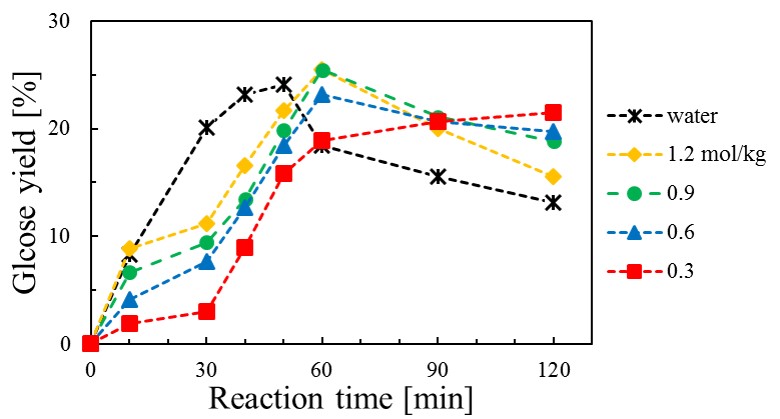
Keratin is a protein contained in human hair. The keratin contains 17% of the sulfur-containing amino acid cysteine, which could form disulfide bridges. Recently, low-molecular-weight keratin peptides are receiving a lot of attention in cosmetics and hair repair agents because of their high affinity to the skin and hair. At present, the low-molecular-weight keratin peptides are produced by the enzymatic hydrolysis of the keratin raw materials such as feathers. However, the enzymatic hydrolysis of the human hair keratin is difficult because the cuticle keratin protects the surface of the human hair.
In this work, we conducted the hydrothermal treatment of the human hair to hydrolyze keratin proteins. Since the hydrothermal treatment uses only water, the separation of the enzyme and the peptide is not needed and the peptide is safe as a hair repair material. The influence of reaction conditions (temperature and treatment time) on the molecular weight was studied.
0.1g of human hair and 1 mL of water was loaded into a stainless 316 tube reactor (inner volume 6 cm3). The rector was immersed into a sand bath at a temperature of 150, 180, and 250 °C. After 5~30 min, the reactor was removed from the sand bath and rapidly quenched in a water bath to room temperature. After solid and liquid products were separated by a filtration, the molecular weight of the products in the liquid phase was measured by the size-exclusion chromatography (SEC).
The low-molecular-weight keratin peptides could be obtained from human hair by the hydrothermal treatment. The low-molecular-weight keratin peptide with a peak at around 3.0 kDa was obtained at 150 and 180 °C. At 250 °C, the peptide with a peak at around 1.0 kDa was produced. The effect of the molecular weight of the keratin peptides on the repair capacity is also studied.
Chitin is the second most abundance resources after cellulose and mainly contained in the exoskeletons of crustaceans such as crabs and squid pens. Chitin nanofiber (NF) has attracted research interest in medical materials and healthy foods in recent years because chitin NF has large specific surface area and high biocompatibility. Furthermore, there are two types of chitin depending on crystalline structure. α-Chitin has antiparallel molecular chains with hydrogen bonds between molecular chains. β-Chitin has parallel molecular chains without hydrogen bonds between intermolecular sheets. Therefore, nanofibrillation of β-chitin is easier than that of α-chitin because of the absence of hydrogen bonds. In our previous report, we have prepared β-chitin NF dispersions with high viscosity and high transmittance from β-chitin powder; however, α-chitin could not be disintegrated into such NF dispersion due to many hydrogen bonds. In addition, we have obtained self-sustaining hydrogels from β-chitin NF dispersions by hydrothermal treatment; however, it is difficult in the case of α-chitin. If the gelation of α-chitin NF can be achieved, mass production for commercialization will be realized because α-chitin is more abundant in nature than β-chitin. Thus, it is important to establish the gelation method of α-chitin NF by hydrothermal treatment.
In this work, we obtained the α-chitin NF dispersions with high viscosity and high transmittance by reducing degree of N-acetylation and adding acids. The disintegration of α-chitin powder into NF was conducted with a water jet machine (Star Burst System, Sugino Machine Co, Ltd, Japan). The prepared α-chitin NF dispersions showed high viscosity and high transmittance. In addition, the hydrothermal treatment of the prepared α-chitin NF dispersions was conducted at 160 °C for 60 min by using a sealed reactor. After the hydrothermal treatment,α-chitin hydrogels with high mechanical strength could be obtained.
Supercritical carbon dioxide (scCO2) dyeing for textile and polymer processing is considered as a green and energy-saving process for view-points of environmental friendly and sustainable development. We developed a compact apparatus dyeing for plastic buttons of acrylic, polyester, nylon, and casein in SC-CO2 and carried out dyeing plastic buttons with C. I. Disperse Red 22. We could successfully dye the plastic buttons without cracks, bubbles, and black spots over the temperature ranges of 313.15 to 328.15 K and pressures of 8 to 14 MPa for acryl, the temperatures of 383.15 to 398.15 K and pressures 10 to 16 MPa for polyester, and 353.15 to 383.15 K and pressures of 8 to 14 MPa for casein with dyeing treatment time of 30 to 60 min, and the temperatures of 383.15 to 403.15 K and pressures of 21 to 29 MPa for nylon with dyeing treatment time of 60 to 100 min. The dyeing color depth of dye sorption in the buttons were measured by a spectral color difference meter. Also we measured the solubility of C. I. Disperse Red 22 over the temperature and pressure ranges of 353.15 to 398.15 K and 15 to 25 MPa. The K/S values for plastic buttons were correlated by a regression model, which was formulated by combining Fick diffusion equation with Henry-Langmuir type of surface adsorption of buttons in the present work. Using the model, we examined to represent the experimental K/S in terms of temperature, pressure, density, solubility of dye, and dyeing time. Finally, we compared K/S value by the regression model with those obtained by a multiple regression model expressed in terms of temperature, pressure, density, solubility of dye, and dyeing time and the range analysis of experimental design method previously reported.
Mesoporous silica materials such as MCM-41 [1] and SBA-15 [2] have been widely used in various applications because of its uniform pore structure, large pore volume, and large specific surface area. Mesoporous silica materials are generally prepared by removing template agents by calcination processes from the template included silica (step (i)). Then, functionalized mesoporous silica can be obtained by the surface modification of silanol groups on the surface of the material using silane coupling reagents (step (ii)) with liquid solvents. However, these conventional methods have some drawbacks such as the possible shrinking of pore structures, disappearance of silanol groups, and low penetrability of solvents into the mesopores.
To overcome these drawbacks, in the present study, the novel preparation method of functionalized MCM-41 mesoporous silica was developed using supercritical carbon dioxide based on our previous works [3, 4], which can achieve continuous treatment of extraction of the template (step (i)) and surface modification of mesoporous silica (step (ii)). The functionalized MCM-41 prepared by the continuous treatment method demonstrated more uniform pore size distribution and higher amount of modification by silane coupling reagents in comparison with the conventional methods.
References
[1] C.T. Kresge et al., Nature, 359 (1992) 710-712.
[2] D. Zhao et al., Science, 279 (1998) 548-552.
[3] I. Ushiki et al., Kagaku Kogaku Ronbunshu, 37 (2011) 512-517.
[4] I. Ushiki et al., Kagaku Kogaku Ronbunshu, 38 (2012) 391-396.
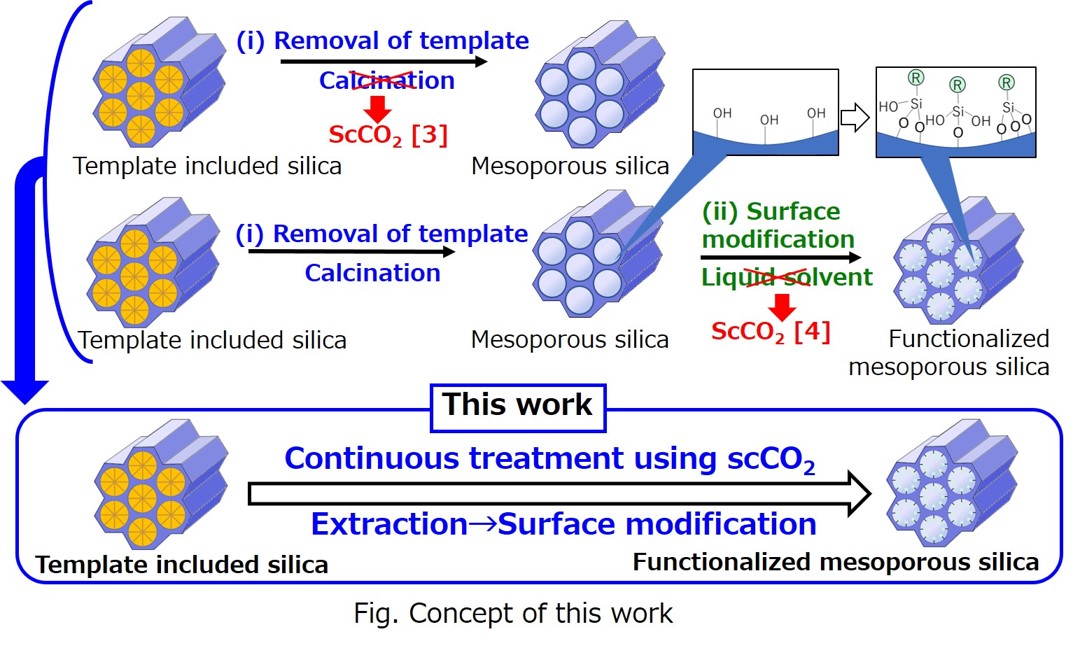
Spent coffee ground (SCG) is regarded as a food waste. However, SCG contains various kinds of high-value phytochemicals such as diterpenes, polyphenols and lipids. Diterpenes present beneficial effects towards human health. Diterpenes can protect skin from the harm of UV, and they are anticarcinogenic, anti-inflammatory and antioxidant. These features of diterpenes make them valuable in both cosmetics and pharmaceutical industries. In this research, we extracted cafestol and kahweol from SCG using supercritical CO2 with ethanol. To maintain stability of the extracts and also to increase their solubility and dissolution rate in water, we studied the micronization of extracts containing cafestol and kahweol with PVP using supercritical CO2. As cafestol and kahweol are sparingly soluble in water, combining it with PVP (water-soluble polymer) and transforming it into small particles can improve the solubilities in water to enhance their absorption in human body. The main objectives of this work are to extract cafestol and kahweol from SCG and to micronize it with PVP using supercritical CO2. The response surface methodology (RSM) with Box-Behnken design was employed to study the effects of extraction parameters on the extracts. The ranges of three parameters are temperatures (40-60 °C), pressures (10-30 MPa), and ethanol flow rates (0-0.5 ml/min). The predicted optimum total diterpenes amount is 65.81 mg/g-extract at temperature of 80 °C, under operating pressure of 30 MPa, and with the ethanol flow rate at 0.3 ml/min. The micronization process was carried out by supercritical anti-solvent process under 40 °C, 25 MPa, CO2 flow rate (15 ml/min) and solution flow rate (0.25 ml/min). Cafestol and kahweol were successfully encapsulated into PVP particles with diameters ranging from 0.25 - 0.05 μm.
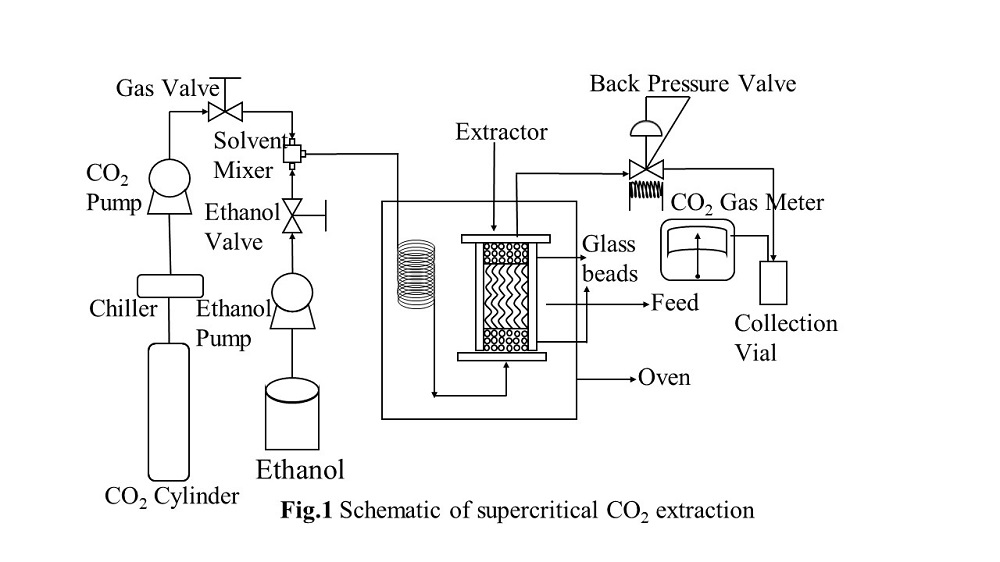
Bio-oil is often extracted from biomass by liquid solvent or supercritical carbon dioxide. However these extraction methods have several disadvantages. Liquid solvent extraction using hexane can be operated at an atmospheric pressure, but the extracted oil includes the impurities such as phospholipid and wax owing to the strong solvent power of hexane. On the other hand, supercritical carbon dioxide can extract bio-oil without impurities, but it requires high pressure condition. In this study, the expanded hexane with carbon dioxide is examined as a new extraction solvent. This solvent is diluted liquid hexane with carbon dioxide and it has less solvent power and higher selectivity of neutral lipid than normal liquid hexane does. Therefore the expanded hexane is expected to dissolve nonpolar oil and not to dissolve polar oil such as phospholipids.
The objective of this research is the development of new extraction technique of bio-oil from biomass using expanded hexane with carbon dioxide, where rice bran is used as a target biomass. The extraction was carried out at 25 oC, 4-5 MPa and 0.8-0.95 of molar fraction of carbon dioxide in expanded hexane with carbon dioxide. At 25 oC, 5 MPa, 0.86 of molar fraction of carbon dioxide, the oil yield was 1.2 times greater than that with normal liquid hexane because of the low viscosity and the high permeability of expanded hexane. Furthermore the phosphorus concentration in extracted oil was 6 ppm. It was very low level, comparing with that in rice bran, approximately 230ppm. This was because the solvent power of expanded hexane to neutral lipid decreased a little and that to polar components decreased much. As the results, expanded hexane with carbon dioxide could extract the phosphorus-free bio-oil with high yield under mild conditions.
Strawberry is one of the most popular fruits in Japan and its production is about 160 thousand tons per year. The leaf of strawberry is dumped after harvest. However, the leaf has high antioxidant property. Therefore, the extraction of antioxidants from the leaf of strawberry is expected as a production of new healthy food and effective utilization of biomass. In this study, the leaf of strawberry was extracted with a mixture of supercritical carbon dioxide and water that are non-toxic and harmless solvent.
The extraction experiments were conducted with semi-batch extraction system. At first, the leaf was introduced in the extractor, and then carbon dioxide and entrainer was supplied to the extractor. The extraction pressure was controlled with a back pressure regulator. The extract recovered was dried and weighted. The antioxidant capacity was evaluated by DPPH (2,2-diphenyl-1-picrylhydrazyl) radical-scavenging method on the basis of the amount of 2,6-di-tert-butyl-p-cresol (BHT), and the total phenolic content was evaluated with Folin-Ciocalteu method on the basis of the amount of gallic acid (GAE). The effect of entrainer was evaluated at 308 K and 20 MPa. The existence of water as an entrainer gave higher antioxidant capacity and the amount of total phenolic content of the extract than those in the absence of entrainer. At 20 MPa, antioxidant capacity and amount of total phenolic content tended to increase with increasing temperature. The extraction of antioxidants enhanced in high temperature region. At 313 K, the antioxidant capacity and the amount of total phenolic content tended to decrease with increasing pressure. The optimal condition for antioxidant capacity and the amount of total phenolic content was at 313 K and 20 MPa up to 333 K and 30 MPa.
Recently, attention is now focused on effective utilization of biomass, which is abundant in resources as a substitute resource for fossil resources. It is desirable to use woody biomass which is non-food biomass since the population is increasing, the use of food-based biomass may have new food problems. However, it is difficult to convert woody biomass to useful substances, and because high temperature processes are frequently used, a problem as high energy cost occurs. In recent years, therefore, attention is focused on chemical conversion of woody biomass using supercritical fluid technology. Based on the above background, attention was paid to tea fruit residue which is waste that don't cause food competition and capable of extracting useful components such as lipids or fatty acids in the previous research. The purpose of this work was to search conditions for high yield of lipids by extracting useful components from tea fruit residue on supercritical carbon dioxide. In supercritical carbon dioxide extraction, the effects of pressure, temperature and flow rate of carbon dioxide on the extraction yield of oil and lipid class were investigated.
Fluorochemicals have various unique characteristics [1] such as heat, chemical and non-adhesiveness/water repellency. Thus, fluorochemicals are used for various products to apply these characteristics. However, most of fluorochemical wastes are disposed by landfill and incineration above 1000 °C because of C-F bonds having high bond energy and electrical stability [2]. Prior to the disposal fluorochemical wastes should be made because toxic compounds could possibly be emitted in the course of their disposal. Namely, the incineration emits toxic compounds produced such as gaseous hydrogen fluoride, and the landfill elutes fluorine in environment [3]. Thus, a new effective defluorination process has been demanded. Many efforts have been made to remove fluorine from fluorochemical materials: by defluorination under hydrothermal conditions [3], electrochemical [4], and photocatalytic methods [3]. Our previous research found that the addition of ammonia and ammonia or sodium hydroxide were effective for hydrothermal dechlorination of PVC [5]. The objective of this study was to demonstrate the effectiveness of using aqueous basic solution in the hydrothermal defluorination of 4-fluoronitrobenzene. Certain amount of 4-fluoronitrobenzene and a basic aqueous solution were loaded in a small bomb-type bath reactor, and the reactor was heated in a molten salt or oil bath. Various basic species were tested, and sodium hydroxide was one of the most effective among them. The conversion rapidly increased in the early stage, and thereafter did slowly. The reaction rate will be discussed in the presentation.
[1] Maruzen Publishing Co., Ltd., Handbook of Chemistry: Applied Chemistry, 6th ed., 757 (2003)
[2] Moriwaki H. et al., Env. Sci. Tec., 39, 3388 (2005).
[3] M. Nozoe, et al., Env. Eng. Res., 43, 105 (2006)
[4] C. Schaefer, et al., Env. Sci. Technol., 52, 10689 (2018)
[5] K. Hashimoto et al., J. Mat. Sci. 43, 2457 (2008).
This study reports the separation of raw petroleum pitch materials by applying the supercritical fluid technology. The aim is to obtain the mesophase pitch, which is an important intermediate compound for various applications. Those applications include the battery manufacturing and artificial carbon materials. It is required to remove the low molecular weight and complex polycyclic aromatic hydrocarbons (PAHs) compounds from the raw pitch before the production of mesophase pitch. The purposes of this research are: (1) to develop a cleaner separation method for PAHs by using the supercritical fluid technology, and (2) to develop a relatively simple analysis scheme on determining the molecular weight and polydispersity by using the gel-permeation chromatography (GPC) with dual RI and UV detectors.
The separation process included two parts. The first part was the supercritical carbon dioxide extraction of the raw pitch sample. A stage-wise supercritical extraction process was investigated. Three extraction stages were operated at different temperatures. The second separation part used the residual pitch after the above extraction as the input materials. The subcritical anti-solvent (SAS) treatment was employed. In this SAS process, the relatively lower molecular weight part of the residual pitch was further removed. The final carbon dioxide insoluble pitch was obtained by using modified SAS equipment and novel experimental procedures. This final product was examined for its molecular weight and polydispersity. This final residual solid was ready for the next thermal condensation polymerization process. The most appropriate SAS operation condition was reported in this presentation.
A simple and effective analysis approach was reported in this study. The GPC with dual RI and UV detectors were investigated. A satisfactory calibration curve was obtained to determine the molecular weight after each separation stage in this study. The consistency between this analysis result with that from the complex NMR data was demonstrated.
Utilization of microfluidic systems for supercritical CO2 (ScCO2) extraction from the aqueous solution has gotten much attention to be applied for wide industrial fields. This is because the extractions in the microfluidic systems can achieve the high heat and mass transfer rates between ScCO2 and water phases, consequently improving the extraction efficiency. In the microfluidic system, understanding of the fluid flow patterns can be an important approach to clearly explain the extraction behaviour and to design the ScCO2 microfluidic system.
In this study, flow patterns of ScCO2-water and ScCO2-ethanol binary systems, and ScCO2-ethanol-water ternary system, are experimentally visualized in 1 mm of hydraulic diameter of window-square-channel. The flow patterns of the fluids after a micro-swirl-mixing technique are captured under different temperatures (32.0 to 60.0) °C and pressures (8.0 to 20.0) MPa. At near critical condition of ScCO2 (32.0 °C and 8.0 MPa), the mixture of ScCO2 and water formed a stable slug-flow. The flow pattern for ScCO2-ethanol system forms a slug-annular flow. The ternary system of ScCO2, ethanol and water resulted in the unstable slug-flow near the critical point (See Figure). In addition, at all other studied conditions, stable slug-flow with water slug formation are observed under ScCO2-water binary system. However, by changing the temperatures and pressures, different flow patterns are generated under ScCO2-ethanol binary and ScCO2-ethanol-water ternary systems. Wavy-flow, unstable slug-flow and single-phase flow are observed under ScCO2-ethanol binary system. While, ScCO2-ethanol-water ternary system forms the slug-annular-flow, wedging-slug-flow, unstable slug-flow and stable slug-flow at various temperatures and pressures. The formation of these flow patterns can be explained with respect to the phase equilibrium diagrams of ScCO2-ethanol binary and ScCO2-ethanol-water ternary systems.
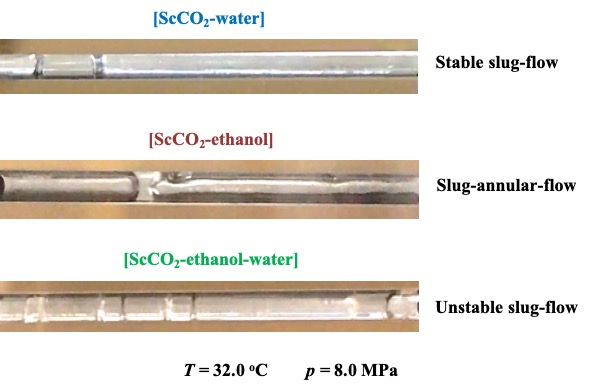
Supercritical CO2 (scCO2) extraction is suitable for the separation/fraction of functional compounds in natural products because it has various advantages of low temperature and non-toxic solvent residue. A co-solvent can be added to increase polarity and density of CO2 solvent, leading to an increase in extraction yield. Extraction using a co-solvent has been mostly operated via a semi-batch type apparatus. Recently, studies on a continuous extraction have attracted much attention from the viewpoint of throughput and operability by contacting scCO2 with natural compound solution. However, there have been reported a few studies related on the continuous extraction for multi-components systems.
In this work, ethanol and water were used as co-solvents for extraction/separation of perilla components via continuous counter-current scCO2 extraction. Among functional compounds contained in perilla, we focused on perillaldehyde, caryophyllene, squalene and rosmarinic acid, and target compounds in separation of perilla-extract are set to chlorophyll and rosmarinic acid. The former is undesirable compound in final products for its unique color, the latter is valuable compound with anti-dementia effect[1]. Figure 1 shows the results of counter-current extraction at 353 K and 14.0 - 20.0 MPa. The results showed that chlorophyll was more extracted in vapor phase as pressure increased, but rosmarinic acid was not found in vapor phase in this pressure range. Thus, chlorophyll could be separated from rosmarinic acid at high pressure condition.
[1] K. Ono et al., J. Biol. Chem., 287, 14631 (2012)
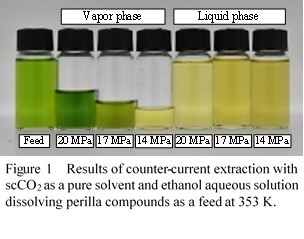
Wastewater including organic solvent is discharged from the cleaning and drying process in semiconductor manufacturing. It is generally treated by the activated sludge method. However, this method has problems such as a long treatment time, the necessity of pretreatment and aftertreatment, the generation of excess sludge. Therefore, the wastewater treatment technique with a short time and less environmental load is expected. In this study, we focused on catalytic oxidation in superheated steam.
The purpose of this research is the development of wastewater treatment technique by catalytic oxidation in superheated steam. The target substance was isopropyl alcohol (IPA). The experiment was carried out using a plug-flow reactor filled with MnO2 catalyst. The optimum decomposition condition was determined and the kinetics of catalytic oxidation reaction was analyzed. The experimental results were expressed as total organic carbon (TOC) removal.
The dependences of TOC removal on the reaction temperature and residence time were investigated. TOC removal increased with the reaction temperature and residence time. It achieved 99.8 % at 300 °C, 0.9MPa, 11 s and 1.2 of oxidant ratio. On the other hand, TOC removal was constant with long residence time at the low reaction temperatures of 200 °C and 230 °C. It was because acetone and acetic acid were produced by oxidation of IPA, and they were detected as TOC.
The reaction kinetics was examined using the pseudo-first order reaction model, and TOC removal correlated well using this model. Based on the results of this kinetics, the activation energy (Ea) and the frequency factor (A) for TOC decomposition were determined from the Arrhenius equation. As a result, Ea was 56.1 kJ/mol and A was 6.17×104 s-1.
From there results, the catalytic oxidation in superheated steam is useful for wastewater treatment.
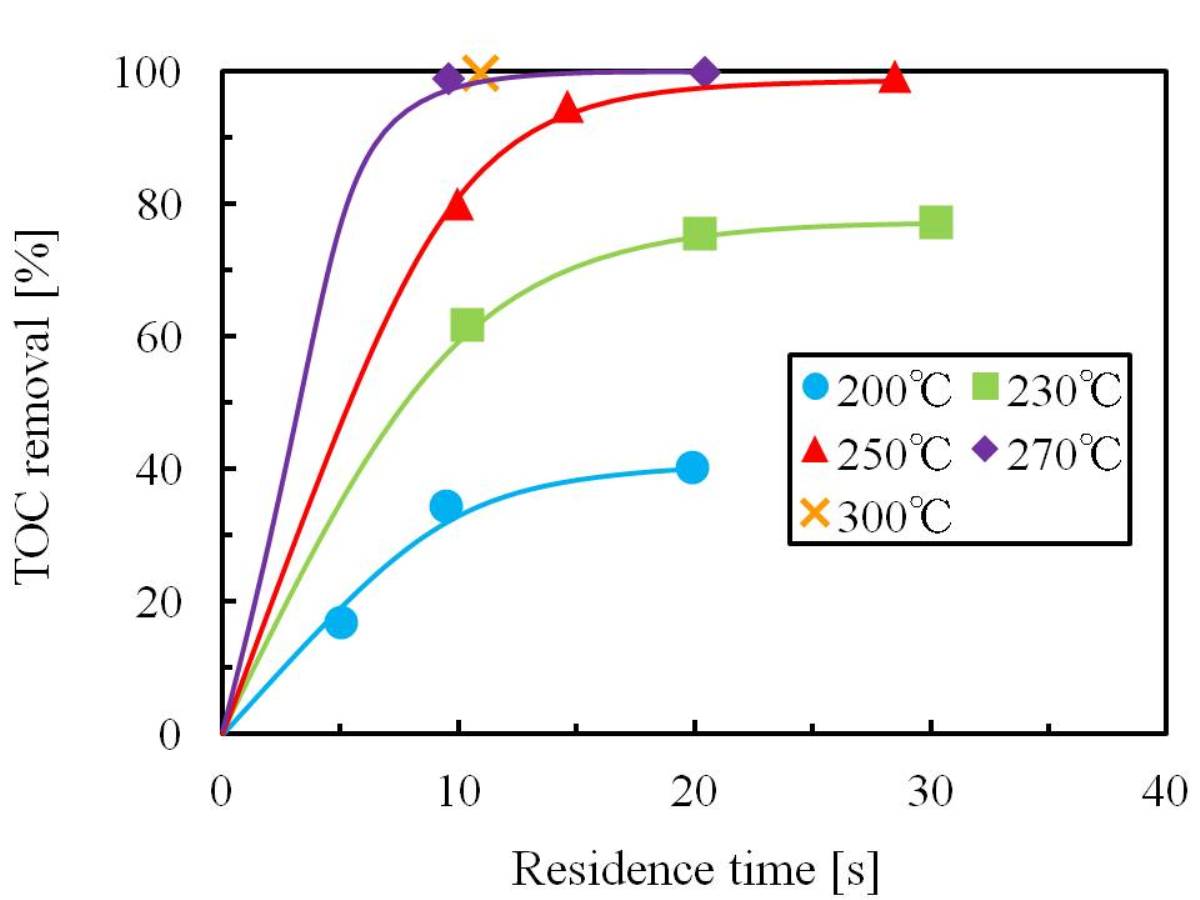
Supercritical water gasification (SCWG) process transforms biomass with high water content into H2-rich gaseous products by utilizing the unique properties of supercritical water at T ≥ 374 °C and P ≥ 22.1 MPa. From the viewpoint of food sustainability, utilizing non-food biomass such as waste cooking oil (WCO) is desirable. So far, its known treatment method is conversion to biodiesel through transesterification and hydrodeoxygenation. However, these processes suffer from low product conversion due to WCO's high water and free fatty acid content. Therefore, SCWG is an attractive option to achieve WCO treatment and bioenergy conversion at the same time. Due to SCWG's high operating requirement, a suitable hydrothermal catalyst is often required. However, the efficiency of this process is currently limited by catalyst deactivation. This study aimed to determine the mechanism of catalyst deactivation in SCWG. Vegetable oil was used as a representative compound for WCO. Experiments were conducted by gasifying vegetable oil using nickel catalysts in lab-scale flow type reactor made of stainless steel tubing. Experimental conditions employed were fixed at 400 °C and 25 MPa at variable feed concentration (2 – 5 wt%) and reaction time (60 – 300 min). The performance of the process was evaluated according to gas yields and efficiencies. Catalyst characterization was carried out before and after the reaction using N2 gas sorption analysis. To probe the catalyst surface, XRD and SEM-EDX analysis were conducted. The results of the study showed that catalyst performance can be observed with the system's ability to convert the biomass into desired gaseous products. Carbon deposition and loss of active catalytic surface area (Figure 1) due to particle sintering were considered as the main causes of nickel catalyst deactivation in the SCWG of vegetable oil.
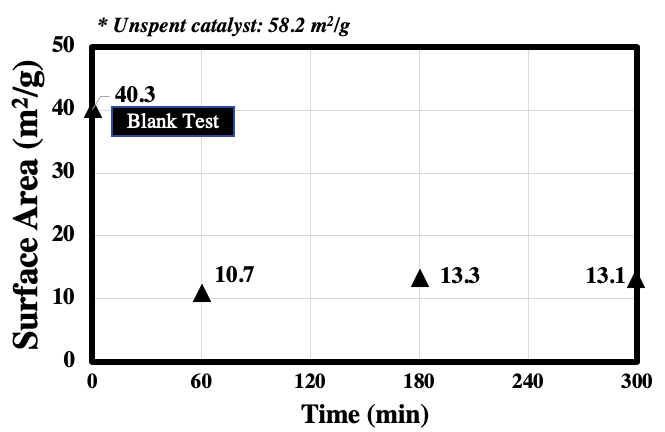
Food allergy is caused by a specific amino acid sequence of allergen protein. In order to reduce allergenicity of allergen protein, we must destroy specific amino acid sequence by hydrolysis or thermal treatment. Therefore, there are many researches that focus on the amino acid sequence of the protein. On the other hand, it is reported that the molecular weight of the protein determines allergenicity. This is based on a fact that most allergen proteins have a certain range of molecular weight, but there is no scientific basis.
In this study, we focused on the molecular weight of the allergen protein. If the molecular weight of the protein determines the allergenicity, the evaluation of the allergenicity for various proteins become possible because it does not depend on the amino acid sequence of protein.
In Japan, 70% of food allergy are caused by chicken eggs, milk and wheat. Therefore, we selected albumin (chicken egg), casein (milk) and gluten (wheat) as model of allergen proteins. The high-temperature and high-pressure water treatment was applied for the hydrolysis of these protein.
We used a batch reactor for high-temperature and high-pressure water treatment (150 ~ 225 °C and 15 ~ 180 min). The molecular weight was analyzed by size-exclusion chromatography (SEC). The allergenicity was evaluated by Enzyme-Linked ImmunoSorbent Assay (ELISA).
We investigated the relationship between the molecular weight of the hydrolyzed allergen protein and allergenicity. For all the proteins, the reduction of the allergenicity was confirmed with decreasing the molecular weight by high-temperature and high-pressure water treatment. The molecular weight of the hydrolysis product from casein is higher than that from gluten; however, the allergenicity of casein is lower than that of gluten. This is probably due to the difference in the amino acids sequence of the protein.
Extraction of value-added products from biomass such as agricultural residues and food wastes has attracted the attention of persons and organizations interested in establishing a sustainable society. In this study, rice bran and soybean were used for the production of value-added products via supercritical carbon dioxide (scCO2) extraction. The scCO2 extraction was performed at 20 MPa and 40 °C. In the case of rice bran, 15 weight % of dry rice bran was extracted via the scCO2 extraction; 30 weight % of dry rice bran was extracted via the extraction using organic solvent (mixture of toluene and ethanol).
Carbon nanodots (CDs) which are photoluminescent carbon-based nanomaterials doped with nitrogen have attracted much attention to replace inorganic quantum dots because of their excellent properties, such as low cost and low toxicity. For further applications as photoluminescent materials, full color tuning of CDs is required. In this work, CDs were synthesized under various solvothermal conditions with a batch reactor, and relevant parameters for determining the emission wavelength of CDs are discussed.
Phenylenediamines (o-,m- and p-PDAs) was used as the reactant. PDA was dissolved in ethanol at a concentration of 7.3×10-2 M, and sealed in a stainless-steel tube (~10 mL). The high-pressure vessel was placed in an electric furnace, and heated at 150–180 °C for 1–5 h. The crude solution of the product (oCDs, mCDs and pCDs) was diluted by 100, and the emission and excitation spectra and the absorption spectra were measured by a fluorescence spectrophotometer (F-2700, Hitachi). The particle size of CDs was determined from the TEM images. The FT-IR spectra of the CDs were obtained by a spectrometer (FT/IR-4200, Jasco).
The °CDs show green emission at ~540 nm for 350–500 nm excitation, and the pCDs show orange emission at ~580 nm for 370–550 nm excitation, irrespective of the reaction conditions. The mCDs show blue emission at ~500 nm and green emission at ~540 nm depending on the reaction degree. Whereas the particle diameter of these CDs was constant at 2.0–2.5 nm, it was suggested that the chemical structures affect the emission color; suppression of oxidation is related to emission at longer wavelength. The relationship between the optical properties and chemical structure of CDs is discussed in detail at the presentation.
A water-in-supercritical CO2 microemulsion, that is a thermodynamically-stable system of reverse micelles encapsulating aqueous nano-droplets in supercritical CO2, can be prepared by CO2-philic surfactants (e.g. fluorinated surfactants). Due to the solvent properties of water and supercritical CO2, it can be an environmentally friendly and universal solvent able to solubilize both nonpolar and polar substances. However, there are some issues caused by surfactant headgroups in applications of W/C MEs, for example, difficulty to remove surfactants from products, extracts and washings due to a strong surfactant headgroup interactions to those surfaces and compounds.
Recently, water-in-supercritical CO2 nanodispersions were successfully prepared by the headgroup-free fluorocarbon-hydrocarbon amphiphile Nohead FC6-HC4 (C6F13-Ph-COC5H11, Ph = phenylene group). The nanostructures of the dispersions were characterized by the high-pressure small-angle neutron scattering (SANS) technique. As the water clusters were able to dissolve water-soluble substances like an ionic dye and salts, it will be a universal green solvent without the issues caused by headgroups. Aiming to develop an effective, efficient and green nanoparticle production technology, this study tested synthesis of inorganic nanoparticles synthesis in water/CO2 nanodispersions with Nohead FC6-HCn (C6F13-Ph-COCH2-CnH2n+1, where n = 3 or 4). Table 1 shows are nanoparticles synthesized in the nanodispersions with 50 mM Nohead FC6-HCn at 200 bar and 45 °C. For ZnS nanoparticles synthesis, the nanoparticles were obtained with reaction times longer than 10 min. Those were spherical with diameters of ~ 100 nm at reaction time of 10 min for both amphiphiles. Interestingly, it became ZnS nanofibers with diameters of ~10 nm for Nohead FC6-HC3 at the reaction time of 30 min, and generated a network structure. Then water/CO2 nanodispersions were found to play a role of nanoreactor.
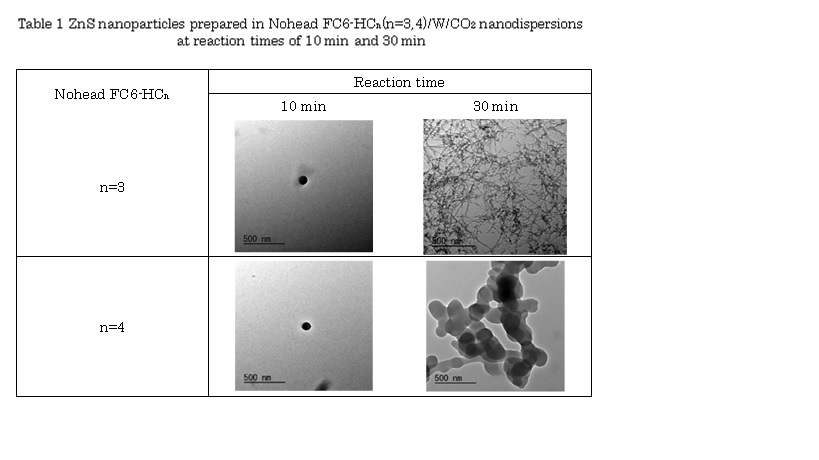
Nowadays, newly discovered drug candidates which are composed of high-molecular weight compounds have very low solubility in water, resulting in poor or erratic bioavailability. The bioavailability can be improved by reducing the particle sizes of drugs. Supercritical antisolvent recrystallization (SAS) using CO2 has been paid much attention as an effective and environmentally friendly particle design method. SAS process produces particles from a liquid solution by the addition of supercritical CO2 that is partially or totally miscible with the liquid solution and that is a non- or anti-solvent for the solutes. However, conventional SAS processes have problems such as a difficulty of production of small and uniform-sized particles because supersaturation heterogeneity of the solutes in a large volume crystallizer leads to a heterogeneity of nucleation rates and crystal growth rates, resulting in the production of large and ununiform-sized particles. Therefore, we proposed a new SAS using a micro device as a crystallizer (SAS-MD) to solve the problems.
In this work, we aim to elucidate the effects of operation parameters including crystallizer temperatures (313.2–323.2 K), crystallizer pressures (10–19 MPa), liquid solution concentrations (4.0–14.3 kg/m3), liquid solution flow rates (2.3×10–6–2×10–5 m3/min) and CO2 flow rates (3.0×10–3–6.0×10–3 m3/min) on the production of microparticles of sulfathiazole by SAS-MD using a Y-type micro device (internal volume: 1.75×10–10 m3). Scanning Electron Microscope (SEM) images of virgin samples and those produced by SAS-MD are shown in Fig. 1. The particles produced were plate-like or spherical particles with mean sizes of around 2 μm which were nearly 1/22 of a mean size of the unprocessed plate-like samples. SAS-MD caused a polymorph transition from a mixture of form II and form IV to form I. Figure 1 shows the mean sizes of particles by SAS-MD were not mostly dependent on crystallizer temperatures.
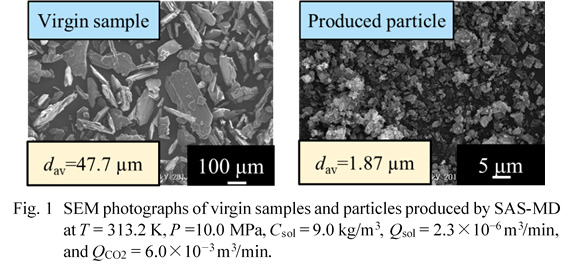
In the pharmaceutical industry, there are great interests in preparation of nanoparticles because particle sizes of drugs are of importance for an enhancement of bioavailability and the application to drug delivery systems (DDS). New process using supercritical fluids have been expected as an effective and environmentally friendly nanoparticle design process. The most well-known micronization technique based on supercritical techniques is the rapid expansion of supercritical solutions (RESS). In the RESS technique, a solute is dissolved in a supercritical fluid, and the solution is then expanded rapidly through an expansion nozzle. Because of the large rapid drop in both pressure and temperature, the solute dissolved becomes insoluble in a low-pressure gas and thus a large degree of supersaturation is created in the spray jet. Rapid nucleation and growth of crystalline particles occur, followed by production of micro- or nano-sized particles due to a very high supersaturation and a very small growth time. We have successfully produced nanoparticles with mean sizes ranging 200 to 700 nm of several drugs including ibuprofen, theophylline, caffeine and phenacetin, and have elucidated effects of several operation parameters in the RESS on the production of the nanoparticles. For practical application of this technique, it is necessary to establish particle design technique.
In this work, we report on a new and simple model to predict mean particle sizes of nanoparticles of several drugs produced by RESS. This model is based on both the mass balance in the RESS process and the classical nucleation theory and has two parameters including supersaturation and a representative temperature which is an average temperature between the temperature at inlet and that at outlet of the crystallization chamber. Figure 1 shows experimental and calculated results of mean particle sizes of theophylline nanoparticles produced by RESS and shows the model give good predicted results.
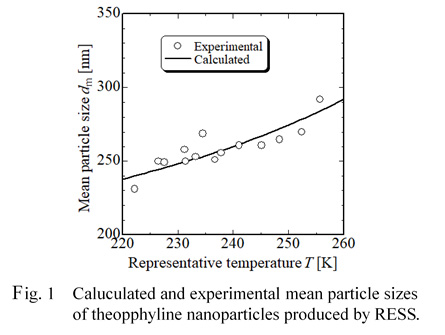
One of the essential thermal heat storage is phase change material which is methyl palmitate in this work because of high latent heat and suitable transition temperature range. However, the major problem is supercooling an undesired property in terms of crystallization during cooling. Moreover, microencapsulation preventing liquid form to leak makes phase change material suffer more. Microencapsulated methyl palmitate was synthesized by sol-gel method using tetraethyl orthosilicate as shell initiator, and spray drying process developed it into powder form. Palmitic acid was used as a nucleating agent. Differential scanning calorimetry (DSC) determined what supercooling degree of microcapsules was, and morphology structure and particle size distribution were characterized using scanning electron microscopy (SEM) and laser particle size distribution analyzer (PSD), respectively. The present study aimed to determine if factors of each production process are associated with microcapsules' supercooling degree. They delved deeply in my research consisted of HCl quantity, sol-gel reaction time, types of emulsifiers, homogenizer speed and duration, nucleating agent quantity, and spray dryer's inlet air temperature. The results showed that increasing HCl quantity didn't significantly affect to the supercooling degree, but made latent heat decrease. As for sol-gel reaction time, the more reaction time spent, the less degree of supercooling happened; on the other hand, the more latent heat had. The positive charge of emulsifiers was better microcapsules properties than negative. Supercooling degree at homogenizer speed of 8000 rpm was lesser than of 6000 and 10000 rpm; nonetheless, latent heat was the lowest of them, and three minutes of homogenization is the best. Furthermore, the supercooling degree was decreased by palmitic acid as a nucleating agent, and at an inlet air temperature of 160 °C, it was appropriate for applying to the spray drying process.
The research on adsorption cooling cycles got momentum after observing the worldwide energy crisis along with the obligation of international protocols which limits the production and utilization of CFCs and HCFCs as refrigerants. This paper presents the synthesis procedure of high grade activated carbons (ACs) derived from biomass precursors, namely waste palm trunk (WPT), and mangrove (M) which are abundantly available in nature. The thermophysical properties and adsorption characteristics of WPT and M activated carbons along with silica gel and metal organic frameworks (MOFs) are presented from the perspective of performance in cooling applications.
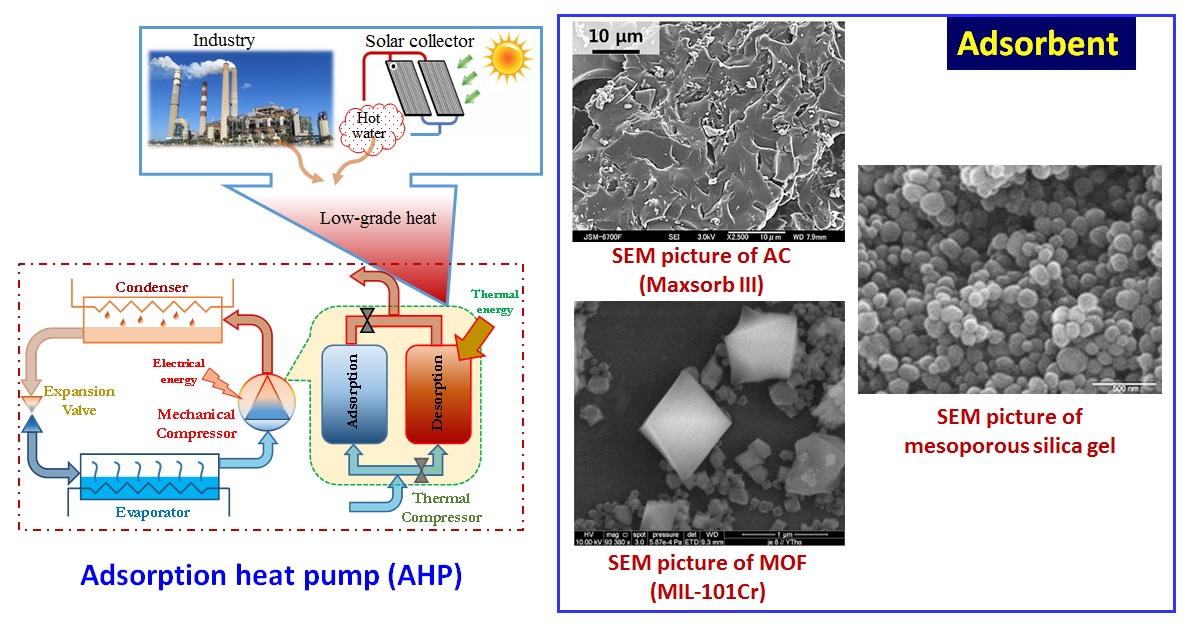
Various thermal energy storage (TES) systems have been studied in an effort to increase energy efficiency. Among these are phase change materials (PCMs) which have the advantage of high energy density from their latent heats. Research developments have progressed so far as to identify fatty acids and their mixtures to be materials that have great potential for this technology – given their chemical stability, non-toxicity, reproducible freezing and melting characteristics, low corrosion activity, and the renewable raw materials from which they are derived. The Capric-Lauric eutectic mixture is a PCM that has been thoroughly studied, and has theoretically been proven to have great potential for TES. The study investigates the thermal energy storage performance of the binary eutectic mixture of fatty acids embedded in gypsum wallboards, and experimentally verifies its viability for actual space cooling application. The small-scale test space unit is found to prolong the maintenance of cool internal temperatures (18 °C - 26 °C) for periods two to three times as long with the incorporation of C-L acid in the wallboards of the unit.
In order to utilize the renewable energy such as waste heat emitted from plant and solar heat more efficiently, compact and high performance heat storage system is one of the bottleneck technologies. Heat storage tank filled with ceramic sensible heat storage body have been used as effective utilization for high temperature waste heat > 500 °C from an industrial furnace such as regenerative burner system. However, the development and design of the heat storage body optimized for the temperature range and the heat storage and release rate is not performed yet. In prevalent ceramic heat storage body such as Al2O3 sphere, there were problems that the inside of Al2O3 sphere was not effectively utilized for heat storage. To solve these problems, we proposed newly non-spherical shell structure made of fine ceramics as effective heat storage body. In this research, one-step fabrication of the tetrapod shell structure ceramics body by slip-casting method was introduced. And the heat storage property was evaluated experimentally using the heat storage tank filled with tetrapod shell structure ceramic body.
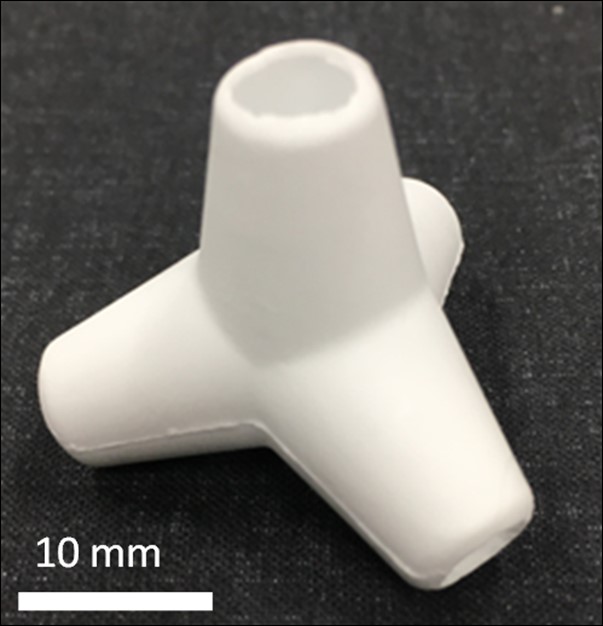
Energy and water access for off-grid islands has been actively studied due to the difficulty of supplying these resources from the main land. In line with Sustainable Development Goals 6 and 7, the feasibility of supplying an off-grid island with renewable energy and water is often studied. Freshwater can be supplied to off-gird islands by purifying surrounding saltwater via desalination. However, recent studies have shown that there are tradeoffs between the production energy and water. In this work, the feasibility of implementing mechanical vapor compression (MVC), multi-effect distillation (MED), multi-stage flash (MSF), electrodialysis (ED), and reverse osmosis (RO) desalination technologies was investigated on an off-grid island with solar PV, diesel, and lithium ion battery storage. The water-energy system was simulated using the Island System LCOEmin Algorithm (ISLA) software, which has been validated with HOMER Pro. Principles in chemical engineering was used by the software to determine the energy consumed by the desalination technologies per unit of water produced. The distribution of energy between generation, storage, and desalination units was determined via energy balance. The optimum configuration was determined by iteratively using different component sizes. The optimum component sizes, levelized cost of electricity (LCOE), levelized cost of water (LCOW), and power flows were analyzed and policy recommendations on desalination implementation were made. PV+Diesel systems produced the lowest LCOE and LCOW, which is ideal because many off-grid islands are transitioning to this setup. Reverse osmosis plants produced the lowest LCOW.
A novel rotating coil-shaped spiral gas-solid contacting device was proposed. The authors propose to make this spiral tube of 180 degree elbows which are commercially produced according industrial standard as piping parts. This device is considered to be suitable for biomass gasification because this enables good contact between volatile matter and solids so that tar can be decomposed over solids. Also external heating through the wall can be carried out with less thermal expansion stress. The solids in the spiral can be mechanically transported with rotation of the spiral, thus sticky material can be handled. Cold models of spiral structure were made by combining 180 degree elbows of half octagonal shape using ID 24 mm transparent plastic tube. A 1.5-cycle model which was driven by hand and a 5-cycle model which was continuously driven by a motor were used. As solid materials, three types of spherical glass beads and two types of spherical silica-gel particles were employed. In addition, one kind of non-spherical plastic pellet was used. The solids transportation rate by volume per rotation was determined to be about 30 cm3 for spherical particles irrespective of particle density, but the rate for non-spherical particles was lower. Solid back-mixing was evaluated by adding a batch of tracer particles with different color at the inlet of the 5-cycle model. The number of tracer particles was counted after taking the samples at the exit of rotating spiral reactor for each rotation. As an index to describe the back-mixing, the probability (p) of particles moving from one unit to the next with one rotation was proposed. The probability was higher than 0.9 for all particles. Average residence time and residence time distribution were derived from the probability.
Figure: Photograph of coil-shaped spiral reactor conveying blue silica-gel particles
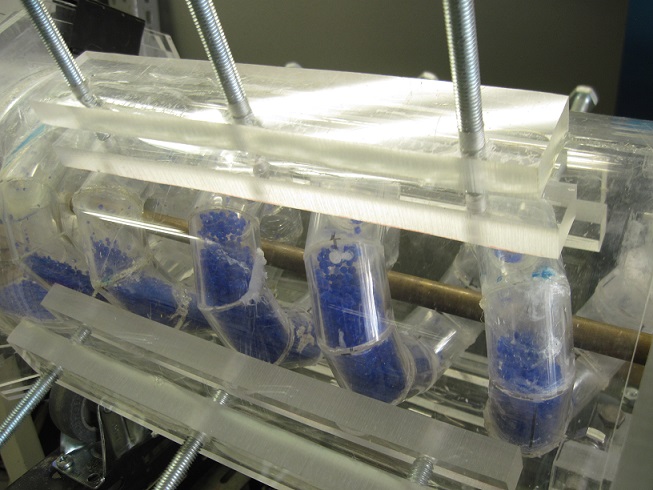
Electrocatalytic hydrogen evolution reaction (HER) is used as a hydrogen production technology from electricity. Although platinum cathode is known to exhibit the highest HER activity at acidic condition, development of alternative cathode materials is expected from the viewpoint of resource constraints. Recently, metallic MoS2 nanosheets have attracted attention as a candidate of the cathode material. However, synthesis of metallic MoS2 is difficult due to its metastable phase and hence only a few of the bottom-up synthesis method has been reported. In this study, we fabricated metallic MoS2 thin film on glassy carbon (GC) substrate for HER cathode by hydrothermal electrodeoisition and conducted the detailed characterization.
To deposit metallic MoS2 thin film on GC, a mixed aqueous solution of (NH4)2MoS4 and KCl as the electrolyte was injected into the specially designed reactor with two electrodes system (cathode GC and anode gold foil). The reaction condition was set to 200 °C and 10 MPa, and a voltage was applied at 1.5 V for 1 minute.
The SEM observation showed an edge-exposed MoS2 thin film. XPS analysis revealed the formation of metallic MoS2 because the binding energy of Mo3d was shifted to the low energy side by about 1 eV. Although a hydrothermal synthesis of metallic MoS2 in a previous report required 12 hours of the reaction time, our synthesis requires only 1 minute-electrolysis. This can be attributed to the electrochemical reaction promotes the reaction to generate MoS2 from MoS3. In order to ascertain HER activity, we carried out linear sweep voltammetry with the three-electrode method (working: fabricated MoS2, counter: Pt and reference: reversible hydrogen electrode). As a result, we obtained high HER activity corresponding to those of the previous report. Particularly, the value of Tafel slope was much lower than that of stable MoS2 semiconductor, also suggesting that metallic MoS2 was synthesized.
Scheelite-monoclinic BiVO4 serving as a photoanode for photoelectrochemical water oxidation is known for its fast electron-hole recombination and slow kinetics, thus limiting its efficiency. In this study, a highly active oxygen evolution reaction catalyst, FeOx, is successfully deposited on BiVO4 by a simple and low energy needed photochemical metal organic deposition (PMOD) process under ambient environment. During the PMOD process, metal organic precursor goes through ligand-to-metal charge transfer, triggered by UV irradiation, and then react with oxygen to form a thin amorphous FeOx catalyst layer. This FeOx coated BiVO4 photoanode boosts the hole injection efficiency to ~100% which is almost triple comparing to the bare BiVO4. Furthermore, with FeOx layer, the onset potential shifts cathodically for about 0.4 V and the photocurrent density at 1.23 V vs. reversible hydrogen electrode (RHE) reaches 1.1 mA/cm2 which is 2.5 times of a bare BiVO4 photoanode. The stability of the photoanode is also improved. The FeOx coated BiVO4 demonstrates a substantial enhancement of the incident photon to current efficiency (IPCE) and the absorbed photon to current efficiency (APCE) due to its ability in increasing the hole injection efficiency and oxygen evolution reaction (OER) kinetics.
At present, thermal power still accounts for more than half of the power generation. Therefore, the shortage of fossil fuel caused by coal combustion and the air pollution caused by carbon dioxide released after combustion are still issues that we should consider. At the same time, study on the use of renewable energy and the hydrogen supply chain had begun to attract international attention. But in China today, there are still relatively few studies on hydrogen power generation, and the efficiency of the hydrogen energy supply chain is still under research and development.In this research, we investigated an energy supply system in China based on compressed hydrogen derived from renewable energy. Here, we will use the existed natural gas pipelines to transport compressed hydrogen. And we will build an energy and excergy flow chart for the hydrogen energy supply chain to calculate the energy efficiency of the energy system.By analyzing the energy and excergy loss of every device in system, the energy efficiency based on the calorific value was 34.5% when the output of renewable energy was set to 100%, the total electrical power efficiency was about 18% and the efficiency of the heat supply was 16.5%.
Hydrogen-bonding solid crystals of methane hydrate have recently gained a great deal of attention as a globally recognized new energy resource for the next generation. Despite its popularity, the phase change processes of methane hydrate are not well understood.
During the decomposition of methane hydrate, long-term stable phenomena occur under temperature and pressure conditions (around 240K) where the material is expected to be inherently unstable. Although a full degradation mechanism has not yet been elucidated, it is hypothesized that super-cooled water suppresses the decomposition reaction [1].
In this study, we observed phase changes in methane hydrate using terahertz wave spectroscopy. Terahertz radiation boasts the material permeability of radio waves and the ease of handling of light. In addition, terahertz waves are strongly absorbed by water, making them especially well-suited for detecting liquid water.
The terahertz time-domain spectroscopic (THz-TDS) system shown in Figure was used to observe phase changes in methane hydrate. This system can simultaneously observe absorption due to the presence of water and phase changes in the methane hydrate material. Experiments were conducted at 210K to 260K while maintaining approximately 3 hours at each temperature.
An increase in absorption and a leftward shift in the time waveform were observed at temperatures greater than 240K, indicating distinct changes in the sample at this temperature. In addition, this temperature coincides with the temperature at which super-cooled water exists, strongly implying an active role of super-cooled water in the phase change activity of methane hydrate.
References
[1] K. Takeya, K. Nango, T. Sugahara, K. Ohgaki, A. Tani J. Phys. Chem. B 109 (2005) 21086
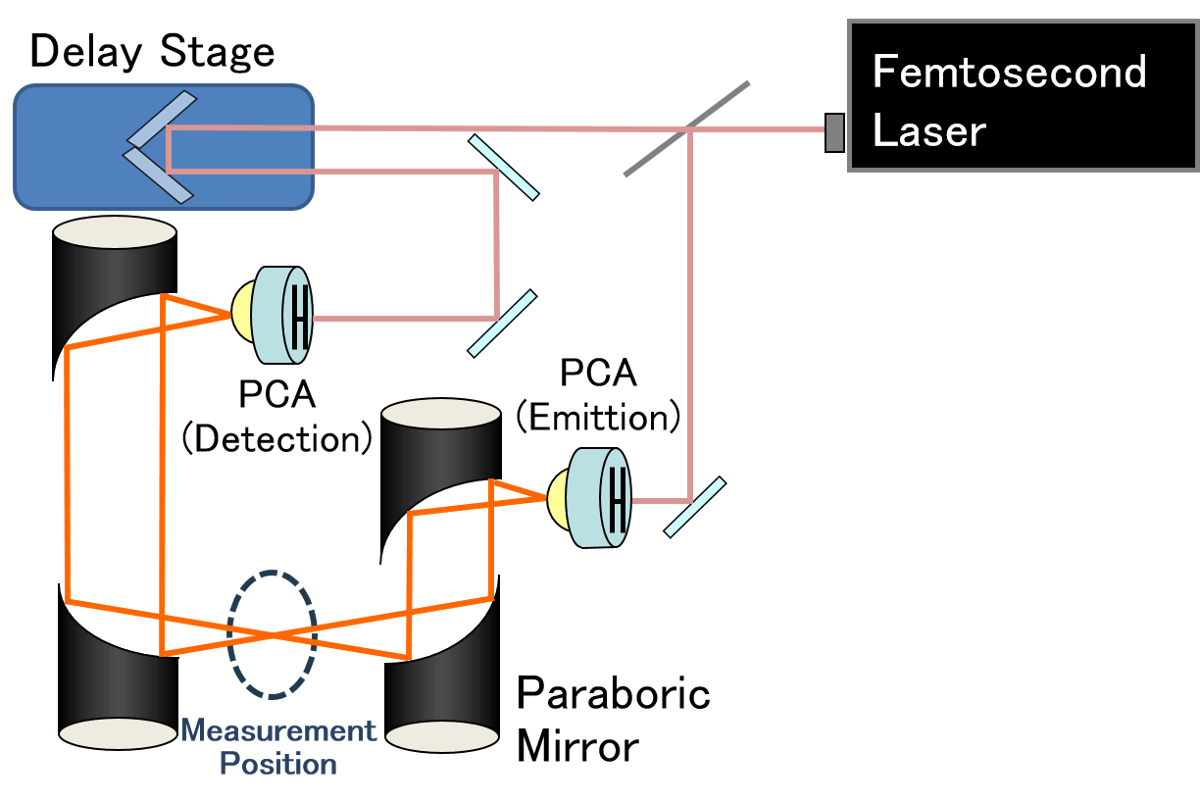
Recently, the replacement of natural gas hydrates using CO2 injection has been considered as a promising natural gas production and CO2 sequestration method. This method differs from thermal stimulation and depressurization technologies in that it is non-destructive and environmentally friendly because natural gas hydrates do not need to be dissociated for production and CO2 is safely stored in the form of gas hydrates. In this study, sI and sH hydrates which were formed with methane and methane + methylcyclopentane (MCP), respectively, were used for replacement using pure CO2. To examine the effect of CO2 injecting pressure on the replacement behavior, the experiment was conducted within pressure conditions where pure CO2 hydrate is thermodynamically stable. To identify replacement efficiency, the compositions of the hydrate phase were measured by gas chromatography (GC) after dissociating the replaced hydrates. In addition, 13C NMR, powder X-ray diffraction (PXRD), and Raman spectroscopy were used to examine the structural information of gas hydrates and the changes in cage occupancy of guest molecules before and after the replacement. For sI hydrate, the replacement efficiency was found to be about 70 %, which was independent of CO2 injecting pressures. It was found from PXRD patterns that cage occupancy of guest molecules after replacement in sI hydrate were almost the same at lower and higher CO2 injecting pressures. However, for sH hydrate, the replacement efficiency was increased up to 80% with increasing the CO2 injecting pressure, which was attributed to a larger portion of a structural transition to sI hydrate at higher CO2 injecting pressure. In addition, time-dependent Raman spectra demonstrated that the structural transition of sH to sI hydrate was more significant at higher CO2 injecting pressure.
CO2 activation is an attractive pathway to utilize CO2 obtained either from large industrial point sources such as heavy industry and power plants, or captured directly from air. CO2 can be activated by reacting it with methane to obtain CO or syngas as a product. An often suggested process to do so is the dry reforming process.
CH4 + CO2 → 2 CO + 2 H2
However, the dry reforming process produces a mixture of CO and H2 and can thus not be operated flexibly to adjust the H2/CO ratio. Furthermore, only one mole of CO2 can be activated per mole of CH4 used. These issues can be addressed by aiming at the production of only CO and water from the same reactants instead.
CH4 + 3 CO2 → 4 CO+2 H2O
A promising implementation of this net reaction is to combine methane cracking and metal oxide redox reactions in a two-reactor moving bed process. In the ideal embodiment of this process, methane is first cracked to solid carbon and hydrogen on an iron substrate in the first reactor. The produced hydrogen is used to reduce an iron oxide material to the aforementioned iron substrate, producing H2O. The iron and the carbon deposited on its surface are then exposed in a second reactor to CO2, yielding a CO/CO2 product gas mixture and regenerating the iron oxide. Here, we report on the gas production and operating parameters of this process in a one-reactor laboratory-scale moving bed, in which this two-reactor concept is emulated.
In this study, we efforted to CCU that converse from CO2 to CO using the reverse cycle chemical looping process. Reaction rate by TGA was calculated, and product gas was analyzed by gas chromatography in FBFR.In addition, oxygen carrier before and after use were analyzed by XRD and SEM, and changes in composition and surface observed. At a reaction temperature of 1123 K or more, it was observed by XRD that the calcium ferrite structure was changed.Forthermore, even if redox reaction were performed multiple cycles, there was no difference in reaction rate in any cycles. At reaction temperature of 1023 K or less, calcium ferrite changes mixure of CaCO3 and Fe3O4. At any tempture, used calcium ferrite surface has been changed to be rough when observed by SEM, so that, surface area is expected to increase.
Two major problems that arise along with economic and population growth in the World are the increase of energy consumption and amount of plastic waste. Recently, crude oil is used as one of energy sources. However, it is not renewable energy. Therefore, alternative renewable energy sources such as plastic waste are needed. Plastic waste is composed of long-chain hydrocarbon compound, so it could to be converted into liquid fuels via catalytic pyrolysis method. Catalytic pyrolysis is the process decomposition of organic materials using catalyst in the absence of oxygen. The plastic waste used in this research is Polypropylene (PP). Fuel generated from PP plastic pyrolysis process, is expected to increase energy supply and reduce the amount of plastic waste in the World, especially in Indonesia. The purpose of this research is to study the catalytic pyrolysis of PP plastic and to refine products of catalytic pyrolysis of PP plastic with distillation methode. And also to study the effect of temperature on the liquid fuels, the effect of adding the catalyst material zeolite on the products of PP plastics pyrolysis and determine physical and chemical properties liquid fuels of pyrolysis products before and after distillation. Pyrolysis is operated at a temperature of 350OC and 450OC during 60 minutes and using natural zeolite catalysts 60 and 100 mesh.
The GC-MS analysis showed that the pyrolysis liquid oils from all samples mainly consisted of hydrocarbon compounds such as C5H12 and C8H16. The produced liquid oils have density, viscosity and high heating values (HHV) of 0.78 - 0.79 g/ml, 2.15 – 2.52 and 10540 – 10650 cal/g respectively, which are similar to conventional gasoline. The liquid oil has potential to be used as an alternative source of energy or fuel production
It is well known that ammonia is produced through a catalytic reaction at high temperature and pressure from pure nitrogen and hydrogen. This catalytic chemical process is a massive and high energy-consuming process, but a very important one for nitrogen fixation.
Here, we show a non-catalyzed one-step synthesis of ammonia from atmospheric air (nitrogen source) and water (hydrogen source), based on an interfacial reaction between the air plasma gas phase and the water phase, at 25 °C and atmospheric pressure. In the plasma/liquid interfacial reaction (P/L reaction), atomic nitrogen, which is produced through electro-discharge, abstracts hydrogen from the H2O molecules on water phase surface at the P/L interface, and then NH is produced without any catalyst. Formed NH is reduced further in the water, affording NH3, which then dissolves in the water phase.
In the presentation, the mechanism of this reaction was considered from the relationship between the quantitative result of atomic nitrogen and the amount of ammonia production by the P/L reaction. In addition, we have obtained results suggesting that the yield of P/L reaction is greatly improved by devising the discharger to produce excited nitrogen more efficiently.
The PL reaction doesn't require hydrogen gas, and the only sources are nitrogen and water. It is a reaction system at normal temperature and normal pressure, and all that is required is electricity. Therefore, it is considered to be suitable for small-scale ammonia water production regardless of the production site.
In this study, pyrolysis of Mongolian three different brown coals was investigated in the fixed bed reactor and fluidized bed reactor. In the fluidized bed reactor, the porous alumina and quartz sand were used as bed material for studying the influence of bed material. Size range of bed materials (quartz sand and alumina) was -250μm +212μm and the gasifier temperature between 600 and 900oC. The main components of the obtained syngas were CO, H2, CH4 and CO2, which were measured by Gas chromatograph. The gas and tar yields were reported in more detail at temperature from 600oC to 900oC. Also, the composition of char was determined at given temperatures.
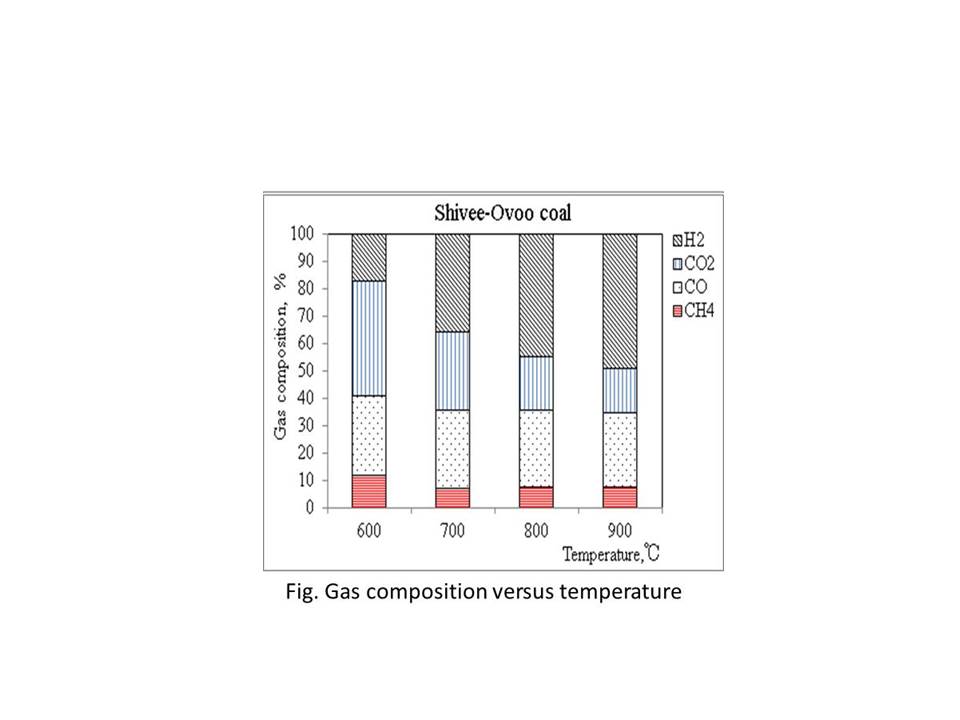
The coal and gas fired power generation are defined as significant power sources, however it is necessary to reduce CO2 emissions from thermal power generation. In this session, I will introduce the development trends and prospects of next-generation thermal power generation technology in Japan.
Spontaneous ignition of coal stockpile is a serious economic and safety problem.
Theorefore, coal oxidation has been received great attention and many studies has been carried out.
Although coal oxidation at actual stock yard proceeds under the condition of low temperature and humid atmosuphere, almost all of previous study has been carried out under the condition of high temperature (>100 °C) or dry atomosphere.
In this study, coal oxidation under the condition of low temperature and humid atmosphere was investigated.
CO and CO2 were the major products and the formation rate of CO2 was larger than that of CO.
The heat generation from coal was also observed and that was followed by the formation of carbon oxides.
Therefore, it was considered that the main factor of heat generation was oxygen absorption which is initial step of coal oxidation.
Heat generation rate under dry atmosphere was almost the same as that under humid atmosphere.
So water would have little influence on heat generation at this condition.
CO formation rate under the dry atmosphere also almost the same as that under humid atmosphere.
On the other hand, CO2 formation rate under the dry atmosphere is much smaller than that under the humid atmosphere.
As a result, water has pronounced effect on CO2 formation reaction.
Coke serves as fuel, reductant and support material to allow continuous flows of gas and liquid in blast furnace of ironmaking industries. Over the last few decades, since the scale and production ability of blast furnace kept increasing, mechanical strength of coke became more and more important. However, when raw coking coal is exposed to air, it would be weathered, which leads the coke made from it can not obtain enough strength to meet the requirement of ironmaking industries. It is necessary to investigate the influence of weathering on the coke strength quantitatively.
Oxidation at relatively low temperature is believed to be one of the main reasons for weathering. In this study the influences of the oxidation level of raw coal at low temperature on the softening and melting ability of raw coal and the mechanical strength of coke were investigated from the viewpoint of oxidation reaction rate.
Since the weathering takes several months, simulated weathered coal was prepared by heating coking coal in air at 120 oC to 150 oC, where oxidation reactions were accelerated, for 5 to 90 minutes. Then coke was prepared from the simulated weathered coal. The coke obtained had less mechanical strength as the treatment temperature and time increased. The heat generation rate in the oxidation reaction at each temperature was measured by differential scanning calorimetry. Reaction rate analysis showed that the oxidation reaction of raw coal could be divided into three parallel first-order reactions (Fig.1). It was found that in the long run, the reaction which has the lowest reaction rate constant had the most significant influence on coke strength (Fig.2).
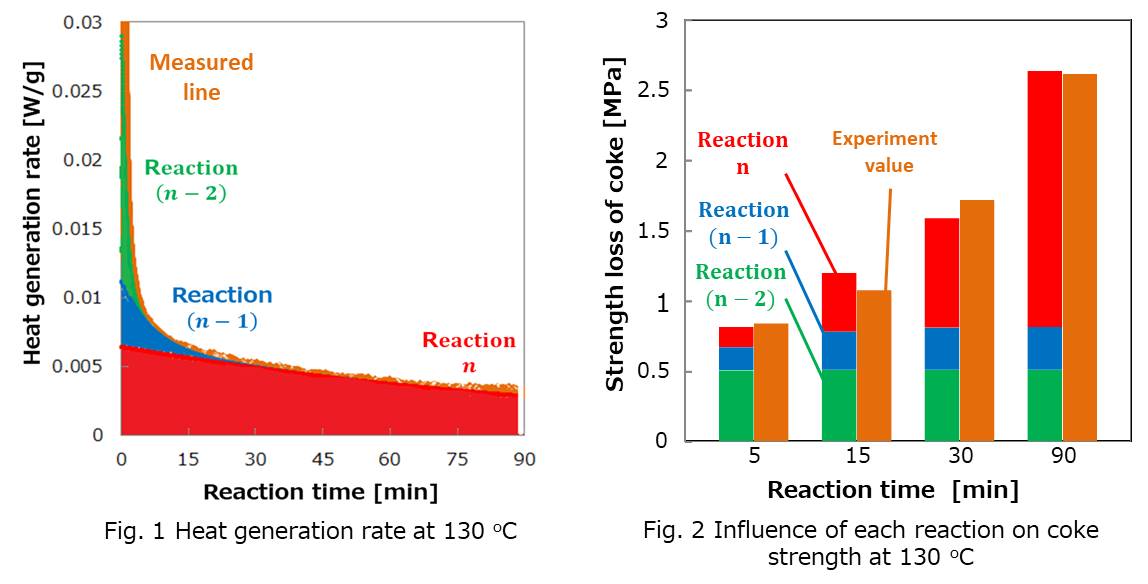
Biomass waste is a renewable source for utilizing to generate energy products, particularly in Thailand, large amounts of biomass wastes are generated every day. Moreover, the torrefied product from biomass wastes is regarded as candidates instead of coal. However, the energy yields of the torrefied product lost so much during torrefaction. Therefore, it is essential to develop a method to increase the energy yield of the torrefied product during the torrefaction of biomass wastes. In this study, Leucaena, which is woody biomass, was pressurised at around 70 MPa at room temperature, called cold press in this work, to prepare biomass pellet. Leucaena was also pre-treated under the mechanical pressure of around 70 MPa at the temperature range of 25oC to around 250oC, called hot press in this work. Then, both cold press and hot press pellet were subjected to torrefaction process at 260, 280 and 300oC. It was found that the char yield of cold press pellet was 20.7 wt%, while the char yield of powder leucaena was only 19.2 wt%. On the other hand, the char yield of the hot press was surprisingly increased to 28.1 wt%. The energy yield of the hot press pellet torrefied at 300 oC was as high as 96.7%, while the energy yield of the cold press and powder leucaena were 89.1% and 89.5%, respectively. From the detail analyses of gas formation during the pyrolysis in TGA, it was found that the dehydration reaction was accelerated by hot press carbonization and the mechanical pressure suppresses the evolution of tar components. Therefore, the mechanical pressure is judged to be effective to increase the energy yield through the torrefaction of biomass.
Biomass waste is a renewable sources and its effective utilization is indispensable, particularly in Thailand, where massive amounts of biomass wastes are generated. Moreover, charcoal from biomass wastes is regarded as candidates for low priced raw materials for activated carbons. However, the yield of charcoal from biomass wastes is low in general. So, it is essential to develop a method to increase the yield of charcoal. In this study, Leucaena, which is a woody biomass, was pressurized at around 500 MPa at room temperature, called cold press in this work, to prepare biomass pellet. Leucaena was torrefied under the mechanical pressure of around 10 MPa at the temperature range of 25 °C to around 250 °C, called hot press in this work. Moreover, Leucaena was also torrfied under gas pressure at 250 °C in a tube-bomb reactor, and was called gas pressure sample in this study. Then, the cold press pellet, hot press pellet, and gas pressure sample were subjected to carbonization at around 900 °C by using a TGA. It was found that the char at 900 °C yield of the cold press pellet was 20.7 wt%, while the char yield of powder leucaena was only 19.2 wt%. On the other hand, the char yield of the hot press pellet was surprisingly increased to 28.1 wt%. The char yield at 900 °C of the gas pressure sample was increased to 23.1 wt%. From the detail analyses of gas formation during the carbonization, it was found that the dehydration reaction was accelerated by torrefaction under mechanical pressure and the mechanical pressure suppresses the evolution of tar components. Therefore, the mechanical pressure is judged to be effective to increase the char yield through the carbonization of biomass.
I. Introduction
Carbon neutral bio-oil is needed to replace liquid fossil fuels in order to reduce CO2 emissions and global warming. However, bio-oil produced by pyrolysis of biomass has a high oxygen content (e.g.sugars), low energy density, and is also expensive to produce. Based on previous research results it was shown that inexpensive Ni, Fe catalyst clusters can improve the quantity or quality of bio-oil produced from the biomass, but to our knowledge, very few studies have actually investigated the mixing cellulose (biomass model compound) and catalyst directly together followed by pyrolysis to produce bio-oil. In this study, Ni2Fe3 catalyst was mixed with cellulose in five different ratios in a pyrolysis batch reactor to investigate its impact on the bio-oil yield and sugar content.
Experiment
The catalyst was prepared by sol-gel method and heat-treated in flowing H2/N2 gas. Pyrolysis experiments were conducted using a fixed bed reactor, flowing 100ml/min N2 gas, at 450 °C with five different catalyst/cellulose ratios, where cellulose mass was fixed at 4g, with the addition of catalyst of 1g, 2g, 4g, 8g, and 16g.
II. Results & Discussion
In Figure 1, bio-oil yield and sugar concentration measured by GC-MC is plotted versus cellulose/catalyst ratios, the yield increase as the catalyst is added initially and then decrease. The sugar content decreased initially as the catalyst is added and then increased slightly. The reason is that when the cellulose ratio is low, the metal catalyst can help transfer heat uniformly and provide sufficient reactive surface (figure inset). However, when the catalyst ratio is high, the catalyst has little physical contact with the cellulose, which auto-aggregates at high temperature. A high catalyst ratio not only decreases the yield of bio-oil but influences the overall catalyst acitivity. Research work is continuing on evaluating the catalyst reusability.
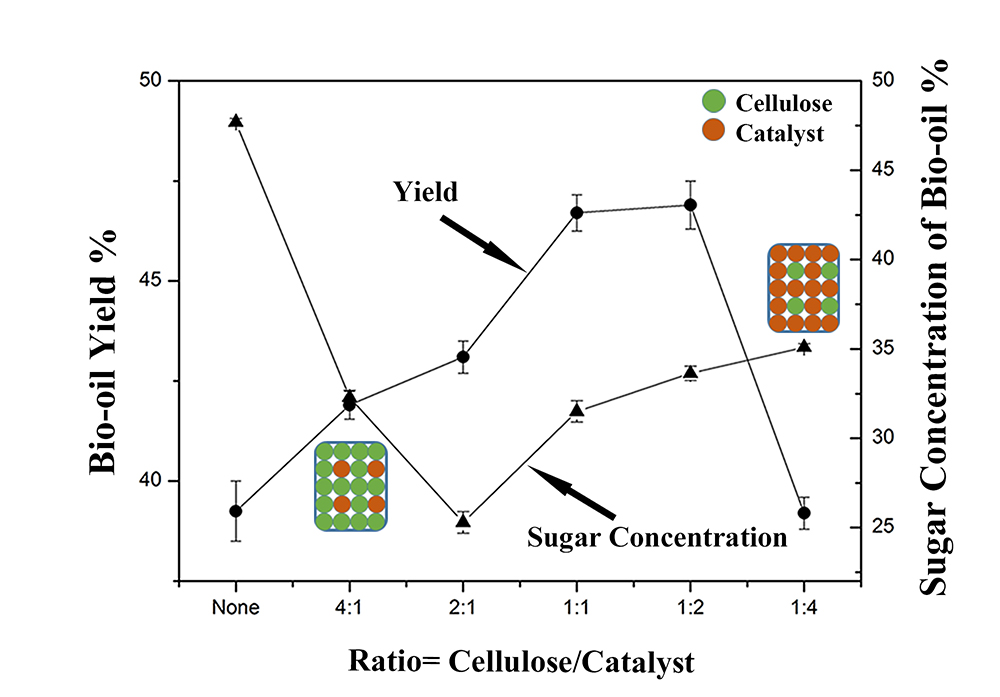
Recently, many biomass gasification plants are operated as local power plants. However, the management relies on FIT because the energy is the cheapest product. To establish the economically reasonable technology for biomass conversion, it is required to develop a new scheme for producing valuable chemicals selectively with simple operation. To realize it, we propose a multi-stage pyrolysis with instant selective separation scheme. Utilizing the difference in the decomposition temperatures of main biomass three components, hemi-cellulose, cellulose, and lignin, biomass was pyrolyzed sequentially at three step optimal temperatures for recovering volatiles selectively in vapour phase. Thus produced volatiles, which contained saccharides derivatives, were further converted into valuable chemicals by installed second higher-temperature zone in each stage pyrolyzer. In this study, the effective pyrolysis conditions for the selective valuable chemicals production were examined using pulverised cypress to clarify the validity of proposed method.
As the first step, pyrolysis was conducted at 300 °C for the selective decomposition of hemicellulose into saccharides derivative volatile. Thus produced volatile was immediately heated up to 650 °C, and furan was selectively obtained at the yield of 0.623 g/g-(hemicellulose in biomass). As the second step, the obtained char was subsequently pyrolyzed at 370 °C. Through the second-step pyrolysis, cellulose was selectively decomposed and the anhydrosugar of levoglucosan was obtained as the product. The second-step pyrolysis avoided lignin decomposition, which resulted in avoiding undesirable heavy tar production. The remaining solid product, char, in the second step pyrolysis can be used high calorific carbon materials for power plant. Thus, the validity of the proposed scheme for selective co-production of valuable chemicals and energy was clarified.
<Gasification is known as one of the most promising processes for utilization of coal and biomass, e.g. for production of fuels and chemicals. During the gasification, besides gases, a number of volatile hydrocarbons are discharged together with tar. Tar is a complex mixture of components, typically poly-aromatic. How to deal with the viscous tar is one of the major issues in the biomass/coal gasification process since it can cause quite a few problems in the different applications.
A large number of catalysts have been researched to eliminate tar in gas products. The two most catalysts are Ni-based catalysts and dolomites. When Ni-based catalysts are used, tar concentration in the product gas can be reduced significantly by means of reforming but quite rapid catalyst deactivation (both by coke fouling on Ni catalyst surface and by sintering). Dolomite, a kind of inexpensive and abundant natural mineral, is very attractive as a tar cracking catalyst and it was found to be effective on coking resistance during tar steam reforming.
In this study, tar was treated in a two-step reactor, where catalyst sample was filled in the secondary step. Tar gasification using calcined dolomite was discussed at different temperatures and various introduction gases. The combined use of dolomite and nickel-based catalyst was also compared. Gas yield and carbon deposit formations were determined. Additionally, changes of the catalyst pore feature, surface area were analyzed.>
Microalgal biofuel was produced by a continuous hydrothermal liquefaction (HTL) of native microalgae using a bench-scale tubular reactor. Native microalgae cultivated and harvested with high biomass productivity (> 29 g/m2/day) in a cool temperate zone (Minamisoma, Fukushima, Japan) were used. The lipid content of harvested native microalgae was 5.0 – 16.9 wt%. The usage of native microalgae as a biomass offers benefits in terms of stable culture and productivity with easy maintenance. The slurry of native algae was continuously injected to a bench-scale tubular reactor by high-pressure pumps, and then gradually heated up to the reaction temperature through preheating tube, resulting in the production of biocrude. Produced biocrude was collected, and then the bio-oil was extracted from the biocrude using organic solvents. Both biocrude and bio-oil products as microalgal biofuel were characterized by a thermogravimetric analysis. Among the examined conditions, HTL processing at algal biomass concentration of 19.4 wt% at 350 °C showed reasonable biocrude yield and highest bio-oil yield (8.6 % by hexane, 24.9 % by chloroform-methanol mixture). Bio-oil products obtained at this condition were composed more of light oils substances compared to heavy oils, useful regarding biofuel production. Thermogravimetric analysis showed that some of the heavy oil components in microalgal biomass was converted into the light oil substances. Thus, native microalgae could be successfully converted to biofuel by HTL processing using a continuous bench-scale tubular reactor.
Supercritical water gasification is gasification of biomass in hot compressed water. It is suitable for wet biomass treatment because it uses water as reaction medium and does not require costly and energy consuming drying pretreatment. Because of the high temperature, water is very reactive, and almost complete gasification is possible. However, it cannot be free from tarry material production. Detail study on tarry material production showed that tarry material can be produced by both ionic and radical reactions. To suppress ion tar, rapid heating up of feedstock was found to be effective. To suppress radical tar, radical scavenger addition was found to be effective. In this study, food processing waste was processed in continuous supercritical water gasification experimentally. The result of the operation is presented. This study was supported by NEDO.
The Philippines being an agricultural country generates bio-based residues that can be utilized as low-cost fuel for biomass plants to generate electricity. The aim of this study is to assess the amount of bio-based residues together with their theoretical bio-energy potential (BEP) on each of the regions of the Philippines. The residues considered include agricultural and agro-industrial residues, animal by-products, woody biomass and marine biomass residues. Considering the limitations in the recovery these residues and the technological limitations on existing direct combustion power generation facilities, their available and recoverable bio-energy potentials are also estimated, respectively. According to the estimate, biomass residues have a theoretical bio-energy potential ~660 PJ/yr with majority contributed by agricultural and agro-industrial residues (~66%). While approximately half of this potential is available for recovery, only ~74 PJ/yr (3,300 MW) can be possibly harnessed as electrical power considering the efficiencies of co-generation plants. This potential, of which 6% is already harnessed, could possibly contribute to 15% of the current national power generation capacity and can potentially displace 15 million tons (Mt) of coal annually. Western and Central Visayas have the highest recoverable BEP among 17 regions with 14.2 and 11.3 PJ/yr, respectively.
Mesoporous sulfur host consisting of tungsten disulfide (WS2) and carbon nanosheets has been synthesized in situ by using sodium chloride (NaCl) particles as the template. Two-dimensional architecture of WS2/C composite provided large specific surface area (643 m2g-1) and facilitated the rapid diffusion of lithium-ions during cycling of lithium sulfur batteries. The WS2/C porous nanosheets served dual function by providing physical barrier and strong chemical affinity to restrict the shuttling of intermediate lithium polysulfides. The sulfur rich cathode showed an excellent cycling performance by maintaining low capacity decay rate of 0.048% per cycle for 1000 cycles at 1C rate (1C=1675 mAh g-1). Moreover, it revealed an impressive rate performance by delivering high specific discharge capacity of 419 mAh g-1 at 8C after 500 cycles (80% capacity retention). At high areal loading of sulfur, 4.7 mg cm-2, were the battery delivered a high areal capacity of 3.4 mAh cm-2 after 100 cycles at 0.5C rate. Self-discharge analysis was also carried out to investigate the effect of polysulfide shuttling while the batteries were rested. It greatly suppressed self-discharge capacity loss by maintaining 94.5% of its initial capacity after 10 days of resting. The electrochemical impedance spectroscopy (EIS) analysis illustrated that even after 400 cycles, the interfacial and charge transfer resistance only increased by 1.2 and 1.7 Ω, respectively, explaining faster electrochemical kinetics and inhibiting the formation of insulating layer of lithium sulfide (Li2S) on the surface of the electrodes. The facile synthesis procedure of porous WS2/C nanosheets and its superior electrochemical performance as a host provide valuable options to engineer practical sulfur cathode for high performance lithium sulfur batteries.
Acknowledgement: Financial support provided by Hong Kong Research Grant Council, National Natural Science Foundation, China (NSFC, N_PolyU601/16) and the Hong Kong Polytechnic University (1-ZE30).
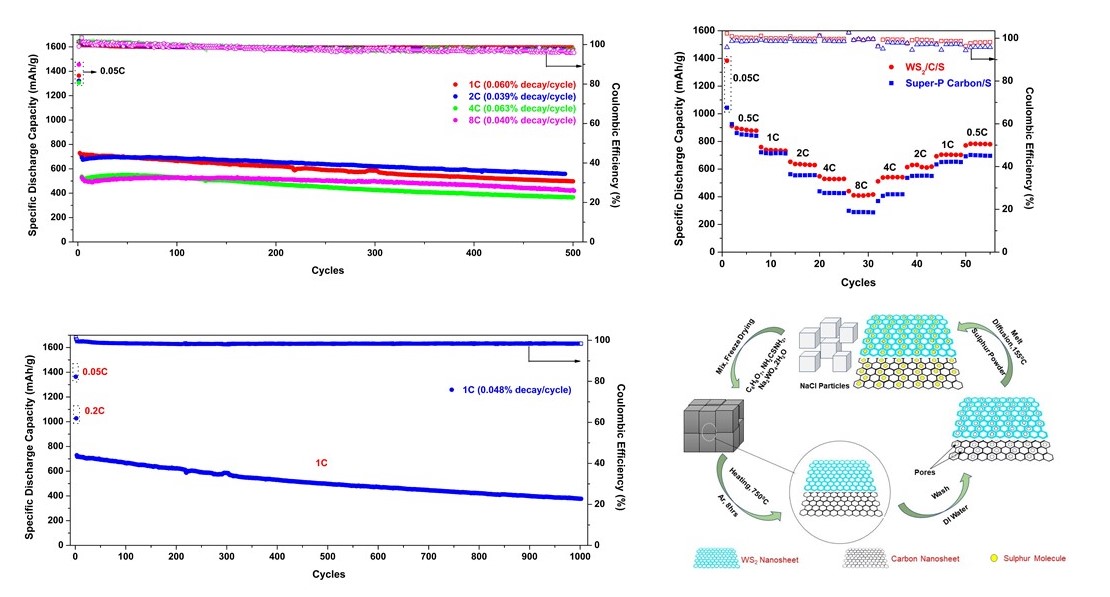
Oxygen reduction reaction (ORR) is the most demanding process in the commercialization of fuel cell. To replace expensive rare earth metals in electrocatalyst, carbonized metal-organic frameworks became an emerging candidate. Zeolitic imidazolate frameworks (ZIFs), a sub-class of MOFs, is a hybrid crystalline material consisting of metal nodes and organic linkers. It has a big advantage on easy production and high specific surface area. If the ZIFs are synthesized in hollow structure, they have notable advantage to reduce the mass transfer resistance. However, the conventional synthesis method to make hollow structure requires multi-steps in small-scale. In this work, Co-N-C hollow-spheres were prepared from CoZn-ZIFs hollow-sphere in a facile method. Co/ZnO was prepared in a spherical form by ultrasonic spray pyrolysis, which has a big advantage in mass production. Then, it was converted into CoZn-ZIFs in ligand solution with simple stirring, followed by the carbonization to Co-NC hollow-sphere. The ORR activity for the final product was tested and it showed outstanding performance comparing to the materials in the literatures.
Annual production of crude steel reached 1.8 billion tons in 2018, and is projected to grow further. A major portion of iron is currently produced from iron ore in blast furnace. Because it uses coal as fuel and reductant, significant amount of CO2 is produced along with the steel. Therefore, iron and steel industry is considered to be in a category of "difficult to eliminate emissions". The blast furnace of Japan, the second biggest steel-making country, is the world-leading clean process. Nevertheless, CO2 emission from iron and steel industry accounts for nearly 15% of the total domestic CO2 emission. In view of global concern on the earth's warming, alternative green approaches must be introduced for the iron-making. To address this issue, herein a new concept for iron-making process is proposed. The iron ore reduction process is consisted of three steps: dissolution of iron ore using organic acids, photochemical reaction of the dissolved iron complex for the reduction and recovery as solid, and then pyrolytic recovery of iron under reductive atmosphere. The reactions in each step occur at temperatures much lower than that of conventional process. Although CO2 is formed at the reduction process, if it is recovered, converted to organic acids, and recycled to the process, the stoichiometry of overall process can be written without carbon. In other words, the process has a potential to be net-zero emission. The present study explains details of chemistry involved in the process, and discuss current status of technologies for key reactions with information from past studies to find technical barriers and challenges. Moreover, the iron-making process (iron ore reduction part) is experimentally demonstrated in a diluted reaction system.
Evolution profiles of Hg during sintering was investigated with flow-type fixed bed reactor at 10 °C/min up to 950 °C in air. Five types of iron ores were used in this study, and Hg contents ranged from 60 to 180 ppbw. Hg content depended on the iron ore types, and there was no correlation between Hg content and composition of iron ores. Hg released from iron ores as a Hgo and Hg2+ during the sintering, and mass balance ranged within 100±10%. Proportion of total gaseous-Hg and remained-Hg in solid after sintering were 20-70% and 30-70%, respectively. Hg evolution started beyond 100 °C and continued until 950 °C. Main and shoulder peaks of Hg evolution profiles were observed at 150-250, 300-400, 450-550, 500-700 and 700-900 °C, and the evolution profiles depended on the iron ore types. The temperature-programmed-desorption (TPD) experiments of physical mixtures of Hg compounds (HgCl, HgCl2, HgO, HgS and HgSO4) and Fe2O3 were carried out to investigate Hg form in iron ore under above-mentioned conditions. When pure Hg compounds were heated in air, the main peaks of Hg evolution profile were observed at 140-715 °C. However, Fe2O3 and HgCl2, HgCl, HgS, HgO or HgSO4 mixture showed the Hg evolution profile having the main peaks at 150, 165, 390, 510 or 565 °C, respectively. With the mixture samples, all peaks shifted to the low temperature compared with those of pure Hg compounds, and new peaks appeared at 347 or 434 °C for the mixture of Fe2O3 and HgCl or HgCl2. This result shows the occurrence of interactions between Hg compounds and Fe2O3 during sintering of the mixture. Therefore, Hg evolution below 600 °C may occur from HgCl2, HgS, HgO, and HgSO4 in iron ores.
Coal pulverization is essential for coal combustion systems due to leading to enhance the efficiency of coal combustion. Coal consists of components as macerals and minerals, so that coal particles generated by pulverization have different grindability. The difference of grindability between the coal particles generated results in the difficulty of predicting the performance of coal pulverizer. Generally, the grindability of coal is evaluated by a Hardgrove grindability index referred to as HGI. The problem of HGI is to assume a uniform particle and evaluate an initial stage in a grinding process. Therefore, a semi-continuous test by an HGI test equipment were conducted. Based on the semi-continuous test, grinding rate constant distribution was derived from a multicomponent consecutive grinding model. The grinding rate constant distributions of high ash coal and low ash coal having approximately same HGI showed to be different. The grinding rate constant distribution of coal provided grinding information in detail.
In this study, pyrolysis characteristics of Mongolian brown coals were investigated in a fluidized bed reactor under a nitrogen atmosphere at temperature up to 1173 K. 1) The porous alumina and quartz sand were used as bed material for investigating the influence of bed material on the products yield. 2) The effect of the temperature on the properties of pyrolysis products (gas and char) was characterized.
The results have shown that the pyrolysis temperature affects significantly the product yield and distribution. With the increase of the pyrolysis temperature, the char yield decreases and the gas yield increases. Elemental composition of formed chars is similar with high rank coals at higher temperatures. Molar ratios of oxygen and hydrogen to carbon were analyzed with a coalification diagram.
In this work, activated carbons (ACK and ACMn) were developed from bamboo powder by pyrolysis carbonization and KOH or KMnO4 activation process using one-step strategy. N2 adsorption-desorption, X-ray diffraction (XRD), scanning electron microscopy (SEM) and transmission electron microscopy (TEM) were used to investigate the characteristics of the produced activated carbons. The electrochemical performance of the activated carbons as electrode materials for supercapacitors were studied by electrochemical measurements. The as-prepared ACK and ACMn samples using KOH and KMnO4 respectively possessed a porous structure with a large specific surface area of 930 and 915 m2/g and abundant micropores. However, the ACMn sample has more mesopores and macropores than the ACK has. Further electrochemical measurements revealed that the ACMn electrode exhibited a specific capacitance of 75.0 F/g at a potential sweeping rate of 0.05 V/s, which was higher than that of the ACK electrode (35.0 F/g). Moreover, it was observed that when the potential sweeping rate was increased, the capacitance of both ACK and ACMn electrode tends to decrease, but the decreasing rate by ACK was more severe than ACMn. This is considered that the KMnO4 activation process of the bamboo powder resulted in the enhancement of the meso-macro structure, and improved the storage capacity and transport behavior. This one-step strategy using bamboo powder and KMnO4 activation process can be highly expected to achieve low cost, green and industrial-grade production of renewable biomass-derived carbon materials for advanced energy storage applications in the future.
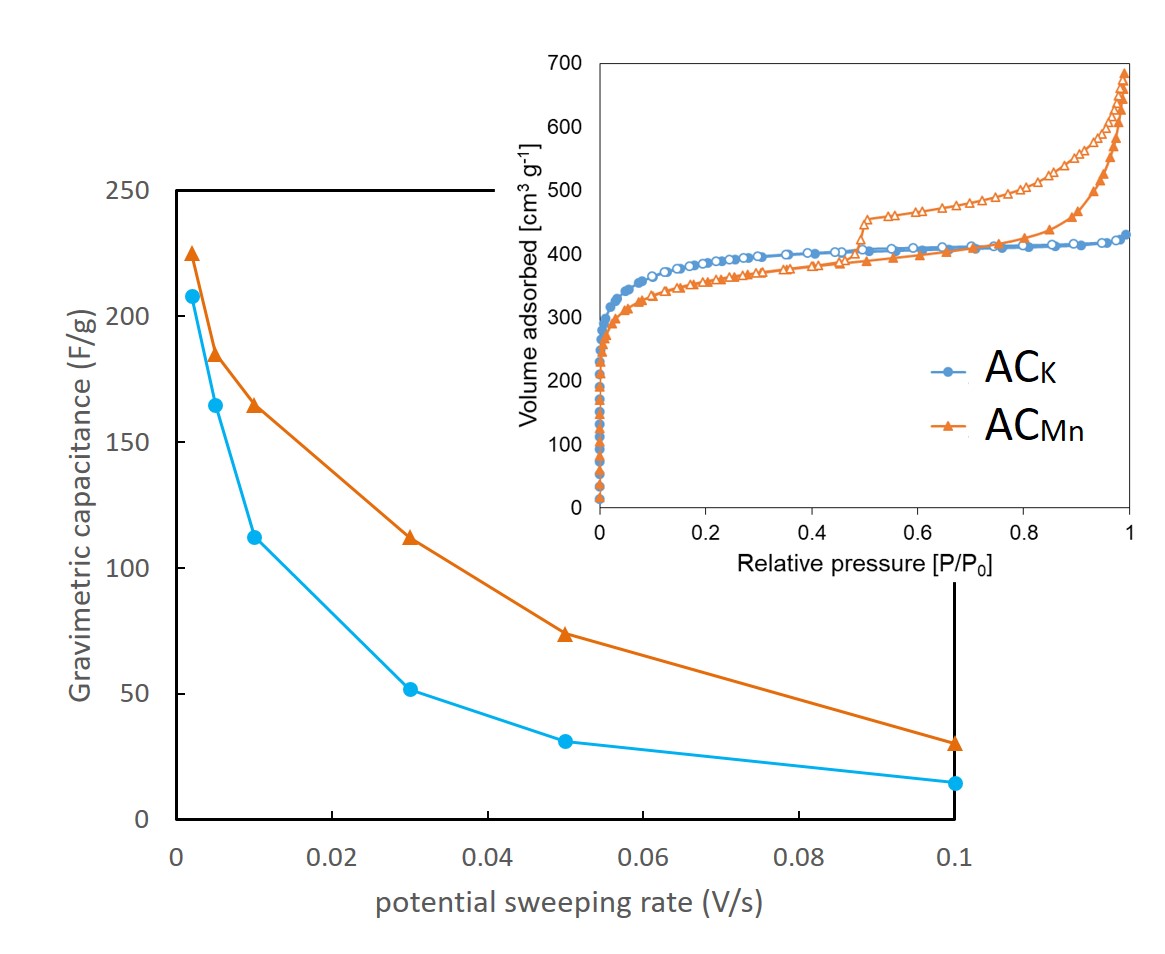
Torrefaction is a thermal pretreatment method at relative low temperature range of 200 – 300 °C in an inert atmosphere, which aims to increase the energy density and to decrease the grinding energy of biomass. In this study, the torrefaction of two types of wood pellets, which are rubber wood pellet and leucaena pellet, was carried out in the temperature range of 260 – 300 °C for 30 min residence time. The products yield, its compositions and fuel properties at various torrefaction temperatures were also determined. The increase in temperature from 260 to 300 °C reduced the torrefied pellet yield from 87.4 % to 63.5 % for rubber wood pellet. The heating value (21.4 MJ/kg) and the volumetric energy density (17.5 GJ/m3) of torrefied pellets at 300 °C were comparable to that of coal. The increase in torrefaction temperature also improved the hydrophobicity (resistance to water uptake). Moreover, the combustion behavior of torrefied pellets show some improvement compare to raw pellets. These results showed that the torrefaction of wood pellets (TAP process) is a potential pathway to produce energy-dense pellets as a tradable solid biofuel to replace coal.
There are energy issues such as carbon dioxide emissions and depletion of fossil fuel, energy supply not depending on fossil fuel would be required. So increasing of biomass and waste biomass using for energy would be able to solve in these problems. There is carbonization of sewage sludge as one of methods of waste biomass using. And in the case of carbonizing sludge with mixing coal, high quality fuel better than sludge could be manufactured. Char manufactured from both materials is called co-char in this paper. In this study, gasification rate of co-char was measured, and effect of co-carbonization of both materials on co-char reactivity was evaluated by comparing reactivity between co-char and single char made from a material. In the experiment, char was heated up in reactive gas agent flow, weight loss by reacting char and gas was measured by thermo-balance. As a result, weight loss rate in gasification of char was low speed with increasing coal ratio in co-char. In arrhenius plot calculated from gasification model, activation energy of coal char (coal ratio in co-char is 100 %) was largest, and activation energy of sludge char (coal ratio in co-char is 0 %) was lowest. And activation energy of co-char was in ranging between coal char's value and sludge char's value. On the other hand, graphite structure of co-char was developed with increasing coal ratio from measurement of raman spectrum. So, carbon structure in co-char was different in every coal ratio, it was considered changing of carbon structure affected reactivity of co-char in gasification.
Biomass have been attracting much attention as a renewable and sustainable energy resource to substitute fossil fuels. Thermochemical treatments of biomass such as pyrolysis and gasification are general technologies to utilize biomass energy. However, these technologies have the common problem of the high temperature required for the reaction, which results in a low energy efficiency. Therefore, a method for reducing the activation energy of the biomass pyrolysis reaction and promoting the reaction at a low temperature is needed. One effective method is the use of catalyst. Although a lot of researches have been dedicated to develop efficient catalysts, this study focuses on various kinds of non-precious metal oxide catalysts including semiconductor and non-semiconductor materials. Then, the purpose of this study is to clarify the influence of such metal oxide catalysts on pyrolysis behavior of woody biomass.
The pyrolysis behavior of a rectangular piece of cypress coated with different kinds of metal oxide particles was investigated on a hot plate in a room air. Al2O3, Cr2O3, Fe2O3 and TiO2 were tested. A sample without coating of any metal oxide was also used. As shown in Fig. 1, the sample pieces coated with Al2O3 and without catalyst coating were slowly carbonized with increasing the hot plate temperature, and finally charcoal remained at 500 °C. On the other hand, the sample pieces coated with Cr2O3, Fe2O3 and TiO2 began to glow red from the edge when the plate temperature exceeded around 300 °C, and then the glowing spread throughout the sample and the decomposition was rapidly completed. Only ash and the metal oxide particles remained at the end. The results suggest that semiconductor metal oxides have an effect of promoting biomass pyrolysis in the oxidizing atmosphere.
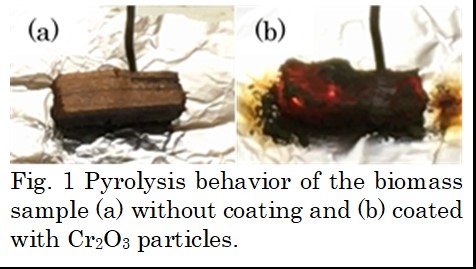
Although biomass has been attracting much attention as a sustainable energy resource, the biomass has the problems such as high moisture content and high transportation cost due to its low density. Then, we focused on carbonization as a pretreatment to solve these problems. Carbonization of biomass, however, reduces the yield and density by losing much mass and energy as tar. To overcome these drawbacks, this study proposes to increase the yield by tar recovery with the produced char during carbonization, and to densify the tar-containing char by compression molding.
A cylindrical piece of Japanese cypress was placed in the quartz glass tube installed in two tubular furnaces aligned vertically. The char particles, which were produced from the same biomass piece under the same condition in advance, were packed to form a layer for tar recovery around the boundary between the two furnaces above the biomass sample. The biomass sample was heated at 300-400 °C in the nitrogen flow and the generated tar was recovered by the packed char particles. After heating for 30 mins, the carbonization and tar recovery yields were calculated from the mass changes of the biomass sample and the packed char particles, respectively. The carbon contents and calorific values of the biomass sample, the produced char and the tar-containing char were measured to estimate the carbon and energy yields. Also, the tar-containing char was compressed in a mold to densify it.
The tar-containing char obtained at 350 °C carbonization had a high calorific value of 27.0 MJ/kg and a carbon content of 68.5 %. Both the energy and carbon yields exceeded 70%. The char particles were pelletized with the adsorbed tar as a binder by the compression molding. The density was 1 g/cm3 or more, which is about three times that of the raw biomass.
Background
Polyurethane (PU) was originally synthetized by Otto Bayer in 1937 in Germany. Usages of them cause significantly environmental impacts. This material is very stable on a lot of different applications, such as, transportation, packaging, footwear, paint, and insulation component for refrigerators and buildings. In 2016, approximately 18 million tons of PU will be produced and 3/4 of them were in foam format. Asian countries used most of them.
Methods
A new study on biomass-polyurethane co-gasification for syngas production was performed. The feed stock blending ratio, equivalent ratio (ER), steam to biomass ratio (SB), catalyst, and CO2 blending ratio were the key experimental design parameters and the experimental design was performe by the Taguchi L18 orthogonal array. The gasification temperature was set to be 800 °C of all experiments. The reaction was performed at a continuous feed fluidized bed gasifier. The conversion of carbon in the feed, yield of various products, and the low heating values of the effluent gas was analyzed.
Results
With the presence of the polyurethane and CO2 blending in the feed stream, the yield of the syn gas and the heating value of the effluent gas were increased. The carbon conversion of the feed was increased presence of the catalyst blended in the feed. This study suggested potential route for the energy production by blending the agriculture and municipal waste in the future.
Acknowledgement
Financial support: Ministry of Science and Technology in Taiwan, ROC (MOST 107-2218-E-035-017).
Rapid heat transfer in molten metal could potentially enhance biomass decomposition, and combining this with Ni-catalyst could also promote hydrogenation reactions. We have already indicated the effectiveness of Sn-Bi molten metal and its combination with Ni/Al2O3 for the gasification of biomass [1]. The aim of this work was to investigate the effects of these media with respect to bio-oil production. Aspen wood pyrolysis was performed at 500 °C at high heating rate in the molten metal medium (MM) and molten metal with catalyst medium (MM-Ni). Pyrolysis in the inert argon atmosphere (AR) was conducted as the control case. In addition, hydrogen injection was studied for hydro-deoxygenation of pyrolysis vapors. The results shown in Fig. 1 demonstrate that the biomass pyrolysis in the proposed media increased the yield of liquid products and reduced the char formation, thus improving carbon conversion efficiency. Fast heating rate in the media promoted the cracking of large molecules, which resulted in the production of the bio-oil having lower average molecular weight. Ni-catalyst aided dehydration, decarboxylation, and hydrogenation reactions, thereby increasing the hydrocarbon yields. Hydrogen injection further upgraded the bio-oil by successful oxygen removal and hydrogenation of unsaturated bonds. The proposed media were thus effective for the production of a higher grade bio-oil from lignocellulosic biomass.
[1] A. Arenova et al. J. Anal. Appl. Pyrolysis., 137, 61-69 (2019).
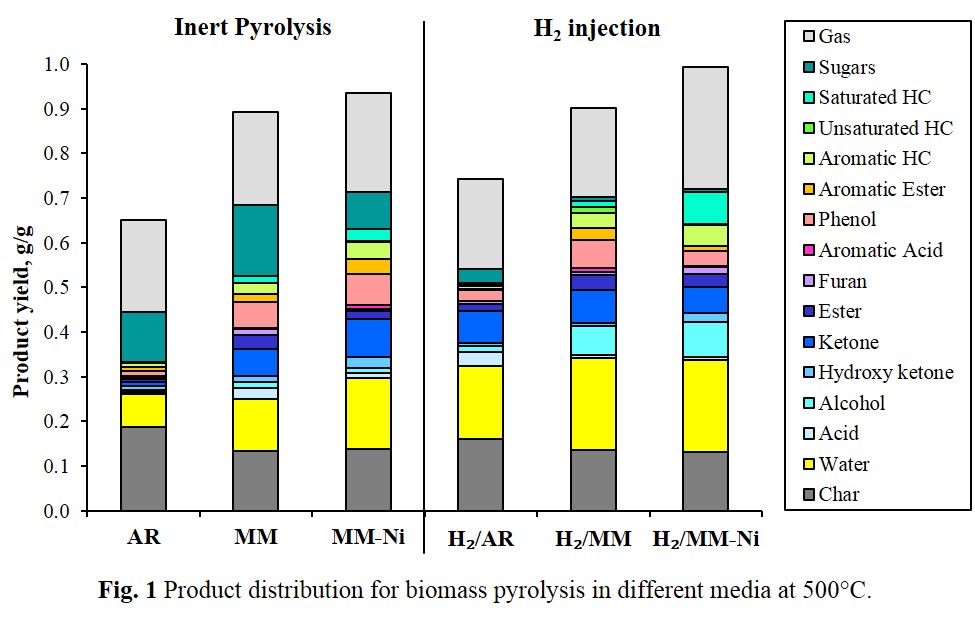
This study investigated the optimal reaction conditions for biodiesel production from soursop (Annona muricata) seeds. A high oil yield of 29.6% (w/w) could be obtained from soursop seeds. Oil extracted from soursop seeds was then converted into biodiesel through two-step transesterification process. A highest biodiesel yield of 97.02% was achieved under optimal acid-catalyzed esterification conditions (temperature: 65 degree C, 1% H2SO4, reaction time: 90 min, and a methanol:oil molar ratio: 10:1) and optimal alkali-catalyzed transesterification conditions (temperature: 65 degree C, reaction time: 30 min, 0.6% NaOH, and a methanol:oil molar ratio: 8:1). The properties of soursop biodiesel were determined and most were found to meet the European standard EN 14214 and American Society for Testing and Materials standard D6751. This study suggests that soursop seed oil is a promising biodiesel feedstock and that soursop biodiesel is a viable alternative to petrodiesel.
Saturated monoglyceride (SMG) is a main cause of precipitate formed above cloud point of biodiesel (B100), which leads to filter plugging in diesel engine. In this work, we studied the effect of SMG content (0.1–0.7 wt%) of palm biodiesel (PO-B100) on the cloud point of diesel fuels blended with PO-B100 at different concentrations (B0, B7, B10 and B20). Euro 4 and Euro 5 diesels with high and low aromatic content, respectively, were used. In case of B7, B10 and B20, the results show that the SMG content in the range of 0.015–0.020 wt% increased the cloud point for 10 oC, 5 oC and 4 oC, respectively. An adsorptive removal of SMG in PO-B100 was investigated by using natural zeolite as much cheaper adsorbents than commercial magnesium silicate (MS) and silica gel. The crystalline structure of natural zeolite and MS was studied by X-ray diffraction. Both MS and silica gel exhibited higher performance than natural zeolite in the SMG removal at 45 oC. To improve the SMG adsorption capacity, natural zeolite was treated with 1 M nitric acid solution at 60 oC. The resulting modified zeolite had an increased SiO2 content, as measured by X-ray fluorescence spectroscopy, due to dealumination effect. Moreover, it showed an improved adsorption performance: the capacity of SMG adsorption was 31.5 mgSMG g-1, corresponding to a decrease of SMG content of PO-B100 from 0.7 wt% to 0.35 wt%, when using 10 wt% adsorbent loading at 45 oC for 50 min. As a result, an increase in the cloud point of biodiesel blends was significantly retarded.
In this study, direct transesterification with a combination of methanol and a cosolvent was demon- strated to be promising for the production of biodiesel from black soldier fly larvae (BSFL) biomass. Of the solvents tested, n-hexane was identified as the most effective cosolvent for the reaction, resulting in a 14.5-fold increase in the biodiesel yield, compared with the reaction without a cosolvent. The direct transesterification using n-hexane as a cosolvent was then optimized to maximize the biodiesel yield. The highest biodiesel yield of 94.14% was achieved at an n-hexane:methanol volume ratio of 1:2 (v/v), a solvent dosage of 12 mL, a catalyst loading of 1.2 mL, a temperature of 120 °C, and a reaction time of 90 min. The properties of the BSFL biodiesel were also tested, and most—such as the biodiesel's density (875 kg/m3), water content (0.03 mg/kg), ester content (98.3%), acid value (< 0.8 mg KOH/g), viscosity (5.2 mm2/s), flash point (121 °C), and cetane index (50)— met the specifications of the European standard EN 14214. This study suggested that direct transesterification using n-hexane as a cosolvent could be a promising method for biodiesel production from BSFL and decrease production costs.
The main obstacles to the widespread use of lignocellulosic biomass include its high moisture content and low grindability. To overcome these problems, we have proposed a novel method, viz. the self-steam explosion (SE) method, which utilizes the moisture content of biomass to both reduce the particle size and enhance it properties. More specifically, the moisture content of the biomass sample is fully utilized as a steam resource to auto-hydrolyze the biomass component and yield fine particles with diameters < 2 mm through self-explosion. In this study, we demonstrated self-SE method effectively reduced the particle sizes of 8 various kinds of biomass, starting form woody biomass (hardwood, softwood, bark), bamboo, to agricultural waste biomass (rice husk, rice straw, EFB), into fine particles with high yields and quality. We calculated energy consumption of our proposed system which combines self-SE treatment and post-drying process to produce fine particles, by using aspen plus V9. It is found that our proposed system consumes 5.22 MJ/kg, which accounts for ~23% of the HHV of the solid products. However, the calculated energy consumption depends on the yield of fine particles and the moisture content of solid product after self-SE treatment.
Lignin-silica composites (LSC) has attracted much attention as a bio-renewable material. Currently, biomass is mainly used as an energy source for local power plants. However, this usage is uneconomical because of low thermal efficiency. Lignin and silica are the main components of rice straw and rice husk, and few of them are used for producing materials. Therefore LSC production was examined in this study. LSC is one of the organic-inorganic hybrid materials and considered to be applicable to a cathode material, an adsorbent for metal ions, and a polymer filler. The main problem in the application of lignin as a component of composites is the complex solubility due to the unclear structure. The structure strongly depends on the extraction process from the biomass resource. In addition, lignin has a low affinity with inorganic components. To synthesize homogeneous LSC, improvement of the affinity by chemical modification is required. In this study, we adopted kraft lignin and organosolv lignin as lignin materials and synthesized LSC by sol-gel method.
Lignin was chemically modified by reaction with formaldehyde and 3-aminopropyltriethoxysilane (APTES) in acidic 80 vol% 1,4-dioxane aqueous solution. Thus modified lignin was co-hydrolyzed with tetraethoxysilane. After the sol matured, the solution was dried to obtain LSC. FTIR was used to confirm the presence of Si in LSC. The more amount of APTES was used for modification, the more LSC was obtained. This implied the LSC contained more silica, thus modification by APTES was achieved. Organosolv LSC has more homogeneity than kraft LSC. Thus, it was concluded that the structure of the lignin greatly affected the properties of the obtained LSC.
Economic and environmental concerns have resulted in a great amount of research in the past couple of decades on renewable resources, particularly biomass, to replace fossil fuels. However, biomass is mainly used in an uneconomical way such as energy recovery by combustion. To establish the economical usage and promote the utilization of biomass, it is required to develop the scheme for producing the value-added products from biomass. To realize it, we propose a multi-step hydrolysis in hot compressed water for selective recovery of the component. This method takes advantage of the difference in the dissolving temperatures of biomass main components, cellulose, hemicellulose, lignin, and ash, enables selective recovery of each component in water by dissolving at sequential step optimal temperatures. This study aims to examine the optimal hydrolysis conditions for selective recovery of biomass main components.
At first, hydrothermal treatment was conducted at 130 °C. As a result, ash was recovered at the yield of 0.444 g/g-(ash in biomass), and this step avoided the other components decomposition, resulting in selective recovery of ash. Second, the residue was subsequently hydrolyzed at 180 °C. At this stage, hemicellulose was decomposed and xylo-oligosaccharide, known as high-value-added products in a wide range of areas, was recovered at the yield of 88.1%-(hemicellulose in biomass). At the second stage of hydrolysis, lignin was also recovered at the yield of 60.4%-(lignin in biomass). The remaining residue after hydrothermal treatment mainly consisted of cellulose, which can be saccharified by enzyme. Therefore, the proposed process can be envisaged as a great contribution to utilization of biomass.
The future energy system will be based on sustainable and renewable sources. However, the intermittent nature of solar and wind power will lead to the greater need for energy storage and flexibility of the energy infrastructure. The additional renewable energy facilities of 48.7 GW, which is composed of 63% (30.8GW) of solar power plants and 34% (16.5GW) of wind power plants will be constructed by 2030 in Korea. The power-to-gas (PtG) is a technology that enables flexible operation in the short and long term by storing renewable electricity energy into storable methane via electrolysis and subsequent methanation. Especially for power-to-methane (PtM) technology, Korea is the world's second liquefied natural gas (LNG) import country and the domestic supply rate reached over 80% in 2017. The total LNG line length in Korea is over 42,714 km; which means the existing gas distribution grid can be used and accessed easily. In KIER (Korea Institute of Energy Research), the alkaline electrolysis system with the production of 5 Nm3/h of H2 and the fluidized bed CO2 methanation reactor with the production of 1 Nm3/h of CH4 is designed and developed for the PtM technology. The operating range extended alkaline water electrolysis (AWE) technology to cope with power load fluctuation down to 10% is developed. The bubbling fluidized bed reactor was chosen for CO2 methanation reaction. The result shows that the stable operation is possible to cope with intermittent and fluctuating renewable surplus power.
The device efficiency enhancement of the recycling double-pass solar air collectors with welding W-ribs on the absorber plate was investigated experimentally and theoretically. Operations of the solar air collector with welding W-ribs on both sides of the absorber plate were proposed to strengthen the convective heat-transfer coefficient due to the turbulent intensity increment. An economic consideration in terms of both heat transfer efficiency improvement and power consumption increment was studied to determine the optimal operating condition. A considerable device performance improvement on recycling W-ribs double-pass solar air collectors was obtained as compared to that of the flat-plate device under the same working dimensions. The good agreement between the experimental measurements and theoretical predictions was achieved within acceptable accuracy.
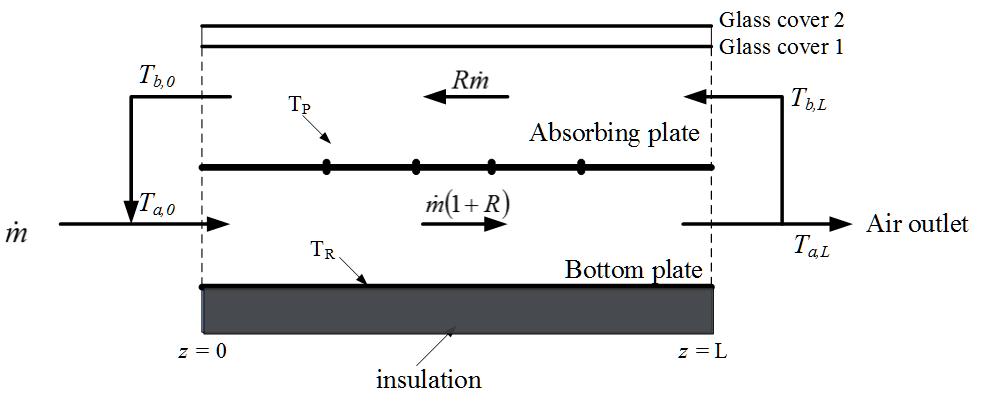
In recent years, most of the power supply on remote islands is by diesel power generation, and the generation of carbon dioxide accompanying the use of fuel is becoming a problem. Therefore, introduction of renewable energy such as solar power generation and wind power generation is being considered in remote islands in various places. In this study, we will construct an isolated island microgrid for the purpose of reducing carbon dioxide emissions of the Teuri island and Yagisiri island, which belong to Haboro-cho in northern Hokkaido.
At present, the power consumed by the Teuris Island and Yaishiri Island is supplied by a diesel generator already installed at the Yaishiri Island, and power is transmitted to the Teuri Island using a submarine cable. Therefore, if an abnormality occurs in the submarine cable due to a disaster or an accident, Teuri Island becomes unpowered. Therefore, in the proposed system, power is supplied by diesel power generation, solar power generation, and wind power generation. In addition, renewable energy will be installed on the Teuri Island and linked to a diesel generator to compensate for output fluctuations. In this paper, we create an analysis model using the above system using MATLAB / Simulink, analyze the introduction limit amount of renewable energy, and investigate the reduction amount of carbon dioxide emitted from the diesel generator.
Carbon-based Si heterojunction solar cells, combining the transparent conductive carbon nanotube (CNT) films and crystalline Si wafers, have attracted increasing attention. The advantage is that the high-efficiency solar cell can be achieved in a cost-effective manner owing to the low-temperature solution process to fabricate the CNT/Si heterojunction. Since the first report of the CNT/Si heterojunction solar cell with the power conversion efficiency (PCE) of around 1.3 % by Wei et al. in 2007 [1], PCE has been improved drastically. Wang et al. reported the record-high efficiency over 17 % with an active area of 0.785 mm2 by applying a thermally evaporated MoO3 layer in 2015 [2]. However, it is essential to enlarge the active area toward practice application.
Herein, we applied the solution-processed MoO3 layer to the CNT/n-Si cells via hydration of the ammonium heptamolybdate ((NH4)6Mo7O24·4H2O) precursor [3]. Compared with the thermal evaporation of the MoO3 layer in high-vacuum, the low-cost and simple preparation process can be expected. The MoO3 layer enhanced the PCE significantly from 7.16 % to 10.23 % for the small cell (Fig. 1a). For the large cell (400 mm2), however, the efficiency remained at 3.32 % even the CNT film was doped with HNO3 (Fig. 1b). The Au bar electrodes were formed on the MoO3/CNT/n-Si structure to carry current for a large distance, and the uniformity of the MoO3 layer needs to be improved to prevent the short-circuit between Au and n-Si. It is noteworthy that the device with the solution-processed MoO3 layer showed considerable stability that remained the PCE at 80 % of its original value for more than 60 days in air without any protective layer.
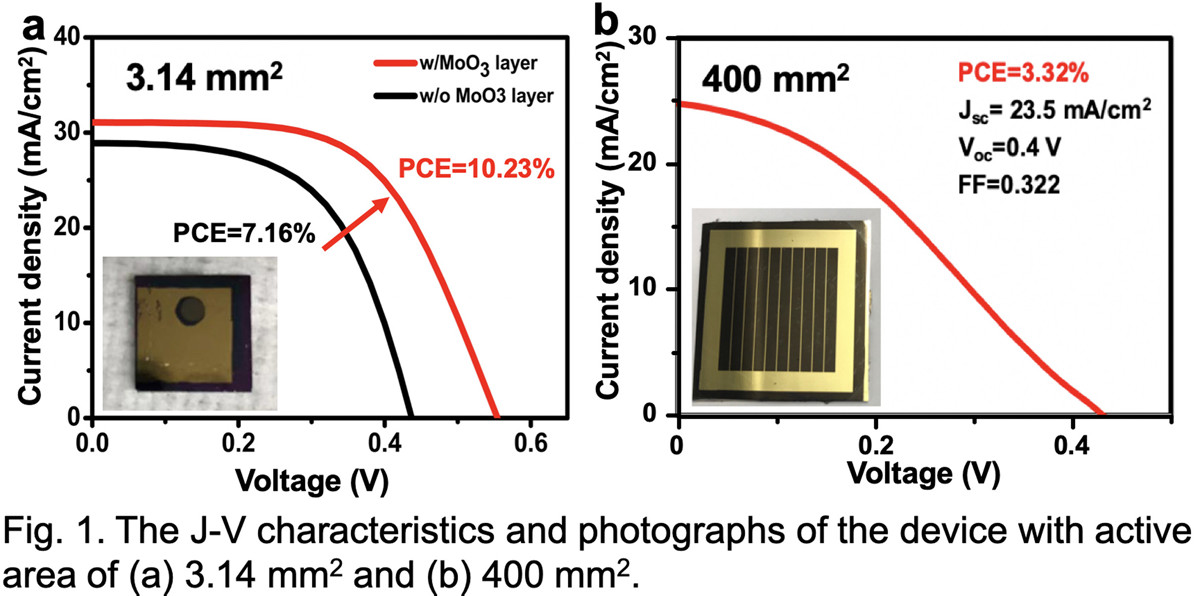
The power generated from the Gibbs free energy of mixing through reverse electrodialysis (RED) is a promising renewable energy of great potential. In this study the performance of nanochannels having a pH-regulated surface in RED is examined, focusing on the influence of the bulk salt concentration, the nanochannel size, and its geometry. Taking account of the effect of osmotic flow, we consider two types of nanochannel: bullet-shaped nanochannel and trumpet-shaped nanochannel. The variations in the maximum power generation, the power efficiency, the diffusion potential, and the transference number under various conditions are investigated, and the underlying mechanisms discussed comprehensively. The results of numerical simulation reveal that the more a nanochannel is trumpet-shaped the better its ion selectivity. This is because the smaller the nanochannel space, the more significant the degree of electric double layer overlapping. For a bullet-shaped nanochannel, the maximum power generated has a local maximum as the ratio of (nanochannel length/curvature radius) varies. This can be explained by the associated diffusion potential and the electric current passing through the nanochannel. The results gathered provide desirable and necessary information for designing a RED system.
MoS2 has a layered structure and its electrocatalytic activity of hydrogen evolution reaction (HER) is strongly dependent on layer number of its nanosheets. For example, few-layered MoS2 is well known to show efficient HER activity, whereas multi-layered or bulk MoS2 show poor HER activity.Thus, a MoS2 synthesis process that allows controlling the layer number is required. We recently developed a synthesis method on few-layered MoS2 nanosheets using supercritical ethanol process and showed that synthesized materials possess a certain HER activity.
In this study, we propose a layer-number selective MoS2 symthesis process under supercritical hydrothermal reductive conditions using organic reducing agents. We systematically synthesized MoS2 nanosheets using various synthesis condition and precursors. Physical characterizations (such as XRD and TEM) and measurements of HER activity of synthesized MoS2 nanosheets are conducted. It was found that product (MoS2 or other Mo containing by-products), layer-number and HER activity of our synthesized materials are strongly dependent on synthesis condition and precursors. Detailed result of characterizations and formation mechanism of MoS2 nanosheets with different layer number are discussed in the poster session.
Water electrolysis seems to be well established technology with high energy conversion efficiency. The biggest problem is high costs of electrical energy, especially in Japan. The seawater electrolysis is one of the solutions for reduction of costs because seawater is infinite natural source. In seawater electrolysis for energy production, a huge amount of chlorine emission is not allowed. But, appropriate amount of chlorine production can be used to sterilization and industrial source. In this study, we examined to the clarify the relation between the hydrogen, oxygen and chlorine evolution behavior and electrolyte and supply conditions (pH, concentration, flow rate, etc.). The flow-type electrolysis cell was consisted that active area is 70cm2 and flow path thickness is 5 mm.
The experimentally observed the potentials of oxygen and chlorine evolution reaction are similar potentials in 3.5wt% NaCl solution (pH 6.5). However, the current efficiency of chlorine calculated from the concentration in the exit flow (impressed current density; 7.14 mA/cm2, linear velocity; 1.78 cm/s). It caused by the decreasing of chloride ion on the electrode surface due to the difference of ionic mobility.
Currently, we aim for a clean energy society by introducing a large amount of renewable energy. As a method, hydrogen production using surplus power is attracting attention. In this research, we focused on PEM (Polymer Electrolyte Membrane) type water electrolyzer which electrolyzes distilled water. PEM-type water electrolyser have the advantage of not discharging carbon dioxide when producing hydrogen, but have the problem of using expensive Pt metal for the catalyst. Therefore, in this research, we used Ni-CNO (Nickel-Carbon nano Onion) coated with fullerene, consisting of a large number of carbon atoms in a closed shell cavity, which is less expensive than Pt metal. Figure 1 shows the difference in hydrogen generation mechanism between Ni-CNO and a general Pt catalyst. PEM-type water electrolyser is comprised by a separator and MEA (Membrane Electrolyte Assembly). MEA is a place where the water electrolysis reaction actually occurs, and it is a combination of a gas diffusion layer, a catalyst layer, and an ion exchange membrane. Although PEM-type water electrolyser is affected by the material as well, it is also greatly influenced by the MEA manufacturing conditions. In addition, conditions for producing MEA (Membrane Electrolyte Assembly) suitable for the Ni-CNO catalyst are unknown. Therefore, in this research, we investigated suitable MEA fabrication conditions and evaluated their performance. As the performance evaluation method, we used the energy conversion efficiency obtained by dividing heat quantity of generated hydrogen per second and the
power supplied. The best result was an energy conversion efficiency of approximately 80% compared to a common Pt catalyst. In addition, since the cost of the catalyst material is about 1/8, it is considered to be sufficient performance. As a future subject, it is necessary to investigate how the energy conversion efficiency changes when a voltage fluctuation simulating renewable energy is added.
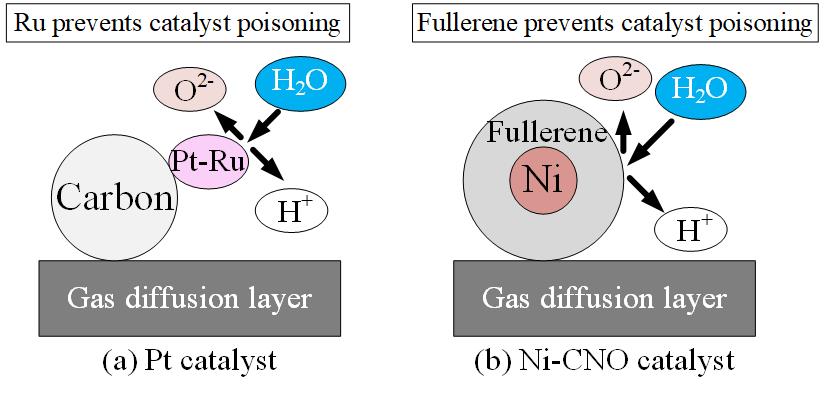
Vanadium redox flow battery (VRFB) is one kind of energy storage system (ESS), which converts electricity to chemical energy by redox reaction in each electrolyte tank. Vanadium redox flow battery is recently an attractive energy storage system of renewable energy sources for its low cost and flexible design. For the operation of VRFB, ion exchange membrane plays important role. Ion exchange membrane provides ion transfer channel for charge carriers, and it prevents electrolyte of each electrode from cross-mixing. Commercially, Nafion membrane is used for ion exchange membrane for VRFB. Although Nafion has high proton conductivity and good chemical stability, high vanadium ion permeability, which is main factor of self-discharge reaction, is major defect to be used in VRFB.
In this study, the anion exchange membrane is synthesized from poly(arylene ether ketone) with 1-(3-aminopropyl) imidazole(API) as pendant groups for vanadium redox flow battery application. PAEK is one of the hydrocarbon based polymer which has good mechanical and chemical stability, and it can be modified easiliy by introducing functional groups. Imidazolium group is one kind of positively charged functional groups, which can reduce permeability of vanadium ion by Donnan exclusion phenomena. And due to the N-heterocyclic structure in functional groups, excellent chemical stability in electrolyte solution can be expected.
As the content of imidazolium group increases, the ion exchange capacity of membrane increases, showing higher value than Nafion 117 membranes. All of the synthesized membranes show significantly low vanadium ion permeability compared to Nafion 117 membranes. In addition, During the 100 cycling test, PAEK-API 2.0 membrane shows higher coulombic and energy efficiencies than Nafion 117 membrane without any degradation.
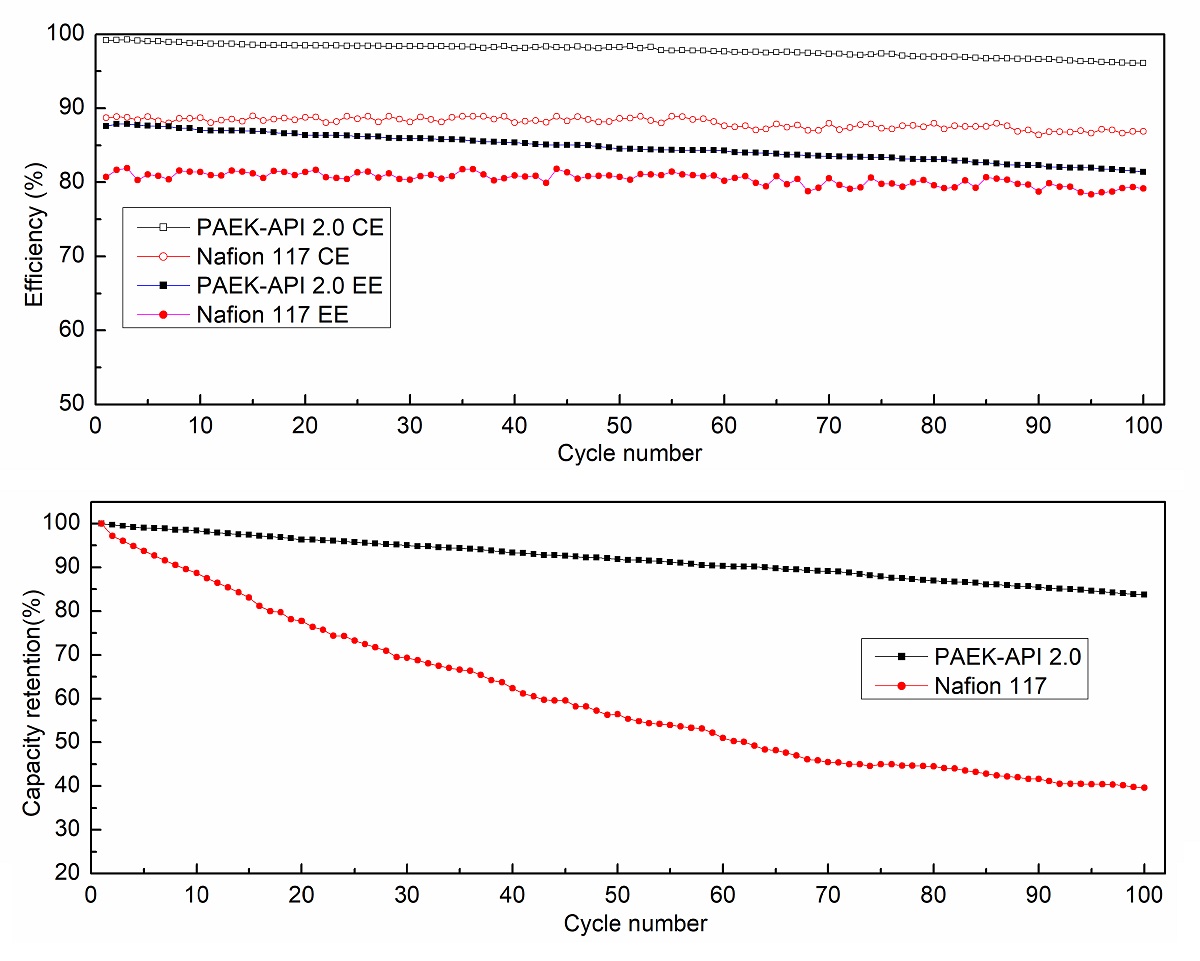
There has been a considerable interest in one-dimensional nanostructures owing to their remarkable characteristics in particular these electronic properties which have been considered to significantly improve the electron transport time and reduce the recombination rate. The range of research area of one-dimensional nanostructures covers meanwhile a wide range of transition metal oxides. Among them, TiO2 is the most widely studied material because of its promising applications in solar-cells, photoelectrochemical hydrogen production, and CO2 reduction etc. Because, highly aligned TiO2 nanostructures have been suitable semiconductive properties with ∼3 eV and optimum band-edges to water, fast electron path way, and chemical stability.
Recently, noble metal decorated TiO2 nanotubes has been considered a key materials for photocatalytic hydrogen production. In the present presentation, we show that when growing anodic self-organized TiO2 nanotubes from Ti-noble metal alloy (Ti-Au, Ti-Pt) with at low noble metal contents, after formation the resulting oxide nanotubes show a regular self-decoration with Au or Pt nanoparticles of ∼5 nm in diameter. The average spacing is probably adjustable by the anodization conditions (in the range of ∼60 nm). The type of decoration the co-catalyst on TiO2 nanotubes leads to a very high activity for photocatalytic H2 production under UV or visible light conditions.
Anode recirculation in the solid oxide fuel cell (SOFC) increases the system fuel utilization so that the electrical efficiency of the system would be improved. However, large amounts of water (steam) existing in the recirculation loop not only decreases the cell open circuit voltage but also aggravates the concentration polarization, thereby limiting the enhancement of electrical efficiency. Therefore, proposed systems consisting of water separators could be a solution of this problem. In this study, intermediate temperature SOFC (IT-SOFC) CHP systems with anode recirculation and water separators are investigated by using Aspen Plus software to evaluate their performances. Several system configurations with various steam separator layouts are considered and the effects of anode recirculation ratio on the system performance are analyzed. Simulation results indicates that electrical and thermal efficiency of the conventional system (without water separator) could be significantly improved by adding a water separator at the outlet of the anode. On the other hand, the system adding a water separator at the inlet of the afterburner exhibits superior thermal efficiency and total efficiency at a high recirculation ratio.
In this study polybenzimidazole (PBI) nanocomposite membranes using sulfophenylated titanium oxide (s-TiO2) nanoparticles was synthesized for application in high temperature polymer electrolyte membrane fuel cell (HT-PEMFC). The neat TiO2 was surface modified via two-step synthesis to improve proton conductivity and cell performance of PBI, Different concentrations of inorganic fillers were incorporated to test their effect. The PBI nanocomposite membranes were doped with phosphoric acid (PA) for performance evaluation. Properties relating to fuel cell performance such as PA doping level, proton conductivity, PA retention and cell performance were evaluated and compared to neat PBI. Increase in performance was observed for certain concentrations while excess caused decline in performance.
Low temperature heat below 473 K is produced massively. It is useful to convert low temperature heat into electricity. In carbon dioxide (CO2) capturing systems, amine solutions absorb CO2 at 313 K and the CO2 partial pressure (PCO2) of 0.01 - 10 kPa and desorb CO2 at 393 K and PCO2 of 100-200 kPa. We consider the possibility of the low temperature cycle whose turbine is driven by the desorbed CO2 and H2O. The power cycle is as follows. An amine - CO2 - H2O mixture is cooled to 313 K in a cooler. The cooled amine - CO2 - H2O solution is pressurized in a pump and heated in a recuperator. The preheated fluid is heated at a heat exchanger by hot fluid. The CO2 - H2O gas mixture desorbed from the preheated fliud and the residue are separated by a gas - liquid separator. The CO2 - H2O gas mixture drives a turbine and expanded adiabatically. The residue heats the pressurized solution. The expanded CO2 - H2O gas mixture and the cooled residue are mixed in a mixer. The basic configuration is the same as the water - ammonia based Kalina cycle. However, it is a feature of this cycle that it contains CO2 and a large amount of water vapor in the generated gas. In our thermodynamic study, it was expected that this cycle can obtain the performance equal to or higher than that of the current ORC. Therefore, a principle verification test was carried out. The test showed ten per cent of thermal efficiency at 393 K and CO2 loading of 20 NL/L. We are planning a 10 kW amine-CO2 cycle test.
In a low temperature power cycle using amine – CO2 fluid, an amine solution absorbs CO2 at 313 K in an absorber/condenser, the CO2 absorbed amine solution is pressurized by a pump, heated by a recuperator and a boiler, and desorbs CO2 – H2O gas mixture, which drives a turbine. In our thermodynamic study, it was expected that low temperature power cycle using amine-CO2 fluid can obtain the performance equal to or higher than that of the current ORC. Therefore, a principle verification test was carried out. The test showed ten per cent of thermal efficiency at 393 K and CO2 loading of 20 NL/L. We are designing a 10 kW test equipment. We set high temperature heat source is hot water at the temperature of 363 K, which is used as a coolant of a gas engine. The heat and mass balance of the equipment was calculated thermodynamically. The result showed the flow rate of the hot water flow and amine – CO2 fluid, the turbine expansion ratio, the power, and the system efficiency are 8,200 kg/h, 1,000 kg/h, 4.8, 10.5 kW, and 7.3 per cent, respectively. The preliminary estimation shows as follows. The diameter and rotational speed of the turbine blade are 0.115 m and 54,400 min-1, respectively. The numbers of tubes in the boiler, the recuperator, and the absorber/condenser, which are shell and tube heat exchangers, are 4400, 910, 1020, respectively. The length and diameter of the tube are 1 m and 6 mm, respectively.
In the background of global warming and scarce resources depletion, Japan depends on the fossil fuel for most of energy resources. So utilization expanding of renewable energy and thorough energy conservation are necessary for stable utilization of energies and climate change measures in the future. Since Hokkaido prefecture that is a northern island of Japan has the abundant renewable energy, such as solar, wind, small and medium-sized hydropower, biomass, and geothermal energy, it will show the highest feasibility for renewable energy throughout Japan, toward the utilization of new energy. Then use concept of various energies has been proposed as an opportunity of the local production for local consumption of energy or feed-in tariffs. In this study, optimum mix and dispersed models of energy in Hokkaido prefecture were investigated to develop the technology support system utilizing energy resource dispersed in wide regions, like renewable energy and to construct the appropriate energy demand and supply system increasing the regional development or activation and the energy self-sufficiency rate. Many methods estimating substantial, available and demand amounts of regional energy were evaluated. Integrated geographic information system (GIS) supporting local governments or independent workers was designed by combining the collected and calculated amounts of regional energy. The GIS is divided into two types of Web site and stand-alone. The Web site type can be viewed for anyone in Hokkaido by accessing required data to computer. The stand-alone one may be efficient for planning and coordinating energy policies in each of local governments. Moreover, various element technologies, such as combustible waste fuel, combustion system and energy best mix for facilities group were developed to improve the regional energy balance and creation of new industry. Regarding Furano region as a typical local model, dispersed utilization models for the energy suitable to regional and industrial characteristics were proposed.
A microgrid is a localized group of electricity sources and loads typically connected to and synchronous with the traditional centralized grid (macrogrid), but it can disconnect and maintain operation autonomously. This study utilise analysis of correlation to determine the impact factors which is used to predict the demand of electricity, renewable energy sources (RES) and prices. Power dispatch of distributed generators (DG) and optimization of microgrid is designed to minimize the consumption and cost of fuel and emissions of exhaust. It is essential for power system security to set an adequate operating reserve (OR) power to compensate the unpredicted imbalance between RES generation and consumption. Matlab is used to create the prediction model and GAMS is utilised to optimize the unit commitment problem (UCP).
Keywords: Microgrid; Prediction; Neural Network; Power Dispatch; Optimization.
A chemical heat storage is advantageous in terms long periods of time storage and the high storage density are possible as compared to the direct storage methods. Normally, a reversible single reaction is utilized, then the heat storage temperature is limited. There were several MeO/H2O systems such as MgO/H2O and CaO/H2O as chemical heat storage material. However, in order to store industrial waste ranging widely in the temperatures, it's necessary to develop a new material which allows heat storage in a stepwise manner in response to temperature changes. Hydrotalcite [Mg6Al2(OH)16(CO3)4H2O] which is a kind of Layered double hydroxide (LDH), have possibility to get multi-step chemical heat storage reaction using dehydration – hydration reaction of Mg-OH, Al-OH and interlayer water. However, in order to occur the above hydration reaction, the supply of the interlayer anion of CO2 is essential, which is a major problem for the reaction rate and cycleability for chemical heat storage. Then, although it is necessary to design the kind of interlayer anions and metal ion, there have been few studies focusing on reaction reversibility of LDH. In this study, we have investigated the effect of interlayer anion on the dehydration-hydration reaction of Hydrotalcite and the application for chemical heat storage material. In addition, the potentials of the multistep chemical heat storage property have been investigated.
A CO2 hydrate power generation system for cold regions has been proposed, in which carbon dioxide hydrate is formed by cold heat from the outside air, and a generator is driven by high pressure gas obtained by dissociating the hydrate by supply of low temperature waste heat. The purpose of this study is to clarify the effect of formation reaction promoters on the improvement of carbon dioxide hydrate formation rate and increase of formation temperature upper limit. Cyclopentane, which shifts the phase equilibrium pressure curve to higher temperatures and lower pressures, was used as a formation reaction promoter in this study. This shift is expected to have the desirable effect of improving the formation rate, but adding the formation reaction promoter has the negative effect of reducing the amount of formation by reducing the amount of net water. In the experiment, we filled a 100 ml stainless steel reaction vessel with 50 ml of pure water or 50 ml of a mixed solution of pure water and cyclopentane at a mixing ratio of 1:1. After enough initial dissolution was performed at a desired pressure, thermal cycles of formation and dissociation for 6 hours were repeated by alternately flowing 273 K and 293 K heat media around the periphery of the reaction vessel. To calculate the formation rate, the measured values of pressure and temperature in the sealed reaction vessel were used, and the compression coefficient of CO2 was considered using the physical property database REFPROP. As a result, we were able to confirm that cyclopentane increased the formation rate and amount under the conditions without power stirring. This result suggests the possibility of improving the energy storage rate and the energy storage capacity per unit water volume of the proposed power generation system using cyclopentane.
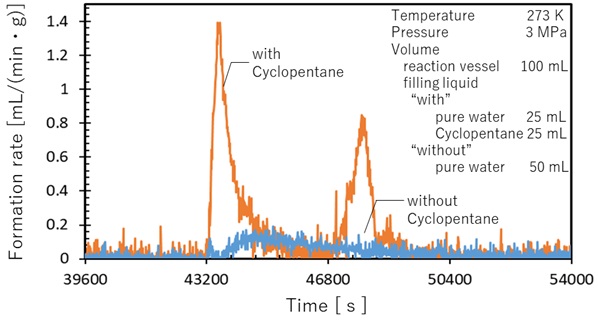
Recently, there is an increase in energy consumption of air conditioning for a comfortable life in the residential sector. Desiccant humidity control system has been gaining an attention to improve energy utilization efficiency of air conditioning. The system can be driven by low-temperature heat and control latent heat loads easily, independent of sensible heat loads. However, dehumidification performance is getting low by lowering regeneration temperature, because effective water adsorptivity, which is a difference in the amount of adsorbed water between dehumidification and regeneration, greatly decreases at lower temperatures. To solve this problem, we have focused on thermosensitive polymer gel as a novel adsorbent for desiccant humidity control system. The thermosensitive polymer gel is well-known to switch hydrophilic and hydrophobic natures in water at a lower critical solution temperature (LCST). We expected that thermosensitive gel adsorbs water vapor below the LCST and desorbs a large amount of adsorbed water over the LCST, resulting that it can achieve a high effective water adsorptivity even by a small temperature difference between dehumidification and regeneration. In this study, N-isopropylacrylamide, 2-(Dimethylamino)ethyl methacrylate, and N-isopropylmethacrylamide were employed as thermosensitive monomers which have different LCSTs in water. They were polymerized using a radical polymerization method with N,N′-methylenebisacrylamide (MBAA) as a crosslinker at various MBAA concentrations and polymerization temperatures. Water vapor adsorption behavior of the prepared gels were measured at several adsorption temperatures and relative humidities. Finally, the applicability of the gels toward a desiccant humidity control system was evaluated from the viewpoint of effective water adsorptivity in the operation range of the system.
The improvement of chiller cycle performance has been investigated. We suggested the thermal and electric hybrid absorption refrigerator cycle. In this cycle, we selected the refrigerant and absorbent as HFC-134a (1,1,1,2-Tetrafluoroethane) and 1-Butyl-3-methylimidazolium bis(trifluoromethylsulfonyl)imide [BMIM][Tf2N] (Ionic Liquid), respectively. In this study, The Coefficient of Performance (COP) based on input heat energy for regeneration absorbent and electric power for compressor was calculated using a static analysis based on a state equilibrium in order to evaluate the effect of a compressor work on COP and regeneration temperature. As the results from analysis, the hybrid cycle could be generated cold heat below 0 °C, and driven below regeneration temperature 60 °C by assist of compressor. In addition, the absorption pressure working compressor was increased as the amount of absorption in Ionic liquid and COPsystem were obtained high value. The COPsystem was affected on the regeneration temperature, which the input sensible heat and amount of absorption in Ionic Liquid was depended on. For heat source in the temperature range of 60-90 °C, the hybrid cycle is superior in terms of COPelectricity compared to the mechanical cycle. COPelectricity was affected by liquid pump efficiency. The COPelectricity of hybrid cycle was higher than the COPelectricity of mechanical type when the liquid pump efficiency was over 0.15.
Vegetables cannot grow outside in cold regions because of snow in winter, so we focused on the plant factory which can provide a stable supply of crops. However, the plant factory consume a lot of power because they use air conditioning and lighting to grow plants. Therefore, in this research, we will consider the energy system of a clean plant factory with low power consumption. The vegetables grown in the plant factory are spinach. Spinach increase sugar content when exposed to low temperatures. This is called savoy-spinach. Therefore, in this paper, we propose a plant factory system that assumes low temperature processing of spinach. The plant factory install photovoltaics and a solid oxide fuel cell (SOFC cogeneration) with high power generation efficiency. Furthermore, in order to utilize the exhaust heat of SOFC cogeneration, an absorption refrigerator is installed to supply cold heat to the plant factory. The room temperature of the plant factory is cooled to 7 degrees Celsius, because the ambient temperature needs to be 7 degrees Celsius or less in order to perform the low temperature processing of spinach. Because the daily maximum temperature of from December to March of Kitami is less than 7 degrees Celsius, the room temperature of the plant factory is air cooled by a ventilation fan from December to March and cooled by an absorption refrigerator from April to November. The above system can be expected to reduce the power consumption of the air conditioning equipment because it effectively uses unused energy such as exhaust heat of SOFC cogeneration and outside air. Also, by introducing photovoltaics, CO2 emissions can be reduced by up to 8.45×106 kg-CO2. This corresponds to a reduction of fuel (natural gas) consumption of 3.91×106 kg, and it can be expected to reduce environmental burden.
Plant factories have attracted attention because the decrease in the number of employed farmers in Japan has become a problem. However, energy costs affect profitability, as plant factories use artificial light. Therefore, we will consider the profitability of a cold region plant factory from the energy efficiency (= calorific value of plant / energy input) of Corchorus olitorius, Japanese peppermint, Potherb mustard, Japanese mustard spinach, Bok choy and Crown daisy which have vegetation in the Okhotsk region. In order to investigate the calorific value of a plant, cultivation was performed using LED, and the calorific value of the plant was measured using DSC (Differential Scanning Calorimeter). In addition, in order to investigate the input energy, the heat demand and the power demand were investigated for the cold region plant factory installed at the University. As a result of investigation, the relationship between the energy efficiency of each plant and the number of cultivation days is as shown in Fig 1. Assuming that the energy efficiency is Y and the number of cultivation days is X, an approximate expression Y=0.0275X+1 can be obtained. Furthermore, as a result of investigating profitability from the running cost at the time of cultivation at a plant factory, it was found that Corchorus olitorius and Japanese peppermint have no profit, and the other 4 types have profit. Since the lower part of the approximation line is Corchorus olitorius and the Japanese peppermint, and the upper part is the other four types, it is considered that if the energy efficiency of the plant becomes larger than the approximation formula, it may be possible to be profitable. As future issues, it is considered necessary to increase the number of surveys due to lack of data on plants that can be harvested within 30 days.
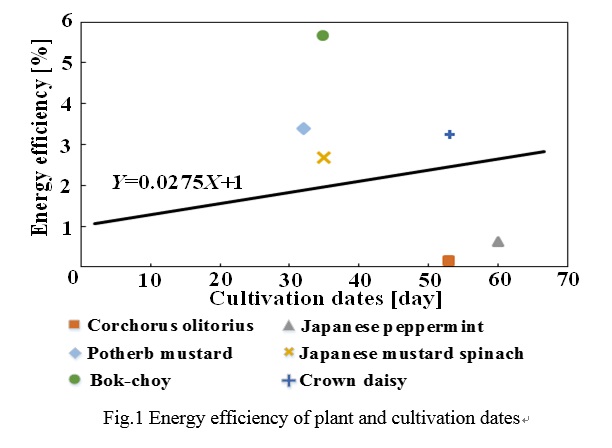
Based on the elementary reaction database on the steam reforming of methane on the Ni catalyst, an elementary reaction simulation of CO2 hydrogenation was performed. DETCHEM was used to calculate a one-dimensional reaction assuming a fixed bed reactor. The obtained results were compared with not only the methanation reaction test using commercial catalysts but also the actual measurement data obtained from the literature. The identification of the rate limiting step and the correlation between the reaction characteristics and the catalyst physical properties were examined. The temperature profile in the catalyst bed was obtained and The measured values of CO2 conversion and the reaction simulation predictions agree well.
Batch processes play a key role in producing low-volume and high-value-added products. In order to produce consistent, high-standard products and ensure process safety, real-time monitoring of batch processes is critical. To this end, the present work proposed a batch processes monitoring method based on the multiway principal polynomial component analysis (MPPCA). The MPPCA-based monitoring method is a nonlinear technique used to tackle the problem of process nonlinearity inherent in most batch processes. Thus, the MPPCA-based monitoring method is more suitable for nonlinear process applications than traditional linear methods such as principal component analysis (PCA)-based monitoring methods. Moreover, as compared to other nonlinear monitoring methods such as kernel-based methods, the MPPCA-based monitoring method has attractive features of invertibility, volume-preservation, and straightforward out-of-sample extension. The effectiveness of the proposed MPPCA-based monitoring method was validated through its application to a fed-batch penicillin fermentation process. The application results have demonstrated that the proposed MPPCA-based monitoring method is superior to the conventional multiway PCA (MPCA)-based monitoring method and the multiway kernel PCA (MKPCA)-based monitoring method in fault detection and diagnosis performance.
Many accidents have occurred in universities and the accident reports are accumulated in most universities. The information described in the accident reports must be used effectively to prevent a recurrence of the accidents. In this study, we applied text analytics to the description written in 373 accident reports in a university as a case study. Information mining method was adopted for the contents analysis, and 9 factors based on human error and m-SHEL, that is “slip”, “lapse”, “mistake”, “violation”, “software”, “hardware”, “environment”, “liveware”, and “management” were used for morphological analysis for description in report. The factors in each category (e.g. accident situation, generation) were extracted, and it is suggested that text analytics is one of the most effective methods to analyze the accident reports in universities.
Storage tank fires (such as pool fires) often occur in petrochemical tank farms. Flame pulsation is an important characteristic of turbulent flames observed in pool fires. Current solid flame models inadequately predict the thermal radiation of pool fires, particularly the effects of flame pulsation. The thermal buckling behavior and fire resistance of a fixed-roof Q345 steel tank with a stepped thickness under a neighboring ethanol pool fire based on a flame pulsation model was numerically investigated. The influence of smoke generated by the combustion process which can reduce thermal radiation fluxes was taken into account. Geometric and material nonlinear analysis was used on finite element analysis. Nonlinear analyses were solved using an explicit dynamic algorithm. Results showed that losing the load-carrying capacity in a circumferential direction at the most heated area triggers thermal buckling of the target tank and that the observed buckling behavior is non-linear, and the deformation shapes are diagonally symmetric. Fire resistance (in terms of critical time (tcr)) of the target tank depends on the vertical location of the fire (Hf). When Hf increases from 3.56 to 17.82 m, tcr rises from 900 to 2710 s. Fire resistance decreases exponentially as burning tank diameter (Df) increases. When Df increases from 10 to 30 m, tcr reduces by about half. The fire resistance for the cylinder-cone combined flame is larger than that for the cylindrical flame. The cylindrical flame underestimates fire resistance of the target tank when flame pulsation is accounted for.
Reaction calorimetry has been widespread applied for thermokinetic analysis of chemical reactions in the context of thermal process safety and process development. Mixing heat of reactants may lead to deviation of reaction heat measured by reaction calorimetry as it can't be separated from the reaction heat, especially for a solvent-free reaction mixture. This work is devoted to evaluating the influence of mixing heat on determination of thermokinetic parameters for the esterification of propionic anhydride with 2-butanol in the presence of sulfuric acid. To this aim, excess molar enthalpies of reactant solution were measured using a Mettler-Toledo EasyMax102 calorimetric reactor at 298 K and 0.1 MPa for the quaternary system which may occur during the esterification of propionic anhydride with 2-butanol (production of propanoic acid and 2-butyl propionate). A model for the excess molar enthalpies of the reaction mixtures as a function of the molar composition has been developed, which mainly based on Redlich–Kister equations and NRTL model. The model, which shows a good agreement with experimental data, then has been adopted for the evaluation of the mixing heat, which may lead to accurate kinetic parameters, through the correction of reaction enthalpy for esterification of propionic anhydride with 2-butanol in a batch reactor. Furthermore, corrected results of maximum temperature of the synthesis reaction (MTSR) were able to be acquired and be applied in safety assessment.
Some fire and explosion incidents in the workplace including large chemical plants have occurred intermittently since 2011 in Japan. It is pointed out that insufficient risk assessment has been implemented in using hazardous materials and chemical reaction of treating chemical substances understanding insufficiently them. Especially small and medium enterprises (SMEs) cannot often devote adequate resources toward implementing risk assessment. Thus, it is expected that the scenarios related to unintended reactions and the examples of risk reduction measures for these scenarios are provided for SMEs. One of solutions is considered to show some typical scenarios related to some critical events (runaway reactions, fire and explosion due to chemical incompatibility, explosion of self-reactive materials etc.) as support measures for implementing risk assessment considering unintended reactions. To investigate the typical scenarios and the risk reduction measures to prevent the progression of these scenarios, the scenarios related to unintended reactions were analyzed by developing bow tie diagrams because bow tie diagrams can be easily visible on the relationship between the causes of the events and the consequences of concern, and the measures preventing the progress of the scenarios.
The bow tie diagrams related to runaway reactions were developed by reference to the literature about the causes and consequences of runaway reactions. Moreover, the risk reduction measures to prevent the progression of these developed scenarios were investigate using the developed bow tie diagrams. Furthermore, the incident cases known about the detail of these incidents were traced using the developed bow tie diagrams to investigate the adequacy of these diagrams. The results from these investigations will be presented at the congress. It is expected that the developed bow tie diagrams are helpful for SMEs with limited resources to study the appropriate risk reduction measures to prevent the progression of these scenarios.
Fugitive emissions are unavoidable releases that occur continuously throughout a refinery or chemical plant wherever there are connections or seals between the process fluids and the external environment. Daily exposure to such emissions may pose a serious threat to the health of the workers. Previous work has been carried out focusing on assessing the occupational health risk in chemical plants by means of indexes such as the inherent occupational health index and the integrated inherent safety index. However, the indexes are only a good proxy indicator of the source of potential occupational hazards (i.e. chemicals, process conditions and process equipment). Based on the Source-Path-Receptor (SPR) model, the exposure and thus the eventual health risk also depend on the path and receptor. Also, in actual chemical plants, there are usually controls and mitigation measures put in place to control hazards and these can be referred to as protection layers (PL). Hence, in order to assess and evaluate the occupational health risk in chemical plants due to fugitive emissions, a more holistic methodology is required. Therefore, a hybrid framework for assessing this occupational health risk was developed by integrating the concepts of Layers of Protection, Hierarchy of Control and Source-Path-Receptor model. The generic protection layers identified were classified according to traditional hierarchy of controls. At the source, the protection layer identified were hazard elimination/substitution, inherently safer design and engineering controls. Next, along the exposure path, maintenance and equipment reliability were the identified protection layers. Finally, at the receptor, worker exposure is linked with management systems, procedures, safety behaviour and culture. Therefore, the proposed methodology can be also used for benchmarking and performance tracking of occupational health risk in a chemical plant over time, as the methodology includes the time-varying parameters of plant maintenance, management system compliance, safety behaviour and culture.
Household products such as dishwasher products and multipurpose cleaners may contain specific chemical ingredients to meet the consumer needs. However, some of the ingredients may result in skin and respiratory irritation. Thus, a systematic methodology to estimate the extent of hazard and risk for consumers' exposure to the products is needed. In this work, an index-based methodology is presented to estimate the severity of the hazards and risks of the ingredients during the early stage of product design. Besides, such methodology can be used as initial screening tool to reduce the hazards and risk of household products. Higher score was assigned to the higher potential of hazard and risk, and vice versa. The allocation of score can reveal the different level of severity of hazard and risk. With the score, the hazardous ingredient in the product formulation can be identified. The hazard potential was determined based on hazard classification by the Global Harmonised System (GHS), commonly found in material safety data sheet (MSDS). Risk assessment was performed by considering the Margin of Exposure (MOE) and Risk Characterization Ratio (RCR). The no-observed-adverse-effect level (NOAEL) of chemical ingredients is used to derive the MOE. Meanwhile, RCR is calculated by comparing the value of derived no effect level (DNELs) to the estimated exposure concentration. To demonstrate the proposed methodology, the dermal and inhalation hazards as well as risks from ingredients used in formulation of liquid detergent were evaluated.
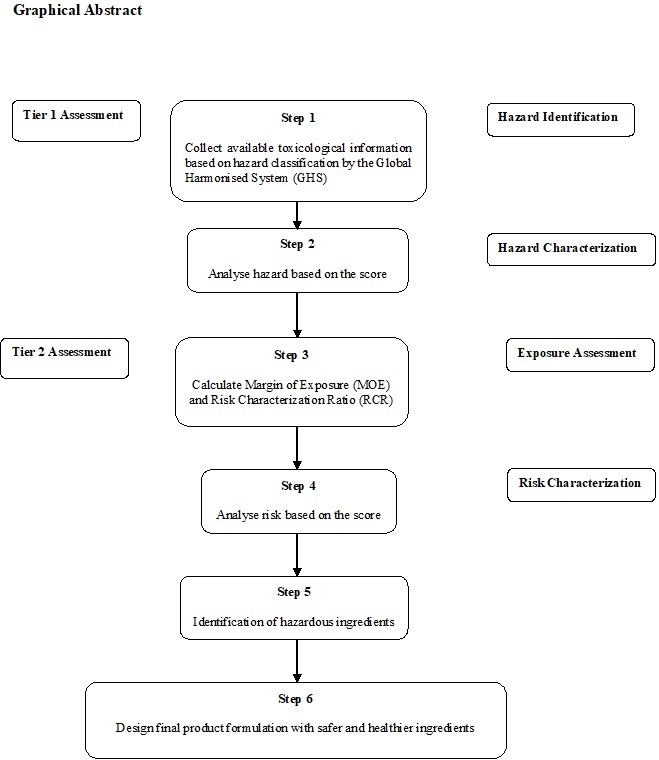
Process accidents are also partly caused by technical skill based on insufficient process safety information (PSI) and inappropriate non-technical skill. The causes were for example, “I didn't know it was used differently than when it was designed”, “The heat of reaction formation of the dimer was too large.” There were troubles that could be prevented at the design stage and gradually shifted from the original idea in daily operation. Engineers should make appropriate decisions by utilizing the PSI that has been accumulated by understanding everything from design to operation. Five abilities to operate PSI are defined; information collection ability, information creation ability, information sharing ability, information utilization ability and information update ability. For next use we need to update the information if it is necessary to correct the information after use. It is necessary to store information that has been updated. Wire Mesh Protection Model is modeled to explain the mechanism to prevent accidents by using PSI.The protection layers consists of two layers, technical skill (TS) and non-technical skill (NTS). If insufficient management of TS and NTS, two layers allows hazards to occur accident. Well-operated NTS leads the inner layer to prevent any accident. It is important to consider utilizing PSI to make workplace safe. Accidents can be suppressed by strengthening both layers. An operational support system based on NTS is proposed and conceptual diagram that NTS work at each event. The formal knowledge that is the subject of PSI will be complemented by unconsciousness gained from experience and the five senses and implicit knowledge that is difficult to verbalize. It will find new added value in forming PSI in Japan.
This paper shares information on developing process safety management (PSM) system for refineries and activities toward the implementation of the system for process safety enhancement.
In chemical process industry, a lot of serious accidents have been experienced like vapor cloud explosion (VCE), boiling liquid expanding vapor explosion (BLEVE), boil over, poisonous gas expansion and so forth. Once it occurs, workforces in the plant will be seriously injured. Furthermore, neighbors and local community will be suffered blast wave, radiant heat etc. Company revenue and reputations will be also impacted.
In our refineries, HAZOP, LOPA and management of change (MOC) have been widely applied to identify and manage process safety risks, however, it is also of great importance to identify some other risks which cannot be captured through the methods above. PSM is widely credited in the industry for reductions in major accident risk in a comprehensive and systematic way. This presentation shares our journey toward the development of PSM system and some examples of the key activities to implement the core elements of the PSM system: hazard identification and risk analysis etc.
Process safety of a chemical plant should be managed consistently throughout the plant life cycle. In order to consistently manage process safety, it is necessary to explicitly express the whole business process framework of process safety management. Therefore, we have developed a business process model as a framework. Based on the developed model, the constraints of each activity, the position of the activity can be found. Activities to assess the impact of change are heavily burdened, especially if the rationale of previous decisions is not available, particularly for change management. To reduce the burden, the rationale for any decision-making should be preserved for use in future activities. The saved rationale should be formatted for easy use in future activities. Therefore, we proposed a support system framework for smart management of change based on business process model. The system automatically generates a checklist when the rationale for decision making is proposed.
The U.S. Chemical Safety Board (CSB), an independent, non–regulatory federal agency that investigates the root causes of major chemical incidents, has firstly analyzed safety culture as an important element to maintain process safety in the investigation report of “BP America Refinery Explosion” in 2007. On the same year, the Center for Chemical Process Safety (CCPS) published Risk Based Process Safety (RBPS) in which process safety culture was newly added as an element.
The author found following six CSB reports which analyzed and found weaknesses of safety culture, and discussed their relations with essential features of process safety culture in RBPS.
1. BP America Refinery Explosion 2007
–Lack of reporting and learning culture
–Focus on personal safety rather than process safety
–Organizational changes and budget cuts
2. Tesoro Refinery Fatal Explosion and Fire 2014
–Management had normalized hazardous conditions
–Safety culture required proof of danger
3. Chevron Refinery Fire 2015
–Decision to operate despite hazardous leaks several times
–Reluctance to use Stop Work Authority
–Increased problems in equipment maintenance
4. Macondo Blowout and Explosion 2016
(No new findings)
5. Tesoro Martinez Sulfuric Acid Spill 2016
–Failure to learn from past incidents
–Weak management commitment to worker safety
6. Williams Olefins Plant Explosion and Fire 2016
–Deficiencies in and poor implementation of the process safety management system
Weaknesses underlined correspond to the essential features in the principle “maintain a dependable practice” in RBPS. Five reports contain weaknesses of this type, which suggests that these sites need to acquire dependable practices to develop and implement a sound culture. Repeated past incidents clearly show the normalization of deviance. Though the reports including analysis of safety culture are still limited, approaches to analyze safety culture are being accumulated.
Most of PETRONAS Operating Plant Units (OPU) are classified as a Hazardous Installation due to handling of the large inventories of flammable, explosive and toxic substances at site. The quantities of hazardous materials are estimated to be above the specified threshold values, taken from the Occupational Safety and Health Act 1994, Control of Industrial Major Accident Hazards (CIMAH) Regulations, 1996.
The Safety Report demonstrate to the Department of Occupational Safety and Health (DOSH) that OPU has applied strict measures to manage Major Accident Hazards as an operator of all hazardous facilities.
The Major Accident Hazard (MAH) and its mitigation through Safety Critical Element (SCE) Management Process forms a major part of the PETRONAS Risk Management Process.
This is implemented to provide a safer operating environment for people, maximizing the understanding of the risks inherently involved in the extraction of hydrocarbons, and minimizing the exposure of personnel to these risks.
Major Accident Hazards are established from a Hazard Identification Study (HAZID) as well as Hazard and Operability Study (HAZOP). SCEs are identified from analysing those Hazards, and constitute the means required to manage the associated risks.
The SCE Management process has four main stages:
• Identification of Major Accident Hazards;
• Identification of Safety Critical Elements, involved in managing Major Accident Hazards
• Identification of Performance Standards, and Assurance processes that ensure the continued suitability of the Safety Critical Elements
• Verification that all stages have been undertaken; that non-conformances are being identified, controlled and closed-out; and thus that Major Accident Hazards are being controlled.
Through the diligent application of these stages, it is possible to meet the requirements for MAH and SCE Management Process giving a better way of controlling risk by PETRONAS.
For decades, tremendous progresses in semiconductor technologies have been making drastic changes in our life in various fields including computing devices, cell phones, digital photos, internets, and medical diagnosis technologies. Especially A.I. (artificial intelligence) technologies are going to grow and spread revolutionarily in the coming decade which are enabledd by further progresses in the nonvolatile memory embedded logic device semiconductor process technologies which heavily rely on nanoscale material science and chemical engineering.
Interconnects which are used to connect active devices electrically are basically just passive components in LSI chips. Nevertheless, the influence of the interconnect parasitic resistance (R) / capacitance (C) started to affect circuit performance adversely and seriously which has driven the semiconductor industry to the shift from aluminum interconnect to copper interconnect 21 years ago. The negative effect of interconnect RC on LSI chip performance (speed and power consumption) and reliability is getting worse as the down scaling proceeds to nanoscale. Pessimism that copper interconnect is no longer extendable to finer dimensions is accelerating exploration of alternative conductors such as cobalt interconnect and ruthenium interconnect.
Roles of science and technology in the field of chemical engineering have been already the central part of semiconductor manufacturing processes such as CVD (chemical vapor deposition), CMP (chemical mechanical polishing) for years. Accurate control for formation of desired material structures depends on diffusion control in the gaseous, liquid and solid phases, chemical reaction control, analysis of individual chemical step in various sequences of manufacturing processes (exemplified in Fig. 1). Synthesis of new chemical precursors and advanced materials for newly introduced processes is also mandatory for break-through of technologies.
In this talk, further contribution and emerging necessity of chemical engineering for break-through in interconnect technologies are overviewed.
Power semiconductor devices are key device to carbon-dioxide-reduction technologies. We focus on a SiC device with a wide bandgap, that operates with low loss and high efficiency at temperatures up to 300 °C. Conventional isolation and sealing technologies cannot cope with such high operating temperatures; therefore, new advanced materials are necessary. The KAMOME project was setup in 2011 to support material development and evaluation for high-current SiC power modules. This report presents the outline of the six-year KAMOME project. In the first two years of project KAMOME-I, the module designed as the platform was confirmed to be able to evaluate a full SiC module. We attempted to produce four types of platforms, PT-1 to PT-4. In the following two years, project KAMOME-II was conducted using a large-size SiC- Schottky barrier diode (SBD) of 9.54 mm2. Various encapsulating materials, electrical bonding materials, and thermal conductive sheets, which are under development, were evaluated using SiC power modules for the platform. Concurrently, a novel polymer alloy having both a high heat resistance and low thermal expansion coefficient was prepared by melt mixing of two compounds, bismaleimide diphenyl methane (BMI) and 3,3′-(methylen-1,4-diphenylen)-bis(3,4-dihydro-2H-1,3-benzoxazine) (P-d). The resin comprising BMI 1.0 and P-d 0.3 exhibited superior thermal properties and processability compared to other combinations. When the compound was cured at 200 °C for 4 h, the glass transition temperature of the resulting product was > 300 °C. An encapsulation material was prepared using this polymer alloy and compared with those of conventional epoxy materials. In the final two years, KAMOME-III, by designing a simple package especially for the packaging techniques and materials, we could achieve a high evaluation accuracy with short routines. A package applied high heat-resistant encapsulation resin provided from participant companies, passed 50,000 cycles in a power cycle test with Tjmax = 225 °C and ΔT = 160 °C from 65 °C for the cooling temperature. A most excellent thermal conductive sheet maintained a stable heat transfer property for the SiC module after heating at 175 °C, 200 °C, and 250 °C for 500 h, respectively. In this project, 64 companies collectively participated mainly in developing the materials.
There are numerous joints in electronic products. The properties of the joints are crucial to the products' reliability. Several interesting and unexpected phenomena are observed at the joints of electronic products, such as polarity effect caused by electromigration and liquation caused by interfacial reactions. The uneven growth of the Ag3Sn phase in the Sn/Ag couples, i.e. polarity effect, was reported 20 years ago for the first time, and was realized to be caused by electromigration effect. Electromigration effect remains as an important but not fully understood effect in the electronic products. Unexpected liquation could be disastrous to the reliability of electronic products. The liquation phenomena encountered at the Sn-Sb/Ag, Cu/Bi2Te3 and γ-InSn4/Ni are illustrated. The unexpected melting of the Sn-5at%Sb solder was resulted from the excess intake of Ag from the substrate during first-step soldering, and an Ag-Sn low-melting eutectic was formed during the second-step soldering. The Ag-(Sn-5at%Sb) isoplethal section is used for illustration. The extremely fast dissolution rate observed in the Cu/Bi2Te3 couples at 350 °C was caused by the formation of liquid phase. Cu reacted with mostly Te in the Bi2Te3 substrate to form the Cu2Te phase, the excess Bi became a separate phase and was molten at 350 °C. It is illustrated with a Bi-Cu-Te isothermal section. The peculiar microstructure observed along the γ-InSn4/Ni interface was a result of two competing processes. When a compound of less indium was formed due to interfacial reactions, the solder became indium-rich, its melting point was lowered and a liquid phase was formed. This phenomenon and could be understood with a In-Sn-Ni isothermal section.
Critical dimension of semiconductor device has been reduced to 10nm level recently and the demand for atomic level processing is increasing. In this work, atomic layer etching processes were developed for silicon oxide and silicon nitride and applied to surface cleaning applications. This work can potentially replace conventional wet cleaning processes that are facing limitations due to the reduced dimension in nanometer scale and transport limitation of cleaning solutions. In this work, we developed and characterized plasma atomic layer etching process for SiO2 (native oxide) removal in an inductively coupled plasma (ICP) reactor. The process consists of two steps of a surface modification step and a reactant removal step. In the first step, SiO2 surface is modified with fluorocarbon polymers generated with CHF3, C4F8 or C3F7OCH3. In the second step the fluorinated oxide is removed with ions or radicals generated from Ar, or O2 plasma. Ion energy is controlled typically less than 100V. Formation of fluorocarbon polymer layer on SiO2 surface was confirmed by SEM and XPS analysis. The removal rates were controlled under 10 â/cycle by controlling plasma powers and reaction gas flowrates. Self-limited characteristics was confirmed in the removal rate showed self-limited characteristics as the processing time increases. The effect of surface cleaning was confirmed from metal-oxide-semiconductor devices fabricated on the cleaned surface of nanoscale patterns.
Two-dimensional (2D) transition metal dichalcogenides (TMDCs), such as MoS2, have attracted considerable attention owing to the unique optical and electronic properties related to its 2D ultrathin atomic layer structure. MoS2 is becoming prevalent in post-silicon digital electronics and in highly efficient optoelectronics due to its extremely low thickness and its tunable band gap (Eg = 1-2 eV). For low-power, high-performance complementary logic applications, both p- and n- type MoS2 field-effect transistors (FETs) must be developed. n-type FETs with an electron accumulation channel can be obtained using unintentionally doped n-type MoS2. However, the fabrication of MoS2 FETs with complementary p-type characteristics is challenging due to the significant difficulty of injecting holes into its inversion channel. Plasma treatments with different species (including CF4, SF6, O2, and CHF3) have also been found to achieve the desired property modifications of MoS2.
In this work, we demonstrated a p-type multilayer MoS2 enabled by selective-area doping using CHF3 plasma treatment. Compared with single layer MoS2, multilayer MoS2 can carry a higher drive current due to its lower bandgap and multiple conduction channels. Back-gated MoS2 p-type FETs were presented with an on/off current ratio in the order of 103 and a field-effect mobility of 65.2 cm2 V-1s-1. The MoS2 FETs exhibited UV photodetection capability with a rapd response time of 37 ms and exhibited modulation of the generated photocurrent by back-gate voltage. This work suggests the potential application of the mild plasma doped p-type multilayer MoS2 in UV photodetectors for environmental and human health monitoring.
In the present paper, by experimentally examine the diffusion equation derived from magnetohrdrodynamic (MHD) theory, formation process of the vacancy layer was clarified.
Ionic vacancy is a polarized free space of the order of 0.1 nm surrounded by oppositely charged ionic cloud, which arises from the conservations of momentum and electric charge during electron transfer [1].
When elctrochemical reaction is carried out with vertical MHD electrode under a vertical magnetic field, the radial current distribution on the electrode yields a macroscopic solution flow like tornado rotation. Its centrifugal force produces a pressure toward the electrode center, inducing the center-oriented secondary flow. As a result, the rich layer of ionic vacancies that is formed on the center makes the electrode surface free without friction and gives rise to a specific flow without viscosity.
From theoretical calculation, depending on whether the electrode surface is rigid or free, two types of limiting diffusion current equations were obtained, Ii=LiBCs2 for i = ri or fr, where the subscripts ri and fr imply the rigid and free surface, respectively. B is the magnetic flux density, and Cs is the bulk concentration.
In Fig. 1, the plot of current vs. magnetic flux density in copper deposition is shown. Obtained data of Li = 4.1×10-8A mol-2 m6 T-1 was compared with the calculated data of rigid surface Lri , which was consistent with each other. However, in case of free surface, Lfr also provided the same value when the collision coefficient of ionic vacancy was 0.44, so that we cannot discriminate the difference. On the other hand, the increase of the current rising potential shift with cupric ionic concentration, which strongly suggested the formation of the vacancy layer.
References
[1] R. Aogaki, et al., Sci. Rep., 6, 28927 (2016).
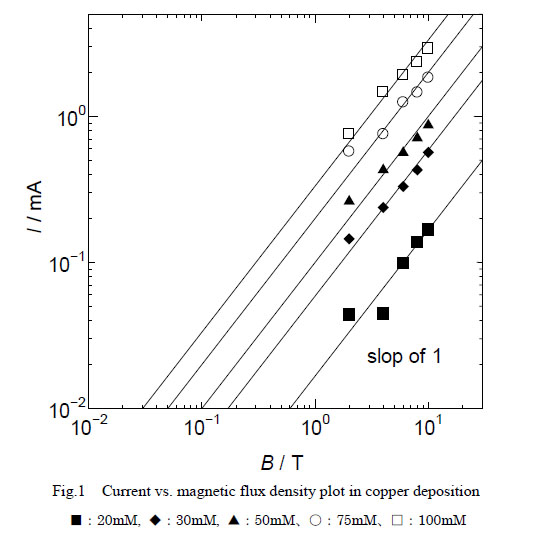
In this study, we present the disposable electronic circuit based on the pH-responsible encapsulation layer. Disposable electronic devices have been attracted because it can be discarded after we use it. This disposable property could provide advanced utilization for security, privacy issue, and implantable biochip. Meanwhile, it is an unavoidable problem that the electronic functions are deteriorated with the conventional disposable electronic device when they are exposed to water or severe circumstance. To tackle this issue, controlled disposable materials have been researched. However, it has still suffered from malfunction of the electronic device under external water. In this report, we newly developed pH-responsible encapsulation layer to overcome the aforementioned issue. The encapsulation layer could be stable and robust at acidic and neutral water environment, resulting in functioning as the expected electronic circuit without malfunction. Meanwhile, it is dissolved at base water solution and thereby, it can be totally disposed to small molecules. To prepare the pH-responsible encapsulation layer, we synthesized POC prepolymer through a condensation reaction. The POC prepolymer solution was coated to a glass substrate and then cured at elevated temperature. The cured POC film was stable at acidic and neutral water solution. However, it was totally resolved PBS buffered base water solution. We also fabricate electronic circuit on POC film substrate. It can be functioned when it is folded below 25 mm of bending radius. Finally, we studied a synthesis of a novel pH-responsible film of POC and investigated dissolving mechanism under PBS buffered water solution.
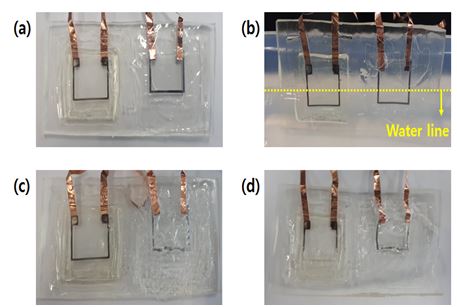
In this study, we demonstrate the effect of polymer guest of the inkjet printing of OLED device. Inkjet printing of OLED materials has been an attractive process because of on-demand pixel formation, resulting in less using OLED materials. However, it is challenging to obtain the highly uniform thin film quality similar to the one achieved by a conventional thermal evaporation process. Due to the coffee ring effect, an inkjet-printed ink droplet evaporates non-uniformly, leading to coffee rings. To control the coffee ring effect, we investigate the effect of UVO treatment of the substrate surface, the temperature of baking, and a solvent mixture of inks solution. To do this, we prepared home-made inkjet printer. This printer has 16 nozzles of inkjet head and exhibits dispensing 10 picoliters of an ink droplet from each nozzle. We also prepared pixel bank layer of 80 ppi pixel resolution. The OLED inks were filled in the pixel banks accurately by using our homemade inkjet printer. We varied the inkjet printing speed, ink droplet spacing, and waveform of piezo pump of inkjet nozzle in order to explore the thin film quality. It was observed that ink droplet itself was significantly affected by waveform of piezo pump. By varying waveform of piezo pump, the outgoing velocity, diameter, and satellite of ink droplet was changed. Moreover, the thin film quality of ink droplet depended on the spacing ink droplet. From this, we obtained thin film of OLED with uniformly controlled surface. Finally, we studied organic thin film layer, deposited by an inkjet printer, with the 3D surface analyzer and atomic force microscope.
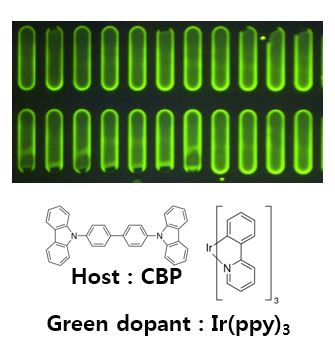
Since the ferroelectric state of a chiral smectic C (SmC*) phase stabilized in a thin flat glass cell was reported, SmC* materials have been attracting a great deal of attention due to possibilities for electro-optic devices such as displays with higher responsivity than present displays consisting of nematic materials. Although the ferroelectric states of the SmC* phases in the thin flat glass cells have been well investigated, the induction of ferroelectricity in spherical microcapsules has not been reported yet. A variety of liquid crystalline (LC) microcapsules can be precisely fabricated by using glass capillary microfluidic devices, which enables us to fine-tune the shell thickness. The difficulty of the fabrication of SmC* microcapsules is attributed to their high viscosity owing to the order of molecular layer in the SmC* phase. To apply the LC materials with high viscosity to the microfluidic devices at room temperature, we developed a new method. We named this method “ELIXIR method” in which the LC-to-isotropic (Iso) phase transition is induced by the addition of a certain volatile organic solvent “elixir.” Here, we present the fabrication of SmC*microcapsules using ELIXIR method and the molecular alignment there.
For the first time, we successfully fabricated SmC* microcapsules with about 15-μm shell thickness at room temperature by using acetone as the elixir (Figure). The addition of acetone induces the SmC*-to-Iso phase transition so that the viscosity of the SmC* material becomes suitable to the microfluidic fabrication. Moreover, we successfully align the molecules by dissolving acetone in the outer aqueous phase for annealing. The obtained SmC* microcapsules show broken fan-shaped textures with periodic stripes (Figure) that come from the helical structure in the SmC* phase. We will try to unwind the helical structure to induce a ferroelectric phase in the future.
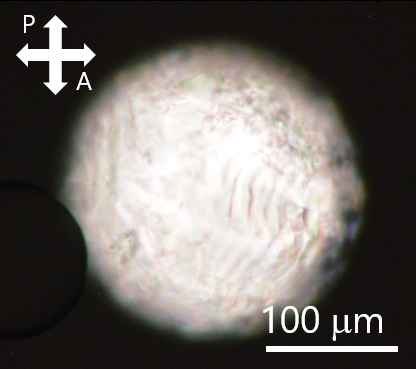
In recent decades, metal nanomaterials for printing technologies has been widely investigated to develop compact, lightweight and cost effective electronic device such as solar cell, organic light emitting device, and thin film transistor. Among various metal nanomaterials, copper nanoparticle has attracted considerable attention due to its excellent electrical conductivity (~105 Scm-1) and thermal conductivity as well as relatively low cost compared with other metal nanomaterials. Despite these merits, it is limited for practical use owing to its easy oxidation in ambient condition. To prevent oxidation of copper, several groups have suggested such as coating with air stable materials (novel metal, organic surfactant, and carbon). However, this approach required expensive and complex process as well as it is necessary to remove protective layer when it applied to electrical circuits.
There have been many studies to prevent corrosion of steel by cathodic protection effect of electro-conducting polymer. In particular, Grgur groups reported polyaniline (PANI) are effective for anti-corrosion of steel when it was introduced to steel, because there was oxygen reduction reaction on the PANI instead of corrosion of steel.
Herein, we report novel approach to improve air-stability of copper by cathodic protection effect induced from copper/PANI composite. At first, PANI with emeraldin based (EB) form was prepared by self-stabilized dispersion polymerization. Subsequently, copper was deposited on PANI-EB powder by a wet reduction method to synthesis copper/PANI composite. The characterization such as morphology, microstructure, and conductivity of resulting composite was analyzed. In addition, the effect of PANI on air-stability of copper was also demonstrated.
In this study, we synthesized parallel carbon nanowall and fabricated anisotropic conductive films by transfer process. The parallel CNW can have electrical resistance anisotropy, and its application to ACFs could be expected. However, in our previous study, the electrical resistance anisotropy of parallel CNWs is insufficient for application to ACFs. Therefore, we tried to improve the electrical resistance anisotropy by transferring CNW and removing the underlayer.
The synthesis of CNW was carried out using ECR plasma CVD. Carbon monoxide and hydrogen gas wwere introduced into the system and decompressed to 50 Pa, high density plasma was generated by 2.45 GHz microwave and the magnetic field of 875 G created by the coil. CNW was synthesized on a SiO2/Si substrate placed in the lower part of the waveguide.
The synthesized CNW was transferred to a quartz glass plate using an adhesive.
Etching of CNW underlayer after transfer was performed using ECR plasma. Using the same apparatus as CNW synthesis, Ar and H2 were introduced at a ratio of 2: 1, pressure 50 Pa, microwave 2.45 GHz, magnetic field density 875 G and ECR plasma was generatedand etching was performed.
In order to measure the properties of CNW as ACFs, the transmittance and the electrical resistance were measured at each etching time, and the electrical resistance was measured using the four-probe method.
Since the substrate is colorless and transparent, it is considered that the change in transmittance of CNW corresponds to the change in deposited carbon, and the electric resistance change with etching time is compared with the change in transmittance. It was shown that the amount of change in electrical resistance per etching amount was larger for transferred CNW than that of untransferred one, which suggested that the contribution to the electrical resistance of the underlayer was large.
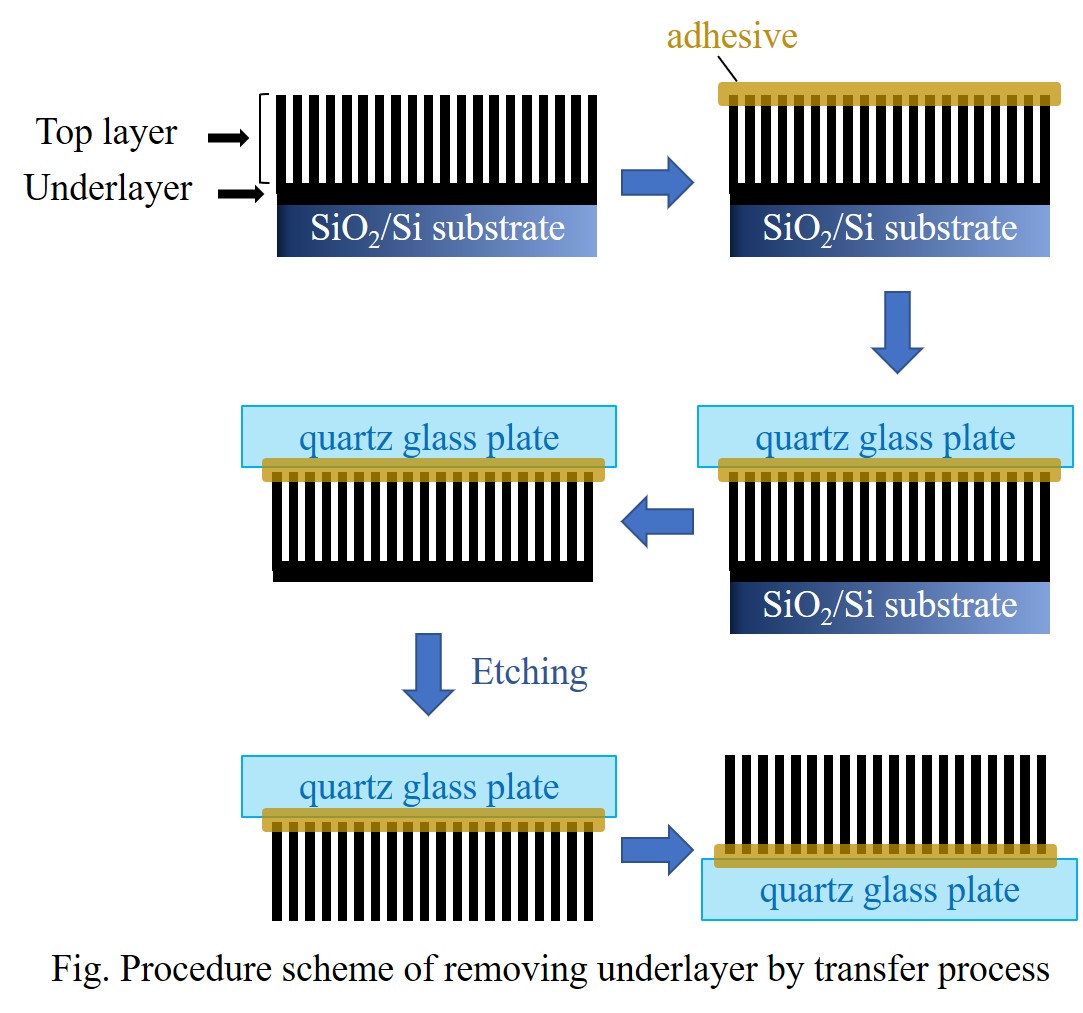
Health monitoring has been an important issue in modern life. Among many media for health monitoring, sweat is a good one because it is rich in many chemicals from our bodies and offers a non-invasive way for sampling. In this study, we develop a printed and wearable device for sweat ion sensing with AC sources, and the data can be transmitted to smartphone by Bluetooth.
The wireless sensor contains a pair of interdigital electrodes, a signal IC processor, and a wireless transmitting circuit. The relationship between the AC impedance of the electrode and the ion concentrations in sweat is first characterized as a calibration curve. The electrode is then connected to a portable and wireless impedance measurement system to realize real-time monitoring. A skin-affinitive microfluidic system will be fabricated to effectively collect sweat on skin for the AC analysis, or salt concentration measurement. Effects of water evaporation, applied AC frequency, and applied voltages, on the accuracy or sensitivity will also be examined carefully to optimize the sensing system. In summary, this study demonstrates the possibility of applying AC measurements to detect total ion concentration in sweat, and the versatile sensing platform can be further extended to other wireless detection systems.
The present study reports the effect of copper (Cu) doping in CdS QDs to improve the photoelectrochemical performance of quantum dot sensitized solar cells (QDSSCs). Cu-doped CdS photoelectrode was prepared by successive ionic layer adsorption and reaction (SILAR) method on FTO substrate and used directly with CuS counter electrodes (CEs) and a polysulfide electrolyte. The changes observed in the diffraction patterns of Cu-doped CdS thin films suggest that Cu dopant can introduce increased disorder into CdS material structure. The surface morphology of Cu-doped CdS photoelectrode indicate that the fragments are uniformly distributed with high crystallinity. The photovoltaic current density – voltage (J-V) characteristics of Cu-doped CdS photoelectrode shows the specific improvements in open circuit voltage decay (Voc), short-circuit current density (Jsc), and fill factor (FF) under the illumination of one sun (AM 1.5 G, 100 mW cm-2), which is higher than the values of undoped CdS thin film based QDSSCs.
Light-emitting electrochemical cells are the future generation of flat-panel displays and solid state lighting sources. Compared to conventional solid state lighting device such as organic light-emitting diode (OLED), light-emitting electrochemical cell (LECs) possess simple device architecture and air stable electrodes makes LECs more impressive. Mainly LECs are two types, p-LECS and Ir-ITMCs. Currently much research has been focused on cationic iridium complexes due to the phosphorescent, color tuning and an ionic nature of Ir-ITMCs. However, the source and expensive nature of iridium demands new emitters in LECs. Recently non-ionic small molecule light-emitting electrochemical cell were reported by Tang et al. The molecule which is an ionic apart from Ir-ITMCs has great attentions. We designed and synthesized an ionic small molecule having strong luminescence and good charge transporting capabilities. A complete structural, photophysical, electrochemical and electroluminescent properties were investigated. Blue light- emissions were achieved by applying the target compound in a LEC device.
The ability to monitor cardiovascular system in real time is essential for patients with cardiovascular diseases. Electrocardiograph (ECG) usually becomes the first choice to provide an important information for monitoring. Flexible pressure sensors have attracted great interests in recent years due to their multiple applications including touch screens, electronic skins and biomedical diagnostic sensors. Many groups have contributed to increasing sensitivities of flexible pressure sensors over the past decades. However, the flexible pressure sensors are still limited to low sensitivity and spatial coverage on detecting targets. The aim of this paper is to present the flexible capacitive pressure sensors with high sensitivity that are able to measure the small magnitude of contraction. To detect such subtle movement, capacitive sensors therefore require a dielectric material which can be easily compressed resulting a quickly respond and release for pressure sensing. The sensitivity of capacitive pressure sensor can be improved by integration of micropatterns on the contacted surface. The dielectric micropatterns can be generated by using photolithographic technique to enhance the precision and consistency. Different potassium hydroxide (KOH) etching conditions were tested to obtain multiple size of pyramidal pits on silicon molds. In this study, we used the polydimethylsiloxane (PDMS) as a flexible dielectric material, therefore, the pyramidal micropatterns can be easily transferred from the silicon mold. These pyramidal micropatterns have the features with a base from 10.45 to 63.31 μm, periodic spacing from 6.87 to 50.16 μm, and with sharp or blunt tips. The dielectric film with micropatterns was coated with silver nanowires or ITO as the electrode and sandwiched between PDMS or PET substrates. The results demonstrate that the sensitivity of the capacitive pressure sensors increased with pyramidal micropatterns. We believe this flexible capacitive pressure sensor has potential to become a powerful tool for implantable medical applications.
Polyimides are already widely used in aerospace, automobile, electronics and other high-technology areas based on their excellent mix of properties. Expectations are that colorless polyimides will rapidly take hold and that their use will encompass what we now consider to be futuristic applications. The trick is to come up with the right combination of building blocks, creating a recipe where the formulations are not only developed, but are balanced and optimized. We herein report on a new class of polyimide (PI) nanohybrid substrates based on highly fluorinated asymmetric diamines as a building block of PI backbone structure. The resulting PI nanohybrids were highly soluble in polar aprotic solvents and displayed excellent optical properties, including high transparency (>91% at 400 nm), low refractive index (<1.5589), and very small birefringence (<0.0025 at 637 nm). The results provide useful information for designing molecular architectures for manufacturing high-performance flexible substrates in future display devices.
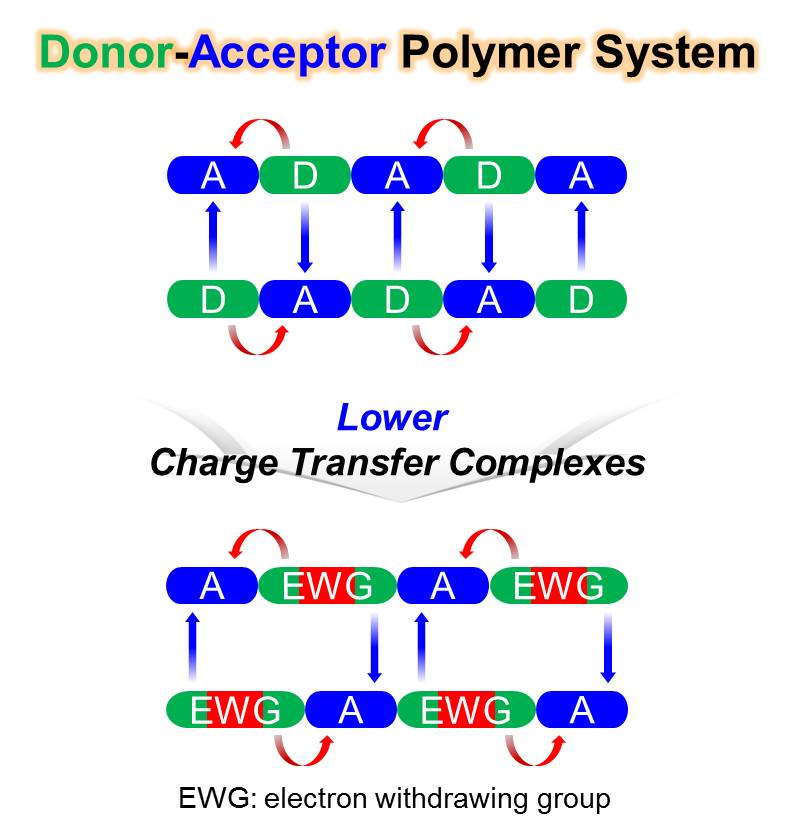
Here, highly stretchable and transparent UV cured poly (urethane-acrylate) elastomer has been synthesized by reacting urethane acrylate oligomer and reactive diluents monomers. The synthesized elastomers can be stretched up to 600% and have high transparency of over 90% transmittance. The morphology of poly (urethane-acrylate) elastomers was characterized and evaluated by FTIR and XRD as well as the thermal properties were examined and analyzed by TGA and DSC. The mechanical, optical and surface properties were analyzed by UTM, UV-Vis spectrophotometer. To verify the applicability of the poly (urethane-acrylate) elastomer, 3D printing, polymer ionic conductor and UV cured foam were studied. The elastomers are evaluated as the best materials for not only conventional applications but also for new applications.
Alkaline water electrolysis (AWE) is anticipated as an important technology for conversion of electric energy generated from renewable energy obtained from wind power and solar power to hydrogen gas. To improve the hydrogen production efficiency of AWE, characterization and control of bubble generation behavior near electrodes is important. This study developed a system for measuring microbubble generation behavior on electrodes using a combination of microscopic technique and a high-speed video camera. The relation between the hydrogen or oxygen bubble size and the current density – electrode potential curve was investigated using electrodes of different diameters.
Three-electrode electrochemical cell experiments were conducted using nickel wires (0.3 or 0.1 mm diameter) as working electrodes, nickel rods (3 mm diameter) as counter electrodes, and a reversible hydrogen electrode (RHE). The electrolyzer was made of polyvinyl chloride, with four sapphire windows covered by PMMA. Electrolytes were 2 M KOH. Generation behavior of micrometer size bubbles of hydrogen and oxygen near the working electrode was recorded at 12,000 frames per second with full resolution using a high-speed video camera. Cyclic voltammetry was used at a 10 mV/s scanning rate using an electrochemical measurement system.
Results show that oxygen bubbles formed from anode electrodes are 40–300 μm. Hydrogen bubbles formed from the cathode electrode are 30–100 μm, and are smaller than oxygen bubbles, although the hydrogen generation volume is twice that of oxygen. Oxygen and hydrogen bubbles become larger with both the current density and electrode diameter. Oxygen bubbles on the anode electrode coalesce and become large especially under high current density conditions.
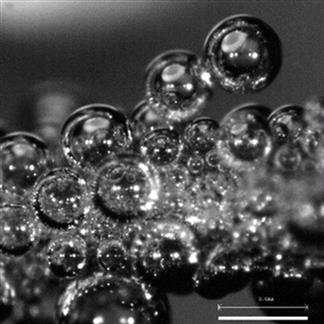
Organic thin film transistors (OTFTs) have been established as one of the most promising materials for future thin, lightweight, and flexible electronic devices. Device performance is strongly dependent on the molecular structure, morphology, and properties of the thin films of organic semiconductors from which they are formed. Because conventional methods for the deposition of organic thin films including vacuum deposition methods and solution methods have some drawbacks, new approaches are required to produce high-quality thin films with large grain sizes and smooth surfaces. We have proposed a novel and simple deposition technique of organic thin films by rapid expansion of supercritical solutions (RESS) using CO2, as shown in Fig. 1, and have successfully produced thin films of some organic semiconductor materials on SiO2/Si substrates. Furthermore, a fabricated top-contacted OTFT with a tetracene or TIPS-pentacene layer was activated. However, carrier transport characteristics of the current OTFTs using RESS are not good enough for practical application. One of the reasons for the low carrier transport characteristics is that the thin films produced by RESS are polycrystalline thin films. Improvement of carrier transport characteristics of the OTFTs, therefore, is one of the important approaches for practical application of RESS.
In this work, we focus on Ph-BTBT-10 as a TFT material because the TFT using polycrystalline thin films shows high mobility. We report deposition of Ph-BTBT-10 thin films on SiO2/Si substrates by RESS using CO2, and the crystal and electrical characterization. Scanning probe microscopy showed that the thin films consist of a high density of submicron-sized grains. X-ray diffraction showed that the thin films had regular arrangement structures in both the horizontal and the vertical directions of the substrate. A fabricated top-contacted OTFT with the Ph-BTBT-10 active layer showed p-type transistor characteristics with a field effect mobility of more than 0.1 cm2/V s.
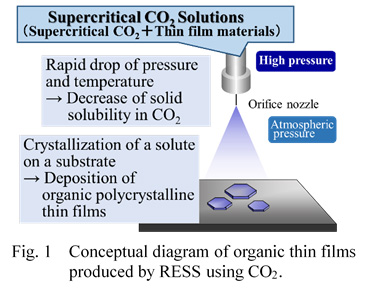
Glucose biofuel cells (GBC) using glucose and oxygen fuels are devices converting chemical energy of the fuels to electrical energy with an addition of the biocatalysts containing enzyme molecules. Since the GBC can be operated even in physiological conditions, the glucose and oxygen that are included in human body can be utilized as the fuels for the devices embedded into human body. However, critical problems to be solved still remain. In particular, its slow reaction rate should be improved. To do that, the use of mediator may be an appropriate solution. With the introduction of the proper mediator, electron transfer rate for the anodic and cathodic reactions can increase. To optimize the electron transfer rate and explain the electron transfer mechanism, a new electron transfer mechanism dubbed as a mediator embedded electron transfer (EMET) is introduced. With the mechanism, the target mediator, which can show outstanding benefits, is well immobilized on the enzyme and substrate materials. In this conference, I will explain the related electron transfer theory, the synthetic procedure of corresponding biocatalysts and the configuration and performance of GBC utilized.
To keep high energy conversion efficiency under variable electricity demand/supply is a highly important requirement for next-generation energy system which includes energy conversion processes. While SOFCs are expected to have high efficiency, they cannot avoid the drop in fuel utilization under abrupt output change.
We proposed pulse jet solid oxide fuel cell (PJ-SOFC) which adopts the direct supply of liquid fuel via injector set below the anode. PJ-SOFC can keep high fuel utilization even in steep output power variation because it can change the gas atmosphere around the anode locally even with a small amount of fuel.
We have discussed the relationship between electrochemical/thermochemical reactions and the gas atmosphere around the anode, but the power generation property with steep output variation was not discussed, and the availability of PJ-SOFC as a load-followable SOFC was not evaluated.
In this research, we investigated the influence of operating condition for anode degradation quantitatively to realize stable operation under variable output with keeping high fuel utilization. Also, the advantage of PJ-SOFC for load following was discussed based on the actual data of the smart grid system “Ene-Swallow” developed at our laboratory and implemented at TokyoTech.
The power generation properties were investigated by electrolyte supported coin cells with YSZ electrolyte. Anode material was Ni/YSZ (3:2 wt%) and Ni/GDC(3:2, 1:1 wt%), and cathode material was LSM/ScSZ. Power generation was conducted at 900 °C with fixed fuel utilization as 60%.
Maximum power density was achieved 239 mWcm-2 with Ni/GDC(3:2). Better performance and stability were obtained with Ni/GDC(3:2) than Ni/YSZ(3:2). Higher stability was achieved with Ni/GDC(1:1) whereas higher power density was achieved with Ni/GDC(3:2). Step response was demonstrated and 1.3 times of output change, from 80 mWcm-2 to 105 mWcm-2, could be achieved in a moment without causing fuel utilization decrease.
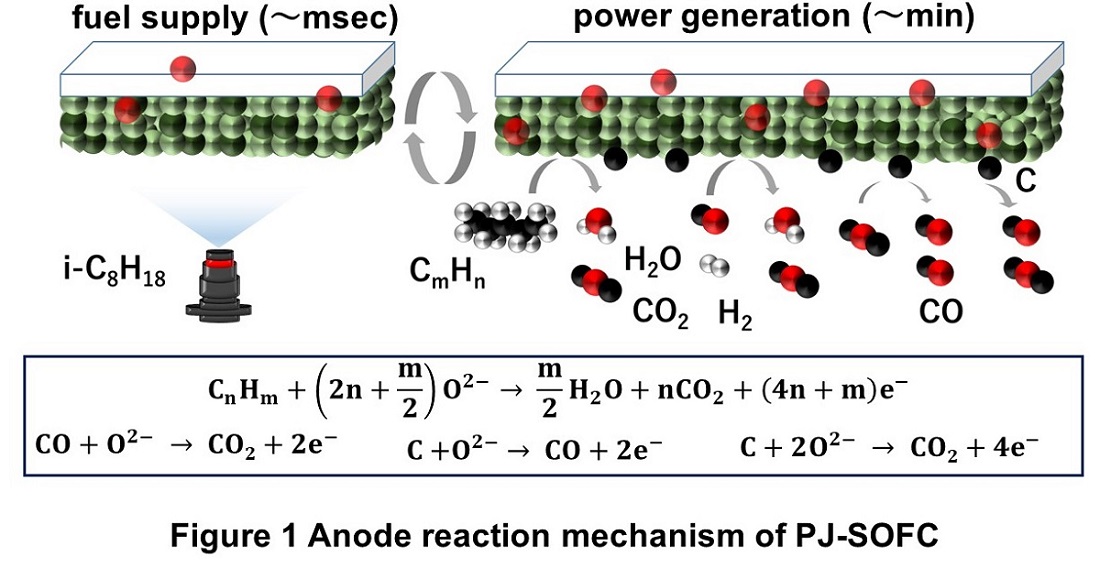
Water treatment using membranes forms a key technology for solving water shortage and pollution worldwide. Some advantages of purifying water with membrane technology include low energy and small space requirements. Fouling which causes a reduction in separation performance and shortens membrane life is a serious problem to be solved. Although surface modification with a hydrophilic polymer such as zwitterionic polymer is effective for antifouling, there is no design guideline concerning membrane surface modification due to difficulty in controlling the molecular weight and density of the modified polymer during the membrane fabrication.
Here, we propose a precise surface modification method for the water treatment membrane(Fig. 1) and evaluate the influence of graft density and length of modified polymer on fouling phenomena using the prepared membrane.
In our suggested approach, poly(2-Methacryloyloxyethyl phosphorylcholine) (polyMPC) is synthesized initially by atom transfer radical polymerization(ATRP). Then, glycidyl methacrylate is grafted to the pores of polyethylene terephthalate(PET) as the reaction point of polymer immobilization, using plasma graft polymerization, followed by the immobilization of pre-synthesized polyMPCs by Click reaction. The key advantages of this concept are that polymers with pre-determined molecular weight and narrow molecular weight distribution can be effectively introduced into the pores. Furthermore, the density of the polymers inside the pores can be controlled by considering the structure of polymer chains in each solvent during Click reaction. Surface modification was confirmed by weight change observed for the membrane before and after the Click reaction and PET membranes modified by different molecular weight polyMPCs having different densities were successfully fabricated.
Permeation test of Bovine Serum Albumin solution though the prepared PET membranes was performed using a dead end filtration system. The PET membrane modified using high molecular weight polyMPC with high density showed highest flux recovery ratio, namely such surface modification of membrane is effective for antifouling.
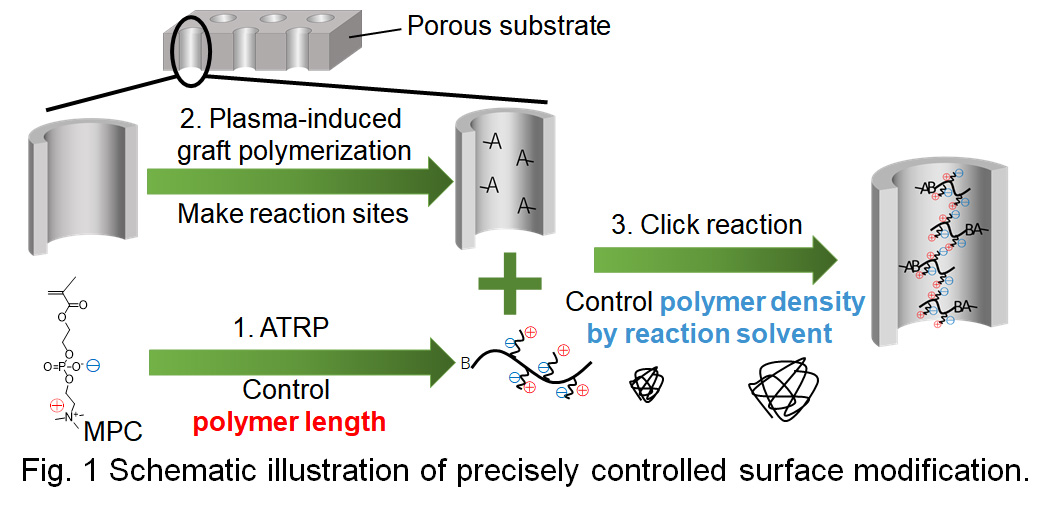
Membrane fouling is a severe hindrance to the effective application of reverse-osmosis (RO) process. For enhanced anti-fouling properties, majority efforts toward membrane surface modification have focused on rendering the surface more hydrophilic, smooth, and less charged, which prevents the foulant from contacting with membrane surface (“fouling resistant”). Probably, weakening the interfacial interaction between membrane and foulants is another strategy to tailor membrane anti-fouling characteristics, which makes adhered foulants easier to be removed (“fouling release”). Therefore, in this study, a new amphiphilic block polymer combining fouling resistance with fouling release features was synthesized by using [(2-methacryloyloxy)ethyl]dimethyl[3-sulfopropyl]ammonium hydroxide (MEDSAH) and 2,2,2-trifluoroethyl methacrylate (TFEMA) and grafted on polyamide (PA) RO membrane surface by dual surface-initiated atom transfer radical polymerization (SI-ATRP) reaction (Scheme 1). The surface composition, membrane morphology, surface hydrophilicity, and surface energy were assessed for the evaluation of the fouling resistance and fouling release potential of the membrane modified with the amphiphilic block polymer (PA-g-M-F). The long-term sodium alginate filtration experiment results indicated that compared to the pristine membrane (PA), PA-g-M-F membrane showed lower water flux decline and higher water flux recovery, remaining high stability.
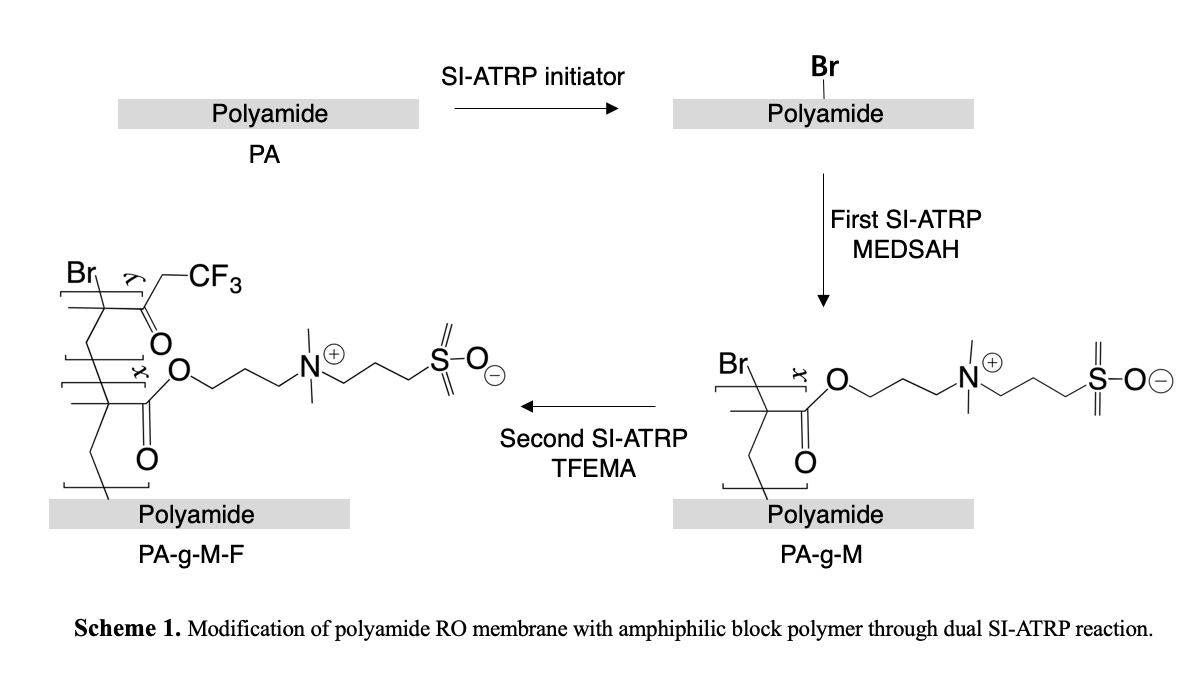
Polymer composite materials are the subject of extensive studies because of their novel and excellent properties compared to their constituent materials. Dispersion stability of sub-micron sized particles in the medium is an important research theme from the point of colloidal views. And also, these particles are often used to synthesize polymer composite materials using resins and gels as matrix. Herein, dispersion of nano-materials, such as nano particles, in the matrix polymer is one of the most important problems to enhance their mechanical properties. We tackled this problem to carry out surface modification of the nano-materials, such as polymer particles or carbon nano tubes (CNTs), using amphiphilic polymers, poly-N-vinylacetamide (PNVA), synthesized thorough radical polymerization. Hydrogen bond worked between PNVA onto the modified nano-materials and hydrophilic matrix, such as polyvinyl alcohol (PVA) and nylon, to improve surface adhesions and dispersions of the nano-materials in the matrix. As a result, the mechanical properties of their composites were strengthened. When CNTs were used in PVA, the transparency of the composite was also increased owing to improvement of their dispersions. Additionally, if the CNTs formed the networks in the composites, the highly conductive and transparent composite polymer films were fabricated.
This study presents newly-developed simulation method of flow in twin screw extruder. This method based on the Hele-Shaw flow model and finite element method, and applicable wide range of screw geometry without empirical parameters. Moreover, the Hele-Shaw flow model reduced the number of unknown variables dramatically and calculation time. The simulation results of degree of fill, fiber attrition, and devolatilization phenomena were experimentally validated.
"Current energy and environmental issues, alongside the depletion in fossil fuels, have increased the demand for the use of sustainable energy carriers. Electrochemical water splitting can produce hydrogen from naturally abundant water and is a clean and cost-effective energy conversion process. However, the anodic oxygen evolution reaction (OER) in the water splitting process has a large overpotential; thus, there is a need to develop highly active and inexpensive electrocatalysts for OER to overcome this barrier. Perovskite-type metal oxides with the general formula ABO3 have attracted great interest due to their excellent OER activities, facile synthesis and environmental friendliness. Several Fe-based perovskite-type OER catalysts have been previously reported, but most of these studies focused on the choice of the A-site metals. In contrast, the effects of crystalline structures and elemental compositions of catalysts on OER activity have not yet been systematically investigated, but the knowledge is crucial for the efficient design of electroactive materials. Herein, we synthesize a variety of Fe-based oxides with the general formula AxFeyOz (A: Ca, Sr, Ba) (Figure 1A) and investigate them to find promising OER electrocatalysts and to elucidate the structural and compositional effects on the OER activity. Ca, Sr and Ba were selected as A-site metals. Figure 1B shows the OER specific activities of the Fe-based oxides and reveals that a Ca-containing oxide was found to possess the highest OER activity among other synthesized oxides, exhibiting one of the best performances observed when compared to previously reported Fe-based oxides. These findings not only present a prominent electrocatalyst for OER, but also provide new guidelines for the design of metal oxides-type OER electrocatalysts.
Acknowledgement: This paper is based on results obtained from a project
commissioned by the New Energy and Industrial Technology Development
Organization (NEDO).
For large scale use of renewable energy, hydrogen society is necessary to overcome supply and demand mismatch in time and space. Polymer-electrolyte fuel cells (PEFCs) represent a superior system that exhibits high-efficiency, offering better power generation, meeting the desired levels of demand. However, in order to facilitate widespread use of fuel cells, cost and lifetime problems must be resolved. Solid alkaline fuel cells (SAFCs) are another system that holds the potential to achieve high-energy conversion efficiency without Pt catalysts. Although most of metal catalysts can be used under alkaline environment, development of durable electrolyte membranes in alkaline media is the key for this technology. We are systematically designing and developing new materials from the molecular level to the device level. In the fuel cell systems, different components such as membrane, catalysts, and catalyst layer share significant functions and work in a well-coordinated manner, and hence, the total cell system must be optimized for the best performance. The systematic design and developing approaches concerning materials for PEFCs and SAFCs are proposing. Specifically, pore-filling electrolyte membranes, carbon free Pt alloy porous capsule catalysts and durable anion-exchange membranes and direct liquid fuel cells are developed based on the approach. Future energy system and water electrolysis materials are also presented.
Several works reported that microwave heating can reduce production time required for activated carbon preparation. In this study, the mixture of carbonized carbon gel and KOH (mass ratio of carbon gel to KOH is 1:6) was heated by a modified microwave oven (2.45 GHz, 500 W) for 40-330 s under N2 atmosphere before being washed by distillation water. As presented in Fig. 1, BET surface area of resultant activated carbon tends to increase with an increase in microwave activation time. By using this proposed method, the large BET surface areas which are 1,007 and 2,084 m2g-1 can be achieved in the resultant activated carbon within 80 and 330 s, respectively. It has been reported that even when microwave heating is employed to reduce the activation time, the shortest record was 300 s. Such a short activation time as only 80 s to synthesize activated carbon with a large specific surface area above 1,000 m2g-1 by the proposed method is remarkable. It can be noted that bright plasma can be uniquely generated at the carbon-KOH mixture under microwave heating when the activated carbon with the large surface area is obtained. It may be considered that the carbonized carbon gel powders in contact with molten KOH may cause interfacial polarization under microwave heating, and this polarization may cause the observable plasma in the present condition, resulting in a high temperature. To date, the activation process for synthesizing activated carbon has been operated in batch system because of a long activation period. Once the mechanisms of the extremely fast activation method found in this study are clarified, a new concept of reactor design will be developed for operating in a continuous system.
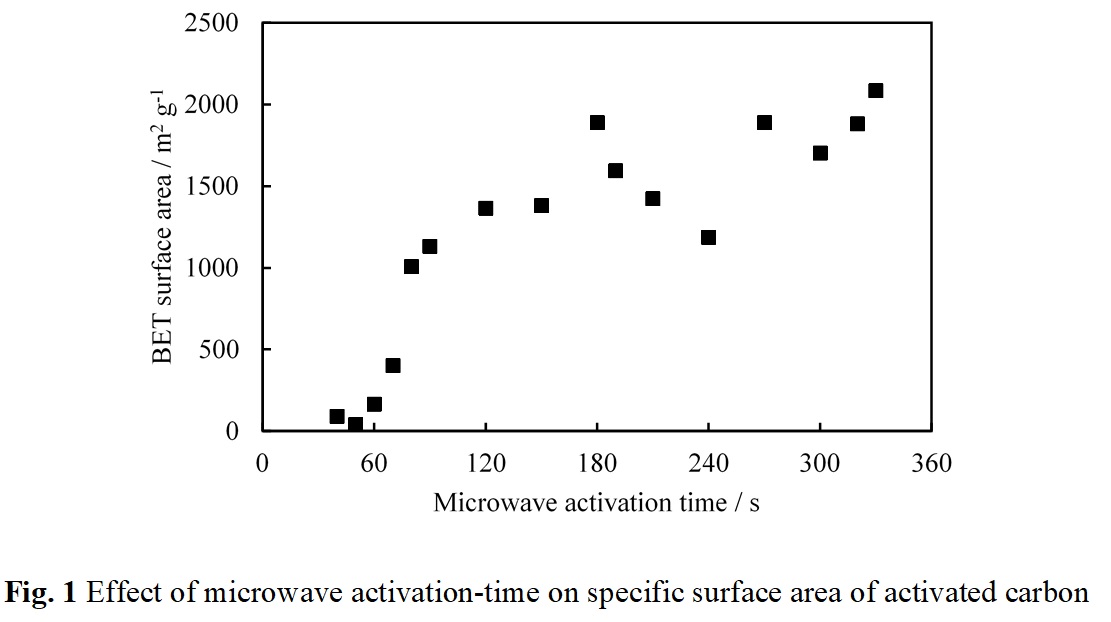
Growth of vertically-aligned single-wall carbon nanotube (VA-SWCNT) forests by the catalytic chemical vapor deposition (CVD) is an attractive method for making applications. However, the growth termination of the CNT forests is an obstacle, and the deactivation of the catalyst nanoparticles due to the structure change of the catalyst nanoparticles is thought to be one reason for the termination. In general, maintaining smaller catalyst nanoparticles which are necessary for the SWCNT growth is more difficult because the smaller nanoparticles are less stable. To realize the longer growth lifetime, engineering catalysts is crucially important. So far, Fe-Gd catalyst on Al2O3 layer was reported to realize the growth lifetime of 13 h and 22-mm-tall multi-walled CNT (MWCNT) forest at the growth temperature of 780 °C [1]. However, the growth rate is relatively low as ~0.5 μm s-1, and the possibility of using Gd for SWCNT growth was not discussed in detail.
In this work, we applied the Fe/Gd/Al catalyst to the growth of SWCNT forests, and systematically studied the mechanism behind the enhanced growth (Fig. 1a). By optimizing the catalyst condition, we achieved a high initial growth rate of ~2 μm s-1 and long catalyst lifetime of ~50 min at 800 °C. Correspondingly, the areal mass continued increasing up to ~8 mg cm-2 in 60 min (Fig. 1b). It was found that Gd layer with the thickness of less than 1 nm is effective when it is deposited between Fe and Al layers. The Raman spectra showed the radial breathing mode (RBM) peaks from the top to the bottom of the CNT forests, which suggests the continuous growth of SWCNTs.
References
[1] W. Cho et al., Carbon 72, 264 (2014).
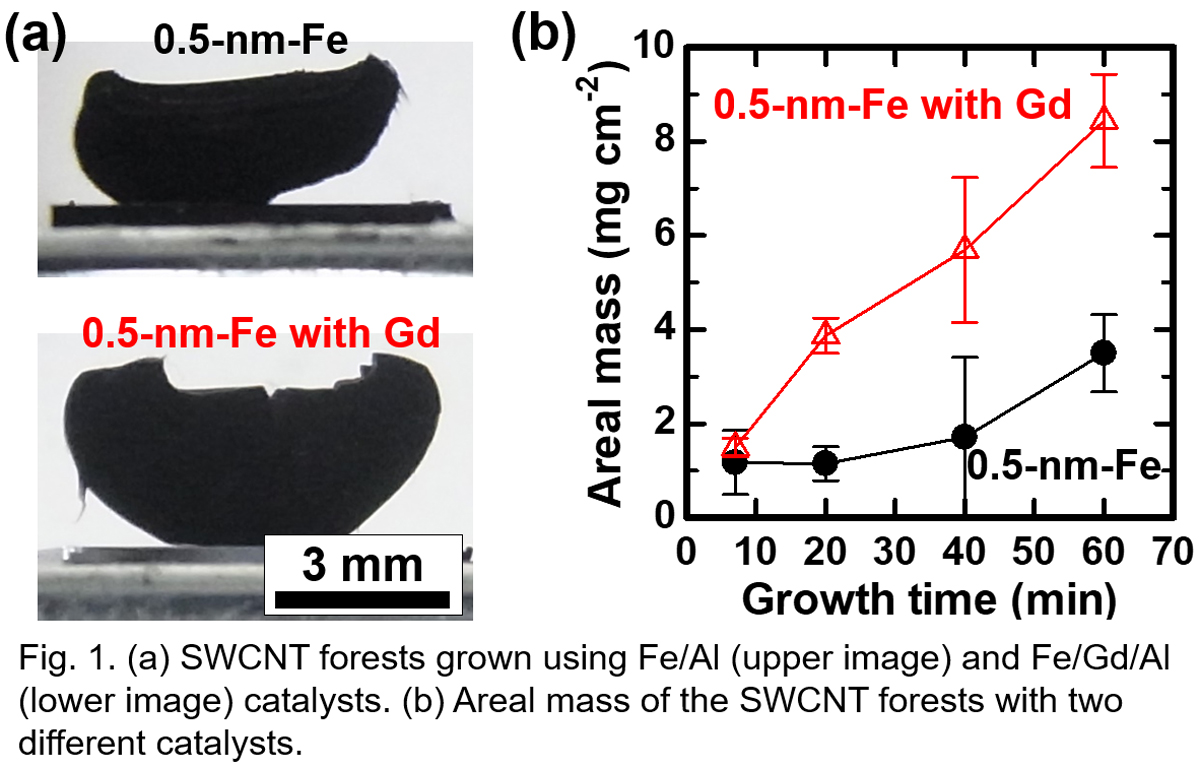
With the increasing demand for energy supply and awareness of climate crisis, green energy generation has attracted intensive and extensive research attention during the past decades. Hydrogen, as a high energy density non-carbon energy source, has been one of the spotlights and its green production has been one of the top research topics in scientific community. Among the many existing hydrogen generation processes, electrolytic water splitting (H2O → H2 + 1/2 O2) driven by renewable energies is considered by many an everlasting process for hydrogen supply. The most concerned issue of this process is its disadvantageous production cost as compared with competing technologies, such as steam reforming of fossil fuels. Electricity accounts for more than 50 % of the production cost for electrolytic water splitting. Consequently, extensive efforts have been devoted to develop more efficient catalysts to lower the over-potential and thus electricity consumption of the process to strengthen its competiveness. To function well as an efficient catalyst for electrolytic water splitting, not only material but also nanostructure are critical. In this presentation, several recent examples from our lab are offered to illustrate the point.
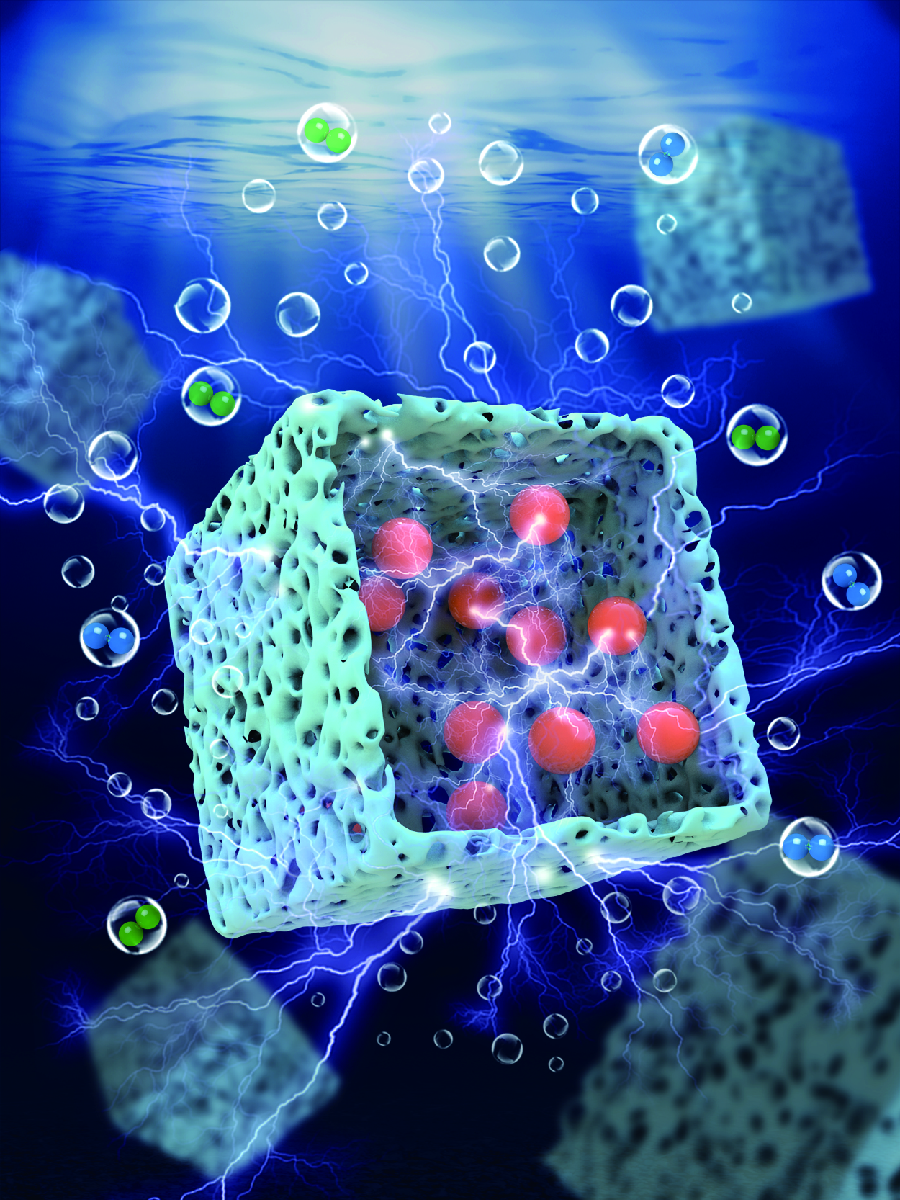
Titanium dioxide (TiO2) photocatalysts have been extensively studied for water treament, air purification and antibacterial. Due to it has many properties such as chemical stability, electronic properties and especially strong photocatalysts. However, TiO2 should be irradiated with ultraviolet (UV) radiation for photocatalytic activity. In this study, Ag doped Titanium dioxide (Ag-TiO2) was synthesized by a wet ball milling sol-gel method (WBMS). Various amount Ag/TiO2 molar ratio from 0% to 10%. To study phase transition and crystallite size of Ag-TiO2 from X-ray diffraction (XRD). The particle size, surface area, morphology and electronic properties synthesized of Ag-TiO2 were determined by transmission electron microscopy (TEM), Brunauer-Emmett-Teller (BET), Scanning electron microscopy (SEM) and UV-vis diffuse reflectance spectroscopy. Photocatalytic activity and antibacterial were also investigated. The results demonstrated that when Ag/TiO2 molar ratio increased from 0% to 10%, the doping of Ag promoted the phase transformation and and inhibited crystallite size of Ag-TiO2. At 5% Ag-TiO2 showed the small particle size and, crystallite size and also presented the highest surface area. Intensity of surface plasmon absorption (SPA) peak of Ag-TiO2 increased and their peak position shifted to a longer wavelength range. Furthermore, back scatter electron microscopy (BSC) confirmed silver nanoparticle deposited on surface of TiO2 powder. The photocatalytic activity degradation of methylene blue (MB) of Ag-TiO2 increased from 1.12×10-3 to 1.62×10-3 min-1 when increasing of Ag/TiO2 molar ratio from 0% to 5%. When Ag/TiO2 molar ratio was increased more than 5% the photocatalytic activity decreased. The optimal 3–5% Ag-TiO2 for antibacterial was found high antibacterial for Escherichia coli (E. coli) and Staphylococcus aureus (S. aureus) under visible light.
Manufacture of Composite Materials for Bullet-proofing Helmets Using Multi Reinforcement Based on Epoxy Resin
Tania Natasha Dharmakusumah1*, Asep Handaya Saputra2
1tania.natasha@ui.ac.id; E-mail: taniadharmakusumah@gmail.com
2asephandaya@gmail.com
In recent years, Indonesia has faced many military challenges which are the center of attention of the military defense industry. Military Defense industry players in Indonesia such as BUMN (State-Owned Enterprises) and private companies, need new innovative material technology to make military equipment components such as bulletproof helmets that are light and practical so as not to disturb the mobility of military personnel. For this reason, this study uses composite materials consisting of multi reinforcement, such as carbon fiber and Kevlar, and epoxy resin as a matrix. The method of making is done by an open molding technique, hand lay-up. The choice of reinforcement with the right number of layers must be done to see the performance of carbon fiber and Kevlar to form a composite material that has bullet resistance, through Barcol hardness test and ballistic test. To find out how many layers are needed for one specimen by calculating the thickness. The factors that influence the thickness calculation are tensile strength values, the average resistance force of composite material specimen, cross-sectional area, and kinetic energy produced by bullets. The calculation results will be tested through ballistic tests using weapons and bullets that are in accordance with the National Institute of Justice Standards for bulletproof helmets.
Keywords: Carbon fiber, Kevlar, epoxy resin, hand lay-up, ballistic helmet
Silica aerogel is regarded as one of the most promising thermal insulating materials due to its extremely low thermal conductivity. The porosity higher than 90% and the pore size smaller than micron scale make the thermal conductivity lower than that of air. The bottleneck to the practical application of silica aerogel is its mechanical fragility. In this study, the composite aerogels comprised of individually crosslinked silica and chitosan networks were fabricated and their thermal insulating properties were investigated.
Silica sol was prepared by hydrolyzing methyltrimethoxy silane (MTMS) in an acetic acid aqueous solution containing cetyltrimethylammonium bromide (CTAB), urea and chitosan. Then glutaraldehyde (GTA) was added and the solution was heated to accelerate the crosslinking of chitosan with GTA and the gelation of silica. The obtained composite hydrogel was converted to aerogel via supercritical CO2 drying. The balance between the rates of crosslinking of chitosan and gelation of silica was the important factor of obtaining the uniform composite aerogel. The composite aerogels had the smaller average pore sizes and more uniform pore size distribution than the silica aerogel without chitosan. The thermal conductivity of the composite aerogels was nearly the same as that of the silica aerogel. The bending elastic modulus of composite aerogels was slightly higher than that of silica aerogel.
Calcium phosphate ceramics, such as hydroxyapatite (HAp: Ca10(PO4)6(OH)2) and β-tricalcium phosphate (β-TCP: β-Ca3(PO4)2) have been applied as bioactive and substituted materials for hard tissues in dental and medical fields due to excellent biocompatibility and osteoconductivity. For bioceramics, it will be very important to have absorption capability of biomaterials incorporated into bio-metabolic system because solubility absorption or giant cellular absorption may be indispensable for bioceramics harmonized with bone remodeling. The partial dissolution- precipitation with supersonic treatment is a convenient wet synthesis technique adding biomimetic characteristics for surface modification of biomaterials. Supersonic wave can bring bubble cavitation and make hot spot. So, many chemical reactions are activated by the formation of radical groups and the locally rising temperature. The purpose of this study is to investigate surface structure and nature of modified porous ceramics and to clarify the absorption characteristics in animal experiments. Commercial β-TCP products were modified to functionally graded calcium phosphate ceramics by the partial dissolution–precipitation (PDP) technique, which involved a supersonic treatment at 120 W and 38 kHz in 2% HNO3 solutions containing Ca2+ and PO43– ions. The dissolution efficiency of porous β-TCP ceramics drastically increased with time, depending on the porosity of ceramics. Enhancement of micro-pores and propagation of nano-cracks were recognized by the supersonic treatment for 7 min. After the specific PDP technique, HAp nano-crystals were precipitated all over the pore wall surfaces in macro- and micro-pores of the ceramics. The β-TCP and PDP-TCP ceramics were implanted into the subcutaneous tissues of back parts in 4 week-old Wistar rats. At 3 weeks after the implantation, the PDP-TCP ceramics showed more numbers of osteoclast like giant cells and better affinity for body fluid than original β-TCP ceramics. Based on these results, it was found that PDP-β-TCP ceramics would be one of bioactive scaffolds inducing good giant cell-absorption.
The control of the interface of micro and nano-composite materials are essential for developing environmentally benign methods for manufacturing microcapsules for Drug Delivery Systems (DDS). However, toxic organic solvents and multiple steps were often used which were unsuitable for manufacturing microcapsules for DDS in conventional methods. Here, we will talk about new methods we developed to control the interface of micro- and nano-composite particles and bubbles using a high pressure techniques. These methods used pressure-induced phase separation using super critical carbon dioxide (scCO2) solution and ultrasound irradiation under high pressure conditions. Some medicine, such as Levofloxacin were used as core materials and polymers having pH-responsive functions such as Eudragit E100 or L100 were used as coating materials. The coating materials were dissolved in scCO2 solution containing a co-solvent. As the pressure of the high pressure cell slowly decreased into atmospheric pressure, microcapsules were formed in the cell. The structure of the microcapsules was observed by SEM equipped with an electron probe microanalyzer (EPMA) devices. In order to confirm the absence of co-solvent in the capsule, we used the FT-IR. In the later part of the talk, we will introduce a novel method for producing and quanitfing micro- and nano- bubbles. These micro- and nano- bubbles were produced in a specially designed high pressure cell equipped with an ultrasonication horn located in the vessel. This technique is unique as micro phase separation between the high pressure gas and liquid interphase can be achieved through direct sonication, leading to the enhancement of micro- and nano- sized bubble production. The characterization of the mico- and nano- bubbles as well as its comparison with other conventional methods and possible future applications will be discussed.
Gold nanomaterials are of technological importance in catalysis, photovoltaic conversion, sensing, and biomedicine. The attractiveness of gold nanomaterials lies in their unique surface plasmon resonance phenomenon, which arises from the collective oscillation of surface electrons when the materials interact with incident electromagnetic waves. An important application utilizing the phenomenon is the surface-enhanced Raman scattering (SERS) technology for the detection of trace amounts of chemicals such as heavy metals, pesticides, explosives, narcotics, contaminants in food and water, etc. In particular, the inertness and non-toxicity of gold makes it favorable for personal care as well as diagnostic purposes. The surface plasmon resonant property strongly depends on the particle size, particle shape, and aggregation states of the material, hence morphological engineering is an efficient strategy for developing new plasmonic gold materials. Great efforts have been made to prepare gold nanostructures with varying morphologies. To date, spherical, rod-like, flower-like, sheet-like, raspberry-like, polyhedral, branched, hollow, and chiral nanoparticles have been synthesized. Besides, satellite-like and other sophisticated morphologies have been prepared through self-assembly or multi-step synthesis schemes.
Here we report an unconventional gold nanostructure through facile one-pot synthesis in aqueous solution from chloroauric acid precursor. The architecture is featured by pomegranate-like interior structure and raspberry-like surface morphology. The pomegranate-like gold structure achieves tunable plasmonic resonance absorption within 580-730 nm and shows SERS activity. The SERS measurements were conducted with the paper-based SERS technique using thiophenol as the probe molecule and a portable Raman spectrometer. The results showed that the pomegranate-like gold structure achieved a detection limit of 10 ng thiophenol. The performance is comparable with commercial paper-based SERS substrates, indicating the potential of pomegranate-like gold nanostructure for practical applications.
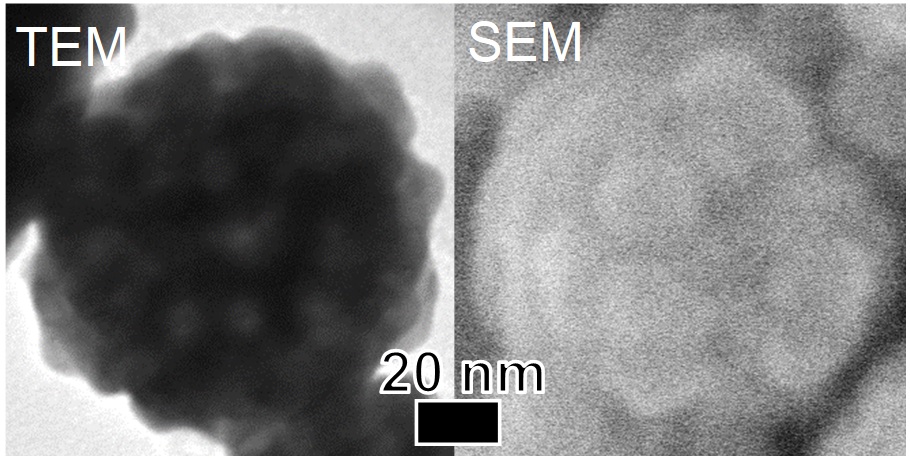
Fluorescent polymer particles immobilized with biological molecules on their surface are widely used as fluorescent probes and labels for biomedical applications. From this viewpoint, the present work proposes a simple method for fabricating such particles, which is one-pot formation in water medium. Submicron-sized monodisperse polymer particles not only surface-immobilized with sugar chain having a specific ability to be adsorbed to viruses and proteins but also incorporating fluorescent dye were fabricated with the proposed method. This method used octyl-β-D-glucopyranoside (octyl-β-D-glc), in which an octyl group is glycoside bound to a glucose skeleton as a sugar, and coumarin 7 as a fluorescent dye. During polymethylmetacrylate (PMMA) particle formation by soap-free emulsion polymerization, it is expected that the octyl group enter the PMMA particles due to its hydrophobicity and the glucose is in contact with the water medium due to its hydrophilicity. For the simplicity of the preparation procedure, both octyl-β-D-glc and coumarin 7 were added to the reaction solution at the beginning of the polymerization. The figure shows a SEM image of PMMA particles containing octyl-β-D-glc and coumarin 7. The monodisperse particles were obtained, and their average particle size was approximately 250 nm. Immobilization of octyl-β-D-glc on the particle surfaces was evaluated using concanavalin A (ConA) as a lectin, which has the selective affinity with glucose. The amount of Con A adsorbed onto the surfaces of particles fabricated with octyl-β-D-glc was twice larger than that with no octyl-β-D-glc, which confirmed successful octyl-β-D-glc-immobilization. The PMMA particles containing octyl-β-D-glc and coumarin 7 emitted fluorescence with a peak around 503 nm originated from coumarin 7. The spontaneous incorporation of coumarin 7 into the PMMA particles as well as surface-immobilization of octyl-β-D-glc on the particle surfaces took place during the particle growth in the proposed one-pot soap-free emulsion polymerization.
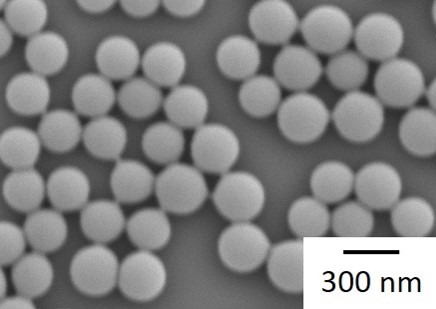
Flow microreactors have been widely studied for synthesizing monodispersed nanoparticles by utilizing their enhanced mixing performance owing to the shortened diffusion lengths. Mixing time is used exclusively to discuss the performance of mixing, however, more detailed parameters such as concentration profiles in the mixing space can affect the particle characters. In this study, we examined various nanoparticle synthesis processes with changing mixer structures and operating conditions. Various model materials were studied; calcium carbonate as inorganic crystal, Pt as a noble metal nanoparticle, ELM-12 as a metal-organic framework, and polystyrene as polymer latex. Two types of micromixers, tee mixers and micro-jet mixers, were employed with varying the inner diameters while keeping the Reynolds numbers. In this manner, factors involved in the nanoparticle synthesis processes with rapid mixing were separately analyzed and discussed. We found that change of the feed orientation with respect to the inlets of the micro-jet mixers can dramatically change the particle characters, implying the important role of detailed mixing behavior besides mixing time. The results showed that non-classical theory on the nucleation and growth processes should be considered for discussing the process precisely.
Microparticles of extracted compounds from seaweeds have been carried out by electrospraying method. The extracted compounds were obtained from hydrothermal extraction of Eucheuma cottonii (E. cottonii) and Gracilaria sp. The hydrothermal extraction was conducted in a semibatch extractor at temperature of 160oC, pressure of 7 MPa, and water flow rate of 1 mL/min. Subsequently, the extracted compounds were combined with polyvinylpyrrolidone (PVP) at various concentrations of 4, 6 and 8% w/v. The solution was sprayed via nozzle of 0.5 mm from positive electrode to negative collector. The distance between spinneret and collector was varied at 6, 8 and 10 cm. The applied voltage was 12, 14, and 16 kV. Electrospraying was carried out for 4 h with solution flow rate of 0.05 mL/h. The particles formed were analysed by SEM and FTIR to determine the particle morphology and their functional groups, respectively. In order to understand the change of materials by temperature, the particles formed were examined by thermal gravimetry analysis (TGA) method. Moreover, the antioxidant activity of particles was also measured by DPPH assay. Based on the experimental result, the highest mass production of particles was obtained at PVP concentration of 6% with applied voltage of 16 kV and distance of 6 cm. The highest mass production of particles from E. cottonii and Gracilaria sp were 19.97 mg and 20.02 mg, respectively. The mass production of particles increased with an increasing PVP concentration and voltage. The morphology of particles was spherical with particle size less than 3 μm. The increasing applied voltage and distance decreased the particle size. The antioxidant activity of particles was relatively high with the highest antioxidant efficiency for E. cottonii and Gracilaria sp of 0.182 min-1 and 0.106 min-1, respectively. The results indicated that electrospraying is promising method for production of pharmaceutical particles.
Amino acids are the components constituting proteins, and widely utilized as medical raw materials, food additives for seasonings and preservatives, and chelating agents and buffer agents of cosmetics. Most of the amino acids show polymorphism. Differences in the crystal structures affect the physical and chemical properties: solubility, stability, melting point, density, heat capacity, thermal conductivity, and optical activity. These differences influence the process acceptability, bioavailability, filtration, and tablet processes of pharmaceutical, food, and specialty materials. Therefore, an effective method for polymorph control is required in the crystallization process in order to improve the functionality of amino acid crystals and the process efficiency. As the method for polymorph control, sonocrystallization seems to have a great potential. The application of ultrasonic power causes localized mixing, heating and pressure oscillation that could contribute to control supersaturation, nucleation and crystal growth. During crystallization, sonication reduces the induction time, supersaturation, and metastable zone width. It is considerable that ultrasonic irradiation causes the nucleation directly, and sonocrystallization seems to be a simpler method to generate a desired polymorph. In this study, primary nucleation of L-Phenylalanine (L-Phe) in supersaturated solution by ultrasonic irradiation was investigated. Initially, predetermined amount of L-Phe was dissolved in purified water, and 2 mL of the L-Phe solution was added into a test tube and cooled in thermostat bath. Subsequently, in order to investigate the effects of ultrasonic irradiation, ultrasonic horn was inserted into the solution and ultrasonic wave of 20 kHz was irradiated. As a result, nucleation of L-Phe crystal was induced by ultrasonic irradiation, and nucleation probability was increased while the ultrasonic wave was irradiated. In addition, short time irradiation also caused the increase of nucleation probability. Moreover, in order to investigate the possibility of polymorph control, sonocrystallization experiment of each polymorph was performed.
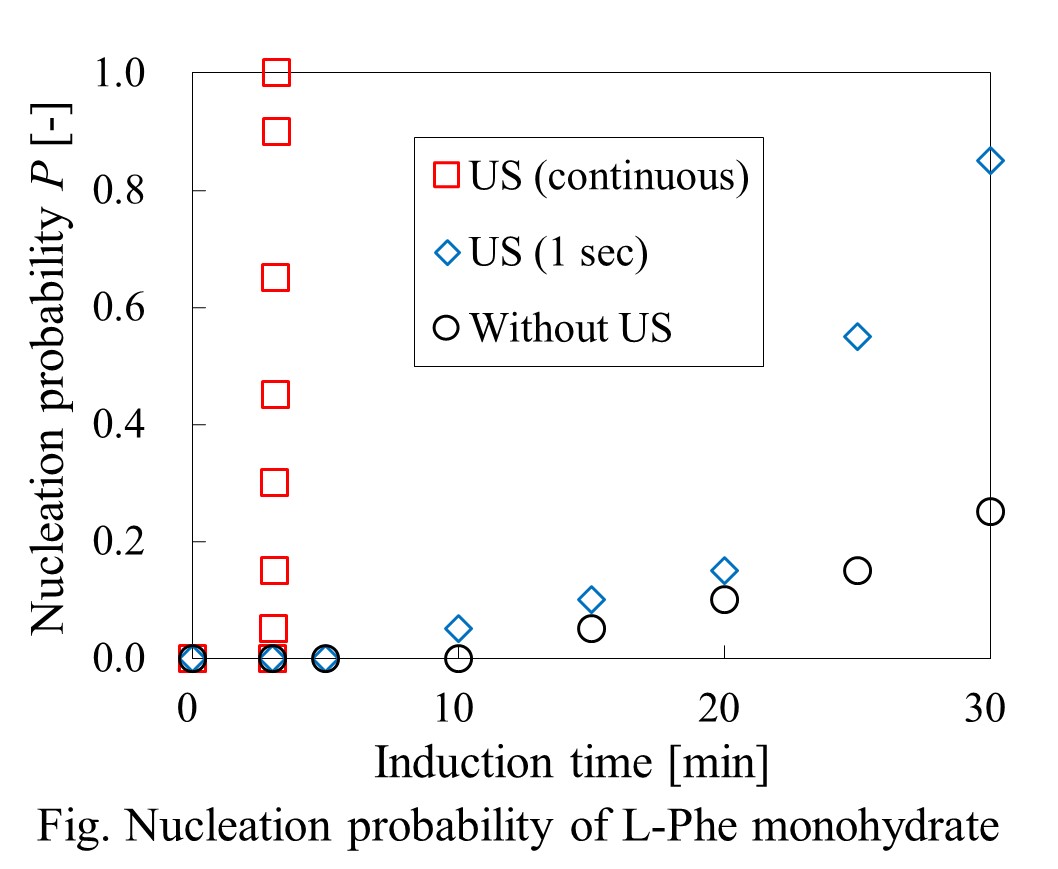
Controlling of crystallization is a critical issue for chemical process in food and pharmaceuticals. In particular, nucleation behaviors of crystals are dominated by a variety of factors such as supersaturation degree, interfacial energy and solute characteristics. So far, we have performed droplet-based crystallization of lysozyme using a microfluidic device and found that nucleation frequency, N/N0, in monodisperse droplets would be a promising way to estimate the nucleation rate of solute. In this study, furthermore, the droplets with different sizes gives us a useful information for nucleation behaviors. From the results of droplet-size dependency in the nucleation frequencies of several solutes, nucleation in droplets was quite different from that in bulk solution.
The phase transition of ice crystals governs a wide variety of phenomena on the earth. Hence, the molecular level understanding of the phase transition of ice is crucial to unlock the secrets of various phenomena. To visualize ice crystal surfaces at the molecular level, we and Olympus Corporation developed laser confocal microscopy combined with differential interference contrast microscopy (LCM-DIM) [1], which can visualize individual elementary steps (0.37 nm in height) on ice crystal surface [2]. By using LCM-DIM, we observed in-situ ice crystal surfaces under various conditions. In the conference, we will show the following two topics.
1) Thermodynamic origin of two-types of quasi-liquid layers (QLLs) with different morphologies (droplets and thin layers) [3]: with increasing water vapor pressure, the wettability between QLLs and ice crystal surfaces become significantly better, resulting in the changes in the wetting states from partial wetting (droplets) to pseudo-partial wetting (the coexistence of droplets and thin layers). The thickness of the thin layers agrees with the value predicted by the quantum theory calculation.
2) Novel uptake mechanism of HCl in ice crystals [4]: HCl gas, which triggers the depletion of the stratospheric ozone, is adsorbed on ice crystal surfaces. Then droplets of a HCl aqueous solution appear on the ice crystals surfaces. As the ice crystals grow, the HCl droplets are embedded in the ice crystals. This novel uptake mechanism allows ice crystals to store ten-times larger amount of HCl in ice crystals than the solubility of HCl in ice crystals.
[1] G. Sazaki et al., J. Cryst. Growth, 262, 536-542 (2004).
[2] G. Sazaki et al., Proc. Nat. Acad. Sci. USA., 107, 19702-19707 (2010).
[3] K. Murata et al., Proc. Nat. Acad. Sci. USA., 113, E6741-E6748 (2016).
[4] K. Nagashima et al., Cryst. Growth Des., 18, 4117-4122 (2018).
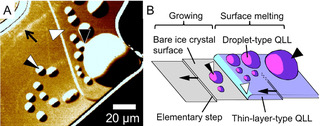
Reaction crystallization has been attracted attention because it can simultaneously perform synthesis, separation and purification process. To enhance productivity in the crystallization process, continuous flow system is used instead of conventional batch process. It is known that increasing of nucleation and growth rate is effective strategy for enhancement of the productivity in continuous flow production process. In particular, supersaturation is a main factor to achieve high productivity because nucleation and growth is promoted directly under high supersaturation condition. Unfortunately, agglomeration occurs when supersaturation increases, which affects purity of products and downstream process such as sieving or milling operation. Therefore, a novel process for enhancement of productivity without agglomeration is required.
According to the previous study, it is known that the nucleation is accelerated by shear stress. In addition, mass transfer promotes the growth rate. In this study, we focused on Taylor Vortex. Taylor Vortex is regular vortex ring and occurs continuously between rotating inner and stationary outer cylinders. Previous studies reported that Taylor Vortex shows high shear stress and fast mass transfer. This is expected that productivity can be enhanced without agglomeration by using Taylor Vortex flow. In addition, setting the various operating points is allowed because its mixing rate is extremely high compared with that of conventional batch system. Therefore, the novel crystallization process based on Taylor Vortex that is Reactallizer was proposed to obtain crystalline product with high quality in reaction crystallization.
In this study, sodium L- aspartate - hydrochloric acid was used as feed. L-Aspartic acid is target product. From the result of SEM observation, it was showed that the size and agglomeration of obtained crystals using Reactallizer were improved comparing that of batch process (Figure 1). This means that our proposed crystallizer could provide fine crystals continuously without agglomeration in reaction crystallization.
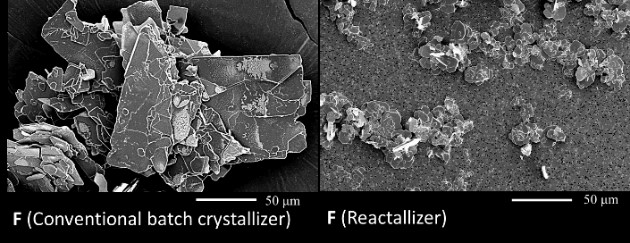
Desired enantiomer crystals are obtained from a racemic solution using a preferential crystallization. However, undesired enantiomer is also crystallized from its solution, and consequently, the purity of product particles decreases. The different types of polymorphs indicate the different crystal structures although their molecular structures are the same. The solubilities differ by the types of polymorphs. If the different types of polymorphic crystals are deposited by the kinds of enantiomers, it is expected to be obtained the high purity products using a preferential crystallization. The purposes of this study are to examine the types of polymorphism crystallized from enantiomer aqueous solutions of glutamic acid (Glu) when phenylalanine (Phe) is added into their solution and to carry out a preferential crystallization of Glu.
When an L-Glu aqueous solution saturated at 333K was cooled to 323K and the a type of L-Glu seed crystals were added into its solution, the b type of L-Glu crystals was obtained. The b type of L-Glu crystallized from an L-Glu solution by addition of D-Phe. On the other hand, when L-Phe was dissolved into an L-Glu solution, the a type of L-Glu crystals was obtaned. Therefore, it is considered that L-Phe would inhibit the solvent-mediated polymorphic transition of L-Glu from an a type to an b one.
When an D-/L-Glu aqueous solution saturated at 323K was cooled to 313K and the a type of D-Glu crystals was seeded into its solution, the purity of product particles decreased with durations. On the contrary, since the L-Phe was dissoved in an D-/L-Glu solution and a preferential batch crystallization of D-Glu was carried out, the purity decreases seldom happened. Therefore, it is considered that the purity decrease for a preferential crystallization can be controlled by combination with polymorphism.
Metal-organic frameworks (MOFs), an emerging new porous materials, have been developing rapidly during the past more than two decades, due to their tailorable and diverse structures/compositions, specific properties, and various potential applications, such as in adsorption, separation, sensing, catalysis, and membrane fabrication. Some advantages of MOFs are the possibility of tuning their structures and properties at the molecular level for target application, the facility of their synthesis, and the infinitude of their selection/formation. Using pre-designed metal nodes and organic ligands has allowed the rational design and construction of these new materials for specific applications, to some extent. So far, basic research has made great progress, but applied research has been pushing forward slowly. Our recent works are focusing on the construction of chemically stable MOFs and the exploration of their applications in several fields, including adsorption and separation, catalysis, conductivity, and membrane fabrication, to promote their practical applications. Particularly, we emphasize the design at the molecular level, the new synthetic method for functionalized MOFs, the high chemical stability of MOFs, and the fabrication of MOF-based membranes, as well as their applications in separations, sensing, and catalysis.
Recently hybrid perovskite materials have attracted great attention as a promising candidate of next-generation optoelectronic devices because of their unique properties such as high absorption coefficient, long charge carrier's diffusion length, ambipolar charge transportability, convenient bandgap tunability, adjustable exciton binding energy, high quantum efficiency, and solution processability. Hence, the hybrid perovskites have been of great interest in optoelectronic devices including solar cells, image sensors, X-ray detectors, light emitting displays, thin film transistors, non-volatile resistive random access memories, hologram memories, thermoelectrics, and so on. Among them, I have focused on a development of next-generation hybrid perovskite solar cells. Here, I would like to introduce and share what I have studied on and what I am studying.
Just in time last year 2018, United Nations Environment Programme has launched major global campaign to fight against plastic wastes to eliminate the major sources of marine litters from micro size particles from cosmetics and waste generated from single-use plastics. Although the campaign is mainly to aware the consumers to reduce the usage of single-use plastic products, many times the single-use plastic products remains unavoidable in human life due to hygiene and convenient purposes. Inasmuch, many people suggest biopolymers are the replacement for non-degradable polymers, not only because derived from renewable resources, but most of the biopolymers are equalized as biodegradable polymers. The misconception about biopolymers are environmental friendly materials may lead to unresolved plastic pollution problems while consumers have to pay higher for the biopolymer products typically packaging. The fact is that biopolymers such as polycaprolactone is derived from the sources of petroleum, while biopolymers such as polylactic acid (PLA) and polyhydroxyalkanoate (PHA) are sourced from renewable agriculture (see Figure 1). Although many people think that agricultural sources should be more environmental friendly, the reality is that growing of crops like cassava and corn to produce starch as the main sources of fermentation ingredients required consumption huge quantities of water for irrigation, synthetic fertilizers, pesticides and herbicides from petroleum derivatives, harvester needs fuel to works and most important the entire polymerization process require large quantities of water and energy resources to produce the biopolymer resin. Also, the transportation of agricultural yield from the farm to factory and resin from factory to the consumers can also consume tonnes of fuel. Eventually production of biopolymers can cause higher emission compared to conventional polymers which available widely in the market. There are also issue of shorter shelf life of food packing with biopolymers resulted from poorer gas permeation resistivity. In conclusion, the consumers are urged that the most important efforts to solve the plastic pollution are through education on wisely usage of plastics while managing plastics wastes more responsible.
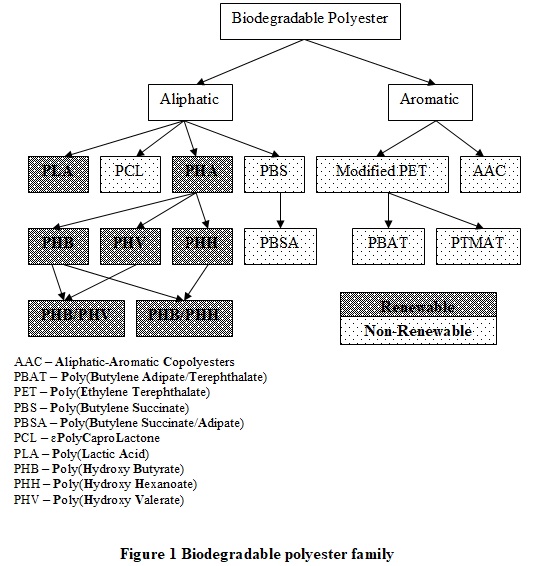
Purpose. The aim of this paper is to enhance the dissolution rate of racemic (R,S)-(±)-sodium ibuprofen dihydrate via a bio-inspired method of growing mesocrystals.
Materials and Methods. Mesocrystals of racemic (R,S)-(±)-sodium ibuprofen dihydrate were successfully prepared from a supersaturated aqueous solution of racemic (R,S)-(±)-sodium ibuprofen dihydrate having the initial degree of supersaturation, S0, of 1.326 and the initial saturated concentration, C*, of 0.986 mol/l at 25 °C with sodium dodecyl sulfate (SDS) at a concentration of 0.10 g/l. Dynamic light scattering, scanning electron microscopy, powder X-ray diffraction, differential scanning calorimetry, and optical microscopy with cross polarizers were employed to understand the formation mechanism and to characterize the superstructures of the SDS generated mesocrystals.
Results. The SDS generated mesocrystals were the assembly of the oriented attachment of racemic (R,S)-(±)-sodium ibuprofen dihydrate nano-sized platelets under the mediation of the side-to-side interaction between SDS and racemic (R,S)-(±)-sodium ibuprofen dihydrate. The SDS generated mesocrystals contained a mixture of the racemic compounds in α- and β-forms and the resolved racemic conglomerate in γ-form with no detectable amount of SDS. The dissolution rate of the SDS generated mesocrystals was more rapid than the one of its counterpart made by conventional crystallization pathway.
Conclusions. The crystallization of racemic (R,S)-(±)-sodium ibuprofen dihydrate in the presence of SDS yielded well-faceted, well-separated, but almost perfectly three-dimensionally aligned nano-sized platelets. This kind of bio-inspired mesocrystal superstructure has definitely opened a new doorway for crystal engineering and pre-formulation design in pharmaceutical industry. The future work is to study the mesocrystal formation of some other active pharmaceutical ingredients in organic solvent systems and
to develop an efficient method for screening the additives.
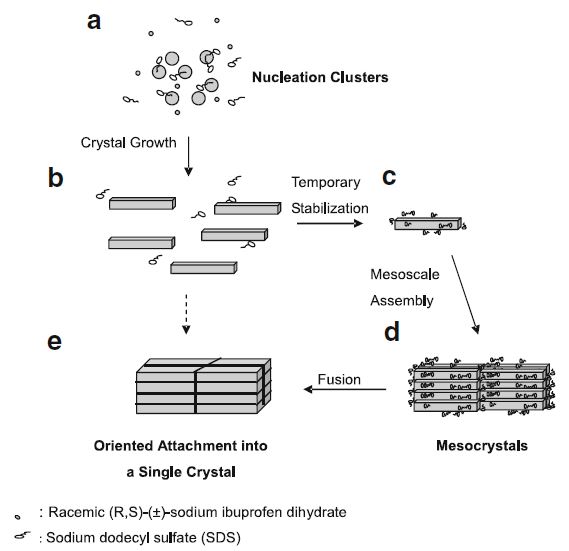
The aim of this study was to investigate the mixing effect on the stoichiometric diversity of benzoic acid–sodium benzoate (HBz–NaBz) cocrystals. The crystallization of HBz–NaBz cocrystals in a 500 mL sized glass vessel was monitored under different agitation speeds and feeding rates of HCl aqueous solution. Under good micromixing and macromixing, the HBz crystals, 2:1 and 1:1 cocrystals of HBz–NaBz were crystallized out rapidly, and all crystals were transformed to a mixture of 2:1 and 1:1 cocrystals of HBz– NaBz in a relatively short amount of time. However, the crystallization of 1:1 cocrystals of HBz–NaBz was delayed by poor micro-, meso-, and macromixing simultaneously. The compositions of the products were altered in different mixing conditions even given the identical experiment time. It was feasible to harvest pure 1:1 or pure 2:1 cocrystals of HBz–NaBz by reaction crystallization through the control of the mixing condition, concentration of reactants, and experiment time. The ternary phase diagram was also constructed for the HBz–NaBz–water system.
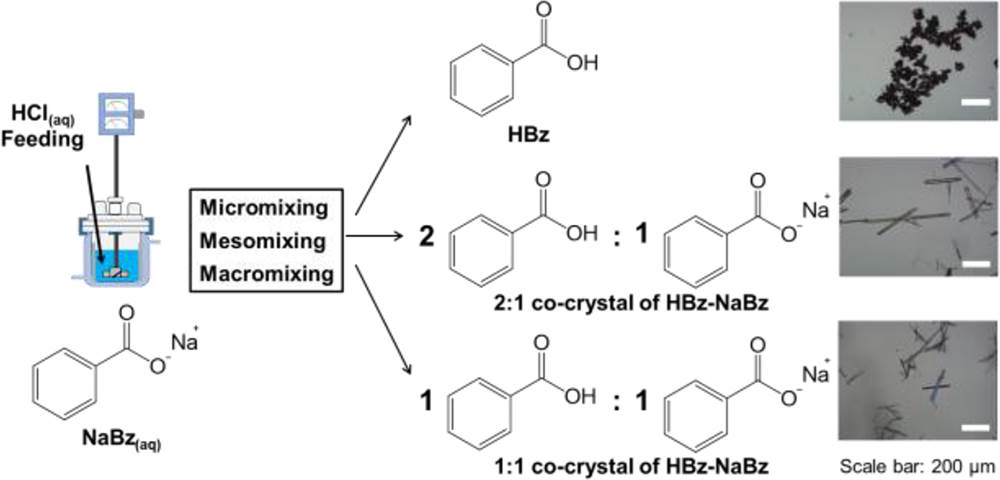
In this paper, authors summarized and overviewed examples of crystallization process applied to waste and wastewater treatment, in order to remove and recover substances, and clarified strategies how to apply crystallization in the environmental fields. In case of acidic and higher concentration waste, solution crystallization was applied by combining cooling and anti-solvent crystallization. Examples of the atomic field in which Uranium recovery was available by UNH cooling and anti-solvent crystallization, followed by purification process. In application to the waste water from metal surface treatment, metal and organic acid recovery based on anti-solvent-crystallization was investigated, considering solubility in rich acid solution. In case of lower concentration wastewater, reaction crystallization of sparingly soluble crystals was applied to obtain larger crystals of better quality, by adapting an original strategy of seeding policy, and also impurity control. Phosphate crystallization makes it possible to utilize recovered phosphorus effectively as fertilizer. The MAP Process in which a magnesium compound is added recovers magnesium ammonium phosphate. The MAP Process, which requires ammonium ions in the stage of crystallization, is applied to the anaerobic digested sludge or sludge filtrate, maximum phosphate recovery rate is considered by discussing the relationship between the crystal particle size. The design guidelines on both processes have been clarified. Large scale demonstration plant is in operation at Kobe Harvest Project. On the fluoride ion removal process, Organo developed the fluidized-type and agitation type process by using crystallization process. Ni2+ recovering process from used bath of electro-less plating process by reduction crystallization, in which Ni2+ is removed as a form of Ni metal, by using reducing agents with using nickel powder as seeds Crystallization will become an effective tool to remove and recover substance from waste and wastewater having much impurity.
Protein adsorption is a complex process that needs to be addressed as a necessary demonstration of the successful performance of separation, drug delivery, biosensor, and other applications in biomedical. The development of adsorbent material plays a critical role to enhance protein adsorption performance. Tempo Oxidized Cellulose Nanofiber (TOCN) is a promising material owing to biocompatible, homogeneous width, highly disperse in wet-state and highly-negative charge. Even so, there is no research regarding the utilization of TOCN, especially in the particle form as a protein adsorbent material. In addition, TOCN is facing some problems such as not stable in dried-state, easily aggregated, tends to have dense morphology in dried-state that leads to the low specific area. For use as an adsorbent, stable and highly-dispersed TOCN would be desired even in the dried state. In this study, we introduced the possibility of TOCN as an effective adsorbent to specific protein considering their high content of carboxylate groups and negative charge, and a concept of TOCN decorated macroporous SiO2 (TOCN@macroporous SiO2) particle for enhanced its stability and dispersibility in dried-state. The result shows that prepared TOCN@macroporous SiO2 particle has a stable morphology with unique TOCN structure, highly negative zeta potential (-62 ± 2 mV) and surface area (30.8 m2/g) compared to pure TOCN particle. The presence of SiO2 particle allows higher stability and dispersibility which leads to a rich site of electrostatic interaction to exhibits an outstanding adsorption capacity of lysozyme which is higher than that of previous adsorbents. The material and its structure proposed in this study have a more considerable potential of application in the biomedical field.
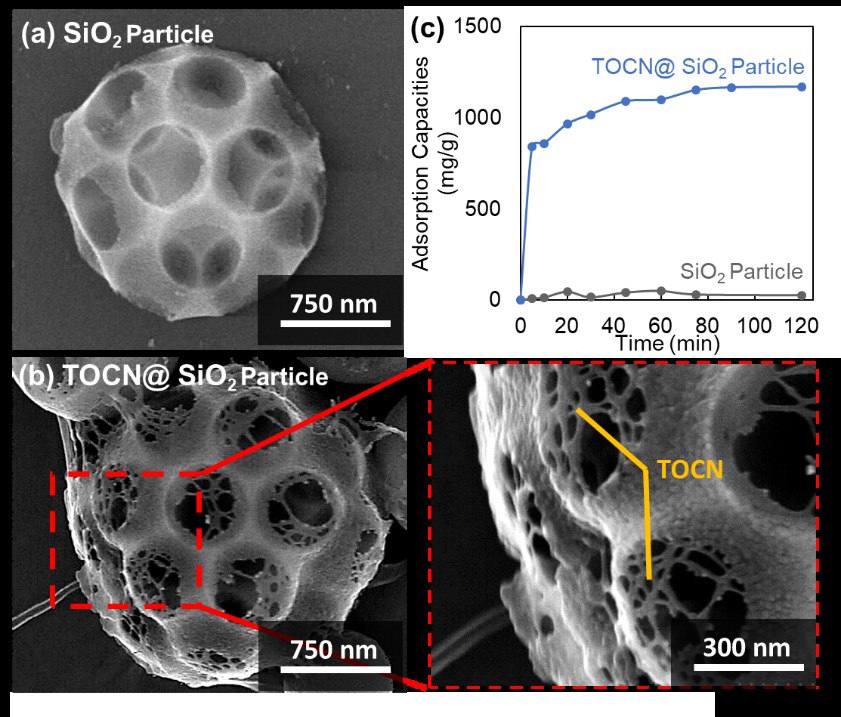
Papaverine HCl was successfully suspended by slurry reactive crystallization with the use of isopropyl alcohol (IPA) at 25oC, a solid-to-liquid ratio of 0.19 g/mL, an aging time of 8 h, a yield of 82.0 w/w %, crystal sizes of 200-400 μm, and the value for enthalpy of fusion of 154.5 J/g. The poor solubility of papaverine in IPA and better solubility of papaverine HCl in water-containing IPA had made the homogeneous nucleation of papaverine HCl dominate. Crystal size and crystallinity of papaverine HCl were time and temperature dependent. On the other hand, the 1:1 haloperidol-maleic acid salt was also successfully suspended and generated by slurry reactive crystallization with the use of water at 25oC, a solid-to-liquid ratio of 0.18 g/mL, an aging time of 8 h, a yield of 82.0 w/w %, crystal sizes of 500-1000 μm, and the value for enthalpy of fusion of 84.9 J/g. The poor solubility of haloperidol and 1:1 haloperidol-maleic acid salt in water had made the heterogeneous nucleation of 1:1 haloperidol-maleic acid salt dominate. Crystal size and crystallinity of 1:1 haloperidol-maleic acid salt became less sensitive to time and temperature. Comparing with grinding, solution reactive crystallization by cooling and solution re-crystallization by cooling, slurry reactive crystallization was a simple, robust, straightforward, low-constant-temperature, low-solvent-volume and environmentally benign process giving comparable yield, particle size distribution, and crystallinity. Moreover, the use of a poor solvent in the slurry reactive crystallization enabled the recycling of the mother liquor without any significant loss in yield and crystallinity up to three cycles.
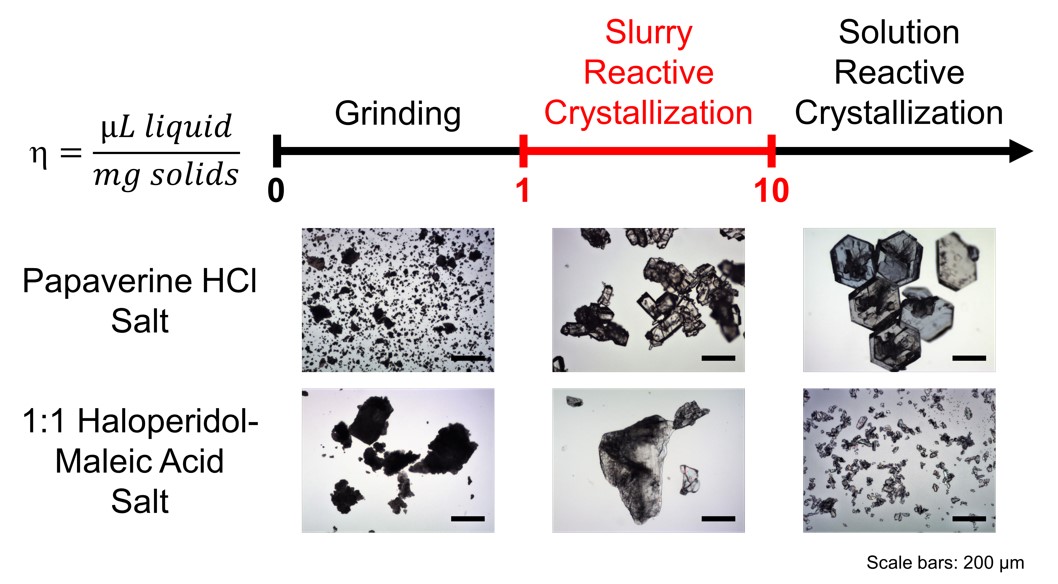
Metal–organic frameworks (MOFs) incorporating other functional nanoparticles have attracted research interest due to the synergistic functionality when combining these components. In this study, we demonstrated the fabrication of MOF composites incorporating one or two types of nanoparticles by a spray-assisted synthetic process. This process enables to synthesize MOF nanoparticle agglomerates in a short time (less than 10 ms) by self-assembly of metal ions and organic ligands during solvent evaporation from sprayed droplets of the MOF mother solution. We fabricated HKUST-1 (Cu3(BTC)2; BTC3- = 1,3,5-benzenetricarboxylate) and incorporated either Fe3O4 or TiO2 nanoparticles or both.
Nanocomposites of HKUST-1 with incorporated nanoparticles can be obtained after spray-drying of the mother solution. The amount of nanoparticles incorporated can be controlled by simply changing the concentration in the spraying solution. Further, by adding both Fe3O4 and TiO2 nanoparticles to the solution, they can both be incorporated into the same HKUST-1 crystals. HKUST-1 incorporating Fe3O4 nanoparticles have superparamagnetic properties due to the incorporated magnetic Fe3O4 nanoparticles. The nanocomposites have a high surface area (>1,200 m2/g), giving very high adsorption capacities for methylene blue (>700 mg/g). Furthermore, all HKUST-1 nanocomposites exhibit good stability for reuse as an MB adsorbent.
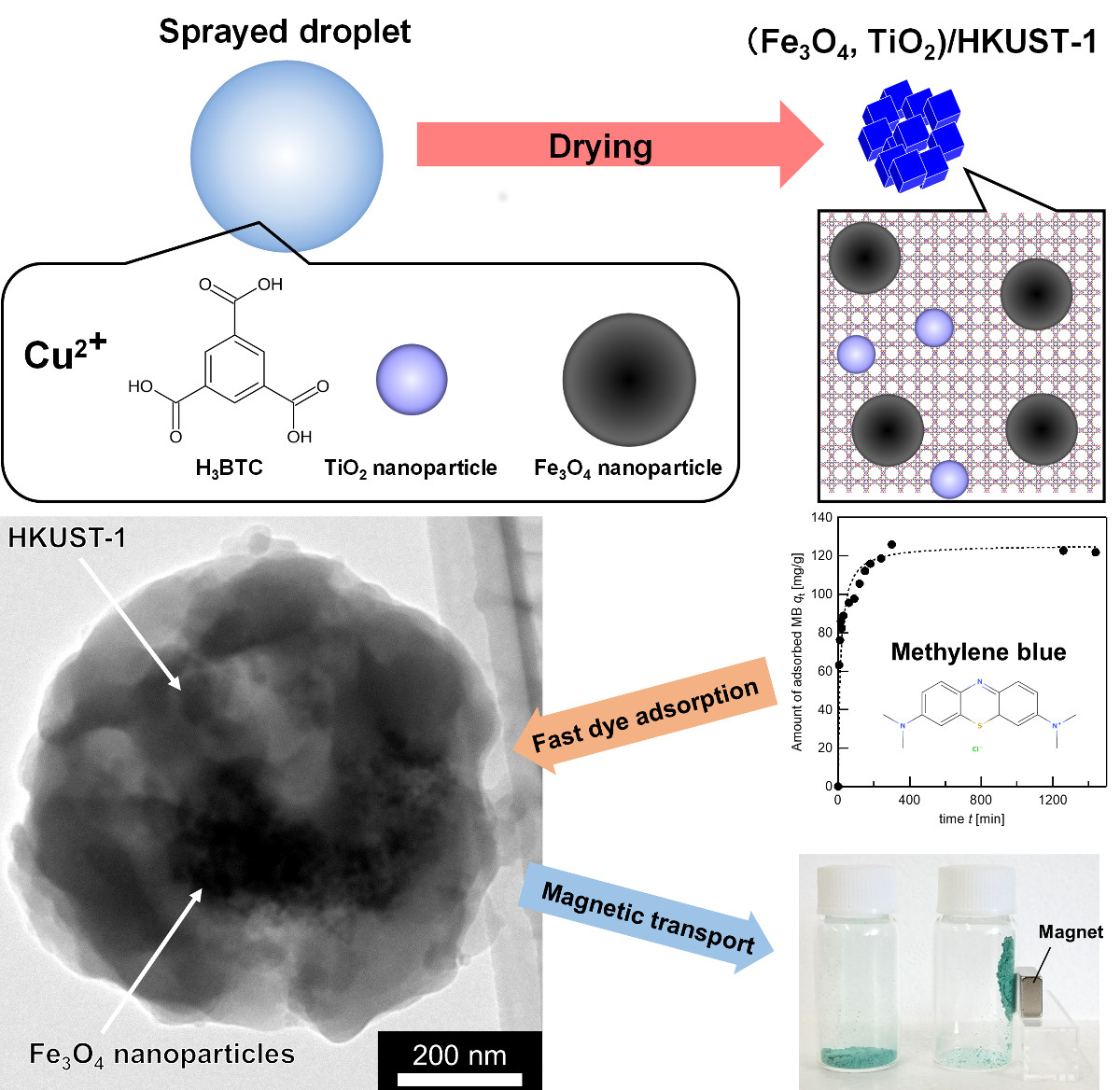
Metal-organic frameworks (MOFs), which consist of metal ions and organic ligands, possess high porosity and large surface area. An interesting feature of MOF is that particle downsizing from micron to nanoscale changes its adsorption characteristics. For application purposes, those nanosized particles have to be shaped into millimeter-sized beads or pellets. However, mass transfer is a typical problem especially when nanoparticles form aggregates with randomly-packed structures. It is thus necessary to establish a process to assemble MOF particles into ordered structures, or “supraparticles”, in which gaps between constituent particles serve as mesopores to improve mass transfer.
Here we focus on zeolitic imidazolate framework-8 (ZIF-8), which is a subclass of MOFs, as a building unit. We synthesized ZIF-8 particles with the size of ca. 200 nm using a central collision type microreactor and prepared ZIF-8 suspension droplets by mixing a suspension with an oil phase in a microfluidic device, followed by the drying of droplets to form ZIF-8 supraparticles. As shown in Fig. 1, monodisperse supraparticles successfully formed and the supraparticle size can be controlled by the ZIF-8 particle concentration and the microchannel width. Adsorption isotherms of N2 in the supraparticles showed a hysteresis between adsorption and desorption branches possibly derived from mesopores. Importantly, no hysteresis loop was observed in ZIF-8 powders, which indicates that the supraparticles have hierarchical structures with the intercrystalline mesopores. Furthermore, BET surface area of obtained supraparticles is independent of supraparticle size, which indicates the successful fabrication of ordered structures with interconnected pores via a bottom-up self-assembly. The pore size distribution and pore volume are possibly determined by the arrangement and monodispersity of ZIF-8 particles. Detailed investigation on the effects of the supraparticle morphology on mass transfer is now under progress.
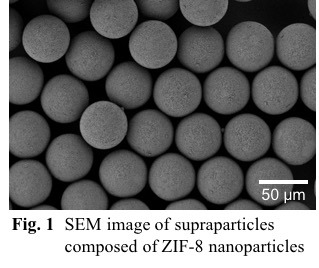
Assembling of small particles onto larger particles is a useful technique toward various microstructural material design. Although many colloidal hetero-aggregation systems have been reported, most systems suffer from serious aggregation and solidification at high solid concentrations (c.a. > 15 vol%) which was induced by very strong attractive interaction between small and large particles. Herein, we successfully prepared a flowable 50 vol% silica/silica toluene suspensions comprising from micron-sized silica particles covered with submicron-sized silica particles based on surface design. The micron-sized particles stabilized with polyacrylic acid partially complexed with oleylamine (PAA-OAm) and submicron-sized particles stabilized with polyethyleneimiene partially complexed with oleic acid (PEI-OA) were mixed in toluene. The cross-sectional FE-SEM image of the in-situ solidified suspensions showed that sub-micron particles were attached on micron particles. It is expected that the hetero-assembly was driven by the acid-base interaction between free carboxyl/amino groups of PAA/PEI on two kinds of particles. It was also found that decreasing the OA content of PEI-OA fixed on submicron-sized particles resulted in gelation of concentrated suspensions under low coverage of submicron-sized particles on micron-sized particles. Contrary, when the OA content increased, the suspension showed flowable state with small apparent viscosity and little hysteresis in the flow curves. These results support that increasing oleyl chains on the hetero-assembled particles suppress aggregation in concentrated suspensions owing to steric and osmotic repulsion between the hetero-assembled particles in toluene. In summary, colloidal hetero-assembly of binary system in flowable 50 vol% suspensions were achieved by controlling the acid-base interaction between small/large particles and stabilization of resulting hetero-assembled particles by repulsive interaction.
The aims of this study were to impregnate polyethylene glycol (PEG) 4000 in low-cost silica fume (SF) to form phase change material (PCM) composites with cementitious value, and to provide a quick-fix design for PCM (1) with tailor-made thermal properties and behaviors by particle blending of two types of polyethylene (PEG)/silica fume (SF) composites having different PEG wt% loading, and (2) with enhanced physical properties by turning the powdery PEG/SF composites into round granules through spherical agglomeration. The simple composite blending method was used to broaden and tune the application temperatures in response to variable conditions and environments without the need of searching for new materials to mitigate global warming. Spherical agglomerates of PEG/SF composite exhibited a good homogeneity in thermal properties and low Carr's indices indicating of excellent flowability, packability and compatibility, and offering an enhanced contact area for heat transfer and uniform mixing with other building materials. Noticeably, the agglomerates displayed higher heat capacity values of solid phase, Cps, and liquid phase, Cpl, than those of the composite determined by temperature-history method. The thermal stability of PEG75/SF composites was also attested by the small enthalpy loss, and the highly reproducible melting and solidification behaviors after more than 100 temperature cycles

Crystallization of zeolites in hydrogel system usually requires long synthesis time, leading to products in the form of polycrystalline aggregates with broad particle size distribution. In the present study, we demonstrated that the crystallization of mordenite in an organic-free dense hydrogel system (0.275 Na2O: 0.025 Al2O3: 1 SiO2: 25 H2O) can be induced by an intermediate stirring method—quenching and opening the reactor in the middle of synthesis to stir the substances for 1 minute. Moreover, the particle size and size distribution of the crystalline products was found to vary with the intermediate stirring timing. These results suggest the crystallization in this system may follow the autocatalytic nucleation theory, and the number of nuclei changing along with synthesis time can also be estimated. Our observations on the gel particles show that worm-like particles (WLPs) formed large spherical condensed aggregates (CAs) with ca. 10 μm diameter through aggregation and coalescence. The formation of spherical CAs can take place at the very beginning of the synthesis (5 h) under static condition. Based on the results, we speculated that mordenite nuclei can form inside WLPs, and the formation of large CAs as well as the increasing packing density of the dense hydrogel phase further reduce the chance for these nuclei to contact with liquid phase and grow.
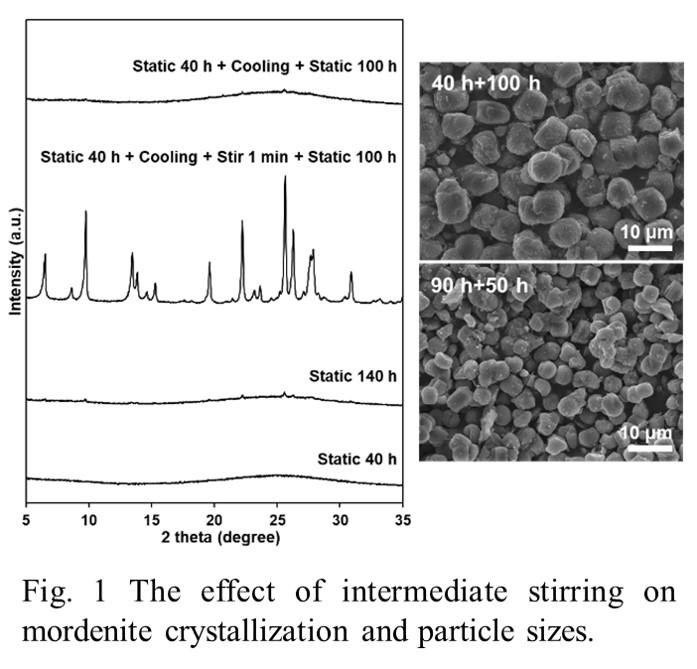
Modification of zeolites by the incorporation of divalent Zn in the silicate framework is attracting extensive attention because it results in higher anionic charge density and creates new active acid sites. However, it is a great challenge to incorporate Zn into the framework of highly siliceous MFI-type zeolites without Al. In addition, Zn tends to precipitate under basic synthetic conditions. In this study, ball milling, a mechanochemical method, was employed to prepare Si–Zn oxide composites from mixtures of fumed silica and ZnO as the starting materials for the zeolite synthesis. The dispersion of Zn on an atomic level inside the silica matrix was realized by mechanical forces. Then, the Si–Zn oxide composites were subjected to hydrothermal treatment in the presence of an additional Si source and a structure-directing agent to synthesize MFI-type zincosilicate zeolites with high Zn contents (Si/Zn=36.9–13.4) but negligible Al impurity (Si/Al>900). The successful incorporation of Zn into the zeolite framework was confirmed by several characterization techniques, including DR UV-Vis, FT-IR, XPS and solid-state 29Si MAS NMR. Co2+ ion exchange experiments showed the superior selectivity and capacity of MFI-type zincosilicate zeolites for divalent cations as compared with those of aluminosilicate analogs. The mechanochemically treated Si–Zn oxide composite plays a crucial role in the synthesis of MFI-type zincosilicate zeolites with high Zn contents and minor extra-framework Zn species.
Zeolites are crystalline microporous aluminosilicates that are widely used as adsorbents, ion-exchangers, and catalysts owing to their large micropore volumes with well-defined pore structures, ion-exchange abilities, and solid acidities. It is well known that the zeolites degrade through several mechanisms, such as interactions with metal cations and steam. High-temperature (> 800 °C) steaming conditions, to which the zeolites are exposed in regenerators for removing cokes in fluidic catalytic cracking (FCC) processes, have been a hindrance for the degradation of FCC catalysts, and over 400,000 t/yr of catalysts has been discarded. More recently, zeolites also have been utilized in ammonia selective catalytic reduction (NH3-SCR) of NOx under high temperature steaming conditions. Therefore, hydrothermal stability is one of the most important factors for the application of zeolites. Here, we provide a simple method to improve hydrothermal stability of zeolites. Several types of commercially available zeolites were treated and showed excellent stability under very high temperature (up to 1150 °C) steaming conditions. The target temperature was achieved after 75 min of ramping and was kept for 3 h for testing using a house-made durability test apparatus, followed by cooling to room temperature for over 3 h. Water was introduced through a syringe pump and mixed with dry air from a gas cylinder to achieve 10 vol.% steam at atmospheric pressure. Samples before and after hydrothermal treatment were characterized by X-ray diffraction, scanning electron microscopy, nitrogen adsorption/desorption, and so on.
Developing efficient and low-cost routes for the synthesis of zeolites is of high significance, considering the ever-emerging applications and increasing consumption of these materials. Our group has established the ultrafast synthesis of zeolites and demonstrated that the continuous flow synthesis could offers a number of advantages for zeolite production. Sharp viscosity increase taking place in the zeolite formation, however, renders a continuous flow synthesis very challenging. We herein show that the emulsion system creates a unique opportunity to address the viscosity issue, allowing the zeolite products to smoothly flow out of the reactor in forms of a suspension. The emulsion-based, continuous flow syntheses of three important zeolites – ERI, *BEA and CHA were achieved, proving this method to be a general approach.
Recently, co-authors have made it possible to densify B4C (Boron carbide) even at low pressure firing. It is expected that basic research and practical application research on B4C based ceramics will be promoted.
Evaluation on sliding characteristics was carried out mainly using B4C - SiC (Silicon carbide) ceramics prepared by low pressure sintering as test specimens. As a result, we've got some interesting findings. First, According to the observation using TEM(Transmission Electron Microscope), it was confirmed that at the interface of B4C and SiC phases voids were not observed or if any few , indicating that both were firmly bonded. Secondly, in polishing and subsequent sliding tests, it was found that a step having a height of several tens of nanometers was formed on the surface due to slight difference in wear rate between B4C and SiC. Since the step spreads over the entire sliding surface, it has a structure like a relief, we called this a relief structure.
Generally, it is said that the coefficient of friction is governed by the true contact area and the shear force at the interface. Specifically, the friction coefficient is influenced not only by control factors such as load and speed, but also by complicated phenomena such as the reaction occurring at the interface with the mating material and the lubricant, as well as the chemical and physical state of the solid surface. However, there are very few research reports that systematically examined them.
Modified-atmosphere packaging is a readily available technique to extend storage life of fruits. This is achieved just by keeping fruits in packaging bags made from high gas barrier films. Meanwhile, this is often not effective for fruits with high rates of transpiration (evaporation of water) such as melons. The relative humidity in the packaging (RH) reaches 100% due to the transpiration, resulting in condensation followed by mold growth on their surfaces. Recently we succeeded in decreasing the RH to 50% using humidity control materials (HCMs). Although condensation can be prevented, the RH is so low that melons lost too much water and were spoiled. Since the RH depends on multiple factors of HCMs (property, utilization), the RH ideal for melons (90%) is expected to be achieved through their optimization. However, this has been time-consuming because it requires multiple storage tests for data acquisition.
Simulation-assisted approaches to design HCMs have been studied in architectural engineering. Humidity distribution in rooms can be predicted through solving the modified equations for heat and mass transfer. The aforementioned factors can readily be optimized to achieve the target RH with a small number of experiments. In this work, we established a time-effective method to design HCMs for the packaging through this approach.
Three porous carbons with various water adsorption isotherms were investigated as HCMs. RH distribution of the packaging containing one of the HCMs was calculated when this was quenched (25 °C to 3 °C). The ideal environment, where melon was surrounded by atmosphere with 90RH%, was observed when the HCM with type IV isotherm (5 g) was located at the center of the packaging. This result corresponds with that of the actual experiment, where the RH was 92%, indicating reliability of our approach.
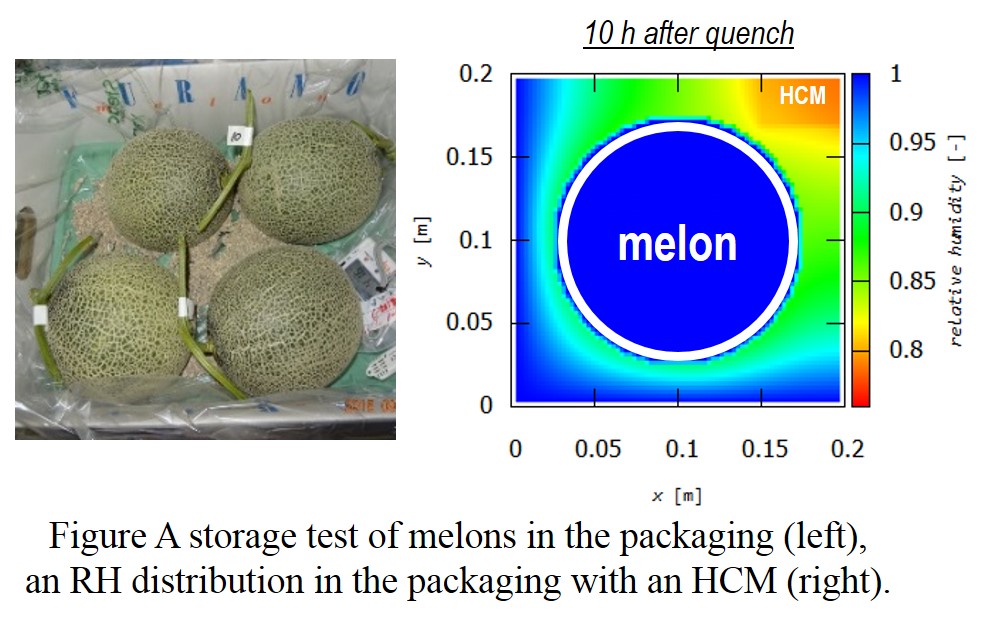
Poor stability and reproducibility of perovskite solar cells (PSCs) have prevented the devices from practical applications of industrial standard photovoltaic modules that can withstand sustained long-term operation under outdoor conditions. Furthermore, most of presented high efficiency PSCs utilize halogenated antisolvents such as toluene and chlorobenzene to assist perovskite crystal growth with large grain-size, excellent coverage and high uniformity, but they are highly toxic and detrimental to environment. To solve such issues, we developed simple methods for the production of functional nanocomposites such as Ag-rGO, perovskite-NiO, perovskite/Ag-rGO, NiO-carbon-graphite, etc and utilized them for the fabrication of ambient-air and antisolvent-free processed stable, hysteresis-free PSCs. In addition, to solve interfacial degradation whcih affects device performance Al2O3/NiO layers were utilized for interface engineering between elecrtron transport layer and active layer. By introducing the functional composites into PSCs with interface engineering, we obtained high efficiency of > 18 % and fill factor of > 78 % with excellent reproducibility. More importantly, the devices without encapsulation showed significant enhancement in long-term stability and the photovoltaic parameters sustained its stability over 330 days with retaining over 95 % of its original values under ambient condictions (see Fig. 1).
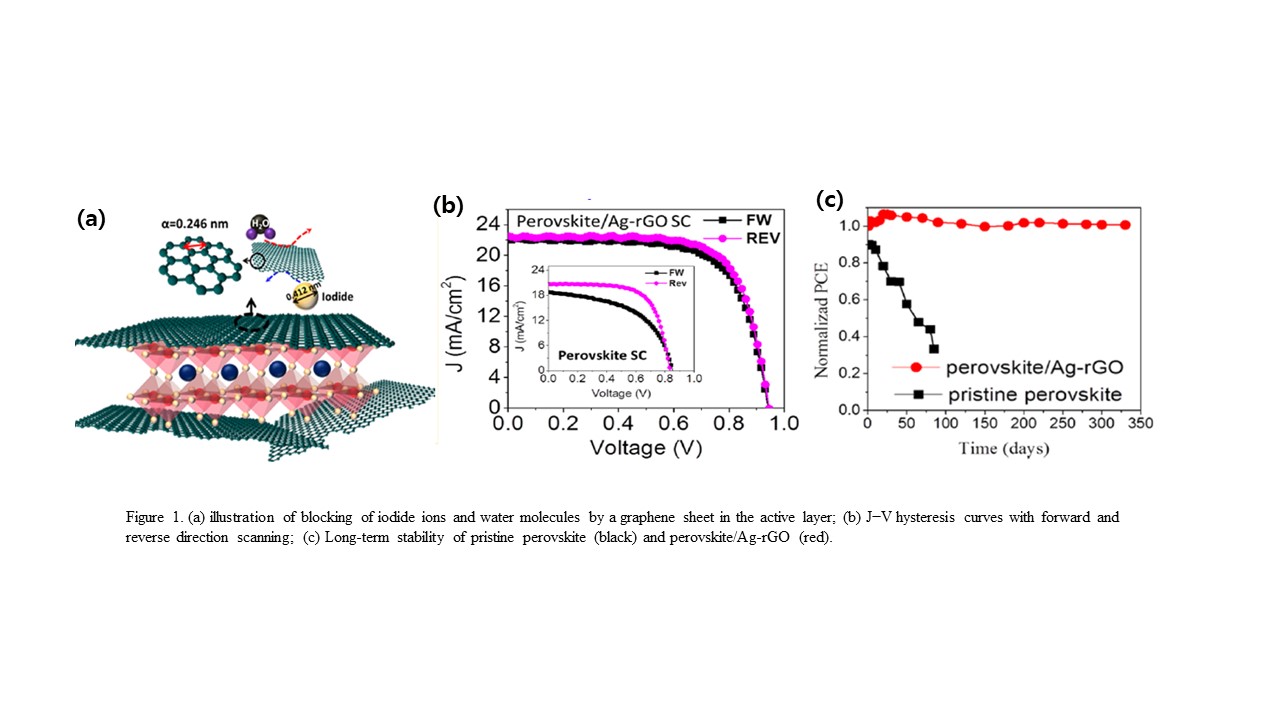
Silicon tandem solar cell is one specific type of multi-junction solar cell, which has the potential to exceed the efficiency limit of single-junction silicon solar cell and eliminates the lattice mismatch found in hetero-junction type. The porous silicon (PSi) is a potential candidate as a top cell due to its wider bandgap, which is originated from quantum size effect, for higher Voc and low reflectance leading to enhancement of light absorption.
However, the surface area and defects are highly increased compared to crystalline Si (c-Si). Therefore, suitable passivation is necessary to reduce surface recombination. The representative method to passivate silicon solar cell is atomic layer deposition (ALD). However, the cost of ALD is too high to be widely used. In this research, a low-cost electrochemical passivation technique was developed for achieving uniform passivated layer on PSi.
In this study, the PSi with porous thickness of 200-250 nm was fabricated through anodization process in HF solution. The photoluminescence (PL) was measured to observe the bandgap of P-type PSi. Then it was passivated by either electrochemical passivation in HCl or ALD (Al2O3) to compare the carrier lifetime and nanostructure. Finally, solar cell performances of electrochemical passivated samples were measured.
The result of solar cell performance shows the improvement of Jsc and efficiency of PSi solar cell compared to c-Si; the 30 seconds electrochemical passivated PSi yielded 29.8 mA/cm2 and 10.7%, and the c-Si yielded 23.4 mA/cm2 and 8.2%, while both Voc are not much different. However, the PL data shows that the bandgap is increased from 1.1 eV (c-Si) to 1.9 eV. Therefore, in order to improve Voc, the surface passivation and configuration of front electrode are key factors to reduce recombination and increase lifetime. Also, the relationship of porous structure and pn-junction depths is important.
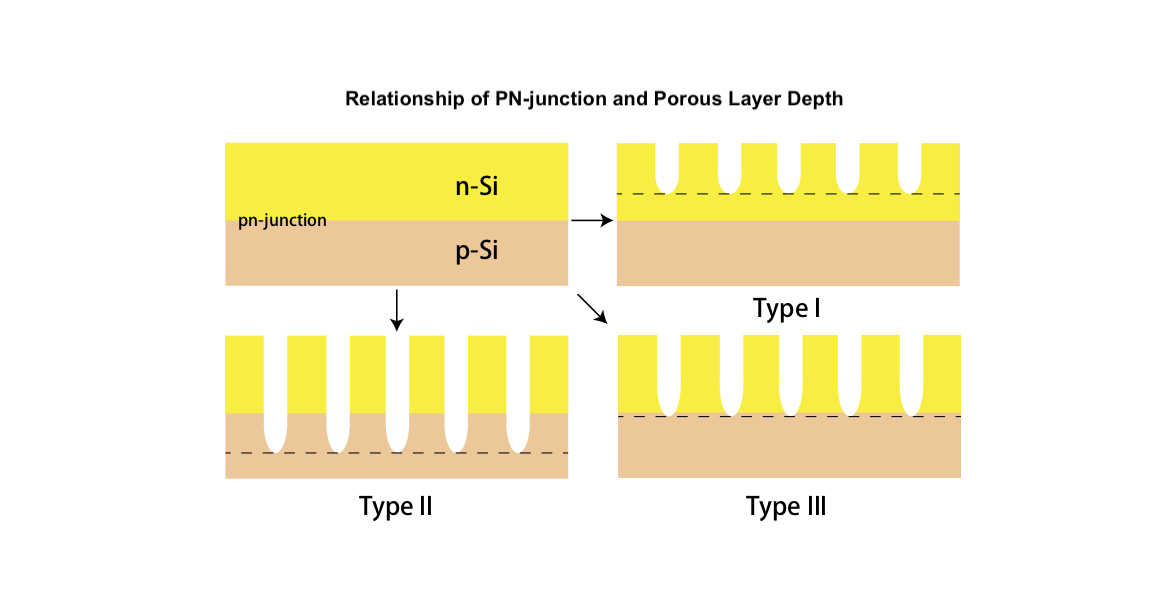
To reduce the cost of Monocrystalline Si solar cell and the amount of Si by thinning the wafer with keeping high efficiency is promising approach. A major method to obtain monocrystalline thin film Si is the epitaxial growth by Chemical vapor deposition(CVD) and layer transfer process. Si is epitaxially deposited on a seed layer such as double layer porous Si(DLPS) with top seed layer and bottom sacrifice layer. The rate and the yield of epitaxy by CVD and the defect level caused by the roughness of the seed layer were critical issues. We developed the method to fabricate high quality film by smoothing the surface of DLPS within nanometer level with zone heating recrystallization(ZHR)[1] that selectively heat the surface by scanning of lamp heater. Also we developed rapid vapor deposition(RVD)[2] to get the high deposition rate over 10 μm/min by heating Si source over 2000 °C. By applying these methods, we obtained the monocrystalline Si in 3 min and the critical effect of lowering the roughness of DLPS in less than 0.3 nm is confirmed[3][4].
In this work, to fabricate high quality solar cell, we (1)investigated the key factors to change the roughness of DLPS and (2)evaluated the semiconductor properties of monocrystalline thin film Si. The surface smoothing of DLPS were inhibited by oxidation and by changing the atmosphere to H2/N2 promoted the decrease of the surface roughness. After modifying the method to fabricate over 35 μm thin film Si by RVD in one time, the thin film Si with passivation Al2O3 film on both sides by ALD showed the sufficient life time as monocrystalline Si film by the life time measurement.
[1]A.Lukianov et al.,Appl.Phys.Lett 108(213904)1-4(2016)
[2]Y.Yamasaki et al.,CrystEngComm 18-3404-3410(2016)
[3]C.Takazawa et al.,ECS.Transaction 75(31)-11-23(2016)
[4]K.Hasegawa et al.,CrystEngComm.in press20(2018)1774-1778
Recently, nanosheets (NSs) have been attracted attention owing to their various unique properties. The synthetic methods of NSs are divided into two categories: top-down exfoliation methods and bottom-up methods. However, both methods have some problems. As one of the former methods, NSs can be obtained from the exfoliation of layered materials; the thickness of the obtained NSs are a few nm, but this method can be applied only to layered materials. As one of the latter methods, NSs can be obtained from the chemical vapor deposition on a smooth substrate; this method can synthesize NSs of various chemical compounds, but the NSs are not so thin. It is required to develop a versatile method to synthesize thin NSs.
We focused on the two-dimensionally confined space in a bilayer of hyperswollen lyotropic lamellar (HL) phases of amphiphile solutions as a sandwich-like reaction fields (SRFs) for the synthesis of thin NSs; HL phases are classified as one of lyotropic liquid crystalline phases. The SRFs with several nm thickness are separated from each other by about several hundred nm. In fact, NSs were successfully synthesized in the thin hydrophobic SRFs inside the bilayers of aqueous amphiphilic solutions. The thickness and horizontal width of the NSs are a few nm and several hundred nm, respectively. The thickness of the obtained NSs is almost constant. We have developed such a synthesis method and named it "two-dimensional reactors in amphiphilic phases" (TRAP) method.
Here, we present the NSs synthesis using TRAP method. We confirmed that TRAP method can be apply to the hydrophobic materials made from both hydrophilic and hydrophobic ingredients such as metal organic frameworks (Figure). Furthermore, we found that it is possible to synthesize NSs in the thin hydrophilic part of the SRFs.
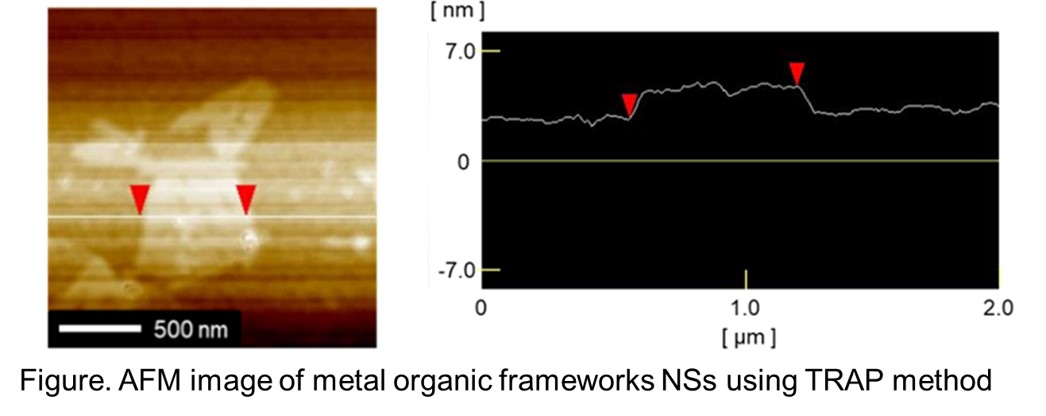
Surface modification plays an important role in determining interfacial adhesion between substrate and electroless-deposited (ELD) metal layer. In this presentation, we will share our experience regarding to control of surface modification on either organic or inorganic substrate and its relation to the adhesion strength of subsequent ELD metal layers. In particular, case studies of adhesive ELD on silicon wafer, glass sheet, Ajinomoto build-up film and photoimageable dielectric will be reviewed. It is concluded that with sufficient control of surface modification, the adhesion strength of ELD layer can be largely enhanced due to formation of either covalent bond or donor-acceptor-like interaction.
To meet the increasing demands in portable microelectronics, thin film pattern formation on plastic substrate surfaces has recently received great interests. Metal conductive interconnects, as the essential components in any electronic devices, built on flexible or even stretchable plastic substrates are necessary for the realization of portable or wearable devices. However, due to the incompatibility between metal and plastic molecules, it is challenging to resolve the surface bonding at the metal/plastic interfaces. Moreover, in order to manufacture conductive interconnects with fast speed and low costs, printing procedures with high reliability are also needed. To address these problems, we developed several ink formulation and pre-treatment methods to improve the adhesion between metal coatings and the plastic substrates. In addition, related process parameter adjustments in printing procedures are also provided in this talk to give general guidelines for reliable pattern formation on either 2D or 3D microstructures. Same approach can also extend to fabricate various sensors with great performance. Several examples, such as temperature and humidity sensors, will be given in this talk to show the potential aspects of printing technology in microelectronics.
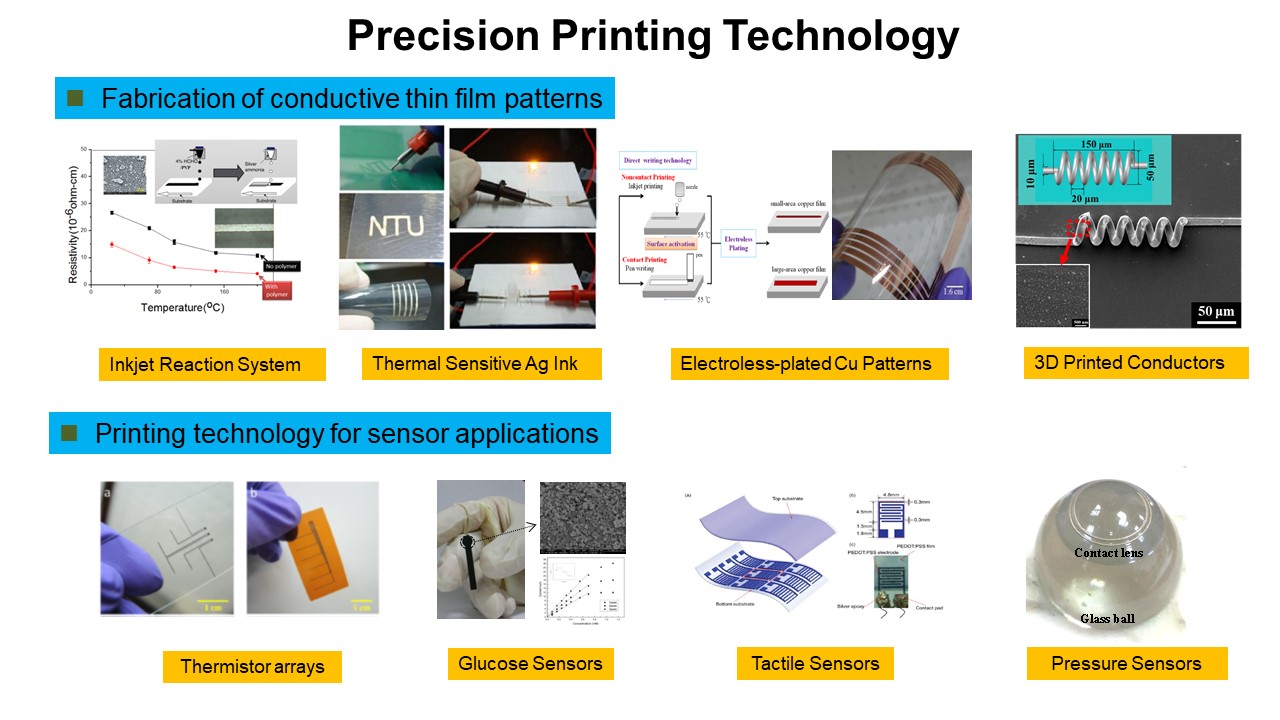
Coating layers of nanoparticles exhibit a mechanically fragile property upon semidrying. In contrast to fluidic inks where precise shaping is difficult owning to surface tension, viscosity and wetting, semidried layers can selectively be transferred onto a printing plate and thereby enabling patterning with micrometer-scale features. Reverse offset printing and adhesion contrast planography use this patterning principle and allow to generate high-resolution patterns of various functional nanomaterials such as gold, silver, copper, ITO and others. Here, we used a simple discrete element method to simulate the patterning step so as to reveal its patterning mechanism at the constitutive particle level. The modelling clarified the rule of cohesive force between particles and their interfacial adhesion against a substrate in the pattern formation. In the presentation, the criteria for successful patterning is discussed together with the comparison with experimental results.
Irradiation of UV light onto a photo-reactive solvent/monomer/initiator ternary solution film triggers polymerization and a spontaneous phase separation between polymer-rich and solvent-rich phases. Subsequently, the volume occupied by the solvent was replaced by air when the solvent-rich phases were dried, resulting in a certain film porosity. This process does not require multi-step rinsing procedures to remove either phase in a selective solvent, providing a promising method for roll-to-roll high-speed fabrications of porous polymer films. Despite extensive previous studies on solvent-free photo-reactive systems [1], no quantitative data is currently available on the evolutions of local composition distributions in solvent-based reactive coatings. In this study, we developed a confocal Raman spectroscopy technique to directly determine local polymer concentrations across the film. We used polyester acrylate (M9050, Toagosei Mw = 1000~1500) as the photo-reactive monomer, and 1, 3 α-alkyl amino phenone (Irugacure 379 EG, BASF) as the photo-initiator. Methyl isobutyl ketone (MIBK, Wako) was chosen as the solvent, which is immiscible with the reactant of the polymerization reaction. The solution was dropped on a glass plate and dried at 30 °C for 1 min prior to the irradiation of light of wavelength 365±5 nm. To avoid beam scattering at phase-separating interface in the Rama spectroscopy, the solvent was replaced by a reactive monomer to match the local reflective indices in the cured film [2]. The results indicated that the polymer concentration profiles near the top surface were tunable by solvent drying condition, whereas those near the bottom were almost independent on the condition.
References
[1] H. Nakanishi, T Norisuke, Q.T.Miyata, J. Phys Chem Lett. 4 (2013) 3978-3982.
[2] H.Yoshihara, M.Yamamura, Journal of Coating Technology Research, in press
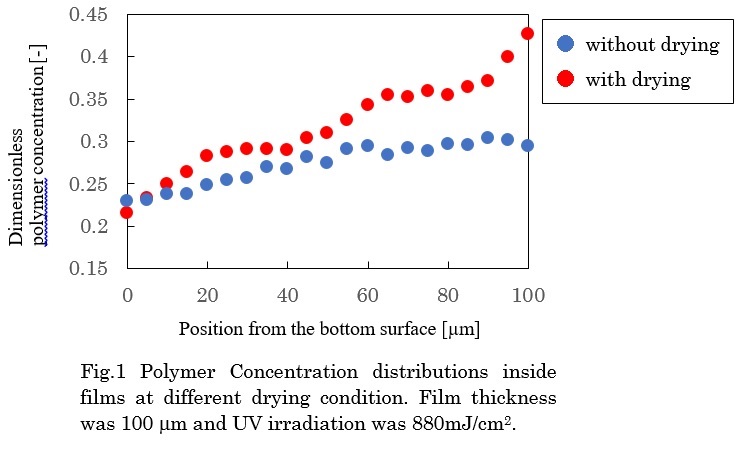
The term “back diffusion” is sometimes used to describe local diffusion of solvent in the opposite direction with respect to its evaporation. Such a diffusion emerges when we stratify a solvent-rich liquid layer on top of a solvent-lean layer and simultaneously dry them. The back diffusion across the two-layer interface alters not only drying rates and residual amounts of the solvent but also microstructure developments in drying coatings. Despite practical utilities to create stratified thin liquid layers in printable electronics and many other functional coatings, the role of back diffusion in drying kinetics of two-layer coating is still poorly understood. In this study, we present drying kinetics of solvent-base two-layer polymeric solution films coated simultaneously or in tandem. The layers contain tetrahydrofuran (THF) as solvent, and polystyrene (PS) or cellulose acetate butyrate (CAB) as a polymeric binder. The blade coating method was used to stratify two solutions layers of different concentrations. The decrease in mass of the wet-on-wet coating was measured by with an electronic balance and recorded to calculate the solvent drying rate. The results showed that, in the case of stratified PS/THF binary coatings with the same solvent concentration of the top layer, the solvent drying rate monotonically decreased with decreasing the bottom-to-top solvent mass ratio, indicating a retarded drying due to a back diffusion of the solvent. However, the opposite trend was observed in drying of a PS/THF layer on top of a CAB/THF layer; the drying rate increased with increasing the bottom-to-top solvent mass ratio even when the solvent concentrations in the top layers were the same. This puzzling drying behavior was qualitatively explained by considering spontaneous phase separation between immiscible PS and CAB solutions and development of interconnected domain interfaces that act as a solvent diffusion pathway across the thickness.
Continuous liquid coating is used to produce various films or sheet-like products, such as adhesive tapes, optical films, display panels, etc. It is also a strong candidate for nanoparticle assembly film production. Slot coating is a popular high-precision coating methods, because the film thickness is directly controlled by the flow rate and substrate speed rather than coating liquid properties. However, many high-performance multi-functional films for electronics and optical devices require nano- or micro-sized particles inside a coating liquid. As the environment requirements push to use less solvent, the coating liquid becomes dense suspension. Consequently, the liquid shows complex non-Newtonian behavior including viscoplasticity, i.e. exhibiting little or no deformation up to a certain level of stress. This study presents fundamental aspects of film formation flows used in coating processes and the impact of rheological properties on the operating limits of a coating method in both experiments and computations.
Slot coating is a pre-metered coating method widely used to produce a variety of thin films such as magnetic tapes, battery electrodes, optical films, and so on. In industrial applications, a high-speed coating is desired in order to lower the manufacturing cost. However, it often requires the usage of diluted low-viscosity liquids to ensure the stability of a coating flow. Such dilution of a coating liquid could result in an increase of the drying load more than the dryer's capacity, the cost increase for solvents treatment, or the insufficient quality of a coated product caused by the severe drying condition. The most cost-effective way is to achieve a high-speed coating with a concentrated high-viscosity liquid.
For this purpose, we studied the simultaneous dual-layer slot coating, having a high-viscosity top layer and a thin low-viscosity bottom layer. We found that the coating window could be greatly expanded compared to the single layer coating of the top layer. Visualization of a coating bead through a transparent glass backing roll revealed that the location and the shape of the layer-interface was the key factor to determine the stability of dual-layer coating. Furthermore, we found three flow regimes regarding the interface shape, and examined the effect of coating parameters such as film thickness ratio and viscosity ratio to those flow regimes. Finally, we will discuss the mechanisms to explain each of the flow regimes.
Polymer electrolyte fuel cells (PEFCs) are one of the most promising power sources for vehicles. However, there are several hurdles preventing the spread of PEFCs, including reducing cost, improving performance and durability. Key measures to help resolve these issues include controlling the structure of the electrode catalyst layers. Catalyst layers are porous layers prepared from the catalyst ink consisting of ionomer solutions, carbon black supporting Pt nanoparticles, and dispersing solvents. Drying of a thin film from the catalyst ink on a substrate often causes the formation of cracks. Since cracks in catalyst layers of a fuel cell affect performance and durability, it is important to obtain the factors that control the crack formation.
Herein, this study aimed to identify the factors affecting crack behavior in terms of the dispersion state in catalyst ink. Critical crack thickness (CCT) is examined as a parameter for cracking characteristics by changing the formation of Pt/carbon by adding two types of solvents with different hydrophobicity.
The CCT was found to be four times greater for catalyst layers obtained from catalyst inks that are well dispersed by ionomer adsorption than for catalyst layers obtained from catalyst inks with a network of structured agglomerates. This suggests that the CCT decreases due to the poor affinity between the ionomer and Pt/carbon.
These results suggest that well-dispersed catalyst inks produce homogeneous distribution of Pt/carbon and ionomer in catalyst layers with high fracture toughness, while catalyst inks with network of structured agglomerates produce dense aggregates with small primary pores that generate high drying stress, and self-organizing free ionomer that cause stress concentration in catalyst layers with a high risk of cracking.
In conclusion, the present study has demonstrated that crack behavior can be controlled by ionomer adsorption on the Pt/carbon in catalyst ink and the resulting dispersion state.
Self-healing polymer coatings is applied on the surface of metal to prevent corrosion. The addition of cellulose nanofibers as pathway of healing agents into polymer coating could be improved the self-healing properties in our previous research. In the present research, polymer coatings blended with nanofibers and two types of inorganic healing agents, which are zinc sulfate and zinc phosphate, was applied on the surface of carbon steel. Release behavior of two types of inorganic healing agents from polymer was measured using mass change. The electrochemical impedance of scratched specimen was measured in corrosive solution. As a result, release rate of two types of inorganic healing agents from polymer was different. The release of zinc sulfate was fast, and the release of zinc phosphate was slow but long. The release amount of healing agents was increased by addition of cellulose nanofibers. The polymer coating added cellulose nanofibers and the two types of healing agents showed excellent self-healing performance for corrosion inhibition of carbon steel. This was caused by the fast and long release due to two types of inorganic healing agents.
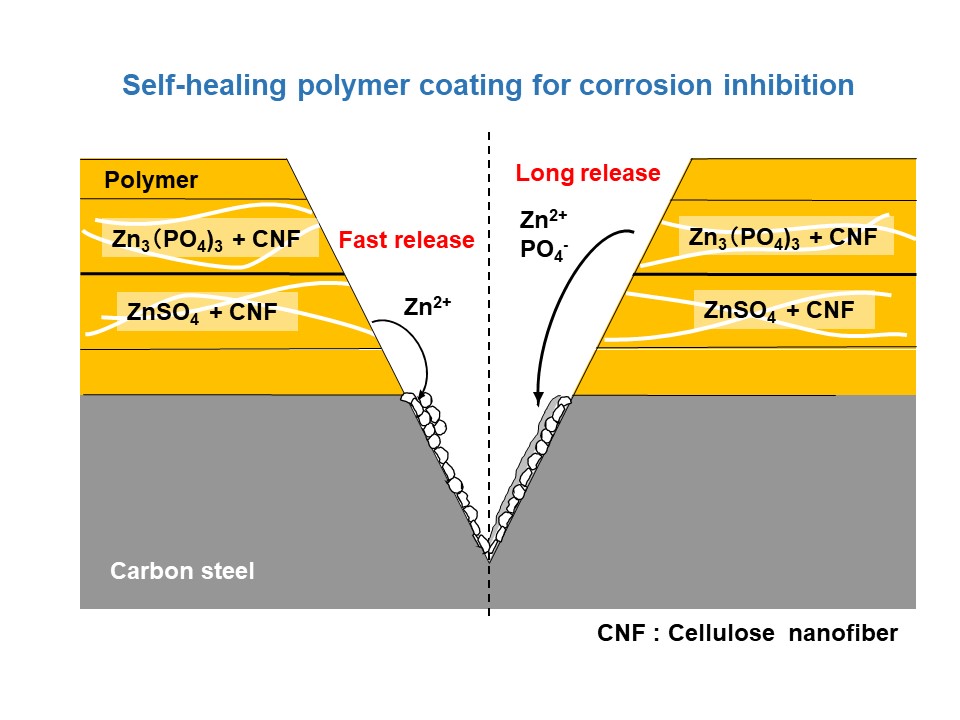
An aqueous dispersion of latex particles produces uniform resin layer. The addition of silicate and coupling agent can improve the toughness. In this study, the effects of those additives on the film formation process was studied. A sample coated glass substrate was placed in a container heated to 100 °C. A confocal displacement sensor placed above was used to measure film thickness change. Additionally, an expanded laser beam was irradiated on the surface. The reflected lights were interfered to produce speckle pattern containing bright and dark spots. The variation of the speckle pattern was recorder using an objective lens and CMOS camera. From the inspection region (20 x 100 pix) of the speckle pattern, 100 lines containing 20 pixels were vertically aligned to produce long lines of 2000 pixels. The long pixel lines of more than 9000 frames, being corresponding to 100sec, were then horizontally aligned to produce area time history speckle pattern (A-THSP). Various types of stripes were found in A-THSP. An oblique striped pattern frequently observed indicates the translation of speckle pattern in the longitudinal direction of the inspection region. This pattern suggests the formation of convective flow. After that, highly active random speckle pattern was followed by vertical or horizontal stripe pattern. Vertical stripe suggests uniform and periodic change of speckle pattern. When film formation was terminated, static speckle pattern attributes to constant brightness and horizontal stripes. No significant change in film thickness was observed in the convective flow regime, while thickness was drastically decreased in the random pattern regime. The transition from vertical to horizontal stripes can be detected only by A-THSP. In this stage, an interval between the bands became larger with time, suggesting the inhibition of activity of film and the termination of film formation process.
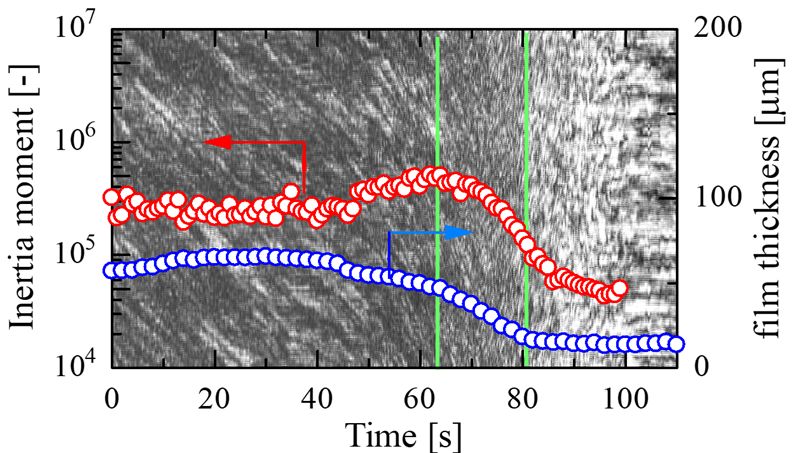
Colloidal suspensions are coated on substrates and upon drying produce various functional materials, whose quality is determined by the microstructure composed of colloidal particles. The structure formation of the particles during drying is governed by the competition between the Brownian motion of the particles and the recession of the free surface according to liquid evaporation. The Brownian motion tends to distribute the particles uniformly, while the receding free surface drives the formation of concentrated particle layers. The drying rate falls with a decrease in the liquid permeability of the growing concentrated layers. The structure formation of the particles is reflected in the drying characteristics, of which the control is required for the improvement of material quality as well as the reduction of drying time. We then construct a model to investigate how drying conditions and suspension properties affect the drying characteristics.
We have developed a simulator of colloidal suspensions: Structure of NAno Particles (SNAP). In the present study, we extend a simple mathematical model adopted in SNAP-L, where the Brownian motion of particles is described by a stochastic differential equation called the Langevin equation. We additionally construct a model to consider drying rate falling by estimating the permeability of formed concentrated layers. The drying characteristics calculated by our model is shown in Figure. Using the present model, we propose how to control the drying characteristics by initial drying rates and interactions between particles.
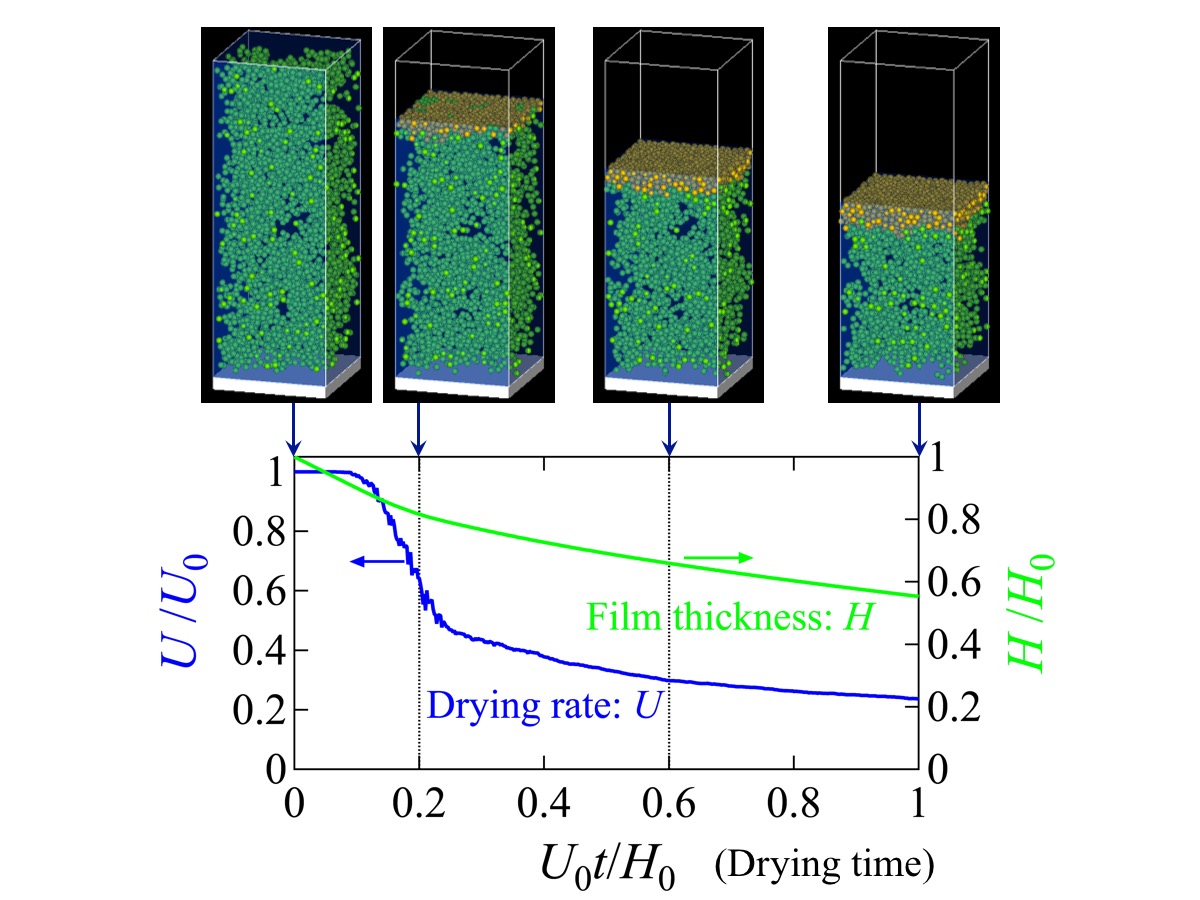
Self-assembly is an attractive technique to fabricate colloidal crystals, which are promising for various applications. However, few works focused on the formation process of colloidal crystals based on interaction forces acting on particles, which play a critical role in self-assembly. Here we produced colloidal crystals and controlled their size by adjusting the balance between the attractive force induced by the depletion effect and the repulsive force due to overlapping of the electric double layers of particles.
We used polyethylene oxide (PEO) as a depletant and sodium chloride (NaCl) as a salt and systematically investigated the effect of their concentrations. Figure 1a shows a typical image of depletion-induced colloidal crystals composed of 3 μm polystyrene particles under the condition of 0.4 g/L PEO and 10 mM NaCl. The decrease in the depletants resulted in a dispersion state (Fig. 1b), while the increase produced aggregates (Fig. 1c). Under a lower salt concentration condition, a larger amount of the depletants (i.e., the stronger attractive force) was necessary for the crystallization because of a longer Debye length.
Further, the depletants of 0.7 g/L without salts resulted in a formation of large crystals with an average size of 33 μm while the addition of 1 mM NaCl decreased the size to 15 μm. In addition, the crystal formation without salts was much slower than that with 1mM NaCl because of a higher energy barrier caused by a longer Debye length. These results suggest that a higher energy barrier produces a fewer number of "nuclei" of colloidal crystals, resulting in larger domains during assembly. Hence, we demonstrated that the formation process of crystals and their size can be controlled by adjusting the balance between repulsive and attractive force.
Figure 1. Images of (a) depletion-induced colloidal crystals, (b) dispersion state, and (c) aggregates

Drying of colloidal suspension is a common industrial process and widely used for manufacturing products, such as paints, ceramics and electrodes. During drying of a colloidal suspension, particles move towards the drying interface, and they form particulate films. Many papers have reported drying kinetics of colloidal suspensions and directional drying is frequently used in those studies. Suspension is introduced into a narrow space between two glass plates. Evaporation occurs from one open side, which induces flow to the drying interface. Because flow is confined in a narrow space, it has been widely accepted that only horizontal flow is induced by drying. However we have found that there is a complex circulation flow. We used a unidirectional drying cell (Hele-Shaw cell) to dry silica colloidal suspensions. Fluorescent particles were added to trace flow inside of the drying cells. A circulation flow appeared around the interface between the packed layer of particles and the suspension although the suspension was confined in a narrow space with a height of 100 μm. The width of circulation flow region was strongly dependent on the growth rate of packed film and the gap height of cells. The origin for the circulation flow and possible impacts of the flow on film formation processes are discussed.
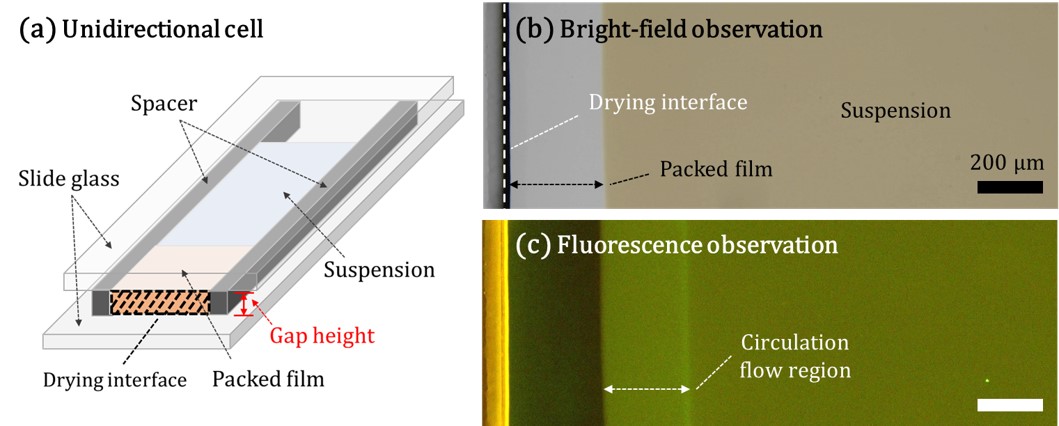
Some solid particles stabilize water-oil interface and particle-stabilized emulsion forms. We prepared Water-in-Oil (W/O) emulsions using hydrophobic silica particles as a stabilizer. Drying of droplets was observed. Due to evaporation of water, droplets shrunk. We found that the ways to droplets shrunk varied depending on the storage time (aging time) of droplets as shown in the Figure. Immediately after preparation, droplets shrunk isotropically during drying (Mode 1). After several-days aging, droplets shrunk but wrinkles formed on surface of the droplets (Mode 2). Further aging induced buckling of drying droplets (Mode 3). We revealed that those changes closely related to particles affinity to water. Particles were hydrophobic and they did not have good wettability to water in praparation process. However wettability of water increased during aging. Formation of wrinkles and buckling of droplets suggested that the droplet interface became solid owing to packing of particles. Because particles at the interface were compressed due to drying-induced shrinkage of droplets, particles packing occurred at some point. We consider that wettability of particles is a key issue in packing. Simple drying experiment of particle-stabilized water droplets would provide us with important information about how packing of particles occurs on two-dimensional interface.
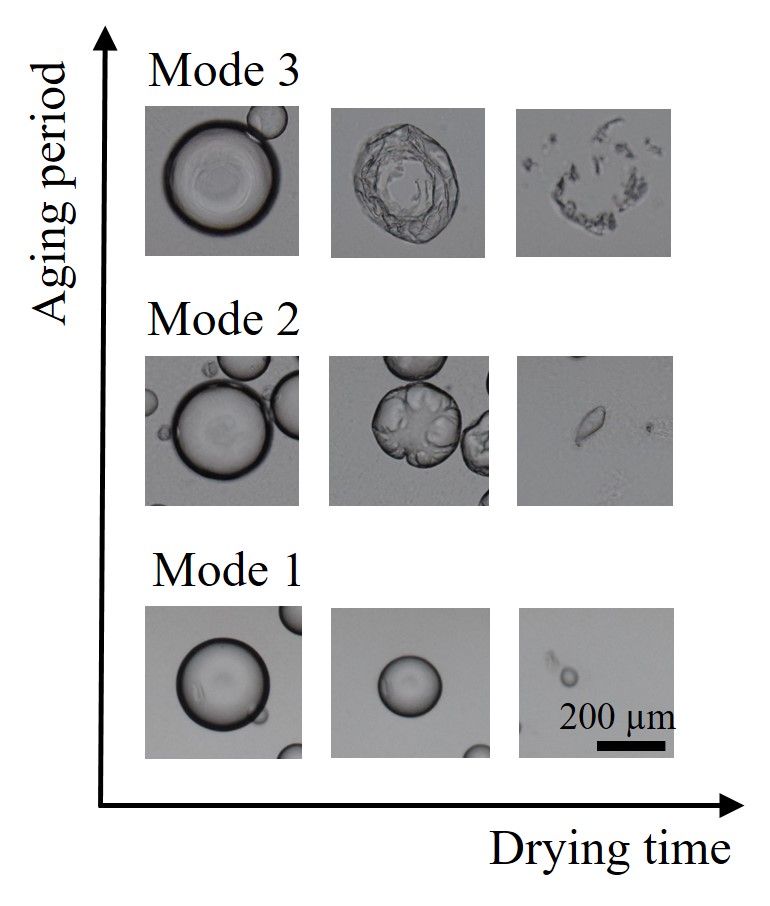
Performance of emulsion significantly depends on interface control. This study focused on interfacial layer formation of particles for oil-water emulsion system and its emulsion stabilization effect. In order to investigate interfacial localization, adsorption, and desorption of clay particles in the presence of surfactant, interfacial modulus of oil-water interface was measured under the control of surfactant loading. Depending on the balance of wetting property of particles between oil and water, localized particles responded to surfactant differently, especially depending on ionic characteristics of surfactant and the oil phase. Natural particles responded rapidly to surfactants and enhanced to desorb to the other phase as the concentration of surfactant increases. Organically surface-modified clays localized at the interface with the presence of surfactant and slowly formed viscoelastic complex interface of particles. (this work was supported by the National Research Foundation of Korea(No. NRF-2018K2A9A1A06086766))
The primary distinction between gel and non-gel is ascribed to whether it macroscopically flows or not. This visible criterion for discriminating the abovementioned two states which clearly differ from each other is based on the kinematics of a gelling solution, where we need to make a decision on whether it still exhibits flowable appearance or not. In most cases, gelation is observed as irreversible arrest in the motion of the gelling solution. Therefore, the direct observation of such a transient and transitive process is regarded as the only viable approach to detecting the actually occurring gelation. Generally in chemical studies, gelation tends to be discussed in the light of the formation of a percolated network-like structure of chain-like molecules or some alternative microstructures with elongated geometry. Thus, it is almost our habitual to attempt to obtain the clues for the gelation by means of some effective physicochemical measurements which have been established in the piles of abundant theories and experiences. Nevertheless, in the present work, we attended to the direct observation of the moment at which the arrest of the flow in the gelling solution occurs. For the suitable condition for the direct observation of the very moment of the gelation, we employed high-speed motion picture which captured the gelation occurring in only a few seconds. In advance, we had found an appropriate system which undergoes such a prompt gelation, where silicate oligomers stabilized in weak acid polycondense triggered on adding ethanol solution of imidazole which worked as a highly effective basic catalyst. In the high-speed observation at approximately 104 fps, the enforced flow in the gelling solution was seen arrested at 1 to 10 ms, whereas the overall gelation of the whole solution gave the observers the visual impression that it occurred and terminated in 0.1 to 0.4 s.
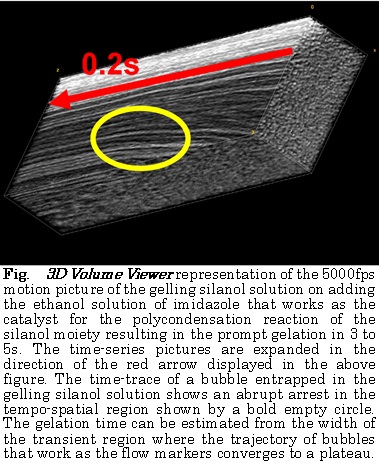
Groundwater contamination of arsenic is a global concern. The challenges in removing arsenic are low adsorption rate, lack of selectivity, regeneration and performance at natural conditions. Two forms of arsenic are predominantly found in nature, Arsenate and Arsenite. To remove Arsenate, As(V), from ground water by adsorption using a composite of cationic polymer gel impregnated with iron hydroxide. The cationic polymer gel that we used is N,N-dimethylamino propylacrylamide, methyl chloride quaternary (DMAPAAQ).
We prepared the gel using a unique method where Sodium Hydroxide and Iron (III) Chloride wasSVA added to the monomer and initiator solutions, respectively, to maximize the FeOOH contents in the polymer structure of the gel.
Results suggest that the maximum As(V) adsorption capacity of our gel, DMAPAAQ + FeOOH, was 123.4 mg/g. At pH7, the maximum As(V) adsorption capacity of our gel was higher than that of other adsorbents currently being used. Selectivity analysis suggests that in the presence of Sulphate and Chlorine, the gel can selectively adsorb As(V) effectively (see Fig. 1).
Regeneration experiments were successful for eight continuous adsorption-desorption cycles with the same gel pieces with 87.6% efficiency at neutral pH levels. Conventional desorption processes use NaOH for desorption. Since NAOH is harmful to human health, we used NaCl instead.
Our newly developed gel composite, DMAPAAQ + FeOOH, adsorbed As(V) effectively and the adsorption amount was higher than the other adsorbents at neutral pH levels. The gel selectively adsorbed As(V) and was regenerated with 87.6% efficiency. The novelty in our research is in the unique preparation method of the gel and the high adsorption performances at neutral pH levels, selective adsorption of arsenic and its reusability. In future, we will examine the performance of the gel in removing As(III) and the applicability in the natural groundwater.
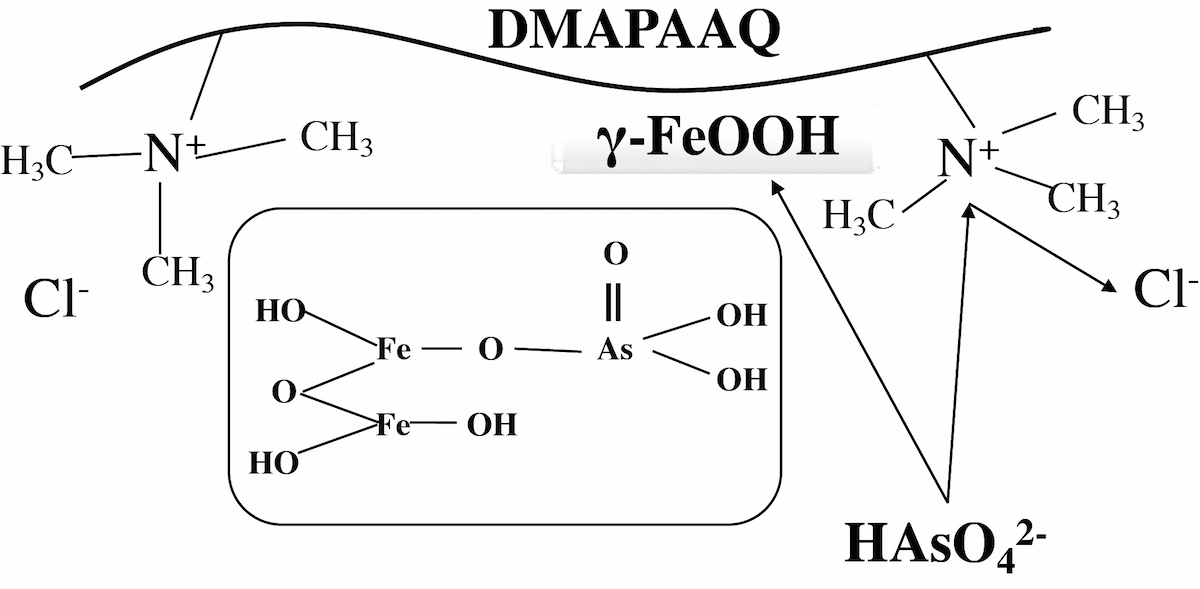
Self-assembly behaviors of fatty acid molecules are sensitive to surrounding pH conditions. Here, we developed a novel methodology to create hydrogel materials using fatty acid and its derivatives. Phase behaviors of oleic acid (OA)/monoolein (MO) mixtures were controlled by pH titration, wherein vesicle, oil-in-water emulsion, and cubic phase (cubosome) were formed at pH 9.0, 7.0, and 5.0, respectively. Rheological properties of cubosomal gel were characterized, and the mechanical properties of cubosomal gel could be improved by modifying with polymerizable fatty acid molecules. In addition, the mesoscopic membrane properties of OA/MO assemblies were systematically characterized by Raman spectroscopy and fluorescent probe Laurdan. It is concluded that the rigidity of the membrane could be key to maintain the mechanical properties of cubosomal gel materials.
Reference: K. Suga et al., Langmuir, 34 (5), 2081-2088 (2018). K. Suga et al., J. Chem. Eng. Japan, 52 (3), 311-316 (2019). K. Suga et al., Langmuir, 32 (30), 7606-7612 (2016). K. Suga et al., Langmuir, 30 (43), 12721-12728 (2014).
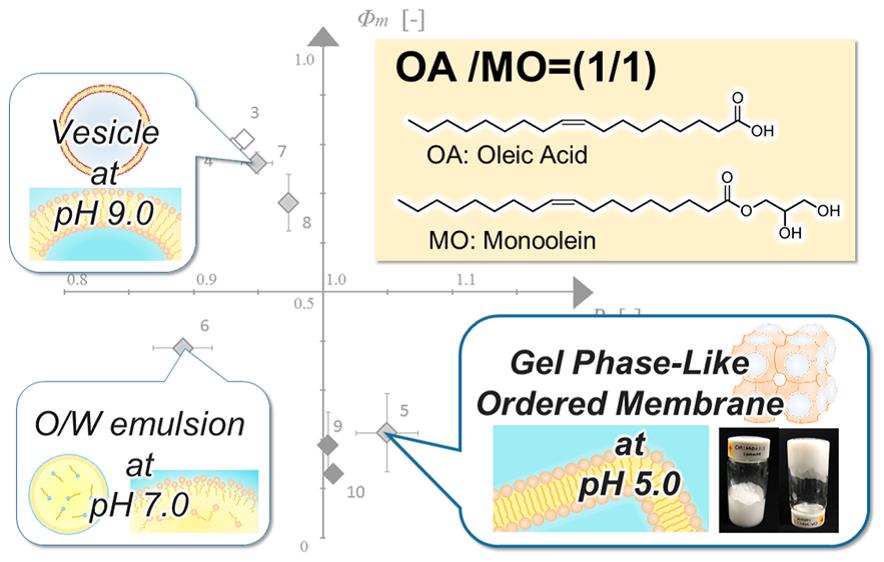
In recent rising environmental problem, competition and interest for CO2 gas capture materials have been increased. Solid CO2 adsorbents such as activated carbon and zeolite have been used for CO2 capture, however, those CO2 capacity or adsorbed kinetics were dramatically decreased in high humid condition. We have been investigated hydrogel film for CO2 capture to show relatively high CO2 capacity in R.H > 95%, however, CO2 absorption kinetic of this hydrogel film was too slow to spend over 1 hour. In this study, we developed an aeroporous hydrogel film (as shown in Fig.1) which consist of phase separation structure for hydrophilic hydrogel phase and hydrophobic porous gas diffusion phase. In this concept, CO2 gas can smoothly penetrate through gas diffusion phase inside film and finally absorb to hydrogel film phase for short time. We prepared aeroporous hydrogel film by mixing between amine containing hydrogel particle (GPs) and acetylene black (AB) using planetary beads milling in dry state, forming film by uniaxial pressing, and humidifying under R.H > 95%. After mixing GPs and AB, obtained powder showed core-shell structure, especially primary AB particle with 30 nm coated on the surface of GPs with approximately 5 μm from its characteristics using SEM, EDS, and particle size distribution laser diffraction type of particle size distribution measurements. After preparation the film, prepared self-standing film shows submicron ordered phase separation of GPs and AB, and a lot of voids was further observed in AB phase from TEM observation. CO2 absorption and desorption kinetics of this film showed higher than that of only GPs film evaluated by pressure swing adsorption method using humid CO2 and N2 gases. We supposed that this result revealed that gas transfer micro-channels in the aeroporous hydrogel film could be maintained under high humid condition and attributed to accelerating CO2 absorption and desorption rate.
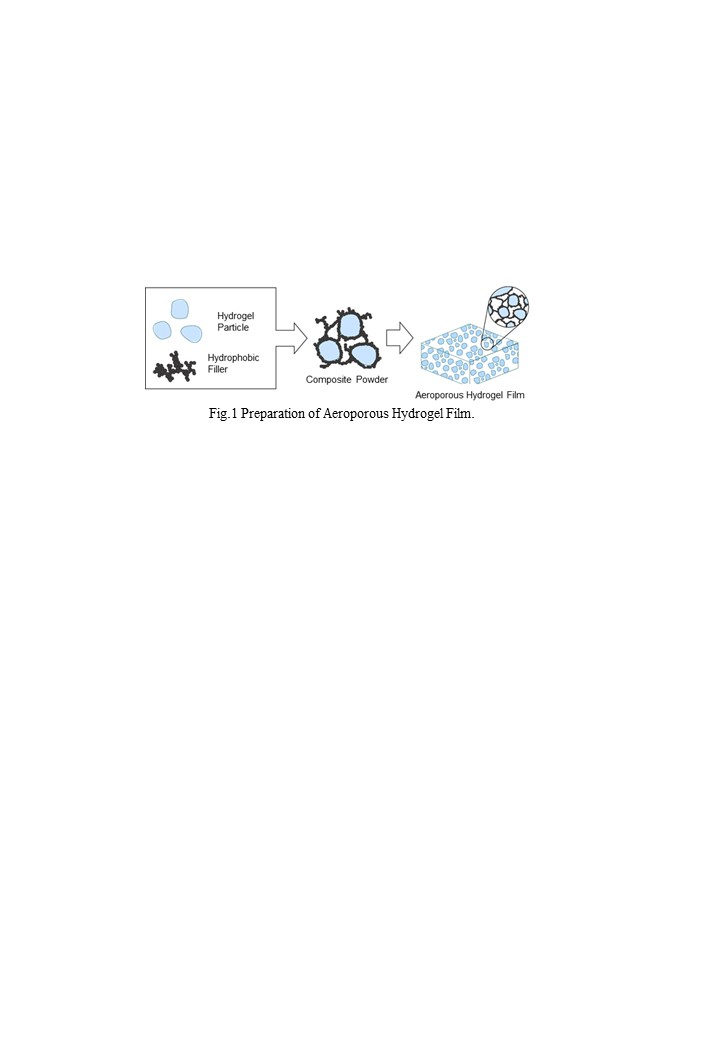
Clean water is a rare commodity to get in several areas, take Batam in Indonesia for example. In 2018 approximately 70 percent of the waterways in the area is polluted by heavy metal contaminant. In this research an efficient and economical metal separation technique is proposed for the adsorption of heavy metal ions in solutions containing heavy metal ions. This technique adsorbs undesired cations and anions at the same time by deploying both cationic and anionic gel to adsorb heavy metals in target solution. The model system consisted of metal ion (PbCl2 or ZnCl2), cationic copolymer gel, and anionic copolymer gel, metal adsorption was successfully conducted. Copolymer gel consisted of N-isopropylacrylamide (NIPAM) as a thermosensitive agent, Acrylic Acid (AAc) / Acrylamidomethylpropane sulfonic acid (AMPS) as cation adsorbent and N,N-Dimethylamino propylacrylamide (DMAPAA) as anion adsorbent. With the existence of NIPAM as one of the major constituent of the gel, gel also exhibits thermosensitive properties, hence gel can desorb and adsorb ions at different temperatures. Figure 1 shows us that adsorption of both cation and anion does occurred in every type of gel. However gels that are able to adsorb cation and anion simultaneously (Dimethyl(acrylamidopropyl)ammonium propane sulfonate (DMAAPS), NIPAM-DMAPAA+NIPAM-AAc, NIPAM-DMAPAA+NIPAM-AMPS) recover more ions compared to other gels. Simultaneous usage of cation and anion gel also increases the reusability of gels. Unlike systems that uses sulfobetaine gel such as DMAAPS gel, this system enables gels to adsorb both cation and anion without any inhibition from inter-chain, intra-chain, and intra group bonding, thus reducing the probability of the system reaching its equilibrium due to the different charges in the target solution. The tested system, where anionic and cationic gels deployed at the same instant, has the potential to efficiently recover heavy metal ion from target solution.
Keyword(s): Thermosensitive, Simultaneous, Adsorption, Heavy Metal.
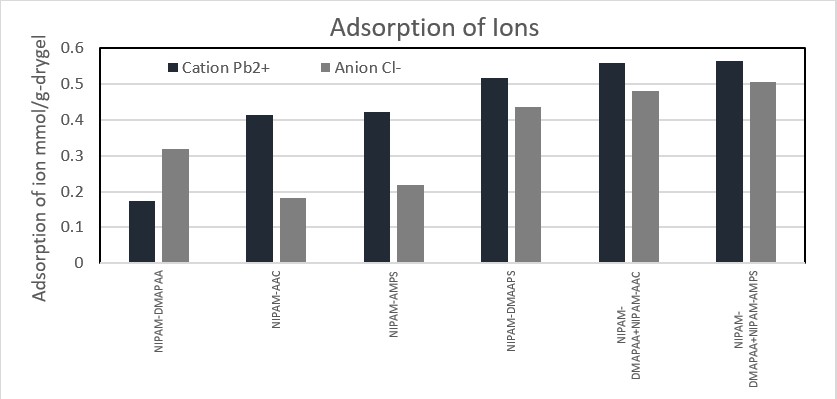
Perfluorocarbons (PFCs) have long been investigated for use in many fields including contrast agent, cancer therapy, and oxygen carriers (OCs) for a long time. In the case of OCs, PFC-based materials aim to provide adequate amount of oxygen to treat ischemic diseases or to facilitate tissue growth in 3D cell culture system for tissue engineering. Nano-sized PFC-based OCs have been studied for several decades due to the high oxygen carrying capacity and low side effects of PFC. In addition, micro-sized OCs are also attractive since they can avoid cellular uptake via endocytosis. Size control has been proposed as a requirement for developing OCs and uniform size distribution is crucial for their function of oxygen supply, durability, and biological interactions. However, it is hard to be accessed by traditional methods, such as mechanical agitations, that produce wide size distribution.
Shirasu porous glass (SPG) membrane emulsification technique is capable to produce monodisperse emulsions with precisely-controlled size. We have, for the first time, prepared PFC-based OCs using SPG membrane emulsification (Fig. 1a).1 By changing the membrane pore size, we were able to precisely control the size of emulsions and fabricate emulsions similar in size to human red blood cells (Fig. 1b). We also fabricated PFC emulsions using different types and concentrations of Pluronics (F127, F68, P85 and P103) as surfactants. The F127- and F68-stabilized micro-sized PFC emulsions were highly stable even during autoclave sterilization. The obtained emulsions were further loaded with oxygen-sensitive probe on their surfaces to indicate oxygen concentration. Their oxygen delivery to cultured cells was demonstrated using genetically-engineered HeLa cells that express EGFP in response to hypoxia.
Reference
1) Fu, X., Ohta, S., Kamihira, M., Sakai, Y., Ito, T. Langmuir 2019, 35, 4094-4100

In recent years, many studies have been made in finding alternative additive to enhance the mechanical and thermal properties of polyvinyl alcohol (PVA). In this study, PVA-clay and PVA-grog composites were fabricated by solution casting method with varying additives composition. Clay and grog particles have been pre-treated by milled and sieved into micron size. The properties of composites were investigated with tensile test, scanning electron microscope, X-ray diffraction, fourier transformed infrared spectroscopy and thermogravimetric analysis. The results showed that PVA molecules could not intercalate into clay and grog particles during solution casting. The structure of composites were suspected to be phase separated instead of exfoliation or intercalation structure. The addition of clay or grog had slightly improved the mechanical strength of composites but FTIR result suggested that the improvement was not caused by hydrogen bonding between filler and PVA. The surface morphology from SEM showed that high loading of clay or grog in PVA has resulted in rougher surface and agglomeration of fillers. Based on XRD result, the average crystallite size of PVA-clay composites decreases with increasing clay loading while the overall crystallinity of PVA-grog composites increases with increasing grog loading. For thermal stability, increasing clay or grog loading have caused the thermal stability of the composites decreased slightly. Overall characterization results of the composites suggested that micron sized clay or grog particles are not suitable to enhance PVA mechanical and thermal properties.
Poly(N-isopropylacrylamide) (PNIPAM) nanogels were synthesized by emulsion polymerization using sodium dodecyl sulfate (SDS). After removal of SDS by dialysis, the surface tensions of the PNIPAM nanogel aqueous dispersions were measured by the pendant-drop method, and it was found that the surface tensions of the nanogel dispersion below the lower critical solution temperature (LCST) of PNIPAM were much smaller than those of water and comparable to those of the SDS aqueous solution. The stability of the aqueous foams generated by nitrogen bubbling thorough the PNIPAM nanogel dispersion was investigated below and above the LCST of PNIPAM. The foam prepared below the LCST was stable in some degree, whereas almost no foam was formed above the LCST. Moreover, the foam prepared below the LCST was quickly collapsed by changing the temperature above the LCST. This rapid defoaming represents that the surface activity of the PNIPAM nanogel can be switched off by the temperature increase across the LCST. In addition, we succeeded in controling the temperature dependence of the Pickering foam stability by copolymerizing the hydrophilic monomer, N,N'-dimethylacrylamide (DMAM) with NIPAM.
We report a microfluidic preparation of poly(ethylene glocol)-based hydrogel microparticles with tunable structures using phase separation in aqueous droplets, followed by cross-linking reaction. The process consists of water-in-oil (W/O) emulsion droplet formation through microfluidic emulsification, subsequent transition from the W/O emulsion droplets to water-in-water-in-oil (W/W/O) double emulsion droplets by internal phase separation, and gelation of the reactive monomer phase in the W/W/O emulsion droplets. We discuss the effect of the rate of gelation on the resulting structures of the hydrogel microparticles.
Advanced materials with low density and high strength have transformative impacts in construction, aerospace and automobile industries. These materials are realized with integrating well-designed modular building units into interconnected structures. Here, we present a hierarchical design strategy to demonstrate a new class of carbon-based closed-cellular structures (CCS). The building units are prepared by a multi-scale approach starting from functionalized graphene oxide nanosheets, leading to the microfluidic synthesis of solid-shelled bubbles with shape diversity at the micro-scale, followed by the assembly into meso-scale 3D structures. Subsequently, these are transformed into self-interconnected and structurally-reinforced CCS, resulting in graphene lattices with rhombic dodecahedral honeycomb structures at the centimeter-scale. The 3D suprastructure simultaneously exhibits the Young's modulus above 300 kPa while retaining a light density of 7.7 mg/cm3 and the elasticity against up to 80% of the compressive strain. The fabricated 3D CCS opens a new pathway for designing lightweight, strong, and superelastic materials.

Biological functions are maintained by various molecular motors, where the driving force is obtained from a chemical potential difference within the microscale. Here, we show in detail artificial vesicles that generate mechanical work from a local pH gradient. The vesicles are composed of oleate and oleic acid and exhibit rhythmic shape change[1] shown in Figure 1. This cyclic motion involves both rotation of the entire vesicle and reversal motion that reverses the vesicle structure of inside and outside, which constitute relaxation and excitation processes against a pH gradient, respectively. A cycle is constituted of these two elementary processes. In our previous work, vesicle motion was observed under an unsteady pH gradient formed by a diffusion of a base solution. As a result, the pH and pH gradient around the vesicle varied throughout the observation period. Therefore, quantitative aspects such as the driving force strength were unclear.
In this study, we observed periodic shape change under a quasi-steady state pH gradient, meaning that the pH gradient can be regarded as constant throughout the observation period. For this purpose, a device maintaining a quasi-steady state pH gradient over a sufficient period of time was made. With this setup, the pH and pH gradient around a vesicle exhibiting a shape change could be estimated. From the motion analysis of the vesicle, the driving force for vesicle motion was evaluated as a function of the pH and pH gradient. As a result, a quantitative discussion of the self-excitation and relaxation processes is provided. The present results demonstrate that this vesicle can be regarded as a molecular assembly machine working under a pH gradient.
Acknowledgements
E.N. gratefully acknowledge the financial support from JSPS KAKENHI Grant Number 19K15425.
Reference
[1] E. Nawa, Y. Nishigaki, D. Yamamoto, A. Shioi, Soft Matter, 2013, 9, 7832.
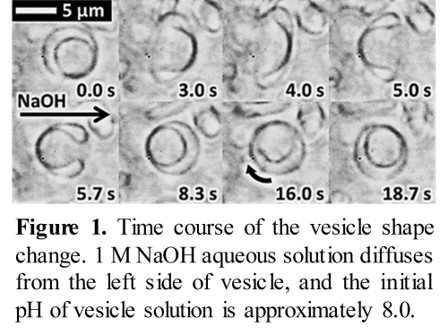
In recent years, poorly water-soluble drugs are increasing, and improvement of water solubility is considered as an important issue. Several methods have been proposed for improving water solubility, and one of them is a method of dispersing a drug by utilizing hydrophobic interaction between a water-soluble polymer having a hydrophobic moiety and a hydrophobic drug. In this method, there is a problem that only a polymer having a hydrophobic part can be used. However, it has been found that the water-soluble polymer itself inhibits the crystallization of the drug even in the absence of the hydrophobic moiety, and that it is possible to disperse the poorly water-soluble drug. This has resulted in more selectable polymers and the ability to use biocompatible polymers. In this study, we tried to use ionic polymers to disperse poorly water soluble drugs via ion-ion interact of water soluble polymers and hydrophobic drugs.
It was confirmed that with Glycol Chitosan as a cationic polymer, Indomethacin, an anionic poorly water-soluble drug, could be dispersed in water. In addition, with anionic polymer Chondroitin sulfate C sodium salt, dispersion of Lidocaine, a cationic poorly water-soluble drug, was also confirmed. Confirmation of the dispersion was conducted by UV measurement and the presence of the ion-ion interaction was conducted by IR measurement. Compared with pure water, the dispersibility of Indomethacin and Lidocaine were improved about 1,600 times and about 50 times, respectively.
In the process of manufacturing crystal products, the crystal size distribution (CSD) of product crystals is required to be monodispersed and unimodal for improving productivity. Therefore, unintentional nucleation needs to be avoided in batch cooling crystallization because it leads to broad or bimodal CSD. Full seeding and partial seeding are well known as seeding policies for inhibiting or controlling nucleation. In full seeding, a large amount of seed crystals are added to inhibit secondary nucleation. On the other hand, in partial seeding, a small amount of seed crystals are added to trigger secondary nucleation and inhibit primary nucleation. In this study, partial seeding was mainly investigated. In the previous study, the optimum operating condition for partial seeding was successfully estimated based on coefficient of variation (CV) by utilizing computation results on inorganic model substance. Product CV was assumed to be small when seeding was effectively performed. Also in this study, the optimum operating condition and the resulting product properties were estimated for various cooling and seeding policies by utilizing computation results on inorganic model substance. Cooling policy was changed not only in the total batch time but also in the cooling mode, as seen in Figure. Here, linear cooling, programmed one, and natural one were performed. The order of programmed cooling np was set to 4 for small supersaturation in an early stage of crystallization. For improving symmetry of condition, the time constant of natural cooling was set to the same value as that of inverse programmed cooling the order of which was 1/np. Seeding policy was changed not only in the mean mass size but also in the CV. The population density of seed crystal was given by the convex quadratic function. Potassium sulfate was utilized as the inorganic model substance.
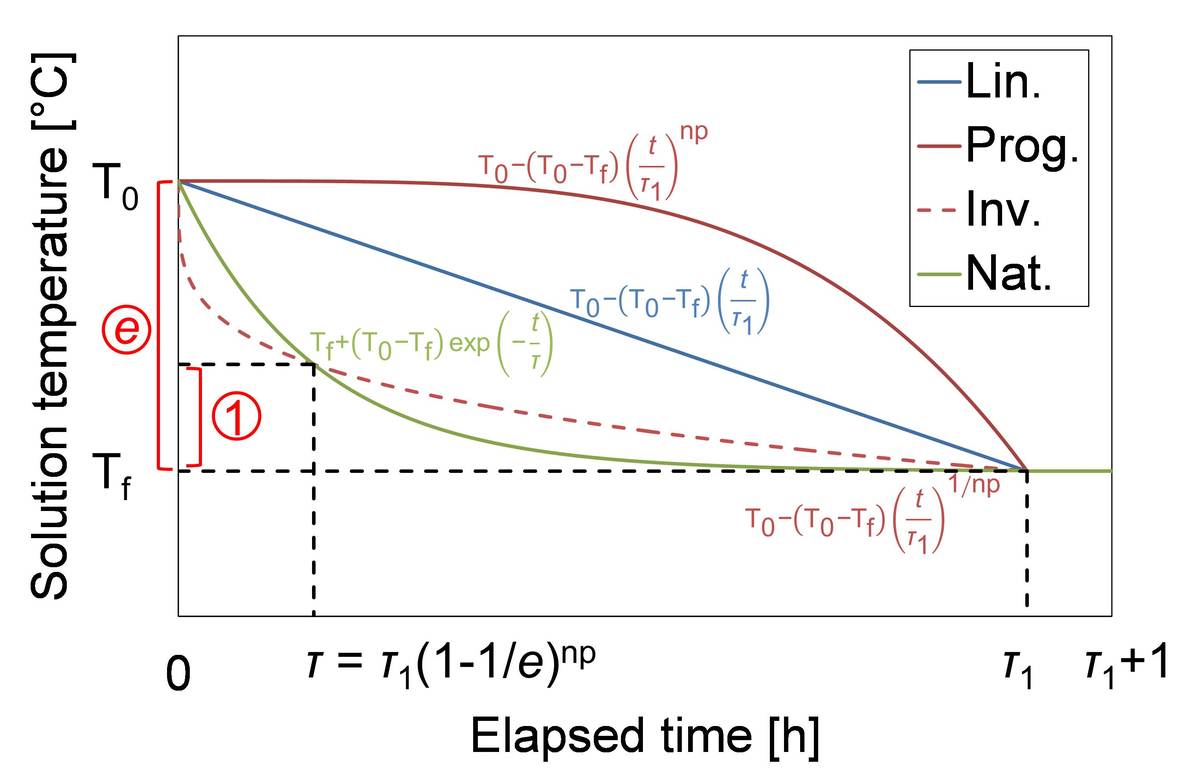
Transparent conductors are widely used for smart-phones, organic light emitting diodes and organic photovoltaics. Indium tin oxide (ITO) is the most common because of its high transmittance and conductivity. However, ITO have some defects. ITO is produced by a vapor phase synthesis and the rate is low, which makes ITO expensive. Second, indium is scarce. Finally, ITO is brittle. Therefore, the alternative transparent conductors have been studied eagerly. Among the studied transparent conductors, copper nanowires (Cu NWs) are promising. It is because copper is more inexpensive and abundant than indium. Moreover, Cu NWs are produced by a solution method, which is economical. Moreover, Cu NWs are flexible and this is advantageous for OLEDs and OPVs. Cu NWs are synthesized by a copper salt, a reducing agent and a capping agent, which determines the property, especially habit of crystals. The widely used capping agents for Cu NWs are amines. In this research, double-jet reactive reaction is applied for process of Cu NWs synthesis. In our previous study, it was difficult to synthesize Cu NWs of desired aspect ratio. On the other hand, double-jet process could control aspect ratio of Cu NWs by controlling reaction time, and to find out that concentration of reducing agent affects aspect ratio of Cu NWs.
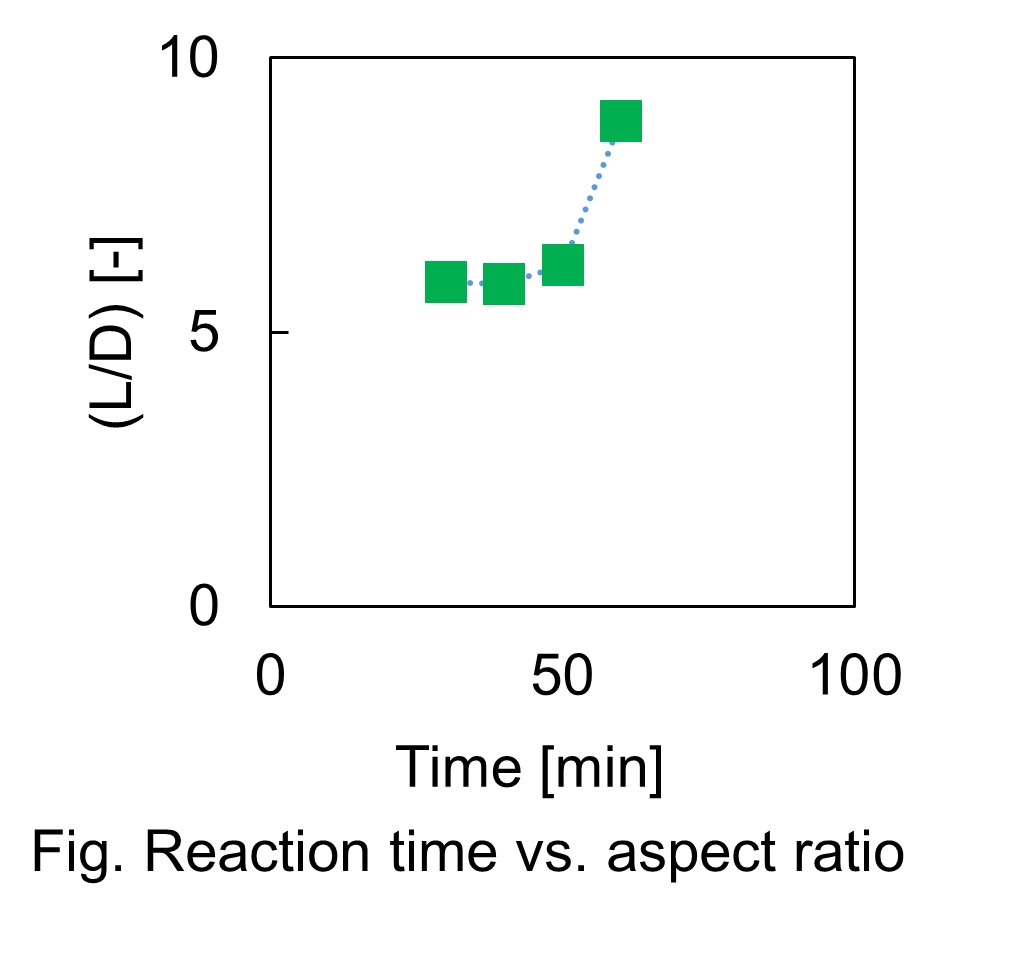
Many of the pharmaceutical compounds have asymmetric carbon. There is a need for techniques to reliably obtain one enantiomer. One of the methods of optical resolution is a preferential crystallization. In the preferential crystallization, crystals with high purity can be obtained by a simple operation. However, if chiral molecules do not racemize in solution, the maximum yield is 50%. By racemizing the chiral molecule in solution, other enantiomers can be converted to opposite enantiomer and crystallized as the desired product. So, the maximum yield would be 100%. Furthermore, repeated operations will be eliminated. In this study, the enzymatic reaction by racemase was examined as a method for racemization. We aimed to improve yield by performing preferential crystallization of DL-alanine combining it with racemization by alanine racemase. The alanine racemases gene from Streptococcus pneumoniae was artificially synthesized and expressed in E. coli shuffle T7. After several steps of purification, the enzyme of 35 kDa with electrophoretic homogeneity was obtained. The enzyme activity of alanine racemase was measured by monitoring the concentration of L-alanine with a circular dichroism dispersion meter. Specific activity for the conversion of L-alanine to D-alanine was 18.4 U/mg. Since alanine is crystallized as a racemic compound, it cannot be resolved by preferential crystallization. Thus, in order to crystallize as a racemic conglomerate, co-crystallization of alanine and p-chlorobenzene sulfonic acid (CBS) was performed. Optical resolution by preferential crystallization was performed. The alanine was dissolved at 40 °C and slowly cooled to 25 °C. When the solution reached to saturation temperature, seed crystals of D-Ala/CBS were added into the solution. After stirring for 1 hour at 25 °C, the crystals were recovered by filtration. The yield of crystals and the enantiomeric excess were 74% and 72%ee, respectively.
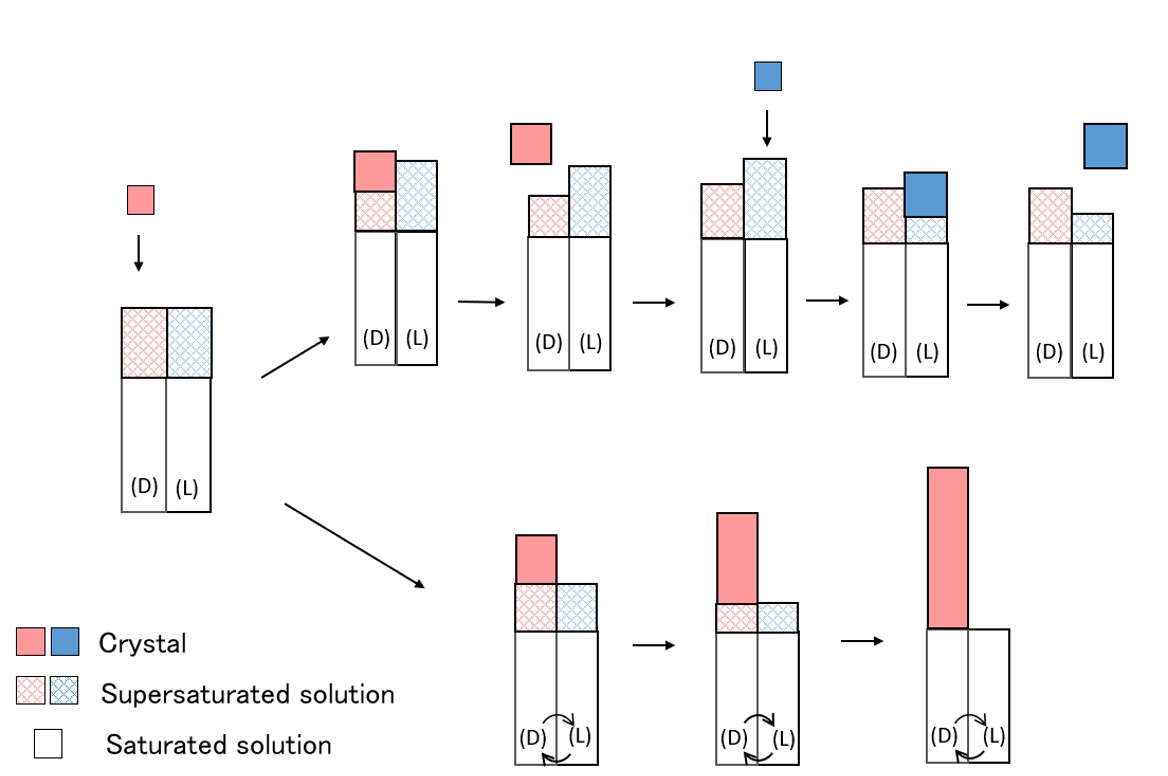
Since crystal nucleation directly affects the characteristics of the crystal, control of crystal nucleation is crucial in industrial crystallization. Previously, we reported that active diffusion of solute molecules in solution could be a trigger of nucleation. In this study, we investigated a new strategy to induce crystal nucleation. When immersing plastic pieces in solution, intermolecular interactions occur between the plastic surface and the solute molecules. When the plastic piece is moved vertically in this state, solute molecules which interact with the plastic also move together. The movement of the solute molecule reproduces unidirectional active diffusion of the solute molecule, and it is thought that crystal nucleation could be induced. In order to confirm this, we investigated the effect of the movement of plastic pieces on the crystal nucleation of L-alanine. Special experimental equipment and image processing software were developed. The plastic piece (polypropylene (PP)) was moved up and down vertically in alanine solution at a constant speed of 0.5, 2.0, and 5.0 mm/s. After that, the time when the first crystal was observed was recorded for at least 27 samples. Results were analyzed by cumulative distribution functions, and nucleation rate and average induction time were estimated. At all speeds, the nucleation rates were much higher than when the plastic was not in contact. In addition, it was also found that no crystals were generated when the plastic was immersed in the solution and left to stand. Therefore, it was suggested that the movement of plastic in solution induces nucleation of L-alanine. Comparing the nucleation rates at each speed, the nucleation rate was fastest at 2.0 mm/s. From these results, it was concluded that nucleation induction by the movement of plastic is caused through two processes, that is, the formation of intermolecular interaction and unidirectional movement of solute molecules.
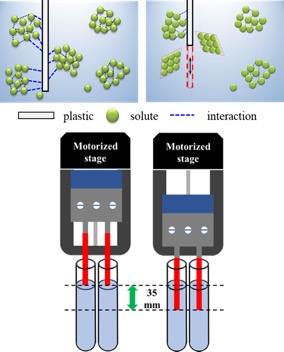
Novel small scale continuous crystallizer was developed to produce small uniform crystals. In the field of pharmaceutical crystallization, research on continuous crystallization is actively conducted. In particular, there is a need for a technique for continuously producing microcrystals without milling process. However, since the conventional continuous crystallizer has a large working volume, the residence time distribution becomes large, and it is difficult to control the crystal characteristics. Thus, we have developed a small continuous crystallizer to realize short residence time. The crystallizer is a 9 mL stainless steel device equipped with a high-speed agitator with a maximum stirring speed of 24000 rpm. Comparing with the large scale crystallizer, the average residence time is short, the distribution of residence times is narrow, and the concentration and temperature in the crystallizer are homogeneous. Therefore, small uniform crystals can be obtained. Anti-solvent crystallization of glycine was performed. Ethanol was used as a poor solvent. Almost 100% yield was attained even very short residence time (0.3-33 s). The shape and particle size of the obtained crystals were observed with a scanning electron microscope. More uniform crystals were observed compared to that obtained by the conventional crystallizer. Furthermore, it was also advantageous to polymorphic control. Due to the short residence time, the desired metastable crystals were recovered avoiding the solvent-mediated transition to the stable form.
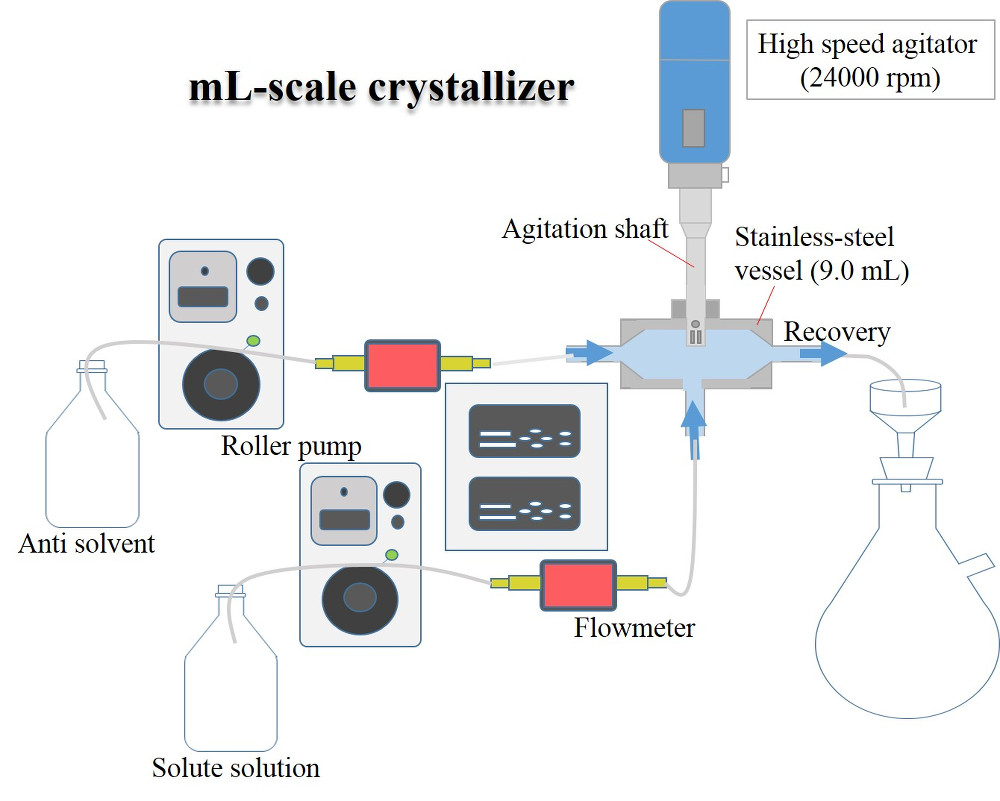
Unseeded semi-batch cooling crystallization of potassium alum (AlK(SO4)12H2O, K-alum) was carried out to obtain uniform crystals with narrow size distribution. In this paper, influence of feeding condition on crystal size distribution is mainly discussed. Seeding policy studied by the research group of Iwate University is a powerful idea for the successful inhibition of secondary nucleation leading to monodisperse crystals. However, seeding methodology is often undesired particularly in the pharmaceutical and/or food industries because the possibility of containing impurity in the seed crystals is not always ignored. The internal seeding method (unseeded method) was reported by the above research group, however, the theoretical aspect of operation design has not been clarified. This study continues the internal seeding method to develop theoretical feed condition as unseeded crystallization policy. One of the strategy to obtain narrow size distribution is the division of cooling stage (feeding stage) for the separation of nucleation and growth period.
Polymorphism occurs when a compound can exist in more than one crystalline form. Because of the different properties of polymorphs, it is advantageous to choose the proper polymorph for the desired application. In the crystallization processes involving polymorphs, the formation of the desired polymorph has to be controlled and such a process should be robust and reproducible. In the polymorphic crystallization, relative nucleation rates, relative growth rates, and the transformation of crystallizing polymorphs should be controlled individually. Therefore, the determination of the crystallization (nucleation and growth) and dissolution kinetics, and thermodynamics are important for characterization of the crystallization behavior and transformation of the polymorphs. Thermodynamics determines the polymorphic forms and their properties such as solubility. The nucleation, growth and dissolution kinetics determine the kinetics of the crystallization and transformation of the polymorphs. In this work L-histidine (L-his) is the model substance; it is one of the essential amino acids and is significant in the food and feed industries. There are two known polymorphic forms, forms A and B. Form A is the stable form and form B is the metastable form. In the present study the crystal growth kinetics of the metastable polymorph B of L-his were performed and studied. The crystal growth rates were measured in aqueous solution of L-his. The crystal growth rates increased with increasing temperature, concentration of solute, and seed mass. The growth rates were correlated to the supersaturation with a power-low equation. The results indicated that the crystal growth process was controlled by surface integration mechanism at temperature of 10 and 25 degreeC and diffusion mechanism at 40 degreeC. Growth kinetics of the polymorphs of L-his will be used to begin characterization of the polymorphic transformations and the overall crystallization rate of L-histidine.
Crystallization is used widely in industrial processes for products such as chemicals and pharmaceuticals. Stirred-type crystallizers can produce various complex phenomena such as crystal growth, abrasion, and aggregation, which affect the total number of crystal particles in a vessel and their particle size distribution. Population balance analysis of the number of crystals coupled with mass balance of the solute material provides an important means of predicting and controlling the number of crystals in the crystallizer. In this study, particularly addressing the aggregation phenomenon, methods for measuring the degree of supersaturation in solution, the particle size distribution, and the amount of aggregation were developed. Relations among them were investigated for various seeding and cooling rate conditions.
Batch-type cooling crystallization of potash alum started with seeding was examined as a model case. The solution contains crystal particles in the vessel aspirated through the quartz observation cell every 10 min. A high-speed movie camera recorded the motion of crystals through the cell. The particle size distribution was calculated from the obtained image using the original MATLAB program. Moreover, the time evolution of solution concentration was estimated from measurements of the solution electrical conductivity and temperature. The solution conductivity is affected by the suspended crystal particles. Therefore, the effects of particle size and suspension concentration on conductivity were calibrated using unimodal glass particles.
Results show that the time evolution of the solution supersaturation degree and crystal aggregation were estimated successfully based on the combination of the solution conductivity, temperature, and particle size distribution measured during the crystallization operation. When the seed crystals were few, the crystal surface area was small during the initial stage of crystallization; then the mode diameter of crystals in the final stage became large.
Low aqueous solubility of crystalline drugs is the major issue in the pharmaceutical field. Normally, two-component amorphous solid dispersion is used as conventional strategy for improvement of their solubility. Unfortunately, it is known that amorphous phase shows poor stability. Therefore, development of novel strategy for improvement of solubility is strongly desired. On the other hand, our recent study using eutectic solid dispersion found that nucleation rate enhancement of second component encourages refining eutectic phase including target component. Normally, refining eutectic phase including target component is favorable structure for enhancement of dissolution rate. Therefore, it is suggested that enhancement of nucleation rate is probably effective strategy for improvement their solubility. In addition, it is expected that formation of eutectic having a refined microstructure occur with refining the eutectic phase, which affects their solubility. Therefore, the objective of this present study is development of newly strategy for improvement of dissolution rate by nucleation rate enhancement of second component based on eutectic melt system. Sorbitol (target component)-Xylitol (second component) was used in the experiment system. In this study, we focused on two nucleation factors that are shear force and supersaturation. Therefore, we investigated the influence of seed crystal mass and cooling rate on the nucleation of the second component and dissolution rate of target component. As a result, it is showed that dissolution rate of the crystal phase was influenced by the seed crystal mass and the cooling rate. Furthermore, it was found that the dissolution rate increased with increasing of seed crystal mass and cooling rate. This means that solubility could be improved by promoting the nucleation rate of the second component. Therefore, our novel concept based on nucleation rate enhancement of second component is probably effective strategy to improve the solubility of target component.
Crystallization operation is used as the final process in chemical products manufacturing. The production of crystals with high quality is required because the final product quality strongly depends on the crystal quality. Therefore, quality control in the crystallization operation is essential.
The crystal quality is determined by desired many kinds of characteristics. Generally, the average value of each characteristic of individual crystals is used as standard whether the desired quality is achieved or not. On the other hand, it is also important to evaluate the variation of their qualities constituting the crystalline particles. In particular, their qualities tend to vary when the agglomeration phenomenon occurs. Therefore, achievement of the desired quality and improvement of the variations in individual crystal quality is strongly needed to control in crystallization process. Our present work reported that homogeneity is a useful index to evaluate variations of crystalline particles. Thereby, the purpose of this research is to develop the newly method of crystallization operation for improvement of homogeneity for agglomerated crystalline particles in reaction crystallization. In this study, L-Aspartate sodium (L-AspNa) and hydrochloric acid (HCl) were used as reaction system. L-Aspartic acid is objective crystalline material.
As a result, we found that homogeneity could be improved by supersaturation modulation operation. Unfortunately, it was also showed that using only supersaturation as an operation variable is not enough to product crystals with various qualities because it directly influenced on their characteristics such as size and shape. For this reason, pH of the solution was used as additional operation variable for quality control of crystals because solubility of L-Asparatic acid depends on pH. Consequently, production of crystals having various qualities was succeeded with keeping high homogeneity. Therefore, it was suggested that crystalline particles with high homogeneity could be obtained by using the multiple operation variable.
Quality control in the crystallization operation is required to obtain desired products because its quality depends on the properties of crystalline particles. It is known that their properties such as morphology and shape are determined by nucleation and growth of crystal. Thereby, controlling the nucleation and growth process individually is important. Normally, nucleation and growth occur simultaneously in conventional crystallizers, which means that conventional crystallizer are not suitable to obtain uniform product. For this reason, development of novel crystallizer for controlling nucleation and growth individually is needed. On the other hand, designing a newly production process based on conventional crystallizer has some advantages because of low investment cost and standard operation. Therefore, it is suggested that a crystallization process specializing nucleation should be integrated to conventional process in serial to separate nucleation and growth. We focused on the Taylor Vortex. Previous study reported that Taylor Vortex shows high shear stress due to its specific vortex ring, which is favorable flow state for enhancement of secondary nucleation. However, the driving force of nucleation and growth is determined by a supersatutration of feed solution. This indicates that the balance of each processes is limited even if nucleation is separated from growth using two continuous crystallizers. On the contrary, we designed the novel cascade type crystallizer based on Taylor Vortex. The purpose of this study is investigation of operation strategy for designed cascade type crystallizer to produce crystalline particles with uniform quality. The crystal shapes obtained by conventional and novel cascade process were evaluated using SEM. As a result, the dispersion of crystal size became narrow, which means that quality of crystal could be improved by using our designed crystallizer. We expect that our proposed crystallizer is favorable continuous process to produce crystalline products with desired quality.
The adsorption experiments were first carried out to remove the impure acetic acid from the mixed acids (phosphoric acid + acetic acid) as raw model waste solutions. The adsorbent used in this study was very effective to adsorb acetic acid selectively. The adsorption capacity of adsorbent was about 5% for acetic acid. Moreover, new adsorption-assisted crystallization was performed for purification of phosphoric acid crystals from the mixed acids. The crystallization temperature and the additional ratio of the adsorbent was changed as the experimental conditions. It was found that crystals of purity more than 99% phosphoric acid were easily obtained. The yield of phosphoric acid crystals increased as the crystallization temperature was lowered. The purity of phosphoric acid crystals increased slightly when the additional ratio of adsorbent was increased in the mixed acids. It was clarified that high purity phosphoric acid crystals can be purified efficiently by the synergetic effect of the adsorbent.
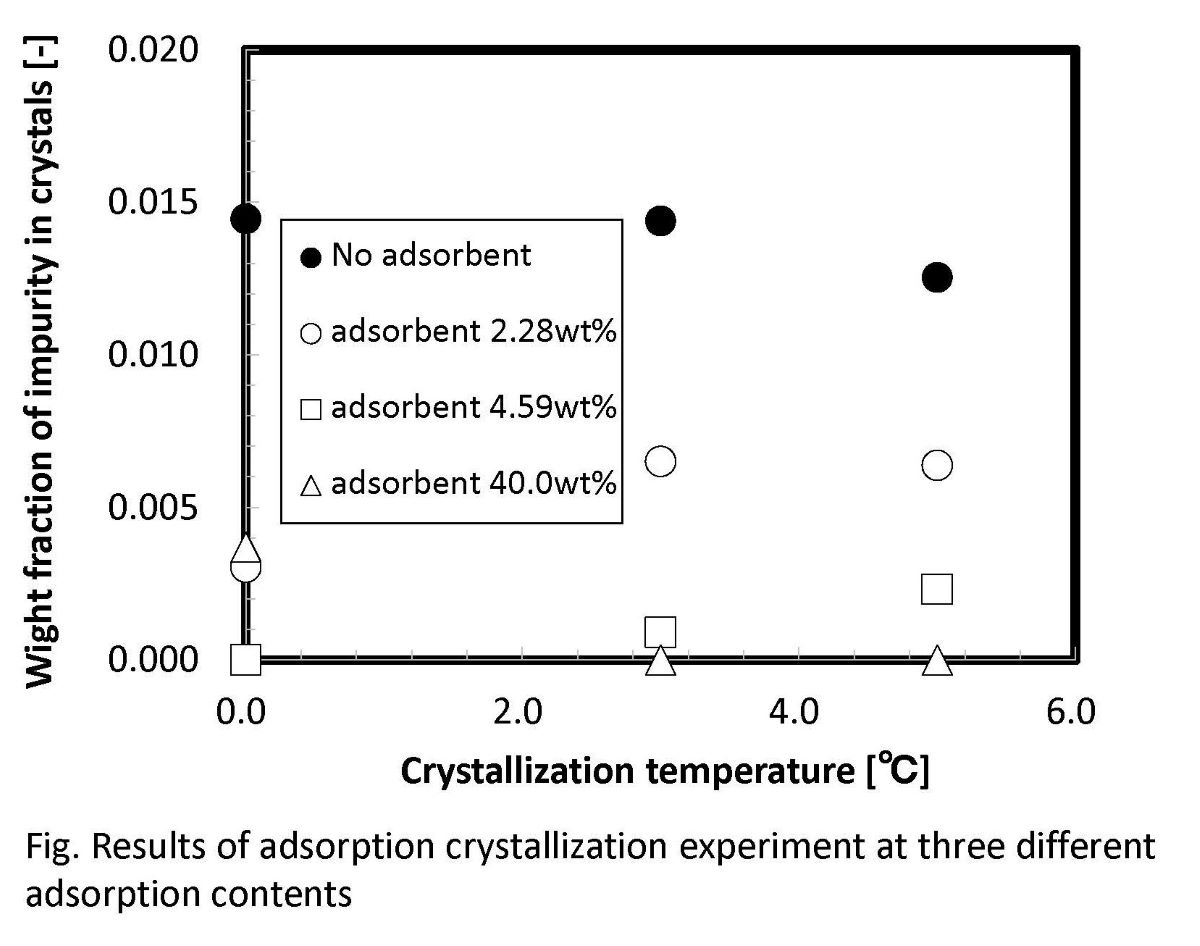
Recovery of valuable resources from waste plating solution has been of great interest from the viewpoints of both environmental protection and resource management. In this study, we attempt reactive crystallization combined with ozone oxidation to recover phosphorus species, which are contained in a waste plating solution as the reducing agent for electroless nickel-phosphorus plating, as calcium phosphate. The effects of the experimental conditions such as pH, temperature, the amount of calcium chloride added to the solution on the recovery yield are examined.
Core-shell mesoporous silica particles (MSPs) composed of a nonporous core and porous shell have attracted attentions due to higher monodispersity in particle sizes and more highly mechanical strength than mesoporous particles without a core. The core-shell MSPs can be used as packing materials to separate chemical substances in high performance liquid chromatography (HPLC) [1]. The performance of separation strongly depends on physical properties of MSPs, including particle sizes, pore sizes and shell thickness. The physical properties should be tuned to separate a variety of chemical substances.
Our group has been working on the synthesis of MSPs in sol-gel reaction where hydrolysis and condensation of silicon alkoxide are conducted in the presence of submicron-sized cores and cationic surfactants under basic conditions [2]. In conventional sol-gel reaction without cationic surfactants, sizes of silica particles formed are increased by electrolyte addition to the reaction system [3]. The increase in particle sizes by electrolyte addition has a potential of thickening mesoporous shell on the cores in the presence of cationic surfactants.
In this study, synthesis of core-shell MSPs was performed in the presence of electrolytes to increase the mesoporous shell thickness.
References
[1] Hayes R., Ahmed A., Edge T. and Zhang H., “Core–shell particles: Preparation, fundamentals and applications in high performance liquid chromatography”, J. Chromatogr. A, 1357, 36–52 (2014)
[2] Ishii H., Nara M., Hashimoto Y., Kanno A., Ishikawa S., Nagao D. and Konno M., “Uniform formation of mesoporous silica shell on micron-sized cores in the presence of hydrocarbon used as a swelling agent”, J. Sol-Gel Sci. Tech., 85, 539-545 (2018)
[3] Nagao D., Kon Y., Satoh T. and Konno M. “Electrostatic interactions in Formation of Particles from Tetraethyl Orthosilicate”, J. Chem. Eng. Japan. 33, 468-473 (2000)

Mesoporous silica are functional materials with high specific surface area caused by regularly ordered mesopores. Mesoporous silica have been applied to absorbents, catalyst supports and drug delivery carrier. In order to apply the mesoporous silica to various fields, particulate mesoporous silica is attracting a lot of attention. One of the important factor to be controlled is pore size distributions in the synthesis of mesoporous silica particles (MSPs). Micelles of surfactants can be a template for mesopores of silica particles formed in the sol-gel reaction [1, 2]. Addition of hydrophobic molecules as a swelling agent to the synthetic system could enlarge pores in the silica matrix [1].
Our group has been working on the synthesis of MSPs in sol-gel reactions in mixed solvents of water and ethanol in the presence of cationic surfactant used as template micelles [3]. The addition of swelling agents increased sizes of mesopores in MSPs [4], although mechanism on enlargement of mesopores in the formation of MSPs is not sufficiently clarified.
The present study examined the effects of solvent composition on spherical particle formation and pore size distribution. The affinity of swelling agents to the mixed solvent was examined using different hydrophobic molecules. Analysis by Hansen solubility parameter (HSP) could correlate swelling agents with pore size distribution.
[1] J. S. Beck et al., J. Am. Chem. Soc., 114, 10834–10843 (1992), [2] T. Yanagisawa et al., Bull. Chem.Soc.Jpn, 63, 988–992 (1990), [3] H. Ishii et al., Adv. Powder Technol., 27, 448–453 (2016), [4] H. Ishii et al., J. Sol-Gel Sci. Technol., 85, 539–545 (2018)
Characteristics of particles strongly depend on the particle shape. Synthesis of anisotropic particles has been extensively studied to functionalize particles in recent years. Location and orientation of the anisotropic particles can diversify colloidal assemblies of the anisotropic particles.
To fabricate the colloidal assemblies, several methods such as suspension drying and using chemical interaction between particles have been developed. Depletion interaction is one of the powerful approaches to assemble colloids into desired structures in solution. The attractive depletion interaction between particles is induced by osmotic pressure in the presence of depletants (e.g. non-absorbing polymer, surfactants and nanoparticles). The attractive interaction is proportional to both depletant concentration and overlapping between depletant layers to which depletants cannot access.
Our group previously reported depletion-interaction-driven assembly of golf ball-like particles for development of colloidal macromolecules [1]. Golf ball-like particles have a large number of dimples on their surface.
In the present work, we tried to synthesize golf ball-like particles having hemi-rod-shaped dimples and demonstrated an assembling of the golf ball-like particles and rod-shaped particles via depletion interaction. Anisotropic particles with rod-shapes are expected to be captured by the hemi-rod-shaped dimples due to depletion interaction. The capture of particles has a potential of new purification process in which targeting particles can be intentionally collected depending on their shapes and sizes.
[1] K. Watanabe, Y. Tajima, T. Shimura, H. Ishii, D. Nagao, Journal of Colloid and Interface Science, 534, 81-87 (2019).
Recently, MoS2 is considered to be the most prospective candidate of anode materials for lithium ion batteries becuase of its high theoretical capacity (670 mAh g-1) and layered structure. However, it has usually suffered from structural deterioration, due to a large volume change on charge/discharge and low intrinsic electrical conductivity, which lead to a poor cycling performance. In this study, we have prepared porous MoS2 microspheres by spray pyrolysis with (NH4)2CO3 additive and investigated their pysical and electrochemical properties.
The precursor solutions were prepared by dissolving the required amount of (NH4)2MoS4 and (NH4)2CO3 in distilled water. Spray pyrolysis synthesis was conducted at different synthesis temperatures and concentrations of precursor solutions at a gas (3%H2+97%Ar) flow rate of 2 L min-1. The resulting samples were characterized by X-ray diffraction (XRD), scanning electron microscopy (SEM), and X-ray photoelectron spectroscopy (XPS). N2 adsorption–desorption measurements were performed at a liquid N2 temperature of 77K. Pore volume and size distribution were estimated from the desorption branches of the isotherms by the Barrett–Joyner–Halenda model. Their electrochemical properties have been investigated using CR2032 coin-type cells.
The XRD peaks of the sample prepared at 800°C from the precursor solution of 0.05 mol L-1 (NH4)2MoS4 and 0.50 mol L-1 (NH4)2CO3 could be indexed well to the hexagonal phase of MoS2 (ICSD No. 31067) without any other phases. The desired Mo-related bond features of the sample were confirmed by XPS analysis. The pore structure analysis based on N2 adsorption–desorption isotherm led that the MoS2 microspheres with pore size less than 200 nm could be prepared and the (NH4)2CO3 additive in precursor solution could enlarge the porosity in MoS2 microspheres, especially the pore size between 20 to 100 nm. As a result, the porous MoS2 microspheres improved its cycle performance, as shown in Fig. 1.
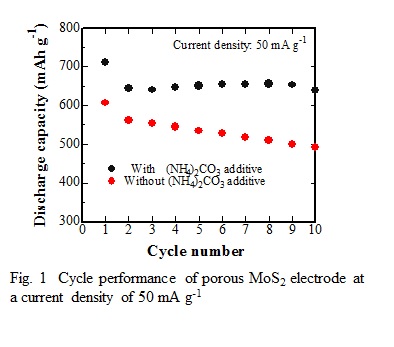
Porous carbon microspheres impregnated with transition metal-based nanoparticles have been considered as next generation materials for energy and environmental applications. In this study, we have prepared cupper (Cu) nanoparticles impregnated porous carbon microspheres by spray pyrolysis with heat treatment from the precursor solutions which appropriate amount of sucrose (C12H22O11) and cupper chloride dihydrate( CuCl2 2H2O) with citric acid (C6H8O7) additive were dissolved in distilled water, and investigated their pysical properties.
The precursor solutions were prepared by dissolving the required amount of C12H22O11,CuCl2 2H2O and C6H8O7 in distilled water. Spray pyrolysis synthesis was conducted for different synthesis temperatures and concentrations of precursor solutions at a gas (N2) flow rate of 2 L min-1. The as-prepared samples were further annealed at 800 °C for 2 h in a 3%H2/97%N2 mixture gas. The resulting samples were characterized by X-ray diffraction (XRD), field emission-scanning electron microscopy (FE-SEM) with an energy dispersive spectroscopy (EDS). Nitrogen (N2) adsorption–desorption measurements were performed at a liquid N2 temperature of 77 K The carbon content of the samples was estimated using an element analyzer (CHNS, Elementar, Vario Micro Cube).
Fig. 1a shows the XRD patterns of the sample prepared at 800 °C from the precursor solution by spray pyrolysis and then annealed at 800 °C for 2 h in a 3%H2/97%N2 mixture gas. It can be clearly seen from the XRD pattern of as-annealed sample that crystallized Cu could be obtained from the present preparation route. The N2 adsorption-disorption isotherm of the as-annealed sample indicated that it had mesopore structure, and the content of carbon was 28 wt% by CHNS analysis. Furthermore, it could be verified from the SEM-EDS analysis that the porous carbon microspheres impregnated with cupper nanoparticles could be sythesised by the present preparation route (Fig. 1b)
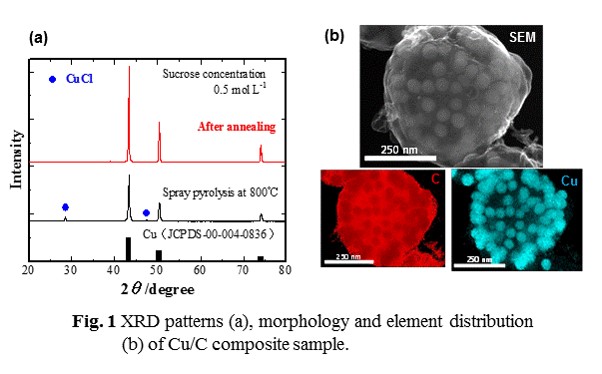
LiNixCoyMnzO2 (x≥0.33, x+y+z=1) (NCM) have a great potential as cathode materials for Lithium-ion batteries due to their abundant sources, high specific capacities and outstanding thermal stability. With the increasing content of nickel, NCM shows higher reversible capacity together with lower cost and toxicity. In this study, spherical nanostructured NCM particles were synthesized directly from homogeneous precursor solutions by spray pyrolysis followed by annealing in air atmosphere. The effect of process parameters on the physical and electrochemical properties of NCM was investigated.
LiNO3, Ni(NO3)2·6H2O, Mn(NO3)3·6H2O and Co(NO3)2·6H2O were used as the starting materials. These materials were dissolved in distilled water with the stoichiometric ratios of NMC. The starting solutions were atomized by an ultrasonic nebulizer at a frequency of 1.7 MHz. Then the generated droplets were carried to a spray pyrolysis reactor heated at different temperatures (400 -600 °C ) by the air gas with a flow rate of 2 L min-1. The as-prepared samples were further annealed at different temperatures in air atmosphere.
Crystal structures of the synthesized materials were determined by X-ray diffraction (XRD) analysis using Cu-Kα radiation. Fig. 1 shows the XRD patterns of the LiNi1/3Co1/3Mn1/3O2 (NCM-111), LiNi0.5Co0.2Mn0.3O2 (NCM-523) and LiNi0.8Co0.1Mn0.1O2 (NCM-811) samples synthesized at 500 °C by spray pyrolysis followed by annealing at 800 °C for 6 h. It can be seen that the well-crystallized NCM samples are formed with α-NaFeO2 hexagonal structure.
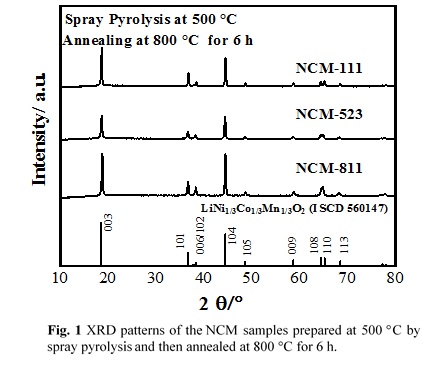
Integration of renewable energy sources with energy storage systems appears to be an encouraging approach to reach sustainability in green energy supply. It is expected that iron particles dispersed carbon microspheres (Fe@C) will find a broad application in many future generation energy storage systems and environmental issues. In this work, we have synthesized Fe@C using ultrasonic spray pyrolysis (USP) followed by annealing and studied synthesis parameters.
The precursor solution was prepared by dissolving an appropriate amount of sucrose, ammonium nitrate and iron nitrate in distilled water. Spray pyrolysis synthesis of Fe@C was carried out at 700 °C in an inert atmosphere (pure N2). Post-annealing of the samples was conducted at 700 °C for 4 hours in a reducing atmosphere (3%H2/97%N2). The obtained samples were characterized by X-ray diffraction (XRD), scanning electron microscopy (SEM), Fourier transform infrared (FTIR) spectra, and Brunauer-Emmett-Teller (BET).
Fig.1 shows the XRD pattern of the Fe@C prepared at 700 °C spray pyrolysis temperature followed by annealing at 700 °C for 4 hours. Three sharp peaks at approximately 45 °, 65 ° and 82 ° correspond to zero valent Fe while a peak at about 27 ° indicates the formation of graphitic carbon. SEM observation of the obtained sample shows that zero valent Fe particles evenly dispersed in the carbon microspheres (Fig.1 inset).
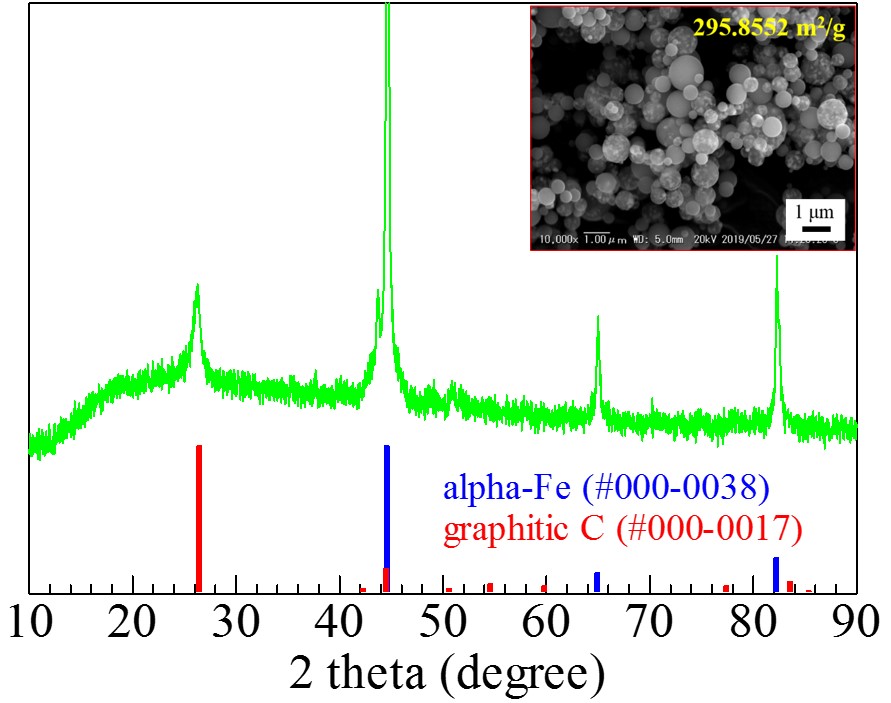
Gallium oxide (Ga2O3) is known to have five polymorphs, that are, α-, β-, γ-, δ-, and ε- Ga2O3. Among them, β-Ga2O3 is the most stable crystal structure and attracted recent attention as the material for power electronics, solar cells, and sensors. The conventional synthetic method of β-Ga2O3 nanoparticles is the so-called two-step method where hydrothermally synthesized GaOOH is calcinated at temperatures around 700 °C or above. In this presentation, we report an alternative one-step method to synthesize of β-Ga2O3 nanoparticles under solvothermal condition. In this method, gallium nitrate was dissolved in alcohol and then heated at 300 °C or above in a high-pressure reactor. The solid products were purified and analyzed by an X-ray diffractometer and a scanning electron microscope. Results showed that the crystal structure of the products gradually changed from γ-Ga2O3 to β-Ga2O3 as the reaction time increased. The average size of the produced nanoparticles was about 50 to 100 nm, which is much smaller than the products from the two-step method. This might be because our one-step method does not require a calcination process that allows the aggregation of particles during annealing.
Metal nanoparticles play an important role in catalysis, sensing, and imaging applications. Bimetallic systems are attractive for improving the physical and chemical properties by varying the elemental combination, composition ratio, and architectures of nanoparticles. However, designing the bimetallic nanoparticles are difficult because of many factors influences the nucleation and growth processes. In this study, we focused on the reduction rate of the metal precursors during the polyol synthesis of Ag-Rh nanoparticles. A microflow reactor was employed for obtaining reliable kinetic information by enhanced heat transfer performance. Reaction at elevated temperature in ethylene glycol was successfully examined by rapid heating and cooling with a microflow reactor. Ag precursor and Rh precursor showed strong interaction on the reduction rate. Reduction of Ag+ in ethylene glycol got slower with the higher reaction temperature, which contradicts to the Arrhenius law. The concentration profile of rhodium acetate would cause complex behavior due to its catalytic effect on the reduction. Elemental mapping of synthesized particles implied that the solid-state diffusion played a crucial role in the formation of alloyed Ag-Rh nanostructures.
When a small amount of water is added to a suspension in which particles are dispersed in oil, the number water between particles is formed. Such a substance is called a capillary suspension, it having fluidity change to flow characteristics like gel. However, detailed mechanisms and characteristics of capillary suspension have not been studied. In this study, the particle / oil / water capillary suspension was prepared using various particles and evaluated the rheological properties.
Firstly the particles and the oil were mixed with a dissolver stirrer to prepare a suspension. Next, capillary suspension was prepared by adding small amount of water to the suspension and stirring for 10min. Viscosity and rheology of the product was measured with a rotary rheometer. Fig.1 shows the effect of water volume fraction on the viscosity of capillary suspensions prepared by using three types of particles (Sillica(2.5μm),sillica(1.0μm),Cacao powder(2.5μm). The viscosity profile shows the maximum value at the certein water volume fraction, which we called the optimum crosslinked water content (OCWC) . From the results, the samples using particles of the same material showed the same OCWC. However, samples using different particle with same particle size showed different OCWC. When the three-phase contact angle of cocoa powder is lower than that of sillica. It is considered that the OCWC became high because more hydrophilic characteritics. It is thought that the rheological property value of the capillary suspension can be estimated by the three-phase contact angle, interfacial tension, particle size and particle concentration. By measuring the yield stress, it is possible to calculate the capillary force acting between particles of each sample. It was found that the three-phase contact angle, which varies depending on the material of the particles, is closely related to the rheological property.
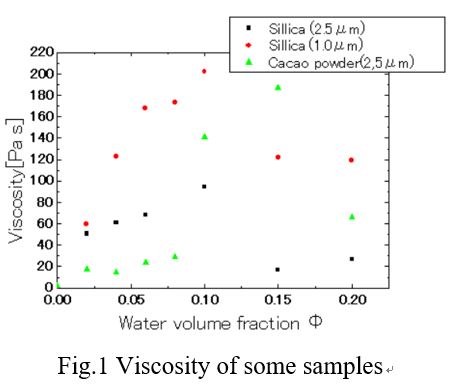
We focused on the interface between the polypropylene (PP) resin and the polyamide 6(PA6) resin, which was generated when the PA6 resin was located at the center of the carbon fiber reinforced polypropylene (CFRPP) to enhance the strengthen of the CFRPP. By adsorbing the polymer particles on the surface of the carbon fiber through the electrodeposition, the particles played a important roles to improve the interfacial adhesion between the PP and the PA6 resins. And also, the interface between CFRPP and metal was investigated to incorporate CFRPP to multi-material structures. polymer particles with the same component as the resin were adsorbed on the metal surface, and the particles were impregnated to fine defects on the metal surface, thereby improving the interfacial adhesion between CFRPP and the metal. Therefore, we examined the application of polymer particles to fabricate CFRPP for practical use.
A microlens array is the optical element which has many lenses with a diameter of several to hundreds micrometers on its surface. At present, the microlens arrays are prepared by the top-down processes such as photolithography and etching, where the productivity of the arrays is not very high. Moreover, it is difficult to obtain the arrays with smaller lenses through the top-down processes. To prepare the smaller microlens arrays efficiently, the bottom-up processes such as self-assembly are required. In the present study, we have tried to prepare the mesolens array with a diameter of hundreds nanometers from the non-close-packed (NCP) colloidal monolayers, which are prepared by the convective self-assembly (CSA) using a glass substrate and the silica particles grafted with cationic polyelectrolyte, poly(vinylbenzyl trimethylammonium chloride) (PVBTA). When the NCP colloidal monolayers are annealed, PVBTA would be removed and a part of the silica particles are thought to be melted. It is therefore expected that the silica particles and the glass substrate could fuse together to form the mesolens array, because they are mainly composed of silicon dioxide.
PVBTA were grafted by free radical polymerization on the surface of the monodisperse silica particles, and then the PVBTA-grafted silica particles and the glass substrate were applied to the CSA process to prepare the NCP monolayers. The obtained monolayers were annealed at 973 K in a muffle furnace for several hours. The annealed particle monolayers were observed by the atomic force microscope (AFM) and the scanning electron microscope (SEM). As a result, the height of the silica particles were found to decrease with an increase in annealing time, which probably indicates that partial fusion of the silica particle and the grass substrate proceeded as the annealing time increases.
Polymeric microcapsules are micron-sized particles with a liquid core and a polymer shell. The shell of the microcapsules can isolate the encapsulated substance from the external environment. Microcapsules exhibit various functions by combining different core substances with shell materials. In particular, microcapsules containing a phase change material have advantages such as an increase in heat exchange efficiency due to an increase in specific surface area and prevention of the encapsulated phase change material from leakage, which can be served as efficient heat storage materials for energy saving applications. Most of the microcapsules used as heat storage materials are made of melamine-formaldehyde materials (MFM). MFM have excellent mechanical strength and heat resistance. However, it has been reported that the resultant microcapsules contain unreacted formaldehyde which has high carcinogenic to human. There is therefore an increasing demand for reducing or removing formaldehyde from the products. In this study, we developed a process to prepare formaldehyde-free melamine microcapsules by using melamine, urea, glyoxal and 2,2-dimethoxyacetaldehyde (DME) [1] as the shell materials, based on the previous study [1] and optimized the preparation conditions for controlling the shell thickness. Specifically, we prepared a prepolymer solution and mixed the solution to oil-in-water (O/W) emulsion composed of Isopar G and aqueous solution containing poly(E-MA), as the oil and water phases, respectively [2]. We discuss the effect of glyoxal/DME molar ratio and NH2/CHO molar ratio on the formation of the microcapsules as well as the thickness of the microcapsules.
[1] G. Leon et al., RSC Adv., 7, 18962-18975 (2017)
[2] Eiji Kamio et al., Langmuir., 24, 23, 12387-13298(2008)
In recent years, some researchers have pointed out that BaTiO3 has a good application in medical bone transplantation. In addition, BaTiO3 also has optical characteristics such as high whiteness and high reflectivity similar to that of TiO2 and BaSO4. These properties can be applied in medical dry chemical detection reagents, which is also the potential research direction of barium titanate materials. Submicron spherical barium titanate (BaTiO3) was produced by the batch precipitation in the alkaline solution of BaCl2-TiCl4-NaOH reaction system. The influence of various parameters on the morphology of BaTiO3 powders were researched in this study. Spherical BaTiO3 particles can be prepared within 20 min for reaction, which saves the preparation time for the dry sheet of medical dry chemical reagent. The morphology of the powders will be affected by the stirring speed and the concentration of alkaline, and the particle size will decrease as the increase of stirring speed. Hydroxyl ion in the solution acts as a catalyst to promote the progress of the reaction. The prepared spherical BaTiO3 can be successfully applied to in medical dry chemical detection reagents. The mechanism about the formation of BaTiO3 can be explained combining nucleation and growth processes with crystallization chemistry. It is showed that the surface nucleation growth or screw dislocation growth would exist in the process of the formation of BaTiO3.
The behavior of drawing process was investigated by focusing on fiber stretching speed (spinning acceleration) to improve fibers' luster quality. Wet spinning method often has a problem of low luster level caused in higher spinning speed. We found that, (1) luster quality could be evaluated by fibers' arithmetic average (RΔa), which indicated fibers' roughness and (2) fibers' roughness was related to spinning acceleration by analyzing RΔa. Spinning acceleration was measured by chasing markers which was used to tie fibers. Regardless of length of spinning bath, fibers were stretched mostly during the first stretching stage. So we tried to stepwise drawing method. In case drawing ratio is 220 percent by one step, RΔa was 10.1 degree but by stepwise drawing (1st drawing ratio was 148.3 percent and 2nd drawing ratio was 148.3 percent) RΔa was decreased to 8.3 degree. We have cleared that stepwise drawing method has enabled to decrease fibers' roughness by preventing sudden change of fiber stress. In addition, we have cleared that higher temperature also improved fibers' roughness. In higher temperature, roughness was decreased in spite of higher acceleration because that fiber was easier to stretch than in lower temperature.
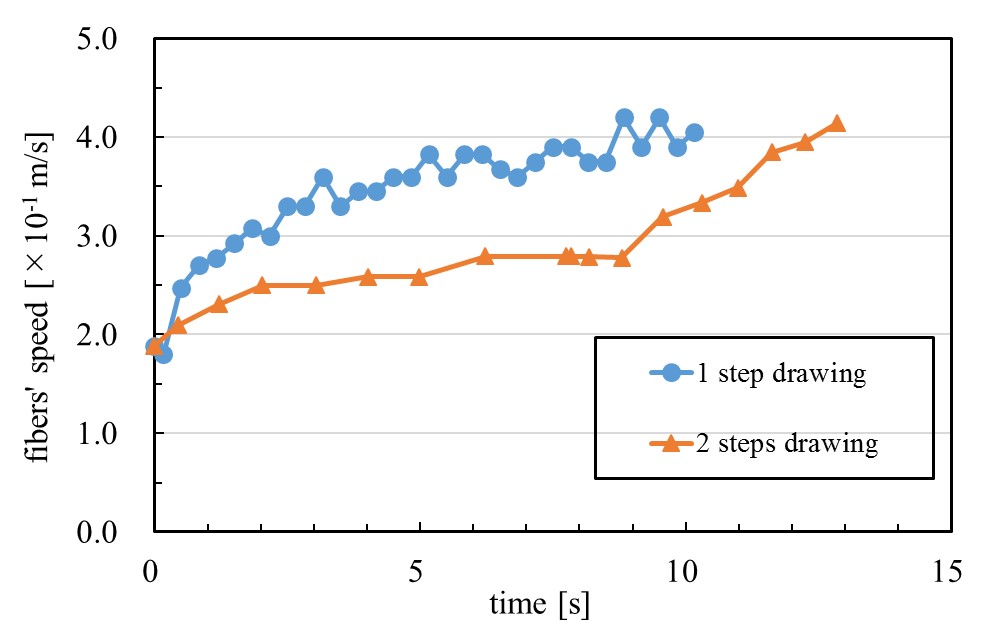
Paper-based devices have attracted a lot of attention as simple analytical platforms for bioassays. However, paper-based biosensors have still many problems, especially nonspecific protein adsorption. Detection sensitivity and selectivity of such sensors are impaired by nonspecific protein adsorption because of the drifting and denaturing of the detection ligands, the loss of target analyte during transport to the detection zone, and background noise from nonspecific protein adsorption. Typically, this problem in a sensor device is addressed by surface modification with hydrophilic polymers. For example, poly(ethylene glycol) (PEG) provides protein-repellent properties on wide variety of surfaces.
Herein we demonstrated surface modification of cellulose paper with a functional PEGylated polymer via simple dip-coating. This functional PEGylated polymer has biotin as a reactive site on the end PEG chains. In general, dip-coating with a PEGylated polymer followed by drying generates a hydrophobic surface because the hydrophobic moieties of the polymer are preferentially segregated at the air-polymer interface to minimize the surface energy. To display the hydrophilic moieties (functional parts) of a polymer on an outermost surface in dip-coating, we previously proposed that the surface segregation in the dip-coating of a PEGylated polymer can be controlled using a fluorine-containing surfactant. Based on the previous study, we here attempted to impart antifouling property and reactivity with other molecules such as antibody, DNA to the paper surface.
We synthesized PEGylated copolymers (Scheme 1) and a fluorine-containing surfactant (Rf-PEG). Cellulose paper was dip-coated with these copolymers in the presence of Rf-PEG. This coted paper had water absorbency in comparison with PMMA-coated paper and a paper coated PEGylated copolymers in the absence of Rf-PEG. Moreover, this coated paper had less nonspecific protein adsorption than a raw paper and a paper coated PEGylated copolymers in the absence of Rf-PEG. We expect that this coted paper will be applied to platforms for bioassays.
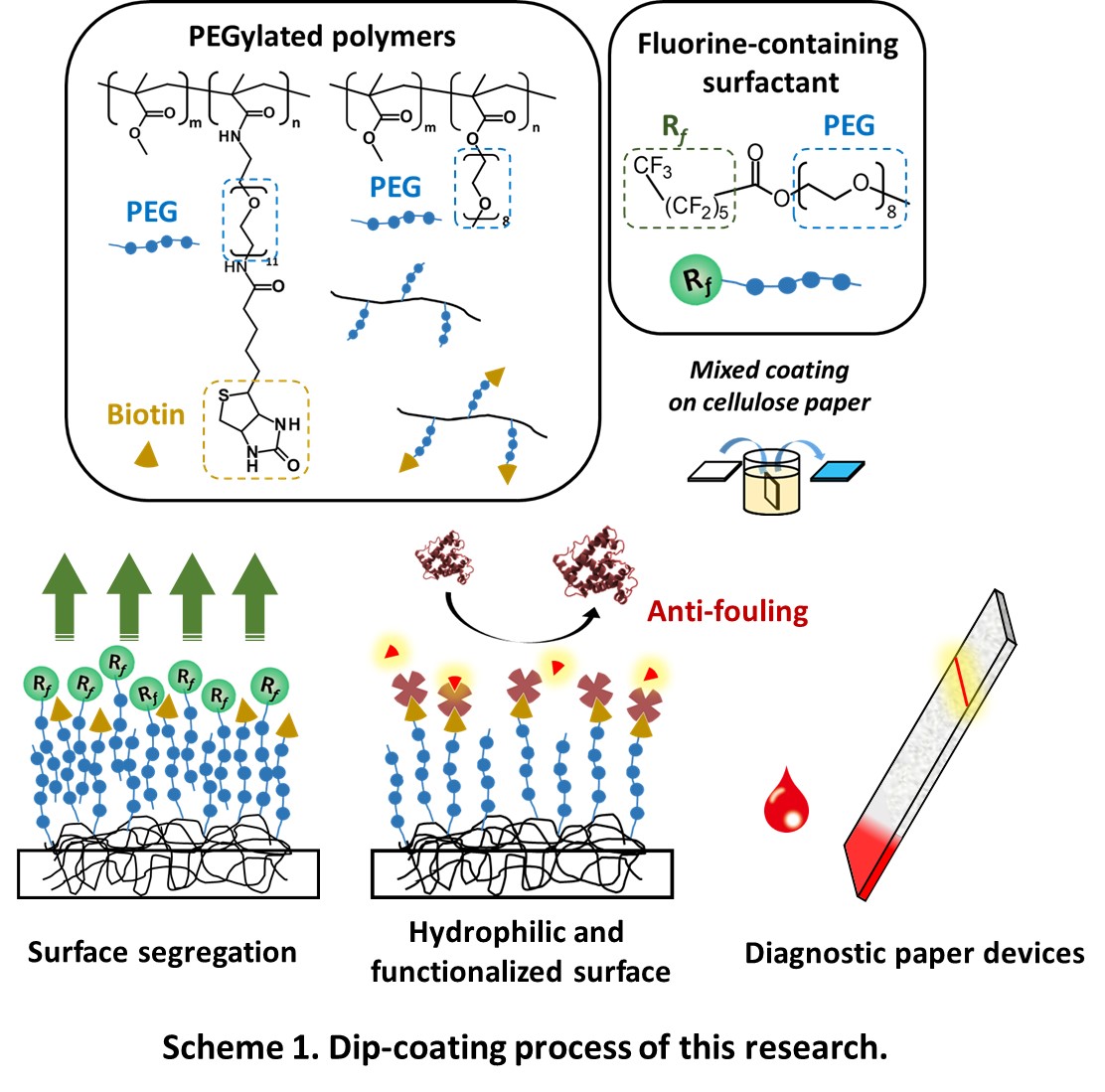
The excited electrons and holes generated upon by irradiating UV ray to TiO2 have powerful redox power. They produce reactive oxygen species (ROS) under aerobic conditions at the surface. These species rapidly decompose organic compounds to converts them into CO2 and H2O via carbon-carbon bond cleavage. TiO2 has been used as a powder to increase the catalytic effect. However, the use of particles involves the need of incorporating extra stages in the purification process, such as separation and catalyst recycling. We focused on a composite of TiO2 nanoparticles and polymer nanofibers. Polymer nanofibers have a large surface area. Polymer nanofibers are fabricated by electrospinning as follows. An electric field is used to create a charged jet of polymer solution. As this jet travels in air, the solvent evaporates leaving behind a charged fiber that can be collected on a metal plate. The purpose of this study is to develop novel composite polymer nanofibers with TiO2 nanoparticles and clarify its applicability as photocatalyst for degradation of organic compounds. N-isoprorylacrylamide-co-N-methylol acrylamide (NIPA-co-NMA) polymer was synthesized by free radical polymerization. NIPA polymer is a thermosensitive polymer, and NMA can be used as a crosslinking agent. The composite nanofibers were fabricated by electrospraying methanol containing NIPA-co-NMA polymer and TiO2 nanoparticles onto stainless-steel plate through a nozzle with application of high voltage. The composite nanofibers catalyzed decomposition reaction of methylene blue (MB) successfully.
Development of novel materials which mimic the excellent molecular recognition function of biomembranes has recently got attention. Copolymer of N-isopropylacrylamide (NIPAM) bearing β-cyclodextrin (CD) (poly(NIPAM-co-CD)) exhibits molecular recognition function, which controls its volume phase transition behavior by the inclusion of guest molecules[1]. However, the mechanism of the molecular recognition of poly(NIPAM-co-CD) has not been fully explained. N,N-dimethylaminosulfonyl-2,3,3-benzoxadiazole (DBD) is a fluorophore and changes its fluorescence intensity in response to hydrophilicity around the molecule[2]. If DBD is introduced into the poly(NIPAM) chain, changes in polarity around PNIPAM accompanying phase transition can be detected.Herein, DBD is copolymerized with poly(NIPAM-co-CD) to directly analyze the change in hydrophilicity of the poly(NIPAM-co-CD) chains by inclusion of guest molecules (Fig. 1A). We discuss the correlation between the phase transition behavior and the hydration state around NIPAM, which is controlled by molecular recognition of CD in polymer chains. The change in phase transition and hydrophilicity around the polymer chains caused by inclusion of a guest molecule, sodium 2-naphthalenesulfonate (2-NS), was investigated by cloud point measurement and fluorescence intensity measurement. Fig. 1B. shows the results of the cloud point measurement. When 2-NS were added, aggregation of the polymer was suppressed. The fluorescence intensity measurement exhibited that there was no difference in the change in fluorescence intensity by addition of 2-NS, suggesting that inclusion of 2-NS in CD did not affect the hydrophilicity around NIPAM. Further, the cloud point measurement in NaCl solution did not display suppression of aggregation even the presence of 2-NS, resulting from electrostatic shielding by Na+ around SO3– group of 2-NS which was included in CD. It implies that the suppression of aggregation in poly(NIPAM-co-EDA-CD-co-DBD) by addition of 2-NS was caused by the electrostatic repulsion of 2-NS included in CD.
[1] Macromolecules, 45, 9742-9750, (2012)
[2] Anal. Chem.,, 75, 5926-5935, (2003)
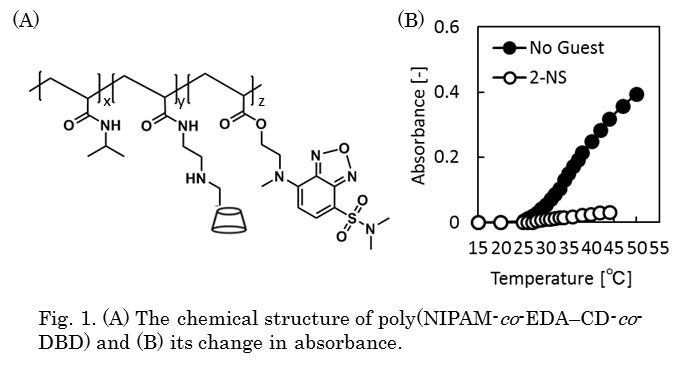
To investigate the effect of the surface properties and polymer properties on surface modification via electrostatic adsorption, the electrostatic adsorption behavior of zwitterionic copolymer on negatively charged surface was studied. A series of positively charged zwitterionic copolymer and a series of negatively charged surfaces including porous substrates and dense films were respectively fabricated. The electrostatic adsorption behavior of zwitterionic copolymer on negatively charged porous substrates were confirmed by contact angles and fluorescently labelled protein adsorption experiment. And the adsorption behavior of zwitterionic copolymer on negatively charged dense films were confirmed by quartz crystal microbalance (QCM) determination and fluorescently labelled protein adsorption experiment. The results indicate that the lower charge density on the zwitterionic copolymer bring to the higher adsorption on the charged surface, while the extremely low charge density results in the lower adsorption on the charged surface, due to the low interaction. The high density of film surface charge is beneficial for surface adsorption, while the extremely high density of the film surface charge leads to the lower surface adsorption, due to the steric hindrance of the negatively charged sites. This work provide the insight into the best strategy for surface modification via electrostatic adsorption.
Gating membrane is a porous membrane that opens and closes pores responding to heat[1] and specific ions[2]. Recently sensor system using photo-responsive material attracts attention because of several advantages such as simple operation and uninfluential nature to the substance. In this research, we aim to develop a photo-responsive gating membrane that opens up the possibility of conventional membranes.
Photo-responsive polymer composed of poly(2-(dimethylamino)ethyl methacrylate) (PDMAEMA) actuator and photo-sensing spiropyran (SP) was synthesized by free radical polymerization (molecular weight : Mn =1.49 × 104 , Mw / Mn = 2.07 and SP content: 0.81 mol% ). Lower critical solution temperature (LCST) of 0.1 wt% aqueous solution is 42 °C before visible light (Vis) irradiation and 40 °C after Vis-irradiation while no LCST was observed after ultraviolet light (UV) irradiation.
The copolymer was immobilized to the polyethylene (PE) porous membrane by plasma-induced graft polymerization (Graft ratio: 5.6% and SP content: 0.96 mol% ). Permeation coefficient (Lp) of the prepared membrane increases as water temperature rises before light irradiation (Fig 2). This is because the copolymer shrinks above LCST and opens the pore of the membrane. Just after UV-irradiation, Lp of the membrane decreases as we expected, but increases then. The latter behavior may be due to elimination of the copolymer from PE substrate by UV-irradiation, as indicated by FT-IR spectral change. After Vis-irradiation, Lp of the membrane did not increase even though linear polymer shows similar LCST behavior before and after Vis-irradiation (Fig 1). This is probably because LCST behavior of grafted polymer in the pore and linear polymer in diluted solution is different.
In conclusion, we have successfully fabricated visible light-responsive gating membrane.
1) H. Kuroki et al., J. Membr. Sci. 2010, 352, 22-31.
2) T. Yamaguchi et al., JACS, 1999, 121, 4078-4079
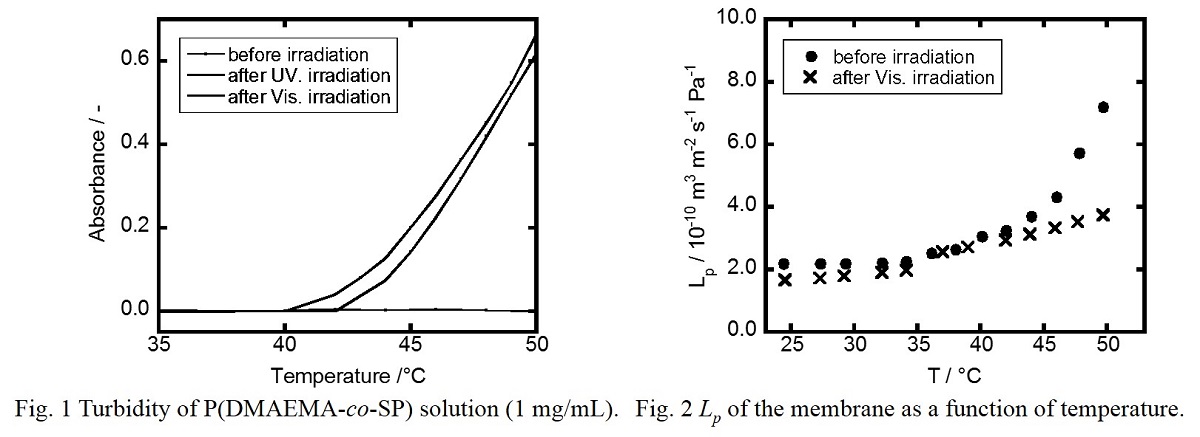
Enzymes play vital roles in biological transformations due to incomparable selectivity. Enzymatic membrane reactors (EMRs) combine enzymes with membranes, and many researchers have studied the synergistic effect of EMRs exerting on enzyme performance. Before the utility of EMRs can expand from natural aqueous media to organic solvents, robust membranes must be developed to promote enzyme protection from hostile forms of media. For this study, laccase was immobilized on an organic-solvent-resistant hydroxylated polyketone (PK-OH) membrane via covalent bonds and served as a model enzyme. Ketone groups facilitated the immobilization via hydrogen bonds, leading to a high immobilization density of 462 μg/cm2. In homogeneous aqueous-organic solvents, the activity of immobilized laccase was up to 3.5 times greater than that of free laccase towards 2,2′-azino-bis(3-ethylbenzothiazoline-6-sulfonic acid). In addition, the results also showed improved activity towards highly concentrated 2,4,6-trichlorophenol and bisphenol A (1.4-g/L). Furthermore, the activity in filtration mode showed a 240% increase over that in batch mode. The immobilized laccase maintained its activity after 40-days of storage, 10 reuse cycles, and 50 h of continuous reaction. These results show that robust polyketone based membrane support will create opportunities for the application of EMRs in aqueous-organic solvents.
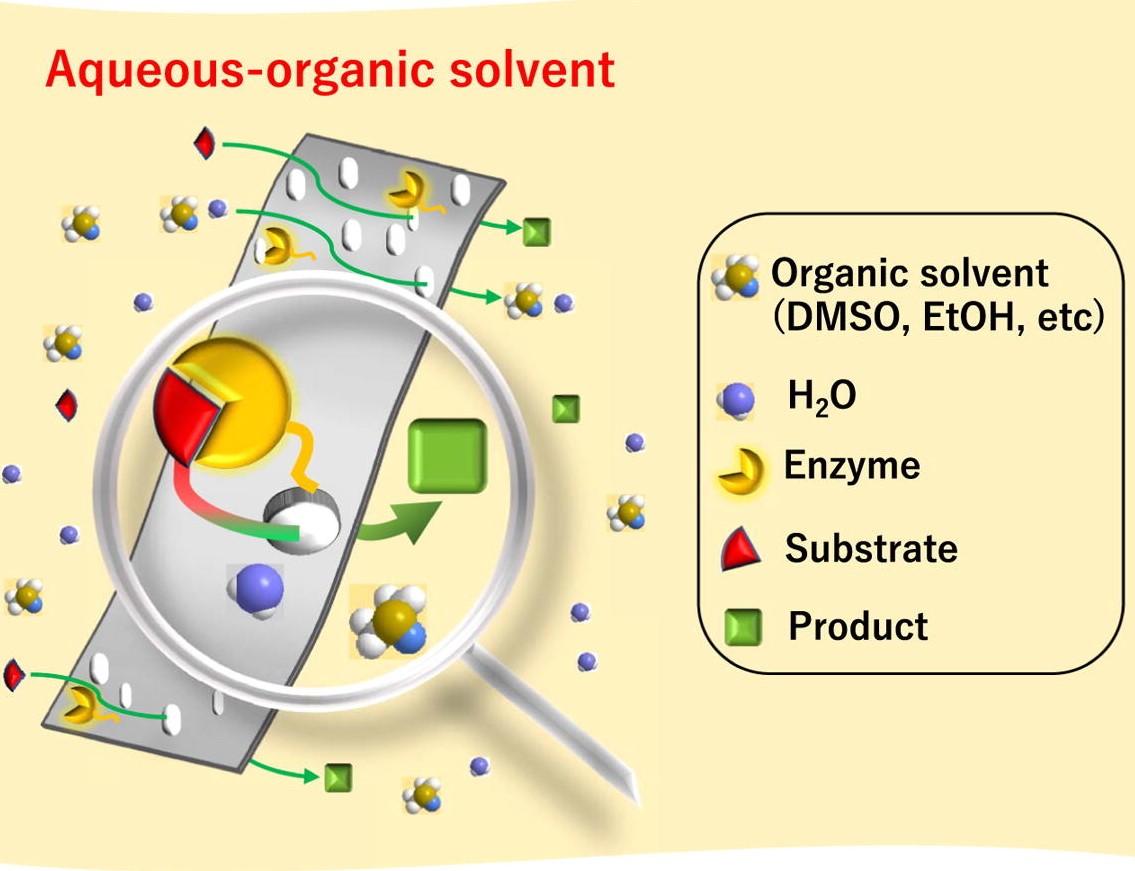
Cellulose nanofiber (CNF) is a micro-refined nano-level fibrous material that can be produced from chemical and mechanical treatment of variety of woody biomass materials. CNF has attractive characteristics, it's density is 5 times lesser than that of steel while being 5 times stronger. Moreover, it is produced from natural biomass resources therefore it is entirely environmentally friendly material1). Recently, its compounds with resins have received increased attention as alternative to pure metals owing to their light-weight and noncorrosive characteristics. In this use, defibrating and surface hydrophobization have main roles in obtaining high quality CNF. CNF is hydrophilic, while phenolic resins are hydrophobic; therefore, mixing them could result agglomeration and consequently lower the strength of the composite. In addition, the form of CNF is likely to influence the properties of the composites. Application of thermoplastic resins, such as polyethylene and polypropylene, in the formation of CNF composite materials have been widely reported. However, to the best of our knowledge, few studies have been conducted using thermosetting resins in the synthesis of CNF-reinforced composite materials. In this study, reinforcing of phenolic resin with CNF as a model for thermosetting resins was investigated. Various tests were conducted to evaluate the performance of the composites produced with CNF (produced at different physico-chemical conditions) in different proportions with the resin. Various techniques, such as Fourier-transform infrared spectroscopy, mechanical testing, and scanning electron microscopy were utilized to understand their properties. Fig. 1 shows mechanical strength of typical CNF composite. As shown, bending strength as well as tensile strength increased approximately 20% when 3 wt% CNF was used. This study suggested that reinforcement of the resin using CNF resulted in stronger and more promising composites.
References: 1) Akihiro Sato et al., Composites Part A: Applied Science and Manufacturing, 83, 72-79 (2016)
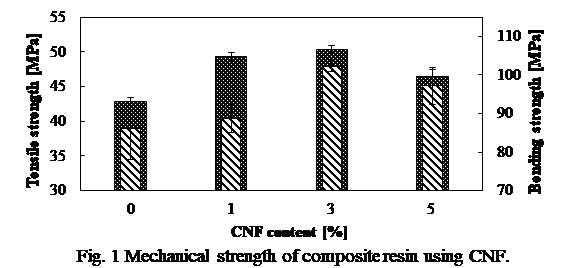
This study is to investigate the characteristics of polyvinyl alcohol (PVOH) added with different loading level of calcined fish bone (HAp). HAp was extracted from Chirocentrus nudus skeletal via thermal calcination; followed by solution casting method to produce PVOH composite films, consisting 0 phr to 5 phr calcined fish bone. In term of tensile strength, it decreases upon added with 1 phr calcined fish bone then increases at 2 phr loading level. The addition of 3 phr calcined fish bone was found to be the optimum loading level to exhibit reinforcement function; whereas for elongation at break, a decreasing trend with an increase in calcined fish bone loading level was found due to the continuity of chain mobility in PVOH being interrupted and the inducement of internal friction within PVOH matrix. For scanning electron microscopy, the wave-liked shrinkage, fibrils and agglomerates were reduced with increasing calcined fish bone loading level, indicating a high tensile strength and low elongation when increasing the loading level. In x-ray diffraction analysis, the peak broadening effect indicates a decrease in HAp crystallite size which has ruptured and well dispersed within PVOH matrix. For differential scanning calorimetry, the enthalpy of melting and crystallinity (in terms of qualitative and quantitative) possessed similar trend as the finding in tensile strength. In fourier transform infrared spectroscopy analysis, the unique peaks occurred approximately at 3263 cm-1 and 2923 cm-1, indicating the presence of O–H group bonding and C–H bonding respectively. Lastly, this study concluded that the 3 phr calcined fish bone was the optimum loading level to be employed in biomedical application such as bone scaffolding due to the high strength and compatibility.
Polymer/magnetic particle composites have high magnetic sensitivity, and thus have wide applications in biomedical fields. B. Tural et al. reported recently that if polymer containing a carboxyl group such as poly(methacrylic acid) was added to the coprecipitation solution during magnetite nanoparticle (MNP) synthesis, the polymer was immobilized on the magnetite surface immediately following particle generation. The method is one-step process that does not require complex and time-consuming manipulation.
However, so far, there are no reports on what kind of polymer (or functional group) can be used for this type of one step synthesis of polymer/MNP composite. Therefore, in this study, we tried one-step synthesis of polymer/MNP composite by using different polymers which contains different functional group to clarify 1) what kind of functional groups can be applicable for one step polymer/MNP synthesis, and 2) the effect of the polymer difference on the immobilized polymer amount.
In the experiment, the synthesis of polyacrylic acid (PAAc) / MNP was carried out using the following procedure; first, PAAc, iron (II) sulfate heptahydrate and iron (III) chloride hexahydrate were dissolved in deionized water. Then, sodium hydroxide was dropped into the solution at room temperature to proceed MNP synthesis reaction. Polyacrylamide (PAAm), polyethylene glycol (PEG), polyethylene imine (PEI) and polyvinyl alcohol (PVA) immobilized on MNP were also synthesized using the same procedure just by changing PAAc to the corresponding polymers. The results of XRD analysis showed that for all the polymers used in this study, formation of MNP was confirmed, and the fact indicated that the presence of the polymers did not affect on the synthesis of MNP. Thermogravimetric analysis (TGA) indicated that for all the polymers, polymer immobilized on MNP was successfully synthesized, and the amounts of the immobilized polymers were in the order of PEG < PEI < PAAm < PAAc.
To prevent aggregation and oxidation of magnetite nanoparticle (MNP), silica coating on MNP was proposed. Recently, Setyawan et al. successfully achieved simultaneous magnetite nanoparticle formation and the modification of its surface with silica layer by using the electrooxidation method. Advantage of the method is that the process is very simple and easy since it's a one-step process.
The purposes of this study are following; 1) to synthesize MNP with silica coating under various conditions by electrooxidation, and to examine the effect of the synthesis conditions on the characteristics of the resulting sample, 2) to immobilize thermoresponsive copolymer, poly(NIPAM-co-AA) on the MNP with silica coating, and to evaluate their immobilized copolymer amount and Cu adsorption property.
As a result of X-ray diffractometer (XRD) analysis and Fourier transform infrared spectroscopy (FT-IR) measurement, it was confirmed that MNP with silica coating was successfully synthesized using this method. When the current value was changed during electrooxidation synthesis, it was found that the minimum particle diameter(maximum specific surface area) was obtained at the current value of 0.60 A. The results of thermogravimetric analysis (TGA) showed that the maximum immobilized amount of the copolymer of 0.255 g/g-MNP was obtained when the sample synthesized at a current value of 0.60 A was used. The immobilized amount was 3 times larger than that of the sample prepared using MNP without silica coating. This is considered to be due to less aggregation of MNP during polymer immobilization. The results of Cu (II) adsorption experiment showed that although Cu (II) recovery amount through temperature swing was similar to those of conventional thermoresponsive “gel” type heavy metal adsorbents, time required for Cu(II) recycling process could be decreased to 1/10. These results showed the effectiveness of this method.
Graphene-based materials have been studied for prospective applications in many fields, including catalysts and electrode materials. Graphene-based materials can be made by two kinds of approaches. The first one is the bottom-up approach represented by a chemical vapor deposition method. The second one is the top-down approach via graphene oxides. Although the latter approach is suited for mass production, it is difficult to control the crystallinity and the amount of defects by this approach. Therefore, tailoring some properties depending on applications has remained a significant challenge. We reported that it is possible to control the crystallinity and the concentration of defects by microwave-assisted (MW-assisted) annealing for carbon materials by adjusting distances between carbon particles through changing the bulk density. However, it can be difficult to change the bulk density depending on some types of carbon materials. This study is aimed at controlling the crystallinity and the concentration of defects regardless of the kind of carbon materials through development of a new up-flow reactor for MW-assisted annealing. Crystallinity as well as the concentration of defects were investigated by multiple techniques including Raman spectroscopy and thermogravimetric analysis. During MW irradiation, we observed moderate fluidization of sample particles in an up-flow reactor. Therefore, distances between carbon particles were adjusted, through which the concentration of defects was controlled. Our results indicate that extend of changing of the concentration of defects depends on the sample particle size and the gas flow rate during MW irradiation. Moreover, samples annealed by the up-flow reactor exhibited high oxidation resistance in air in comparison with ones treated by a down-flow reactor.
Magnesium oxide (MgO)-templated mesoporous carbons were modified with hydrated zirconium oxide (ZrO2·xH2O) synthesized through hydrolysis of zirconium chloride oxide (ZrOCl2) to prepare adsorbents for fluoride ion (F-) removal from water. Powder X-ray diffractometry (XRD) revealed that ZrO2·xH2O was successfully formed on the surface of mesoporous carbons. Adsorbed amount of F– was observed as a function of time by using pristine mesoporous carbons, modified mesoporous carbons, and ZrO2·xH2O prepared without carbon. The figure shows the F– concentration of solution (CF) as a function of contact time. The pristine carbon was found to adsorb little amount of F–. In contrast, the modified carbon and ZrO2·xH2O were capable of removing F– from water. The amount of F– removed with the modified carbons was larger than that observed using ZrO2·xH2O. This result indicates that the capability of ZrO2·xH2O to remove F– is improved by attaching it to the mesoporous carbon surface. The authors presume that this positive effect is probably provided by formation of ZrO2·xH2O on the carbon surface giving crystals that are smaller than crystals fomed without carbon. The F– removal was described by conventional adsorption isotherms. The other results such as effect of mesopore size and pH on the F– removal will be shown at the conference.
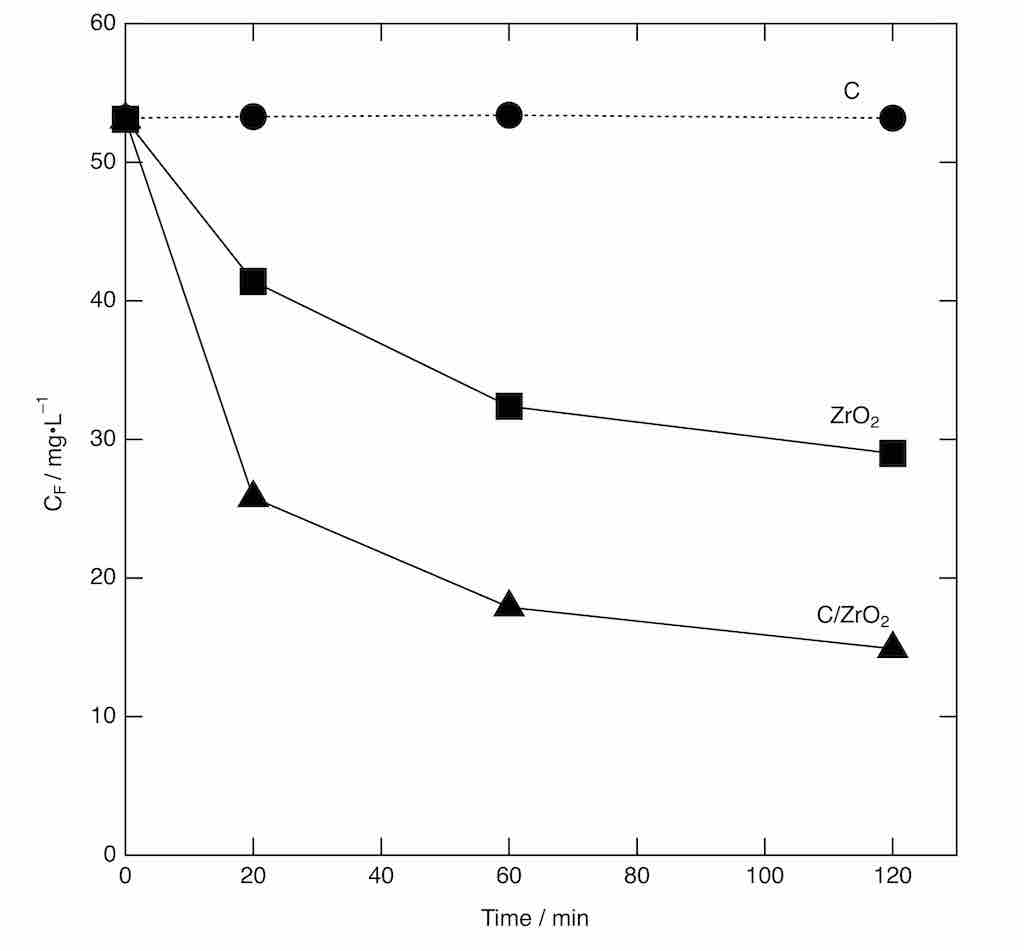
Porous carbon materials have attracted much attention because of their large surface area, large pore volume, chemical inertness, and electrical conducting properties. Mesoporous carbons with well-tailored pore system are essential for a number of applications, such as adsorbents, catalyst supports, and energy storage devices. Recently, a great deal of effort has been made to develop a method of synthesizing mesoporous carbons, including hard- and soft-templating techniques. Hard-templating techniques require preparation of inorganic template such as mesoporous silicas, impregnation of pores with appropriate carbon precursors, carbonization, and subsequent selective removal of inorganic template using HF
or NaOH. Another recently developed approach is based on the application of soft-template such as triblock copolymers access for simpler and facile synthesis of mesoporous carbons because of the avoidance of multiple step to prepare and remove the hard-template. However, the soft-templating techniques still suffer from long preparation durations and the excessive use of solvents for the formation of mesostructure in solutions through the self-assembly process, which causes low efficiency, high production cost, and environmental burden.
Herein, we investigate a highly efficient and simple approach to synthesize mesoporous carbons using solid raw materials under solvent-free conditions. The solid–solid approach has potential advantages for large-scale production, low cost, environmental-friendly process. Mesoporous carbons were obtained by the solvent-free technique using various combinations of solid raw materials with adjustments of the molar ratio.
The demand for high-performance thermal interface materials (TIMs), which enhances releasing heat from the electronic devices, is increasing for further performance improvement and miniaturization of electronic devices. The performance of TIM is characterized by the total thermal resistance RTotal which is the sum of the bulk thermal resistance and the contact thermal resistance between the TIM and the opposing substrate. Therefore, it is required for the TIM to have high thermal conductivity for vertical direction κ⊥ and softness, thus conventional TIMs consist of filler particles having high thermal conductivity and soft polymer matrix. By using fillers with high aspect ratio and aligning them vertically, κ⊥ can be improved [1]. We previously fabricated TIM using carbon fiber (CF) having high thermal conductivity and high aspect ratio. By a simple process using shear force, CFs were filled in the thermoplastic elastomer (TPE) matrix with vertical alignment and high mass ratio of over 50 mass% (Fig. 1a) [2]. However, the total thermal resistance is as high as 100 mm2 K W-1 possibly because of the poor connections between the CFs and between the CF and the opposing substrate surface. This time, expanded graphite (EG) having high thermal conductivity and flexible sheet-like structure is added as a sub-filler (Fig. 1b). Thermal resistance was measured by the steady-state method and plotted against the TIM thickness (Fig. 1c). The thermal resistance decreased with the EG content, resulting in the significant reduction of the thermal resistance to RTotal = 19 mm2 K W-1 with 19 mass% EG. This value is similarly small as the high-performance TIM of an indium sheet. The improvement comes from both the improvement of the thermal conductivity (slope) and the reduction of contact thermal resistance (intercept).
[1] K. Uetani, et al., Adv. Mater., 26, 5857 (2014).
[2] R. Yamada et al., The 51st FNTG symposium, 2P-38 (2016).
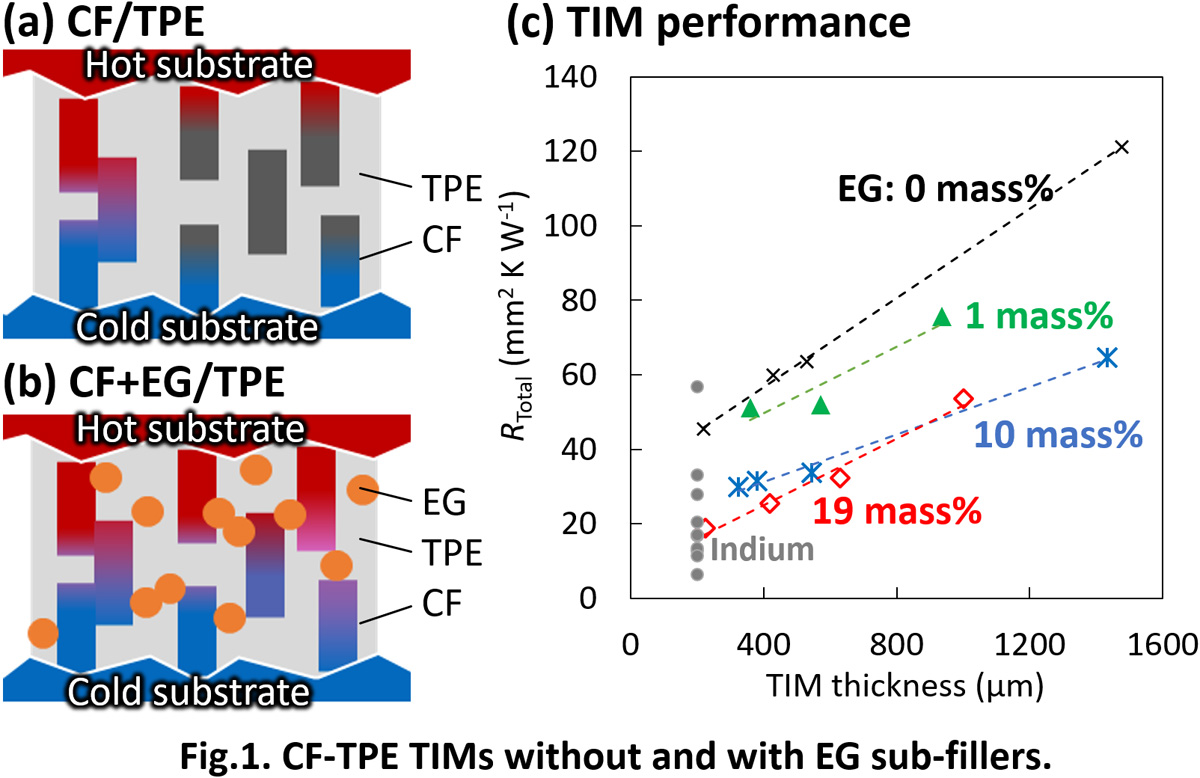
Electrochemical sensor based on redox cycle of repeated oxidation and reduction has advantages of compactness and high sensitivity. To promote the redox cycle, two working electrodes for oxidation and reduction should have large surface area, be placed closely, be insulated electronically while be conductive ionically each other. The typical example is the interdigitated electrode (IDE) (Fig. 1a), but the fabrication of the microstructure requires complex processes using lithography. In this work, we propose a new structure similar to electrochemical capacitor in which a separator made of cellulose nanofiber (CeNF) paper holds two working electrodes (WEs) made of carbon nanotube (CNT) paper (Fig. 1b). Cyclic voltammetry (CV) using K4[Fe(CN)6] aqueous solution shows the effectivity of this structure as a sensor (Fig. 1c).
Larger current was obtained with 3D electrodes of 10 μm-thick CNT papers and separator of 3 μm-thin CeNF paper, enabling detection of K4[Fe(CN)6] for concentrations down to 10 μM.
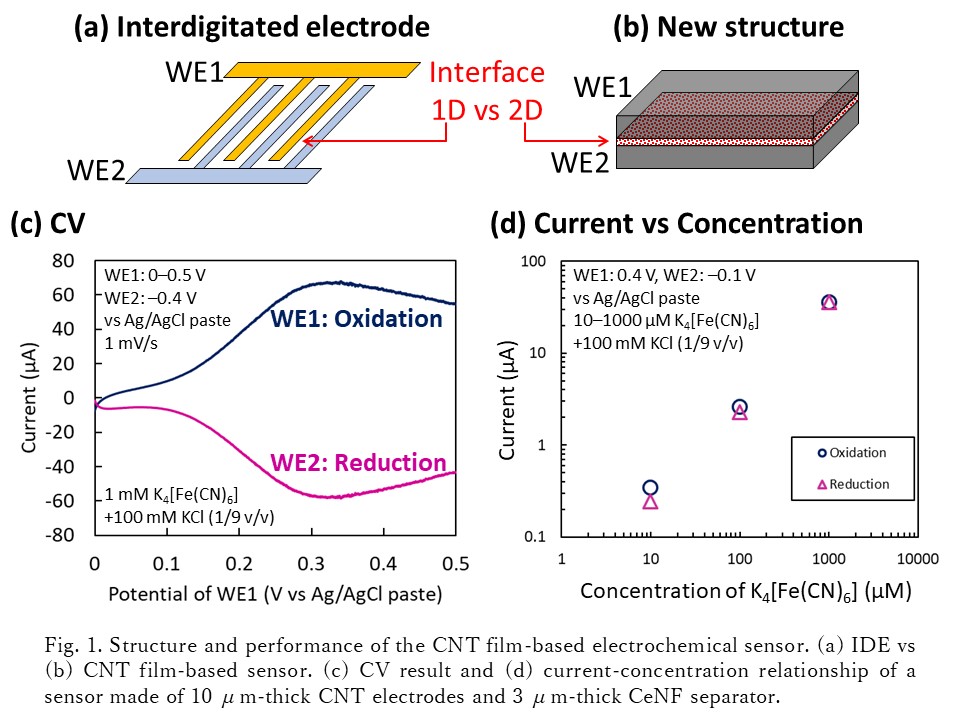
The conventional hydrogen storage materials such as metallic alloys are heavy and difficult to transport, and there is a problem that their costs are high. Therefore, in this research, we aim to develop hydrogen storage materials using carbon nanohorn (CNH), which is a lightweight and inexpensive carbon material.
CNH dispersed with metal nanoparticles was prepared using arc-in-water method. After that, the amount of absorbed hydrogen was measured under the condition of 0.95 MPa and 25 °C, and the influence of the metal composition and the content on the amount of absorbed hydrogen was clarified. It can be seen in Fig. 1 that there is the optimum metal content to maximize the hydrogen storage capacity. The increase in the amount of hydrogen storage with the increase in the metal content in relatively low metal content range is considered to be due to the increase of hydrogen spillover effect (dissociative adorption of H2 on carbon surface close to metal nanoparticles). Further, the decrease in the storage amount with metal content in high metal content range is considered to be caused by the decrease in carbon surface per material. Also, it can be observed that the amount of hydrogen storage becomes the highest when using Ti to disperse in CNH among Fe, Ni, Zn and Ti.
In addition, semi-empirical molecular orbital calculation was conducted in order to theoretically verify the hydrogen spillover phenomenon on the metal dispersed CNH. As a result, the hydrogen spillover effect is likely to occur at high pressure. It was shown that the hydrogen spillover effect can easily occur when H2 molecules present at the interface between Fe cluster and C atoms.
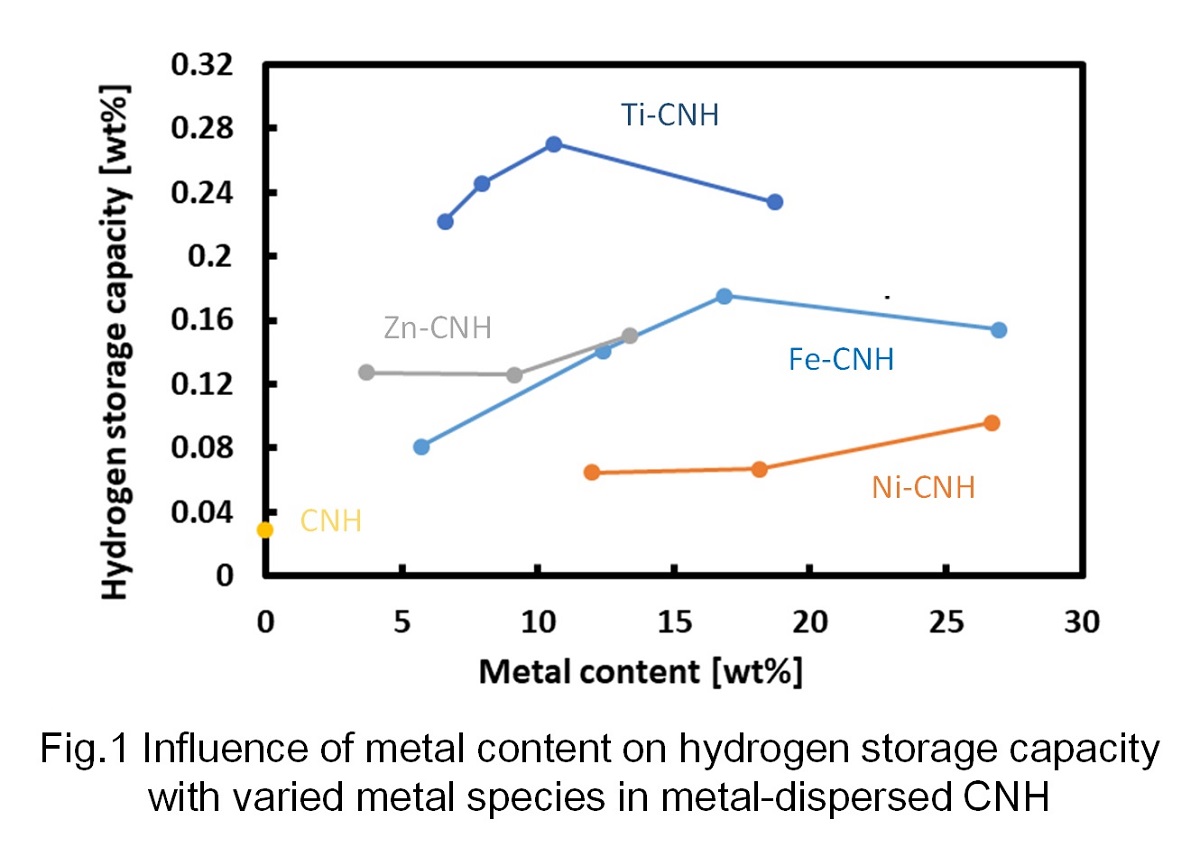
Metal-air battery and fuel cell are widely considered a promising candidate for next-generation renewable energy. One of the main problems of these technology is the catalyst for oxygen reduction reaction (ORR) that mainly depending on Pt, a very expensive material. The oxides of several transition metals have also been proposed for the purpose. Here, we propose nitrogen-doped carbon aerogel from coir fibers as an alternative metal-free electrocatalyst for the ORR. The nitrogen-doped carbon aerogel was prepared from coir fibers via simple ammonia–urea method followed by freeze drying and pyrolysis.Nitrogen molecules also have been well doped into the carbon structure, as confirmed by the existence of C=N functional group in FTIR spectra. Ammonia treatment could exfoliate the carbon structure causing defects and disorders, enhance the specific surface area, and maintain the morphology of carbon aerogel during carbonization. Kouteckỳ-Levich plots presented that the obtained nitrogen-doped carbon aerogel involved n ≈ 2 electrons towards ORR. The results suggest that the prepared nitrogen-doped carbon aerogel is a promising metal-free electrocatalyst toward ORR through 2e- pathways.
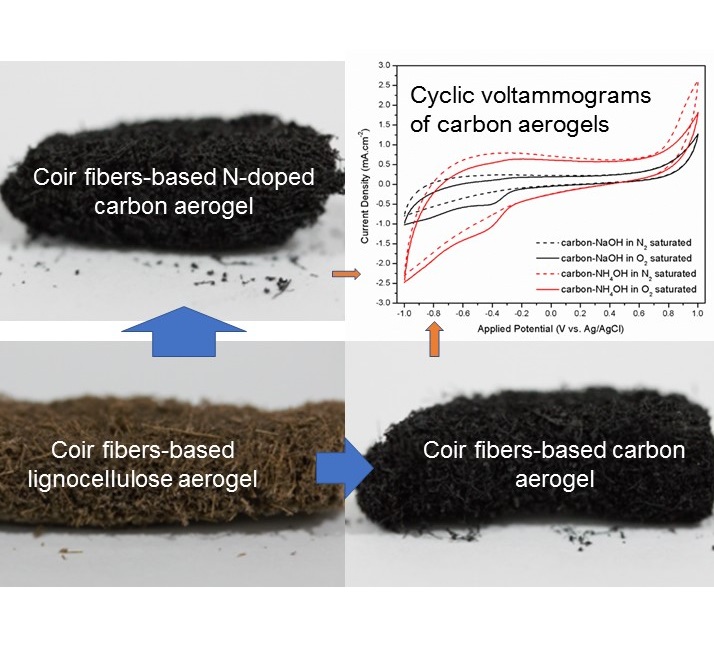
Proton-exchange membrane fuel cells, which can provide clean and efficient electricity, contain precious Pt electrocatalysts due to the sluggish kinetics of the oxygen reduction reaction (ORR). One of the major strategies to enhance the ORR catalytic activity is to control the morphology of the catalytic particles. Herein, a facile shape-directing mechanism was developed, and highly active Pt-based electrocatalysts were synthesized. Moreover, ammonium hexachroloplatinate(IV), which is known as recycling intermediate, was used as metal precursor of the synthesis experiments. It was revealed that NH4+ ions can behave as shape-directing agents in the presence of Cl– ions and O2. Based on the mechanism, Pt nanoparticles were synthesized in aqueous NH4Cl solution, forming a plate-like morphology that selectively exposes the {111} facets. Then, ammonium hexachroloplatinate(IV) and Cu salts were reduced together under the same synthesis condition, leading to Cu-doped Pt nanoplates. The Cu-doped Pt naonplates exhibited 3.7-times higher ORR catalytic activity than the commercial Pt catalysts. The present study, in which recycling intermediate has been used as metal precursor of highly active electrocatalysts, suggests a possibility to interconnect between material synthesis and recycling process.
Polymer electrolyte fuel cells (PEFCs) have received a great deal of attention for its utility in various applications, owing to their high energy conversion efficiency and clean emissions. However, a sluggish oxygen reduction reaction (ORR) rate and the low durability of conventional catalysts in PEFCs limits the wider commercialization prospects. To address these issues, our group had developed a carbon-free, connected platinum–iron (Pt–Fe) nanoparticle catalyst having porous hollow capsule structure. This catalyst exhibited an enhanced ORR activity as well as excellent durability against start-stop operations, due to the carbon-free structure. [1] Thus, the connected nanoparticle catalysts are identified promising, and further improvement in the ORR activity and durability can cater to the growing demands for PEFCs.
In this work, we developed a new connected catalyst, platinum–cobalt (Pt–Co) with a chemically ordered structure (FIG. 1A) having different catalyst atomic structures to that of connected Pt–Fe. Herein, we employed a new synthesis method for the catalyst processing, having the combination of silica coating and high temperature annealing as shown in Fig.1B. The SEM images (FIG. 1C) of the obtained Pt–Co catalysts showed a hollow capsule structure, indicating the formation of a connected Pt–Co network. The XRD patterns of the catalysts showed the peaks corresponding to an L12 type chemically ordered structure, when the annealing temperature was higher than 500 °C. Additionally, chemically ordered degree in the connected Pt–Co catalysts was successfully controlled by annealing temperature and time. Thus, we succeeded in the development and structural control of a connected Pt–Co catalyst composition for the first time. Investigating structural effects of connected Pt–Co catalysts on the ORR activity and durability is expected to provide useful guidelines to design an advanced connected nanoparticle catalyst for application in PEFCs.
References
[1] T. Tamaki et al., Energy Environ. Sci., 8, 2015, 3545–3549.
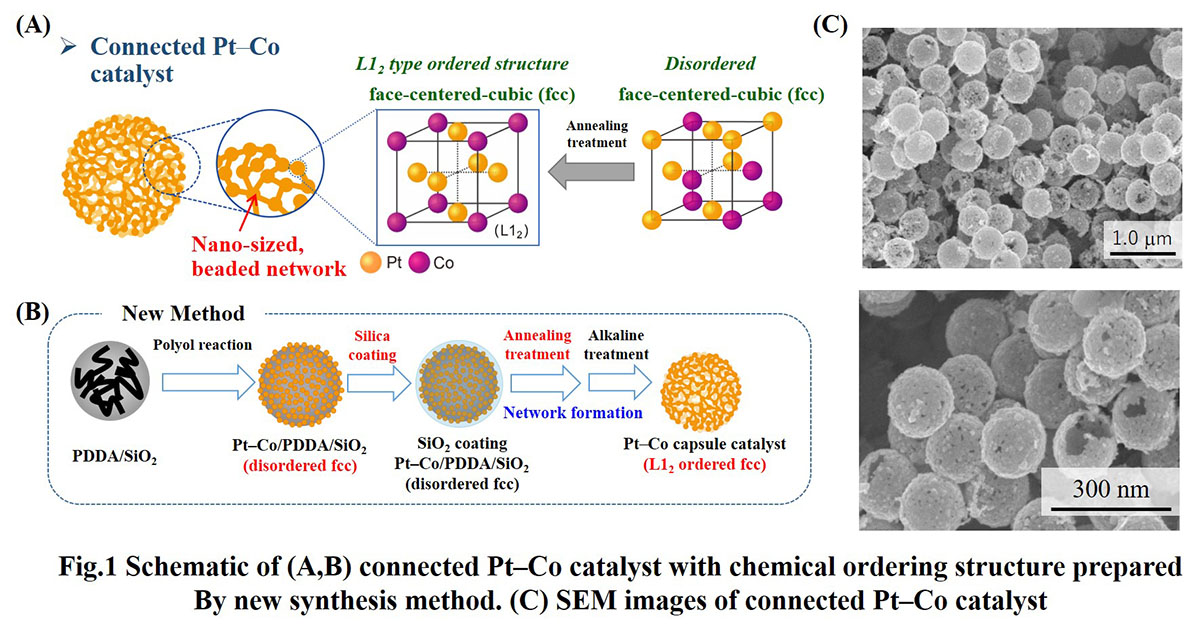
Polymer electrolyte fuel cells (PEFCs) have attracted much attention as promising energy conversion electrochemical devices. However, a conventional cathode catalyst of platinum nanoparticles supported on carbon black (Pt/C) exhibits a sluggish oxygen reduction reaction (ORR) rate and a low durability against start–stop and load cycle operations. In our group, a carbon-free, connected platinum–iron (Pt–Fe) nanoparticle catalyst with porous hollow capsule structure (FIG. 1A) has been successfully developed for an ORR. [1] This catalyst provides enhanced ORR activity and excellent durability during start-stop operations. However, there is a dissolution of alloyed metal occurring during load cycles, resulting in reduced ORR activity for the connected Pt–Fe catalyst.
In this study, we focused on a chemically ordered face-centered-tetragonal (fct) structure (FIG. 1A) to improve the load cycle durability of the Pt–Fe catalyst. The conventional synthesis method of connected Pt–Fe catalyst using a supercritical fluid treatment produces low fct degree (40–50%). Here, we propose a new and simple synthesis method using the combination of silica coating and high temperature annealing as shown in FIG. 1B. Using this method, we succeeded in preparing connected Pt–Fe catalysts having nano-sized network and a high fct degree (70–80%). The obtained catalyst exhibited a ten-times higher ORR specific activity, compared with that of the Pt/C. Furthermore, as showed in FIG. 1C, the connected Pt–Fe catalyst with the high fct degree (74%) exhibited a higher retention of ORR activity after 10,000 load cycles, compared to the low fct catalyst (44%). Thus, this study demonstrated that a highly ordered fct structure greatly contributes to the suppression of dissolution of metal, resulting in an improved load cycle durability of the connected Pt–Fe catalyst.
Reference
[1] T. Tamaki et al., Energy Environ. Sci., 8, 2015, 3545–3549.

We present an electrochemical reaction system that enables the generation of electricity, employing waste plastics as raw materials. These plastics can include polyvinyl alcohol, polyurethane, nylon, vinylon and polyethylene terephthalate. In the proposed process, the polymers are partially or completely dissolved in phosphoric acid (H3PO4) at temperatures of 100 °C or higher. When a physical mixture of plastic solid and H3PO4 solution was supplied to the anode in a temperature-controlled fuel cell, the in situ dissolved plastic component was oxidized to CO2, protons and electrons as a result of anodic polarization. This oxidation reaction at the anode was optimized by designing a catalyst support with an enlarged, ordered pore structure. An active oxygen species, believed to be the OH· radical, also plays a key role in the plastic oxidation reaction. The fuel cell demonstrated in this work functioned continuously to generate power densities on the order of mW cm-2(Fig.1). Conventional plastic disposal systems based on combustion emit toxic pollutants. The present study demonstrates a process that overcomes this issue by allowing the treatment temperature to be significantly decreased.
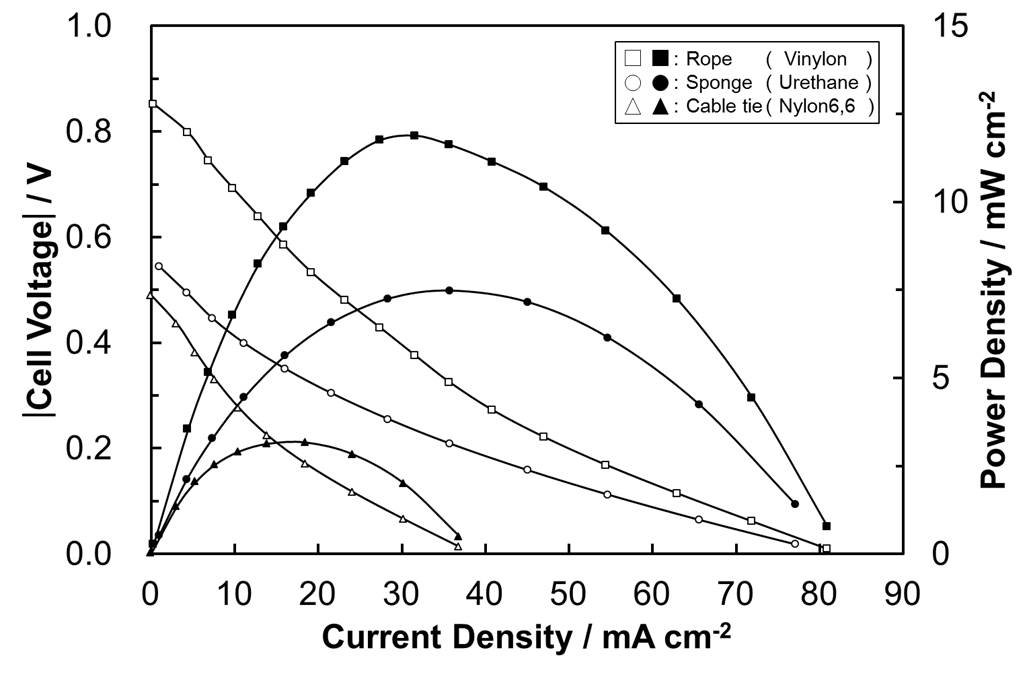
Transparent conductive oxides (TCO) with high visible transmittance and low resistance have been used in applications of optoelectronics. Dielectric/Ag/dielectric (DAD) multilayer was proposed to meet the requirements of low resistance and enough transparency [1]. In this work, a Cu-Ag bi-layer was proposed to serve as the mid-layer in oxides, including TiOx and WO3. All the films were prepared through E-beam evaporation at room temperature. The optical and structure properties of the D/Ag/Cu/D were studied by X-ray diffraction, UV-Vis, SEM, TEM and XPS. The surface morphology of Ag will be flattened by the Cu buffer layer, which can reduce the critical thickness of Ag layer. The thickness effects of Ag and Cu film on the optical properties of the D1/Ag/Cu/D2 were also investigated. According to the UV/VIS transmission spectra, the TiOx (35 nm)/Ag (12 nm)/Cu (3 nm)/TiOx (35 nm) exhibited the highest average visible light transmittance of 88%. The figure of merit (FOM) of TACT stacking is ~ 126 mΩ-1 at the wavelength of 550 nm. Using WO3 with an thickness of 40 nm as the capping layer above Ag/Cu/WO3 (WACW) shows a FOM of 73 mΩ-1. Use of Ag/Cu bilayer can widen the transmittance of the D1/Ag/Cu/D2 with an appropriate Ag and/or Cu thickness. The experimental results were also compared with the optical simulation to figure out the role of the ultra-thin Cu buried layer.
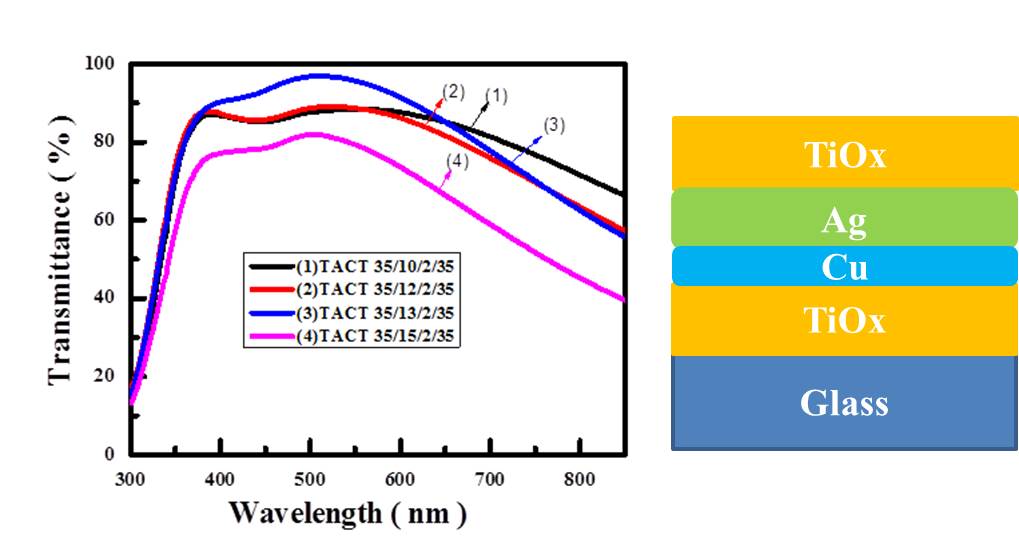
As chemical industries have grown gradually, strong alkaline chemicals are commonly used in almost all industries worldwide. Despite their usefulness, alkaline chemicals can be very dangerous as they can cause severe intoxication. In particular, gaseous alkaline chemicals require more precautions because they spread very quickly without being noticed in case of leakage. Therefore, it is important to detect strong alkaline chemical leaks promptly and easily. In this study, to detect gaseous alkalis immediately with naked eyes, we fabricated colorimetric textile sensors based on halochromic dyes. Three halochromic dyes with superior pH sensitivity were synthesized and applied to textile surface through screen printing method. The sensitivity to gaseous alkaline chemicals of the fabricated textile sensors was investigated. Ammonia was used as a gaseous alkaline chemical and the test was conducted at a concentration of 1 to 100 ppm. All of the fabricated sensors showed a high reaction rate and distinctive color change under alkaline condition due to the high pH sensitivity of the dyes. These results indicate that the fabricated textile sensors can be a promising candidate for practical sensor applications.
Recently, nanosheets (NSs) have attracted attention because of their various fascinating properties. We have developed the synthesis method of NSs inside bilayers of hyperswollen lyotropic lamellar phases of amphiphile solutions; the distance of the bilayers with several nm thickness is kept several hundred nm. We named the synthesis methods "Two-dimensional Reactors in Amphiphilic Phases" (TRAP) method. We have already successfully synthesized NSs of polystyrene and metal organic frameworks (MOF) in the thin hydrophobic sites inside the bilayers of aqueous amphiphilic solutions. To extend the range of the application of the TRAP method, we focused on aluminosilicate that is commonly synthesized in the hydrophilic reaction fields.
Aluminosilicate can be a precursor of zeolites with molecular-sized pores (0.3-1.2 nm-sized pores), which lead to the unique functions of zeolites: catalysts, adsorbents, ion-exchangers and membranes. CHA-type zeolites (CZs) are preferable catalysts for methanol to olefins (MTO) processes, which are important for the production of ethylene and propylene requied for polymer industry. CZs, however, have some problems; in particular, the pores are quickly clogged with by-products, and the resulting restriction of the reaction site and the diffusion induces the catalyst deactivation. One of the most promising solutions of the problem is the downsizing of the catalysts. Because the downsizing effect is based on the decrease of diffusion path length, CZ-NSs should have a potential as catalysts with one of the ideal shapes for the MTO processes.
Here, we report the preparation of the suspension of aluminosilicate NSs as a precursor to synthesize CZ-NSs using the TRAP method. Atomic force microscopy (AFM) and transmission electron microscopy (TEM) of the obtained CZ-NSs indicate that their thickness and horizontal width are a few nm and several hundreds of nm, respectively (Figure). This is the first example of CZ-NSs with a few nm thickness.
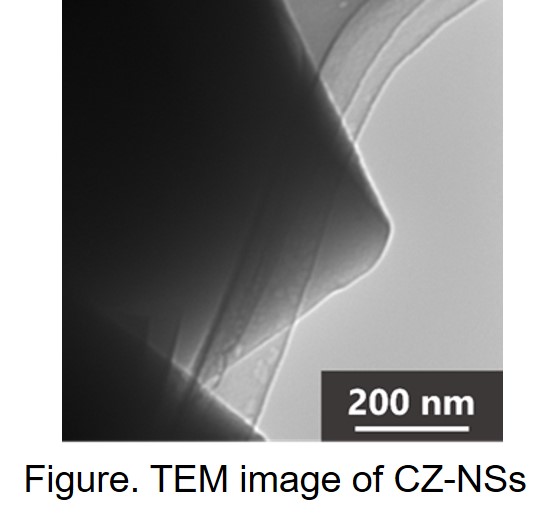
Seawater is currently used for desalination and salt production, and then the bittern is discharged by the operation. The bittern contains various resources, but most of them are unutilized. It is important to consider the resource recovery process from the bittern in Japan. Therefore, we focused on synthesis of layered double hydroxides (LDH) from the components of the bittern. The LDH is a clay mineral and has anion exchange ability. In this study, the anion exchange property of LDH from the bittern was investigated in comparison with that from ingredients of LDH stoichiometric concentration without components of Na, K, etc which include in the bittern but not in the basic LDH.
The simulated bittern was adjusted based on the actual composition of the bittern and was mixed with Al solution. The precipitate of LDH obtained by dropping into sodium hydroxide solution with coprecipitation method at a high pH region and the powder samples were obtained by filtration from the slurry. The structure, size, shape and ion concentration and anion exchange property of the LDH were analyzed by XRD, SEM and ICP.
The precipitated LDH from the bittern was Mg-type hydrotalcite as results of the XRD measurements. Then, the synthesis of Ca-type hydrocalumite can be also synthesized at another higher pH region. In the syntheses, all LDHs had Chloride ions as charged intercalants for keeping charge neutrality in the layer structures. The anion exchange property was investigated between Cl- and PO43-. The exchange structures were checked by interlayer distance variation before and after the exchange operation. The anion exchange capacity of the hydrotalcite form the bittern showed lower than that from the artificial ingredients.
Zeolites are crystalline microporous aluminosilicates that are widely used as adsorbents, ion-exchangers, and catalysts owing to their large micropore volumes with well-defined pore structures, ion-exchange abilities, and solid acidities. However, the pore sizes of zeolites are usually smaller than 0.7 nm, and the diffusion of molecules in the micropores is often a rate-determining step. Therefore, nano-sized zeolites attract much attention. Proper supports should be used for practical use of nanosized zeolites to prevent their aggregation, and porous inorganic submicron fibers are desirable supports for nano-sized zeolites due to strength, high formability and high surface areas. We prepared zeolite-containing submicron-fibers by centrifugal spinning. The centrifugal spinning is a method using a centrifugal force as a driving force and was developed recently for mass production of various fibers. After careful tuning of preparation conditions and fiber compositions, obtained fiber showed high BET surface areas even after repeated water adsorption test.
To meet increasingly strict regulations on emission control, there has been a high demand on effective catalysts for ammonia selective catalytic reduction (NH3-SCR) of NOx. Although the CHA zeolite dominates the current NH3-SCR market, other small pore zeolites have been studied as equivalent or more efficient catalysts. AFX zeolite is considered to be a superior catalyst for this reaction, which has not yet been applied for industrial use. This situation is in part due to partly because of its long synthesis time (typically, one week or even longer). A more efficient synthesis can help greatly save cost and energy which will pave the way for its industrialization towards emission control. In the work, we demonstrate the ultrafast synthesis of AFX zeolite from the hydrothermal conversion of FAU zeolite, which resulted in fully crystalline product in as short as 12 min.
We carried out the synthesis in the autoclave with a typical recipe, which took 7 d to yield AFX zeolite. The ultrafast synthesis was carried out in a tubular reactor made of stainless steel tube (1/4 inch) which features fast heating and cooling. To prompt the crystallization, seeding method was applied where the autoclave product was used as a seed; the composition of the synthesis precursor was optimized where FAU zeolite was used as a raw material; and, the synthesis temperature was elevated to 210 °C. Although the crystallization time was shortened, the synthesis resulted in the co-crystallization of ANA zeolite as a byproduct. To overcome this issue, the AFX seed was found to play an important role. With a seed synthesized by an improved method, the pure AFX zeolite was obtained after a synthesis of 12 min. This ultrafast synthesis method would facilitate the mass production of AFX zeolite boost its application as a de NOx catalyst.
The synthesis of zeolites, typically carried out in batch reactors like autoclaves, takes a time so long (typically, on the order of days) that the crystallization of zeolites had been believed to be very slow in nature. Long periods of hydrothermal treatment also cause a burden on both energy efficiency and operational costs. Recently, we have reported the ultrafast syntheses of a class of industrially important zeolites within several minutes. We present herein a continuous flow method for the synthesis of ZSM-5 using pressurized hot water with extremely high temperature (370 °C) as the heating medium. With a carefully tuned gel, the crystallization could be completed in tens of or even several seconds.
Direct mixing of synthesis precursor and the pressurized hot water in a millimeter-sized continuous flow reactor could result in immediate heating up to high temperatures; consequently, the crystallization of ZSM-5, from amorphous state to full crystallinity, proceeded to completion at a remarkably fast rate in a system without the addition of any seed. The well-tuned synthesis precursor, obtained by aging the initial aluminosilicate gel at 90 °C for a certain period, triggered the nucleation and ensured the formation of ZSM-5 without any byproduct at extremely high temperatures. The crystallization rate surpassed the decomposition rate of OSDA because of the creation of a favorable environment for crystallization. When a gel aged for 16 h was employed, fully crystalline ZSM-5 was obtained after a synthesis for 6 s. SEM image shows that the ZSM-5 synthesized after 6 s exhibited well crystallized facets. These unexpectedly fast crystallization rates in a continuous flow apparatus helped us to approach the limit of the zeolite crystallization.
Graphene oxide (GO) contains abundant oxygen-containing functional groups, which is an effective adsorbent to remove organic and inorganic pollutants. SBA-15 possesses large surface area, large pore volume, adjustable pore size, and thick silica wall. In the current study, we attempted to synthesize GO/SBA-15 nanocomposite. The large surface area of SBA-15 can provide abundant adsorption sites and plays a crucial role in increasing the adsorption efficiency and reuse of GO. This investigation characterized GO/SBA-15 materials through transmission electron microscopy (TEM), field–emission scanning electron microscopy (FESEM), X-ray diffractometry (XRD), surface area analysis, and Raman spectrometry. Various experimental parameters including the initial concentration of dye, calcination temperature, and pH of the solution were investigated. Immersion of GO into mesoporous SBA-15 increased methylene blue (MB) adsorption capacity. Increasing the initial concentration and solution pH enhanced the adsorption efficiency of GO/SBA-15. Optimal MB adsorption was observed at a calcination temperature of 550 °C. N2 adsorption-desorption measurement indicated that the GO/SBA-15 samples were mesoporous materials with uniform pore distribution. The addition of GO did not affect the mesostructure of the SBA-15 framework. The GO/SBA-15 possessed a large surface area of 891 m2/g, large pore volume of 1.035 cm3/g, and wide pore diameter of 6.50 nm. TEM of the synthesized GO/SBA-15 revealed that GO was homogeneously coated on the surface of mesoporous SBA-15. The adsorption isotherm and kinetics were more closely represented by the Langmuir model and pseudo-second order model, respectively, indicating that the adsorption type was monolayer adsorption. Reutilization experiments were carried out to investigate the stability and regeneration ability of the GO/SBA-15 materials. The adsorption capacity still remained above 95 % after five-time reused, demonstrating the excellent regeneration of the GO/SBA-15 materials. This method of preparing GO/SBA-15 composite is potentially useful for removing organic pollutants from wastewater.
Polycarbonates used in engineering are strong, tough materials, and some grades are optically transparent. Nowadays, the flame retardancy of polymers are the major concern. In this study, Polycarbonate (PC) was selected to develop an efficient flame retardant (FR) of high temperature polymer. A series of organo phosphorus flame retardants (FRs) based on aromatic phosphate and cyclic phosphate, mainly Biphenyl bis(cyclic 1,3-propanediol phosphate)(BP-CPP) and Biphenol bis(cyclic 2,2-dimethyl-1,3-propanediol phosphate)(BP-DMPP), were synthesized for polycarbonate. Their thermal stability and flame retarding efficiency as a single-component additive were investigated and compared with resorcinol bis(diphenyl phosphate) (RDP). Flame retarding efficiency was evaluated by the UL-94 test method. The V-0 rating was achieved at RDP/ BP-CPP loading of 6/2 wt% for polycarbonate, which is far better than that of resorcinol bis(diphenyl phosphate) and cyclic phosphate-based FRs. And its flame retarding performance was studied by the UL-94 and thermogravimetric analysis (TGA).
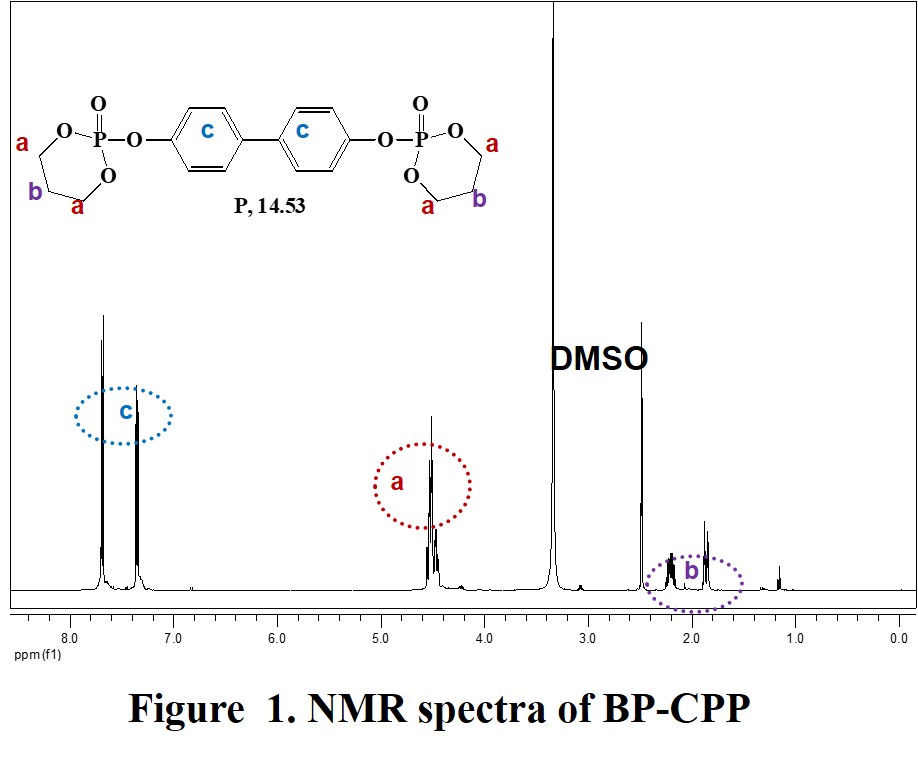
Porous materials have been widely applied to the different fields, such as adsorbents, heterogeneous catalysts, drug loading and delivery. In the current studies, the porous materials are mostly constructed by gas foaming, photolithography, templating, etc. Here, we report an innovative manufacturing process for the fabrication of three-dimension porous structures containing other ingredients including the organic and inorganic via the chemical vapor deposition (CVD). The porous materials were made by poly-para-xylenes (PPXs) replacing the origin sublimating templates via the sublimating/deposition process, and the ingredient that cannot be sublimated would be encapsulated within the PPXs porous materials. The mechanism of the porous structures is that the pores are formed by the gas vapor occupying the remaining vacancies lifted by sublimated template. By adjusting the sublimation rate of the template and the rate of PPXs deposition, the porosity can be controlled. In this report, we present three examples including the magnetic porous particles, cell-containing scaffolds and the protein-encapsulated porous particles. This novel approach overturns the general concept that vapor deposition forms uniform thin film and also provides another way to manufacture multifunctional porous materials.
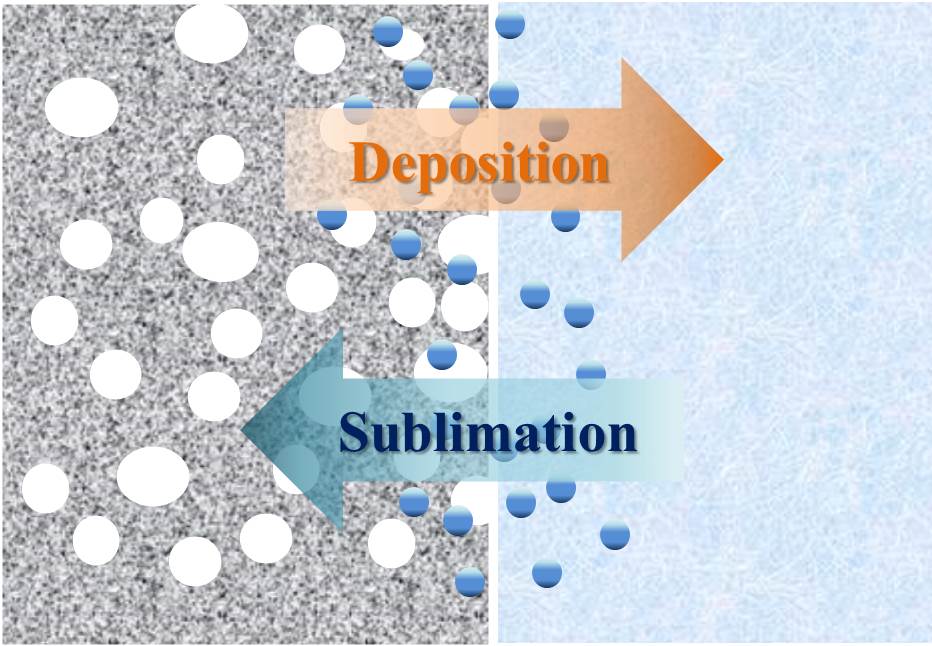
In this study, a oriented organometallic frame/polyvinyl alcohol (MOF/PVA) nanofiber material was prepared by electrospinning. PVA was uniformly mixed with a MOF to form a solution. In this experiment, zinc nitrate Zn(NO3)2) and 2-methylimidazole were used to synthesize ZIF-8 powder material by in-situ process, and then added to 40mg, 120mg and 200mg respectively. The 10wt% PVA polymer solution was thoroughly stirred, the precursor was disposed, and the electrospinning process was performed. The crystal structure and scanning electron microscope (SEM) were detected by X-ray Diffaction (XRD). Observing the trend of fiber arrangement and the surface morphology of ZIF-8 grown on the fiber, the weight change of the sample detected by Thermogravimetric Analysis (TGA), and the Fourier Transform Infrared Spectroscopy (FTIR) test sample The change of properties before and after mixing of different contents.
As a results, it was found by SEM observation that PVA/ZIF-8 10 wt% was formed by bead-like fibers after electrospinning. From this phenomenon, ZIF-8 was uniformly dispersed in a polymer solution to reunite ZIF-8 by electrospinning technology. ZIF-8 can be evenly distributed in the fiber. XRD analysis showed that there were indeed various characteristic peaks of ZIF-8 in the composite fiber, and it was further confirmed that ZIF-8 was contained in the fiber.
Metal-organic frameworks (MOFs) are porous material composed of metal ions and organic ligands, which have ordered crystalline structure with micro pores and high surface area. MOFs are recently focused as materials for various applications. In the development of the MOF-based mixed-matrix membranes for membrane separation processes, the size and the shape of particles are the important factor for membrane performances. Zeolitic imidazolate framework-L (ZIF-L) is one of the two-dimensional MOF which is focused as materials for mixed matrix membrane; however, the control of the shape and the particle size has not been sufficiently reported yet.
In this study, we report the effect of surfactants on the synthesis of ZIF-L. Surfactants can adsorb on the specific surface of the MOF crystal in synthesis, and can control the size and the shape of the resultant MOF particles. In the synthesis of ZIF-L, we used cetyltrimethylammonium bromide (CTAB) as cationic surfactant, sodium dodecyl sulfate (SDS) and sodium dodecylbenzene sulfonate (SDBS) as anionic surfactants, TWEEN(R) 20, 40, 80 as nonionic surfactants. We synthesized ZIF-L in the presence of various surfactants with various concentrations and characterized the crystal structures using X-ray powder diffraction, the size and the shape of the particles using scanning electron microscope, porous structure using nitrogen adsorption measurements. The characteristics of obtained ZIF-L particles are highly influenced by the species of surfactants, and the details will be reported in the presentation.
Metal-organic frameworks (MOFs) are novel porous materials composed of metal ions and organic ligands. MOFs have ordered porous structures and show adsorption and molecular sieve properties. As one of the applications, MOF-based mixed-matrix membranes (MMMs) have been reported for gas separation. The morphology of MOF particles is the important factor for membrane performances. It is reported previously that MMMs prepared by stacking two-dimensional (2D) MOFs horizontally in the membrane plane can exhibit high gas selectivity by reducing the permeation of non-permeable component. Zeolitic imidazolate framework-7-III (ZIF-7-III) is one of the 2D MOFs which is composed of zinc ion and benzimidazole and forms layered crystal structure with micropores which diameter is approximately 0.29 nm. In the previous report, composite membrane was prepared using ZIF-7-III nanosheets which was made by exfoliation of layered ZIF-7-III particles. The initial ZIF-7-III particle size should be influential on membrane performances; however, there has been no report on the control of ZIF-7-III particle size.
In this study, we report the control of ZIF-7-III particle size using water-in-oil microemulsion. Microemulsion was prepared using heptane as continuous phase, water as dispersed phase, cetyltrimethylammonium bromide (CTAB) as surfactant and 1-hexanol as co-surfactant. Synthesis of ZIF-7-III was conducted in microemulsion, and obtained white powder was characterized using powder X-ray diffraction and scanning electron microscope. Reaction conditions such as reaction temperature, concentration of CTAB were highly influential on the morphology of resultant ZIF-7-III particles. The details will be reported in the presentation.
Metal-organic frameworks (MOFs) are an emerging class of nanoporous materials. Owing to their highly ordered nanopores, MOF membranes are promising for higher selectivity and permeability than polymer membranes which dominate industrial membrane separation. However, high cost of support materials and lack of robust membrane fabrication methods are problematic. Here, to establish a versatile fabrication method, we investigated the formation process of MOF membranes on hollow fibers, originally used for water purifier filter, which are cheap and easily available.
Here we focused on zeolitic imidazolate framework-67 (ZIF-67) composed of Co2+ ions and 2-methylimidazole (MIM) linker, which is a family of MOFs, and applied a secondary growth method. In this method, seed crystals were deposited on the fiber by immersing the fiber in MIM and Co(NO3)2 aqueous solutions alternately, followed by the seed crystals growth by immersing seeded fibers in a mixed aqueous solution of MIM and Co(NO3)2 (growth solution). We first investigated effects of concentration ratio of growth solution (R = [MIM]growth / [Co2+]growth). A small R resulted in the deposition composed of needle-like crystals with many gaps (Fig. 1a), while a large R produced a thin film densely packed by rhombic dodecahedral crystals (Fig. 1b). However, resultant films showed no separation selectivity.
To improve the membrane performance, we modified the growth process. Immersing seeded fibers in a growth solution with a small R was followed by subsequent growth under a large R so that ZIF crystals first grow vertically and then merged with each other by filling gaps in the second growth. This two-step process successfully produced a thick and dense membrane (Fig.1c) with separation factor of 1.15 for air and propane, which suggests that the two-step growth reduces cracks. Hence, we demonstrated that the stepwise control in the crystal growth direction enables the membrane densification.

Metal-organic frameworks (MOFs) are new porous materials discovered in the 20th century. MOFs are synthesized through self-assembly of metal ions and organic ligands, and they have regular arrays of micropores and a large surface area. In addition, by selecting components, MOFs exhibit various crystal structures with tunable pore size. From these characteristics, MOFs are expected to be applied to the medical field, especially drug delivery systems (DDSs). In DDSs, the drug with necessary amount are transported to the right place at the right time by spatial and temporal control. Generally, a carrier for containing or binding the drug is required for DDSs. Although it is common to use a liposome and a polymeric micelle as the carrier, the high inclusion method of drugs has not been established. In recent studies, therefore , MOFs have attracted much attention as a new DDS carrier with high drug inclusion.
In this study, the drug-release behavior from MOFs by a pH change was investigated. As model MOFs, we selected zeolite imidazolate framework-8 (ZIF-8) and Universitetet i Osolo-66-NH2 (UiO-66-NH2). It is reported that the crystal structures of ZIF-8 and UiO-66-NH2 collapse under acid and base conditions, respectively. As model drugs, indomethacin and ibuprofen were selected. We found that ZIF-8 included indomethacin and its dissolution rate from ZIF-8 was the fastest at pH 5.0. On the other hand, UiO-66-NH2 included ibuprofen and its dissolution rate from UiO-66-NH2 was the best at pH 8.5. These results will lead to the development of the new pH responsive DDS with high drug capacity.
Hydrogels are used in applications such as separation, reaction, and drug delivery systems. The diffusivity of solute in hydrogels is an important parameter. For example, the concentration and the diffusivity of solutes, such as oxygen and NH4+, in the hydrogel can affect the activity of ammonia-oxidizing bacteria (AOB) immobilized within the hydrogel for an ammonia wastewater treatment system. The goal of this study is to develop a novel method to measure the diffusivity of solute in spherical hydrogel using a microsensor. A microsensor measures the chemical environments at the scale of the micrometer-sized sensor tip, as well as the concentration of solute in hydrogel. Millimeter-sized spherical hydrogel is suitable for the experiment using the microsensor and the analysis of diffusion kinetics. The spherical polymeric hydrogel was prepared using a production method combining sedimentation polymerization and two-fluid atomization, developed in our previous study. Oxygen, NH4+, and N2O were used as model solute for AOB-catalyzed reactions. The experiment on oxygen diffusion was carried out as follows. Firstly, a microsensor was inserted in the center of the spherical hydrogel and the hydrogel was placed in anaerobic water purged with N2 gas. Then, water was purged with air and the dissolved oxygen (DO) concentration in the hydrogel was measured continuously. The DO concentration was approximately 0 during initial period, and increased with time up to approximately 230 mmol/m3 in air-saturated water. Diffusivity of solute in hydrogels was successfully analyzed using the solution of the Fickian diffusion equation within a sphere.
Pd catalyzes various kinds of reactions such as automobile exhaust emission treatment and organic synthesis. In this study, we focus on polymer gel as a heterogeneous catalyst carrier. The gel is a polymer of a three-dimensional network structure swollen with a solvent and can be handled like a solid, but the inside of the gel is also like a liquid. The aim of this study is to develop a polymer gel supported Pd catalyst using various polymer gels, to clarify the influence of the absorption and adsorption ability of the gel and the holding state of Pd(II) ion on the catalytic activity to construct a design guideline for a high performance gel catalyst. The model polymer gel was copolymer gel of allyl mercaptan (AM) having a thiol group interacting with Pd(II) ion and multicomponent, and gel having amino group and ammonium group in side chain. The various kinds of gels were synthesized by free radical polymerization. Pd(II) ion-adsorbed gels were prepared through the Pd(II) ion adsorption experiment, and subsequently Pd nanoparticle-loaded gels were prepared by the reduction of Pd(II) ions using NaBH4. The model organic synthesis was Suzuki-Miyaura coupling (synthesis of biphenyl with phenylboronic acid and iodobenzene as reactants) using both catalysts Pd(II) ion-adsorbed gels and Pd nanoparticle-loaded gels. The adsorption properties of Pd(II) ions of various gels, characteristic properties of gel supported Pd, and Suzuki-Miyaura coupling reaction characteristics using gel supported Pd were investigated.
The excited electrons and holes generated upon by irradiating UV ray to TiO2 have powerful redox power. They produce reactive oxygen species (ROS) under aerobic conditions at the surface. These species rapidly decompose organic compounds to convert them into CO2 and H2O via carbon-carbon bond cleavage. On the other hand, they can also catalyze organic synthesis reactions such as carbon-carbon bond formation. The reactions must be carried out in dry anaerobic conditions in order not to produce ROS that can damage organic compounds. Usually, TiO2 has been used as a powder to increase the catalytic effect. However, the use of particles involves the need of incorporating extra stages in the purification process, such as separation and catalyst recycling. We focused on a composite of TiO2 nanoparticles and a polymer gel in which TiO2 nanoparticles are dispersed and immobilized in the polymer gel as a heterogeneous catalyst. The purpose of this study is to develop a novel TiO2 nanoparticle-loaded polymer gel and clarify its applicability as a catalyst for organic synthesis reaction. As polymer gels, N,N-diethylacrylamide gel, N,N-dimethylacrylamide gel, and N-isopropylacrylamide gel were used. Commercial TiO2 nanoparticle (AEROXIDE® TiO2 P-25) with 21 nm in diameter was used. The composite gels were synthesized by free radical polymerization. The 4-iodetoluene dehalogenation reaction as a model organic synthesis reaction was performed by a batch operation using 4-iodetoluene, diisopropylethylamine, dried composite gel, and acetonitrile as a solvent. The reaction was irradiated with UV light and stirred at room temperature under a nitrogen atmosphere. The composite gels catalyzed the reaction successfully.
Sodium alginate aq. is known to form hydrogel on mixing with CaCl2 aq., where Ca2+ works as the crosslinker. Megascopically, the above process is observed as instantaneous gelation. The authors have been interested in capturing the quick gelation in terms of how fast it occurs on actual mixing of these two starting aqueous solutions. First, 1wt% sodium alginate aq. was added dropwise into 10M CaCl2 aq. and the time evolution of the morphology of the droplet after the impingement onto the surface until the stabilization of its outer surface was recorded in a high-speed motion picture. The difficulty in fulfilling our observational purpose relying on the above method was revealed that the gradual morphological alteration toward the spherical geometry is temporarily too moderate to be detected by the high-speed motion picture method. In order to capture the arrest in the deformation of the gelling solution more effectively, we needed to choose a situation where the tiny surficial undulation of the gelling solution is incessantly induced by being in contact with 10M CaCl2 aq. In the intensively discharged gelling solution out of an injection syringe, it was found that the straight linearity of the gelling solution in the translational motion was observed while it kept in the state of a flowable solution. The beginning of the deviation from the as-injected linear flow implied the vanishing fluidity. Thereafter, the gelling solution was seen to behave like rod-like objects forming an entangled coil. From the discharging velocity of the gelling sodium alginate aq. at the exit of the injection syringe, the timescale for the gelation was estimated to be 10-3s in the order of magnitude.
In many countries, arsenic level in groundwater exceeds the acceptable limit. Although we removed Arsenate in our previous research, removal of Arsenite is harder. The purpose of the study is to adsorb Arsenite, As(III), from ground water by adsorption using a composite of cationic polymer gel impregnated with iron hydroxide. The cationic polymer gel that we used is N,N-dimethylamino propylacrylamide, methyl chloride quaternary (DMAPAAQ).
The gel was prepared in a unique method where Sodium Hydroxide and Iron (III) Chloride was added to the monomer and initiator solutions, respectively, in order to maximize the FeOOH contents in the polymer structure of the gel.
Transmission Electron Microscope (TEM) images show that our gel contains visible FeOOH particles in its structure. The Thermogravimetric Analysis (TG) indicates that the maximum weight percentage of FeOOH particles in the gel is 53.7%. Generally, there are three types of FeOOH. We performed Mössbauer spectroscopy to determine the type of FeOOH contained in the gel. The results match with that of γ-FeOOH. Previous arsenic removal experiments found that γ-FeOOH helps to remove both As(III) and As(V). Our studies suggest that in the structure of DMAPAAQ + FeOOH gel, the polymer structure of DMAPAAQ adsorbs 35.6%, whereas γ-FeOOH components adsorb 64.4% of arsenic. Hence, DMAPAAQ + FeOOH can adsorb arsenic successfully. FTIR analysis suggests that when As(III) and As(V) were adsorbed by the DMAPAAQ + FeOOH gel, changes such as shifts, appearances and disappearances in several surface functional groups occurred. These results further prove the adsorption of arsenite to the gel.
Our study successfully showed that the newly developed gel composite, DMAPAAQ and FeOOH, adsorbed As(III) effectively because of having γ-FeOOH components in the gel structure. The novelty in our research is in the unique preparation method of the gel, and It's characterization.
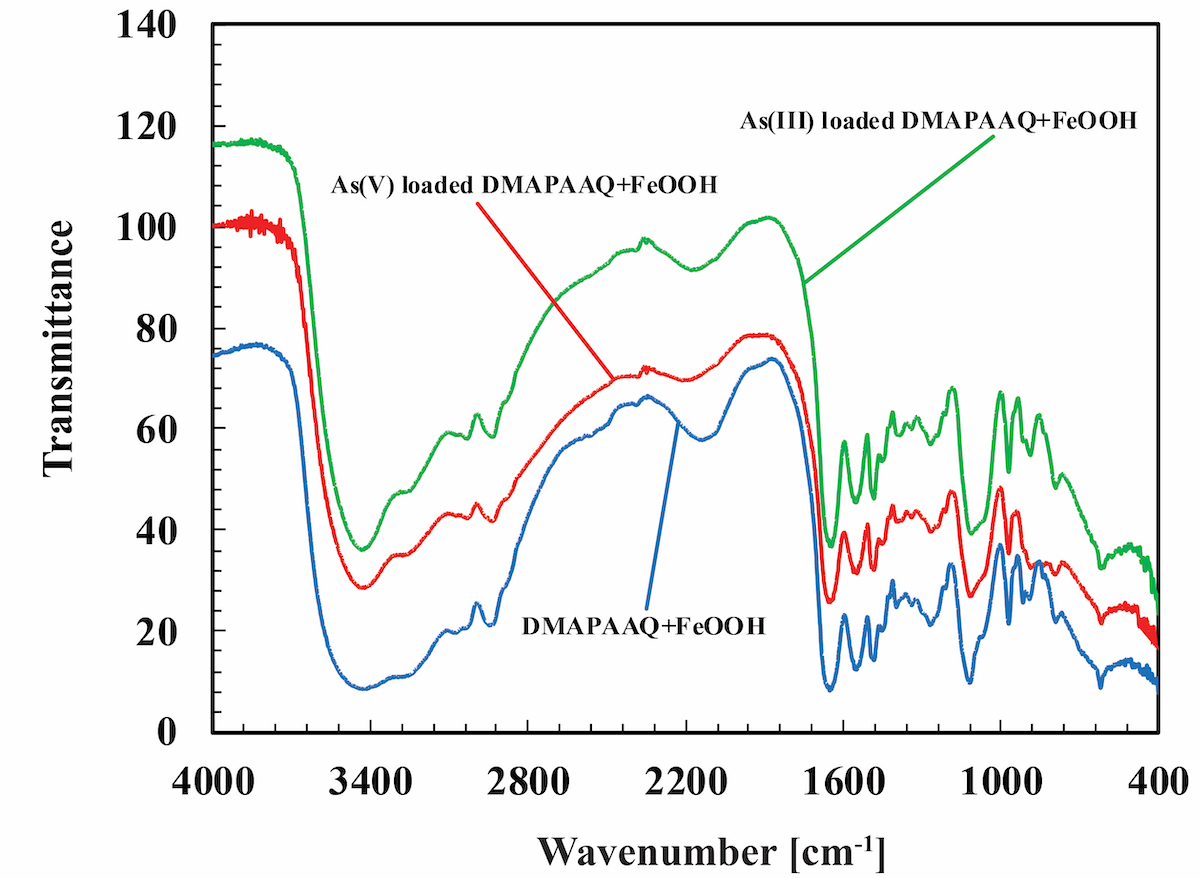
Catalysis by Heteropoly acids (HPAs) and polyoxometalates (POMs) having a higher demand worldwide, as it can be designed to accelerate complex reactions and be more environmentally friendly. However, recycling of water-soluble solid catalysts remains a problem. The synthesis of a recyclable composite with catalytic properties is the key to better use of HPAs and POMs. Many researches have mentioned the method of synthesis by immersing a porous carrier in a supported solution. However, the catalytic abilities of the previously studied composites after multiple uses have rarely been mentioned. In this research, a novel idea is proposed to synthesize a heteropoly acid supported composite. A complex hydrogel with catalytic properties was synthesized by mixing an anionic monomer with a heteropoly acid. The heteropoly acid particles were inserted inside the hydrogel by the interaction forces between the anions. Thus, preventing the water-soluble heteropoly acid from being lost during the catalytic reaction. The complex hydrogel is consisted of the anionic monomer 2-acrylamide-2-methylpropanesulfonic acid (AMPS) as a carrier, N,N′-Methylenebisacrylamide (MBAA) as a crosslinker and the typical keggin-type HPA: H3PW12O40, which was synthesized by one-pot method. Then the composite is divided into five groups. Following this, the five groups were washed by deionized water for 24h, 48h, 72h, 96h and 120h respectively. The existence of H3PW12O40 crystalline nanoparticles in the composite was confirmed by X‐ray diffraction (XRD). After comparing the samples from different groups by Scanning Electron Microscope (SEM), all the samples have similar surface structure and nanoparticle aggregation state. Nanoparticles were observed from the samples of each group by Transmission Electron Microscope (TEM). From the thermogravimetric analysis (TGA), the particle content rate of samples from each group was kept at about 17% as the washing time increased. It indicates a higher potential of this synthetic method to a wide range of applications.
Removal of heavy metals from ground water and soil has been a common problem both in industry and agriculture, since high concentration of heavy metals are harmful to environment and human health through water and food. In this study, a simple and effective removal method of various harmful anionic ions such as arsenic acid, selenium acid, and chromium acid from soil and water was proposed. Generally, these anions were removed by cationic adsorbent or cationic ion exchange resign. However, various adsorbents have low ability to remove heavy metals from low concentration solutions, and it sometimes desorb those ions when interfering ion exist. We present new ion removal method by using hydrogel. Anionic hydrogel of 2-Acrylamido-2-methylpropanesulfonic Acid Calcium salt (AMPS-Ca) and cationic hydrogel of N,N-Dimethylamino Propyl Acrylamide (DMAPAA gels) were used to remove anionic heavy metal ions. Each heavy metal ion could be partially removed by both hydrogels. It was found that removal of arsenic and selenium by AMPS-Ca hydrogel as attained by the formation of heavy metal calcium salts in the hydrogel. On the other hand, the crystallinity of the heavy metal salt was not found in the DMAPAA gel. It is found that removal of heavy metals by each hydrogel was made by adsorption or formation of heavy metal salt in the hydrogel. In addition, the various hydrogels used in this study could absorb water as well as sodium acrylate. Therefore, it is suggested that they also provide a method of solidify the heavy metal contaminated sludge discharged in tunnel excavation work. The contaminated sludge will be recycled after the treatment of the hydrogel.
Introduction
The demand for lithium-ion batteries has rapidly increased in recent years, and the supply will be insufficient in near future. Therefore, the establishment of lithium recycling process is required to solve the problem of the increase of the waste lithium batteries. However, conventional lithium recovery processes are complicated and costly. We have presented new simple lithium recovery process1) using hydrogel with a quaternary amine ((3-Acrylamidopropyl) trimethyl ammonium chloride)(APTAC). In this research, the reaction mechanism of lithium and carbonate ion are investigated.
Result and discussion
A schematic diagram of the process is shown in Figure 1. At first, APTAC gel was immersed in the solution containing anion which exchanged Cl-. The gel was then immersed in LiCl aqueous solution. The Li+ reacted with the anion in the gel to produce lithium salt. The Li+ was recovered as the lithium salt within the gel.
We investigated which anion was suitable for Li+ recovery and found that the HCO3- recovered the lithium ion best among PO43-, HCO3- and CO32-. HCO3- reacted with Li+ more than their stoichiometric ratio, 1.0, when the initial concentration of Li+ was more than 1000 ppm. It is considered the Li+ initially reacted with HCO3- to form metastable LiHCO3 when its initial concentration was below 1000 ppm. Then H+ in a part of the LiHCO3 exchanged with Li+ in the solution to form stable Li2CO3 when it was higher than 1000 ppm. Therefore, Li+ was recovered more than double of the stoichiometric ratio.
The elemental composition of the gel after the Li+ recovery was analyzed by XPS. The gel had the C-O single bond that was not exist in the original APTAC gel. We found that Li+ reacted with HCO3- and was recovered as LiHCO3 or Li2CO3 in the gel.
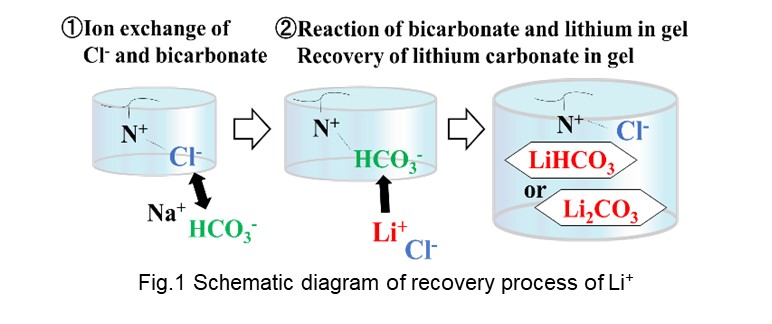
Gel bead can be used as a carrier for drugs and fertilizers and its diffusion characteristics has been studied for controlled release of chemical substances. In our study, the effect of the addition of the dispersed phase on the diffusion rate of substances in hydrogel was investigated. The oxygen diffusion rate in hydrogel containing microbeads was measured to study the effect of the size and amount of microbeads on the diffusion inhibition.
Figure 1 shows the effect of microbead addition on apparent diffusion coefficient of oxygen in hydrogel. The apparent oxygen diffusion coefficient was calculated by solving one-dimensional unsteady diffusion equation with measured data of dissolved oxygen concentration profile in the gel. First, the apparent oxygen diffusion coefficient in the gel containing the microbeads was smaller than that without the microbeads. It was confirmed that the addition of the microbeads inhibited oxygen diffusion.
Next, the apparent diffusion coefficient decreased with an increase in the microbeads holdup. On the other hand, the diffusion rate did not depend on the microbead size. To develop the estimation method of apparent diffusion coefficient, diffusion in hydrogel containing microbeads was considered by analogy with the diffusion theory in porous medias (Ohashi et al., 1993) where diffusion path is lengthened by solid obstacles. The experimental values agreed well with the model. This suggests that the apparent diffusion coefficient can be estimated from the volume fraction of the added dispersed phase.
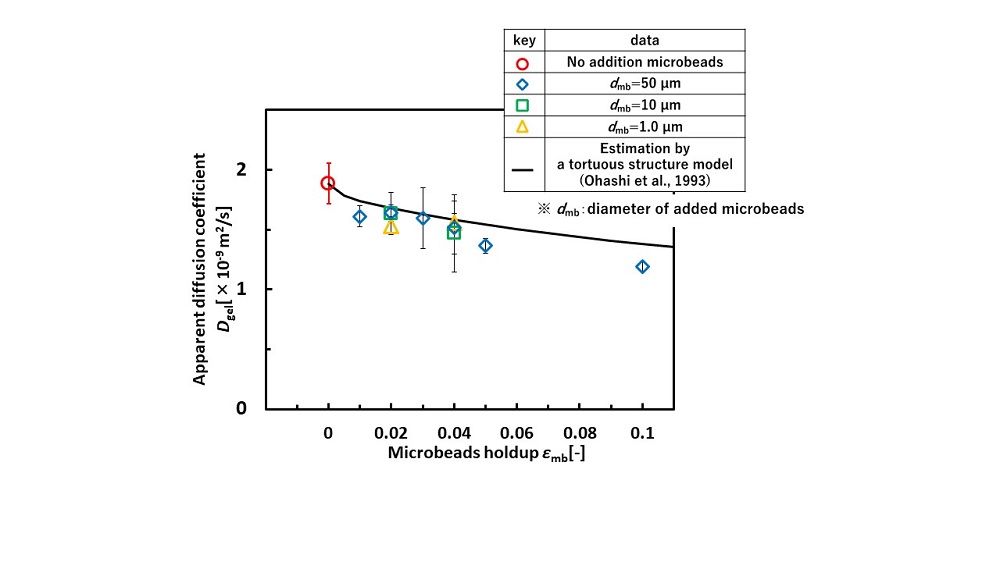
Heat dissipation is one of the most important issue for designing high performance devices. Thermal interface materials (TIMs) are used to promote heat transfer at the solid-solid interface between IC chip and heat radiator in electronic devices. Presently, composite materials of thermally conductive fillers and polymers are widely used, however polymers have problems of low thermal stability and low thermal conductivity. Here, we propose and report Ag aerogel films composed of Ag foils sandwiched with Ag porous layers (Fig. 1a,b). The film was fabricated by simultaneously forming Ag particles by gas-evaporation and depositing Ag particles on an Ag foil. The boat-foil distance was carefully optimized to make the Ag porous layer soft and uniform. The steady-state measurement showed a thermal resistance as small as <20 mm2K/W (Fig. 1c), which is similarly small as the high performance TIM of an indium sheet. Our aerogel TIM, made of Ag having a melting point (962 °C) much higher than indium (157 °C), can expectedly be used for thermal management under high-temperature conditions.

Hydrogel have good flexibility and biocompatibility, so they cause little damage by implantation in the body. Furthermore, since hydrogels can release drugs, they are expected to be applied to a local drug delivery system. The amount of drug used can be reduced and side effects can be alleviated by the local drug delivery system. However, the hydrophilicity of hydrogel interfere result in suppression the controlled release of hydrophobic drugs such as anticancer agents or antibiotics. We have developed hydrophobically-modified gelatin (HMG) and could prepare a hydrogel by only hydrophobic interaction. HMG hydrogel do not require the use of chemical crosslinkers, which are often toxic to the body. In addition, HMG hydrogel have hydrophobic segments in its structure, which can absorb hydrophobic drugs and expect to control their release. As a factor to control the amount of adsorbed hydrophobic drug in the hydrogel, we focused on the strength of hydrophobicity of hydrophobic group. HMG with different alkyl chain length (C4~C12) of modified hydrophobic group were synthesis. The swelling ratio of these hydrogels were decreased in increasing the chain length of alkyl group modified to HMG. This result means that the increase of alkyl chain length intensifies the hydrophobic interaction. Then, HMG hydrogel was adsorbed with uranine used as a model for hydrophobic drugs. The adsorption test exhibited that the amount of hydrophobic drug adsorbed in HMG hydrogels could be controlled by varying hydrophobic alkyl chain length. The controlled release of the drug was confirmed by drug release experiments in vitro. In conclusions, HMG hydrogel could control drug adsorption and delivery.
Novel organic-inorganic hybrid material was developed as a LED sealant.
Polysilsesquioxane with -SH group (PSQ-SH) and acrylic monomer were selected as inorganic and organic components, respectively. Trimethylolpropane Trimethacrylate (TRIM) which is a trifunctional monomer, has been selected as an acrylic monomer, and curing of the material was performed by the Thiol-ene reaction.The LED light emitting substrate was sealed using the prepared PSQ-SH/TRIM hybrid material, and a light emission test was performed. However, there was a problem that cracks occurred in the hybrid material during lighting. Therefore, Ditrimethylol propane tetraacrylate (DTMPA), which is a tetrafunctional monomer, was newly selected to prepare a PSQ-SH/DTMPA hybrid material in order to enhance the strength and heat resistance of the material. The organic component can be reduced by the increasing the number of the functional group in the monomer, and a more inorganic rich material can be prepared. The heat resistance can be improved by increasing the inorganic components in the hybrid material. The mechanical strength of the hybrid material can also be improved by increasing the polymerization density. Therefore, the characteristics of novel PSQ-SH/DTMPA hybrid material were evaluated and compared with PSQ-SH/TRIM hybrid material. As the contents of the evaluation, the heat resistance was evaluated by confirming the weight reduction start temperature using the Thermalgravimetry-differential thermal analyzer(TG-DTA) analysis, the mechanical strength was also evaluated by bonding the glass substrates with a hybrid material and measuring the sealing strength. The obtained results did not improve with respect to the heat resistance even if the monomer was changed.However, the mechanical strength was greatly increased by changing the monomer.
In conclusions, it was possible to suppress the generation of cracks at the time of lighting by using the PSQ-SH/DTMPA hybrid material compared to PSQ-SH/TRIM hybrid materials in the light emission test.
Rod-shaped nitroxide radical (NR) compounds with a five-membered ring NR moiety in the mesogen core (LC-NRs) show unique intermolecular magnetic interactions in their liquid crystalline (LC) and isotropic liquid (Iso) phases above room temperature; their magnetic susceptibilities increase abruptly at the phase transitions from the crystalline (Cr) to LC phases. This phenomenon is called magneto-LC effects. This effect is considered to originate from inhomogeneous intermolecular magnetic interactions. In fact, we confirmed that the effect was enhanced by adding a small amount of (2S,5S)-2 to (2S,5S)-1 (Figure). We also synthesized a new LC-NR with an azobenzene moiety (2S,5S)-3 whose trans and cis isomers have similar shapes to (2S,5S)-1 and (2S,5S)-2, respectively. Since an azobenzene moiety shows the photoisomerization, we expected to change reversibly in inhomogeneity of intermolecular magnetic interactions of (2S,5S)-3 due to the change of the molecular shapes during the photoisomerization. Here, we report the synthesis of a new LC-NR with an azobenzene moiety in the mesogen core and the effect of the photoinduced phase transitions on magnetic properties.
We observed the phase transition behaviors under ultraviolet (UV) or visible (Vis) light irradiation by polarized optical microscopy and measured UV-Vis light absorption spectra. We also measured electron paramagnetic resonance (EPR) spectra under continuous irradiation of UV or Vis light.
Photoinduced phase transitions occur only between LC and Iso phases under UV or Vis light irradiation for (2S,5S)-3. This is likely to arise from the increase of the ratio of cis-isomer by the UV light irradiations, which could reduce the orientational order parameter. EPR spectra indicate that magnetic susceptibility increases under UV light irradiation and decreases under Vis light irradiation. We confirmed that bidirectional switching of the magnetic properties of (2S,5S)-3 occurs under alternating irradiations of UV and Vis light.
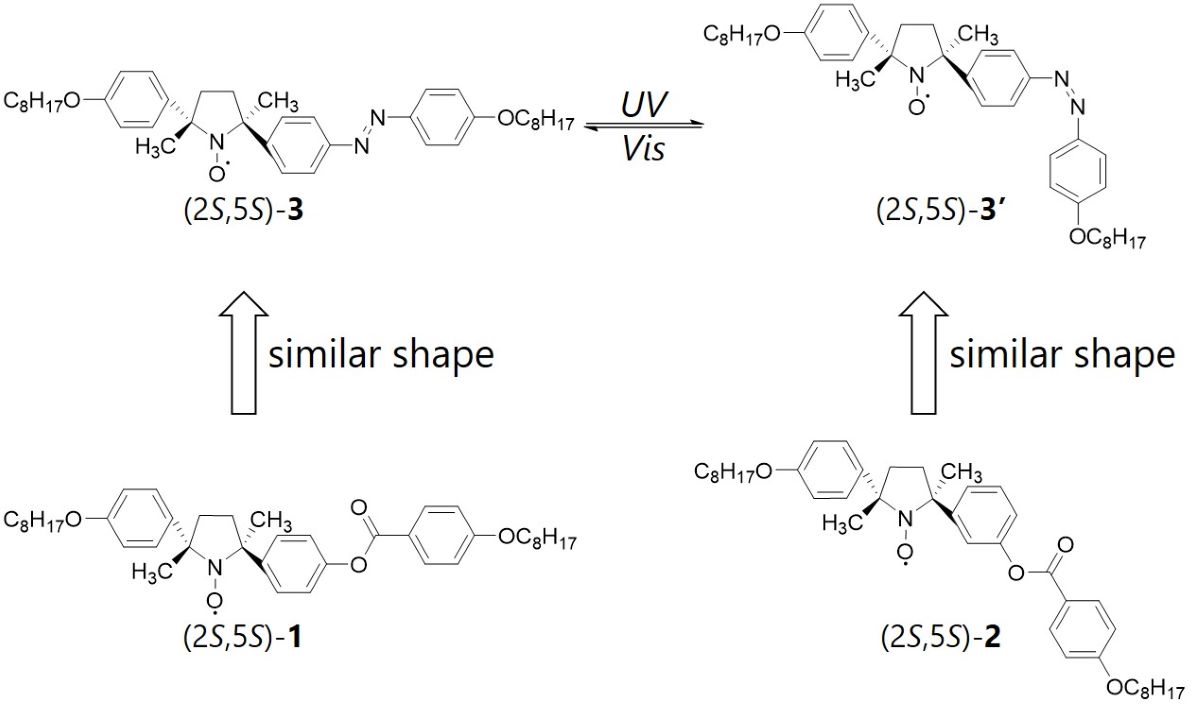
With the increasing demands on wearable devices, the stretchablity of various electrical devices have drawn much attention recently. The most commonly used method to enhance mechanical performance of stretchable polymers is introducing nanofillers to form a composite system. Polydimethylsiloxane (PDMS) is the most widely used silicon-based elastomer, and has been widely used in many medical, biological, and microfluidic applications. In the literature, various nanofillers, such as carbon nanotubes, graphene sheets, and silver nanowires, have been well dispersed in PDMS to demonstrate the flexibility and versatility of PDMS composites.
On the other hand, because of the chemical inertness, it is difficult to include ionic fillers in PDMS. PDMS composites with ionic filler usually have problems like filler aggregation, delamination, phase separation, or fractures, under stretching conditions. To address this problem, in this work, a water-in-oil type emulsion is used as a carrier for water-based ionic materials. The relationship between applied sheer rates and droplet size will be examined to elucidate the emulsion process. Moreover, emulsion stability will also be carefully characterized to investigate the effectiveness of various emulsifying agents. In summary, this research provides a new method for PDMS composite synthesis and opens a new avenue to stretchable polymer applications.
In the last two decades, many reports revealed the novel functional properties of natural and synthetic peptide lipids. Previously, we also reported the high self-assembling ability of various peptide lipids and demonstrated high cytotoxicity of some peptide lipids to animal cells. Peptides can be substrates for many enzymes in a living system. For example, tyrosine kinase adds a phosphate group to a tyrosine residue in a target protein, which plays a key role in signal transduction on cell growth and differentiation. Gene mutation in tyrosine kinase leads to uncontrollable signal transduction and causes many cancers. In other words, tyrosine kinase activity of some cancer cells is different from other cells.
Here, we prepared novel peptide lipids that underwent phosphorylation of its peptides by tyrosine kinase in animal cells and evaluated their cytotoxicity. First, we synthesized different types of peptide lipids by solid-phase peptide synthesis, which were composed of fatty acids (C8 – C16) and peptides containing tyrosine (Fig. 1). The peptide sequences were designed according to tyrosine kinase substrates. The synthesized peptide lipids were purified by HPLC and confirmed by MALDI-TOF MS. When a phosphate group is added to tyrosine in a peptide lipid by tyrosine kinase, the hydrophilicity of the peptide lipid increases. We conjectured that a peptide lipid is transformed to anti-cancer drugs in cancer cells. We expected that phosphorylated peptide lipids should have cytotoxicity different from the original peptide lipids (Fig. 1). The present study proposes the novel effective treatment of drug-resistant cancer cells based on kinase activity.
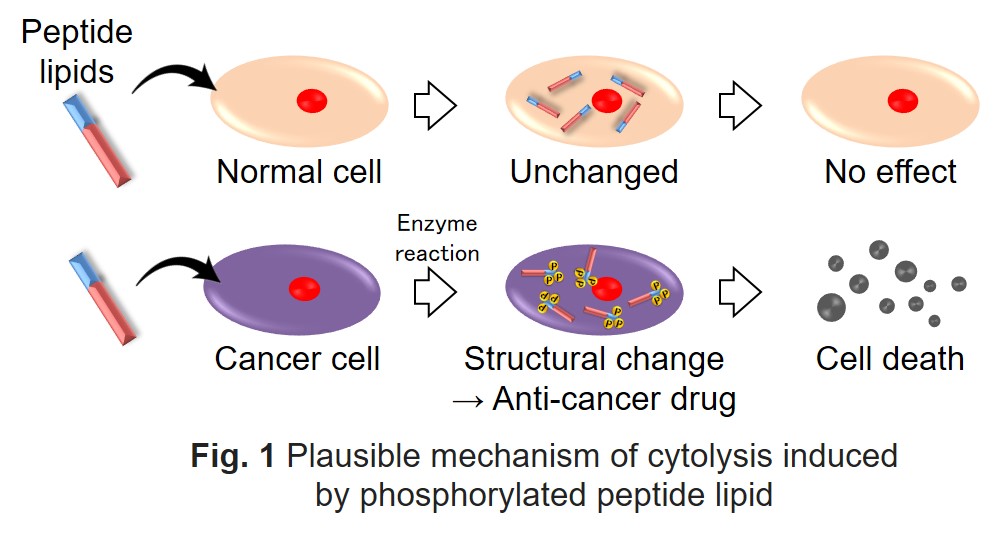
Lipid vesicles are closed bilayer membrane(s) consisting of amphiphilic lipid molecules such as phospholipids formed in aqueous media. Lipid vesicles can encapsulate various water-soluble biochemical molecules into their internal water phase, therefore lipid vesicles have been studied as biochemical microreactors surrounded by lipid bilayer membranes, those are structurally similar to biological cells. However, the utilization of lipid vesicles as microreactors is limited by their preparation method because it is generally difficult to obtain vesicles containing biochemical molecules such as enzymes with high encapsulation efficiency and controlled diameter.
Recently, we developed a novel vesicle preparation method by the combination of multiple emulsification and solvent evaporation techniques (Kuroiwa et al.: J. Am. Oil Chem. Soc., 93, 421-430, 2016). In this method, at first, water-in-oil (W/O) emulsion containing water-soluble enzymes was prepared by membrane emulsification. Next, water-in-oil-in-water (W/O/W) multiple emulsion containing above W/O emulsion as a dispersion phase was formulated by microchannel emulsification with water-soluble polymeric emulsifiers. After removal of organic solvent in the oil phase of W/O/W emulsion by solvent evaporation under the ambient condition, finally we obtained enzyme-containing lipid vesicles. The diameter of lipid vesicles reflected that of the starting W/O emulsion droplets. For porcine pancreas lipase, the activity-based encapsulation yield was determined to be ca. 30%. These value was quite high compared with values for conventional vesicle preparation methods. Lipase-catalyzed reaction inside lipid vesicles was carried out by supplying a substrate (fluorescein diacetate) from the external water phase to internal water phase of lipid vesicles. The hydrolysis of the substrate was proceeded as comfirmed by fluorescence of hydrolytic product, fluorescein, from internal water phase of vesicles. This result suggests that the substrate permeated through lipid bilayers of vesicles and then it was hydrolyzed by lipase inside vesicles. We also evaluate the encapsulation characteristics of a proteolytic enzyme.
Structural color is color produced from materials having microscopic structures that can interact to visible lights via interference and/or scattering phenomena. Artificial structured materials have been widely developed by fabricating various nano-sized structures using synthetic organic or inorganic materials. In contrast, development of structural colored materials based on natural biomolecules have not studied enough although very vivid structural colors are widely observed in nature, for example, in butterfly wings, beetle shells, and bird feathers.
In this study, we developed a novel structural colored material using millimeter-sized molecular aggregates consisting of natural amphiphilic lipids including phospholipids. A lipid mixture consisting of phosphatidylcholine, cholesterol, and additives (various monoalkyl compounds) was dissolved in n-hexane and placed onto aqueous phases with various pH values. After evaporative removal of n-hexane, molecular aggregates with visible size (larger than 1 mm) were formed in the aqueous phase. The shape of molecular aggregates was film-like or spherical, depending on lipid composition and pH value in the aqueous phase. Small/wide angle X-ray scattering measurements revealed that the molecular aggregates exhibited the liquid crystalline polymorphism and their phase structure was related to their macroscopic shape. Among them, spherical aggregates with cubic liquid crystalline phase could be converted to aggregates exhibiting colorization by controlling the salt concentration of their external aqueous phase. The reflection spectra of visible lights from the colored molecular aggregates suggested that their colorization was attributed to the internal structure of the molecular aggregates. Electron microscopic analysis demonstrated the existence of periodic structures with the characteristic distance corresponding to wavelength of visible lights. We believe that our finding would contribute to development of novel lipid-based colorization materials that are potentially applicable for foods, cosmetics, and display materials.
Amphiphilic molecules form self-assembled aggregates, such as micelles and vesicles. These aggregates are expected to be applied as a drug carrier and a microreactor. Polarity of the hydrophobic region is an important parameter to enbed hydrophobic drugs and substances. In this study, the relative permittivity was evaluated by using fluorescent probes. These probes were synthesized by conjugation of 1-pyrenemethanol and dicarboxylic acids, succinic acid (P-C3-COOH), suberic acid (P-C7-COOH) and dodecanedioic acid (P-C11-COOH). Aggregates were prepared by non-ionic sorbitan surfactants, Span 40 and Tween 40. The mixture of these surfactants forms various kinds of aggregates, Tween 40-rich and Span 40-rich mixtures tend to form micelles and vesicles, respectively. Figure 1 shows the relative permittivity of aggregates using P-C3-COOH. Relative permittivity of vesicles at low temperature was apparently higher than that of vesicles at high temperature, it is due to the localization of P-C3-COOH. Rigid structure of vesicles prevented P-C3-COOH to insert into the deep hydrophobic region. Increase of temperature change vesicles more fluid, resulting in decrease of relative permittivity. The measurement using P-C7-COOH shows a similar result as that using P-C3-COOH, while it seems that behavior of P-C11-COOH was different from that of P-C3-COOH and P-C7-COOH. The relative permittivity of micelles did not change regardless temperature. On the other hand, relative permittivity of vesicles was increased from 10 to 30 °C. It was related to phase transition temperature of vesicles. These results help to assume localization of drugs or substances in the aggregates, such as the considering about to apply as a drug carrier or a microreactor.
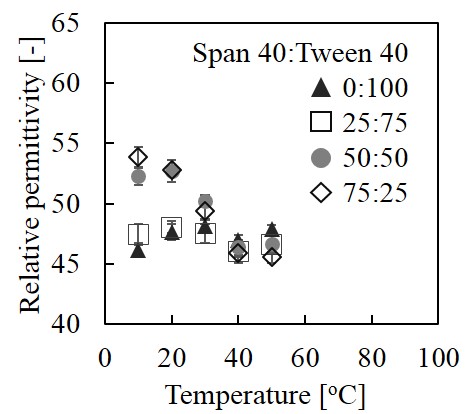
Bicelle is a disk-shaped self-assembly with bilayer membranes like vesicle, and its size is small as well as micelle. In addition, bicelle with a large disc diameter aligns to the magnetic field. Because of these unique properties, bicelle has been attracting tremendous attention as NMR measurement medium. In the formation and application of bicelle, the ordered structure of bicelle bilayer membranes is particularly important. In this study, bicelles were prepared by DMPC and DHPC, then the ordered properties of the bicelle bilayer membranes were characterized by combining the fluorescent probe method and induced circular dichroism spectroscopy (ICD). ICD is a phenomenon that CD activity occurs when achiral molecule DPH is ordered highly within a chirality lipid membrane. The ICD intensities at 360 nm decreased with increasing temperature, suggesting that the motion of the DMPC molecule was limited at low temperature, and the orderly orientation of DPH in the bilayer membrane was lost. The ICD intensity of bicelle was stronger than that of conventional vesicle. Furthermore, the aggregated bicelles, such as stacked bicelle, can be designed by modifying the membrane surface properties of bilayer region.
References: P. Walde et al., Langmuir, 13, 1668 (1997). S. Taguchi et al., Colloids and Interfaces, 2 (4), 73 (15 pages) (2018).
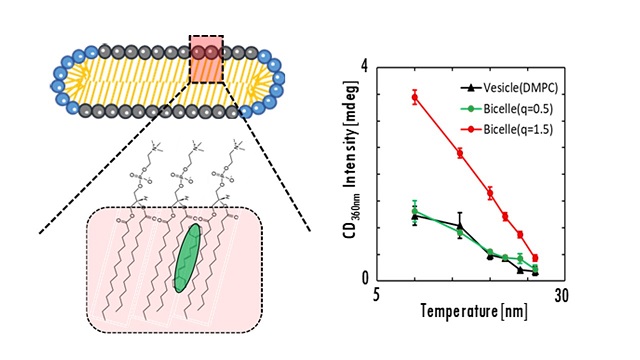
The "gas-liquid two-phase mixed flow" mechanism that fine bubble generation uses rapidly swirling water which shear gas and making small bubbles in water. Based on this mechanism, sending liquid such as oil into the swirling water instead of gas and it able to be emulsified. At present, evaluation methods for emulsions can be considered as particle size distribution and dispersion stability. However, in systems where the separation behavior is not good, it is a problem to catch only some dispersed oil particles and use them as a whole evaluation. In order to express numerical evaluation including the oil particles which can not be dispersed, we use chemical oxygen demand (COD) as numerical evaluation. The figure shows the temporal change of the amount of volatilizing oil calculated from the COD of emulsions sample (1)-(3). The dispersed phase used was of three types: sample (1) only one oil, sample (2) an anionic and a nonionic emulsifier were mixed and added to the oil, sample (3) an anionic and an another kind of the nonionic emulsifier were mixed and added to the oil. It was confirmed that COD decreased and sample (1) has a large amount of volatilized oil because there were many oil particles that can not be dispersed. The performance of the emulsion could be expressed numerically, including the oil particles which could not be dispersed. We also directly analyzed volatile components and compared them with COD results.
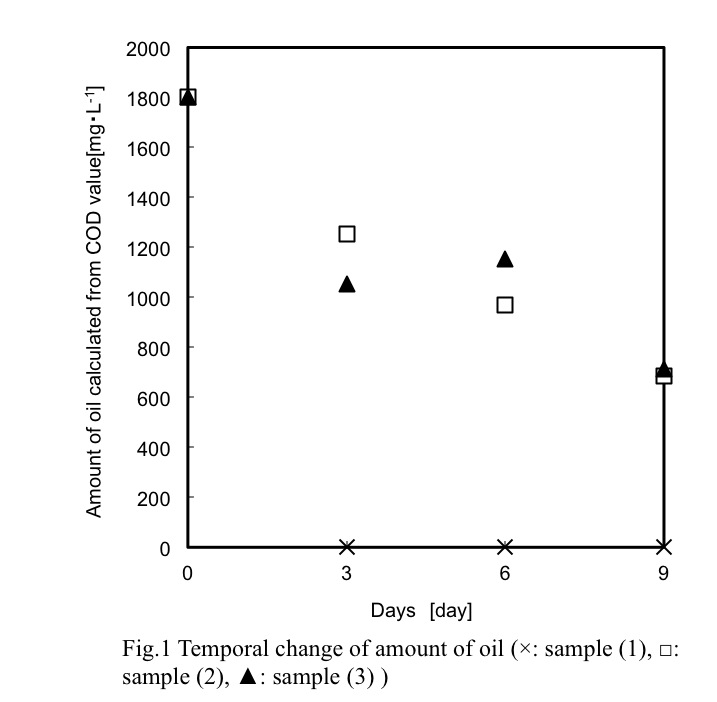
In this study, a plant-derived alkyl polyglucoside (APG) surfactant with alkyl chain of C8- C10 was formulated with the essential oil of Melaleuca alternifolia (tea tree) in the presence of propylene glycol as co-surfactant. This nonionic surfactant with a tradename as Triton CG 110 is reported to possess a CMC at 1748 ppm at 25oC. Typically, tea tree oil (TTO), commonly used in variety of cosmetic and health care products, was extracted from tea tree leaves by Triton CG110-assisted hydrodistillation. The extraction yield was 6.68% under the conditions with (1) 645.4 ppm Triton CG110, (2) at a liquid/solid ratio of 24.5, and (3) for 128 mins as the extraction time. The pseudo-ternary phase diagrams were investigated at the different weight ratios of surfactant mixtures (Smix = CG/PPG) as 1:1, 3:1, 6:1 with hydrodistilled TTO and commercial TTO by water titration method at room temperature. One-phase region consisting of micelles and microemulsion (μ_phi) was painted in gray in Figure 1. The greater the amount of Triton CG110, the wider phase compositions of microemulsion formed. For example, the largest microemulsion region was occurred at a surfactant mixture of 6:1. No liquid crystalline phase was observed at all ratios of Smix under the cross-polarized microscope. Particularly, the effect of storage temperature on selected microemulsion made of 1% TTO with various concentrations of Triton CG100/PPG (3:1 w/w) were recorded. Shelf stability was examined on microemulsions right after preparation and in one month with dynamic light scattering. These results also showed that microemulsion made of 1%TTO, 9% Triton CG100/PPG (3:1 w/w) was insensitive with time and temperature during long time. Antimicrobial activity and antioxidant activity were evaluated with microemulsion made of 1% TTO.
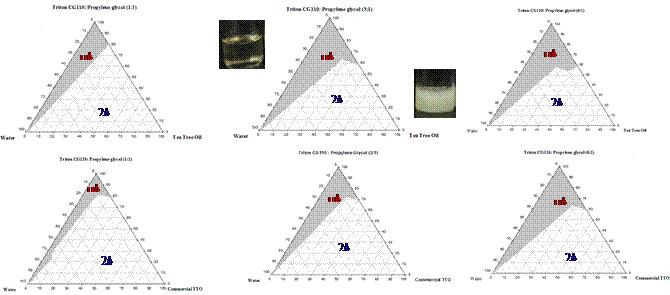
Recently, Pluronic surfactants (PEO–PPO–PEO triblock copolymers, where PEO: poly(ethylene oxide)x and PPO: poly(propylene oxide)y) were found to show CO2-responsive aggregation behavior in water. In earlier paper, mesoporous silica prepared in a hexagonal liquid crystal/water system was swollen by CO2 and the mesopore size was tuned by pressure of CO2 atmosphere. It suggests various potential applications of CO2-responsive surfactant. To clarify mechanism of CO2-responsive behavior of Pluronic surfactant assemblies in water, this study examined effects of temperature, pressure, PEO and PPO lengths on growth of Pluronic surfactant micelles in water under high-pressure CO2 atmosphere.
Aqueous micelles of Pluronic surfactants F108 (x = 150, y = 55) and F127 (x = 100, y = 65) showed no significant change in hydrodynamic diameter of micelles even at high CO2 pressures of 100–300 bar. In contrast with those Pluronic surfactants, F68 (x = 80, y = 30) and F88 (x = 100, y = 20) displayed clear micellar growth with increasing CO2 pressure. Figure 1 shows relationship between the diameter of aqueous micelles and density of CO2 atmosphere at 75 °C and the surfactant concentration 1 wt% for F68, a nonionic EMULGEN 4085 having the C14H29-tail and the PEO (x = 85) close to that of F68, and a nonionic BrijS100 (x = 100) having the C18H37-tail and the PEO chain (x = ~100) similar to that of F88. The tendency that the higher the CO2 pressure (or CO2 density) the larger the micellar diameter was considerably small for nonionic surfactants without a hydrophobic PPO chain, compared with Pluronic surfactants having corresponding PEO units. Especially the Pluronic surfactants with PEO lengths x = 80–85 were found to exhibit significant micellar growth with increasing CO2 density.
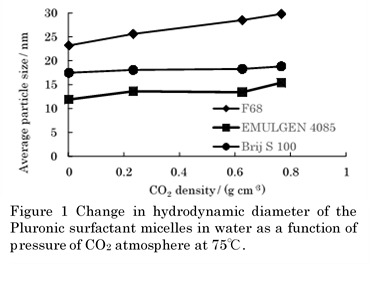
Real-time monitoring of small molecules, such as reactants, dissolved gas molecules or metabolic products, during biological conversion is of paramount importance for understanding the metabolic pathway, optimizing conversion efficiency and enhancing the reproducibility of bioprocesses. Generally, detection of such small molecules during biological conversion are largely dependent on chromatography-based techniques, such as high performance liquid chromatography and gas chromatography. However, these techniques are time-consuming, requiring more than 10 minutes for the separation of sample in the column. Moreover, off-line sampling process is inevitable for the analysis which has a risk of causing contamination. For these reasons, development of a novel method that is suitable for real-time monitoring of biological conversion is required. Here, we propose the plasmonic detection of small molecules in biological conversion by using plasmonic nanostructures produced using capillarity-mediated inverse transfer. Nanoparticles assembled at air/water interface are transferred onto solid substrates through the reconstruction of the assembly interface along the direction of gravity by a capillary tube, enabling the transfer of nanoparticles on solid substrate via direct contact. Small molecules are preconcentrated on plasmonic nanostructure through electrostatic attraction and chemisorption. Preconcentration of small molecules increases the number of molecules affected by strong near-field enhancement at the proximity of the metallic surfaces; thereby, allowing the detection of trace amount of small molecules in the solution.
A living matter moves as an efficient energy conversion system under a non-equilibrium state. The study of this motion may be associated with creation of innovative energy conversion system. Fundamental study with a model system involving similar characteristics to living matter is one of the powerful approaches for understanding and application of such types of motion. In this study, we have studied the motion of aluminum float driven by the spontaneous flow at oil/water interface: The oil and water phases contain di(2-ethylhexyl) phosphate (DEHPA) and Fe2+, respectively, whereby spontaneous instability develops at the interface. Spontaneous flow is generated by a local compression of the adsorbed DEHPA layer by an interfacial flow, and the generated flow compresses the surrounding DEHPA monolayer to cause the subsequent flow. This suggests that spatiotemporal control of compression points rectifies the flow pattern, resulting in a regulated motion of a float.
As an example, a rectangular aluminum foil is placed in an arc-shaped triangular space as shown in Fig.1(a). The aluminum foil exhibits a reciprocal motion. This motion repeats itself many times. Such a motion was not obtained without the confined space. The motion of the aluminum foil results from the compression of DEHPA layer between the aluminum foil the wall, because the compression induces the next flow. As the other example, a ratchet gear made of aluminum foil is placed at the interface where powder are dispersed in the oil/water interface(Fig.1(b)). The ratchet rotated in one direction, that lasted for more than 10 minutes. This rotation may be considered to be caused by the compression of DEHPA layer around the aluminum foil assisted by the powder acting as a wall. These motion may lead to the creation of an innovative energy conversion system.
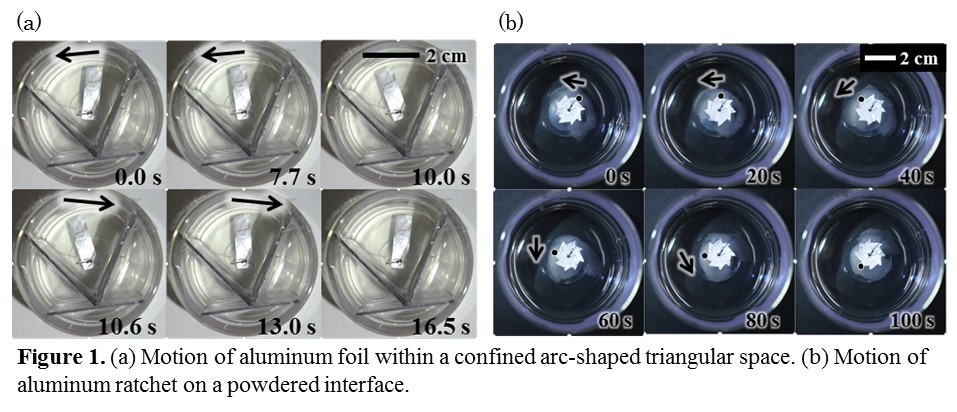
Graphite consists of many carbon sheets. A single layer of the carbon sheets is called graphene. Graphene is a material having good electrical conductivity and high mechanical strength. Industrial applications of graphene are expected in the wide range of fields. However, graphene is usually aggregated in solvents because of strong hydrophobic interaction. This causes the difficulty of the manipulation and the loss of electrical conductivity of graphene.
We previously succeeded in dispersing graphene using poly(3-hexylthiophene-2,5-diyl) (P3HT), which is the conductive organic polymer, in an organic solvent. However, P3HT dispersed graphene only in an organic solvent, which leads to large environmental concerns. Here, we aimed at the preparation of graphene aqueous dispersion using poly(3-(4-sulfophenyl)thiophene-2,5-diyl) (P3ST), which is a water-soluble polythiophene derivative.
P3ST is obtained by deprotecting neopentyl groups of poly(3-(4-neopentylsulfophen-1-yl) thiophen-2,5-diyl) (P3NST). We mixed graphite flakes with P3NST in chloroform and conducted ultrasonication for exfoliation and dispersion of graphene. After the removal of chloroform, the graphene-P3NST complex was heated at 220~230 °C for deprotecting neopentyl groups of P3NST. Then, we added water and redispersed the graphene-P3ST complex in water by ultrasonication. After the redispersion was left for 20 h, the supernatant was collected. The supernatant was diluted 2 times with water and its absorbance at 800 nm was measured to evaluate the dispersion of graphene.
Fig. 1 shows the absorbance at 800 nm of the dilute solution of the supernatant. The x axis shows heating time for deprotecting neopentyl groups of P3NST. The results showed that dispersion of graphene in water was improved by heating the graphene-P3NST complex. The deprotection of neopentyl groups produced sulfo groups in the polythiophene derivative and the sulfo groups would generate electrostatic repulsion between the graphene nanosheets in water to stabilize the dispersion.
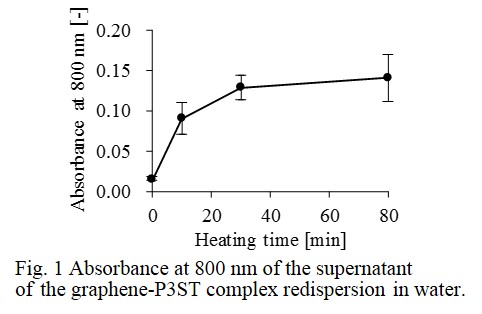
Cu-free click reaction is one of the most famous reactions for conjugating DNA, proteins and cells. Recently, a Cu-free clickable surface is attracting as a platform of immobilizing biosubstances for preparing biosensors. In previous studies, inorganic substrates (e.g., silicone and glass) were used, and they needed surface activation by plasma and chemicals. In this study, we synthesized a Cu-free clickable functional polymer, and a Cu-free clickable surface was prepared on a plastic substrate by polymer coating without pre-treatment.
We synthesized a methyl methacrylate (MMA) and hydroxyethyl methacrylate (HEMA)-based backbone copolymer. Then, dibenzocyclooctyne (DBCO), a Cu-free clickable functional group, was conjugated to the hydroxy group of PMH to get a Cu-free clickable polymer, poly(MMA-r-HEMA-DBCO) (termed PMHD). PMHD was dissolved in ethyl acetate, and a plastic substrate was coated with the polymer solution and dried to prepare a Cu-free clickable surface. AFM and SEM observations revealed that dip-coated surfaces were flat compared with bare substrates.
We also synthesized an azide-conjugated fluorescent substance and estimated the amount of clickable moieties on the polymer-coated surface using Cu-free click reaction between the surface and the fluorophore. The surface density of Cu-free clickable moieties was proved to be 63 pmol/cm2 on PMHD-coated PMMA substrates. This meant that a Cu-free clickable surface was easily prepared on a plastic substrate by polymer coating. To investigate the potential of the functional surface as a platform of a biosensor, azide-conjugated oligo DNA was immobilized on the clickable surface. In consequence, 5.4 pmol/cm2 azide-conjugate oligo DNA was immobilized and hybridized with the complement DNA on the PMHD-coated functional surfaces.
In summary, we synthesized a functional polymer (PMHD), and succeeded in the preparation of a Cu-free clickable surface by simple polymer coating. The investigation of DNA immobilization revealed that the functional surface had high potential as a scaffold of biomatters.
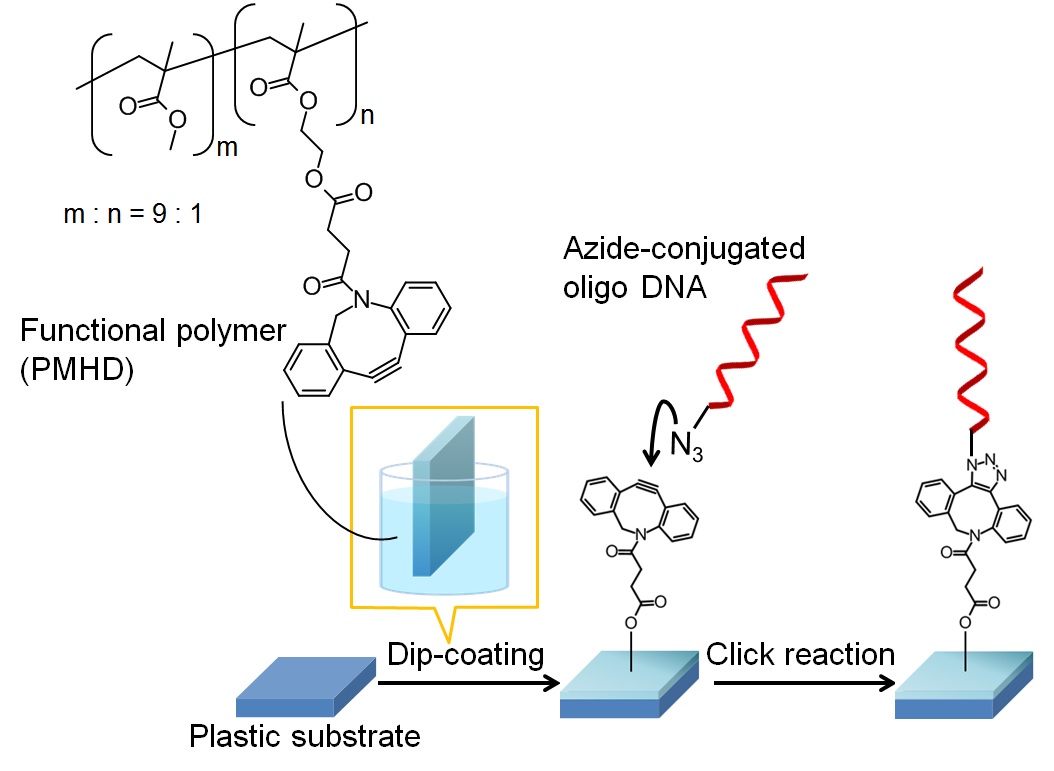
In recent years, separation membranes have attracted a lot of attention: that is widely applied to seawater desalination treatment, separation/recovery of exhaust gas, etc. The materials of the separation membrane are classified into inorganic or organic one, and the latter has generally advantages of low cost, low density and easy handling. In the widespread use, it is indispensable in our lives.
At present, a new preparation process using phase separation in liquid phase has been developed. The outline of this process is 1) selection of a polymer, its solvent and anti-solvent, 2) mixing of them, 3) emergence of phase-separation at specific compositions and 4) drying and formation of porous separation membranes. However, the formation mechanism of the membrane is not clear in the drying process and should be clarified for design of the membrane structure. In this study, poly(vinyl alcohol) (PVA), water and γ-buthyrolactone(GBL) were selected as ingredients for the membranes. Then, the concentration changes of mixed samples have been investigated in the formation of the porous membranes of PVA by the drying process.
As a first approach, preparation of the phase diagram for the three components system was carried out.When the concentration of the liquid sample changed by adding a component slightly, the turbidity was measured. The binodal curve was found by connecting of the turbidity points in PVA-GBL-water systems. The trace of concentration change in drying processes were drawn in the obtained phase diagram. The structures of PVA on the trace line was measured by SEM and DSC measurements were carried out. The relationship of drying rate and PVA structure was elucidated with the structural and thermal data.
Plastics have some practical characteristics; in recent years, the modification of plastic surfaces has received considerable attention for new application. The display of reactive functional groups on plastic surfaces is one approach of the modification of plastic surfaces and it is very important for adhesion and immobilization of biomolecules and polymers. In this study, we displayed amino groups and immobilized gold nanoparticles (AuNPs) on plastic surfaces. Preparation of AuNPs-modified surfaces will realize new applications such as fabrication of conductive plastic surfaces, immobilization of thiol compounds on a surface of a plastic substrate.
We synthesized a methacrylate-based copolymer containing amino groups in the side chains, in which the amino groups were protected with tert-butoxycarbonyl (Boc) groups. The protection groups of amino groups in this copolymer were hydrophobic, leading to the display of the amino groups on the outermost surface of a PMMA substrate after dip-coating. We deprotected the Boc groups and displayed amino groups on the surface of the substrate. Quantitation of the amino groups was carried out using a cleavable fluorescent compound. The amount of amino groups displayed on the surfaces was 10.3 pmol/cm2.
AuNPs, which were 13 nm in diameter, were immobilized on the plastic surfaces by simply immersing PMMA substrates in Au-colloidal solution for 30 minutes. The acrylic substrate displaying amino groups turned red after immersion (Fig. 1), comparing to the bare substrate and the substrate displaying Boc groups. We measured absorbance of these substrates after immersion at 520 nm, which was maximal absorption wavelength of Au-colloidal solution. Absorbance of the substrate displaying amino groups was the highest among the three different kinds of substrates. We conjectured that electrostatic interaction between amino groups and negatively-charged AuNPs led to the immobilization of AuNPs on the surface.
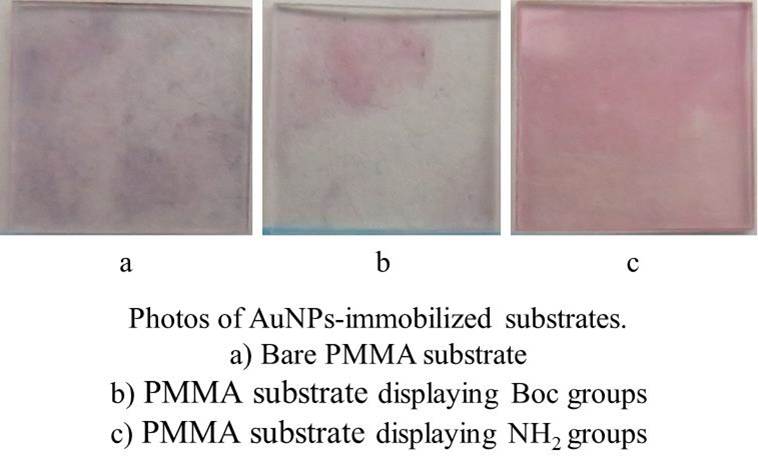
In drying of particle dispersion films, drying defects such as cracking or the like are caused by capillary forces acting between the particles. Previous studies have shown that cracks develop when the dry film thickness exceeds a critical thickness, referred to as critical cracking thickness (CCT)[1]. Polymeric additives can increase CCTs as they (i) adsorb on particle surfaces to induce steric repulsive forces between the neighboring particles, (ii) adsorb at air-liquid interface to reduce the surface tension, and thus the capillary forces, or (iii) show physical crosslinking between particles. However, few quantitative data are currently available to clarify how polymers suppress the propagation of cracks. In this study, we aim at investigating the effects of polymer adsorption on critical cracking thicknesses of drying particle dispersions.
We used Carboxymethyl cellulose (molecular weight: 1850000 g/mol, Dai-ichi Kogyo Seiyaku) as polymer. The sample dispersion containing TiO2 (diameter: 150 nm, concentration:15 wt%) and polymer was dried on a tilted hot stage. The dried film surface was observed by an optical microscope to find a position where cracks developed with a length of 30 μm or longer. The film thickness at that position was measured using a laser focus displacement meter to determine CCTs.
The results showed that CCT was nearly constant at polymer concentrations lower than the critical concentration of c* ~ 0.05 wt%, and agreed with that in polymer-free particle dispersions. At polymer concentrations above the critical value, on the other hand, the CCT monotonically increased with increasing the polymer concentrations. The adsorption measurements indicated that the onset of polymer adsorption on the particle surface emerged at the same polymer concentration, c*, indicating that crack propagation was suppressed by polymer adsorption on the particle surface.
References
[1] K.B.Singh and M.S.Tirumkudulu,Phys.Rev.Lett.98(21)(2007)218302
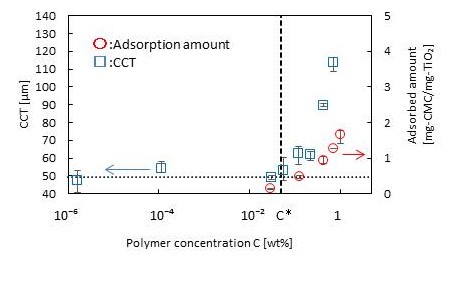
Shape of particles in dense suspension influences on the rheological properties. We focused on wrinkles generated by buckling as the periodic structure on the surface of elastomer particles, and evaluated the suitable method to control the obtained particle size and the shape of wrinkles.
Polydimethylsiloxane (PDMS) was used as the base material for wrinkled particles. The monomer and curing agent were mixed (10:1 (w/w)) to obtain the uncuring PDMS sol, and then the sol was mixed in a 15wt% polyvinylalcohol/H2O solution by the following methods, magnetic stirrer (ST), homodisper (HD), and homogenizer (HG). The PDMS droplets were filtrated with the porous membrane to fractionate the droplet size. In order to cure PDMS, the droplet suspension was heated at 80 °C for 3 hours. Finally, the surface of the PDMS particles were oxidized with a mixed acid solution to form wrinkle structure. The size of PDMS were measured from the image of optical microscope and/or dynamic light scattering.
The order of PDMS droplet size was roughly ST > HD > HG, and the particle size distribution was very broad from several 10 nm to above 100 μm. To separate out the particles with desired size, the HD pre-mixed PDMS suspension (1000 rpm, 5 min) was filtrated by using a shirasu porous glass membrane (pore size: 1 μm). The filtrated PDMS suspension shown a more narrow size distribution (d50 ~2.5 μm (Figure)). However, after surface oxidation of mixed acid, surface wrinkling on the filtrated PDMS particles was not observed by a SEM. Only PDMS particles of 15 μm or more in the diameter obtained from HD pre-mixed suspension were buckled into wrinkling. The wavelength of wrinkle was about 450 nm (d~15 μm), which tends to increase slightly with the particle diameter.
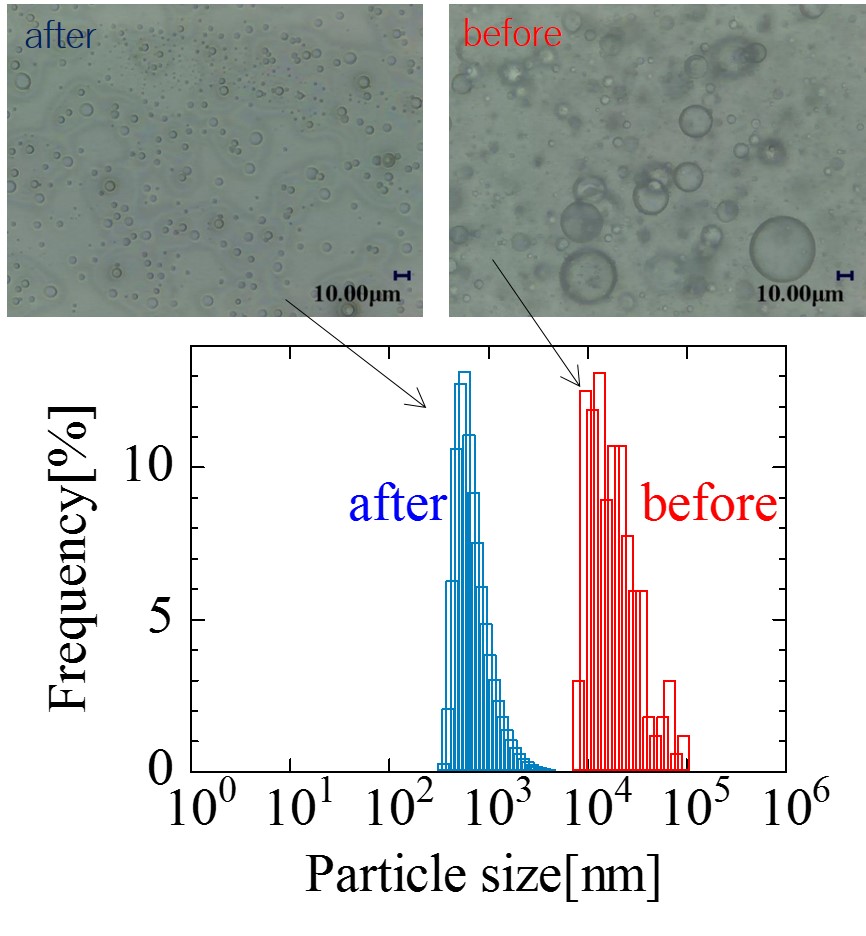
The organic luminescent material easily loses its luminescence once it is exposed to moisture, and the highly reactive cathode with low work function will be easily corroded by moisture and oxygen. To solve this problem, We demonstrate flexible moisture barrier film encapsulation for organic electronics using low temperatures process method. To realize the flexible barrier, the best practice is to make the barrier as multilayer structure. Low temperatures process applied the atomic layer deposition(ALD) method and sputtering method to deposit barrier films. Inorganic layers work as moisture barrier and very thin thickness provide the flexibility and planarization. The moisture permeation characteristics of the optimized Al2O3/SiNX multilayer films were finally measured using MOCON's WVTR measuring instrument and WVTR values lower than the detection limit of the measuring device (less than 5.0 x 10-5 g/m .day) were obtained.
This study is to investigate the optimal time of applying current assisting during employing hot-pressing Bi-Sb-Te films to improve the thermoelectric properties. First, an average 5 um of grinded P-type of Bi-Sb-Te powers was used to formulate a slurry paste to coat on a polyimide substrate for the current assisted hot pressing. It shows that the resistivity decreases with increasing the current density, and then increases with further raising the current density. The main reason is speculated that increasing the electric driving force at low current density can eliminate defects by reducing the obstacles of carrier transmission and formatting Sb-rich phase to form a bridge between grains. However, the excessive current density will generate stronger electric driving force causing a large amount of joule heat to increase the resistivity. Also, the case of “hot pressing and current assisting simultaneously” or the case of "current assisted hot pressing after completion of hot pressing" cannot achieve the best improvement of the thermoelectric properties. Analyzed by surface reaction method, the best thermoelectric efficiency can be obtained at 1000 A/cm2 with 3 min hot pressing followed by 7 min current-assisted hot pressing. Applying hot pressing ahead can increase contact area between particles to make current density distribution more uniform, which can generate less extra joule heat and larger electric driving force, leading to further reducing resistivity to 1.04 mΩ·m and increasing power factor to 2880 μW/K2m. Compared with the case of hot pressing and current assisting simultaneously for 10 min and the case of current-assisted hot pressing for 7 min after hot-pressing for 10 min, the power factor increases 34% and 20%, respectively.
An innovative bio-functional lenses can control multiple surface properties independently for bio-medical applications. The bio-functional lenses was fabricated based on a chemical vapor deposition encapsulation process using functionalized poly-p-xylylenes. Our device exhibits excellent biocompatibility, high transparency, heat resistance and stable in vacuum. The bio-functional lenses applied in many area, such as artificial crystal or cell incubator. Here we reported a method for the fabrication of bio-functional lenses which constructed via vapor deposition of poly-p-xylylenes on template and shape is controlled by oil. Because the lenses constructed by liquid, it is softer than solid that apply in artificial crystal. On the other hand, the lenses have some characteristic such as stable in vacuum, biocompatibility, and perfect curvature. Another research, we try to put Human Adipose Stromal Cells(ASC) in the lenses which is encapsulated by oil and observed in Transmission electron microscope (TEM). The advantage of lenses is high transparency that easily observed in TEM and durable in the environment of vacuum. We build an excellent cell incubator so that we can observe life phenomenon in TEM instead of killing cells.

Perovskite solar cells have been intensively studied because they have high efficiency over 20%1 and are fabricated by a low-cost wet process. The ideal cell structure is a simple planar type with a multi-layer of substrate/electrode/electron transport layer/perovskite power generation layer/hole transport layer/electrode. Titanium dioxide (TiO2) is used as a compact blocking layer as well as an electron transport layer. The underlying TiO2 layer would also play a role in determining the structure of a perovskite layer. To improve the efficiency of the solar cell, it is important to control the structure and physical properties of the TiO2 layer. The ultrasonic spray method is one of the wet coating processes. It enables to control film structure by nuclear growth on the substrate and to deposit large-area and continuous film, having advantages of applicability of the Roll to Roll process upon scale-up to mass-production. The aim of this study is to analyze the relationship between coating process, film structure and physical properties of TiO2.
Titanium bis acetylacetonate diisopropoxide (Ti(acac)2(OiPr)2) and titanium tetrachloride (TiCl4) were used as soluble precursors in ethanol. The ultrasonic spray method was used to deposit TiO2 films on two different types of SnO2 films. The structure of the TiO2 films was investigated by X-ray diffraction and X-ray absorption spectroscopy. In the case of Ti(acac)2(OiPr)2 solutions, TiO2 films had anatase and rutile structures with (101) orientation, while the films deposited with TiCl4 solutions showed only a rutile structure with (101) orientation. The local epitaxial growth of rutile TiO2 on rutile SnO2 structures would be the origin of the observed rutile (101) orientation. We will discuss the effect of the structure of the TiO2 films on the physical properties of perovskite solar cells.
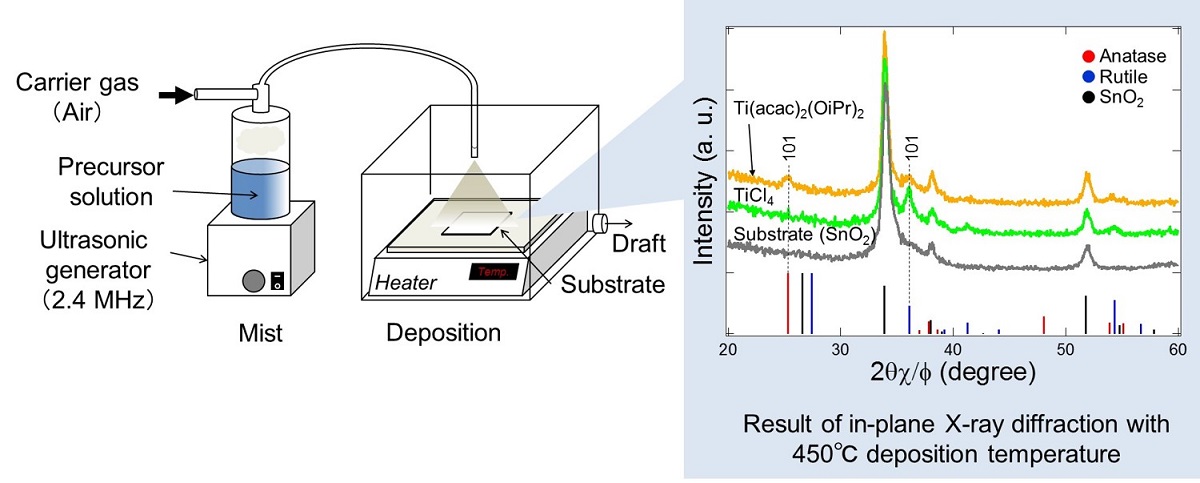
Fluorinated compounds often exhibit a very low surface energy, and these can be used as antifouling and antifogging agents. However, high F-content compounds are generally expensive and bioaccumulative. Our previous research found that non-fluorinated surfactants having trimethylsilyl groups decreased aqueous surface tensions as low as a short or middle fluorocarbon-tail surfactant can (i.e. ~22 mN/m). To develop fluorine-free water-repellent materials comparable to fluorinated one, this study synthesized 3,4-propylenedioxythiophene monomer having 3-trimethylsilylpropyl group (ProDOTSiMe3, Fig. 1) and obtained poly(ProDOTSiMe3) films on gold surfaces by electrodeposition of the monomer.
Electrodeposition was carried out by placing a gold plate (working electrode), a glassy carbon electrode (counter electrode), and SCE in a glass cell containing 10 mL dehydrated acetonitrile solution with 0.1 M tetrabutylammonium perchlorate and 0.01 M ProDOTSiMe3. Water repellency and morphology of the surfaces were also studied. SEM observation clarified that the gold surfaces after electrodeposition were covered with dense poly(ProDOTSiMe3) nanofibers with a large roughness. Water contact angle on the gold surface was 141.6 °± 4.7 °, similar to the values 136.8 °and ≥ 150 °for 3,4-propylenedioxythiophene monomers having two isopropyl-terminated alkyl chains[1]. Interestingly, the poly(ProDOTSiMe3) surfaces exhibited parahydrophobicity due to the wenzel-state.
References
[1] Thierry Darmanin, Claudio Mortier, Julian Eastoe, Masanobu Sagisaka, Frederic Guittard., RSC Adv., 2014,4, 35708–35716
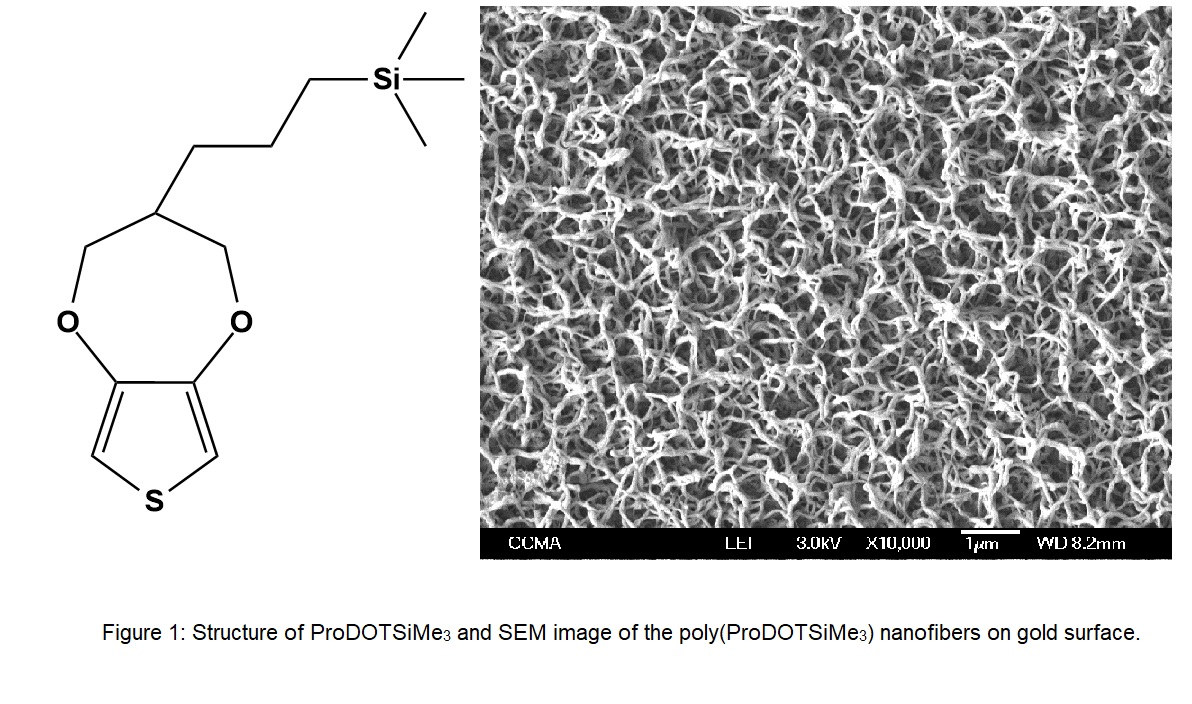
A probe needle for a probe card which is employed in a current energization inspection of an integrated circuit chip in a semiconductor wafer manufacturing process has been made of tungsten, rhenium tungsten, beryllium copper, etc. Particularly, tungsten is a material which is excellent in wear resistance and the excellent toughness is popularly used. However, the contact resistance is raised and the liability of probe card deteriorates on the inspection because tungsten is easily oxidized due to the frictional heat which is generated by the frictional wear or the generation of heat. In order to solve this problem, it is desirable to use gold or platinum material, which is strong in corrosion resistance, as a probe needle. However, in case of gold, it cannot be used in contact with the pad due to its ductility. In addition, there is no economical efficiency because the process cost is increased.
In this study, we platted on the surface of tungsten needle with 1 ~ 5 um of gold, platinum, and nickel to prevent the oxidation of tungsten needle by frictional heat which can be used sufficiently as a probe from being corroded by heat. The undercoat was conducted with nickel, and then, gold, platinum, or nickel was plated. The change of electric resistance after plating was examined. Because the needle thickness is very thin, the over-plating occurred at the tip of tungsten needle. To reduce over-plating, new zig for needle was invented and plating conditions were optimized.
Figure1. The microscope cross-sectional images of bare tungsten needle, the plated tungsten needles with nickel, gold, platinum.

High-chromium cast iron, which is a wear resistant material, is a ternary white cast iron generally containing 7% or more of Cr. It forms many carbides of high hardness, for example M23C6 and M3C, M7C3 (M = Fe, Cr)(1).Therefore, it is used as a material for rolling rolls used in rolling processing and slurry pumps for slurry liquid transfer. However, the rolling conditions are becoming more severe in terms of energy saving and quality improvement in rolling processing, and the slurry pump has problems of wear and corrosion due to high concentration slurry liquid. In order to cope with the current situation, it is important to change the solidified structure by adjusting the Cr and C content, in order to improve the low toughness, corrosion resistance, and wear resistance. Changes in the composition and cooling rate that affect the solidification structure are factors related to the mechanical properties of cast iron. Direct observation of the solidification process in which carbides and base structures appear is thought to be important because it leads to the elucidation of the growth mechanism and can be expected to control the size, amount and formation position of the crystal. Direct observation of metals under high temperature is carried out to clarify the growth mechanism of the metal structure. For this purpose, it is necessary to use a laser microscope which is not affected by the radiation emitted from the molten metal. In this research, our purpose to establish the observation condition of the growth process of base structure and carbide using laser microscope and to elucidation the formation of structure
(1)Tomoo Sato, Taiji Nishizawa, Joo Ishihara, hardness of carbides in iron and steel, Journal of the Japan Institute of Metals, Vol. 23, No. 7, pp. 404-405, 1958
Battery-assisted hydrogen production system can become one of the effective options to mitigate fossil resource consumption by utilizing variable renewable energy (VRE). In this study, the potential practicability of battery-assisted hydrogen production systems from photovoltaic (PV) power is examined on the basis of technoeconomic aspects and life cycle impacts. As an economically viable option, the conventional targets of levelized cost of hydrogen (LCOH) should be achievable by hydrogen production, e.g., less than 30 JPY/Nm3. Although the current technology readiness cannot always reach such levels, their developments based on technology roadmaps should be taken into account. As well as such technoeconomic aspects, life cycle impacts are also key performance indicators towards sustainable energy supply. For example, the life cycle greenhouse gas emission (LC-GHG) attributable to hydrogen production systems must be reduced in comparison with conventional energy supply. The abiotic resource depletion (ARD) originating in the hydrogen production should also become sustainable by reduction or circulation of irreplaceable resources. In this study, we conducted a case example on the analysis of battery-assisted hydrogen production The capacities of system components, i.e., PV, battery, and electrolyzer were defined as the design variables for minimizing LCOH, LC-GHG, and ARD. Through such quantitative analysis on hydrogen production, the conditions of battery-assisted hydrogen production required as applicable options towards sustainable energy technology options was discussed and specified.
Geopolymerization is an innovative technology that utilizes earthly-materials rich in silica and alumina to produce 3D polymeric structures called geopolymers. Sodium aluminosilicate monolith is a geopolymer used as concrete and can replace zeolite as adsorbent. In this study, compressive strength, density, porosity, and methylene blue adsorptive intensity of sodium aluminosilicate monolith produced from coal fly ash (CFA), ceramic tile waste (CTW), and spent bleaching earth (SBE) were evaluated. Using simple lattice mixture design, CFA-CTW-SBE blend with mass ratio of 55.95% CFA, 38.73% CTW, and 5.31% SBE, and an alkali solution containing 70% 8M NaOH and 30% sodium silicate, resulted to a maximum desirability of 12.4MPa compressive strength, 1310 kg/m3 density, 17.03% porosity, and 1.63% methylene blue adsorption intensity. The properties of the product conforms to the specifications of ASTM C90-14 for lightweight load-bearing concrete.
Gypsum scale in pipes has been a serious problem for a desulfurization scrubber. When there are many blocks of gypsum scale, the desulfurization efficiency decreases, and it is resulted in increase of SOx of the effluent gas. Because gypsum scale is solid and hard to collapse, it takes much time to remove the scale in a regular inspection. It is important to study why the scale is solid and hard to collapse. Therefore, a method to inhibit the formation of the scale was examined in this study. As a result of analysis, the composition of the scale was almost gypsum dehydrate(CaSO4·2H2O), 1-5 wt% calcium fluoride(CaF2), ND-1.5wt% calcium carbonate(CaCO3), and ND-0.2wt% calcium sulfite hemihydrate(CaSO3·1/2H2O). In other words, there was several percent of fluorine, and there was little calcium sulfite. Basic experiments to measure crushing strengths and rates of collapse in water were carried out. In these basic experiments, it was considered that fluorine ions and aqueous solution of calcium carbonate made the scale solid and hard to collapse (Fig 1). On the other hand, the formation of the gypsum scale and a behavior of seed crystals as a scale inhibitor were studied. As a result, when temperature was higher, the scale grew faster. However, the effect as the scale inhibitor of the seed crystals was limited (Fig 2).
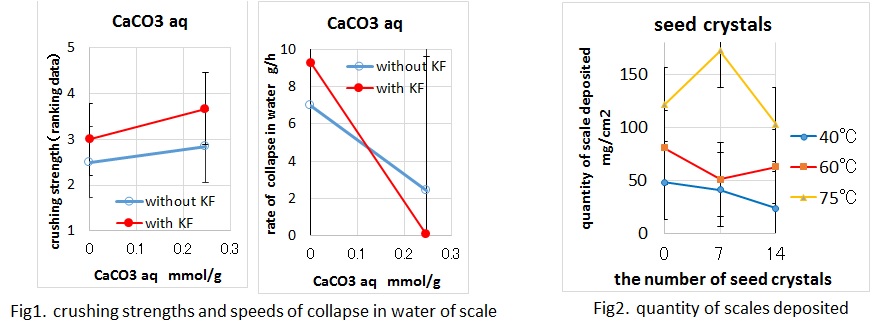
Electric vehicles (EVs) has been pervasive in society to mitigate climate change in the world. A lithium-ion battery is mainly employed as an automotive battery because of a high voltage and a compact package. In view of the safety, it must be pay attention to fires and explosions of the lithium-ion battery due to vehicle fires. Therefore, investigation of combustion characteristics of materials for the battery case is important.
As materials for lithium-ion battery case, four kinds of sample plates making from flame-retardant plastics were prepared. First, standard combustion tests, UL 94 V tests, were performed. It found that the No. 15 sample was the best characteristic. Second, TG-DTA tests were performed to be clear the control factor of the combustion characteristics, and the amount of H2, CH4, CO2, and CO generation were determined. H2 generation of the No. 15 sample was the lowest. Finally, the ignition time and temperature for each sample was estimated from chemical compositions by elemental reaction simulation. In conclusion, the elemental reaction simulation using TG-DTA test results is available for evaluations of combustion characteristics.
Fiber reinforced plastic called FRP is used in various application such as fishing boats and wind generator blade etc. because of its light weight, high strength and resistance. However, it is generally difficult to recycle the waste FRP because of its high strength and resistance. As a new recycling method of the waste FRP, we proposed to make a porous water-permeable material by mixing binder with the waste FRP crushed and curing it. This material is expected the water permeable character, when it is used for paving roads, the drainage of rainwater will be effective in promoting tree growth and preventing urban floods. It is necessary to study the relationship between preparation conditions and performance focusing on the internal structure of the material. There were three processes to prepare the material. First, sieved waste FRP crushed to obtain aggregate with uniform particle size. Second, the aggregate and binder were mixed. Finally, the mixture was filled in a molding can and cured by heating and compressing. The material performances were evaluated permeable and compressive strength. They were determined by changing aggregate size, mass fraction of binder, and molding pressure. Permeability was measured by water permeability test using water head difference. Compressive strength was measured from stress-strain relationship obtained compressive test. Also, I measured an index of inner structure including porosity, tortuosity, specific surface area, and pore size for associating the relationship between preparation and performance theoretically. Porosity was measured by underwater weighing method. Others were measured by analysis of 3D image taken by X-ray computed tomography. It was found that the permeability was decreased with decreasing of the aggregate size, increasing of the mass fraction of binder and molding pressure. It is also found that there is a strong correlation between the permeability and porosity.
Electrodialysis is a membrane separation process driven by the electric potential along ion-exchange membranes, namely anion exchange membranes (AEM) and cation exchange membranes (CEM). The bipolar membrane is a membrane where two kinds of ion exchange membranes (AEM and CEM) are laminated, and water in the membrane gap can be dissociated when an electric potential higher than the one for water molecule dissociation (= 1.23 V) is applied between the two membranes. The water dissociation process releases pairs of proton (H+) and hydroxyl ion (OH-) from the bipolar membrane. This dissociation process can be utilized a variety of applications in the electrodialysis.
In this talk, I am going to introduce some of our recent developments on the applications of the bipolar membrane electrodialysis (BPED) process, especially on the environmental field. The first application is on the carbon capture and sequestration (CCS). CCS has been recognized as a large-measure for reducing the CO2 emission from fossil fuel combustion processes. The biggest challenge of the CCS is the high cost and power consumption for the CO2 capturing process from the flue gas, especially recovery of pure CO2 gas after captured. We have developed a new type of CO2 gas recovery process using BPED. We also have developed a new type of a mineral carbonation process for CCS by using BPED for the recovery of acid/alkali pairs. The second application is the selective recovery of metals or anions from waste stream. A selective recovery process of rare metals from the metal-mixture solutions by using BPED coupled with selective chelating agents. A recovery process of high concentration boric acid solutions from dilute waste water has been also developed based on a multi-stage BPED method. Thus, BPED is a versatile method for environmental applications, with minimal power consumption, chemical wastes, and environmental impacts.
Water purification membranes are expected to a solution for water shortage. However, the significant improvement of conventional polymeric membranes is difficult. While, biological membranes show higher performance than that of polymeric membranes. Biological membranes are consisted of lipid bilayers not to permeate almost all solutes and channel proteins to transport only specific molecules. Therefore, biomimetic membranes have attracted attentions as water purification membranes. Aquaporin Z has been researched for channels of them, however, that structure is so complex that the expression of the water permeability is difficult. In this study, we used Amphotericin B (AmB) as a channel of water purification membranes. We tried to form supported lipid bilayers (SLBs) incorporating AmB. Firstly, AmB:Erg ratio was evaluated to form water permeable channels. AmB:Erg=1:2 was best to form channels because AmB easily binds with Erg under Erg-rich condition. Next, SLBs were formed by three different methods immersing substrate in liposome suspension, (i) in dish (call this method as "Dish"), (ii) fix substrate in permeability test cell ("Test Cell"), and (iii) fix substrate between the silicon rubbers, ("Silicon Rubber"). We quantified the amounts of phospholipids on the surface and calculated the layer numbers of each SLB. Fig. 1 shows the water permeability and salt rejection, and the SLB number is 4.6, 2.3 and 3.1, respectavely. Comparing "Test Cell" to "Dish", due to supress the adsorption of excess lipid on the back side of the support, the water permeability and salt rejection increased and the SLB number decreased. In addition, comparing "Silicon Rubber" to "Test Cell", due to reduce of SLB defects near the boundary between support and O-ring of test cell, the water permeability decreased and salt rejection further increased. Conclusively, we succeeded to form defectless SLB by "Silicon Rubber" and achived high water permeability salt rejection and low SLB number.
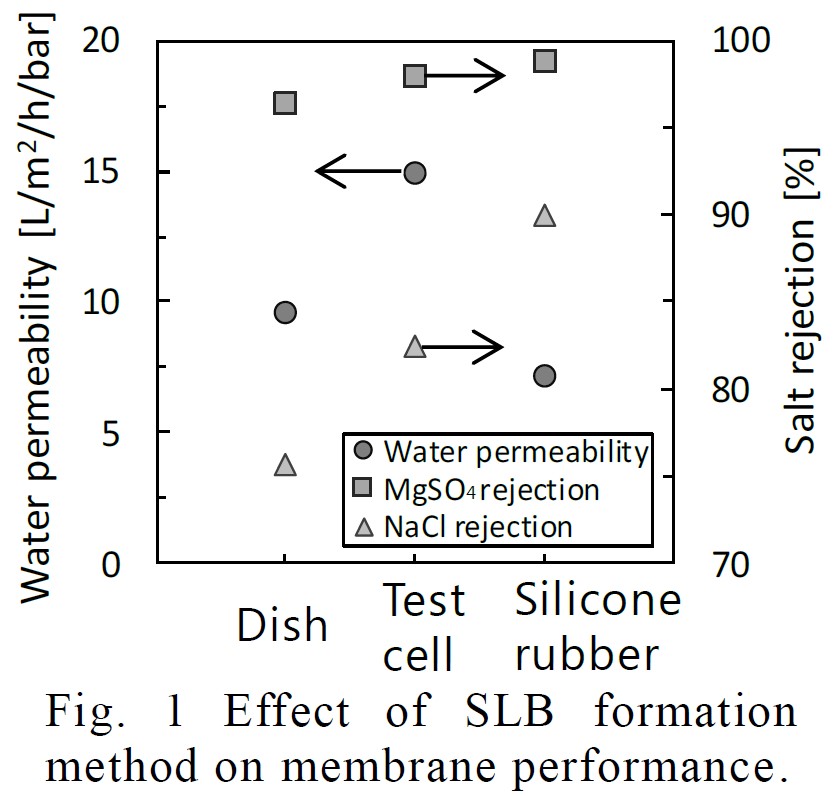
The chlor-alkali process for chlorine evolution reaction (ChER) uses an RuO2-based anode, commonly referred to as Dimensional stable anode (DSA®). Although DSA is regarded as one of the most important inventions in the 21st electrochemistry field, it is recognized as a disadvantage in that the activity of ChER becomes lowered when oxygen is generated, and also Ru is a precious metal. The development of alloy catalysts modified with Ir, Pb, Pt, Ta, Sn, Ti, V, and W has thus been pursued to improve durability and economic feasibility. In this study, the thermodynamic stabilities of MxRu1-xO2 alloys (M = V, W, Ti, Ir) were evaluated by using density function theory (DFT) calculations coupled with the cluster expansion (CE) technique, which can predict the thermodynamic properties of the alloys as the function of element compositions. Once the ground states of alloy structures were determined at different element compositions, the ChER efficiency of the alloys was evaluated by comparing the activation energies of Cl2 desorption on the alloy systems.
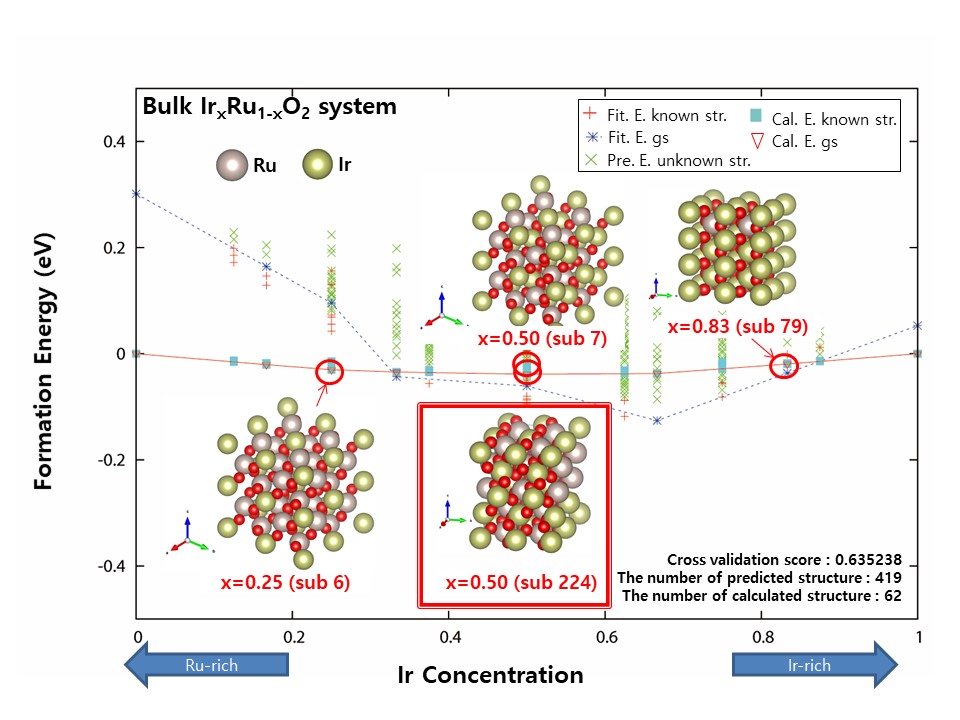
CO2 reduction reaction (CRR) offers a promising solution to offset the greenhouse gas emission issues which break the carbon balance in nature. In this work, we introduce a microbial fuel cell (MFC)-driven electrocatalytic CO2 reduction system which harnesses the metabolic activities of microorganism to generate electricity from substrate oxidation. However, the intermittence and periodicity of MFC presents a substantial impediment of maintaining high electrocatalytic efficiency and stability for practical applications. Hence, we developed a redox-medium-assisted system that stores the reduction energy in MFC using a Fe(CN)63+/Fe(CN)64+ redox pair, which can be controllably transfer into CRR to lower power input, then proceeds CO2 reducing into carbon monoxide (CO) with a Zinc oxide/Zinc catalyst cathode electrode. The Fe(CN)63+/Fe(CN)64+ redox pair has the advantages of non-toxicity and good reversibility which is generally used as a cathode electron acceptor for MFC. After being reduced in MFC system, the medium is then transferred to the CRR system to replace the traditional OER reaction in the anode. The experimental results show that the MFC&CRR coupling system can achieve stable energy conversion and reduce the cathode potential from + 1.2 V to + 0.3 V, which greatly improves the energy efficiency. The maximum energy efficiency can reach up to 194%. We also demonstrate a circulating flow system on the basis of intermittent operation inspired by the concept of fluid battery, which increases the capacity of the device and prolongs the reaction time of the device. MFC-driven electrochemical CO2 reduction can more efficiently produce value-added chemicals and offers a potential route to reform carbon in the global environment.
Introduction: Since the Paris Agreement entered into force in 2016, the reduction of greenhouse gas emissions is the task for all countries. In order to achieve the middle- and long-term goal, innovative technology developments and the installation of new system are strongly required. Electrochemical CO2 reduction is a candidate technology and Cu metal electrode is well-known to reduce CO2 to hydrocarbons and alcohols electrochemically. Although long-term stability is essential for practical use, few studies investigated it and the time dependence on reduction product. In this report, we present the time-course of product selectivity and the surface morphology of Cu electrode. The ratio of reduction product was related to the morphological changes.
Methods: Electrochemical CO2 reduction was carried out in 0.1M KHCO3 with two-compartment cell with electrolyte-flow devices (Figure, left) at room temperature. Polycrystalline Cu and Pt mesh were used as cathode and anode, respectively. Electrolysis with constant current was performed at 5 mA cm-2. The gas outlet was connected to gas chromatograph quantified hydrocarbons, H2, and CO. The liquid-phase products were evaluated by gas chromatograph and ion chromatograph.
Results: The generation of C2H4 decreased to 1% and CH4 increased to 60% and became predominant in 50 hours, and the selectivity was almost stabilized from 100 hours, though the main products of CO2 reduction had been CH4 and C2H4 and current efficiencies for them were about 30% each at the beginning of the reaction (Figure, right). That suggests that the morphological change of Cu electrode affects the product selectivity.

Geopolymers are inorganic polymers composed by alumino-silicate frameworks containing alkali metal ions. Geopolymers can be used as a building material substituting for concrete because of their low cost, low-curing temperatures, and no CO2 emission for production. Geopolymers have porous structures, and their porosity can be controlled by the preparation conditions including the compositions of raw materials, curing temperatures. In this study, we report the fabrication of self-supporting geopolymer membranes having various porous structures, and the gas permeation characteristics of membranes were examined.
Metakaolin, silica gel, potassium hydroxide, and water were used as the raw materials for the geopolymer membranes. An aqueous solution of potassium hydroxide was mixed with silica gel and metakaolin powder, and stirred for 30 seconds at 100rpm; the slurry mixture was used as a geopolymer paste. The solid-liquid ratio in the paste was set 0.5, and the composition of the raw materials was changed. The geopolymer paste so prepared was cast into a silicone rubber mold, of which the inner diameter was 46 mm, and the thickness was 3mm. Then the rubber mold filled the geopolymer paste was sandwiched by glass plates, and cured under a constant temperature (25 to 100 °C) for a given period (1 to 3 days). The paste was solidified by the curing to form a disk membrane with the 46-mm diameter and 3-mm thickness. The geopolymer membrane was taken out from the mold, and dried for given conditions. The gas permeability of pure gases such as hydrogen, nitrogen, and carbon dioxide was measured under the pressure difference at 0.10MPa and the room temperature.
We have successfully fabricated geopolymer membranes without visible cracks only when the molar ratio of SiO2:Al2O3:K2O in casting solution was 65:22.5:12.5. The observed gas permeability was in proportion to the inverse of the square root of the molecular mass of the gas, indicating Knudsen diffusion mechanism.
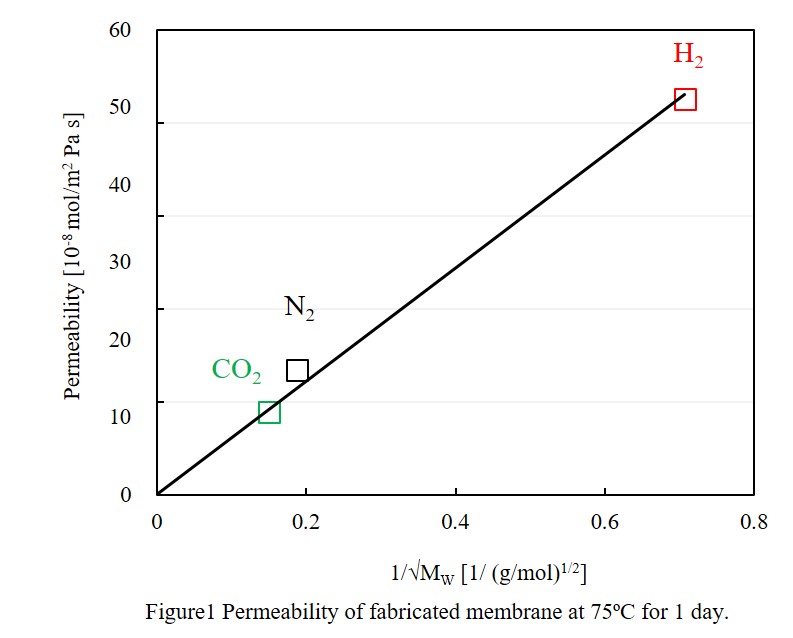
We investigated the ozonolysis of various VOCs in the presence of nitrogen monoxide (NO) and/or hydroxyl radicals (OH) radicals. A VOC gas was introduced into a fluorine resin bag (50 L) diluted with dry air. The initial concentration of the VOC was set 1200 ppm. Then, ozone and nitrogen monoxide (NO) and/or tetramethylethylene (TME) were added to bag to initiate the ozonolysis reactions. The initial concentration of NO was set 300 ppm. The initial concentration of TME was set 30-60 ppm, which will generate hydroxyl radicals (OH). The bag was shaded with an aluminum bag to avoid the photo-induced reactions.
Under the presence of ozone without NO nor TME, α-pinene, styrene, m-xylene were decomposed, while no decomposition was observed for ethyl acetate and toluene. The decomposition rate α-pinene was largest among the VOCs tested followed by styrene. For α-pinene, the addition of TME decreased the ozonolysis rate, but the addition of TMA and NO increased the ozonolysis rate. For styrene, the addition of TME reduced the ozonolysis rate, and the addition of NO in addition to TME further reduced the ozonolysis rate. For styrene, the addition of TME slightly reduced the ozonolysis rate, but the addition of TMA and NO significantly reduced the ozonolysis of styrene. In the presence of TME (OH radicals), both toluene and ethyl acetate was decomposed. However, the presence of NO in addition to ozone and TME reduced the decomposition rates of these VOCs.
The ozonolysis rates of these VOCs were plotted against the maximum incremental reactivity (MIR), an ozone forming potentials in Fig. 1; no correlations were observed between these values. The present results suggest that MIR is not necessary an appropriate indicator for ozone formation.
The study aimed to investigate the effect of the initial dye concentration, pH, and treatment time on the degradation of Acid red 88 in a batch reactor setup. Raschig rings were dipped and dried in a photocatalyst solution of TiO2 and ethanol for 10 minutes each. It was then calcined at 400 °C for 6 hours with a ramp rate of 3 °C/min. A Box-Behnken design was followed in preparing solutions of 150 mL Acid red 88 dye at 10, 35, and 60 ppm, with a pH of 4,7, and 10. The reactor setup was then filled with 100 mL dye solution. The setup was then run for 30, 60, and 90 minutes according to the experimental design. Samples were collected before and after each run, and its concentrations were analyzed via UV/vis spectroscopy. The immobilized catalyst was also examined under SEM to determine the effectiveness of the immobilization technique. After each run, the Raschig rings are cleaned by running the reactor setup with distilled water. The results indicate that for the most efficient degradation of acid red 88, low initial concentration, low pH must, and high run time must be implemented and that the cleaning procedure was effective in regenerating the catalyst. It can be concluded from the data that the immobilization technique employed in this study is proven to be effective. It is recommended that future studies investigate cationic dyes, optimization of immobilization process, and effect of air sparging on reactor conversion.
Water utilities, commercial and industrial establishments are required to upgrade or install new treatment systems to comply with the revised effluent standards issued by the Department of Environment and Natural Resources – Environment Management Bureau (DENR – EMB) which now includes removal and monitoring of nutrients (nitrogen and phosphorus components). One solution is to utilize a biological nutrient removal technology (BNRT) system capable of removing nutrients from sewage. The on-going study aims to investigate the performance of the pilot-scale system in the removal of nutrients from sewage. The anaerobic-anoxic-oxic (A2O) process was designed and operated in an existing sewage treatment plant (STP) at a flow rate of 1 m3/day. System modification was adapted to ensure continuous operation. Dissolved oxygen (DO) and temperature of each compartment were evaluated after 45 days of system modification. The DO of the anaerobic and oxic compartment remained within the required range, while the internal recycling flowrate and/or aeration must be adjusted to achieve a DO concentration of 0.20 – 0.50 mg/L in the anoxic compartment. The research is financially supported by the Philippine Council for Industry, Energy and Emerging Technology Research and Development of the Department of Science and Technology (PCIEERD Project No. 04176).
Acid mine drainage (AMD) is an environmental problem observed in mine sites rich in pyrites and characterized by low pH, and high concentrations of heavy metals and sulfates. Various water treatment methods are being used to neutralize AMD before being discharged to nearby bodies of water. Passive treatment using a neutralizing agent like limestone is a common method for both operational and abandoned mine sites. The study investigates the potential of locally available serpentinite as an alternative media for AMD neutralization, due to its high magnesium content. Raw material characterization was conducted including XRD and surface area. A batch test was designed to determine the effect of water/rock ratio in treating a synthetic AMD solution. The solution was set at a pH of 2.14 ± 0.06, 1860 ppm Fe, 200 ppm Al, 289 ppm Ni, 51 ppm Cu, 64 ppm Mn, and 20 ppm Mg. The initial and final values of the following parameters: pH, redox potential (ORP), total dissolved solids (TDS), and concentration of heavy metals were monitored. The change in the aforementioned parameters indicate that a low water/rock ratio using serpentinite has the highest neutralizing capacity. Since the available serpentinite is clayey in nature, it is recommended that techniques to increase particle size while maintaining porosity be explored. By doing so, an industrial application of the media may be developed.
Recalcitrant pollutants in wastewater need to be removed to maintain clean, safe and secure environment. This is done often through sequentially integrated physiochemical and biological treatment processes[1-17]. The treatment processes are often multistep, require high energy input and large land area. Until recently, with the development of electrode membrane, bio-electrochemical and photo electrochemical process, we demonstrate the successful treatment of industrial wastewater in a simultaneous bio- / physiochemical reactor with only one step treatment. This is realized by using low cost commercial material in a simple reactor with (1) an electrode / photo-electrochemical cathode (2) bio-anode with microbes and graphite /activated carbon (3) a sand layer separator between the anode and the cathode. The removed COD/TOC from (initial >3700mg/L COD) coking wastewater easily reach 70% to over 90%, 95%, 99%, depending on aeration intensity, acclimation of anodic microbes and total hydraulic residence time, with or without light irradiation. Satisfactory effluent meeting discharge standard can be obtained. The simultaneous electricity generation is realized( the cell voltage 0.3V-0.5V). The Qe for COD to electricity is significantly higher with light. The obtained power density normalized to the cathode area is around 11- 26 W/m2 without light and 29-88W/m2 with light. The progresses achieved in the above signify the high potential of such technology in practical application. The investment cost and energy consumption is estimated at 1000$ and 0.3-0.5KWh/ m3[17].
Chemical oxygen demand (COD) concentration has increased for these decades in the Seto Inland Sea in Japan, though a total pollutant load control system has been employed since 1979 according to the Law Concerning Special Measures for Conservation of the Environment of the Sea. On the other hand, dissolved oxygen (DO) concentration at the bottom layer of Seto inland sea has increased too. As the possible cause for the increase of COD, we focussed on the loading of organic carbon from sediment, because a previous research on the sediment brought to the land by the tsunami in Japan showed the increase of organic carbon content due to the exposure to the atmosphere. This research aimed at investigating whether organic carbon loading occurs via increase of organic carbon content in sediment due to a change of DO at bottom layer. Sediment and overlying water layers were established in the columns and maintained under an anaerobic condition for a week, and then the columns were aerated. In the control experiment, aeration was not carried out. The result of sediment sample analyses confirmed the increase of organic carbon content while changing the sediment surface in the columns from anaerobic to aerobic conditions. In addition, the dissolved organic carbon (DOC) concentration increased too along with this change, though no increase of organic carbon content was observed in the control experiment. An analysis of the microorganisms showed the predominance of sulfur oxidizing bacteria in the sediment samples that demonstrated the increase of organic carbon content. These results collectively showed that the change of sediment environment due to the increase of DO caused the increase of organic matters in the sediment via stimulating the certain autotrophic bacteria such as sulfur oxidizing bacteria, which might contribute to the increase of DOC concentration in the overlying water.
This work studies the kinetics of phenol oxidation, adding new reactions to the current literature and elucidating their intermediates. The mechanism depends on the dosage of oxidant. When utilizing ratios R=1.0 mol H2O2/mol C6H6O, phenol degrades to species with dihydroxylated rings, uncoloured and more toxic than phenol itself. Using R=2.0, ortho and para-substituted intermediates decompose to their corresponding substituted benzoquinones. As a remark, the o-benzoquinone is very unstable and the m-benzoquinone does not exist in nature, due to its low stability. Besides, they cause strong dark coloration to wastewaters, because of chromophore groups. Furthermore, para-substituted benzoquinones can generate complexes of charge transfer (quinhydrone) with hydroquinone. Moreover, ortho-substituted benzoquinones can react with the ferric ions originated from the added catalyst, creating iron compounds.
Applying R=3.0, there is an increase of the reactions involved in the degradation mechanism, occurring parallel reactions of various oxidation levels. Moreover, trihydroxylated rings appear, ortho and para-substituted, like hydroxihydroquinone and pyrogallol. Finally, the oxidation of hydroxylated benzoquinones leads to muconic acid. Performing with R=4.0, the trihydroxylated benzene rings are also decomposed to muconic acid that are not harmful for dumping. Due to the double bond of oxygen in the ring, formation of ferric complexes can happen when reacting ferric ions with carboxylic acids as muconic or oxalic. At higher ratios, decomposition of the toxic and recalcitrant species leads to biodegradable acids. So, with R=6.0 para-substituted quinones evolve to 2,5-dioxo-hexenoic acid. The oxidation of this acid and muconic creates carboxylic acids in the system, such as 1,4-dioxo-2-butane utilising R=6.0; 4-oxo-2-butanoic acid employing R=7.0 and maleic acid operating at R=8.0. When enlarging the stoichiometric ratio to R=14.0, the benzene rings open, generating linear acids, which undergo a shortening of the chain and emit carbon dioxide.
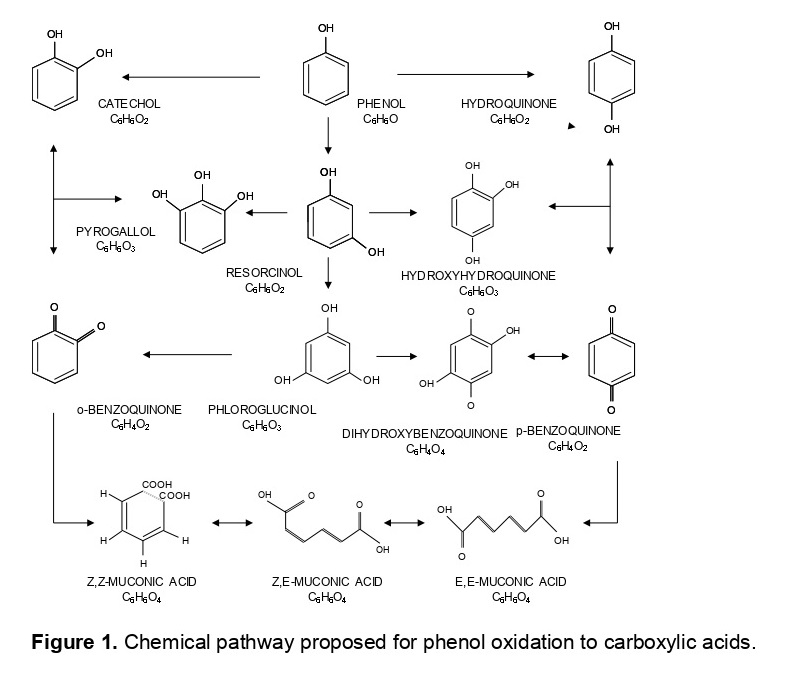
The objective of this study is to optimise the wastewater treatment plant of poultry industry. The optimisation of simulation model was done using the SuperPRO designer as simulator. The performance of the wastewater treatment plant for the poultry industry has improved significantly at the minimum cost. The COD value reduced from 133 mg/L to 0.06 mg/L at the discharge stream 1 and 81.1 mg/L for discharge stream 2. In addition, the BOD5 value reduced from 66.7 mg/L to 0.03 mg/L at the discharge stream 1 and 49.8 mg/L at the discharge stream 2. Further to this, the TTS reduced from 33.3 mg/L to 0.0 mg/L at the discharge stream 1 and 21.8 mg/L at the discharge stream 2. Oil and grease also reduced from 3.3 mg/L to 0.06 mg/L at the discharge stream 1 and 1.9 mg/L at the discharge stream 2. The existing model and system can improve the wastewater treatment plant of poultry industry.
In this study, the ZnO nanoparticles that were doped with Ag and then hybridized on graphite (GP) layer (Ag-ZnO/GP) were prepared by a facile hydrothermal method. The morphologies, structure, and optimal properties of synthesized samples were investigated. It was found that the extent of the enhancement of photocatalytic activity strongly depended on the amounts of graphite and dopant Ag. The optimal weight ratio was observed to be 0.5% GP/ZnO and 1% Ag/ZnO. This fabricated composite was applied as photocatalyst to degrade metronidazole (MNZ) antibiotic in aqueous solution. Experimental results showed that 90% of 30-mg/L MNZ could be removed after 60 min of 100-W UV irradiation over Ag-ZnO/GP composite with a dose of 0.5 g/L. The presence of Ag would cause a reduced recombination rate of electron-hole pairs and therefore an improved photocatalytic activity in the wide range of light wavelengths. After 180 min of solar light irradiation, 71% of 30-mg/L MNZ could be eliminated. In addition, graphitic surface could act as an election sink to successfully inhibit the photocorrosion of ZnO, which revealed the photostability of Ag-ZnO/GP composite after 5 recycles. Moreover, the roles of reactive agents (for example, hole h+, hydroxyl radical ·OH, and superoxide radical ·O2-) during the degradation of MNZ was clarified through the detection of reaction intermediates using an ultra-performance liquid chromatography-quadrupole time-of-flight mass spectrometry (UPLC-QTof/MS, Waters). The present results demonstrated the promising application of as-prepared composites for efficient removal of antibiotics from aqueous solutions.
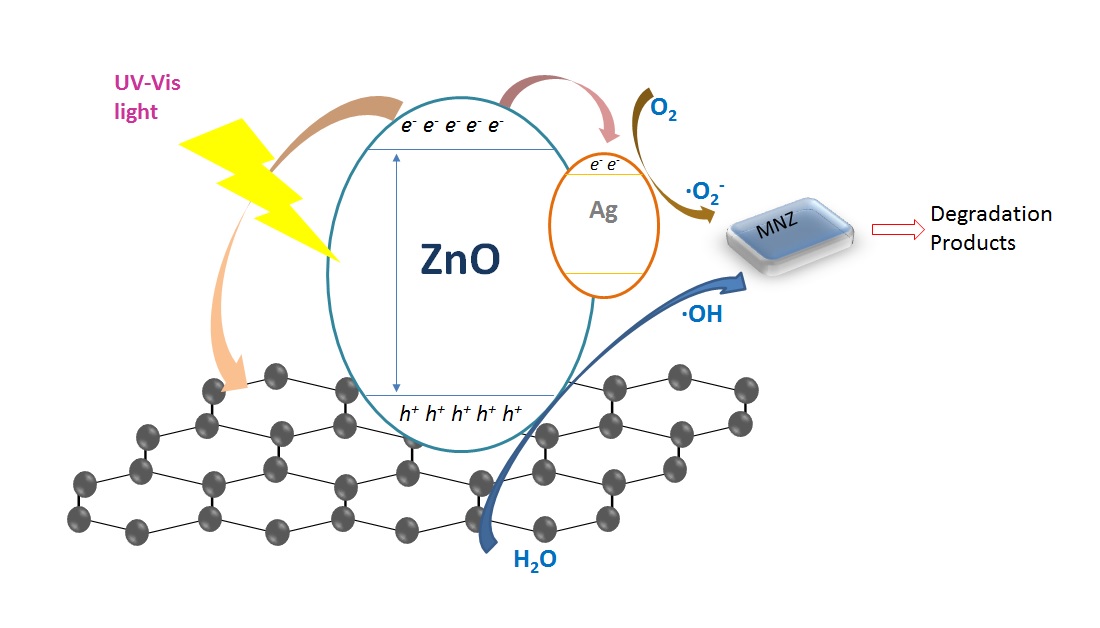
Municipal wastewater reclamation and reuse is one of the most reliable approaches to solve the problem of water scarcity. Compared with wastewater treatment and discharge, water reuse faces more challenges on water safety insurance. The risks caused by pathogens, harmful components of bacteria (such as endotoxin) and microbial regrowth must be controlled in priority during the utilization of reclaimed water.
In order to achieve comprehensive and long-lasting control of biological risks of reclaimed water, the risks of conventional pathogenic (indicator) microorganisms as well as some emerging microbial harmful components, including antibiotic resistant bacteria, endotoxin and so on were investigated.
In order to improve the effectiveness of disinfection, to inhibit the reactivation of microorganisms and to reduce the associated risks during disinfection caused by toxic and harmful disinfection by-products (DBPs), a novel disinfection technology of electroporation was developed.
In order to inhibit microbial regrowth during the distribution and utilization of reclaimed water, the effects of biodegradable organic matters (BOMs) and the microbial community structure on microbial growth were investigated. Furthermore, the BOM removal by advanced treatment was studied, and the transformation mechanism of BOM during advanced treatment was discussed.
Based on the research mentioned above, the systematic control principles of microbial risks during the advanced treatment, disinfection, distribution and utilization process of reclaimed water will be discussed.
Soil pollution is a major environmental problem due to irrational human activities. Electro-bioremediation of contaminated soils is an emerging hybrid technology, which combines the advantages of electrokinetics and bioremediation in the treatment of polluted soils, namely efficient, sustainable and low-cost. However, the extreme pH variations in the soils, caused by the electrokinetical and electrochemical processes using direct current field (DC field), are the main drawback and have a detrimental effect on microorganisms in the electro-bioremediation technology. This study applied alternating current field (AC filed) with 50 Hz frequency in electrokinetics to successfully maintain the pH at neutral range and evaluated the resulting influences in the biodegeration of petroleum hydrocarbons in contaminated soils. The maximum voltage gradient of AC field was 0.5 V/cm between two electrodes in the electrokinetics and the mixed microorganisms obtained from oil sludge were utilized to decompose the contaminants in the bioremediation process. Although the microbial counts decreased slightly under AC field due to the electrical stimulation, the removal efficiency of pollutants in 21-day long electro-bioremediation reached up to 31.6%, which was improved more than 2 times as compared to the single bioremediation process. The removal of contaminants by single electrokinetics using AC field was negligible, indicated that electrokinetic process played a more important role than the electrochemical process in electro-bioremediation. AC field could induce reciprocating electrokinetic movements of various substances in the soil to enhance mass transfer at the micro scale, resulting the frequent interactions between the microbial and other substances like pollutants and nutrients. Therefore, applying AC field in electrokinetics is a promising stratagem to control the pH for microbial growth and promote bioremediation for the remediation of petroleum-contaminated soils.
A rapid growth in the consumption of plastic can be observed all over the world, which has led to huge quantities of accumulated plastic waste. The untreated plastic waste has numerous negative implications on the environment and up to now, its recycling mainly uses traditional two-step process including sorting and melting, which requires high energy input. In this work, we developed a novel and facile method to transform the plastic waste into one type of material with high surface area. It simply involved the dissolution of the plastic waste and further the fast crosslinking under certain reaction conditions. Reaction conditions such as solvent, reaction temperature and substrate ratio were shown to affect the structure of the material. It was discovered that the optimal material possessed a high surface area with around 1000 m2/g and its pore size distribution (PSD) was mainly in the microporous range. In terms of its application in dye removal, the obtained material had a comparable even better performance with other adsorption materials such as metal organic frameworks (MOFs) and polymers synthesized from expensive fine substrates. This work simultaneously recycled the environmental unfriendly plastic waste and reused it into solving another crucial environmental issue.
Two kinds of clay particles; bentonite and kaolin were spray dried after treated with various pH conditions ranging from pH 2 to pH 10. SEM image of the spray dry-treated bentonite showed more spherical morphology compared to kaolin. Bentonite with high mineral composition of 2:1 clay montmorillonite, have structure of tetrahedral-octahedral-tetrahedral (TOT) coordination allowing high adsorption capacity of cation compared to 1:1 clay kaolin. In this study, the dried clay particles were subjected to the ammonium solution and their adsorptive capacity was measured in term of zeta potential values. During the treatment, both clay particles indicate decreasing zeta potential values when the pH values were varied from acidic condition in pH 2 to basic condition in pH 10. Bentonite and kaolin were indicated with -8.46 mV and +9.83 mV in the initial acidic condition and the value decrease to -15.93 mV and -40.77 mV respectively in the final basic condition. The adsorption capacity of treated bentonite and kaolin were conducted with ammonium solution for 5 days of contact time. The magnitude of zeta potential values of pH 2-treated particles were increasing for bentonite and decreasing for kaolin. When the pH was higher than pH 2, both particles showed decreasing zeta potential values until they reach a plateau of ~ -15 to -20 mV for bentonite and ~ -20 to -35 mV for kaolin.
Sewage sludge ash, which is sampled from N&S city central wastewater treatment plant in Japan, is contained about 30% (W/W) phosphorus. This content could be a potential phosphorus resource. In this study, a new recovery method including acid & alkali dissolution and precipitation processes was proposed for recovering phosphorus and removing heavy metals from sewage sludge ash. This method could achieve a high phosphorus recovery rate from sewage sludge ash and gained the final product that could be directly using as phosphate fertilizer. The influencing factors such as reaction time, reaction temperature, liquid to solid ratio and pH have been examined. The optimum conditions of acid dissolution have been obtained, also, a liquid to solid ratio and reaction time discussed. Obtained phosphorus recovery rate was very high approximately twice as big as traditional alkali process. In the optimum conditions, average recoveries of above 80% of phosphorus were obtained as well as a high heavy metals removal rate that guaranteed their content of final product to meet the national standard of fertilizer.
Precipitation rate of heavy metal increased as increasing pH generally at acid process. In alkali process, their dissolution rate decreased as increasing pH of precipitation. These results gave a good removal of heavy metals from sewage sludge ash. For example, Fig. 1 shows the mass balance of Cd quality over recovery processes, which illustrates that final remaining amount of Cd was far below initial amount of sewage sludge ash. This result proves that present experiment method is available for removal of heavy metal.
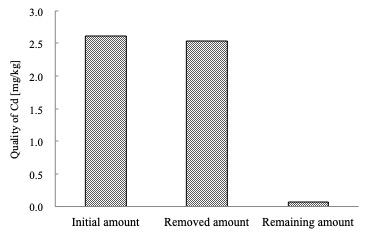
In this study, the TiO2/ZnO/rGO (TZR) composite was fabricated by a facile hydrothermal method. The X-ray diffraction and Raman spectra confirmed the formation of wurtzite hexagonal ZnO, anatase TiO2, and reduced graphene oxide (rGO) in the composite. The UV-visible diffuse spectra indicated that the composite exhibited a broad light absorption in a longer wavelength region and reduced bandgap energy with a lowest value of 2.7 eV. Photoluminescence and photocurrent measurements also demonstrated more efficient separation of photogenerated electron-hole pairs of TZR composites than ZnO, P25 TiO2, and pure TiO2/ZnO, attributing to chemical interactions between TiO2, ZnO, and rGO. Photocatalytic activity of the catalysts was evaluated on the degradation of three model dyes (methylene blue, rhodamine B, and methyl orange) under UV and simulated solar light irradiation. The synergistic effect of ternary components in the composite (TiO2, ZnO, rGO) led to a higher photocatalytic activity than ZnO and TiO2/ZnO. The varying loadings of graphene oxide (GO) in the precursor revealed a significant effect on the characteristics of TZR composites. Notably, the photocatalytic performance of a TZR composite with 5 wt% GO and an equal molar ratio of TiO2 and ZnO (denoted as TZR5) was better than the benchmarking catalyst P25 on the degradation of methylene blue and rhodamine B. The highest decolorization and mineralization of 99.2% and 41.1% was achieved, respectively, for methylene blue after 120-min UV irradiation; moreover, they were 98.2% and 48.0% for rhodamine B as well as of 98.4% and 44.2% for methyl orange after 180-min UV exposure. Under simulated solar light irradiation, photocatalytic degradation of three dyes over TZR5 also was more efficient than that over P25, ZnO, and TiO2/ZnO.
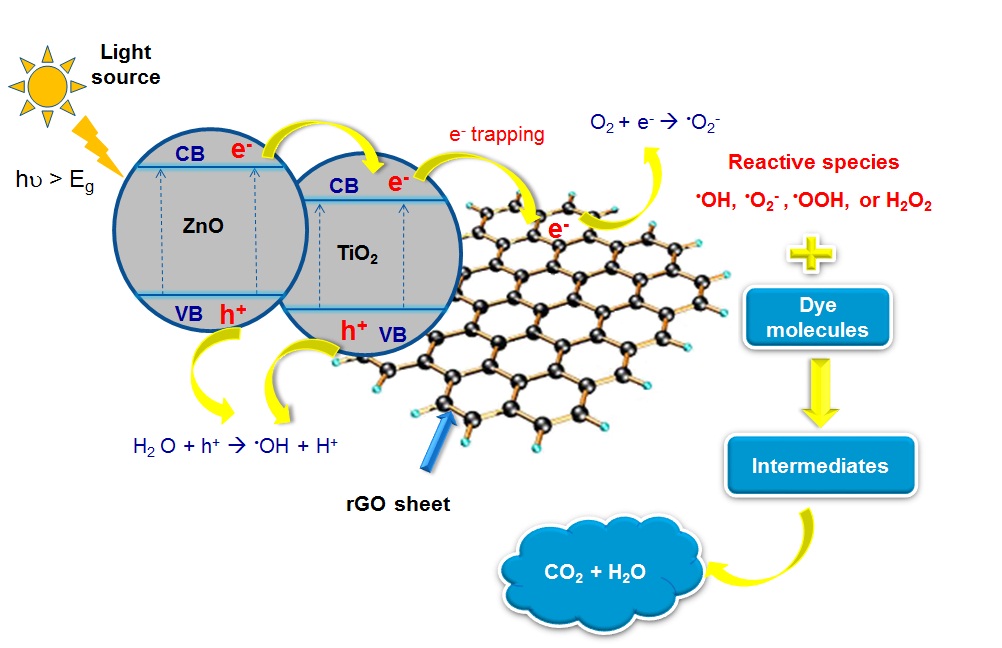
Climate change effects that scientists had predicted in the past are now occurring: loss of sea ice, accelerated sea level rise, more frequent and more intense heat waves, drought in some regions, as well as tropical storms. Besides the direct damages to the ecosystems by wildfires, more carbon dioxide (CO2) is released in the atmosphere. As a greenhouse gas, CO2 traps heat in the Earth's lower atmosphere which in turn causes the rise in global temperatures.
At the 2015 Paris Agreement, the world leaders pledged to keep a global temperature rise this century to well below 2 degrees Celsius above pre-industrial levels. However, in Oct 2018, World Meteorological Organization (WMO) reported that the average global surface temperature in 2018 was already 0.98 degrees Celsius above the levels. Meanwhile, NASA scientists reported that the warming in the last 60 years is attributed to human activities.
The oral presentation will cover on the following aspects:
· The challenges and opportunities in tackling climate change issues for industries.
· Preparation in terms of climate change mitigation and adaption strategy
· Human capital that a country need to have and invest in in order to benefit from available opportunities.
· Specific opportunities for oil & gas industries that should be capitalized.
Many end-of-life products, such as electronic goods and catalytic converters in cars, are important sources of precious and rare metals. Although conventional thermal and chemical recycling techniques remain the best methods for recycling precious and rare metals, these metals have yet to be fully utilized. Therefore, further research and development is needed to fully recycle precious and rare metals from secondary sources.
We believe that biological technologies now provide an attractive and eco-friendly alternative strategy. This paper describes our research results from using new biotechnologies to fully recycle platinum group metals (PGMs) from spent automotive catalysts and gold from electronic waste. We focused on using the metal ion-reducing bacterium, Shewanella algae, to recover PGMs from the aqua regia leachate of spent automotive catalysts. The Shewanella bacteria were able to reduce aqueous PGMs ions (Pd(II), Pt(IV) and Rh(III)) in the catalyst leachate as metallic nanoparticles on the bacterial cells at room temperature and pH 6 within 60 min, using formate as the electron donor. We also employed baker's yeast, Saccharomyces cerevisiae, as a commercially available biomaterial for collecting gold ions from the aqua regia leachate of spent central processing units (CPUs). The baker's yeast was able to rapidly and effectively collect only gold ions from the CPU leachate at pH 1 within 10 min. Importantly, baker's yeast did not react with other heavy metal ions, such as copper, nickel, and iron.
Unlike conventional recycling processes, the benefits of our new bioprocess include a significant reduction in energy consumption and material consumption, and a low environmental impact. Our highly efficient bioprocess could be introduced at local collection points for end-of-life products and operate as a regionally distributed technology for fully recycling metal resources from end-of-life products, which will lead to the sustainable use of PGMs and gold.
Abstract: Many extraction systems are required to be completed at a high phase ratio (>20:1). However, operation at high phase ratio causes some issues including low specific surface area, high mass transfer resistance and long mass transfer distance, leading to the long residence time or low extraction efficiency. In this paper, gas-liquid-liquid (G/L/L) micro-dispersion technology is used to intensify the mass transfer and the extraction of mixed rare earth elements (REEs). The results of liquid-liquid system show that the extraction efficiency decreases as the phase ratio increases, which further reflects the challenge of extraction at high phase ratio. Subsequently, the gas phase is used to enhance the mass transfer, and the overall mass transfer coefficient is used to characterize the mass transfer rate quantitatively. The results show that the overall mass transfer coefficient after gas introduction can be up to 8 times as high as that of the non-gas introduction, which demonstrates that the introduction of gas phase greatly accelerates the mass transfer and achieves the enrichment and recovery of rare earth ions successfully. In addition, the extraction of medium and heavy REEs mixtures are also intensified by this method, which proves the universality and versatility of this method.
Cobalt (Co) is a key element in the cathode material of lithium–ion batteries (LIBs). With the rise in LIBs applications, Co demand continued to grow strongly. However, shortage of global Co supply is imminent. Hydrometallurgical is usually used to recycling Co from spent LIBs. The objective of the study is to separate Co from Li, by flotation method in mixed solution, which simulates the solutions generated in the recycling of spent LIBs. When an anionic surfactant, such as sodium dodecyl sulfate (SDS) was used as the collector, ca. 98% of Co ions was separated from the solution. It is due to its adsorption via electrostatic interaction with SDS. It was found that Li ions were hardly separated because of the weak of interaction with anionic collector. Flotation process may follow different flotation mechanisms under various pH values. In this study, ion flotation occurred at pH 4.5, 5.5, and 7.5 and precipitate flotation occurred at pH 9 when Co formed cobalt hydroxide precipitate (Ca(OH)2). Separation efficiency of Co in the solution was affected by surfactant types, concentration of surfactant, pH, and N2 gas flow rate. Various types of anionic surfactants were used as collector and compared. Structure of anionic surfactant influenced significantly the separation efficiency of Co in the flotation experiment.
Keywords: Cobalt, flotation, lithium, separation, surfactant.
Carbon fiber reinforced plastic (CFRP) is a composite material of carbon fiber and resin, and it has properties of light weight and high strength, so its demand is expected to increase in the future. To recycle carbon fiber, which is an expensive material, is desirable, but its recycling method has not been established. The most effective method is thermal pyrolysis, but the thermal damage of carbon fibers is difficult to avoid. Therefore, we focused on a resin separation from CFRP by an electrical treatment. We have found that the electrical treatment can separate the resin from CFRP laminates in our previous research, but the details of the mechanism have not been revealed. In this paper, we applied the electrical treatment on a unidirectional CFRP mono-layer which was easy to discuss the mechanism and investigated the separation mechanism. The electrical treatment was performed using a two-electrode cell with CFRP mono-layer as an anode. The applied voltage was 15 V at constant, and the electrolyte was neutral solution. As shown in Figure, the weight loss of CFRP mono-layer reduced with time on stream, and it reached at the resin content at 300 min. The result indicated that the resin can be separated from the CFRP mono-layer in 300 min by the electrical treatment. From the digital microscope observation, the resin damage on CFRP mono-layer was observed at 10 min after the treatment. In addition, no resin component dissolved in the electrolyte was detected from various analysis. Furthermore, only water electrolysis proceeded during the voltage application. From these results, it was suggested that the resin separation by electrical treatment proceeds by the following mechanism; the water electrolysis proceeds on the carbon fiber, and the gas generated by the electrolysis peels off the resin adhering to the surface.
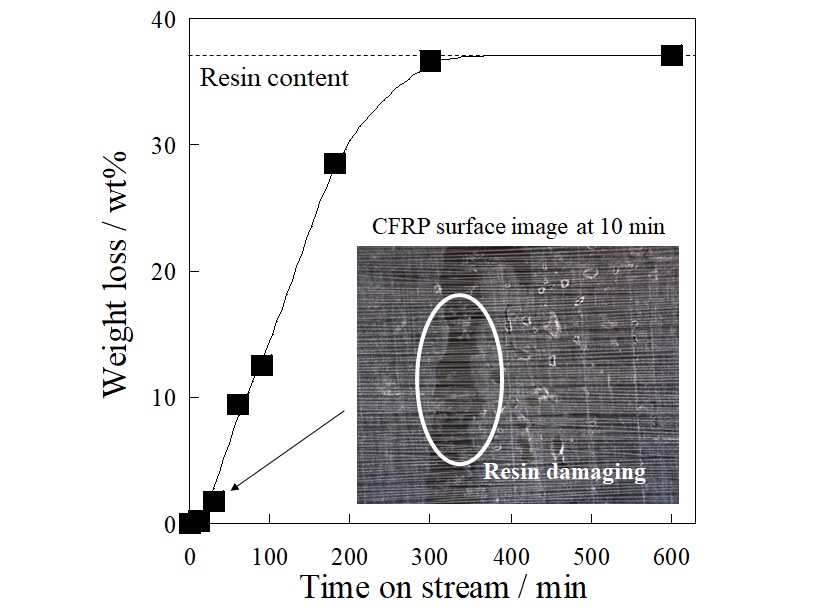
Plastics are raw materials of various molding products including heat-stable boards and IC devices. Recycling of plastic wastes has been interested from the point of view of resources and the environment, however, mechanical recycling of plastic wastes of such as thermo setting resin is not easy because they do not melt and mechanical recycling can not be applied. In this study, IC packages and foamed phenol resin were treated in high temperature solvents. Separation of organic materials and inorganic parts was attained in the case of the IC package by the thermal treatment in high temperature water and following solvent extraction. Foamed phenol resin was solubilized by the treatment in organic solvent at relatively mild temperature, and the production of monomeric materials such as phenol and cresols were confirmed. The presence of chemical participation of the solvent to decompose the methylene bonds contained in thermo setting resin was also confirmed in the reaction at 400oC. Such reaction mechanism was also suggested by the reaction of model compounds of thermo setting resin in high temperature solvent. The effective decomposition reaction show that solvents play important roles not only hydrogen donor, but also physical and solvolysis reactants. Plastic materials were decomposed also at relatively low temperature at 300 to 350oC.
In some Western Australia's wheat production area, there is concern about the future decrease in yield due to water logging and salt accumulation. The land use change from forest to cropland in centuries age, is thought to be resulted a broken balance between water input by rainfall and output by evaporation and transpiration, due to limited water consumption of wheat.
Theoretically, re-planting of trees on farmland is countermeasures for this problem, however, this method is not economically feasible.
To solve this problem, our group now developing new technology, not afforestation conversion of farmland but afforestation conversion of abandoned agricultural land due to salt accumulation by using salt tolerant tree species. In this research, we focused on the following 4 issues
1: Afforestation demonstration test,
2: Optimal design of afforestation site,
3: Cost analysis,
4: Carbon credit, bio-energy production potential estimation.
In the presentation, outline of the research project will be explained and preliminary results on groundwater level measurements and water usage estimation of planted trees by SAP flow measurements rate will be discussed.
Nanocellulose derived from cellulosic biomass could become an option for replacing conventional materials such as steel and fossil-derived plastics due to its unique physical properties. There are difficulties to disintegrate celluloses in plant cell walls into nanocelluloses because they are tightly hooked each other by multiple hydrogen bonds. Among various nanocellulose production techniques, one of the most adopted techniques to facilitate disintegration is carboxylation of the 6-position hydroxyl group of cellulose to produce electrostatic repulsion between cellulose nanofibrils with 2,2,6,6-tetramethylpiperidine-1-oxyl (TEMPO), called TEMPO oxidation. While it is said that the energy required for disintegration is small, it has hardly been assessed how the TEMPO oxidation could become environmentally benign technique to produce nanocellulose throughout its life cycle. Life cycle assessment (LCA) is a strong tool to quantify environmental impacts originating in product life cycle. However, LCA is originally based on process systems composed of existing technologies or services, although the technologies on nanocellulose are now developed and emerging for sustainability. In this study, we are tackling the LCA of emerging technologies for producing nanocellulose. The actual energy consumption in laboratory-scale processes for TEMPO-oxidized nanocellulose (TONC) was measured to assess the environmental impacts induced by the laboratory-scale and predict those through industrialization. The greenhouse gas (GHG) emissions from electricity for mechanical treatment is much larger than that from production of chemicals and energy for TEMPO-oxidation. In the experiment process, the amount of electricity to clean the fibrillation machine is also large, and the machine is cleaned much more carefully than the industrial process. Since the energy consumption of this cleaning process is significant part of the disintegration energy, it was found that the GHG emissions would be less than half if the careful cleaning were not required in continuous production.
The manure produced by intensive livestock farming is known to have significant impacts on the environment. The nitrogen and phosphorus compounds in the pig manure befoul the soil and water body. The microalgae-based piggery wastewater treatment system involved microalgae-based treatment, co-anaerobic digestion of pig manure and microalgal biomass, and biogas cogeneration. The organic residues from the anaerobic treatment can be applied as organic fertilizers to farmland replacing mineral fertilizers. Using anaerobic digestion of pig manure is a promising method of reducing greenhouse-gas (GHG) emissions. Cogeneration by burning biogas can produce the electricity power and usable heat to apply to the system. The environmental impacts of the system using high-rate algal ponds (HRAPs) were evaluated through mass, energy balances and life cycle assessment (LCA). LCA is usually used to evaluate the environmental performance of pig production. The performance of this microalgae-based treatment-scenario has been compared to the conventional application of pig manure (Activated sludge-treatment-scenario).
In recent year, the demand of fertilizers is increasing because of the increase of the food consumption by population growth in developing countries and the Bio-energy consumption. We developed the new recovery process of phosphorus, and the process is consisted of elution and precipitation steps, namely ‘Two-step Elution method'. The heavy metals are characterized by ICP-MS/ICP-AES spectrometer. The final phosphorus recovery rate is about 80%. The amount of metals and heavy metals in final precipitation of this method are much less than the fertilizer standards of Japan. In this study, we have started plant growing experiment by using the final precipitation as fertilizers. The purpose of this study is to investigate the usability of final precipitation as fertilizers.
With this phosphorus fertilizer, the small scale and large scale plant growing experiment was conducted as follows.
1) The plants used in this work are green soybeans and sweet potato.
2) A plant environmental control system (LPH-220N, Nippon Medical & Chemical Instruments Co. LTD, Japan) was used to cultivate plants from the seed.
3) After the cultivation of the plants, we transplanted them and fertilized. Ammonium sulfate and potassium sulfate was fertilized for all plants, but the phosphorus fertilizer was fertilized for commercial one, recovery one and none for all plants.
4) The phosphorus fertilizer was used the two types; phosphorus fertilizer derived from sludge ash and commercial one. Their molar ratio of the fertilizer is N:K:P=1:1:1.
We are also going to carry out more large scale experiment by cooperation of the Faculty of Agriculture.
There exist several techniques to treat fossil fuel-combusted flue gas such as wet limestone-gypsum method and amine absorption. Although the techniques have been widely used, their gas-liquid contacting efficiencies are poor which makes the contactors bigger resulting in difficulties in installation. In this study, we proposed a novel gas scrubbing concept, which can effectively remove SO2 and CO2 from simulated flue gas by stages using two membrane contactors in series. The SO2 is captured and directly converted to aqueous ammonium sulphate which could be utilized as fertilizer. The CO2 is captured and recovered using aqueous amine solutions and temperature-swing desorption. Various absorbent solutions such as fresh water, NaOH, NH4OH, H2O2 are tested. Of the tested absorbents, aqueous ammonia solution showed the highest removal efficiencies (i.e. > 99 % for SO2, 80 % for CO2). Optimum condition, removal mechanism, and size reduction of gas-liquid contactor are alsso discussed.
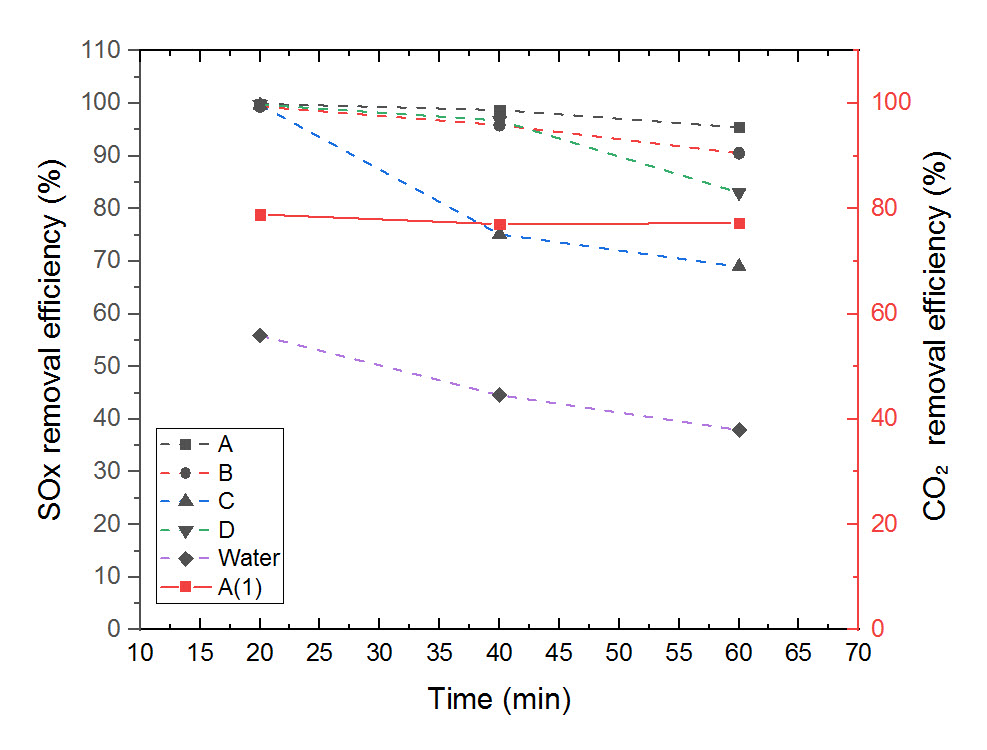
We have proposed a new type of mineral carbonation process, where CO2 is fixed as carbonates of alkaline earth metals. The process is composed of four steps: (1) Absorption of CO2 with an alkaline solution; (2) Extraction of calcium using an acid solution; (3) Precipitation of carbonates by mixing the calcium-leached solution and the alkaline carbonate solution; (4) Regeneration of an alkali-acid pair with the bipolar membrane electrodialysis. In this study, we examined optimum extraction conditions for the total process by using wollastonite as a calcium source and various kinds of acid in the view of the power consumption for the CO2 fixation. The acids used were nitric acid(NA), acetic acid(AA), lactic acid(LA), and gluconic acid(GA). The acid concentration and liquid-solid ratio were changed. The most important criterion of the extraction step is that the pH of the leached solution should be higher than 6.3, which is the acid dissociation constant of H2CO3: otherwise, a part of carbonate ions should be released as CO2 gas in the precipitation step. The table shows the optimum extraction conditions for the highest calcium concentration and the highest calcium extraction ratio of each acid after 24 h. The highest calcium concentration as well as the calcium extraction ratio was obtained when NA was used. In addition, the calcium selectivity in the extraction step was highest at 99.7%. When using AA, the calcium concentration was close to the value with NA, but the calcium extraction ratio was much lower. However, considering the electrodialysis process, the power consumption for the recovery of NA was much higher and the recovery ratio was much lower than those for the cases with other weak acids. The power consumption and the recovery ratio were almost equivalent for these three weak acids; acetic acid should be the optimum acid for the extraction step.
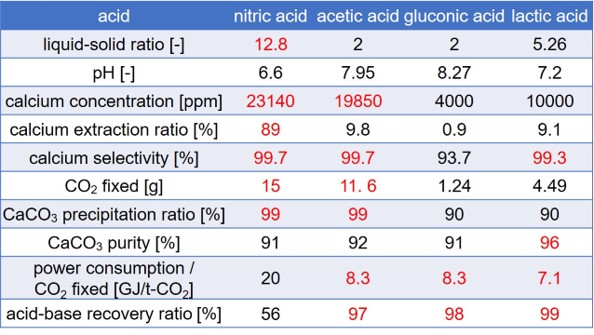
In recent years, the Asian monsoon region has a large business opportunity for the global food market for Japan. However, under severe conditions of high temperature and humidity, it is necessary to understand and control the cultivation environment in order to cause high-temperature injury in the process of crop growth. In this study, the authors evaluated the crop growth conditions and energy of greenhouse tomato production in several Asian monsoon areas. In these evaluations, a cultivation simulator considering growth conditions was used. This simulator is constructed from three processes of leaf photosynthesis, distribution of photosynthetic components, and fruit growth in order to analyze growth conditions in detail. In the calculation of the energy required to maintain the cultivation environment of the greenhouse, the photosynthesis rate of the plants and the transpiration rate were also calculated by simulation. In the evaluation of the growth condition, changes in the temperature of greenhouses at each region of Asia during planting and harvesting were investigated from weather data.
As a result, the difficulty of greenhouse tomato production under high temperature and humidity conditions in Asia and the differences in crop growth conditions among these regions could be clarified by this analysis.
It was suggested that the fruit yield was correlated with the seed number and days of the fruit development stage, and strongly affected by the temperature of the fruit-set stage.
Mineral carbonation is a fixation method of CO2 by using alkaline earth metals to form carbonates. We focused on concrete sludge which is a waste fresh concrete, as an alkaline earth metal source for mineral carbonation. In this study, we examined the carbonation reactions of a model concrete sludge by CO2 bubbling under various operation conditions, and investigated the effects of these operation conditions on the CO2 fixation performances.
A model concrete sludge was prepared by mixing a commercial Portland cement with water for 60 minutes. After hydration, CO2 was bubbled through the model concrete sludge to start the carbonation reaction. The dissolved calcium concentration was measured with ICP-AES and the pH was measured with a pH meter. After carbonation, the model concrete sludge was filtered and the solid residue was dried in an oven at 100 °C for 24 h. The solid residue was then measured by a thermogravimetric method to determine the conversion of CO2 to calcium carbonate.
The calcium concentration decreased by CO2 bubbling, and reached 250 ppm after 80 min and almost unchanged up to 200 min, which is close to the equilibrium concentration. The calcium concentration increased after 200 min to be leveled off at about 600 ppm after 300 min. The pH of the solution decreased by CO2 bubbling, and almost unchanged at 6.5 after 250 min, which is close to the equilibrium value. The effects of the operation conditions are summarized in Table 1; the carbonation rate is defined as the amount of calcium carbonate divided by the bubbling time, and the CO2 fixation ratio is defined as the mole fraction of CO2 fixed as carbonate to that the total amount bubbled through. From these results, the carbonation process can be designed.
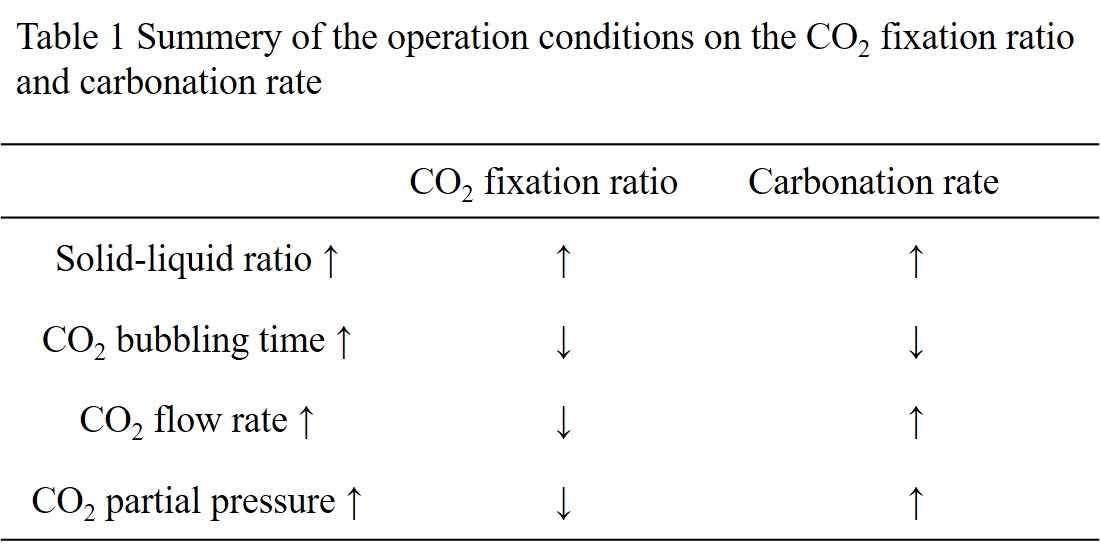
The behavioral studies of fission product aerosols are extremely important in the context of probable environmental hazard in the event of a severe nuclear reactor accident. Fission Product aerosols are generated in such a case are expected to travel from the primary heat transport system to the containment and may get released to the environment. Presence of steam also affects their dynamic behavior and fate. Interaction of aerosol particles with water vapor in the supersaturation domain affects their physical as well as chemical characteristics. Radioactive compounds of cesium (CsI and CsOH) forms a major part of fission product aerosols, which may be released into the air in huge amounts by nuclear power plants during nuclear accidents and also at the time of nuclear weapons testing. Severe nuclear reactor accidents that involve considerable core melting generate large source terms of fission product aerosols to the environment. Cesium, with a half-life of 30 years is highly reactive and combines readily with other elements, especially oxygen, other gases, and nonmetals. Cesium is treated as a hazardous material because it reacts violently with water. Cesium also reacts violently with sulfur, phosphorous, acids, and halogens (fluorine, chlorine, bromine, iodine, and astatine). The lifetime, along with its reactive nature makes it a concern for human health. Radioactive isotopes of cesium are produced in nuclear power plants by the fission of uranium in fuel rods and also by the explosion of nuclear weapons. In this study, the CCN properties at different supersaturations for different size of laboratory generated single salt CsI (Cesium Iodide) and CsOH (cesium hydroxide) aerosols were investigated. CCN spectra of CsI and CsOH particles were measured at room temperature (298K) with the help of DMT CCN counter. A comparison of experimental data with theoretical values is also done for both the salts.
Peat fire in Indonesia not only releases a large amount of carbon into the atmosphere, but also causes significant damage to peatland ecology and the landscape. Smoldering is the dominant combustion process in peat fire, and the combustion is the slow, low-temperature, flameless burning of porous fuels, and the most persistent type of combustion phenomena. To suppress the peat fire, it should be very important to increase the water content of dry peat and deliver water toward the combustion zone to remove heat efficiently. We have been developing a novel soap-based firefighting agent for peat fire with significantly lower environmental risk. Soaps possess very high surface activity, very high biodegradability and very low toxicity. In this study, it was evaluated by focusing on permeability and wettability in peat soil as the physical properties of the soap-based firefighting agent. The peat moss in Russia was used as the peat model for permeability and wettability test. Permeability and wettability in peat moss of the synthetic-surfactant-based firefighting agent and soap-based firefighting agents was much better than ion-exchanged water. It was clear that the firefighting agent solution is very effective for firefighting peat fire compared to water alone. Among the soap components, the potassium myristate showed the best results in both permeability and wettability test.
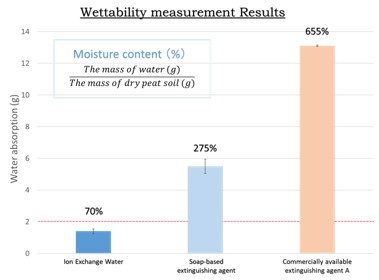
Firefighting agents including fluorochemical surfactant for oil is widely used in Japan.
However, fluorochemical surfactants have much low biodegradable, and
perfluorooctane sulfonic acid was prohibited by the law in 2011. Regulations will be
tightened in the future, therefore, the fluorochemical surfactant-free firefighting agents
are eagerly anticipated. We have been developing a fluorochemical surfactant-free
firefighting agent with very low biotoxicity (LC50 ≥ 100 ppm) for oil fires. In this study,
three surfactants containing different types of functional groups (-SO3,-CH2CH2OH,-
COOH) were used. After preparing firefighting agents, it was diluted to the required
concentration. Japanese-killifish, Himedaka, was exposed to the firefighting agent
solution, and the survival number after 96 h was measured. Firefighting tests were
conducted according to the scale of the national verification standard. The surfactant
containing -CH2CH2OH functional group showed the best firefighting performance among the three types of surfactant.
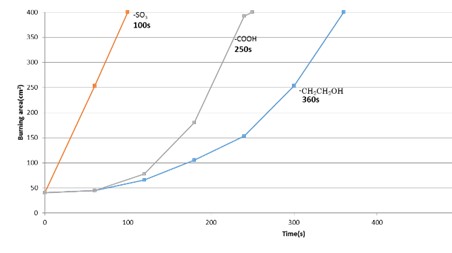
The hydrloysis of disaccharides is an important issue for the design of the conversion of cellulose biomass. In this study, the decomposition of disaccharide, sucrose, under the hydrothermal conditions (160~190 oC at 10 MPa). was examined in the microcapillary, as shown in the Figure (right) [1].
The kinetic model taking into consideration of induced period (td) was adopted to analyse the hydrolysis process of disaccharides The present analysis could give the pH value to start the hydrolysis of disaccharides (pHamb) as shown in Figure. Estimated the activation energy, the hydrolysis of disaccharides under the hydrothermal conditions were conducted in an ionic reaction manner. Therefore, possible parameters relating to the ionic reaction manner is (i) hydration structure of disaccharides and (ii) electron charge of oxygen in glycosidic bond. The hydration structure was discussed with the dielectric measurement. It was considered that the sucrose, turanose, meribiose were well hydrated relative to other disaccharides (see Figure a and b of left). Also, the electron environment at oxygen atom in glycosidic bond related to the hydrolysis of disaccharides (Q value) was calculated using a MOPAC. Then, pHamb value was roughly correlated to the Q value. Therefore, the method only requires knowledge of the electron charge of oxygen atom in glycosidic bond of disaccharides at the calculation to predict the pHamb of the target disaccharide.
To predict pHamb would lead to avoid the use of unnecessary quantity of acids to adjust the initial pH condition, which is the significance in environmental impact. Besides, it was a use of microcapillary system that could monitor the time-course of pH to obtain the pHamb value for hydrothermal hydrolysis of disaccharides. This would be just a significance of the microcapillary in this study.
Reference
[1] T. Shimanouchi et al., J. Chem., Article ID 3985915 (2019)
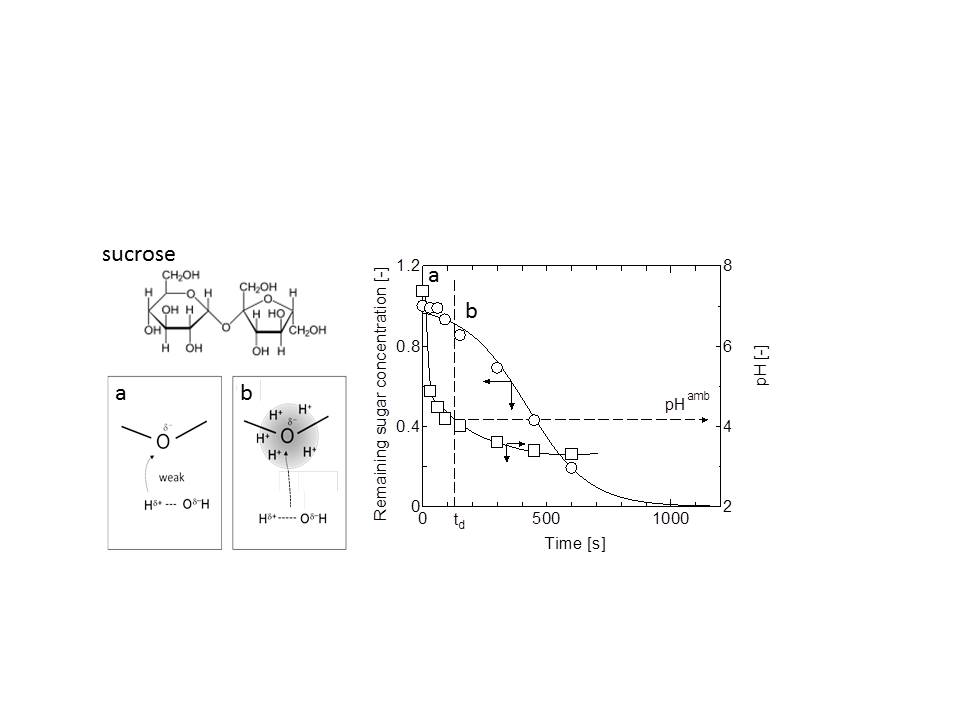
Over the past decades, the use of carbon fiber reinforced plastics (CFRPs) has been steadily increasing across a wide range of sporting and industrial applications. This growing production and use of CFRPs in applications today will inevitably lead to larger volumes of CFRP waste in the future. Since fiber reinforced composites are difficult to separate into their elemental components, composite waste is principally disposed in landfills or incinerated without any recycling approaches. Disposing a large amount of CFRP waste on reclaimed land is not feasible for small countries; moreover, burning expensive long carbon fibers also causes environment pollution. Use of biodegradable plastic is an effective way to solve the disposal problem of large CFRPs. APEXA© is a biodegradable polyester consisting of terephthalic acid (TPA), ethylene glycol (EG), and an organic acid. Its heat resistance and durability are far higher than those of other biodegradable polyesters and are comparable to those of polyethylene terephthalate (PET). Although the decomposition of APEXA© in compost has been studied, little is known about its degradation in an aqueous environment. In this study, APEXA© fiber was hydrolyzed at pH 3.0–10.5 for up to 4 weeks. The molecular weight of the APEXA© fiber decreased remarkably in dilute sulfuric acid (pH 3.0); specifically, it decreased to 22.9% of the original molecular weight after 1 week. The sharp decline in the molecular weight of APEXA© suggests at composite recycling combined with mild hydrolysis and biodegradation. The APEXA© composite enables to collect maintained long-carbon-fiber in hydrolysis and return the separated resin to the earth.
Background
Polyurethane (PU) was originally synthetized by Otto Bayer in 1937 in Germany. This material is very stable on a lot of different applications, such as, transportation, packaging, footwear, paint, and insulation component for refrigerators and buildings. In 2016, approximately 18 million tons of PU will be produced and 3/4 of them were in foam format. Asian countries used most of them.
Methods
A new study on polyurethane degradation, catalyzed by the different catalyst was reported. NaOH, KOH, sodium acetate and an alkaline metal oxide catalyst were used under the presence of ethyl glycol at the designated reaction condition was proposed. The resulting glycolysate was analyzed to determine the physical and chemical properties. The will be used as the source to reproduce polyurethane for recycling purpose.
Results
With the addition of sodium hydroxide and sodium acetate as the catalyst in the glycolysis, more wasted PU can be dissolved than that without the presence of the catalyst. The reaction time to reach the equilibrium condition is almost the same. More waste PU can be dissolved into the glycolysate with a shorter reaction time if the reaction was catalyzed by the proposed heterogeneous catalyst. The spent catalyst can be removed from the mother glycolysate solution easily upon the completion of the reaction. The glycolysate of the by different catalysts were also re-synthesized to form the recycled polyurethane. The thermalgrametric analysis of the recycled polyurethane from the heterogeneous catalyst showed very similar to the original waste PU. The results showed a potential route to reproduced the polyurethane from the recycled method. The PU foam as also reproduced in this reaction process.
Financial support: Ministry of Science and Technology in Taiwan, ROC (MOST 107-2218-E-035-017 – and MOST 106-2221-E-035-079 -).
I. Introduction
Recycling catalyst is needed for biomass conversion (e.g., producing bio-oil) in order to reduce cost and protect the environment. However, most catalysts used for producing bio-oil from the pyrolysis of biomass cannot be recyclable use, leading to catalyst pollution and waste. Based on previous research results (shown at this conference) it was shown that inexpensive Ni, Fe catalyst clusters can improve the quantity or quality of bio-oil produced from the biomass, but to our knowledge, very few studies have actually investigated the reusability of catalyst, especially from experiments when mixing cellulose (biomass model compound) and catalyst directly together. In this study, Ni2Fe3 catalyst was mixed with cellulose in a pyrolysis batch reactor to investigate its reusability and its impact on the bio-oil yield and content.
Experiment
The catalyst was prepared by sol-gel method and heat-treated in flowing H2/N2 gas. Pyrolysis experiments were conducted using a fixed bed reactor, flowing 100ml/min N2 gas, at 450 °C with the catalyst repeating five times. The amount of pyrolyzed bio-oil and coke were weighed, and then the amount of gas was calculated by subtracting the amount of bio-oil and coke from the initial feed.
II. Results & Discussion
Figure 1 shows the bio-oil/gas/coke mass yields from each pyrolysis experiment, and the bio-oil yield is plotted versus a number of experiments. The Ni2Fe3 metal catalyst can increase the bio-oil yield from 39.5% to 47.5%. Moreover, the activity of the catalyst is relatively constant based upon bio-oil yield. Furthermore, the gas/coke yield also shows a similar trend. What can we say here is that the NiFe cluster metal catalyst is recyclable for bio-oil production by pyrolysis. Research work is continuing on the evaluation of the sampled bio-oil content and understands why the catalyst can be used repeatedly.
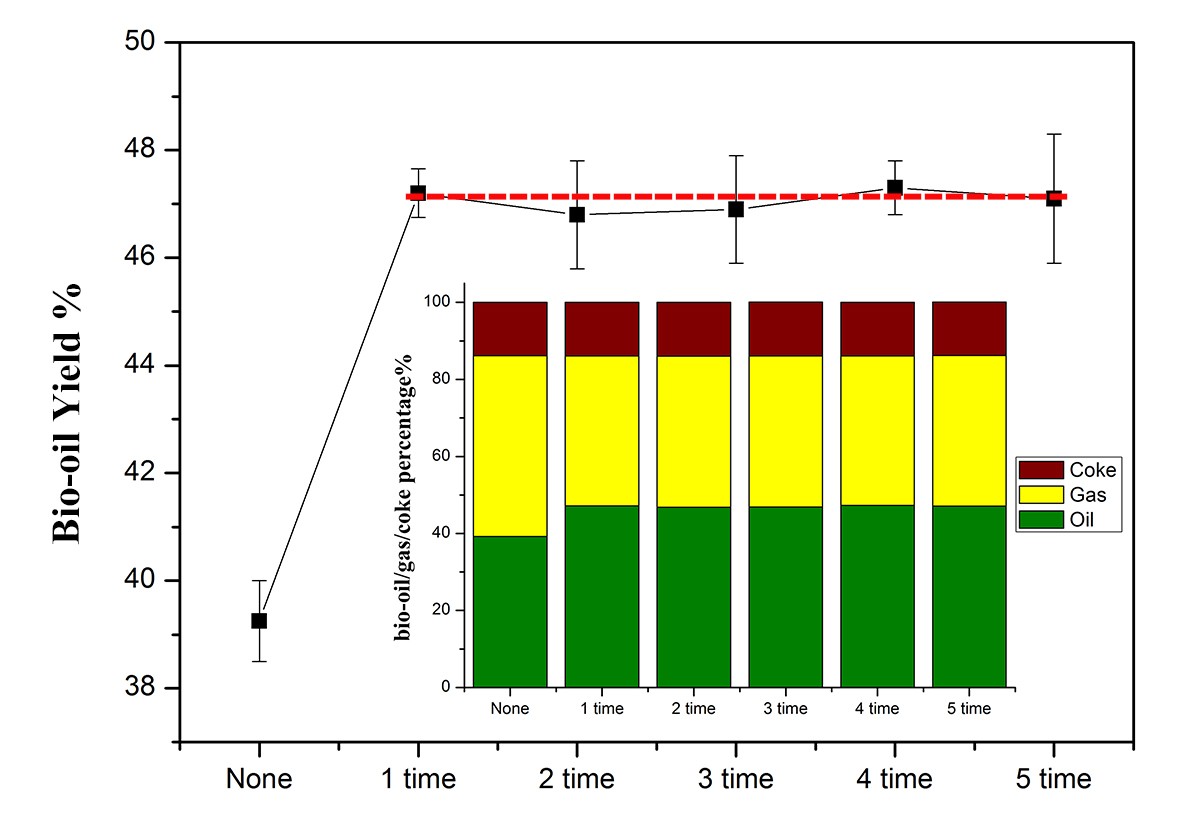
In this study, montmorillonite-supported nanoscaled zero-valent iron (Mt-nZVI) composites were fabricated using a facile liquid-phase reduction method. The morphology, crystal structure, functional groups, and magnetic properties of as-prepared composites were explored using scanning and transmission electron microscope, X-ray diffractometer, Fourier-transform infrared spectroscope, X-ray photoelectron spectroscope, zeta potential analyzer, and superconducting quantum interference device. The ZVI nanoparticles (particle size, 60-100 nm) were well dispersed on Mt support (particle size, 25 μm), which effectively decreased the tendency of agglomeration behavior. The optimal weight ratio of Mt particles to ZVI nanoparticles was equal to 2, which was denoted to be 2Mt-nZVI composite. The synthesized 2Mt-nZVI was then used to eliminate oxytetracycline antibiotic with a variety of operating parameters such as Mt particle size, weight ratio of Mt to ZVI, solution pH, and initial oxytetracycline concentration. Experimental results showed that 99% of 100-mg/L oxytetracycline at pH 5.0 could be removed by 0.6 g/L of 2Mt-nZVI composite and the mineralization could reach 70% after 20 min of reaction. Moreover, six possible intermediates were detected and identified by an ultra-performance liquid chromatography-quadrupole time-of-flight mass spectrometry (UPLC-QTof/MS, Waters) during the degradation of oxytetracycline over 2Mt-nZVI composite. This study demonstrated that the prepared Mt-nZVI composites possessed a promising potential for removing and mineralizing oxytetracycline from polluted water.
Photocatalysts represented by titanium oxide are important material in utilization of light energy. In recent year, a new use of silver orthophosphate (Ag3PO4) semiconductor as an active photocatalyst has reported which can harness visible light to oxidize water as well as decompose organic contaminants in aqueous solution. Previously, silver orthophosphate fine particles were mainly synthesized by the liquid phase reaction, which required multi-step operation. Furthermore, the only report of silver phosphate synthesis by solid-solid reaction has also proposed time-consuming methods. There are several important technologies to realize the practical use of materials, one of which is method to rapid and facile synthesis. In this study, we developed a rapid synthesis method for silver orthophosphate using a vibration mill. Furthermore, the obtained silver orthophosphate was characterized in different ways. Silver orthophosphate was easily obtained by preparing a tube containing silver nitrate, one of several phosphates (Na3PO4, Na2HPO4, NaH2PO4) and zirconia beads, followed by vibrating with a vibration mill. The unreacted raw materials were removed by washing to obtain a yellow powder. The powder X-ray diffraction pattern of the sample obtained is in accordance with that of the reported silver orthophosphate. Furthermore, the results of energy dispersive X-ray analysis show the consistent values with the stoichiometric ratio of silver orthophosphate. The yield of silver orthophosphate was 48% when disodium hydrogenphosphate was used as the phosphate source. Furthermore, the yield depends on the shaking time, but it saturates in only 10 seconds at a shaking speed of 4000 rpm. The yield was also dependent on the shaking rate with constant shaking time. The photocatalytic activity of obtained silver orthophosphate was evaluated by degradation of methylene blue in suspension. The supernatant of the suspension was discolored by the irradiation of blue LED light, indicating the photocatalytic activity of the obtained sample.
A simple and efficient method was developed to remove dyes from wastewaters. The method was conducted by adding alcohols followed by feeding air bubbles. In this study, cationic dyes (rhodamine B (RB), crystal violet (CV), malachite green (MG)) and anionic dye (erythrosine B (EB)) were selected because of their extensive use in staining and textiles dyeing processing. Removal of these dyes increased significantly by adding small amount of alcohols (0.01% ~ 0.5% v/v). The effect of alcohol (ethanol < 2-propanol < 1-butanol) increased with increasing in its carbon number. Cationic dyes (RB, CV, MG) were removed in the range of pH 3 to 10, while EB was removed in the range of pH 1 to 3. Effects of instrumental parameters including vessel diameter and water height were also studied. Under the optimum conditions, nearly complete (> 98%) removal of these dyes was achieved by the flotation within 5 min. Influences of co-existing organic (humic acid, starch, etc.) and inorganic substances (NaCl, KCl, etc) omnipresent in wastewaters were investigated in detail. Practical applicability was examined by using synthesized dye wastewaters.
The water treatment using photocatalytic titania nanoparticles for removing organic contaminations is one of the advanced water purification systems, but the immobilization method for nanoparticles should be developed. For overcoming this problem, the degradation of methylene blue (MB) in aqueous solution by a titania particle film was studied using the photocatalytic system. The electrophoretic deposition technique applied to preparing titania thin films on stainless steel screens out of titania particle suspension. After annealing in air at 773 K for 10 minutes, the crack-free, porous titania particle film coated on the screen was dipped in 50 mL MB aqueous solution to carry out the MB degradation test, in which ultraviolet light (254-nm wavelength) was illuminated to the surface of the titania film while the MB solution was passed through the meshes of the screen. The rate of MB degradation was estimated from the variation of MB absorbance measured with a spectrophotometer. The degradation rate was found to increase with the thickness of titania particle film and to reach an asymptotic maximum range, even for different meshes of the screen. This trend indicates that a certain thickness of the titania porous film was required for the photocatalytic reaction with the surface area of the coated screen being a dominant parameter for the MB degradation rate. As the circulation rate of the MB solution was increased, its degradation rate increased; this could be explained as that increasing flow rate resulted in rendering the diffusion boundary layer thinner with less resistance to MB's contacting to the surface of titania particles.
A photo-assisted Ce(IV) mediated electrochemical oxidation (MEO) system is developed to treat the phenol-containing water in comparison to Ce(IV) MEO and photocatalytic oxidation systems. Operation conditions of electrical current, nitric acid concentration, stirring speed of magnetic stirrer, and electrode area ratio of anode to cathode for Ce(IV) electrogeneration are optimized in terms of its production yield and energy consumption. According to a kinetic model incorporating the Ce(III)/Ce(IV) redox reaction, the forward rate constant of Ce(III) oxidation is found to be twice as large as that for the reverse reaction. Regarding the wastwwater treatment, Ce(IV) MEO and photocatalytic oxidation systems both have favorable capability in degrading phenol under an acidic environment rather than the DEO system. More importantly, the photo-assisted MEO system offers excellent removal efficiency of phenol up to 98% in only 40 mins, benefiting from the synergistic effect of the individual electrocatalytic and photocatalytic systems. Moreover, a pseudo-first order kinetic model is applied to well describe the phenol degradation in the photoelectrocatalytic oxidation system, resulting in a rate constant of 0.083 min-1.
Sulfonamides such as Sulfamethazine (SMT) are widely used as antibiotic in animal husbandry, fisheries aquaculture, fruit and vegetable in Taiwan. Although antibiotic has positive effects, once they are release will cause high risk to ecology or human body. In the research it has been pointed out that such bacteriostatic agents may cause allergies, pneumonia, and enhance the symptoms of asthma. The Ministry of Health in Taiwan has been clearly legislation about Sulfamethazine (SMT) residue.
This present study is to investigate the removal of SMT in aqueous solutions by electrochemical activation of sodium persulfate. In the part of SMT removal by the electrochemical activation system, various parameters such as electrode pair, current densities, electrolyte concentrations, oxidant concentrations, temperatures and initial pH were evaluated to characterize the removal of SMT efficiency. The effect of the current density on the special energy consumption were also investigated in this study, The optimum electrode pair, current densities, electrolyte concentrations, oxidant concentrations, temperatures and initial pH were found to be Fe/Fe, 16 mA/cm2, 4 mM, 0.6 mM, 298 K, pH 3, respectively.
Advanced oxidation processes(AOPs) are used as oxidation methods with highly reactive species such as hydroxyl radicals for the removal of organic pollutants having high chemical stability or low biodegradability in wastewater. However, the AOPs are not cost-effective and they need to combine with other treatment processes such as physicochemical or biological processes in order to achieve maximum economy efficiency. AOPs can be used as a pre-treatment or post-treatment method of biological process including activated sludge. In the pre-treatment AOPs will improve biodegradability of pollutants and in the post-treatment AOPs will remove the pollutants that cannot be completely degraded by biological systems. In the combination of AOPs as a pre-treatment with activated sludge treatment the chemical oxidation is specifically aimed to partially degrade the pollutants to more biodegradable components and the degree of partial degradation of pollutants will be important for the optimization of overall process efficiency.
In this study, ethylene glycol(EG) and Fenton reaction were employed as model synthetic organic component and AOP, respectively. The effects of operating conditions on biodegradability of EG by Fenton reaction were studied. The biodegradability rate, which is determined with the TOC before and after activated sludge treatment, increased from 3% to 39% by Fenton reaction for 2 min. From HPLC analysis EG was degraded into formic acid and methanol by this degradation reaction. The same analysis were conducted for glucose and poly ethylene glycol(PEG). The biodegradability rate of PEG increased from 0% to 13% by the Fenton reaction, while that of glucose decreased from 82% to 68%. From these observations showed that AOP as a pre-treatment of activated sludge process is useful for the treatment of poor biodegradable organic components.
The depletion of phosphate rocks has become problem, because the demand of fertilizer is increasing according to rapid population growth in developing country and an increase of biomass energy demands for CO2 problem. Sewage sludge ash is getting attention for recycling phosphorus resource because of containing phosphorus equivalent to low quality phosphate rocks. phosphorus recovering techniques from the ash have been studied. After using the ash as producing fertilizer, sewage sludge ash residue always remain and it is disposed even though there is a lack of landfill capacity. In this study, we propose a method of recycling sewage sludge ash residue as a marine fertilizer and evaluate the effects. In Japan, some of the coastal areas and bays currently suffer from a lack of phosphorus. Phosphorus could be supplied by sewage sludge ash residues with some treatments. Sewage sludge ash residue includes silicon and iron which are also important for ocean ecosystem to grow apart from phosphorus. For the control of solving rate of phosphorus, we add some carbon, calcium and sodium, and do thermal treatment. Since dissolution rate of heavy metals is much lower than the environment standards of Japan, we could control of solving rate of phosphorus supplied to the coastal areas and bays from 3 days to 3 years.
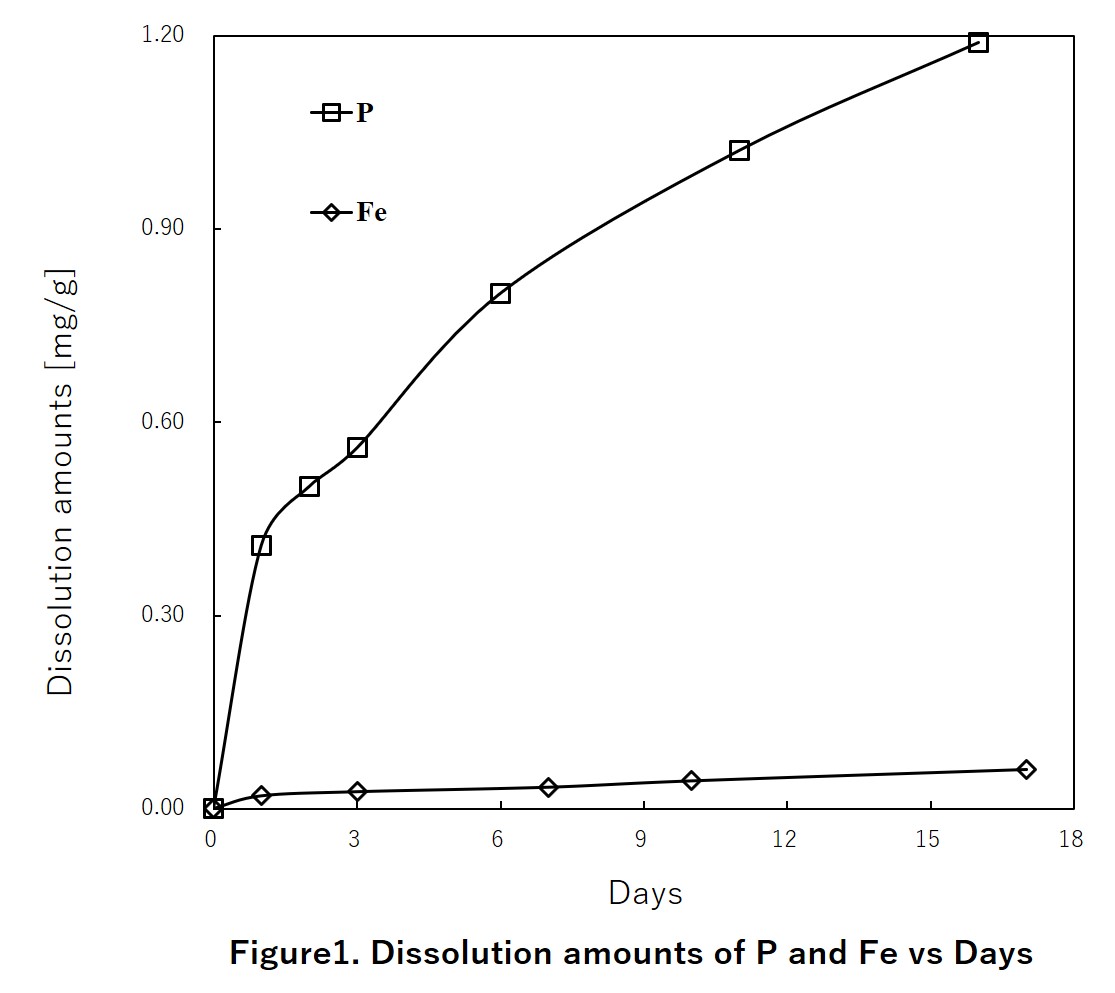
Phosphorous is main component of fertilize. Recently phosphate rock is one of the worldwide depleting resources, because demand of fertilize is increasing with increasing population and bioenergy. Furthermore we don't have phosphorous recourse in Japan. Fortunately, Sewage sludge incineration ash contains about 15 to 30% of phosphorous (P2O5 equivalent), and it is equivalent to low grade phosphorous rock. And the amount of phosphorous contained in sludge incineration ash generated from all over the country is equivalent to it which is imported from overseas as phosphate. Now the phosphorous recovery process from sewage sludge ash is already researched, so we can secure the phosphorous that are not concern for depletion. However, still much sewage sludge ash is landfilled because recovery rate of phosphorous in previous developed process is very low. So we have developed the method called two-step phosphorous recovering system, which is combined acid elution and alkali elution. In this system, recovery rate from sewage sludge ash is almost 80%.
In this study, for more improving the recovery rate, we try to add the additive and control pH and discuss about the phosphorous recovery rate depending on additive amount and pH. Also, we discuss that alkali elution rate is changed by the structure of precipitation.
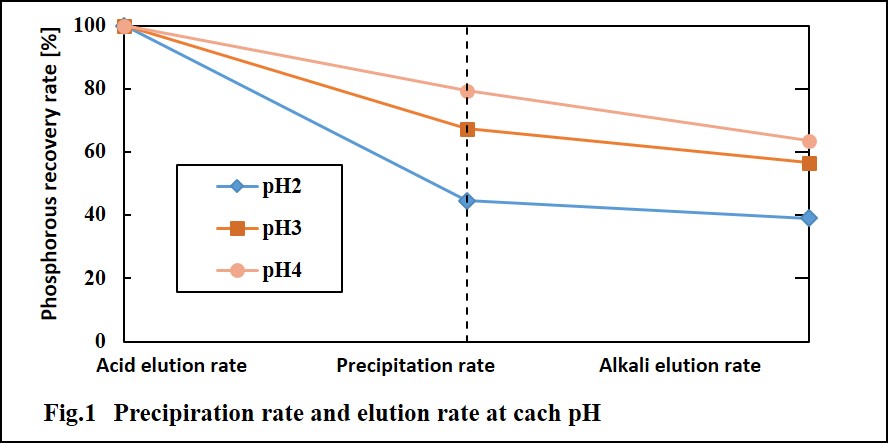
So far, much research has been done on the Cs+ extraction system using the 1-ethly-3-methylimidazolium bis(trifluoromethylsulfonyl)imide (C2mimTf2N) as Ionic liquids (ILs) and dicyclohexano-18-crown-6 (DCH18C6) as a Cs+ selective extractant. In our laboratory, we found that when the amount of ILs was reduced, solid precipitate was formed, and it was confirmed through various analyzes that Cs+•Tf2N-•DCH18C6 was consisted. Formation of solid precipitate is useful for separation after waste treatment. In addition, despite a small amount of ILs, the Cs+ removal efficiency was about 90% when DCH18C6 was used in the same molar quantity as Cs+. Based on this, the study was conducted using LiTf2N as instead of expensive ILs under dodecane solvent (Figure 1). When the dodecane was reduced, solid precipitate was also formed, and confirmed it consists of Cs+•Tf2N-•DCH18C6 by analyzing scanning electron microscopy (SEM), Energy Dispersive Spectrometer (EDS) and Fourier transform infrared spectroscopy (FT-IR). Also, it was shown the high Cs+ removal efficiency of 90% in dodecane system.
In conclusion, the new facile method using dodecane and common anion salt (LiTf2N) can reduce the amount of waste, is easy to separate, and has a high Cs+ removal efficiency, so that it can be used for the treatment of radioactive liquid waste. Moreover, although dodecane is a volatile substance, it can be economically advantageous because it can eliminate danger by using Solid-liquid separation using a small amount and replace expensive ILs.
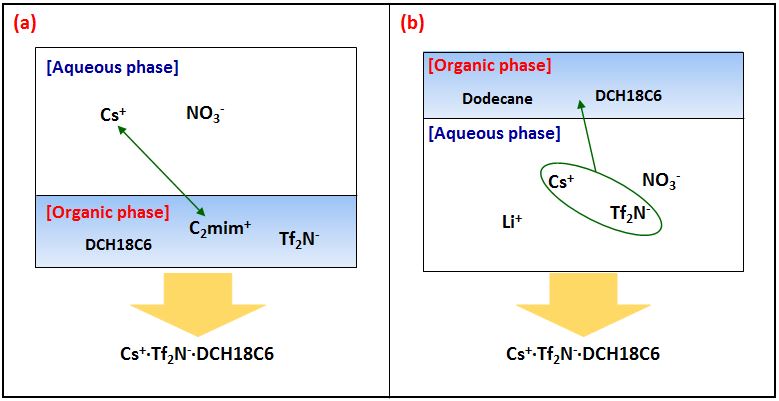
The removal ability of dibenzothiophene (DBT) in hydrocarbon liquid model fuel (MF) of Ni-loaded carbon (Ni/C) prepared from lignite, which is inexpensive and abundant with an ion-exchangeable capability, was investigated with a flow-type fixed-bed reactor. The Ni/C precursor (Ni/C_P) could only be prepared by adding lignite to a Ni2+ solution by impregnation method. Ni particles in the Ni/C_P existed as an amorphous form. Ni particles in Ni/C prepared by pyrolysis of Ni/C_P were well-dispersed into carbonaceous materials. The removal performance of DBT by Ni/C depended on the loaded Ni amount. The highest performance was observed at 11wt%-Ni content in Ni/C under a desulfurization temperature of 200 °C and H2<.sub> reduction time of 0.5h for Ni/C before desulfurization test. The H2 reduction time of Ni/C influenced the breakthrough curves, and it was found that the optimum time for DBT removal by Ni/C was 1.0h. When the treatment temperatures for desulfurization were varied at 25-200oC, the breakthrough and saturation points increased with increasing temperature, and the greatest performance was observed at 200 °C. As the initial S concentration in the MF was varied, the breakthrough curves depended on the concentration, and it was found that Ni/C could decrease the S amount in the MF to below 0.1ppmw. From the results of the identification of MF treated by Ni/C, it was suggested that adsorption desulfurization occurred due to the cleavage of the C-S bond in the DBT molecule to form an Ni-S bond and biphenyl. In addition, from the quantitative result of biphenyl in MF treated by Ni/C and carbonaceous material prepared by removal of Ni in Ni/C, it was suggested that competitive adsorption of biphenyl and DBT on the adsorption site on carbonaceous material in Ni/C prepared occurs in this study.
Bio diesel fuel (BDF) has an advantage of generating small amount of SOx during combustion. However, BDF production process discharges strong alkaline waste liquid including potassium hydroxide, methanol, fatty acids, and glycerin. Since this waste liquid is highly toxic and harmful to the environment, it is basically incinerated. The high waste disposal cost is one of the issues, and it is required to develop of the effective utilization method of BDF waste liquid. Its environmental hazard is mainly derived from the strong alkalinity of potassium hydroxide; however, potassium itself is an important element in plant growth. If the potassium hydroxide in BDF waste liquid is neutralized and solidified, BDF waste liquid can have a possibility to utilized as a potassium sources fertilizer for plants. In this study, we produced gel from BDF waste liquid by adding glucomannan. Glucomannan solidifies the waste liquid while convert potassium hydroxide to potassium acetate (Fig. a). The glucomannan was added to the diluted waste liquid, and a gel was formed (Fig. b). In order to evaluate the gel as potassium sources fertilizer, neutralization of potassium hydroxide with glucomannan and emission of potassium from the gel were confirmed by measuring the pH and potassium concentration in the solution. From the experimental results, it was suggested that BDF waste liquid has potential to use to agricultural fertilizer to supply potassium.

Acid mine drainage (AMD) containing toxic elements continues to be generated at about 100 abandoned mines throughout Japan, and It is urgent to be treated in the future.
There are various methods for AMD treatment, and it is necessary to select the best method for each mine. Passive treatment using constructed wetlands is attracting attention for some mines with low volume of wastewater and low concentration. Although the removal ability of the constructed wetland has been confirmed, quantitative modeling of its removal mechanism and removal capacity and its application to other mines have not been carried out. In this research, we model the contaminant removal process in the subsurface flow (SSF) of constructed wetlands in the H mine using geochemical modeling. We also evaluate the applicability of the model to other mines. As a result of field survey, it is suggested that δ-MnO2 is generated by microorganisms in the SSF. The experiment result confirms that cadmium (Cd) is removed by δ-MnO2. Therefore, we carried out removal experiments under several conditions to construct a surface complexation model (SCM) of δ-MnO2 for Cd. By adding the SCM and some reaction constructed in this study to the previous chemical reaction model and performing one-dimensional advection analysis, the reaction behavior in the wetland could be well reproduced. The result suggests that the toxic elements are removed by adsorption to iron, aluminum, manganese (hydro-) oxide or precipitation in the SSF. In addition, by applying this model to other mines, we calculated the area of wetland necessary for treatment. We compared the conventional treatment with the constructed wetland and examined the applicability of the constructed wetland from the aspect of economics and environmental impact.
Heavy metals are highly toxic substances contained in industrial wastewater or mining waste water. Among heavy metals, Pb(II) ions are difficult to remove under alkaline conditions. Generally, Pb(II) ions in aqueous solutions could be removed by pH adjustment, but could not be removed in some cases, such as leaching solution from incineration ash. In plating industry, if we remove Pb(II) ions at alkaline conditions, we can re-use the solution.
Generally, activated carbon is used for heavy metal removal, however it is expensive. Dolomite is one of the minerals, widely distributed all over the world, and very cheap comparing with activated carbon. Calcined dolomite has high adsorption capability to heavy metals. We found that As(III) ion adsorption capability at alkaline conditions is improved by phosphorus-doped in previous studies. Pb(II) ions are absorbed by phosphorus doped calcined dolomite adsorbent at alkaline conditions.
In this study, we investigate the effect of doped phosphorus amount, pH, and concentration of Pb(II) on adsorption. The structure of phosphorus doped dolomite and Pb(II) adsorbed dolomite with phosphorus are analyzed by XRD.
This experiment was conducted by changing parameters such as pH, concentration, temperature, doped phosphorus amount, and time. The result shows that above pH 11, the amount of Pb(II) ions by the phosphorus doped adsorbent increase than that of phosphorus non-doped dolomite. Adsorption amount is proportion to doped phosphorus amount.
The XRD analysis result show that phosphorus doped dolomite is Hydroxyapatite (HAp). This adsorption is both physical and chemical adsorption, and could be fitted to the Freundlich adsorption isotherm.
The present study shows that the doped phosphorus at high pH solution improves the Pb(II) ions adsorption capability of calcined dolomite.
Phosphorus (P) is essential for life, and phosphate rocks are main resource of P used in agriculture and industry. However, international price of phosphate rocks is soaring because of the recent concern about P scarcity. Furthermore, Japan is depend on import for almost phosphate resource. Therefore, we need to save and reuse P for sustainable use of P in Japan. Sewage is proposed as one of the intranational phosphate resources. It is estimated that P equivalent to about 50% in imported phosphate rocks flow into sewage treatment plants. P in sewage water is concentrated into sewage sludge, and sewage sludge is decreased its volume by anaerobic digestion. Wastewater after this treatment is called “anaerobic digested liquor” and contains large amount of P. In this study, we investigate about the P recycling from actual anaerobic digested liquor using hydrotalcite by adsorption method. Hydrotalcite is known as inorganic ion exchanger, however, ability of P adsorption in actual anaerobic digested liquor has not been investigated. As a result, hydrotalcite can adsorb phosphate from anaerobic digested liquor, and adsorbed phosphate is desorbed rapidly by NaOH solution. Maximum adsorption amount is about 3.5 mmol/g-abs and desorption ratio is 70 ~ 80%. In continuous operation using fixed bed column, high concentration of phosphate eluate is obtained rapidly by high concentration of NaOH solution. Mass transfer coefficient of hydrotalcite is calculated by Cooper model and elusion curve, and the proportional relationship between mass transfer coefficient and NaOH concentration is revealed. Mass transfer coefficient of absorbent is essential parameter for adsorption method and important to determine the actual operate conditions.
Sewage Sludge Ash (SSA) is generated by the combustion process of sewage sludge in an incinerator. Treatments of SSA with alkaline solution would lead a variety of recycling methods such as building materials, phosphorous recovery. In this study, we examined three types of alkaline treatment processes for real SSA samples collected having a wide range of chemical compositions: the method 1 is the phosphorous extraction with a dilute alkaline solution (0.8 to 1.0 M) with low solid/liquid (S/L ~ 0.1) ratio; the method 2 is preparation of materials for heavy-metal removal treated with a dilute alkaline solution (~1.0 M) adding silica as a silicon source for building geopolymer-like structures; the method 3 is solidification of SSA with a concentrated alkaline solution (~10 M) with high S/L = 0.8 to 1.0.
The phosphorous extraction performances with the method 1 strongly depended on the chemical composition of the raw SSA samples. The SSA samples with higher aluminum content and lower calcium content showed higher phosphorous extraction ratio. The disappearance of aluminum phosphate peaks in XRD charts by the alkaline treatment indicates that phosphorus in SSA is extracted mainly from aluminum phosphate, AlPO4 as shown in Figure 1.
All the solid samples prepared by the method 2 showed an excellent lead removal performance in water, especially the solidified sample after washing with pure water. In this case, formation of lead exchanged hydroxyapatite, Pb10(PO4)6(OH)2, was observed after the lead removal. This result suggests that the geopolymer-like solid (amorphous) was formed by the method 2, which has a cation-exchange capability.
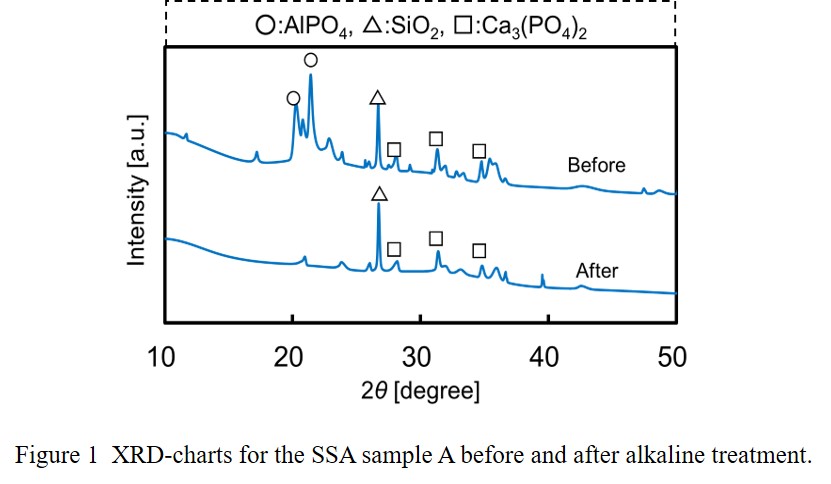
In this research, we consider a process for mass production of magnetic particles consisting of metal and carbon inexpensively using a diesel engine. The carbon material can be easily recovered by a magnet being complexed with a ferromagnetic metals and its application to water purification process is being considered although it is still disadvantageously expensive. By a diesel engine for chemical synthesis, the production cost can be reduced by the cogeneration of the chemical product and the power. In this study, iron-carbon fine particles are synthesized from diesel oil in which ferrocene is dissolved, and the characteristics as an adsorbent are evaluated. With ferrocene and JIS No. 1 diesel oil as raw materials, diesel oils with ferrocene concentrations of 0, 1000 and 10000 ppm were prepared. After the particulates were synthesized in the diesel engine, they were collected together with the exhaust gas in a gas collection bag. The engine used was a 4-stroke engine with a rated output of 2.5 kW and 3000 rpm and a displacement of 211 mL. The synthesized particles were collected when operated at an engine load of 1.65 kW. For evaluation of water purification, collected particles have been purified by magnetic separation in ethanol three times. Then 2 mg of purified magnetic particles were dispersed into 8 mL of 25 mg / L methylene blue (MB) aqueous solution. After rapid stirring, the solution was placed next to a neodymium magnet, and the absorbance at 611 nm of the solution supernatant was measured every 15 minutes. After the absorbance measurement, the solution was stirred and placed next to a magnet again. The particles were quickly and clearly attracted to the magnet. It was also confirmed that the concentration of MB decreased by the synthesized magnetic particles.
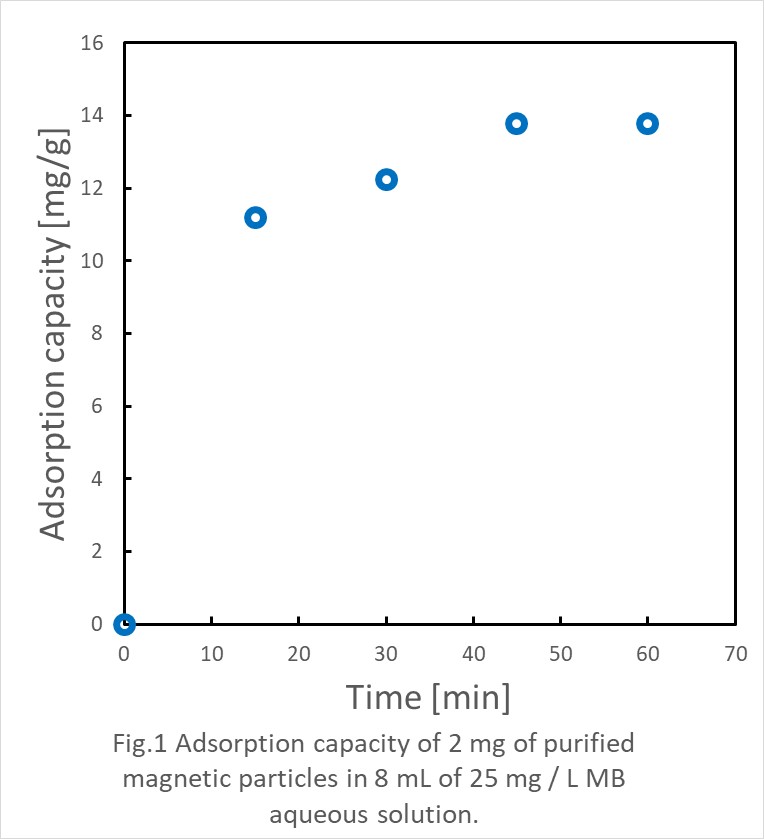
Selenium is commonly contained in wastewater generated from the process glass coloring agent, red pigment, and so on. An efficient method to remove selenium is required. Selenium is generally removed by co-precipitation with ferric hydroxide. However, this method requires a large amount of ferric salts due to low removal efficiency of selenium by ferric hydroxide. This research investigates the possibility of another method using magnesium oxide as a selenium remover from aqueous solution. Although magnesium oxide has a disadvantage because of its low reactivity, it can be overcome using low crystalline magnesium oxide obtained by calcining magnesium carbonate at low temperature. In this research, we tried to understand the selenium removal performance and its mechanism using this low crystalline magnesium oxide. To investigate the amount of selenium removed, the low crystalline magnesium oxide was added to simulated wastewater containing selenium. The concentration of selenium in simulated wastewater was measured by Inductively Coupled Plasma Mass Spectrometry (ICP-MS). In addition, to clarify the removal mechanism of selenium, the solid after removal was analyzed using X-Ray Diffraction (XRD). Selenate was removed within 20 minutes after the addition of low crystalline magnesium oxide. The XRD result showed the shifted peak of (001) surface of the magnesium precipitate after the addition of low crystalline magnesium oxide in 10 to 30 minutes. This result indicated selenate entered the surface between the layers of magnesium hydroxide's (001). On the other hand, selenite was removed within 30 minutes after the addition of low crystalline magnesium oxide. A new peak was formed near the (001) surface of the magnesium hydroxide when the selenite was in high concentration. A precipitate containing selenite and magnesium besides magnesium hydroxide was formed when selenite was removed.
Flotation methods were designed for the efficient removal of fluoroquinolone antibiotics from wastewater. The removal of four fluoroquinolones including norfloxacin, ciprofloxacin, levofloxacin, and enrofloxacin were conducted by adding electrically equivalent amounts of sodium dodecyl sulfate (SDS) and poly (allylamine hydrochloride) [PAH] followed by feeding air bubbles. The air bubbles vigorously mixed water and induced the coagulation of SDS-PAH complex to from agglutinative coagulation on water surface. In the presence of Al (III) ions, fluoroquinolones in water were collected to the coagulum as a hydrophobic ion-pair of the Al (III)-chelate with a dodecyl sulfate ion. Experimental conditions including the concentration of Al (III) ions, SDS, PAH, alcohols, salts as well as solution pH, vessel diameter, water height, amount of air babbles, and flotation time were examined. Combined use of 1.0 mg/L Al (III), 20 mg/L SDS, 6.5 mg/L PAH, allowed more than 99% removal of four antibiotics within 5 min. Practical applicability was examined by using synthesized municipal and hospital wastewaters. Effects of dissolved organic and inorganic substances were studied in detail.
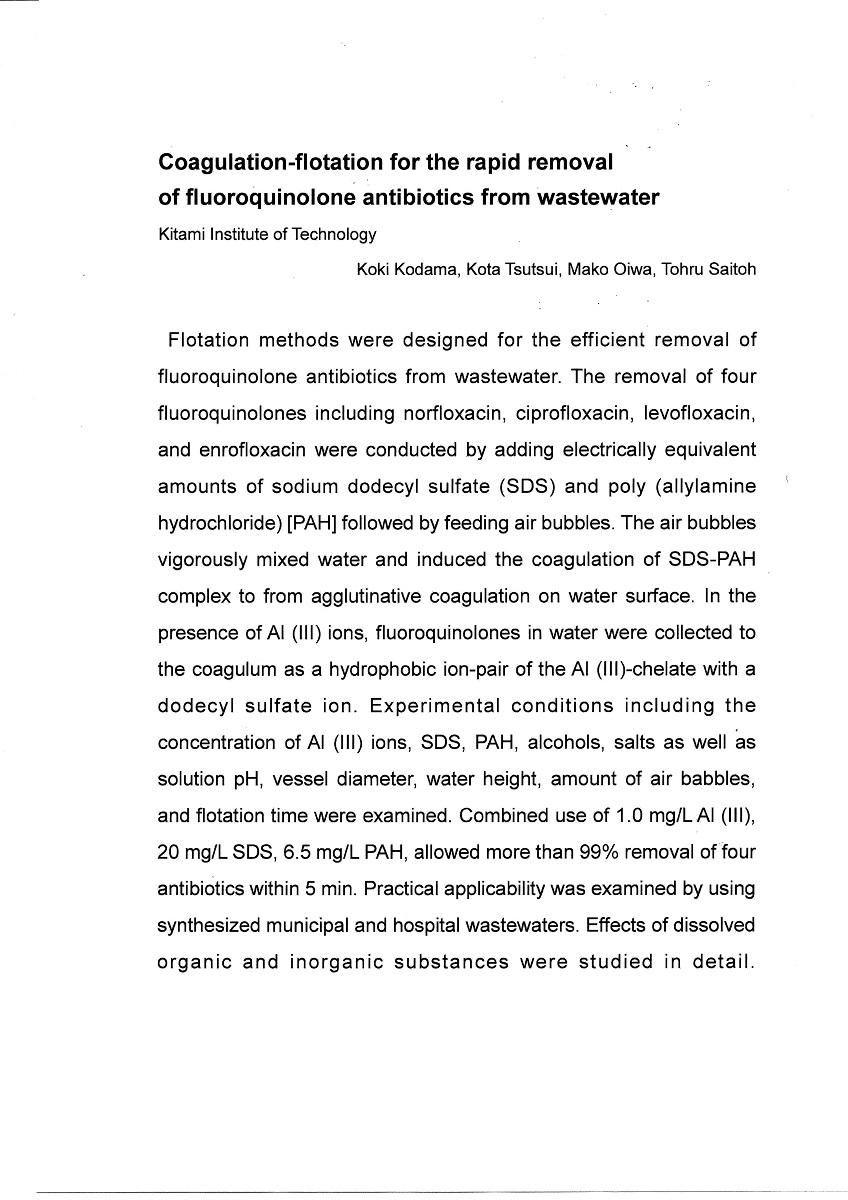
We have developed a novel process for recycling gold from secondary sources. The process consists of the leaching of gold using Organic Aqua Regia, propylene carbonate (PC) solutions containing copper bromide (CuBr2) and potassium bromide (KBr), In this study, we applied this process to recover gold from Waste Electric and Electronic Equipment (WEEE). First, the WEEE samples (memory card, mobile phone board and small appliances) were coarsely grinded and carbonated. Then, the samples were finely grinded and oxidized. Next, the leaching of gold from the oxidized samples were conducted in a PC solution with 0.2 M of CuBr2 and 0.2 M of KBr, at 353-373 K, followed by biphasic separation with sulfuric acid. The dissolved Au in the PC phase was recovered by reduction of ascorbic acid. The maximum recovery ratio of Au was 88%, 74%, 69%, 80% and 94% from memory card, mobile phone board, digital camera board, game board, TV board, respectively. Our developed process could offer a number of advantages, including eco-friendliness and simple operation.
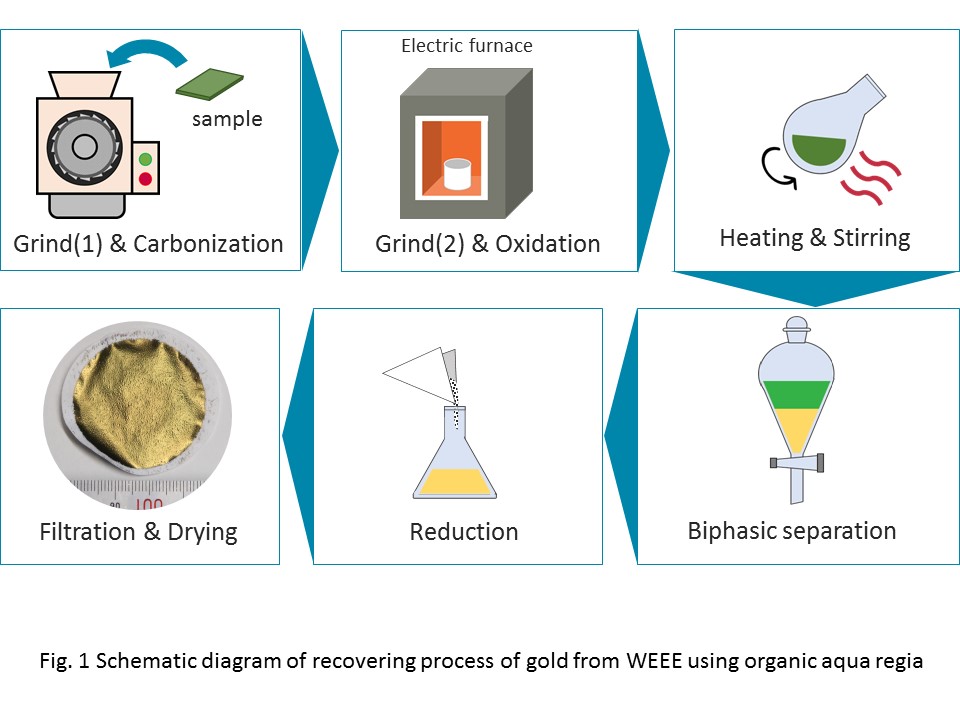
Carbon fiber reinforced plastic (CFRP) is a composite material consisted of carbon fiber and resin. Since the demand for CFRP is expected to increase at approximately 140,000 tons a year by 2020, it is necessary to consider the disposal method of a large amount of the CFRP waste. Recycling the CFRP waste to produce inexpensive carbon fiber can contribute to the expanded demand. The main recycling methods are a thermal decomposition and a sub-/super-critical dissolution method. Although these methods have some advantages, they have not yet reached a sufficient recycling method for the commercial scale due to remaining issues. Therefore, we focused on a voltage application method for the CFRP recycling. In this study, we investigated the effect of electrolyte solution, its concentration for the method, in order to optimize the conditions. The experiment was performed using a two-electrode cell, in which cross-ply CFRP laminate of carbon fiber and epoxy resin as an anode. The damage of carbon fiber after the experiment was assessed using a digital microscope. Figure shows the dependence of the weight loss of the CFPR laminate on the electrolyte (NaCl) concentration. The weight loss increased, as the NaCl concentration increased until 0.1 mol L-1. From the result, as the concentration was higher, the CFRP recycling by the voltage application method was effective, because the current showed high value. On the other hand, the experiment in 1.0 mol L-1 electrolyte showed the small weight loss despite the high current value. From the observation by the digital microscope, NaCl crystal was observed on the surface of the CFRP laminate after the experiment. From these results, we conclude that the suitable concentration of NaCl electrolyte was approximately 0.1 mol L-1 for the CFRP recycling by the voltage application method.
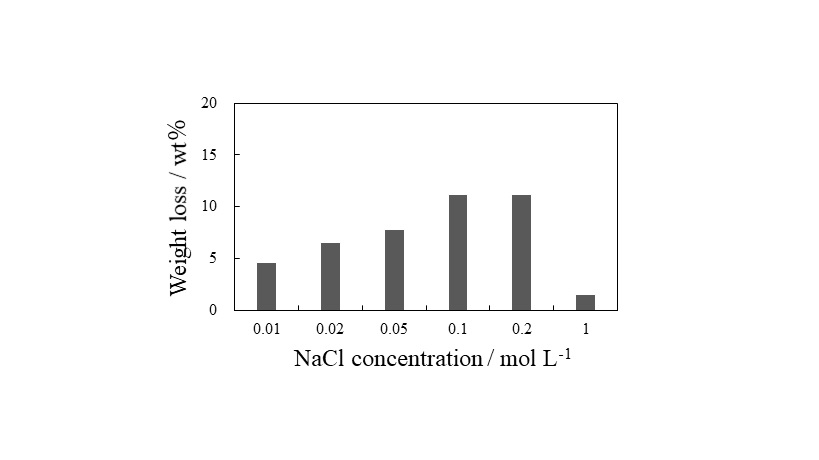
Sustainable development require human being well manage the pollutants in water and air. Removing the pollutants by microbes or catalytic electrochemical process in fuel cell type reactors present energy-saving options and electricity generation features. The electrodes and catalysts are crucial for such design of reactor and process , in pollutants removal efficiency, electricity generation level and operation costs. Through more than 5 years of study, we developed series catalysts, electrodes and fuel cell reactors , that favorably increased pollution control efficiency for both water and air. Significant catalysts such as Fe-N-C, Bi-V-O, BiOBr, Ag/AgBr, Pt/TiO2/ZnO, and their composites were loaded on substrate electrodes ( carbon cloth or stainless steel or Ni foam), as anode or cathode. These electrodes then were tested in Photocatalytic fuel cell or microbial fuel cell, that can integrate electrochemical effect with membrane filtration, or utilize the synergetic effect of microbes with (photo-)electro-chemical functions. Thus, pollutants such as PFOS, aromatic pollutants in real coking wastewater, antibiotics and dyes in water, HCHO and ethyl acetate, ammonia and trimethylamine, and toluene can be removed through electricity generation processes. The energy cost of operation is lowered through solar powered, bio-powered or self-biased and self-driven catalytic processes. Highest obtained electricity generation can reach 87Wm-2h-1,assisted by self-sustained degradation of pollutants.
In this study, the chlorine removal efficiency of waste plastic by superheated steam was investigated using adsorbents. 5 g of PVC and 5 g of adsorbent were physically mixed and compressed into pellet using a hydraulic press. The adsorbents in this study were CaO, Al2O3, SiO2 and Fe3O4. The sample was placed in a chamber where the superheated steam was introduced at a flow rate of 10 kg/h. The reaction time and chamber temperature were kept constant at 1 h and 473 K, respectively. The experiment of nitrogen heating was also compared with the superheated steam heating. The dechlorination rate was in the descending order of CaO> Al2O3> no addition, and the PVC yield was in the descending order of no addition> Al2O3> CaO. Although the decrease in the yield of PVC seemed to result from the increase in the volatile matter such as hydrogen chloride and hydrocarbons, addition of CaO increased the dechlorination rate as organic chlorine and it was higher than the others. This is due to the formation of the inorganic chlorine compounds such as CaClOH or CaCl2 6H2O with decomposed chlorine and CaO, according to the XRD analysis. The neutralization reaction of CaO, which is an alkaline earth metal oxide, with the volatile HCl occurred in the sample. Therefore, the CaO addition is more effective for the PVC decomposition and dechlorination in the superheated steam atmosphere. The dechlorination rate of the CaO addition became 92% in the superheated steam, whereas it remained 32% in the nitrogen atmosphere. As a conclusion, the PVC dechlorination can be efficiently achieved in the superheated steam in the presence of adsorbent, such as CaO.
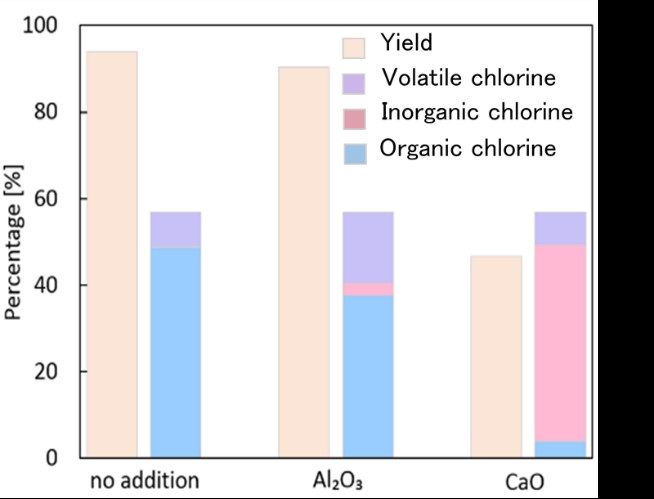
Biological removal of dichloromethane (DCM) from pharmaceutical industry is limited by its recalcitrance. In this study, an airlift packing reactor (ALPR), which combined the suspended and fixed-film microbial growth system, was set up to remove DCM and co-existed toluene. The removal performance of the ALPR for DCM was greater than traditional airlift reactor (ALR). The maximum elimination capacity (ECmax) of the ALPR for DCM reached 108 g m-3 h-1 with removal efficiency (RE) of 41%, increased by 145% if compared to the ALR. The ECmax for toluene was 172 g m-3 h-1 with RE of 70%, decreased by 25% than the ALR, which was mainly due to the higher liquid-phase biomass in the ALR. The results of high-throughput sequencing showed that the microbial composition on the packings of the ALPR had a large difference from its liquid-phase or the liquid-phase of the ALR. Gemmobacter, Rhizomicrobium, Chitinophaga, Vampirovibrio, and Fodinicurvata were genera with great abundance fixed on the packings and Rhizomicrobium, Chitinophaga, Vampirovibrio, and Fodinicurvata are first to be reported in VOCs biological removal. This study indicated that the ALPR can augment the microbial community and effectively improve the removal of recalcitrant VOCs.
As the traditional VW(Mo)Ti catalyst existed some drawbacks using in NH3-SCR reaction, it is necessary to develop new TiO2-based alternative catalysts for NOx abatement. 0.8%Cu/Ti2NbOx as a novel catalyst was developed and investigated. The NOx conversion and N2 selectivity maintained upon 90% and 97% respectively in the temperature range of 250 °C-425 °C under a high gas hourly space vel °City (GHSV) of 177,000 h-1. Water vapor or SO2 would not pose any negative effect on the SCR activity. Also, 0.8%Cu/Ti2NbOx exhibited an excellent hydrothermal stability and alkali mental resistance. The performance characterization indicated 0.8%Cu/Ti2NbOx was a promising candidate for the NH3-SCR catalyst in the future practical application. Besides, an array of analytical techniques were employed to elucidate the correlations among the performance-structure-property and the reaction mechanism over 0.8%Cu/Ti2NbOx catalyst. The introduction of niobium oxide increased the surface area of TiO2 and decreased the crystallite size, promoting the high dispersion of copper species. Meanwhile, the total acidity and the amount of surface active oxygen over the catalyst were increased by the addition of niobium oxide. Copper species mainly existing in the state of isolated Cu2+ and non-isolated Cu+ enhanced the redox capability of the catalyst, resulting in an excellent catalytic performance. There is a promotional synergistic effect between copper and niobium in 0.8%Cu/Ti2NbOx catalyst during the catalytic reaction. Furthermore, the reaction pathway over 0.8%Cu/Ti2NbOx catalyst followed both Eley-Rideal mechanism and Langmuir-Hinshelwood mechanism at 225 °C.
Key words: Cu/Nb-Ti mixed oxide catalyst; Synergistic effect; Reaction pathway
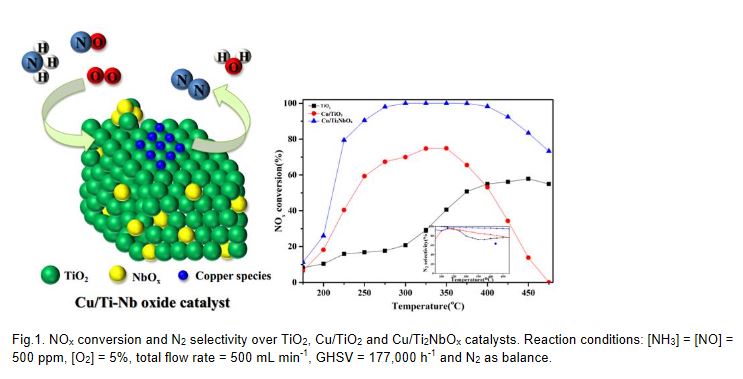
The disposal of untreated synthetic dye wastes from various industries causes serious environmental problems. Adsorption has been reported as promising method in industrial wastewater treatment especially for dye removal. Cellulose-based beads have been reported to show great potential as dye adsorbents. Some modification of cellulose-based adsorbent beads can be done to increase their adsorption capacity. One of the modification techniques is by blending with other materials to form composite beads. In this present study, cellulose acetate butyrate (CAB) and poly(L-lactic acid) (PLLA) were blended through solvent blending method followed by solution dropping technique to fabricate composite CAB/PLLA beads and applied as adsorbent for methylene blue removal from aqueous solution. It has been reported that cellulose beads can be prepared from some cellulose derivates sources such as CAB via solution dropping method. The weight ratio of CAB/PLLA was varied, which are 100/0, 90/10, 80/20, and 70/30, to see the effect of PLLA addition to the adsorption performance of the composite beads. The concentration of polymers in the solution was also varied, which are 10 wt% and 15 wt%. Batch equilibrium adsorption was carried out to study the adsorption kinetics. The adsorption results showed that the increasing of PLLA content generally increases the absorption capacity (Q) and dye removal percentage (% R). The highest adsorption capacity and % dye removal was obtained by CAB/PLLA (70/30) 15 wt%, which are 2.54 mg/g and 25.35% respectively at the adsorption condition of pH 7, temperature 30 °C, initial dye concentration of 20 mg/L, and beads dose of 2 g/L. The % dye removal increased to 69.85% by increasing the beads dose to 20 g/L. The kinetics data obtained from the experiment fitted well with Lagergren's pseudo-first-order model, showing the characteristic of physically adsorption.
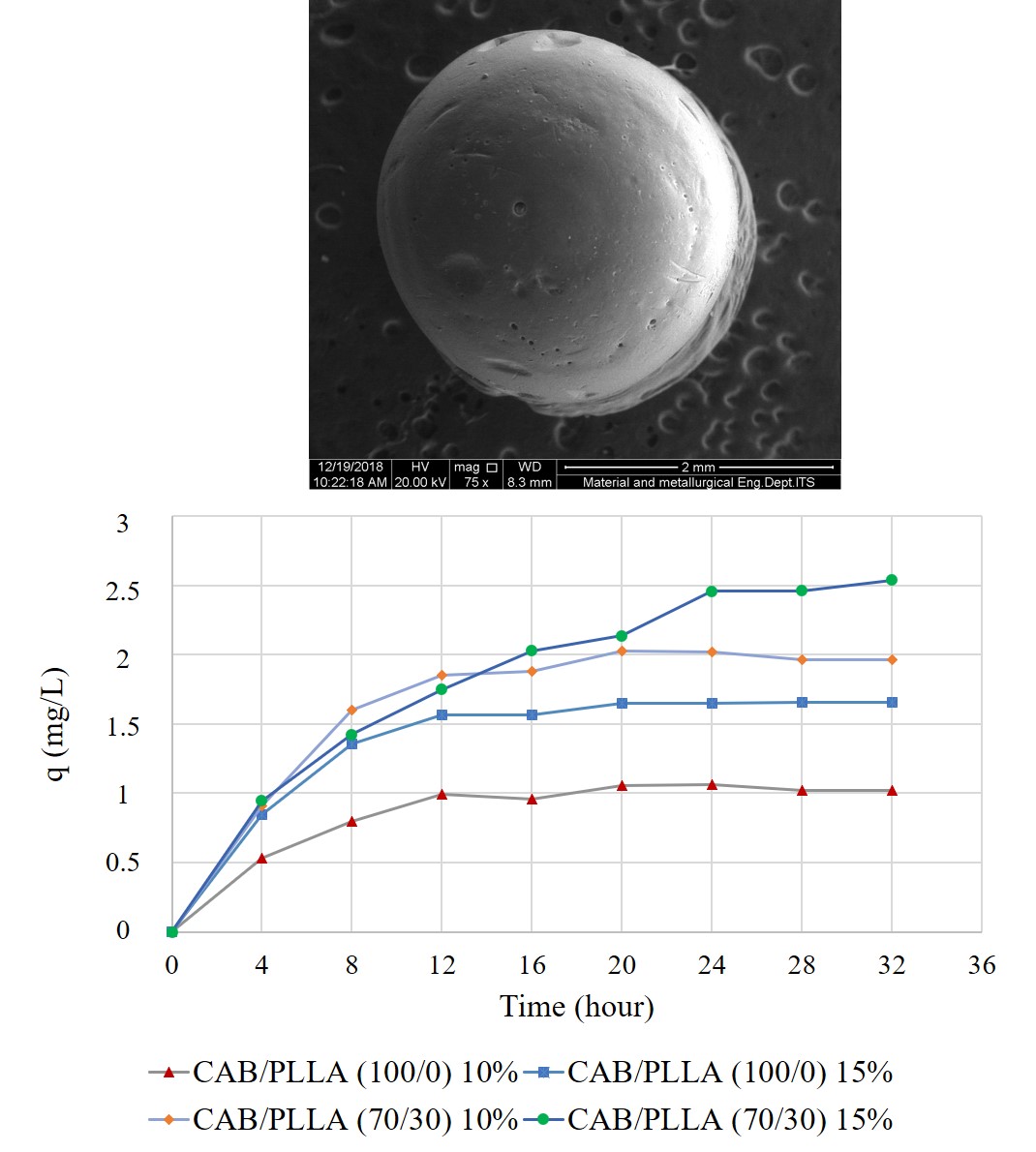
Degradation of Methylene Blue (MB) in aqueous solution is investigated using a pulsed DC discharge on liquid surface synchronized by droplet formation between two electrodes. The high voltage electrode is located in the return tube while a ground electrode is placed inside the bulk solution. Plasma discharge is ignited between the two electrodes when the aqueous solution runs to the lower electrode. The gap between the top electrode and the water surface is about 15 mm and the discharge is ignited when droplet forms. The concentration and total amount of the MB solution was 10 ppm and 100 ml respectively. The solution is circulated at a rate of 20 ml/min by a pump through the lower electrode, spectrophotometer and return tube (upper electrode). UV-vis spectroscopy is used to evaluate the degradation rate by the absorbance at a wavelength of 615 nm. The efficacy of discharge currents is studied at a voltage -10 kV. It is found out that higher current has more degradation efficiency for the same initial concentration of dye. The maximum degradation efficiency is determined about 56% for the 5mA current, and 42% for the 2.5 mA current. However, the more stable discharge is obtained for lower current despite the fact that the higher current has more efficiency of degradation. When plasma turned off after 60 min, the degradation is continued to cease down after 10 min. The latter phenomenon is attributed to the free radical which is elaborated within the solution and reacts with MB.
Figure 1. Effect of current on the degradation rate of MB.
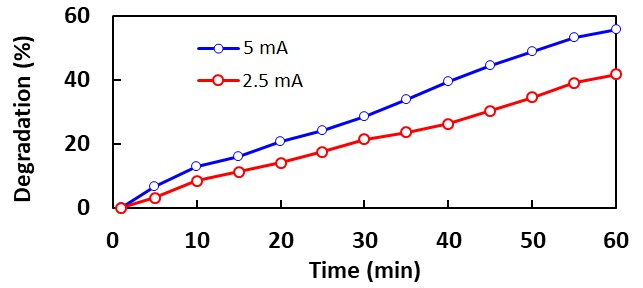
At present, coal is widely used as a fuel for thermal power generation. When coal is used for thermal power generation, there is a problem that mercury contained in coal is emitted to the atmosphere as exhaust gas. The forms of mercury emitted by thermal power generation include mercury oxide, particulate mercury, and elemental mercury. Of the three, the former two can be removed with existing equipment, but elemental mercury is difficult to remove with the current technology due to its high volatility and low water solubility. The aim of this study is development of sorbents suitable for the removal of elemental mercury from coal gasification gas. Fe2O3 and CeO2 were chosen as sorbents because they are inexpensive and stable in the mercury removal reaction. The effects of combination of Fe2O3 and CeO2 at various ratio were investigated.
The simulated coal gasification gas was used for the mercury removal experiment. It was found that the inclusion of Fe2O3 in CeO2 improves the mercury removal performance and also improves the durability in repeated use. After the mercury removal experiment, TPDD experiment was performed to examine the adsorption state of mercury by the sorbents from the desorbed mercury peak. Since the peaks derived from HgS appeared in all the sorbents, it was suggested that the mercury was captured in the form of HgS. When the experiment was performed in the absence of H2S and HCl, the mercury removal rate decreased. Both H2S and HCl are believed to contribute to the mercury removal reaction.
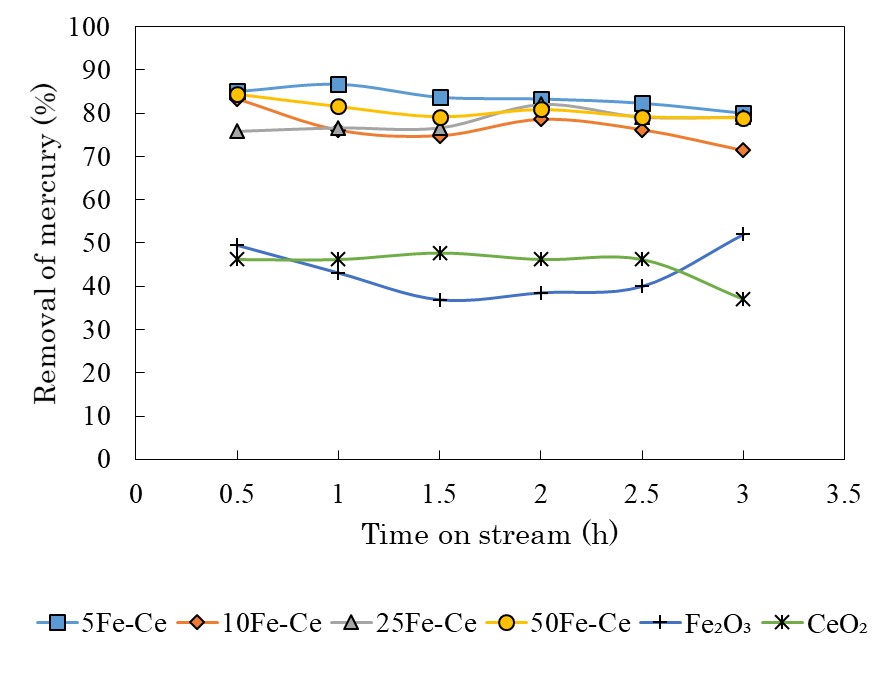
Generally, zinc contained in zinc-plating wastewater is removed as zinc hydroxide precipitate by adjusting the pH from 9.5 to 10.5. Zinc hydroxide sludge generated from this process is discharged about 20000 t/yr in Japan, and the greater part of them are disposed in landfills because of high recycling costs. However, in recent years, industrial waste disposal costs have risen due to the shortage of land fill disposal sites. Therefore, development of volume reduction and effective usage method for zinc sludge is required.
As a solution to this problem, we aimed at the effective usage of zinc sludge by producing Zn-Al LDH from zinc-plating wastewater. Zn-Al LDH can be obtained by adding polyaluminum chloride (PAC) generally used as an inorganic flocculant to zinc-plating wastewater. LDH is well known to have anion exchange property and then can be applied as an anion adsorbent. In fact, Zn-Al LDH also has excellent phosphate ion adsorption capacity. Accordingly, in this study, we investigated whether Zn-Al LDH obtained from could be used as an anion (especially boron and fluorine) adsorbent.
We have previously reported on the adsorption properties of Zn-Al LDH obtained from zinc-plating wastewater. In this poster presentation, we will report on the evaluation of environmental burden of Zn-Al LDH adsorbents produced from zinc-plating wastewater. The conventional methods of boron and fluorine wastewater treatment are two-stage coagulation sedimentation methods, and a lot of sludge is generated in these processes. Therefore, the environmental burden of these methods will be high, so boron and fluorine wastewater treatment with Zn-Al LDH adsorbents produced from zinc-plating wastewater may be superior to the conventional methods. We evaluated the environmental burden in each wastewater treatment method with life cycle assessment (LCA) and compared them to confirm the advantages of the Zn-Al LDH adsorbents.
A core-shell structured Fe-ZSM-5@CeO2 catalyst was originally fabricated via dopamine polymerization for selective catalytic reduction of NOx by NH3. Fe-ZSM-5@CeO2 possess a better catalytic activity with higher N2 selectivity, more extensive operating-temperature window, and better water resistance compared with Fe-ZSM-5/CeO2 via physical mixing. The synergistic effect of Fe-ZSM-5 and CeO2 over Fe-ZSM-5@CeO2 facilitated the formation of redox-cycle between Ce3+/Ce4+ redox-couple and high rate active oxygen species (Oβ and Oγ), leading to over 90% conversation of NOx in the temperature range of 250-400 °C. The feature of hierarchical structure with CeO2 outer shell provides a pathway to convert NO to NO2, facilitating the fast SCR. Meanwhile, the formed NO2 can activate Fe2+/Fe3+ redox-couple, offering an extra redox cycle which can further contribute to fast SCR. The CeO2 shell outside can also improve the water resistance of Fe-ZSM-5, resulting in a higher catalytic stability of Fe-ZSM-5@CeO2. To be concluded, Fe-ZSM-5@CeO2 was proved to be a promising candidate for NH3-SCR as the core-shell structure, uniform distribution of active sites, as well as the synergistic effect of Fe-ZSM-5 and CeO2 species.
Industrial wastewater of electroplating contains various toxic substance such as metals, degreasing agents and oil. Metals such as zinc are harmful to the environment. Therefore, discharge of zinc wastewater in the electroplating industry is regulated. In previous study, it is presumed that plating chemicals, particularly degreasing agents disturb the zinc wastewater treatment. Thus, low environmental impact cleaning technology is required to replace degreasing agents. Recently, fine bubble, which is a bubble of 100 μm or less, is attracting attention. Fine bubbles exhibit unique properties, such as surface charge, and cleaning technology utilizing the properties is expected. To comply with zinc effluent regulations, we investigated the effect of fine bubble cleaning on oil deposited on metal surfaces.
The samples for cleaning test were prepared by applying each oil to metal surfaces. The cleaning test was performed for 15 minutes using fine bubble or ultrafine bubble generators with different performance. The surface cleanliness were measured by ultraviolet and visible spectrophotometer.
The results of cleanliness measurement for metal surface show that the oil removal capability by fine bubble depends on oil type, shape of metal, gas type, and the concentrations of micro bubbles classified as bubble size 1 to 100 μm. In particular, the concentration of micro bubble and gas type exert a beneficent influence. These results indicate that the shifts of removal capability of fine bubble are attributed to changes in the fine bubble structure. Furthermore, to investigate the interfering effect of fine bubble in zinc wastewater treatment, we conducted experiments using zinc wastewater containing fine bubbles. The results of experiments show that the contamination of fine bubble does not affect zinc wastewater treatment. From these results, we will discuss the cleaning effects of the fine bubble.
In Japan, laws on effluent standard such as Water Pollution Prevention Act and Sewerage Act were established to protect the water environment. Recently, since tougher standard value has been imposed, more conscious from the electroplating industry to the environment are demanded.
For this reason, we are studying on the improvement of wastewater treatment process being applied in the plating factories. According to previous research, it is shown that pretreatment reagent such as degreasing agents inhibited zinc treatment. Therefore, in order to reduce the use of degreasing agents, the fine bubble washing is studied.
However, the effect of fine bubble washing still have many unclear points. And it may not be evaluated by the current method definitely. So in this study, evaluation method for cleanliness of products contaminated by machine oil and washed by fine bubble is examined.
Base oil, cutting oil and hydraulic oil were used as machine oil. An infrared spectrometer, an ultraviolet and visible spectrophotometer, and a gas chromatograph mass spectrometer were used for the evaluation. Metal plates were soaked into each oil and washed by the fine bubble. The residual oil was extracted using the 50 mL of hexane by ultrasonic extraction. Then these extraction liquids and standard liquid were measured and quantified by comparison of peak strength or peak area.
Fig.1 shows UV-vis spectra of the cutting oil. It was suggested that the cutting oil were changed by the fine bubble. Since the cutting oil was mainly composed of fats, it was impossible to quantitate the fats by the UV-vis spectroscopic analysis in this study. On the other hand, the quantifiability for the hydraulic oil was particularly good. Moreover, the deviations of the measurements were less than the measurement by gravimetry. This indicated that some analysis methods were unsuitable for some types of oil.
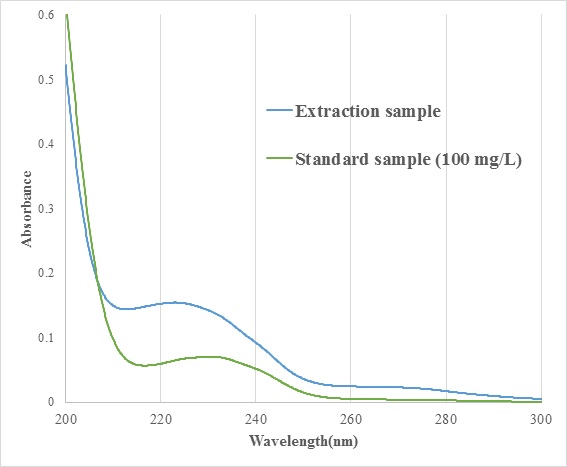
Soil contamination caused by oil spills is a global problem, and bioaugmentation using oil-degrading bacteria is an effective treatment to clean up the contaminated soil. However, various environmental conditions, such as soil composition, water content, and temperature, influence its efficiency. In the present study, an effective bioaugmentation under low temperature condition was developed with mixture of two Rhodococcus oil-degraders, strain A and C, which are officially permitted to be used in bioaugmentation in Japan. A rotational slurry bioreactor was used with a model slurry prepared with 3.0 × 108 cells/g-slurry of strain A and C as inocula. A-fuel oil was added to a final concentration of 2,500 and 5,000 mg/kg-slurry. The decomposition test was carried out by rotating under 15 °C, the residue of A-fuel oil and the number of bacteria were measured every two days. After 4-day treatment, 90% of degradation was achieved, which was 3-fold faster than previous degradation experiment without rotation (90% of A-fuel oil was degraded after 12 days of incubation 1)). For practical application, we conducted a semi-continuous treatment by removing 90% of treated slurry, then added the same amount of contaminated slurry into the system without additional degraders. Ninety-four % of A-fuel oil was degraded after 6 days by this repeated treatment. Our study provides an efficient and cost-effective removal of A-fuel oil by the semi-continuous system.
[1] Shintani et al., 2019, J. Biosci. Bioeng., 127:197-200
The dust monitor is a device that measures the dust concentration continuously in a flue, a chimney, a duct, etc. It is widely used in thermal power plants, waste incinerators, etc. because it can always grasp the operation status of soot and smoke generating facilities.
In Europe, a certification system has been established by TüV of Germany and MCERT of the United Kingdom, and if formal certification is obtained, it will be legally recognized as a continuous monitoring system (CMSs) of dust concentration from the facilities. In Japan, with regard to the emission of dust from the facilities, emission regulations have been introduced under the Air Pollution Control Act. However, although it is not possible to use a dust monitor for dust concentration measurement at present, the related JIS standards are being developed for introduction.
In this work, we developed a flue test equipment aiming at the construction of the performance evaluation system of various dust monitors and the establishment of official legislation. In this maintenance, the diameter of the flue was enlarged, rectification, optimization of dust generation, improvement of the evaluation part, and it became possible to respond to the evaluation of the main method of dust monitor. This device was developed to be able to generate gas containing dust at any dust concentration in a constant velocity flow. Since the measurement unit is provided with a plurality of measurement ports, it is able to evaluate the correlation with the analysis value of JIS Z 8808 for various dust monitors (light scattering type, light transmission type, electrostatic detection type). On the other hand, since the general exhaust gas velocity of large-scale thermal power plants is 10 to 20 m / s, it is necessary to work on increasing the flow velocity of the test equipment.
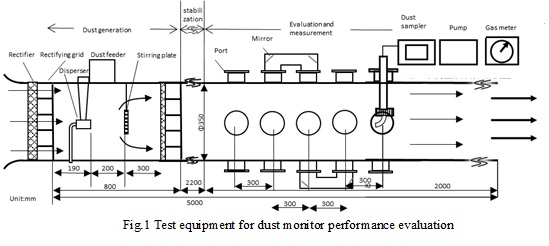
The adverse environmental impact caused by eutrophication has recently prompted the Philippine government to issue stringent regulatory standards for wastewater effluent quality. The involved stakeholders and industries are assessing the integration of biological nutrient removal (BNR) technologies in the current sewage treatment plant (STP) scenario. Moreover, efforts are being done to utilize wastewater as a resource such us recovery of nutrients as struvite fertilizer from the wastewater sludge. Since BNR and nutrient recovery systems are not yet integrated in STPs, the magnitude of the environmental impacts are yet to be evaluated in the Philippine setting. This study covers the holistic evaluation of the overall environmental performance scores of the following scenarios using a consequential Life Cycle Assessment (LCA) framework integrated with Analytic Hierarchy Process (AHP) in the context of agriculture, food consumption and wastewater: 1) current STP scenario; 2) BNR technology; and 3) nutrient recovery system. The environmental impact assessment was done using IMPACT 2002+ methodology in terms of the following impact indicators: human health, ecosystem quality, climate change, resources, aquatic acidification, and aquatic eutrophication. Value judgments from relevant stakeholders were elicited to rank the relative importance of the impact indicators in the evaluation of the overall environmental performance score. The LCA-AHP results show that the integration of a nutrient recovery system is the most preferred scenario. Sensitivity analysis was also done to evaluate the effects of changes in diet and utilization of alternative energy.
Bauxite residue, commonly known as red mud, is a slurry waste generated in huge quantities in the extraction of alumina from bauxite by the Bayer process. It is highly alkaline and caustic with pH greater than 12. The treatment and management of red mud have posed environmental challenges to the alumina industry worldwide. In this work, a systematic study of the neutralization of RM by carbonation with CO2 over a range of different operating conditions was conducted with the aim of establishing the optimal conditions for the carbonation process. The carbonation was performed at room temperature and atmospheric pressure using a stirred tank reactor operating at different conditions such as total gas flow rate (TF), CO2 gas concentrations, stirring speeds and solids concentrations.
The carbonation process was observed to be significantly dependent on CO2 concentration, TF and stirring speeds, whereas solids concentrations seemed to have a little effect based in the range of concentrations studied. In the carbonation of red mud slurry, it took from 30-75 minutes to lower the pH to 6.6 – 7.5 with CO2 gas concentrations ranging from 10%-100%. In contrast, in the carbonation of the red mud liquor, at stable pH of 6.3 – 7.0 was reached within 15-30 minutes at the same CO2 levels. After carbonation, the pH of carbonated red mud slurry was found to rebound and reached 9.7 after a period of 25 days. The carbonated liquor, however, showed a slower rate of pH recovery, and took a month to equilibrate to the same pH. The amount of CO2 captured was evaluated to be 45.6 gCO2/kg at 30% CO2 concentration, with the alkalinity decreasing from 11,610mg/L to 2,104mg/L as CaCO3. This represents a promising potential of CO2 capture by using bauxite residue.
In an industrial painting, an adherence rate of paint to product is about 20%, so large amount of unpainted paint waste - paint sludge - is discharged. Since disposal of a large amount of sludge is high cost and high environmental impact, an appropriate disposal method is necessary. Paint is a resin and it is combustible, so energy recycling is one of a possible method. However, paint sludge contains incombustible inorganic components as pigments, it may inhibit the energy recycling. Therefore, the influences of inorganic components on energy recycling was examined.
The paint sludge used for this study was obtained from several paint factories. The ash content, the contained elements and the calorific value of the paint sludge were analyzed. Endothermic energy amount in combustion and consumption of energy in transportation were calculated from the analysis results.
The ash, which is the noncombustible fractions was more than 50% for any of the sludge. Main substances of the ash were analyzed by X-ray fluorescence analysis. And they were iron, titanium and calcium. The lower heating value of the sludge was 9900 kJ/kg on average, and the moisture content was 38 % on average. Heat absorption amounts of the ash were calculated based on the contents of it, and it was about 2.6%. It means that the influence of the noncombustible fractions on energy recovery is small. In addition, the effect of the ash on sludge transportation is calculated. Assuming a transportation distance of 50 km, the energy required for transportation of paint sludge is about 4.3% and for transportation of ash is about 3.1% of the energy to be recycled. From these results, it is shown that the influence of the inorganic component is small in the whole recycling system.
A variety of technologies such as ion exchange, membrane filtration, precipitation, and biological degradation, have been developed for the removal of environmental pollutants such as bisphenol A and heavy metals from waste effluents. However, many of those methods have weaknesses such as low efficiency, high maintenance cost, and inflexible process. Some methods have relatively limited application for the effluent including high concentration of pollutants. The peptide, oligomer of amino acids, which is the simplest biological recognition element, has been known to have high selectivity toward target component. By using biopanning protocol, various peptide sequences with high affinity to target components have been found. For example, TNTLSNN exhibiting high selectivity to Pb2+ against other heavy metal ions and KSLENSY having specific affinity to bisphenol A were screened previously. In the present work, the application of those peptides is suggested for the removal of environmental pollutants. The peptide-magnetic bead system is first constructed and tested as a reusable adsorbent to remove metal or bisphenol A from aqueous solution. Compared to the bare bead without the linked peptides, the peptide-linked adsorbent showed higher removal capacity. Since the magnetic bead-based adsorbents are easily separated and reused from aqueous system, the process cost can be lowered.
Traditionally, there are several of chemical and physical methods to remove heavy metal ions from wastewater. However, the traditional method of removing heavy metal ions usually had higher cost and limited effectiveness. Therefore, many studies have used low-cost and reusable biological adsorbent to remove the pollutants in wastewater. The wasabi is a common edible plant. However, when people used wasabi, the part of leaves often was discarded. The main purpose of this study is to use the leaves of wasabi powder for heavy metal chromium, copper, nickel and lead adsorption. The adsorption experiment was to investigate the effect of reaction time, pH, initial concentration, different wasabi powder, the dose of wasabi powder and the particle size of wasabi powder.
According to the results the adsorption capacity of heavy metal ion in the order was : Pb (II) > Cu (II) > Cr (II) > Ni (II). The adsorption data of these metal ions were fitted well to the Pseudo second order rate law. Using NaOH pretreatment the wasabi powder for these metal ions had greater than 90% removal efficiency. The pH value has a significant impact on the adsorption. The adsorption capacity of these metal ions will increase to a certain value with the increase of pH value. Because the higher pH value, metal ions, will be accompanied by precipitation. The adsorption isotherms of these metal ions were all fitted well to the Langmuir isotherm. The adsorption capacity decreased with the dose of wasabi powder increased. The wasabi powder agglomerates, thus the surface area of adsorption decreased. The particle size of wasabi powder have no a significant effect on the adsorption.
The air pollution has become a serious issue in Korea with the quick advancement of urbanization and industrialization. Besides, the concerns about air contamination are increasing more since it influences both human health and economic development. However, there are limits to the temporal and spatial resolution in the air quality forecast, due to the low observation density of the traditional fine dust monitoring network. To solve these problems, the objectives of this research are to construct effective air quality big data based on a high-resolution monitoring system and to develop an improved air quality forecasting methodology using deep learning approach. The mobile sensors which were developed to be attached to the vehicle were applied to construct the big data about air quality. The pollutant considered for this research was Particulate Matter 10 (PM10). The PM10 concentration was monitored at intervals of 1 second by the sensors. Also, its spatial resolution was from tens to hundreds of meters. Recurrent Neural Network (RNN), which is widely used deep learning model, was used for forecasting based on the constructed PM10 time series data. To figure out the trend of data and improve the accuracy of the model, noises of the monitored data with mobile sensors were removed by a filter. The Exponentially Weighted Moving Average Filter (EWMAF) was applied in this research. It is observed from this study that the model performance for predicting PM10 was comparatively well (R2>0.9). Finally, this study may play an important role as a beginning step to improve the air quality monitoring and forecasting system. Furthermore, the suggested methodology in this research can help to develop an air pollutant emission reduction process in response to increased fine dust.
Forensic engineering is the utilization of engineering skills or techniques to the investigation of material components that do not perform as intended during service. It usually deals with accidents, disasters and product failure of all kinds with an intention to provide solution. Quite often forensic materials engineers while dealing with it are focusing on two aspects; whether or not the appropriate engineering or quality standards have been followed during production process and whether the failure results from use or abuse.
Metal failure analysis are well established today simply because most have been used in service for many years, those of families of other materials especially failures of polymeric and elastomeric products are poorly published as these are recently introduced as engineering materials. Whatever the situation, material cannot be prevented from failure but root-cause analysis would help to prevent from known causes.
This presentation highlights the principal approach for the analysis of failed polymeric components. In the approach we mainly focus on three aspects, such as
* the parallels between failures in different materials - For engineering polymeric materials adequate properties database are not available to check whether or not a particular material is fit to be used under a specified set of circumstances. Therefore, comprehensive searches are being made to look for the track record of parallel product failures that already have been determined and causes established.
* IDprevious examples of similar failures - It provides a context for a previous investigation that can not only help resolve ambiguities but also aid designers in selecting materials with knowing the environment in which products have to perform reliably.
* alternative interpretations by other investigators - The role of alternative failure analysis may not be similar or may not provide detail information. Therefore assumptions on interactive effect may require to make for root cause analysis.
Particularly, in presentation, emphasis will be given to understanding polymeric materials component failures and the principles of failure analysis to discuss the unified approach of integrating the failure mechanism within the products which fail as case studies. Some challenges in current approaches are also presented.
From the process industry such as petroleum refining and petrochemicals to vehicles, heat exchangers are used to efficiently exchange thermal energy between the two fluids. Depending on the fluids during operation, clogging or deposits cause a decrease in the heat transfer efficiency, a decrease in the flow rate of the working fluid, and an increase in the differential pressure. As a result, the operating capacity is reduced. In this case, the heat exchanger needs to be cleaned. In this paper, a case study is presented that describes the possibility of the occurrence of corrosion of the aluminum alloy plate fin type heat exchanger by methanol solution used as a cleaning agent. The corrosion characteristics of the aluminum construction material were evaluation in the laboratory and countermeasures against corrosion then were implemented on the plant.
Global carbon dioxide (CO2) concentration in the atmosphere is continuously increasing due to excessive greenhouse gas emissions, worsening global warming, and climate change. The conventional method to capture CO2 from stationary industrial sources is liquid amine absorption, but its regeneration process is energy-intensive and poses risks of solvent losses. One feasible alternative solution is the use of solid adsorbents prepared by immobilizing amines onto porous substrates with high surface area. We investigated the use of natural bentonite and activated carbon coated with aminated pectin as adsorbents for CO2 capture using a pure CO2 source. The pectin was aminated by initiating the opening of the polysaccharide chains and introducing tetraethylenetetramine as the aminating agent before coating onto the porous substrates. The coating solution was analyzed using nuclear magnetic resonance and Fourier transform infrared spectroscopy to confirm the amination of pectin. The surface morphology of the adsorbents was characterized using scanning electron microscopy to reveal attachment of the modified pectin onto the substrates. The crystallinity of the coated substrates was also studied using X-ray diffraction. The effect of coating aminated pectin on the CO2 adsorption capacity of natural bentonite and activated carbon at 5% breakthrough was determined and discussed.
DME (Dimethyl Ether) is the future environmental friendly fuel. Some parts of equipment for transporting the DME are using rubber as a hoses or seals. This research is about the using of natural rubber for those applications. The influential part in the manufacture of natural rubber products are fillers. The use of filler depends on what the product will be made. DME nature have high permeability and easy to absorb into a rubber and plastic. In such of that, the rubber or plastic could be damaged and not durable. In order to determine the type of degradation, the number of samples were immersed in liquid DME. The ratio of the loading of carbon black/silica filler in natural rubber was varied. DME causes two types of degradation, namely absorption and extraction . The addition of filler composition can reduce the absorption and extraction, which can cause a reduction in the percentage decrease in the value of the change in mass and a decrease in tensile strength. On the other hand, the addition of filler composition will increase the changes of hardness. The higher filler loading, will increase the crosslink density and lower Scorch time. The presence of silica further is to enhance the crosslink density as well as to lower Scorch time. Therefore, the presence of silica affects on the decreasing of the swelling level and shrinking. In general, the presence of silica filler in the mixture will be slightly lowering the tensile strength, but not affecting the elongation at break. The presence of silica before and after soaking with DME will increase hardness.
Constructing mass production method of graphene is essential for practical usage of this remarkable material. Direct exfoliation of graphite in liquid is the promising approach for production of high quality graphene. However, this technique has three huge obstacles to be solved; limitation of solvent, low yield and low exfoliation degree. Here, we found that soluble graphite produced by mechanochemical reaction with salts overcomes above three drawbacks. The soluble graphite was exfoliated into 100% monolayer graphene with more than 10 % yield in five min. of sonication. Surprisingly, the modified graphite was easily exfoliated in low-boiling point solvent such as acetone, alcohol and water without an aid of surfactant. Molecular simulation revealed that the salt is adsorbed to the active carbon at the graphite edge. In the case of weak acid salts, the original bonding nature between alkali atom ion and the base molecule is kept after the reaction. Thus, the alkali metals are easily dissociated in polar solvent, leading to negative charging of graphene. This phenomenon enables the exfoliation of graphite in low boiling point solvents. The approach proposed here opens up a practical usage of the attractive 2D materials.
In recent years, renewable energy has been attracting as alternative energy to replace the thermal power and nuclear power due to the power situation. Wind power generation has been attracting attention from power generation efficiency and equipment cost. But, there are problems about the installation of the generations, such as site area and noise, and few suitable sites that satisfy those conditions in Japan. However, since Japan has the world's sixth largest Exclusive Economic Zone, development of offshore wind power generation is being expected.
Blades of onshore wind power generation are damaged by sand erosion. It is believed that rain erosion damage will be occurred on the blades of offshore wind power generations. Rrosion on the damage, using a water jet erosion method test apparatus, studies have been conducted about the erosion damage of metal material due to droplet impact. Fiber reinforced plastic is mainly used on blades of wind power generations. In many cases, for the improvement of erosion resistance, the resin coating layer has been performed on the blades of wind power generations.
In this study, therefore, test pieces with resin coating layer were made and erosion resistance of resin coating layer was investigated by performing a rain erosion experiment. After the experiment, damaged surfaces were observed and erosion resistance of coating layer was discussed. The results obtained in this study are shown in Table 1. Erosion resistance of the test piece, which is combined with hard matrix and the hard coating layer, is higher than the test piece combined with soft matrix and the hard coating layer.
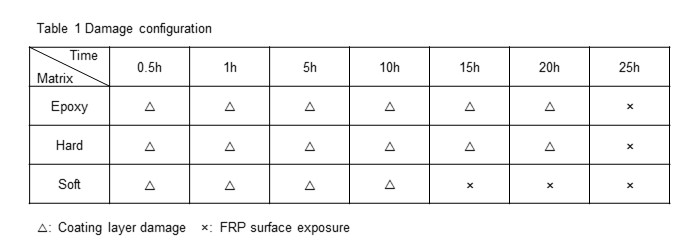
Accidents due to material degradation have occurred several times on FRP-made hydrochloric acid storage tanks. In order to prevent such accidents, we have developed a sensor that detects chemical degradation of polymeric materials using an optical fiber. This sensor has been modified to be installed at the nozzle attached on the tank for field application. In this study, problems were clarified that that occur when this sensor is applied to the actual plant, and after that, it was improved and field data was taken.
An amine cured epoxy resin including a pH indicator, such as BPB, shows discoloration when hydrochloric acid penetrates into the resin. The principle of detecting this color change by a spectroscope via an optical fiber was used for the sensor. This was loaded into a PVC blind flange and installed on a 35% hydrochloric acid storage tank in field chemical plants. By changing the embedding depth of the optical fiber, it is possible to return the time to detection, and at different depths. There was no problem in acquiring data at the time of installation, but even if it passed the water leak test, the leakage of the hydrochloric acid gas from the site where took out the optical fiber was found. To solve this problem, it was necessary to use a leakproof o-ring.
These days sewage system has many problems like high electric power consumption and aging of sewerage facilities. Development of new energy-saving wastewater treatment technology is an urgent issue for sewage works. New developed sewage treatment plant applied an “Energy Saving Wastewater Treatment Technology Using No-aeration System” method with hollow cylinder shape mineral-filled polyolefin carriers, this method a combined technology of a biological treatment and a filtration. The biological treatment uses carriers containing microorganisms and a trickling filter dissolving oxygen, and the filtration uses suspended carriers in the former and the after process. After one-year test operation, a slightly amount of degraded carriers would cause problem to the system. Thus it is necessary to analyze the degradation behavior and develop a lifetime evaluation method of these carriers inside this sewage treatment plant. In order to evaluate the performance of these carriers in this sewage environment, we conducted accelerated immersion tests under acid conditions using organic acid (acetic acid) or inorganic acid (sulfuric acid) with high concentrations and high temperature. After the samples reaching saturation, the mass change and FT-IR tests were used to analysis the changing during the degradation. The roughness of the sample surface was measured by contact angle test. Moreover, tensile tests of the cylinder shape samples and dumbbell shape samples were conducted to investigate the mechanical properties of these carriers under real sewage system condition and the ideal condition.